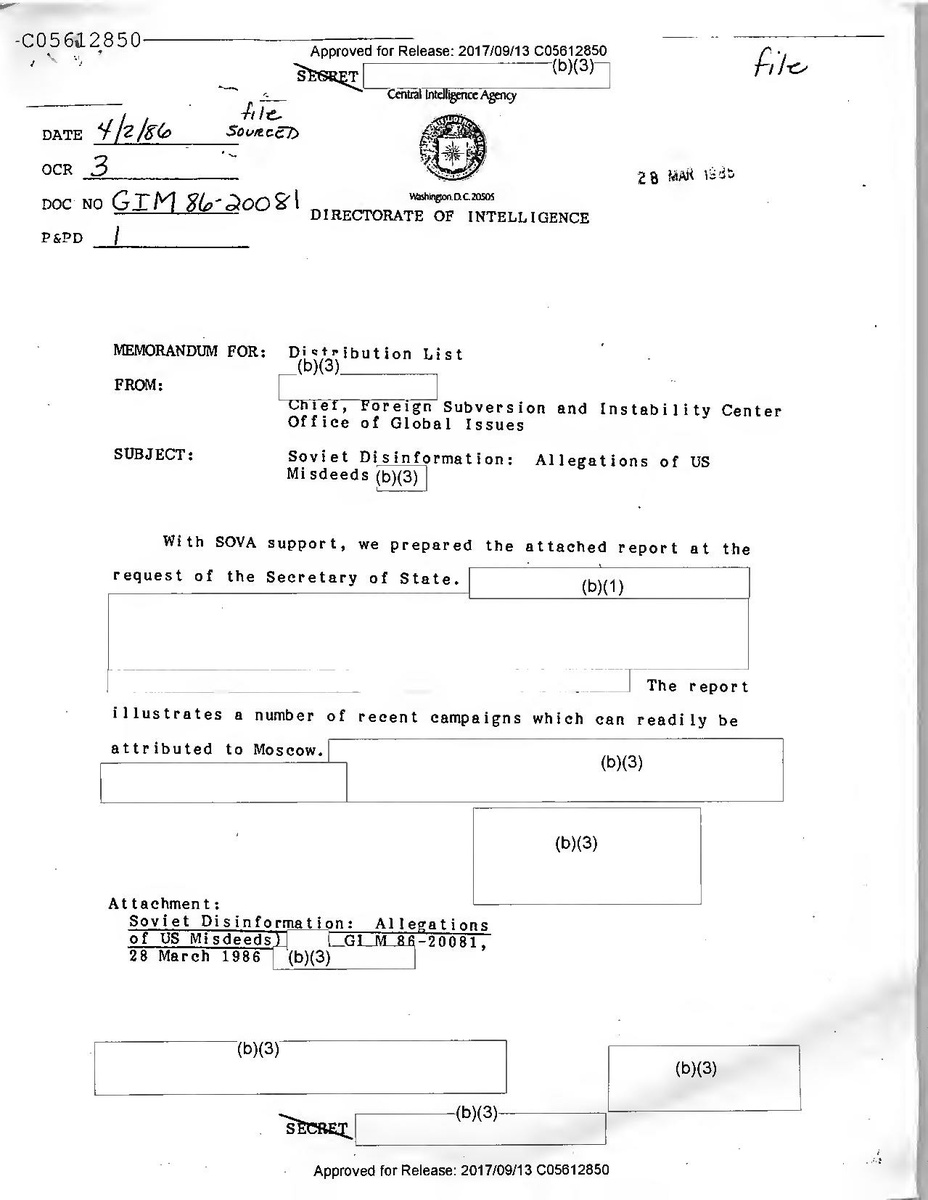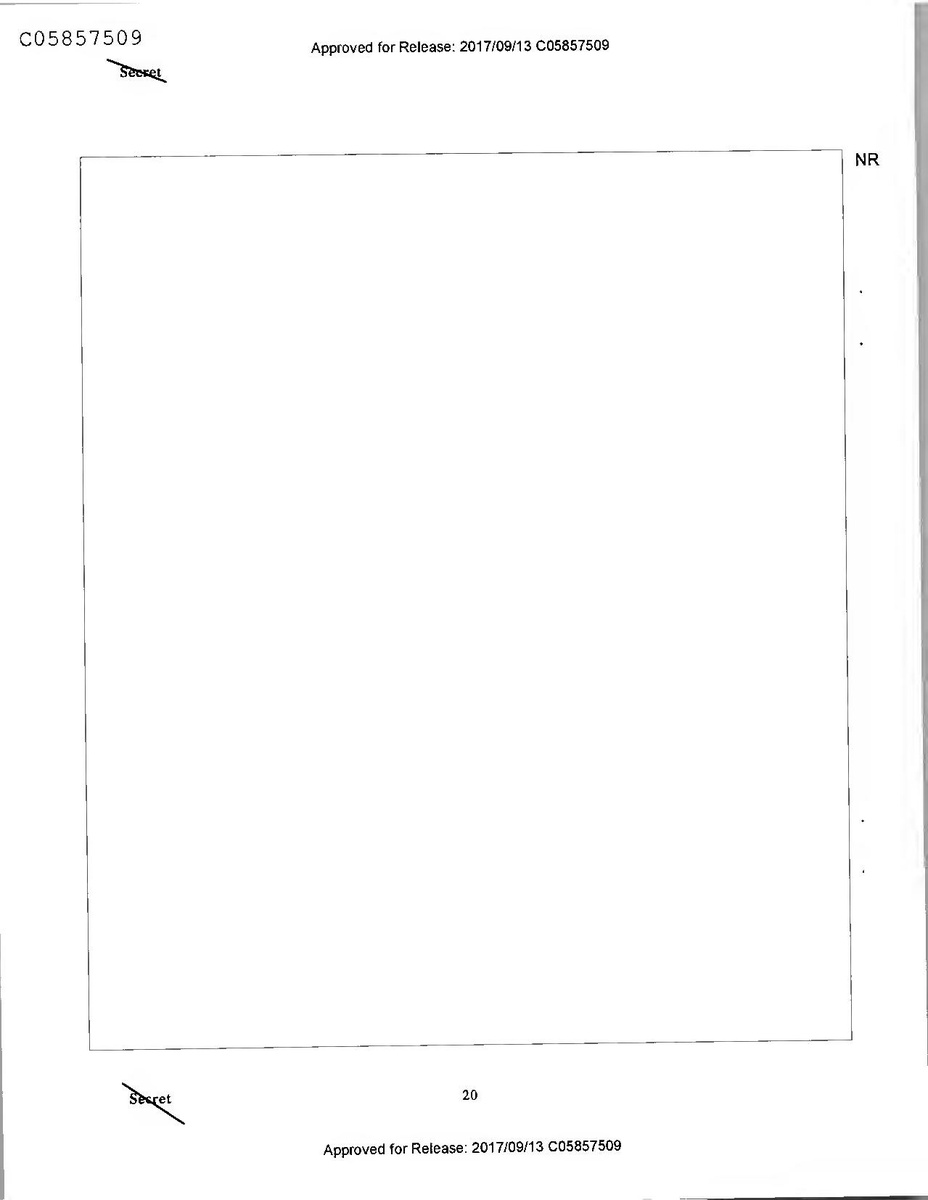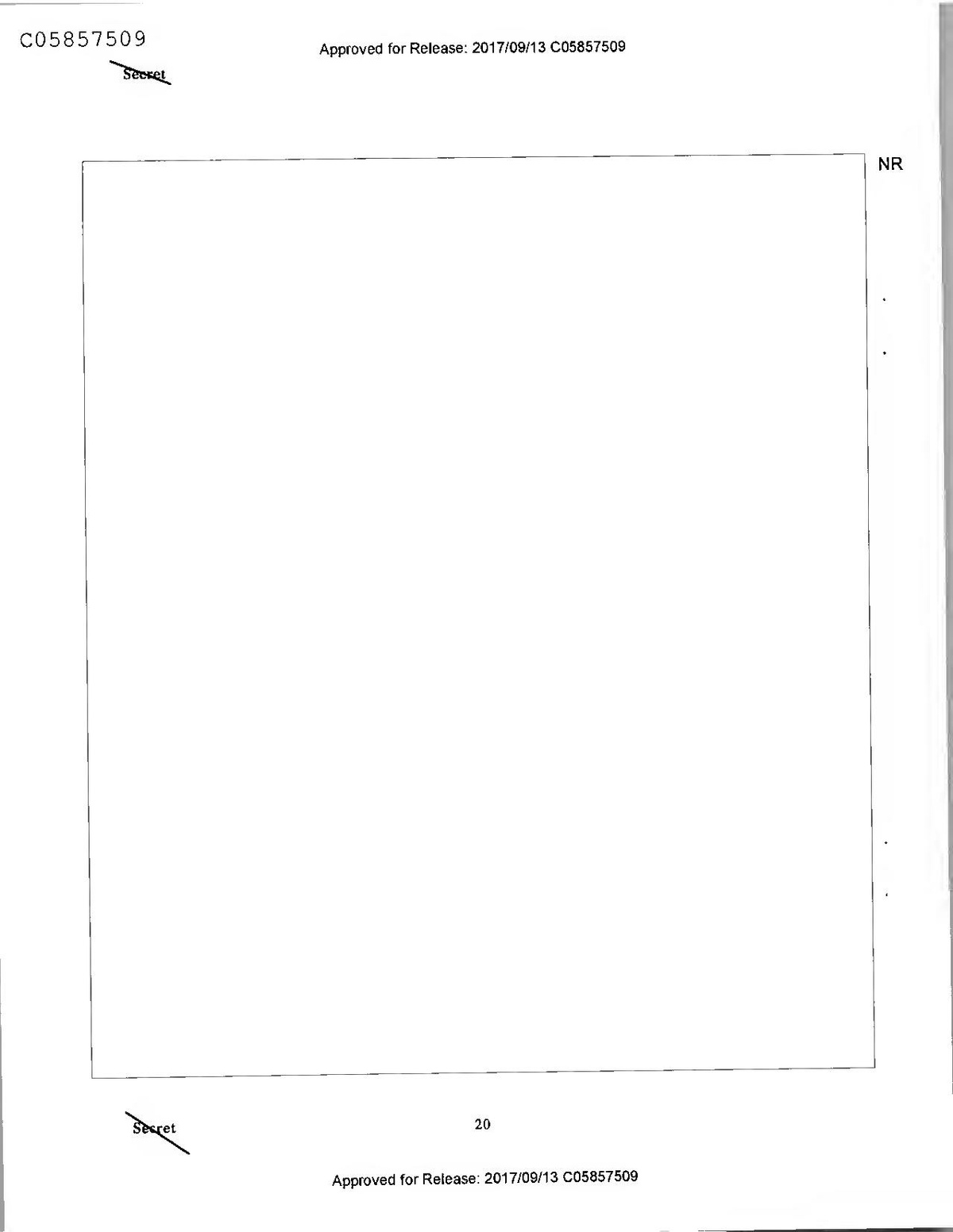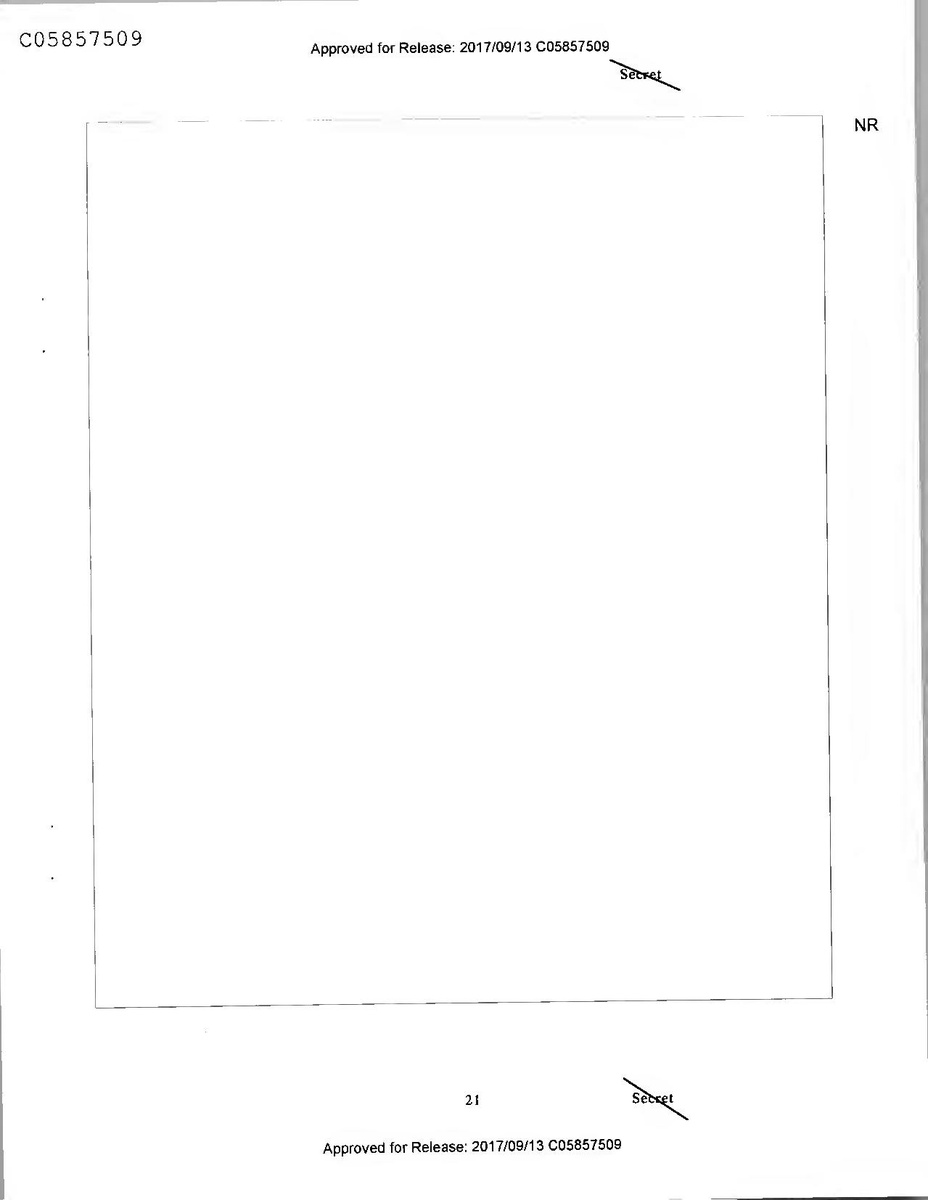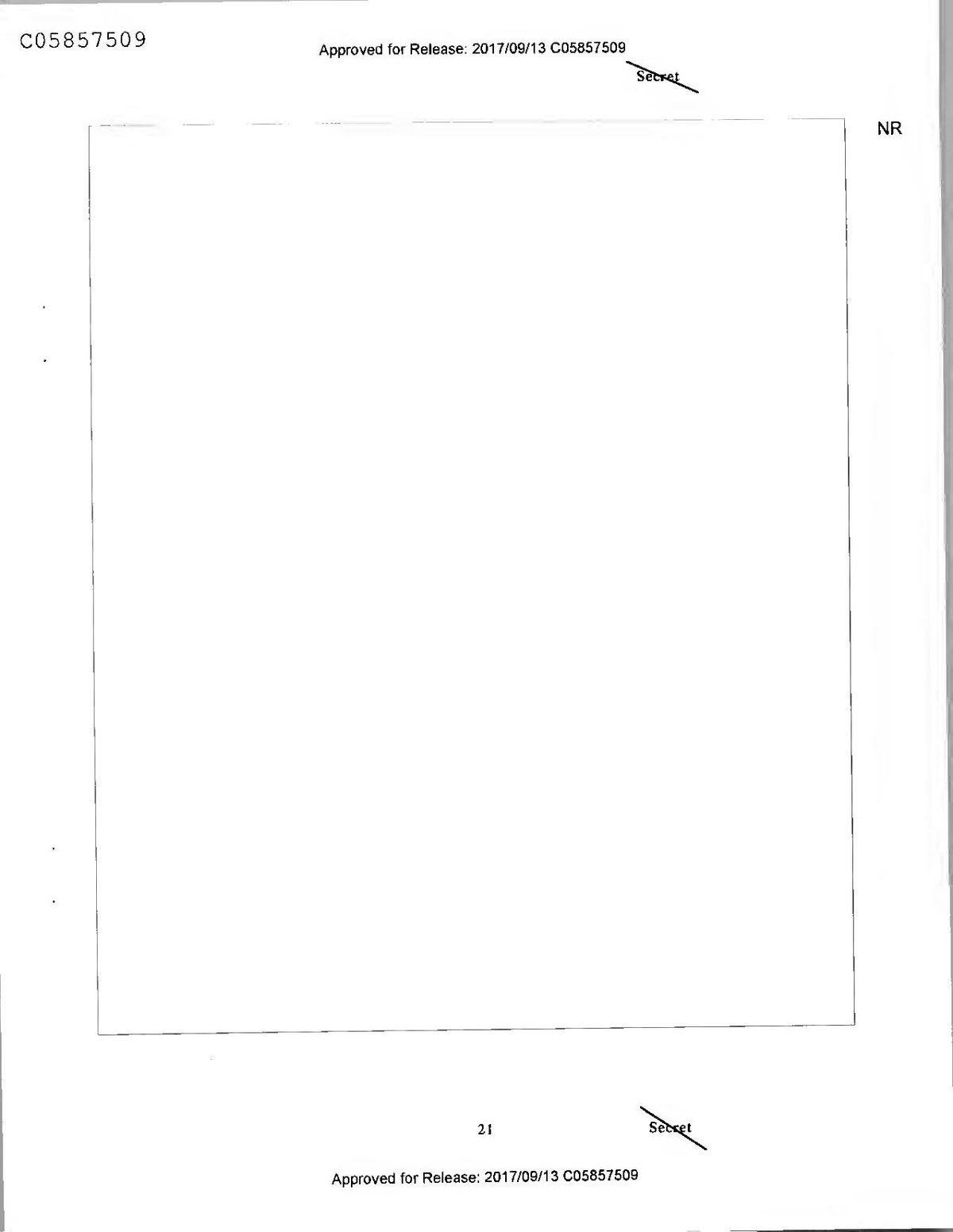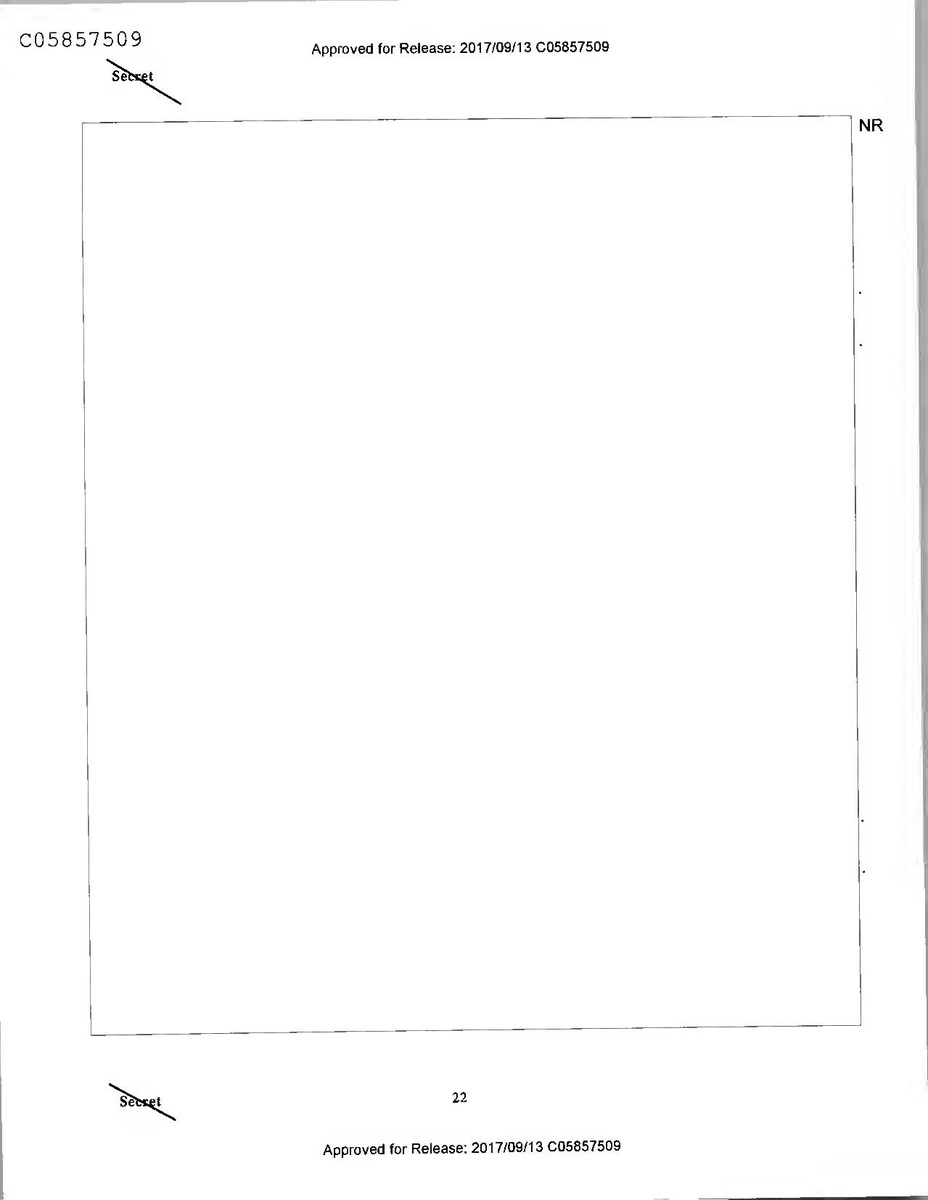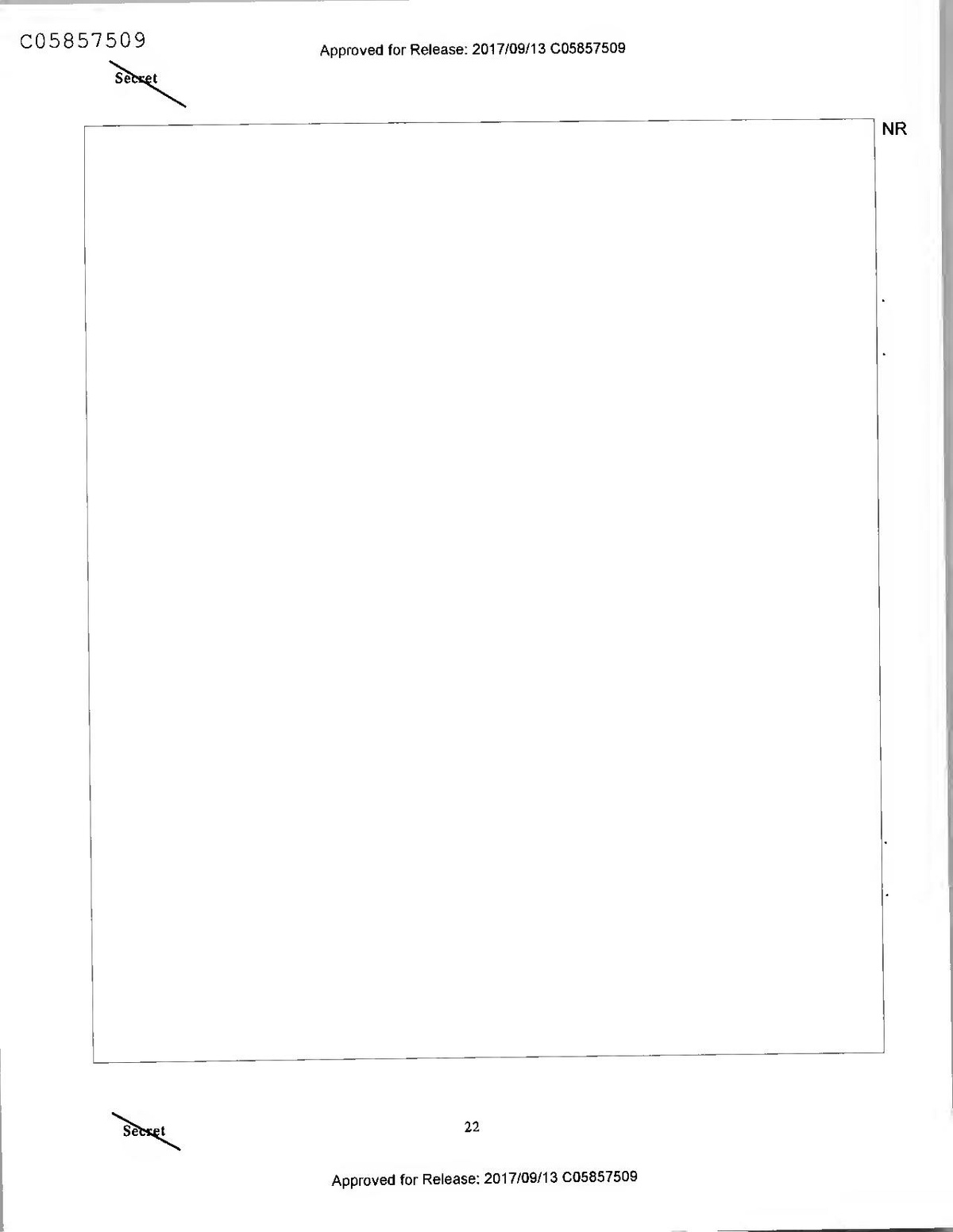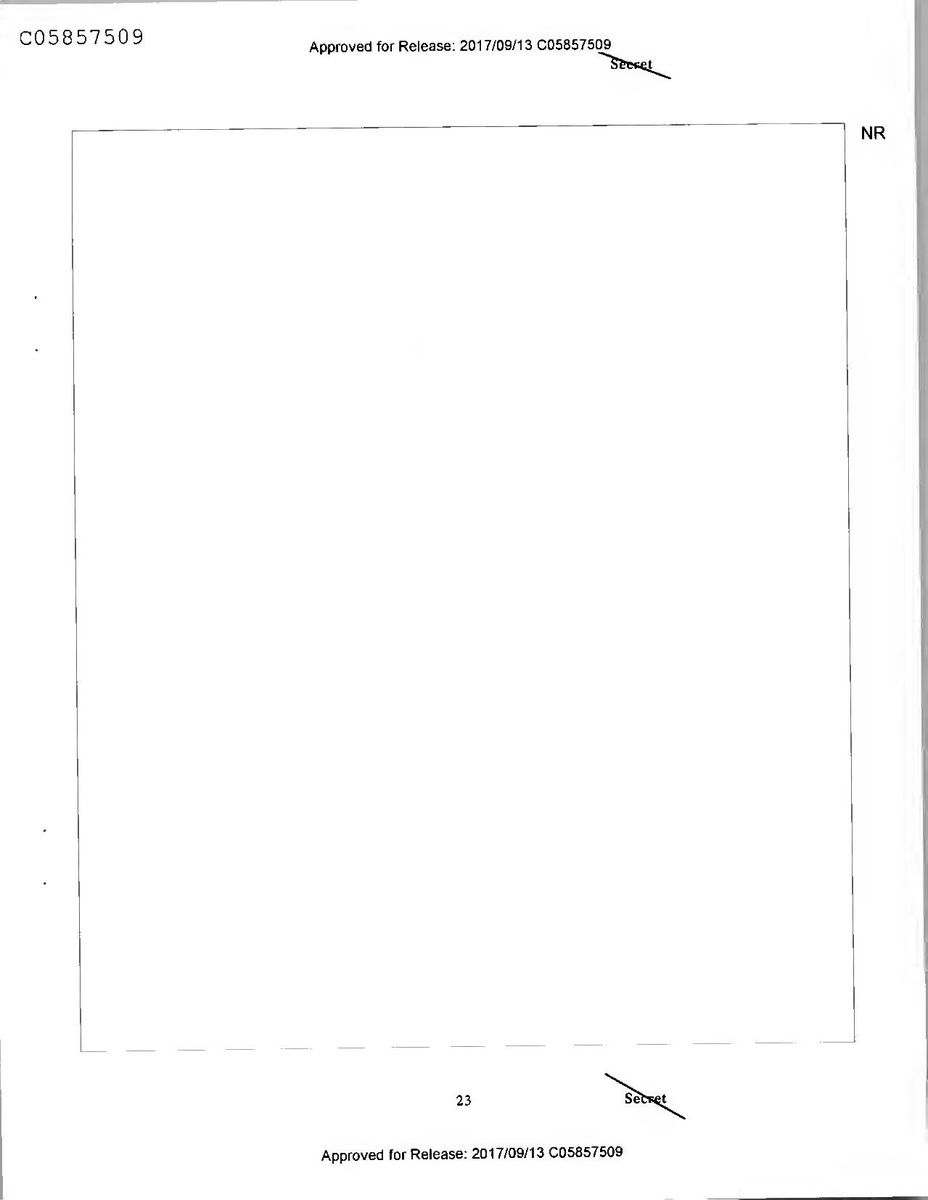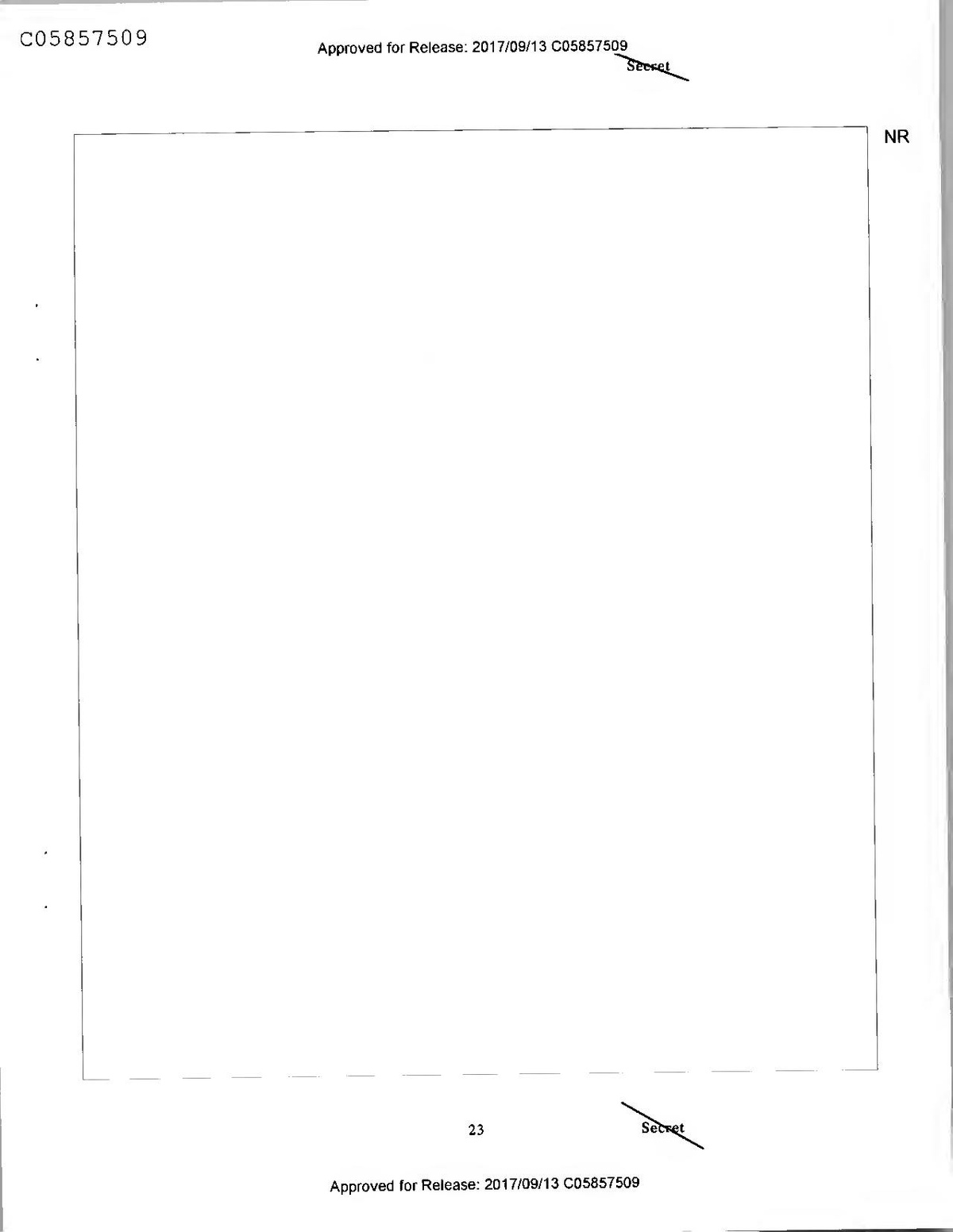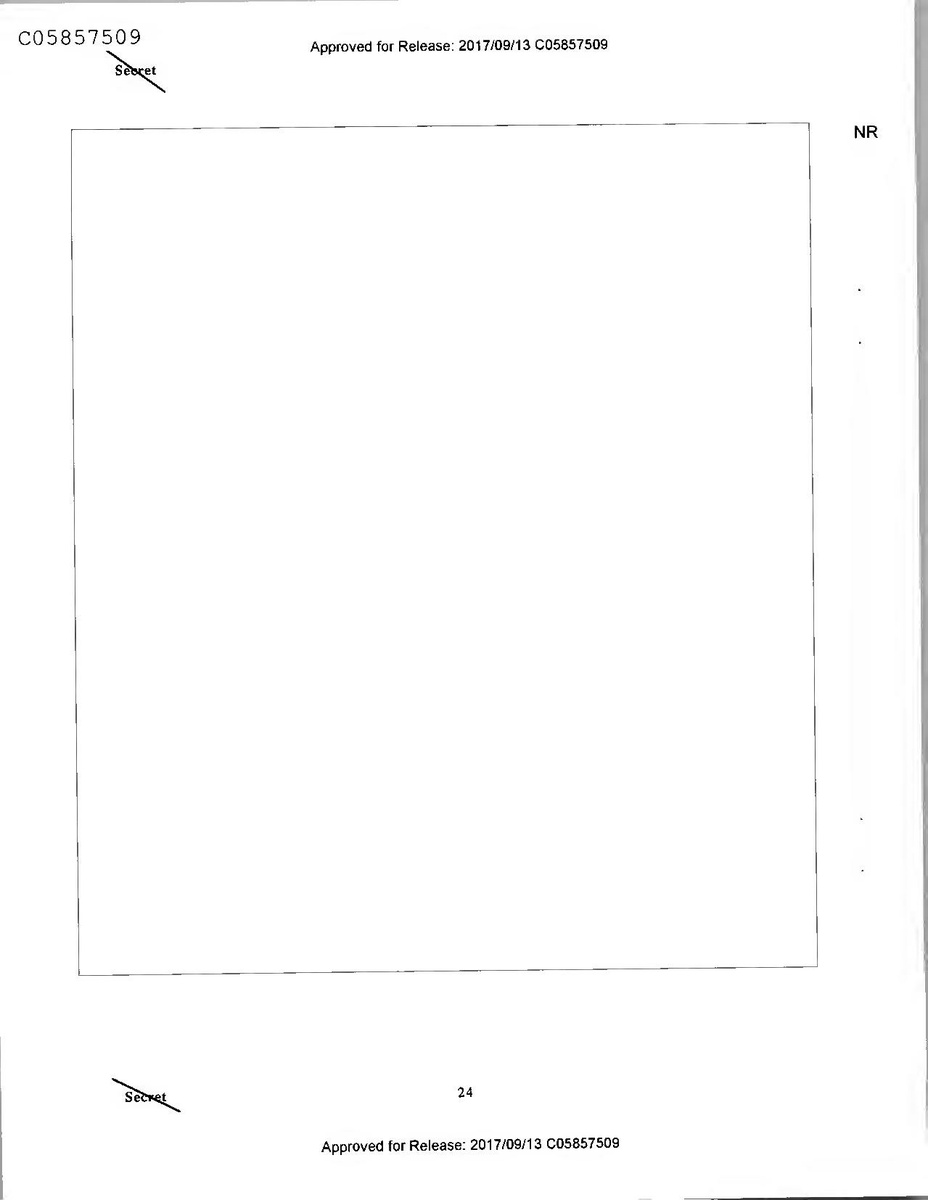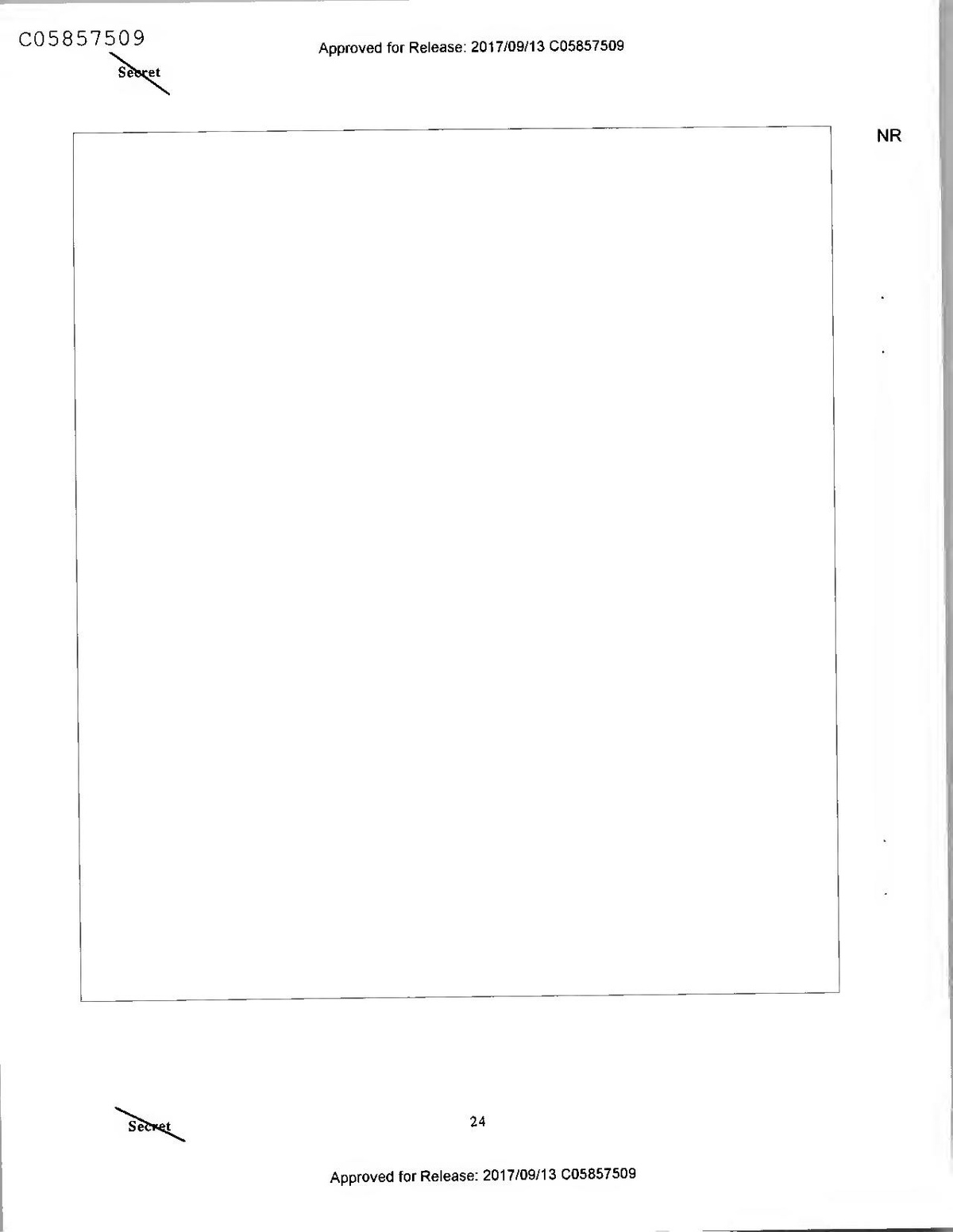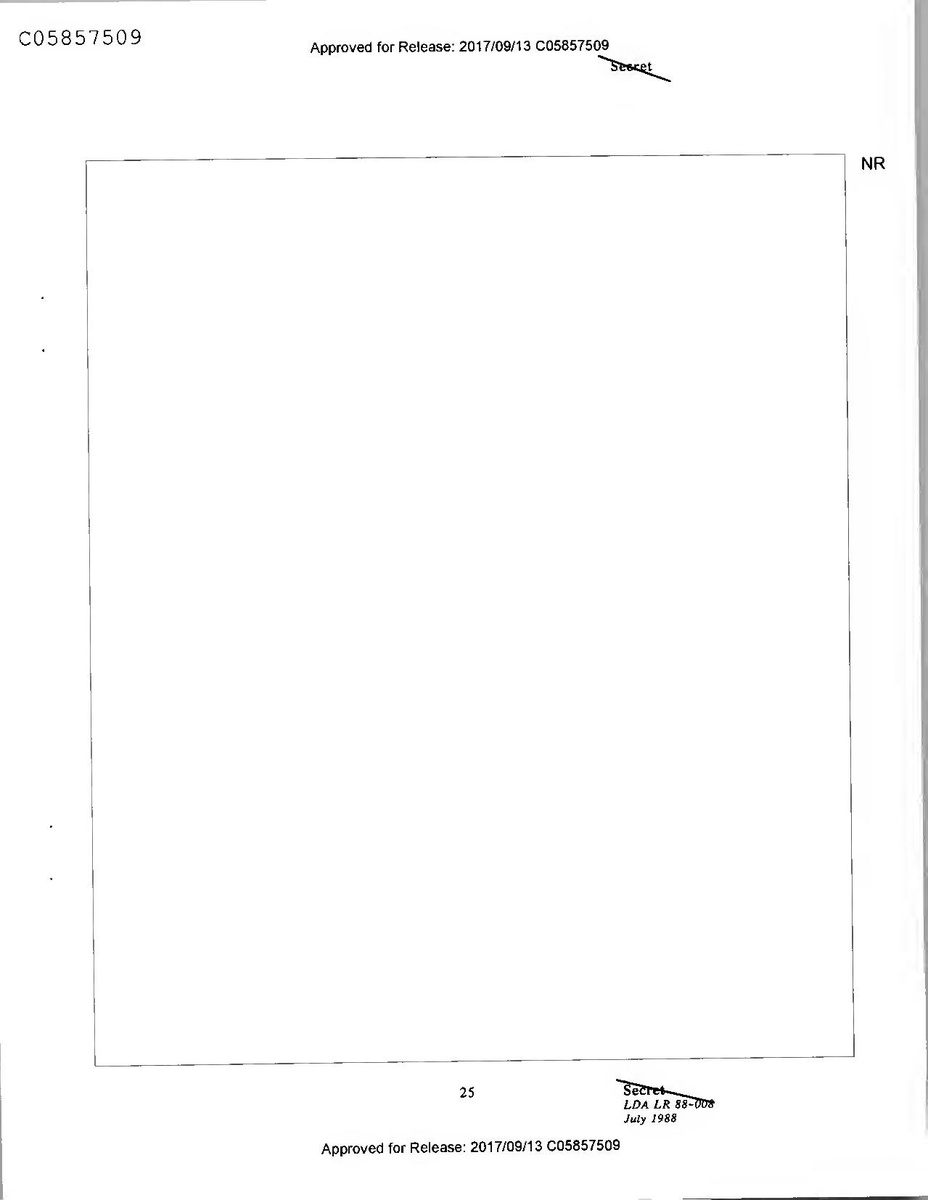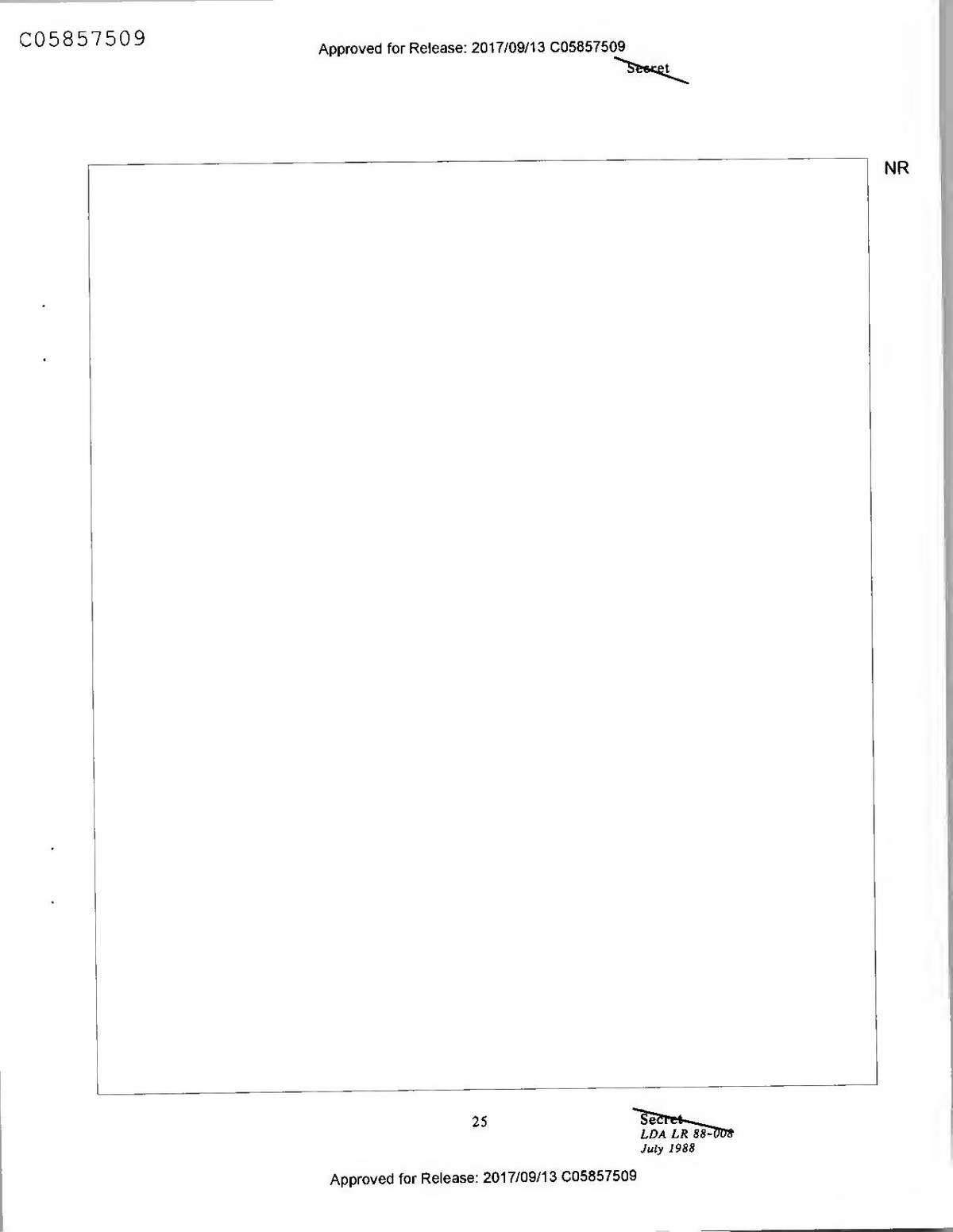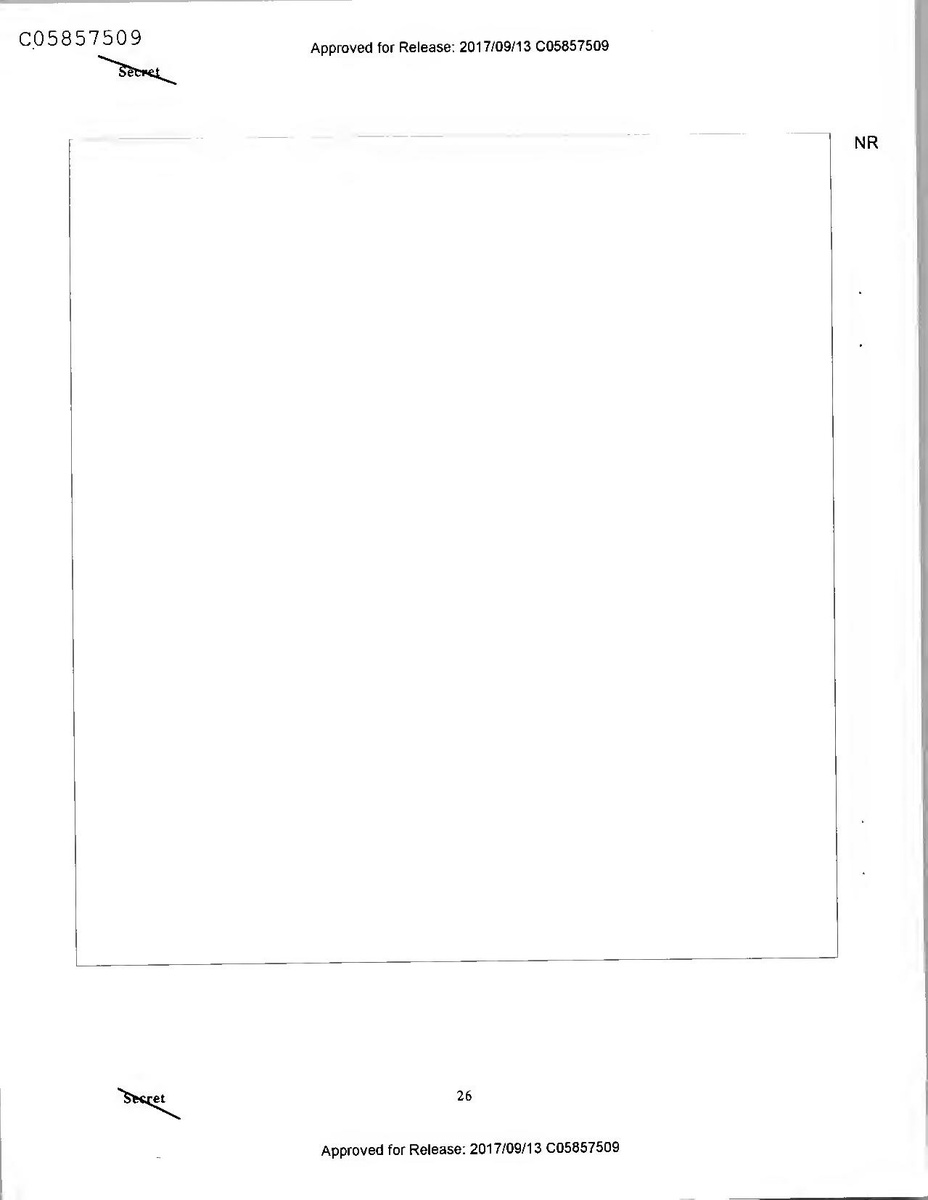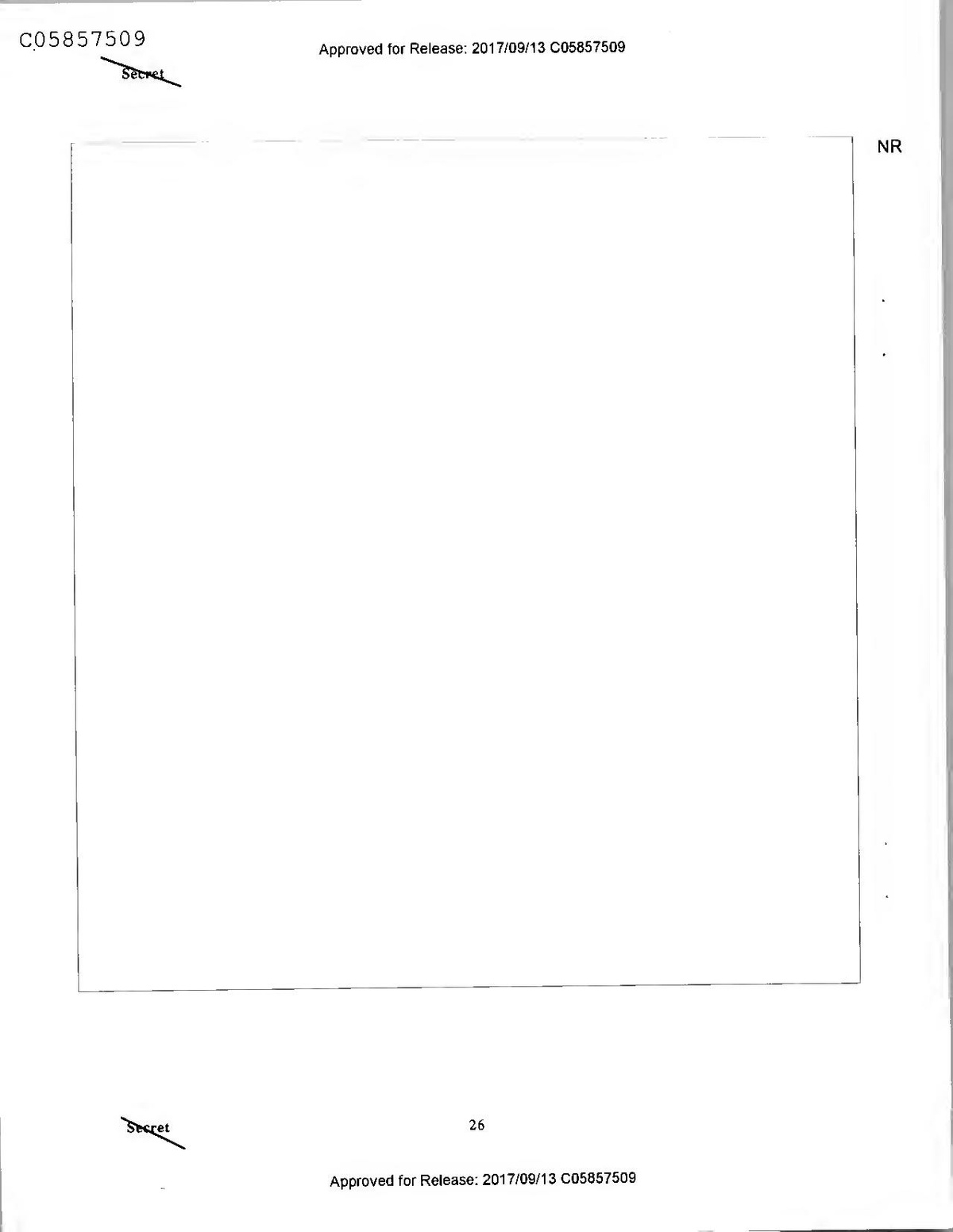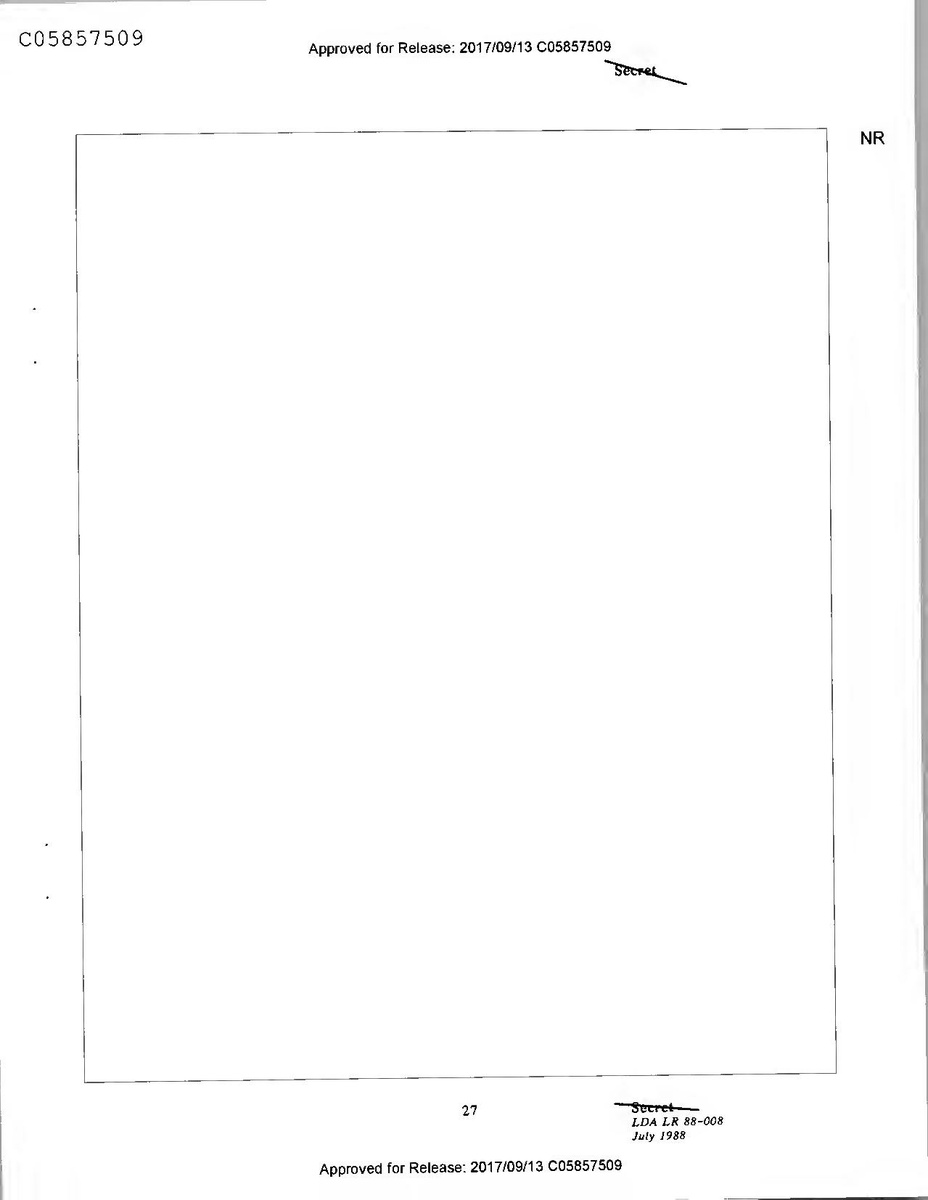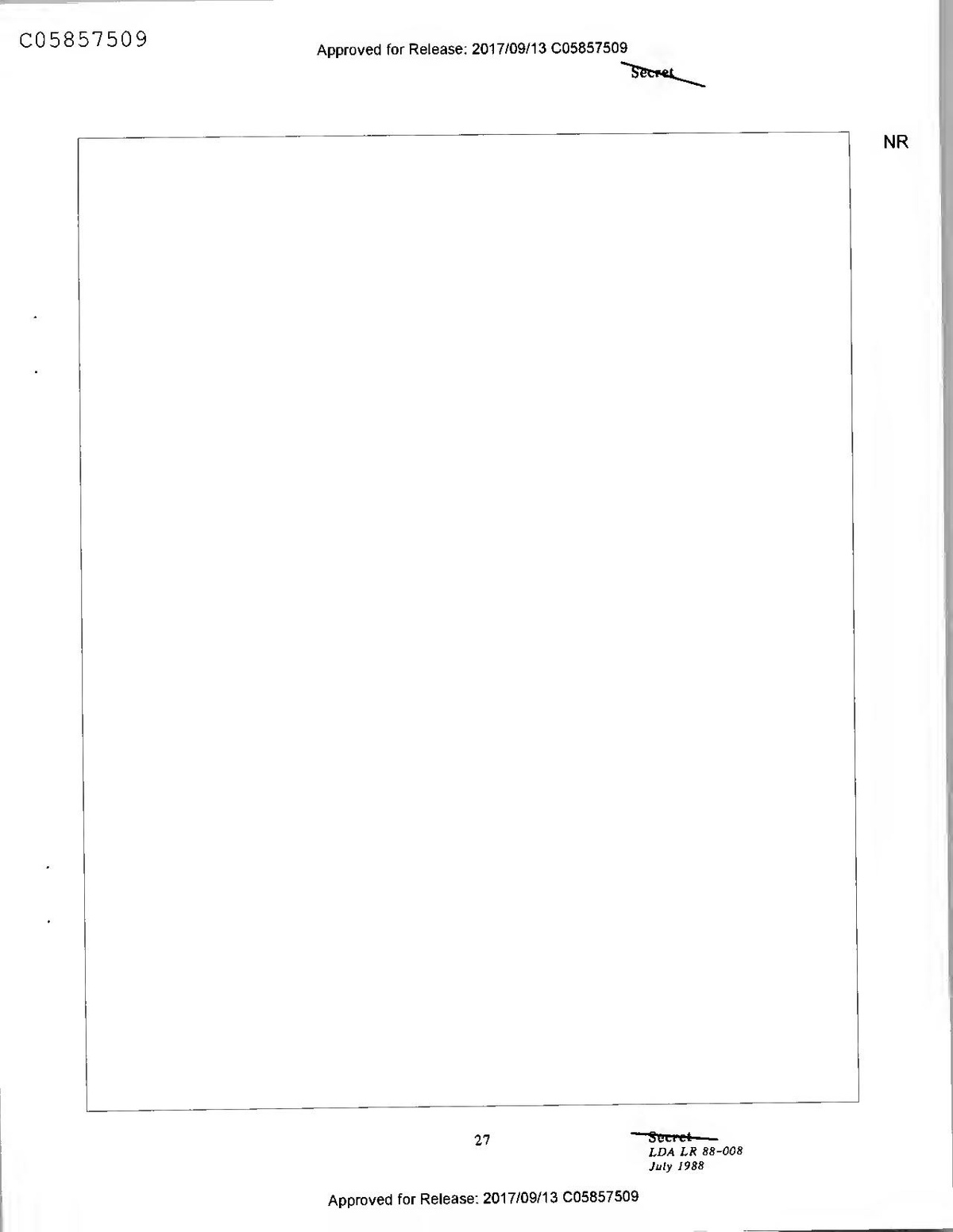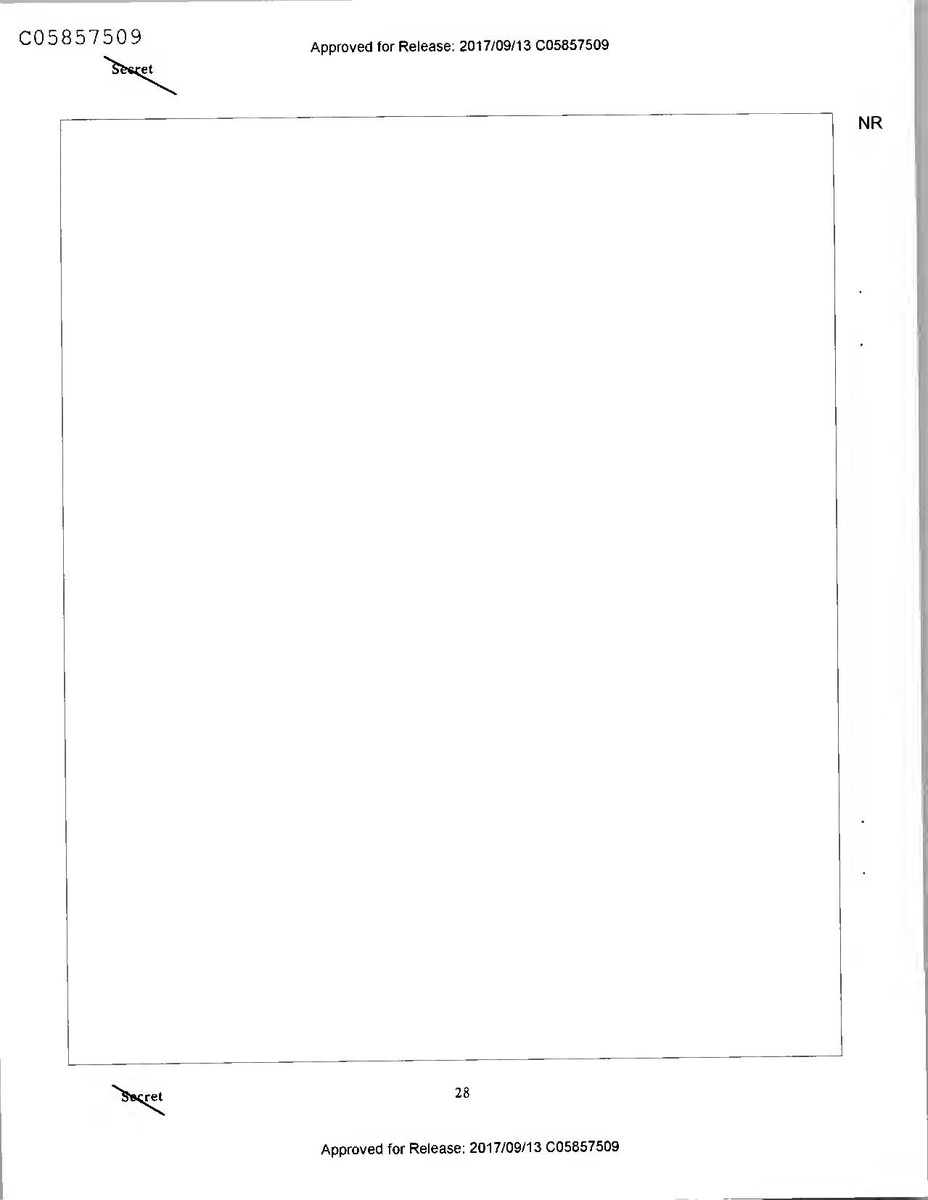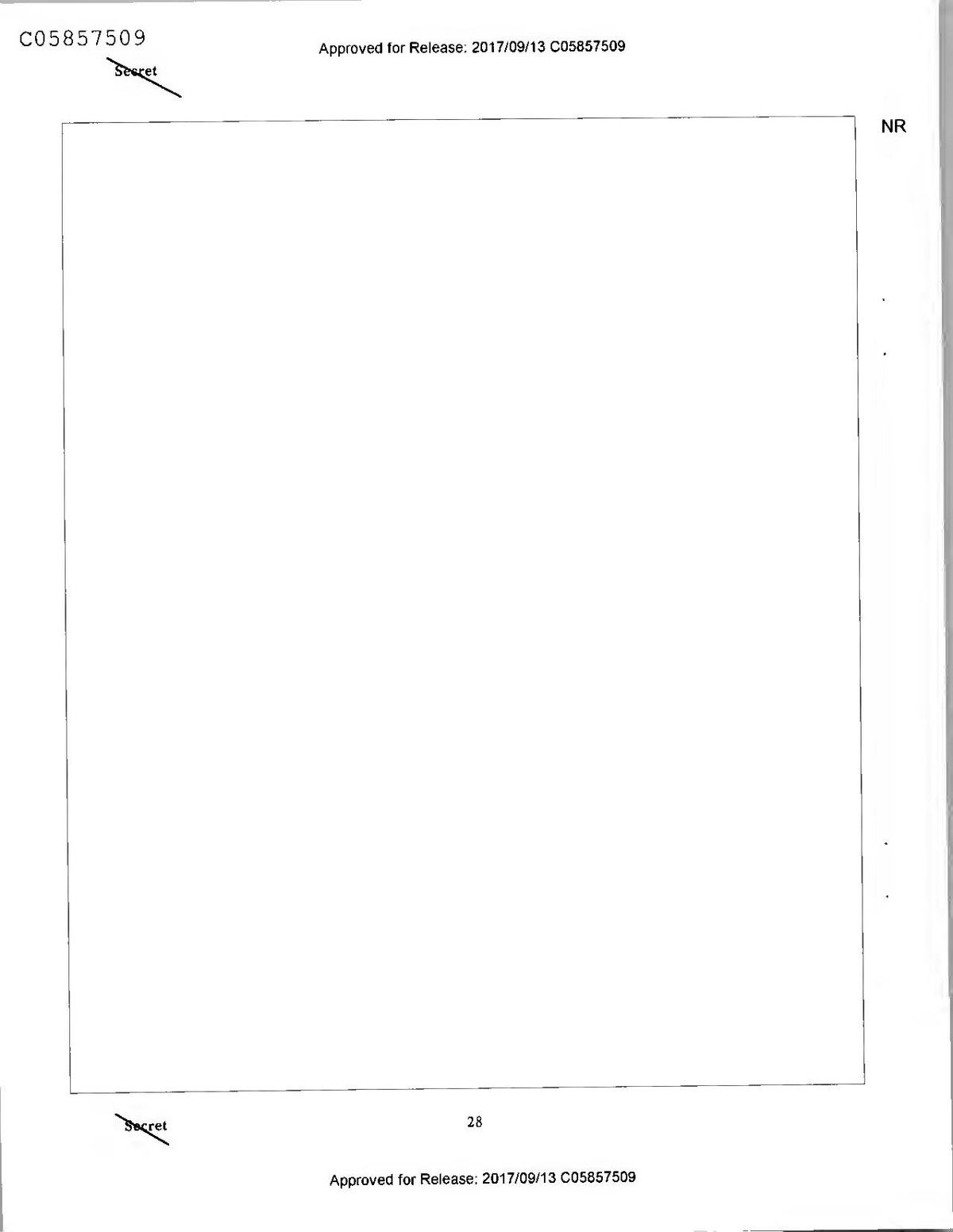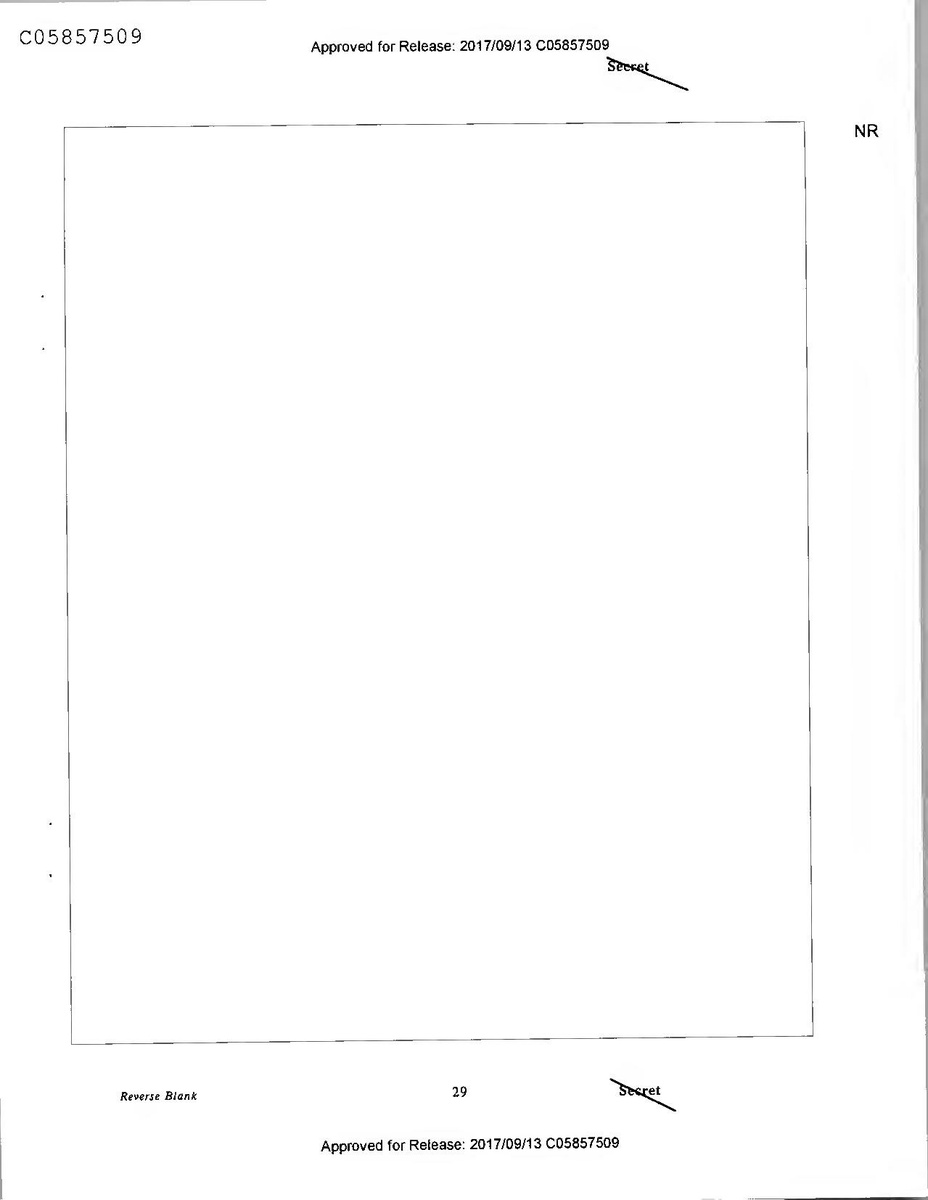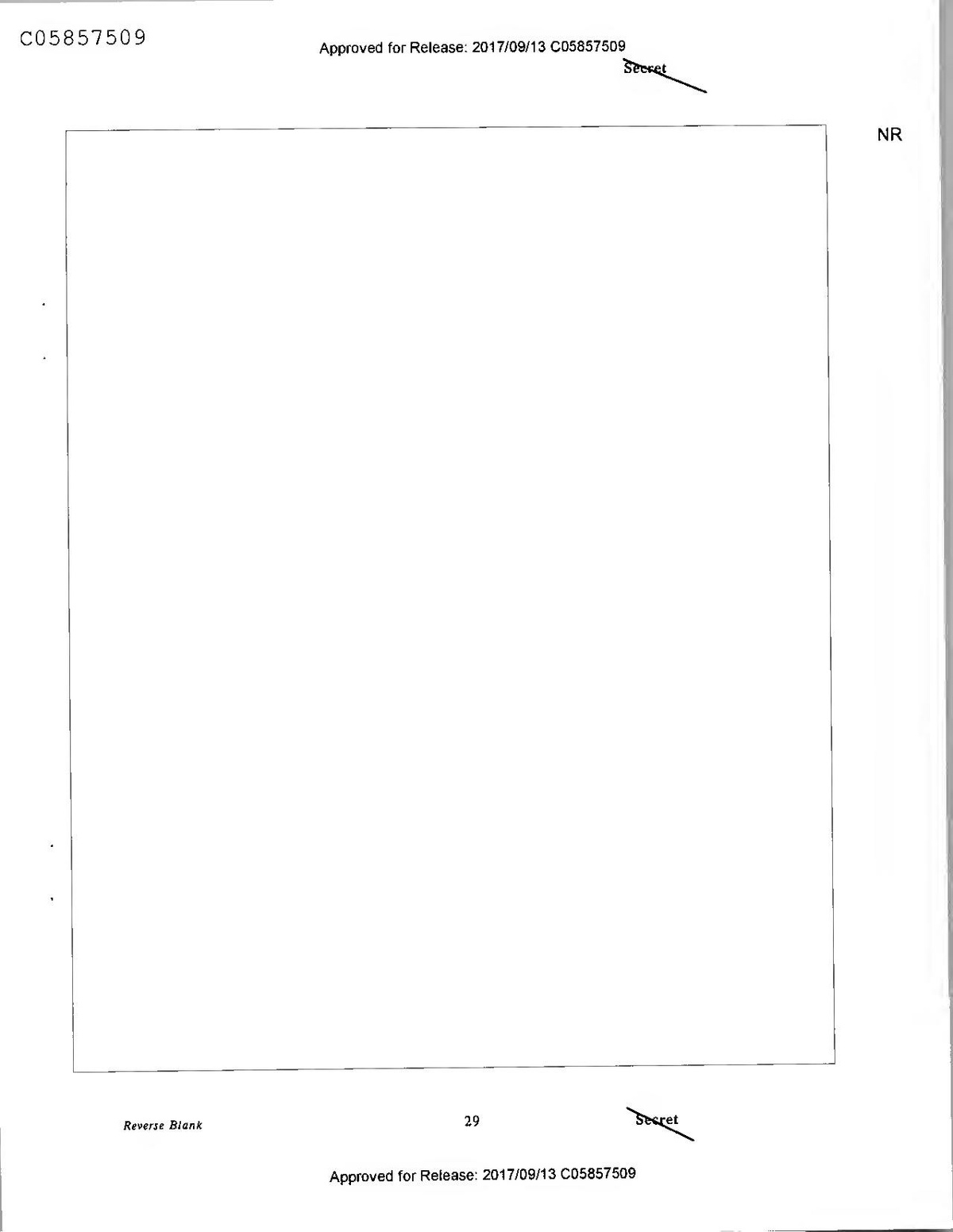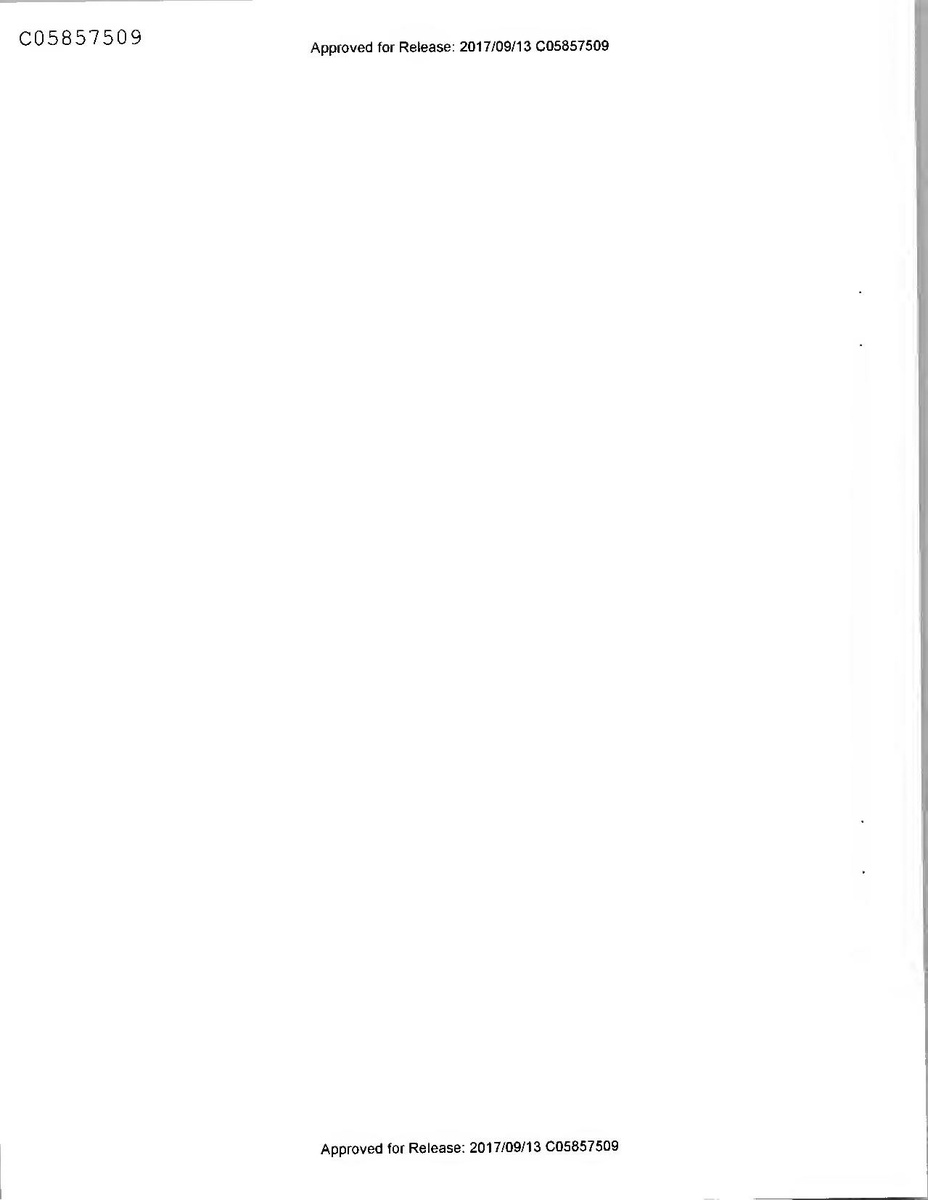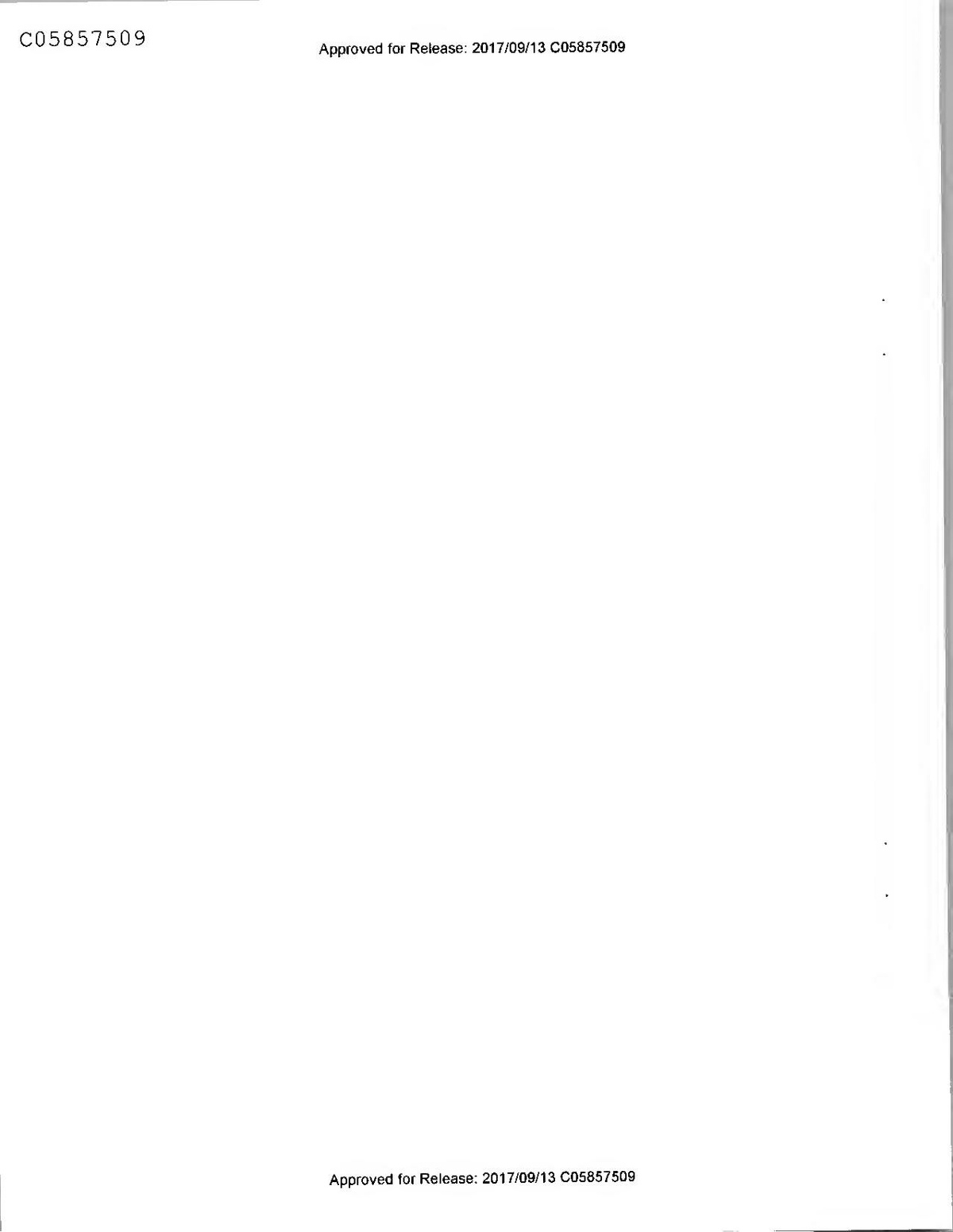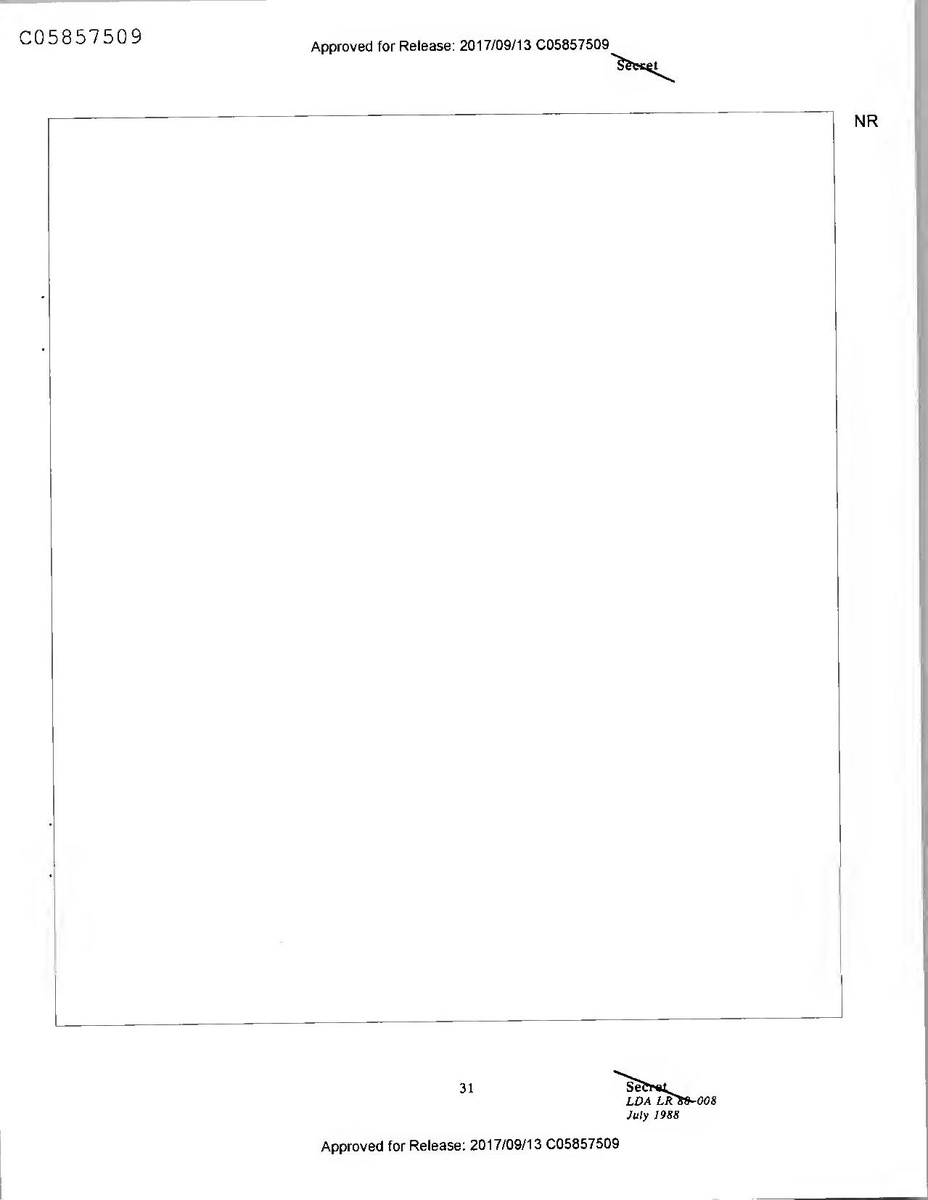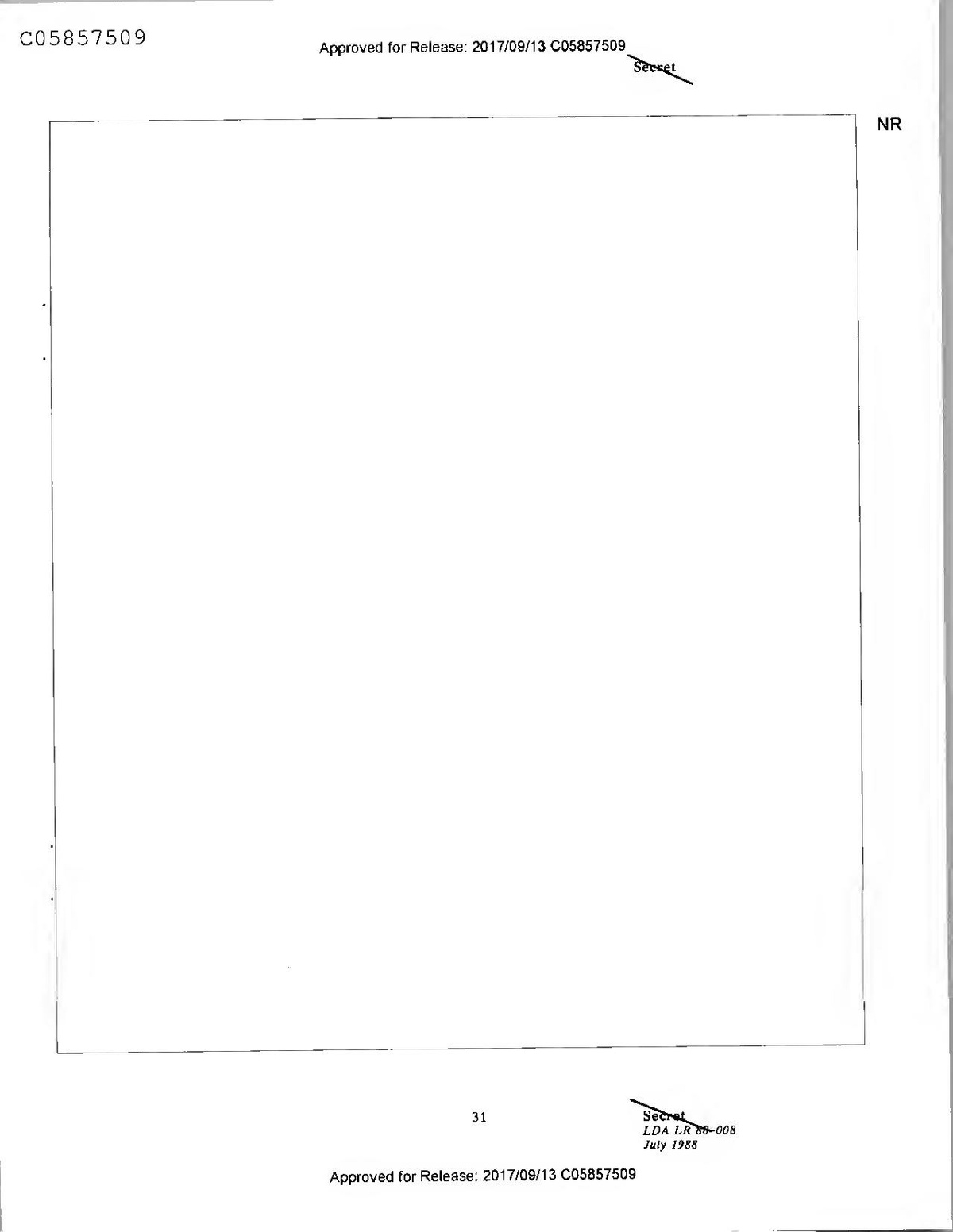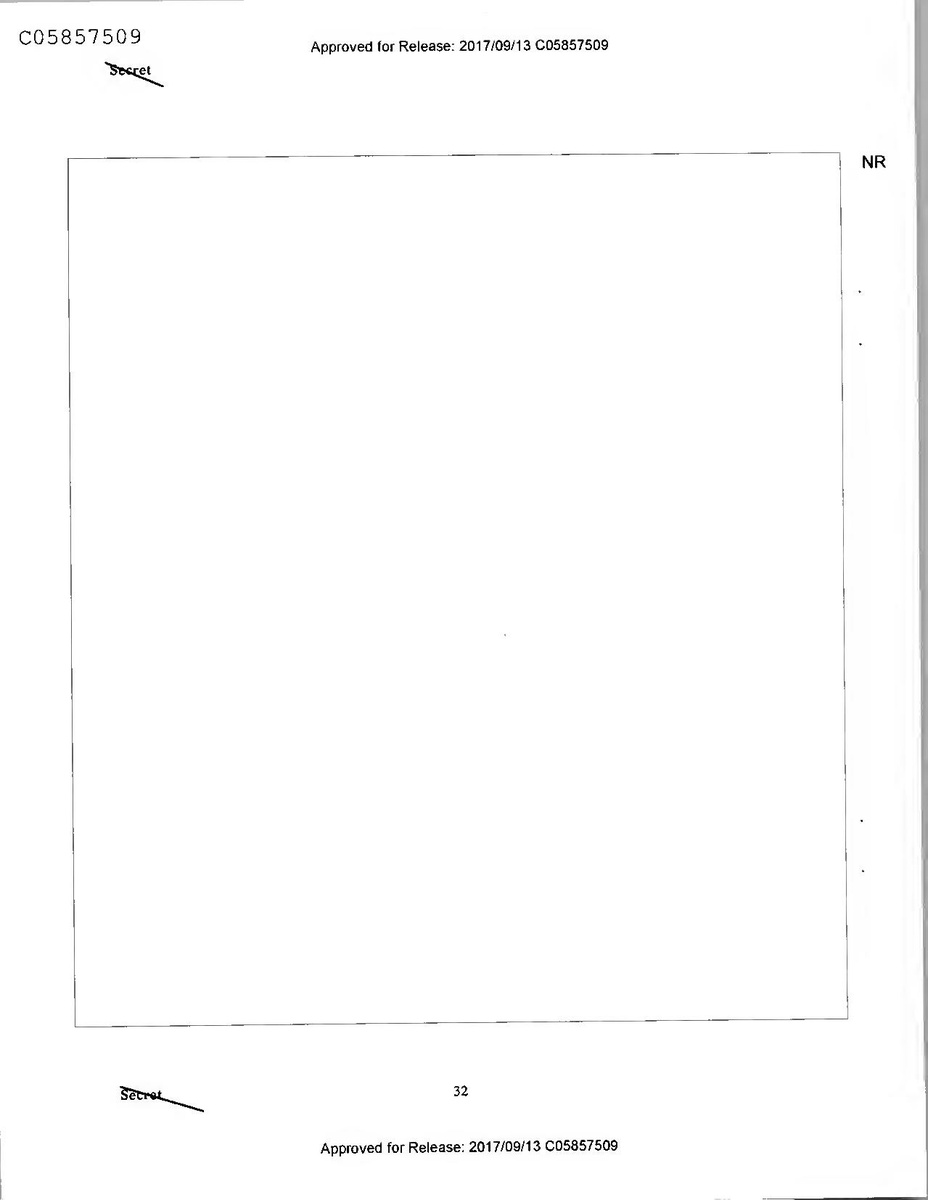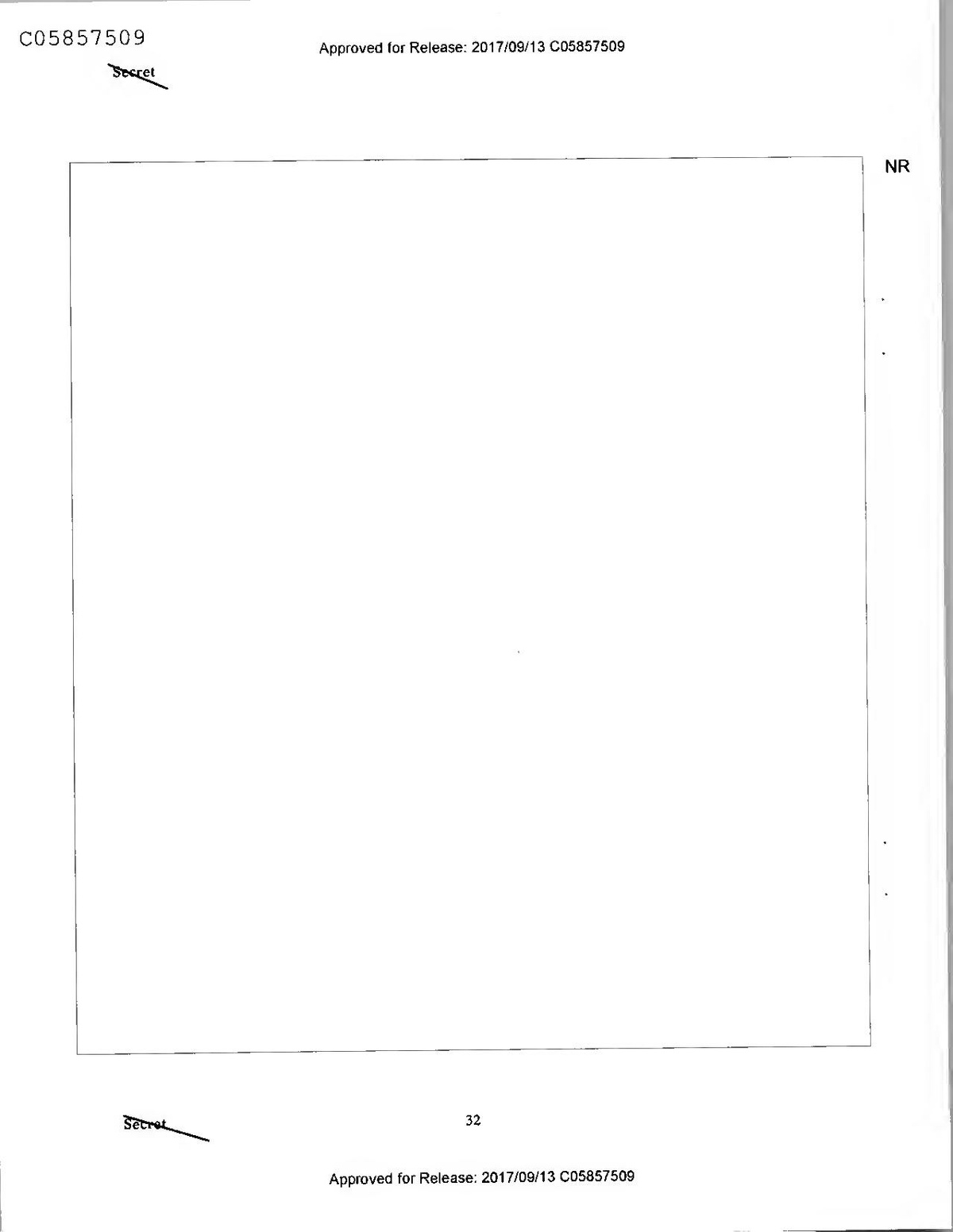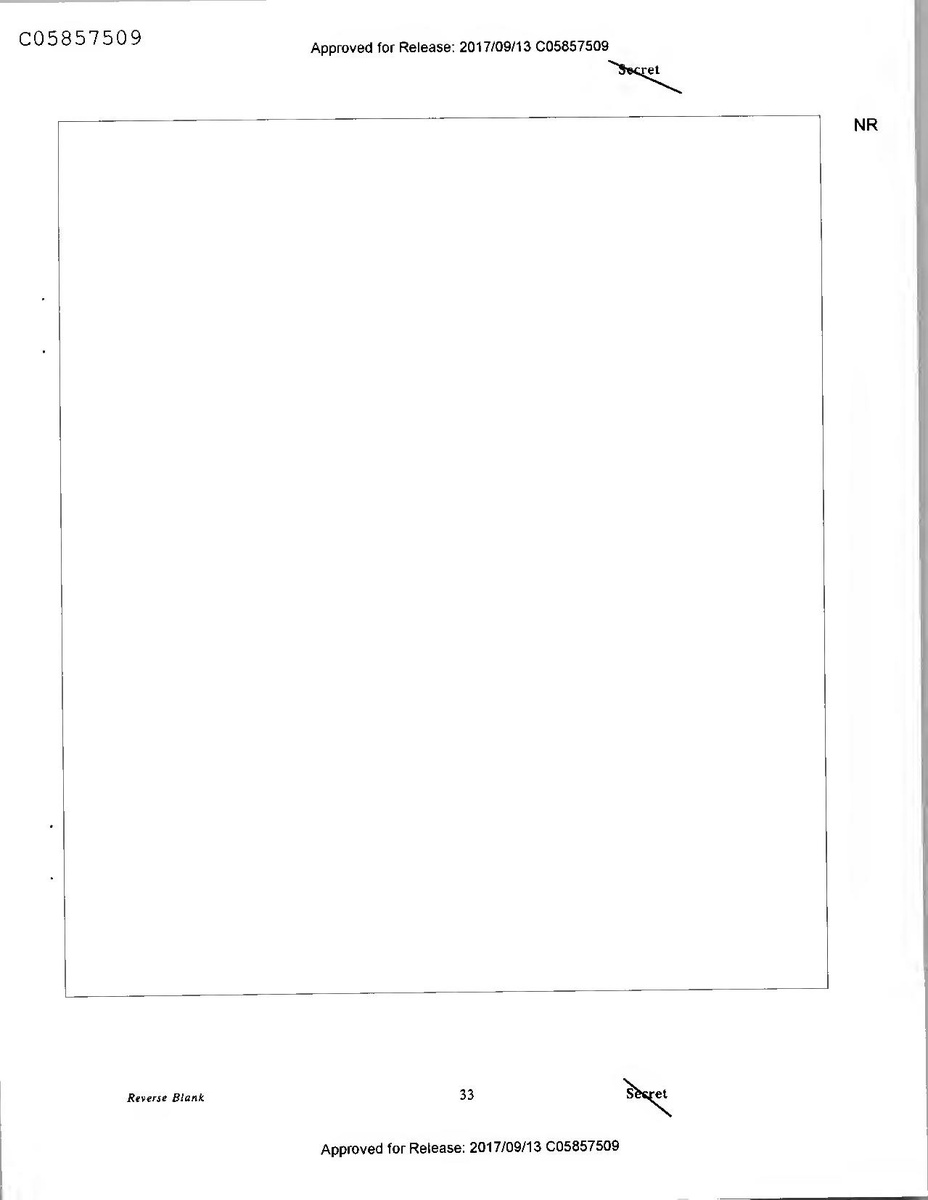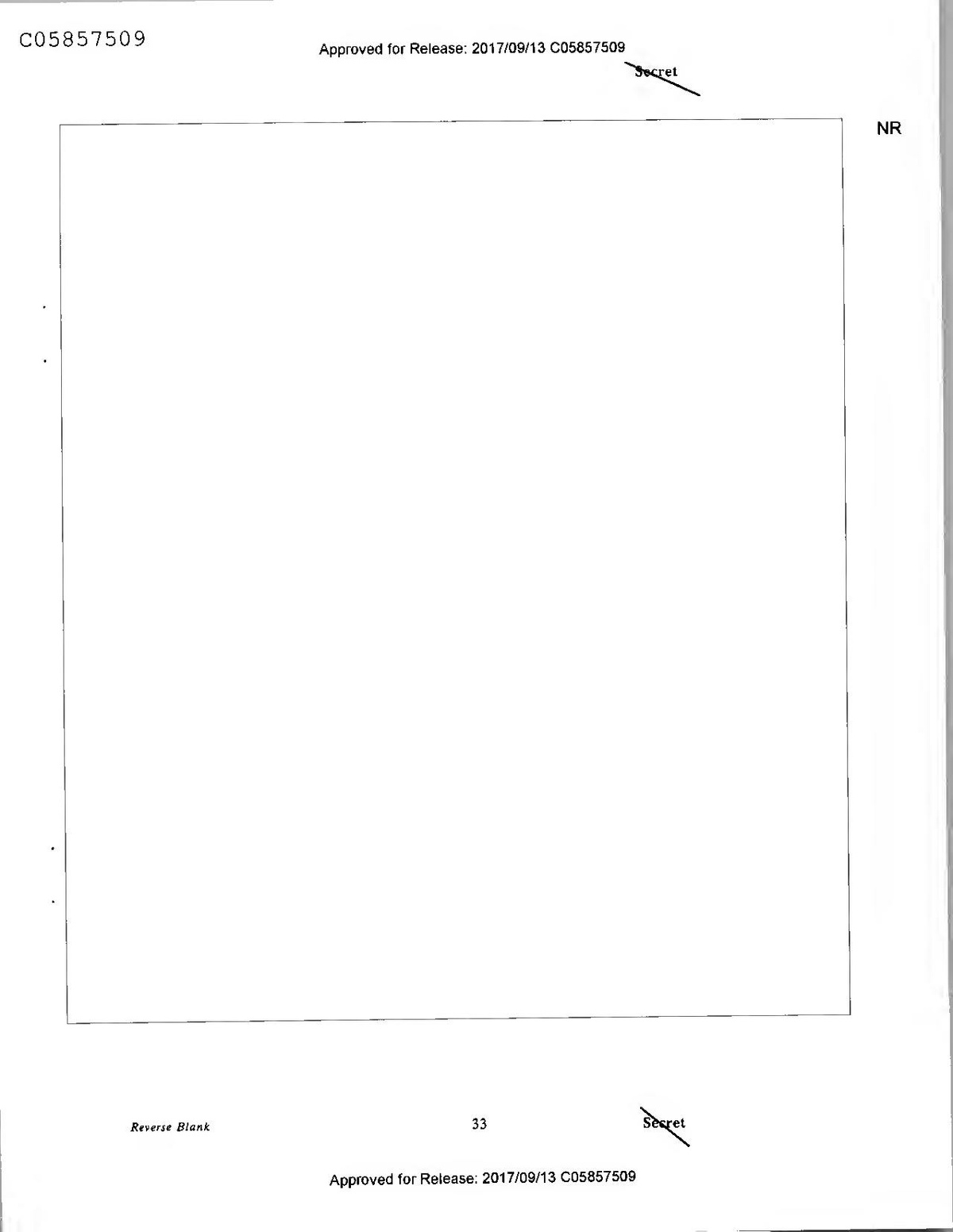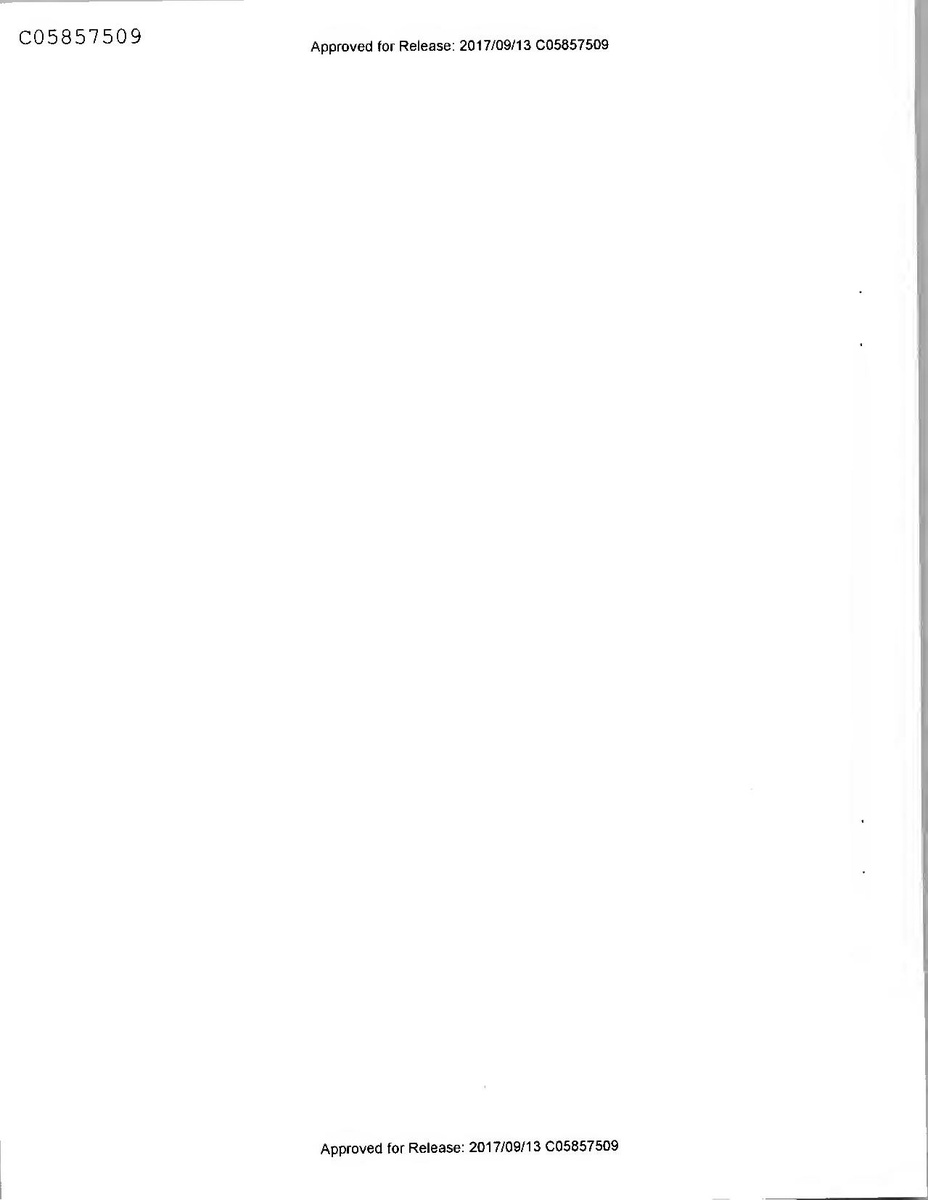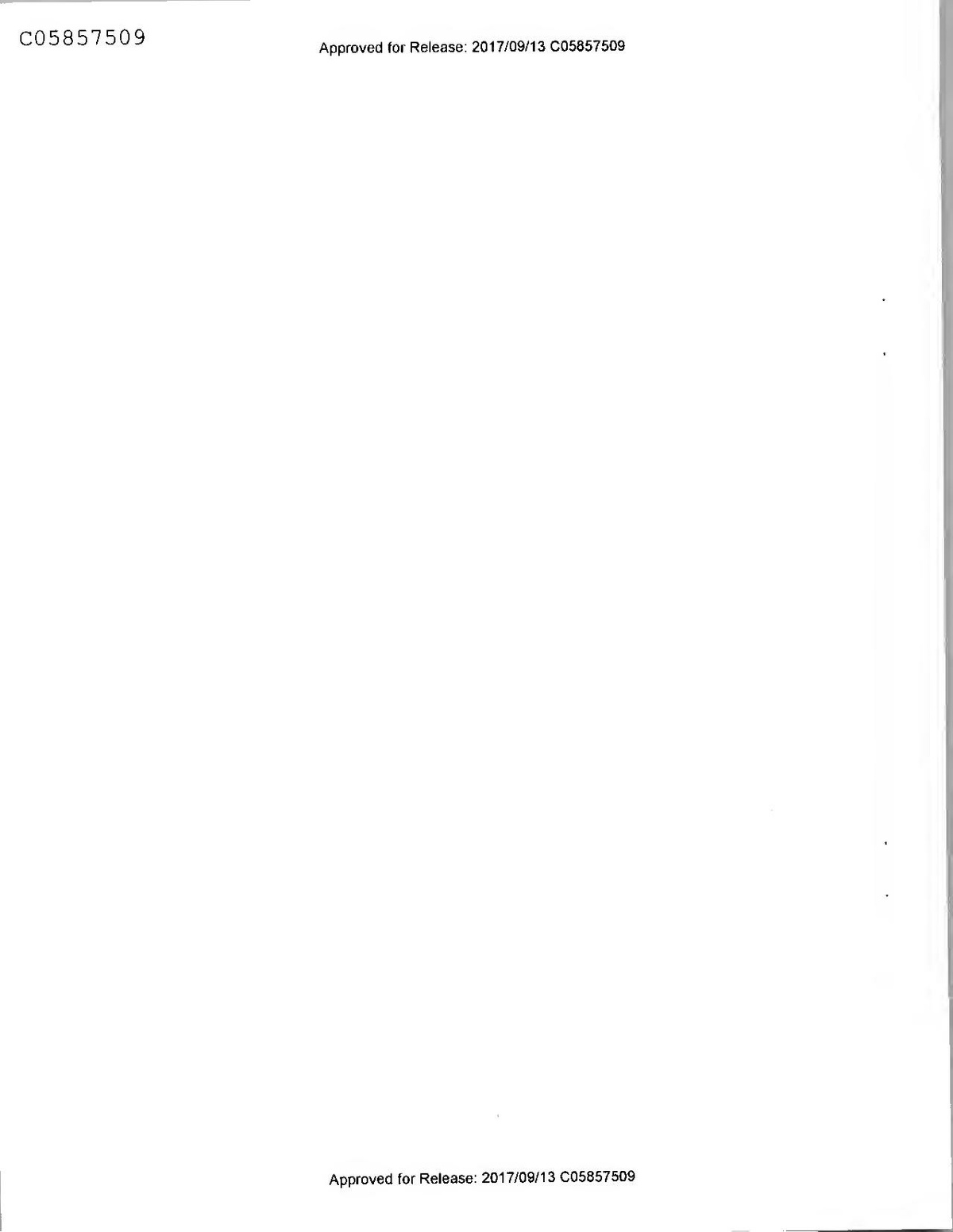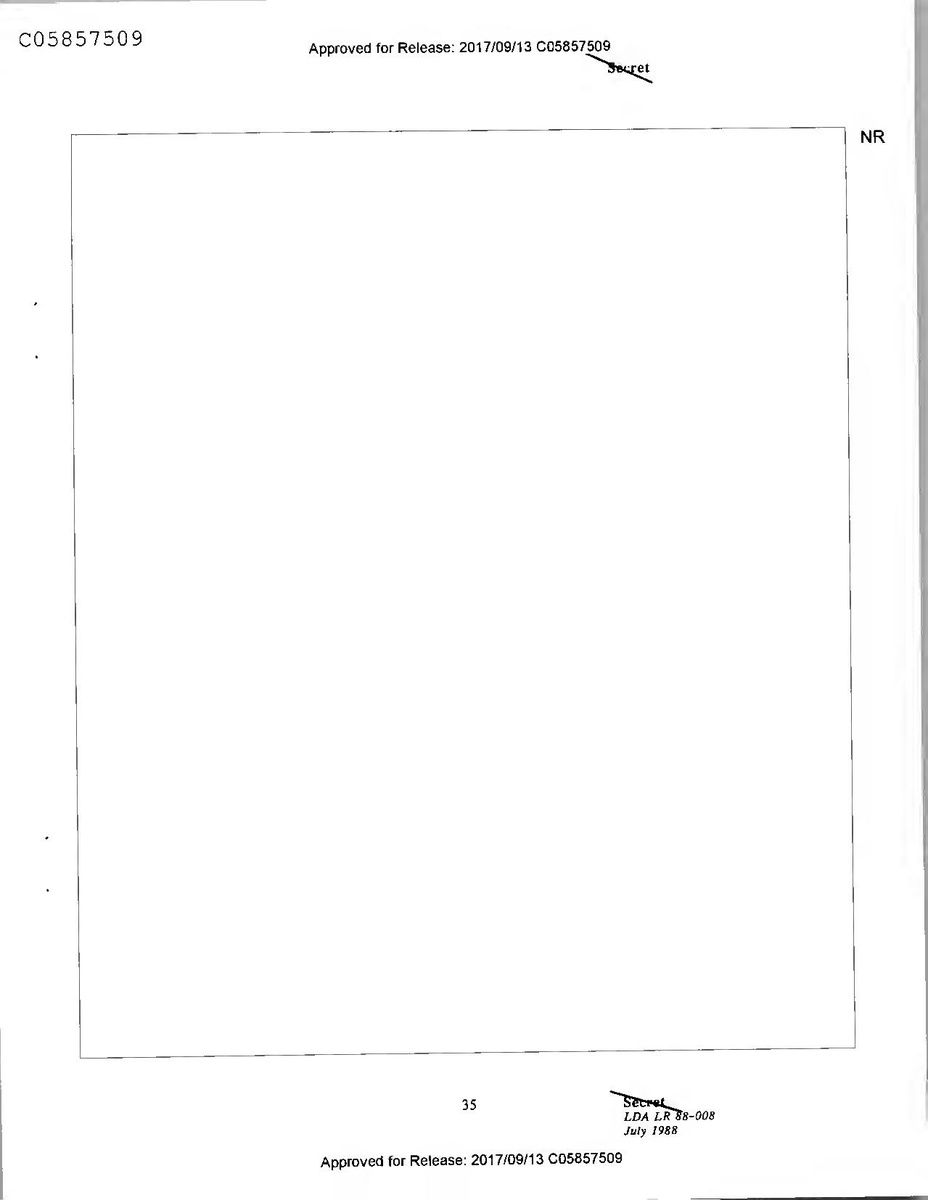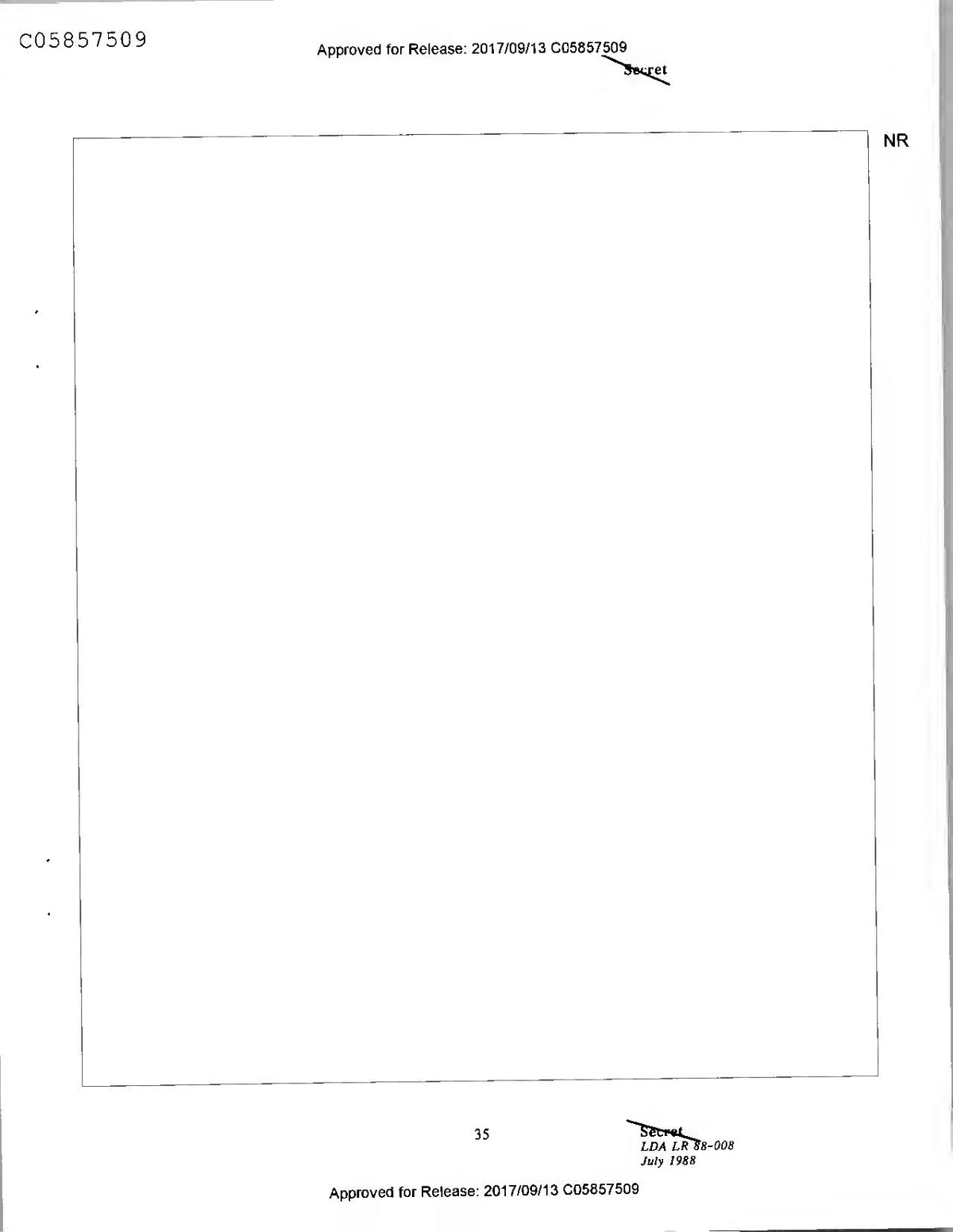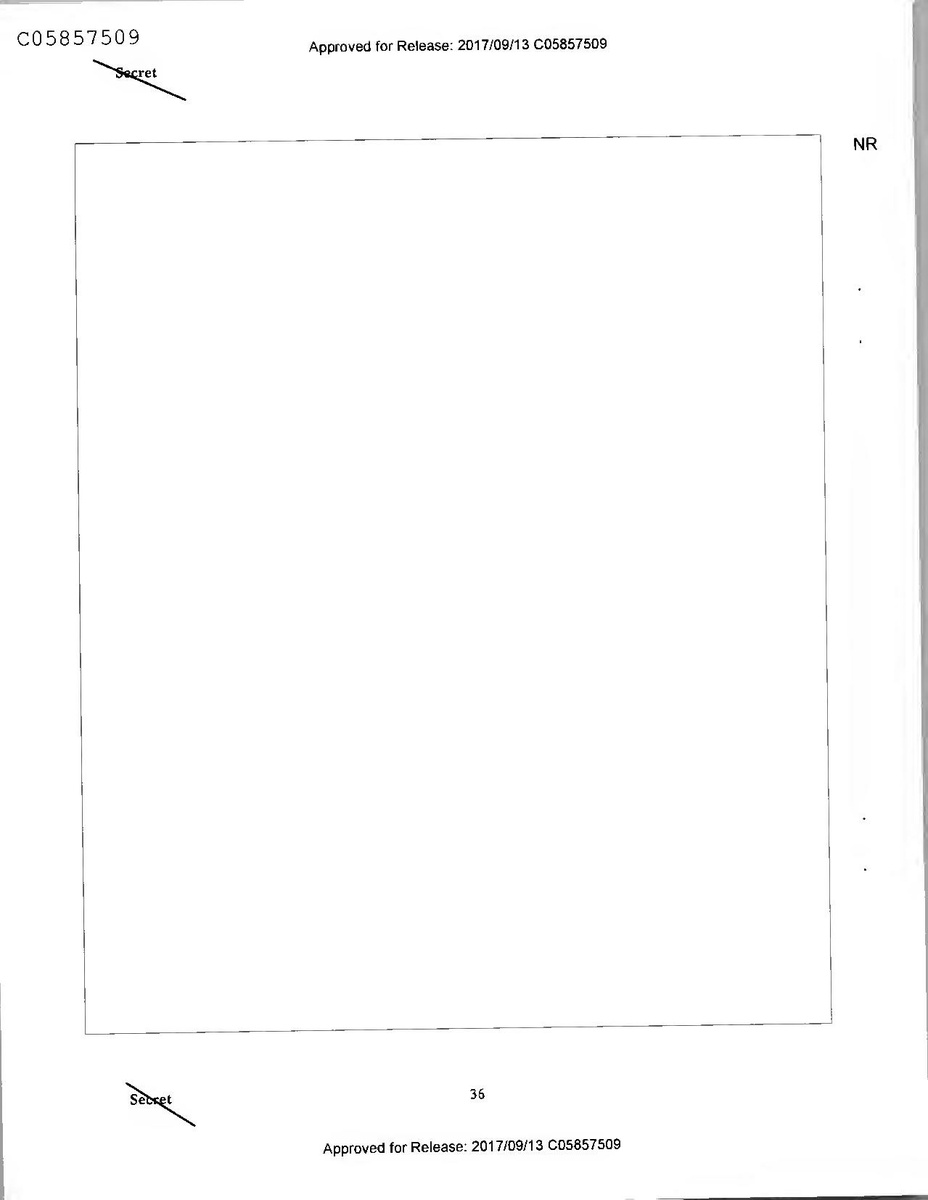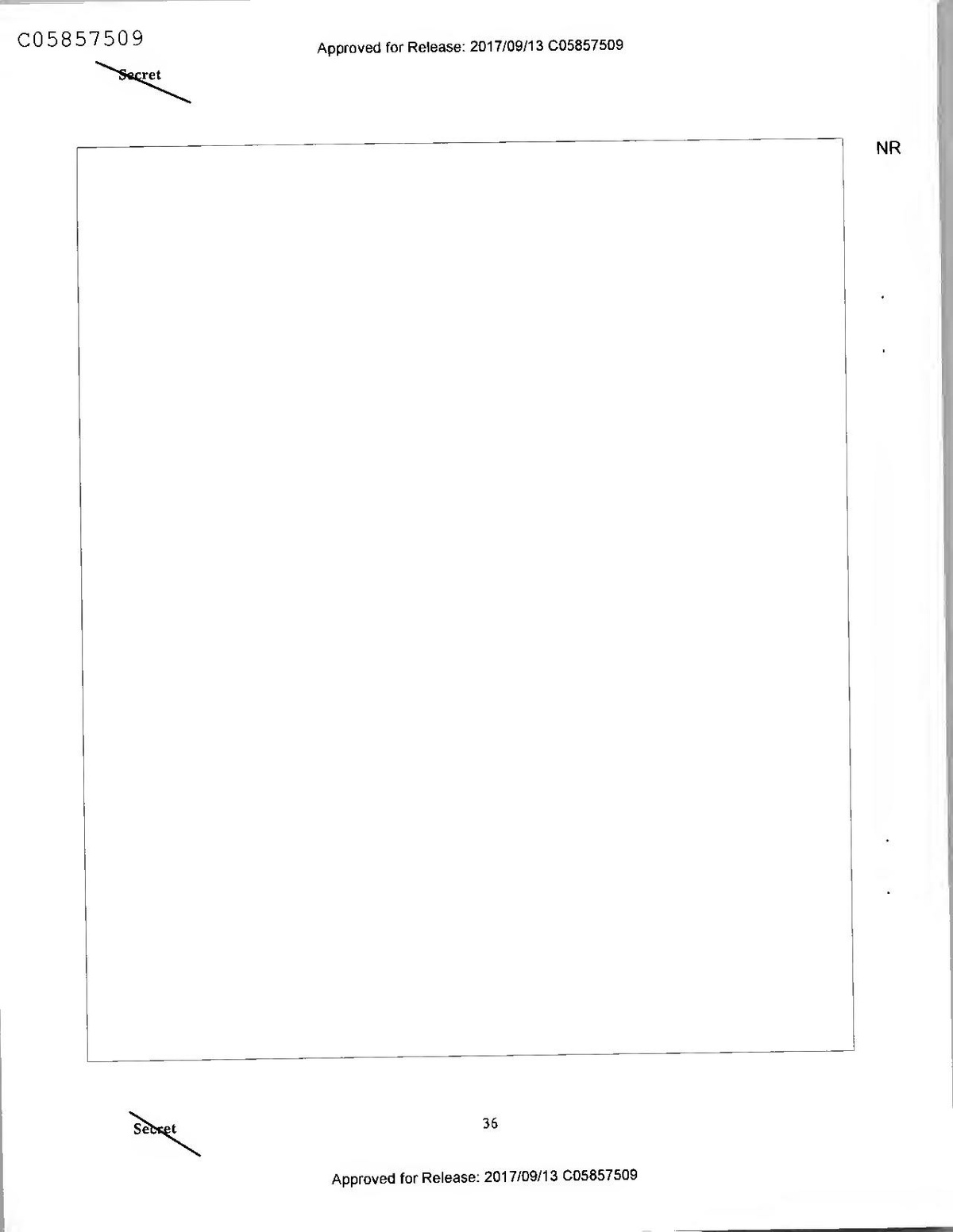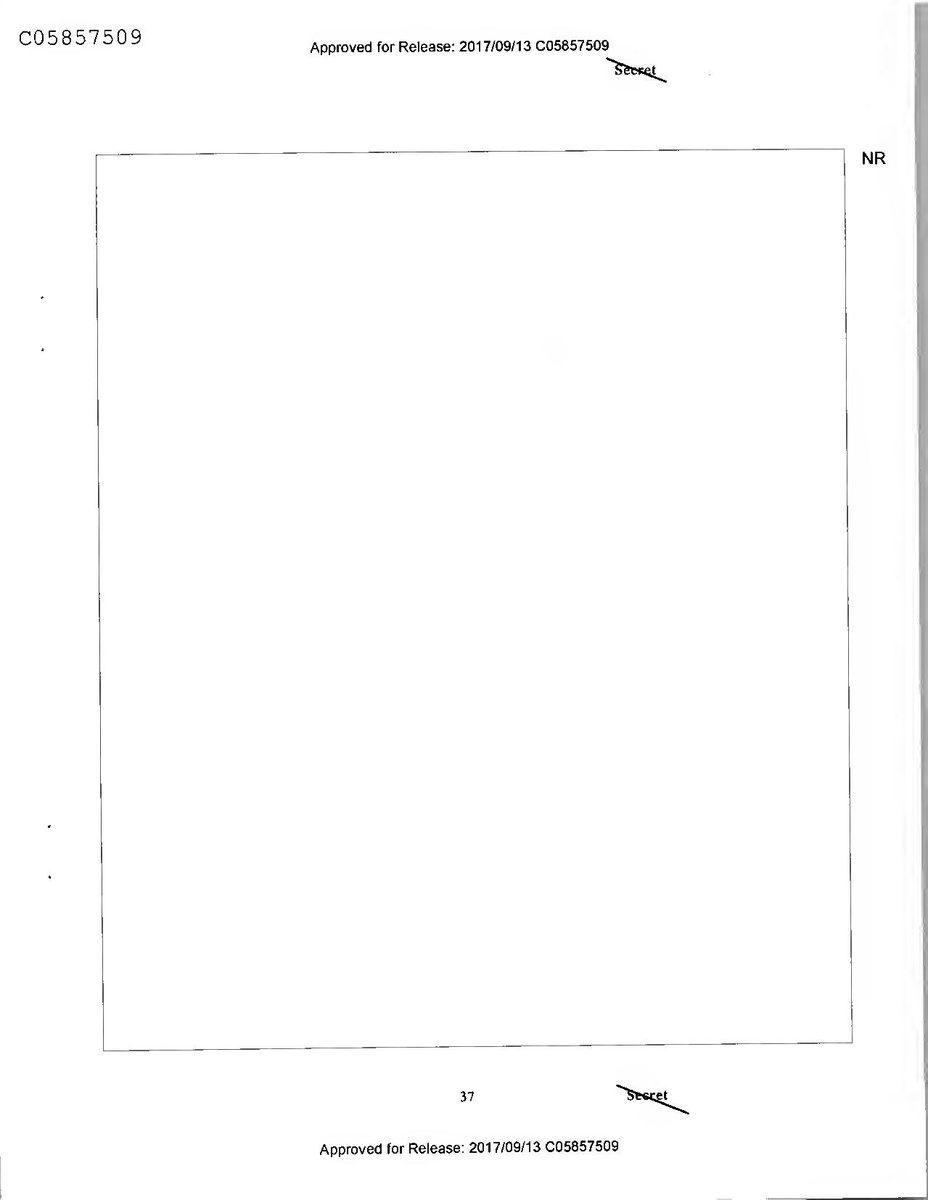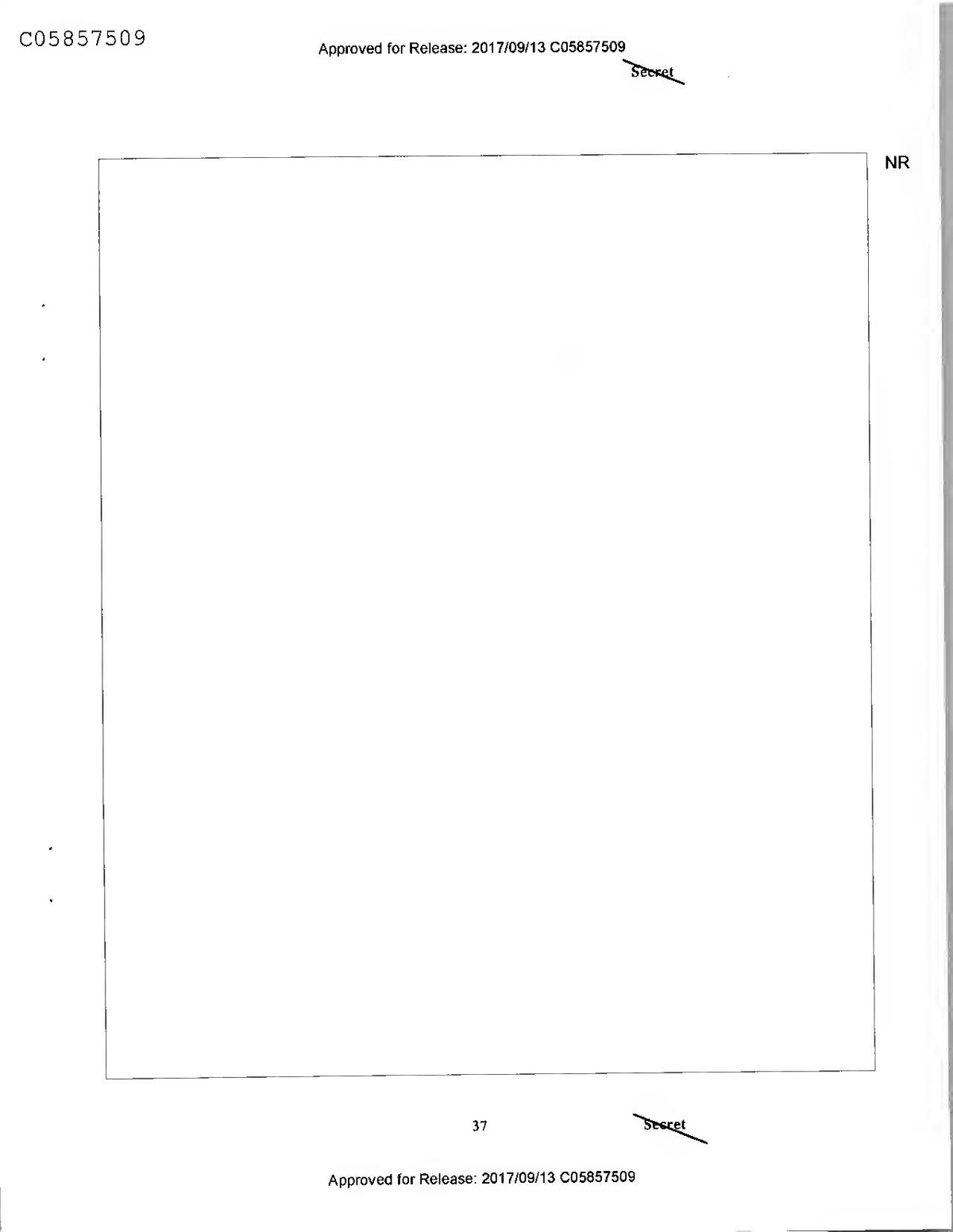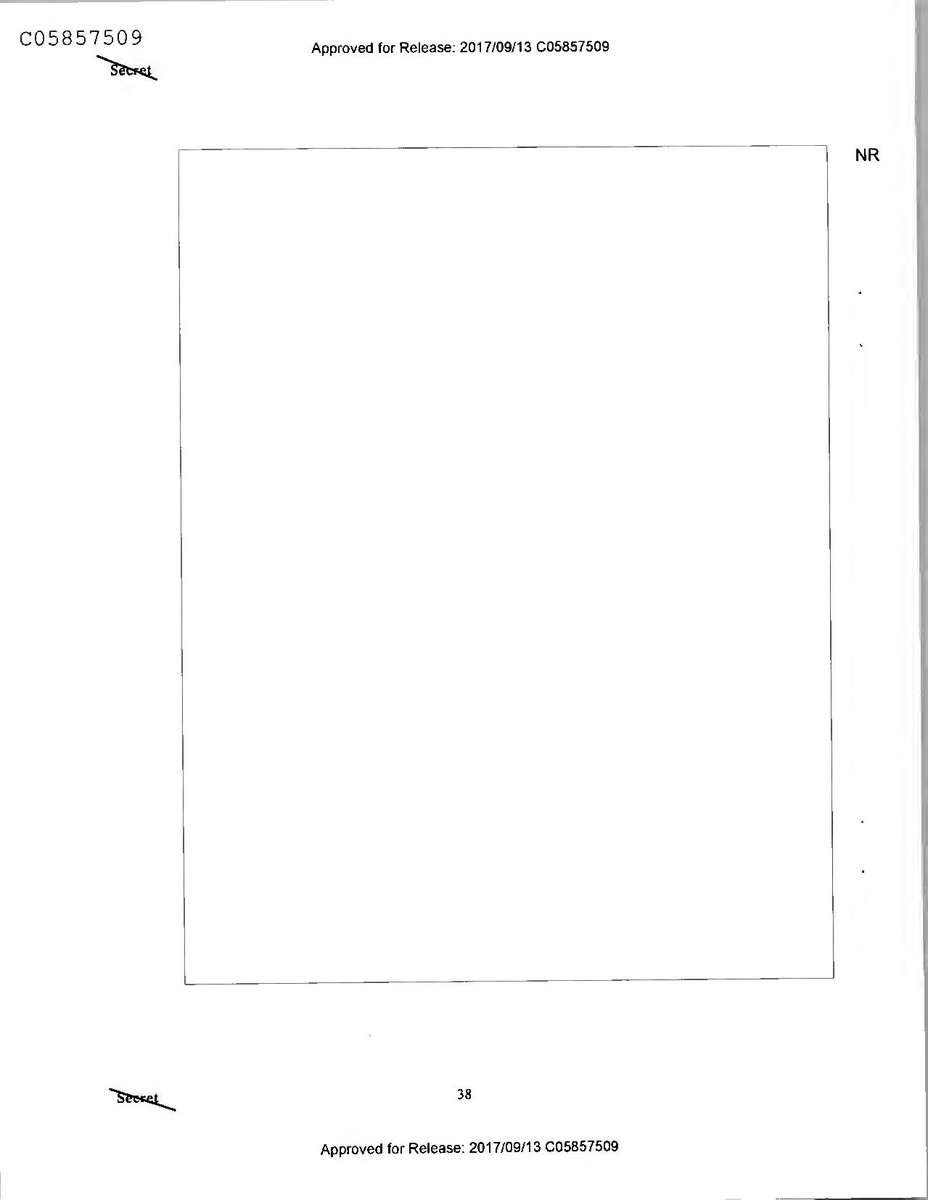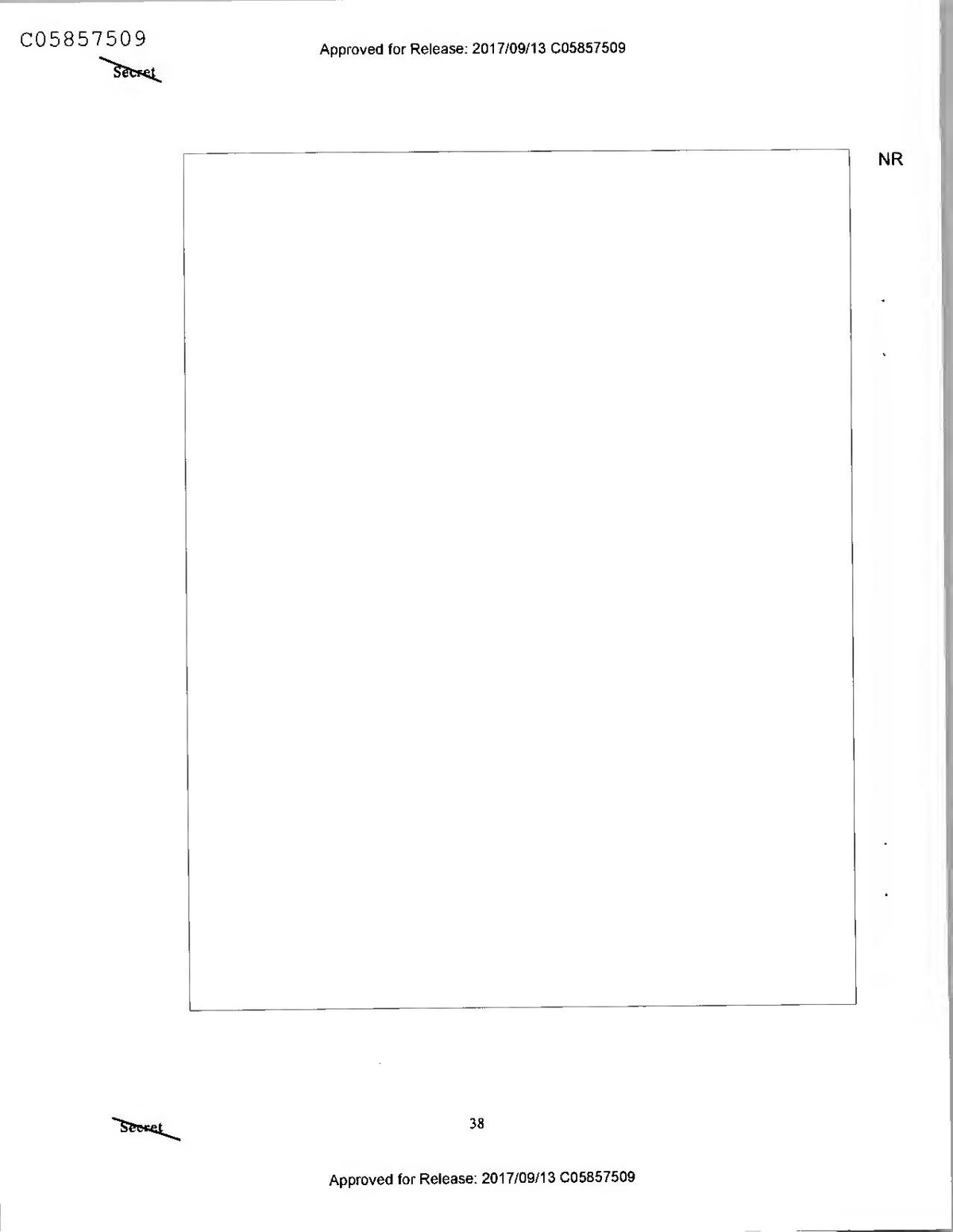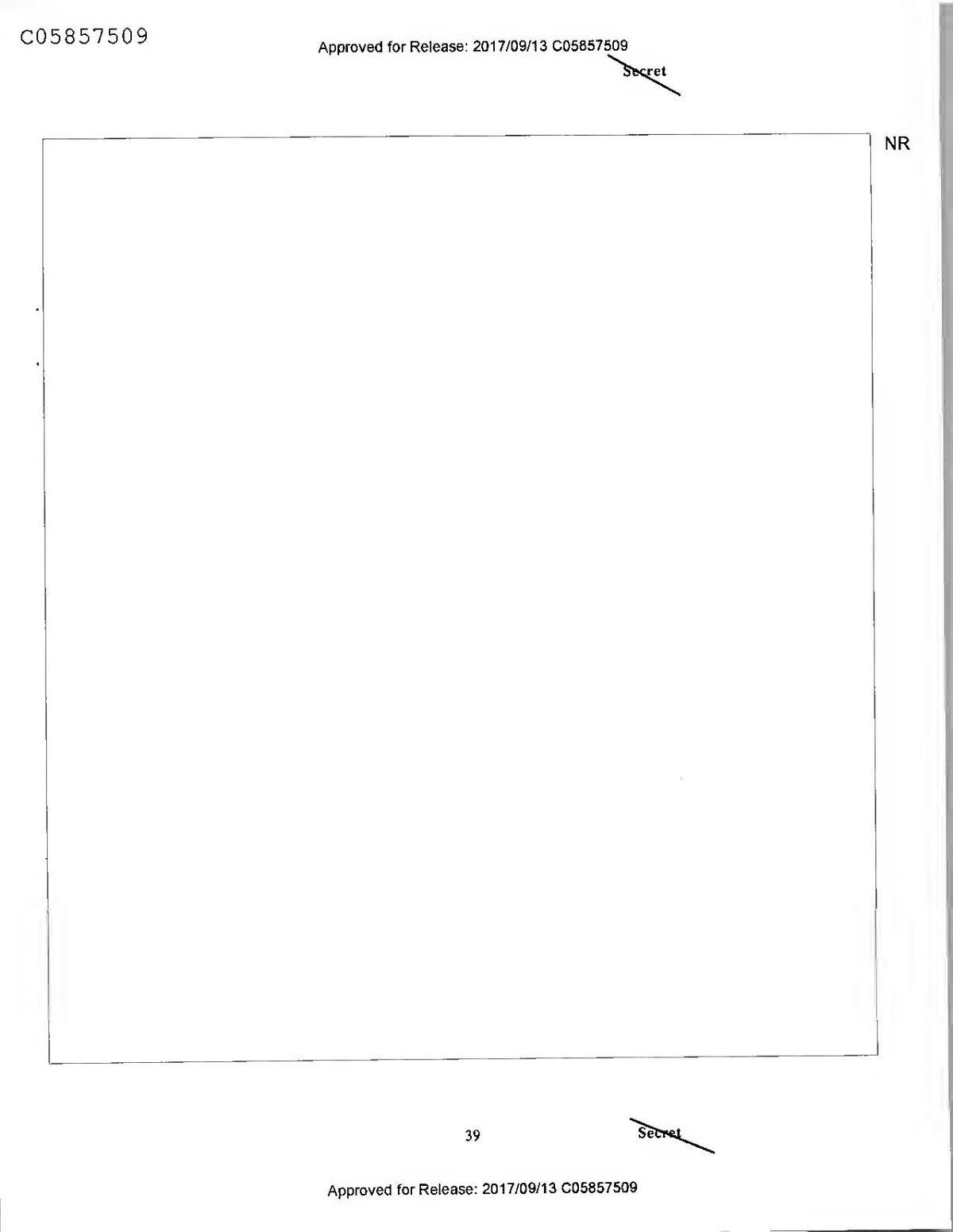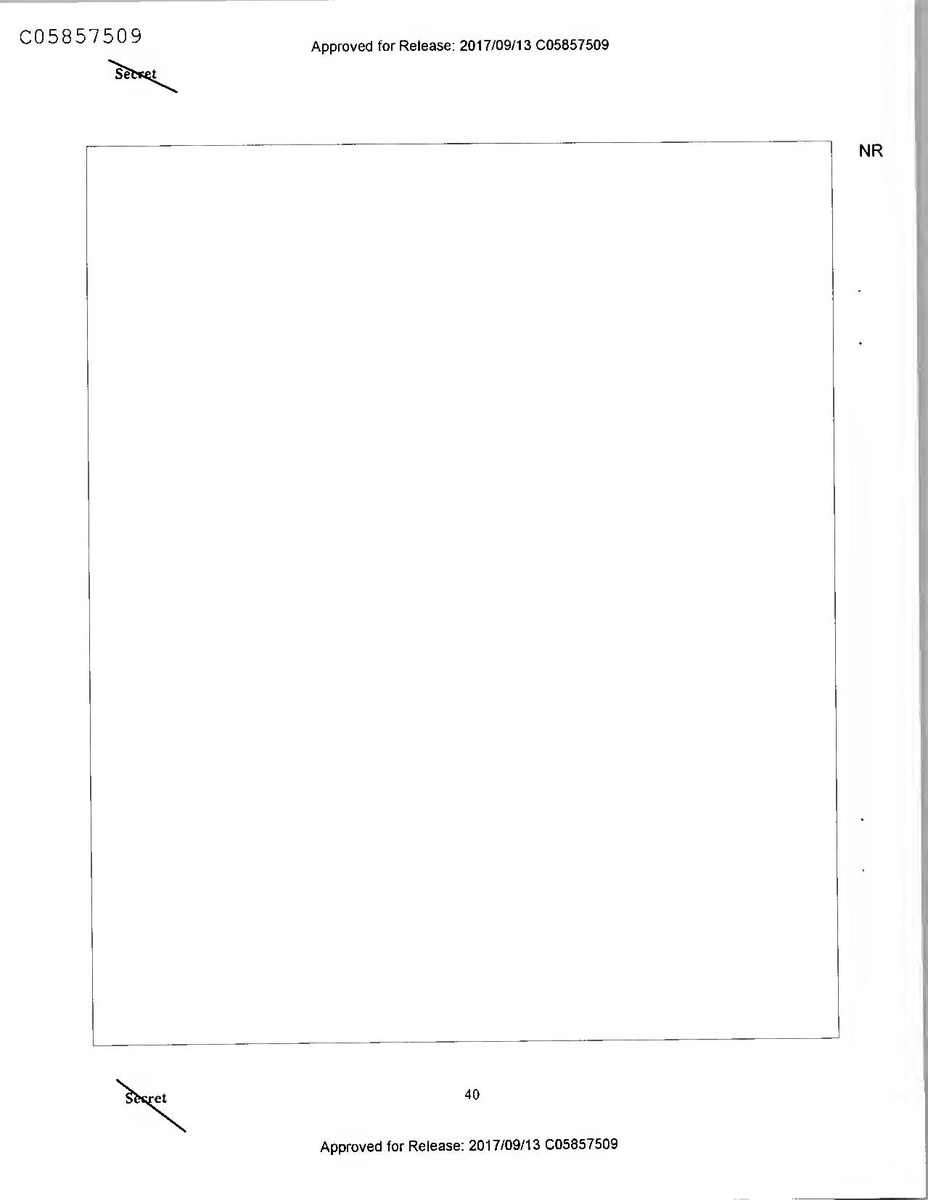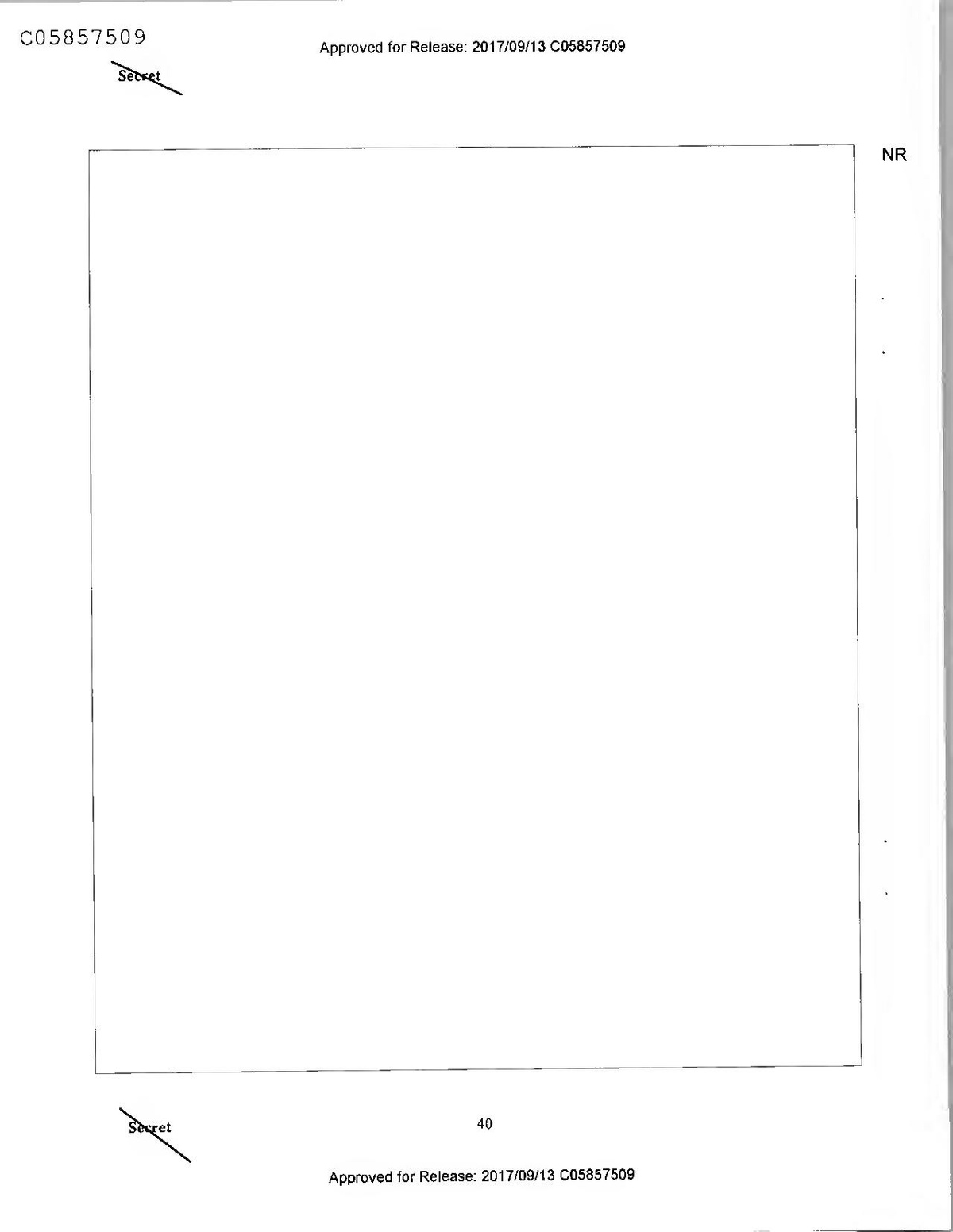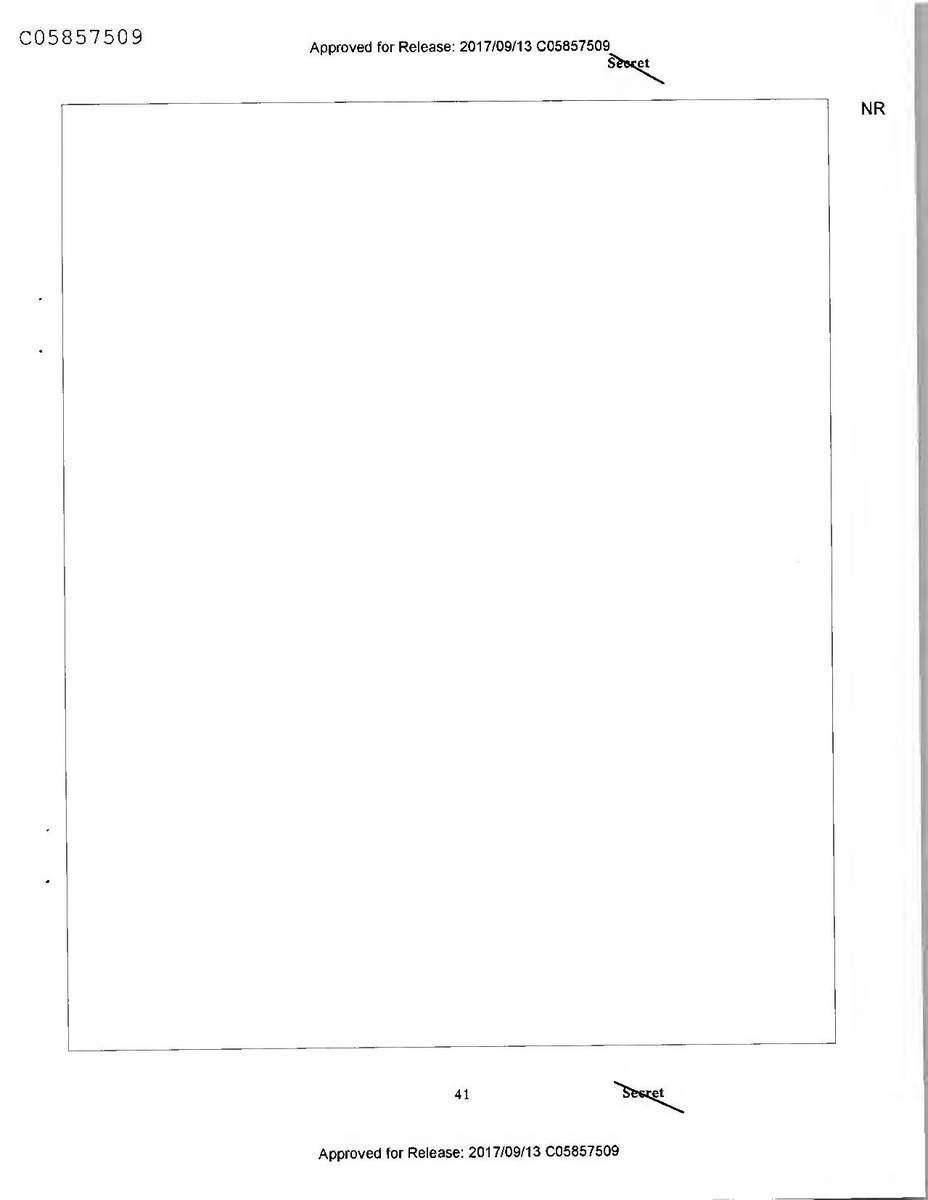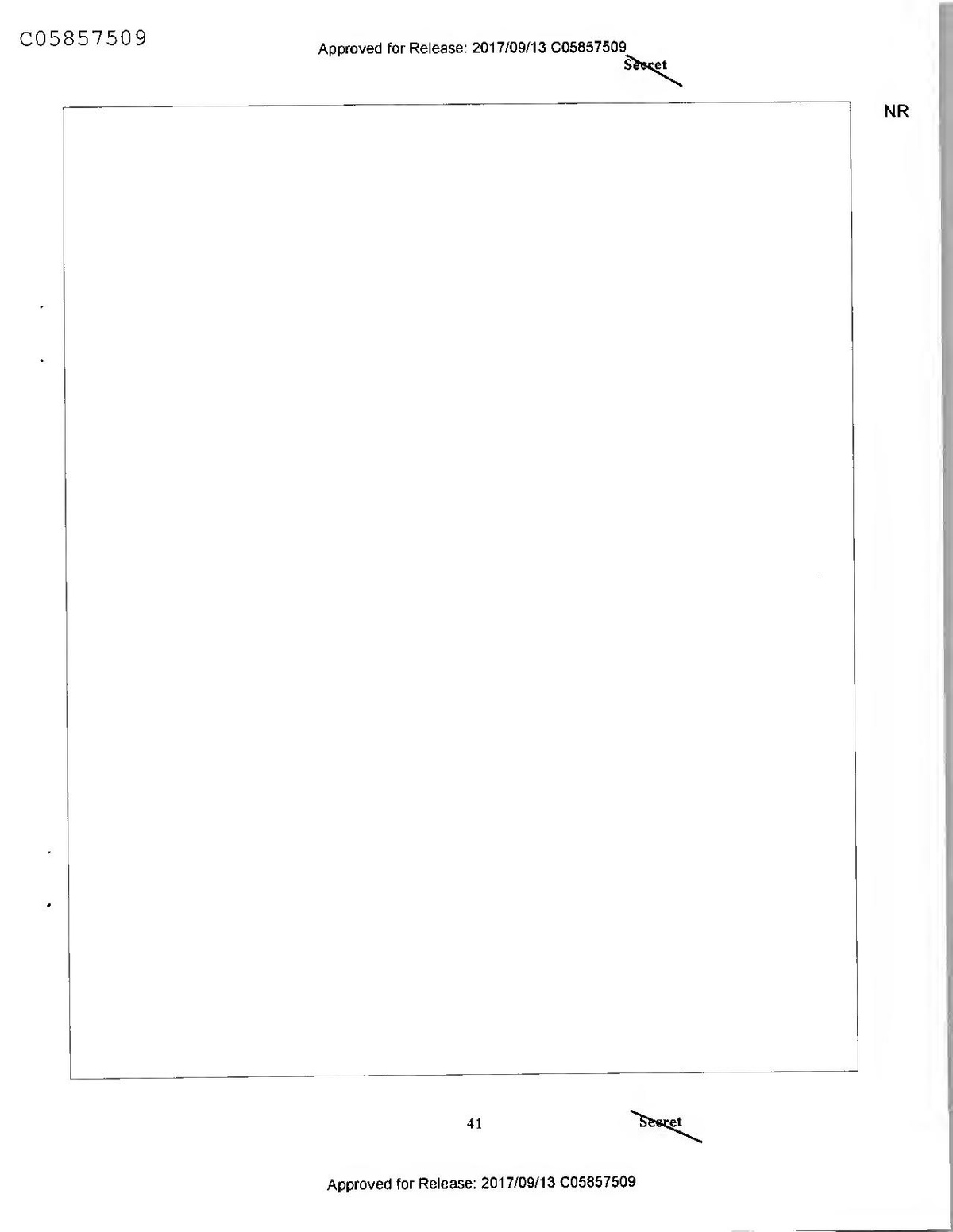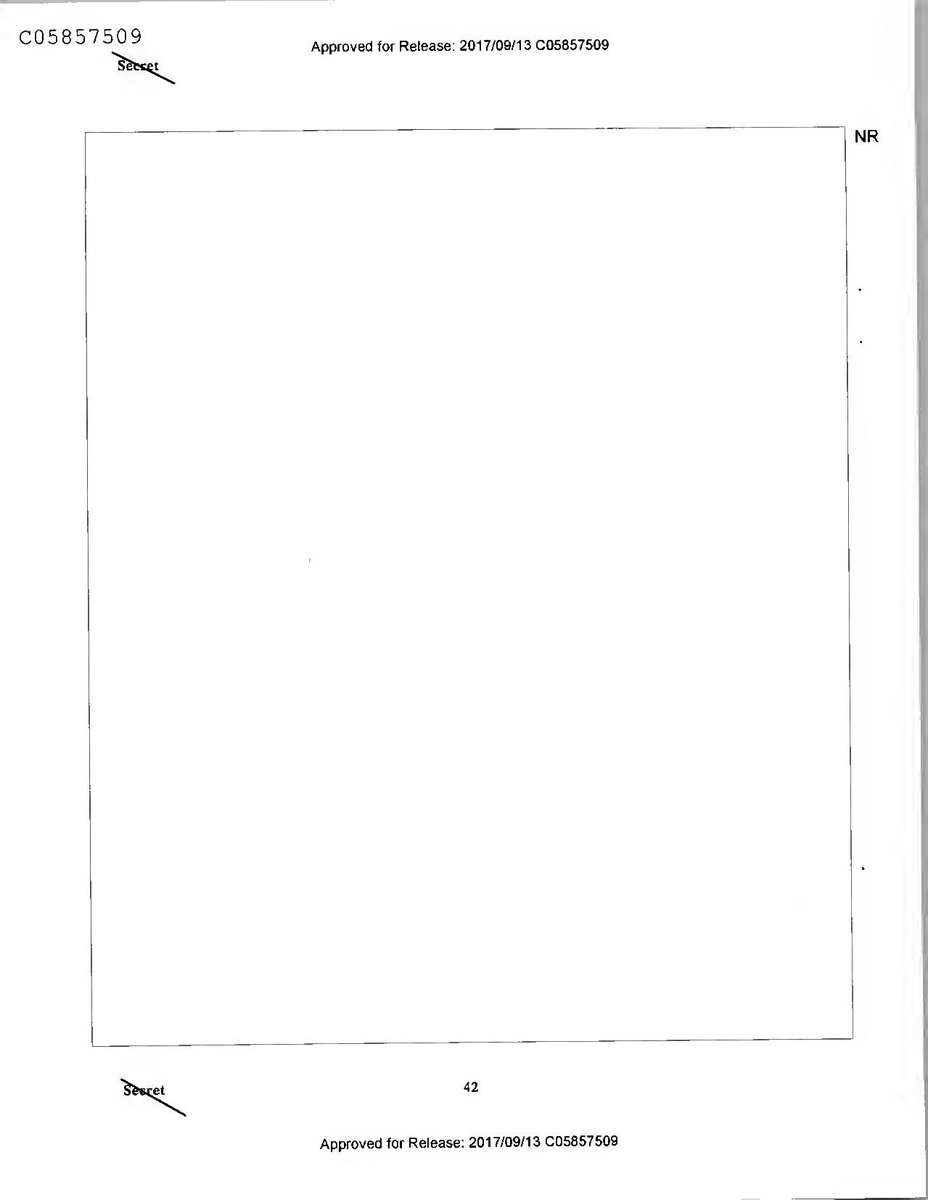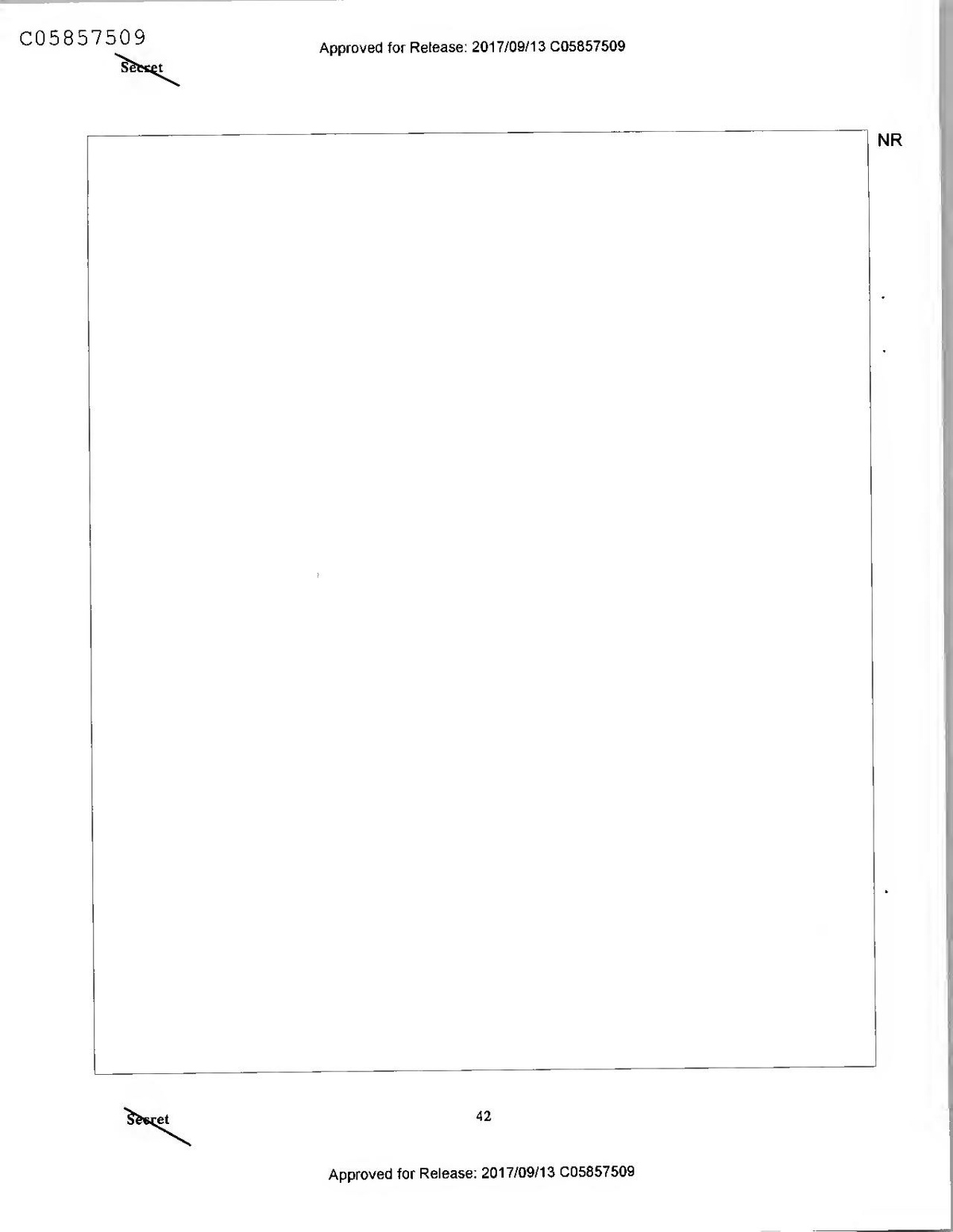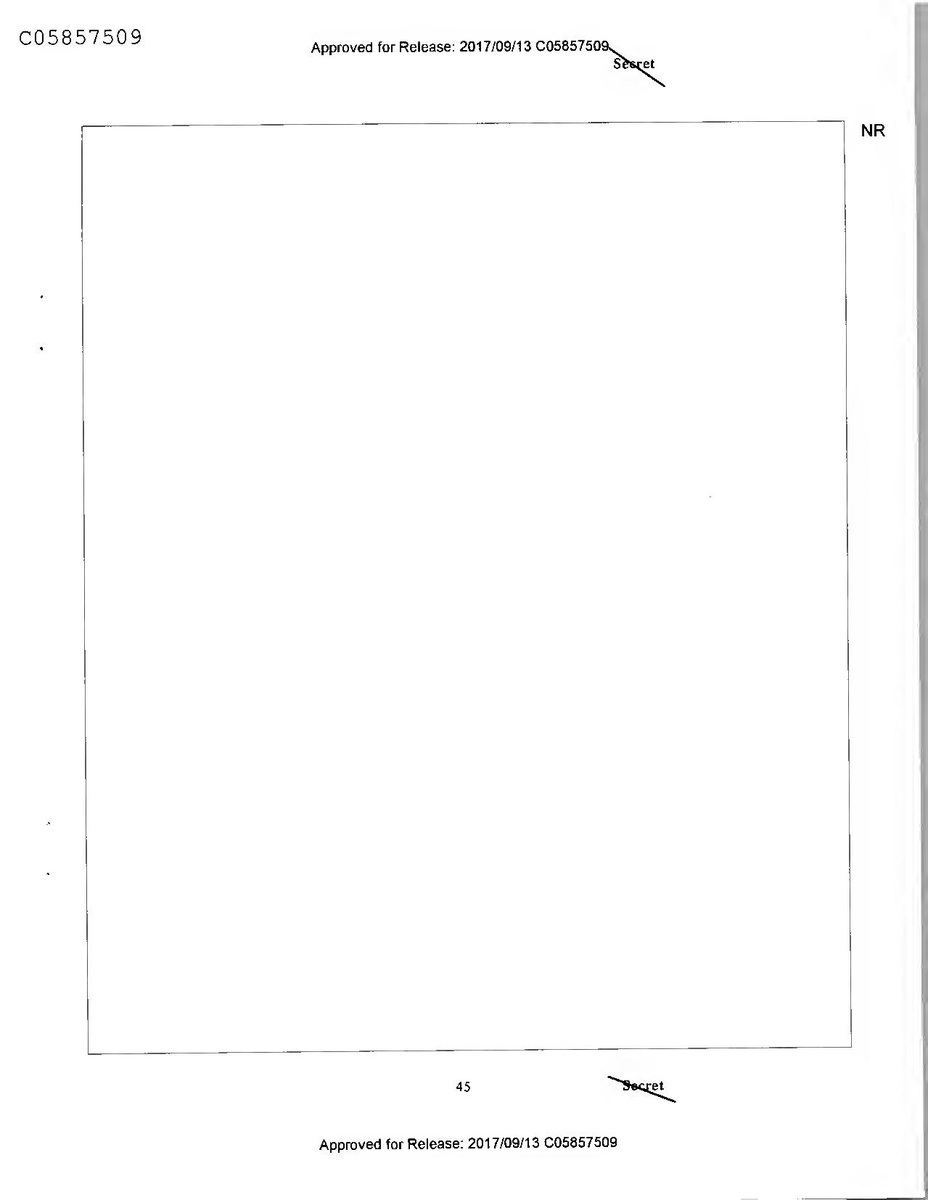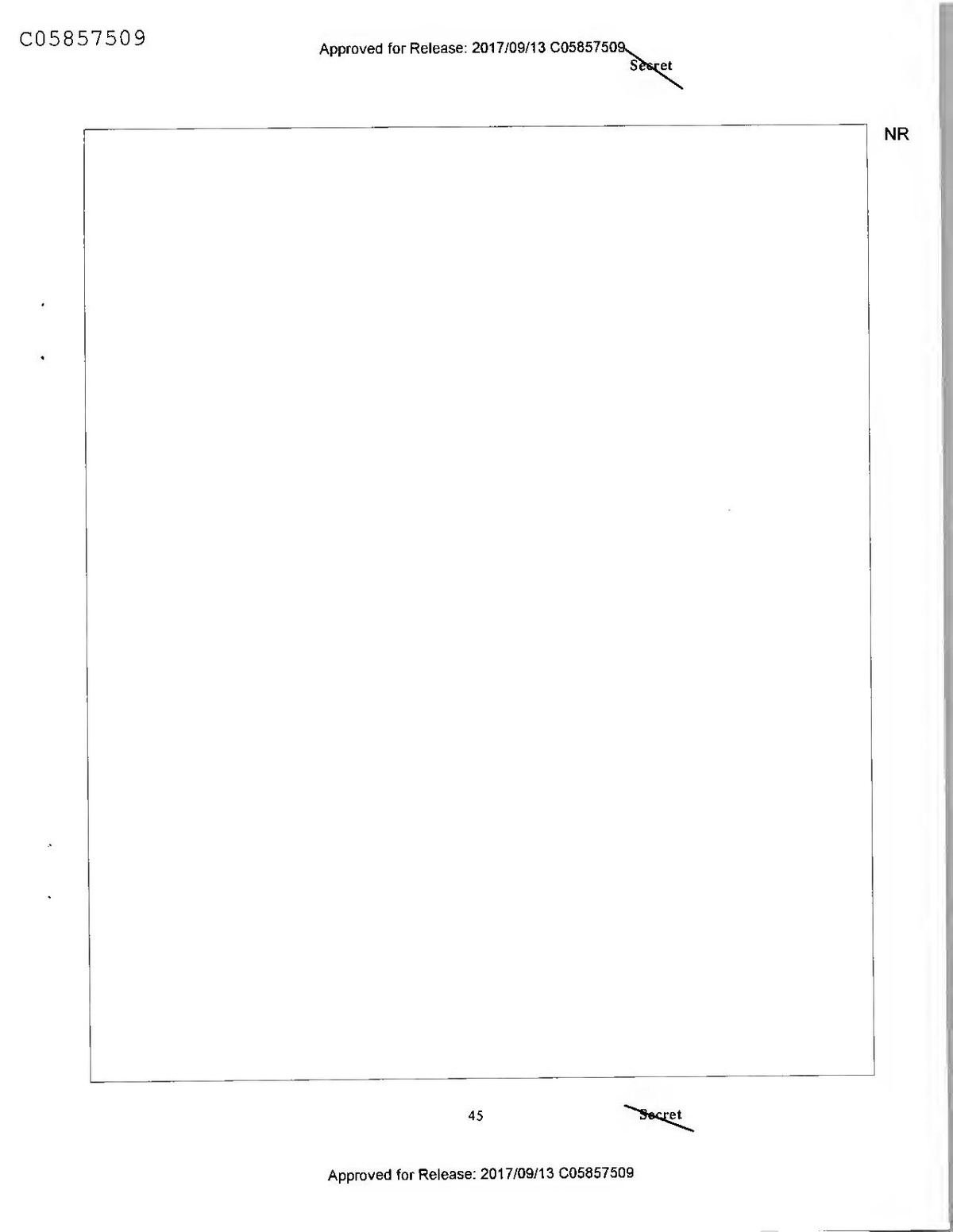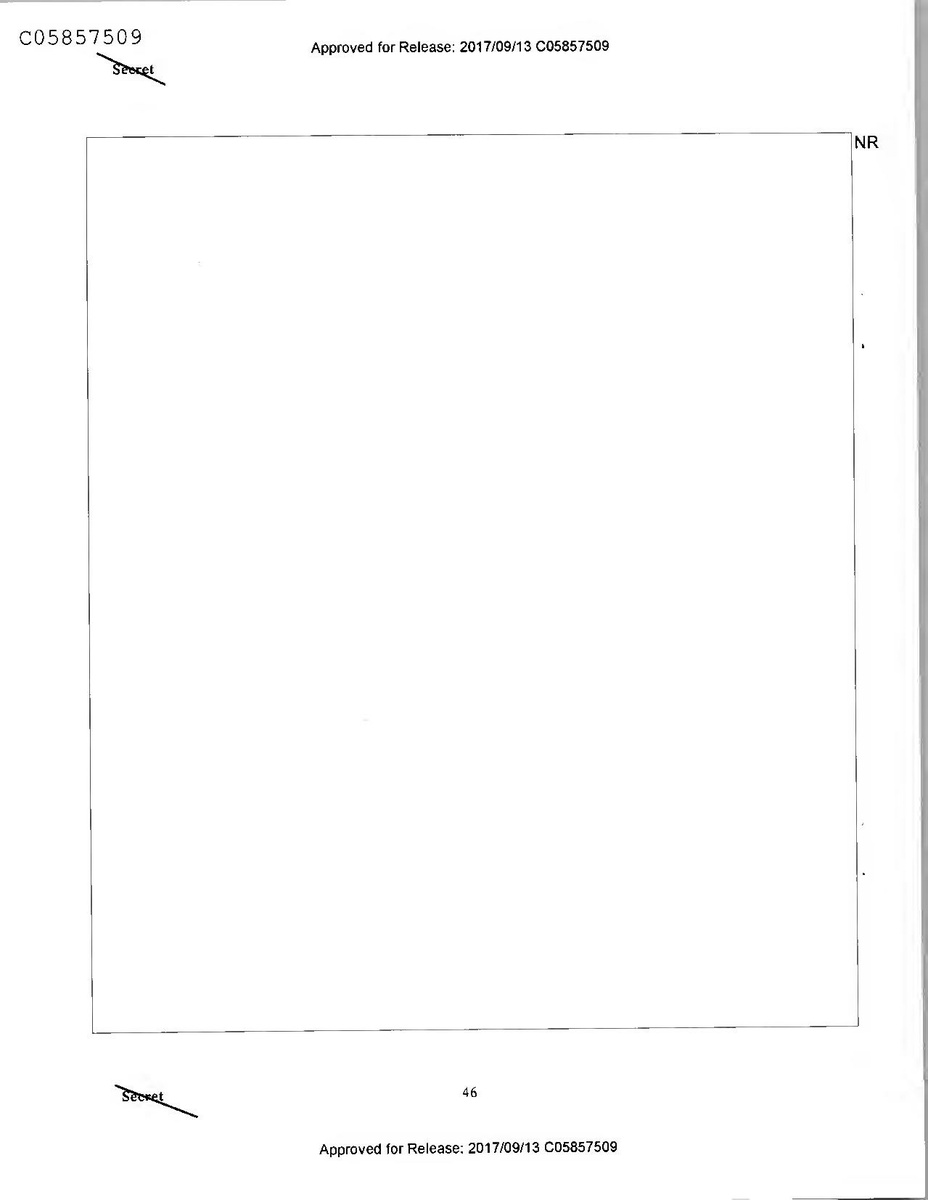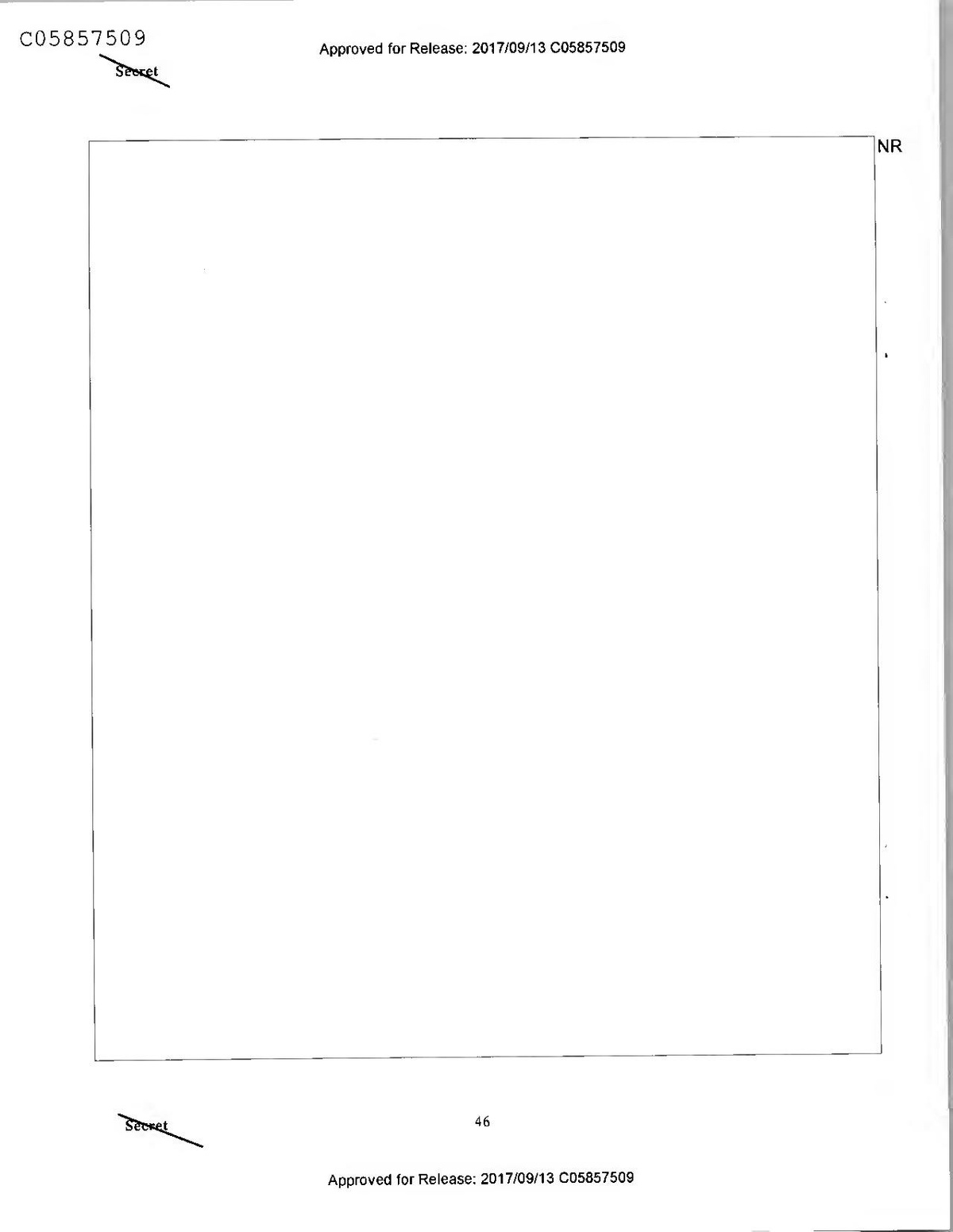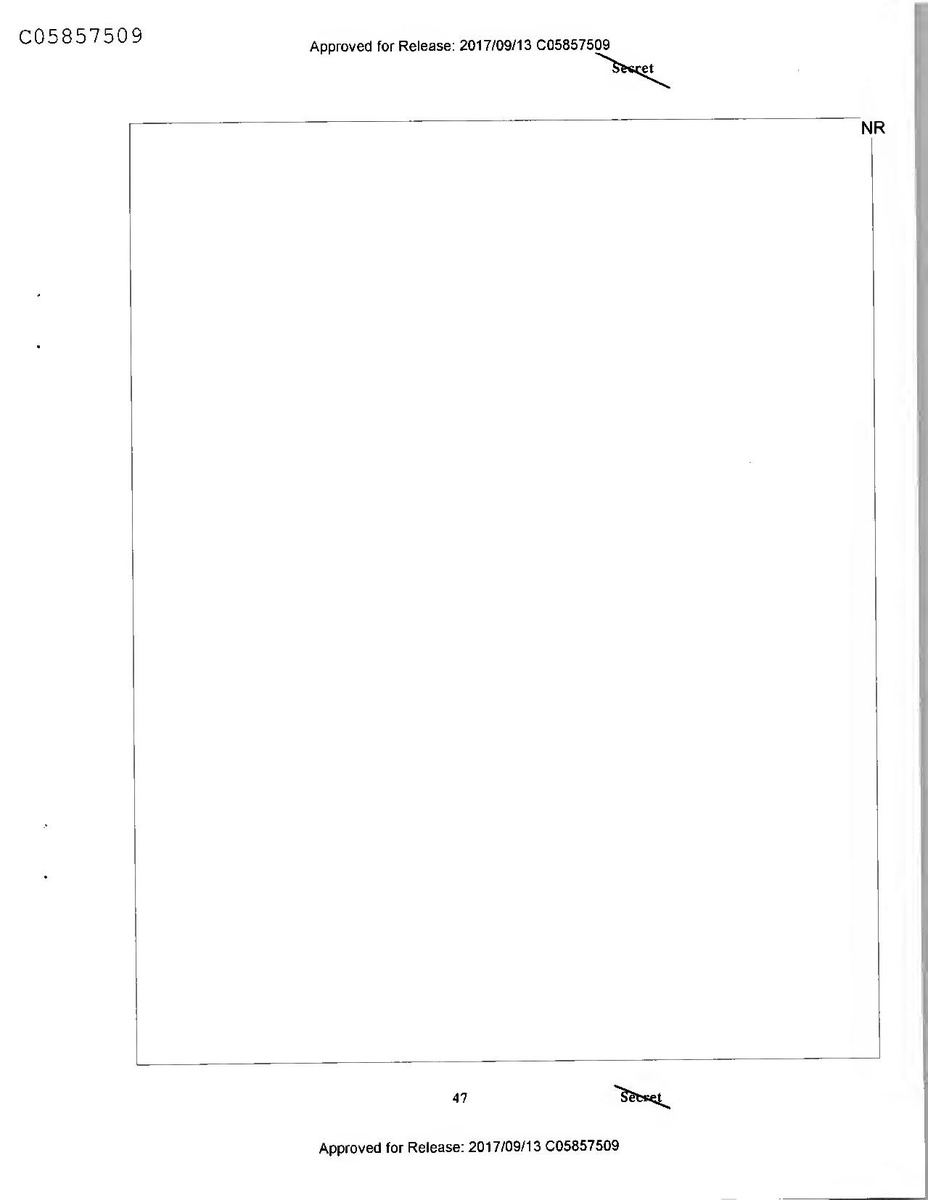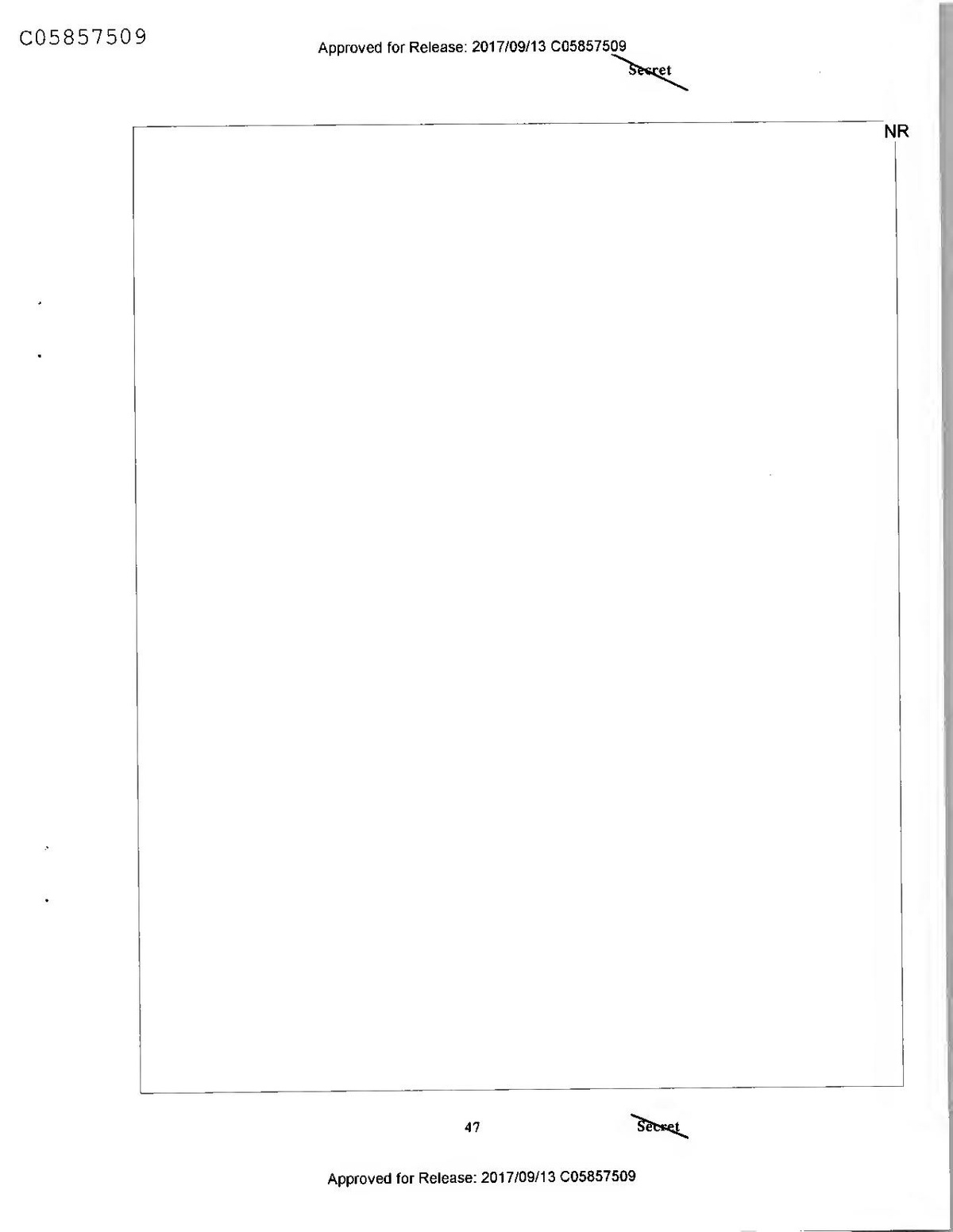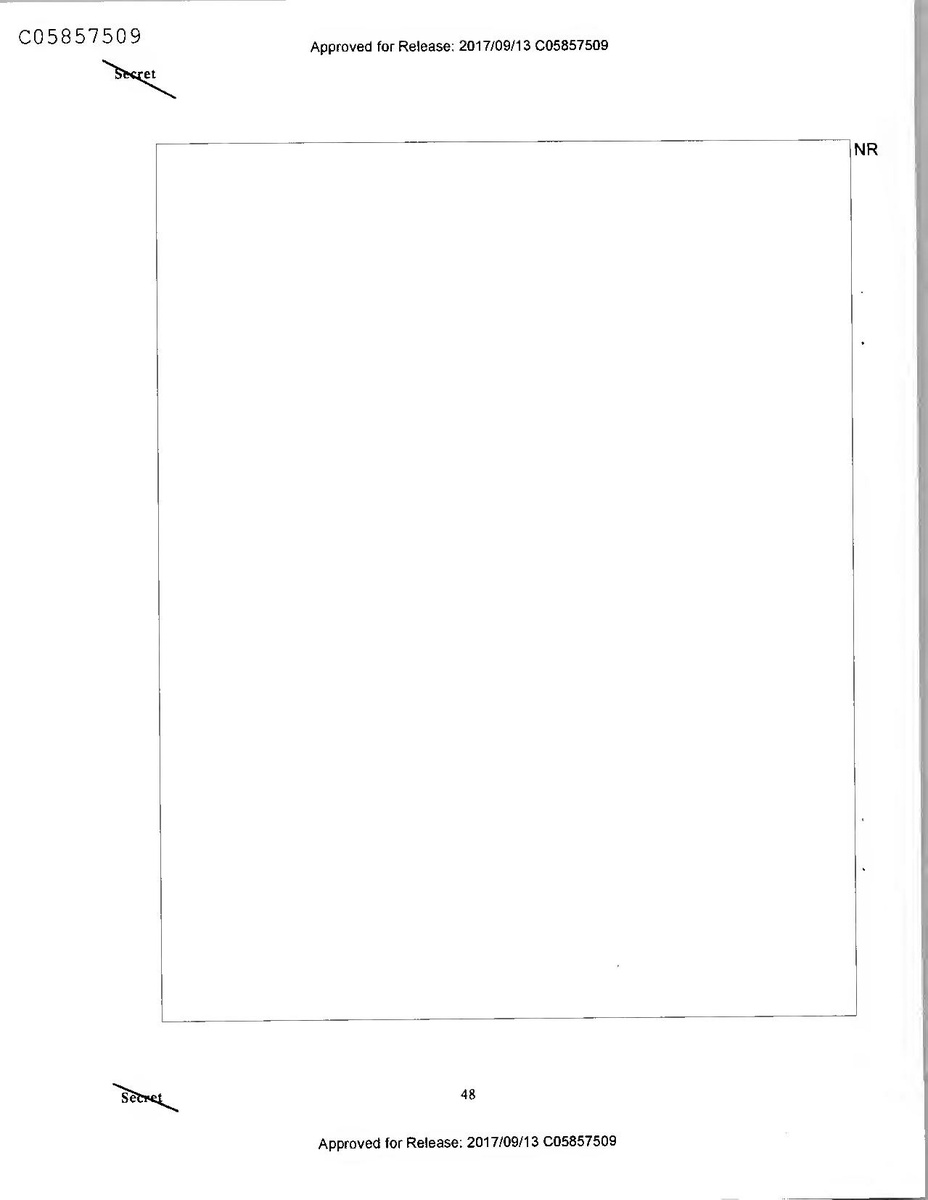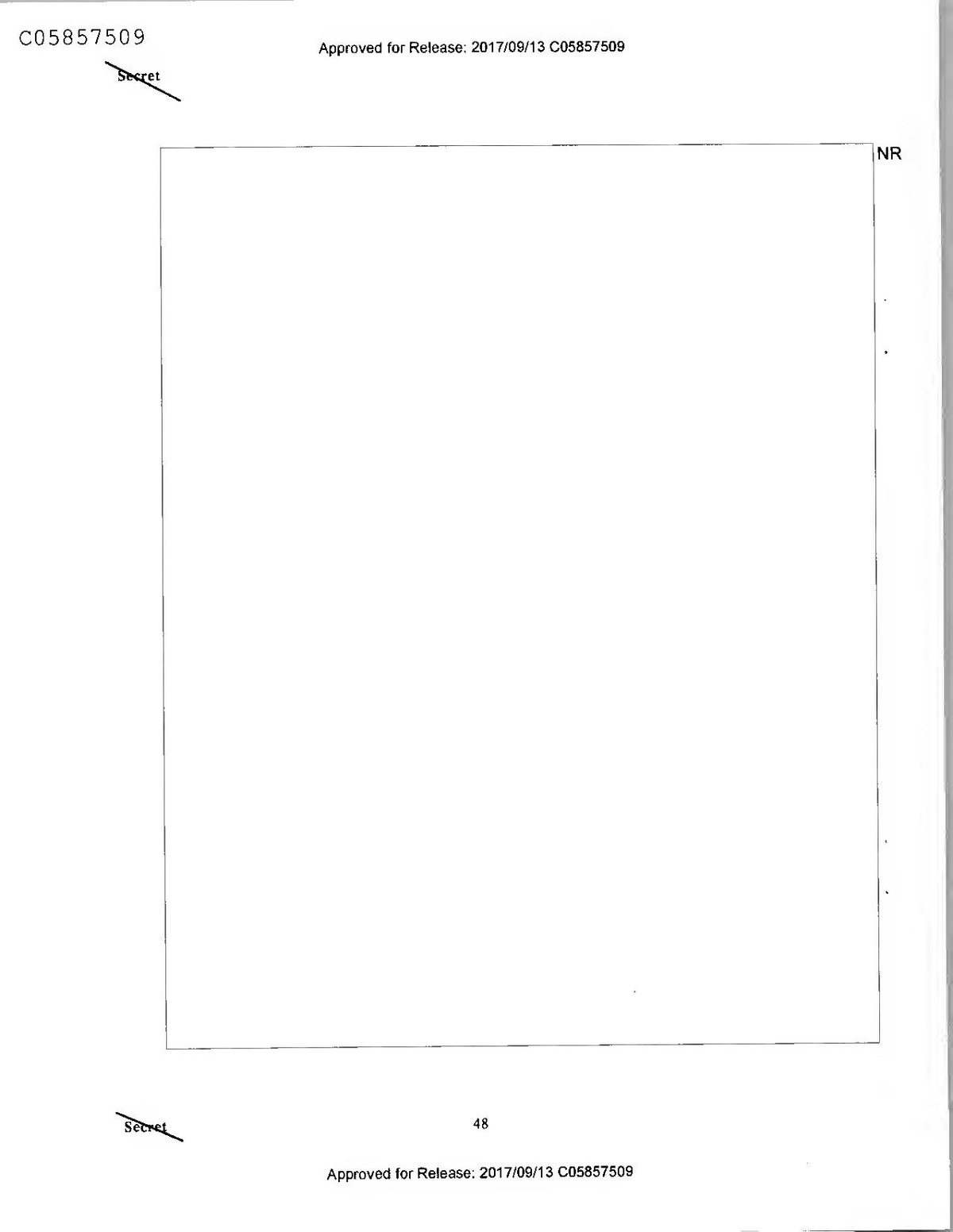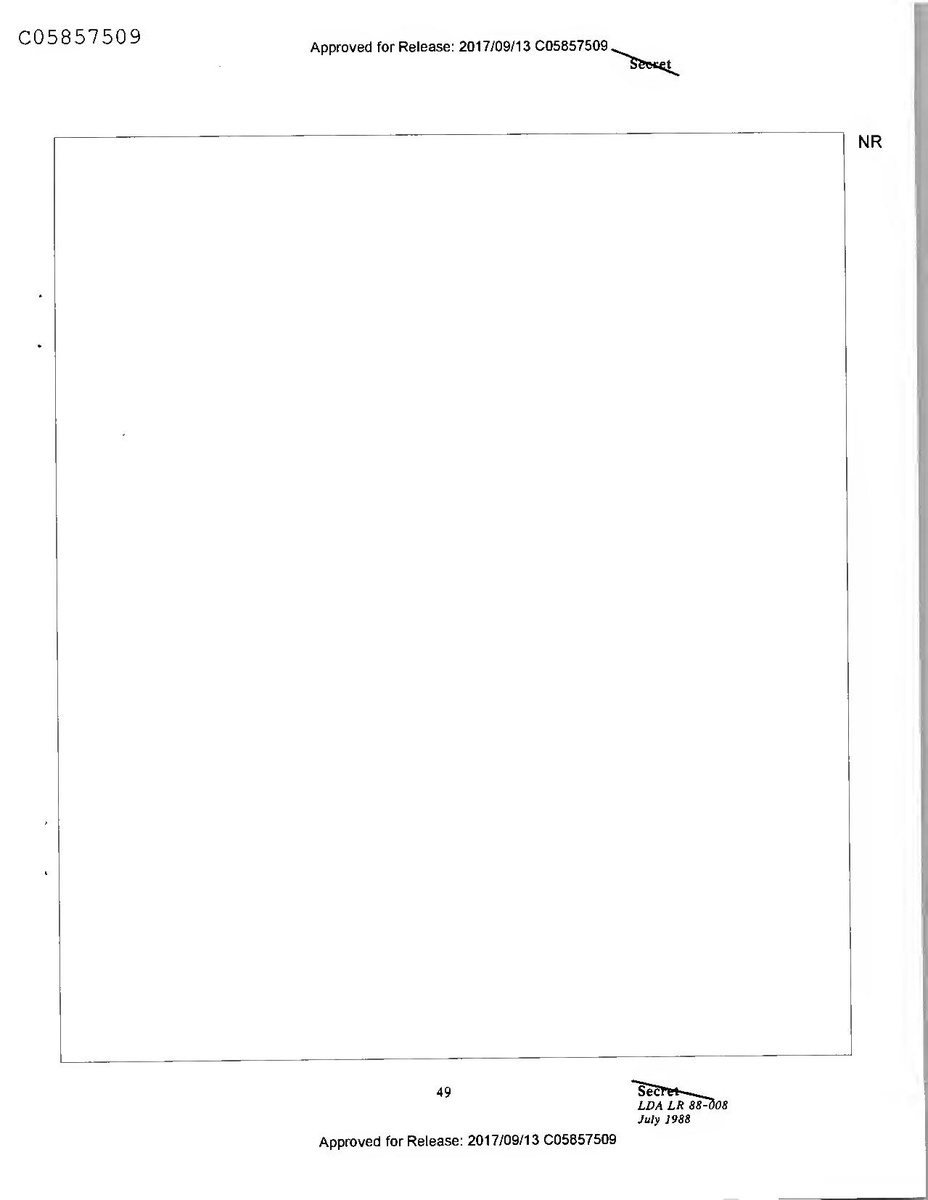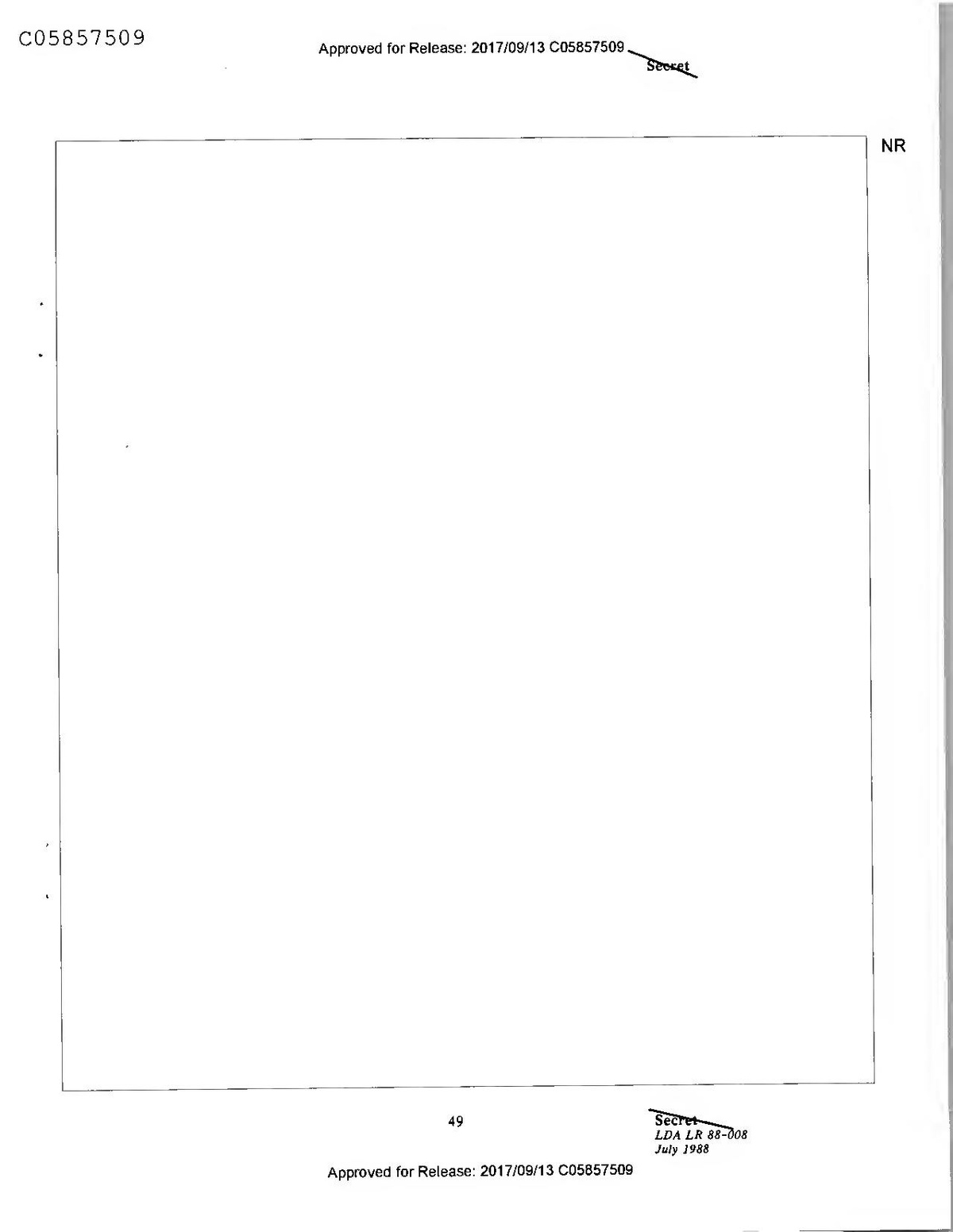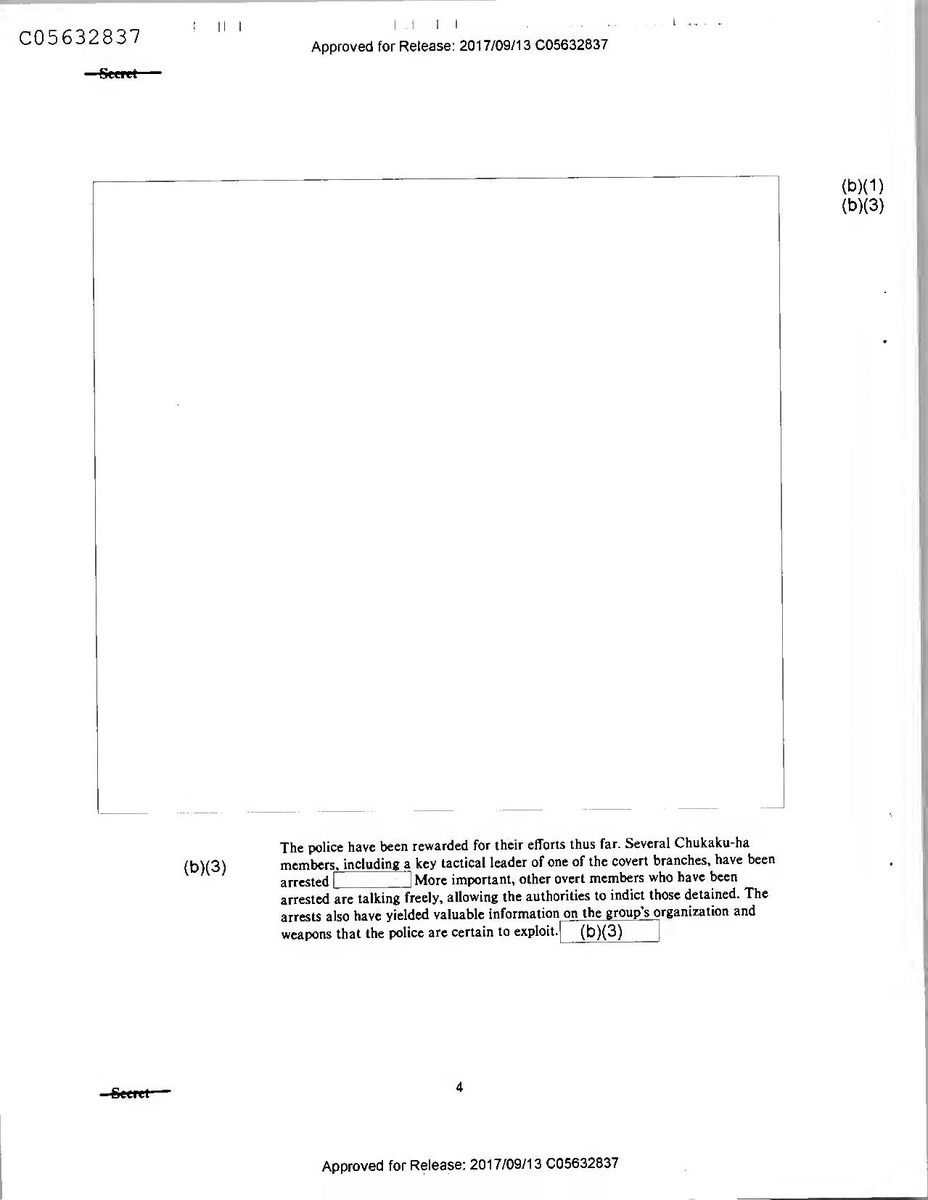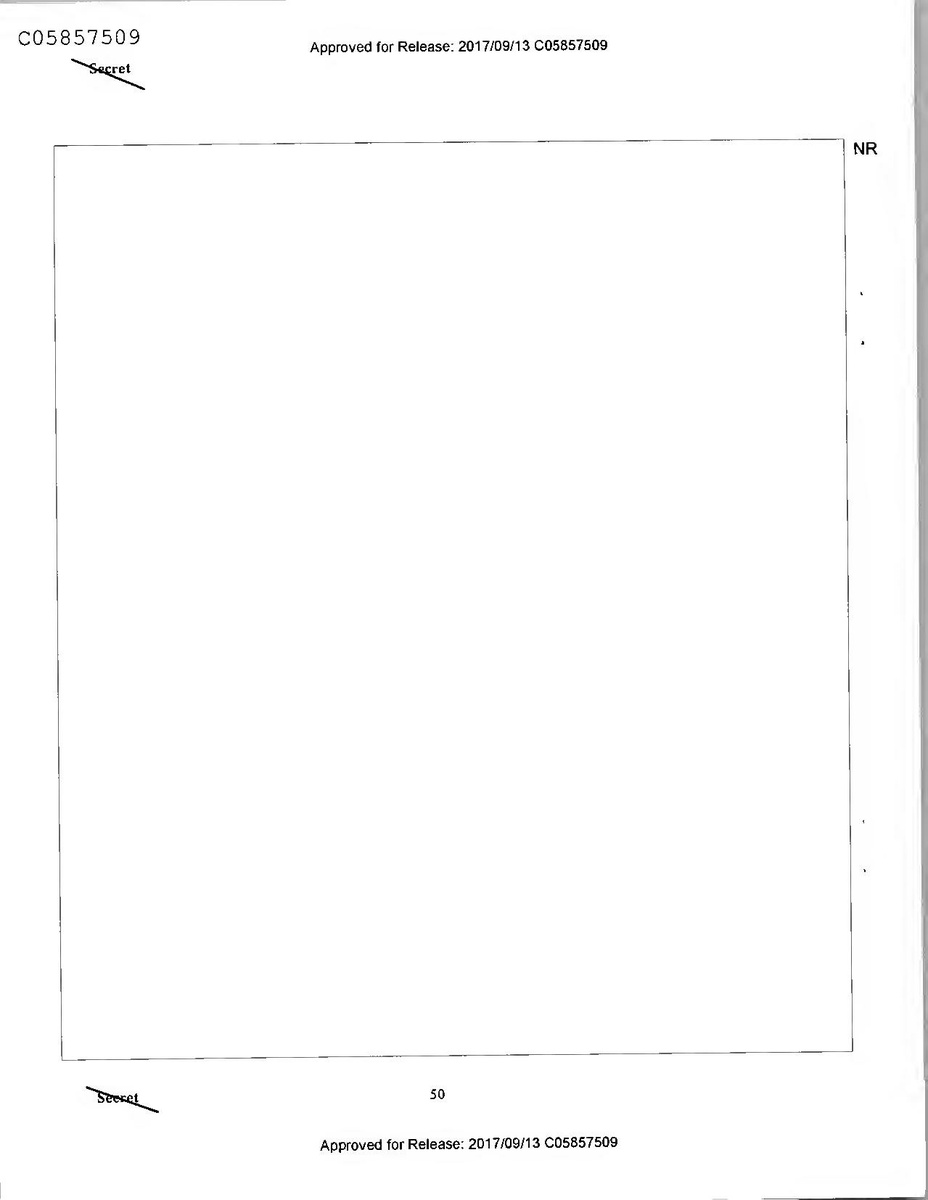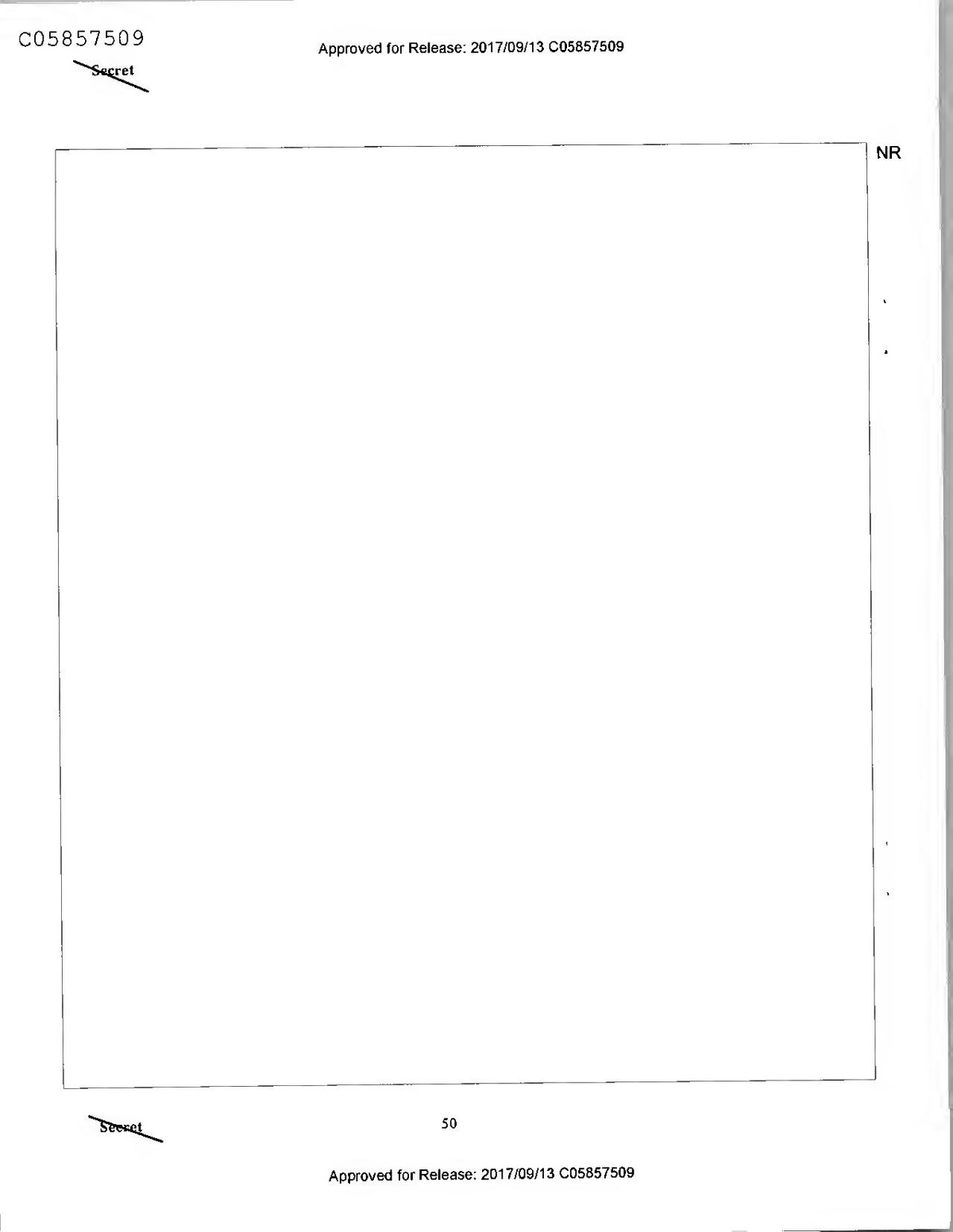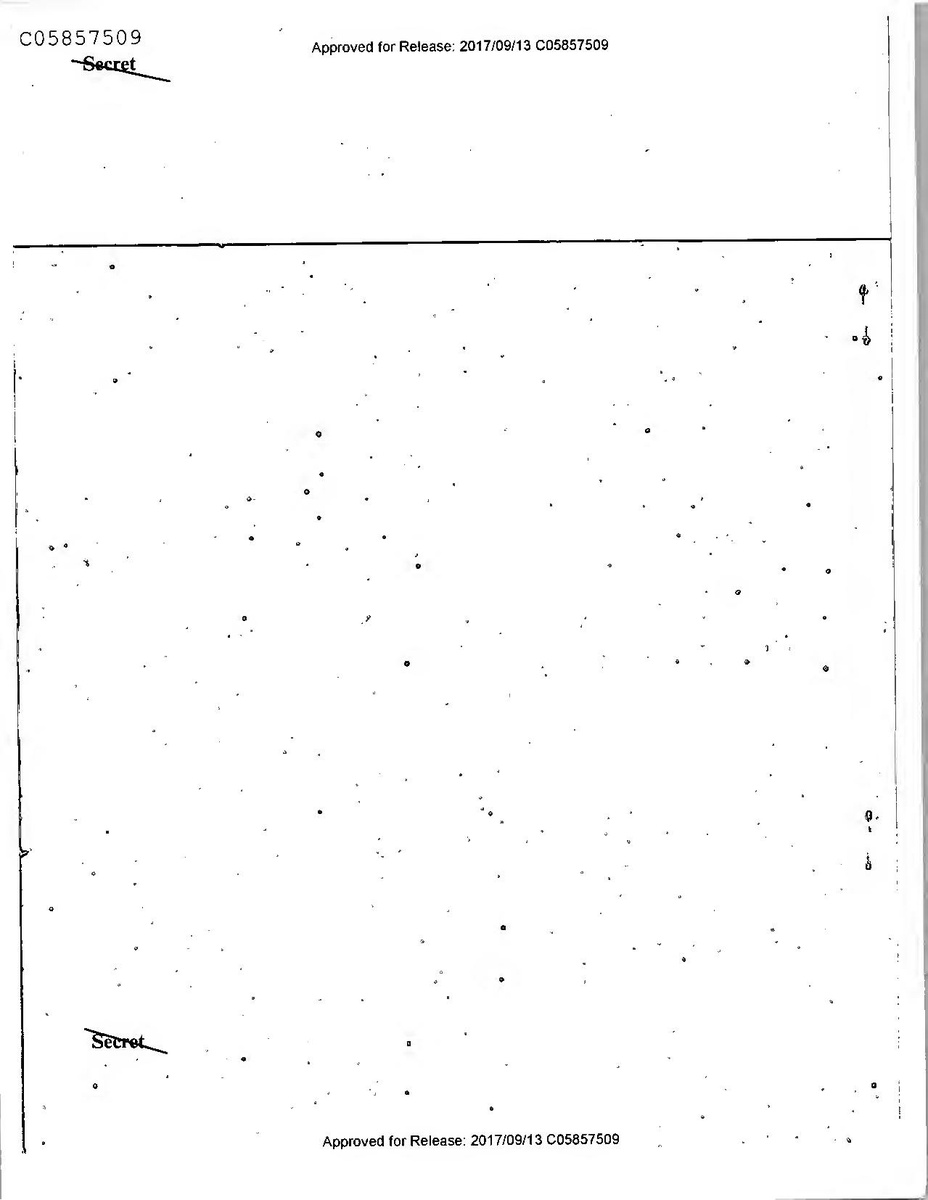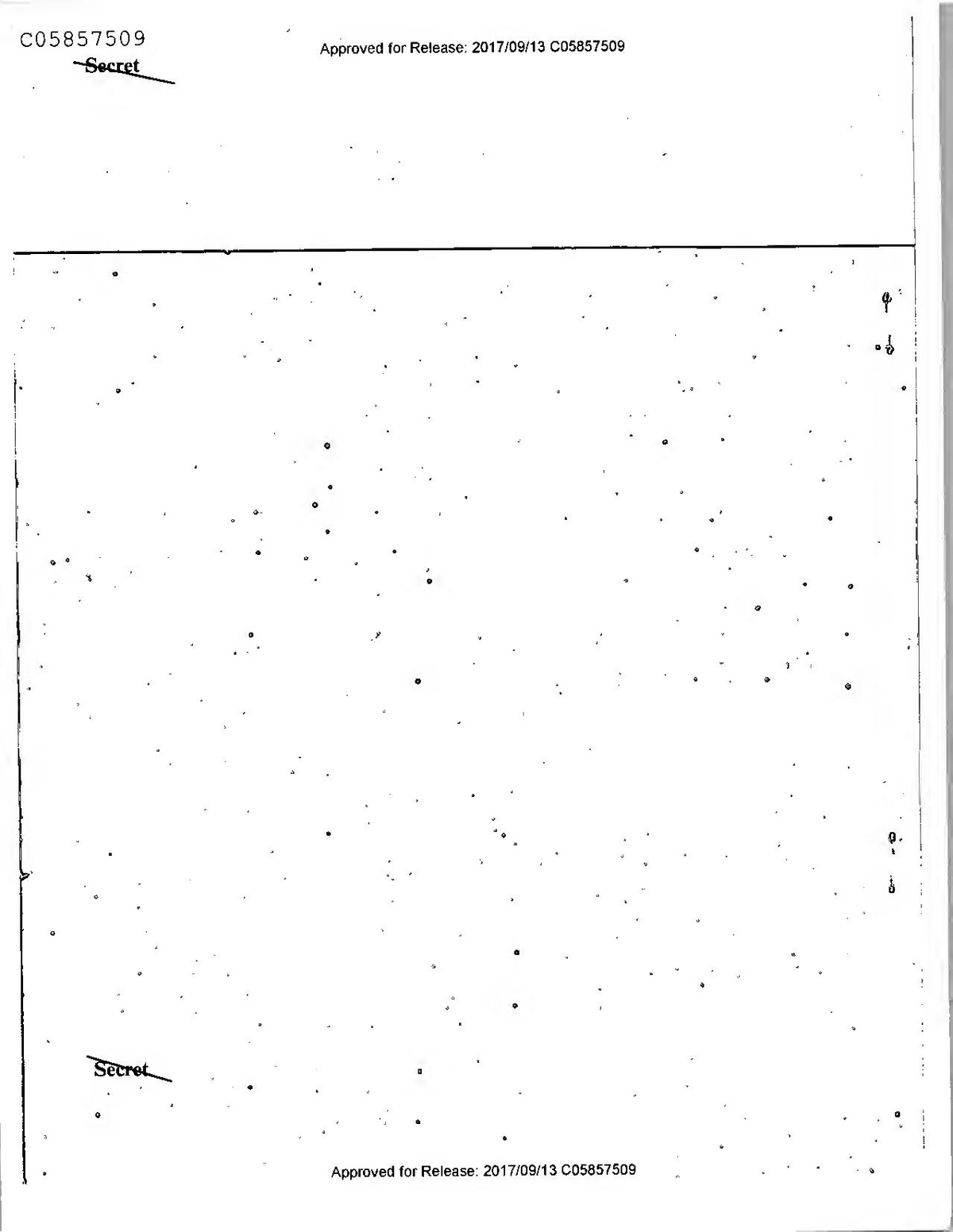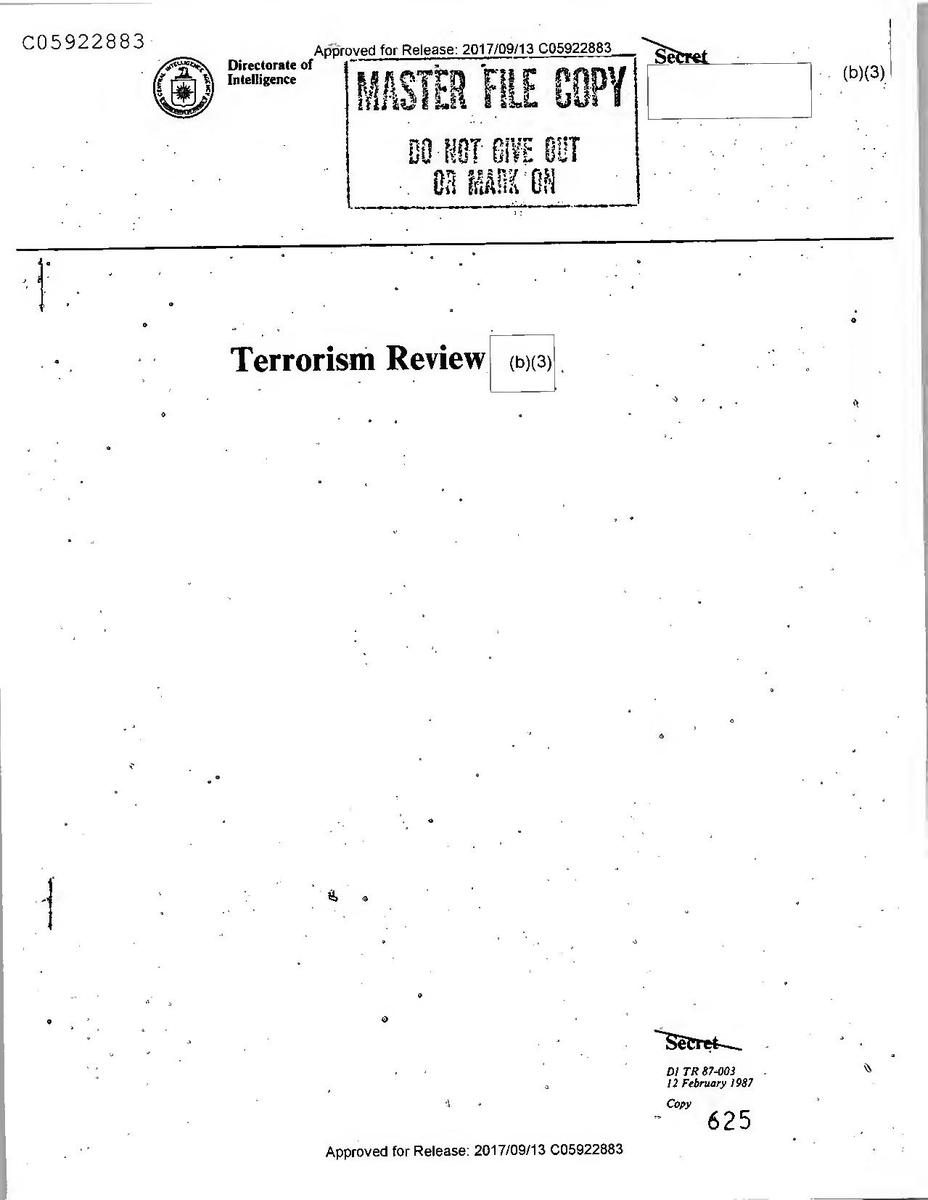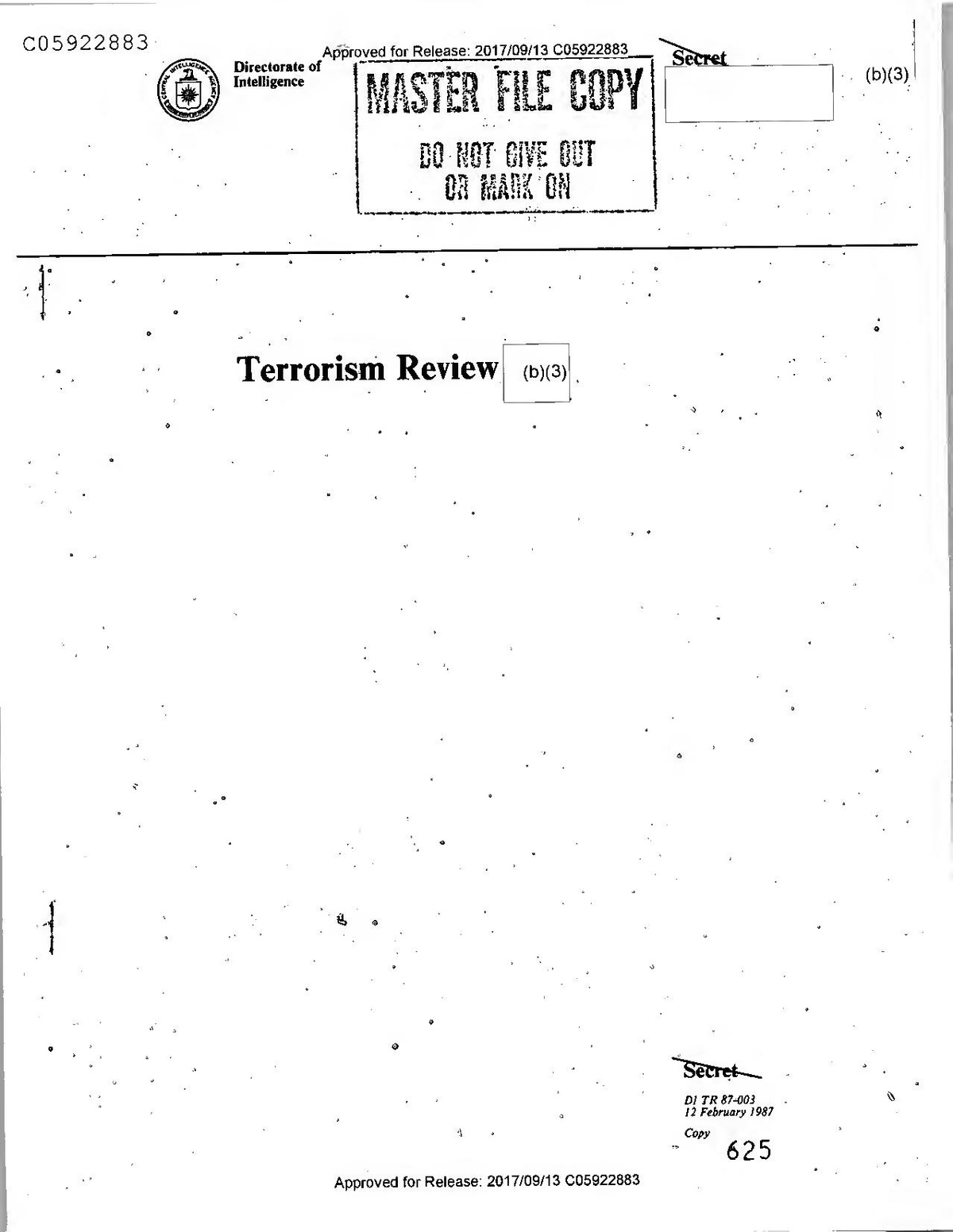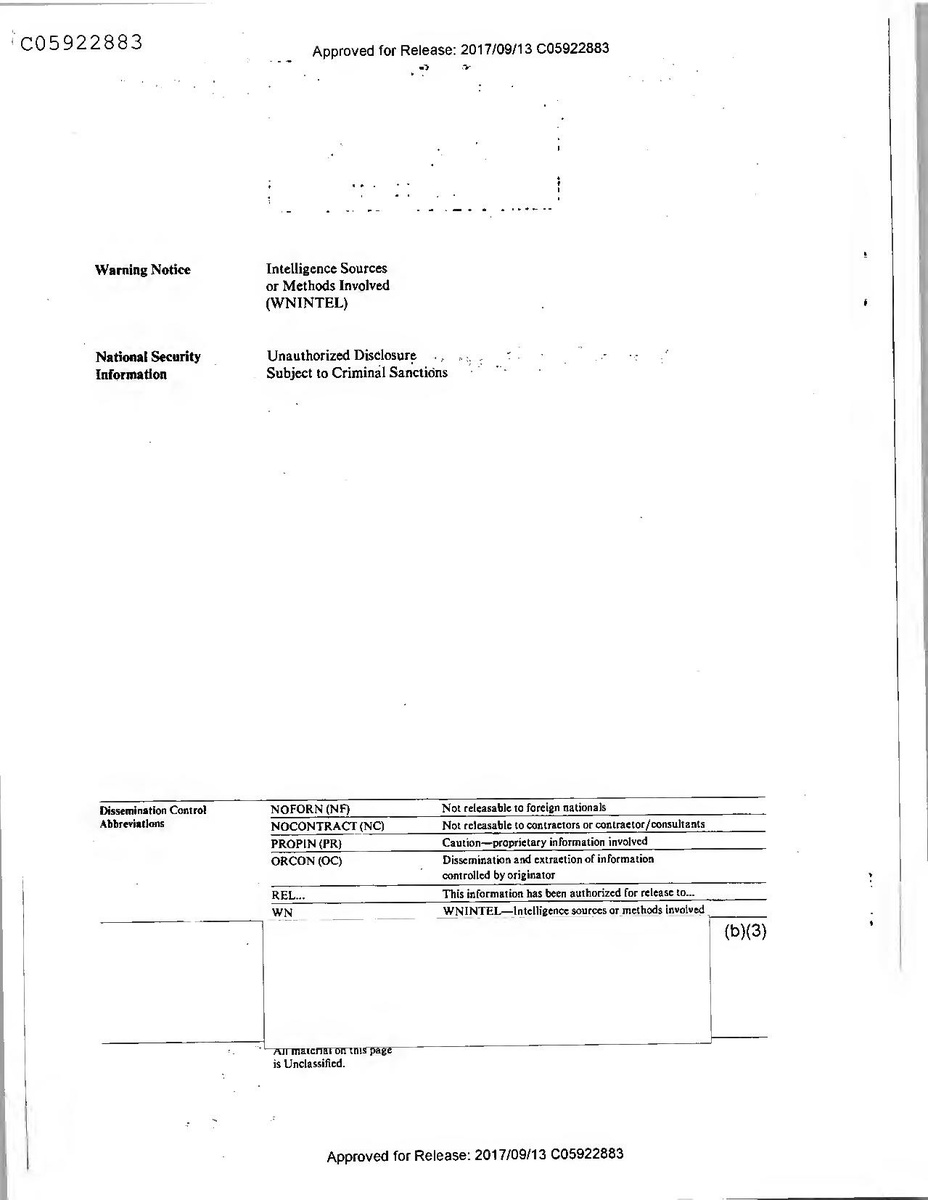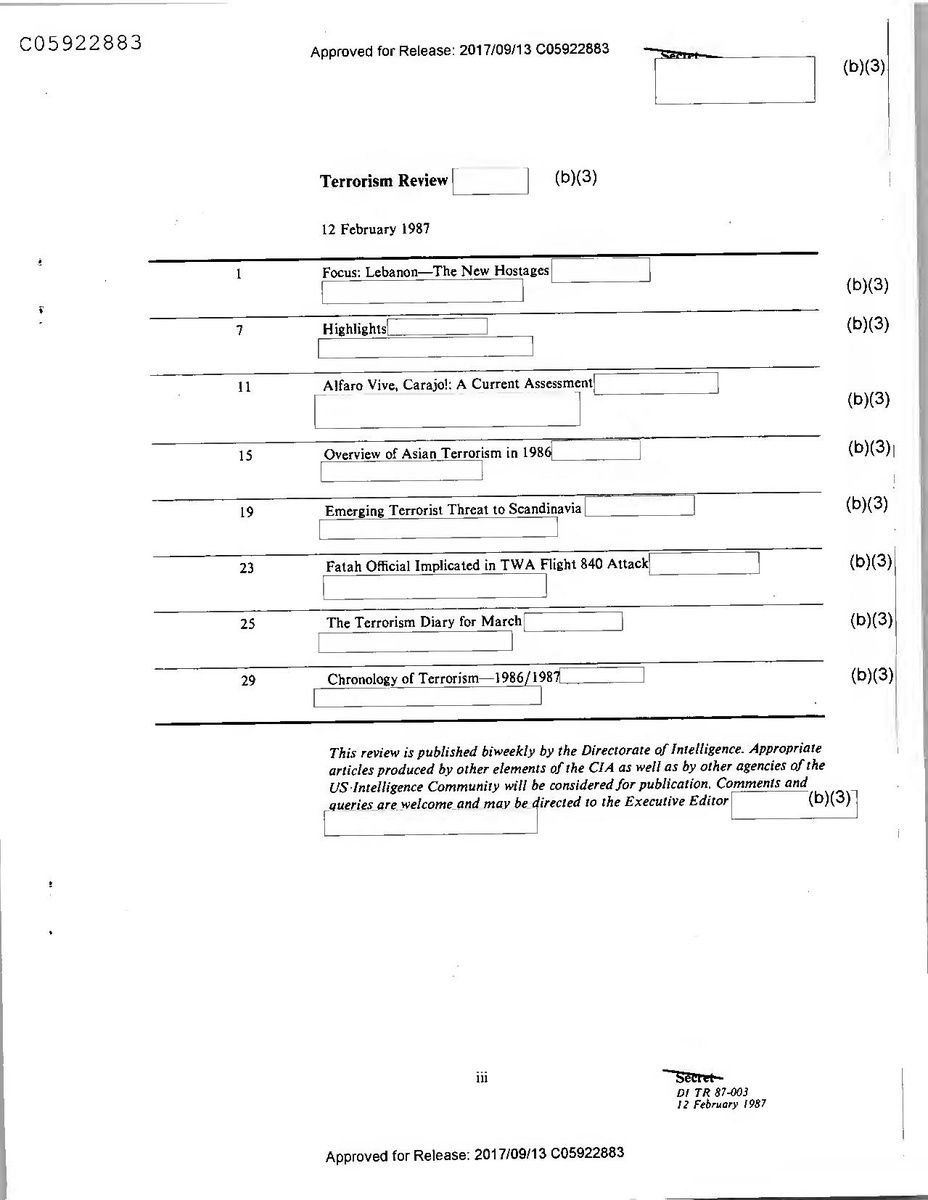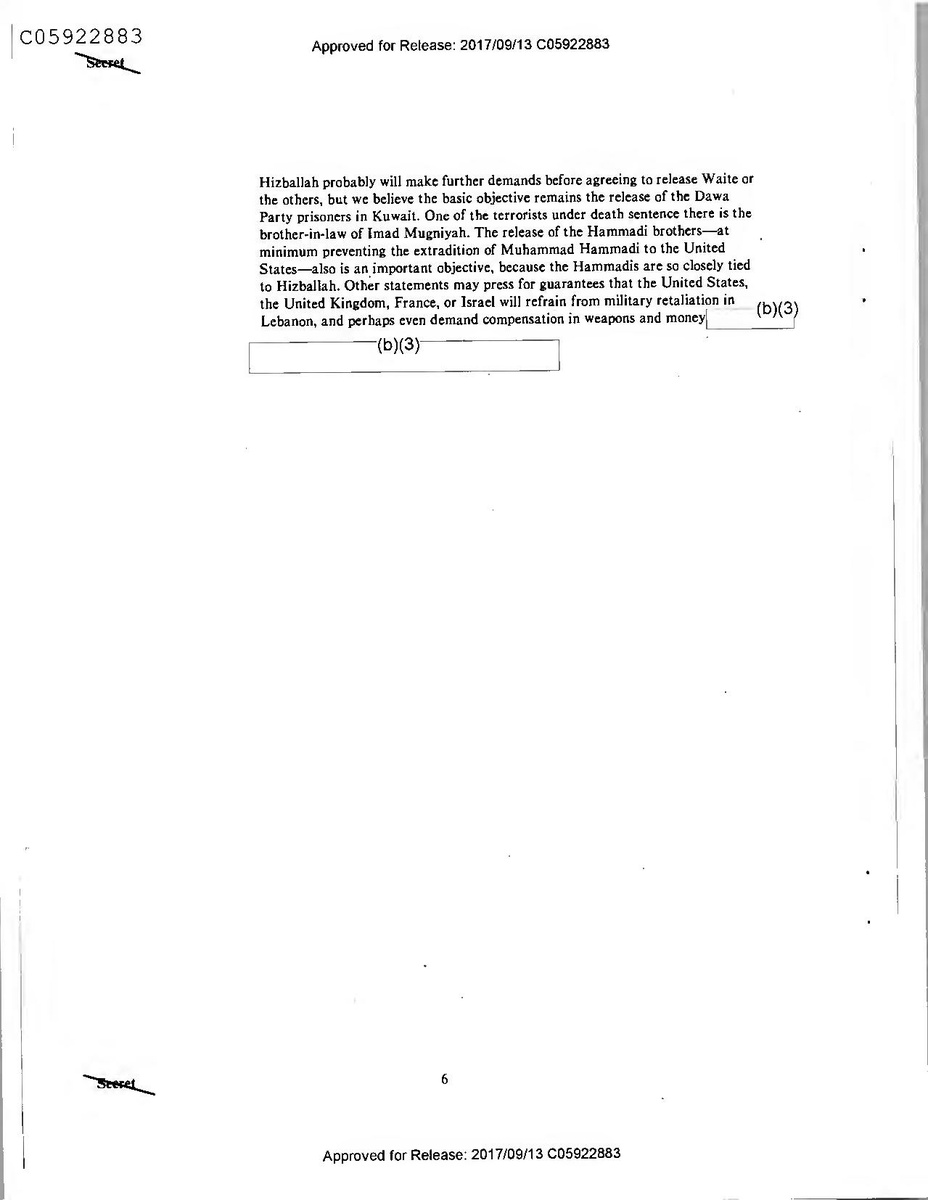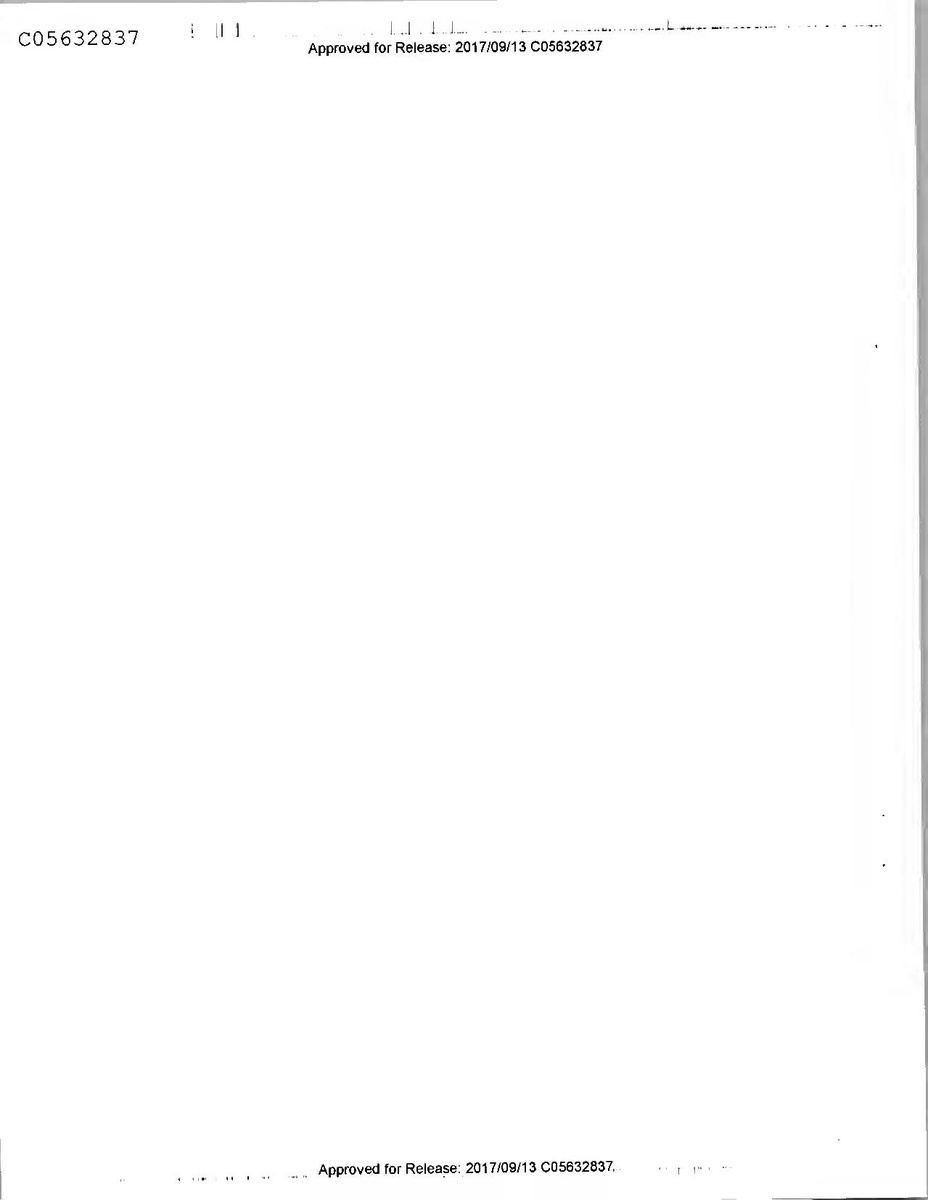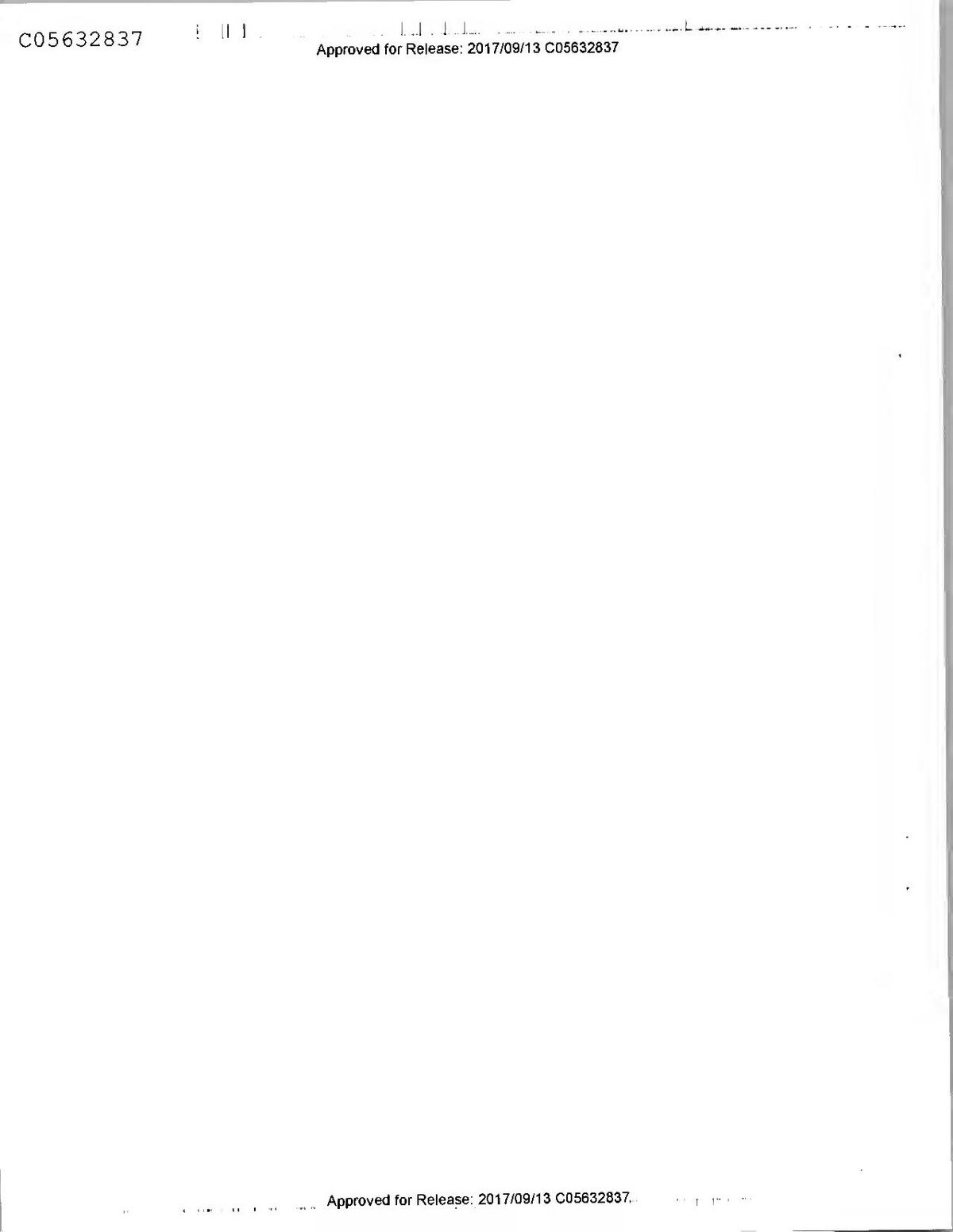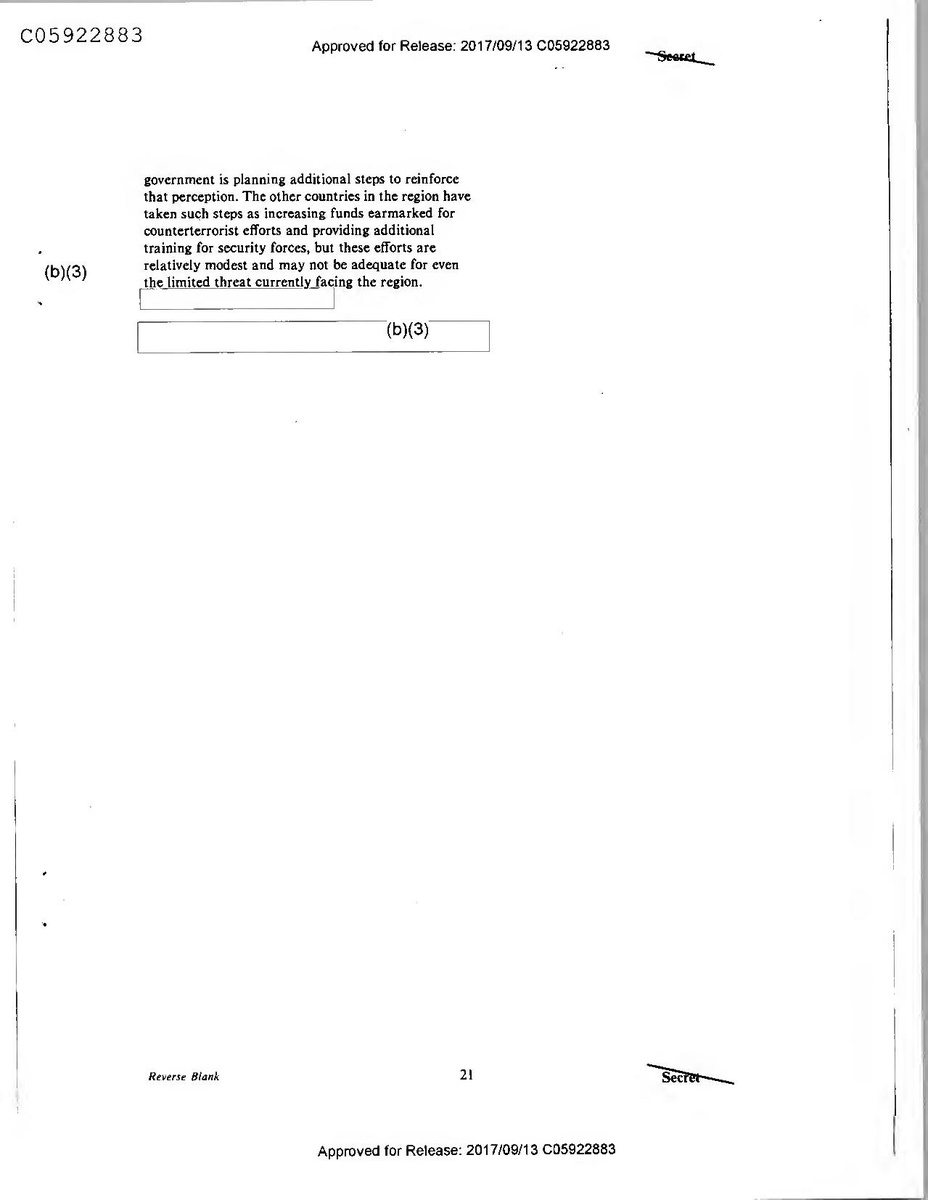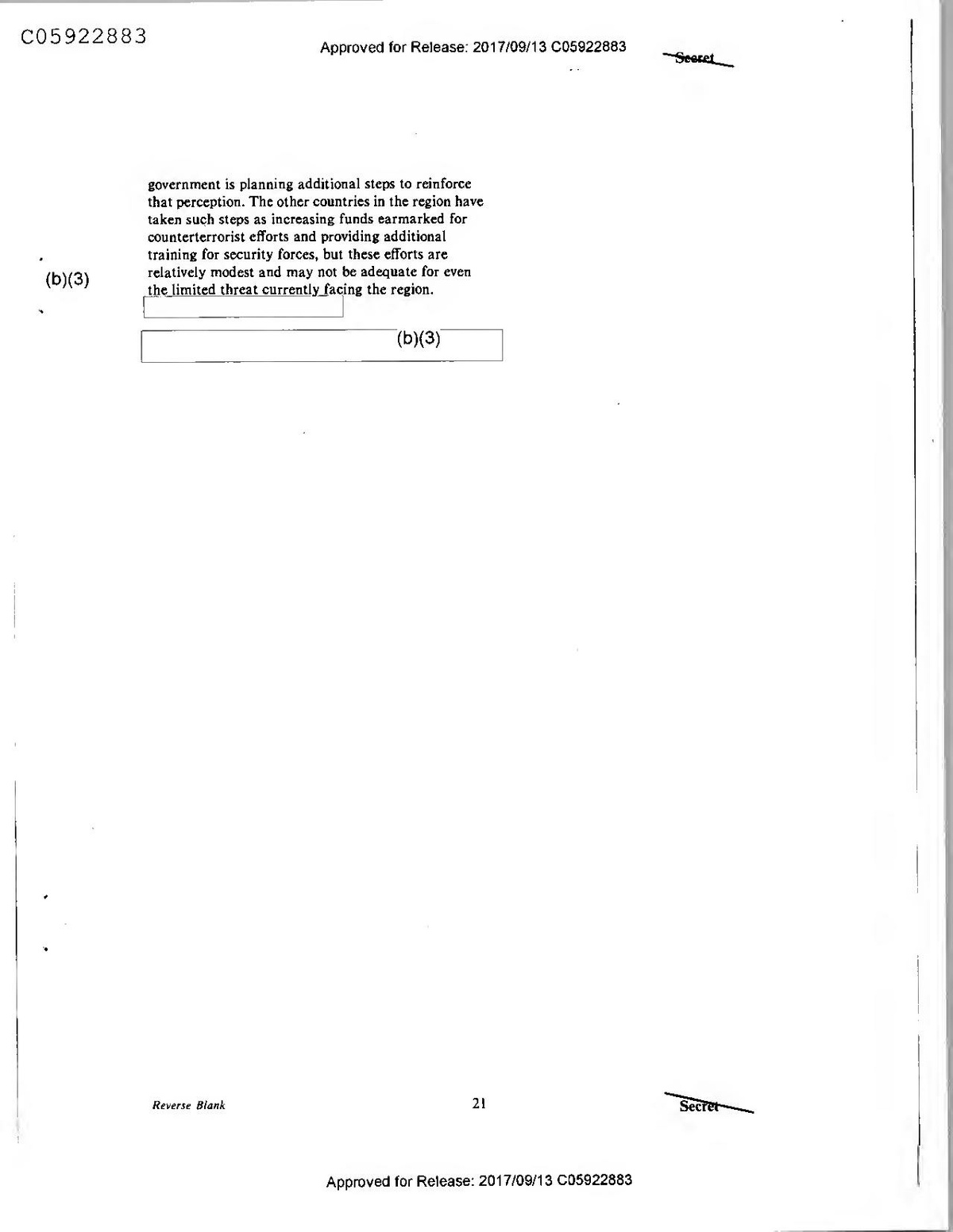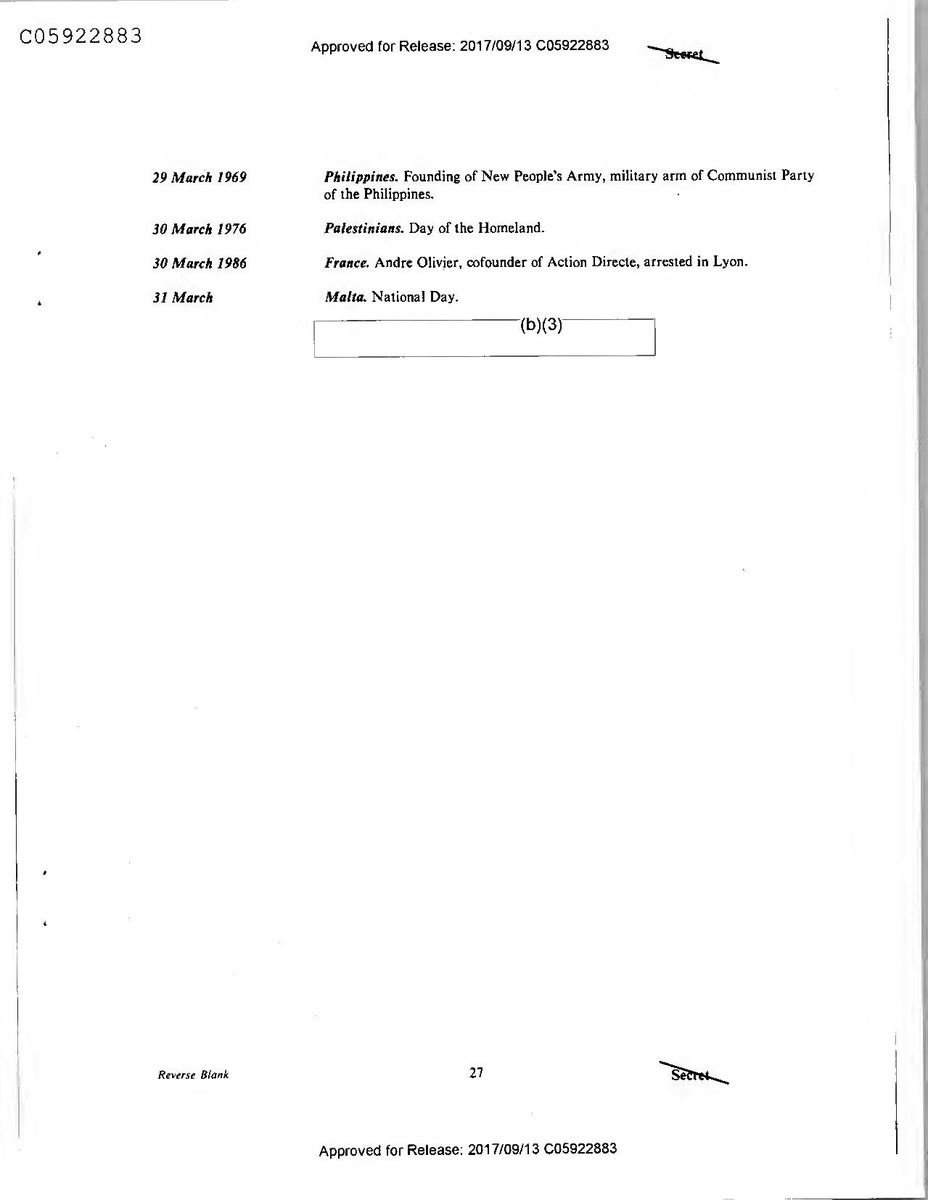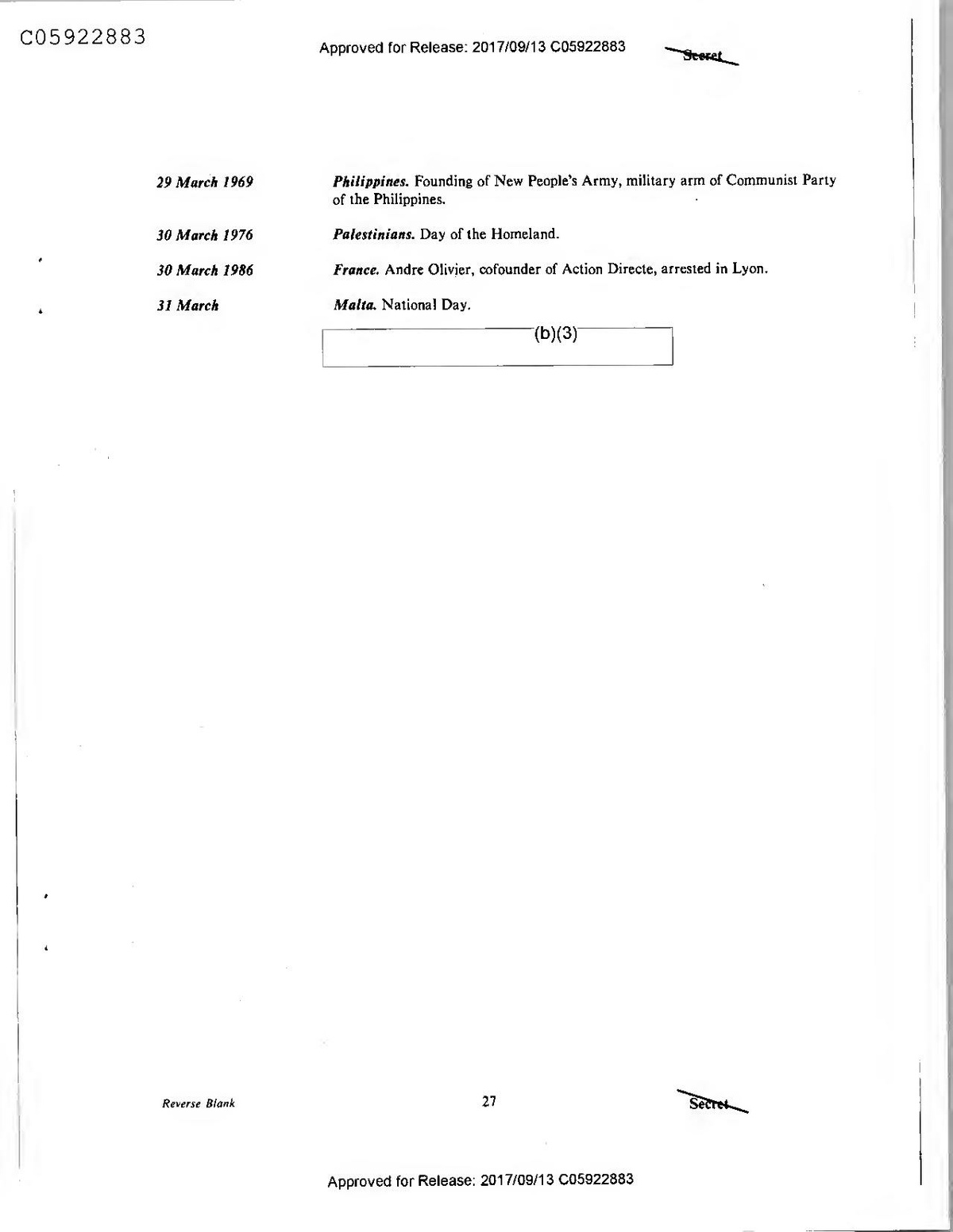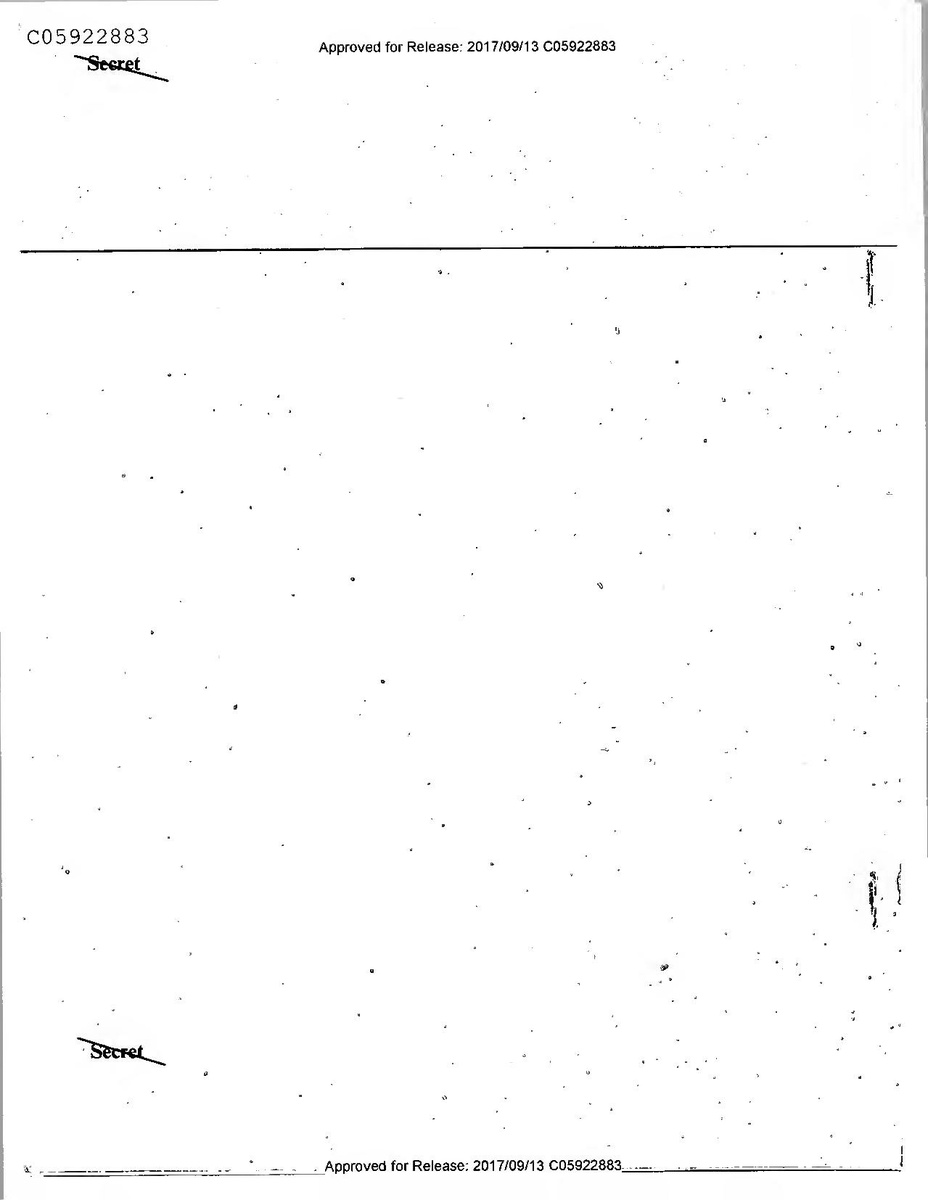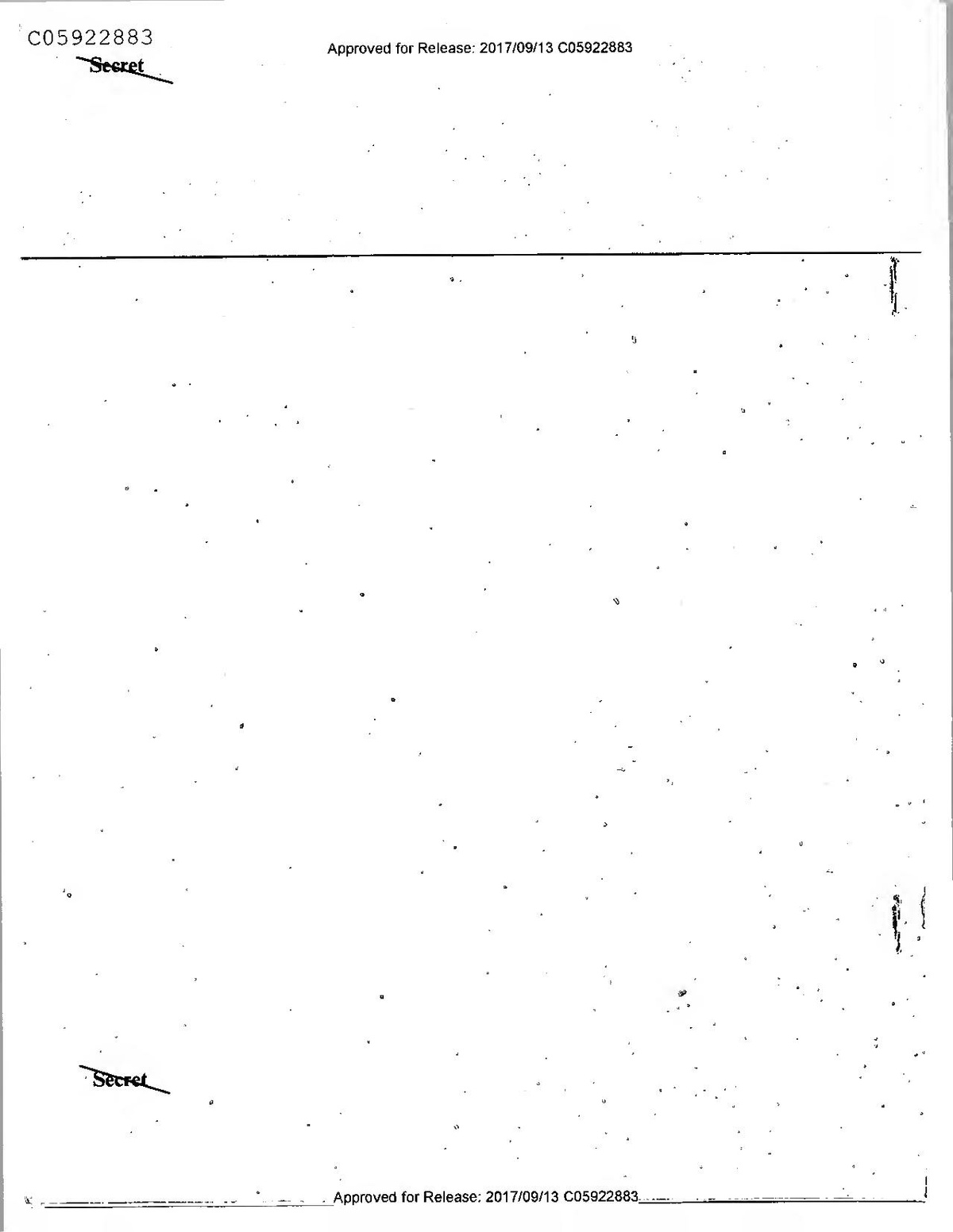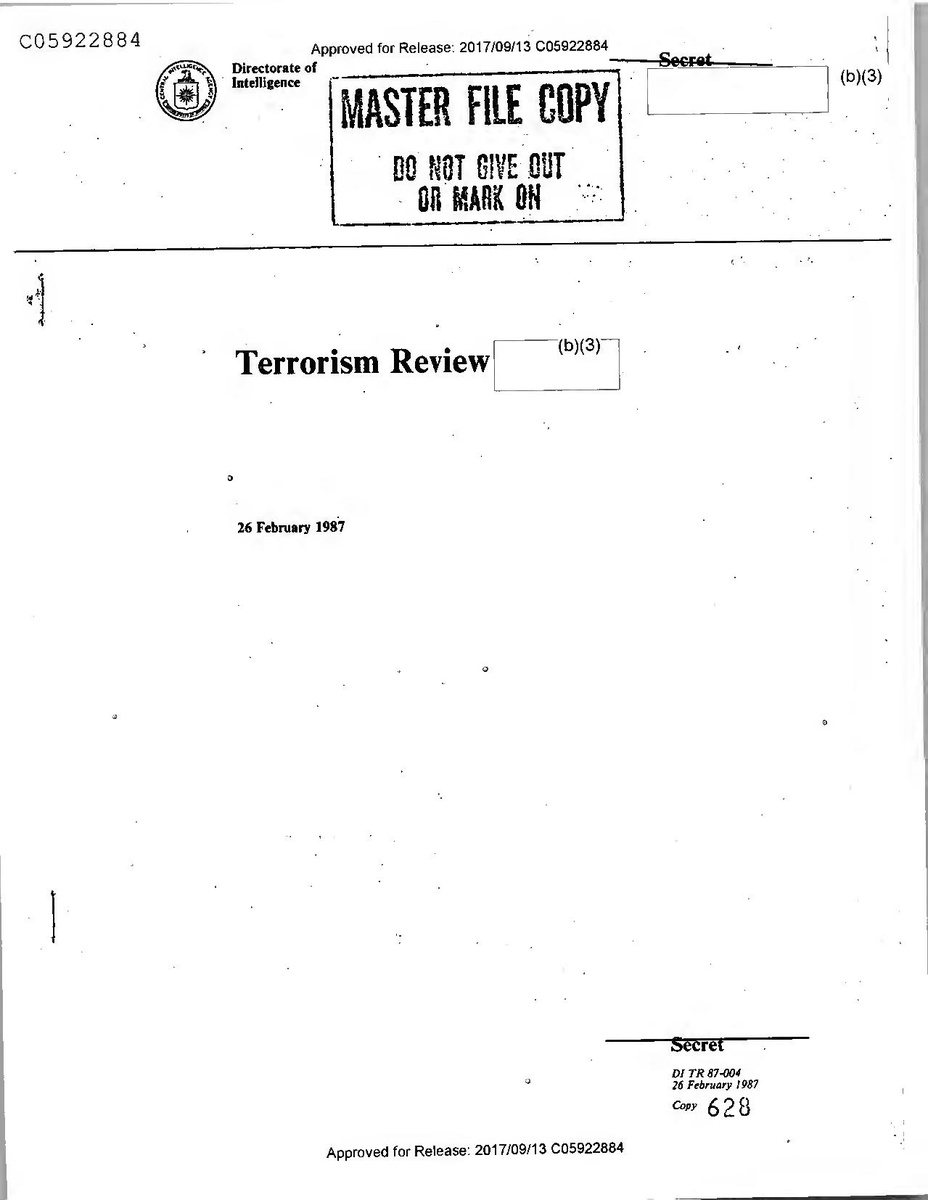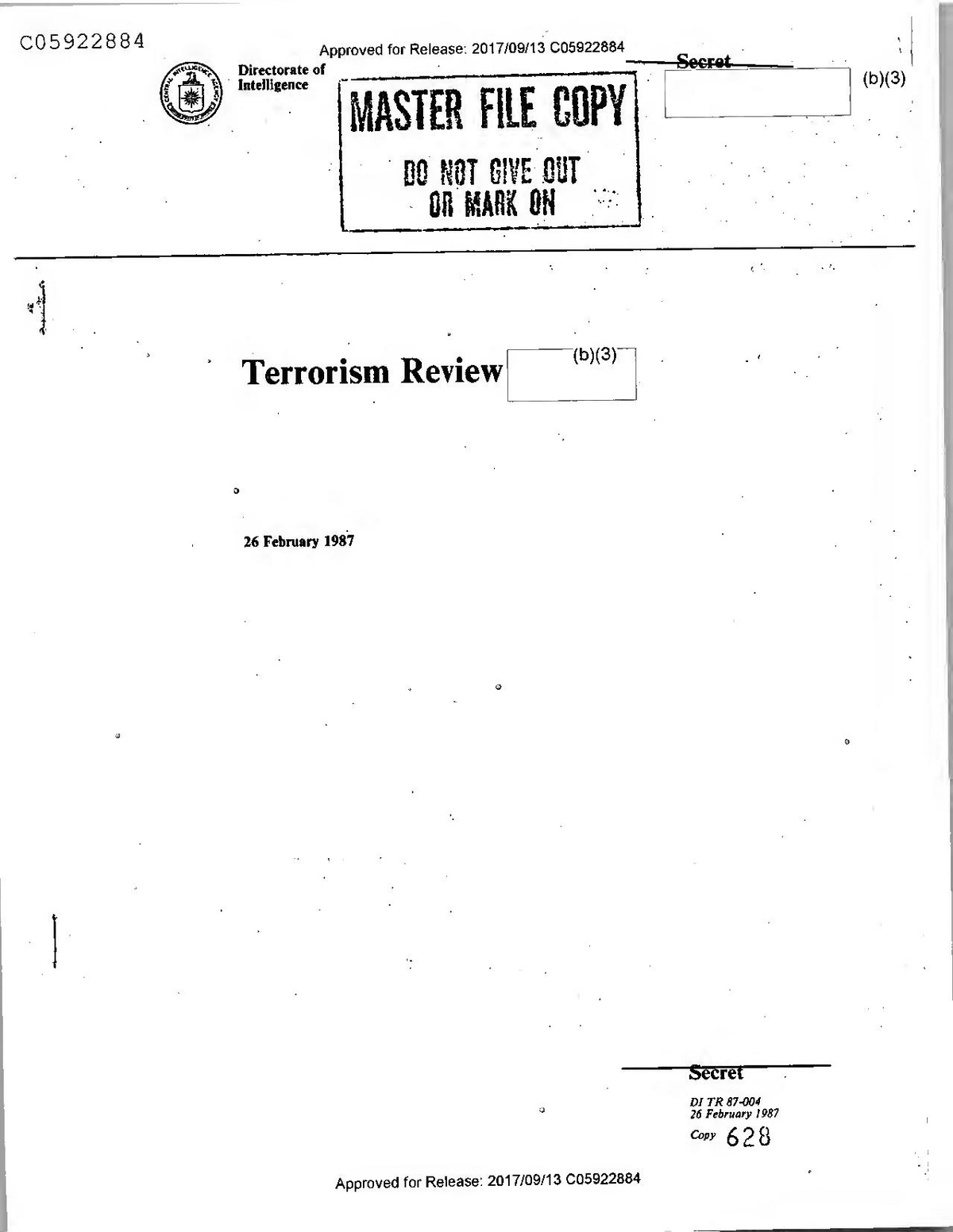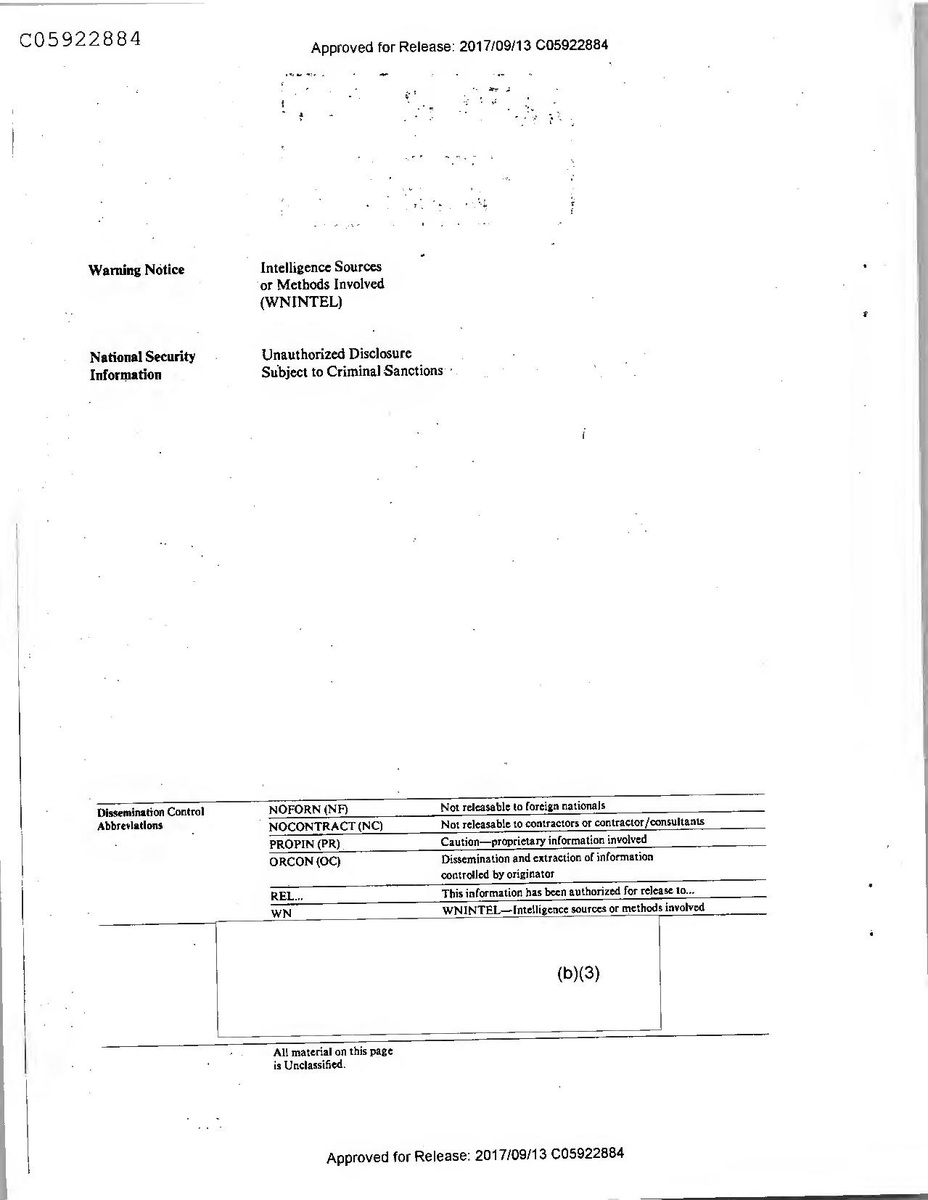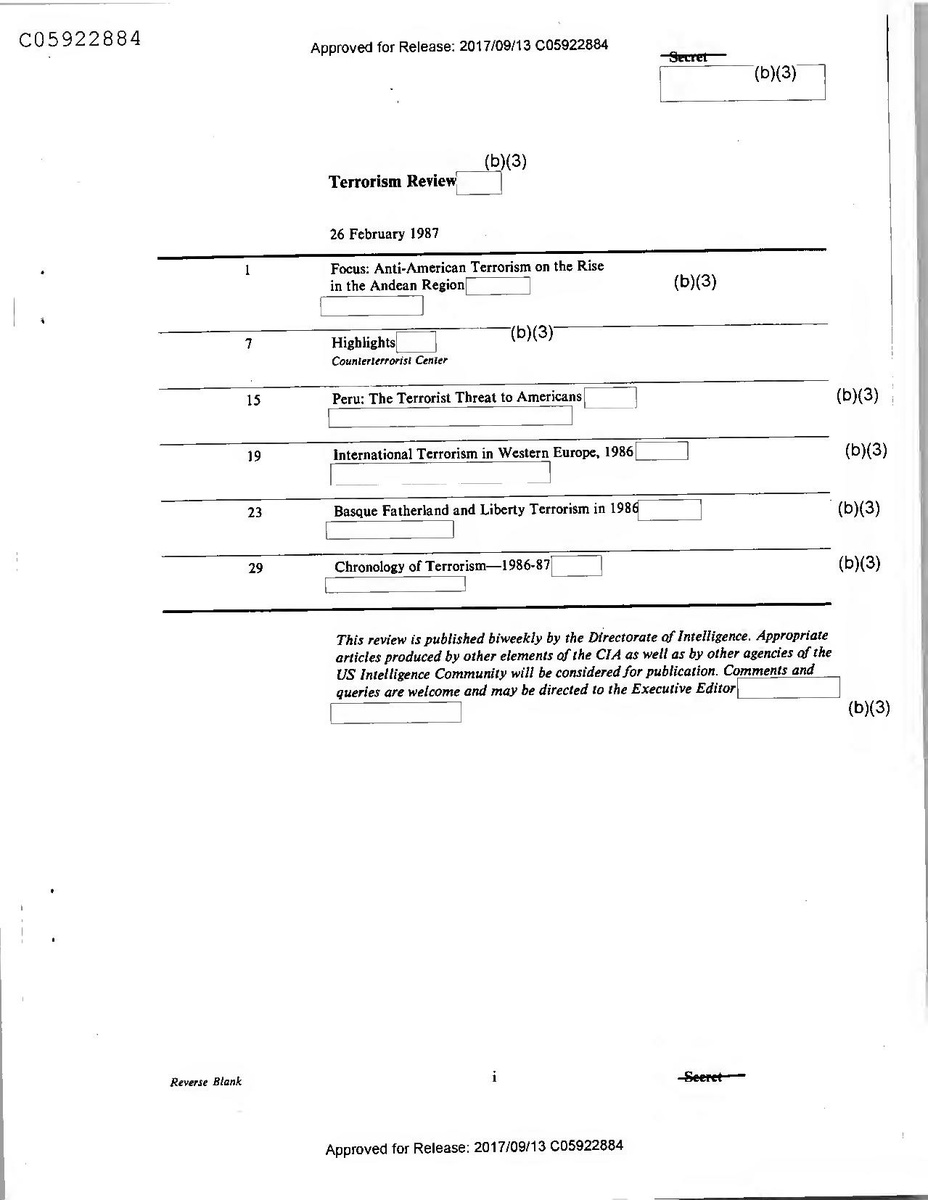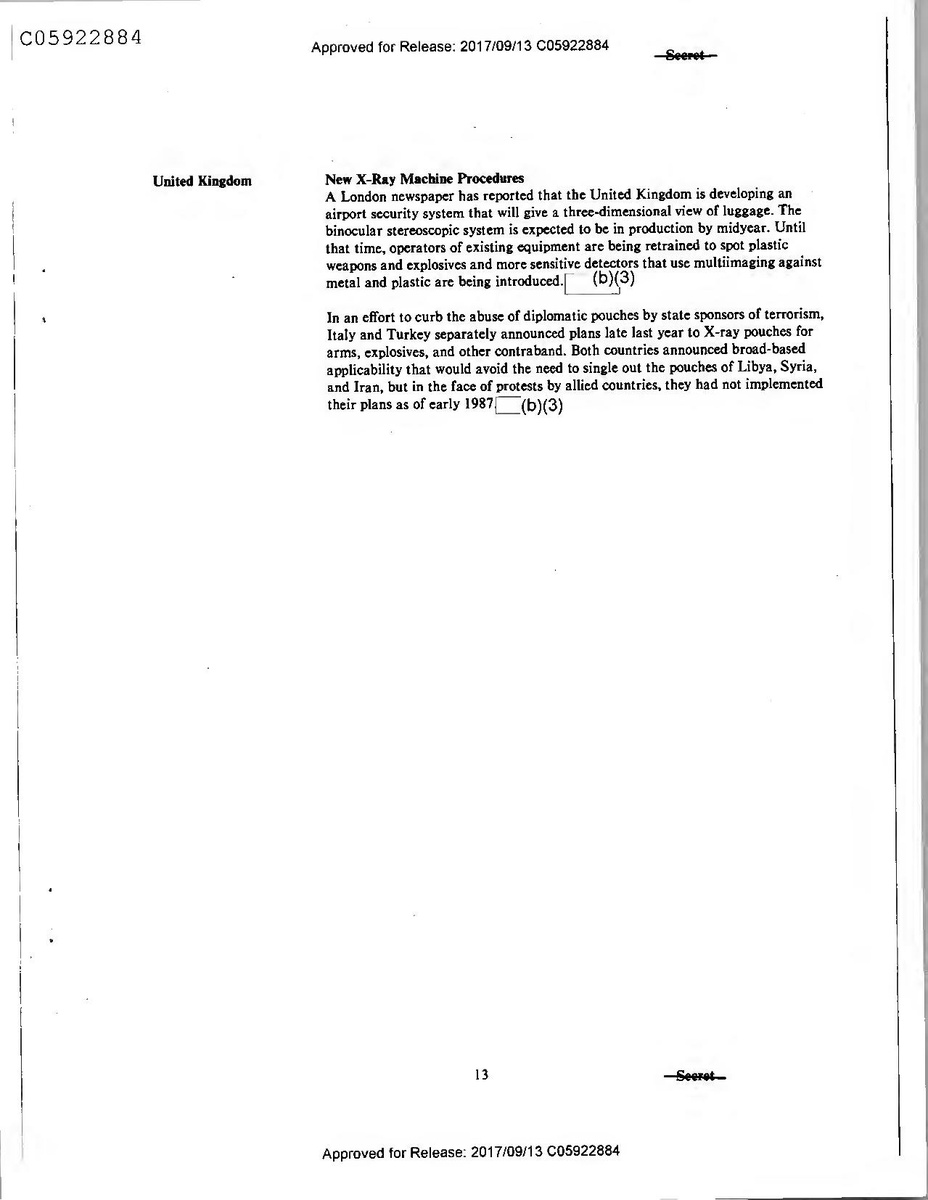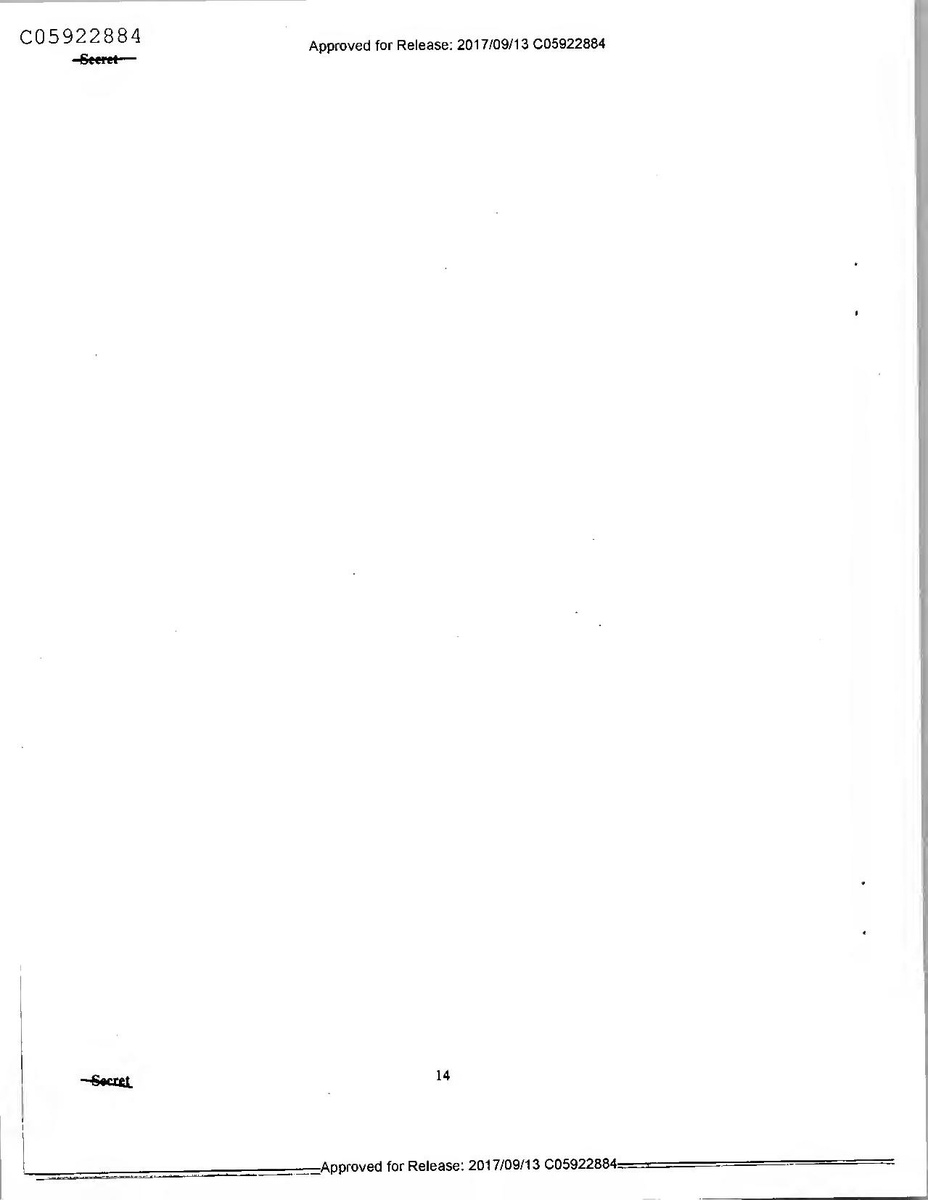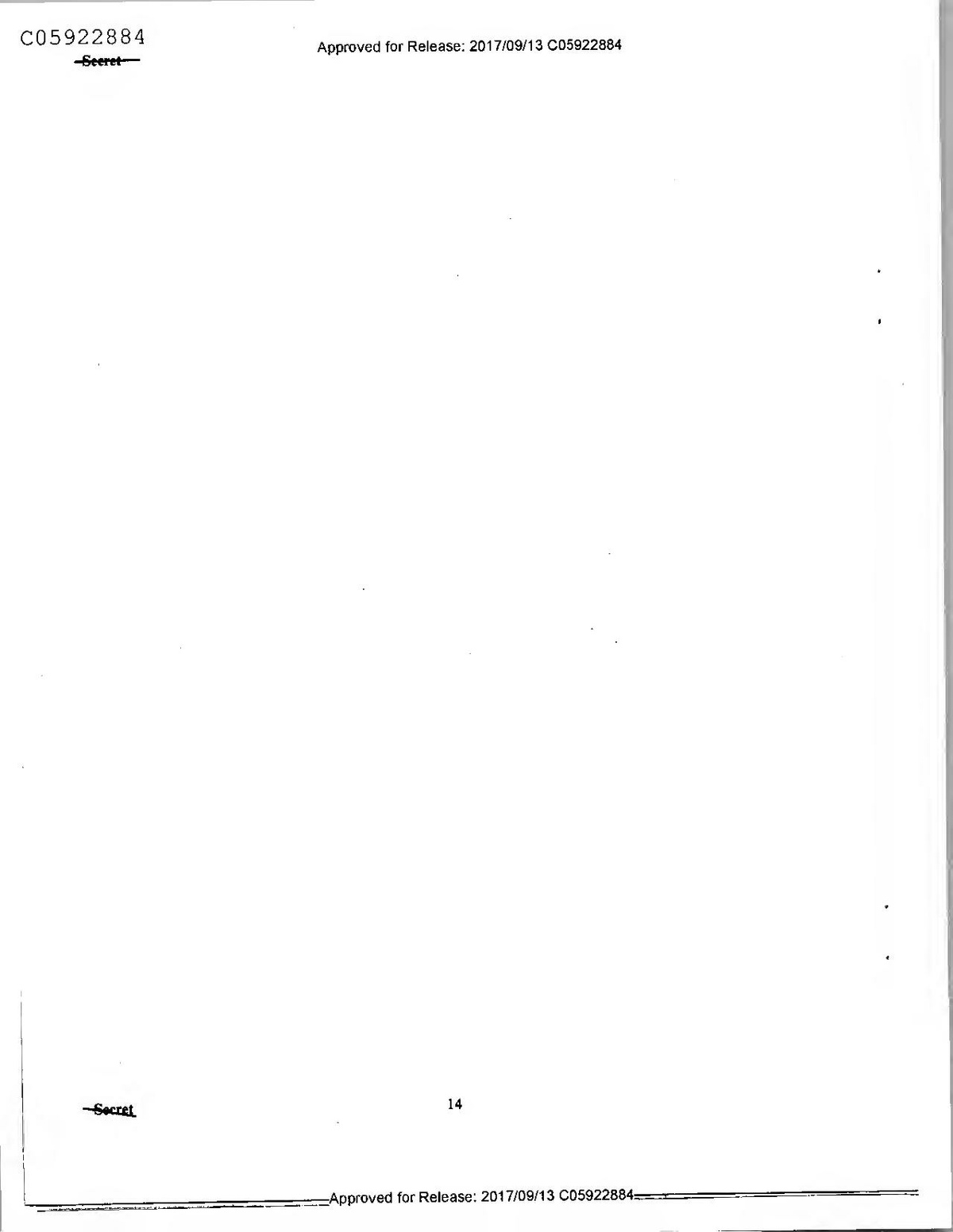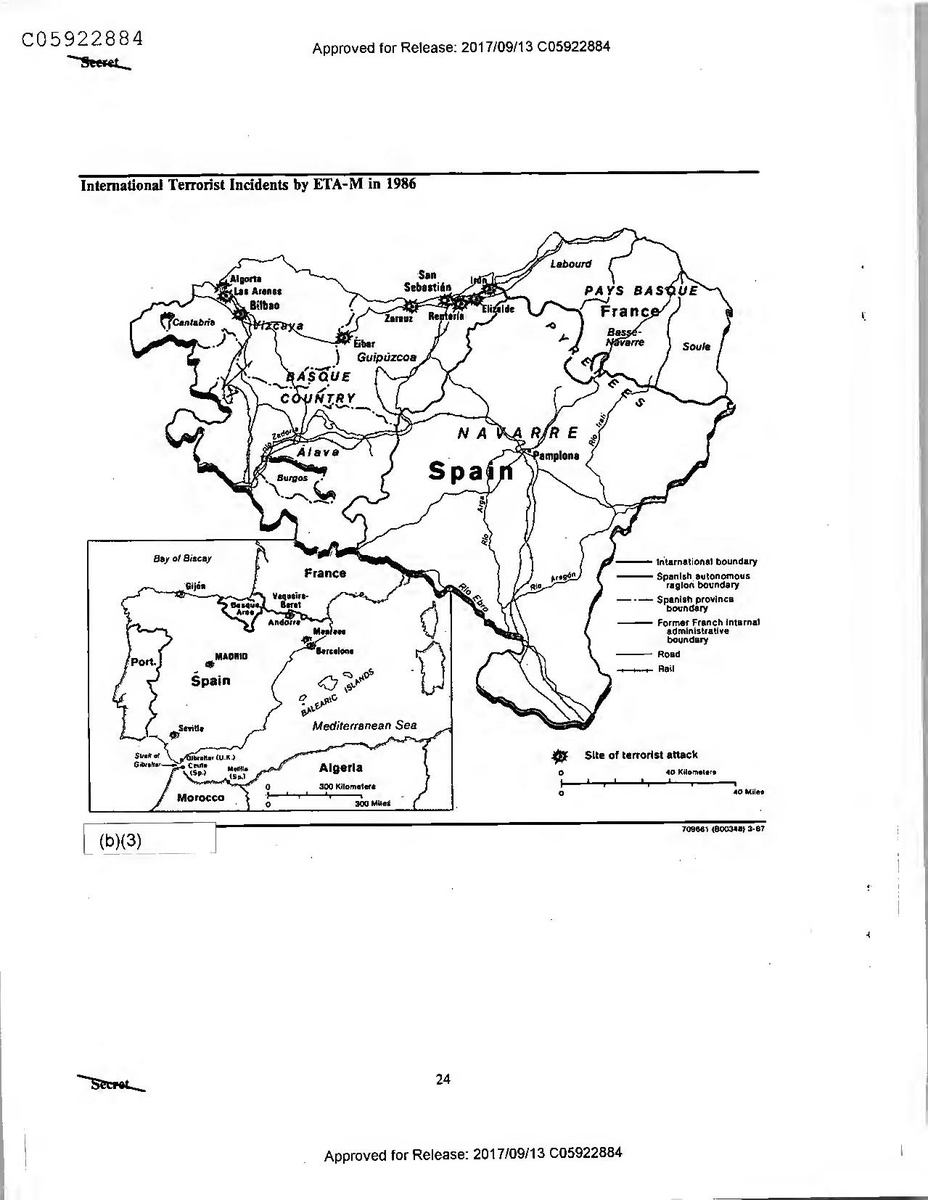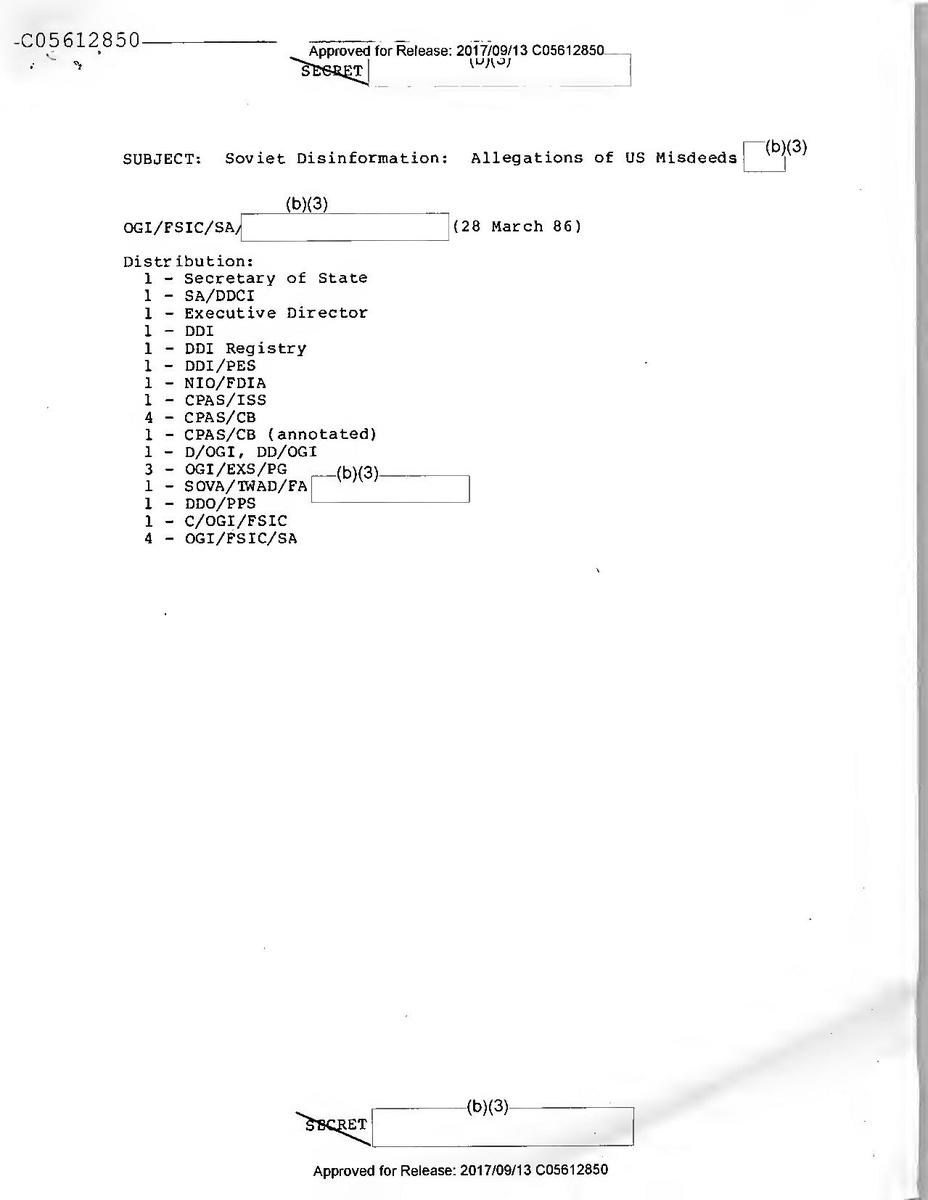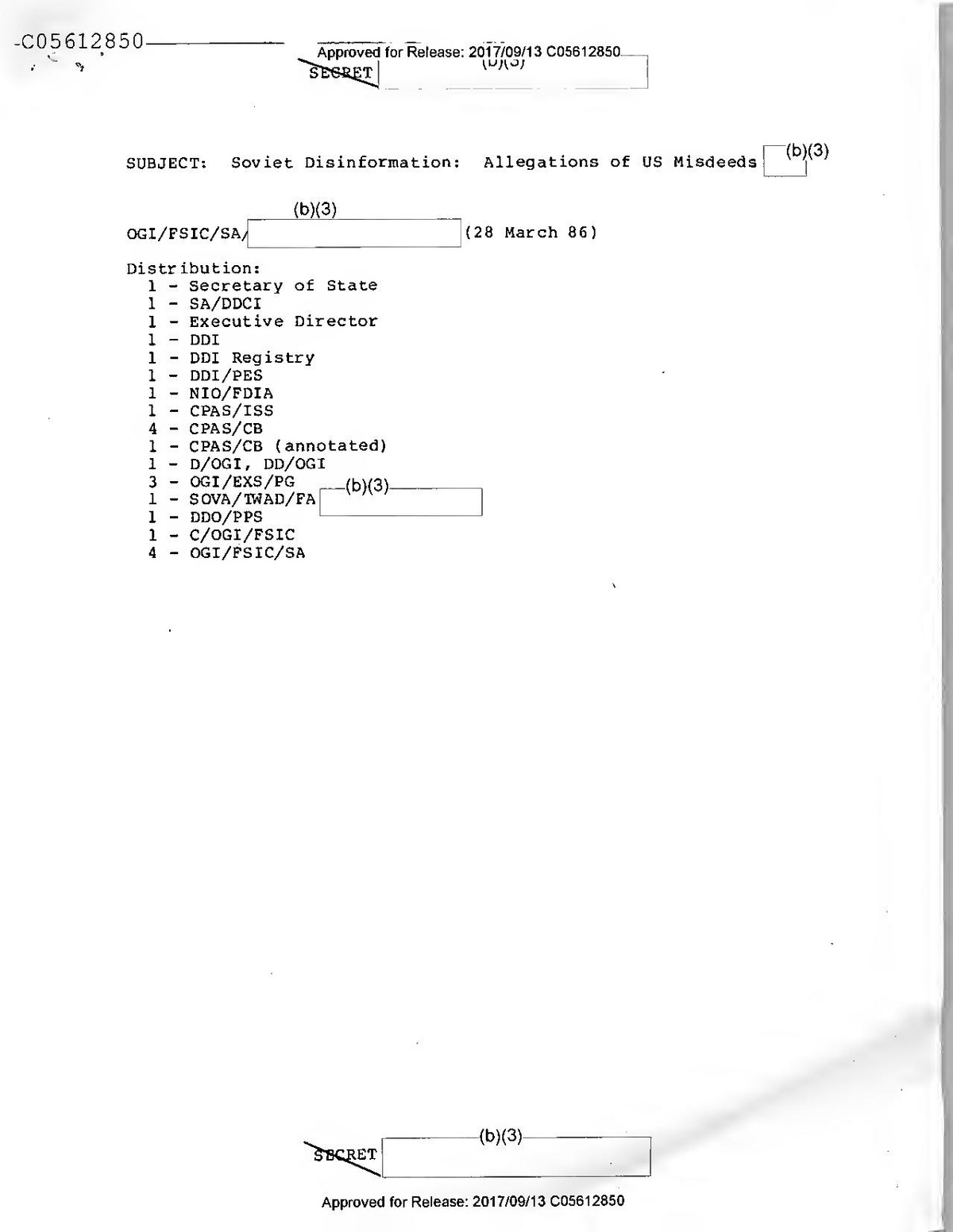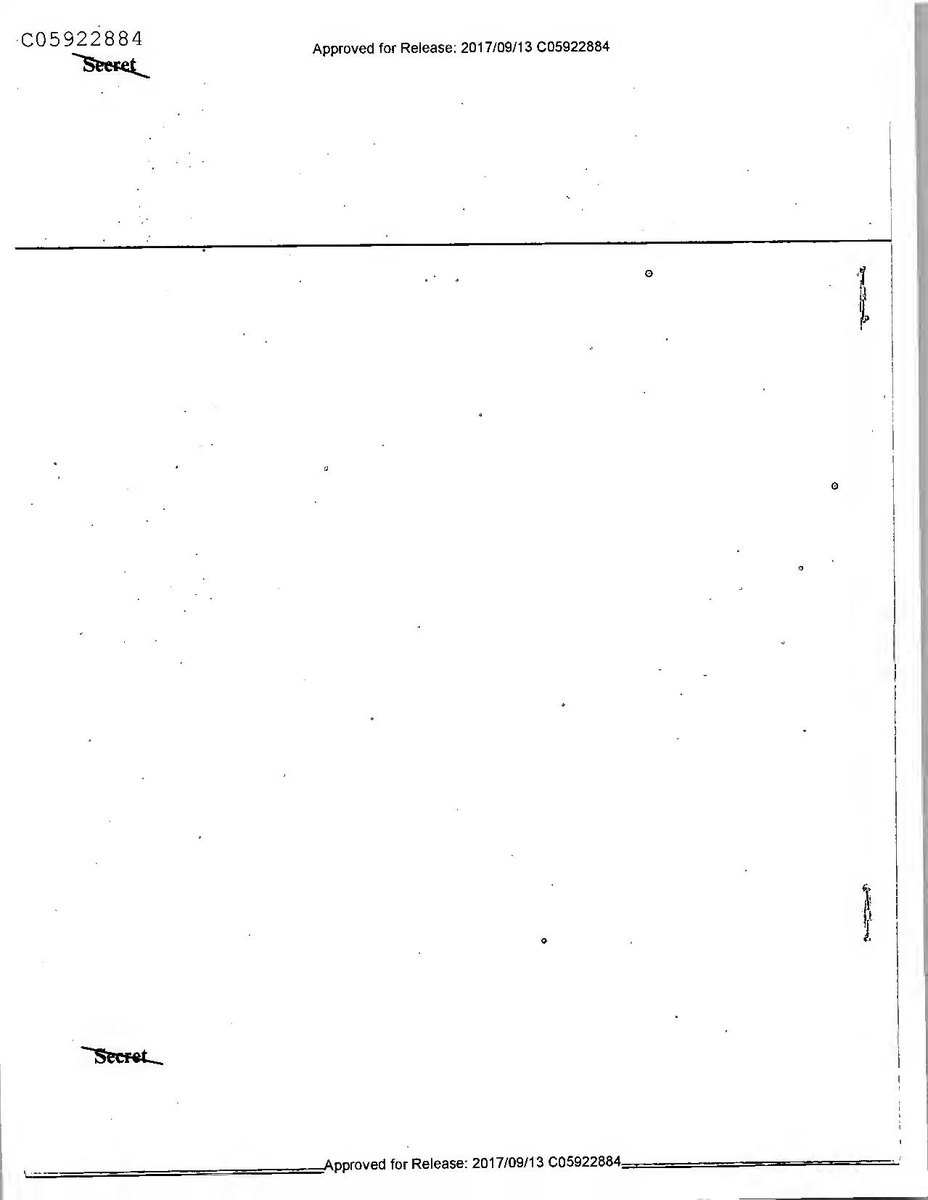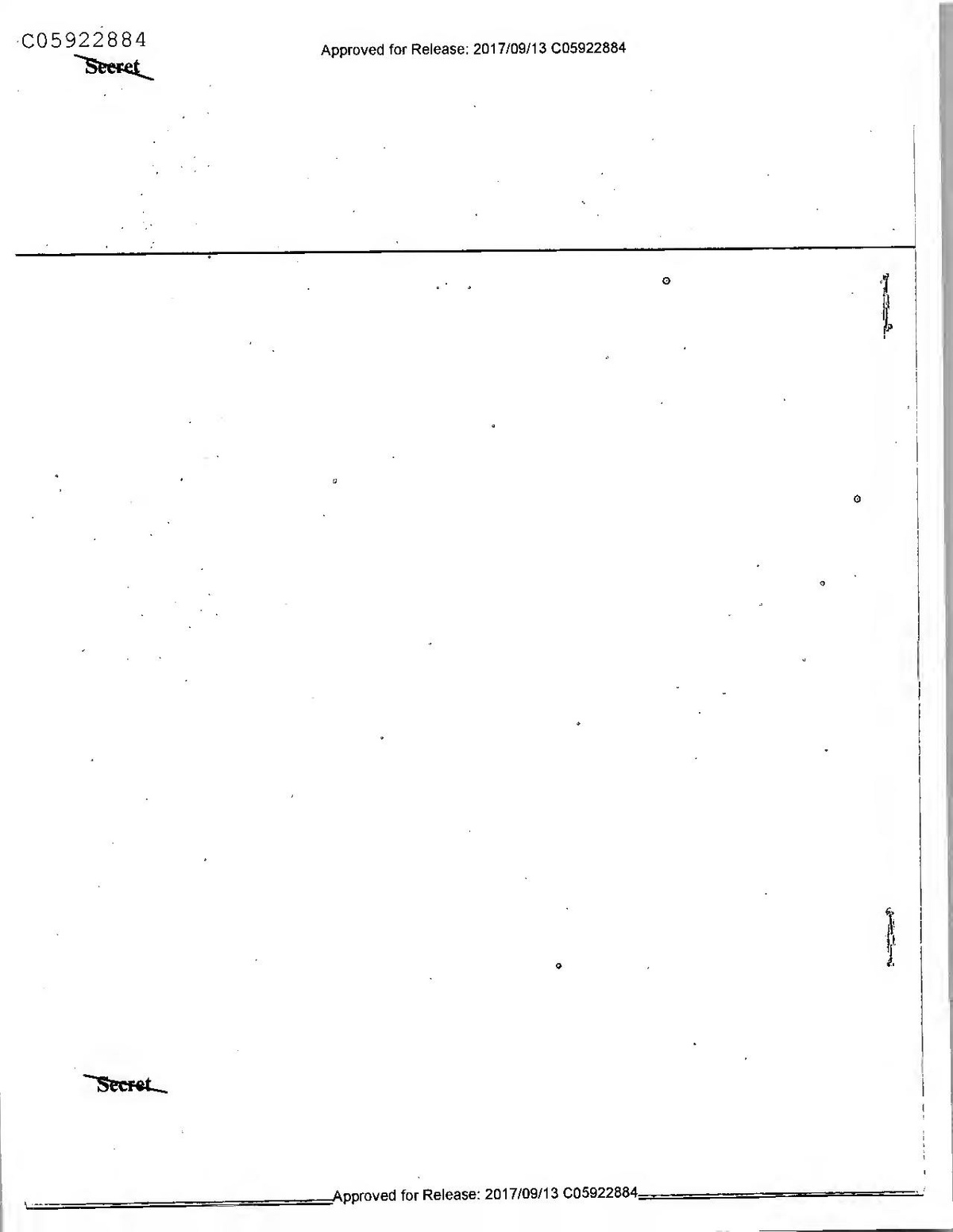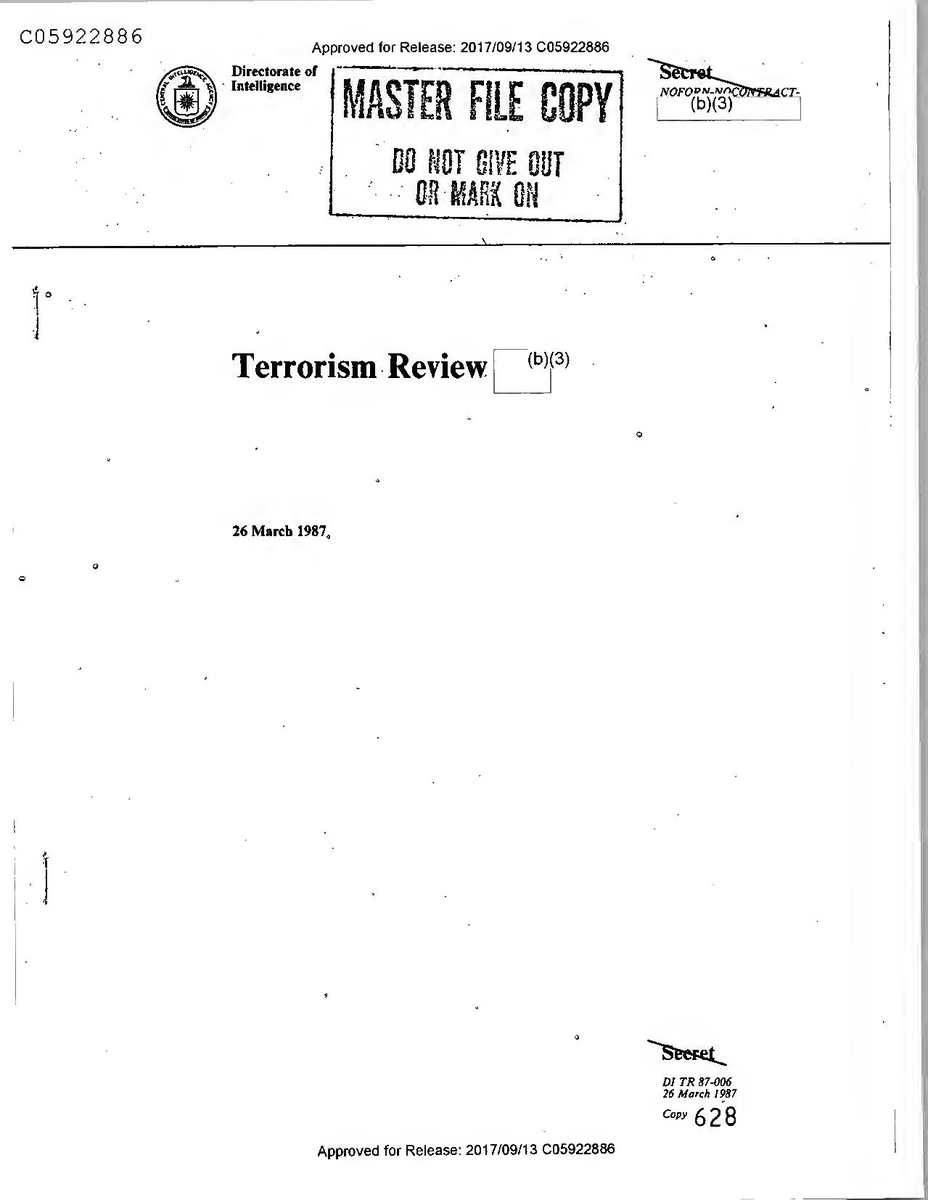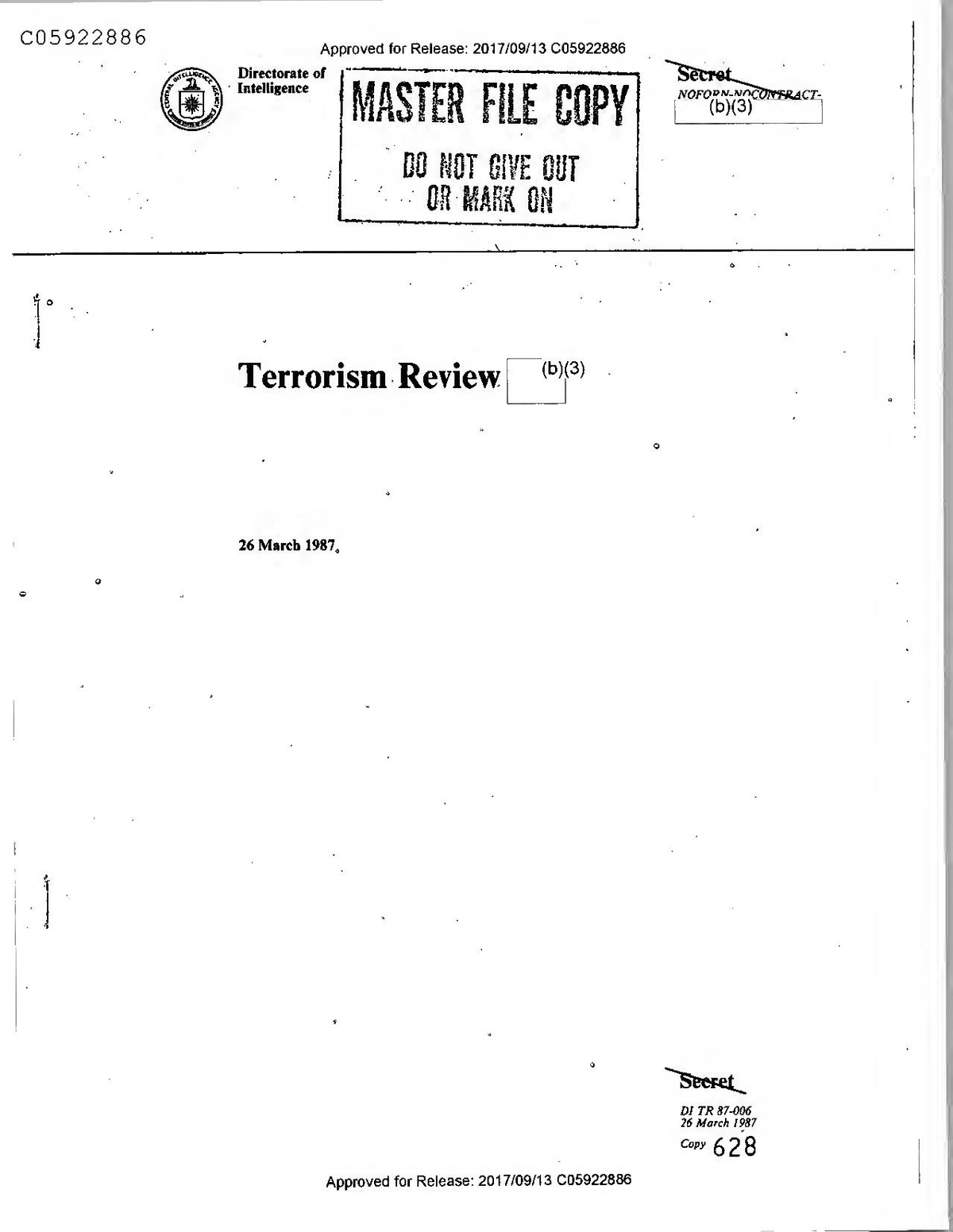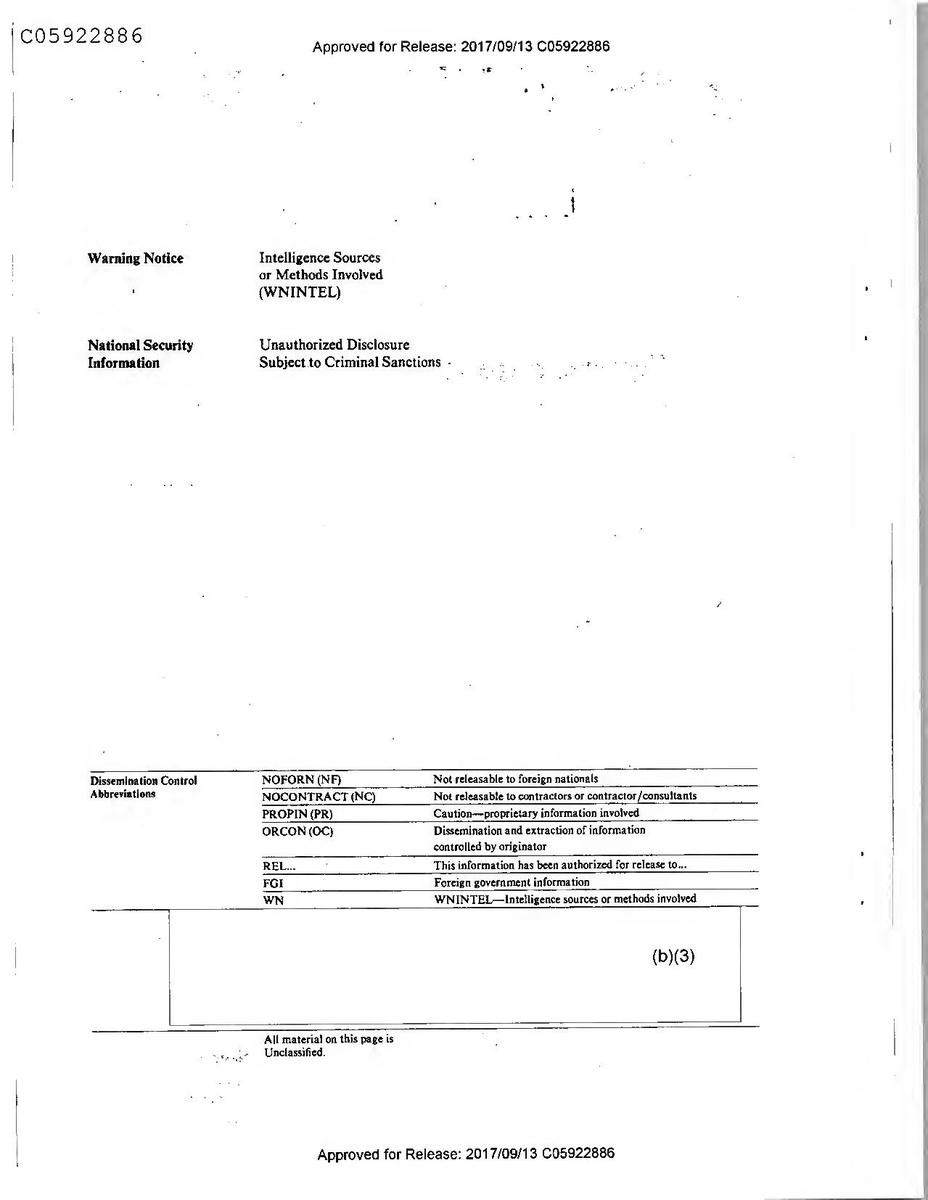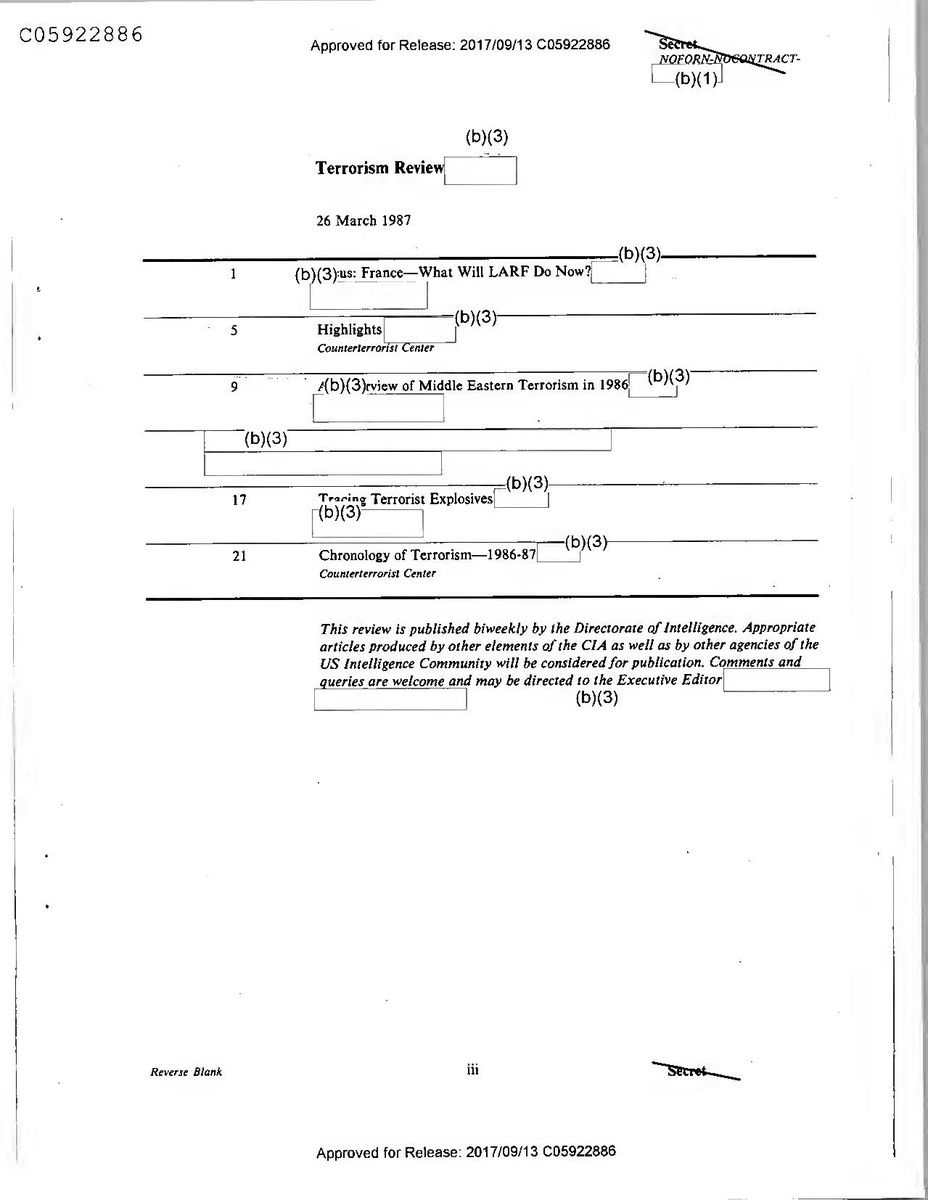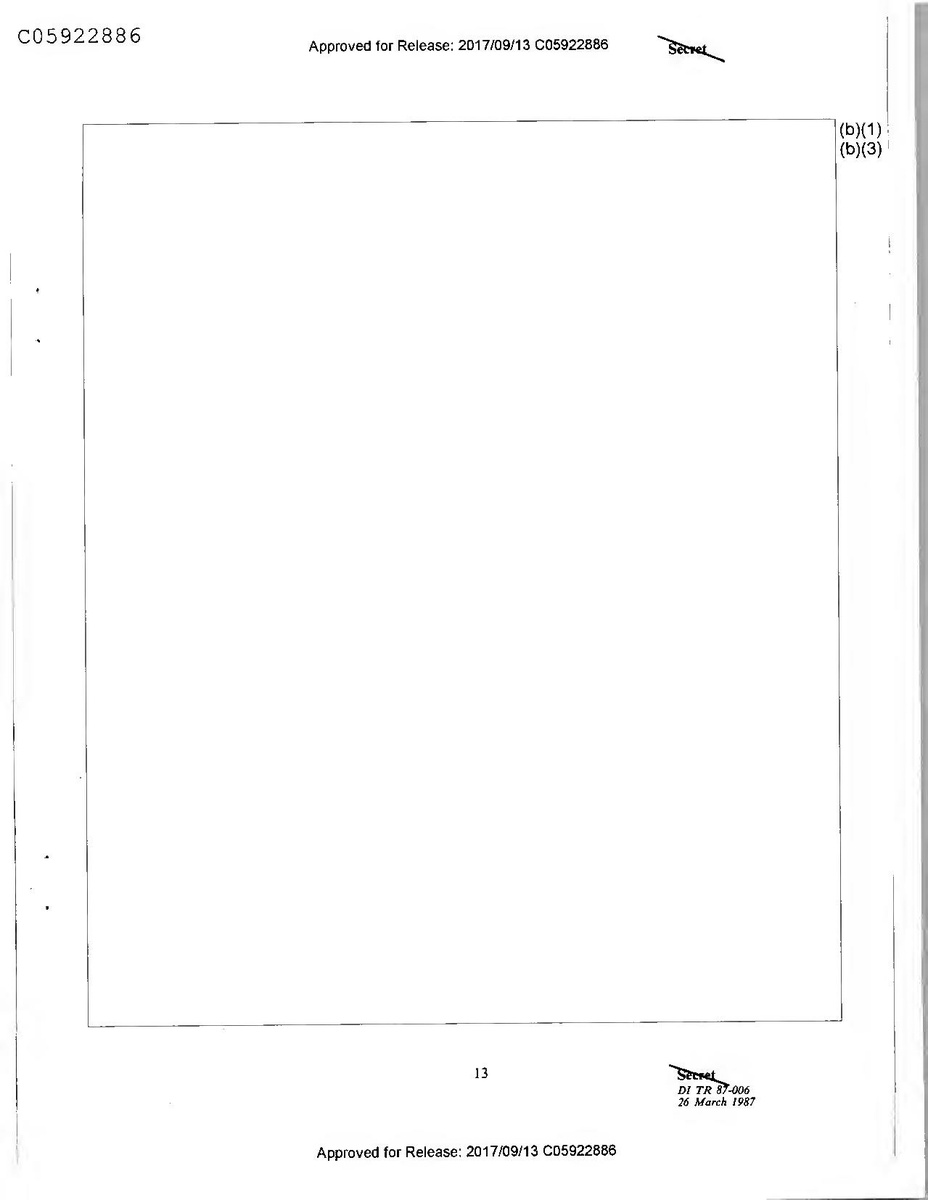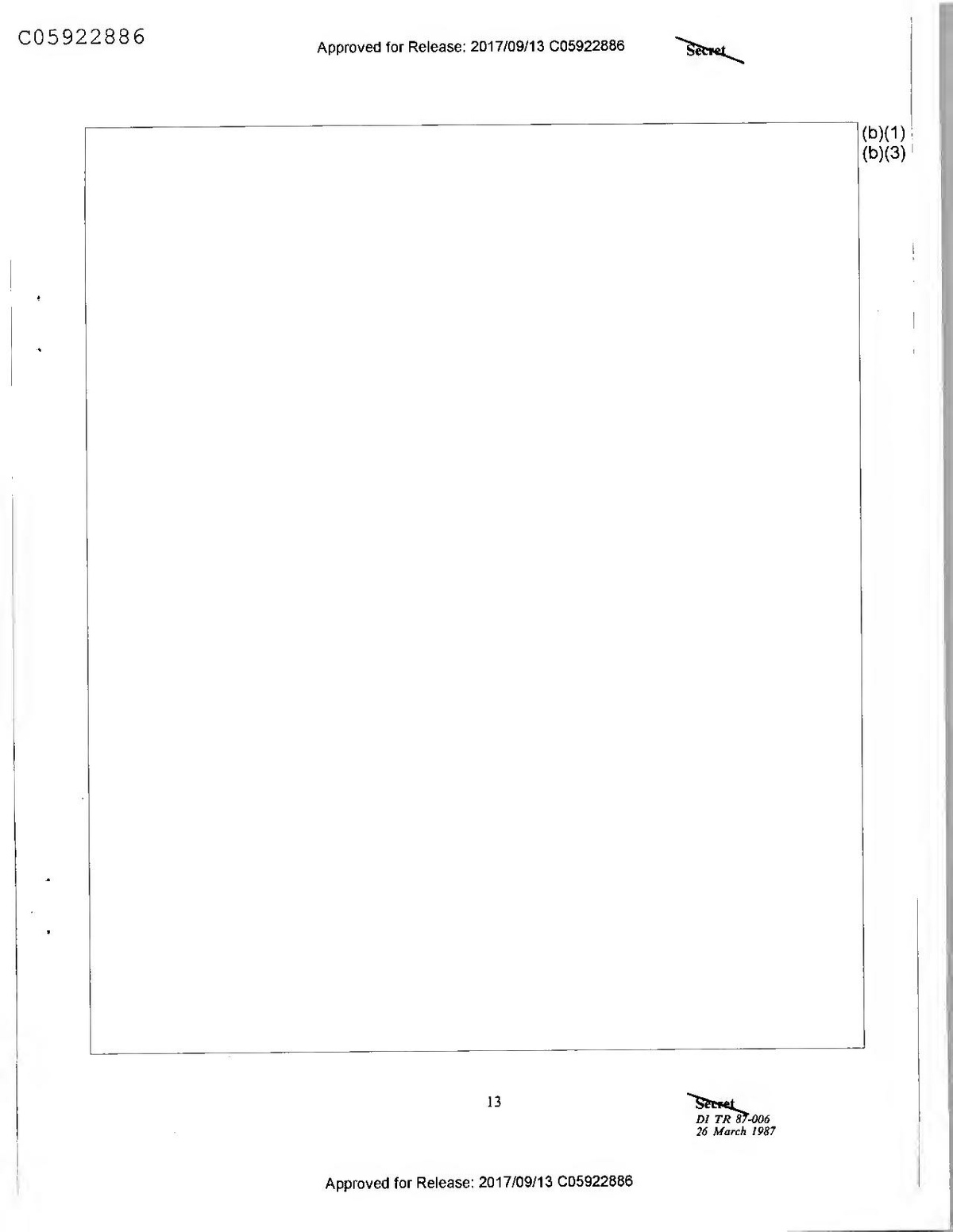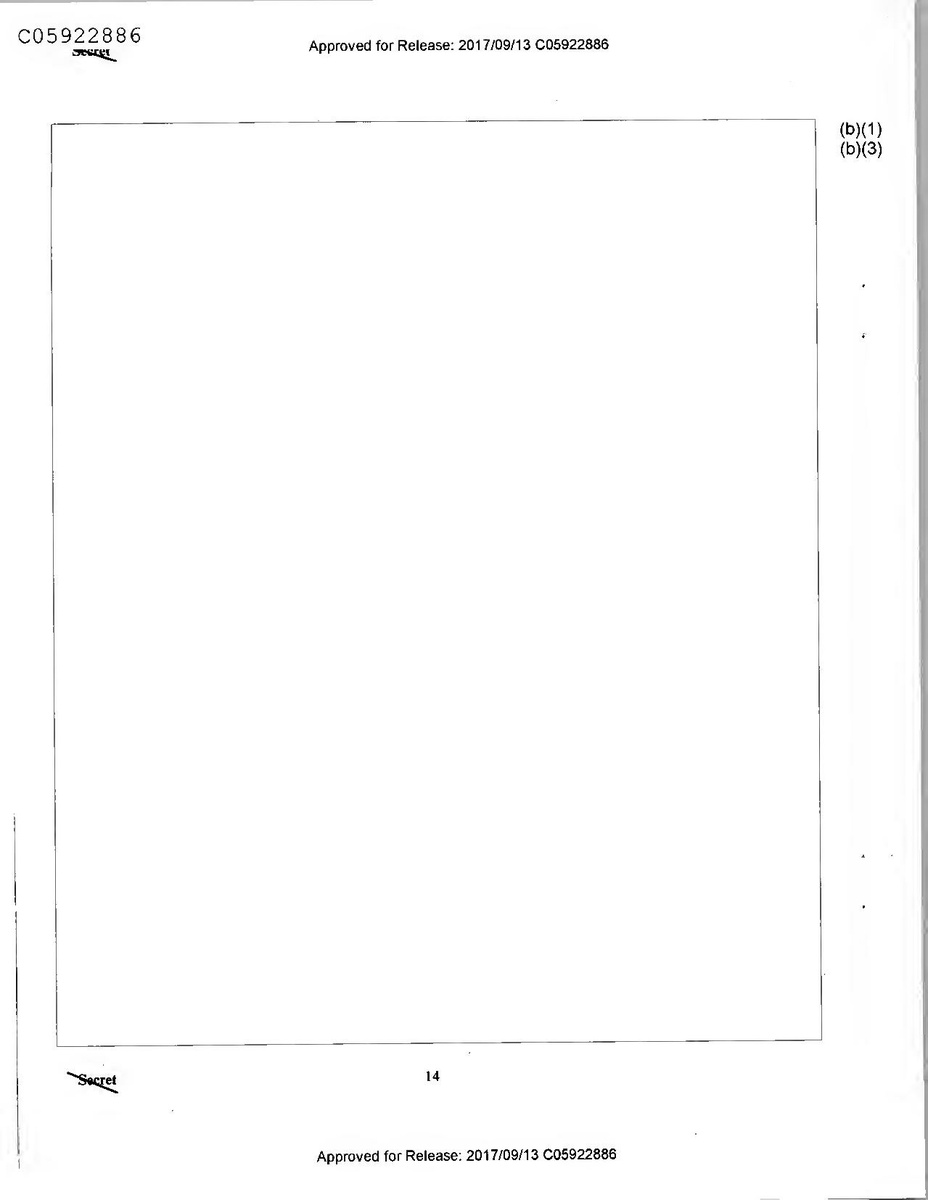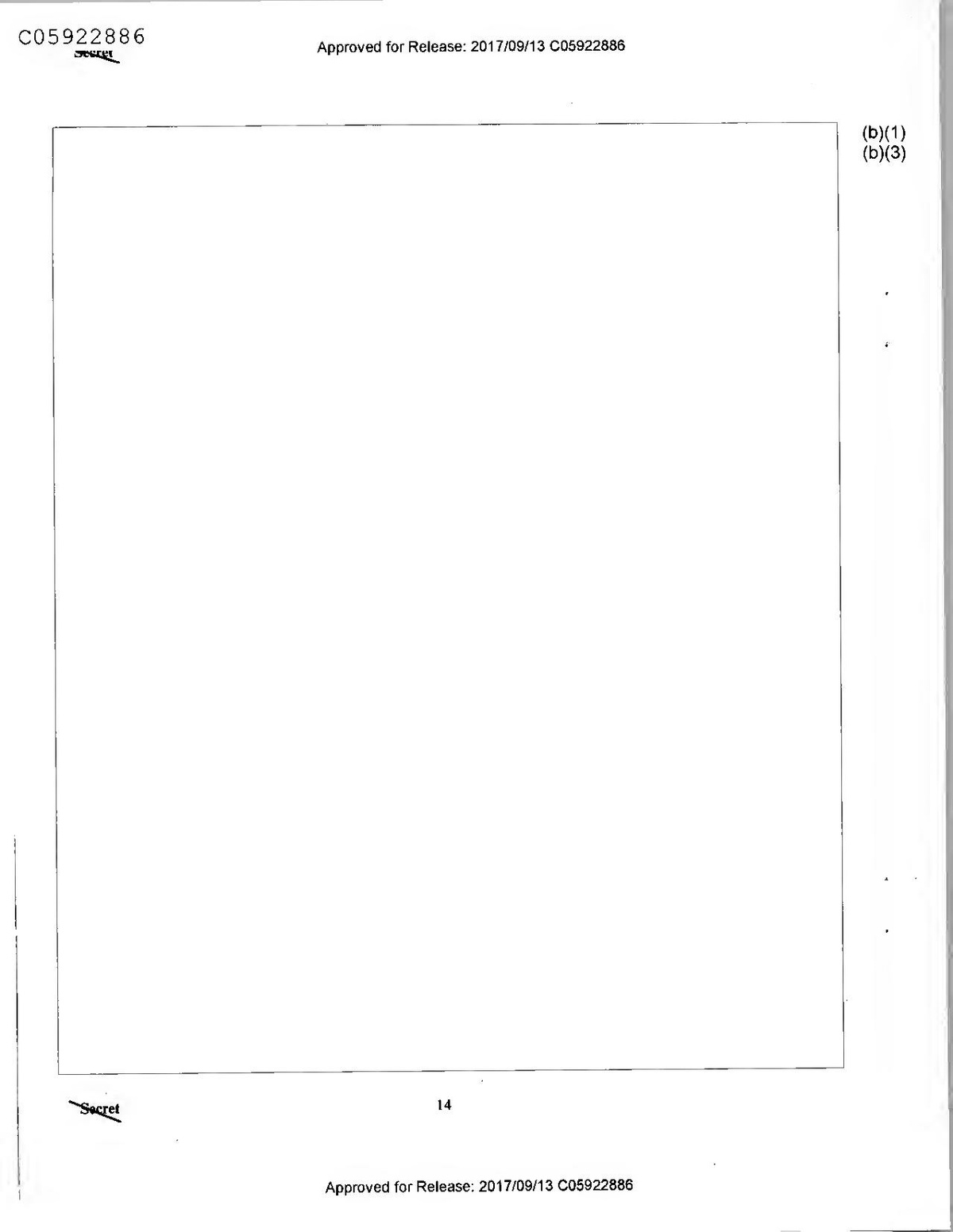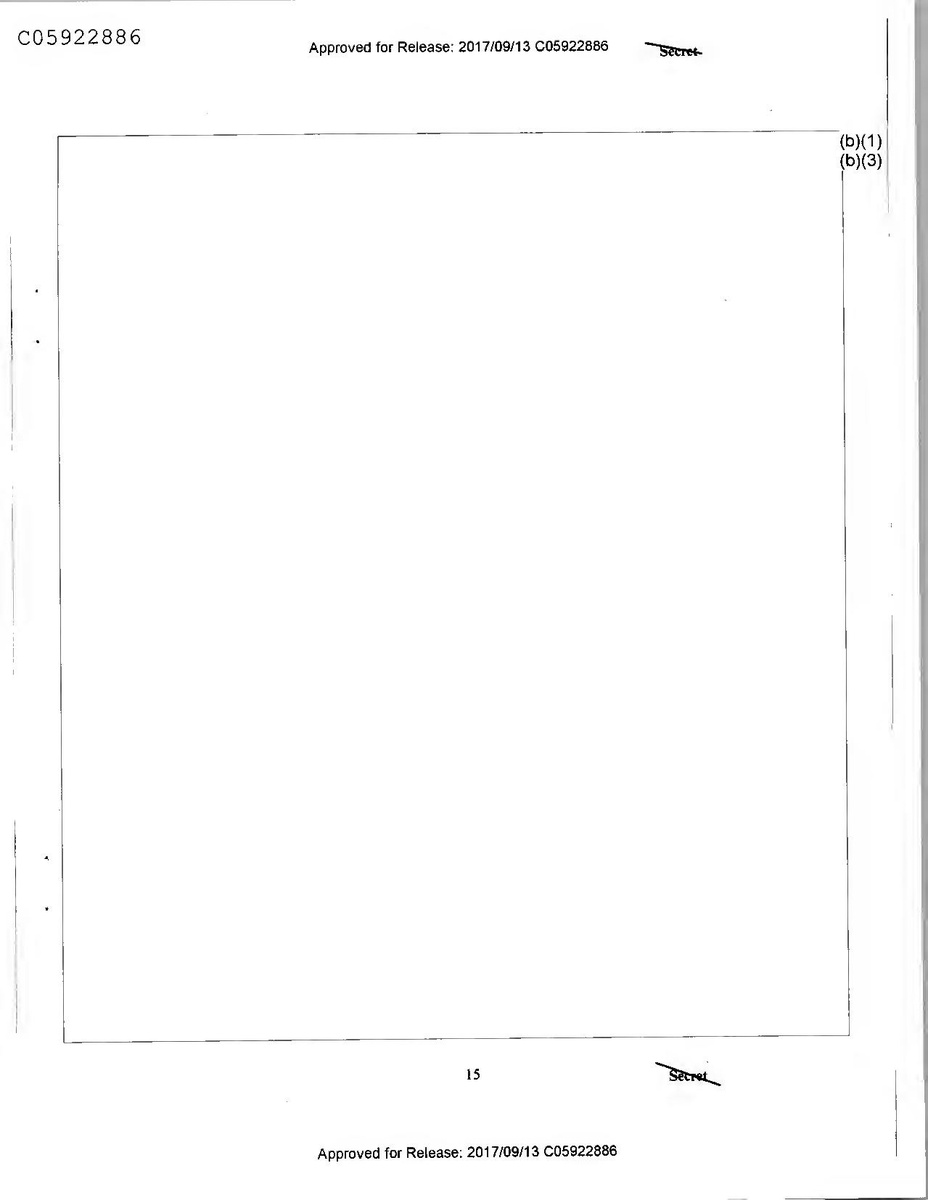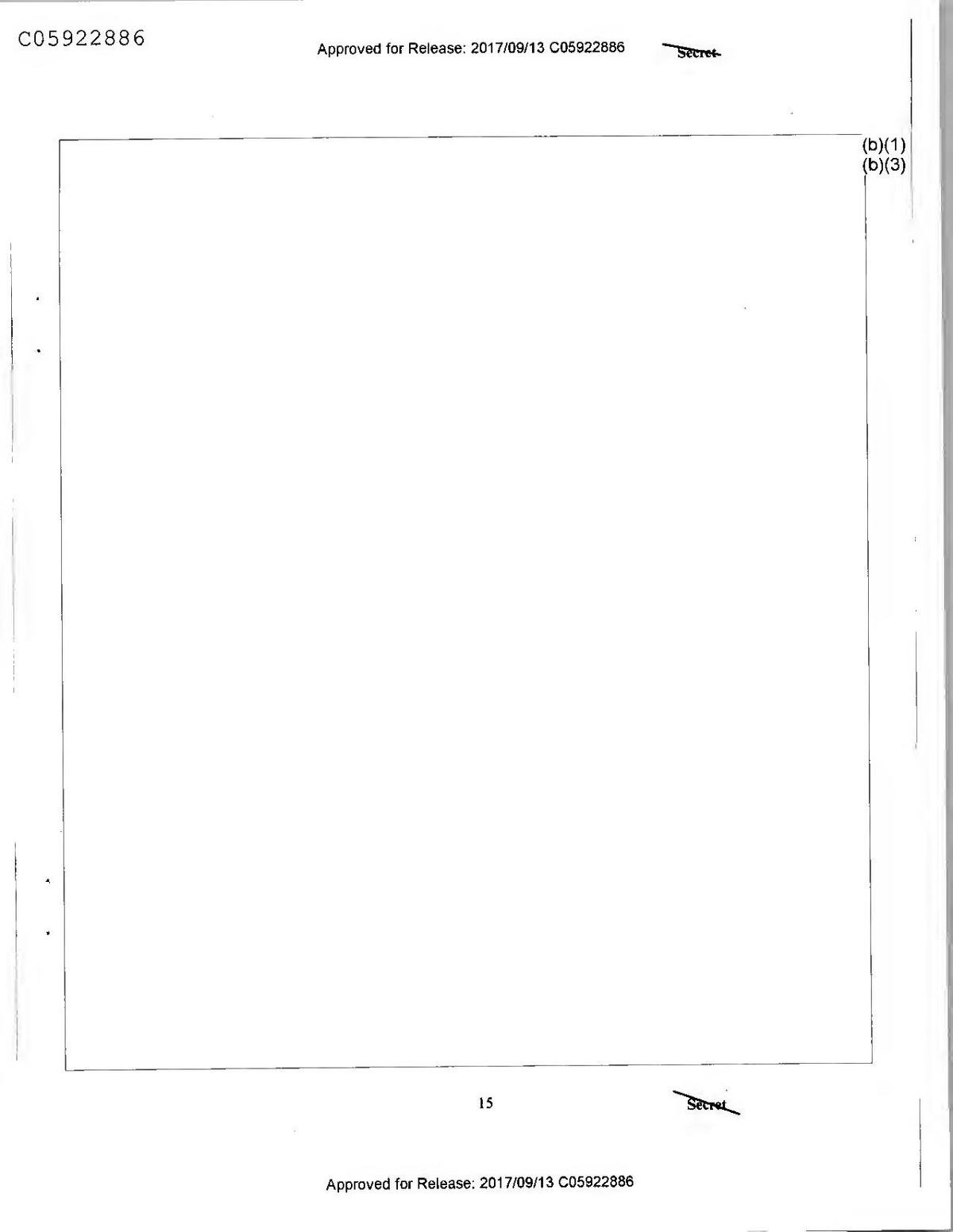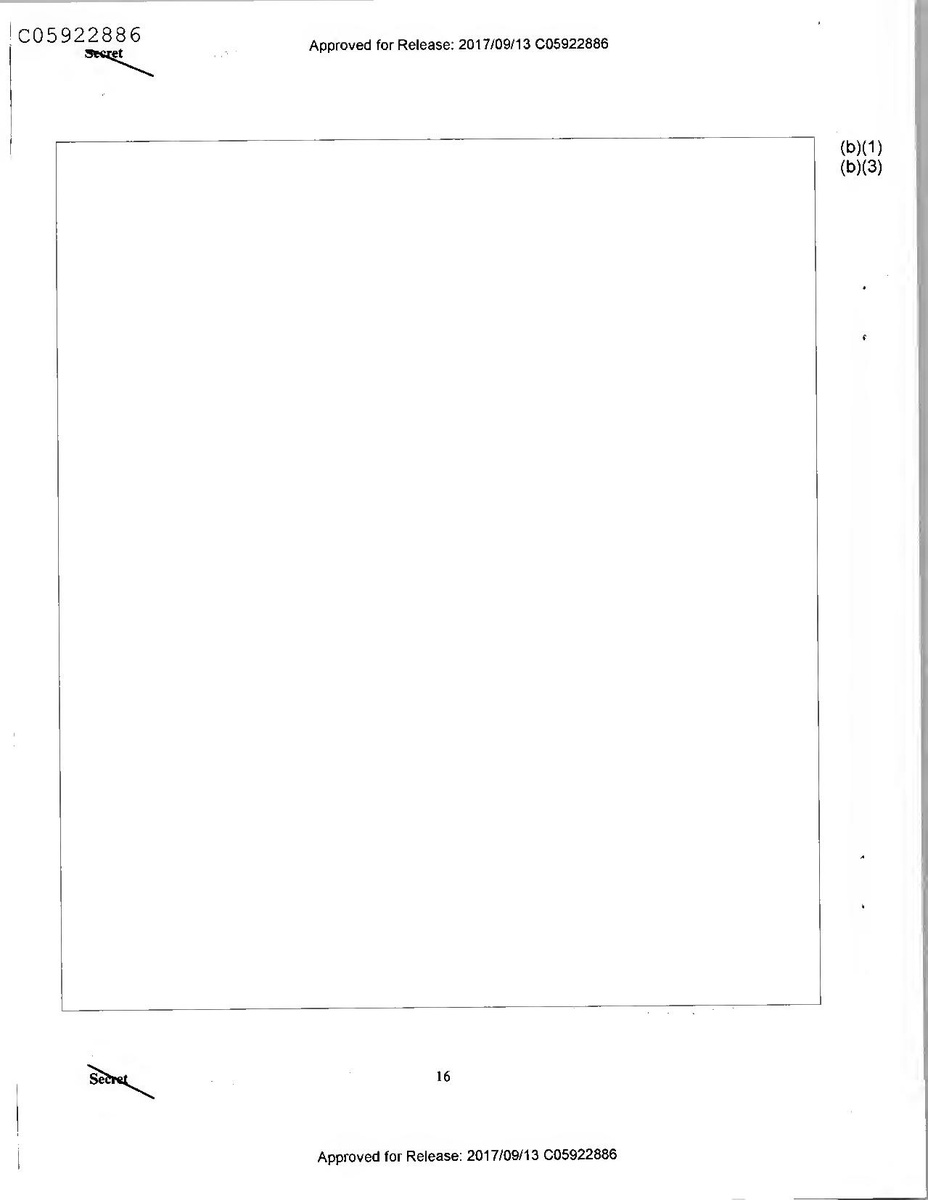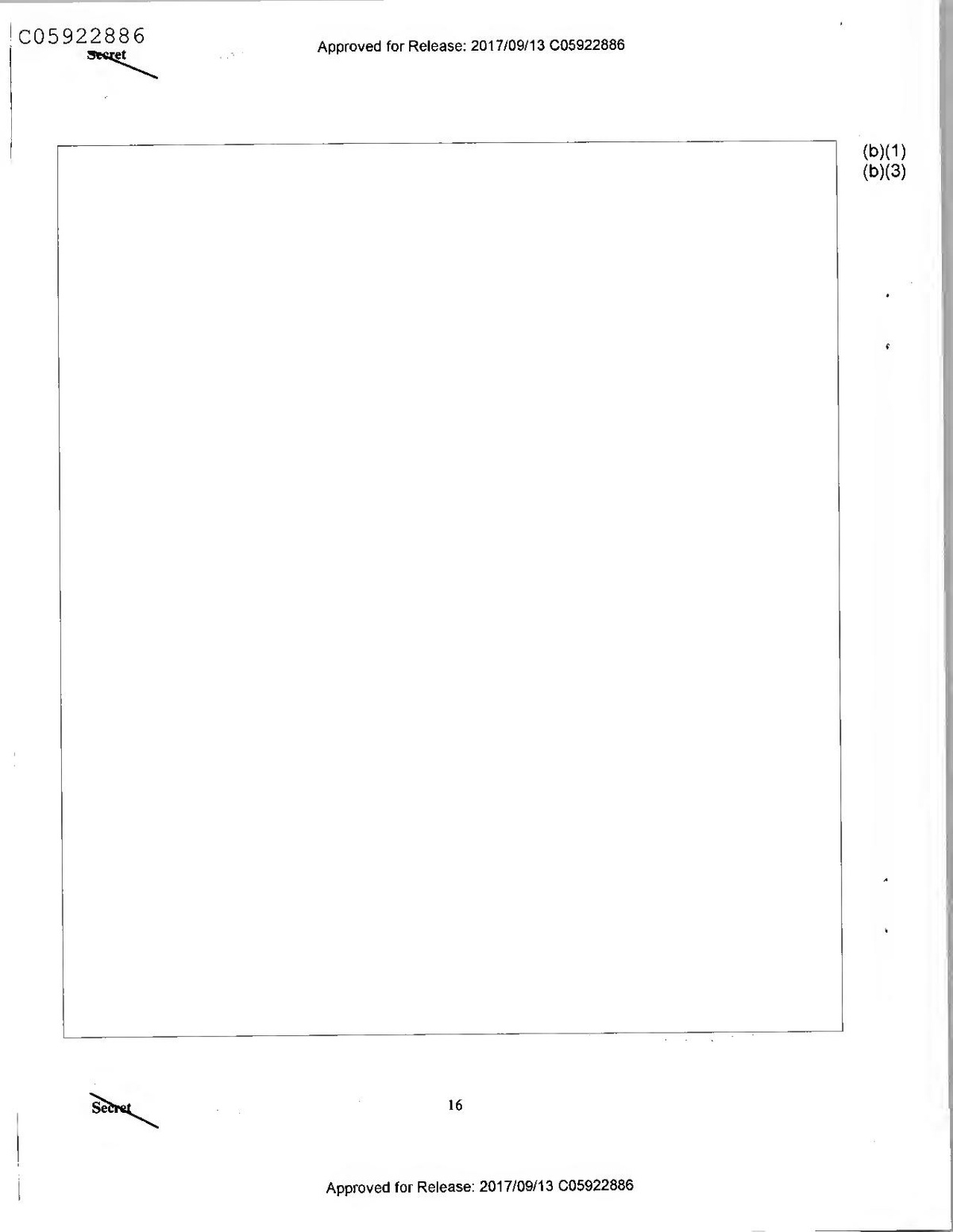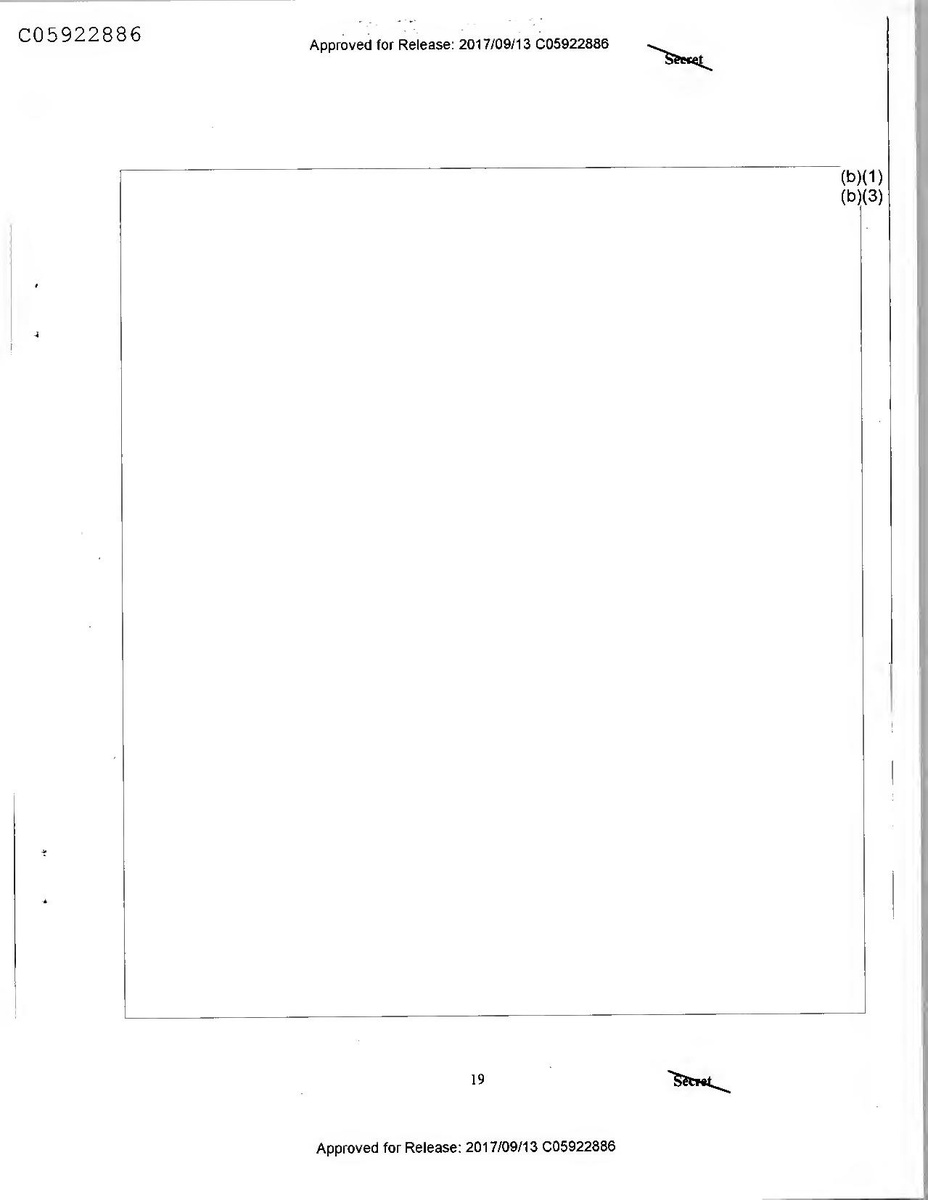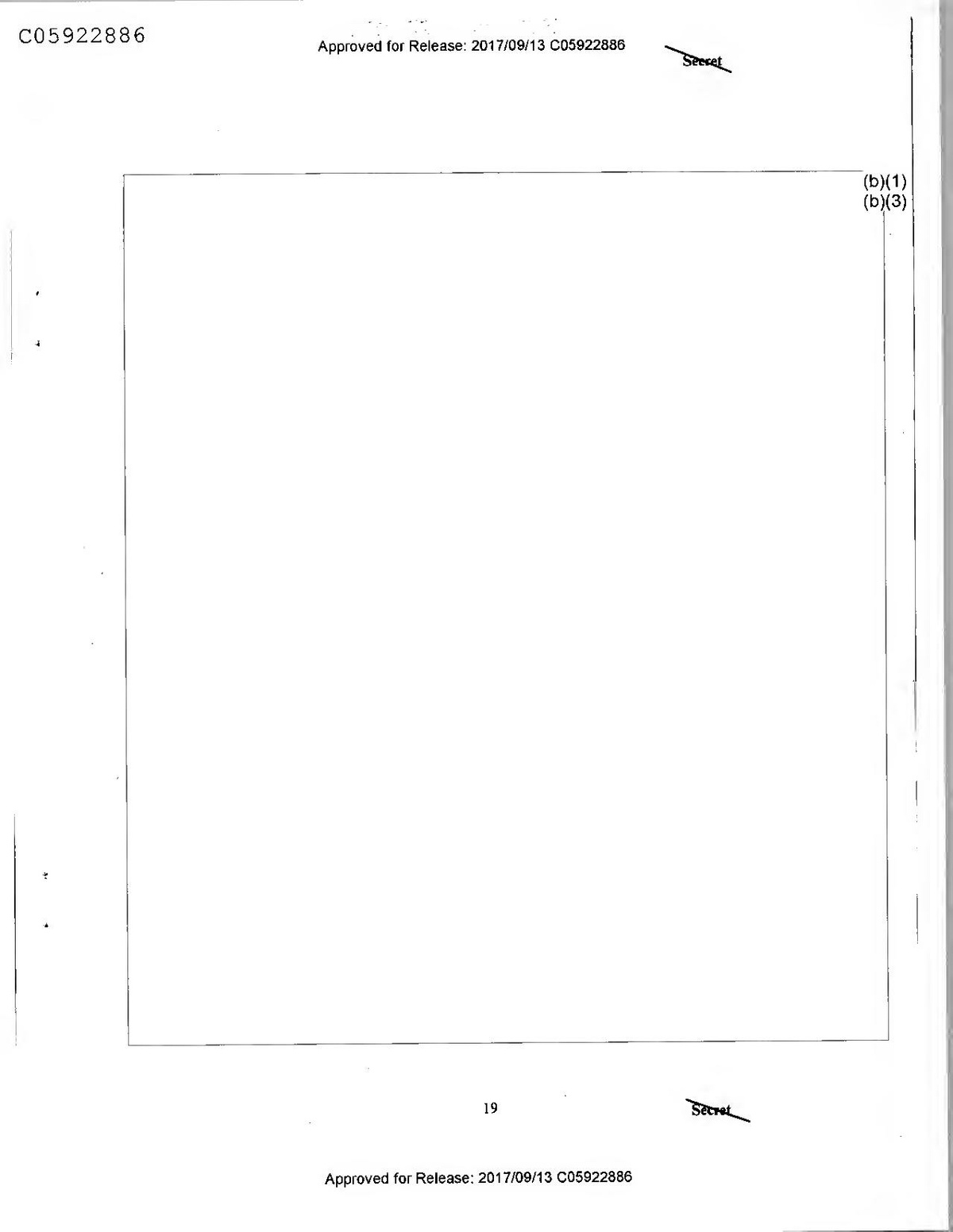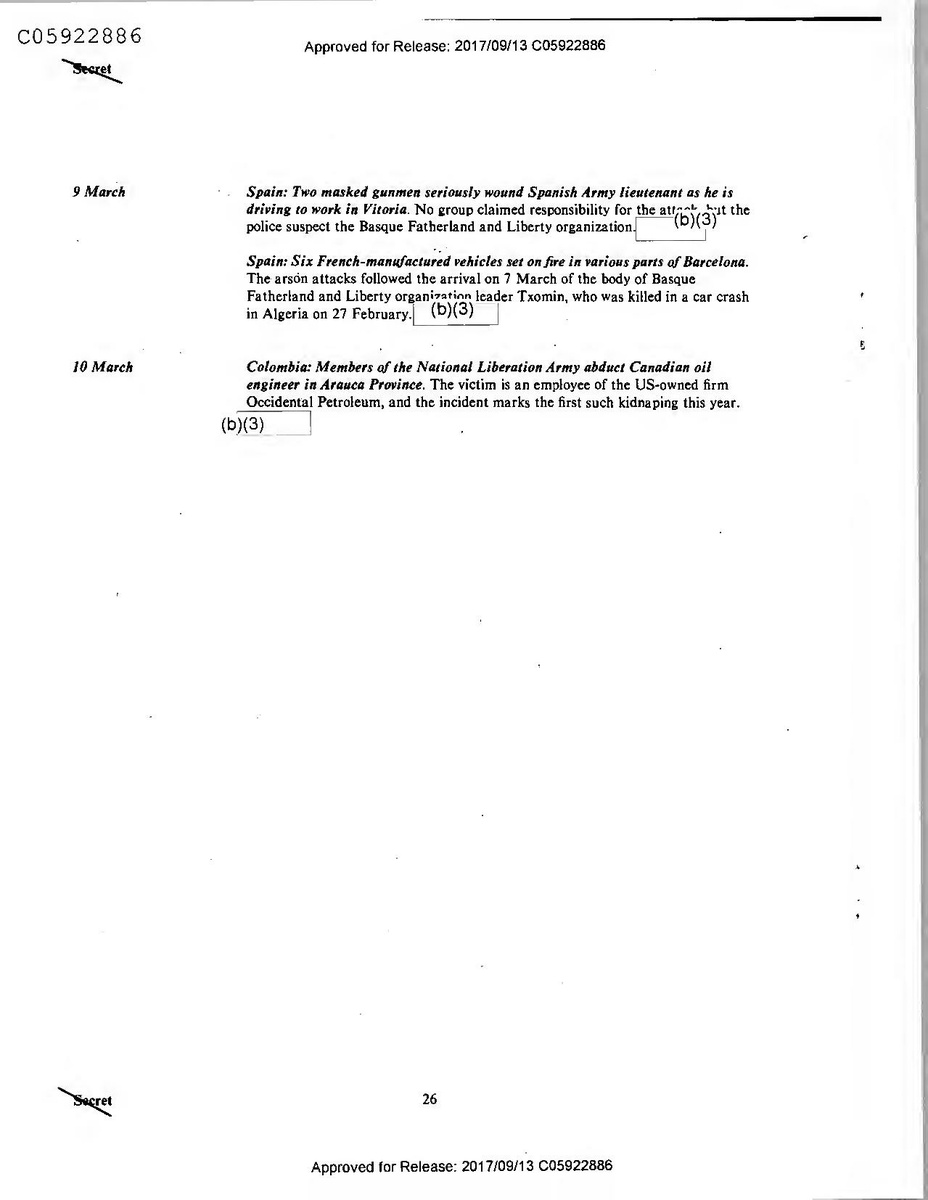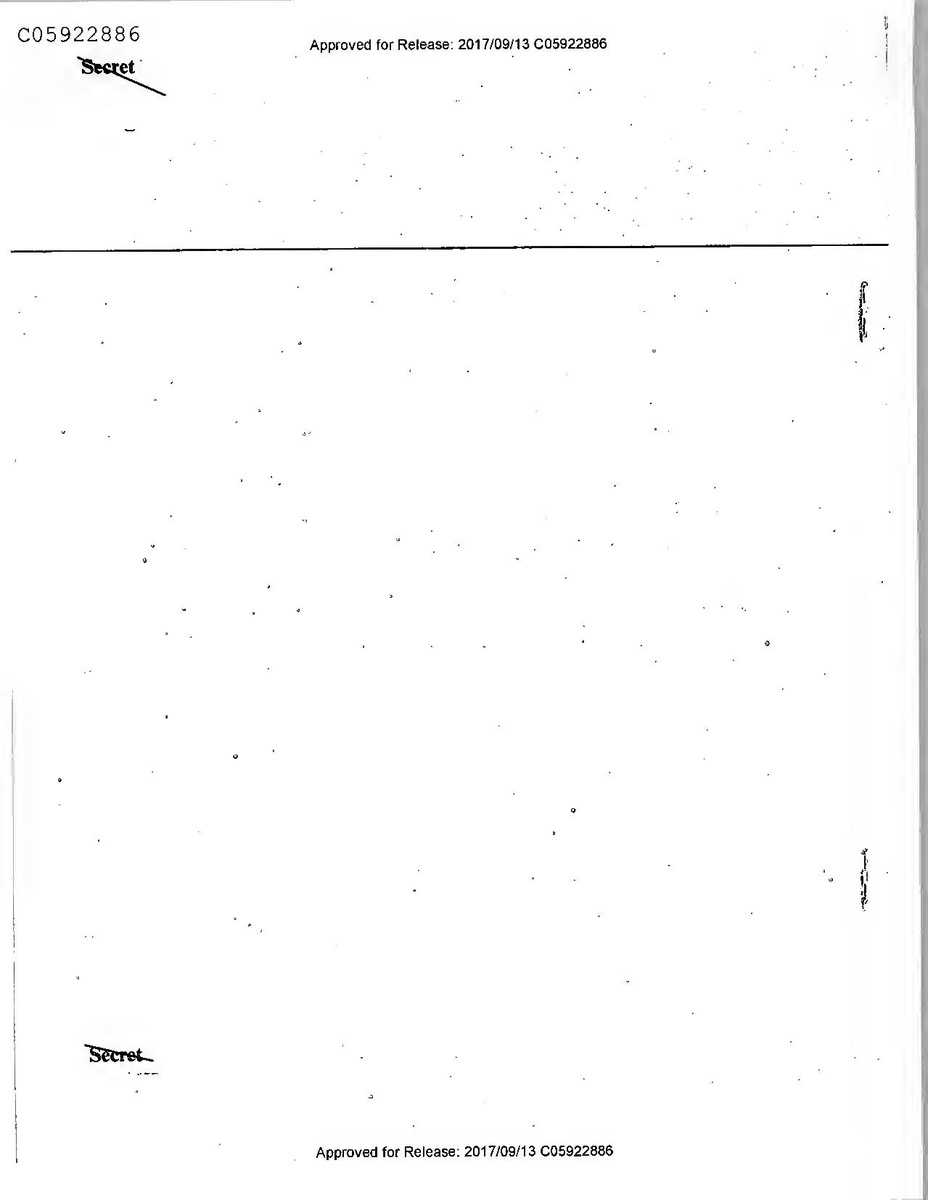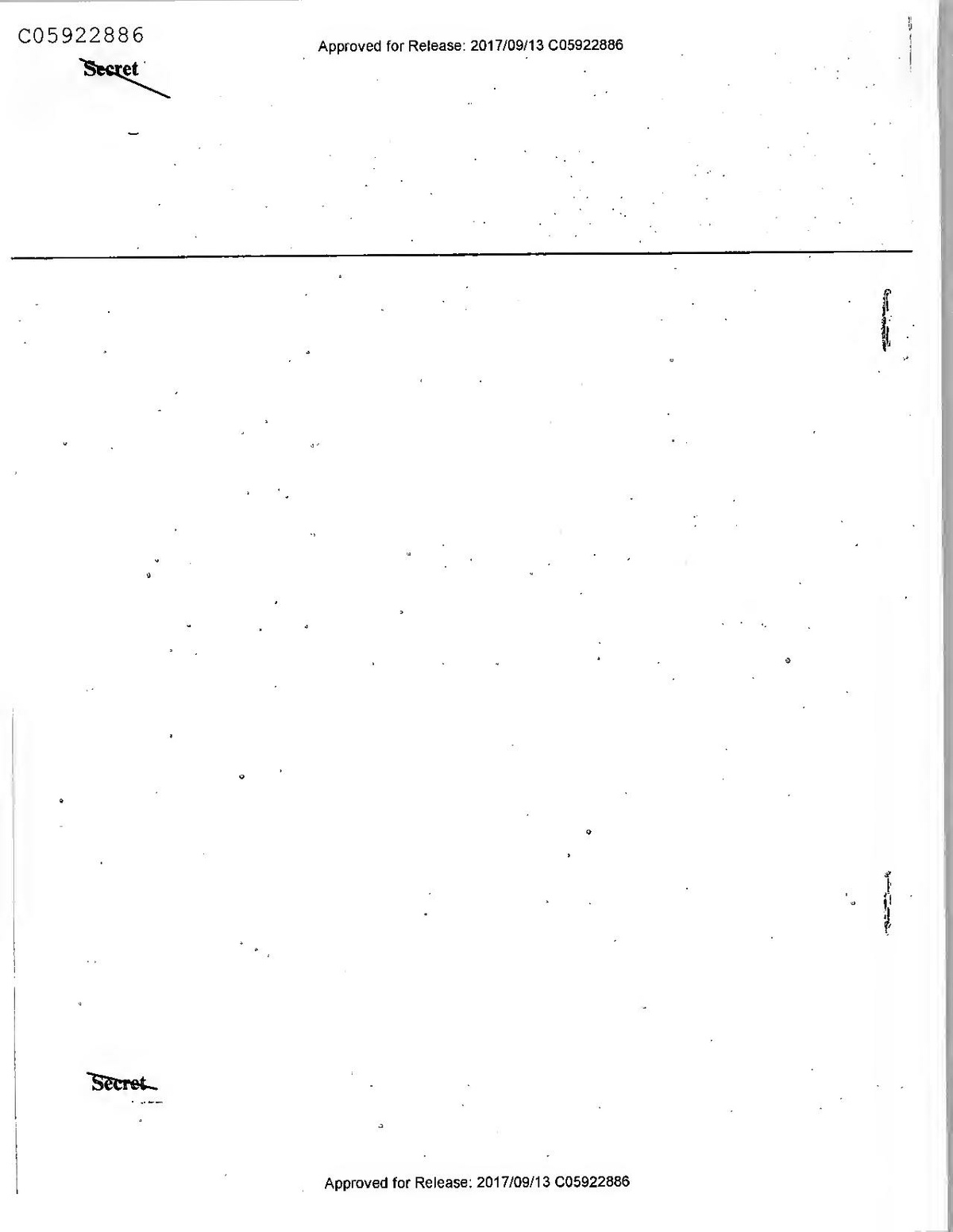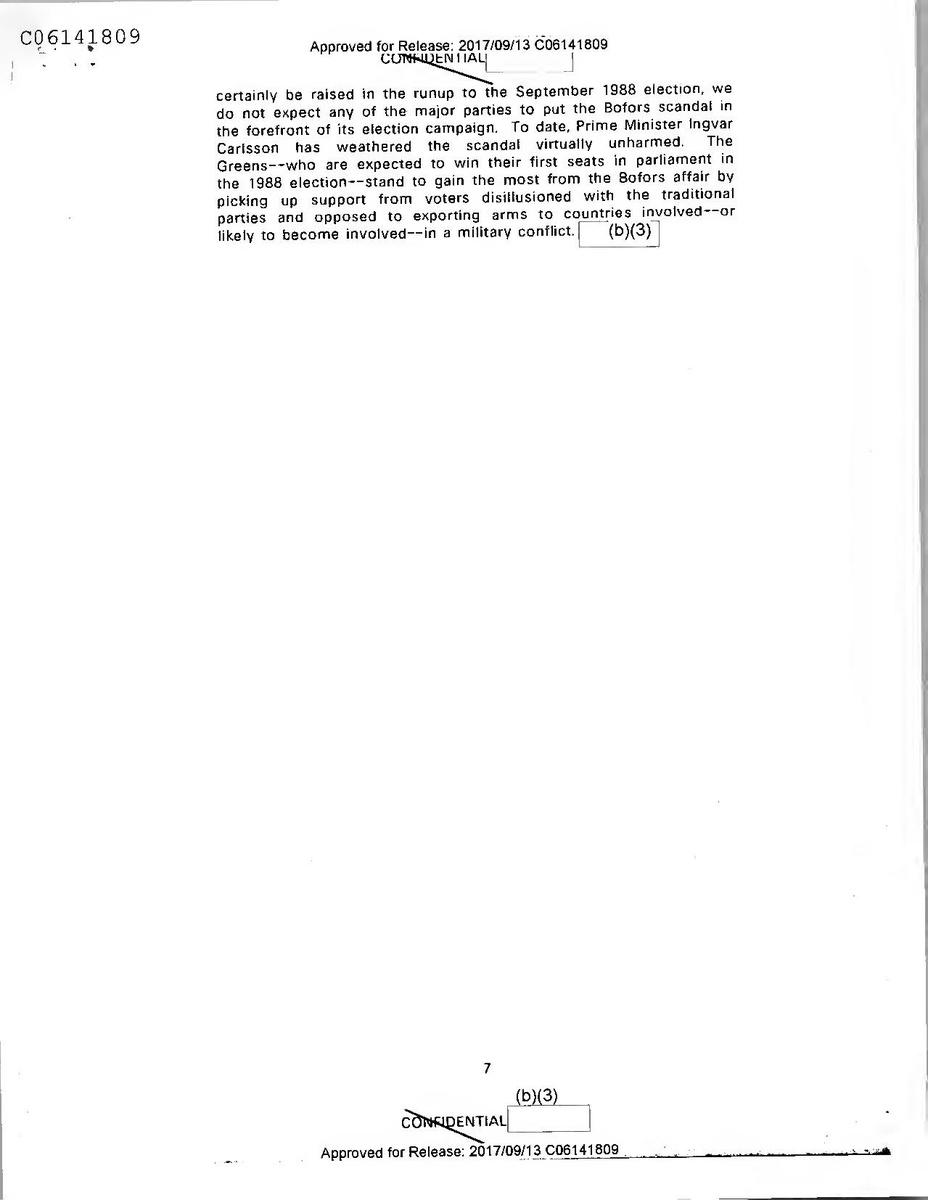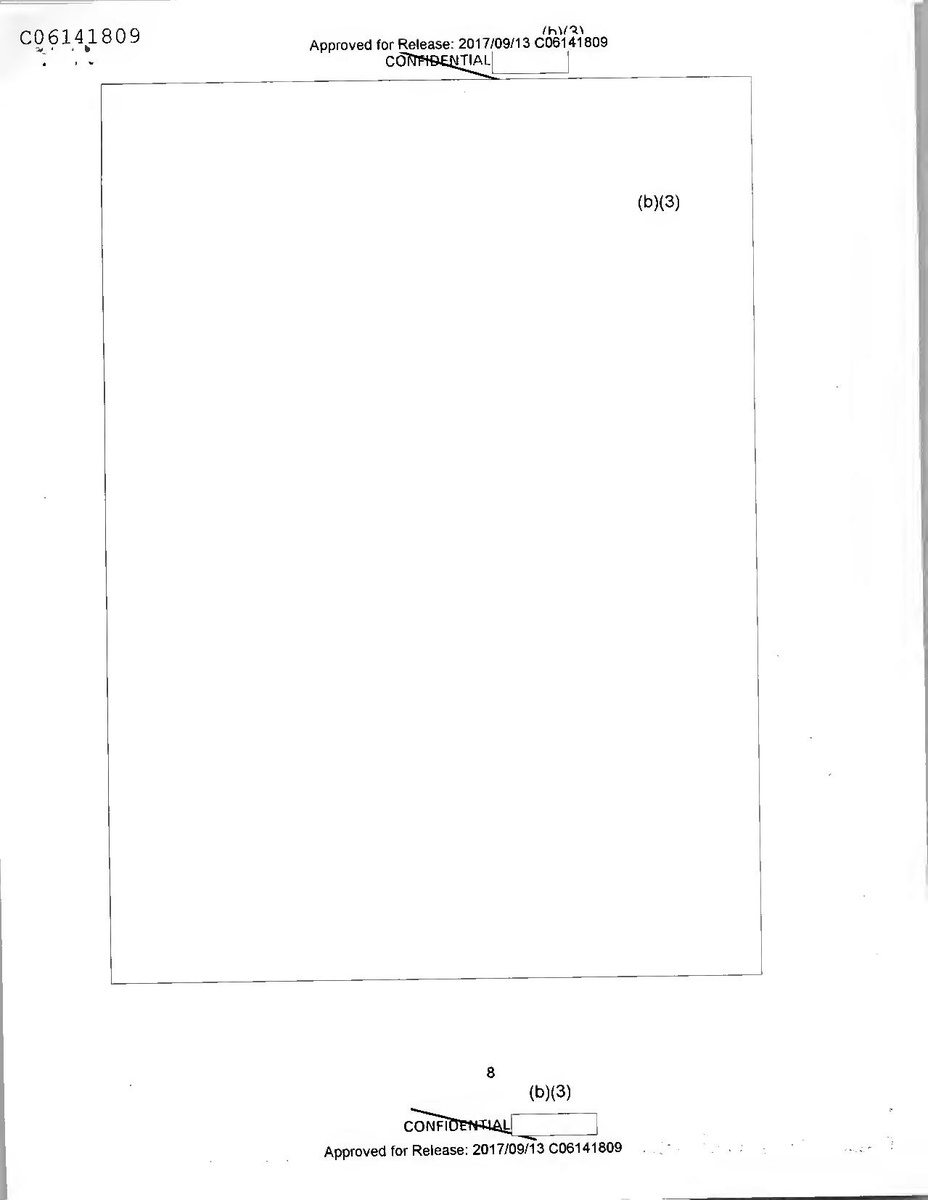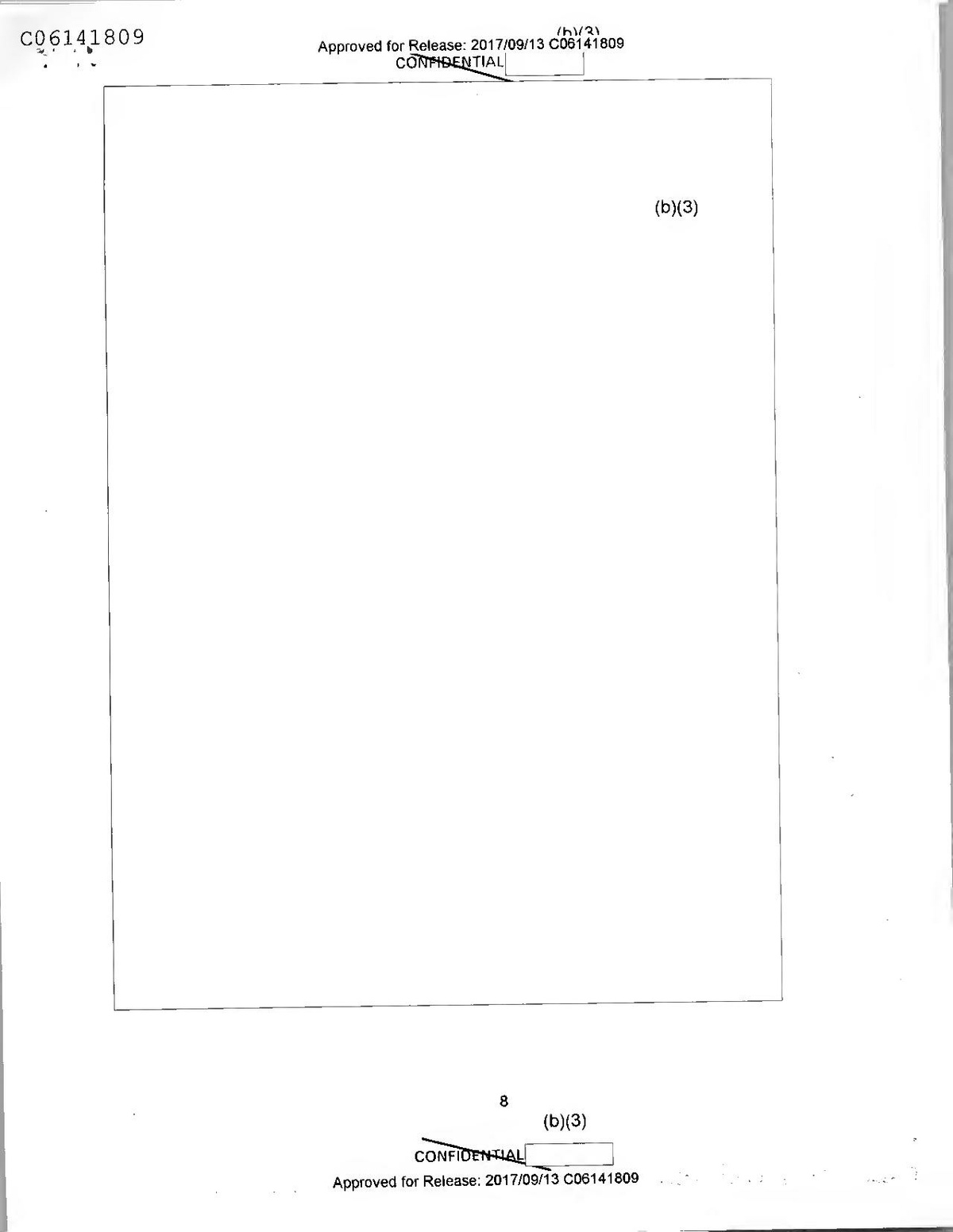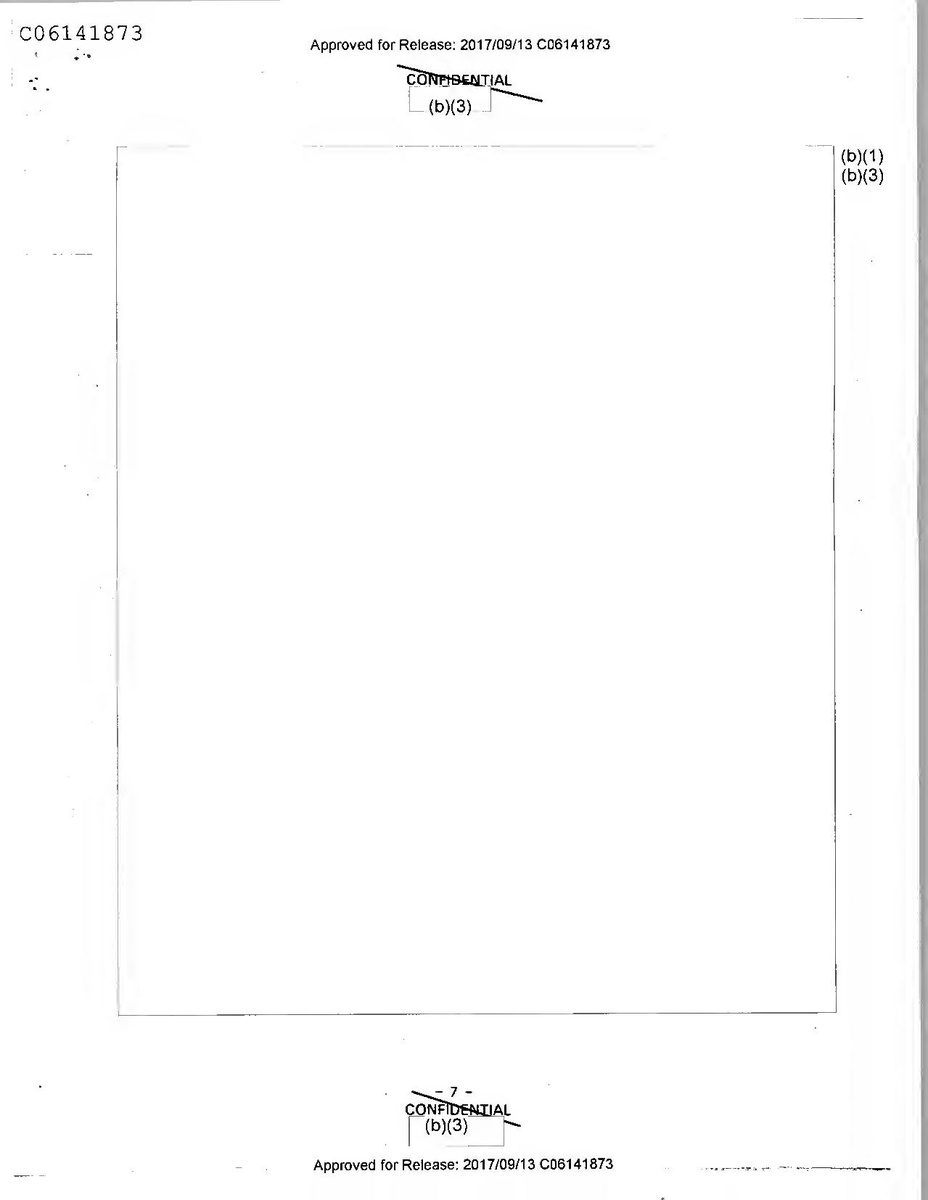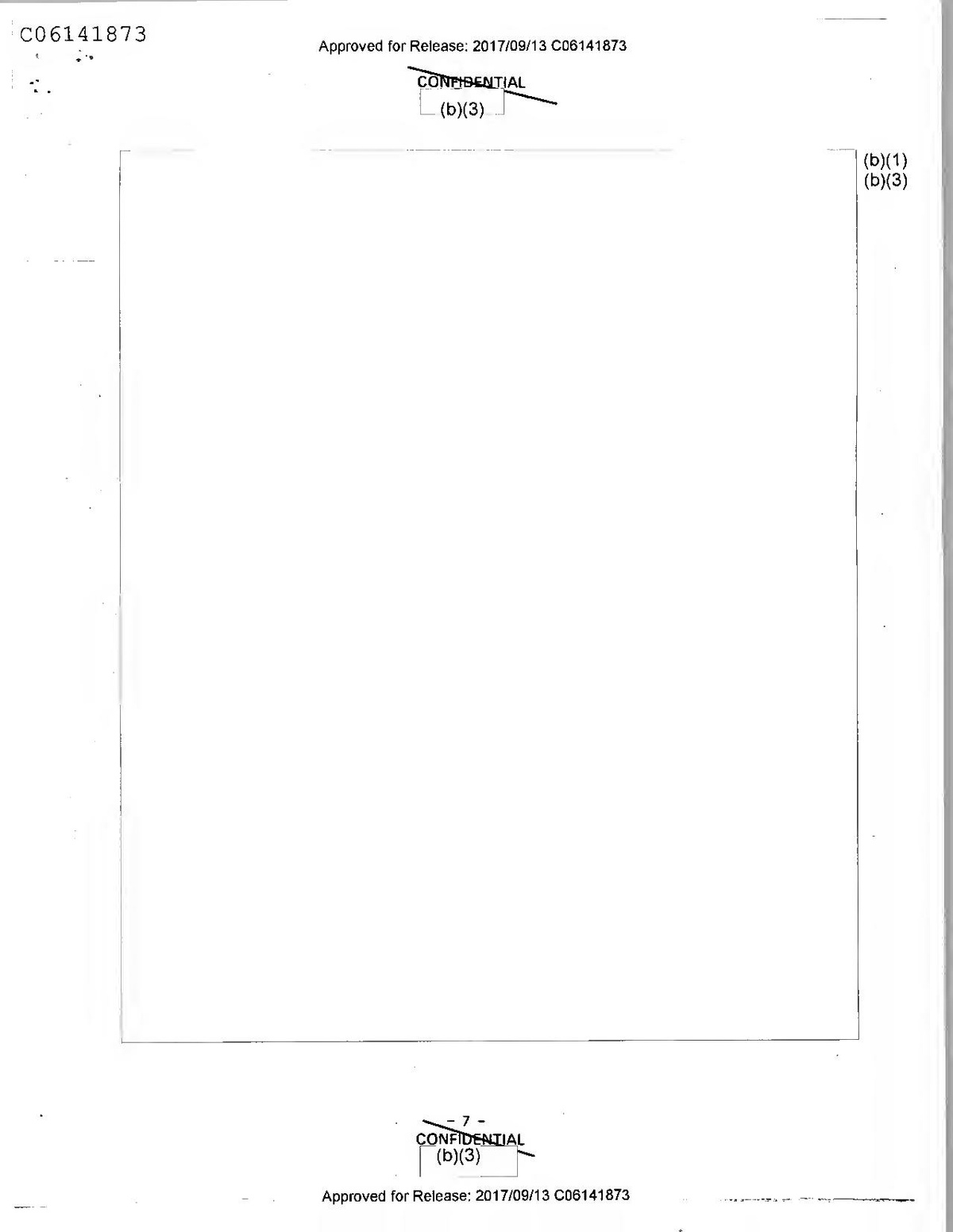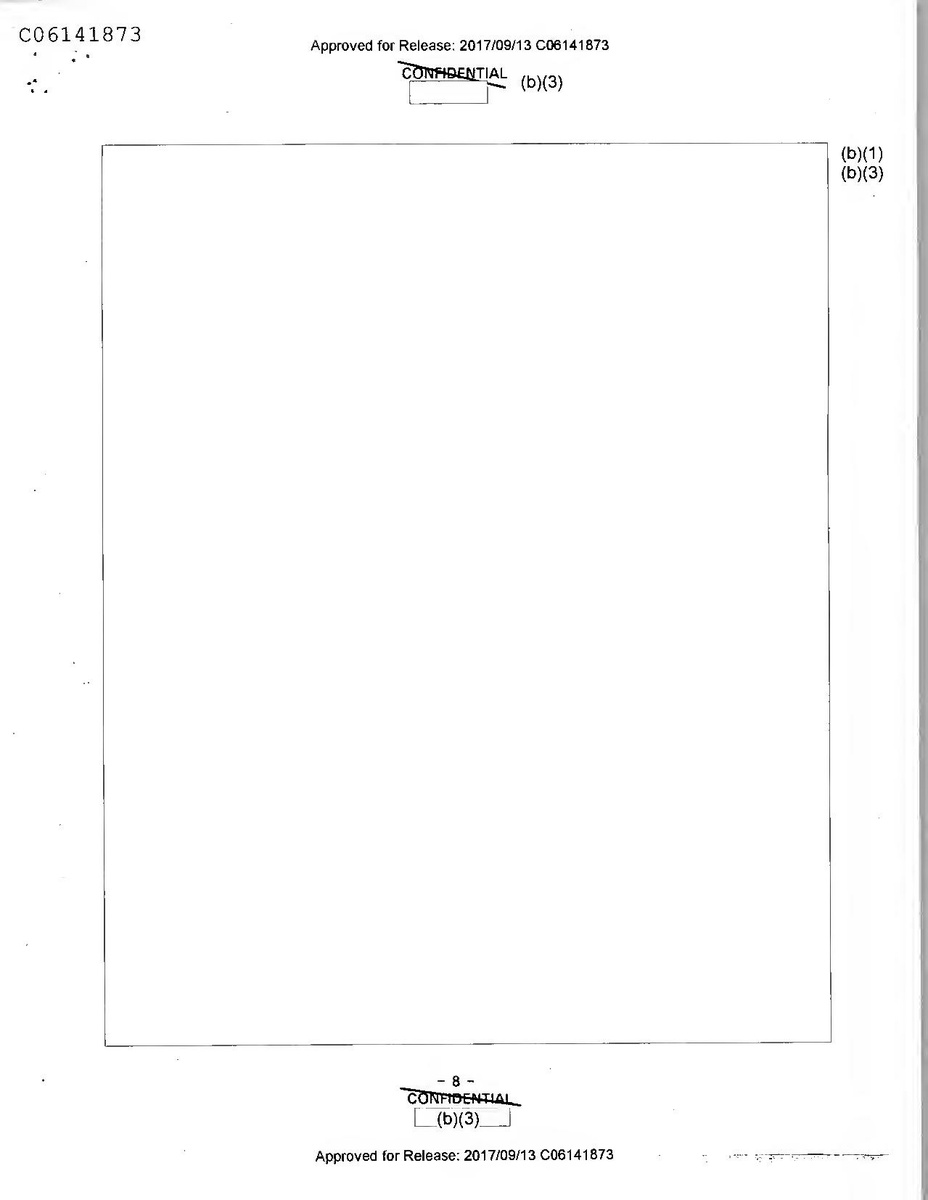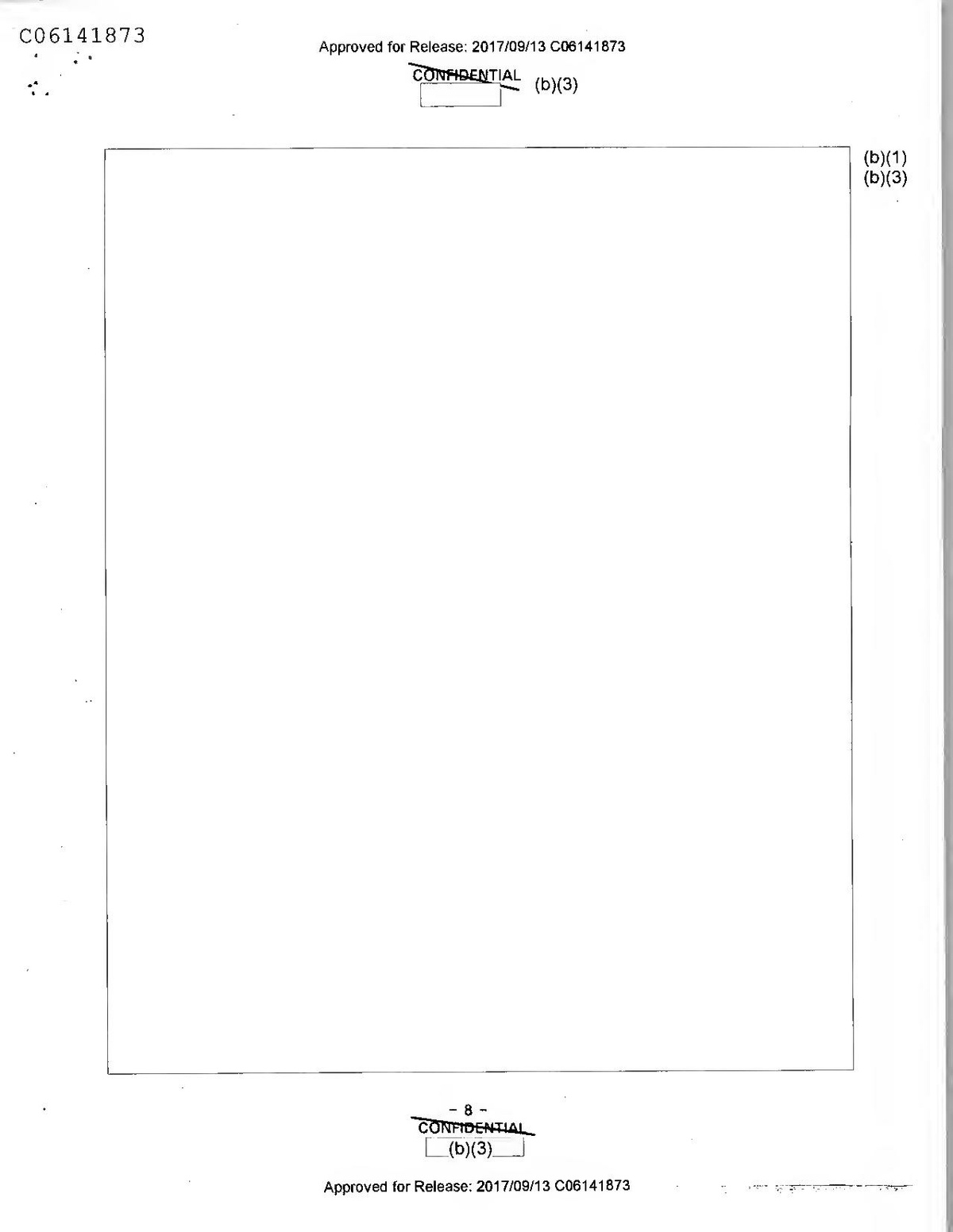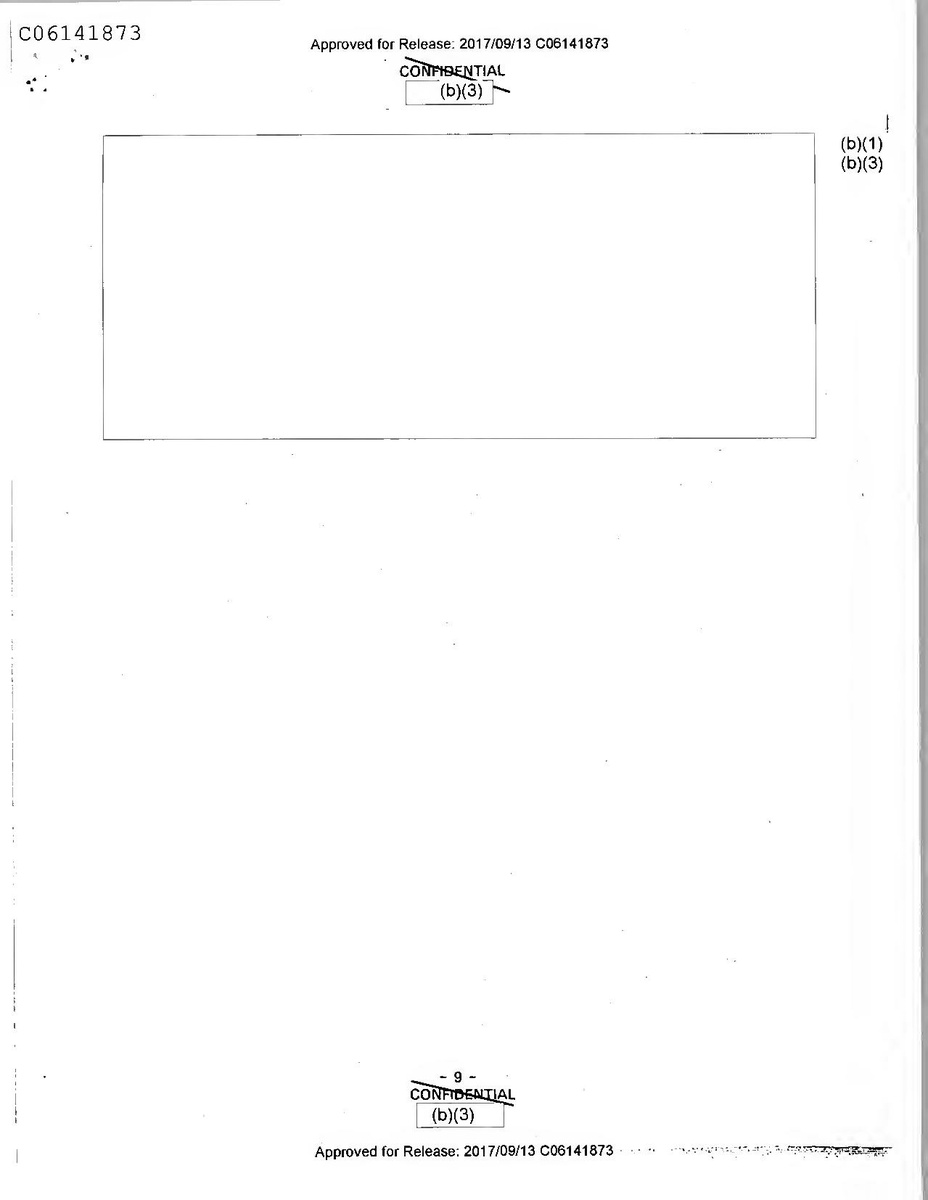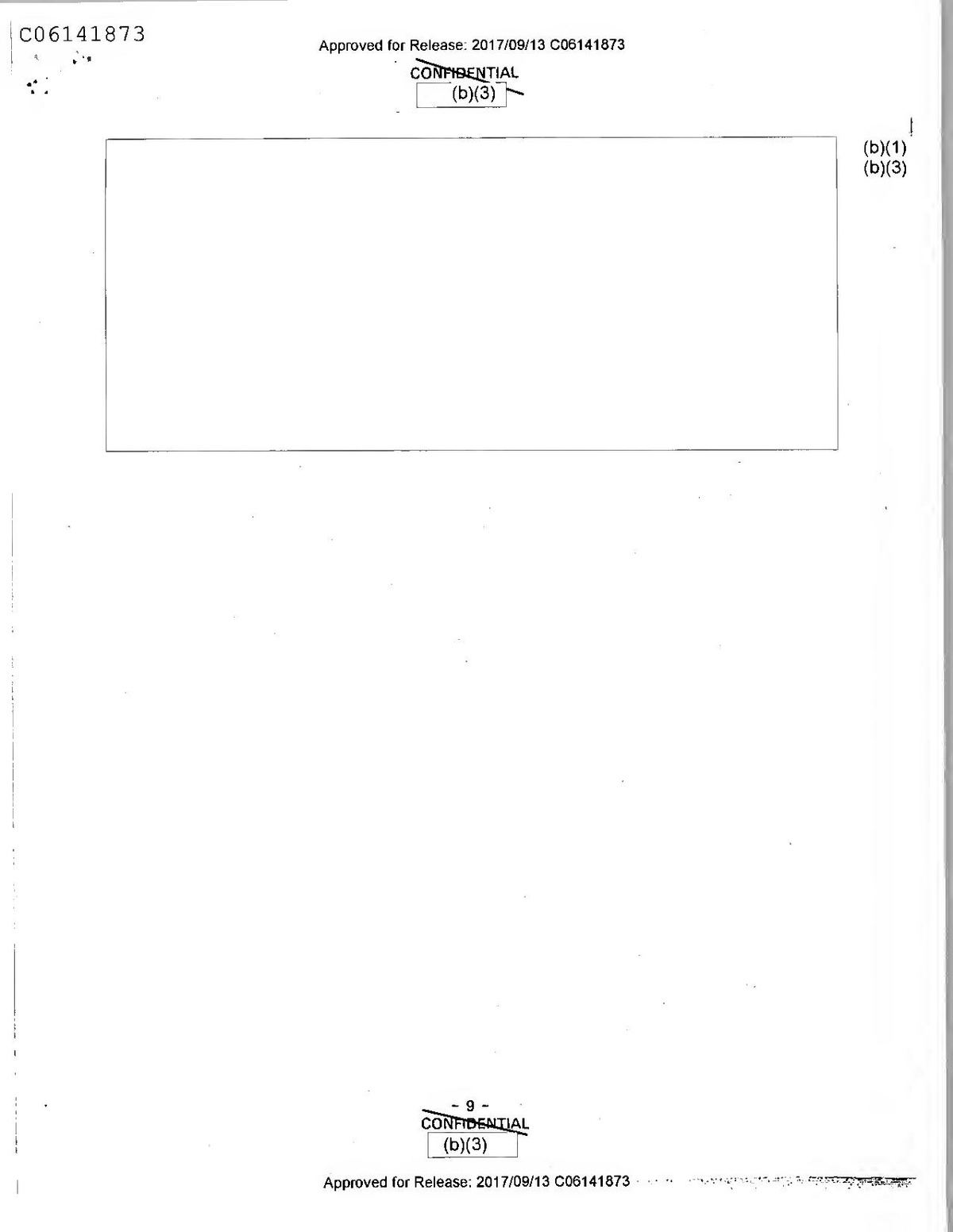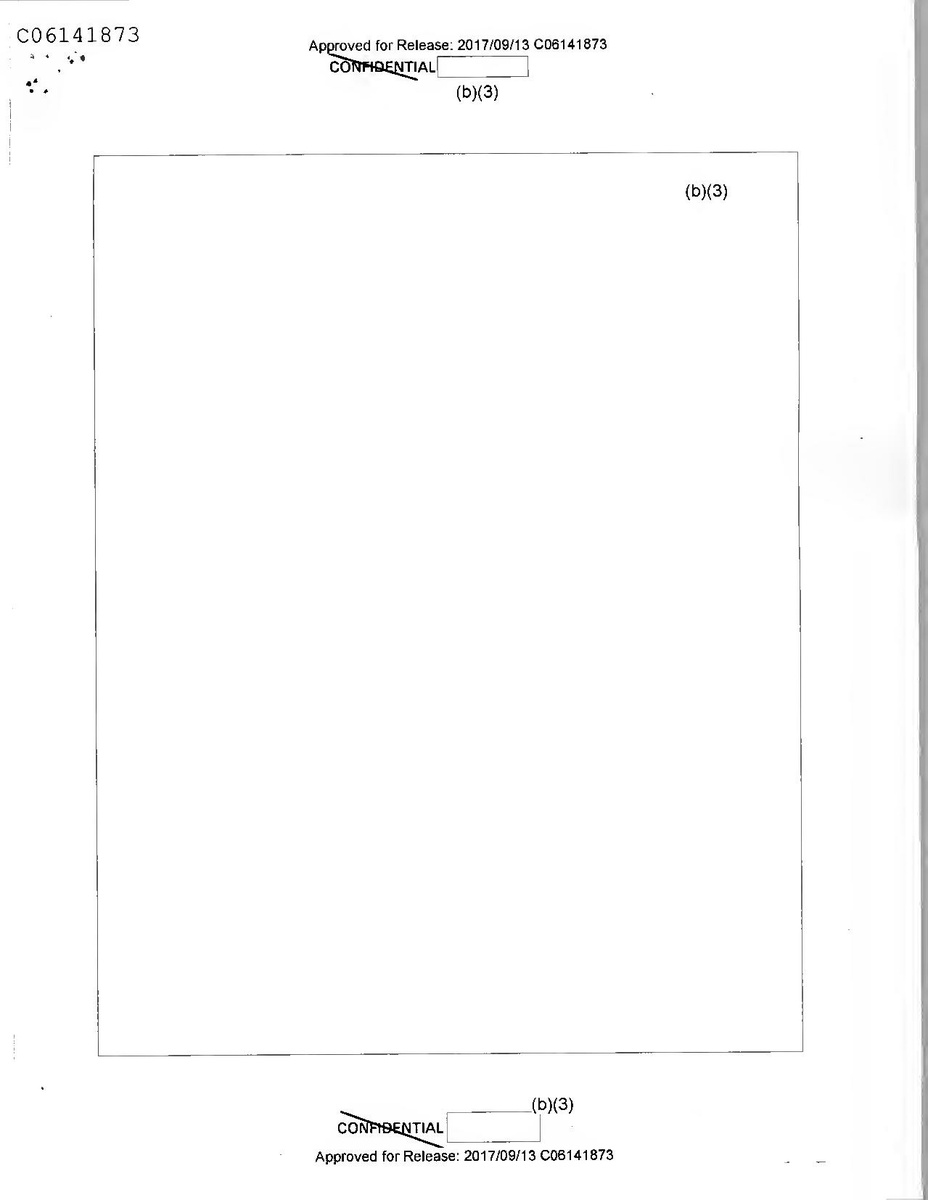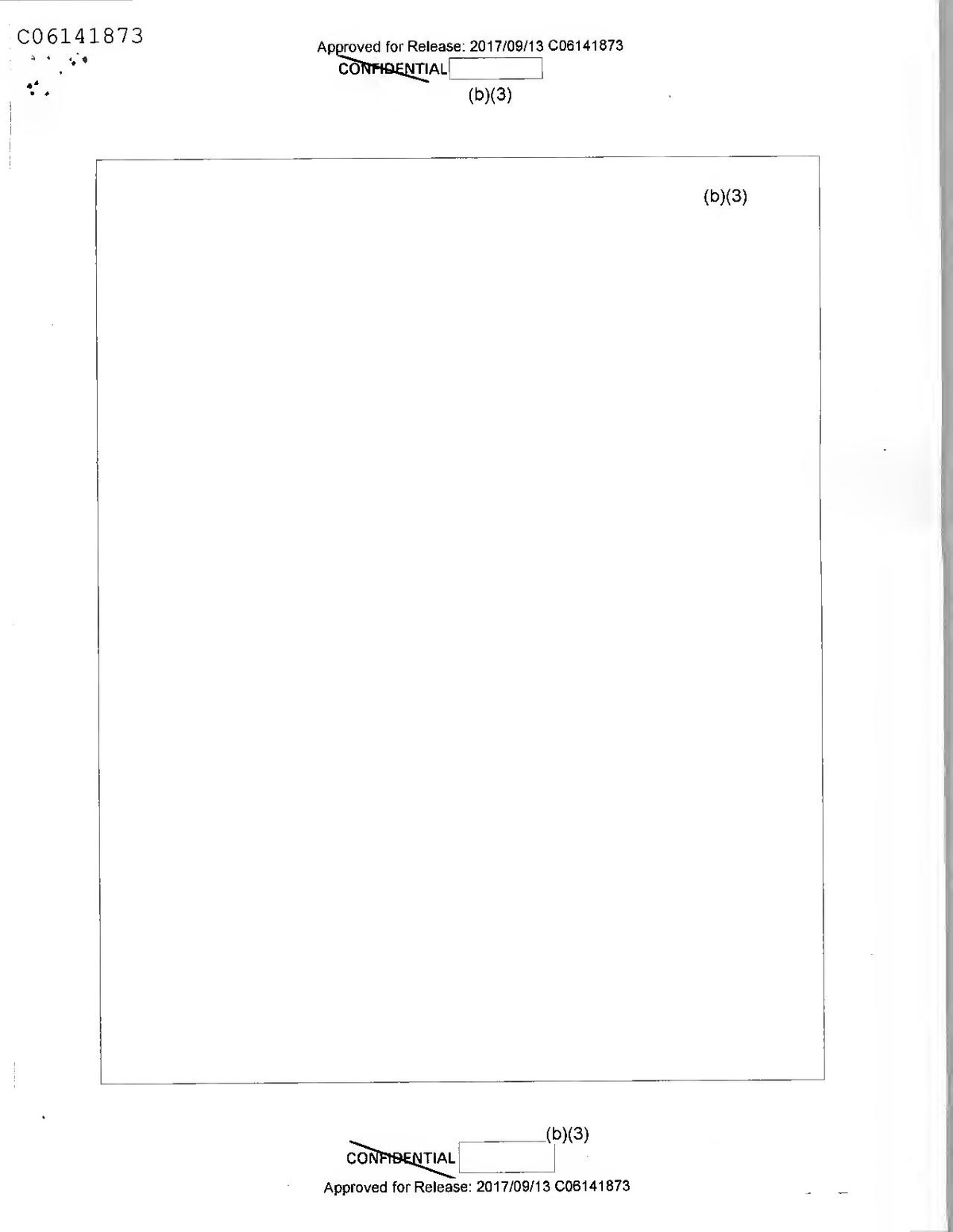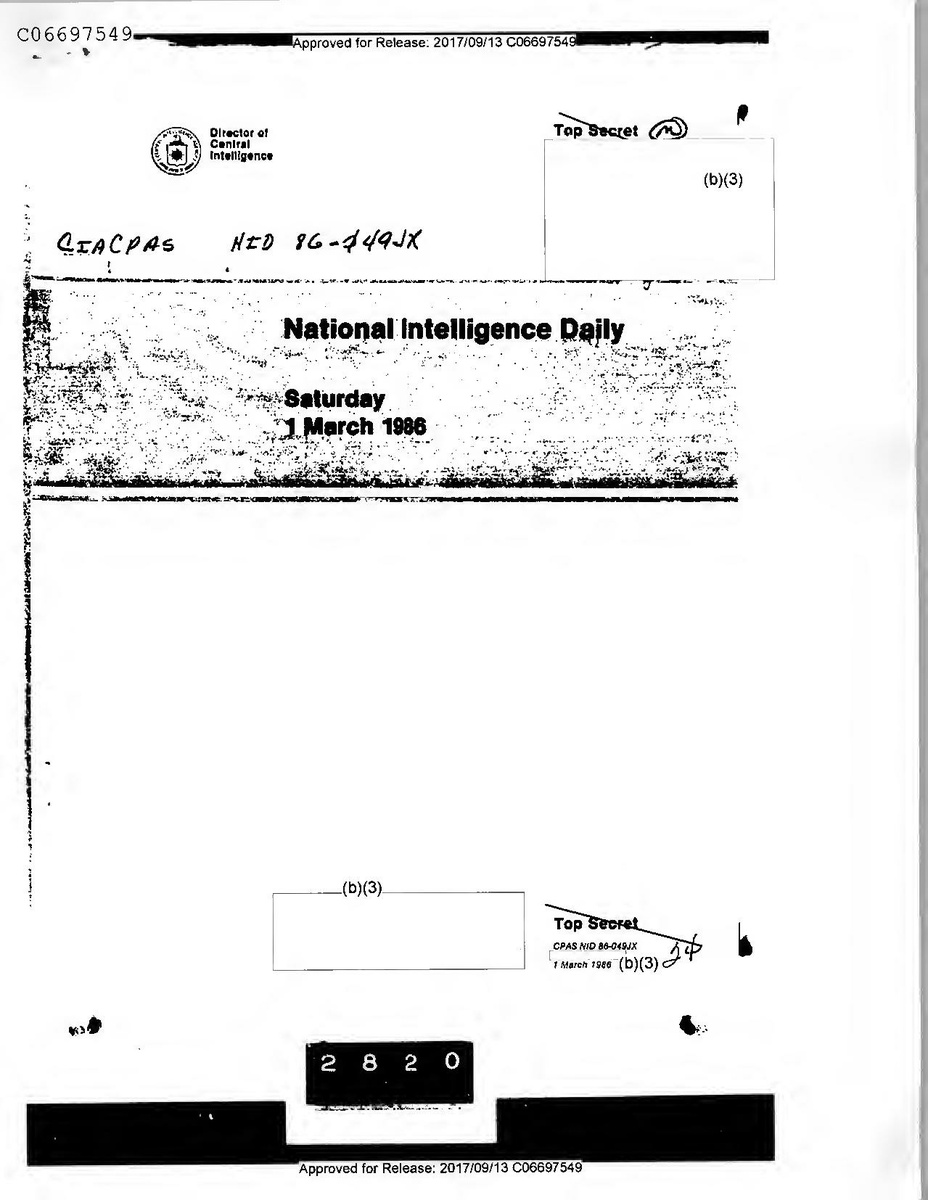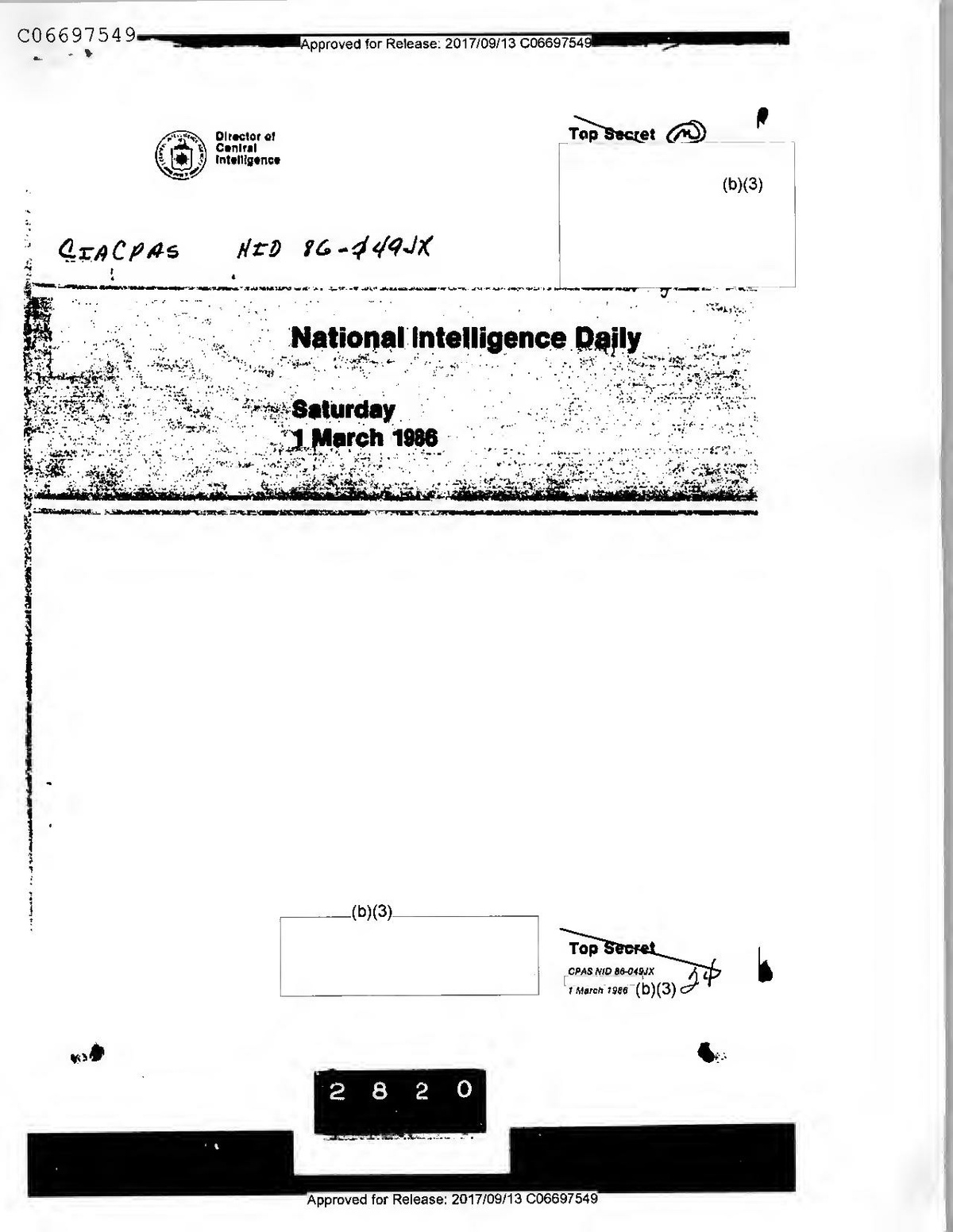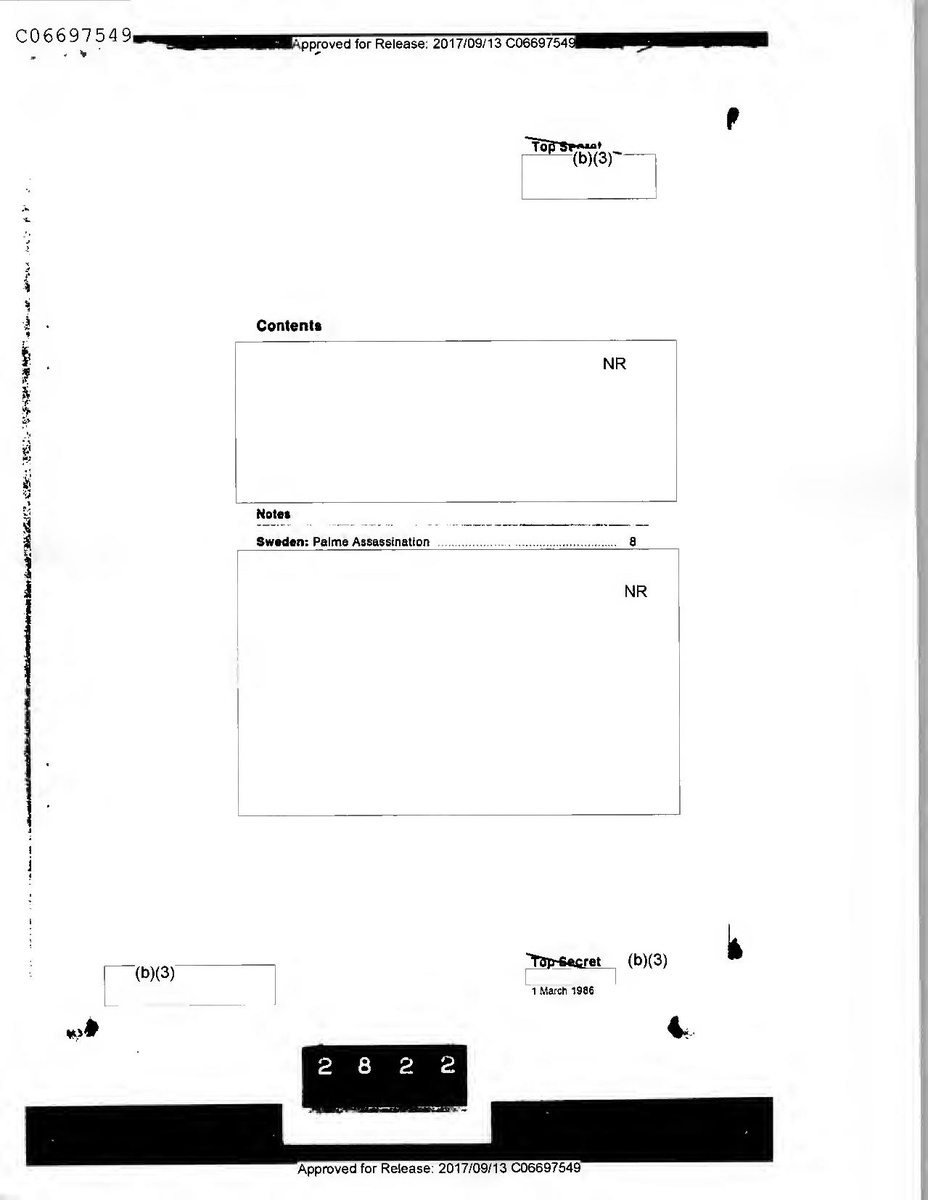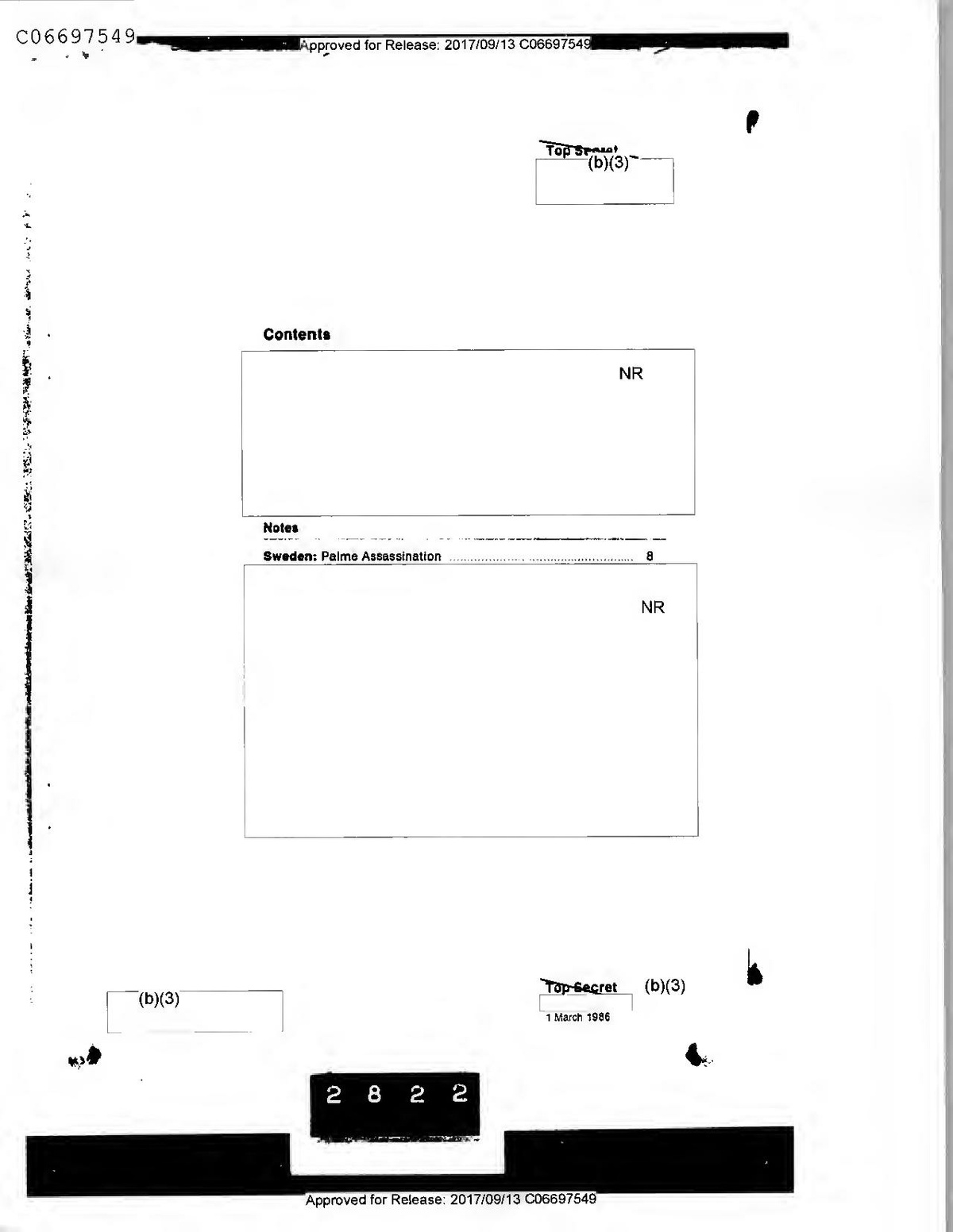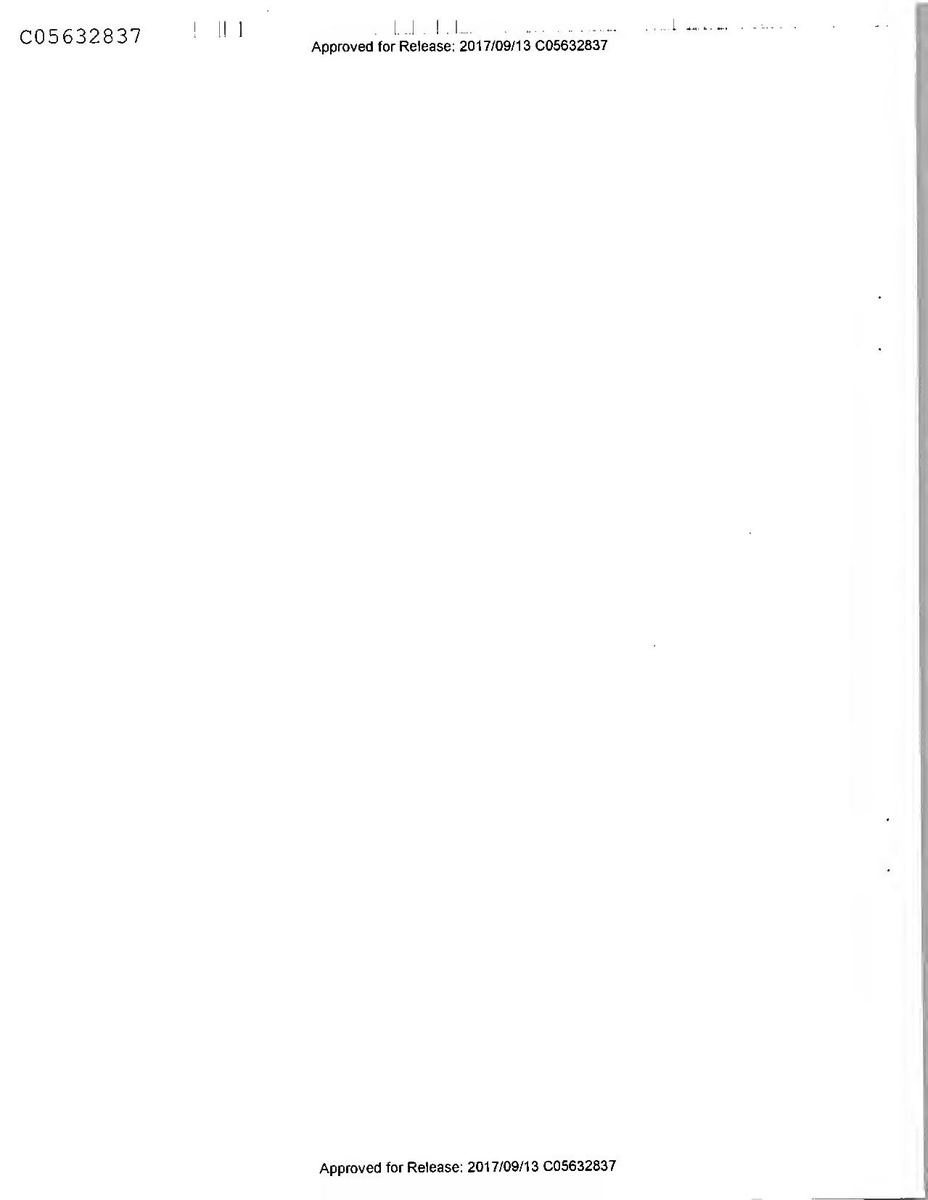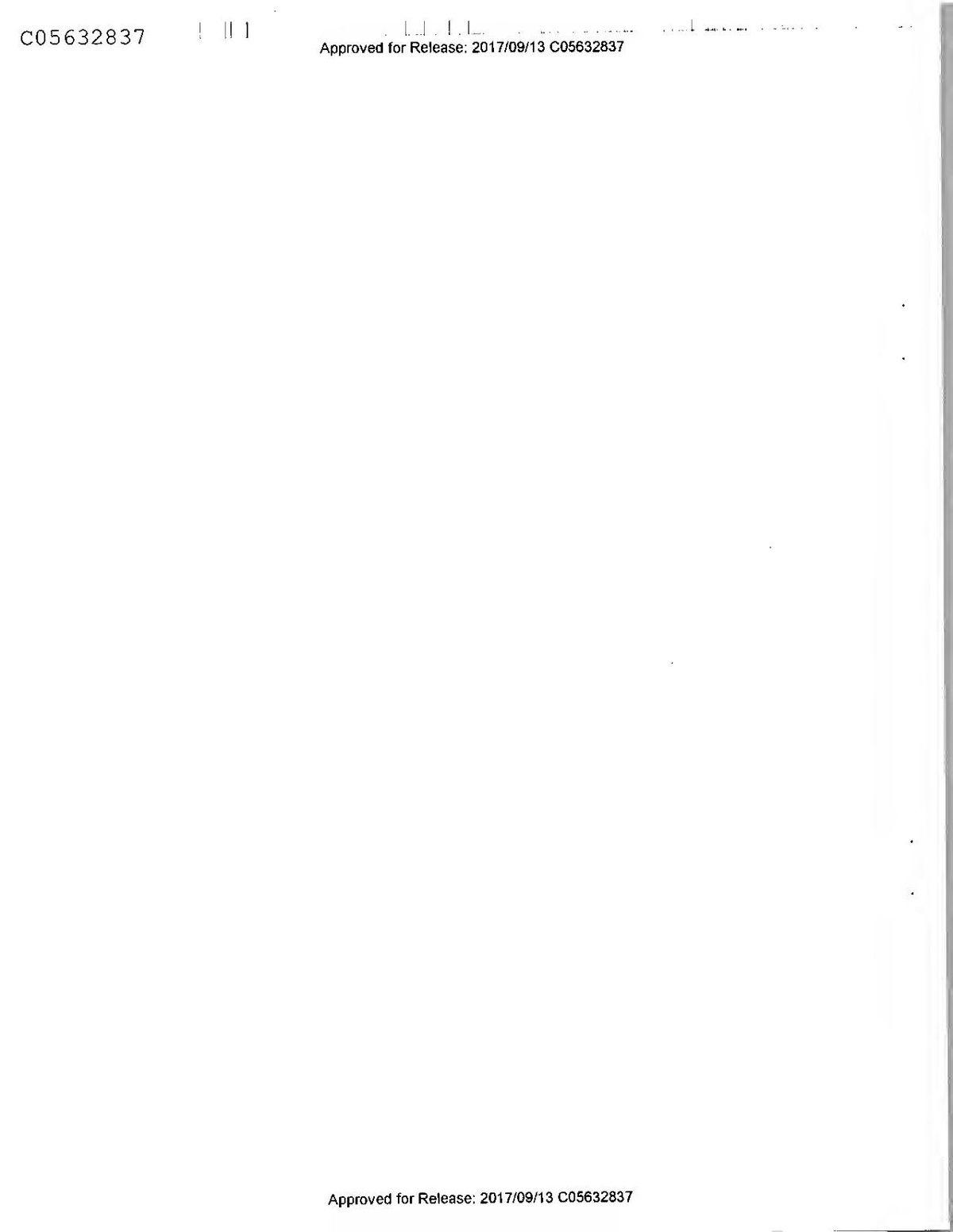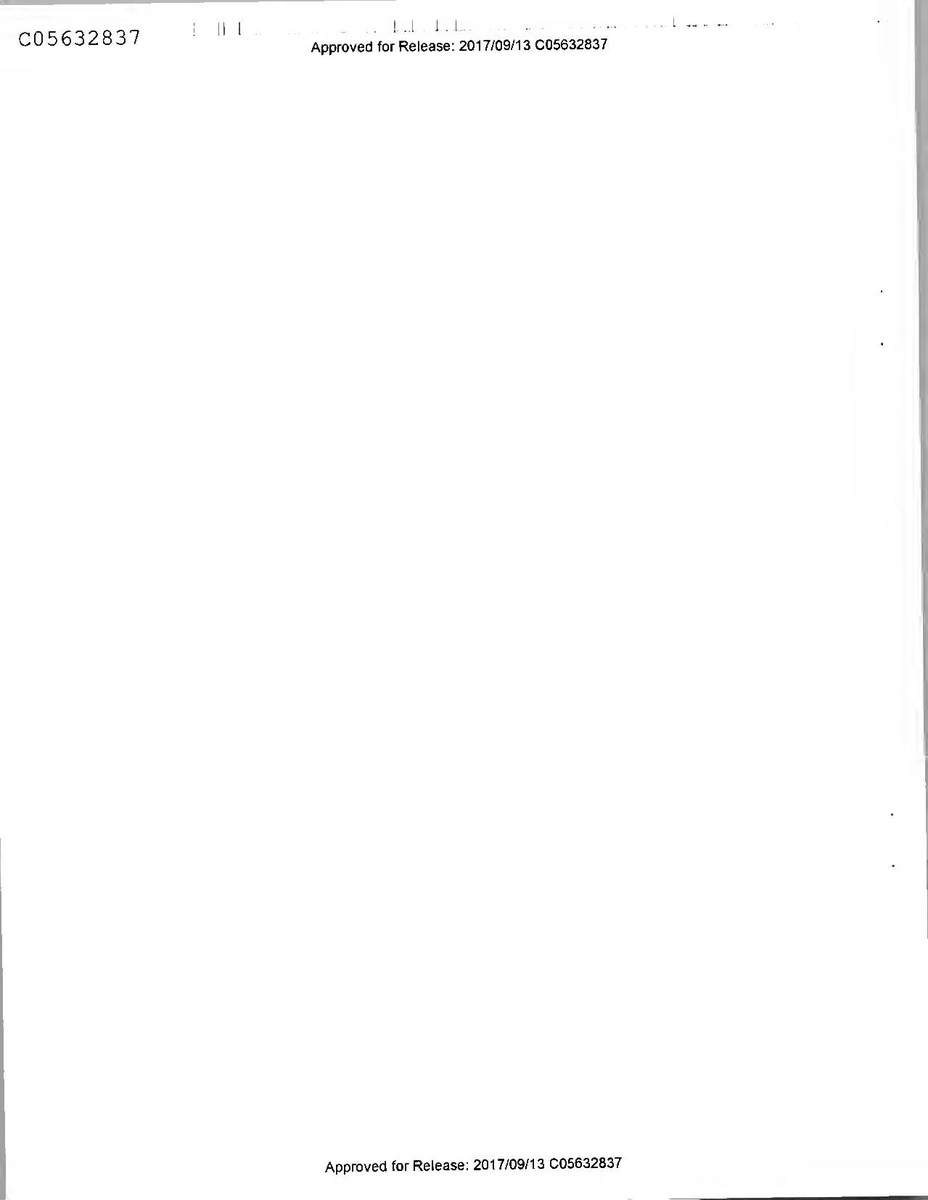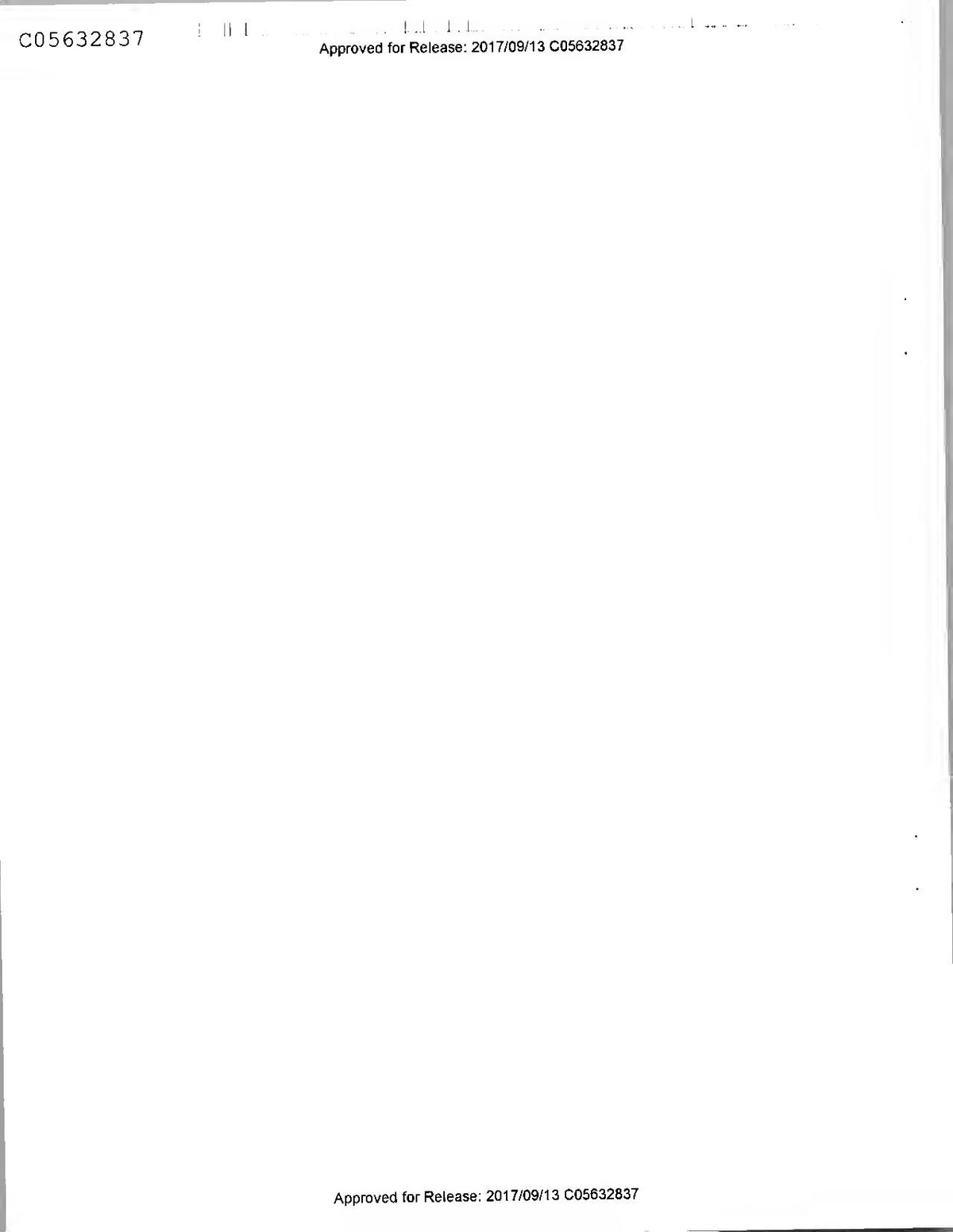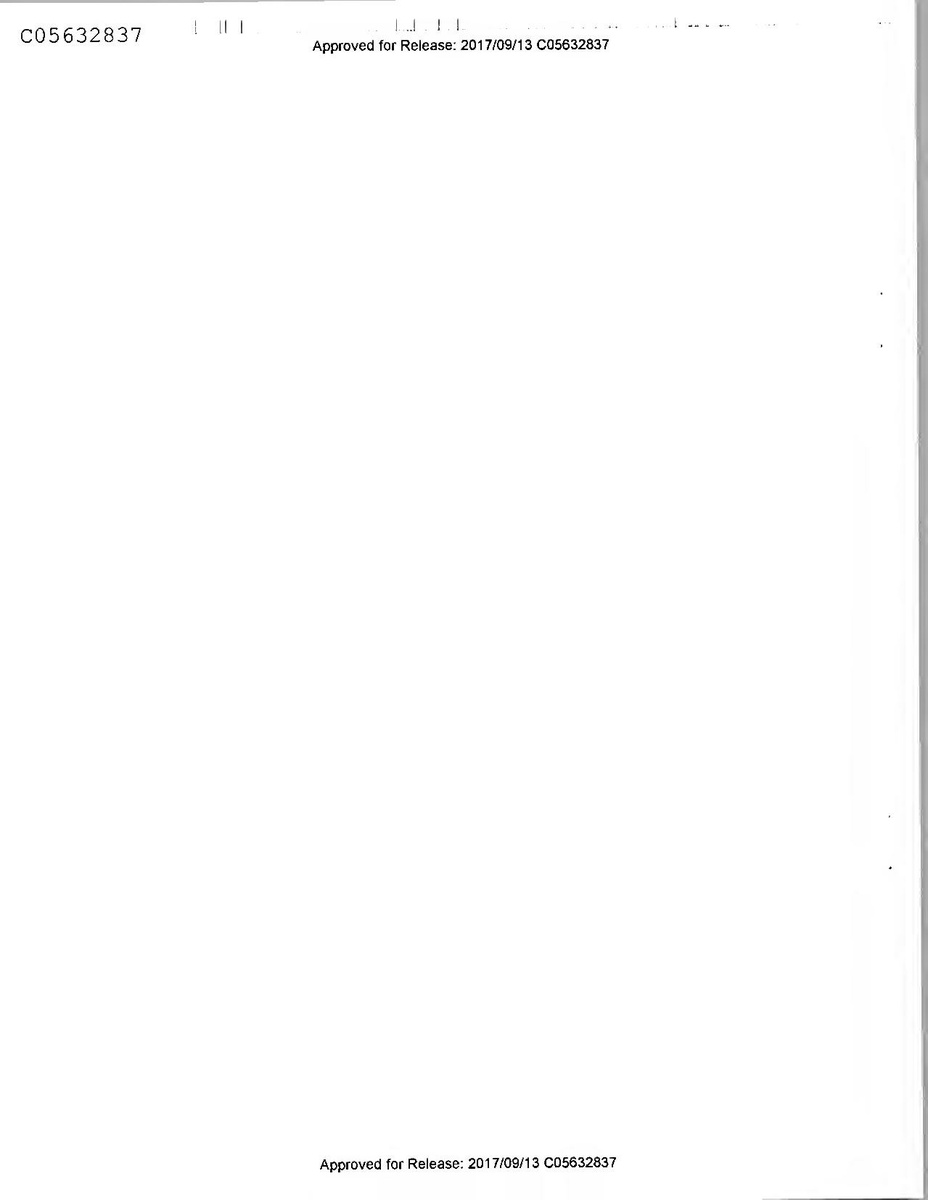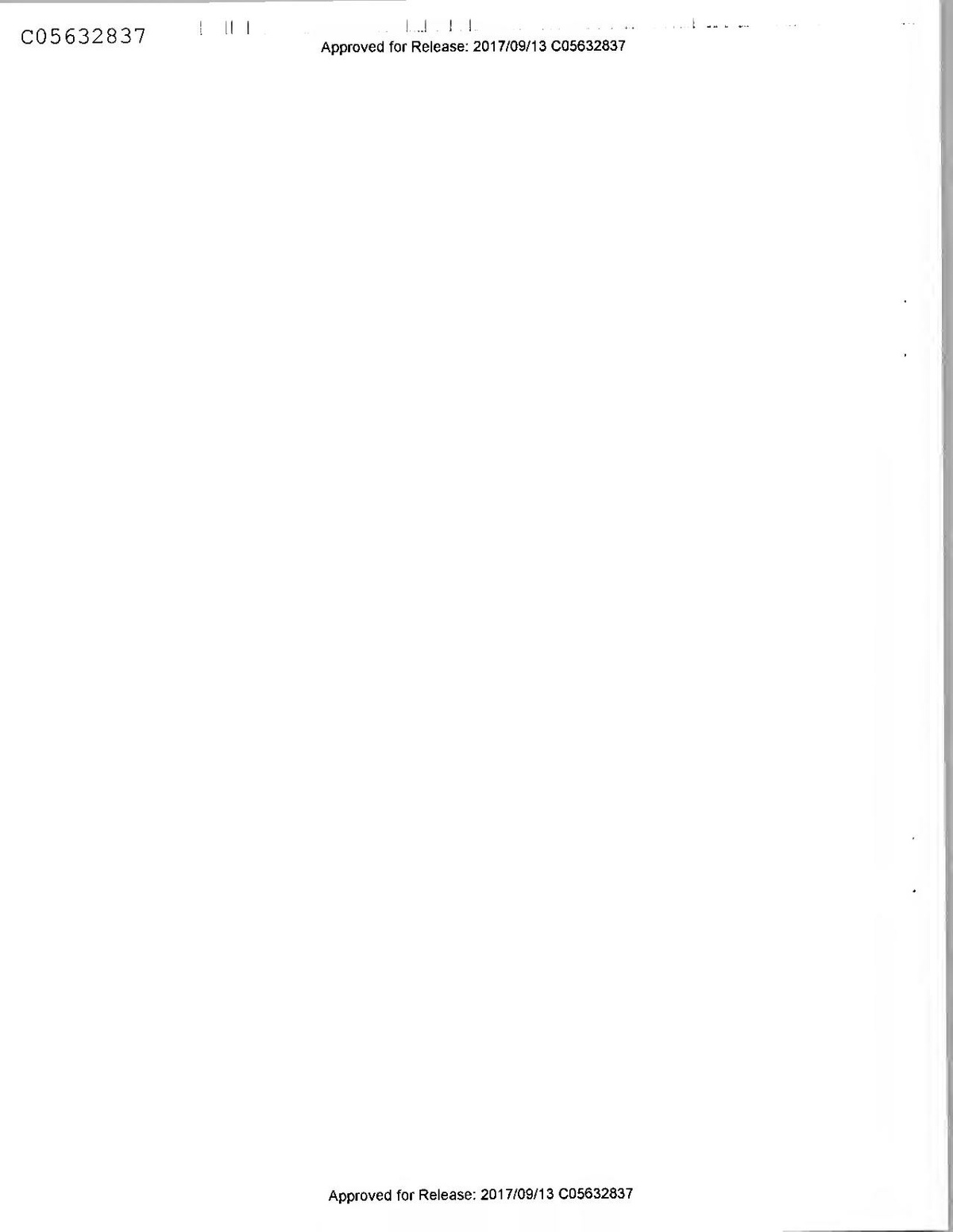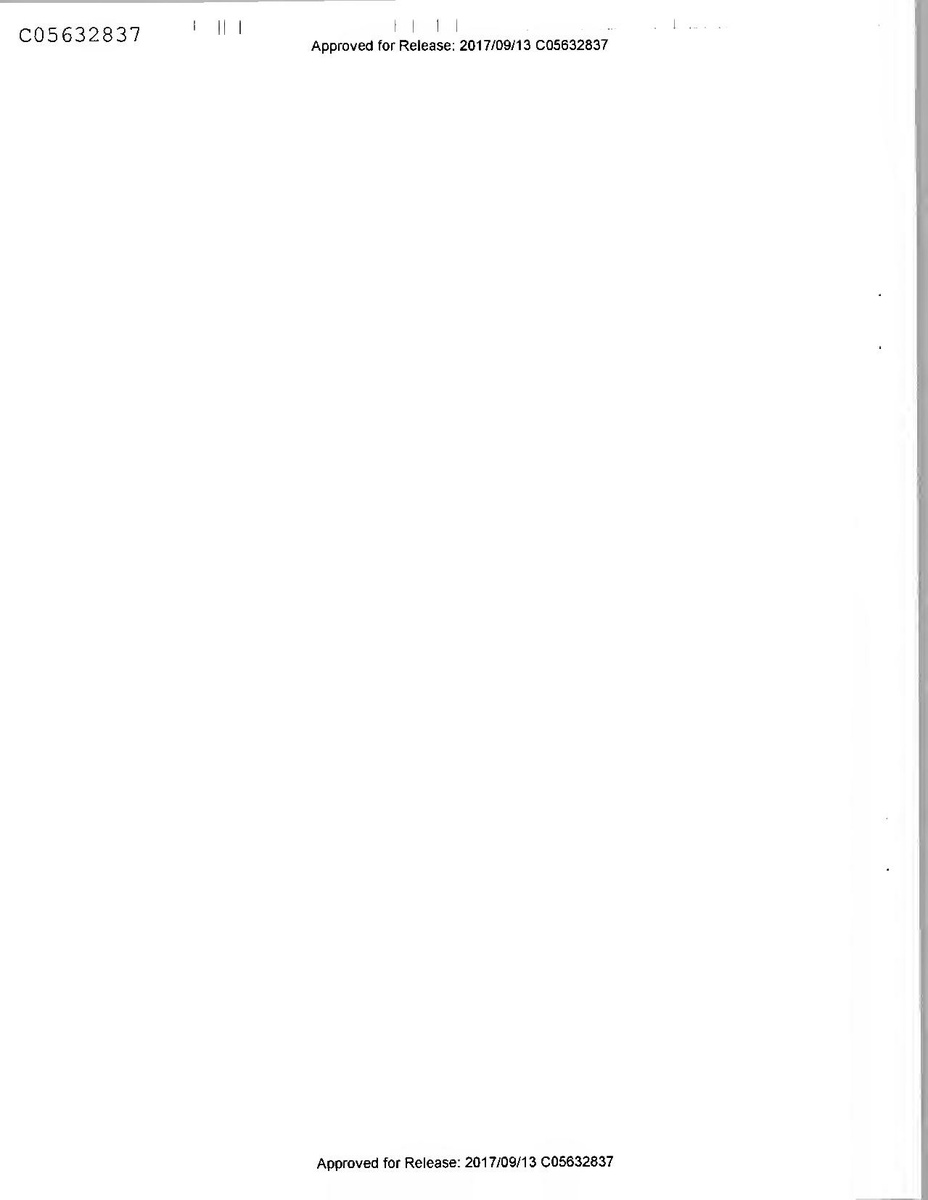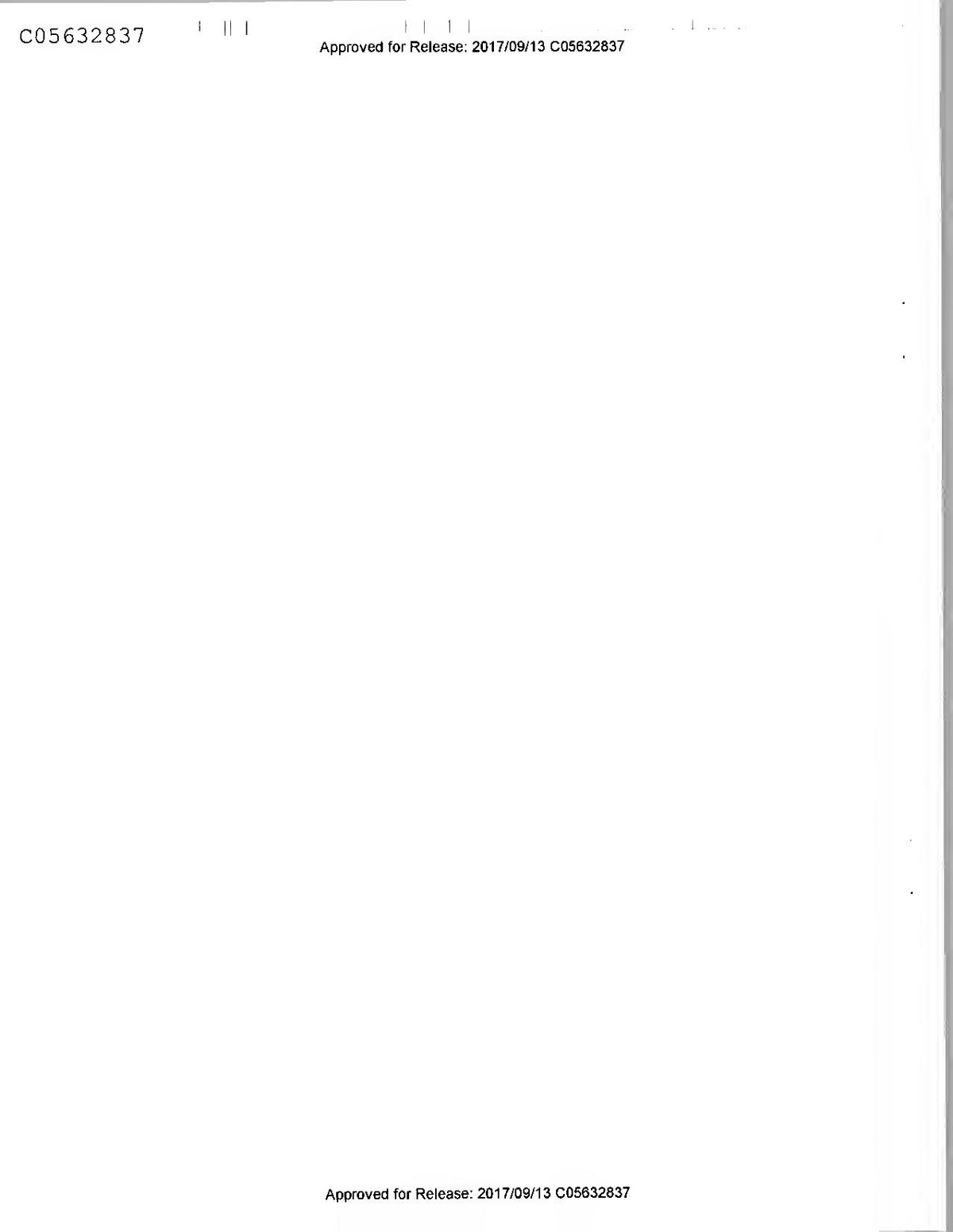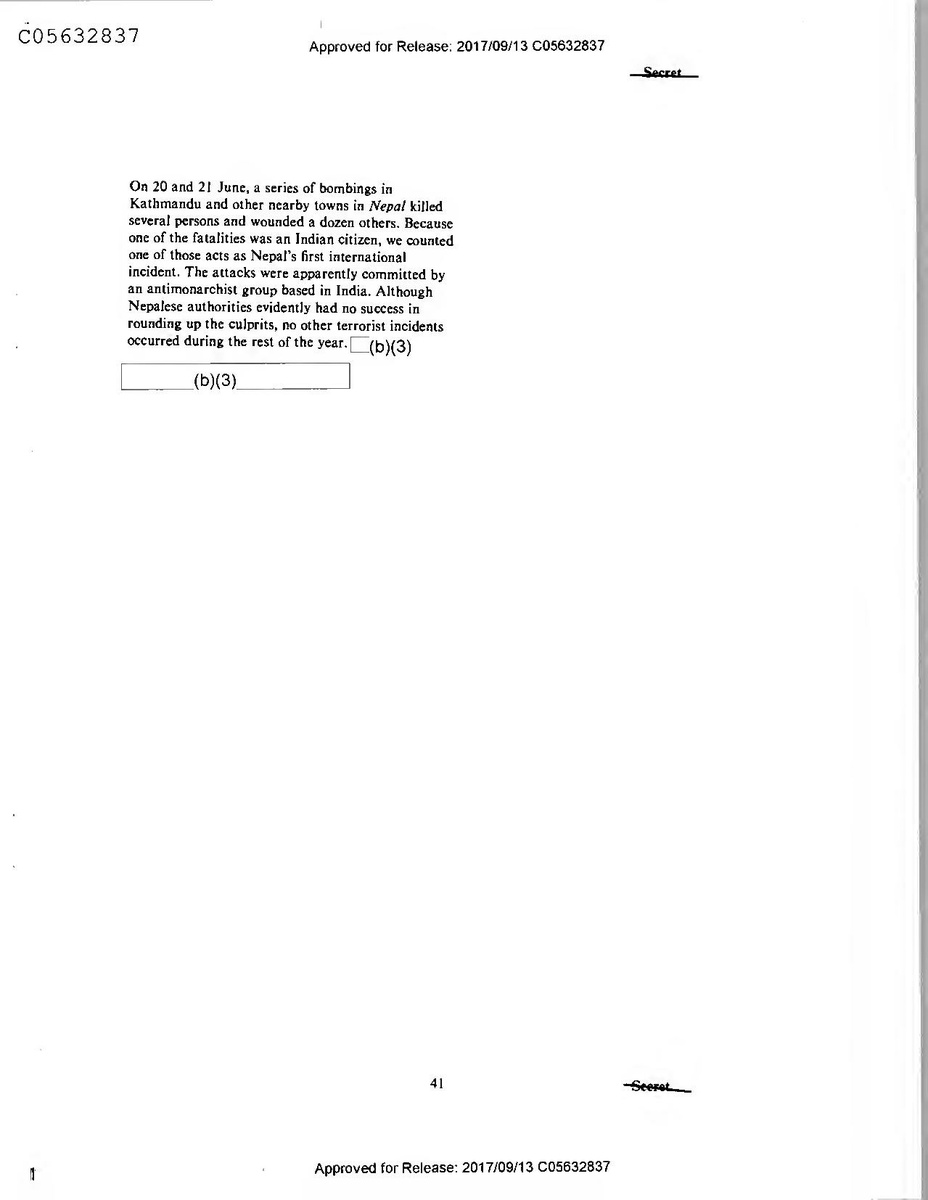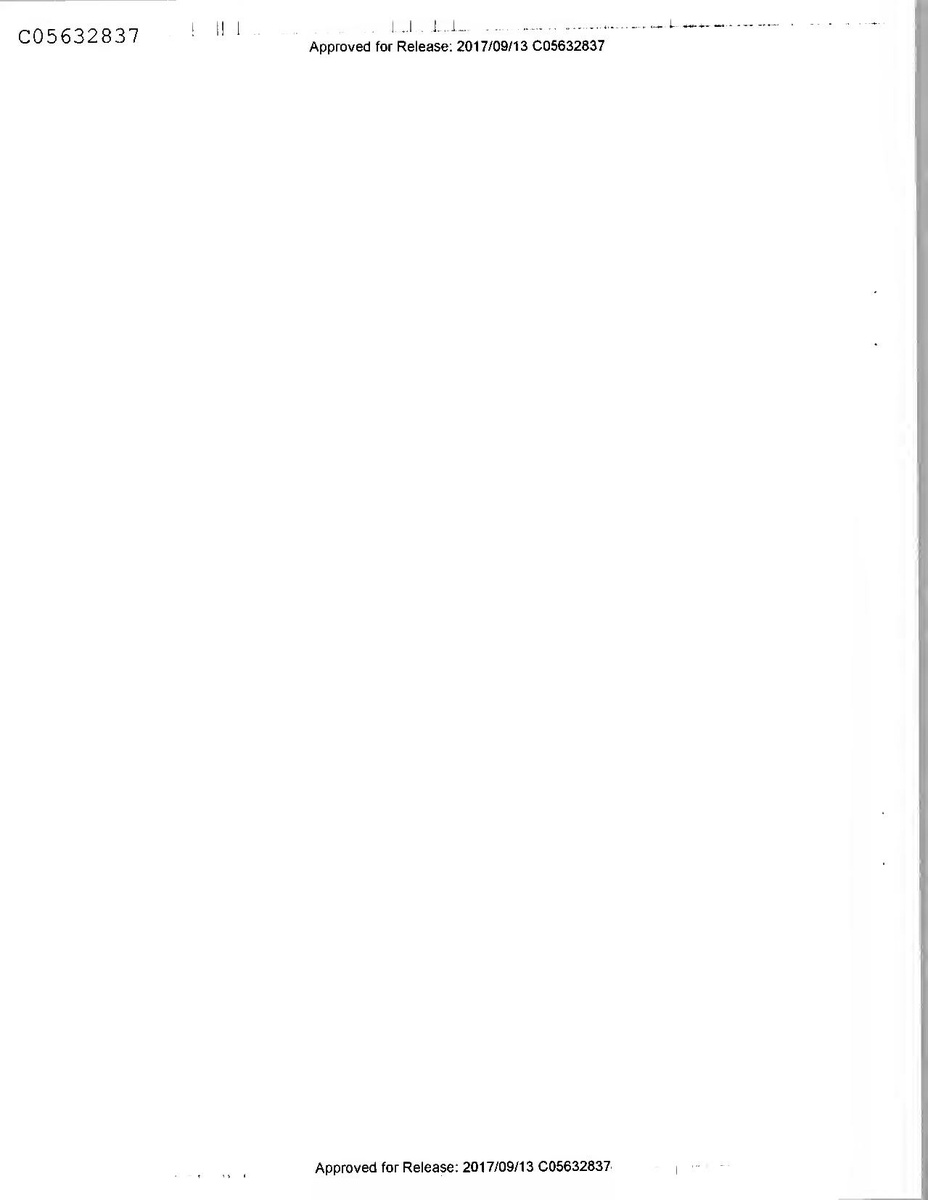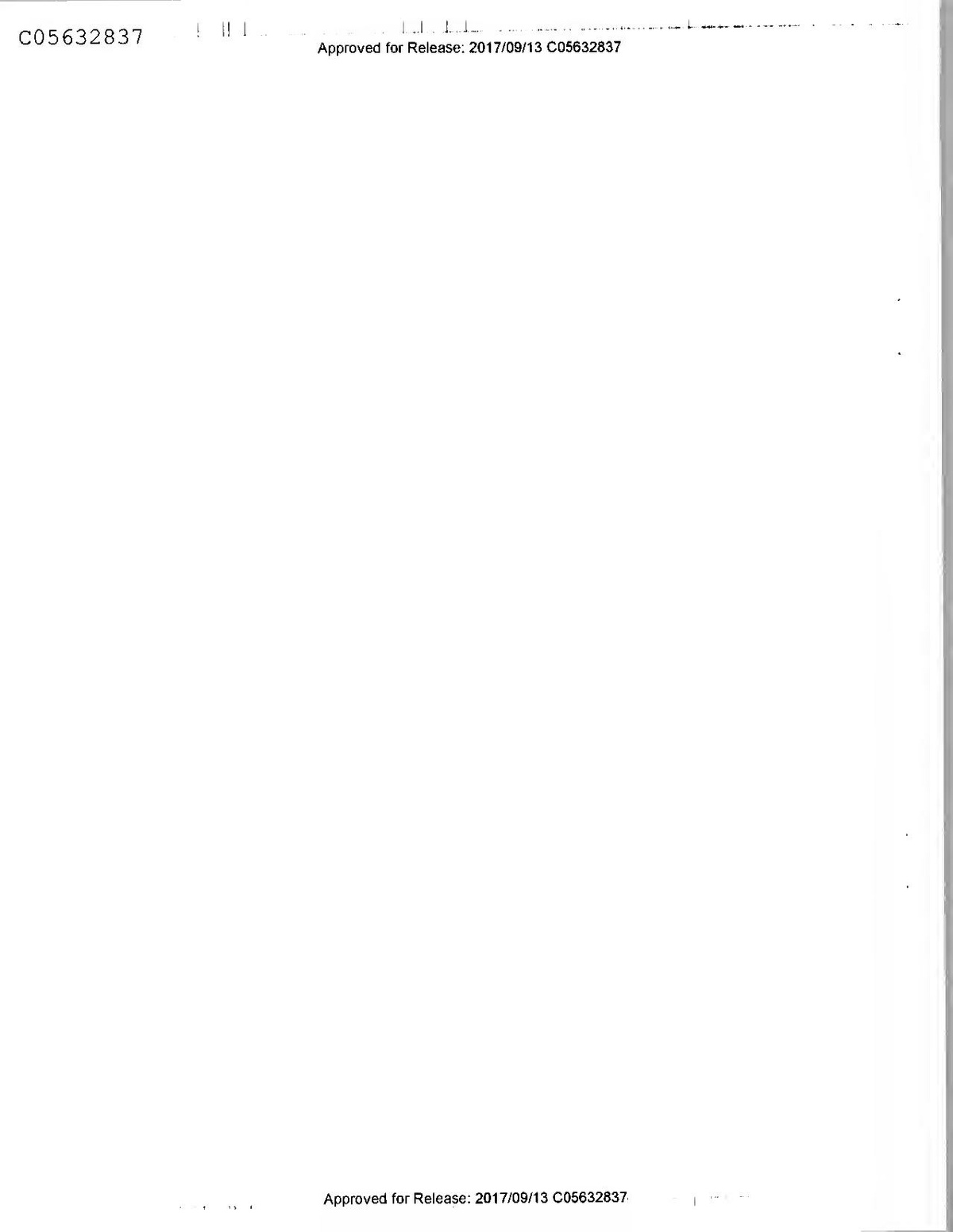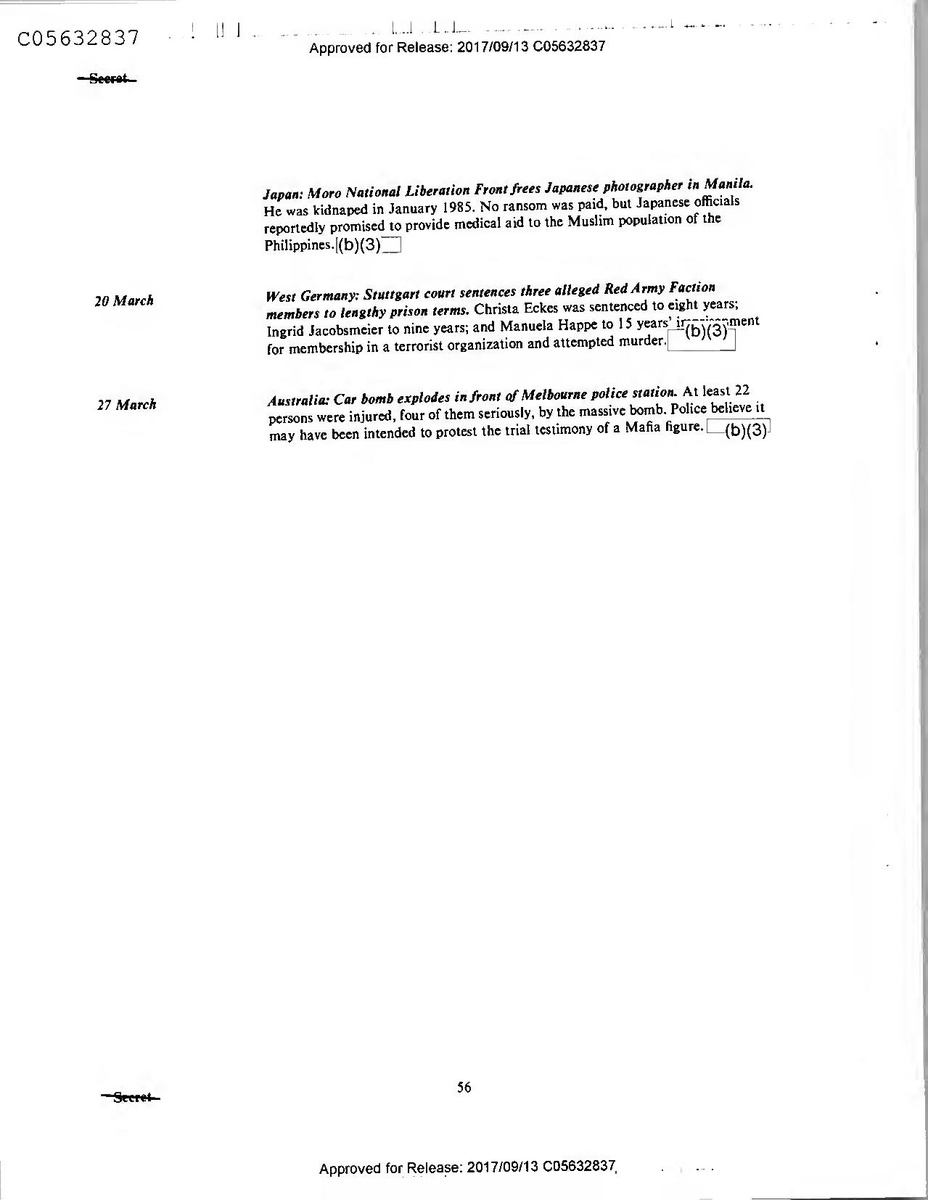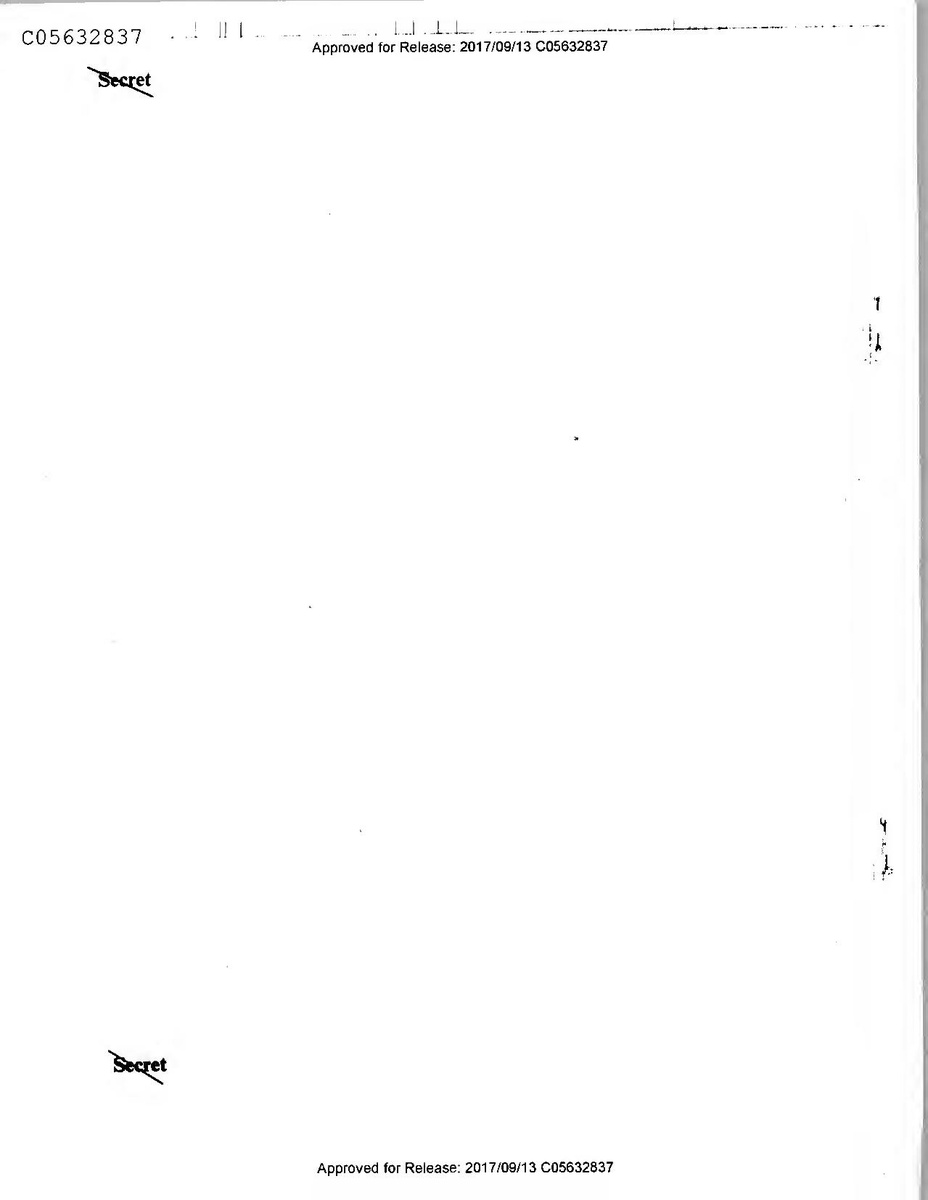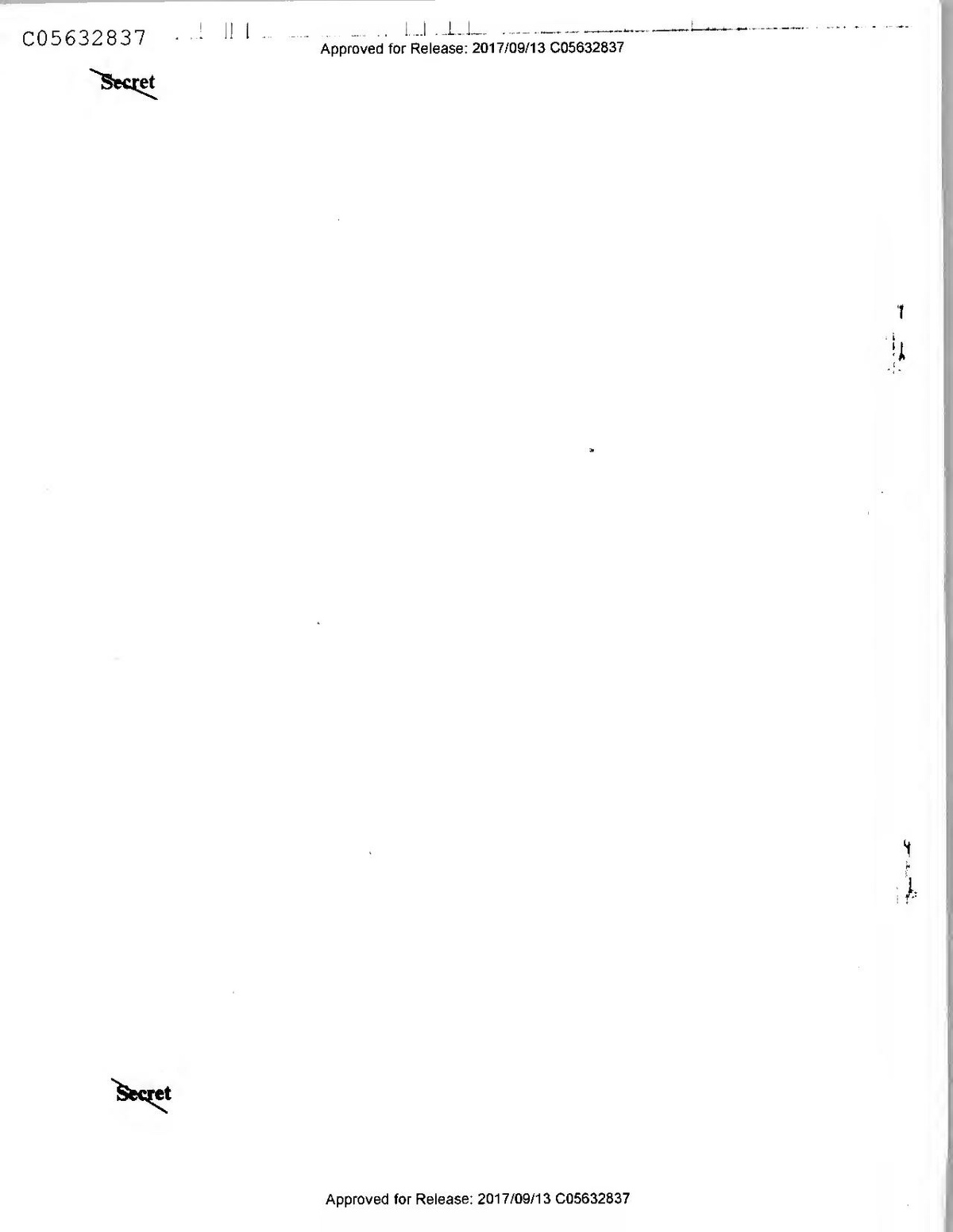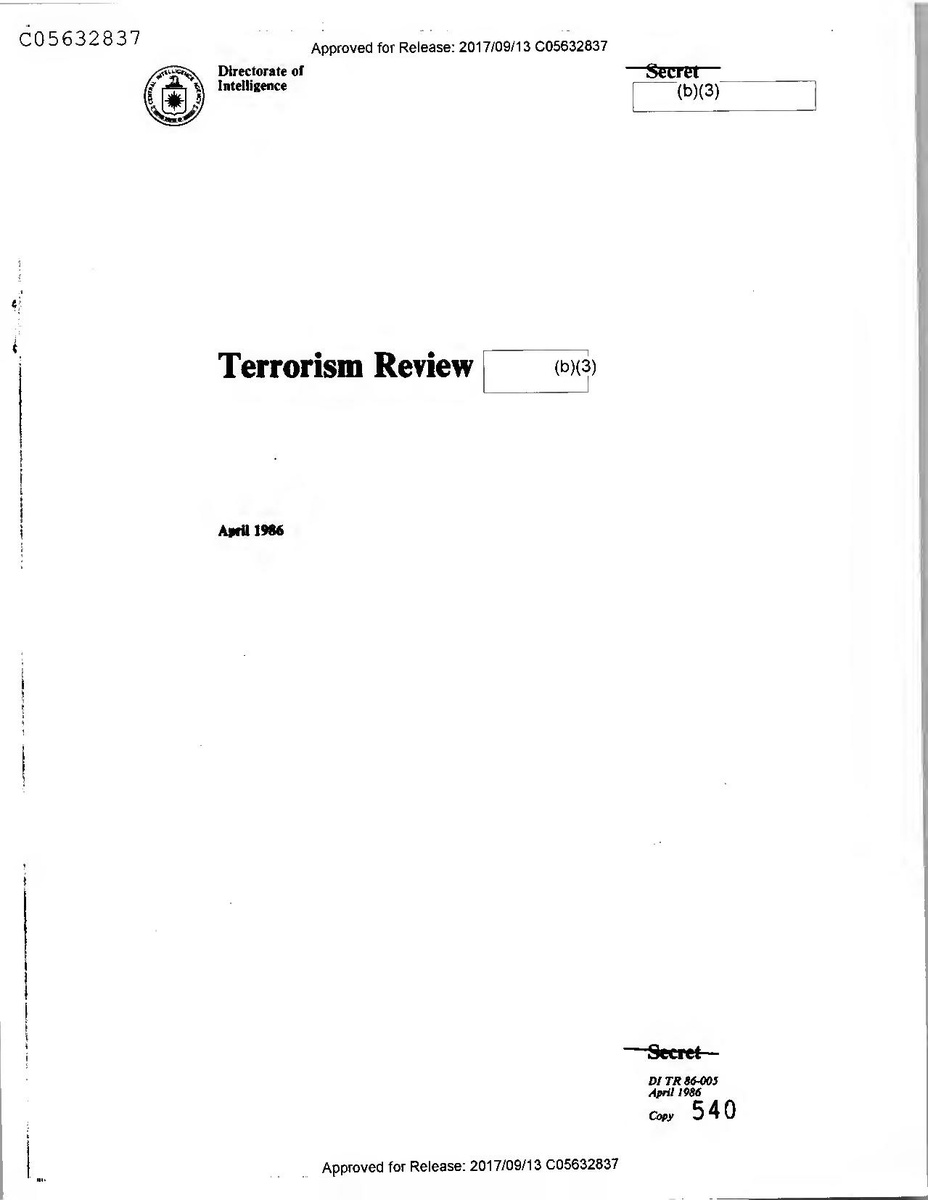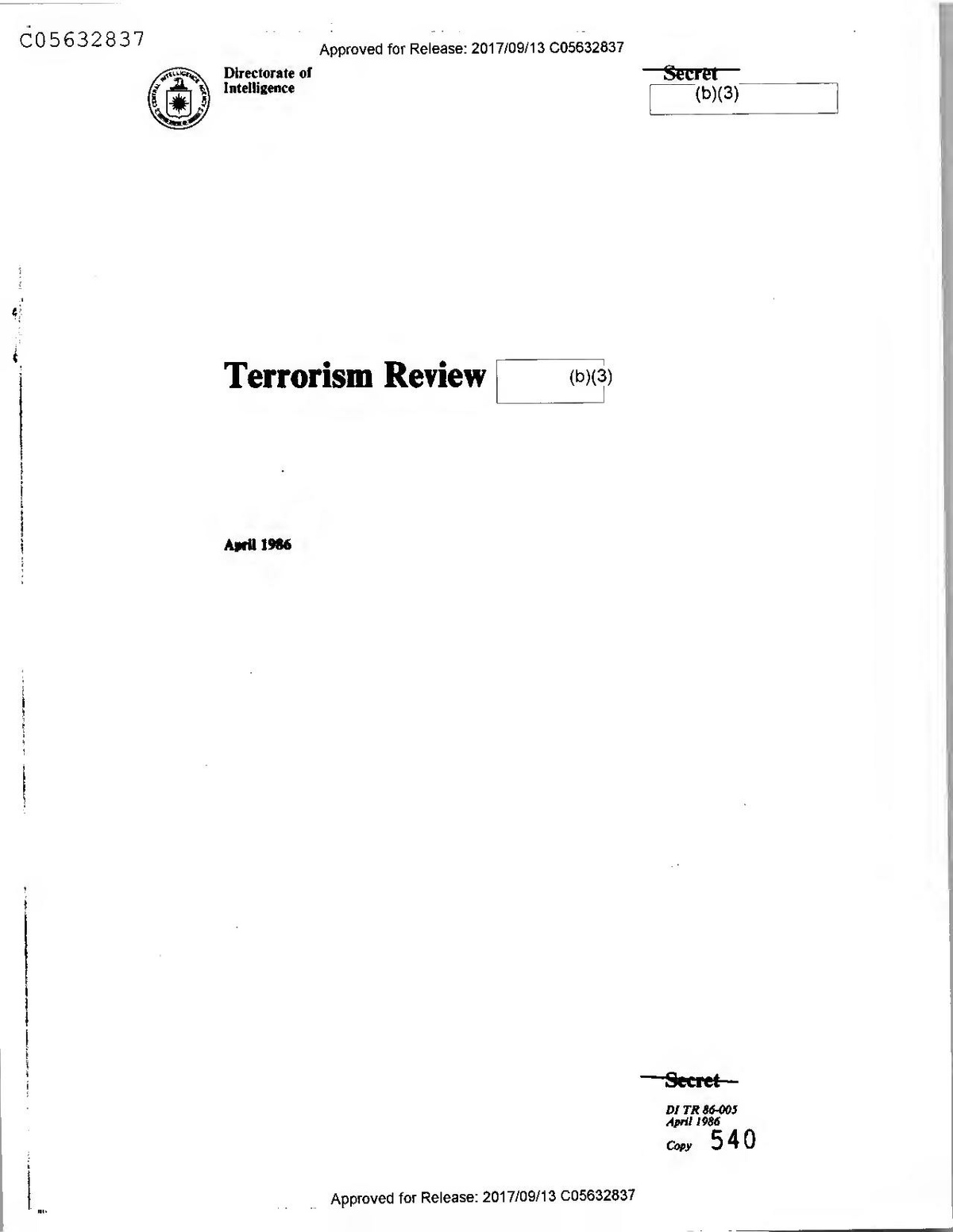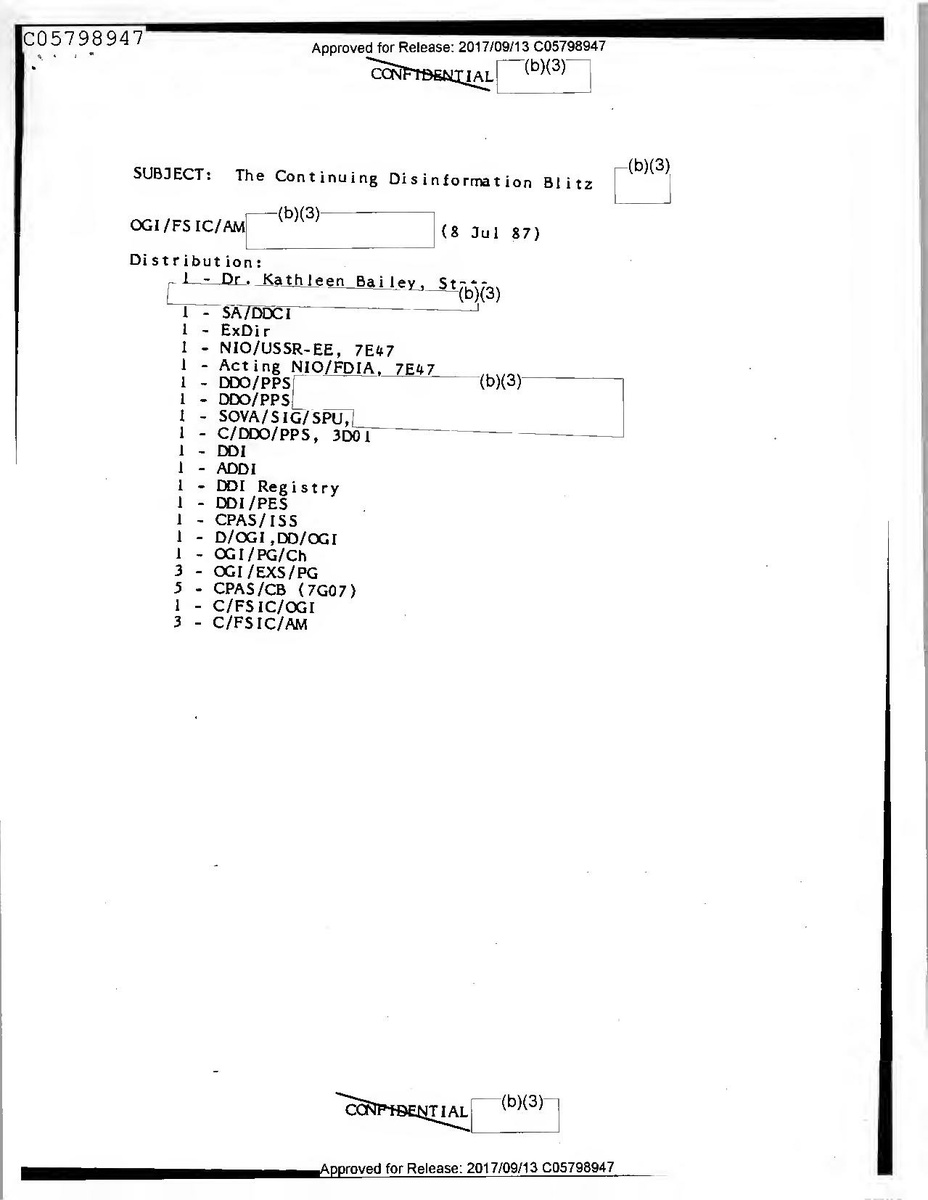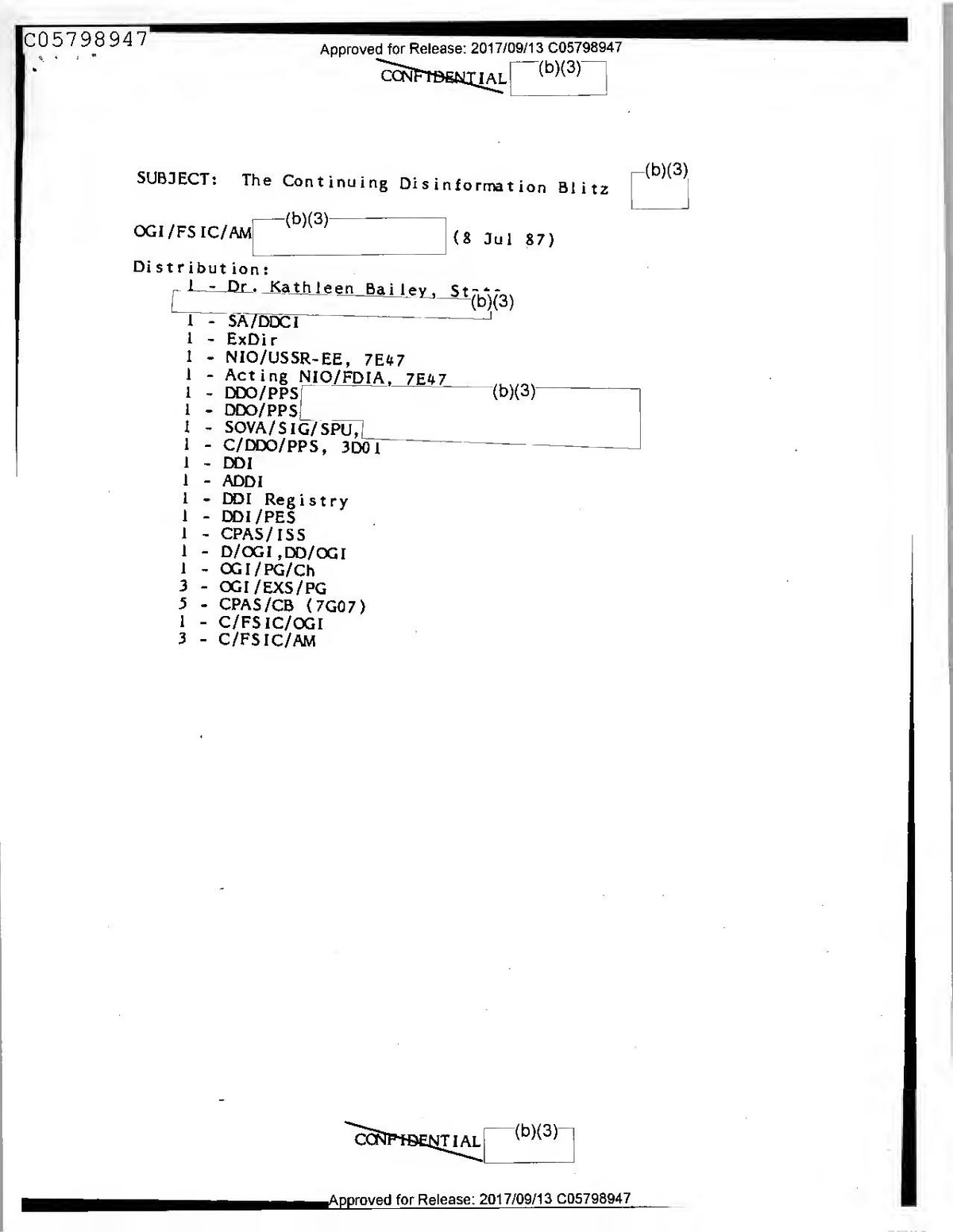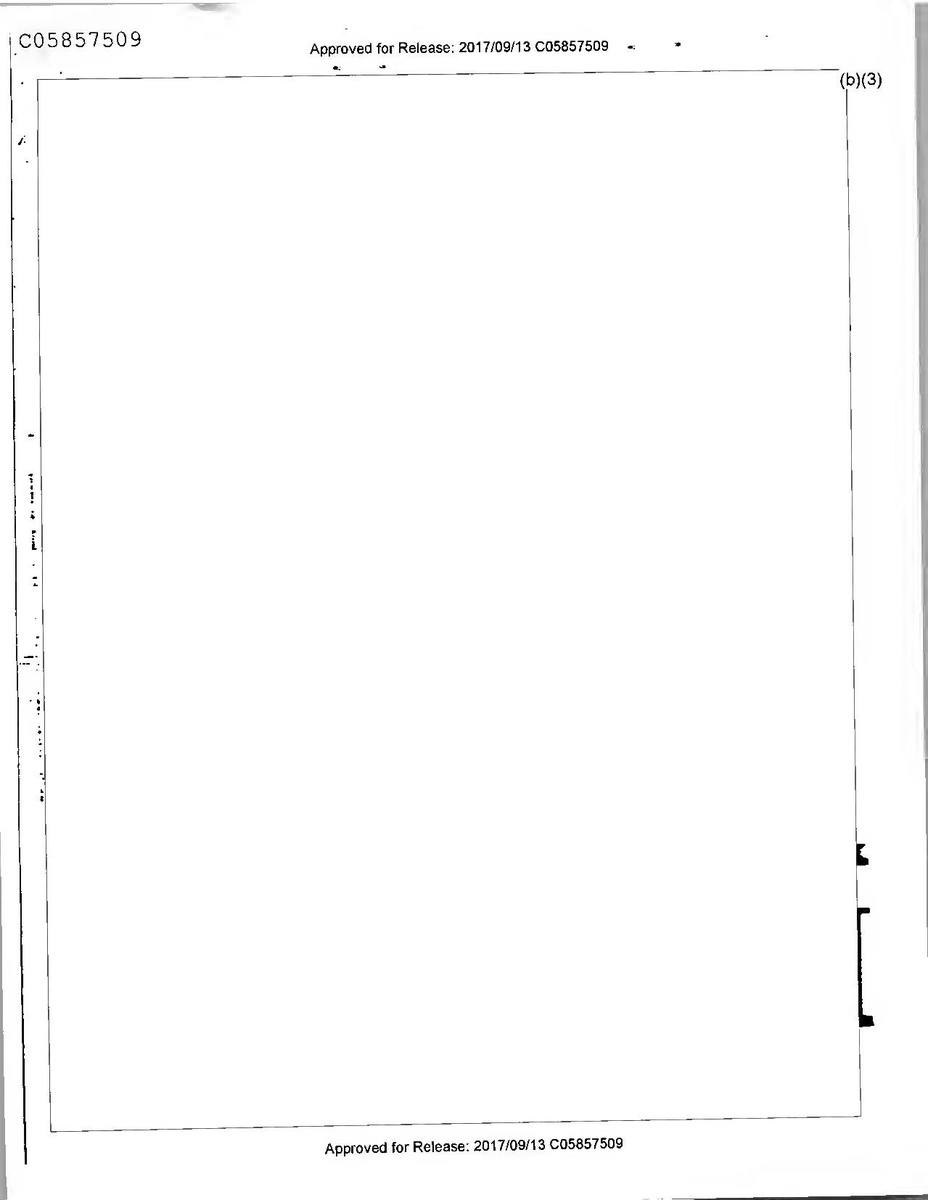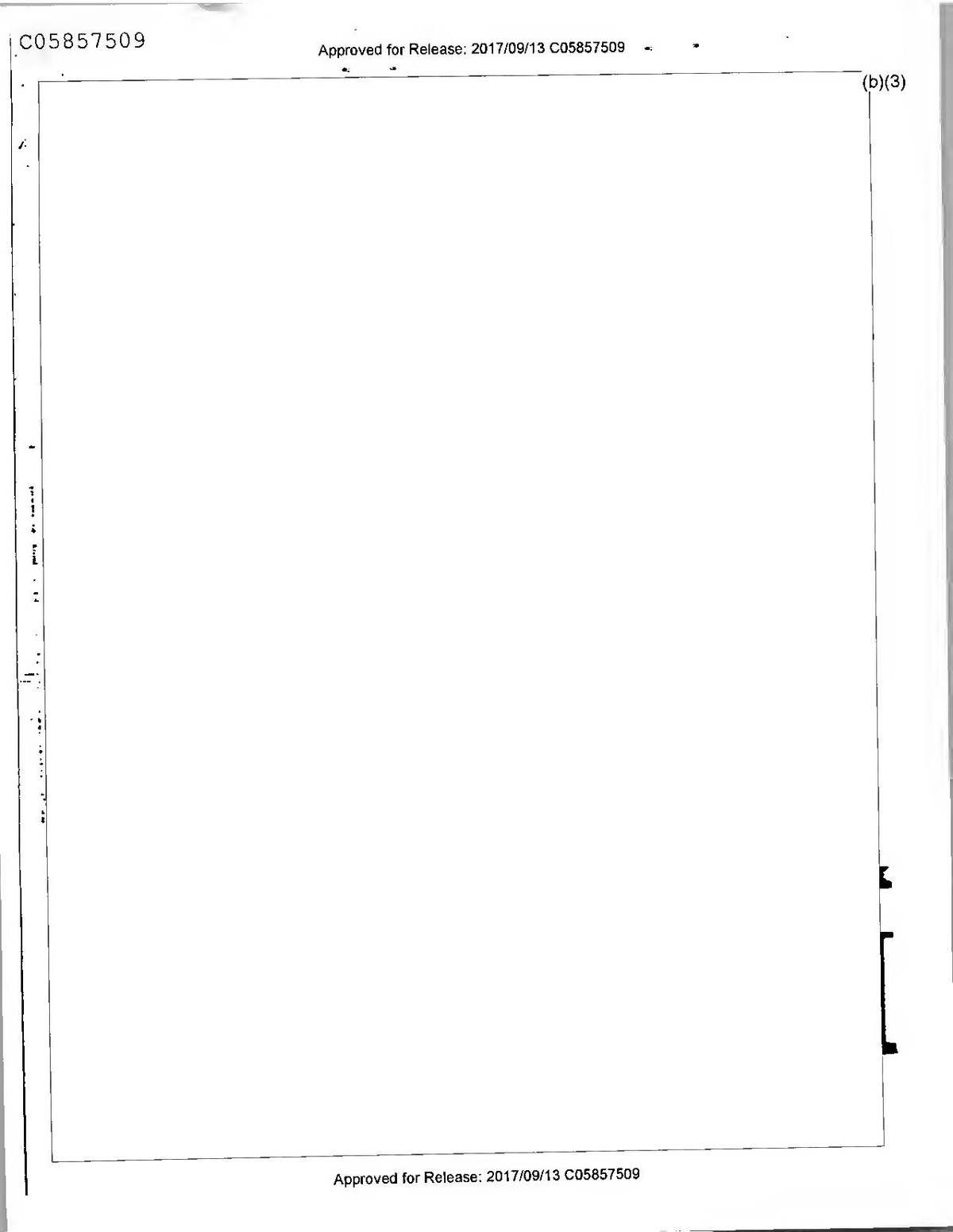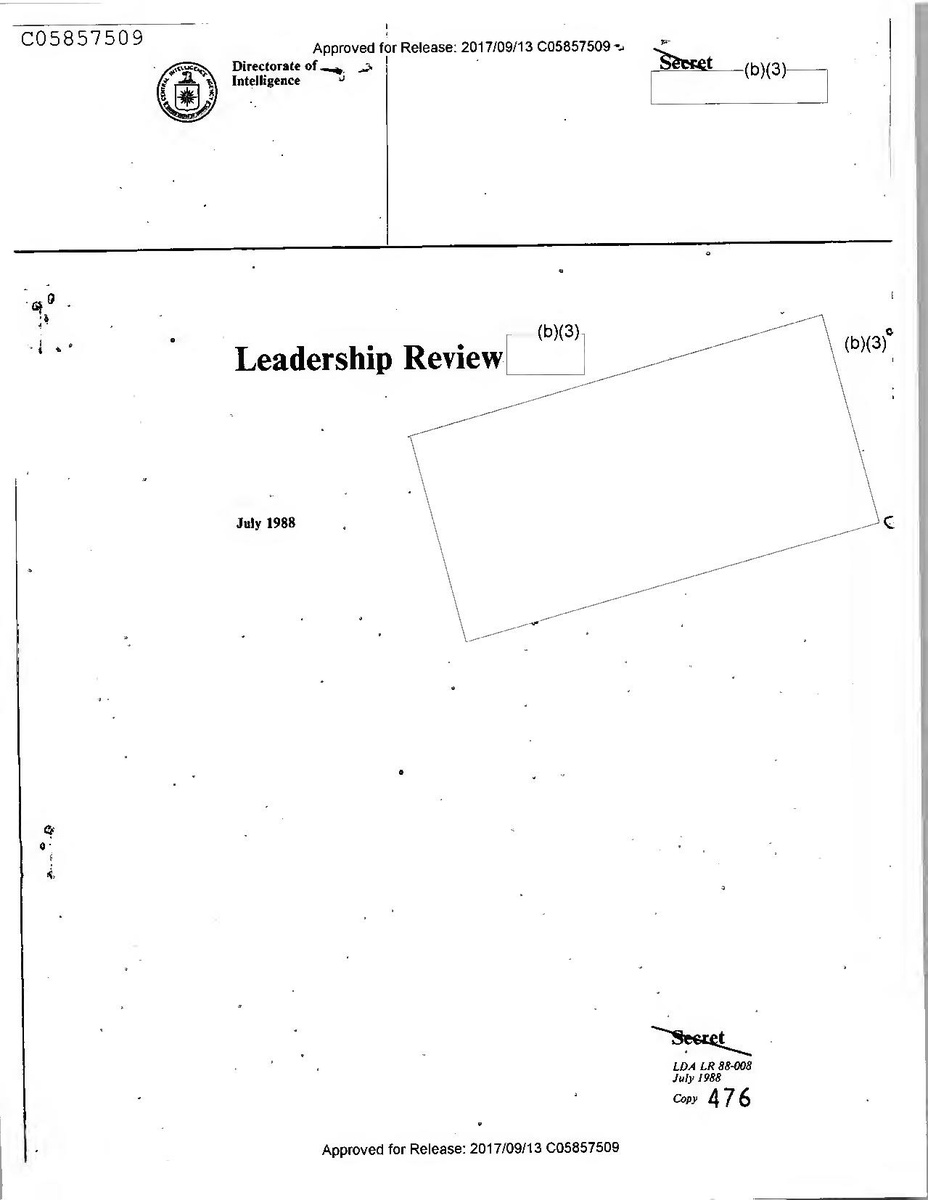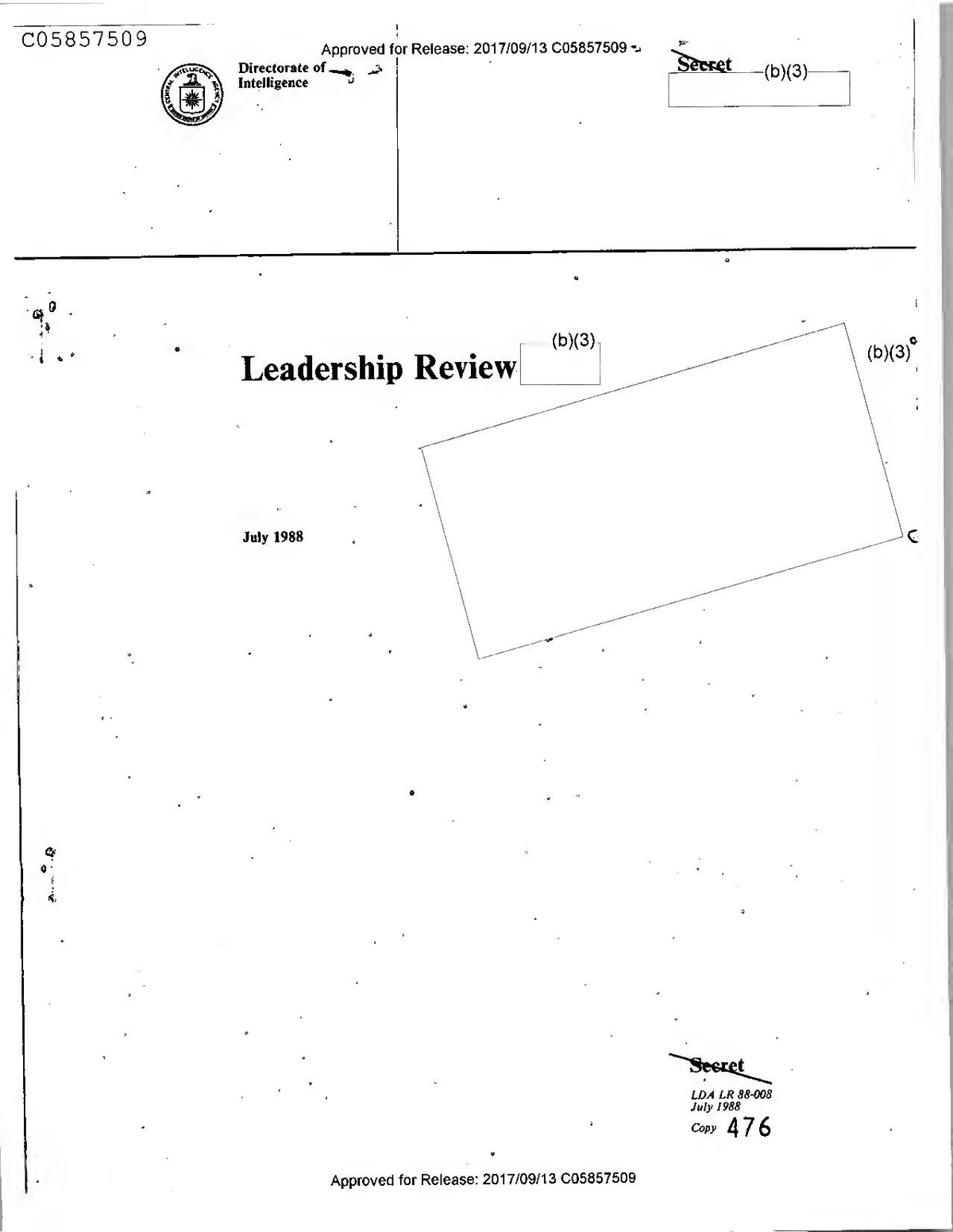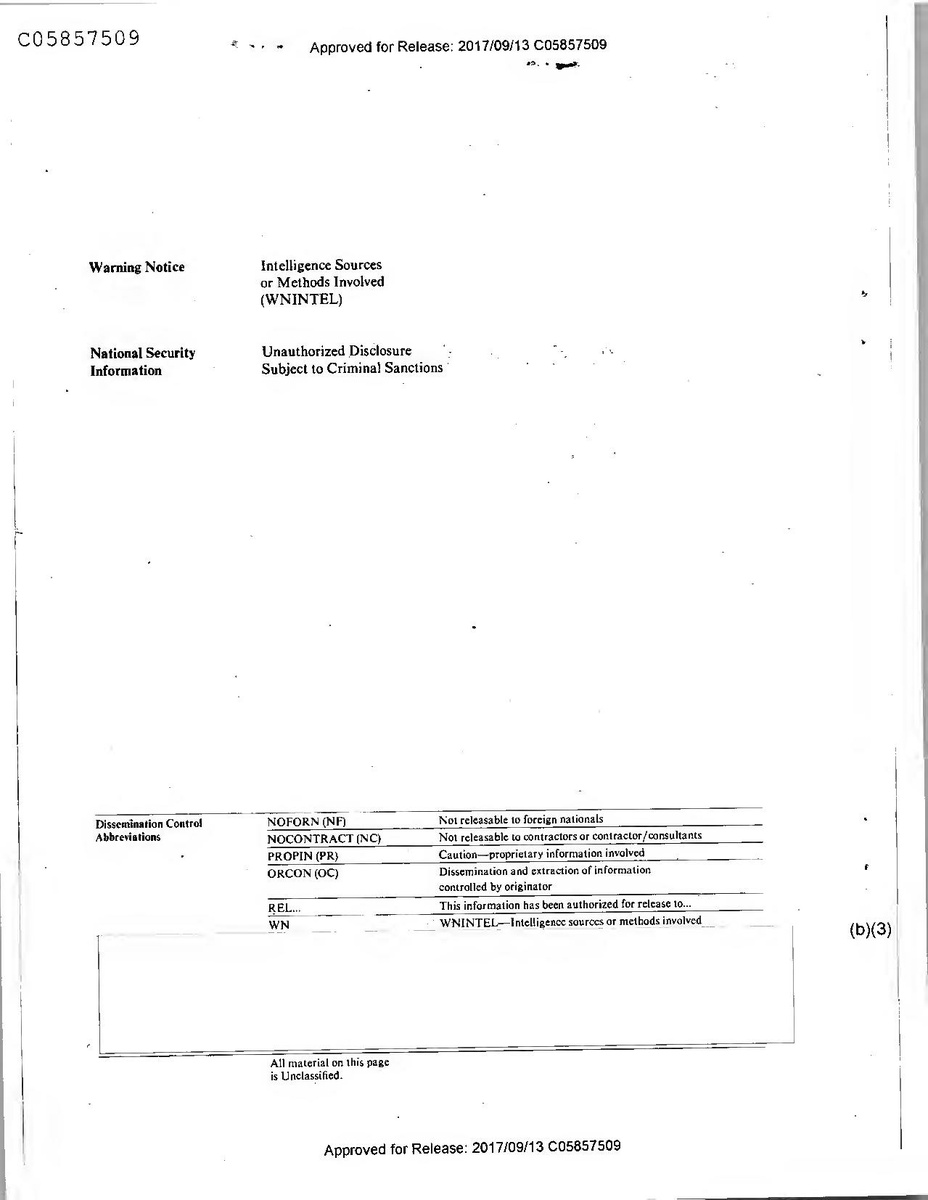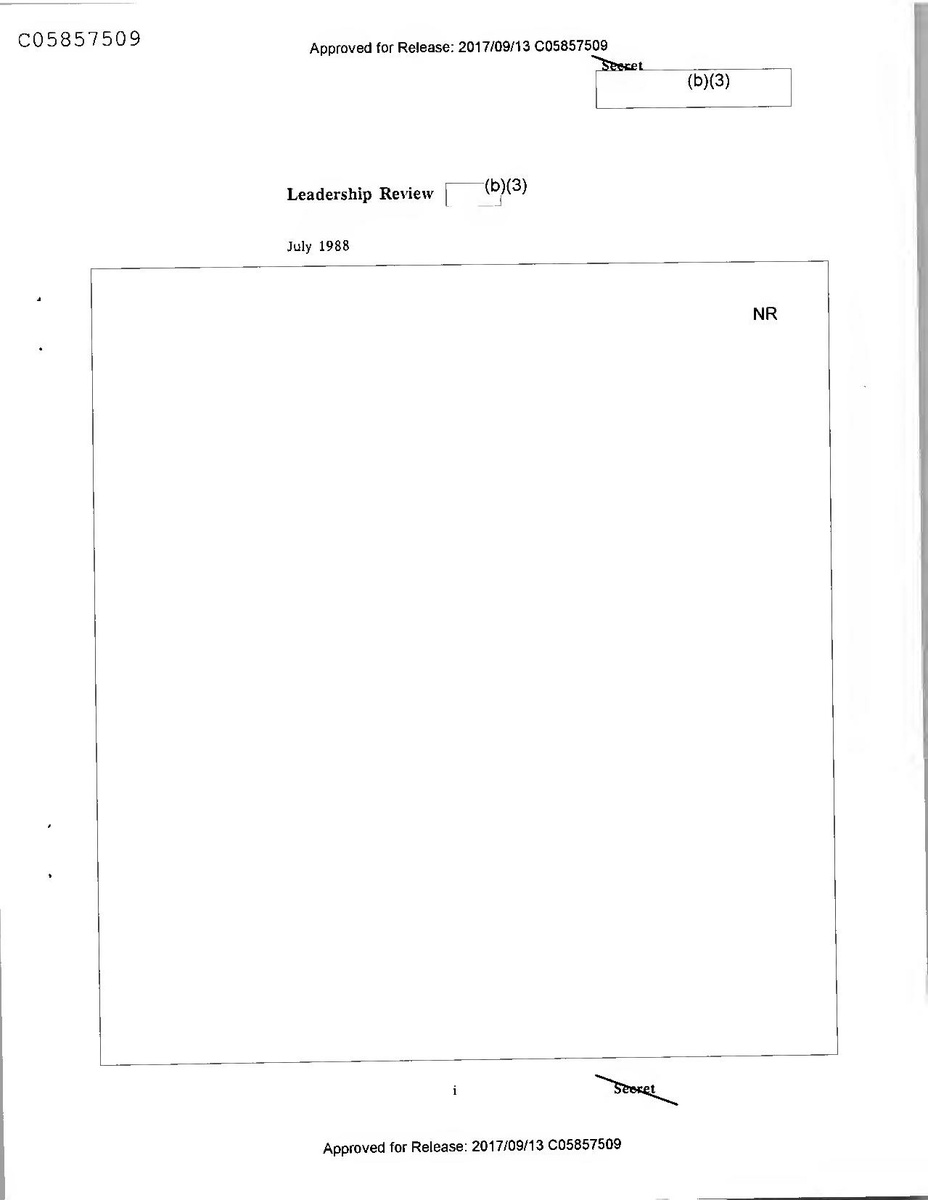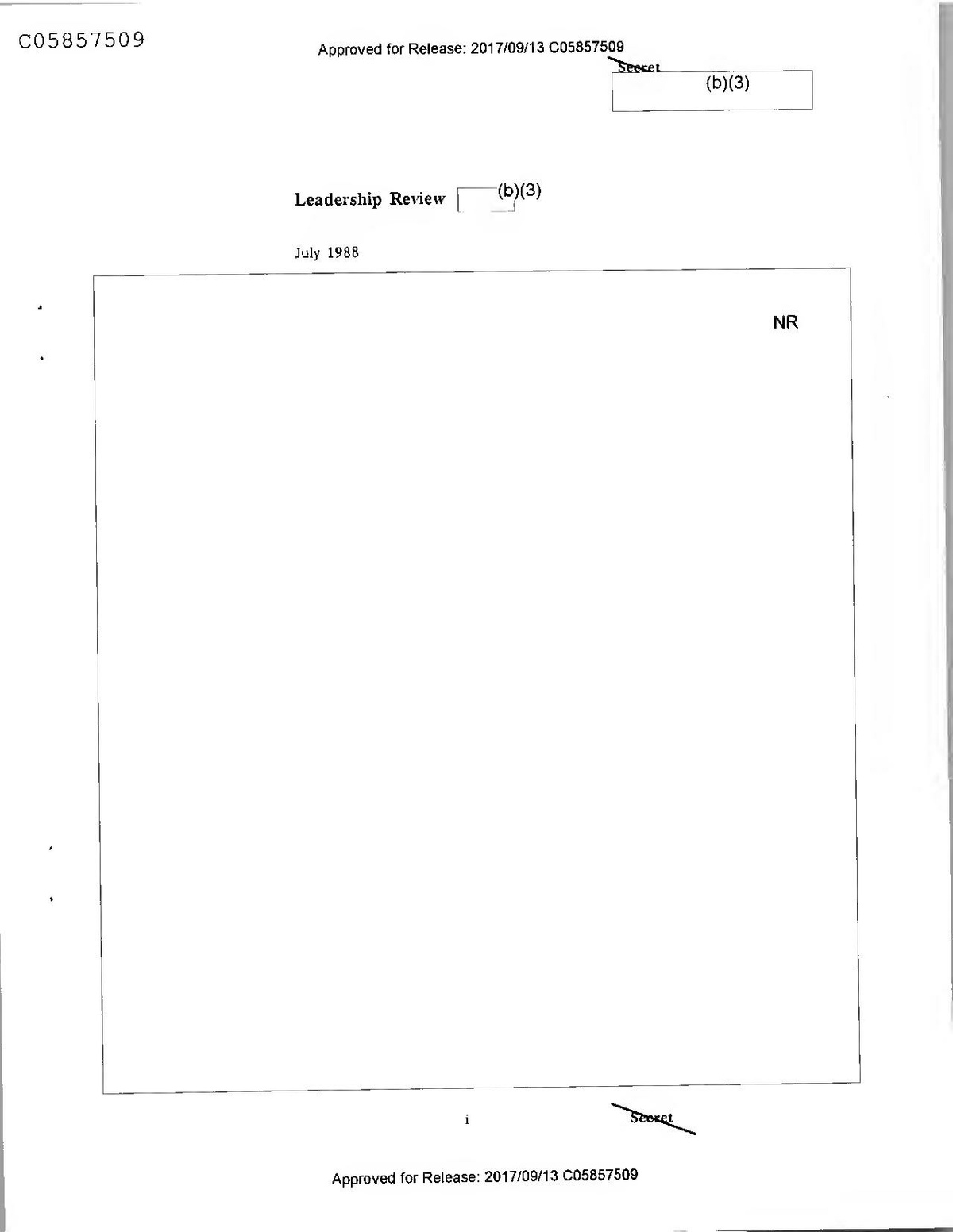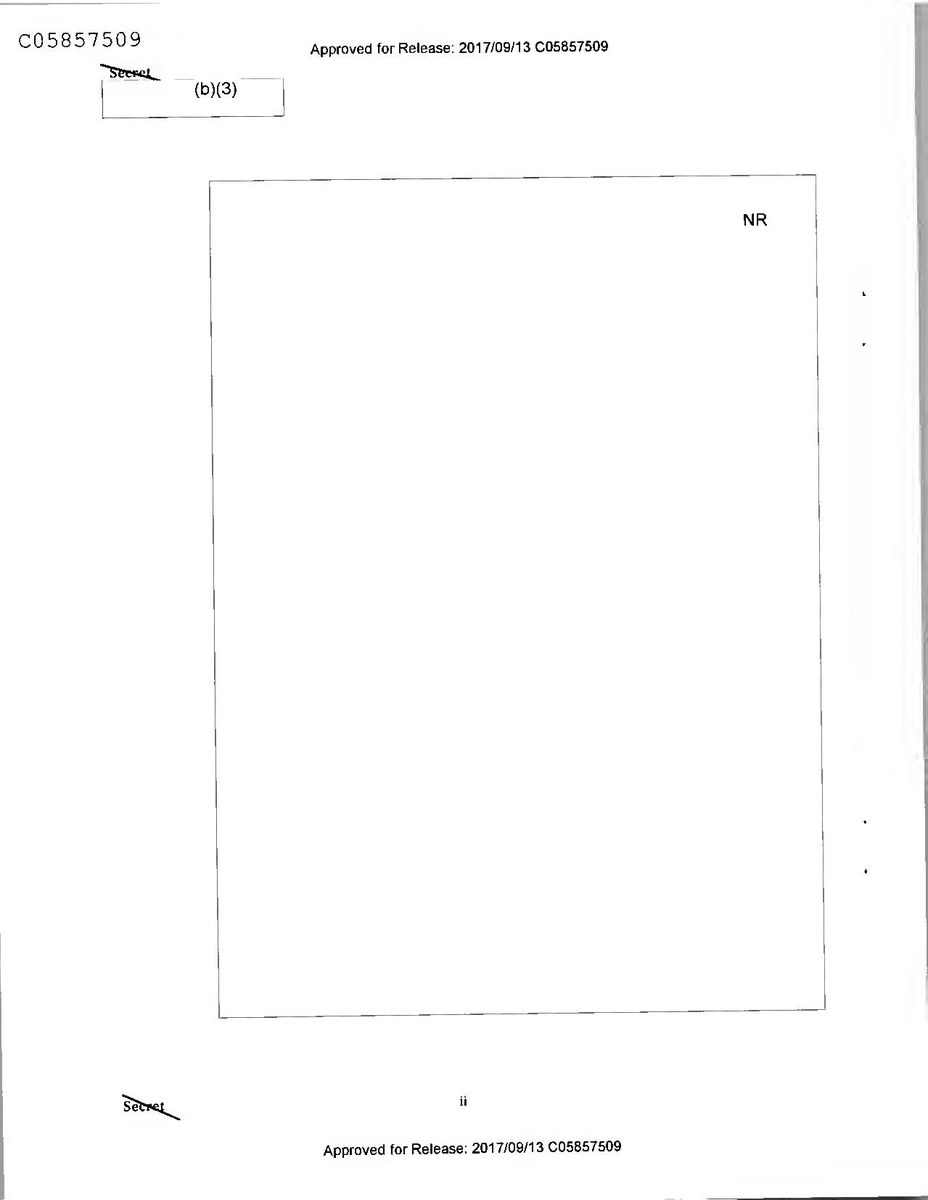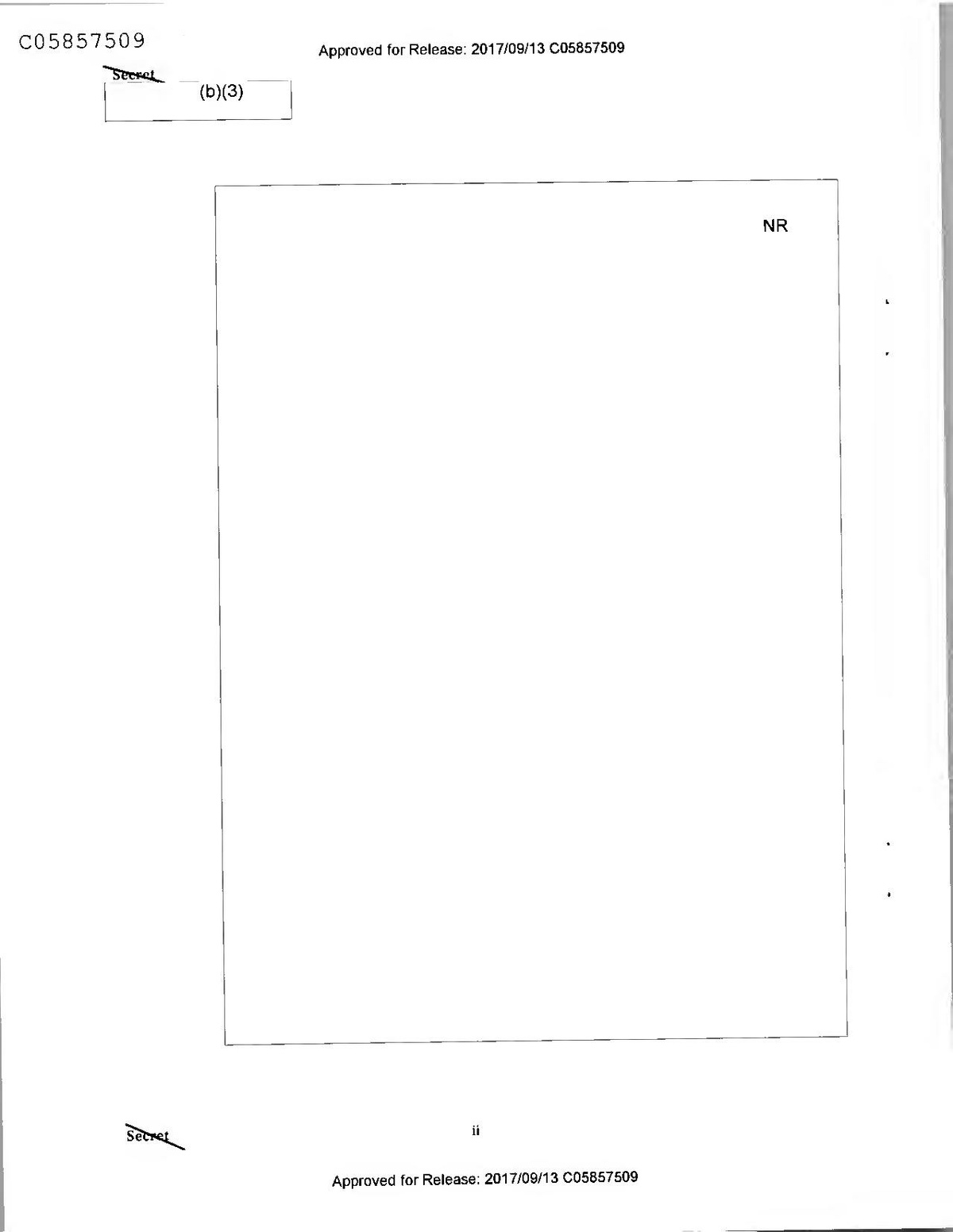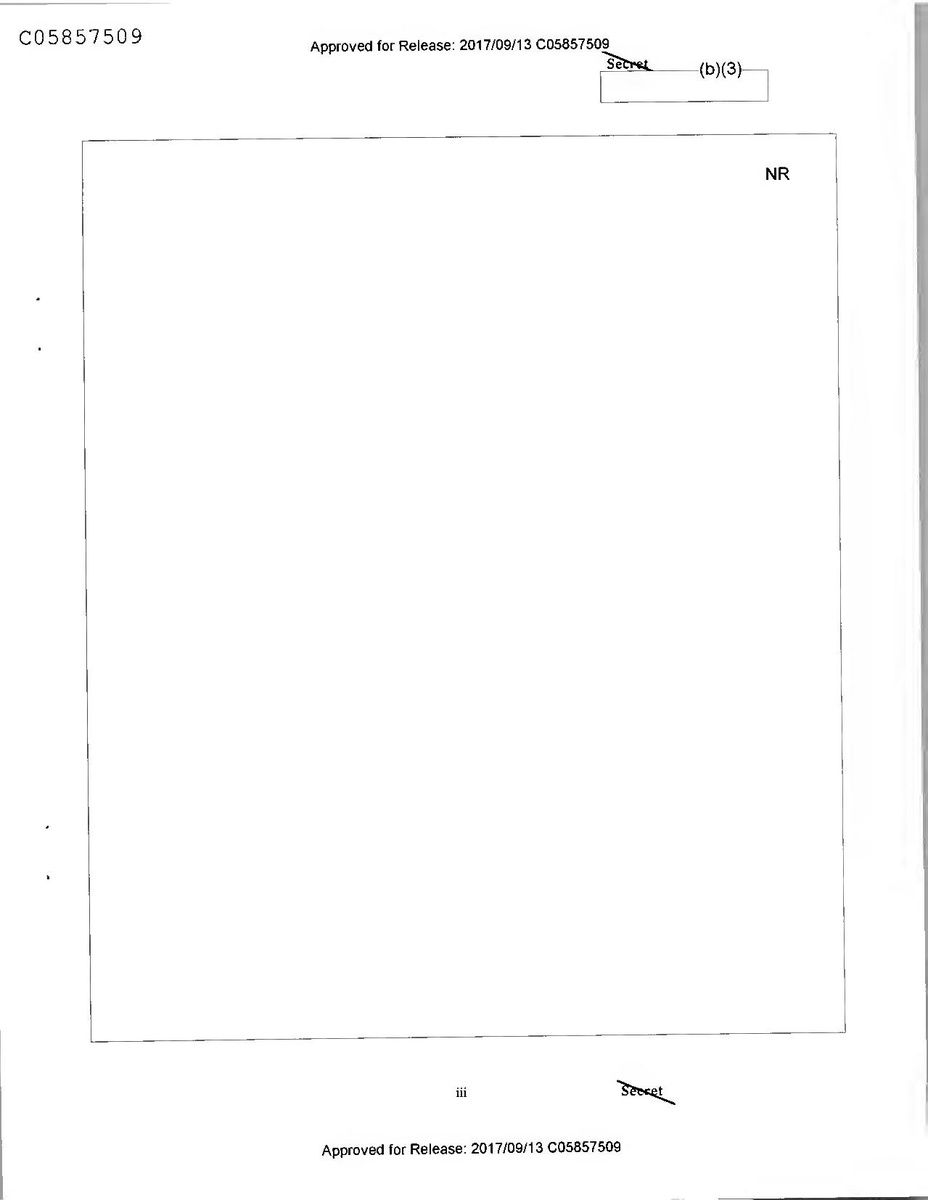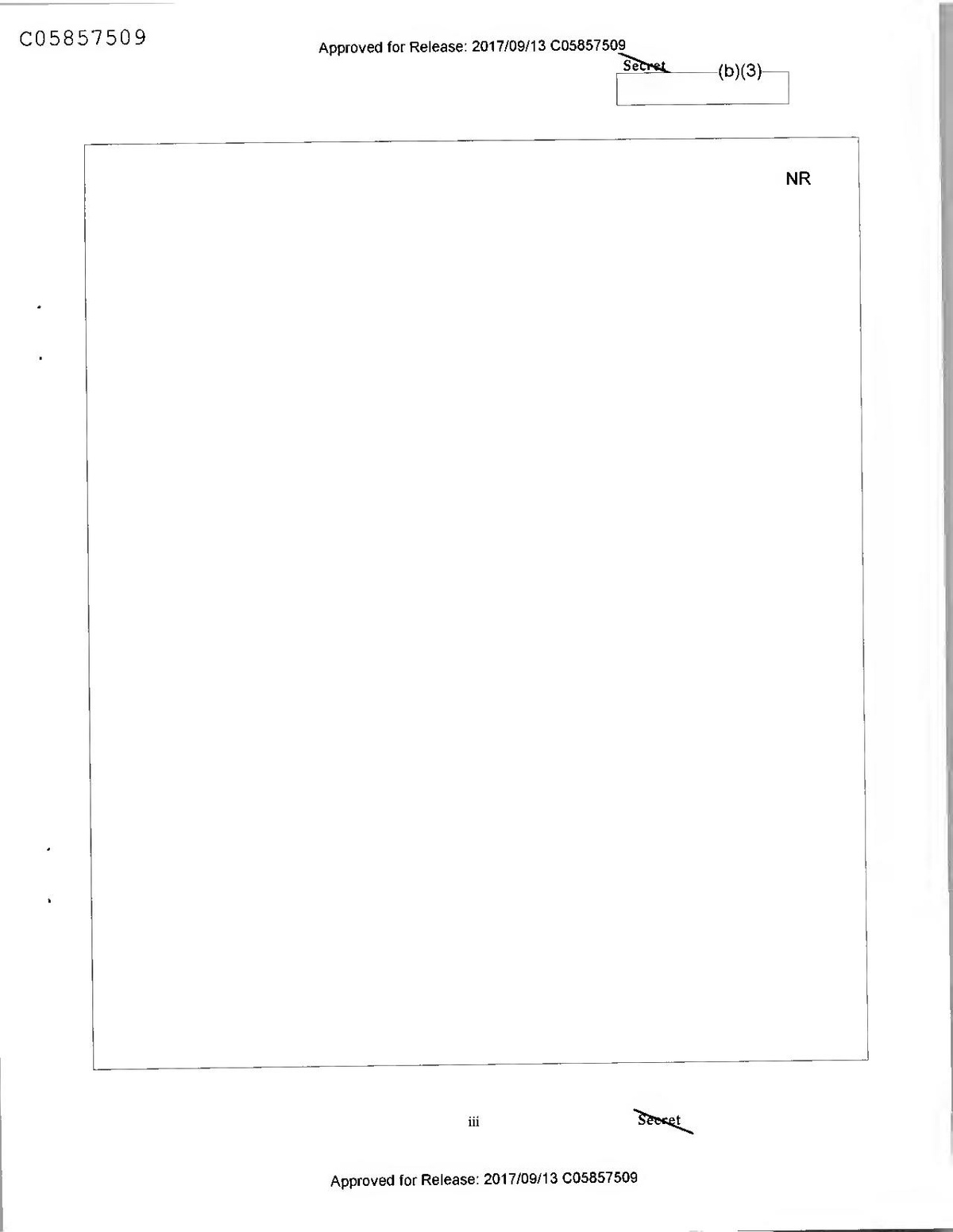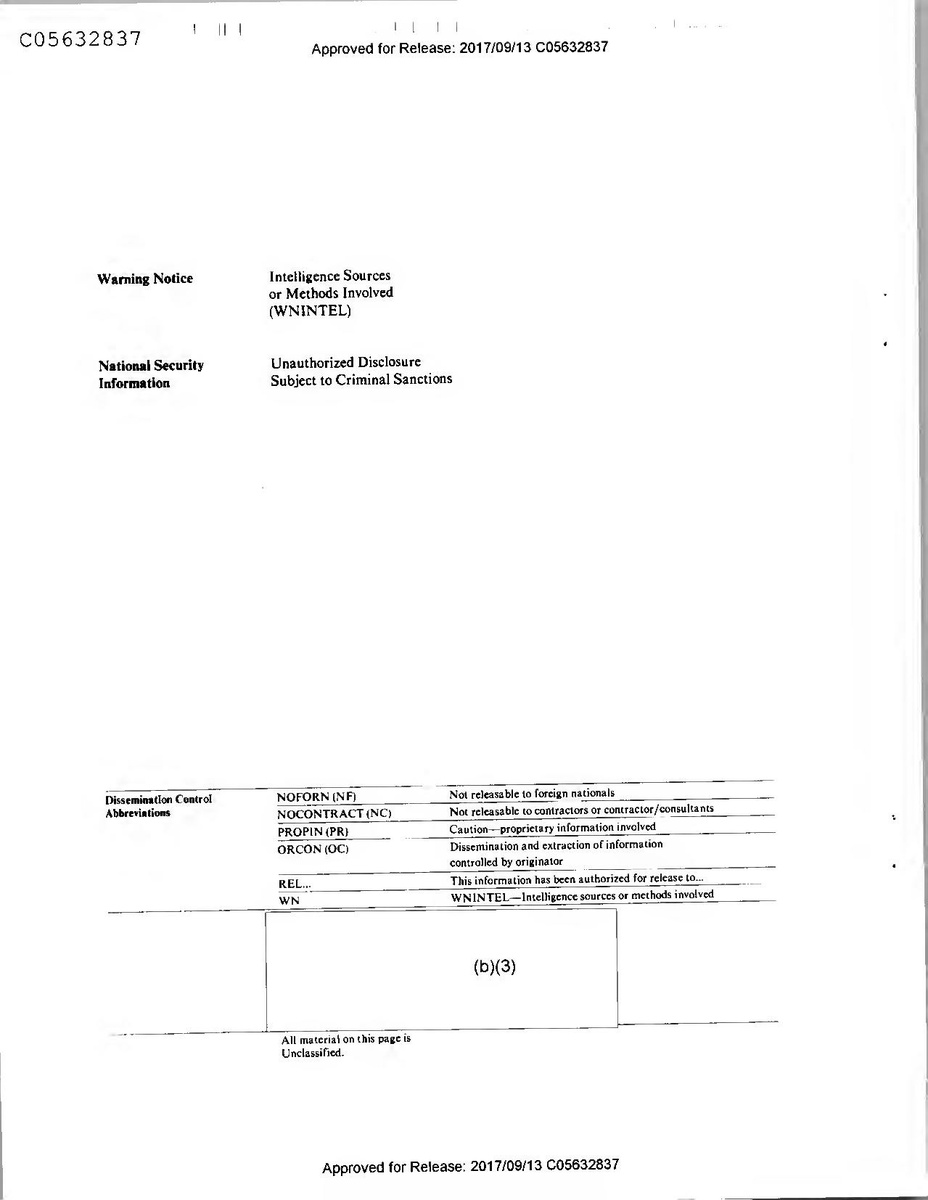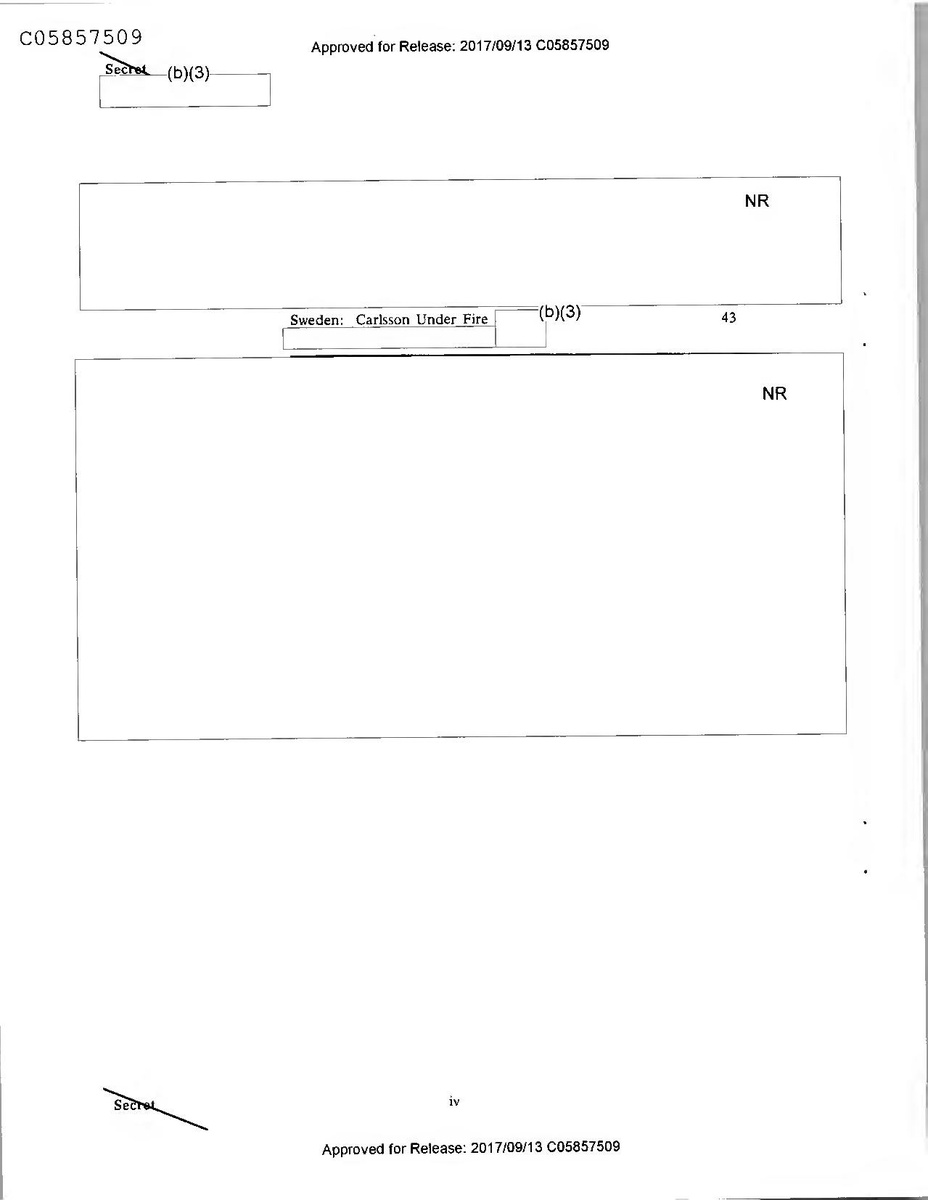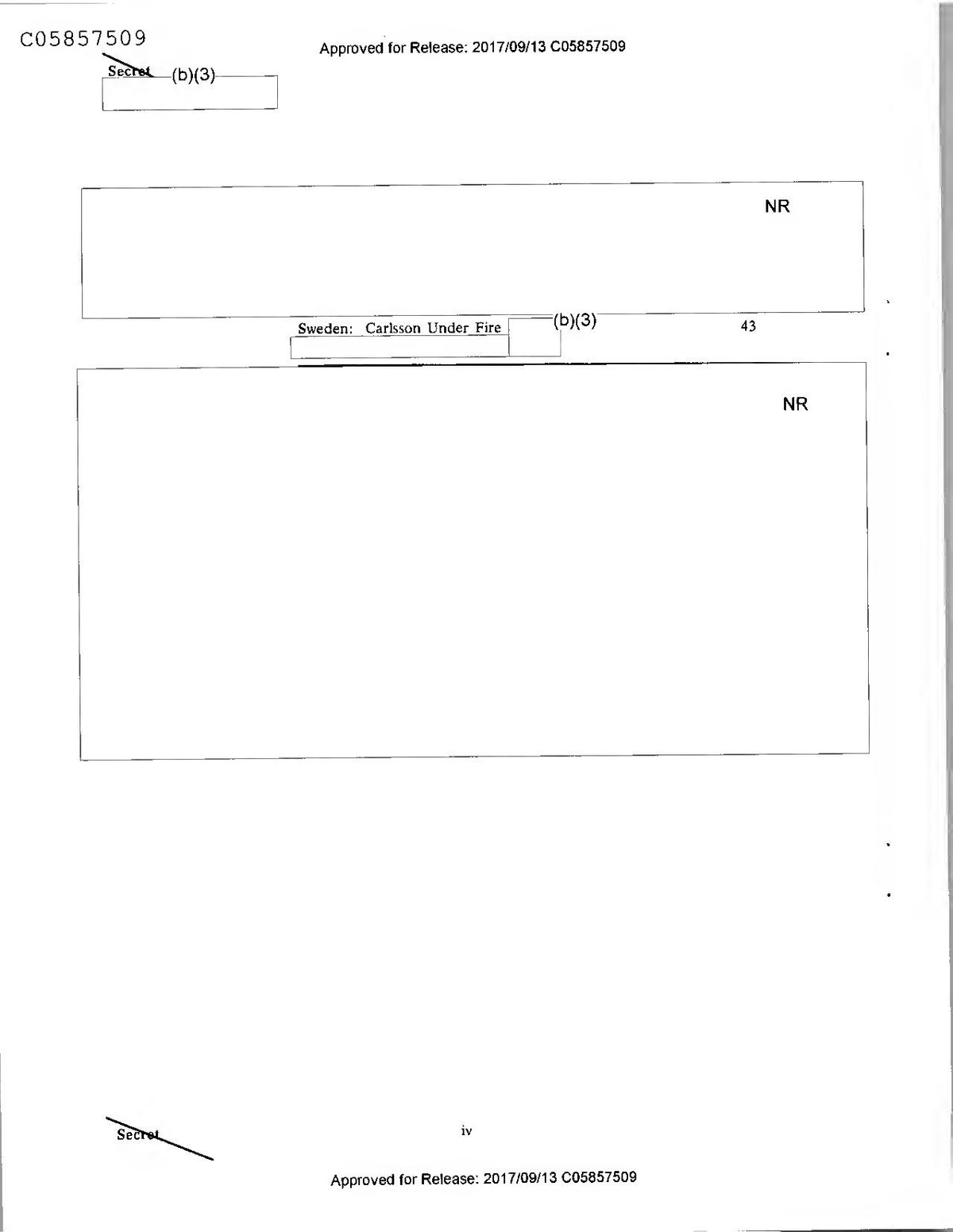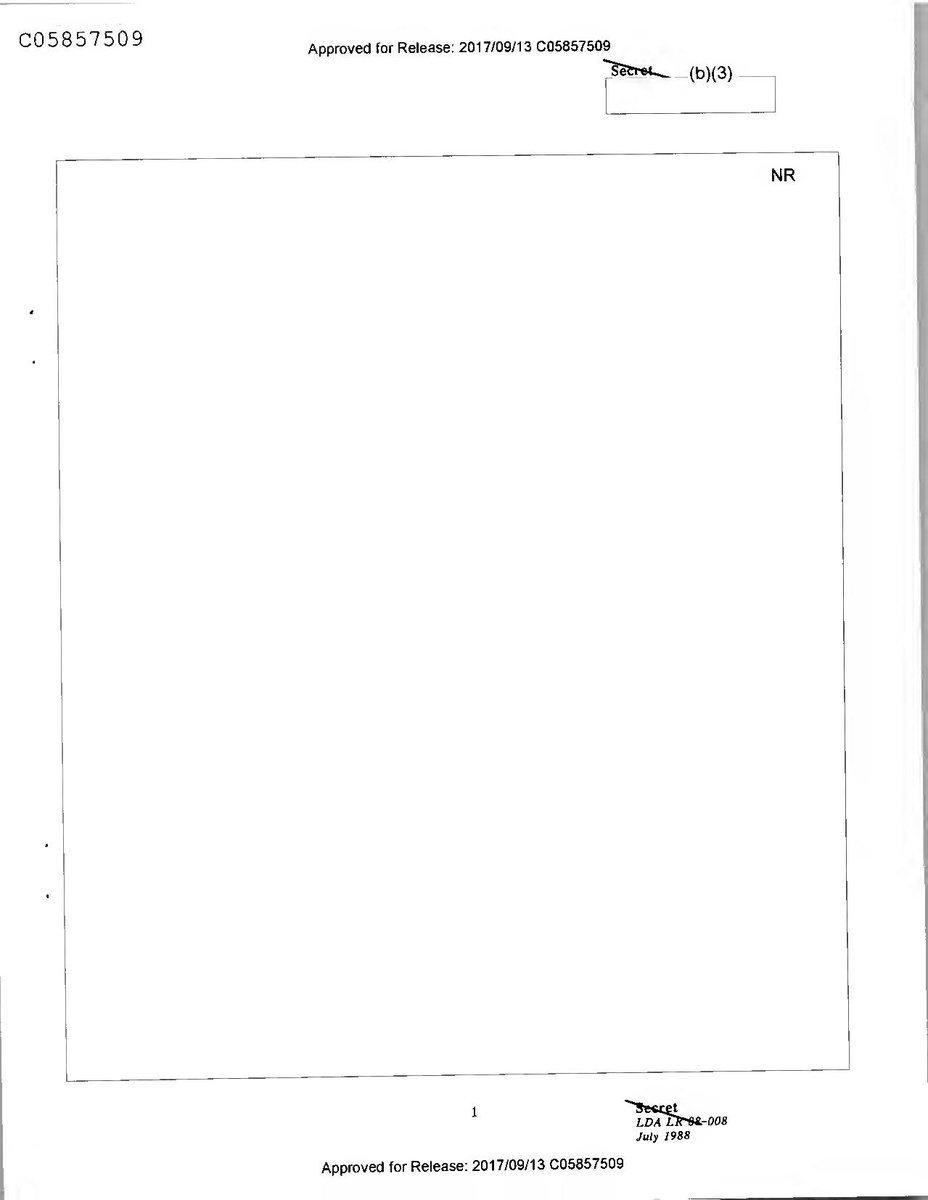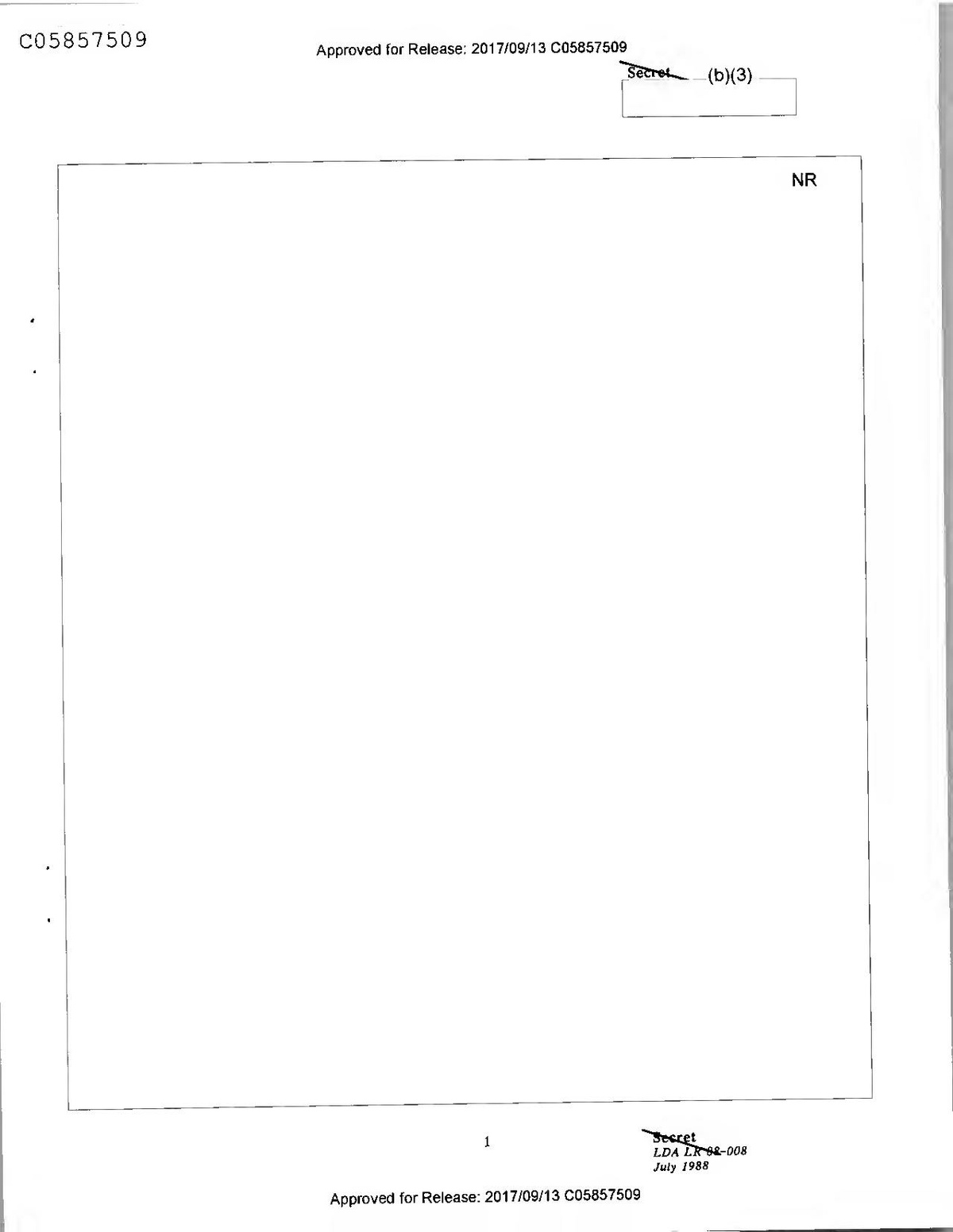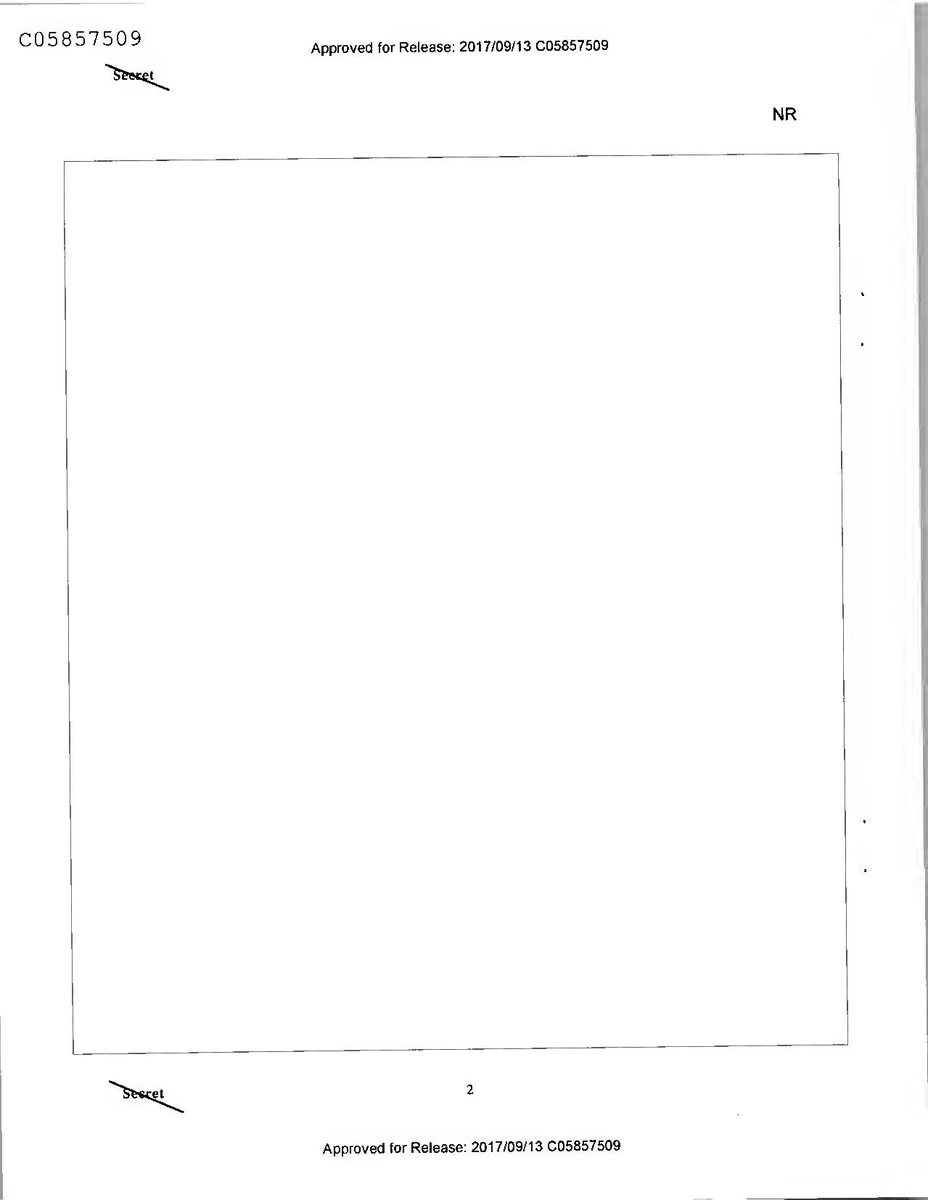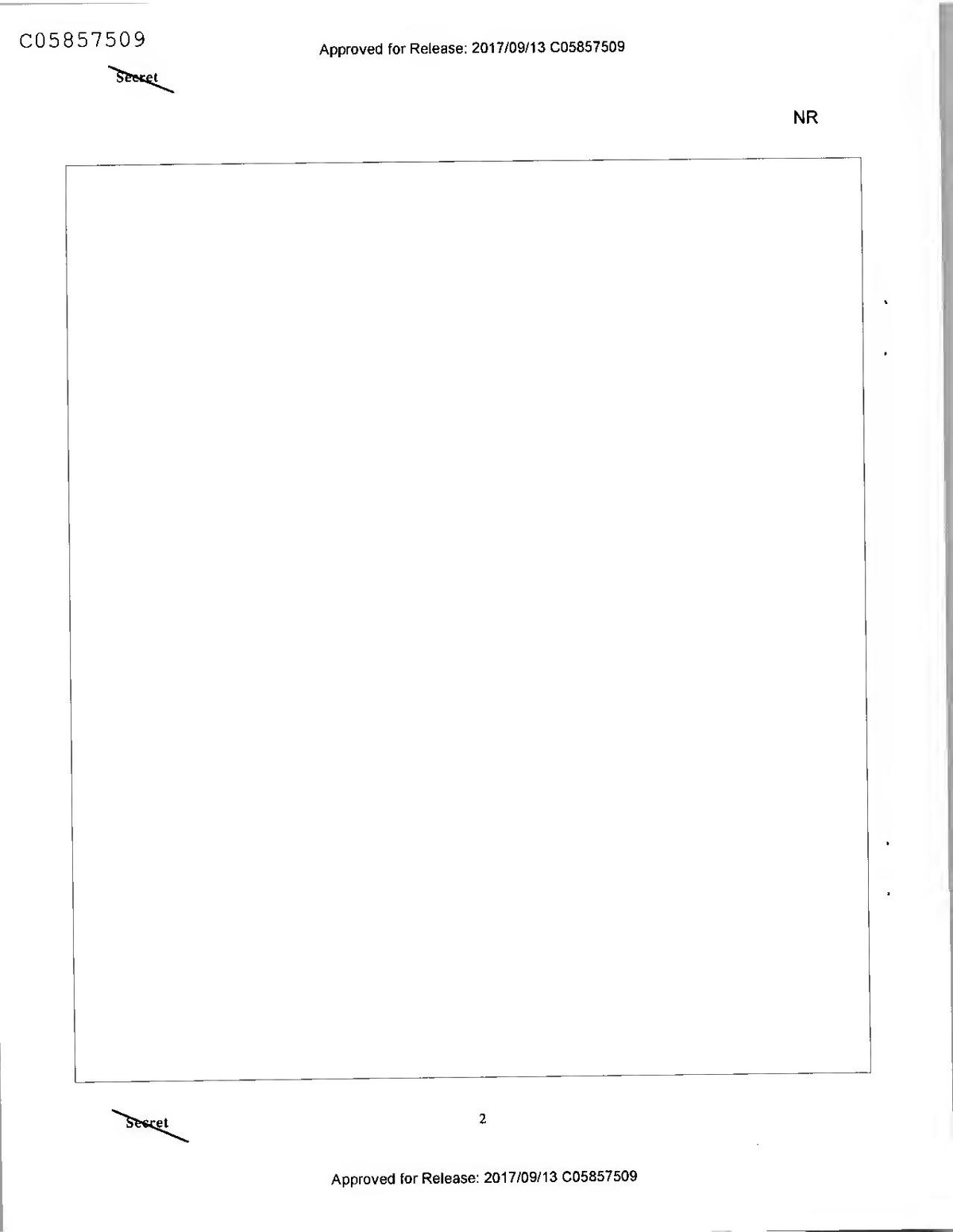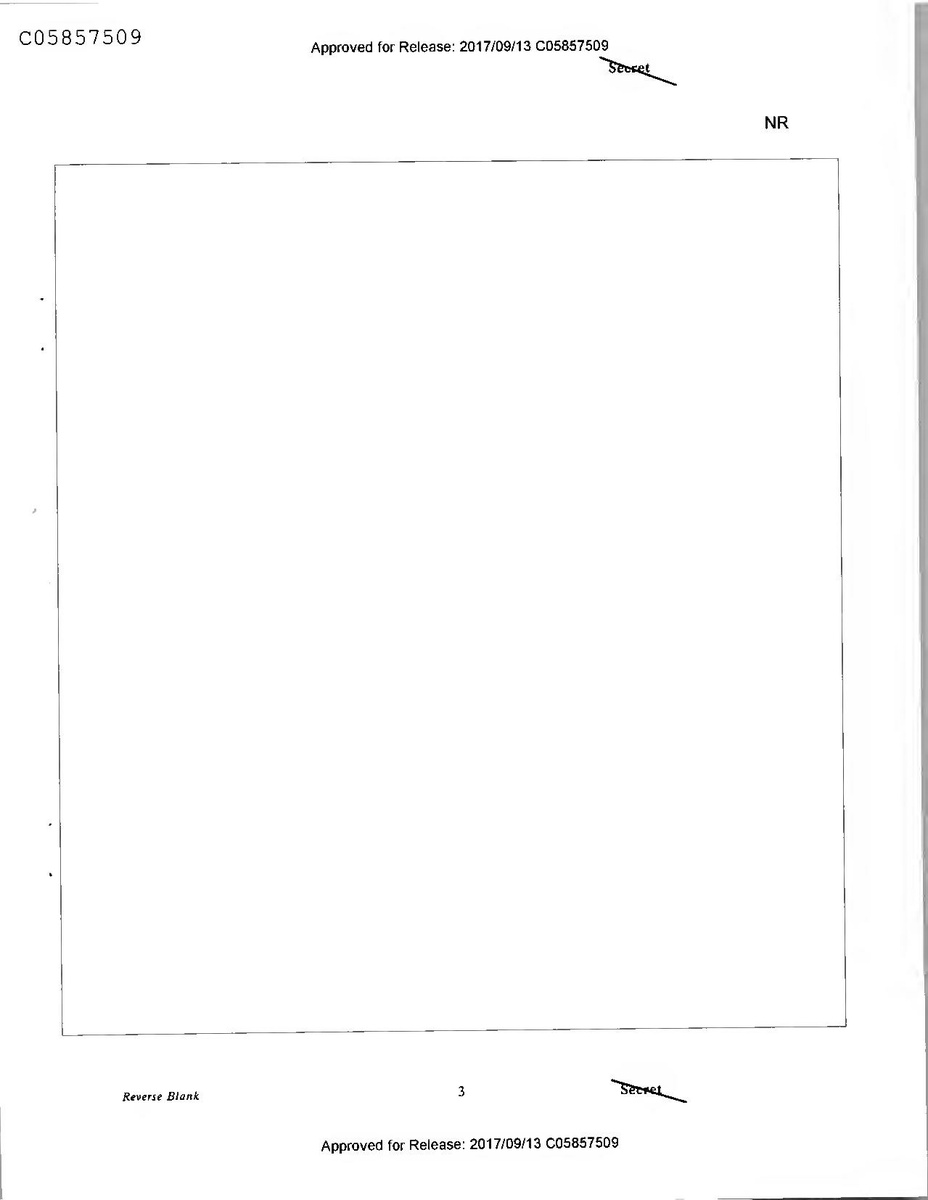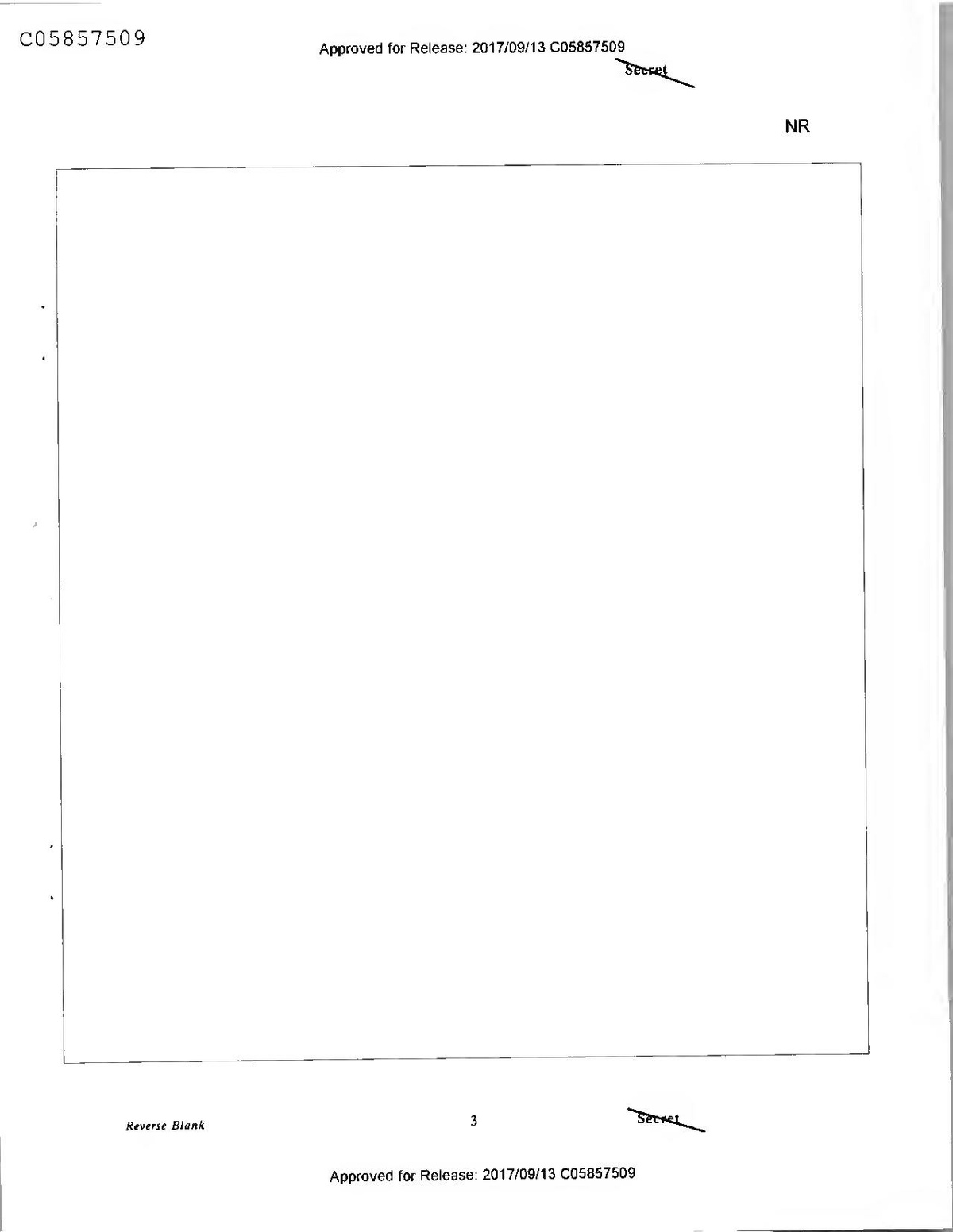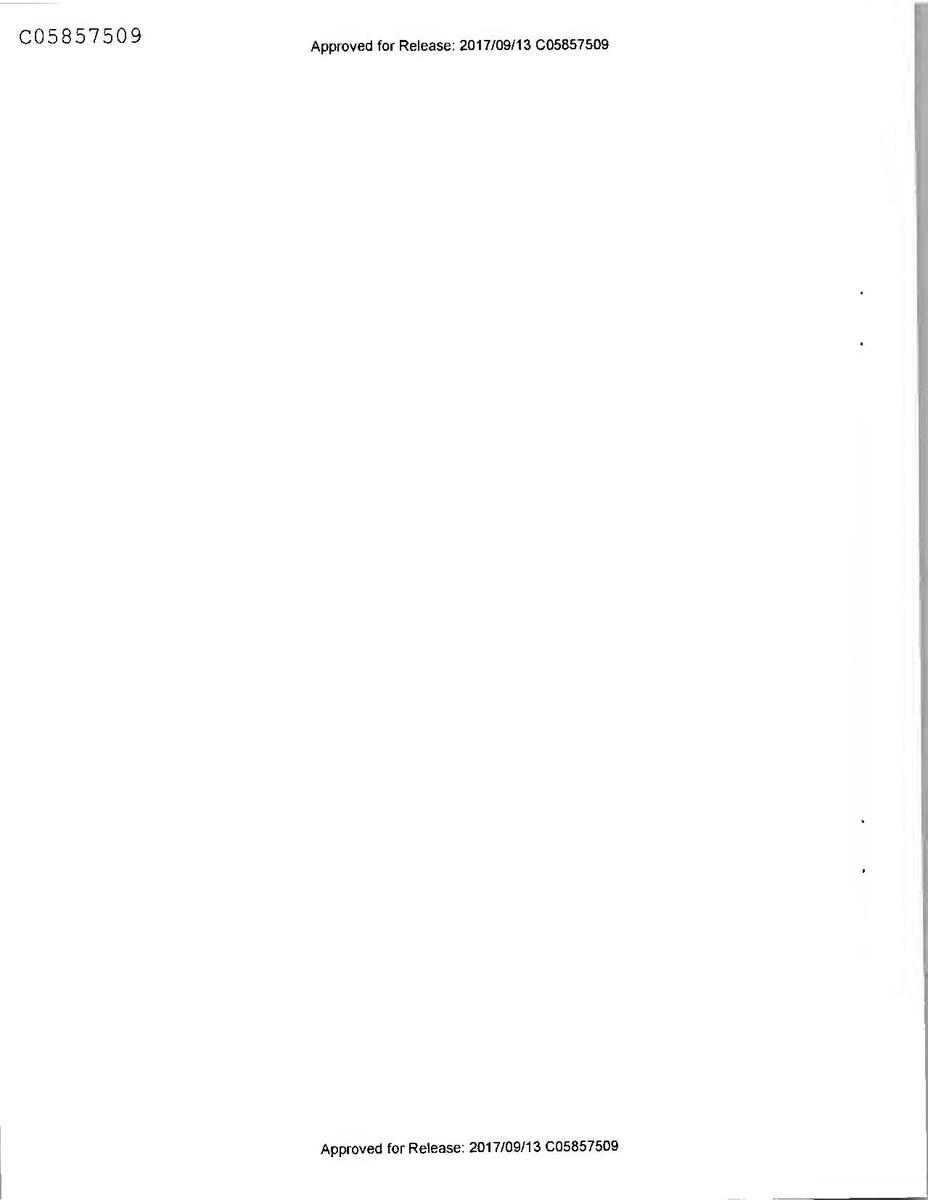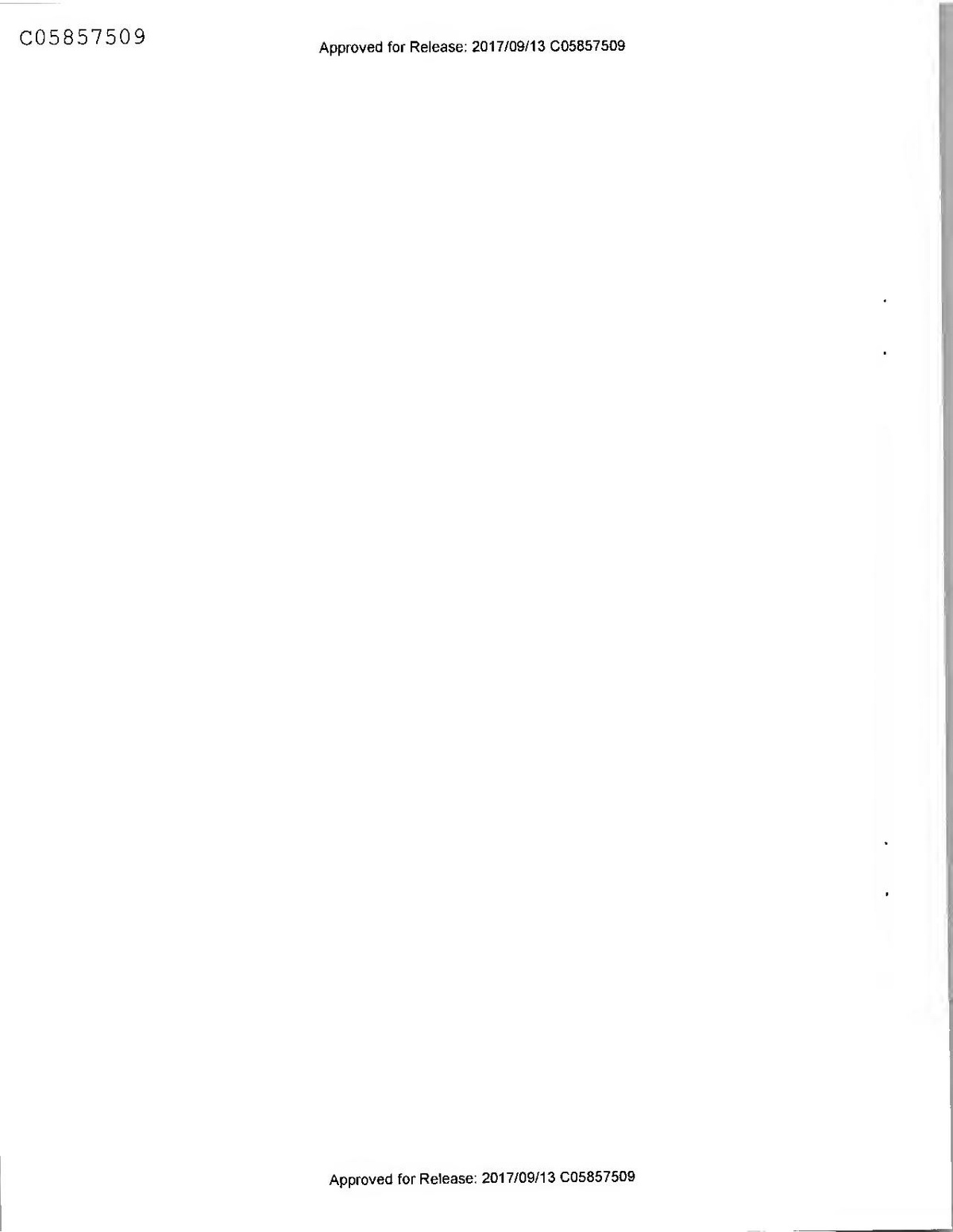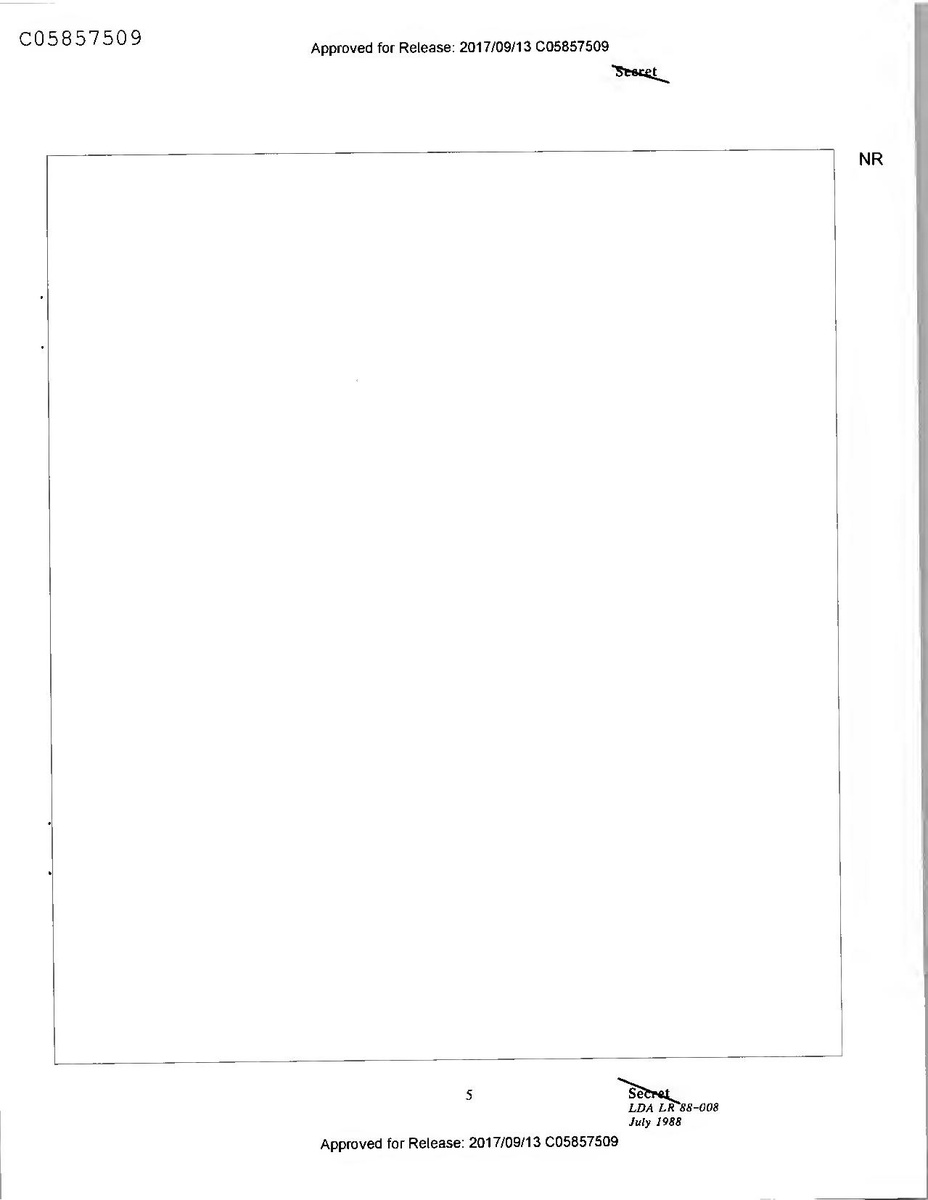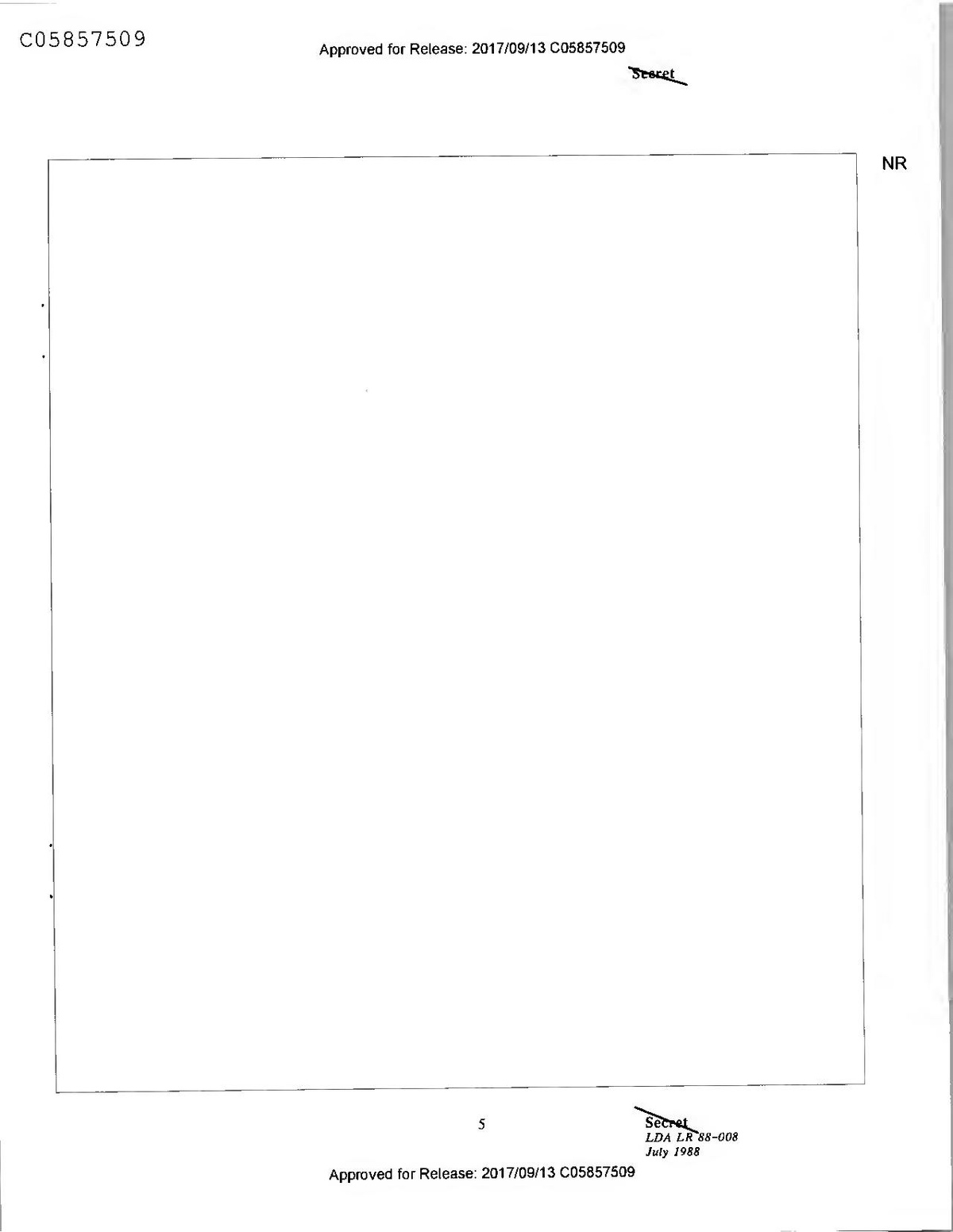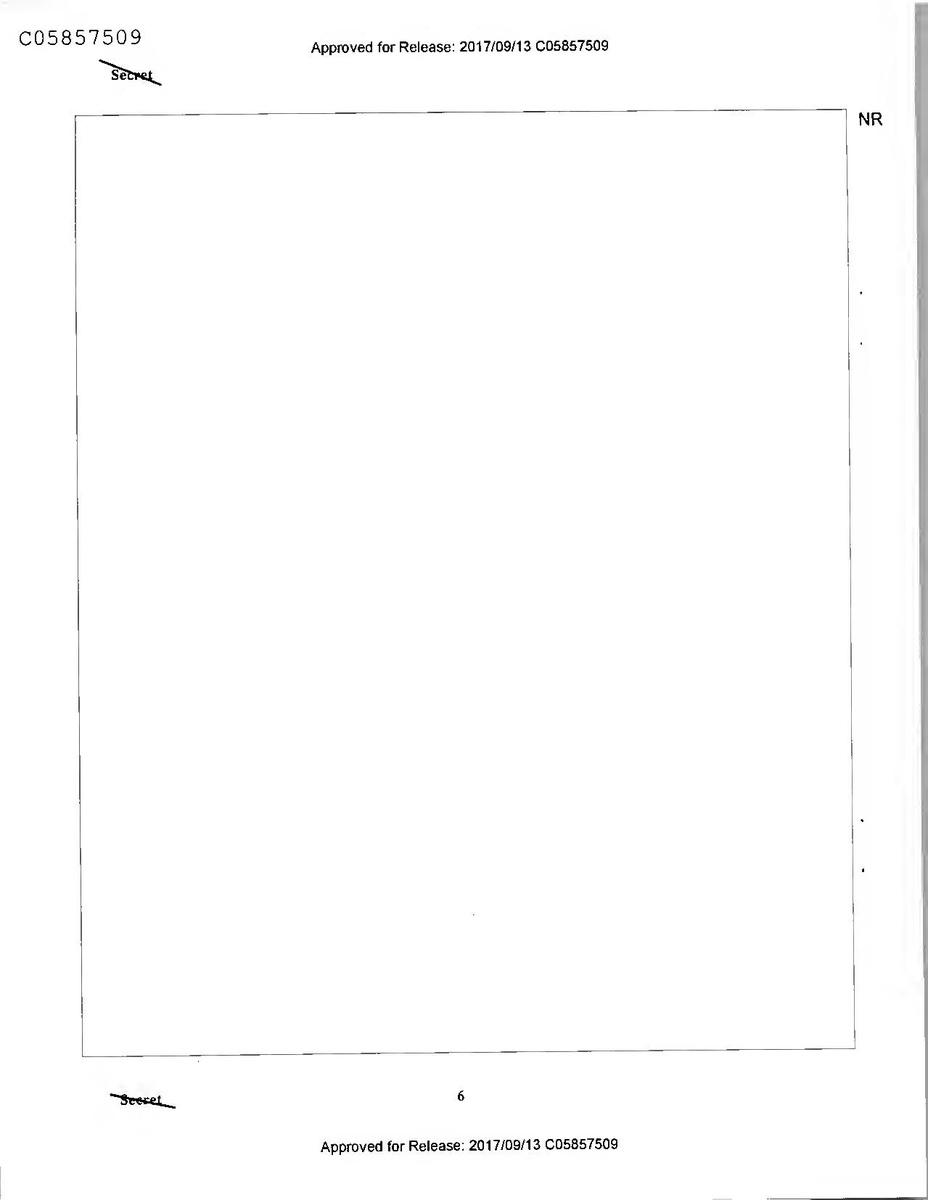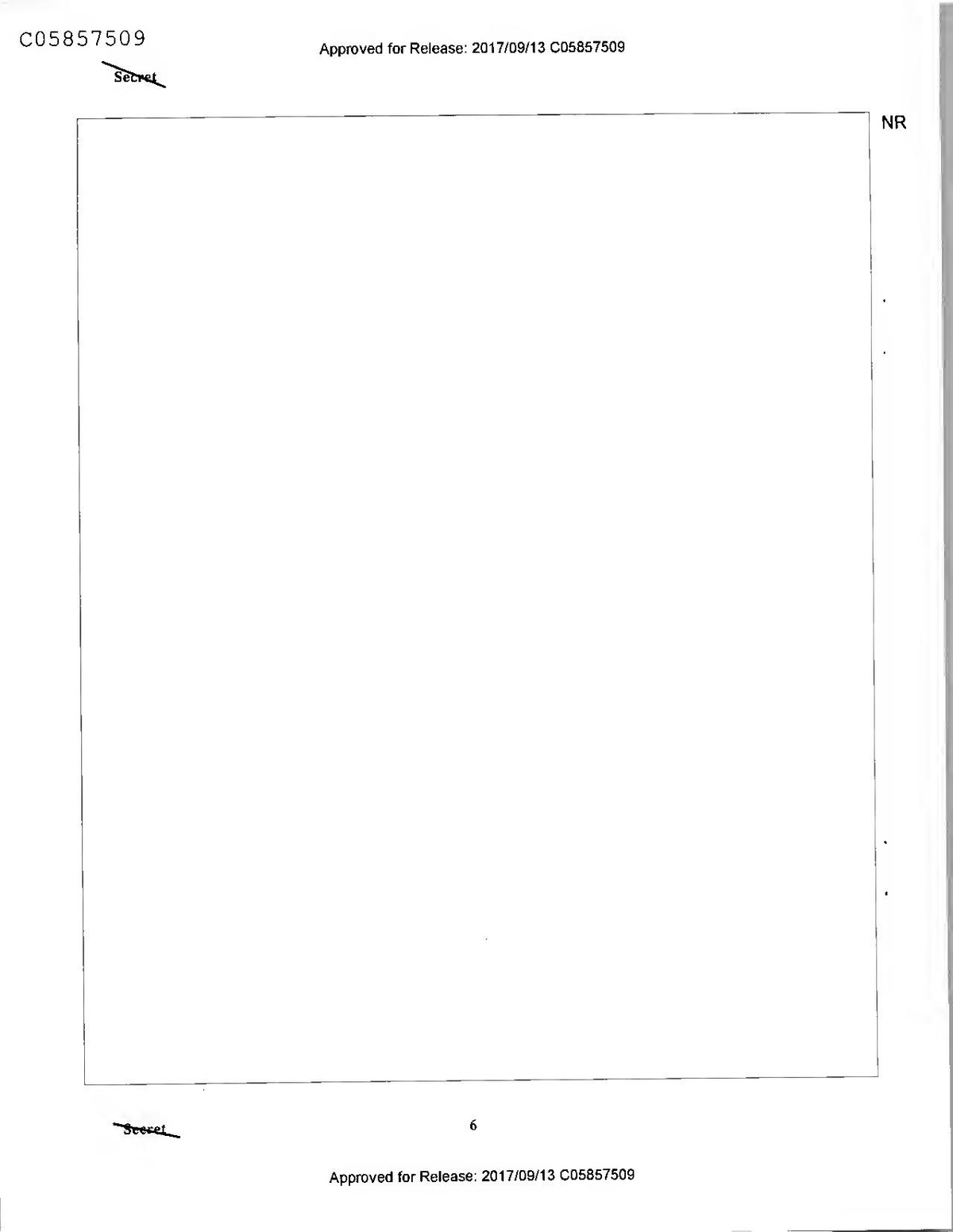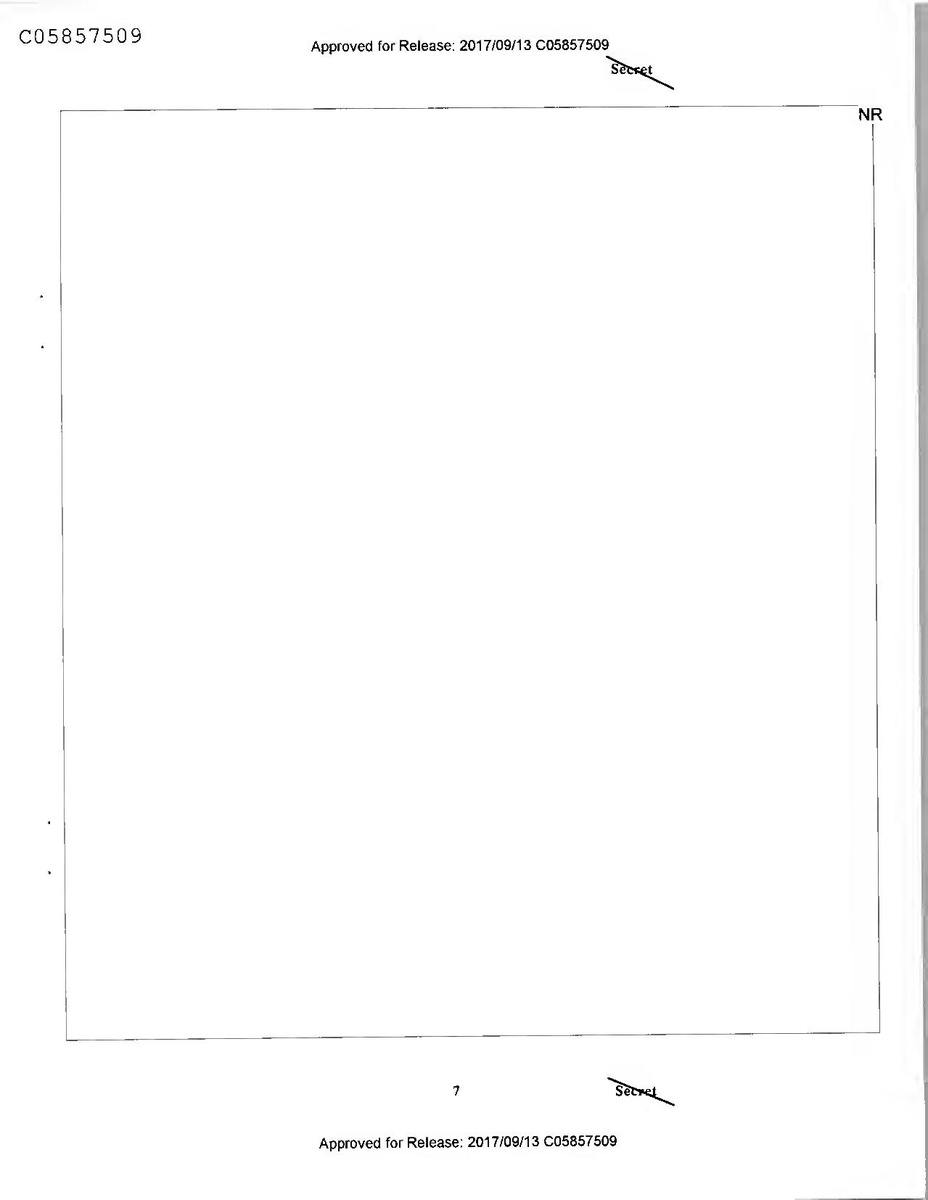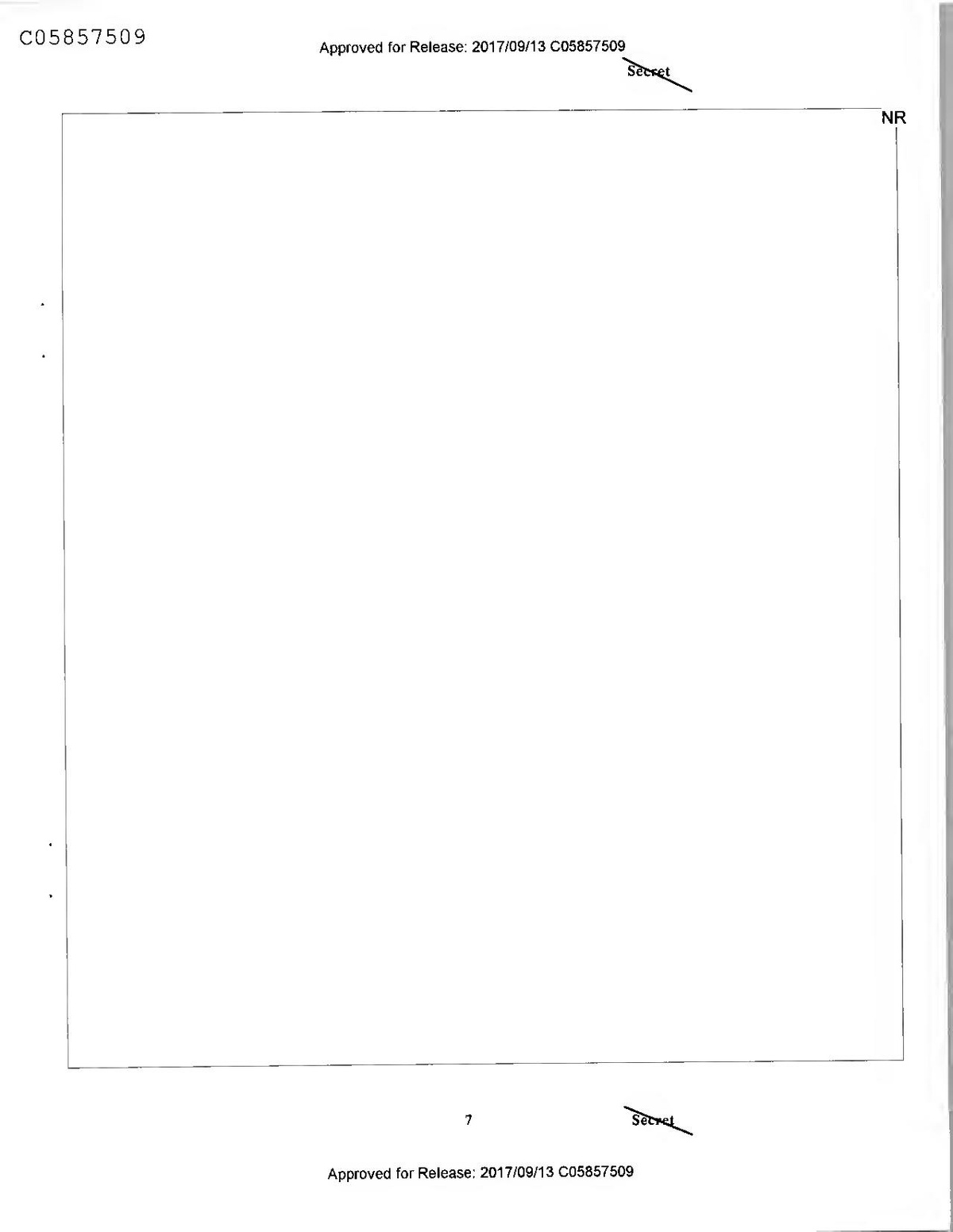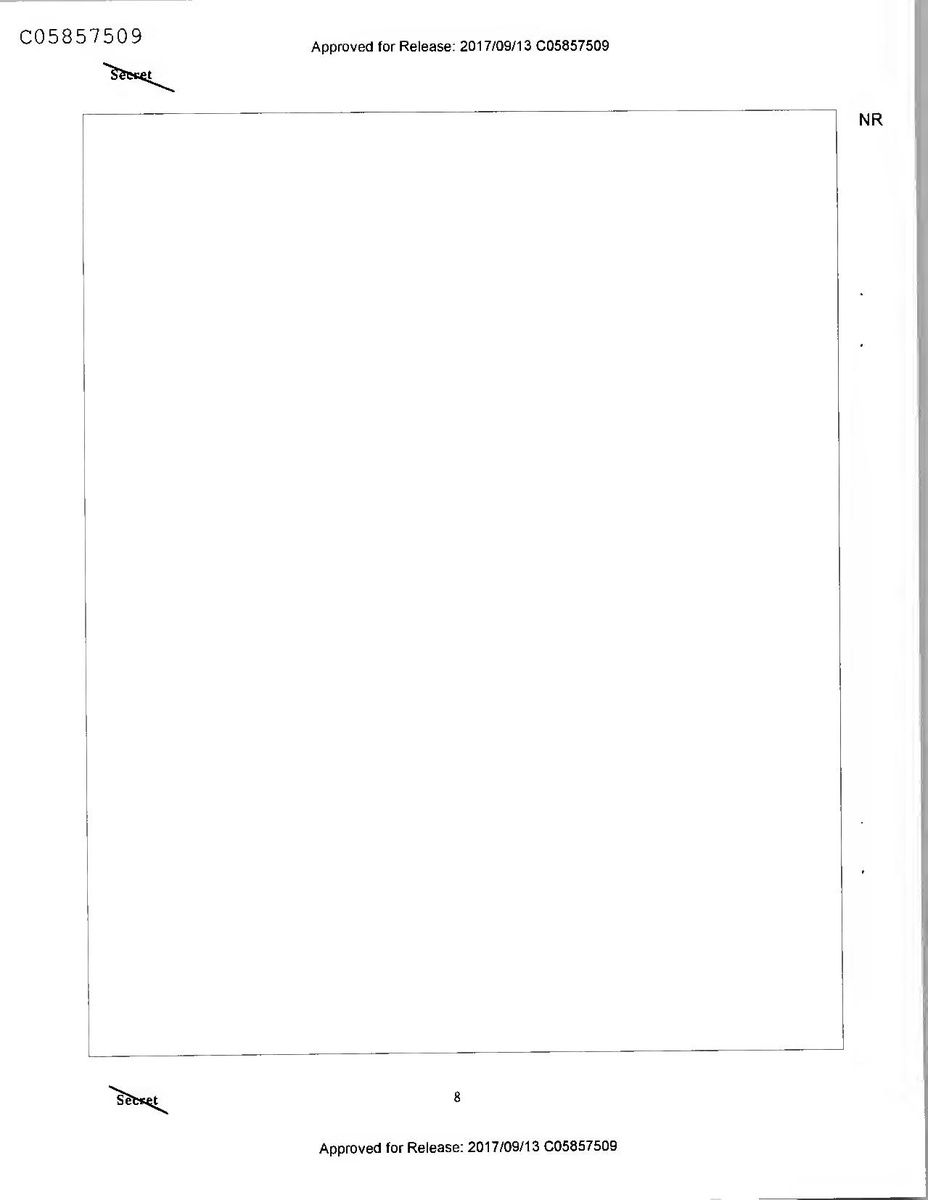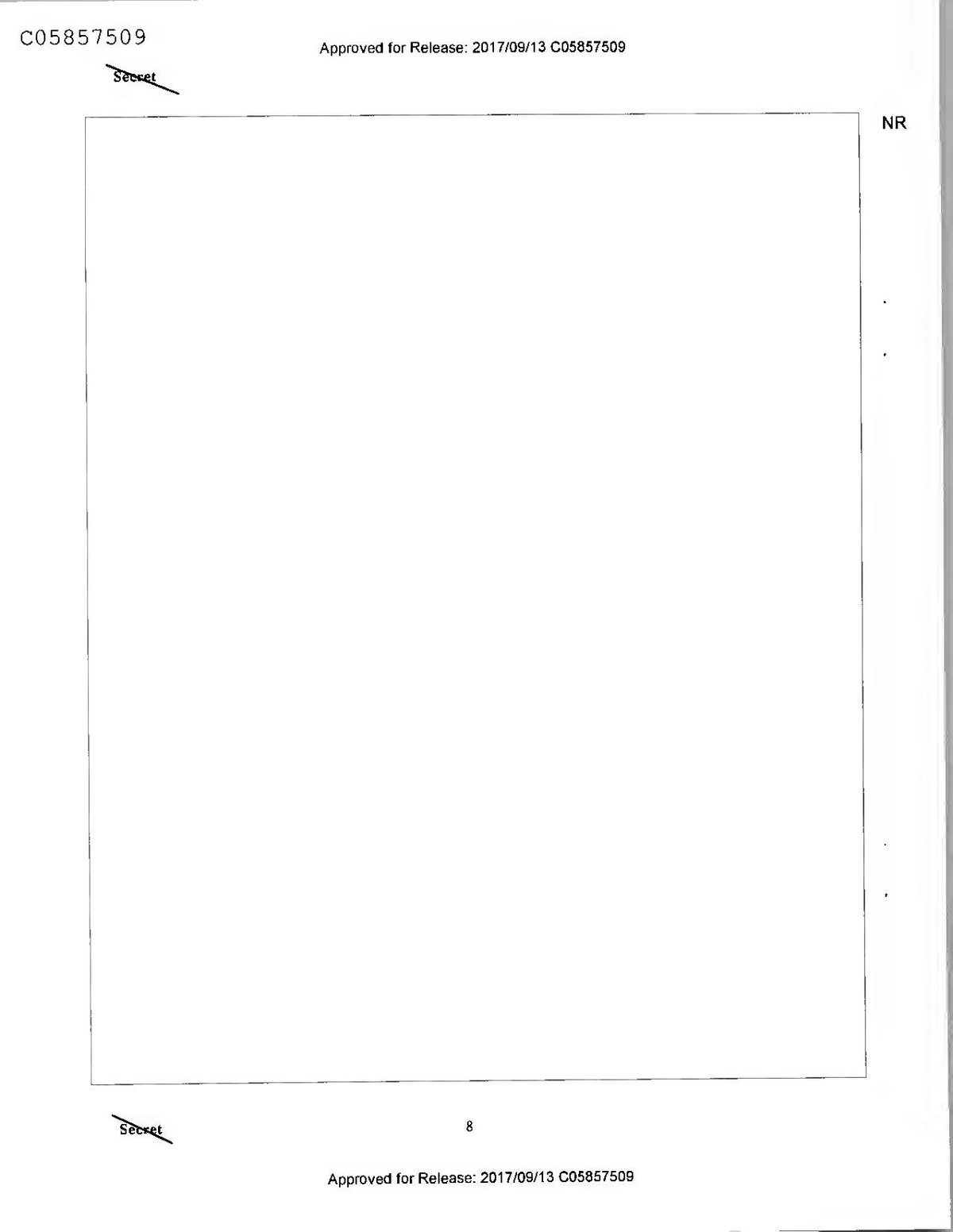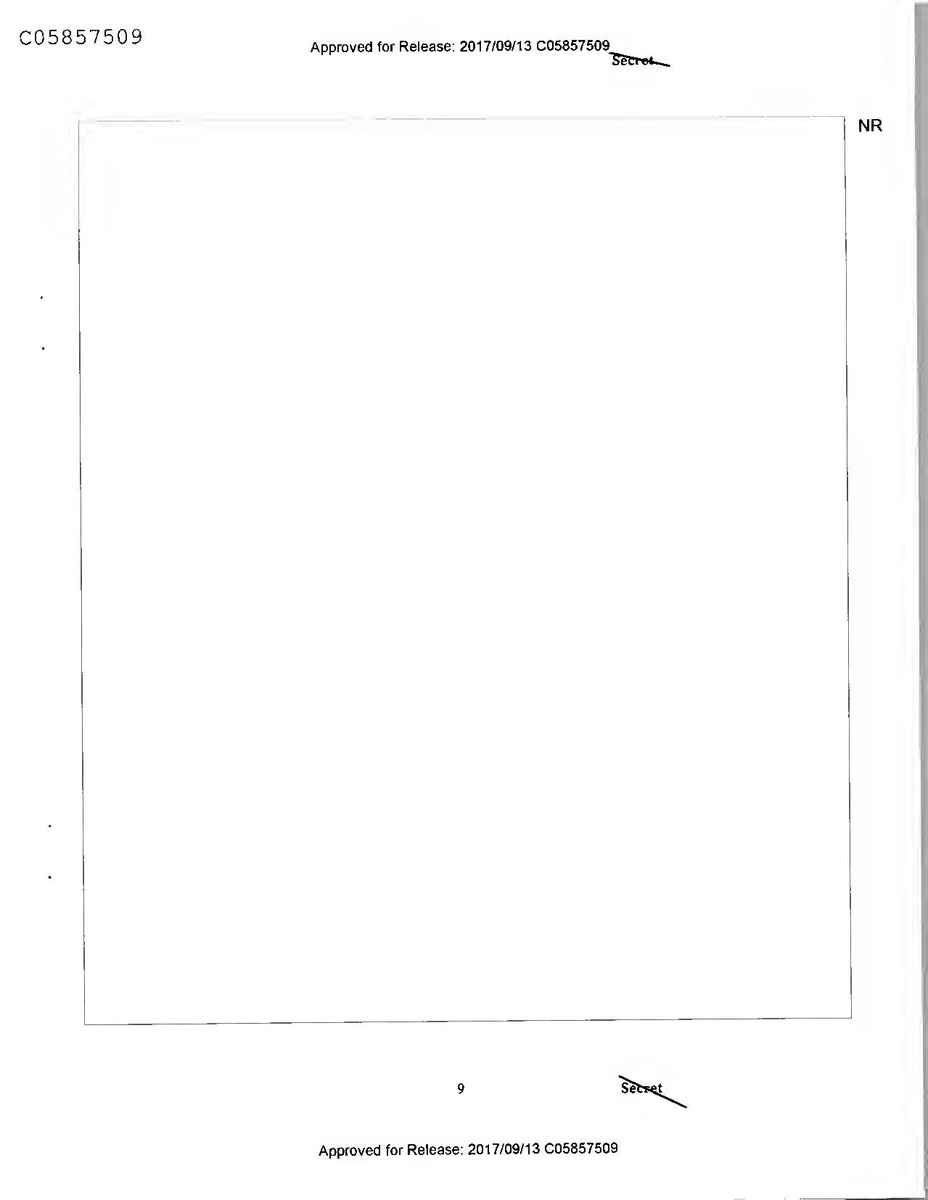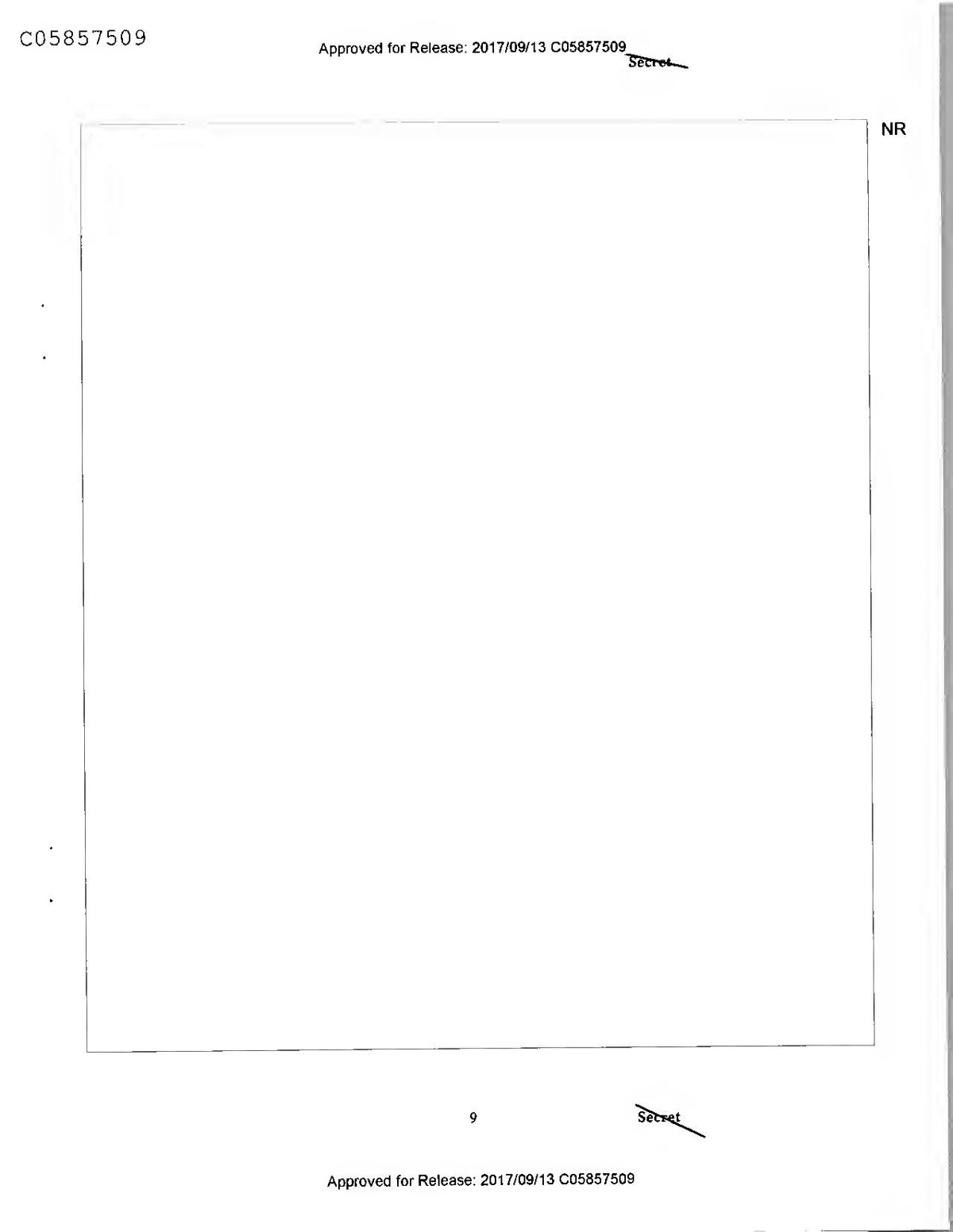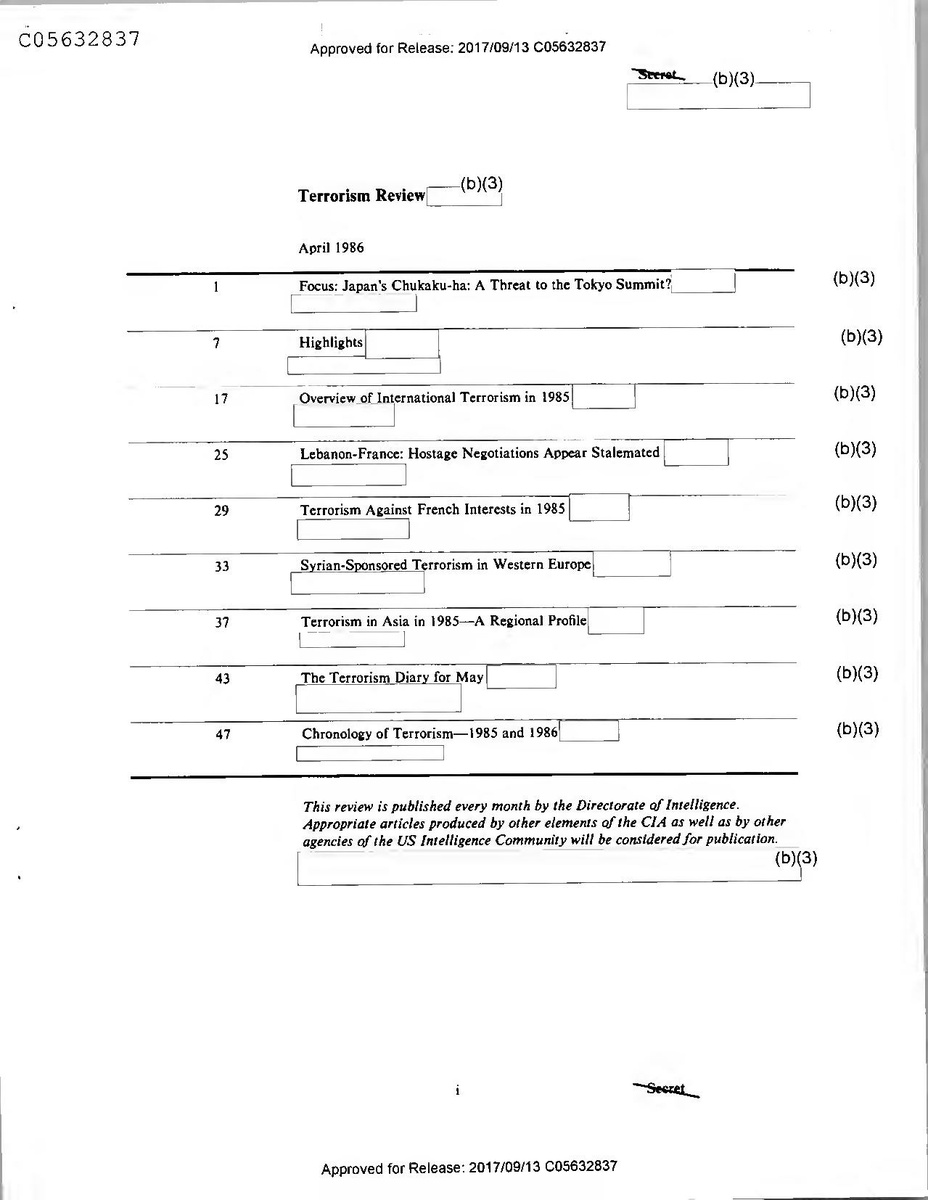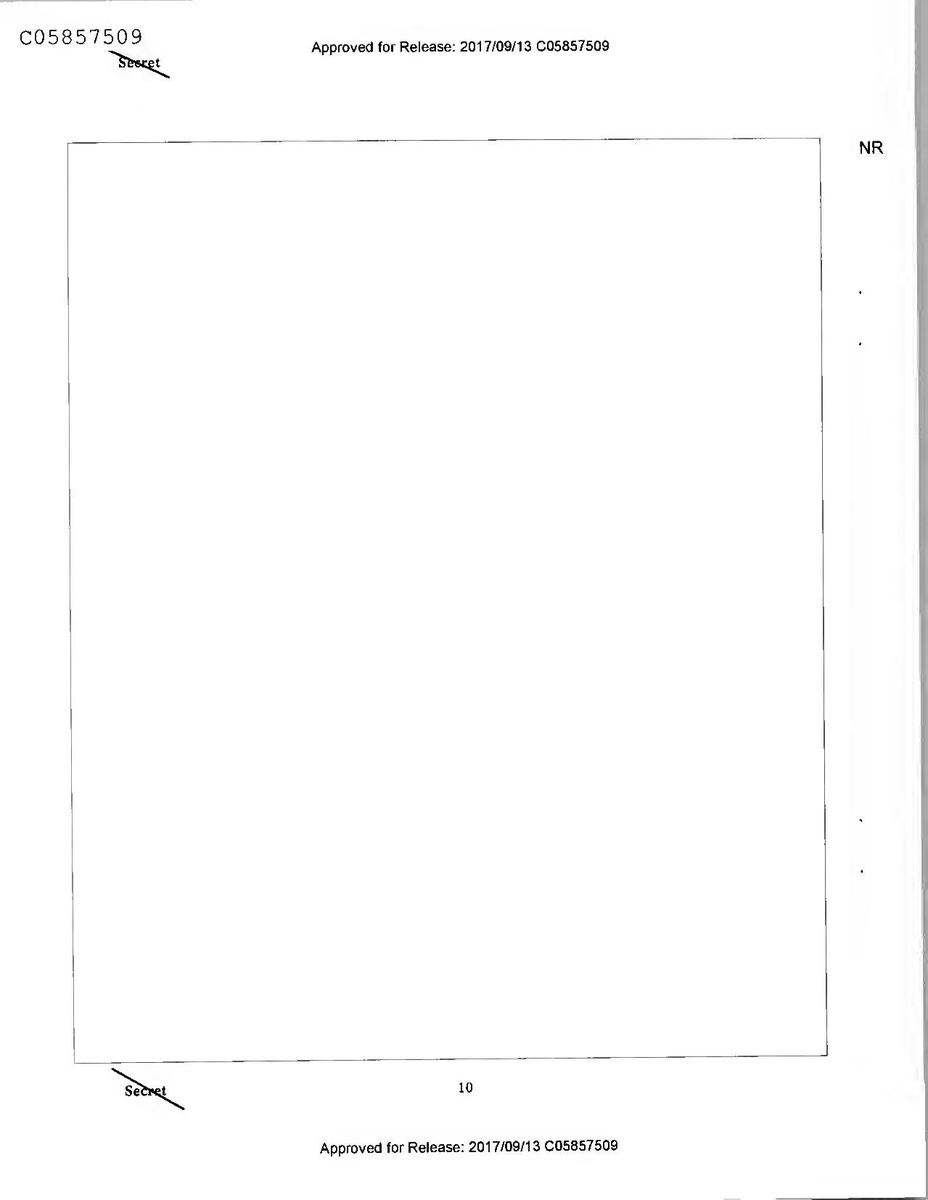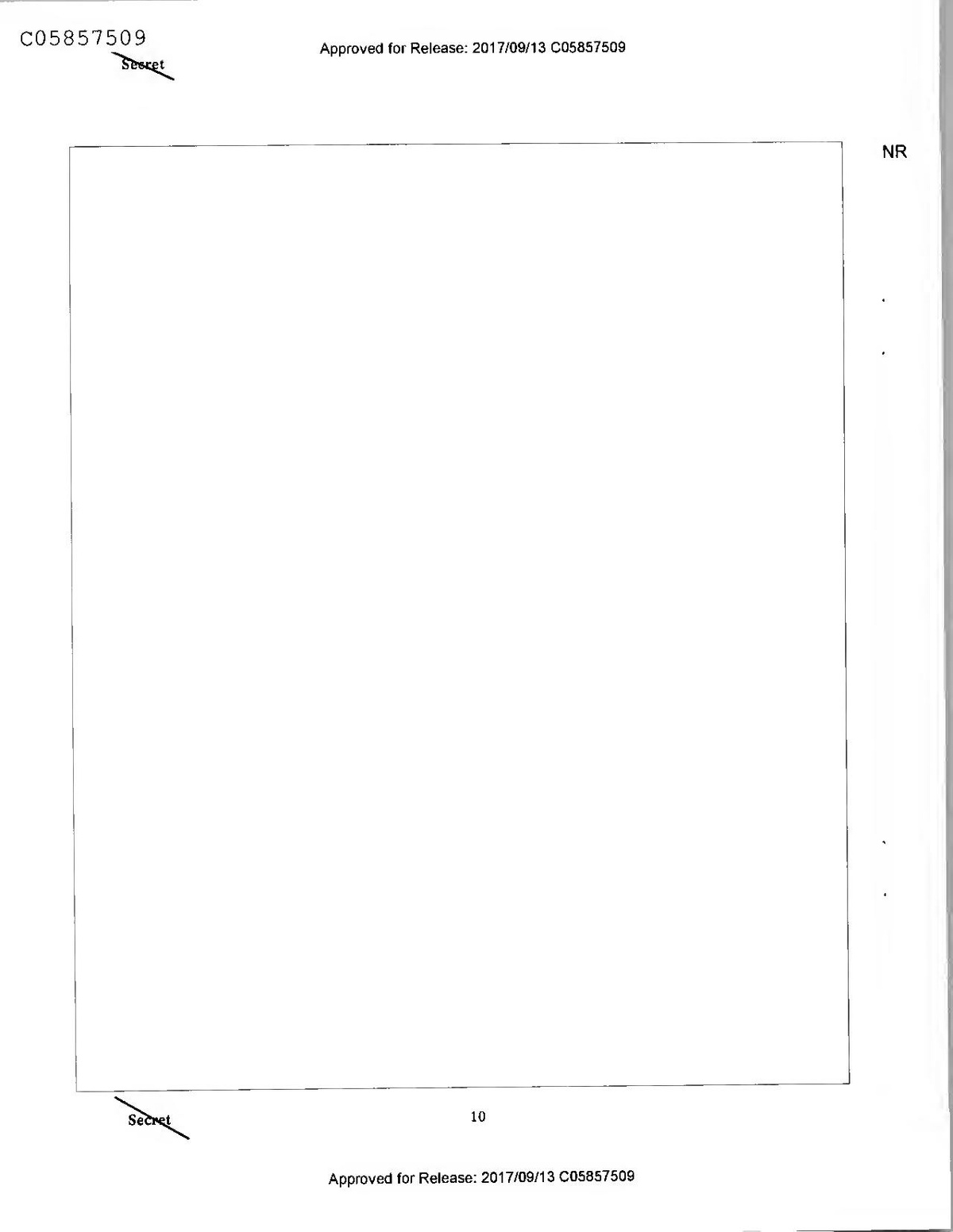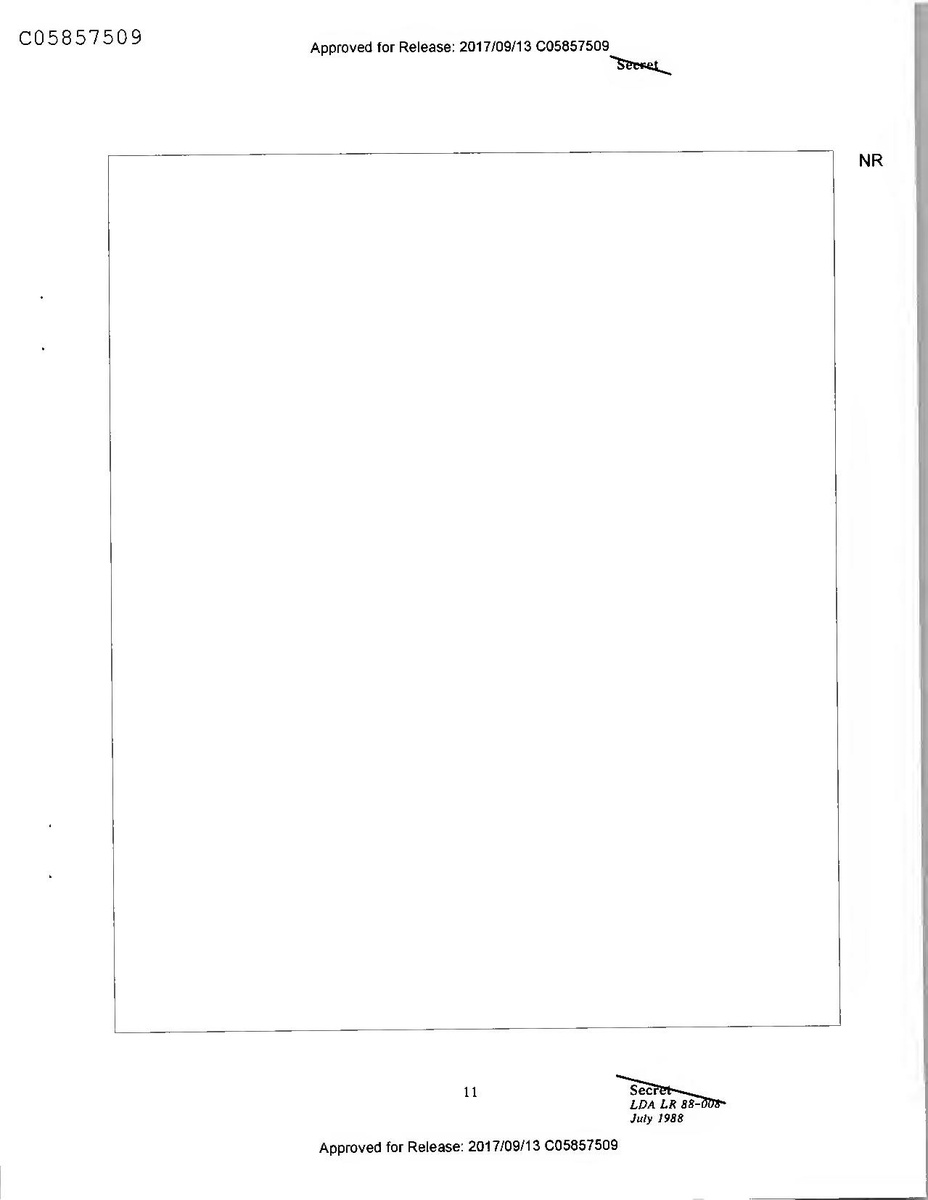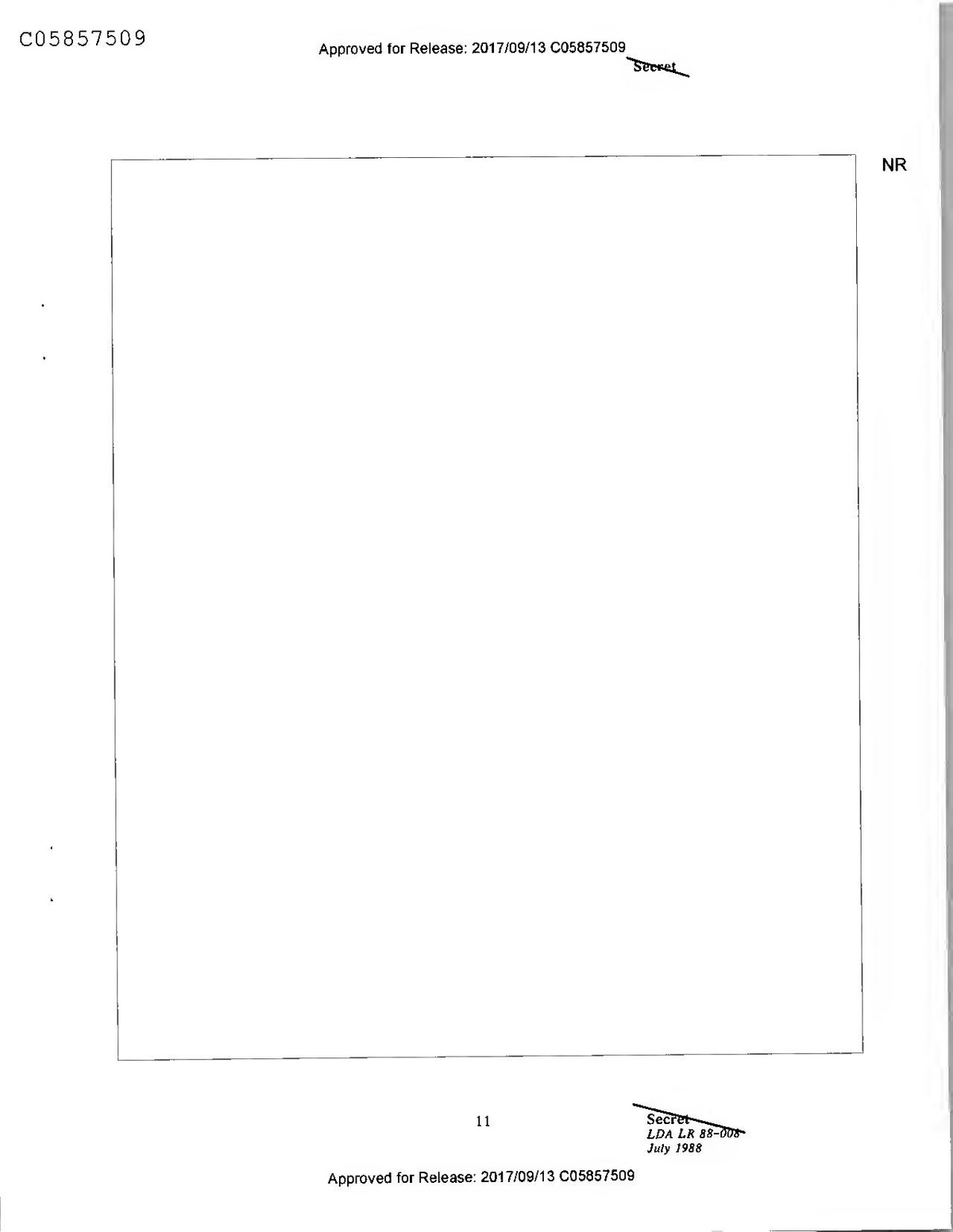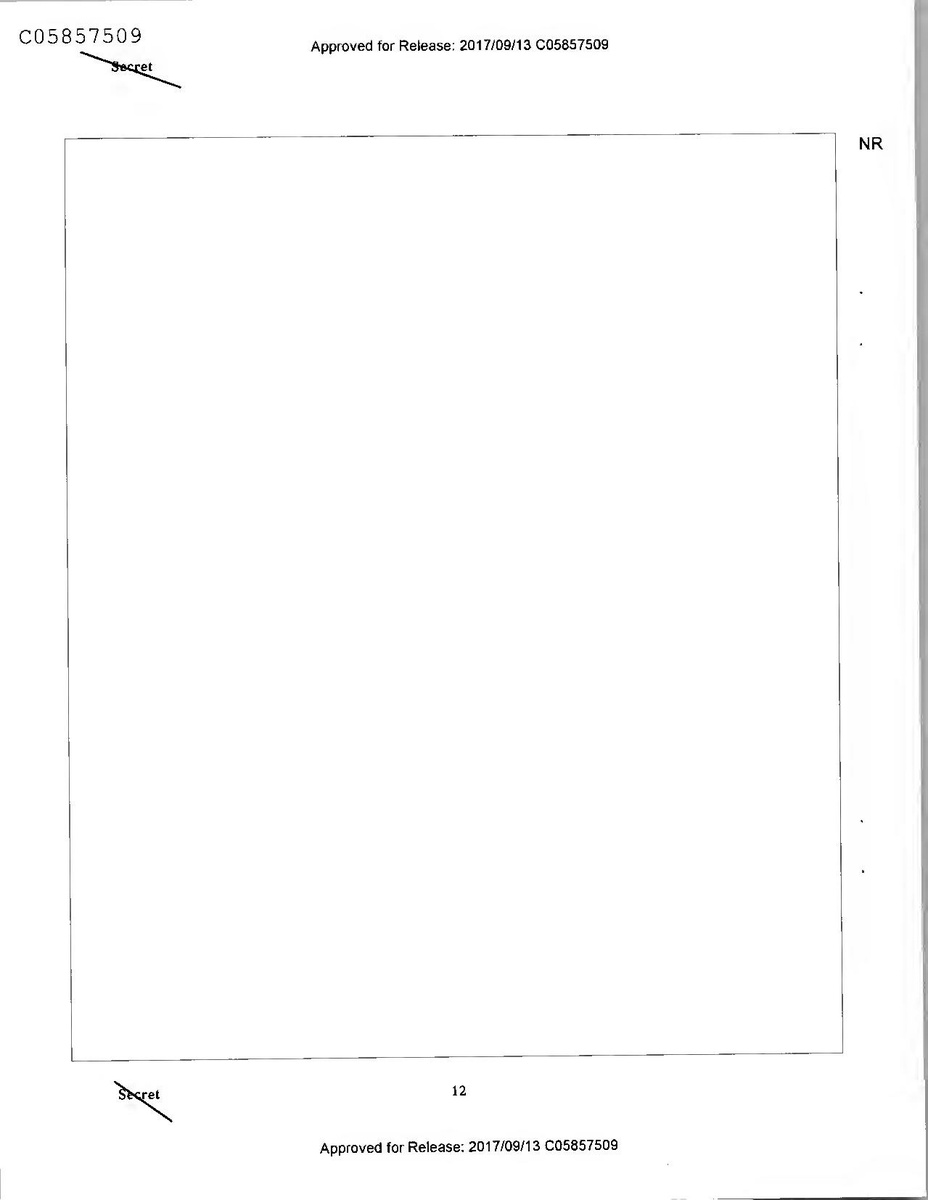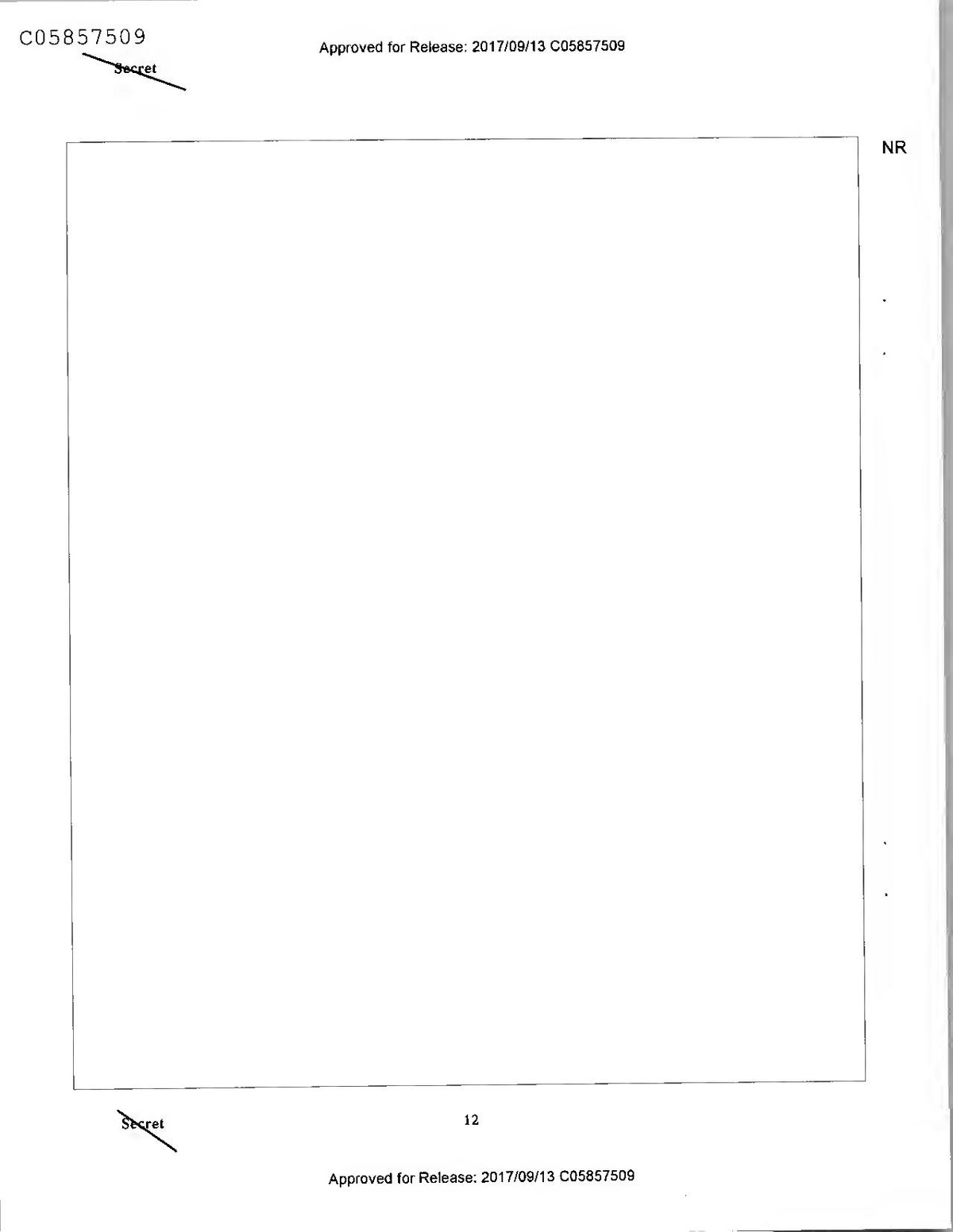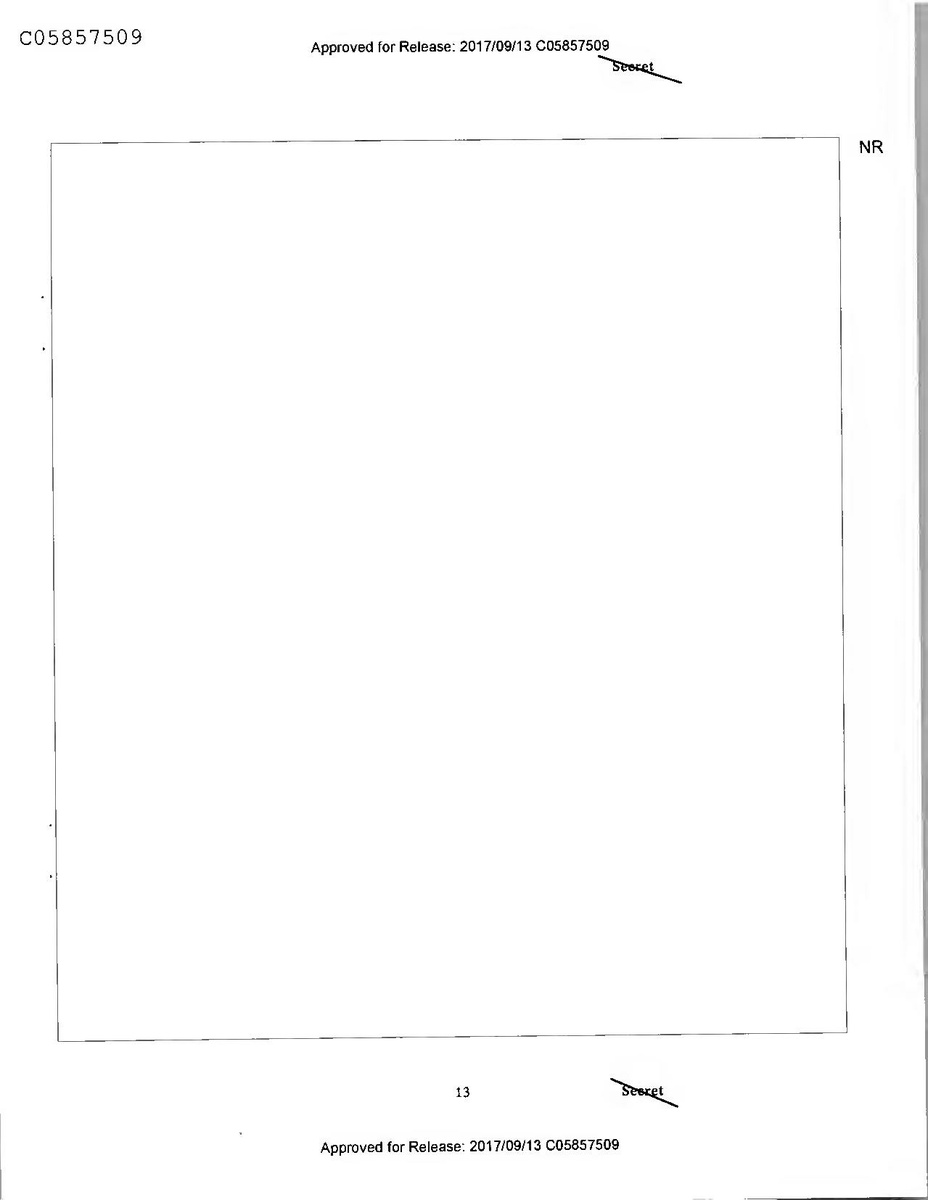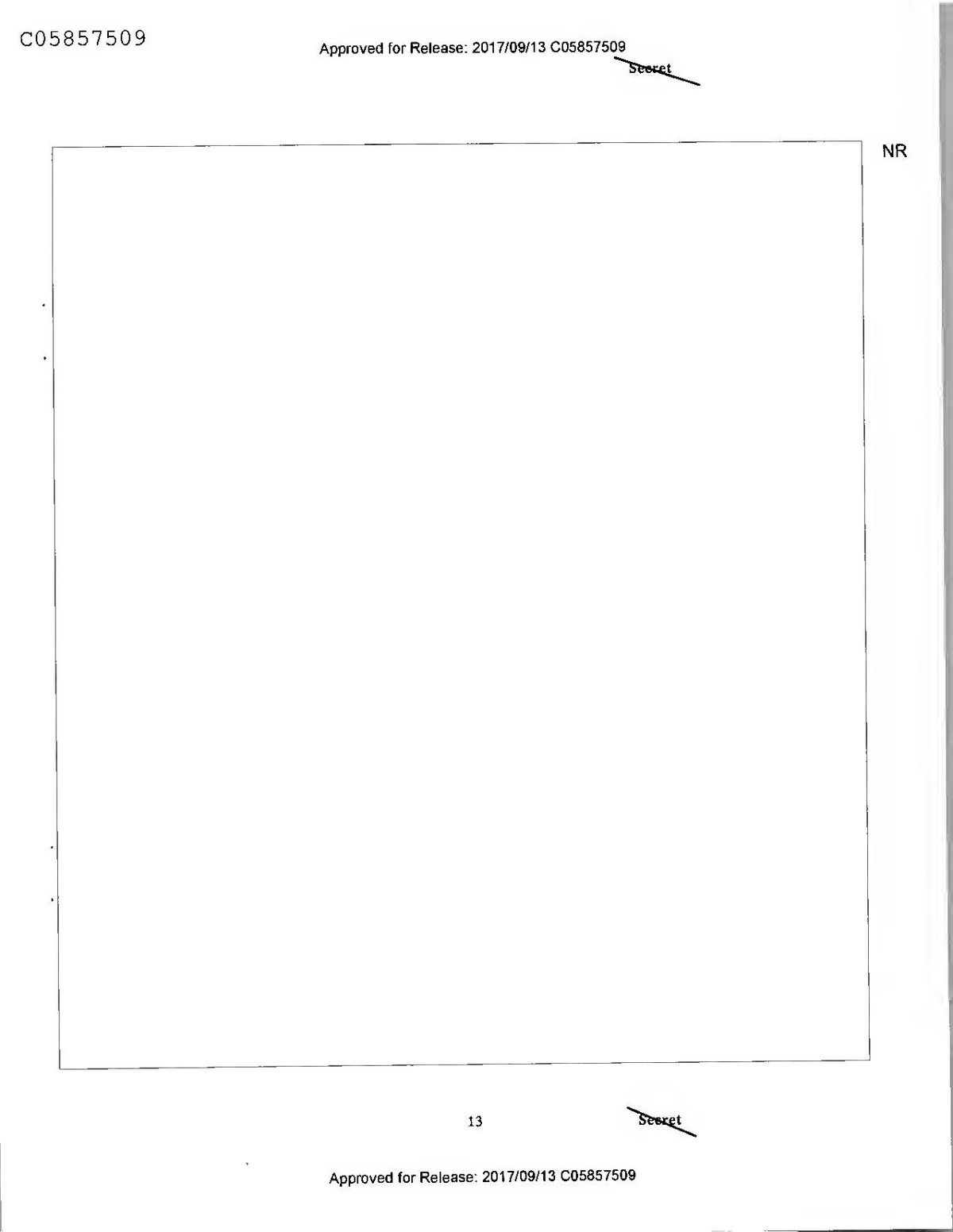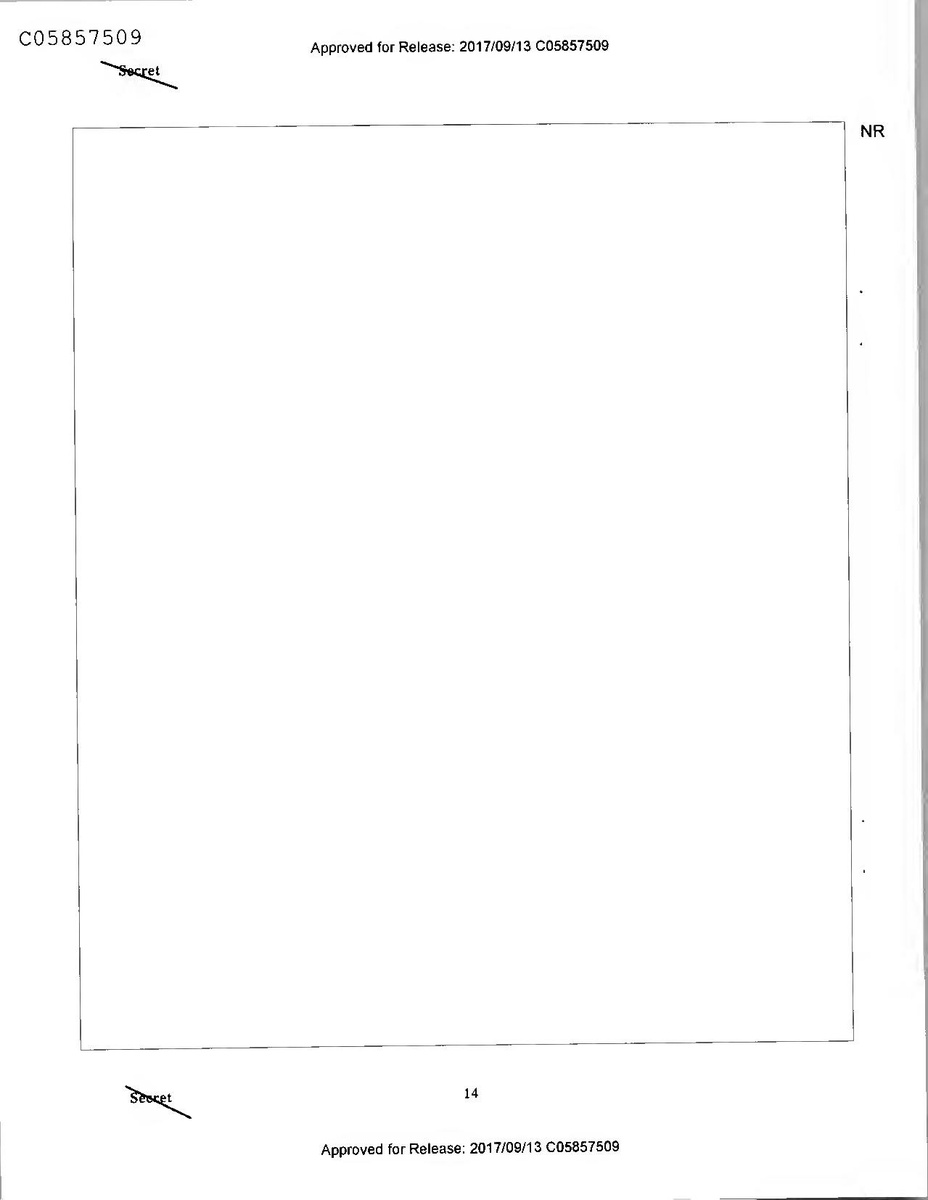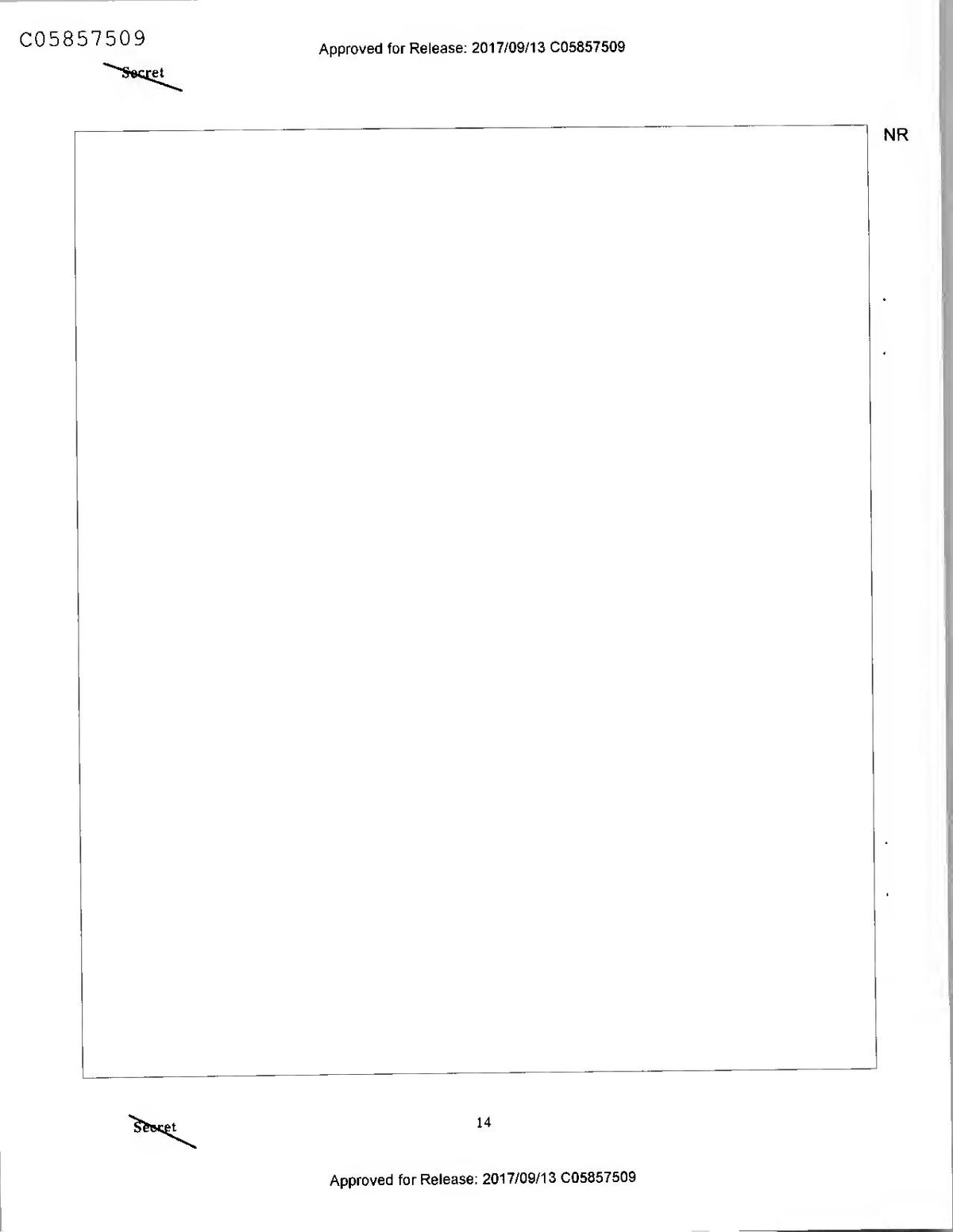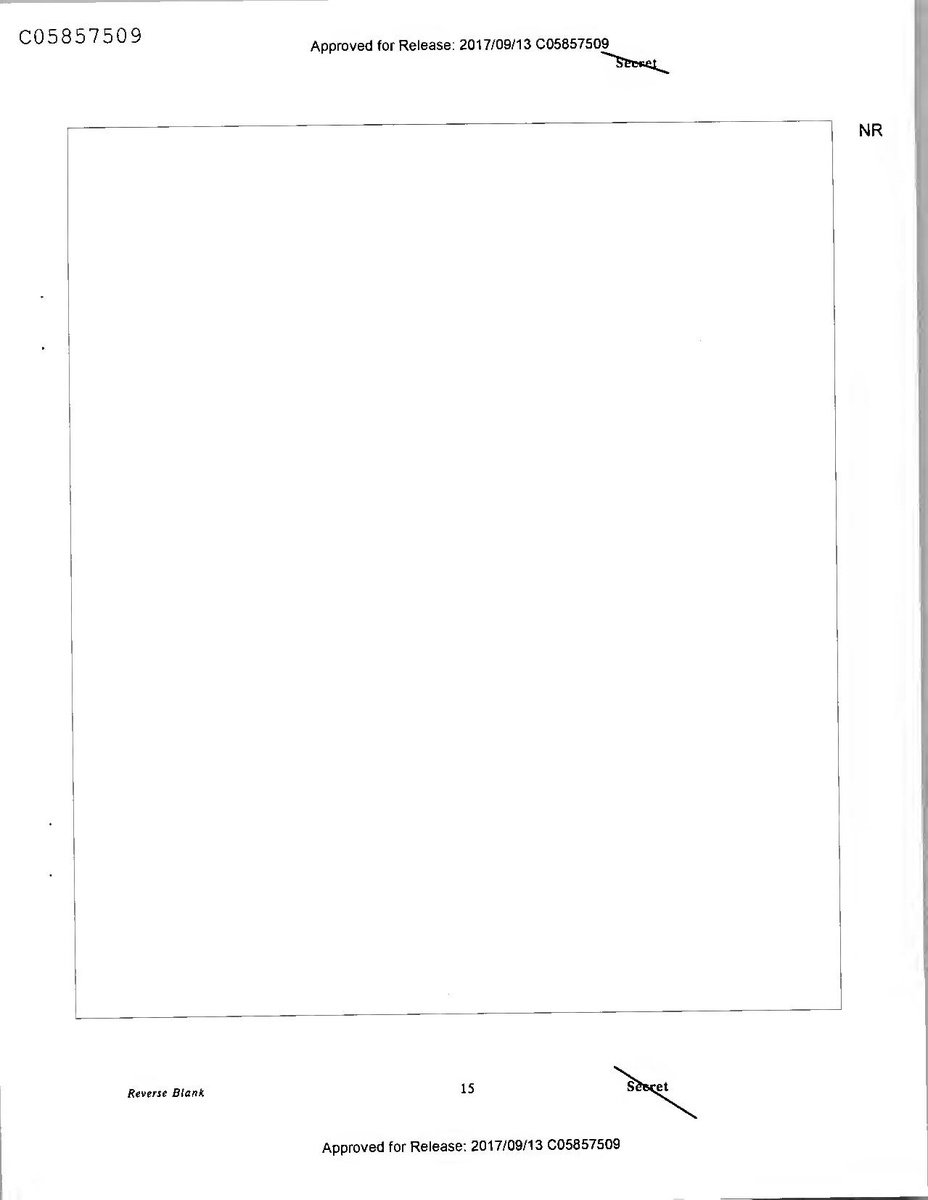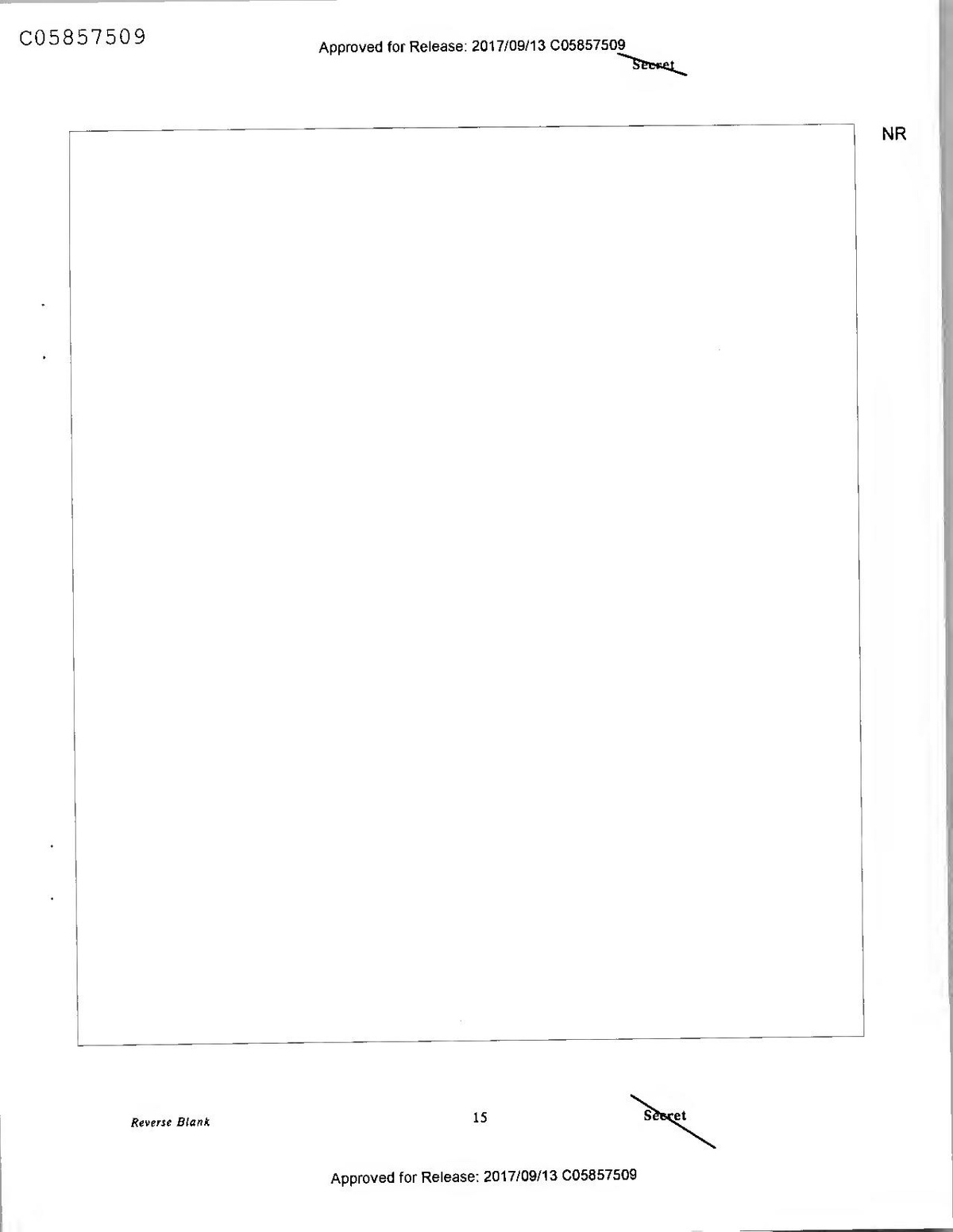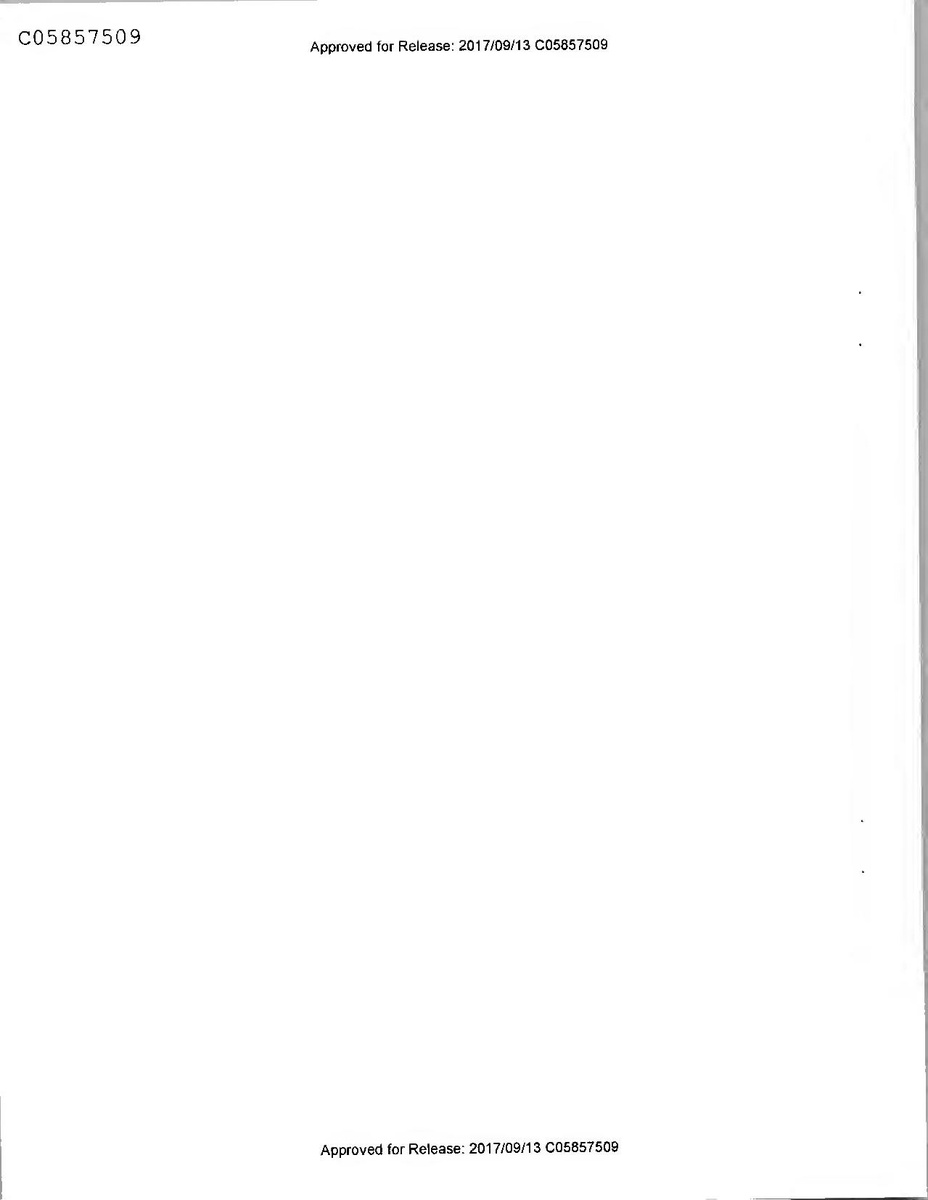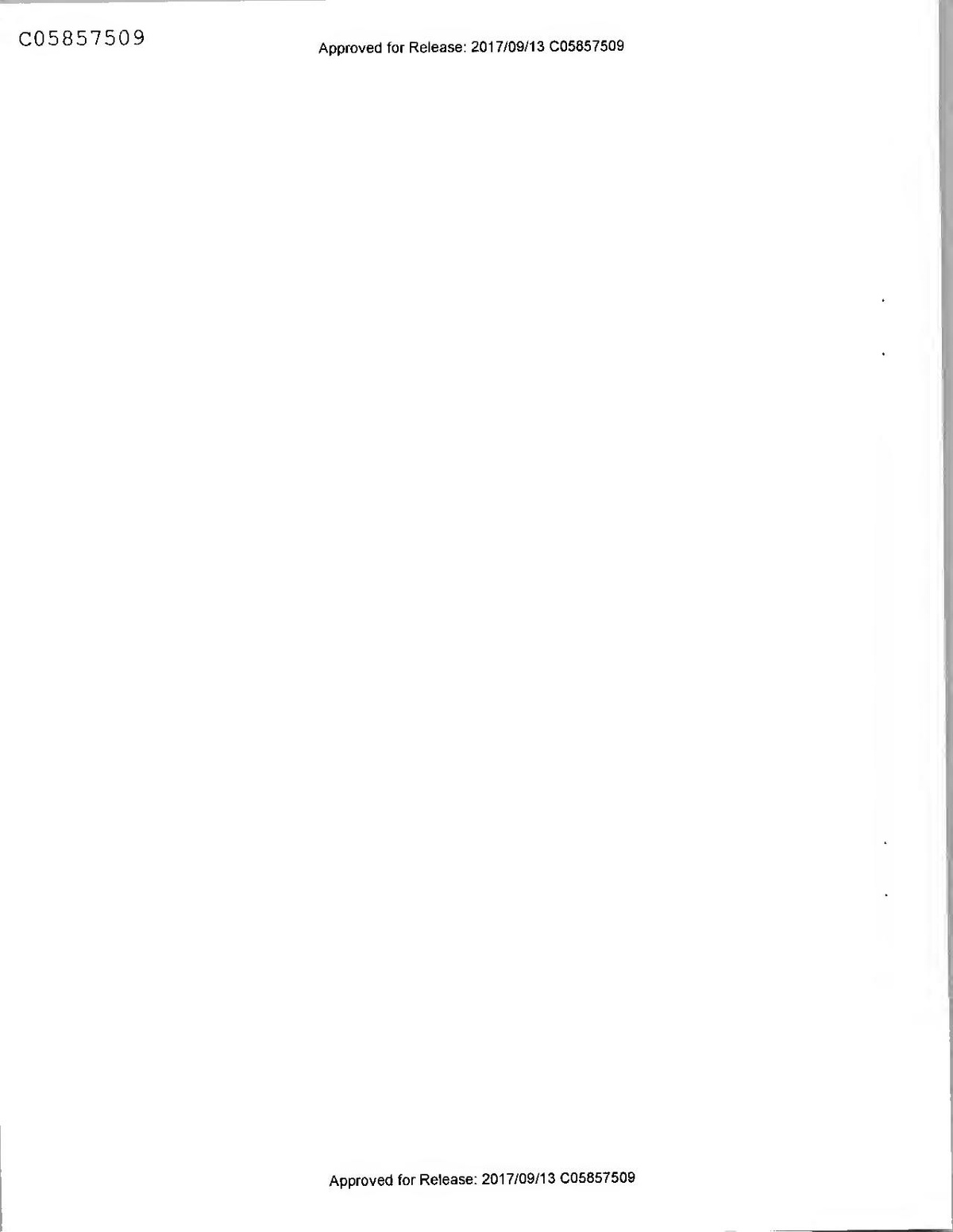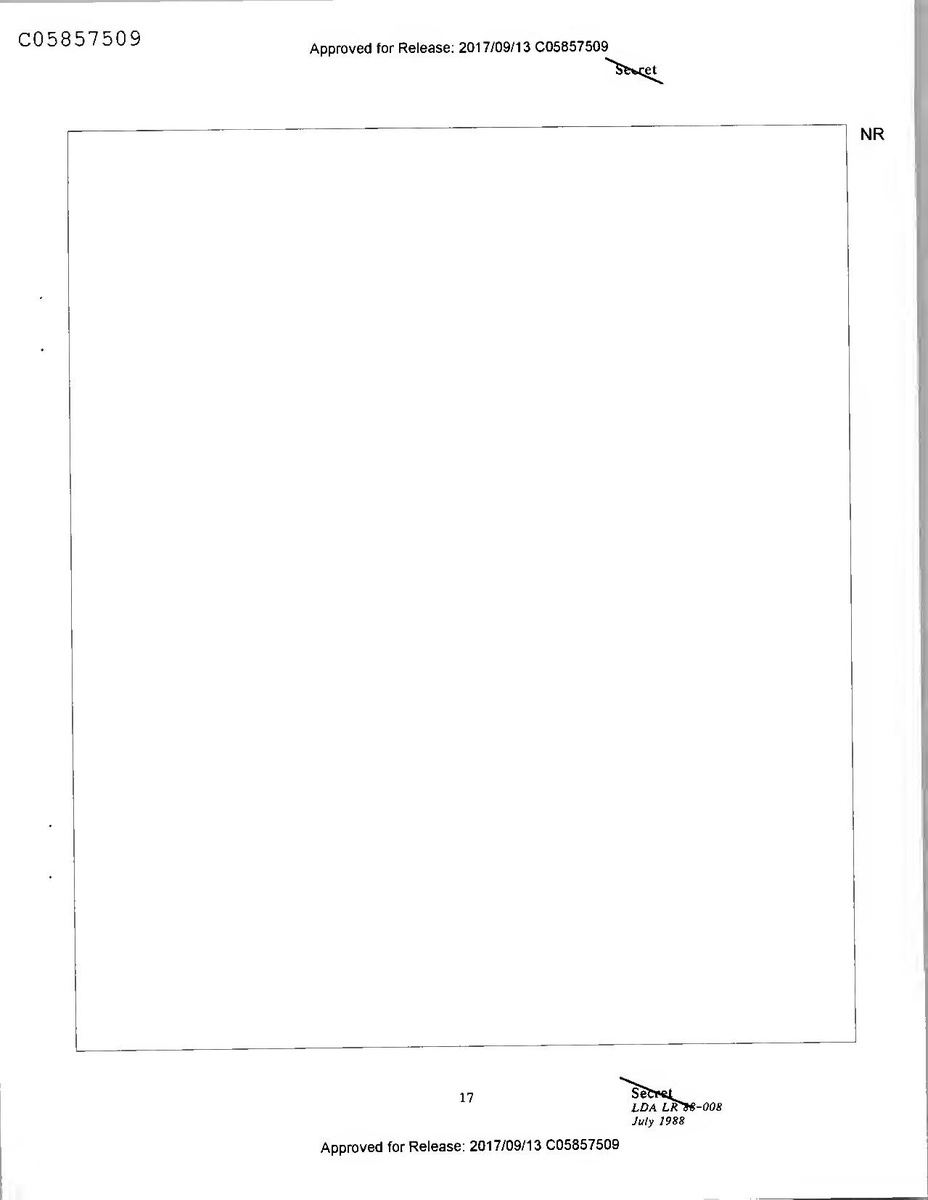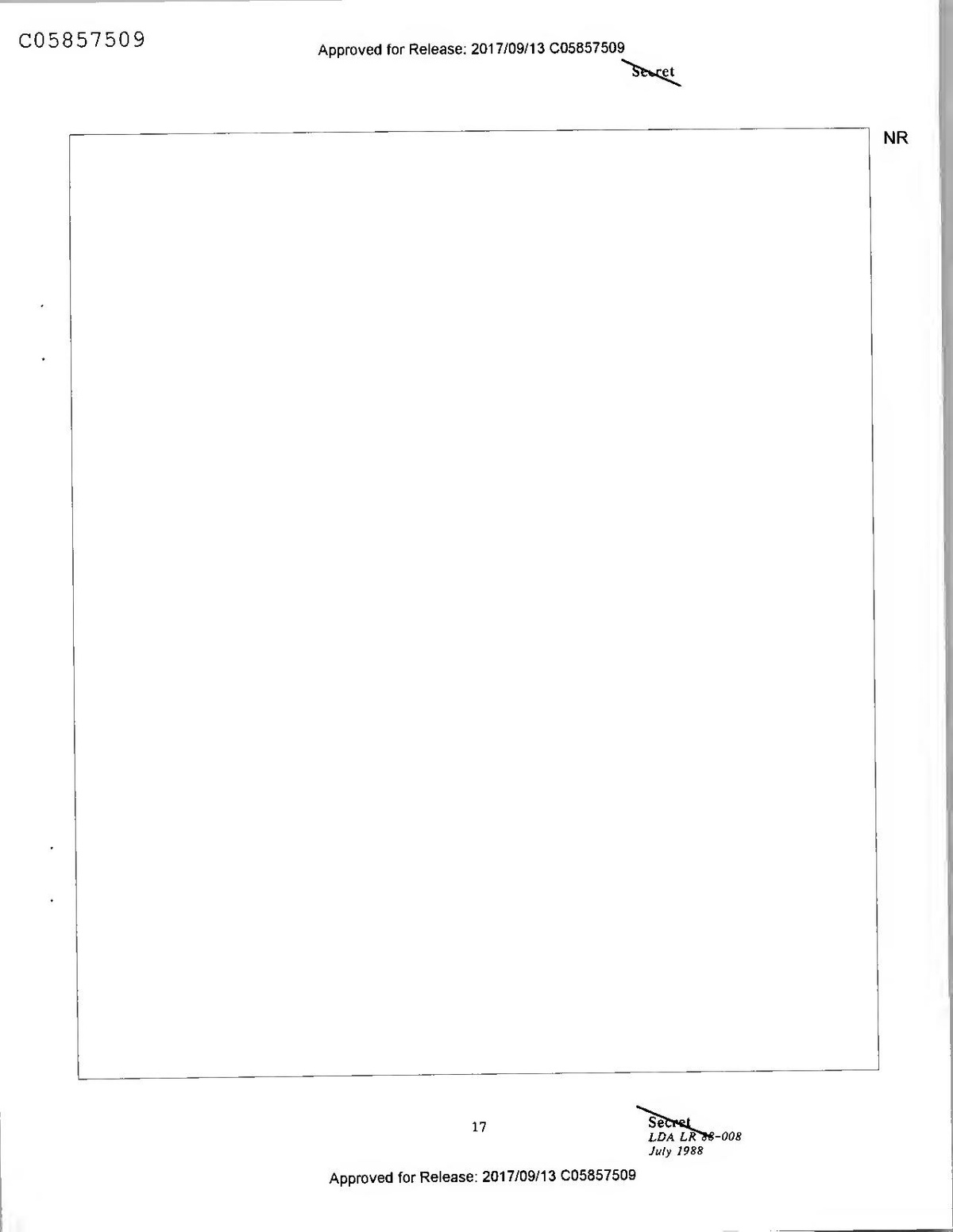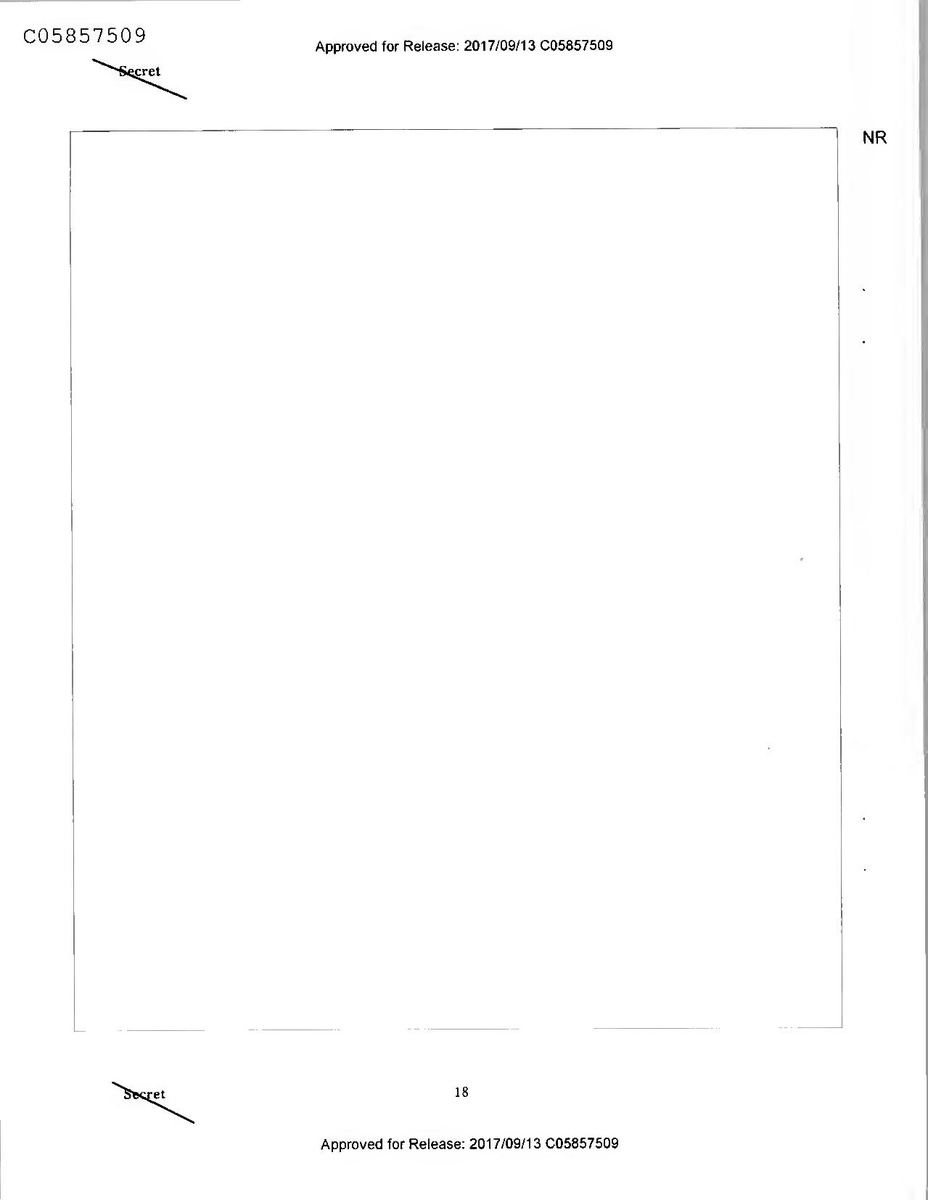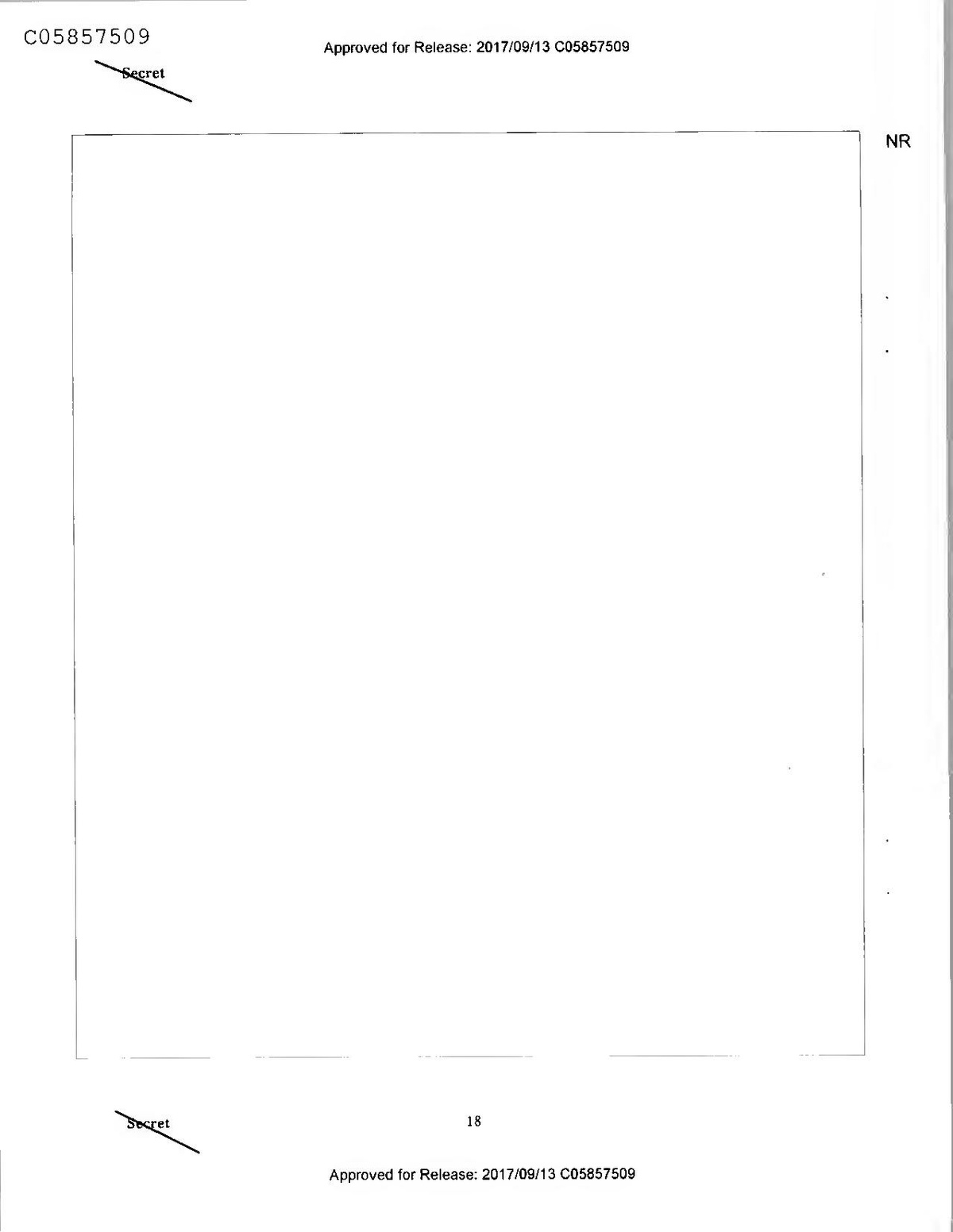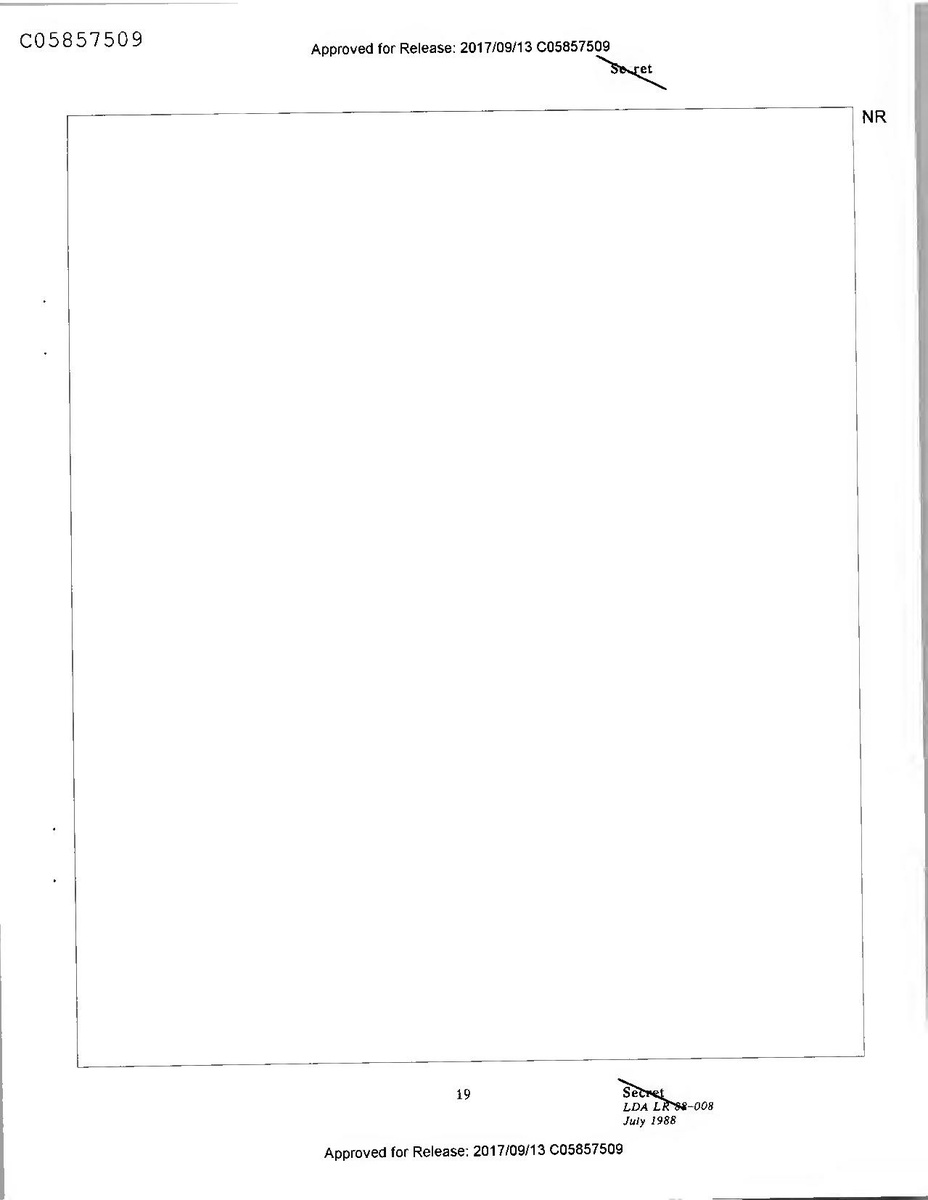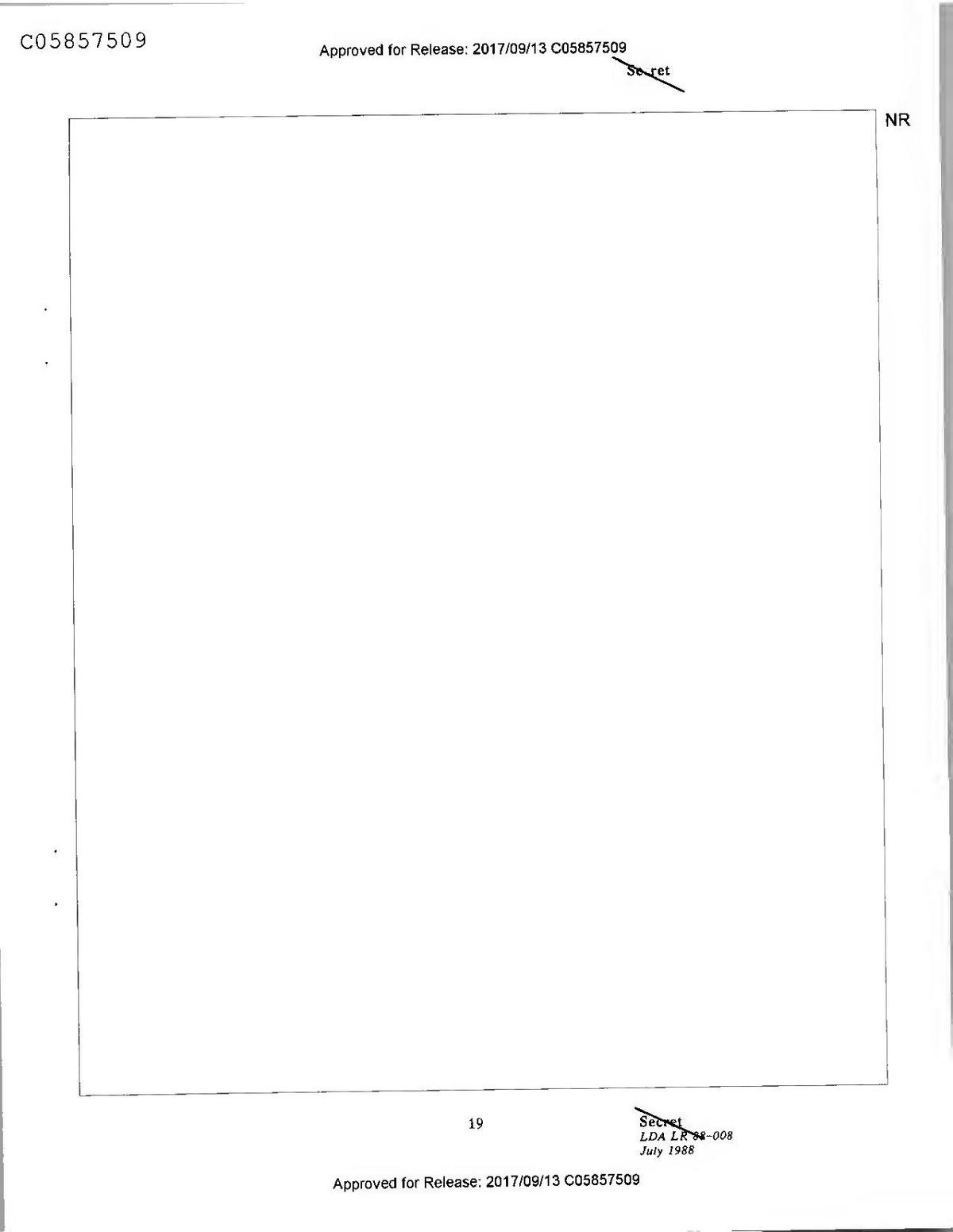Okänd sida i liggaren
Uppslag i samma avsnitt:
SECRET
Central Intelligence Agency file SOURCED
4/2/86
3
28 MAR 1585
NO GIM 86-2008!
1
Washington, DC.20505 DIRECTORATE OF INTELLIGENCE
MEMORANDUM FOR:
Distribution List (b)(3)
FROM:
Chief, Foreign Subversion and instability Center Office of Global Issues
SUBJECT:
Soviet Disinformation: Misdeeds (b)(3)
Allegations of US
With SOVA support, we prepared the attached report at the
request of the Secretary of State.
(b)(1)
The report
illustrates a number of recent campaigns which can readily be
attributed to Moscow.
(b)(3)
(b)(3)
Attachment:
Soviet Disinformation: Allegations of US Misdeeds GLM 86-20081, 28 March 1986 (b)(3)
(b)(3)
(b)(3)
(b)(3)
SECRET
Approved for Release: 2017/09/13 C05612850
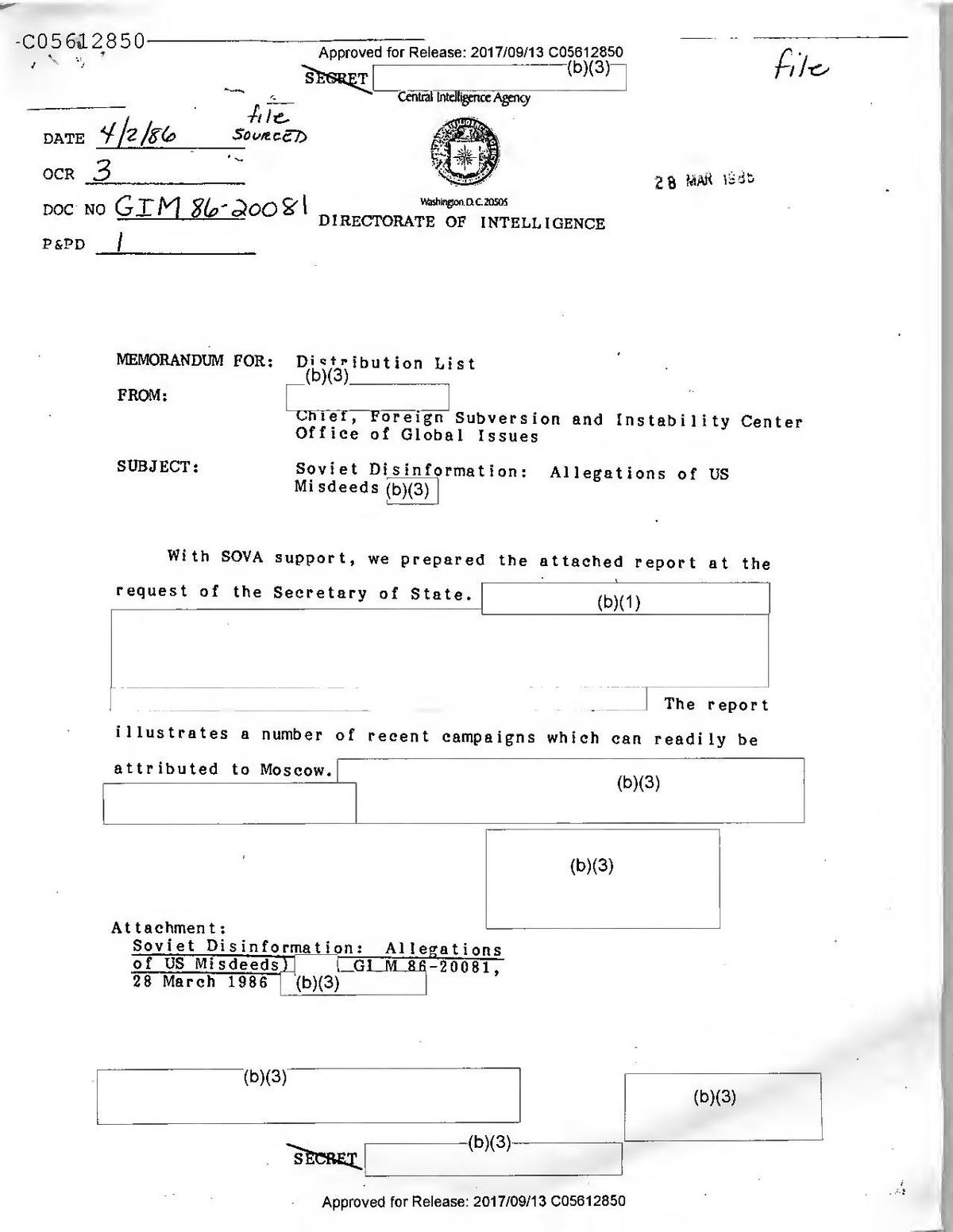
SECRET
Central Intelligence Agency file SOURCED
4/2/86
3
28 MAR 1585
NO GIM 86-2008!
1
Washington, DC.20505 DIRECTORATE OF INTELLIGENCE
MEMORANDUM FOR:
Distribution List (b)(3)
FROM:
Chief, Foreign Subversion and instability Center Office of Global Issues
SUBJECT:
Soviet Disinformation: Misdeeds (b)(3)
Allegations of US
With SOVA support, we prepared the attached report at the
request of the Secretary of State.
(b)(1)
The report
illustrates a number of recent campaigns which can readily be
attributed to Moscow.
(b)(3)
(b)(3)
Attachment:
Soviet Disinformation: Allegations of US Misdeeds GLM 86-20081, 28 March 1986 (b)(3)
(b)(3)
(b)(3)
(b)(3)
SECRET
Approved for Release: 2017/09/13 C05612850
Secret
(b)(3)
(b)(3)
Terrorism Review
b )
April 1986
(b)(3)
Focus
Japan's Chukaku-ha: A Threat to the Tokyo Summit?
The successfUL disruption of Japan's national railway system last fall by Chukakuha (Nucleus Faction), Japan's largest radical group, and recent improvements in the group's weapons raise concern about its ability to threaten the Tokyo Economic Summit in May. Chukaku-ha, however, must overcome numerous obstacles, including constraints on its finances and manpower and the extraordinary measures that the police are certain to mount against any attack on the summit sites. Even though protection cannot eliminate the possibility of a large-scale operation, given the difficulties facing the radicals, we expect they will opt to launch attacks against less protected facilities away from summit activities. (It is not yet clear whether Chukaku-ha launched the unsuccessfUL 25 March rocket attacks on the US Embassy and the Imperial Palace. Because of the crudeness of the rockets, police speculate that another leftist group may be responsible.)(b)(3)
Chukaku-ha Raises Its Profile Although primarily a radical leftist group noted for its opposition to the expansion of Tokyo's largest airport, Chukaku-ha recently has stepped up guerrilla operations against a wide variety of targets in Japan. In the last few years, the group has begun to exploit the capabilities of covert branches located in western as well as eastern Japan, which together have an estimated roster of 120 to 150 members. Chukaku-ha's covert cadre have more than doubled their terrorist-type activities since 1984 (see table 1). Their most spectacular success—and the largest guerrilla operation in Japan since the late 1960s-occurred last November. In a well-planned operation in support of the leftwing railway workers union, Chukakuha paralyzed the national rail system by cutting signal cables throughout the country, as well as setting fire to a Tokyo train station. These incidents caused long delays for millions of Japanese commuters and $10.2 million in damage.__(b)(3).
(b)(3)
The November success, combined with Chukaku-ha's stepped-up activities, suggest that the group has become stronger and more threatening.' A review of the group's recent weapons improvements lends some credence to this assessment. Until the last few years, Chukaku-ha's incendiary devices were crude, limiting their ability to strike protected installations such as government buildings and military bases. More recently, Chukaku-ha has improved the reliability of some weaponry, including a truck-mounted flamethrower with a range of 200 meters. The group has also employed a homemade rocket capable of traveling 1,000
meters, which has exploded successfully about half the time. (b)(3)
(b)(1)
In early 1985, Chukaku-ha renounced its traditional policy of not atlacking people, but it has yel to implement this policy change. (b)(3)
Secret
DI TR 86-005 April 1986
Approved for Release: 2017/09/13 C05632837
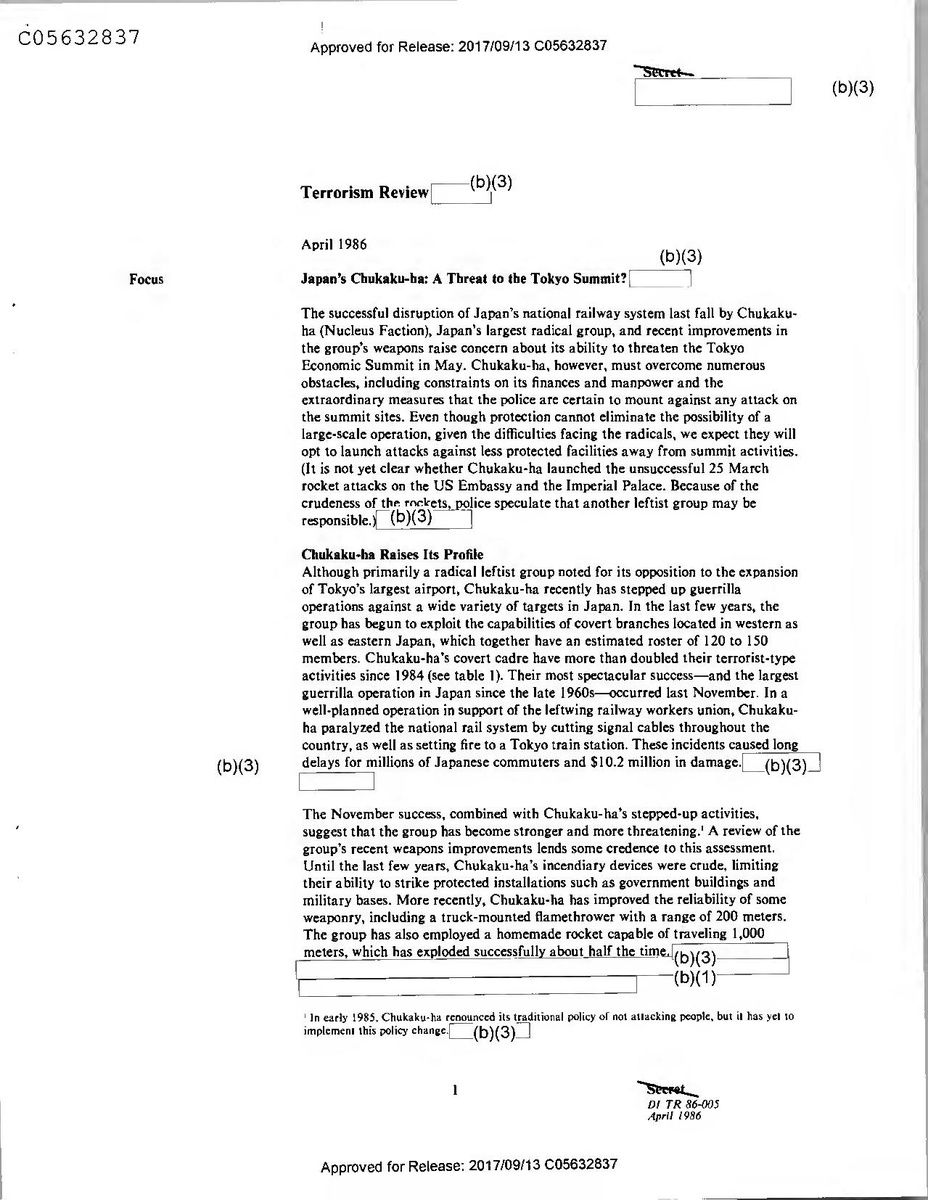
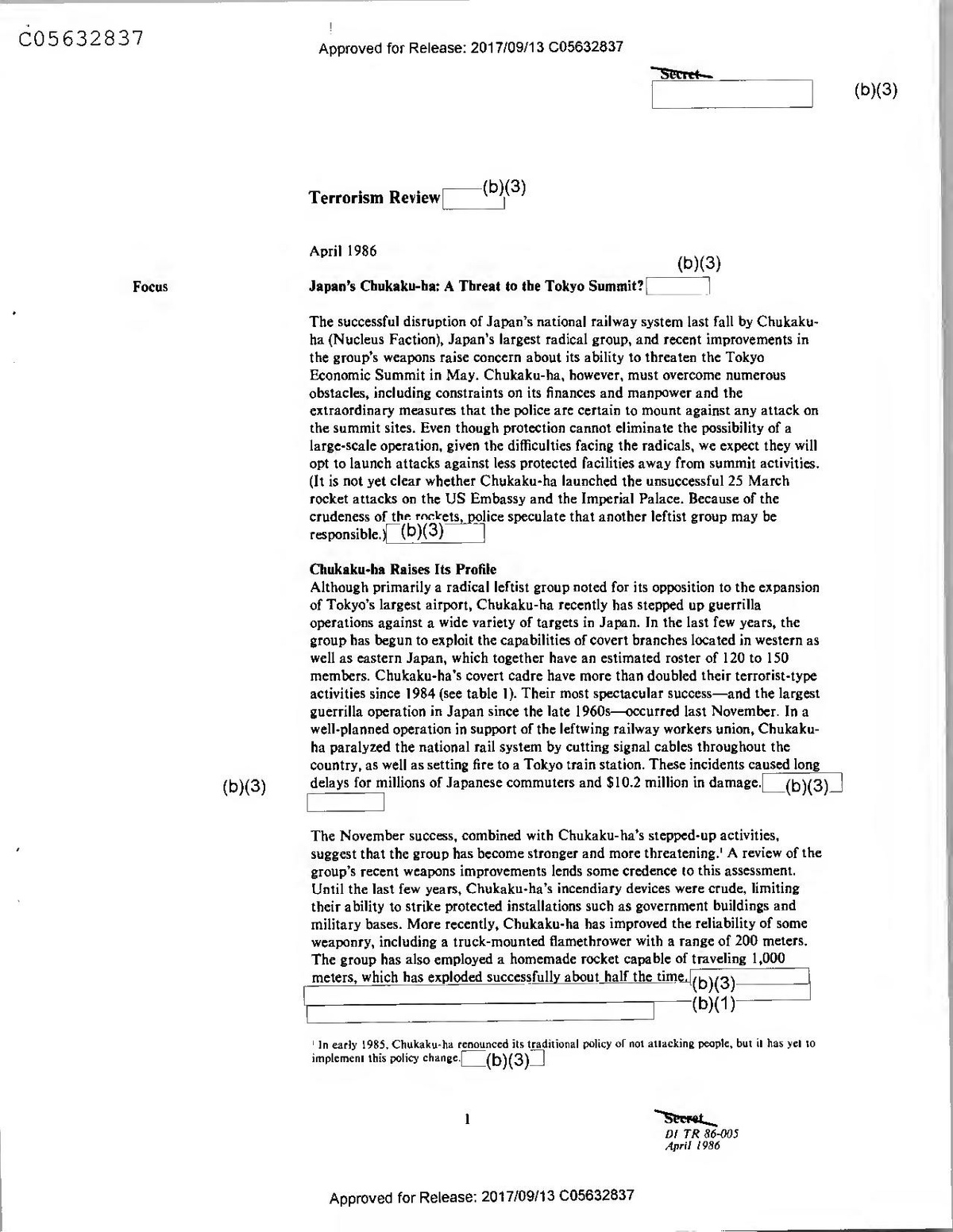
Secret
(b)(3)
(b)(3)
Terrorism Review
b )
April 1986
(b)(3)
Focus
Japan's Chukaku-ha: A Threat to the Tokyo Summit?
The successfUL disruption of Japan's national railway system last fall by Chukakuha (Nucleus Faction), Japan's largest radical group, and recent improvements in the group's weapons raise concern about its ability to threaten the Tokyo Economic Summit in May. Chukaku-ha, however, must overcome numerous obstacles, including constraints on its finances and manpower and the extraordinary measures that the police are certain to mount against any attack on the summit sites. Even though protection cannot eliminate the possibility of a large-scale operation, given the difficulties facing the radicals, we expect they will opt to launch attacks against less protected facilities away from summit activities. (It is not yet clear whether Chukaku-ha launched the unsuccessfUL 25 March rocket attacks on the US Embassy and the Imperial Palace. Because of the crudeness of the rockets, police speculate that another leftist group may be responsible.)(b)(3)
Chukaku-ha Raises Its Profile Although primarily a radical leftist group noted for its opposition to the expansion of Tokyo's largest airport, Chukaku-ha recently has stepped up guerrilla operations against a wide variety of targets in Japan. In the last few years, the group has begun to exploit the capabilities of covert branches located in western as well as eastern Japan, which together have an estimated roster of 120 to 150 members. Chukaku-ha's covert cadre have more than doubled their terrorist-type activities since 1984 (see table 1). Their most spectacular success—and the largest guerrilla operation in Japan since the late 1960s-occurred last November. In a well-planned operation in support of the leftwing railway workers union, Chukakuha paralyzed the national rail system by cutting signal cables throughout the country, as well as setting fire to a Tokyo train station. These incidents caused long delays for millions of Japanese commuters and $10.2 million in damage.__(b)(3).
(b)(3)
The November success, combined with Chukaku-ha's stepped-up activities, suggest that the group has become stronger and more threatening.' A review of the group's recent weapons improvements lends some credence to this assessment. Until the last few years, Chukaku-ha's incendiary devices were crude, limiting their ability to strike protected installations such as government buildings and military bases. More recently, Chukaku-ha has improved the reliability of some weaponry, including a truck-mounted flamethrower with a range of 200 meters. The group has also employed a homemade rocket capable of traveling 1,000
meters, which has exploded successfully about half the time. (b)(3)
(b)(1)
In early 1985, Chukaku-ha renounced its traditional policy of not atlacking people, but it has yel to implement this policy change. (b)(3)
Secret
DI TR 86-005 April 1986
Approved for Release: 2017/09/13 C05632837
Secret
류
NR
Secret
20
Approved for Release: 2017/09/13 C05857509
Secret
류
NR
Secret
20
Approved for Release: 2017/09/13 C05857509
Secret
NR
21
Secret
Approved for Release: 2017/09/13 C05857509
Secret
NR
21
Secret
Approved for Release: 2017/09/13 C05857509
Secret
NR
22
Secret
Approved for Release: 2017/09/13 C05857509
Secret
NR
22
Secret
Approved for Release: 2017/09/13 C05857509
NR
23
Secret
Approved for Release: 2017/09/13 C05857509
NR
23
Secret
Approved for Release: 2017/09/13 C05857509
Secret
NR
Secret
24
Approved for Release: 2017/09/13 C05857509
Secret
NR
Secret
24
Approved for Release: 2017/09/13 C05857509
NR
25
Secret LDA LR 88-008 July 1988
Approved for Release: 2017/09/13 C05857509
NR
25
Secret LDA LR 88-008 July 1988
Approved for Release: 2017/09/13 C05857509
Secret
NR
Decret
26
Approved for Release: 2017/09/13 C05857509
Secret
NR
Decret
26
Approved for Release: 2017/09/13 C05857509
Secret
NR
27
Secret LDA LR 88-008 July 1988
Approved for Release: 2017/09/13 C05857509
Secret
NR
27
Secret LDA LR 88-008 July 1988
Approved for Release: 2017/09/13 C05857509
NR
Secret
28
Approved for Release: 2017/09/13 C05857509
NR
Secret
28
Approved for Release: 2017/09/13 C05857509
NR
29
Secret
Reverse Blank
Approved for Release: 2017/09/13 C05857509
NR
29
Secret
Reverse Blank
Approved for Release: 2017/09/13 C05857509
Secret
Table 1 Chronology of Selected Chukaku-Ha Attacks
Location
Device Used
Comment
Flamethrower
7 May 1982
Military recruiting office Narita Airport offices
Building slightly damaged. Damaged two floors, first time device used.
1 March 1984
Truck-mounted launched incendiary device Launched incendiary device
10 August 1984
Camp Yao Airfield
19 September 1984
LDP Headquarters
Truck-mounted flamethrower
1 January 1985
US Consulate Kobe
Launched incendiary device
17 February 1985
Osaka Police unit
Truck-mounted launched incendiary device Incendiary device
20 February 1985
Narita Airport
Six bombs launched but none exploded. Fire damaged five floors, $2.4 million damage. Three rockets launched, no damage. Ten rockets launched, none exploded. Damaged building and two vehicles. Fiftcen bombs launched, hit several targets. No damage reported. Four rockets landed on runway, no damage. Slight damage to airport officials' homes.
12 April 1985
Haneda and Narita Airports
3 September 1985
Narita Airport Narita Airport
Truck-mounted launched incendiary devices Launched incendiary device Platform-launched incendiary device
I November 1985
20 November 1985
Narita Airport sites
Incendiary devices
29 November 1985
Tokyo, Osaka, southern Japan
Cut railroad lines, firebombed rail station
$10.2 million damage, halted rail service. No disruption of rail service.
29 January 1986
Tokyo
Incendiary devices set near railroad lincs
8 February 1986
Narita Airport sites
Damage limited to equipment.
Incendiary devices sct at Narita Airport sites
(b)(3)
Counterbalancing the group's enhanced weapons capabilities is its loss of support because of the general decline in popularity of the leftists in Japan. In part, the public has become disillusioned with constant bickering among the radical movement's leaders. More important, issues long identified with the radical movement--for example, opposition to US-Japanese defense ties-no longer provoke interest among Japanese students. The loss in student support poses a problem because students—unlike members with jobs can frequently be counted on to give full-time commitments to group activities. The loss is also adversely affecting Chukaku-ha's finances, because it used to derive much of its funding from student associations. (b)(3)
Secret
2
Approved for Release: 2017/09/13 C05632837
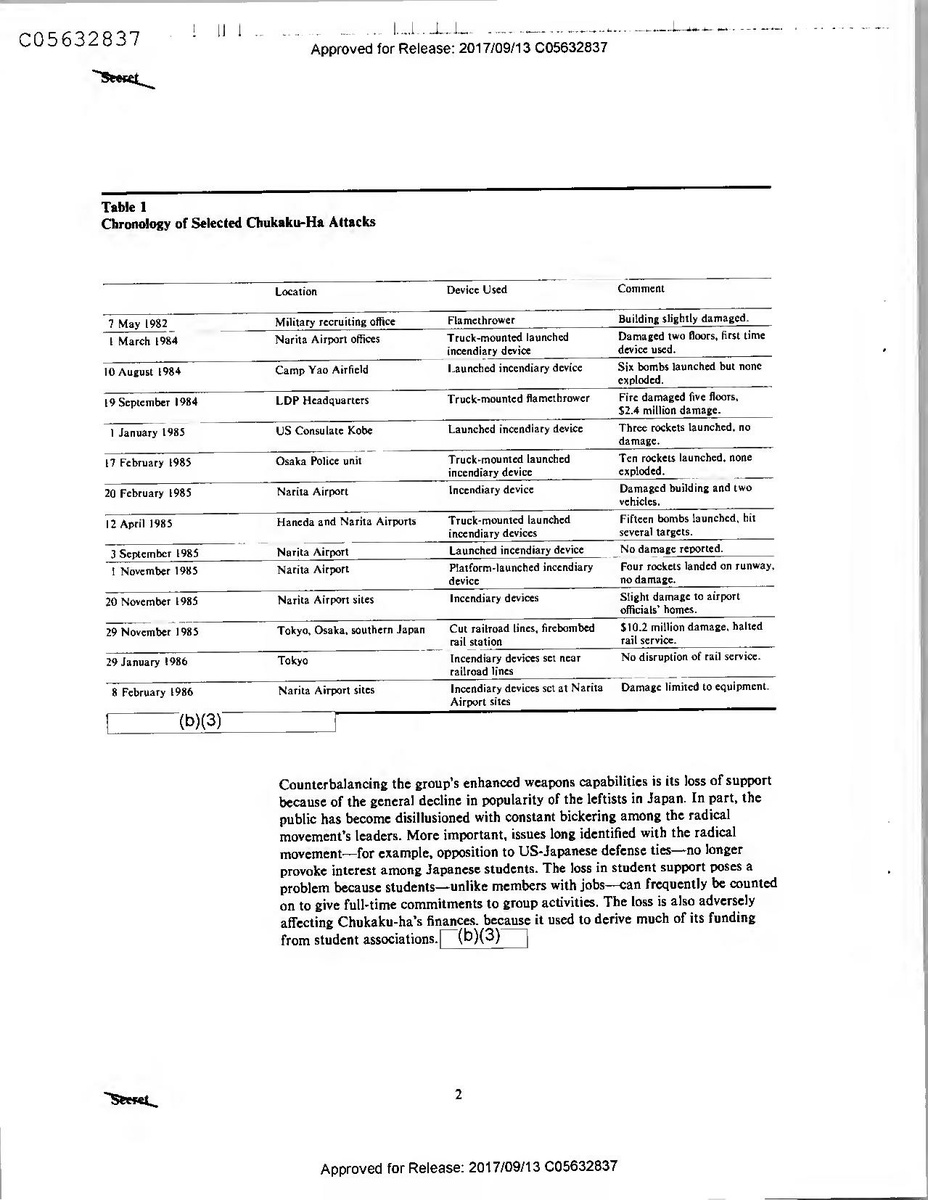
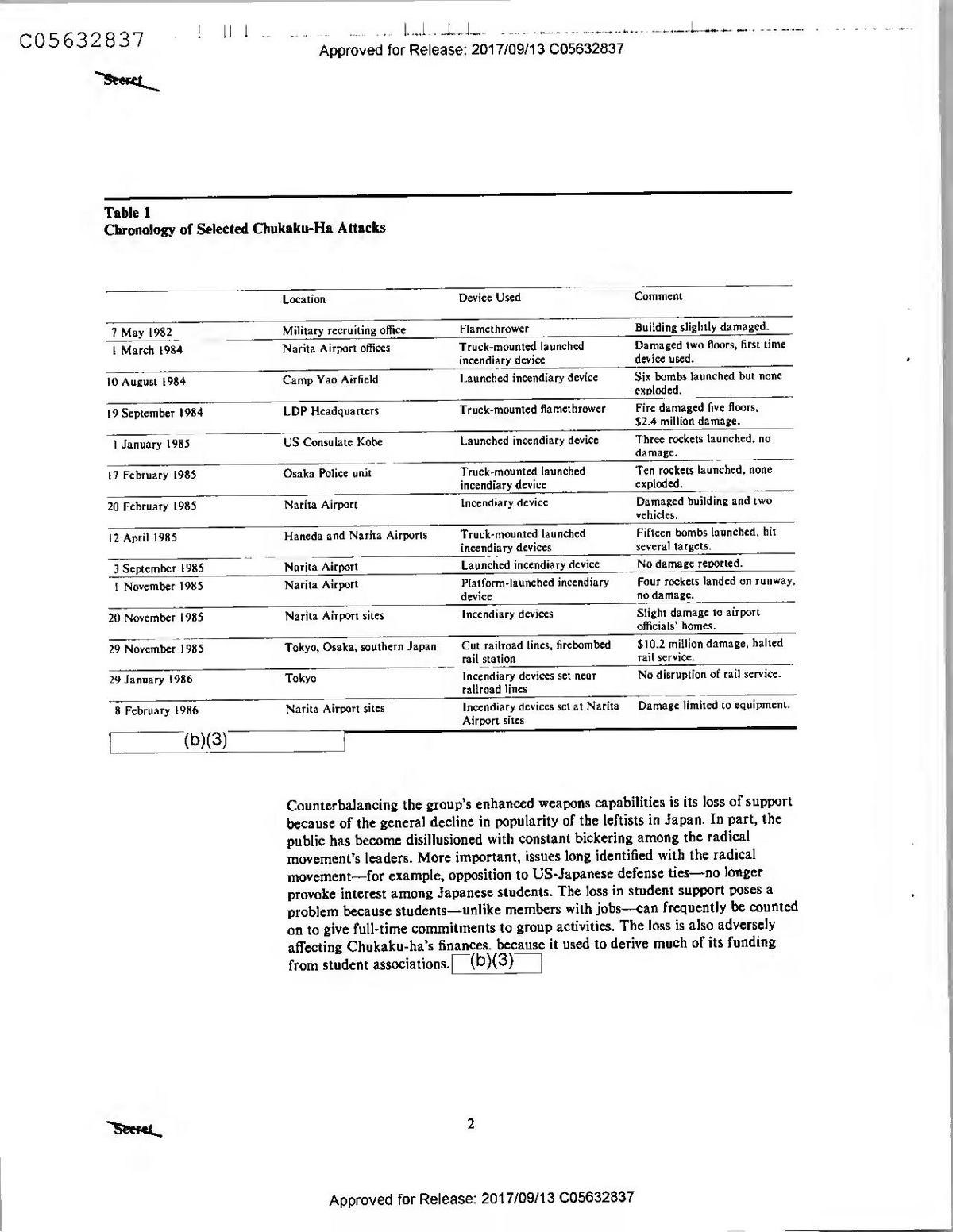
Secret
Table 1 Chronology of Selected Chukaku-Ha Attacks
Location
Device Used
Comment
Flamethrower
7 May 1982
Military recruiting office Narita Airport offices
Building slightly damaged. Damaged two floors, first time device used.
1 March 1984
Truck-mounted launched incendiary device Launched incendiary device
10 August 1984
Camp Yao Airfield
19 September 1984
LDP Headquarters
Truck-mounted flamethrower
1 January 1985
US Consulate Kobe
Launched incendiary device
17 February 1985
Osaka Police unit
Truck-mounted launched incendiary device Incendiary device
20 February 1985
Narita Airport
Six bombs launched but none exploded. Fire damaged five floors, $2.4 million damage. Three rockets launched, no damage. Ten rockets launched, none exploded. Damaged building and two vehicles. Fiftcen bombs launched, hit several targets. No damage reported. Four rockets landed on runway, no damage. Slight damage to airport officials' homes.
12 April 1985
Haneda and Narita Airports
3 September 1985
Narita Airport Narita Airport
Truck-mounted launched incendiary devices Launched incendiary device Platform-launched incendiary device
I November 1985
20 November 1985
Narita Airport sites
Incendiary devices
29 November 1985
Tokyo, Osaka, southern Japan
Cut railroad lines, firebombed rail station
$10.2 million damage, halted rail service. No disruption of rail service.
29 January 1986
Tokyo
Incendiary devices set near railroad lincs
8 February 1986
Narita Airport sites
Damage limited to equipment.
Incendiary devices sct at Narita Airport sites
(b)(3)
Counterbalancing the group's enhanced weapons capabilities is its loss of support because of the general decline in popularity of the leftists in Japan. In part, the public has become disillusioned with constant bickering among the radical movement's leaders. More important, issues long identified with the radical movement--for example, opposition to US-Japanese defense ties-no longer provoke interest among Japanese students. The loss in student support poses a problem because students—unlike members with jobs can frequently be counted on to give full-time commitments to group activities. The loss is also adversely affecting Chukaku-ha's finances, because it used to derive much of its funding from student associations. (b)(3)
Secret
2
Approved for Release: 2017/09/13 C05632837
Approved for Release: 2017/09/13 C05857509
Approved for Release: 2017/09/13 C05857509
NR
31
Secret LDA LR-008 July 1988
Approved for Release: 2017/09/13 C05857509
NR
31
Secret LDA LR-008 July 1988
Approved for Release: 2017/09/13 C05857509
Dacret
NR
Secret
32
Approved for Release: 2017/09/13 C05857509
Dacret
NR
Secret
32
Approved for Release: 2017/09/13 C05857509
NR
33
Reverse Blank
Secret
Approved for Release: 2017/09/13 C05857509
NR
33
Reverse Blank
Secret
Approved for Release: 2017/09/13 C05857509
Approved for Release: 2017/09/13 C05857509
Approved for Release: 2017/09/13 C05857509
Becret
NR
35
Secret LDA LR 88-008 July 1988
Approved for Release: 2017/09/13 C05857509
Becret
NR
35
Secret LDA LR 88-008 July 1988
Approved for Release: 2017/09/13 C05857509
Secret
NR
36
Secret
Approved for Release: 2017/09/13 C05857509
Secret
NR
36
Secret
Approved for Release: 2017/09/13 C05857509
NR
37
Desret
Approved for Release: 2017/09/13 C05857509
NR
37
Desret
Approved for Release: 2017/09/13 C05857509
NR
Secret
38
Approved for Release: 2017/09/13 C05857509
NR
Secret
38
Approved for Release: 2017/09/13 C05857509
Secret
NR
39
Secret
Approved for Release: 2017/09/13 C05857509
Secret
NR
39
Secret
Approved for Release: 2017/09/13 C05857509
(b)(3) (b)(1)
The Tokyo Summit: Chukaku-ha Scales Back Its Plans Chukaku-ha's recent aggressiveness is designed in part to attract new sympathizers,
Its leaders believe that events in Japan during April and May 1986 will provide ideal opportunities to grab headlines and gain members. Among the events Chukaku-ha reportedly plans to disrupt is the 60th anniversary celebration of Emperor Hirohito's ascendancy to the throne on 29 April. The group views the Takvo Economic Summit on 4-6 May as an even more important target.
(b)(3)
(b)(3) (b)(1)
According to their own literature, Chukaku-ha's leaders originally hoped to create an "atmosphere of terror” that would lead participants to scuttle their plans to attend the Tokyo summit.
Chuka ku-ha wanted to recreate the mood present in 1960, when the Japanese Cabinet canceled President Eisenhower's visit because of violent demonstrations over the US-Japan Security Treaty. Recent attacks at Haneda, the airport that foreign leaders will use, seem to have this goal in mind. The November attack on the national railroads was a key element in this campaign as well.
(b)(1) (b)(3)
(b)(1) (b)(3)
Some of Chukaku-ha's leaders have conceded that an attack on summit facilities-- like the plans to prevent the summit—will be difficult to pull off,
Legal and financial worries, stemming from the arrest of over 300 members last year, are a major impediment to guerrilla actions at present.
(b)(1). (b)(3)
Japan's Police: Taking Few Chances With Security Security measures by the police are by far the biggest challenge confronting Chukaku-ha. The police have a good track record in providing protection during high-level visits and meetings, and also have taken a preemptive approach in recent months, identifying and arresting as many Chukaku-ha activists as possible to disrupt the group's plans and preparations. The heart of the police program is a "roller strategy,” first used in the early 1970s to contain the terrorist threat posed by the Japanese Red Army (JRA). Officers in each precinct visit every residence and business to identify anyone in their area who may be a potential security threat. The dragnet will be concluded with a final round of visits just before the summit. In addition, the police have placed the group's overt headquarters in Tokyo under constant surveillance. (b)(3)
3
Seoret
Approved for Release: 2017/09/13 C05632837
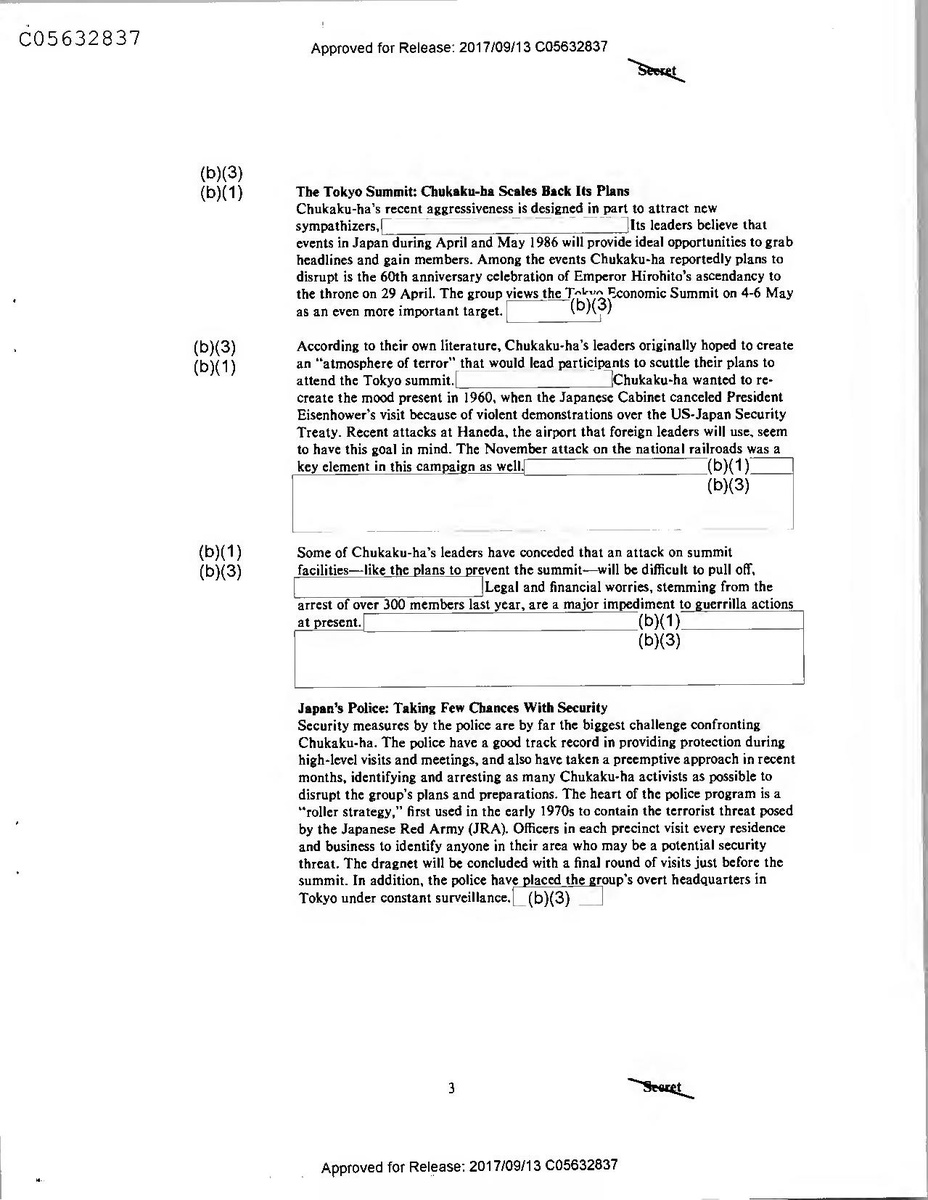
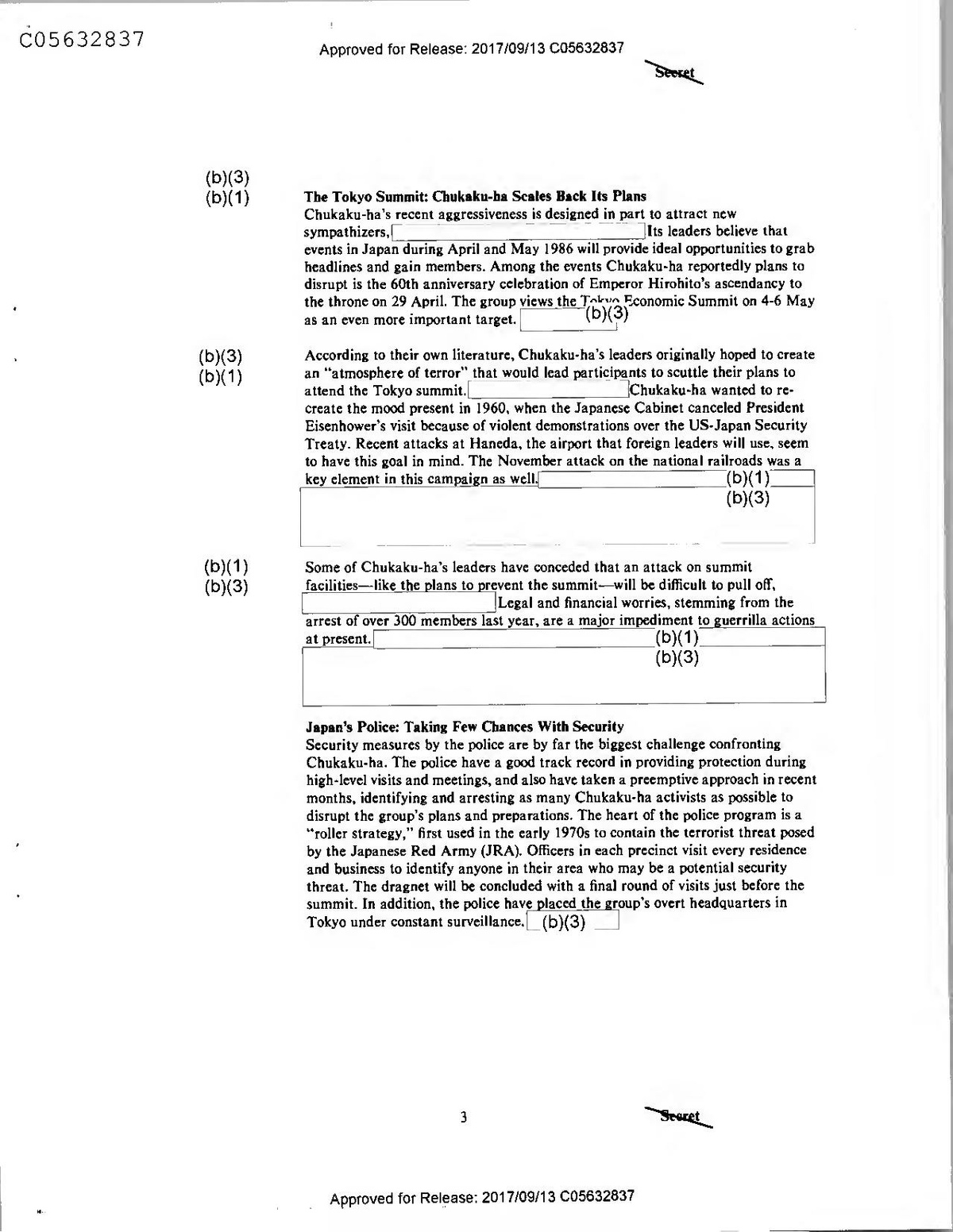
(b)(3) (b)(1)
The Tokyo Summit: Chukaku-ha Scales Back Its Plans Chukaku-ha's recent aggressiveness is designed in part to attract new sympathizers,
Its leaders believe that events in Japan during April and May 1986 will provide ideal opportunities to grab headlines and gain members. Among the events Chukaku-ha reportedly plans to disrupt is the 60th anniversary celebration of Emperor Hirohito's ascendancy to the throne on 29 April. The group views the Takvo Economic Summit on 4-6 May as an even more important target.
(b)(3)
(b)(3) (b)(1)
According to their own literature, Chukaku-ha's leaders originally hoped to create an "atmosphere of terror” that would lead participants to scuttle their plans to attend the Tokyo summit.
Chuka ku-ha wanted to recreate the mood present in 1960, when the Japanese Cabinet canceled President Eisenhower's visit because of violent demonstrations over the US-Japan Security Treaty. Recent attacks at Haneda, the airport that foreign leaders will use, seem to have this goal in mind. The November attack on the national railroads was a key element in this campaign as well.
(b)(1) (b)(3)
(b)(1) (b)(3)
Some of Chukaku-ha's leaders have conceded that an attack on summit facilities-- like the plans to prevent the summit—will be difficult to pull off,
Legal and financial worries, stemming from the arrest of over 300 members last year, are a major impediment to guerrilla actions at present.
(b)(1). (b)(3)
Japan's Police: Taking Few Chances With Security Security measures by the police are by far the biggest challenge confronting Chukaku-ha. The police have a good track record in providing protection during high-level visits and meetings, and also have taken a preemptive approach in recent months, identifying and arresting as many Chukaku-ha activists as possible to disrupt the group's plans and preparations. The heart of the police program is a "roller strategy,” first used in the early 1970s to contain the terrorist threat posed by the Japanese Red Army (JRA). Officers in each precinct visit every residence and business to identify anyone in their area who may be a potential security threat. The dragnet will be concluded with a final round of visits just before the summit. In addition, the police have placed the group's overt headquarters in Tokyo under constant surveillance. (b)(3)
3
Seoret
Approved for Release: 2017/09/13 C05632837
Secret
NR
Secret
40
Approved for Release: 2017/09/13 C05857509
Secret
NR
Secret
40
Approved for Release: 2017/09/13 C05857509
NR
41
Sesret
Approved for Release: 2017/09/13 C05857509
NR
41
Sesret
Approved for Release: 2017/09/13 C05857509
NR
Sesret
42
Approved for Release: 2017/09/13 C05857509
NR
Sesret
42
Approved for Release: 2017/09/13 C05857509
Secret
NR
Sweden
Carlsson Under Fire
(b)(3)
As the campaign for Sweden's 18 September general election heats up, Prime Minister Ingvar Carlsson finds himself in a much more precarious position than most observers would have predicted a few months ago. A series of missteps has plagued Carlsson's tenure and clouded his future. The latest involves revelations that former Justice Minister Anna-Greta Leijon used her position to support a privately financed secret investigation of the assassination of former Prime Minister Olof Palme in 1986. By authorizing the investigation, Leijon (one of Carlsson's most popular ministers) seemingly placed herself above the law in a country that holds the legal system sacrosanct. (b)(3)]Although Leijon was cleared of criminal wrongdoing by the Justice Chancellor, a parliamentary committee has decided to pursue the matter. The committee will be the final arbiter of the incident, and its unprecedented decision to hold hearings during a parliamentary recess guarantees the scandal front page coverage until the election. A recent poll shows that roughly 50 percent of the electorate continues to regard Leijon as an experienced politician whose actions, albeit misguided, were part of a genuine effort to fight terrorism. Nevertheless, the opposition nonsocialist party leaders are almost certain to try to capitalize on the unfolding investigation. (b)(3)]
43
Sacret
Approved for Release: 2017/09/13 C05857509
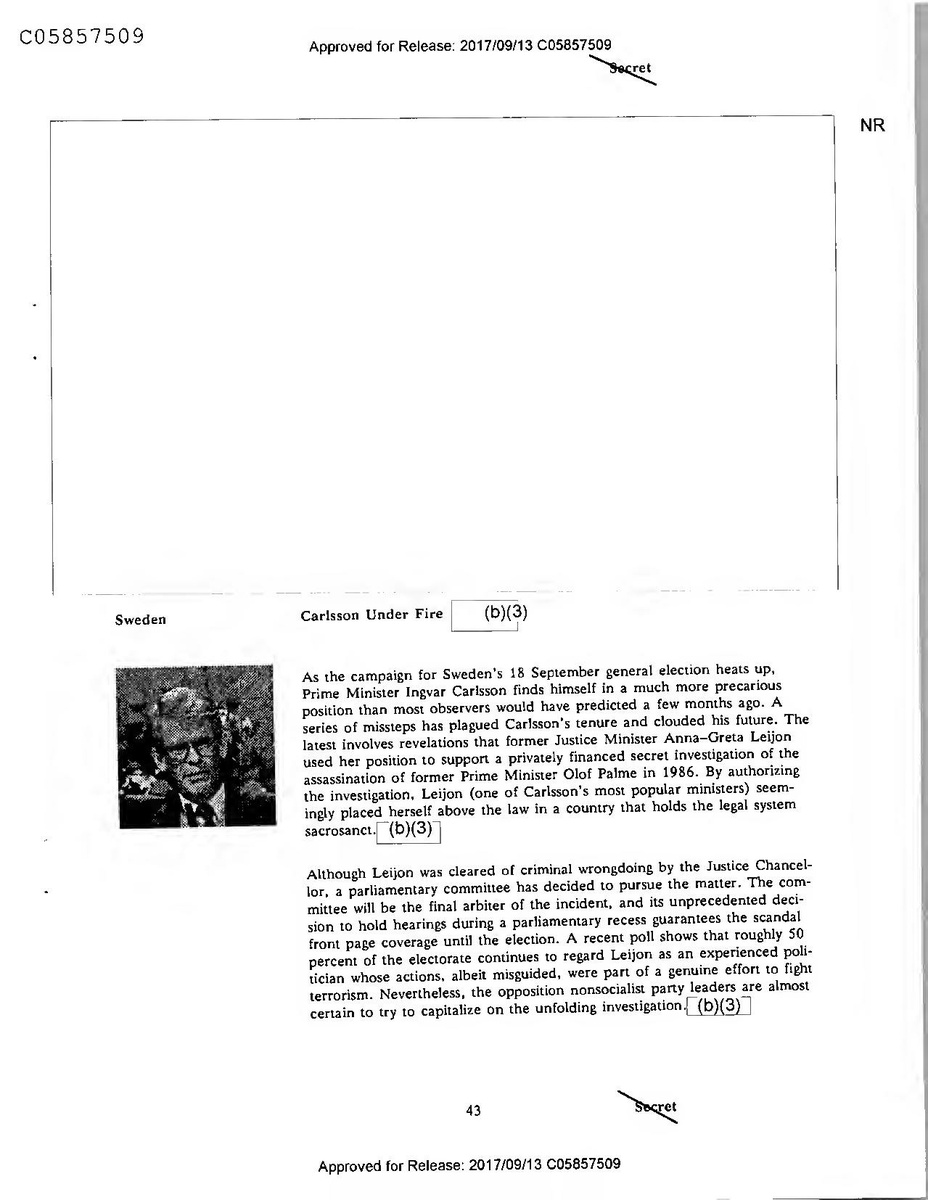
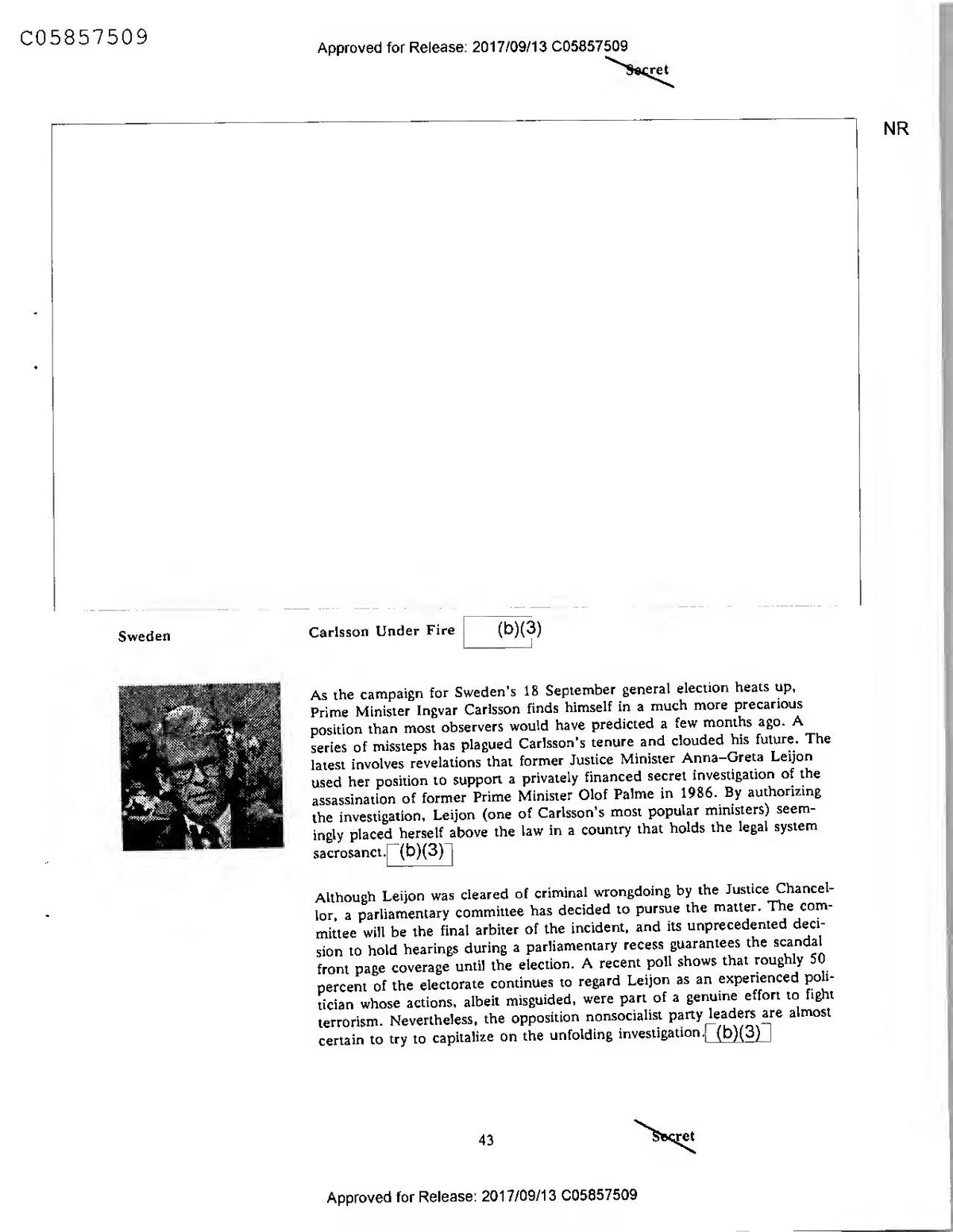
Secret
NR
Sweden
Carlsson Under Fire
(b)(3)
As the campaign for Sweden's 18 September general election heats up, Prime Minister Ingvar Carlsson finds himself in a much more precarious position than most observers would have predicted a few months ago. A series of missteps has plagued Carlsson's tenure and clouded his future. The latest involves revelations that former Justice Minister Anna-Greta Leijon used her position to support a privately financed secret investigation of the assassination of former Prime Minister Olof Palme in 1986. By authorizing the investigation, Leijon (one of Carlsson's most popular ministers) seemingly placed herself above the law in a country that holds the legal system sacrosanct. (b)(3)]Although Leijon was cleared of criminal wrongdoing by the Justice Chancellor, a parliamentary committee has decided to pursue the matter. The committee will be the final arbiter of the incident, and its unprecedented decision to hold hearings during a parliamentary recess guarantees the scandal front page coverage until the election. A recent poll shows that roughly 50 percent of the electorate continues to regard Leijon as an experienced politician whose actions, albeit misguided, were part of a genuine effort to fight terrorism. Nevertheless, the opposition nonsocialist party leaders are almost certain to try to capitalize on the unfolding investigation. (b)(3)]
43
Sacret
Approved for Release: 2017/09/13 C05857509
No matter how the investigation proceeds, the affair has divided the Social Democratic Party (SDP) and raises serious questions about Carlsson's leadership. For example, Finance Ministry official and SDP member Birgitta von Otter-wife of Finance Minister Kjell-Olof Feldt, the party's second-mostinfluential leader after Carlsson-sharply chastised Carlsson for playing down the affair in order to protect Leijon.
her fierce attack was supported by other senior and middle-ranking party officials, although not by her husband. (b)(3)
(b)(3)
(b)(1) (b)(3)
Jwhile Carlsson has been generally praised for giving Cabinet ministers more manuevering room than did Palme, his open style now seems to have contributed to some of the government's problems. In particular, the Leijon incident makes the government seem clumsy, undermining Carlsson's claim that the SDP, which has governed for 50 of the last 56 years, is the only party able to govern. Until recently, voters have bought Carlsson's argument, primarily because the internecine squabbling that has characterized the nonsocialist parties—both in government (1976-82) and in opposition-made them appear inept. Although fluctuating, polls now indicate that the nonsocialists narties'
combined votes in the general election could unseat the SDP. (b)(3)7
The latest scandal comes on the heels of a series of shocks that have shaken popular belief in Sweden's immunity to the corruption and crime of other Western democracies. • The Palme assassination raised the specter of international terrorism. • Revelations about secret arms deals and the resultant numerous investigations exposed the hypocritical practices of both business and political leaders who wittingly circumvented regulations in an effort to boost the domestic arms industry. • Last autumn's escape of Sweden's most celebrated spy during a conjugal visit home, made the government appear ridiculous and led to the coohse(b)(3) quent resignation of former Justice Minister Sten Wickbom.
As the election campaign heats up, opposition leaders may well make Carlsson's lack of control over the Cabinet their rallying point, but they have formidable obstacles to overcome if they are to convert their standing in the polls into an electoral victory. For one thing, their own personal rivalries and policy differences make it difficult for opposition leaders to take advantage of Carlsson's vulnerability. For another, Carlsson—though weakened-is still the leading contender. He continues to outdistance his opponents in “trustworthiness” ratings, and he combines a folksy image with highly developed political skills-traits that are likely to help him convince Swedish voters to go with a if faulty, choice rather than gamble on the divisive nonsocialists.
(b)(3)",
Soscet
44
Approved for Release: 2017/09/13 C05857509
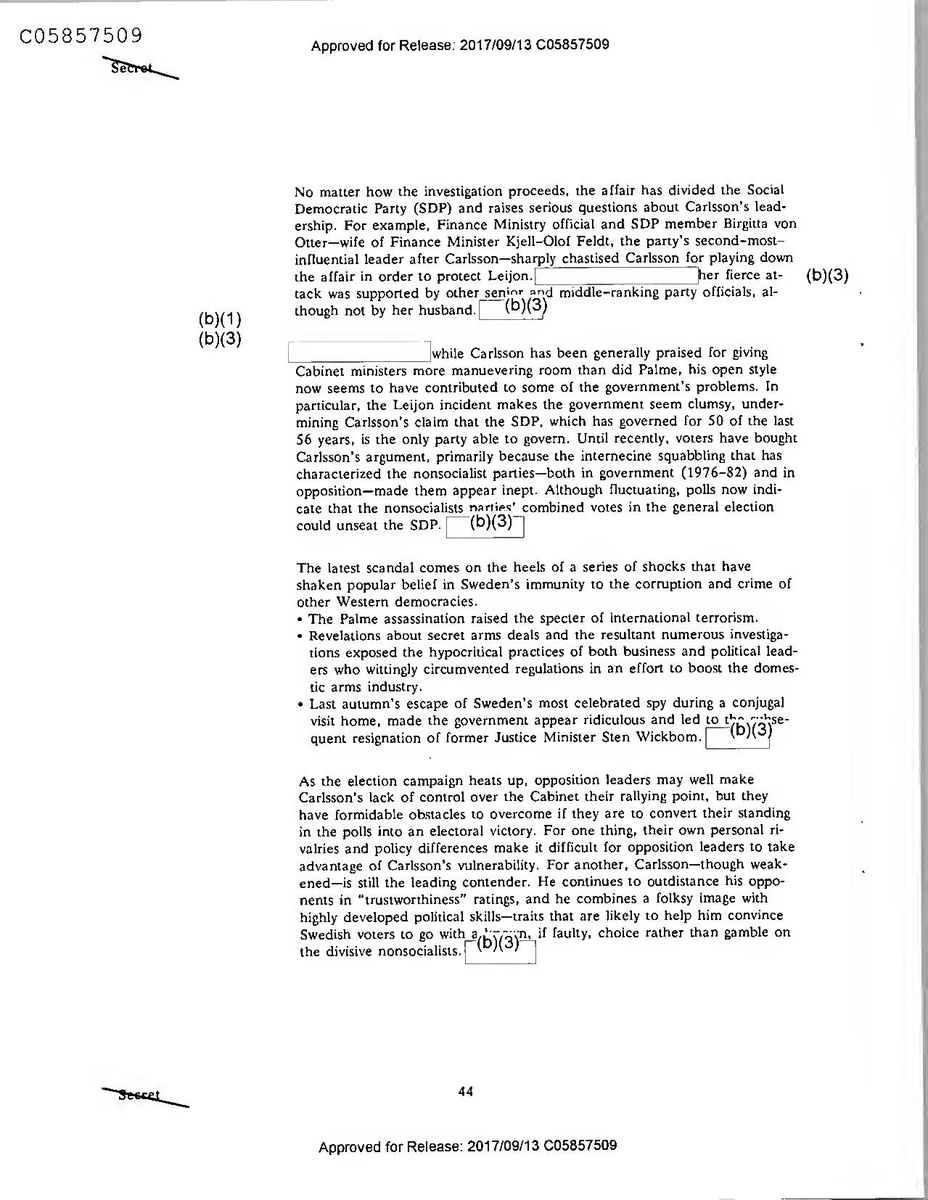
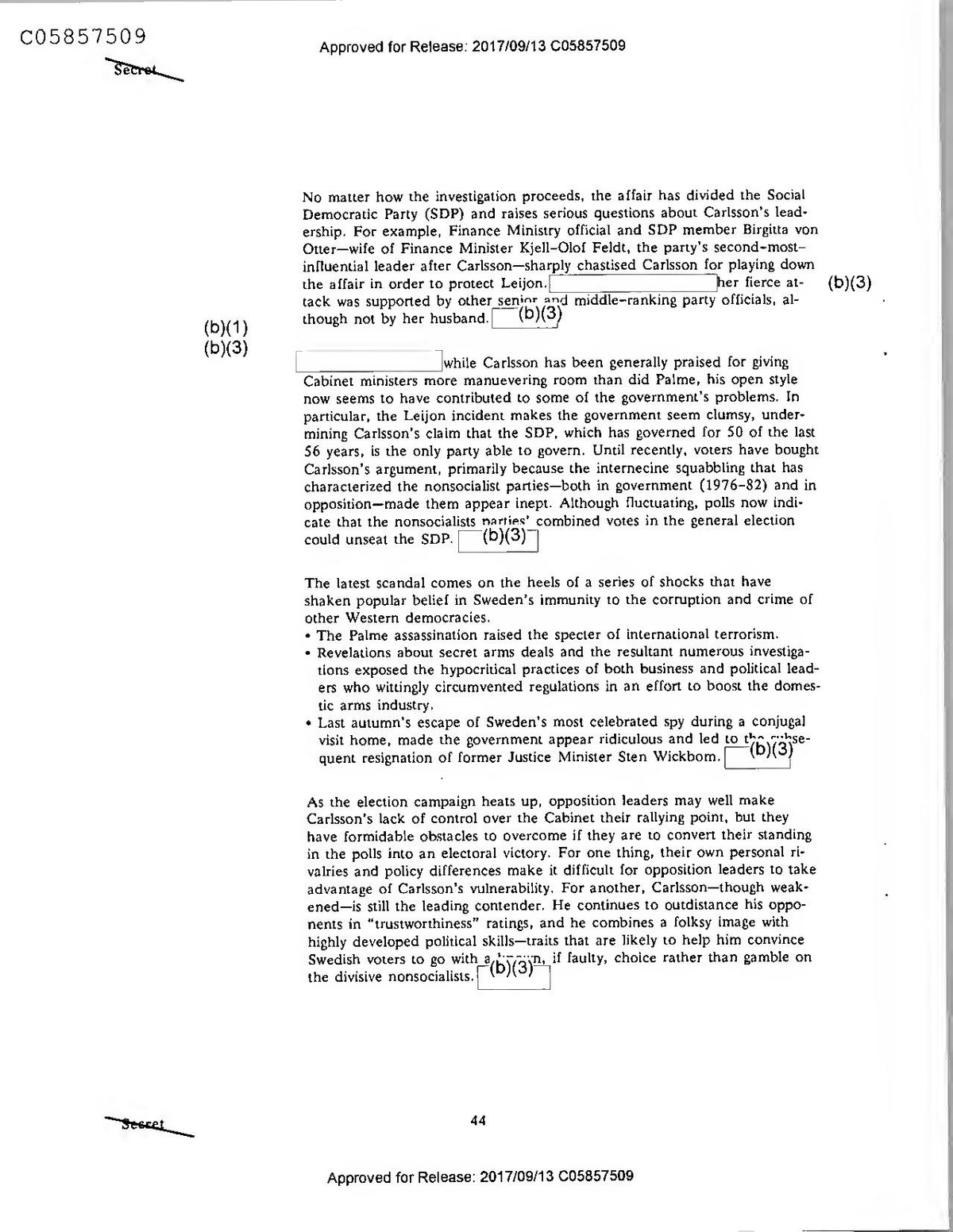
No matter how the investigation proceeds, the affair has divided the Social Democratic Party (SDP) and raises serious questions about Carlsson's leadership. For example, Finance Ministry official and SDP member Birgitta von Otter-wife of Finance Minister Kjell-Olof Feldt, the party's second-mostinfluential leader after Carlsson-sharply chastised Carlsson for playing down the affair in order to protect Leijon.
her fierce attack was supported by other senior and middle-ranking party officials, although not by her husband. (b)(3)
(b)(3)
(b)(1) (b)(3)
Jwhile Carlsson has been generally praised for giving Cabinet ministers more manuevering room than did Palme, his open style now seems to have contributed to some of the government's problems. In particular, the Leijon incident makes the government seem clumsy, undermining Carlsson's claim that the SDP, which has governed for 50 of the last 56 years, is the only party able to govern. Until recently, voters have bought Carlsson's argument, primarily because the internecine squabbling that has characterized the nonsocialist parties—both in government (1976-82) and in opposition-made them appear inept. Although fluctuating, polls now indicate that the nonsocialists narties'
combined votes in the general election could unseat the SDP. (b)(3)7
The latest scandal comes on the heels of a series of shocks that have shaken popular belief in Sweden's immunity to the corruption and crime of other Western democracies. • The Palme assassination raised the specter of international terrorism. • Revelations about secret arms deals and the resultant numerous investigations exposed the hypocritical practices of both business and political leaders who wittingly circumvented regulations in an effort to boost the domestic arms industry. • Last autumn's escape of Sweden's most celebrated spy during a conjugal visit home, made the government appear ridiculous and led to the coohse(b)(3) quent resignation of former Justice Minister Sten Wickbom.
As the election campaign heats up, opposition leaders may well make Carlsson's lack of control over the Cabinet their rallying point, but they have formidable obstacles to overcome if they are to convert their standing in the polls into an electoral victory. For one thing, their own personal rivalries and policy differences make it difficult for opposition leaders to take advantage of Carlsson's vulnerability. For another, Carlsson—though weakened-is still the leading contender. He continues to outdistance his opponents in “trustworthiness” ratings, and he combines a folksy image with highly developed political skills-traits that are likely to help him convince Swedish voters to go with a if faulty, choice rather than gamble on the divisive nonsocialists.
(b)(3)",
Soscet
44
Approved for Release: 2017/09/13 C05857509
NR
45
Sacret
Approved for Release: 2017/09/13 C05857509
NR
45
Sacret
Approved for Release: 2017/09/13 C05857509
INR
Secret
46
Approved for Release: 2017/09/13 C05857509
INR
Secret
46
Approved for Release: 2017/09/13 C05857509
NR
47
Secret
Approved for Release: 2017/09/13 C05857509
NR
47
Secret
Approved for Release: 2017/09/13 C05857509
NR
Secret
48
Approved for Release: 2017/09/13 C05857509
NR
Secret
48
Approved for Release: 2017/09/13 C05857509
NR
49
Secret LDA LR 88-008 July 1988
Approved for Release: 2017/09/13 C05857509
NR
49
Secret LDA LR 88-008 July 1988
Approved for Release: 2017/09/13 C05857509
Secret
(b)(1) (b)(3)
(b)(3)
The police have been rewarded for their efforts thus far. Several Chukaku-ha members, including a key tactical leader of one of the covert branches, have been arrested
More important, other overt members who have been arrested are talking freely, allowing the authorities to indict those detained. The arrests also have yielded valuable information on the group's organization and weapons that the police are certain to exploit. (b)(3)
Secret
Approved for Release: 2017/09/13 C05632837
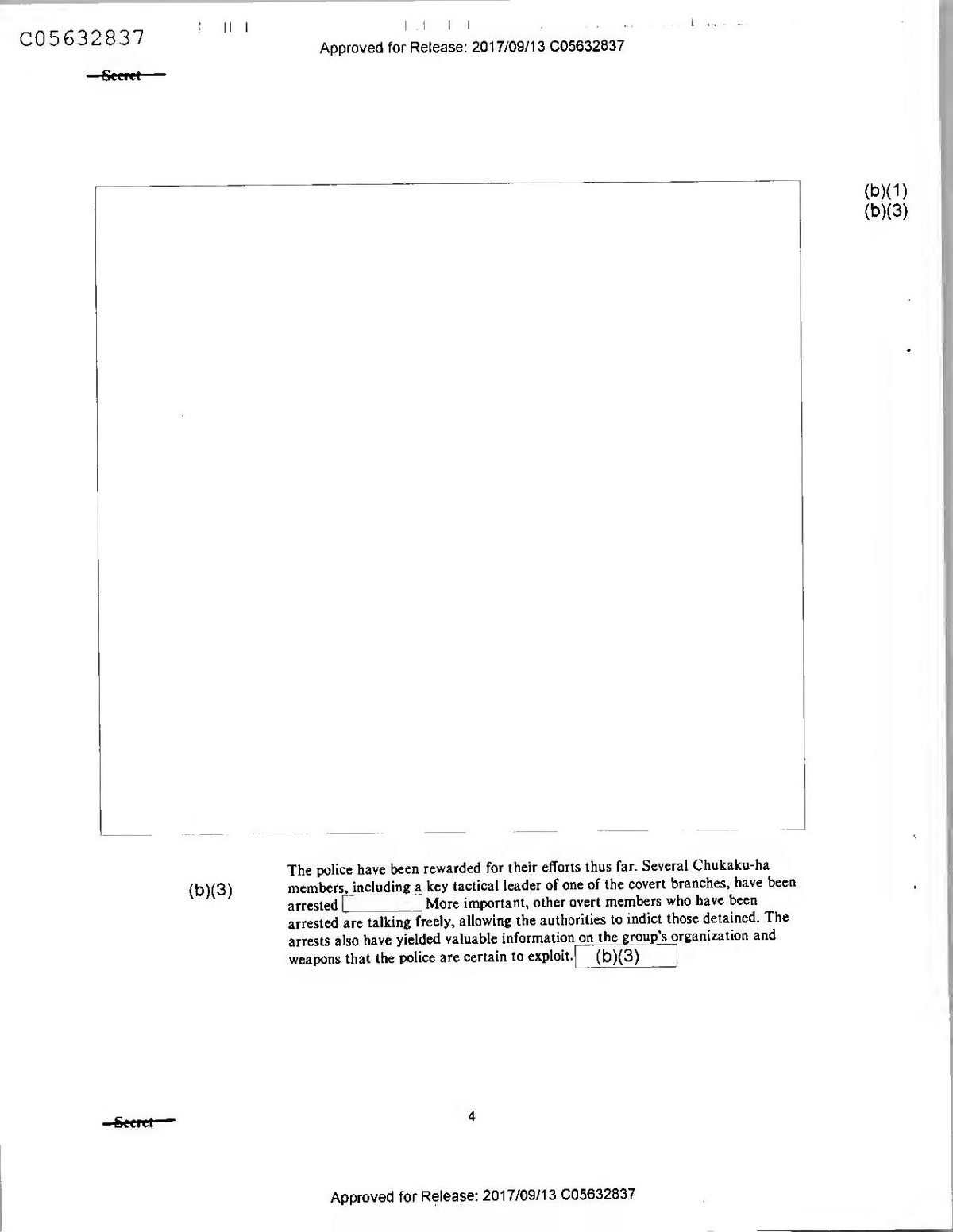
Secret
(b)(1) (b)(3)
(b)(3)
The police have been rewarded for their efforts thus far. Several Chukaku-ha members, including a key tactical leader of one of the covert branches, have been arrested
More important, other overt members who have been arrested are talking freely, allowing the authorities to indict those detained. The arrests also have yielded valuable information on the group's organization and weapons that the police are certain to exploit. (b)(3)
Secret
Approved for Release: 2017/09/13 C05632837
Secret
NR
Seexet
50
Approved for Release: 2017/09/13 C05857509
Secret
NR
Seexet
50
Approved for Release: 2017/09/13 C05857509
b
0
a
P.
Secret
O
Approved for Release: 2017/09/13 C05857509
b
0
a
P.
Secret
O
Approved for Release: 2017/09/13 C05857509
Intelligence
(b)(3)
no
PONT
MASTER FILE COPY
..
DO NOT GIVE OUT
OR MAAK ON
Terrorism Review (b)(3)
Secret
Di TR 87-003 12 February 1987
3
Copy
625
Approved for Release: 2017/09/13 C05922883
Intelligence
(b)(3)
no
PONT
MASTER FILE COPY
..
DO NOT GIVE OUT
OR MAAK ON
Terrorism Review (b)(3)
Secret
Di TR 87-003 12 February 1987
3
Copy
625
Approved for Release: 2017/09/13 C05922883
Warning Notice
Intelligence Sources or Methods Involved (WNINTEL)
National Security Information
Unauthorized Disclosure Subject to Criminal Sanctions
Dissemination Control Abbreviations
NOFORN (NF) NOCONTRACT (NC) PROPIN (PR) ORCON (OC)
Not releasable to foreign nationals Not releasable to contractors or contractor/consultants Caution-proprietary information involved Dissemination and extraction of information controlled by originator This information has been authorized for release to... WNINTEL-Intelligence sources or methods involved
REL...
WN
(b)(3)
All material on this page is Unclassified.
Approved for Release: 2017/09/13 C05922883
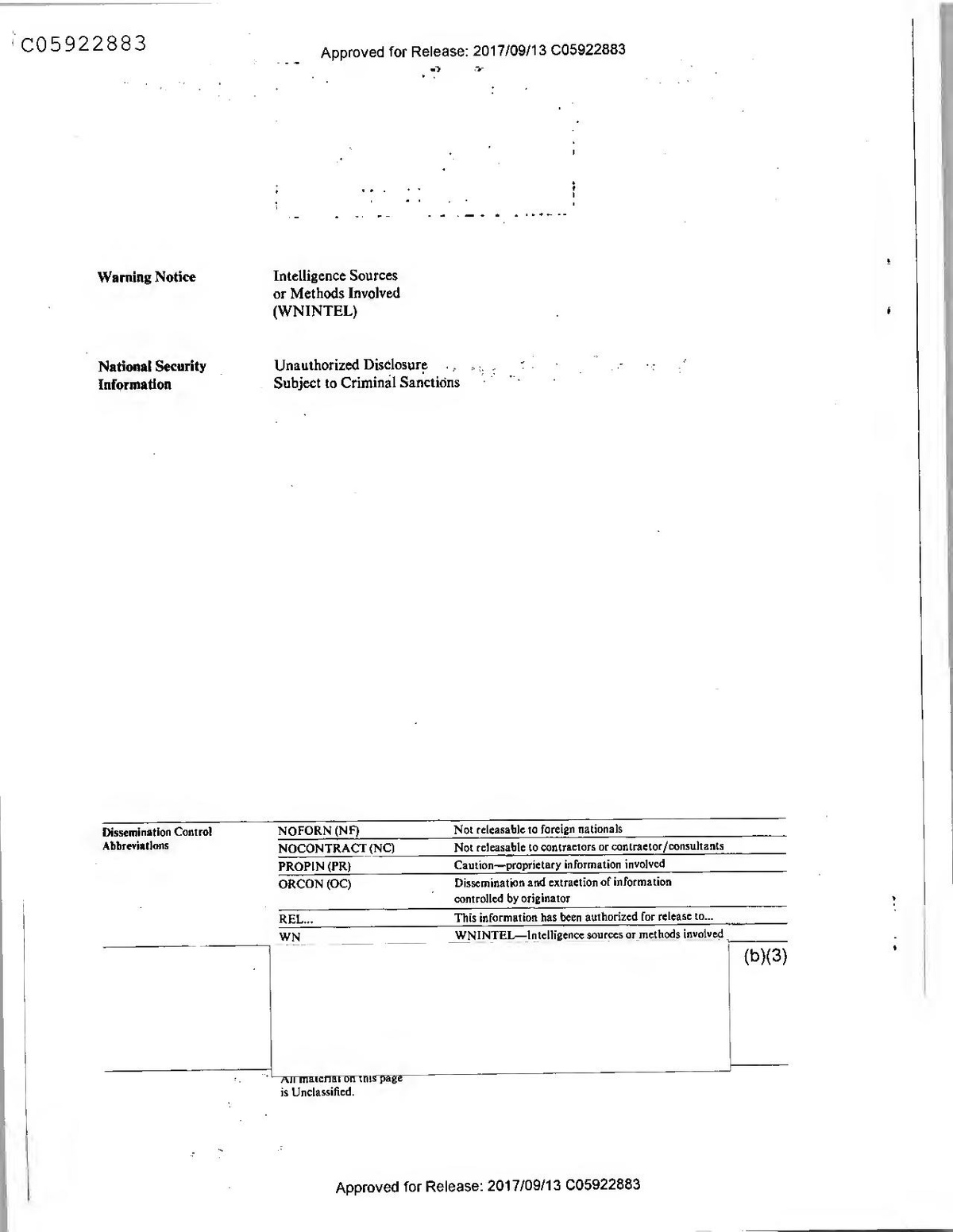
Warning Notice
Intelligence Sources or Methods Involved (WNINTEL)
National Security Information
Unauthorized Disclosure Subject to Criminal Sanctions
Dissemination Control Abbreviations
NOFORN (NF) NOCONTRACT (NC) PROPIN (PR) ORCON (OC)
Not releasable to foreign nationals Not releasable to contractors or contractor/consultants Caution-proprietary information involved Dissemination and extraction of information controlled by originator This information has been authorized for release to... WNINTEL-Intelligence sources or methods involved
REL...
WN
(b)(3)
All material on this page is Unclassified.
Approved for Release: 2017/09/13 C05922883
Terrorism Review
(b)(3)
12 February 1987
1
Focus: Lebanon—The New Hostages
(b)(3)
7
Highlights!
(b)(3)
11
Alfaro Vive, Carajo!: A Current Assessment
(b)(3)
15
Overview of Asian Terrorism in 1986
(b)(3)|
19
(b)(3)
Emerging Terrorist Threat to Scandinavia
23
Fatah Official Implicated in TWA Flight 840 Attack
(b)(3)
25
The Terrorism Diary for March
(b)(3)
29
Chronology of Terrorism—1986/1987
(b)(3)
This review is published biweekly by the Directorate of Intelligence. Appropriate articles produced by other elements of the CIA as well as by other agencies of the US Intelligence Community will be considered for publication. Comments and queries are welcome and may be directed to the Executive Editor
(b)(3)]
i
11i
Secret DI TR 87-003 12 February 1987
Approved for Release: 2017/09/13 C05922883
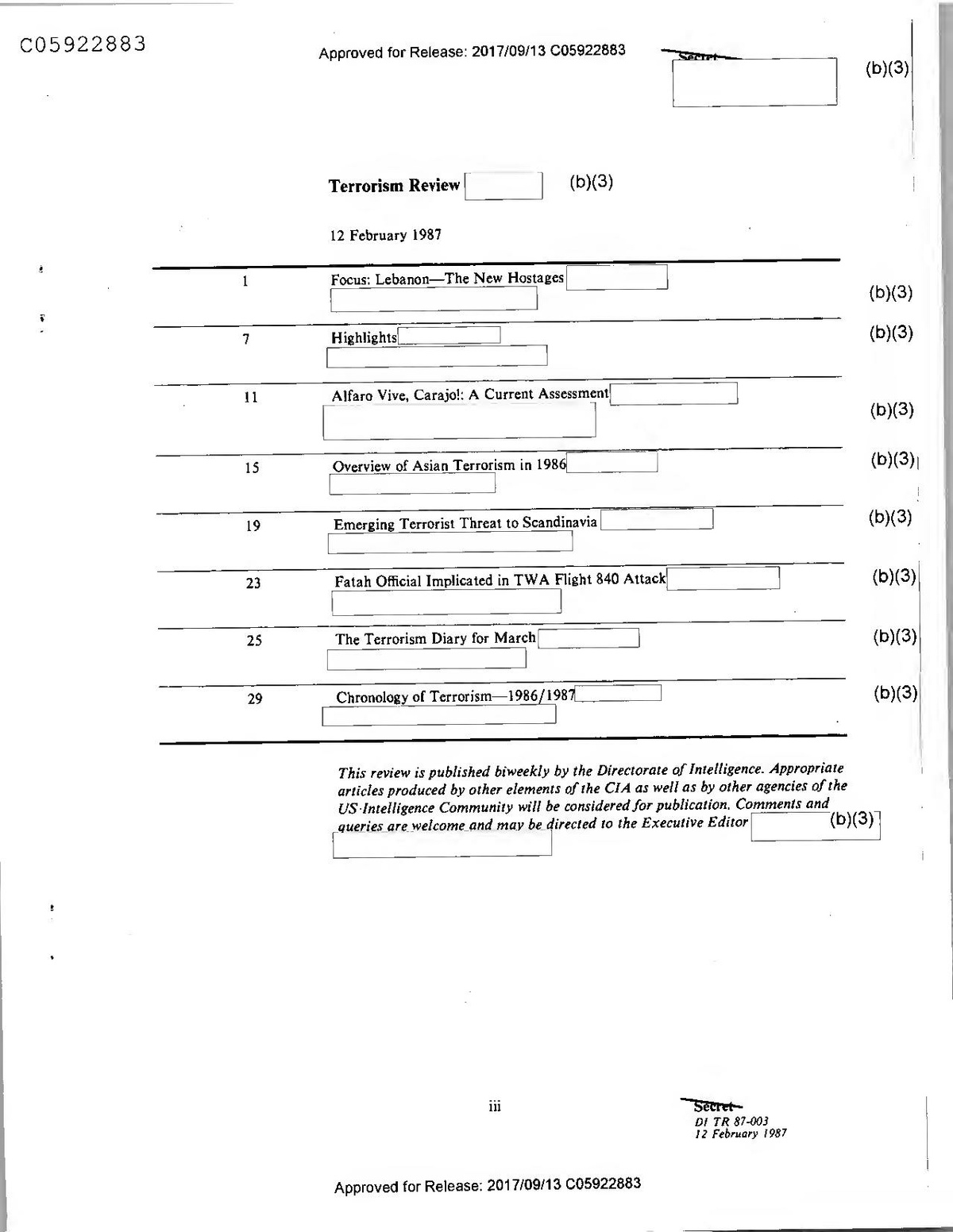
Terrorism Review
(b)(3)
12 February 1987
1
Focus: Lebanon—The New Hostages
(b)(3)
7
Highlights!
(b)(3)
11
Alfaro Vive, Carajo!: A Current Assessment
(b)(3)
15
Overview of Asian Terrorism in 1986
(b)(3)|
19
(b)(3)
Emerging Terrorist Threat to Scandinavia
23
Fatah Official Implicated in TWA Flight 840 Attack
(b)(3)
25
The Terrorism Diary for March
(b)(3)
29
Chronology of Terrorism—1986/1987
(b)(3)
This review is published biweekly by the Directorate of Intelligence. Appropriate articles produced by other elements of the CIA as well as by other agencies of the US Intelligence Community will be considered for publication. Comments and queries are welcome and may be directed to the Executive Editor
(b)(3)]
i
11i
Secret DI TR 87-003 12 February 1987
Approved for Release: 2017/09/13 C05922883
(b)(3)
Terrorism Review
12 February 1987
-(b)(3)
Focus
Lebanon-The New Hostages
The arrest of a terrorist important to the radical Shia group Hizballah has launched a new round of kidnapings in Lebanon. The terrorist, Muhammad Hammadi_also one of the hijackers of TWA Flight 847—was arrested at Frankfurt airport on 13 January, as he attempted to smuggle liquid explosives into West Germany. Since then, gunmen have seized at least 12 foreigners in West Beirut. We believe that most of the new hostages were taken by elements of the Iranian-backed Hizballah, of which Hammadi is a member. A brother in Lebanon, Abd al-Hadi Hammadi, probably instigated the kidnaping of two West Germans, while other elements probably related to Hizballah have claimed responsibility for the abduction of several other foreigners, including three Americans. The new group of hostages also includes Terry Waite, the Anglican Church envoy who has been trying tînegotiate the release of foreign hostages in Lebanon since the fall of 1985 (b)(3)
Who is Responsible? Within four days of Hammadi's arrest, terrorists had seized their first hostage, a West German businessman named Rudolf Cordes. A second German, Alfred Schmidt, was taken three days later. Schmidt, a technician, had been installing equipment at Beirut University Hospital. On 24 January, Shia extremists kidnaped four professors-among them three American citizens—from Beirut University College. This brings to nine the number of American nationals now held hostage in Lebanon. The fourth professor, an Indian national, has resident alien status and carries a US passport. The terrorists apparently number him among the Americans.
(b)(3)
(b)(1) (b)(3)
We believe that the recent kidnapings were carried out by elements of Hizballah.
two of the Hammadi brothers masterminded the recent operations in Lebanon with the help of several close associates. These men are longtime associates of Imad Mughniyah, leader of the Hizballah cell that controls US and other hostages in Lebanon. At least one of the Hammadis-Abd al-Hadi—is a security chief for Hizballah and oversaw the retaliatory kidnapings of the two Germans. Muhammad Hammadi was one of the hijackers of the TWA flight in June 1985 and is responsible for the death of an American serviceman and the detention of several dozen Americans. A third brother, Ali Abbas, was arrested in West Germany on 26 January. He apparently confessed to successfully smuggling liquid explosives into West Germany on the same flight as Muhammad.
F(b)(3)
1
Settet DI TR 87-003 12 February 1987
Approved for Release: 2017/09/13 C05922883
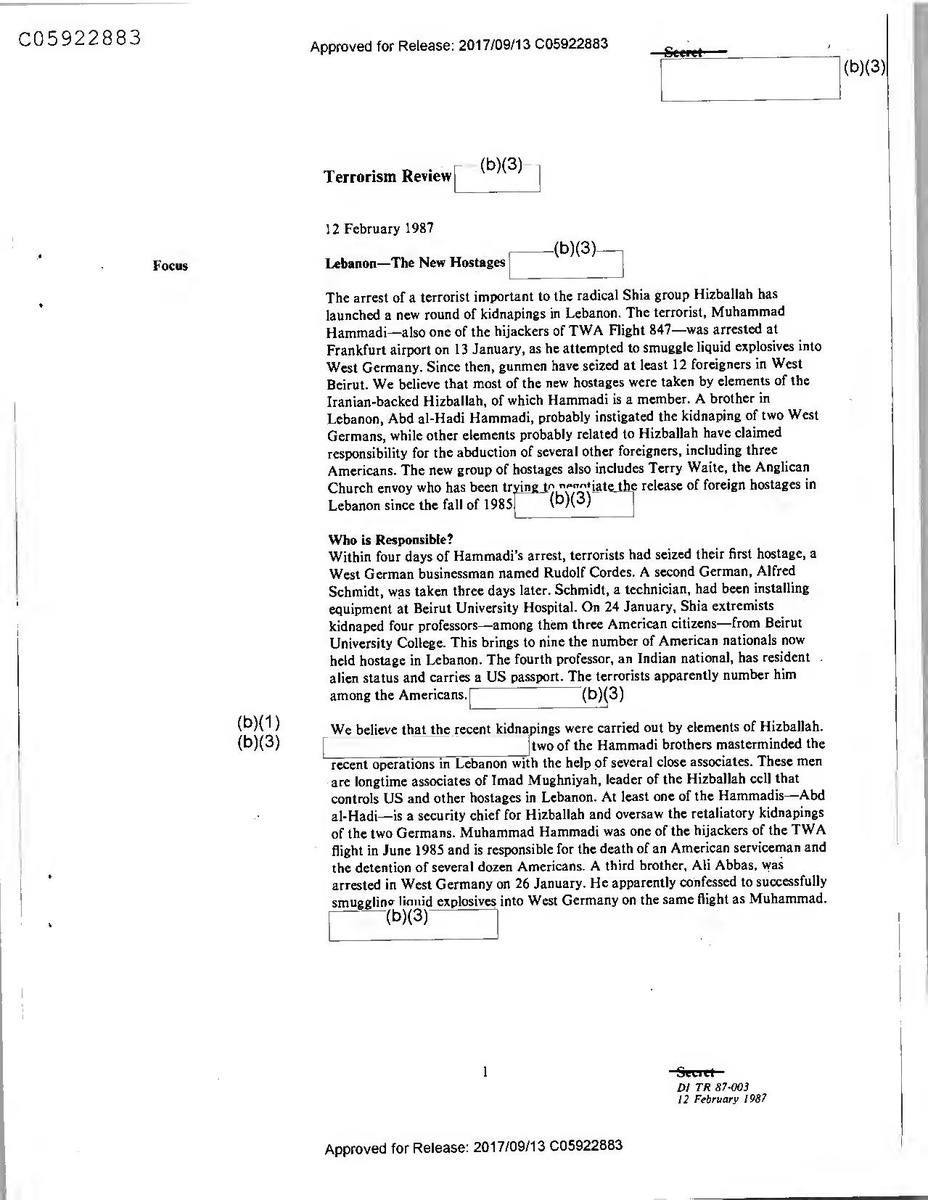
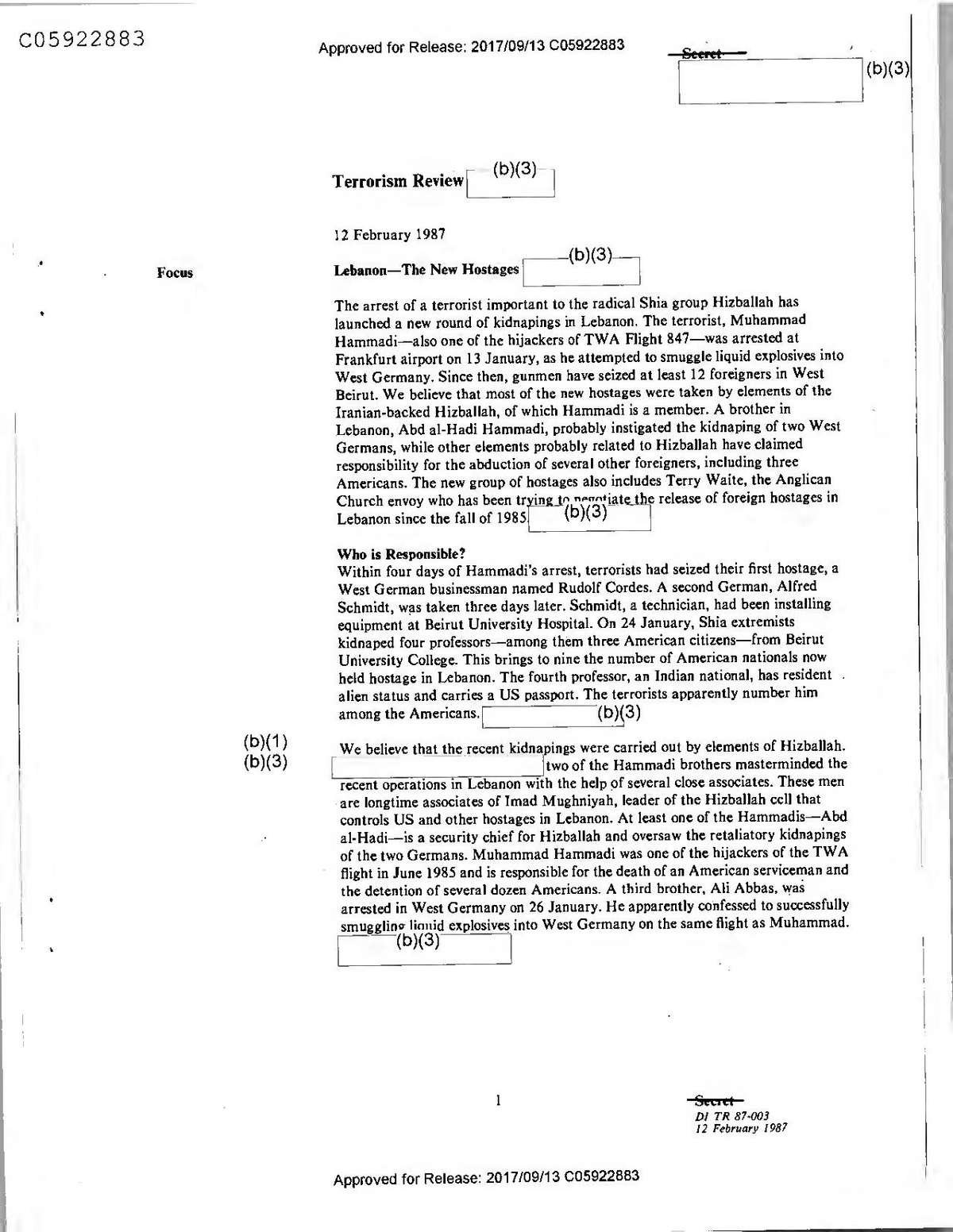
(b)(3)
Terrorism Review
12 February 1987
-(b)(3)
Focus
Lebanon-The New Hostages
The arrest of a terrorist important to the radical Shia group Hizballah has launched a new round of kidnapings in Lebanon. The terrorist, Muhammad Hammadi_also one of the hijackers of TWA Flight 847—was arrested at Frankfurt airport on 13 January, as he attempted to smuggle liquid explosives into West Germany. Since then, gunmen have seized at least 12 foreigners in West Beirut. We believe that most of the new hostages were taken by elements of the Iranian-backed Hizballah, of which Hammadi is a member. A brother in Lebanon, Abd al-Hadi Hammadi, probably instigated the kidnaping of two West Germans, while other elements probably related to Hizballah have claimed responsibility for the abduction of several other foreigners, including three Americans. The new group of hostages also includes Terry Waite, the Anglican Church envoy who has been trying tînegotiate the release of foreign hostages in Lebanon since the fall of 1985 (b)(3)
Who is Responsible? Within four days of Hammadi's arrest, terrorists had seized their first hostage, a West German businessman named Rudolf Cordes. A second German, Alfred Schmidt, was taken three days later. Schmidt, a technician, had been installing equipment at Beirut University Hospital. On 24 January, Shia extremists kidnaped four professors-among them three American citizens—from Beirut University College. This brings to nine the number of American nationals now held hostage in Lebanon. The fourth professor, an Indian national, has resident alien status and carries a US passport. The terrorists apparently number him among the Americans.
(b)(3)
(b)(1) (b)(3)
We believe that the recent kidnapings were carried out by elements of Hizballah.
two of the Hammadi brothers masterminded the recent operations in Lebanon with the help of several close associates. These men are longtime associates of Imad Mughniyah, leader of the Hizballah cell that controls US and other hostages in Lebanon. At least one of the Hammadis-Abd al-Hadi—is a security chief for Hizballah and oversaw the retaliatory kidnapings of the two Germans. Muhammad Hammadi was one of the hijackers of the TWA flight in June 1985 and is responsible for the death of an American serviceman and the detention of several dozen Americans. A third brother, Ali Abbas, was arrested in West Germany on 26 January. He apparently confessed to successfully smuggling liquid explosives into West Germany on the same flight as Muhammad.
F(b)(3)
1
Settet DI TR 87-003 12 February 1987
Approved for Release: 2017/09/13 C05922883
Table 1 Western Hostages Currently Held in Lebanon a
Name/Occupation
Date/Place
Status
Claimant Group
US Hostages
16 March 1984
Islamic Jihad
Presumed dead since June 1985
William Buckley Diplomat Terry Anderson Journalist
16 March 1985
Islamic Jihad
Held by Hizballah
10 June 1985
Islamic Jihad
Heid by Hizballah
Thomas Sutherland Dean, American University of Beirut
9 September 1986
Probably held by Hizballah
Frank Reed Adviser to Lebanese International School
Claimed by Islamic Jihad, later denied; Organization of Revolutionary Justice Organization of Revolutionary Justice
12 September 1986
Probably held by Hizbailah
Joseph Cicippio Deputy Comptroller, American University of Beirut Edward Tracy Itinerant writer
21 October 1986
Organization of Revolutionary Justice
24 January 1987
Probably held by Hizbailah
Organization of the Oppressed on Earth
Same
Same
24 January 1987
Same
24 January 1987
Alan Steen Professor, Beirut University College Robert Polhill Professor, Beirut University College John (Jesse) Turner Professor, Beirut University College Mithileshwar Singh Chairman Business Studies, Beirut University College; Indian national who has resident alien status
Samc
24
nuary 1987
Same
Same
French Hostages Marcel Carton
22 March 1985
Islamic Jihad, Khaybar Brigades Probably held by Hizballah Diplomat
West Beirut Marcel Fontaine
22 March 1985
Islamic Jihad, Khaybar Brigades Probably held by Hizballah Diplomat
West Beirut Jean PaUL Kaufmann
22 May 1985 Islamic Jihad
Probably held by Hizballah Journalist
West Beirut Michel Seurat
22 May 1985 Islamic Jihad
Reportedly killed 6 March 1986 Researcher
West Beirut Jean-Louis Normandin
8 March 1986
Organization of Revolutionary Probably held by Hizballah Television Technician
Justice Roger Auque 13 January 1987 No claimant
Hizballah suspected Journalist * We believe "Islamic Jihad" is a covername used by a cell of Islamic Holy War in Arabic. Other factions within Hizballah are Hizballah, led by Imad Mughniyah, to claim credit for terrorist involved in terrorism and use covernames--such Revolutionary operations and to threaten attacks. Its claims are usually accompa- Justice Organization or Organization of the Oppressed on Earthnied by a photograph of a hostage for authentication. Other pro- to mask their true identities and to provide plausible deniability to Iranian factions outside Lebanon also use the term, which means Hizballah leaders and Iran
(b)(3)
Secret
2
Approved for Release: 2017/09/13 C05922883
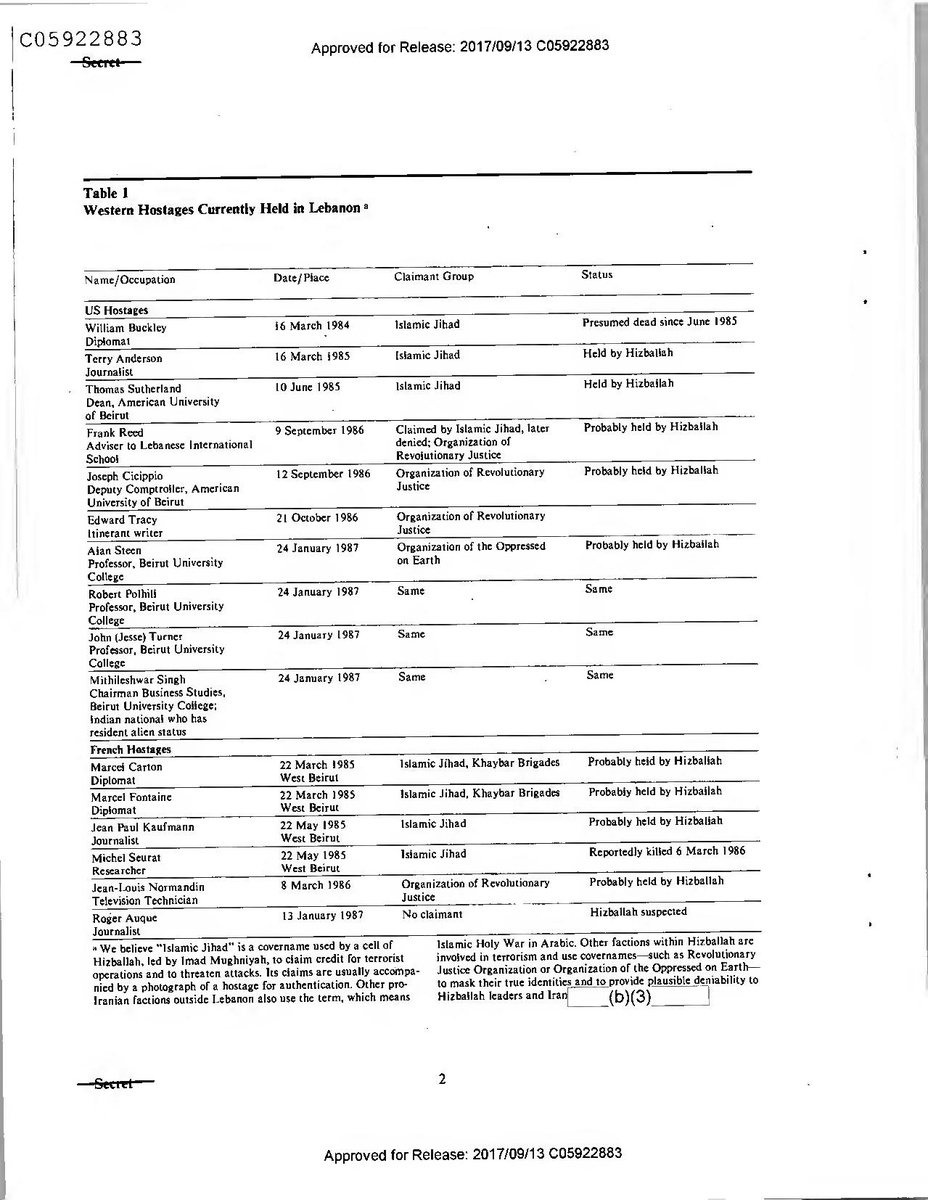
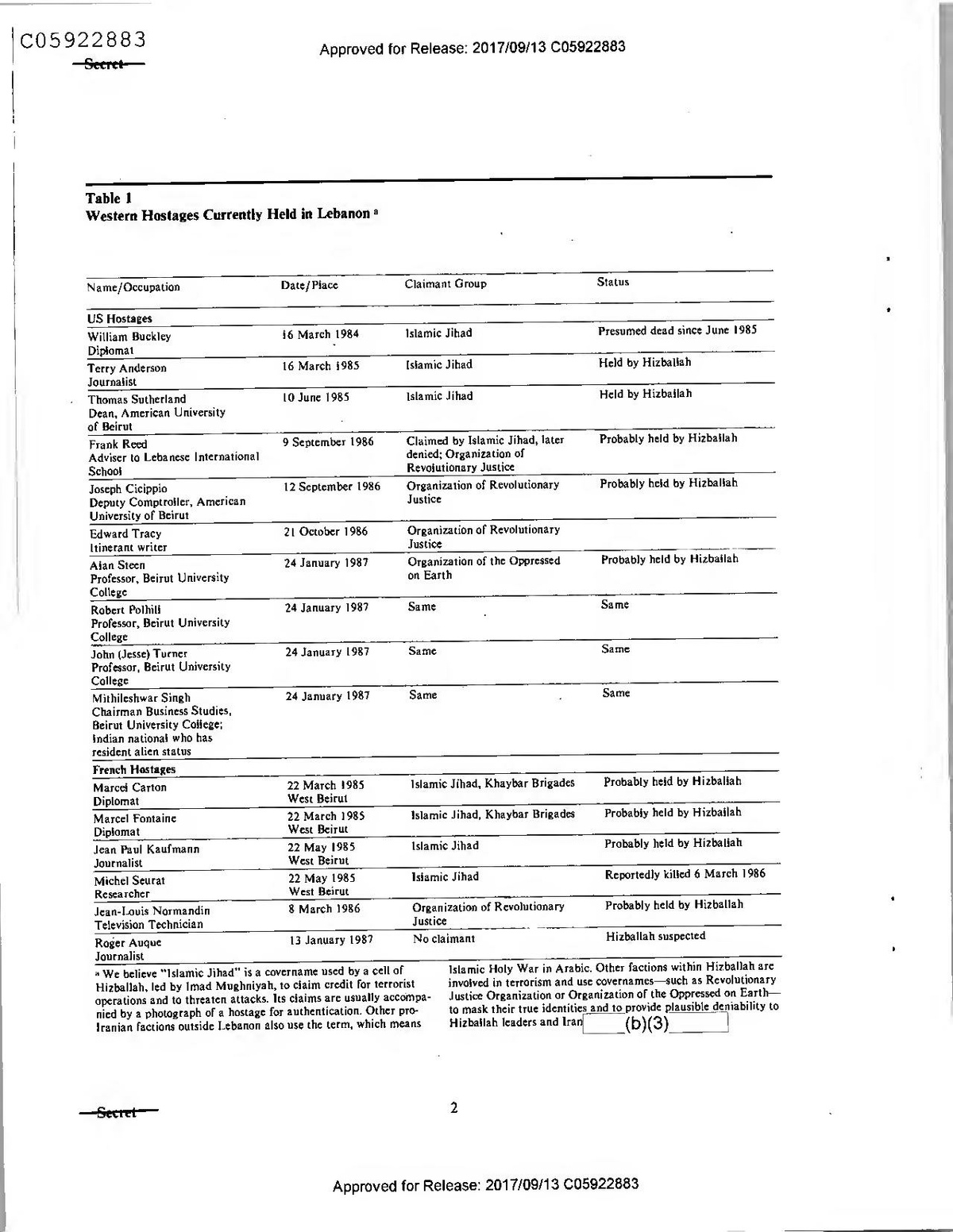
Table 1 Western Hostages Currently Held in Lebanon a
Name/Occupation
Date/Place
Status
Claimant Group
US Hostages
16 March 1984
Islamic Jihad
Presumed dead since June 1985
William Buckley Diplomat Terry Anderson Journalist
16 March 1985
Islamic Jihad
Held by Hizballah
10 June 1985
Islamic Jihad
Heid by Hizballah
Thomas Sutherland Dean, American University of Beirut
9 September 1986
Probably held by Hizballah
Frank Reed Adviser to Lebanese International School
Claimed by Islamic Jihad, later denied; Organization of Revolutionary Justice Organization of Revolutionary Justice
12 September 1986
Probably held by Hizbailah
Joseph Cicippio Deputy Comptroller, American University of Beirut Edward Tracy Itinerant writer
21 October 1986
Organization of Revolutionary Justice
24 January 1987
Probably held by Hizbailah
Organization of the Oppressed on Earth
Same
Same
24 January 1987
Same
24 January 1987
Alan Steen Professor, Beirut University College Robert Polhill Professor, Beirut University College John (Jesse) Turner Professor, Beirut University College Mithileshwar Singh Chairman Business Studies, Beirut University College; Indian national who has resident alien status
Samc
24
nuary 1987
Same
Same
French Hostages Marcel Carton
22 March 1985
Islamic Jihad, Khaybar Brigades Probably held by Hizballah Diplomat
West Beirut Marcel Fontaine
22 March 1985
Islamic Jihad, Khaybar Brigades Probably held by Hizballah Diplomat
West Beirut Jean PaUL Kaufmann
22 May 1985 Islamic Jihad
Probably held by Hizballah Journalist
West Beirut Michel Seurat
22 May 1985 Islamic Jihad
Reportedly killed 6 March 1986 Researcher
West Beirut Jean-Louis Normandin
8 March 1986
Organization of Revolutionary Probably held by Hizballah Television Technician
Justice Roger Auque 13 January 1987 No claimant
Hizballah suspected Journalist * We believe "Islamic Jihad" is a covername used by a cell of Islamic Holy War in Arabic. Other factions within Hizballah are Hizballah, led by Imad Mughniyah, to claim credit for terrorist involved in terrorism and use covernames--such Revolutionary operations and to threaten attacks. Its claims are usually accompa- Justice Organization or Organization of the Oppressed on Earthnied by a photograph of a hostage for authentication. Other pro- to mask their true identities and to provide plausible deniability to Iranian factions outside Lebanon also use the term, which means Hizballah leaders and Iran
(b)(3)
Secret
2
Approved for Release: 2017/09/13 C05922883
Table 1 (Continued)
Status
Name/Occupation
Claimant Group
Date/Place
German Hostages
17 January 1987
No claimant
Held by Hizballah
Rudolf Cordes Businessmen
20 January 1987
No claimant
Held by Hizballah
Alfred Schmidt Engineer British Hostages Alec Collett Journalist
25 March 1985
Execution announced April 1986 by Revolutionary Organization of Socialist Muslims (Abu Nidal); body never found.
17 April 1986
No claimant
Unknown
John McCarthy Journalist
20 January 1987
No claimant
Disappeared from Beirut during his effort to mediate hostage crisis
Terry Waite Anglican Church envoy Other Hostages Brian Keenan Irish tcacher
11 April 1985
No claimant
Unknown
No claimant
Unknown
Alberto Molinari Italian businessman
11 September 1985 West Beirut
31 January 1986
Fighting Revolutionary Cells
Unknown
Unknown
No claimant
Chae Do-sung South Korean diplomat Bakr Damanhuri Saudi diplomat/businessman Khalid Dib Saudi businessman
12 January 1987
26 January 1987
Partisans of Islamic Jihad
Probable reason for abduction was to dissuade Saudis from attending Islamic Conference summit in Kuwait
26 January 1987
No claimant
Taken from store
Two English-speakers, possibly Romanian
Two Lcba ncse Armenians
23 January 1987
No claimant
Probably mistaken for West Germans
(b)(3)
3
Secret
Approved for Release: 2017/09/13 C05922883
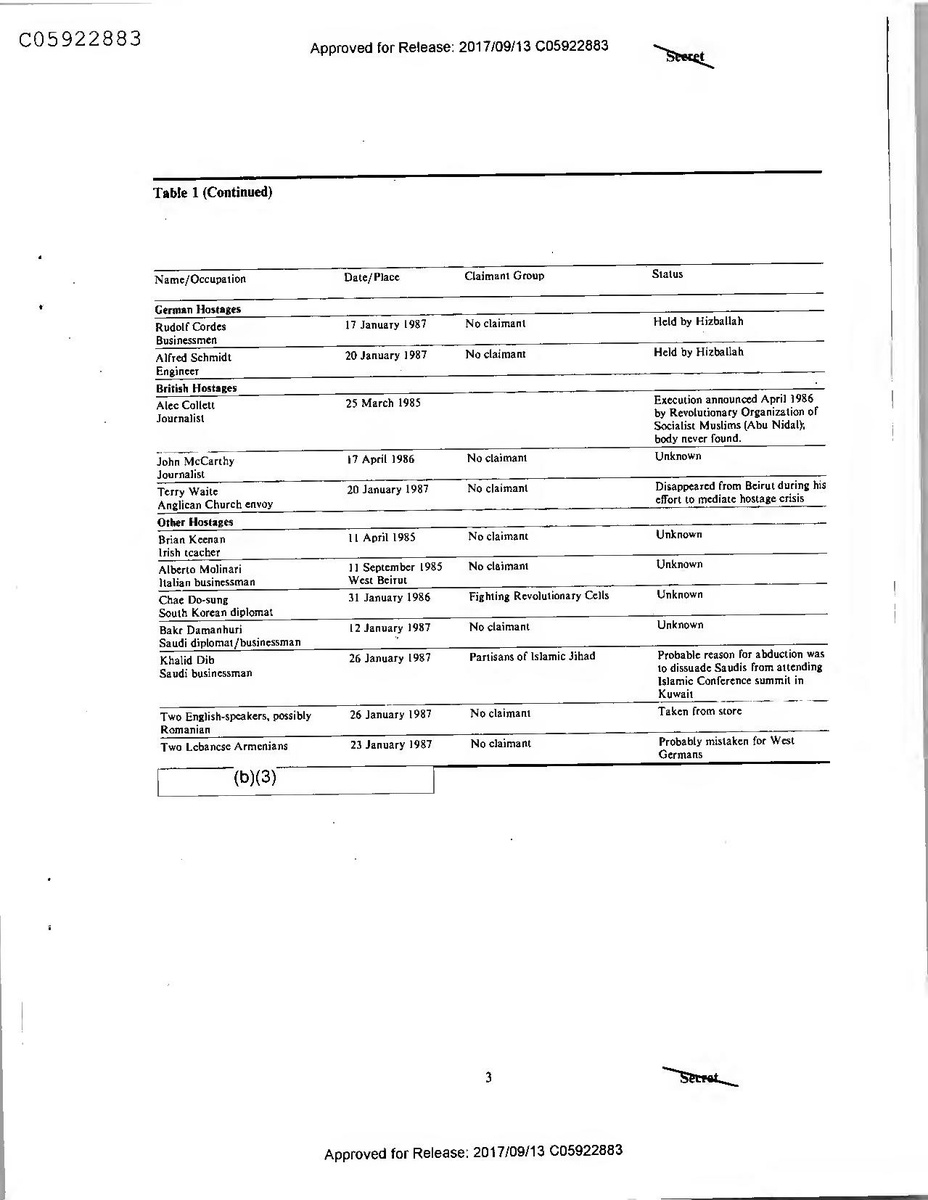
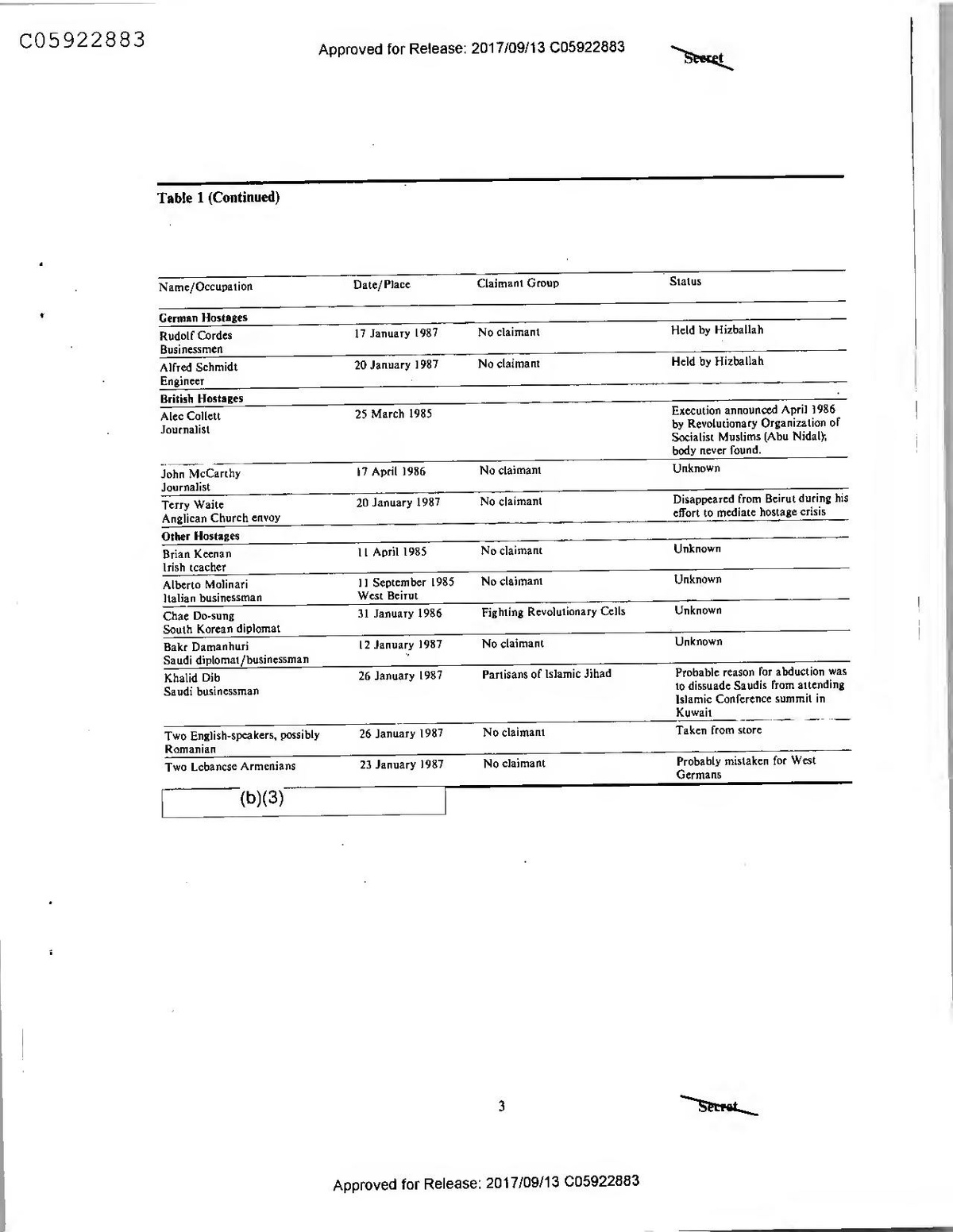
Table 1 (Continued)
Status
Name/Occupation
Claimant Group
Date/Place
German Hostages
17 January 1987
No claimant
Held by Hizballah
Rudolf Cordes Businessmen
20 January 1987
No claimant
Held by Hizballah
Alfred Schmidt Engineer British Hostages Alec Collett Journalist
25 March 1985
Execution announced April 1986 by Revolutionary Organization of Socialist Muslims (Abu Nidal); body never found.
17 April 1986
No claimant
Unknown
John McCarthy Journalist
20 January 1987
No claimant
Disappeared from Beirut during his effort to mediate hostage crisis
Terry Waite Anglican Church envoy Other Hostages Brian Keenan Irish tcacher
11 April 1985
No claimant
Unknown
No claimant
Unknown
Alberto Molinari Italian businessman
11 September 1985 West Beirut
31 January 1986
Fighting Revolutionary Cells
Unknown
Unknown
No claimant
Chae Do-sung South Korean diplomat Bakr Damanhuri Saudi diplomat/businessman Khalid Dib Saudi businessman
12 January 1987
26 January 1987
Partisans of Islamic Jihad
Probable reason for abduction was to dissuade Saudis from attending Islamic Conference summit in Kuwait
26 January 1987
No claimant
Taken from store
Two English-speakers, possibly Romanian
Two Lcba ncse Armenians
23 January 1987
No claimant
Probably mistaken for West Germans
(b)(3)
3
Secret
Approved for Release: 2017/09/13 C05922883
Two groups have claimed responsibility for the kidnapings at Beirut University College. Shortly after the abductions, a caller claiming to speak for the Organization for the Oppressed on Earth said it had the hostages, and threatened to kill one if Hammadi is not released, and the US continues to support Iraq in its war with Iran. We believe this is another covername for elements of Hizballah; the name has been used since late 1985, mostly in connection with the kidnaping and murder of several Lebanese Jews. As recently as last month, the group claimed it executed more of these Jewish hostages.
(b)(3)
A second group—the “Islamic Jihad for the Liberation of Palestine” (IJLP) claimed in late January that it had kidnaped the Americans. Just as with the more familiar Islamic Jihad cc *rname, communiques have been accompanied by photographs of the hostí is for authentication. The IJLP said it would murder all four hostages within a week if 400 Palestinian prisoners-many of them Shia Muslims—held in Israeli jails were not released and Muhammad Hammadi was not freed. It also threatened to kill the hostages if the United States tried to intervene militarily in Lebanon. Little is known about the group, which claims to be composed of Muslim Palestinian youths, but a group using a similar name—the Islamic Front for the Liberation of Palestine-claimed responsibilty for the grenade attack at the Wailing Wall in Jerusalem last October.
(b)(3)
We believe that these organizations are covernames for Mughniyah's apparatus or other closely related elements of Hizballah. The sophistication of the recent abductions suggests that the terrorists are organized and have good intelligence on the movements of foreigners into and around Beirut, as well as on international flights. The professors abducted from Beirut University College believed that the terrorists were a security force sent to protect them. Rudolf Cordes, the first German taken captive, was picked up just after arriving at Beirut airport. The second German hostage, Alfred Schmidt, was seized at his hotel.
(b)(3)
Where is Terry Waite? We believe Terry Waite is now being detained by the Hizballah elements holding the US hostages. The Anglican envoy has not been seen since 20 January, when he left his hotel and Druze militia protection. Rumors circulated in Beirut that he had gone to the Bekaa Valley or to southern Beirut to negotiate with elements of Hizballah for the release of Terry Anderson and Thomas Sutherland. Claiming it had reassurances from the Druze and other sources in Lebanon, the Anglican Church continued through the end of January to hold out hope for Waite's mission. In early February a senior Druze official told the US Embassy in Beirut that Waite had joined other hostages being held by Mughniyah
(b)(3)
Secret
Approved for Release: 2017/09/13 C05922883
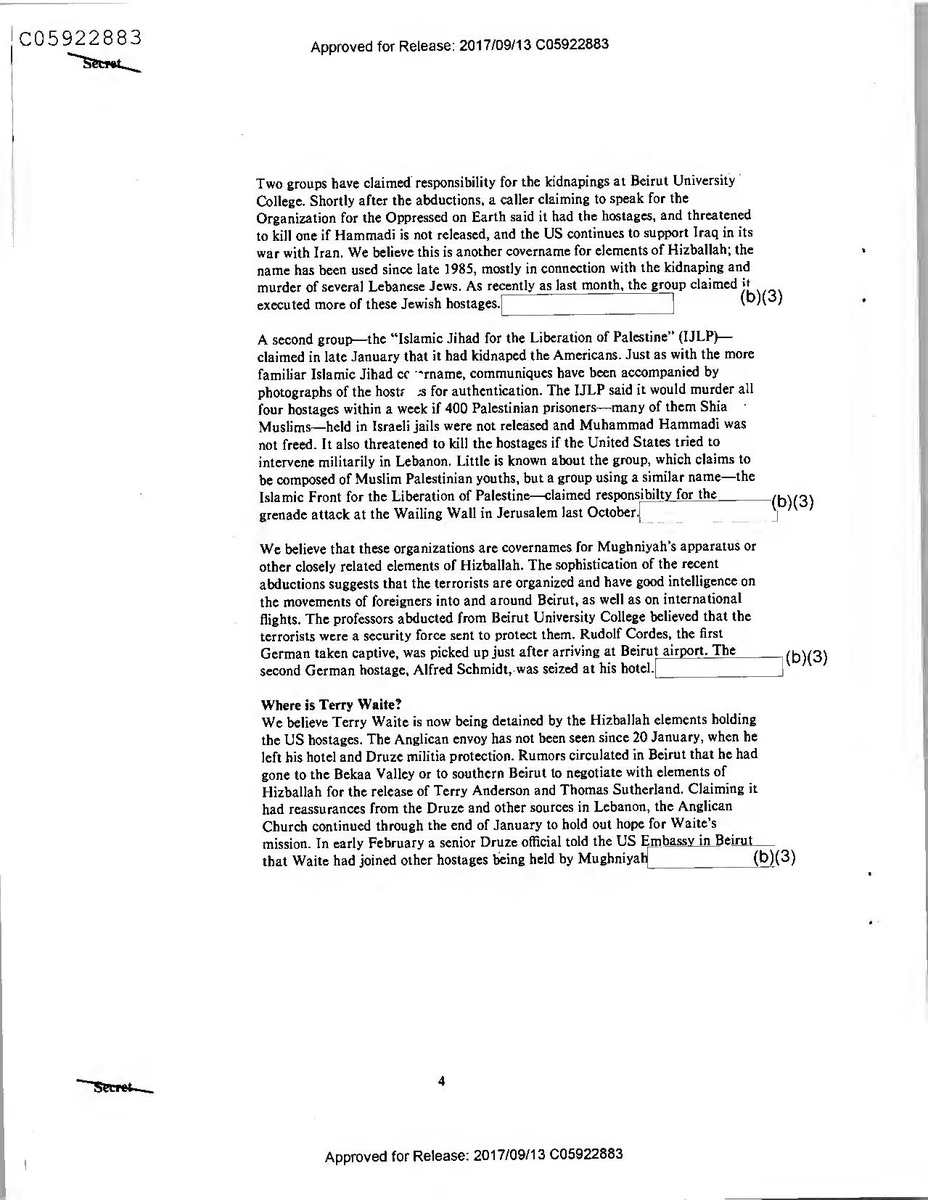
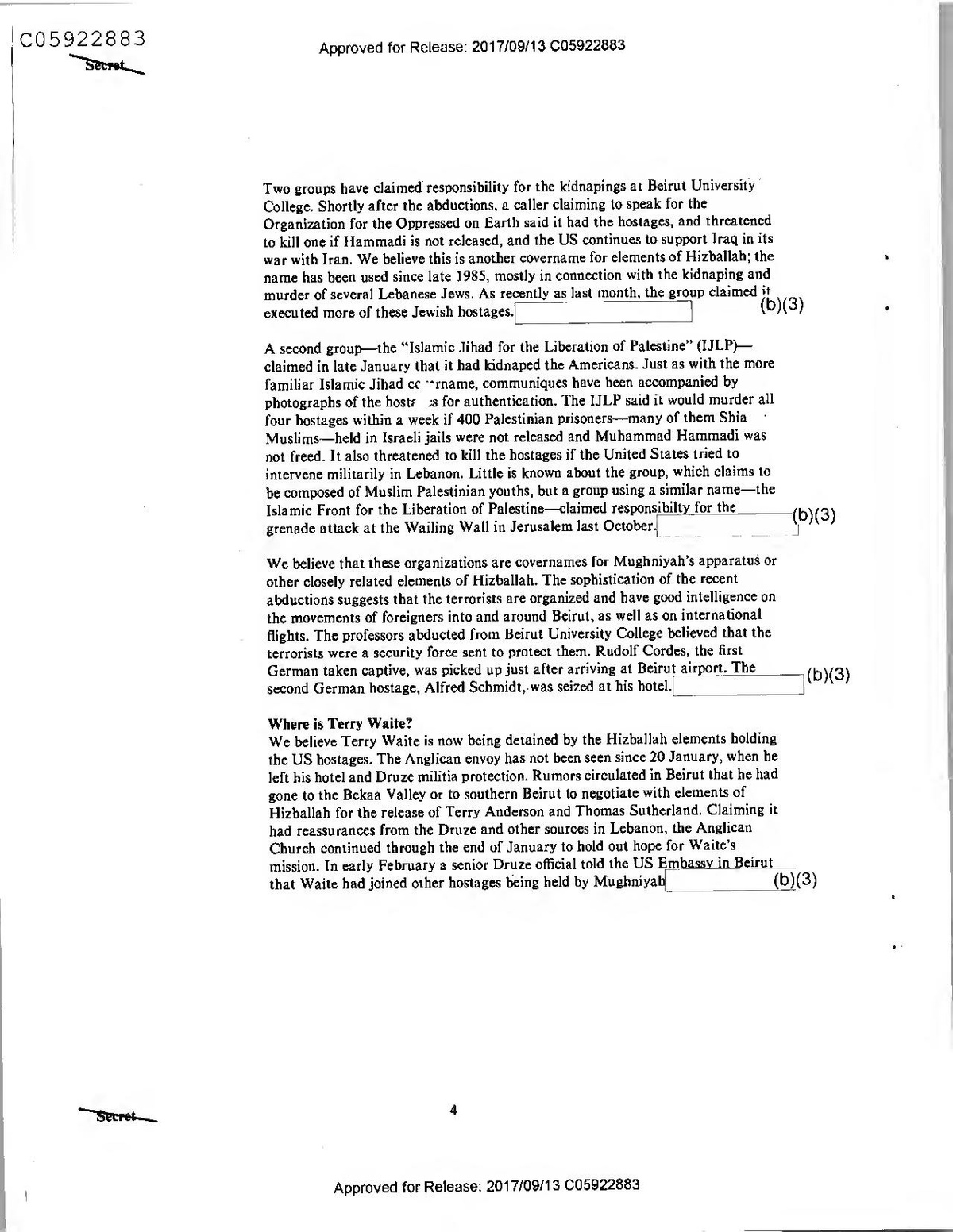
Two groups have claimed responsibility for the kidnapings at Beirut University College. Shortly after the abductions, a caller claiming to speak for the Organization for the Oppressed on Earth said it had the hostages, and threatened to kill one if Hammadi is not released, and the US continues to support Iraq in its war with Iran. We believe this is another covername for elements of Hizballah; the name has been used since late 1985, mostly in connection with the kidnaping and murder of several Lebanese Jews. As recently as last month, the group claimed it executed more of these Jewish hostages.
(b)(3)
A second group—the “Islamic Jihad for the Liberation of Palestine” (IJLP) claimed in late January that it had kidnaped the Americans. Just as with the more familiar Islamic Jihad cc *rname, communiques have been accompanied by photographs of the hostí is for authentication. The IJLP said it would murder all four hostages within a week if 400 Palestinian prisoners-many of them Shia Muslims—held in Israeli jails were not released and Muhammad Hammadi was not freed. It also threatened to kill the hostages if the United States tried to intervene militarily in Lebanon. Little is known about the group, which claims to be composed of Muslim Palestinian youths, but a group using a similar name—the Islamic Front for the Liberation of Palestine-claimed responsibilty for the grenade attack at the Wailing Wall in Jerusalem last October.
(b)(3)
We believe that these organizations are covernames for Mughniyah's apparatus or other closely related elements of Hizballah. The sophistication of the recent abductions suggests that the terrorists are organized and have good intelligence on the movements of foreigners into and around Beirut, as well as on international flights. The professors abducted from Beirut University College believed that the terrorists were a security force sent to protect them. Rudolf Cordes, the first German taken captive, was picked up just after arriving at Beirut airport. The second German hostage, Alfred Schmidt, was seized at his hotel.
(b)(3)
Where is Terry Waite? We believe Terry Waite is now being detained by the Hizballah elements holding the US hostages. The Anglican envoy has not been seen since 20 January, when he left his hotel and Druze militia protection. Rumors circulated in Beirut that he had gone to the Bekaa Valley or to southern Beirut to negotiate with elements of Hizballah for the release of Terry Anderson and Thomas Sutherland. Claiming it had reassurances from the Druze and other sources in Lebanon, the Anglican Church continued through the end of January to hold out hope for Waite's mission. In early February a senior Druze official told the US Embassy in Beirut that Waite had joined other hostages being held by Mughniyah
(b)(3)
Secret
Approved for Release: 2017/09/13 C05922883
We believe Terry Waite has become a victim of his own initiatives. He evidently believed his peacefUL mission and role as a mediator would protect him, but these Hizballah leaders were undeterred by Islamic hospitality. Those who decided to detain him probably believe they can pressure the British Government to press their demands, particularly Hizballah's unwavering goal of the release of 17 Dawa Party terrorists held in Kuwait, who were convicted in the bombings of the US and French Embassies and Kuwaiti installations in 1983.
(b)(3) Other Hostages It is unlikely that all the recent hostage takings are related to the arrest of Muhammad Hammadi. Two Saudis abducted in mid-January, for instance, probably were seized as part of Iran's attempt to dissuade the Saudis from attending the Islamic Conference summit in Kuwait. A French journalist, Roger Auque, also was seized in January as he covered Terry Waite's mission, but no claims have been made yet on his behalf. At least two and possibly four blond English- or German-speaking males were kidnaped while they were shopping in West Beirut in late January. Various press accounts describe them as Armenians, East Europeans, or Scandinavians. They probably were mistaken for German or American nationals, but they have not been released, and no organization has taken credit for their abductions.[ (b)(3)
Outlook In our judgment, prospects for the early release of these hostages—including Terry Waite—are not good. We are almost certain that the captors represent Shia extremist elements. Some of the recent operations could have been financially motivated, done by freelance terrorists who honed to ransom Westerners to the highest bidders.
(b)(3)
Regardless of who initially seized them, we believe decisions on the fate of the hostages will be made by Hizballah's leaders, probably with some reference to Iran. Tehran apparently was not involved in the recent abductions, but probably has been in contact with Hizballah leaders and could play an intermediary role. Despite Iran's considerable support to Hizballah and shared ideological objectives, however, Tehran does not control the hostage holders.
(b)(3)
Syrian or Lebanese pressure to release them is unlikely to sway Hizballah. Damascus currently has only marginal influence with Hizballah, and President Assad has been unwilling to confront Hizballah directly. In our view, the growth of the organization and the number of hostages it is hiding in crowded West Beirut have outstripped Assad's ability to intervene forcibly. Walid Junblatt's Druze militia was responsible for Waite's safety, and Junblatt probably feels his offer to trade places with Waite and to fight Hizballah will help salvage his credibility. Nevertheless, Druze threats are even less likely to force Hizballah to release the Anglican envoy
(b)(3)
5
Secret
Approved for Release: 2017/09/13 C05922883
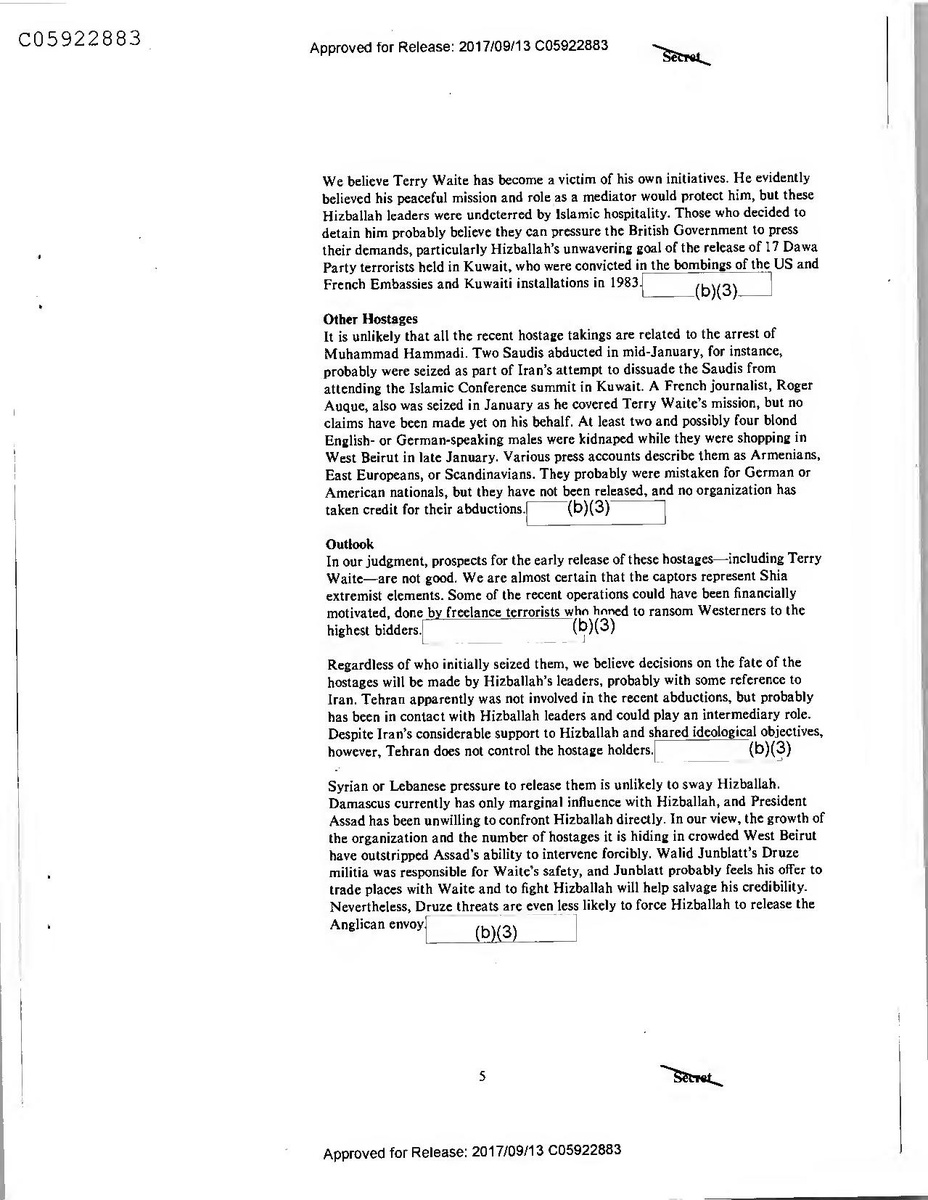
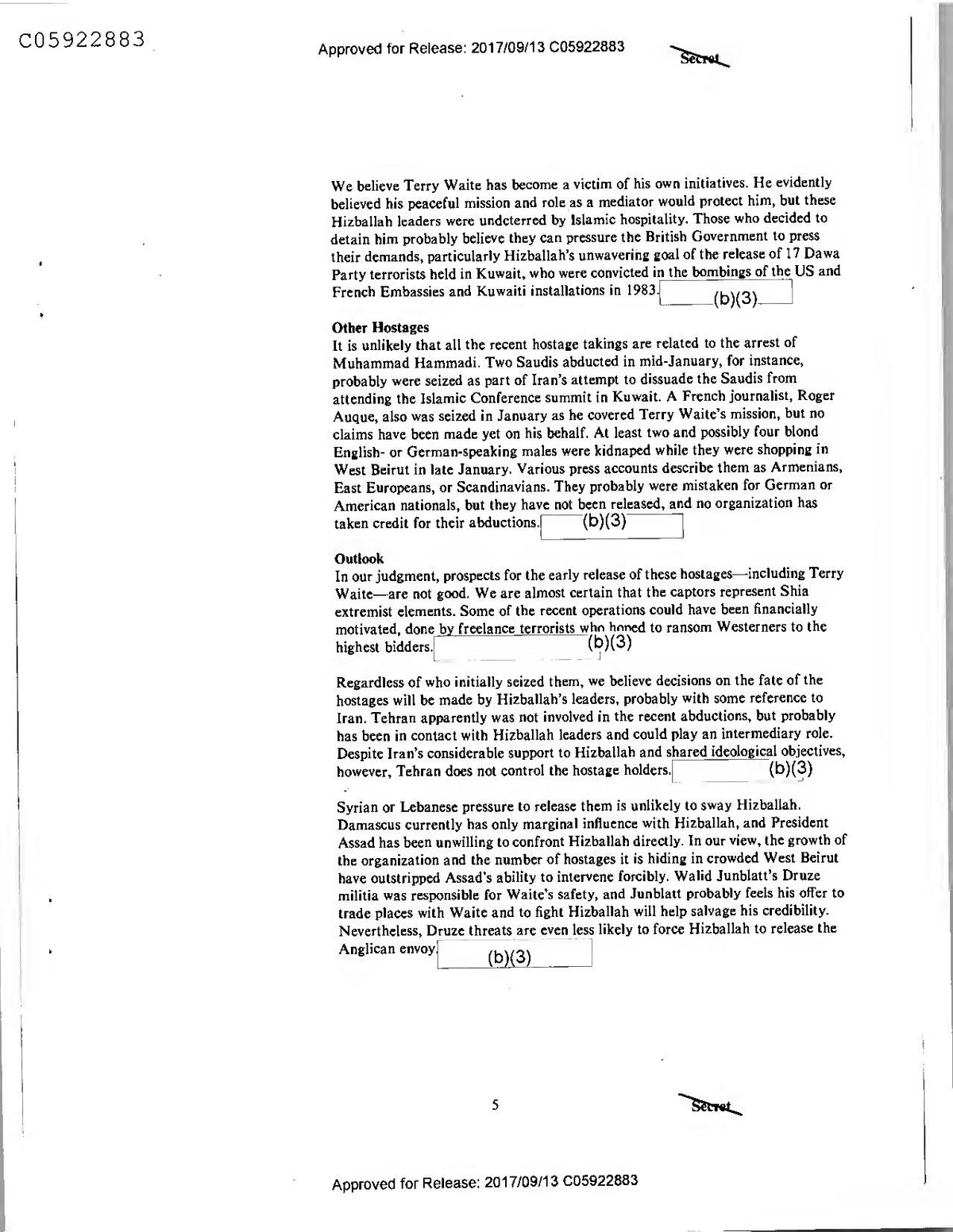
We believe Terry Waite has become a victim of his own initiatives. He evidently believed his peacefUL mission and role as a mediator would protect him, but these Hizballah leaders were undeterred by Islamic hospitality. Those who decided to detain him probably believe they can pressure the British Government to press their demands, particularly Hizballah's unwavering goal of the release of 17 Dawa Party terrorists held in Kuwait, who were convicted in the bombings of the US and French Embassies and Kuwaiti installations in 1983.
(b)(3) Other Hostages It is unlikely that all the recent hostage takings are related to the arrest of Muhammad Hammadi. Two Saudis abducted in mid-January, for instance, probably were seized as part of Iran's attempt to dissuade the Saudis from attending the Islamic Conference summit in Kuwait. A French journalist, Roger Auque, also was seized in January as he covered Terry Waite's mission, but no claims have been made yet on his behalf. At least two and possibly four blond English- or German-speaking males were kidnaped while they were shopping in West Beirut in late January. Various press accounts describe them as Armenians, East Europeans, or Scandinavians. They probably were mistaken for German or American nationals, but they have not been released, and no organization has taken credit for their abductions.[ (b)(3)
Outlook In our judgment, prospects for the early release of these hostages—including Terry Waite—are not good. We are almost certain that the captors represent Shia extremist elements. Some of the recent operations could have been financially motivated, done by freelance terrorists who honed to ransom Westerners to the highest bidders.
(b)(3)
Regardless of who initially seized them, we believe decisions on the fate of the hostages will be made by Hizballah's leaders, probably with some reference to Iran. Tehran apparently was not involved in the recent abductions, but probably has been in contact with Hizballah leaders and could play an intermediary role. Despite Iran's considerable support to Hizballah and shared ideological objectives, however, Tehran does not control the hostage holders.
(b)(3)
Syrian or Lebanese pressure to release them is unlikely to sway Hizballah. Damascus currently has only marginal influence with Hizballah, and President Assad has been unwilling to confront Hizballah directly. In our view, the growth of the organization and the number of hostages it is hiding in crowded West Beirut have outstripped Assad's ability to intervene forcibly. Walid Junblatt's Druze militia was responsible for Waite's safety, and Junblatt probably feels his offer to trade places with Waite and to fight Hizballah will help salvage his credibility. Nevertheless, Druze threats are even less likely to force Hizballah to release the Anglican envoy
(b)(3)
5
Secret
Approved for Release: 2017/09/13 C05922883
Secrer(b)(1) National Police Agency officials plan to mobilize 25,000 to 30,000 policeme(b)(3) protect the summit meetings, a massive show of force of the kind that has discouraged Chukaku-ha in the past during the visit of South Korean President Chun Doo Hwan in September
1984, Chukaku-ha officials admitted that an attack on Chun was impossible because of the tight police security. Some of the same concerns were expressed recently by a group leader in regard to this year's summit. (b)(3)]
Whether these police efforts will be sufficient to guard against a guerrilla attack will depend in part on Chukaku-ha's weaponry, as well as the rapidity with which the group can pull plans and manpower together. A security ring of 1,500 meters established around most summit sites should prevent a successfUL attack if the Chukaku-ha relies on its older rockets. The newly developed rocket, with a range of 4,000 meters, poses more of a risk. The accuracy, payload, and other details of the new rocket are unknown, but its range woUL beyond the conventional security perimeter.
€(b)(3)e the group to fire it from
If it is unable to directly attack summit facilities, Chukaku-ha might choose to launch attacks against less protected buildings away from the actual summit in the Akasa ka Palace. Police speculate that the group could attack a government agency not directly linked to the summit or other public facilities, such as the railway system, to embarrass Prime Minister Nakasone and the political leadership. An attack on a US installation also cannot be ruled out. Chukaku-ha has suggested that it might set off small incendiary devices at such sites—presumably to make a statement rather than do real damage and police admit it may be impossible to protect all possible targets during the summit period. (b)(3)
Other Terrorist Threats to the Summit Although Tokyo police are concentrating on preventing a terrorist attack by Chukaku-ha, the recent discovery that a member of the JRA slipped into the country undetected has raised concern about the potential threat posed by other radical groups.
(b)(1) (b)(3)
The JRA made similar threats before the 1979 Tokyo Summit. It was, however, unable to mount an attack at that time because of tight security, and the group appears even less capable now. In fact, the JRA has not staged a successfUL operation in nine years. Nor is it likely that other radical groups pose a threat to the Tokyo summit. Most European leftist terrorist groups limit their operations close to home, while Middle Eastern terrorists have not traditionally targeted such international gatherings and not well pos operate in Japan.
-(b)(3)
5
-Secret
Approved for Release: 2017/09/13 C05632837
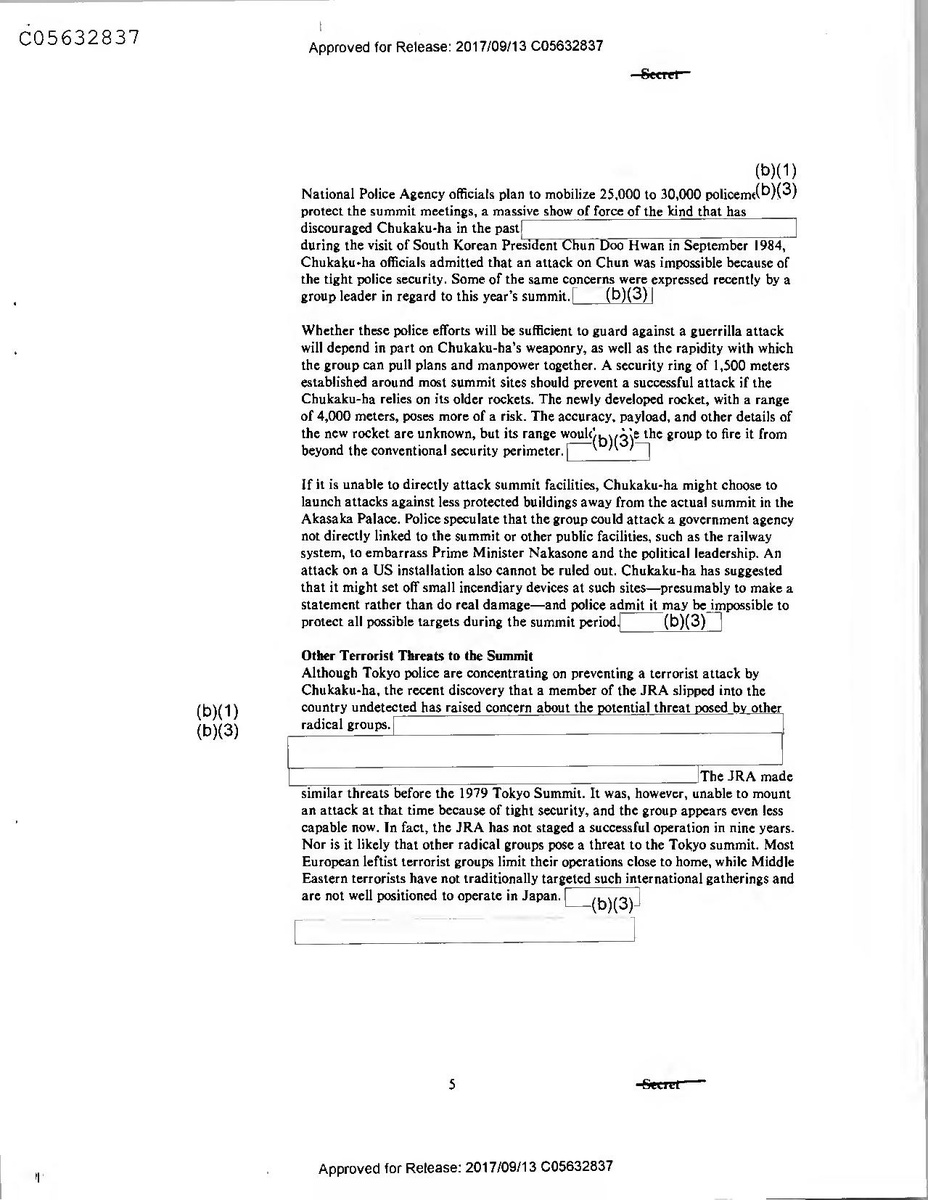
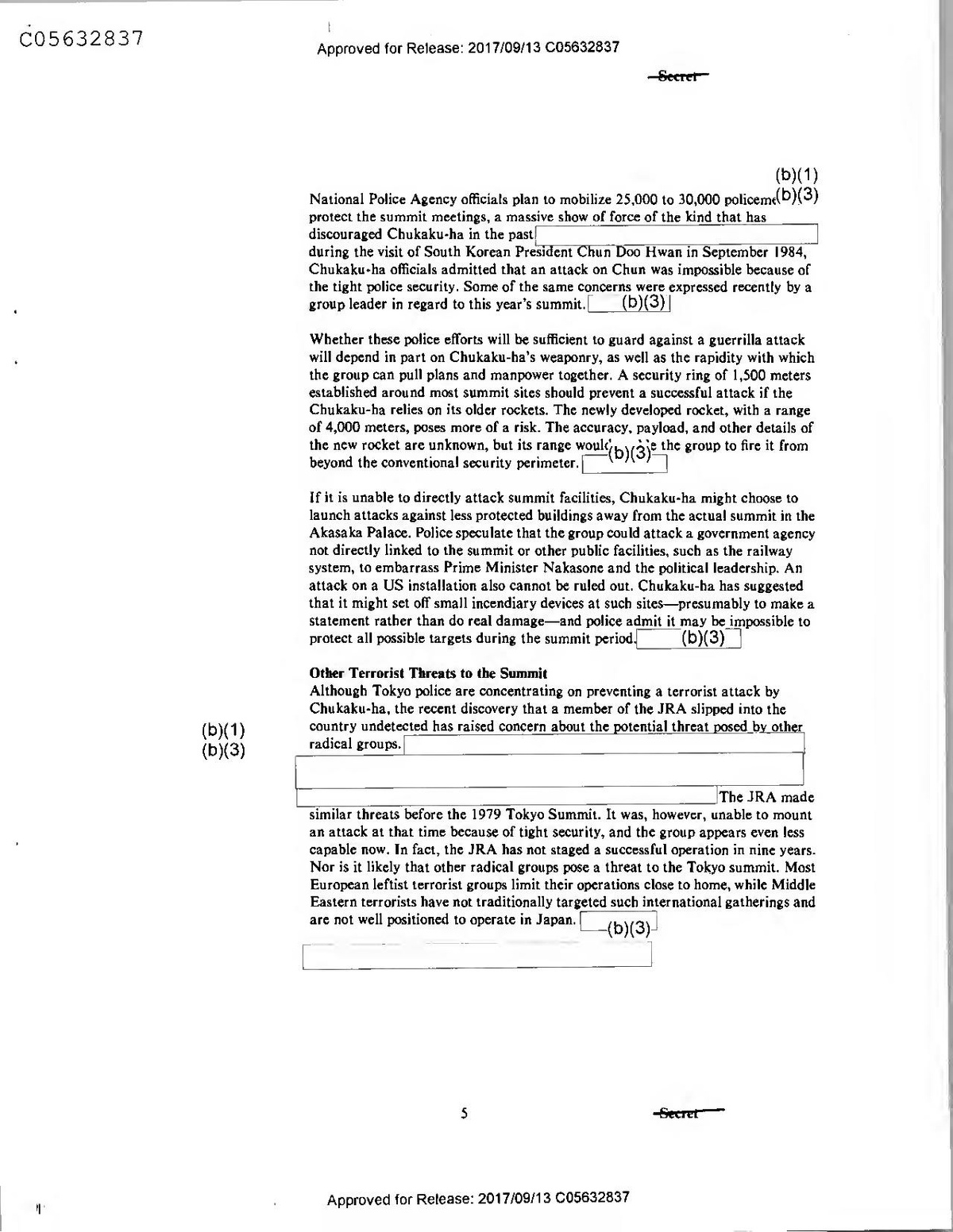
Secrer(b)(1) National Police Agency officials plan to mobilize 25,000 to 30,000 policeme(b)(3) protect the summit meetings, a massive show of force of the kind that has discouraged Chukaku-ha in the past during the visit of South Korean President Chun Doo Hwan in September
1984, Chukaku-ha officials admitted that an attack on Chun was impossible because of the tight police security. Some of the same concerns were expressed recently by a group leader in regard to this year's summit. (b)(3)]
Whether these police efforts will be sufficient to guard against a guerrilla attack will depend in part on Chukaku-ha's weaponry, as well as the rapidity with which the group can pull plans and manpower together. A security ring of 1,500 meters established around most summit sites should prevent a successfUL attack if the Chukaku-ha relies on its older rockets. The newly developed rocket, with a range of 4,000 meters, poses more of a risk. The accuracy, payload, and other details of the new rocket are unknown, but its range woUL beyond the conventional security perimeter.
€(b)(3)e the group to fire it from
If it is unable to directly attack summit facilities, Chukaku-ha might choose to launch attacks against less protected buildings away from the actual summit in the Akasa ka Palace. Police speculate that the group could attack a government agency not directly linked to the summit or other public facilities, such as the railway system, to embarrass Prime Minister Nakasone and the political leadership. An attack on a US installation also cannot be ruled out. Chukaku-ha has suggested that it might set off small incendiary devices at such sites—presumably to make a statement rather than do real damage and police admit it may be impossible to protect all possible targets during the summit period. (b)(3)
Other Terrorist Threats to the Summit Although Tokyo police are concentrating on preventing a terrorist attack by Chukaku-ha, the recent discovery that a member of the JRA slipped into the country undetected has raised concern about the potential threat posed by other radical groups.
(b)(1) (b)(3)
The JRA made similar threats before the 1979 Tokyo Summit. It was, however, unable to mount an attack at that time because of tight security, and the group appears even less capable now. In fact, the JRA has not staged a successfUL operation in nine years. Nor is it likely that other radical groups pose a threat to the Tokyo summit. Most European leftist terrorist groups limit their operations close to home, while Middle Eastern terrorists have not traditionally targeted such international gatherings and not well pos operate in Japan.
-(b)(3)
5
-Secret
Approved for Release: 2017/09/13 C05632837
Hizballah probably will make further demands before agreeing to release Waite or the others, but we believe the basic objective remains the release of the Dawa Party prisoners in Kuwait. One of the terrorists under death sentence there is the brother-in-law of Imad Mugniyah. The release of the Hammadi brothers—at minimum preventing the extradition of Muhammad Hammadi to the United States—also is an important objective, because the Hammadis are so closely tied to Hizballah. Other statements may press for guarantees that the United States, the United Kingdom, France, or Israel will refrain from military retaliation in Lebanon, and perhaps even demand compensation in weapons and money
(b)(3) (b)(3)
6
Secret
Approved for Release: 2017/09/13 C05922883
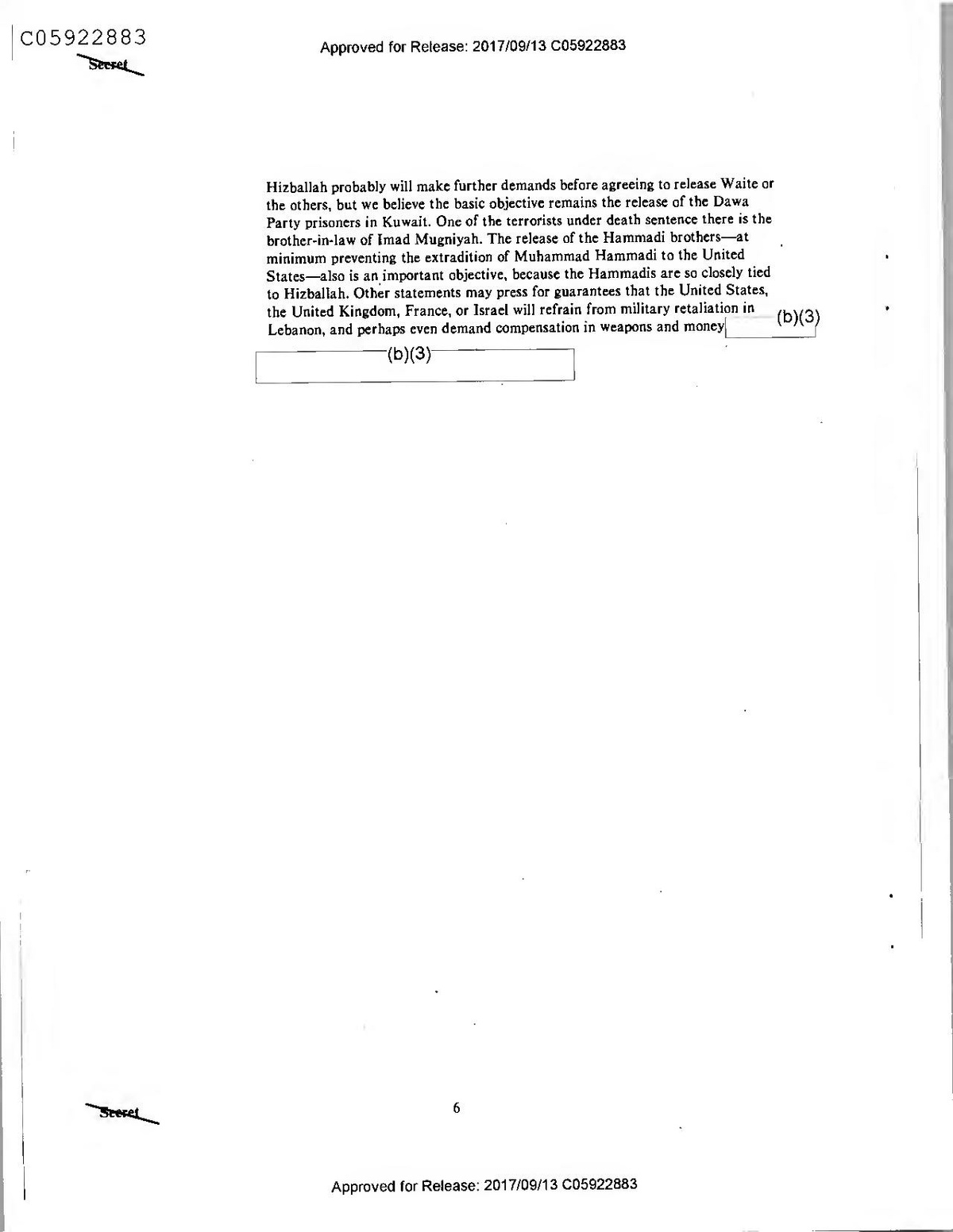
Hizballah probably will make further demands before agreeing to release Waite or the others, but we believe the basic objective remains the release of the Dawa Party prisoners in Kuwait. One of the terrorists under death sentence there is the brother-in-law of Imad Mugniyah. The release of the Hammadi brothers—at minimum preventing the extradition of Muhammad Hammadi to the United States—also is an important objective, because the Hammadis are so closely tied to Hizballah. Other statements may press for guarantees that the United States, the United Kingdom, France, or Israel will refrain from military retaliation in Lebanon, and perhaps even demand compensation in weapons and money
(b)(3) (b)(3)
6
Secret
Approved for Release: 2017/09/13 C05922883
(b)(3)
Highlights
Significant Developments
Western Europe
Italy
Suspected Hizballah Terrorist Arrested in Milan Italian customs police arrested a Lebanese national, Bashir Khudr, on 12 January at Milan airport after they discovered explosives and detonators concealed in his luggage. Nearly 11 kilograms (kg) of explosives were hidden in two bas-relief paintings and various sizes of tinfoil-wrapped chocolate Easter eggs. The detonators were hidden inside batteries placed in a portable radio. Airport security guards had stopped Khudr as part of standing instruction:
n:(b)(3)-01
een closely all arrivals with passports from Arab countries. (b)(1) (b)(3)
Khudr is believed to be a member of Hizballah, and Italian authorities suspect that the explosives were to be used against Israeli targets in Rome. Initially, questions were raised about Khudr's possible association with Fatah's Colonel Hawari. Moroccan authorities arrested four Hawari operatives last August after they discovered that two of them were carrying pottery objects composed of explosive materials. Subsequent technical evidence indicates there is little similarity between the(b)(3)3 Khudr carried and those carried by Hawari operatives.
There is no evidence at this time to link Khudr to Mohammad Hammadi, the suspected Hizballah member arrested on 13 January in Frankfurt while he was attempting to smuggle weapons into West Germany. Khudr has been linked, however, to the “Ladispoli Seven," - -seven Lebanese Shia arrested in Italy in November 1984. believed to be planning an attack against the US Embassy in Rome (b)(3)
Portugal
Members of Anti-ETA Vigilante Group Arrested Four Portuguese members of the Antiterrorist Liberation Group (GAL)--the first time that Portuguese nationals have been known to be involved with this groupwere arrested in Lisbon on 4 January. GAL terrorizes members of the Basque Fatherland and Liberty separatist group (ETA). Portuguese authorities also arrested Jean-Philippe Labade, the suspected leader of GAL, who-along with the four Portuguese-is believed to have attacked and wounded six ETA supporters in two separate actions in the French Basque region in February 1986. French authorities reportedly arrested Labade in 1984 for killing ETA leader Tomas Perez Revilla, but he was released on a technicality.
(b)(3)
7
Secret DI TR 87-003 12 February 1987
Approved for Release: 2017/09/13 C05922883
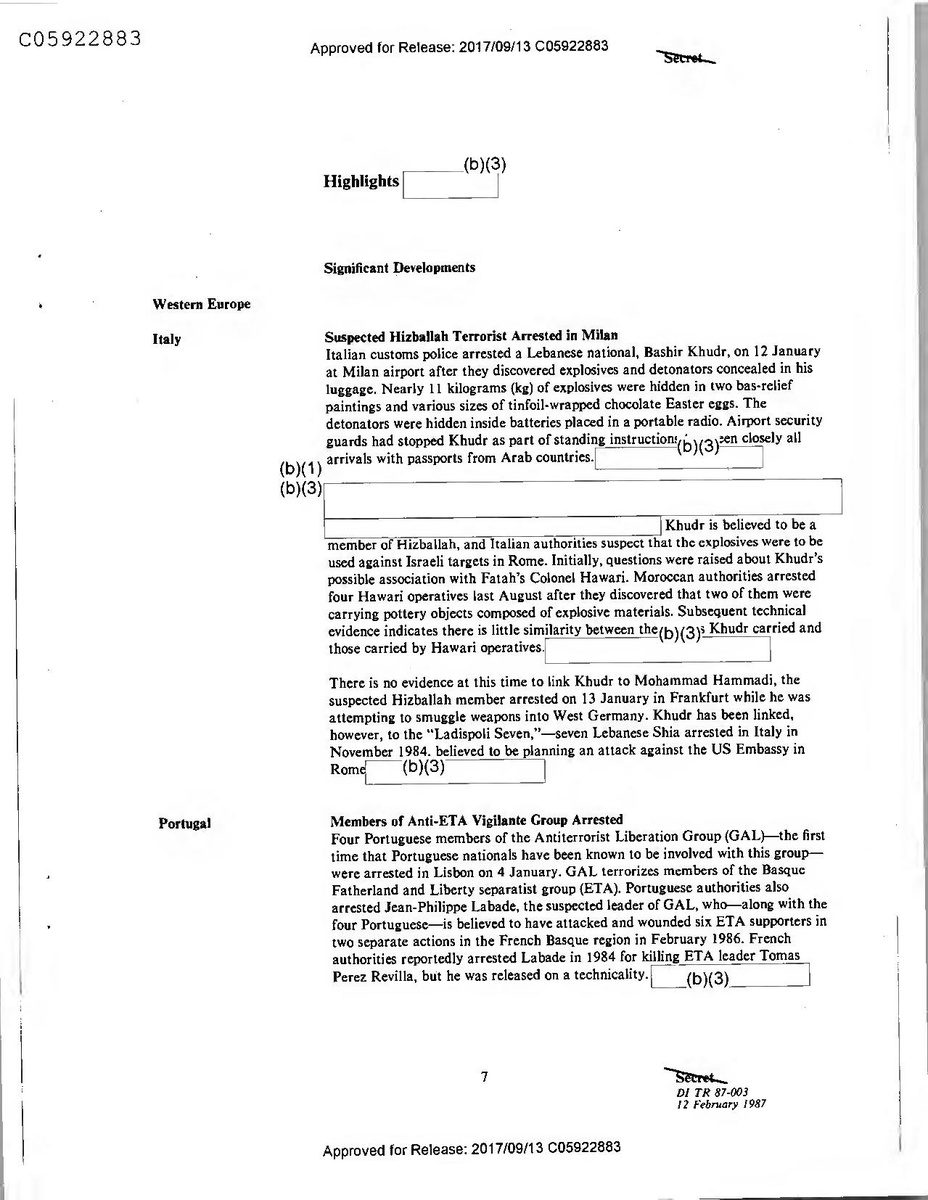
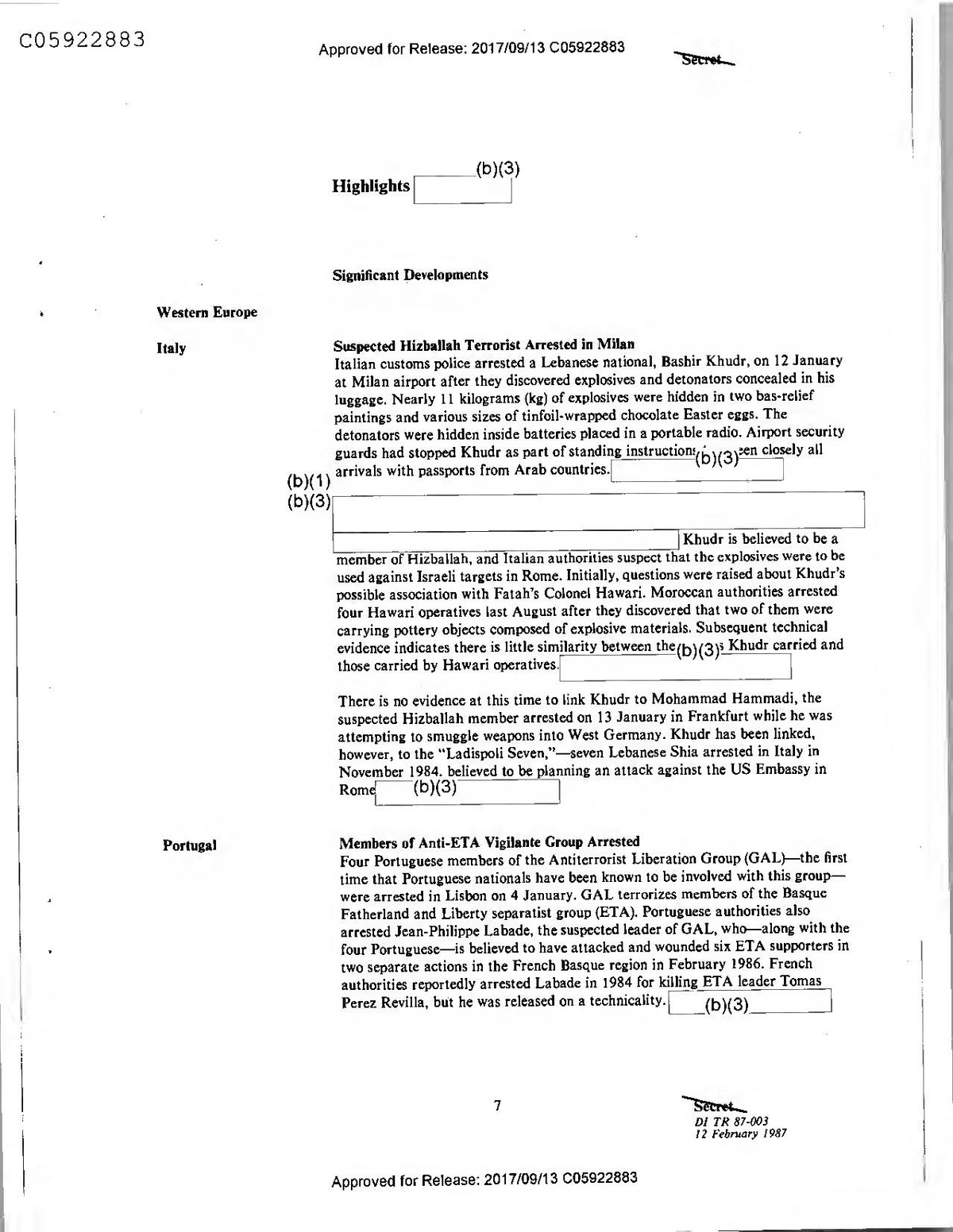
(b)(3)
Highlights
Significant Developments
Western Europe
Italy
Suspected Hizballah Terrorist Arrested in Milan Italian customs police arrested a Lebanese national, Bashir Khudr, on 12 January at Milan airport after they discovered explosives and detonators concealed in his luggage. Nearly 11 kilograms (kg) of explosives were hidden in two bas-relief paintings and various sizes of tinfoil-wrapped chocolate Easter eggs. The detonators were hidden inside batteries placed in a portable radio. Airport security guards had stopped Khudr as part of standing instruction:
n:(b)(3)-01
een closely all arrivals with passports from Arab countries. (b)(1) (b)(3)
Khudr is believed to be a member of Hizballah, and Italian authorities suspect that the explosives were to be used against Israeli targets in Rome. Initially, questions were raised about Khudr's possible association with Fatah's Colonel Hawari. Moroccan authorities arrested four Hawari operatives last August after they discovered that two of them were carrying pottery objects composed of explosive materials. Subsequent technical evidence indicates there is little similarity between the(b)(3)3 Khudr carried and those carried by Hawari operatives.
There is no evidence at this time to link Khudr to Mohammad Hammadi, the suspected Hizballah member arrested on 13 January in Frankfurt while he was attempting to smuggle weapons into West Germany. Khudr has been linked, however, to the “Ladispoli Seven," - -seven Lebanese Shia arrested in Italy in November 1984. believed to be planning an attack against the US Embassy in Rome (b)(3)
Portugal
Members of Anti-ETA Vigilante Group Arrested Four Portuguese members of the Antiterrorist Liberation Group (GAL)--the first time that Portuguese nationals have been known to be involved with this groupwere arrested in Lisbon on 4 January. GAL terrorizes members of the Basque Fatherland and Liberty separatist group (ETA). Portuguese authorities also arrested Jean-Philippe Labade, the suspected leader of GAL, who-along with the four Portuguese-is believed to have attacked and wounded six ETA supporters in two separate actions in the French Basque region in February 1986. French authorities reportedly arrested Labade in 1984 for killing ETA leader Tomas Perez Revilla, but he was released on a technicality.
(b)(3)
7
Secret DI TR 87-003 12 February 1987
Approved for Release: 2017/09/13 C05922883
There are almost certainly other Portuguese members of the group, and Portuguese authorities will continue trying to identify them. Portugese involvement is more likely to be financially, rather than politically, motivated: we believe GAL members are sometimes paid for their attacks on ETA. According to rumors widely circulated in the Spanish press, GAL members may be paid indirectly by the Spanish Government.
(b)(3)]
Spain
Nine Members of ETA Unit Arrested The violent “Madrid Commando" unit of the Basque Fatherland and Liberty separatist group (ETA) suffered a major setback when Spanish police, acting in cooperation with French security services, arrested nine members on 16 and 17 January. According to the press, those arrested are linked to nine major attacks in the past 18 months that resulted in 26 deaths, including those of 17 civil guards and two military officials. At the time of arrest, the group reportedly was planning a major attack on a French-built shopping center. The arrests led to the discovery
in El Escorial, north of Madrid, of (b)(3)afehouses containing weapons and plans for future operations.
(b)(1) (b)(3)
(b)(1) (b)(3)
the commando unit is divided into three groups: gunmen residing in southern France who cross the border to stage attacks; information units that select and plan attacks and escapes; and infrastructure units permanently located in Madrid that set up the resources needed.
the damage to the infrastructure and manpower of the group will impair its operational capabilities for at least the near future, but that the group could be candy to resume activities within several weeks of the arrests.
(b)(3)
Although the roundup is hailed by Spanish police and the press as a major counterterrorist success, we believe that those captured are rank-and-file members, not leaders. The group has long been known to rebound from setbacks, and five members were able to escape arrest. Retaliatory attacks are likely to be made after the unit regroups. A major car bomb attack on 30 January-killing two persons and injuring 37 others, including 22 Army officers-probably was an attempt to show strength in another region.
(b)(3)
Middle East
Israel
Tourism and Terrorism Major terrorist attacks in Europe and the Middle East in the last year and a half have left searing marks on Israel's tourism industry. The hijacking of a TWA airliner in June 1985, the seizing of the Italian cruise ship Achille Lauro in October 1985, the attacks on airports in Rome and Vienna in December 1985, the attack on an IstanbUL synagogue in September 1986, and the grenade attack in mid-October 1986 near the Western (Wailing) Wall in Jerusalem-an especially popular area for tourists-each generated a flurry of telexes from US travel agencies to Israeli hotels and tour offices canceling scheduled visits (b)(3)
8
Setrat
Approved for Release: 2017/09/13 C05922883
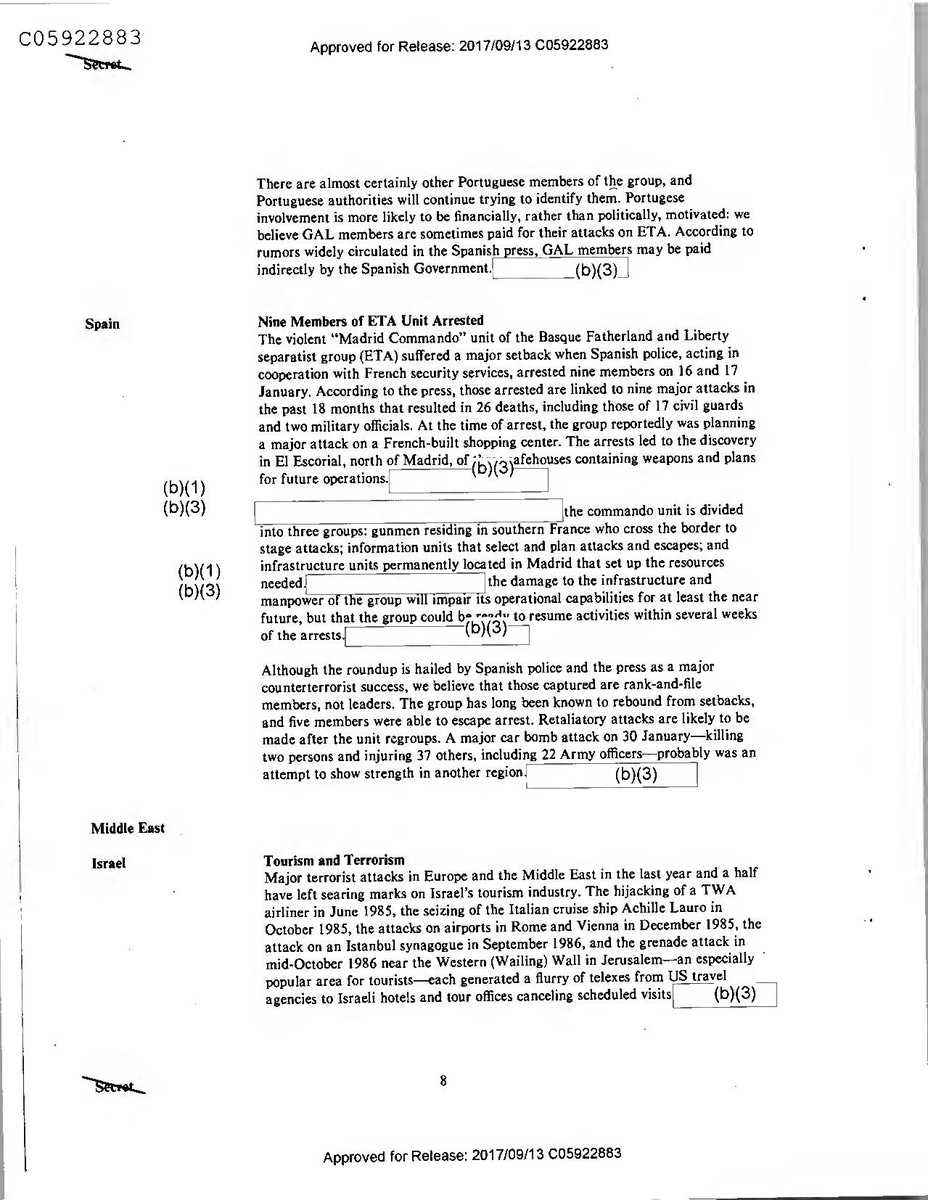
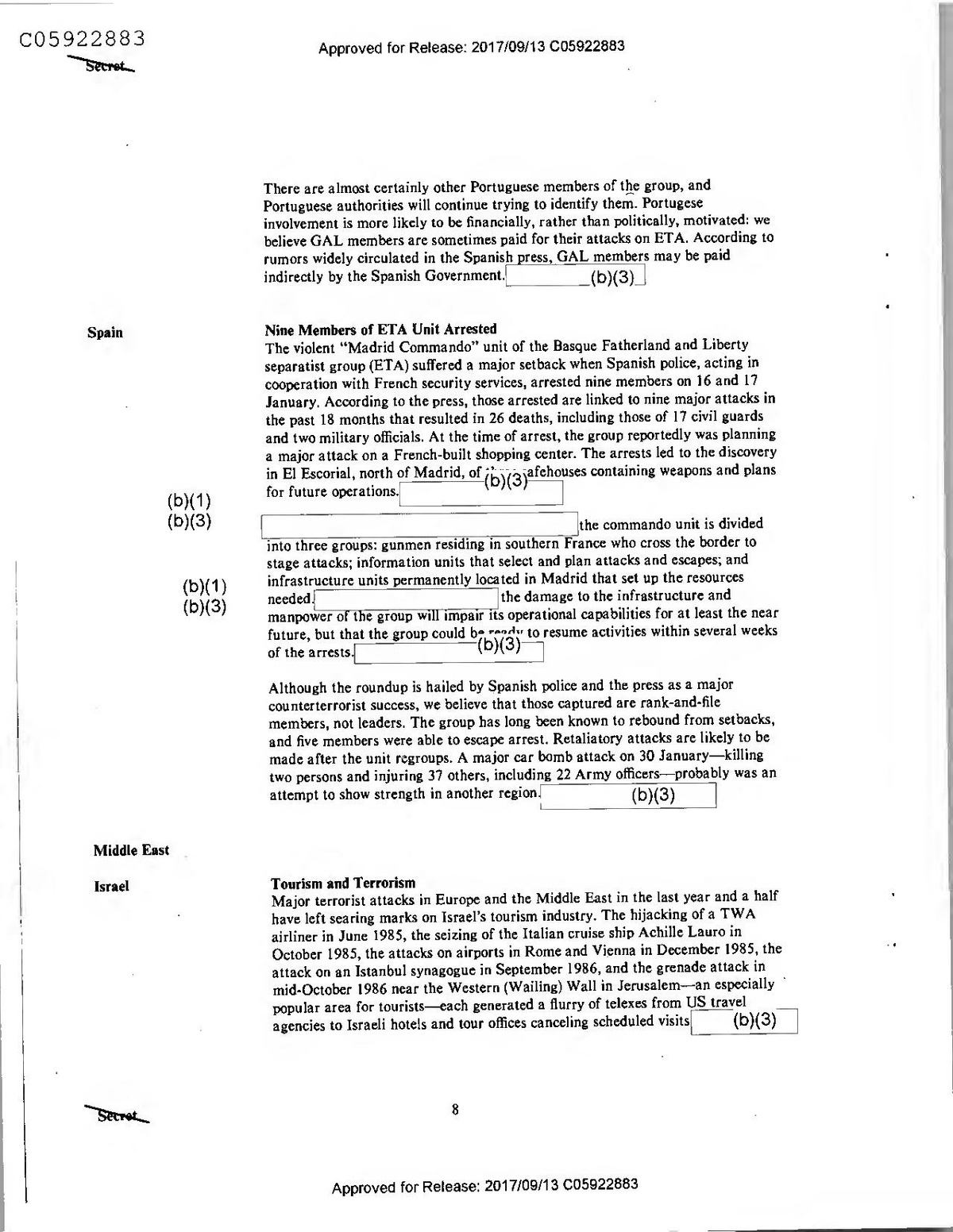
There are almost certainly other Portuguese members of the group, and Portuguese authorities will continue trying to identify them. Portugese involvement is more likely to be financially, rather than politically, motivated: we believe GAL members are sometimes paid for their attacks on ETA. According to rumors widely circulated in the Spanish press, GAL members may be paid indirectly by the Spanish Government.
(b)(3)]
Spain
Nine Members of ETA Unit Arrested The violent “Madrid Commando" unit of the Basque Fatherland and Liberty separatist group (ETA) suffered a major setback when Spanish police, acting in cooperation with French security services, arrested nine members on 16 and 17 January. According to the press, those arrested are linked to nine major attacks in the past 18 months that resulted in 26 deaths, including those of 17 civil guards and two military officials. At the time of arrest, the group reportedly was planning a major attack on a French-built shopping center. The arrests led to the discovery
in El Escorial, north of Madrid, of (b)(3)afehouses containing weapons and plans for future operations.
(b)(1) (b)(3)
(b)(1) (b)(3)
the commando unit is divided into three groups: gunmen residing in southern France who cross the border to stage attacks; information units that select and plan attacks and escapes; and infrastructure units permanently located in Madrid that set up the resources needed.
the damage to the infrastructure and manpower of the group will impair its operational capabilities for at least the near future, but that the group could be candy to resume activities within several weeks of the arrests.
(b)(3)
Although the roundup is hailed by Spanish police and the press as a major counterterrorist success, we believe that those captured are rank-and-file members, not leaders. The group has long been known to rebound from setbacks, and five members were able to escape arrest. Retaliatory attacks are likely to be made after the unit regroups. A major car bomb attack on 30 January-killing two persons and injuring 37 others, including 22 Army officers-probably was an attempt to show strength in another region.
(b)(3)
Middle East
Israel
Tourism and Terrorism Major terrorist attacks in Europe and the Middle East in the last year and a half have left searing marks on Israel's tourism industry. The hijacking of a TWA airliner in June 1985, the seizing of the Italian cruise ship Achille Lauro in October 1985, the attacks on airports in Rome and Vienna in December 1985, the attack on an IstanbUL synagogue in September 1986, and the grenade attack in mid-October 1986 near the Western (Wailing) Wall in Jerusalem-an especially popular area for tourists-each generated a flurry of telexes from US travel agencies to Israeli hotels and tour offices canceling scheduled visits (b)(3)
8
Setrat
Approved for Release: 2017/09/13 C05922883
During and immediately following major terrorist incidents, Israeli tour operators typically estimate a cancellation rate as high as 70 percent. Hotel industry officials expected the overall decline in visitors to reach 30 percent by the end of 1986, mainly because of reduced US tourist arrivals. The number of American tourists visiting Israel dropped by 47 percent in the first eight months of 1986—the latest available figures compared with the same period in 1985.
(b)(3)
Cruise ship tourism appears to have been particularly hard hit by the Achille Lauro hijacking. During the first eight months of 1986, total cruise ship arrivals were down over 48 percent from the same period in 1985. The most severe drop-a 64-percent decline in the first quarter of 1986 as compared with the same period in 1985—wa; number of American tourists coming to Israel via cruise ships.
(b)(3)
(b)(1) (b)(3)
Kuwait
(b)(1)
(b)(3) Shia Terrorists Arrested for Oil Installations Bombings Kuwaiti authorities arrested 11 suspects on 19 January for the bombings of oil installations in June 1986 and January 1987.
the suspects were in possession of arms and explosives. The arms caches included Israeli, US, and Soviet arms, silencers, handgrenades, dynamite sticks, machineguns, ammunition, and timing devices for bombs. Five more suspects are still being sought. Virtually all the suspects are Kuwaiti Shia, some from the country's most prominent families and with ethnic ties to Iran.
(b)(3)
Kuwaiti officials have long suspected that local terrorists, backed by Iran, were responsible for the five explosions that seriously damaged oil facilities in June 1986 and for the series of smaller blasts timed to disrupt the Islamic Summit conference held in Kuwait in late January. According to the Embassy, Kuwaiti authorities broke the terrorist ring shortly before the summit started but withheld news of the arrests and the arms caches until the foreign delegations and journalists had left the country. The Embassy also says there are unconfirmed reports that several police were wounded in a shootout with the terrorists. (b) (3)
9
Secret
Approved for Release: 2017/09/13 C05922883
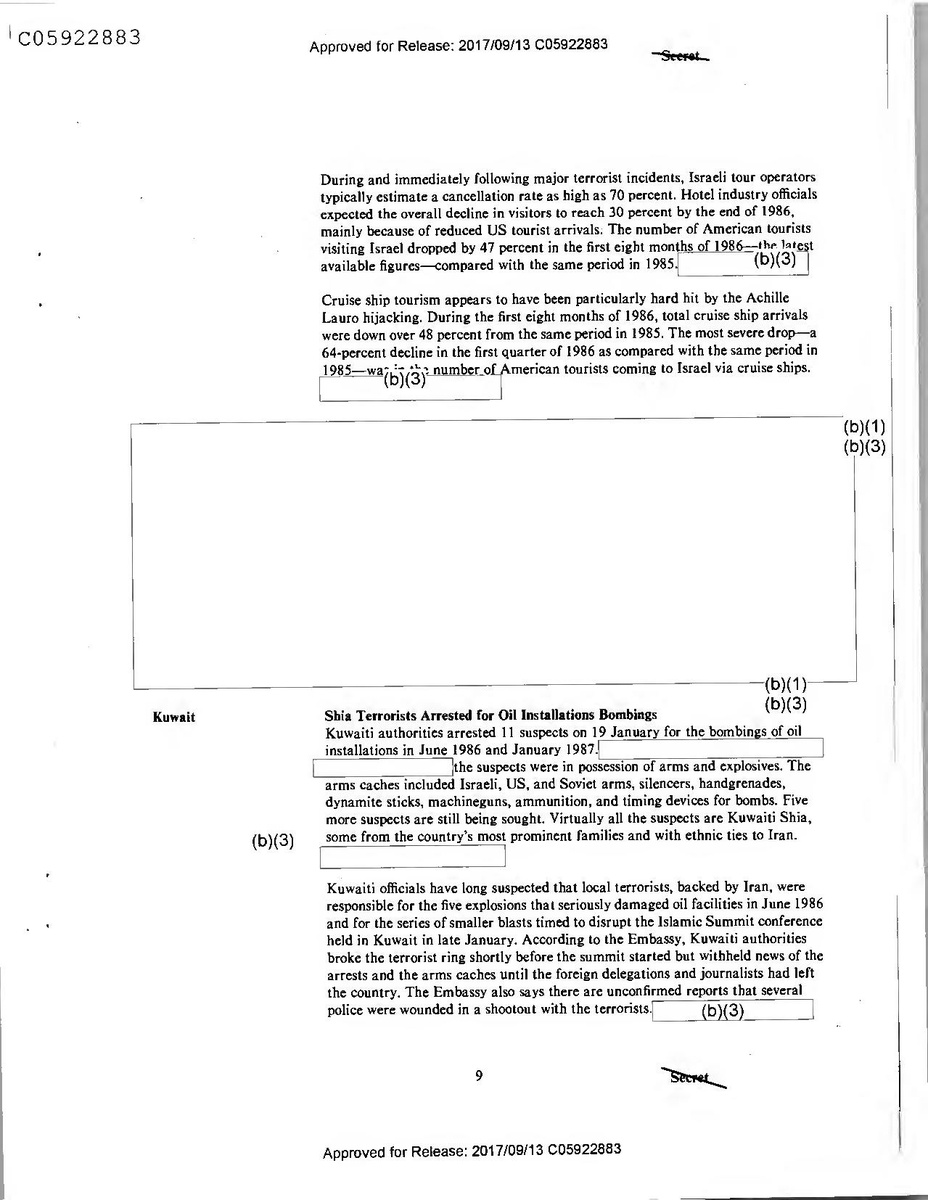
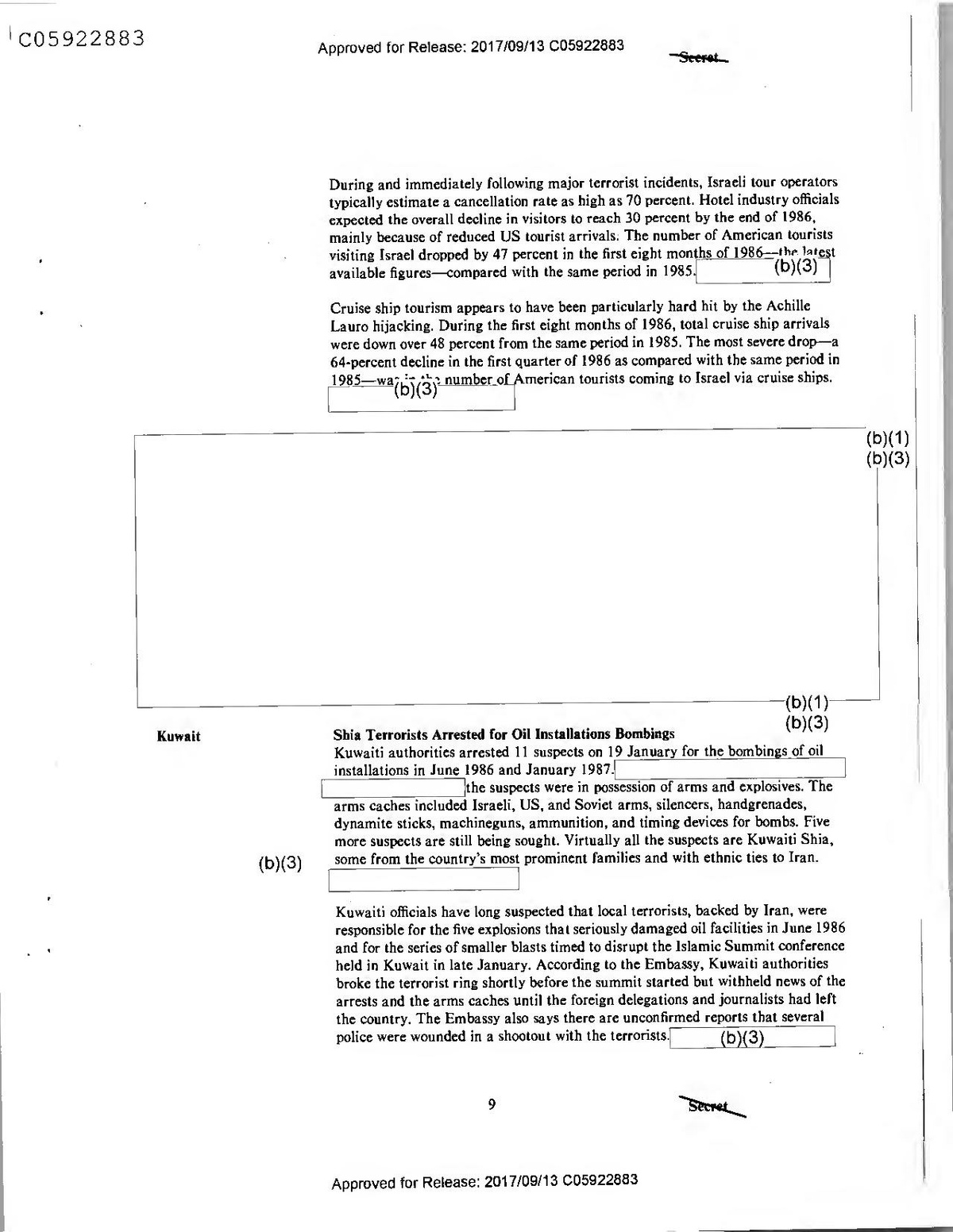
During and immediately following major terrorist incidents, Israeli tour operators typically estimate a cancellation rate as high as 70 percent. Hotel industry officials expected the overall decline in visitors to reach 30 percent by the end of 1986, mainly because of reduced US tourist arrivals. The number of American tourists visiting Israel dropped by 47 percent in the first eight months of 1986—the latest available figures compared with the same period in 1985.
(b)(3)
Cruise ship tourism appears to have been particularly hard hit by the Achille Lauro hijacking. During the first eight months of 1986, total cruise ship arrivals were down over 48 percent from the same period in 1985. The most severe drop-a 64-percent decline in the first quarter of 1986 as compared with the same period in 1985—wa; number of American tourists coming to Israel via cruise ships.
(b)(3)
(b)(1) (b)(3)
Kuwait
(b)(1)
(b)(3) Shia Terrorists Arrested for Oil Installations Bombings Kuwaiti authorities arrested 11 suspects on 19 January for the bombings of oil installations in June 1986 and January 1987.
the suspects were in possession of arms and explosives. The arms caches included Israeli, US, and Soviet arms, silencers, handgrenades, dynamite sticks, machineguns, ammunition, and timing devices for bombs. Five more suspects are still being sought. Virtually all the suspects are Kuwaiti Shia, some from the country's most prominent families and with ethnic ties to Iran.
(b)(3)
Kuwaiti officials have long suspected that local terrorists, backed by Iran, were responsible for the five explosions that seriously damaged oil facilities in June 1986 and for the series of smaller blasts timed to disrupt the Islamic Summit conference held in Kuwait in late January. According to the Embassy, Kuwaiti authorities broke the terrorist ring shortly before the summit started but withheld news of the arrests and the arms caches until the foreign delegations and journalists had left the country. The Embassy also says there are unconfirmed reports that several police were wounded in a shootout with the terrorists. (b) (3)
9
Secret
Approved for Release: 2017/09/13 C05922883
Libya
New Antidissident Terrorist Campaign? Libya may be preparing to launch another of its periodic antidissident campaigns. Two gunmen murdered a 37-year-old Libyan businessman carrying a false Kuwaiti passport as he dined in an Athens restaurant on 7 January. A friend of the victim escaped unharmed. The killing was the first murder of a Libyan opponent of the Qadhafi regime since a Libyan industrialist was murdered in France last June. F(b)(3)
(b)(1) (b)(3)
Latin America
El Salvador
Guerrillas Kidnap Three Mayors Leftist guerrillas of the Farabundo Marti National Liberation Front (FMLN) kidnaped three mayors in various parts of El Salvador in early January. The abductions were part of the guerrillas' announced subversive campaign known as “Heroic January: Farabundo Marti Lives." These kidnapings may have been an attempt to intimidate local mayors, and the group may try more such kidnapings. The FMLN abducted 27 smalltown officials in a similar campaign in 1985,
(b)(3)
Colombia
New Terrorist Organization An armed clandestine wing of “Causa Caribe"-a nonviolent legal organizationreportedly has come to light. The group is said to have conducted kidnapings, robberies, and other terrorist and criminal acts in the northern coast cities of Sar;
(b)(1) Marta and Barranquilla.
(b)(3) It is possible this group may have conducted a bus bombing in Barranquilla on 13 January that killed 13 persons. The M-19—the obvious suspects-claim not to have been involved. We believe the majority of Causa Caribe members have come from the Camilo Torres organization, a small, leftist youth group that is active in many parts of Colombia. It previously has not been associated with terrorist attacks.
(b)(3)
10
Secret
Approved for Release: 2017/09/13 C05922883
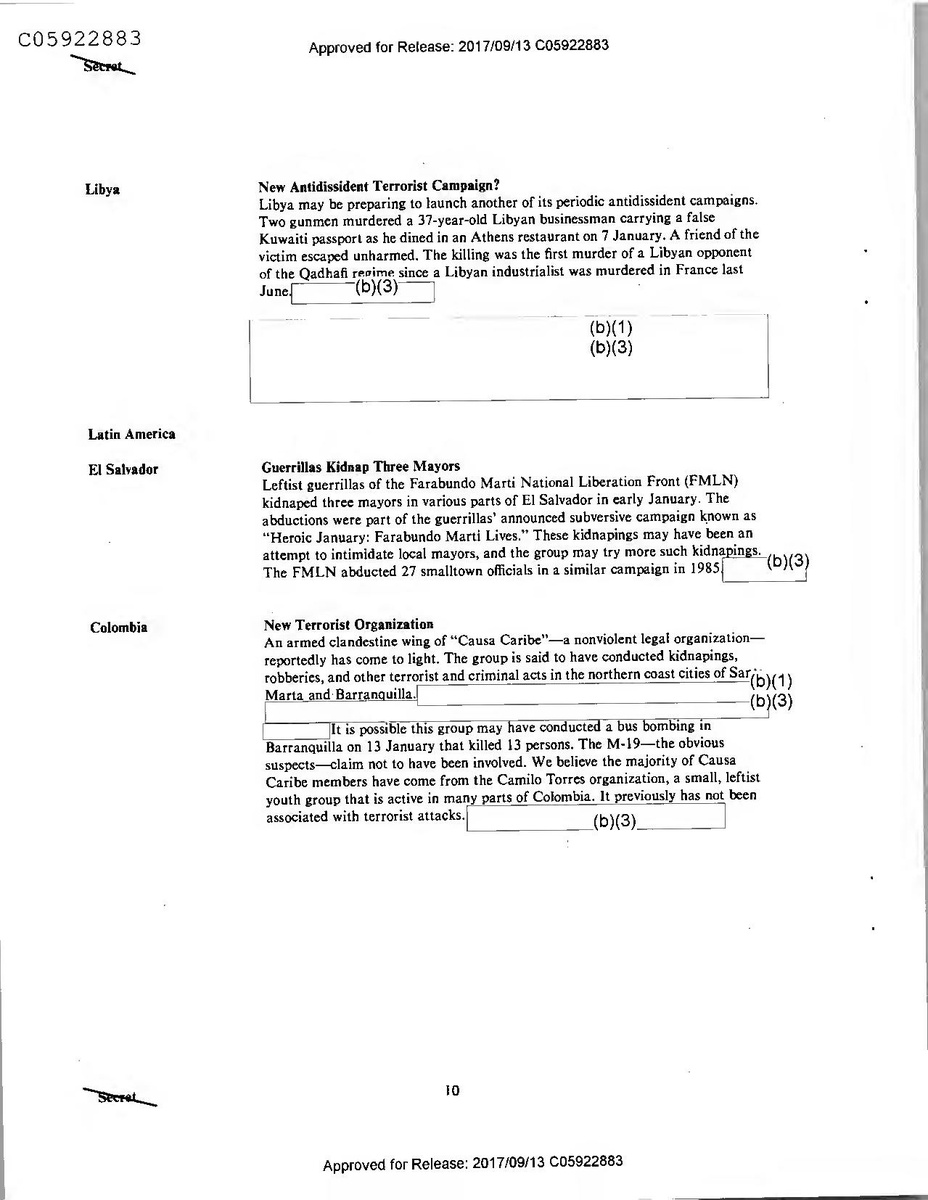
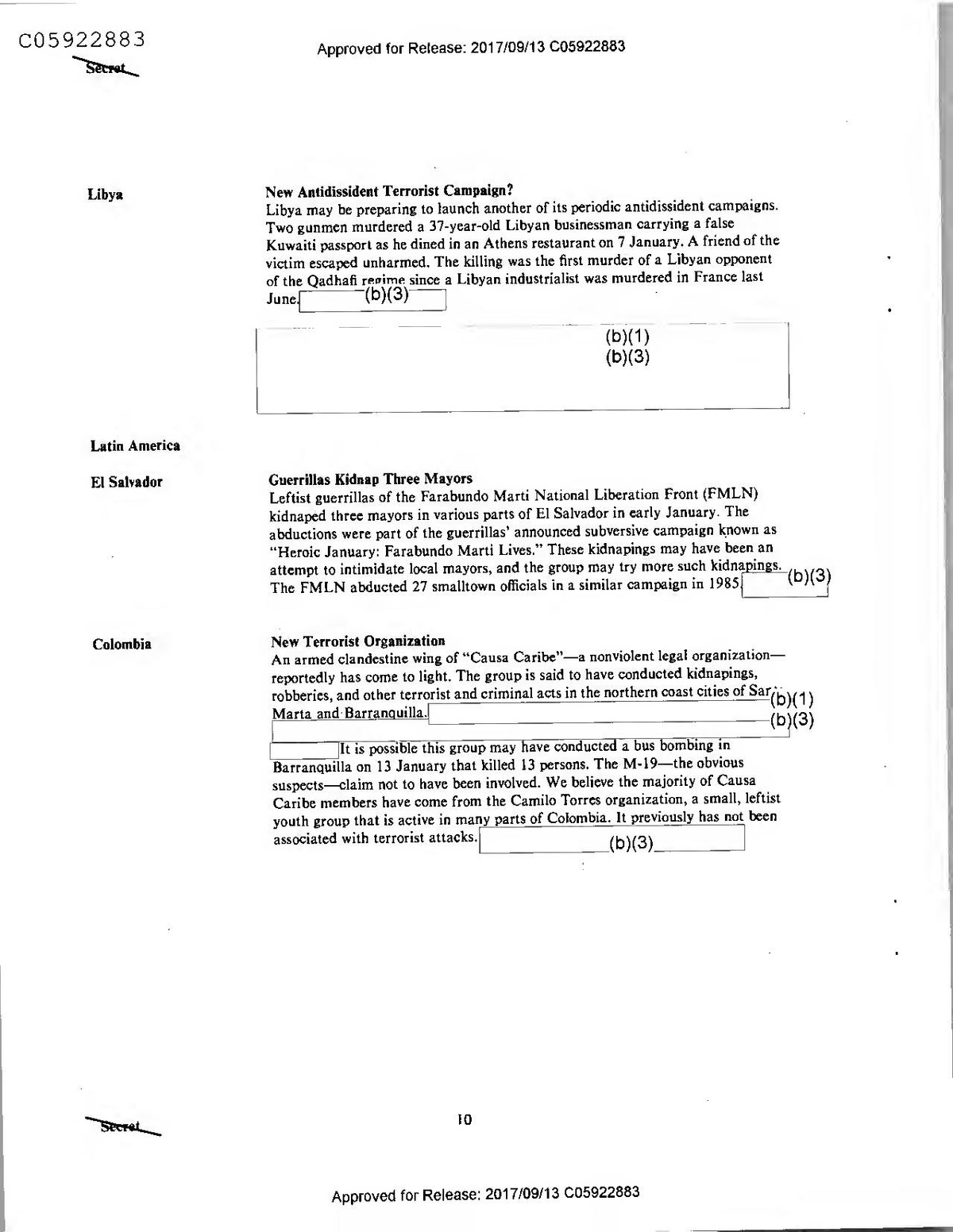
Libya
New Antidissident Terrorist Campaign? Libya may be preparing to launch another of its periodic antidissident campaigns. Two gunmen murdered a 37-year-old Libyan businessman carrying a false Kuwaiti passport as he dined in an Athens restaurant on 7 January. A friend of the victim escaped unharmed. The killing was the first murder of a Libyan opponent of the Qadhafi regime since a Libyan industrialist was murdered in France last June. F(b)(3)
(b)(1) (b)(3)
Latin America
El Salvador
Guerrillas Kidnap Three Mayors Leftist guerrillas of the Farabundo Marti National Liberation Front (FMLN) kidnaped three mayors in various parts of El Salvador in early January. The abductions were part of the guerrillas' announced subversive campaign known as “Heroic January: Farabundo Marti Lives." These kidnapings may have been an attempt to intimidate local mayors, and the group may try more such kidnapings. The FMLN abducted 27 smalltown officials in a similar campaign in 1985,
(b)(3)
Colombia
New Terrorist Organization An armed clandestine wing of “Causa Caribe"-a nonviolent legal organizationreportedly has come to light. The group is said to have conducted kidnapings, robberies, and other terrorist and criminal acts in the northern coast cities of Sar;
(b)(1) Marta and Barranquilla.
(b)(3) It is possible this group may have conducted a bus bombing in Barranquilla on 13 January that killed 13 persons. The M-19—the obvious suspects-claim not to have been involved. We believe the majority of Causa Caribe members have come from the Camilo Torres organization, a small, leftist youth group that is active in many parts of Colombia. It previously has not been associated with terrorist attacks.
(b)(3)
10
Secret
Approved for Release: 2017/09/13 C05922883
Alfaro Vive, Carajo!: A Current Assessment
(b)(3)The Ecuadorean Government has scored impressive gains against the Alfaro Vive, Carajo! (AVC) terrorist group over the course of 1986. Making use of foreign counterterrorist training and apparently applying good police tactics, the security forces have been able to penetrate and undermine the terrorist organization. Sensing that the AVC may be in disarray following the losses of several key leaders, we believe President Febres-Cordero-particularly in the wake of the recent coup attempt—will drive ahead with his counterterrorist program. Febres-Cordero will press the advantage to prevent the terrorists from rccouping their losses and resurfacing as a major challenge during his remaining two years in office. Nevertheless, if the government falters in its commitment, the AVC could gain the necessary respite to reorganize and stage operations, although probably only at a low level (b)(3)(b)(3)
IFigure 1. M-19 leader Carlos Pizarro Leon Gomez (bearded, on right) with AVC members.
(b)(1) (b)(3)
(b)(1) (b)(3)
)(1) )(3)
Origins of the Group Information concerning the origins of the AVC is sketchy and at times conflicting. The group may have been formed as early as 1980, although it first surfaced publicly in 1983 when it stole the sword of Eloy Alfaro, a turn-of-the-century revolutionary leader, from a Quito museum.
the group's first activities in the early 1980s were their efforts in the Oriente region of Ecuador to propagandize farmers and esta hlich peasant organizations.
(b)(3)
The “independents" group, under Jarrin, adopted the name of Flo Alfaro and went underground as AVC.
(b)(3)
The group was created when dissension in the early 1980s broke the radical leftist political organization known as the Ecuadorean Revolutionary Leftist Movement (MIR) into three factions. Two of the splinters remained within the mainline MIR framework; the third broke away entircly. The Political-Military Organization (OPM) was formed from this group, and consolidated under the direct influence of the late
Colombian M-19 leader Jaime Bateman.
(b)(1) (b)(3)
Links to the M-19 Colombia's 19th of April Movement (M-19) has played a significant role in the life of the AVC, although the M-19's view that AVC is a branch of the M-19 is exaggerated. Nevertheless, the two groups share a nationalist ideology, and have continued, since the AVC's creation, a formal relationship that extends to operational support and military training.
(b)(1) (b)(3)
11
Secret DI TR 87-003 12 February 1987
Approved for Release: 2017/09/13 C05922883
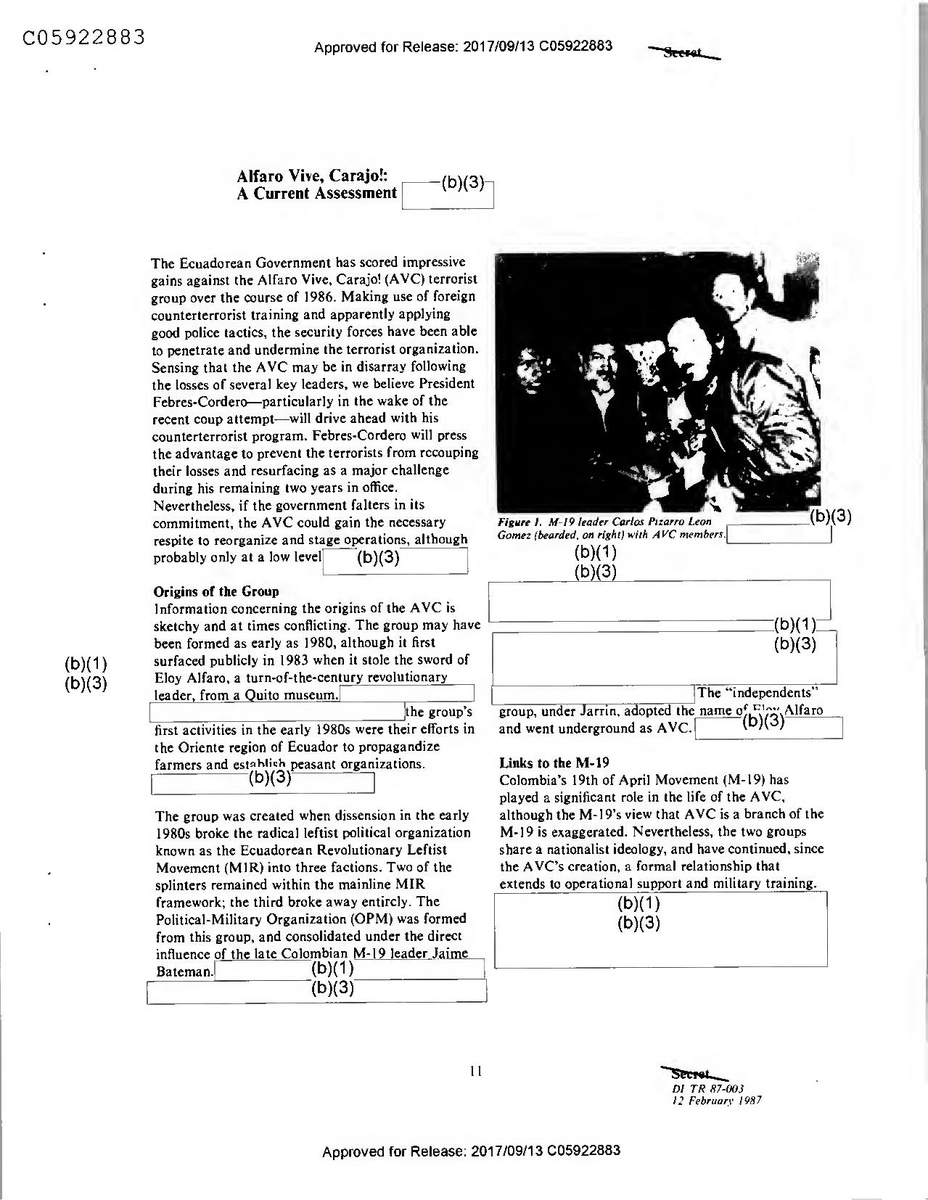
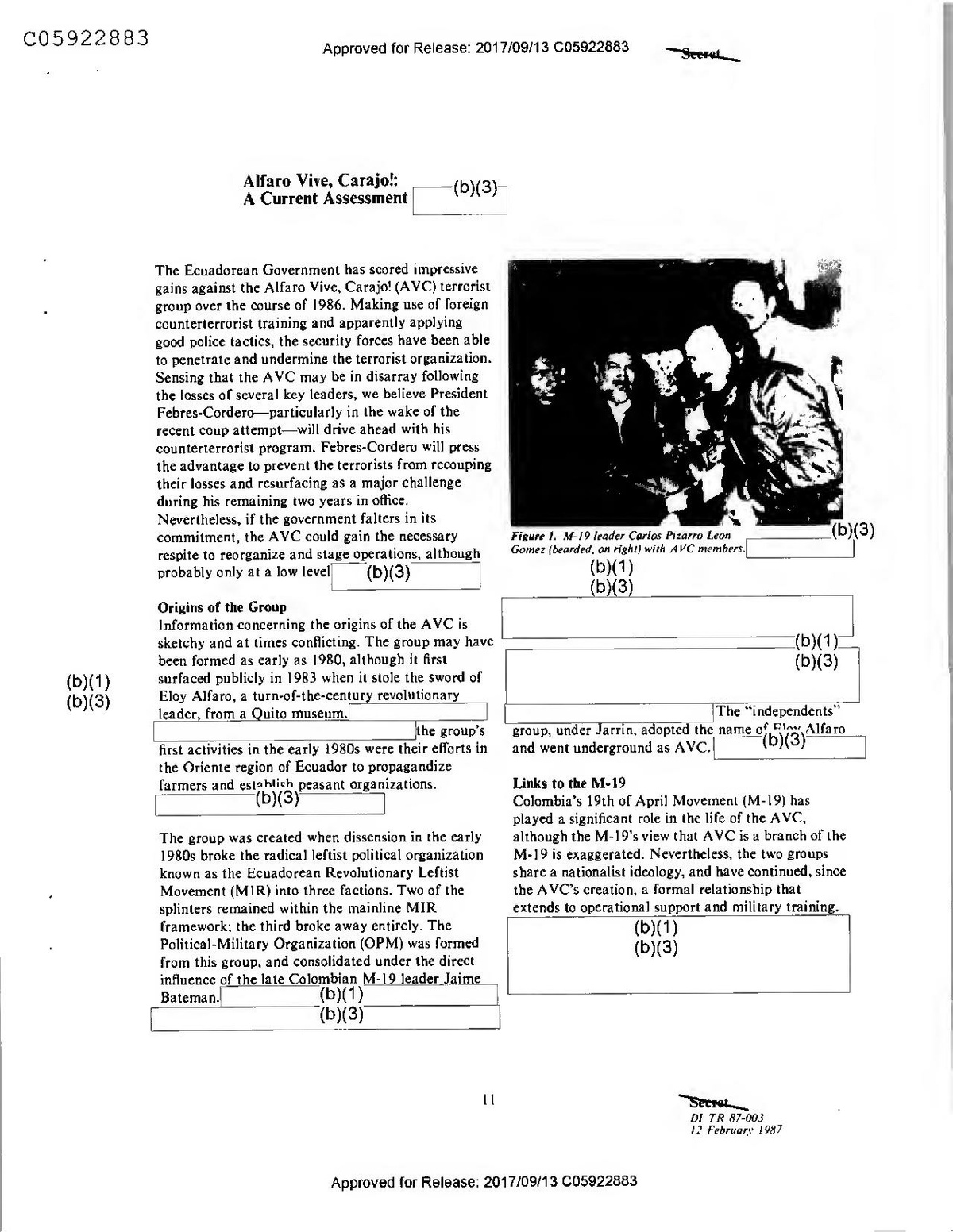
Alfaro Vive, Carajo!: A Current Assessment
(b)(3)The Ecuadorean Government has scored impressive gains against the Alfaro Vive, Carajo! (AVC) terrorist group over the course of 1986. Making use of foreign counterterrorist training and apparently applying good police tactics, the security forces have been able to penetrate and undermine the terrorist organization. Sensing that the AVC may be in disarray following the losses of several key leaders, we believe President Febres-Cordero-particularly in the wake of the recent coup attempt—will drive ahead with his counterterrorist program. Febres-Cordero will press the advantage to prevent the terrorists from rccouping their losses and resurfacing as a major challenge during his remaining two years in office. Nevertheless, if the government falters in its commitment, the AVC could gain the necessary respite to reorganize and stage operations, although probably only at a low level (b)(3)(b)(3)
IFigure 1. M-19 leader Carlos Pizarro Leon Gomez (bearded, on right) with AVC members.
(b)(1) (b)(3)
(b)(1) (b)(3)
)(1) )(3)
Origins of the Group Information concerning the origins of the AVC is sketchy and at times conflicting. The group may have been formed as early as 1980, although it first surfaced publicly in 1983 when it stole the sword of Eloy Alfaro, a turn-of-the-century revolutionary leader, from a Quito museum.
the group's first activities in the early 1980s were their efforts in the Oriente region of Ecuador to propagandize farmers and esta hlich peasant organizations.
(b)(3)
The “independents" group, under Jarrin, adopted the name of Flo Alfaro and went underground as AVC.
(b)(3)
The group was created when dissension in the early 1980s broke the radical leftist political organization known as the Ecuadorean Revolutionary Leftist Movement (MIR) into three factions. Two of the splinters remained within the mainline MIR framework; the third broke away entircly. The Political-Military Organization (OPM) was formed from this group, and consolidated under the direct influence of the late
Colombian M-19 leader Jaime Bateman.
(b)(1) (b)(3)
Links to the M-19 Colombia's 19th of April Movement (M-19) has played a significant role in the life of the AVC, although the M-19's view that AVC is a branch of the M-19 is exaggerated. Nevertheless, the two groups share a nationalist ideology, and have continued, since the AVC's creation, a formal relationship that extends to operational support and military training.
(b)(1) (b)(3)
11
Secret DI TR 87-003 12 February 1987
Approved for Release: 2017/09/13 C05922883
Rosa Mireya CARDENAS Hernandez
M-19 members also have backed AVC terrorists in important operations. For example, eight M-19 members and two AVC terrorists apparently worked together to kidnap a prominent Guayaquil banker in August 1985.
Member of the AVC Central Command
The operation was aborted, however, when security forces stormed the hideout, killing the banke, sieveral terrorists.
(b)(3) er
İIn return for such assistance, the AVC sent some 30 members to fight alongside the M-19 in the “America Battalion"- -a multinational rural guerrilla organization operating in southern Colombia. This demonstration of solidarity, however, ultimately led to strains, because the AVC wishes to recall its members to beef up its depleted ranks. (b)(1)
(b)(3)
Rosa Cardenas Hernandez, 27, is one of the founding members of the Alfaro Vive, Carajo! (AVC) group. She was arrested in Costa Rica in August 1984 while trying to return to Ecuador from Nicaragua and Panama. She is currently residing in Managua and directs the AVC's external front organization from there. She is known to have participated in bank robberies and is suspected of having acted behind the scenes in other AVC operations. Following the deaths of several leaders, Cardenas is a possible contender for AVC chief. Certainly she will have considerable influence on the selontinn of a new AVC chies.
Other Foreign Ties
individual AVC members also have received guerrilla training in El Salvador, Libya, and Nicaragua. The AVC reportedly sent several members to El Salvador for training because of a guarantee that they would participate in live-fire situations. In Nicaragua, small groups of AVC members reportedly have patrolled with Sandinista Army units searching for
(b)(3)guan insurgents
(b)(3)
Libya also has trained AVC members. Between October 1983 and January 1984, approximately 20 AVC members accompanied an M-19 group to Libya
and received guerrilla
training at camp(b)(1)Tripoli,
(b)(3)
promises of assistance from the Vietnamese, Syrian, and Cuban Embassies, as well as PLO representatives in Managua: • Cuba has pledged intelligence and security training,
as well as assistance in building guerrilla hospitals
in rural areas. • Vietnam will provide training in jungle warfare and
mountain camouflage. Syria reportedly will give the AVC an unspecified
amount of money and arms. • The PLO allegedly offered arms and training in
exchange for the “detection of Jews living in America,” and propaganda support of the PLO.
.
The AVC reportedly has a specialized unit that establishes and maintains contacts with international terrorist groups and foreign governments. As of May 1986, Rosa Mireya Cardenas, an AVC member living in Managua, was in charge of this external front (see inset). She reportedly had contacted and received
Secret
12
Approved for Release: 2017/09/13 C05922883
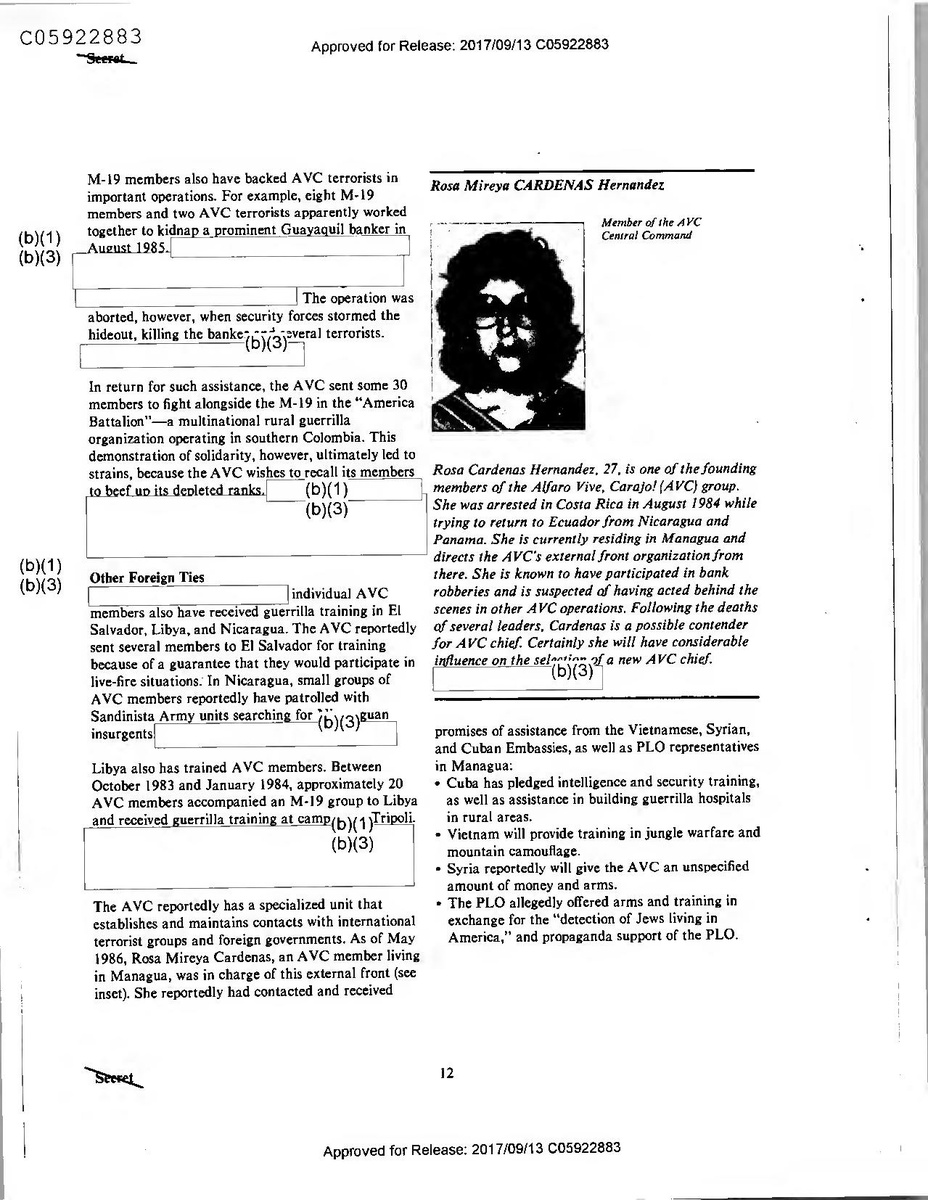
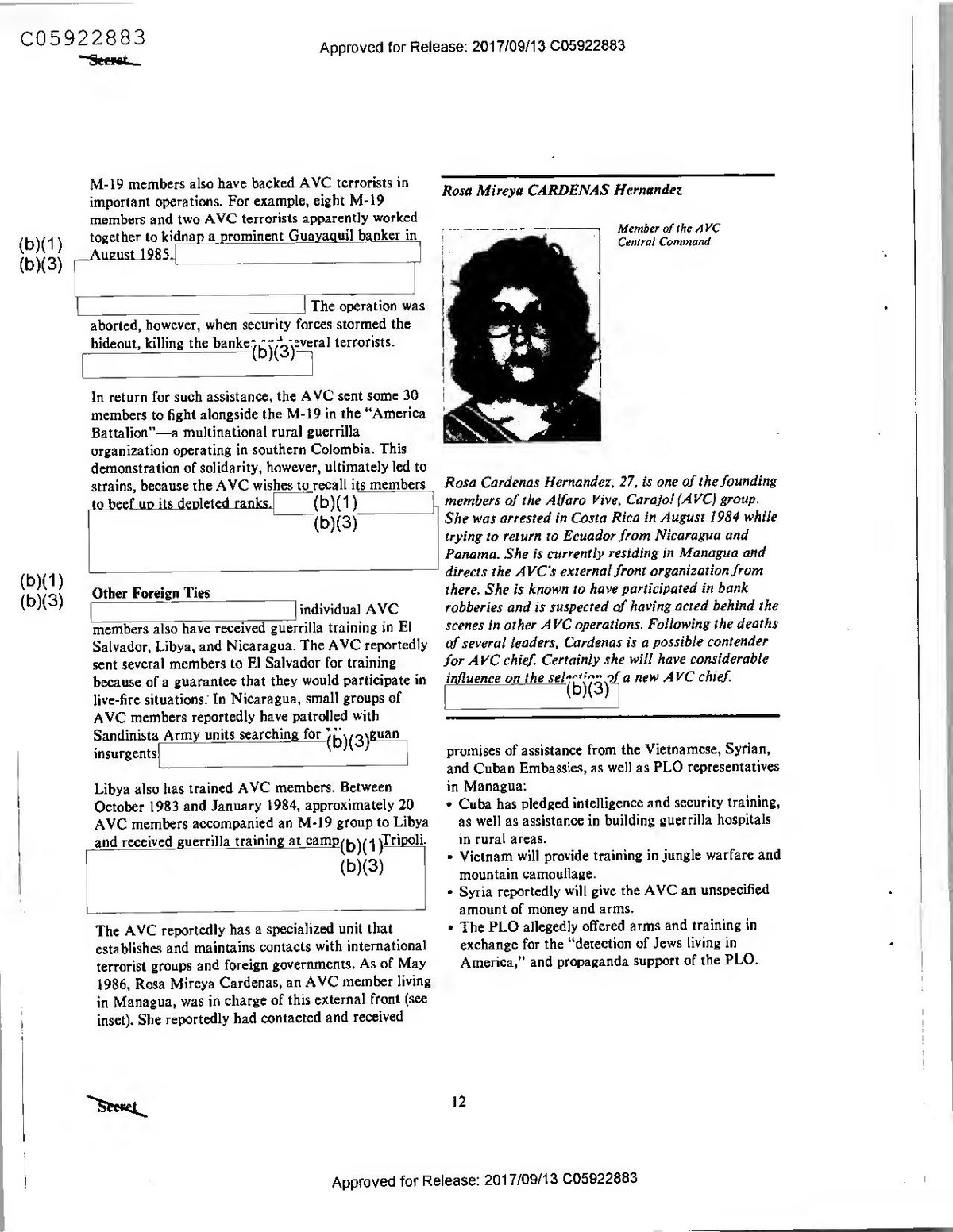
Rosa Mireya CARDENAS Hernandez
M-19 members also have backed AVC terrorists in important operations. For example, eight M-19 members and two AVC terrorists apparently worked together to kidnap a prominent Guayaquil banker in August 1985.
Member of the AVC Central Command
The operation was aborted, however, when security forces stormed the hideout, killing the banke, sieveral terrorists.
(b)(3) er
İIn return for such assistance, the AVC sent some 30 members to fight alongside the M-19 in the “America Battalion"- -a multinational rural guerrilla organization operating in southern Colombia. This demonstration of solidarity, however, ultimately led to strains, because the AVC wishes to recall its members to beef up its depleted ranks. (b)(1)
(b)(3)
Rosa Cardenas Hernandez, 27, is one of the founding members of the Alfaro Vive, Carajo! (AVC) group. She was arrested in Costa Rica in August 1984 while trying to return to Ecuador from Nicaragua and Panama. She is currently residing in Managua and directs the AVC's external front organization from there. She is known to have participated in bank robberies and is suspected of having acted behind the scenes in other AVC operations. Following the deaths of several leaders, Cardenas is a possible contender for AVC chief. Certainly she will have considerable influence on the selontinn of a new AVC chies.
Other Foreign Ties
individual AVC members also have received guerrilla training in El Salvador, Libya, and Nicaragua. The AVC reportedly sent several members to El Salvador for training because of a guarantee that they would participate in live-fire situations. In Nicaragua, small groups of AVC members reportedly have patrolled with Sandinista Army units searching for
(b)(3)guan insurgents
(b)(3)
Libya also has trained AVC members. Between October 1983 and January 1984, approximately 20 AVC members accompanied an M-19 group to Libya
and received guerrilla
training at camp(b)(1)Tripoli,
(b)(3)
promises of assistance from the Vietnamese, Syrian, and Cuban Embassies, as well as PLO representatives in Managua: • Cuba has pledged intelligence and security training,
as well as assistance in building guerrilla hospitals
in rural areas. • Vietnam will provide training in jungle warfare and
mountain camouflage. Syria reportedly will give the AVC an unspecified
amount of money and arms. • The PLO allegedly offered arms and training in
exchange for the “detection of Jews living in America,” and propaganda support of the PLO.
.
The AVC reportedly has a specialized unit that establishes and maintains contacts with international terrorist groups and foreign governments. As of May 1986, Rosa Mireya Cardenas, an AVC member living in Managua, was in charge of this external front (see inset). She reportedly had contacted and received
Secret
12
Approved for Release: 2017/09/13 C05922883
AVC
Me tri
RBS
- ITA
WE FUEGOS
HIG
CUE FUCHICAS CRICES CVE FUORIGAS NE FUCNICAS
MIETTI
MEK
53
FUETTES
HR ananganat
EVE FUTNICAS QUE FECHICAS
QUE FESTICS LVE FUCRIGASI TUCS! FERENCES VE FEDEICHS. THE FUERICAS THE FOLLIES E FERICAS QUE FERNTORS
CHE FELICES
CE FOSIEN
FE FOLIESI CIL FORSIDE SAN FELICS
FECRICAS
QUE FUENTES C'S FURNICAS: CXE FERMICAS
4:
n.
OFEREIGAS E FESTES
CUE FECHICAS
PIN TIME
PUIS
TEFIASI CE FESTA
.f
Fasies FIES
FERIES
! FTES
OR CFT
IN
10
(b)(3)
Figure 2. AVC propaganda material.
)(1) )(3)
Nevertheless, the group seems interested in broadening its foreign contacts,
(b)(1) (b)(3)
The AVC and the Left During its early period, when the group was registering successes, the AVC developed an ambitious revolutionary program that included leading a united left against President FebresCordero, while carrying out even more daring terrorist operations. The AVC reportedly believed that the conservative government in Ecuador made for ideal conditions in which to forge such a front. (b)(3)
Government Successes Government security forces have combined penetrations with good use of intelligence to exploit AVC weaknesses and deal the terrorist group decisive blows. Over the past year, Ecuador's security forces have raided numerous safehouses and captured or killed dozens of terrorists—including several of the group's top leaders. Quito also has begun to work with Bogota to crack down on the M-19.
(b)(3)
President Febres-Cordero has reorganized the security forces-initially inexperienced and lacking in resources—and consolidated counterterrorism responsibility under the direction of Government Minister Robles. He secured training and assistance
The legal Ecuadorean left has consistently rejected the AVC's call to form a united front, thus isolating the terrorist group, and thwarting its more grandiose ambitions. Most of the leftist parties fear that association with the group's illegal terrorist activity will lead to government reprisals and alienate such electoral backing as they have received.
(b)(3)
13
Secret
Approved for Release: 2017/09/13 C05922883
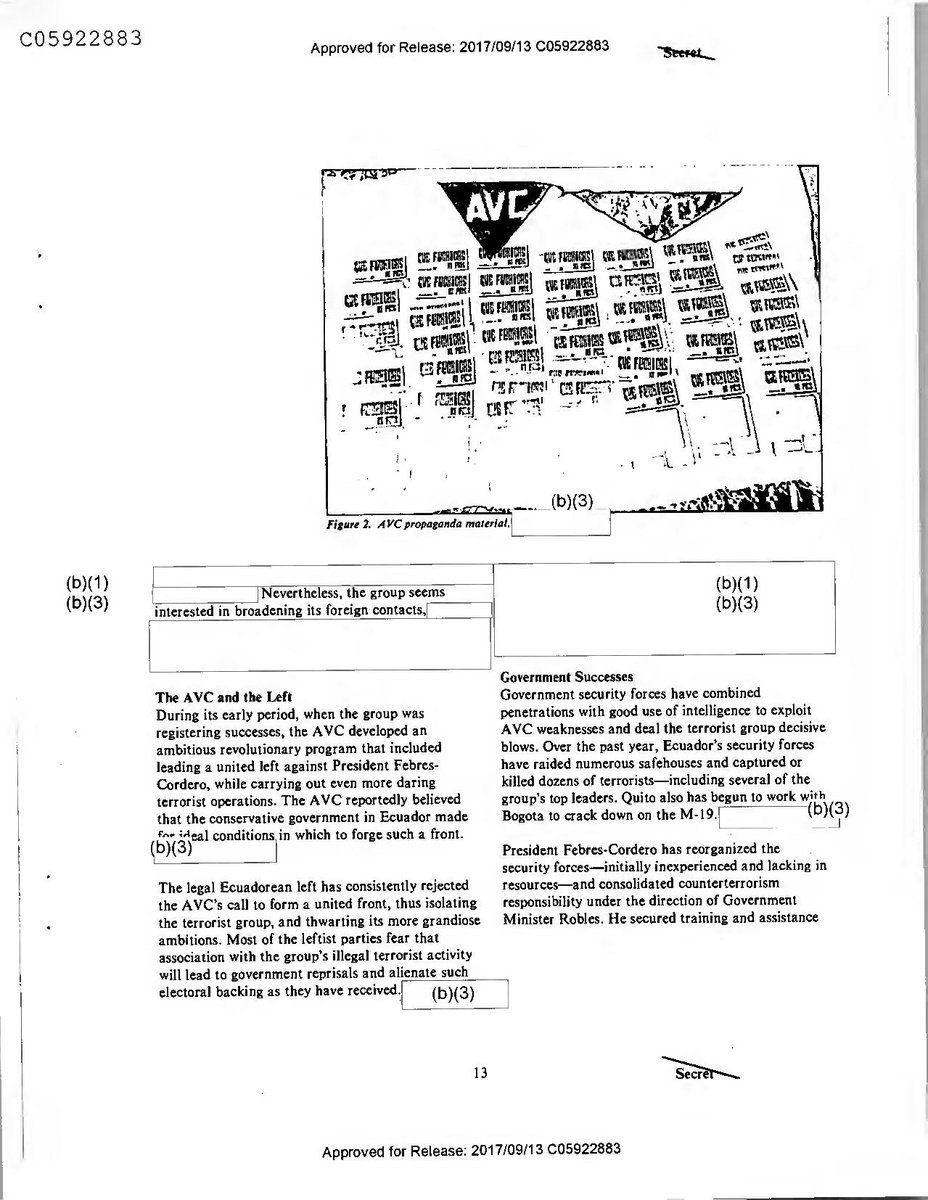
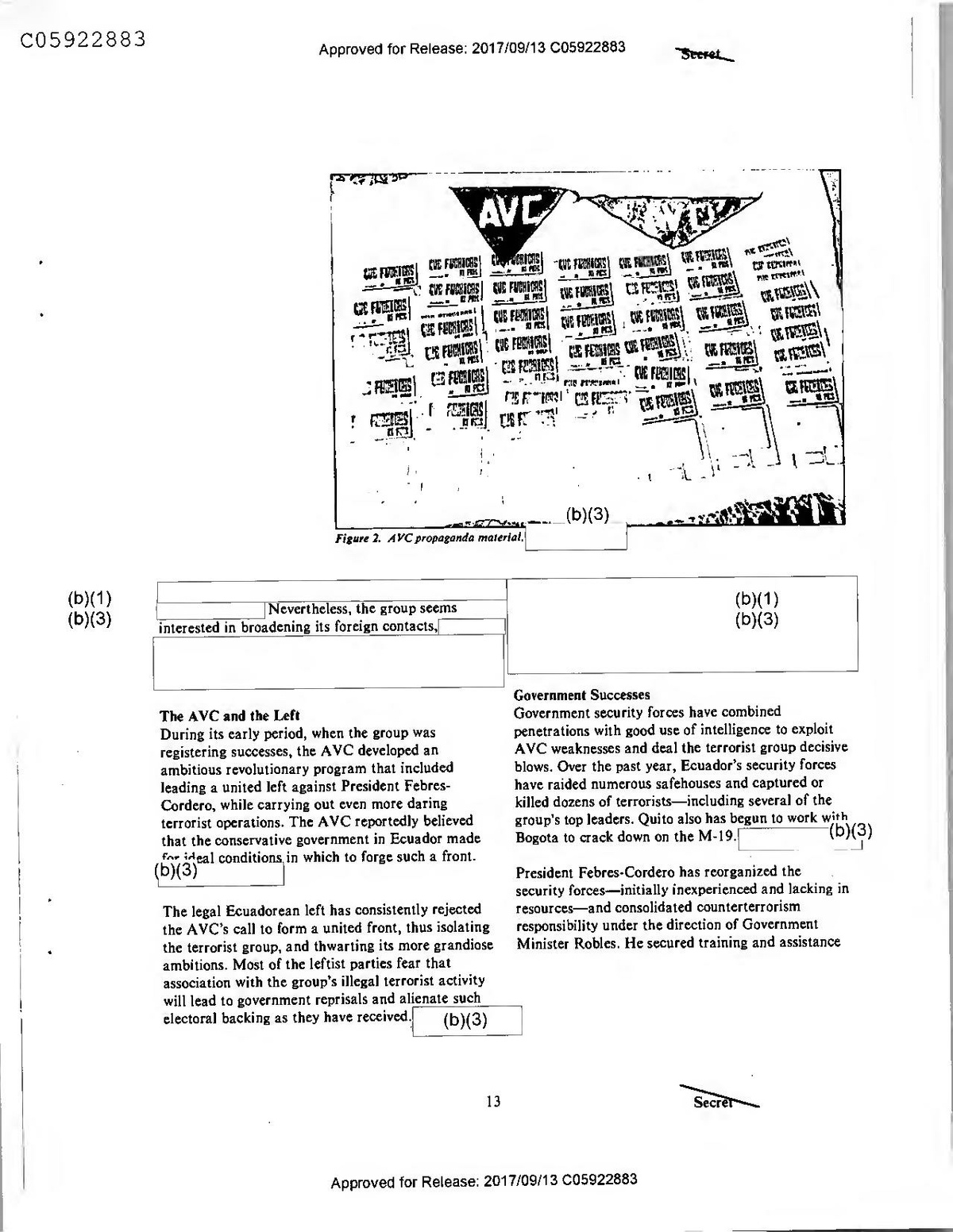
AVC
Me tri
RBS
- ITA
WE FUEGOS
HIG
CUE FUCHICAS CRICES CVE FUORIGAS NE FUCNICAS
MIETTI
MEK
53
FUETTES
HR ananganat
EVE FUTNICAS QUE FECHICAS
QUE FESTICS LVE FUCRIGASI TUCS! FERENCES VE FEDEICHS. THE FUERICAS THE FOLLIES E FERICAS QUE FERNTORS
CHE FELICES
CE FOSIEN
FE FOLIESI CIL FORSIDE SAN FELICS
FECRICAS
QUE FUENTES C'S FURNICAS: CXE FERMICAS
4:
n.
OFEREIGAS E FESTES
CUE FECHICAS
PIN TIME
PUIS
TEFIASI CE FESTA
.f
Fasies FIES
FERIES
! FTES
OR CFT
IN
10
(b)(3)
Figure 2. AVC propaganda material.
)(1) )(3)
Nevertheless, the group seems interested in broadening its foreign contacts,
(b)(1) (b)(3)
The AVC and the Left During its early period, when the group was registering successes, the AVC developed an ambitious revolutionary program that included leading a united left against President FebresCordero, while carrying out even more daring terrorist operations. The AVC reportedly believed that the conservative government in Ecuador made for ideal conditions in which to forge such a front. (b)(3)
Government Successes Government security forces have combined penetrations with good use of intelligence to exploit AVC weaknesses and deal the terrorist group decisive blows. Over the past year, Ecuador's security forces have raided numerous safehouses and captured or killed dozens of terrorists—including several of the group's top leaders. Quito also has begun to work with Bogota to crack down on the M-19.
(b)(3)
President Febres-Cordero has reorganized the security forces-initially inexperienced and lacking in resources—and consolidated counterterrorism responsibility under the direction of Government Minister Robles. He secured training and assistance
The legal Ecuadorean left has consistently rejected the AVC's call to form a united front, thus isolating the terrorist group, and thwarting its more grandiose ambitions. Most of the leftist parties fear that association with the group's illegal terrorist activity will lead to government reprisals and alienate such electoral backing as they have received.
(b)(3)
13
Secret
Approved for Release: 2017/09/13 C05922883
WAT
FB
Figure 3. AVC weapons taken from safehouse in Quito.
(b)(3)
for the security forces from the United States and other governments and encouraged them to focus on good police practices. Most important, FebresCordero fully supports his counterterrorist forces and has shown the political will to back them against attacks from opposition political parties. His aggressive approach has occasionally resulted in abuses, but it has also improved the confidence and overall effectiveness of the security.serviceSb)(3)
group will divide over the issue of continued militancy versus a more clearly defined political agenda. Some elements of the AVC then might attempt to integrate into one or more of the established radical leftist parties, leaving the remaining AVC militants. perl(b)(3). more violent than before.
Despite the group's overall decline, some members are still active and, according to press accounts, staged brief takeovers of a 'radio station in December. Incidents of this kind. signal that the group can still mount limited operations, and may be able to stage a limited comeback if the government fails to press its hard-won gains.
(b)(3)
Outlook We believe the AVC will find it difficult to recover from its current state of disarray. The government has demonstrated the political will to press its advantage and to prevent the group from surfacing as a major threat in the near future. The killings of several key: AVC leaders over the past year have not only demoralized the group but have also provoked a leadership crisis. These blows have destroyed the AVC as a national organization, and reduced it to groups of isolated cells working haphazardly. In fact, some members of the group have called for a national dialogue with the government to be mediated by the church. We believe that, like its forerunners, the
14
Secret
Approved for Release: 2017/09/13 C05922883
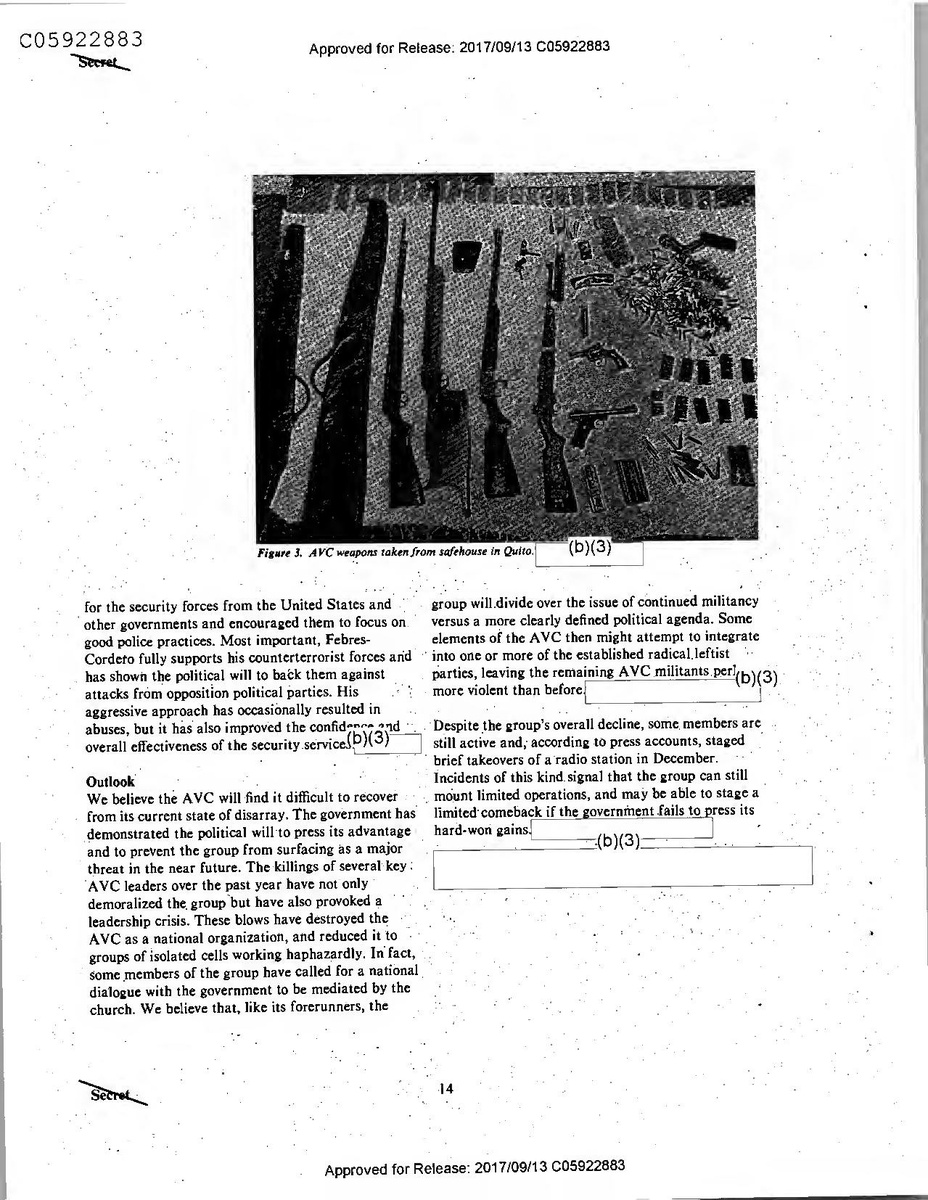
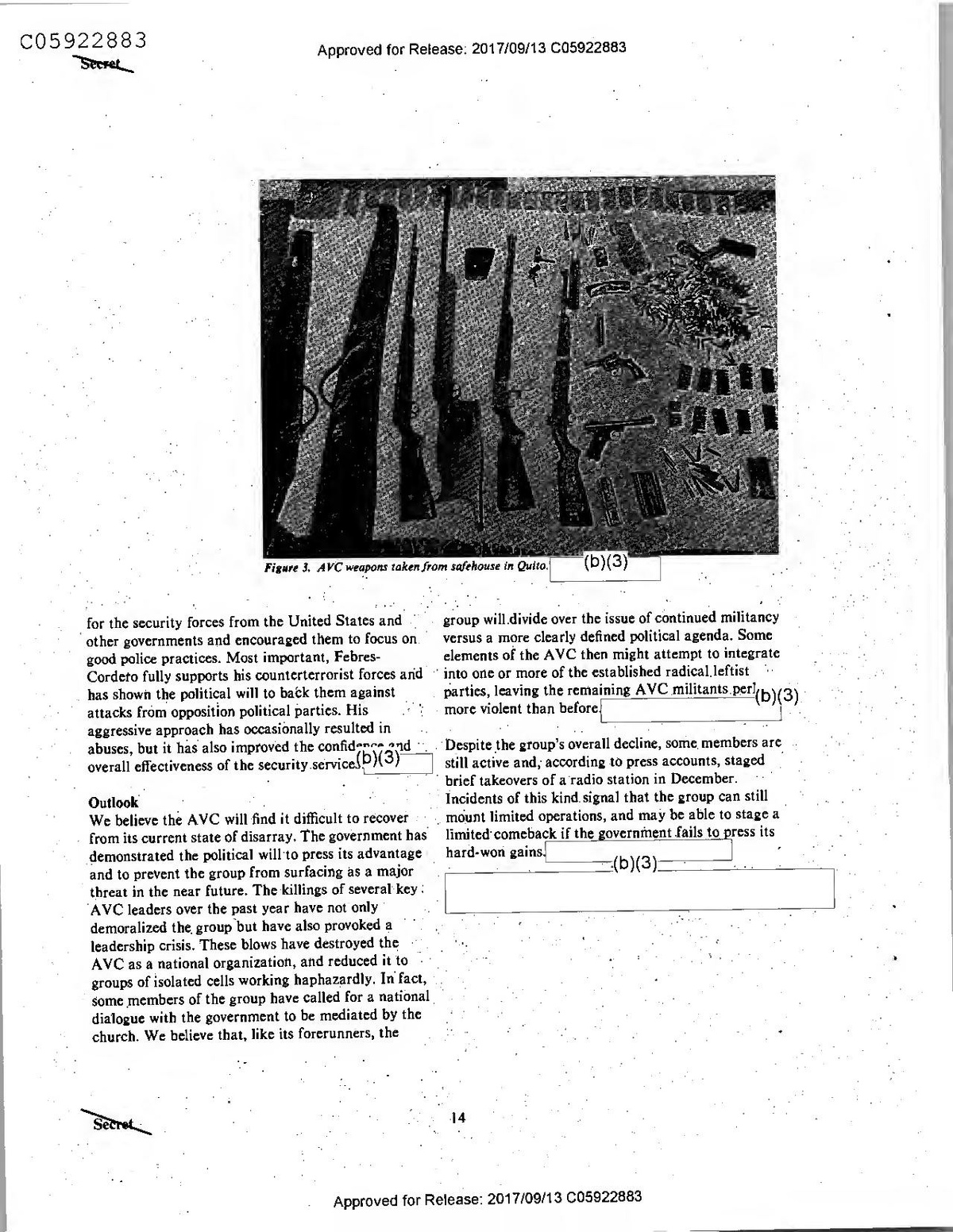
WAT
FB
Figure 3. AVC weapons taken from safehouse in Quito.
(b)(3)
for the security forces from the United States and other governments and encouraged them to focus on good police practices. Most important, FebresCordero fully supports his counterterrorist forces and has shown the political will to back them against attacks from opposition political parties. His aggressive approach has occasionally resulted in abuses, but it has also improved the confidence and overall effectiveness of the security.serviceSb)(3)
group will divide over the issue of continued militancy versus a more clearly defined political agenda. Some elements of the AVC then might attempt to integrate into one or more of the established radical leftist parties, leaving the remaining AVC militants. perl(b)(3). more violent than before.
Despite the group's overall decline, some members are still active and, according to press accounts, staged brief takeovers of a 'radio station in December. Incidents of this kind. signal that the group can still mount limited operations, and may be able to stage a limited comeback if the government fails to press its hard-won gains.
(b)(3)
Outlook We believe the AVC will find it difficult to recover from its current state of disarray. The government has demonstrated the political will to press its advantage and to prevent the group from surfacing as a major threat in the near future. The killings of several key: AVC leaders over the past year have not only demoralized the group but have also provoked a leadership crisis. These blows have destroyed the AVC as a national organization, and reduced it to groups of isolated cells working haphazardly. In fact, some members of the group have called for a national dialogue with the government to be mediated by the church. We believe that, like its forerunners, the
14
Secret
Approved for Release: 2017/09/13 C05922883
Overview of Asian Terrorism in 1986(b)(3)
P(b)(3ja 19
International terrorism-generally not a major
one American, the hijackers threatened to kill a problem in Asia-heated up in 1986 as the number of passenger every 10 minutes unless they were provided international incidents jumped 50 percent over 1985. a flightcrew and were flown to Cyprus. The deadlines We recorded some 66 incidents in the region last year passed without incident, but when the aircraft lighting as compared with 41 in 1985—still far below the failed, the terrorists opened fire on the passengers. hundreds of incidents that occurred in the Middle The four gunmen, along with a fifth conspirator East and Latin America. Much of the terrorism in arrested later in Islamabad, were taken into Pakistani Asia is domestic rather than international
(b)(3) custody. They have given varying accounts of their
origins and goals. Several groups claimed Pakistan accounted for most of the increase in
responsibility for the hijacking, although we believe international terrorism last year: there were twice as the Abu Nidal Group was responsible ,and Libya many incidents last year as there were in 1985. We probably knew of and provided logistic (b)(3)t to the believe Afghan and Soviet agents terrorizing civilian operation. targets in the North-West Frontier Province accounts for the bulk of the increase in Pakistan. Palestinian Another incident that involved Libya occurred when a terrorists stormed a Pan Am airliner in Karachi last bomb exploded at the Pakistan-Libyan Holding September, killing 22 persons and injuring as many as Company in Karachi last March. The company was 100 others. Most Asian countries did not reflect any founded as a joint venture, allegedly to invest in real increase in international attacks during the year, small- and medium-sized companies. An unidentified and Sikh extremists overseas—who downed an Air man reportedly planted a briefcase that exploded in India 747 jet and killed over 300
1985– the company's reception area. One person was killed were relatively quiet during 1986.
and several others injured in the ensuing fire, which
destroyed most of the first and second floors of the Pakistan: Karachi Heats Up
building. When Pakistani authorities detained a Terrorist attacks sponsored by the Soviet Union and Libyan executive of the company, he admitted to Afghanistan in the Pakistani-Afghan border area being a Libyan intelligence agent and said he bombed accounted for the marked increase in Pakistani
the company to prevent its financial records from terrorism during 1986. These agents—usually
falling into the hands of the local authorities. The KHAD, the Afghan secret police—conducted a
Pakistani Government suspected that the Libyan was terrorist bombing campaign in the North-West Frontier Province and Baluchistan to erode Pakistani expelled him support for Afghan insurgents, and to sow dissension between Afghan refugees and Pakistani civilians in Also in Karachi, a series of four bombs exploded in a the area. These attacks were usually bombings and 15-minute period during last July at four separate generally targeted bridges, railways, power
locations, killing a local security guard and wounding transmission lines, shops, restaurants, and hospitals. two other persons. The targets included the cargo We expect such bombings to continue in 1987
office of Pan American Airlines and three offices of
Saudia Airlines. Although no group has claimed The most daring and brutal terrorist attack in Asia credit for the blasts, the police suspect Iranian last year occurred in September, when four armed Palestinian gunmen stormed a Pan Am aircraft in Karachi. The attack eventually left 22 persons dead and nearly 100 others wounded. After initially killing
involved in a plot to undermine F(b)(3)it Zia and
)(3)
15
Secret DI TR 87-003 12 February 1987
Approved for Release: 2017/09/13 C05922883
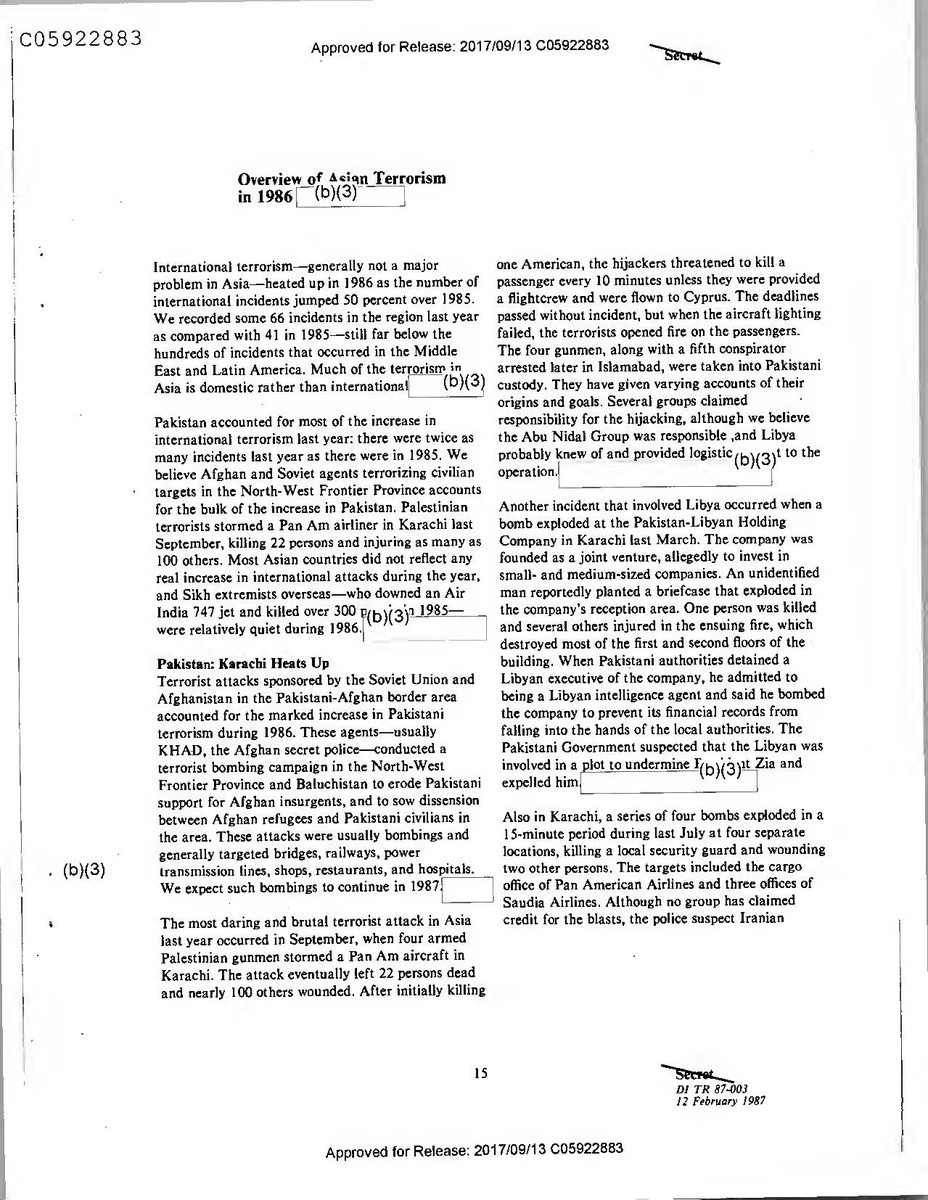
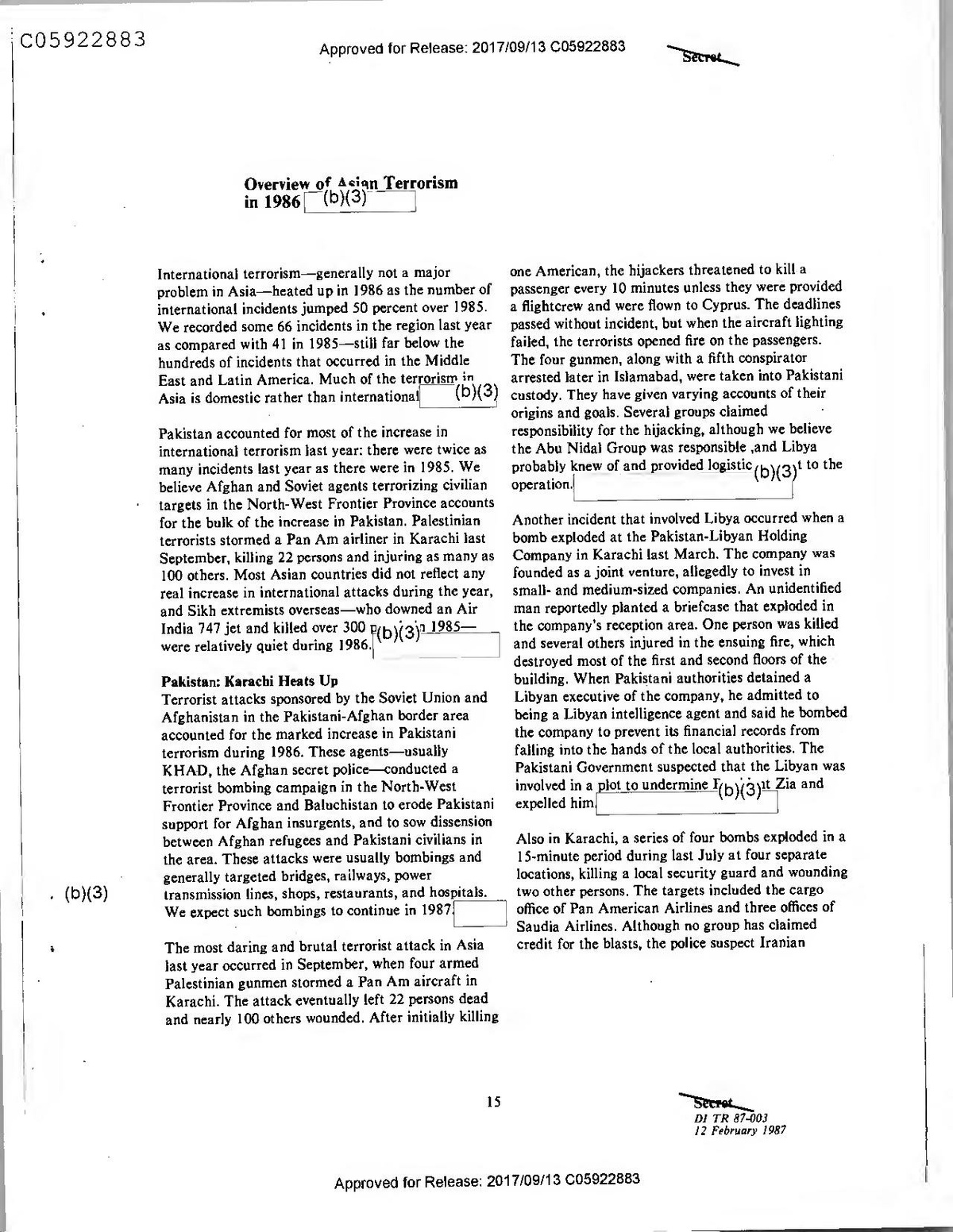
Overview of Asian Terrorism in 1986(b)(3)
P(b)(3ja 19
International terrorism-generally not a major
one American, the hijackers threatened to kill a problem in Asia-heated up in 1986 as the number of passenger every 10 minutes unless they were provided international incidents jumped 50 percent over 1985. a flightcrew and were flown to Cyprus. The deadlines We recorded some 66 incidents in the region last year passed without incident, but when the aircraft lighting as compared with 41 in 1985—still far below the failed, the terrorists opened fire on the passengers. hundreds of incidents that occurred in the Middle The four gunmen, along with a fifth conspirator East and Latin America. Much of the terrorism in arrested later in Islamabad, were taken into Pakistani Asia is domestic rather than international
(b)(3) custody. They have given varying accounts of their
origins and goals. Several groups claimed Pakistan accounted for most of the increase in
responsibility for the hijacking, although we believe international terrorism last year: there were twice as the Abu Nidal Group was responsible ,and Libya many incidents last year as there were in 1985. We probably knew of and provided logistic (b)(3)t to the believe Afghan and Soviet agents terrorizing civilian operation. targets in the North-West Frontier Province accounts for the bulk of the increase in Pakistan. Palestinian Another incident that involved Libya occurred when a terrorists stormed a Pan Am airliner in Karachi last bomb exploded at the Pakistan-Libyan Holding September, killing 22 persons and injuring as many as Company in Karachi last March. The company was 100 others. Most Asian countries did not reflect any founded as a joint venture, allegedly to invest in real increase in international attacks during the year, small- and medium-sized companies. An unidentified and Sikh extremists overseas—who downed an Air man reportedly planted a briefcase that exploded in India 747 jet and killed over 300
1985– the company's reception area. One person was killed were relatively quiet during 1986.
and several others injured in the ensuing fire, which
destroyed most of the first and second floors of the Pakistan: Karachi Heats Up
building. When Pakistani authorities detained a Terrorist attacks sponsored by the Soviet Union and Libyan executive of the company, he admitted to Afghanistan in the Pakistani-Afghan border area being a Libyan intelligence agent and said he bombed accounted for the marked increase in Pakistani
the company to prevent its financial records from terrorism during 1986. These agents—usually
falling into the hands of the local authorities. The KHAD, the Afghan secret police—conducted a
Pakistani Government suspected that the Libyan was terrorist bombing campaign in the North-West Frontier Province and Baluchistan to erode Pakistani expelled him support for Afghan insurgents, and to sow dissension between Afghan refugees and Pakistani civilians in Also in Karachi, a series of four bombs exploded in a the area. These attacks were usually bombings and 15-minute period during last July at four separate generally targeted bridges, railways, power
locations, killing a local security guard and wounding transmission lines, shops, restaurants, and hospitals. two other persons. The targets included the cargo We expect such bombings to continue in 1987
office of Pan American Airlines and three offices of
Saudia Airlines. Although no group has claimed The most daring and brutal terrorist attack in Asia credit for the blasts, the police suspect Iranian last year occurred in September, when four armed Palestinian gunmen stormed a Pan Am aircraft in Karachi. The attack eventually left 22 persons dead and nearly 100 others wounded. After initially killing
involved in a plot to undermine F(b)(3)it Zia and
)(3)
15
Secret DI TR 87-003 12 February 1987
Approved for Release: 2017/09/13 C05922883
Approved for Release: 2017/09/13 C05632837.
Approved for Release: 2017/09/13 C05632837.
involvement. Iranians previously had been involved in antigovernment and anti-US terrorist attacks in Pakistan. In the summer of 1985, Iranian officials were believed to have been responsible for an attack on the American Center in Lahore, the placement of a bomb outside the Pan Am office in Karachi, and antigovernment Shia demonstrations in Quetta, Baluchistan, that left 60 persons dead.
sidewalks, and a building near the Canadian Embassy. Even though there were no casualties or damage, the incident was embarrassing to the Nakasone government, which had laid on unprecedented security for the conference. We believe Chukaku-ha realized that the attack would be unsuccessfUL but went ahead to embarrass the Nakasone government. The worldwide attention.
(b)(3)$
ne i(b)(3) received
caused disi(b)(3)
The Pakistani terrorist group Al-Zulfikar, which In addition to attempts to disrupt the summit, radical raised concerns in 1983 and 1984 because it targeted leftist groups continued their campaign against Americans and other Westerners, was inactive for a Narita airport, the railway system, and Japanese second year. It apparently never recovered from its Government buildings throughout the year. Attacks attempt in July 1984 to seize foreign hostages in
minor damage, and few injuries. Vienna-during which nine operatives were taken into Austrian custody—and the death a year later of one of its top leaders in France. Islamabad is still Resurgence of the JRA? concerned about the ability of Al-Zulfikar to threaten An incident in Jakarta after the Tokyo Economic the lives of Pakistani political leaders, but apparently Summit led to speculation that the Japanese Red does not currently regard it as a serious tl(b)(3) Army (JRA) might be active again. Two homemade
projectiles were fired at the US and Japanese Domestic Terrorism in Japan
Embassies in Jakarta but both failed to explode. An Radical leftist groups in Japan, particularly the hour later, a car bomb exploded in the parking lot of Chukaku-ha, caused most of the terrorism that
the Canadian Embassy and destroyed at least six cars. occurred in 1986. They mounted several operations in the previously unknown “Anti-Imperialist opposition to the Tokyo Economic Summit, held last International Brigade" claimed responsiblity for the May—three in March before the summit and one attacks in retaliation for the antiterrorism declaration during the May summit. All of the attacks were of the Tokyo Economic Summit. (b)(1) designed to obtain maximum publicity and embarrass
(b)(3) the government. On 25 March, Senki Ara-ha (Battle Flag ARA Faction) fired homemade incendiary rockets from a parked car onto the grounds of the US Embassy in Tokyo and the Japanese Imperial Palace. The JRA made no claim concerning the incident, Three days later the Chukaku-ha (Nucleus Faction) although it had previously claimed credit for the fired three incendiary rockets from a van at an Osaka attacks it carried out in the 1970s. Japanese police headquarters. On 31 March the radical
authorities believe that Shirosaki may have acted Hazama-ha faction launched three rockets from a independently, or that he may be part of a faction that parked truck onto the grounds of the State Guest broke away from the JRA in February. If the JRA House, where summit meetings were to be held. was involved in this incident, it would be the group's
first act of terrorism since September 1977, when the As with most such attacks, there were no casualties group hijacked a Japan Airlines jetliner in Bombay and little damage in any of these incidents. The only and landed in Dhaka, Bangladesh. In that incident the attack that took place during the Tokyo summit hijackers demanded the release of six persons occurred on 4 May when Chukaku-ha fired five homemade rockets at the State Guest House where heads of foreign governments were arriving. All of the rockets missed their target and struck the street,
Secret
16
Approved for Release: 2017/09/13 C05922883
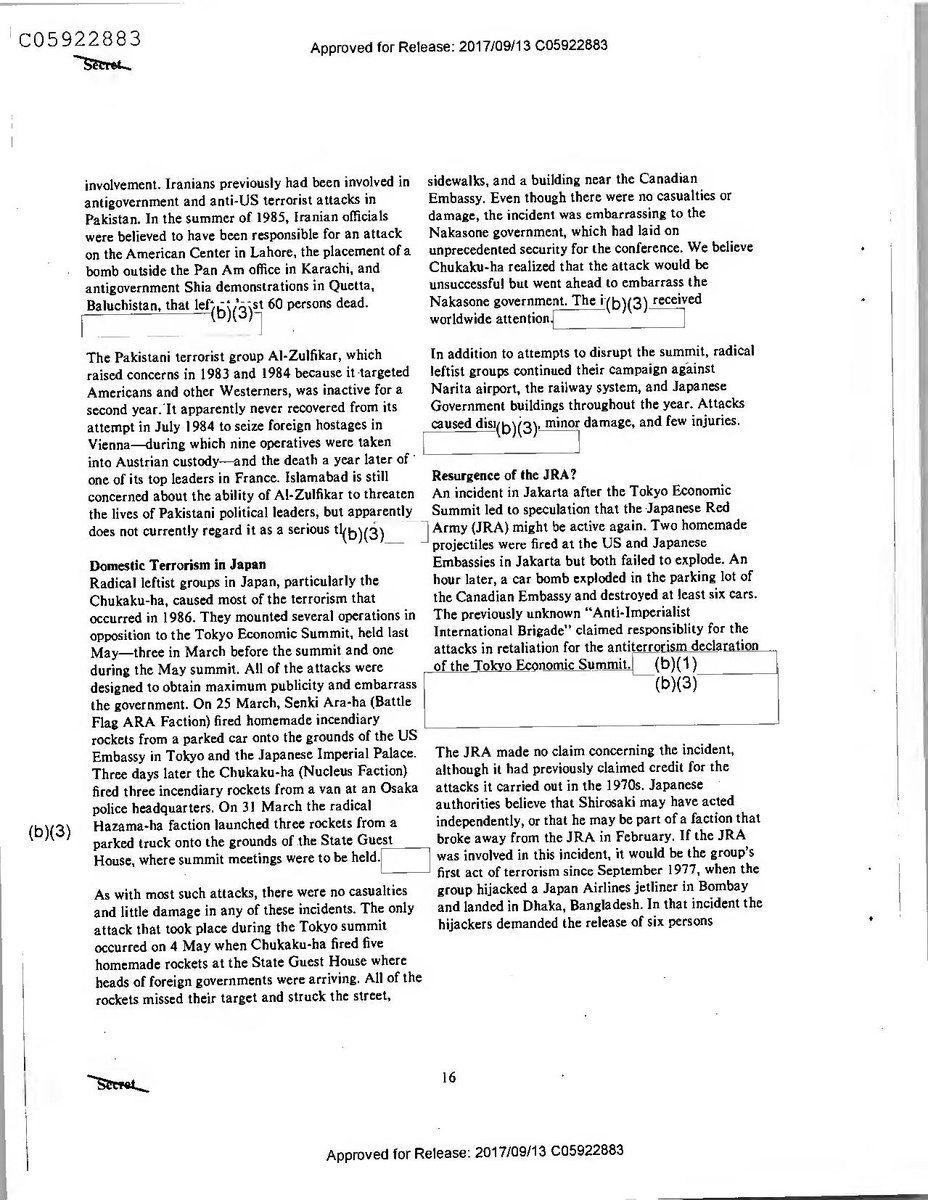

involvement. Iranians previously had been involved in antigovernment and anti-US terrorist attacks in Pakistan. In the summer of 1985, Iranian officials were believed to have been responsible for an attack on the American Center in Lahore, the placement of a bomb outside the Pan Am office in Karachi, and antigovernment Shia demonstrations in Quetta, Baluchistan, that left 60 persons dead.
sidewalks, and a building near the Canadian Embassy. Even though there were no casualties or damage, the incident was embarrassing to the Nakasone government, which had laid on unprecedented security for the conference. We believe Chukaku-ha realized that the attack would be unsuccessfUL but went ahead to embarrass the Nakasone government. The worldwide attention.
(b)(3)$
ne i(b)(3) received
caused disi(b)(3)
The Pakistani terrorist group Al-Zulfikar, which In addition to attempts to disrupt the summit, radical raised concerns in 1983 and 1984 because it targeted leftist groups continued their campaign against Americans and other Westerners, was inactive for a Narita airport, the railway system, and Japanese second year. It apparently never recovered from its Government buildings throughout the year. Attacks attempt in July 1984 to seize foreign hostages in
minor damage, and few injuries. Vienna-during which nine operatives were taken into Austrian custody—and the death a year later of one of its top leaders in France. Islamabad is still Resurgence of the JRA? concerned about the ability of Al-Zulfikar to threaten An incident in Jakarta after the Tokyo Economic the lives of Pakistani political leaders, but apparently Summit led to speculation that the Japanese Red does not currently regard it as a serious tl(b)(3) Army (JRA) might be active again. Two homemade
projectiles were fired at the US and Japanese Domestic Terrorism in Japan
Embassies in Jakarta but both failed to explode. An Radical leftist groups in Japan, particularly the hour later, a car bomb exploded in the parking lot of Chukaku-ha, caused most of the terrorism that
the Canadian Embassy and destroyed at least six cars. occurred in 1986. They mounted several operations in the previously unknown “Anti-Imperialist opposition to the Tokyo Economic Summit, held last International Brigade" claimed responsiblity for the May—three in March before the summit and one attacks in retaliation for the antiterrorism declaration during the May summit. All of the attacks were of the Tokyo Economic Summit. (b)(1) designed to obtain maximum publicity and embarrass
(b)(3) the government. On 25 March, Senki Ara-ha (Battle Flag ARA Faction) fired homemade incendiary rockets from a parked car onto the grounds of the US Embassy in Tokyo and the Japanese Imperial Palace. The JRA made no claim concerning the incident, Three days later the Chukaku-ha (Nucleus Faction) although it had previously claimed credit for the fired three incendiary rockets from a van at an Osaka attacks it carried out in the 1970s. Japanese police headquarters. On 31 March the radical
authorities believe that Shirosaki may have acted Hazama-ha faction launched three rockets from a independently, or that he may be part of a faction that parked truck onto the grounds of the State Guest broke away from the JRA in February. If the JRA House, where summit meetings were to be held. was involved in this incident, it would be the group's
first act of terrorism since September 1977, when the As with most such attacks, there were no casualties group hijacked a Japan Airlines jetliner in Bombay and little damage in any of these incidents. The only and landed in Dhaka, Bangladesh. In that incident the attack that took place during the Tokyo summit hijackers demanded the release of six persons occurred on 4 May when Chukaku-ha fired five homemade rockets at the State Guest House where heads of foreign governments were arriving. All of the rockets missed their target and struck the street,
Secret
16
Approved for Release: 2017/09/13 C05922883
passengers. Shirosal(b)(3) ne
(b)(3)
(b)(3) foreign installations or individuals to foment
incarcerated in Japanese prisons in exchange for the A few days later a bomb exploded in the Central pne of the six released. Telegraph Office in downtown Colombo, killing at
least 11 persons and wounding some 100 others.
Police sources believe the bomb consisted of 10 Antigovernment Activity in the Philippines
pounds of gelignite, which exploded near a crowded Insurgents in the Philippines continued to engage in public area inside the building, causing parts of two terrorism to embarrass the Aquino government and floors to collapse into the employees' canteen in the win support for their causes. Communist rebels basement. The Liberation Tigers of Tamil Eelam expanded their control over the countryside during the (LTTE)-the most powerfUL and hardline insurgent year. The New People's Army (NPA) of the
group—most likely were respins for both terrorist Communist Party of the Philippines regularly
attacks. attacked government targets, conducted assassinations and kidnapings, and extorted funds These bombings occurred just after an Indian during 1986. The NPA generally avoided attacks Government delegation had arrived in Colombo to against US and other foreign facilities, but in March explore ways of restarting stalled talks on Tamil NPA guerrillas in Kalinga-Apayo Province held nine grievances. We believe the attacks were intended to US servicemen for more than 24 hours. The
embarrass the government, provoke violence in the Americans, who accidentally entered NPA territory, capital, and torpedo the Indian-brokered peace talks were interrogated and then released unharmed. In the between the Sri Lankan Government and the Tamil coming year the ability to contain the threat from the insurgents. Major Tamil groups in the future left will depend on President Aquino's development of probably will continue their attacks against Sinhalese a coherent counterinsurgency program and her, hilito civilians, economic installations, and may target to deal with the senior military command
instability and force govinvolt concessions on Tamil The Muslim insurgency heated up slightly in 1986;
(b)(3)
autonomy] most attacks were conducted against traditional police, army, and local political targets. In June and India's Sikb Cauldron Still Boiling July the Moro National Liberation Front—the largest Sikh militants proved throughout the year that they faction in the insurgency-kidnaped an American intend to pursue terrorism to press their case for an missionary, a Filipino-American child, 10 Filipino independent state. Militants continued to target nuns, and a Swiss businessman and his local female Prime Minister Rajiv Gandhi, other Sikh moderates, companion. Ransom was paid;
Hindus, and government security forces. When were released unharmed.
approximately 600 Sikh extremists occupied the
Golden Temple in Amritsar early in the year, the The Tamlls in Sri Lanka
Punjab state government successfully assaulted the Two spectacular attacks during 1986 represented a Temple and drove them out. Extremists staged a new level of violence for Sri Lanka. In early May a machinegun attack in a crowded market in May as bomb blew the tail off an Air Lanka passenger jet well as two vicious bus hijackings in July and preparing to take off from Colombo for the Maldives, November that ended with the murders of all the killing 16 persons and injuring 41 others. In our Hindu passengers. In October a Sikh gunman tried to judgment the bomb exploded prematurely. It
assassinate Prime Minister Gandhi during his visit to probably was intended to go off shortly after takeoff, the grave of Mahatma Gandhi. Six persons, including while the plane was over Sri Lankan territory, in two members of the Prime Minister's party were order to cause maximum casualties. If the plane had slightly
wounded, but Gandhi was unscathed. been airborne when the bomb went off as many as
(b)(3) 150 persons could have been killed. (b)(3)
(b)(3) Tal cases and all
17
Secret
Approved for Release: 2017/09/13 C05922883
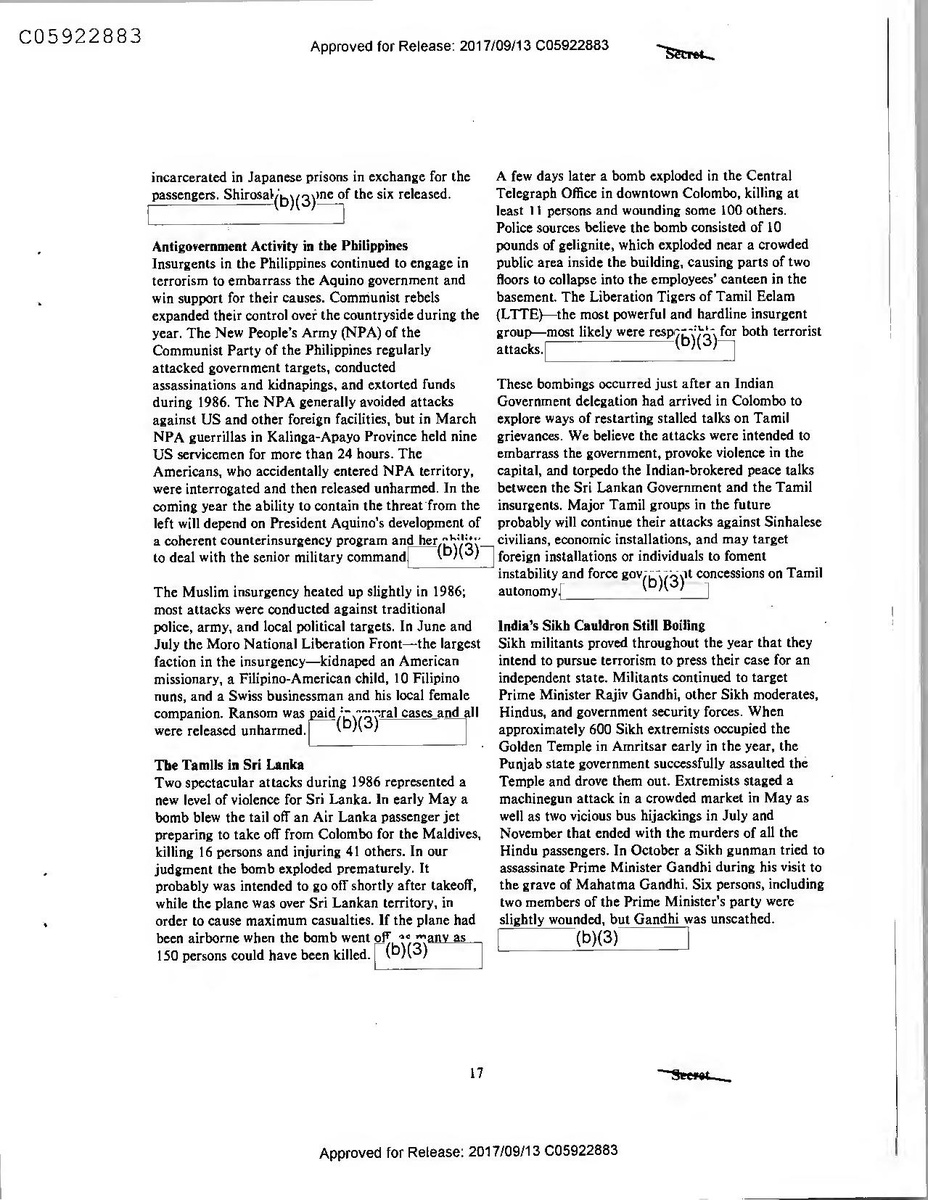
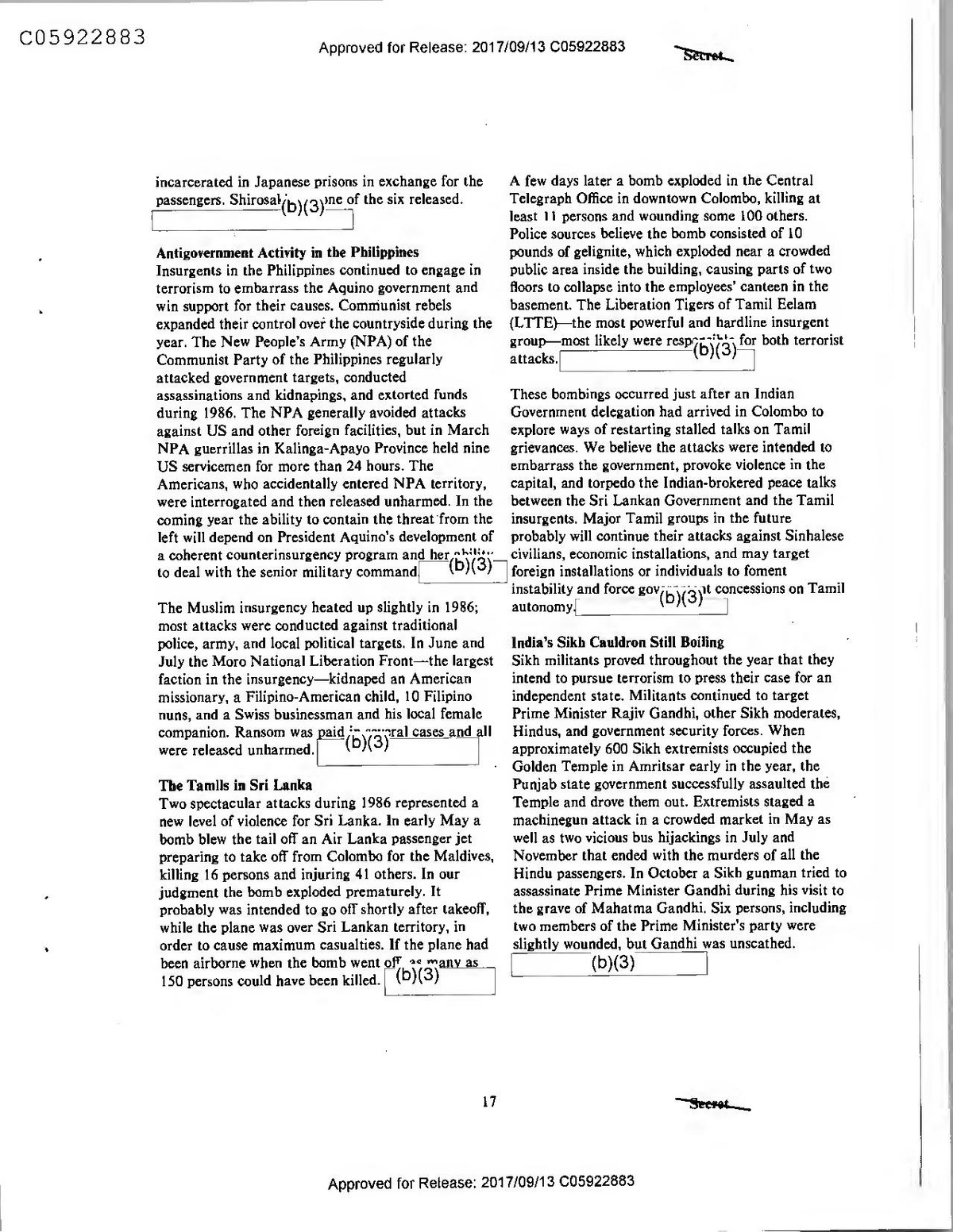
passengers. Shirosal(b)(3) ne
(b)(3)
(b)(3) foreign installations or individuals to foment
incarcerated in Japanese prisons in exchange for the A few days later a bomb exploded in the Central pne of the six released. Telegraph Office in downtown Colombo, killing at
least 11 persons and wounding some 100 others.
Police sources believe the bomb consisted of 10 Antigovernment Activity in the Philippines
pounds of gelignite, which exploded near a crowded Insurgents in the Philippines continued to engage in public area inside the building, causing parts of two terrorism to embarrass the Aquino government and floors to collapse into the employees' canteen in the win support for their causes. Communist rebels basement. The Liberation Tigers of Tamil Eelam expanded their control over the countryside during the (LTTE)-the most powerfUL and hardline insurgent year. The New People's Army (NPA) of the
group—most likely were respins for both terrorist Communist Party of the Philippines regularly
attacks. attacked government targets, conducted assassinations and kidnapings, and extorted funds These bombings occurred just after an Indian during 1986. The NPA generally avoided attacks Government delegation had arrived in Colombo to against US and other foreign facilities, but in March explore ways of restarting stalled talks on Tamil NPA guerrillas in Kalinga-Apayo Province held nine grievances. We believe the attacks were intended to US servicemen for more than 24 hours. The
embarrass the government, provoke violence in the Americans, who accidentally entered NPA territory, capital, and torpedo the Indian-brokered peace talks were interrogated and then released unharmed. In the between the Sri Lankan Government and the Tamil coming year the ability to contain the threat from the insurgents. Major Tamil groups in the future left will depend on President Aquino's development of probably will continue their attacks against Sinhalese a coherent counterinsurgency program and her, hilito civilians, economic installations, and may target to deal with the senior military command
instability and force govinvolt concessions on Tamil The Muslim insurgency heated up slightly in 1986;
(b)(3)
autonomy] most attacks were conducted against traditional police, army, and local political targets. In June and India's Sikb Cauldron Still Boiling July the Moro National Liberation Front—the largest Sikh militants proved throughout the year that they faction in the insurgency-kidnaped an American intend to pursue terrorism to press their case for an missionary, a Filipino-American child, 10 Filipino independent state. Militants continued to target nuns, and a Swiss businessman and his local female Prime Minister Rajiv Gandhi, other Sikh moderates, companion. Ransom was paid;
Hindus, and government security forces. When were released unharmed.
approximately 600 Sikh extremists occupied the
Golden Temple in Amritsar early in the year, the The Tamlls in Sri Lanka
Punjab state government successfully assaulted the Two spectacular attacks during 1986 represented a Temple and drove them out. Extremists staged a new level of violence for Sri Lanka. In early May a machinegun attack in a crowded market in May as bomb blew the tail off an Air Lanka passenger jet well as two vicious bus hijackings in July and preparing to take off from Colombo for the Maldives, November that ended with the murders of all the killing 16 persons and injuring 41 others. In our Hindu passengers. In October a Sikh gunman tried to judgment the bomb exploded prematurely. It
assassinate Prime Minister Gandhi during his visit to probably was intended to go off shortly after takeoff, the grave of Mahatma Gandhi. Six persons, including while the plane was over Sri Lankan territory, in two members of the Prime Minister's party were order to cause maximum casualties. If the plane had slightly
wounded, but Gandhi was unscathed. been airborne when the bomb went off as many as
(b)(3) 150 persons could have been killed. (b)(3)
(b)(3) Tal cases and all
17
Secret
Approved for Release: 2017/09/13 C05922883
(b)(3)
The extensive overseas Sikh network was responsible for several spectacular terrorist attacks or plots in 1985—the downing of an Air India airliner off the Irish coast, the bomb explosion at Narita airport, and the arrest of American Sikhs for conspiring to kill Rajiv Gandhi. During 1986 there were no significant terrorist attacks inside India by Sikh expatriates. We believe Sikh militants will continue to rely on violence, and may turn to increasingly spectacular acts such as mass killings of Hindus, assassinations of senior Indian officials, and attacks on Indian civil aviation. (b)(3)
✓
In Australia a rare terrorist incident occurred in
December. A car bomb exploded under the Turkish
Consulate building in Melbourne, killing one person
and injuring another. The entire floor housing the
Consulate was completely destroyed. A previously
unknown group, the "Greek-Bulgarian-Armenian
Front," claimed responsibility for the attack. The
suspects may be connected with a rightwing
Armenian terrorist group. This group assassinated the
Turkish ConsUL General in Sydney in 1980, but has
been inactive since 1985.
(b)(3) Terrorism Elsewhere in Asia and the Pacific Isolated acts of international terrorism worthy of mention occurred in other areas of Asia and the Pacific last year. Two terrorist attacks occurred in Thailand in April, an attack at South Korea's Kimpo" Airport left five persons dead last September, and a car bomb exploded at the Turkish Consulate in (b)(3) Melbourne, Australia, in December.
In Thailand, a time bomb filled with nails exploded near the entrance of the Erawan Hotel in Bangkok shortly before Secretary of Defense Caspar Weinberger was to attend a banquet. One Thai was killed and two others wounded. There was no claim of responsibility. A few weeks later a bomb exploded inside the compound of the US Consulate in Songkhla. The bomb was thrown from a passing car and caused minor property damage and no casualties. Thai authorities believe the attack was carried out by members of the Pattani United Liberation Organization (PULO), a group long-funded by Libya,
but only sporadically (b)(3)in the last 10 years.
In Korea, on the eve of the Asian Games, a bomb exploded in a trash can near a crowded arrival terminal at Kimpo Airport, killing five persons and injuring 29. An anomyous caller told police that radical South Korean students were responsible for the incident. SeoUL has claimed the explosion was a North Korean-engineered attempt to disrupt the Asian Games, but South Korean investigators have been unable to turn up evidence that North Korea was behind the bombing
(b)(3)
Secret
18
Approved for Release: 2017/09/13 C05922883
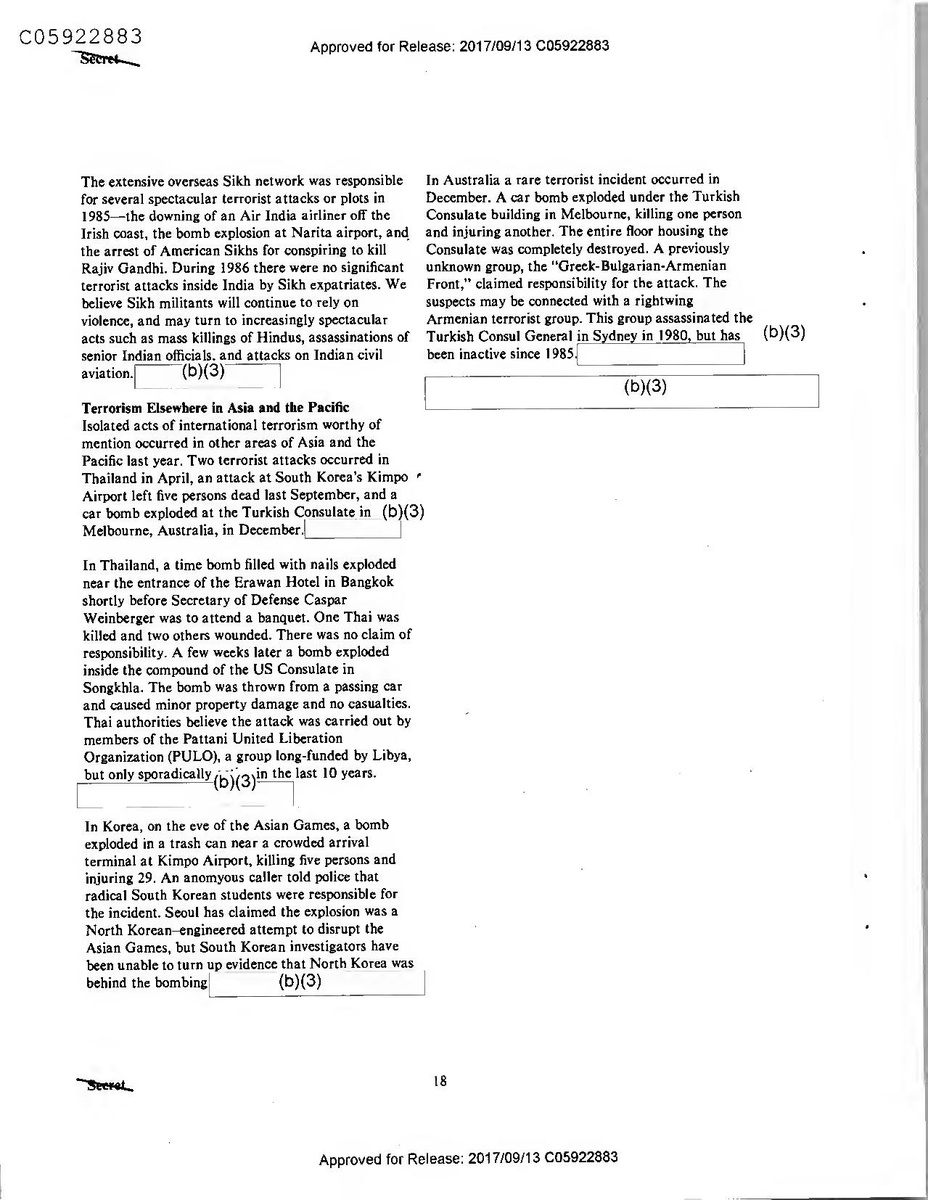
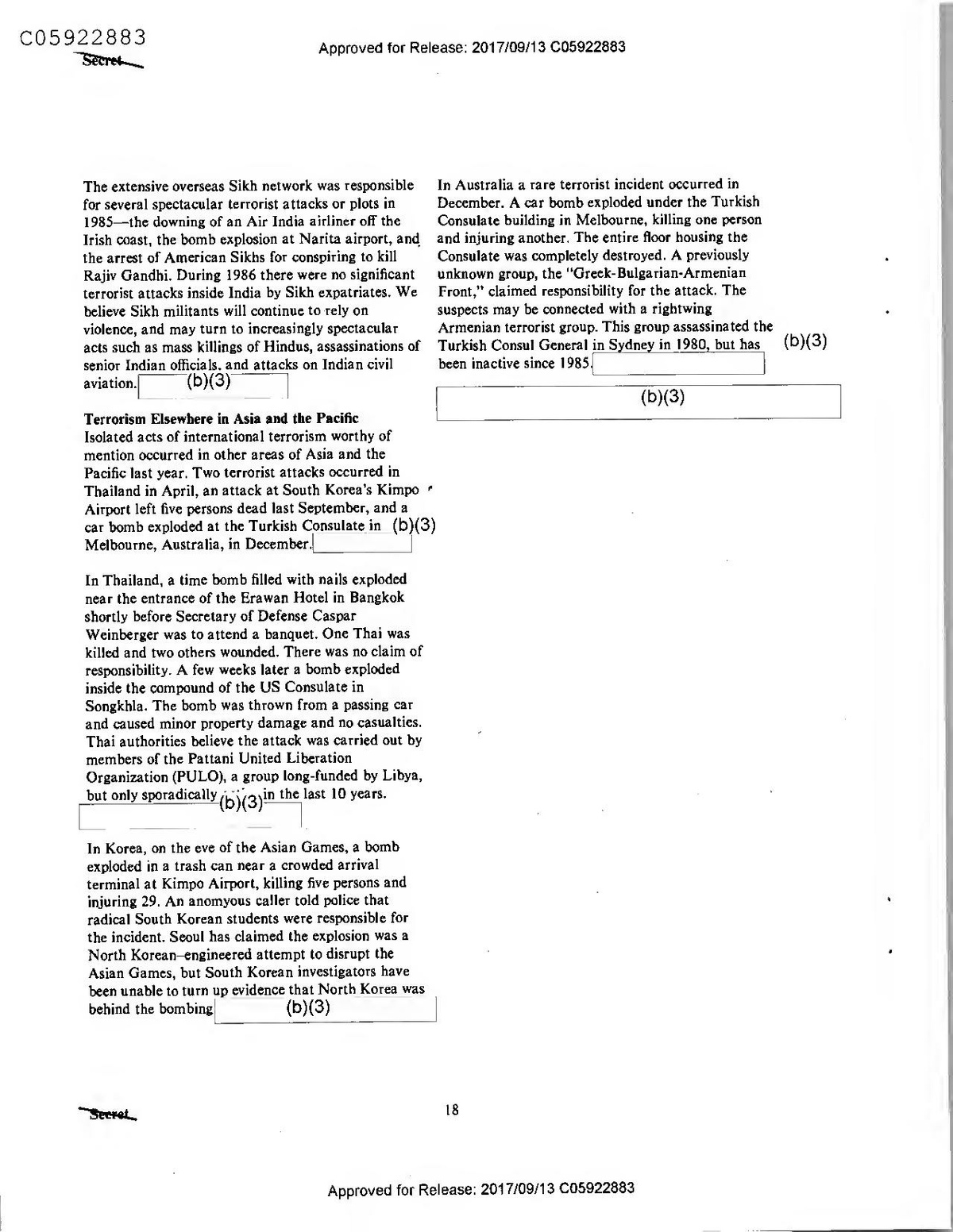
(b)(3)
The extensive overseas Sikh network was responsible for several spectacular terrorist attacks or plots in 1985—the downing of an Air India airliner off the Irish coast, the bomb explosion at Narita airport, and the arrest of American Sikhs for conspiring to kill Rajiv Gandhi. During 1986 there were no significant terrorist attacks inside India by Sikh expatriates. We believe Sikh militants will continue to rely on violence, and may turn to increasingly spectacular acts such as mass killings of Hindus, assassinations of senior Indian officials, and attacks on Indian civil aviation. (b)(3)
✓
In Australia a rare terrorist incident occurred in
December. A car bomb exploded under the Turkish
Consulate building in Melbourne, killing one person
and injuring another. The entire floor housing the
Consulate was completely destroyed. A previously
unknown group, the "Greek-Bulgarian-Armenian
Front," claimed responsibility for the attack. The
suspects may be connected with a rightwing
Armenian terrorist group. This group assassinated the
Turkish ConsUL General in Sydney in 1980, but has
been inactive since 1985.
(b)(3) Terrorism Elsewhere in Asia and the Pacific Isolated acts of international terrorism worthy of mention occurred in other areas of Asia and the Pacific last year. Two terrorist attacks occurred in Thailand in April, an attack at South Korea's Kimpo" Airport left five persons dead last September, and a car bomb exploded at the Turkish Consulate in (b)(3) Melbourne, Australia, in December.
In Thailand, a time bomb filled with nails exploded near the entrance of the Erawan Hotel in Bangkok shortly before Secretary of Defense Caspar Weinberger was to attend a banquet. One Thai was killed and two others wounded. There was no claim of responsibility. A few weeks later a bomb exploded inside the compound of the US Consulate in Songkhla. The bomb was thrown from a passing car and caused minor property damage and no casualties. Thai authorities believe the attack was carried out by members of the Pattani United Liberation Organization (PULO), a group long-funded by Libya,
but only sporadically (b)(3)in the last 10 years.
In Korea, on the eve of the Asian Games, a bomb exploded in a trash can near a crowded arrival terminal at Kimpo Airport, killing five persons and injuring 29. An anomyous caller told police that radical South Korean students were responsible for the incident. SeoUL has claimed the explosion was a North Korean-engineered attempt to disrupt the Asian Games, but South Korean investigators have been unable to turn up evidence that North Korea was behind the bombing
(b)(3)
Secret
18
Approved for Release: 2017/09/13 C05922883
Emerging Terrorist Threat to Scandinavia (b)(3)
|(b)(1) The Scandinavian countries—Norway, Finland,
(b)(3) Sweden, and Denmark-have been relatively free of terrorist activity, compared with Central Europe, and likely will remain so for the near future. However, recent trends in terrorist operations suggest that, in Other groups have ties to Scandinavia as well. the longer term, Scandinavia could well face a
Norwegian radical leftist groups may have links to the significantly increased threat from terrorists. We Irish Republican Army. Members of the Armenian expect the threat will vary among the countries, with Secret Army for the Liberation of Armenia (ASALA) Sweden and Denmark the most likely to experience reside in Denmark, and the Kurdish Workers Party terrorism. Moreover, we expect that any increase in (PKK) is active in Sweden and Denmark. Dissension terrorism probably would be related to causes external within the PKK apparently sparked three attacks on to Scandinavia-principally the spillover of Middle Kurds in Sweden and Denmark last year that left two Eastern issues-rather than terrorism b(b)(3)'ected persons dead and one wounded. PKK activity has against local Scandinavian targets.
been especially unsettling to Stockholm since there is
some evidence the group may have been involved in Terrorists from outside the region have struck in Olaf Palme's assassination. The Stockholm police Scandinavia on several occasions in recent years. For have pursued the possible connection aggressively but example, a US airline office and a Jewish synagogue have failed to develop compelling evidence. Several in Copenhagen, Denmark, were bombed in July 1985. Kurds were arrested in January 1987 but
(b)(3) In 1986 two embassies were attacked: the Soviet subsequently were released. Embassy was bombed in December, and radicals seized the Peruvian Embassy for several hours last Since 1984 the Scandinavian countries have April. Also last April, a small bomb exploded outside experienced an influx of immigrants from the Middle a US airline office in Stockholm, and the African East who could be tapped for support of terrorist National Congress office there was bombed last operations.
(b)(1) September. The most dramatic example of the region's vulnerability to terrorism was the murder of Swedish Prime Minister Olaf Palme on 28 February
In Norway the 1986; the perpetratorinn heir nationality are still arrival of as many as 100,000 immigrants from the
"(b)(3) unknown.
Middle East, Africa, and Asia has hindered the
performance of background checks by authorities. Terrorist-related activities have recently prompted Denmark has accepted approximately 6,000 Middle more action from authorities. A Swedish national of Eastern immigrants since 1985. Although no figures Middle East origin was one of six persons arrested in are available, Sweden, and possibly Finland, may October 1986 in London for plotting to kill the Israeli have experienced a similar influx.
(b)(3) Ambassador to Great Britain. The Swede reportedly was a courier for the Abu Nidal organization. London Improved counterterrorist efforts elsewhere in deported him to Sweden without prosecuting him. Western Europe may force terrorist groups to look for Stockholm ordered the expulsion of the deputy chief fresh ground for their activities. Terrorists may find of the PLO Information Office last December
Scandinavia an inviting option because it has less because Swedish security officials believed she had widespread contacts with terrorist groups, possibly including Abu Nidal. (b)(1)
(b)(3)
19
Secret DI TR 87-003 12 February 1987
Approved for Release: 2017/09/13 C05922883
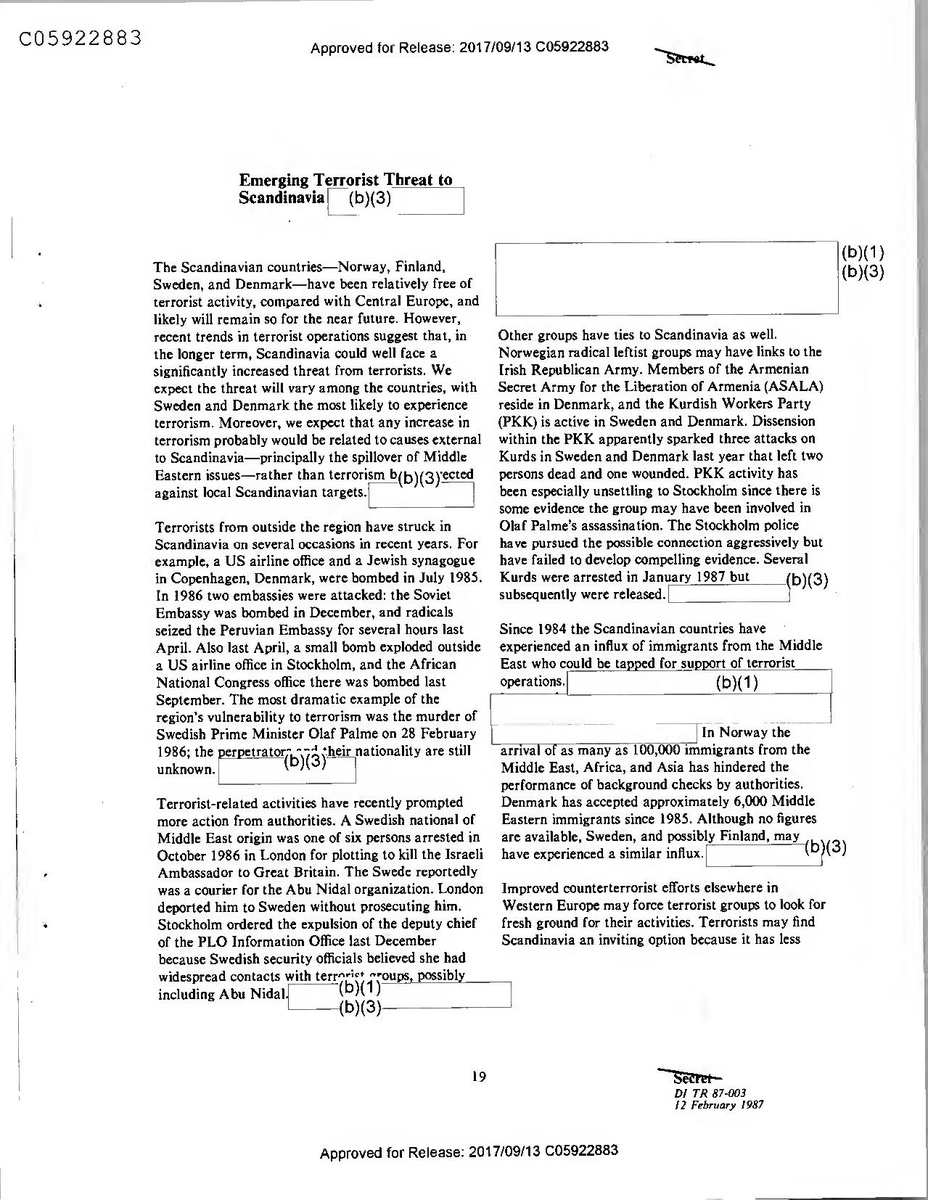
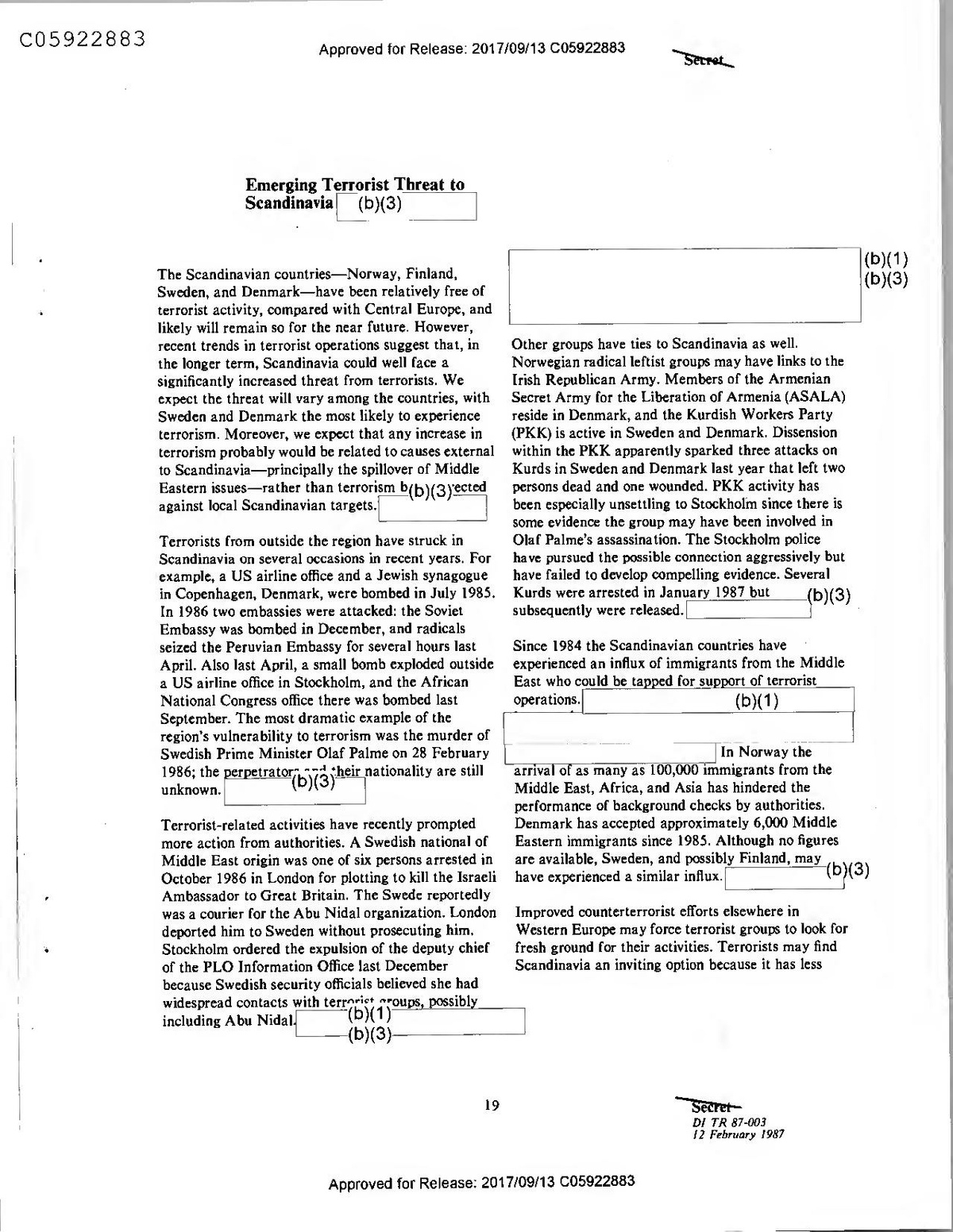
Emerging Terrorist Threat to Scandinavia (b)(3)
|(b)(1) The Scandinavian countries—Norway, Finland,
(b)(3) Sweden, and Denmark-have been relatively free of terrorist activity, compared with Central Europe, and likely will remain so for the near future. However, recent trends in terrorist operations suggest that, in Other groups have ties to Scandinavia as well. the longer term, Scandinavia could well face a
Norwegian radical leftist groups may have links to the significantly increased threat from terrorists. We Irish Republican Army. Members of the Armenian expect the threat will vary among the countries, with Secret Army for the Liberation of Armenia (ASALA) Sweden and Denmark the most likely to experience reside in Denmark, and the Kurdish Workers Party terrorism. Moreover, we expect that any increase in (PKK) is active in Sweden and Denmark. Dissension terrorism probably would be related to causes external within the PKK apparently sparked three attacks on to Scandinavia-principally the spillover of Middle Kurds in Sweden and Denmark last year that left two Eastern issues-rather than terrorism b(b)(3)'ected persons dead and one wounded. PKK activity has against local Scandinavian targets.
been especially unsettling to Stockholm since there is
some evidence the group may have been involved in Terrorists from outside the region have struck in Olaf Palme's assassination. The Stockholm police Scandinavia on several occasions in recent years. For have pursued the possible connection aggressively but example, a US airline office and a Jewish synagogue have failed to develop compelling evidence. Several in Copenhagen, Denmark, were bombed in July 1985. Kurds were arrested in January 1987 but
(b)(3) In 1986 two embassies were attacked: the Soviet subsequently were released. Embassy was bombed in December, and radicals seized the Peruvian Embassy for several hours last Since 1984 the Scandinavian countries have April. Also last April, a small bomb exploded outside experienced an influx of immigrants from the Middle a US airline office in Stockholm, and the African East who could be tapped for support of terrorist National Congress office there was bombed last operations.
(b)(1) September. The most dramatic example of the region's vulnerability to terrorism was the murder of Swedish Prime Minister Olaf Palme on 28 February
In Norway the 1986; the perpetratorinn heir nationality are still arrival of as many as 100,000 immigrants from the
"(b)(3) unknown.
Middle East, Africa, and Asia has hindered the
performance of background checks by authorities. Terrorist-related activities have recently prompted Denmark has accepted approximately 6,000 Middle more action from authorities. A Swedish national of Eastern immigrants since 1985. Although no figures Middle East origin was one of six persons arrested in are available, Sweden, and possibly Finland, may October 1986 in London for plotting to kill the Israeli have experienced a similar influx.
(b)(3) Ambassador to Great Britain. The Swede reportedly was a courier for the Abu Nidal organization. London Improved counterterrorist efforts elsewhere in deported him to Sweden without prosecuting him. Western Europe may force terrorist groups to look for Stockholm ordered the expulsion of the deputy chief fresh ground for their activities. Terrorists may find of the PLO Information Office last December
Scandinavia an inviting option because it has less because Swedish security officials believed she had widespread contacts with terrorist groups, possibly including Abu Nidal. (b)(1)
(b)(3)
19
Secret DI TR 87-003 12 February 1987
Approved for Release: 2017/09/13 C05922883
have begun to seek out more hospitable loc(b)(1)for
stringent security than in most of the rest of Europe, November have been sold to Middle Eastern terrorists and it houses the same range of targets as elsewhere: operating in France. synagogues, airline offices, mass transportation
(b)(1) terminals, embassies, and tourist attractions. Other
(b)(3) West European countries have stepped up security at government facilities and airports, and American diplomatic and military installations also (b)(3) upgraded their security
Terrorists probably would select American, Israeli, or
Jewish interests in Scandinavia as primary targets. In the face of these efforts, some terrorist groups may Nordic governments generally have been sympathetic
to Arab concerns, and attacks on Scandinavians could planning their terrorist operations.
jeopardize that good will. There are no US military Hawari terrorist organization, which is tied to
installations in Scandinavia, although there are Palestinian Liberation Organization chief Yasir NATO-associated facilities in Norway and Denmark. Arafat, reportedly has begun to look at Asia and Numerous US businesses are represented in the Africa because Europe had been too difficult for region, which is also popular with American tourists, recruitment and obtaining logistic support. There are providing a variety of potential targets. Police foiled as yet no indications that such terrorists are turning to an attempt last September against a passenger ferry Scandinavia as fertile ground, but, in time, the region running between Stockholm and Helsinki after a could become as attractive as other areas outside phone caller reported the ferry would be sunk
to
(b)(1) central Europe.
(b)(3) the many Americans who were aboard
(b)(3)
an Arab If terrorist groups significantly expand their activities terrorist team was in Stockholm to attack the in the Nordic region, we expect they will move in several stages. Initially, Scandinavia could be used as targets there, but no attacks occurred. an entry point to the rest of Western Europe. The
(b)(1) recent arrests of several terrorists arriving in Europe
internatif from the Middle East, such as Mohammad
terrorist
groups have as yet focused on Scandina(b)(3) Hammadi, one of the TWA Flight 847 hijackers, may Nevertheless, government officials throughout the signal Middle Eastern terrorist groups that central region have indicated an increasing awareness of the Europe is becoming more dangerous as a transit point potential threat, forcefully brought home to them by and make Scandinavia more attractive. Eastern
Olaf Palme's assassination. The greatest threat in Europe has been used in this fashion by Middle Scandinavia appears to be in Sweden and Denmark Eastern terrorists, but some of the countries have where terrorists have carried 07 ka majority of
b)(3) taken steps to monitor more closely, and in some cases attacks. curb, the flow.
several Iranians allegedly traveled Scandinavian officials have voiced fears that lax through Denmark and Sweden to carry out attacks physical security at airports, government facilities, against Arab airlines operating in Western Europe. and around their political leaders, combined with Scandinavian security authorities have expressed their limited ability to track individuals traveling in concern that they cannot adequately monitor the the region, could make Scandinavia an inviting area movement of persons they suspect may be connected to terrorists. Sweden's expulsion of a PLO official with terrorist activities
(b)(3) reportedly signaled Stockholm's resolve not to allow
terrorists to use Sweden as a staging area, and the Terrorist groups also could find Scandinavia convenient as a logistic base for their operations. Weapons and explosives stolen from an unguarded military ammunition storage bunker in Sweden last
American or Israeli Embassies or other US civili:(b)(3)
Secret
20
Approved for Release: 2017/09/13 C05922883
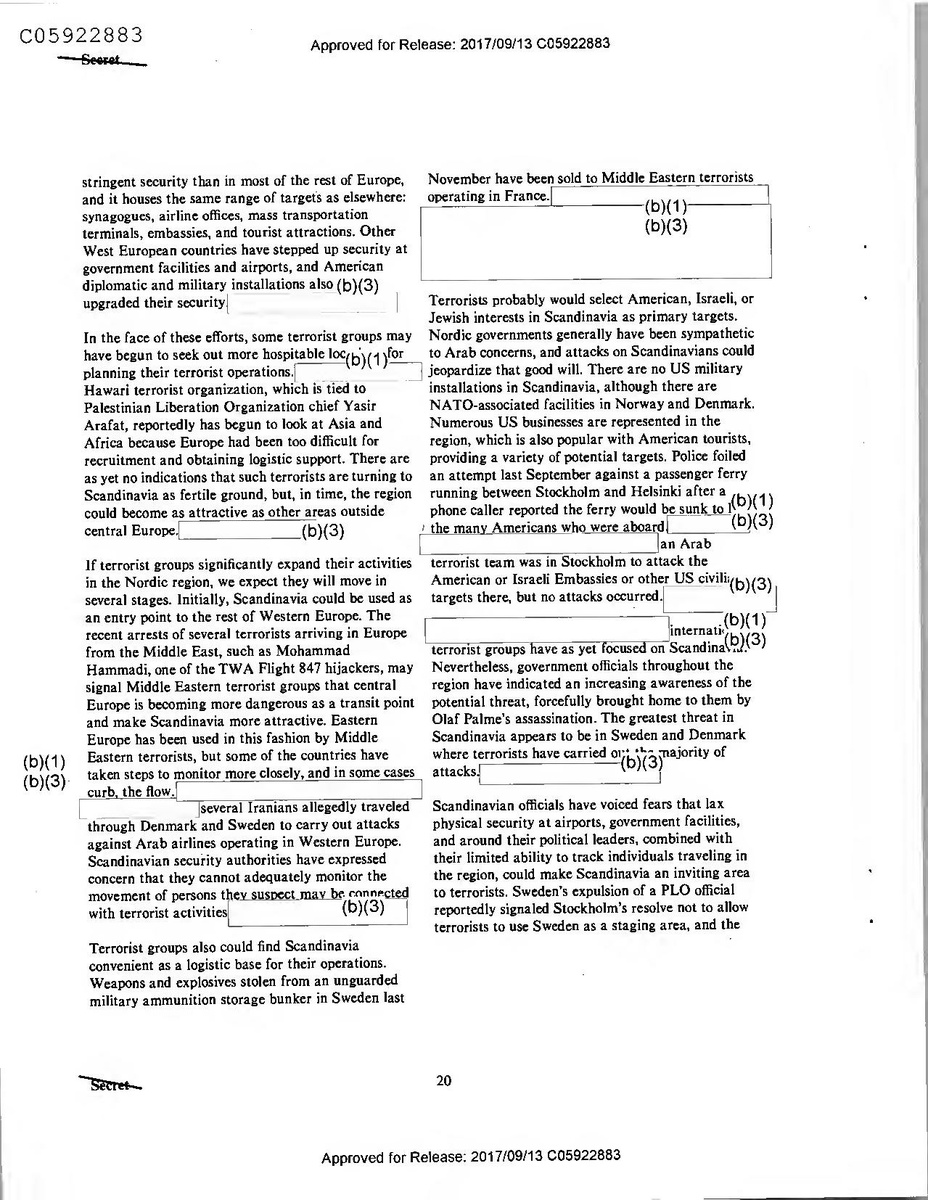
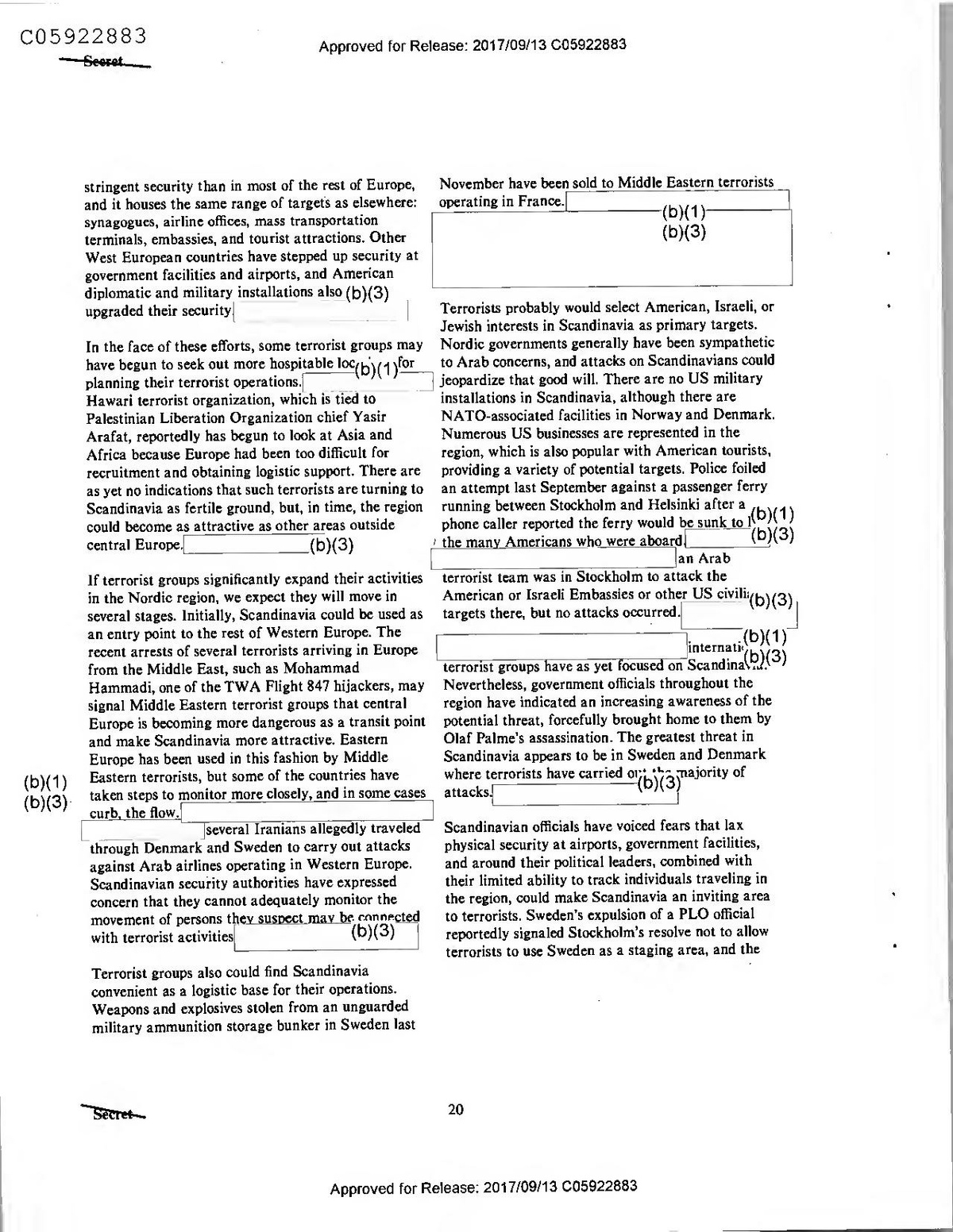
have begun to seek out more hospitable loc(b)(1)for
stringent security than in most of the rest of Europe, November have been sold to Middle Eastern terrorists and it houses the same range of targets as elsewhere: operating in France. synagogues, airline offices, mass transportation
(b)(1) terminals, embassies, and tourist attractions. Other
(b)(3) West European countries have stepped up security at government facilities and airports, and American diplomatic and military installations also (b)(3) upgraded their security
Terrorists probably would select American, Israeli, or
Jewish interests in Scandinavia as primary targets. In the face of these efforts, some terrorist groups may Nordic governments generally have been sympathetic
to Arab concerns, and attacks on Scandinavians could planning their terrorist operations.
jeopardize that good will. There are no US military Hawari terrorist organization, which is tied to
installations in Scandinavia, although there are Palestinian Liberation Organization chief Yasir NATO-associated facilities in Norway and Denmark. Arafat, reportedly has begun to look at Asia and Numerous US businesses are represented in the Africa because Europe had been too difficult for region, which is also popular with American tourists, recruitment and obtaining logistic support. There are providing a variety of potential targets. Police foiled as yet no indications that such terrorists are turning to an attempt last September against a passenger ferry Scandinavia as fertile ground, but, in time, the region running between Stockholm and Helsinki after a could become as attractive as other areas outside phone caller reported the ferry would be sunk
to
(b)(1) central Europe.
(b)(3) the many Americans who were aboard
(b)(3)
an Arab If terrorist groups significantly expand their activities terrorist team was in Stockholm to attack the in the Nordic region, we expect they will move in several stages. Initially, Scandinavia could be used as targets there, but no attacks occurred. an entry point to the rest of Western Europe. The
(b)(1) recent arrests of several terrorists arriving in Europe
internatif from the Middle East, such as Mohammad
terrorist
groups have as yet focused on Scandina(b)(3) Hammadi, one of the TWA Flight 847 hijackers, may Nevertheless, government officials throughout the signal Middle Eastern terrorist groups that central region have indicated an increasing awareness of the Europe is becoming more dangerous as a transit point potential threat, forcefully brought home to them by and make Scandinavia more attractive. Eastern
Olaf Palme's assassination. The greatest threat in Europe has been used in this fashion by Middle Scandinavia appears to be in Sweden and Denmark Eastern terrorists, but some of the countries have where terrorists have carried 07 ka majority of
b)(3) taken steps to monitor more closely, and in some cases attacks. curb, the flow.
several Iranians allegedly traveled Scandinavian officials have voiced fears that lax through Denmark and Sweden to carry out attacks physical security at airports, government facilities, against Arab airlines operating in Western Europe. and around their political leaders, combined with Scandinavian security authorities have expressed their limited ability to track individuals traveling in concern that they cannot adequately monitor the the region, could make Scandinavia an inviting area movement of persons they suspect may be connected to terrorists. Sweden's expulsion of a PLO official with terrorist activities
(b)(3) reportedly signaled Stockholm's resolve not to allow
terrorists to use Sweden as a staging area, and the Terrorist groups also could find Scandinavia convenient as a logistic base for their operations. Weapons and explosives stolen from an unguarded military ammunition storage bunker in Sweden last
American or Israeli Embassies or other US civili:(b)(3)
Secret
20
Approved for Release: 2017/09/13 C05922883
government is planning additional steps to reinforce that perception. The other countries in the region have taken such steps as increasing funds earmarked for counterterrorist efforts and providing additional training for security forces, but these efforts are relatively modest and may not be adequate for even the limited threat currently facing the region.
)
(b)(3)
Reverse Blank
21
Secret
Approved for Release: 2017/09/13 C05922883
government is planning additional steps to reinforce that perception. The other countries in the region have taken such steps as increasing funds earmarked for counterterrorist efforts and providing additional training for security forces, but these efforts are relatively modest and may not be adequate for even the limited threat currently facing the region.
)
(b)(3)
Reverse Blank
21
Secret
Approved for Release: 2017/09/13 C05922883
Fatah Official Implicated in TWA Flight 840 Attack
-(b)(3)
(b)(1)
)
(1)
)(1) )(3)
After Hawari's expulsion from Tunisia, he reportedly Palestinian group that is a part of Fatah was
returned to Baghdad, Iraq, where he also maintains a responsible for the TWA Flight 840 attack on 2 April home and an office. His activities were reportedly 1986. The explosion occurred shortly before the temporarily suspended, probably because of pressure aircraft was to land in Athens and killed four
from angered Fatah and PLO officials. In late Americans.
December, however, Hawari reportedly returned to Ja Lebanese
Christian, May Mansour, as the work in his Baghdad office and resumed the position perpetrator.
as head of his organization.
(b)(3) that she was working on behalf of Fatah's Colonel Hawari. Hawari, a close confidant of PLO chief Yasir In early January, PLO Chairman Yasir Arafat Arafat, heads a special Fatah security unit. May reportedly ordered Colonel Hawari to suspend foreign Mansour—who also had ties to a Syrian-backed terrorist operations. The group's resources were to be group-reportedly was recruited by a Hawari
used instead against Amal and Syrian forces in operative to serve as a courier. Mansour reportedly Lebanon. Arafat reportedly is willing, however, to received the explosives to place aboard the aircraft allow Hawari's group to help the radical Shi(b)(1). from Hawari operatives in Cairo. The explosion Hizballah conduct foreign terrorist operation(b)(3) ripped a hole in the fuselage and killed the fourincluding a 9-month-old baby—when they were sucked out of the aircraft
(b)(3)
Arafat's order probably does not mean that Hawari Moroccan authorities arrested four Hawari
has been taken out of the terrorism business but more operatives—two Palestinians and two Tunisians-last likely reflects the importance the PLO places on the August who were carrying explosive devices and false war of the camps in Lebanon and Arafat's strong passports
one of the Palestinians commitment to reestablishing a PLO presence in revealed Mansour's involvement in the attack and also Lebanon. Syria and Israel may become the short-term identified her as one of 14 Hawari operatives
focus of Hawari's operations-probably in an effort to responsible for bomb attacks. The technology of the further the PLO's goals in Lebanon. The group's bombing device used on TWA 840 resembled that willingness to assist Hizballah in foreign terrorist used by the radical Palestinian 15 May Organization, operations, however, means operations could forms, whose former operatives haya hoon working with the Western targets
(b)(3) Hawari group. F(b)(3)
(b)(3) The arrest of the four Hawari operatives in Morocco fueled intense debate within Fatah over Hawari's operations and raised questions concerning Arafat's knowledge of these operations,
The arrests also caused friction between the PLO and Tunisia after it was discovered that Hawari maintained a covert office in Tunis. Tunisia reportedly expelled Hawari and his apparat from Tunisia shortly after the arrests in Morocco. The PLO also apparently was forced to reduce its presence in Tunisia (b)(3)
1) 3)
Reverse Blank
23
Secret DI TR 87-003 12 February 1987
Approved for Release: 2017/09/13 C05922883
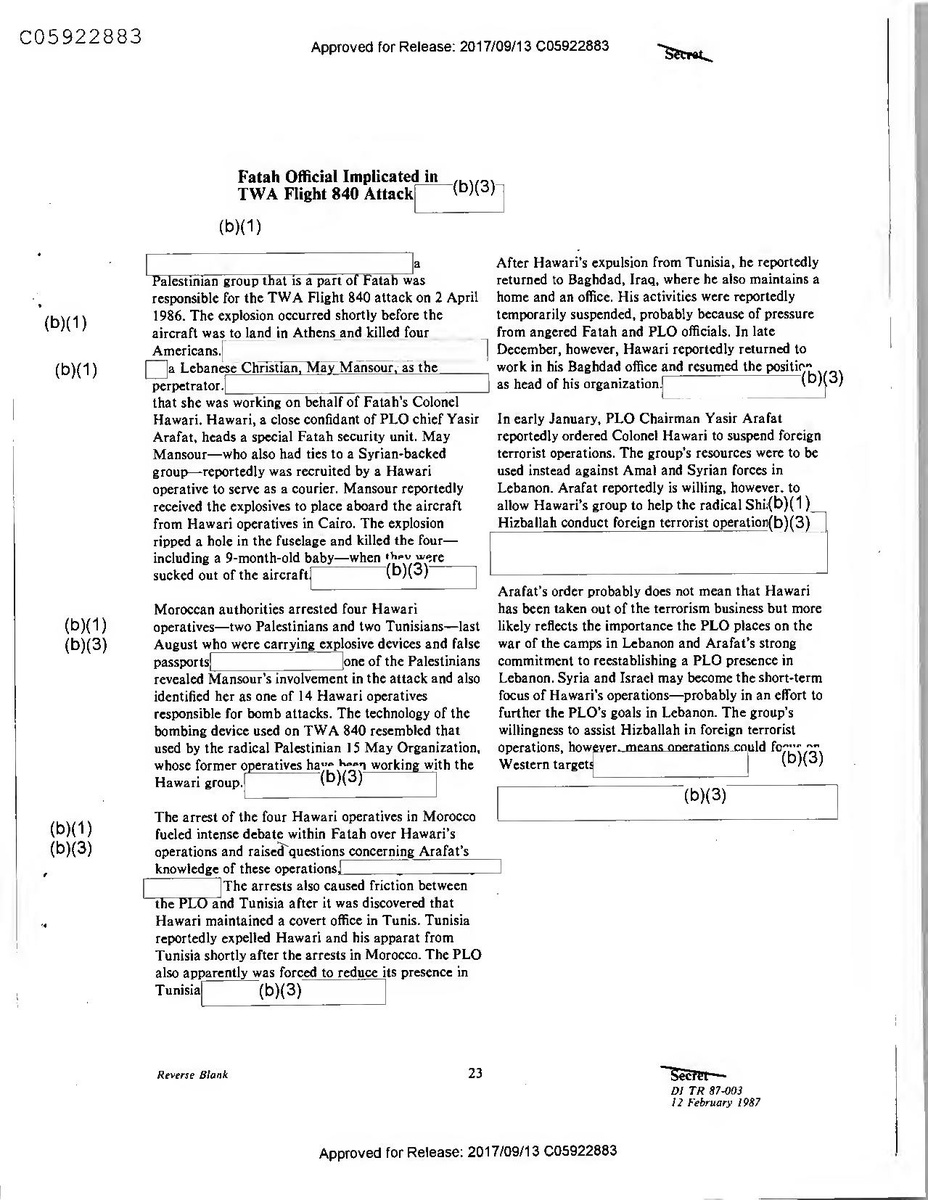
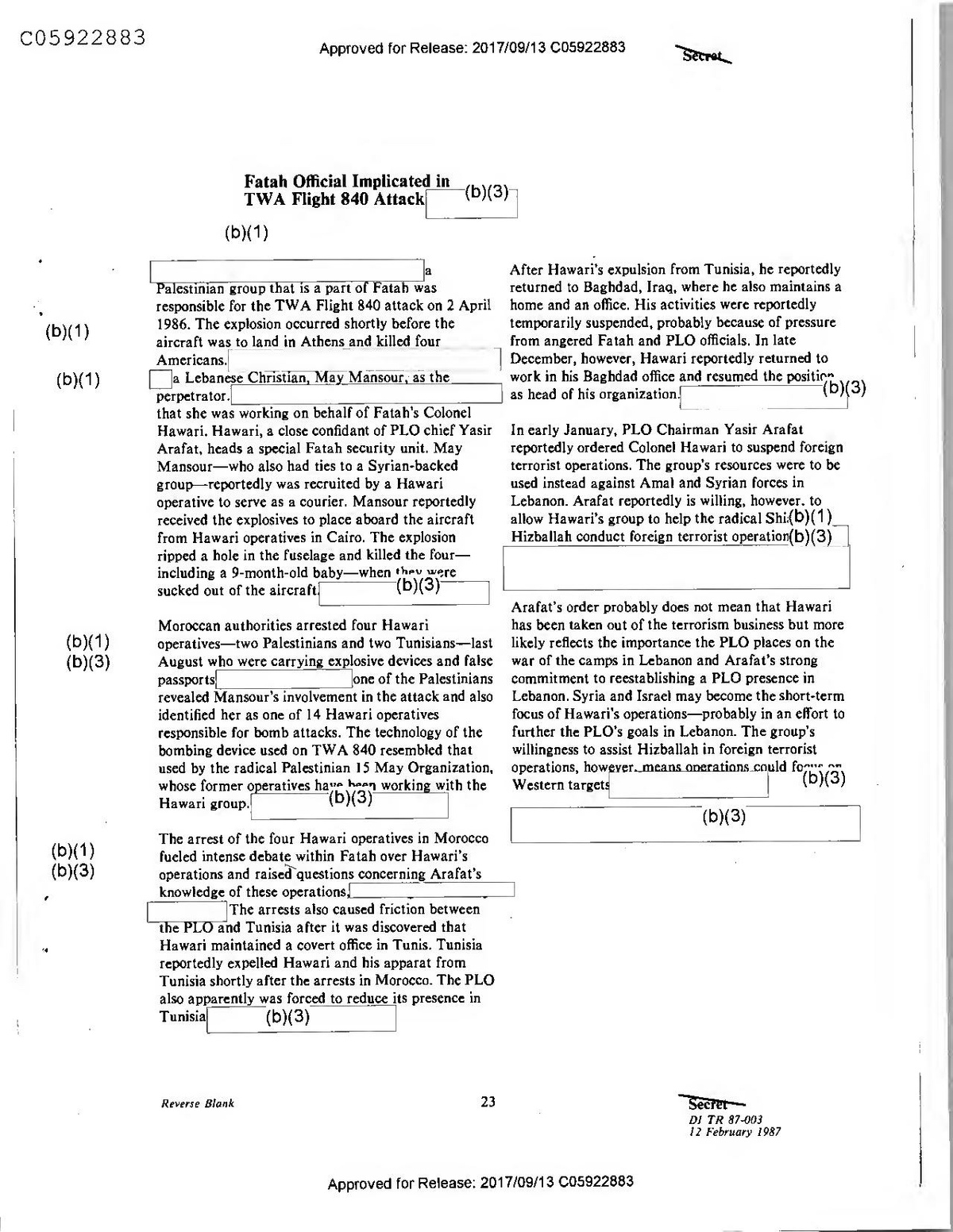
Fatah Official Implicated in TWA Flight 840 Attack
-(b)(3)
(b)(1)
)
(1)
)(1) )(3)
After Hawari's expulsion from Tunisia, he reportedly Palestinian group that is a part of Fatah was
returned to Baghdad, Iraq, where he also maintains a responsible for the TWA Flight 840 attack on 2 April home and an office. His activities were reportedly 1986. The explosion occurred shortly before the temporarily suspended, probably because of pressure aircraft was to land in Athens and killed four
from angered Fatah and PLO officials. In late Americans.
December, however, Hawari reportedly returned to Ja Lebanese
Christian, May Mansour, as the work in his Baghdad office and resumed the position perpetrator.
as head of his organization.
(b)(3) that she was working on behalf of Fatah's Colonel Hawari. Hawari, a close confidant of PLO chief Yasir In early January, PLO Chairman Yasir Arafat Arafat, heads a special Fatah security unit. May reportedly ordered Colonel Hawari to suspend foreign Mansour—who also had ties to a Syrian-backed terrorist operations. The group's resources were to be group-reportedly was recruited by a Hawari
used instead against Amal and Syrian forces in operative to serve as a courier. Mansour reportedly Lebanon. Arafat reportedly is willing, however, to received the explosives to place aboard the aircraft allow Hawari's group to help the radical Shi(b)(1). from Hawari operatives in Cairo. The explosion Hizballah conduct foreign terrorist operation(b)(3) ripped a hole in the fuselage and killed the fourincluding a 9-month-old baby—when they were sucked out of the aircraft
(b)(3)
Arafat's order probably does not mean that Hawari Moroccan authorities arrested four Hawari
has been taken out of the terrorism business but more operatives—two Palestinians and two Tunisians-last likely reflects the importance the PLO places on the August who were carrying explosive devices and false war of the camps in Lebanon and Arafat's strong passports
one of the Palestinians commitment to reestablishing a PLO presence in revealed Mansour's involvement in the attack and also Lebanon. Syria and Israel may become the short-term identified her as one of 14 Hawari operatives
focus of Hawari's operations-probably in an effort to responsible for bomb attacks. The technology of the further the PLO's goals in Lebanon. The group's bombing device used on TWA 840 resembled that willingness to assist Hizballah in foreign terrorist used by the radical Palestinian 15 May Organization, operations, however, means operations could forms, whose former operatives haya hoon working with the Western targets
(b)(3) Hawari group. F(b)(3)
(b)(3) The arrest of the four Hawari operatives in Morocco fueled intense debate within Fatah over Hawari's operations and raised questions concerning Arafat's knowledge of these operations,
The arrests also caused friction between the PLO and Tunisia after it was discovered that Hawari maintained a covert office in Tunis. Tunisia reportedly expelled Hawari and his apparat from Tunisia shortly after the arrests in Morocco. The PLO also apparently was forced to reduce its presence in Tunisia (b)(3)
1) 3)
Reverse Blank
23
Secret DI TR 87-003 12 February 1987
Approved for Release: 2017/09/13 C05922883
(b)(3)
The Terrorism Diary for March
Below is a compendium of March dates of known or conceivable significance to terrorists around the world. Our inclusion of a date or event should not by itself be construed to suggest that we expect or anticipate a commemorative terrorist event.
7(b)(3)
1878-03-01 Bulgaria. Independence Day.
2 March 1956
Morocco. Independence Day. Termination of Treaty of Fez.
2 March 1972
El Salvador. Founding of People's Revolutionary Army (ERP).
2 March 1977
Libya. Establishment of Jamahiriyah (masses' state).
3 March 1961
Morocco. Accession of King Hassan to throne.
4 March 1982
Colombia and United States. Effective date of extradition treaty aimed at narcotics traffickers.
6 March 1957
Ghana. Independence Day.
6 March 1975
Kurdish regions. Algerian accord between Iran and Iraq, abandoning support of the Kurds.
10 March 1979
Kurdish regions. Death of Kurdish leader Mulla Mustafa Barzani.
11 March 1966
Indonesia. President Sukarno turns over power to Soeharto.
12 March
Gabon. National Day.
12 March 1880
Turkey. Birthday of Kemal Ataturk.
12 March 1968
Mauritius. Independence Day.
13 March 1979
Grenada. National Day. Commemorates coup d'etat by Maurice Bishop.
14 March 1975
Japan. Chukaku-ha (Nucleus Faction) Secretary General Honda assassinated by rival radical group.
15 March 1962
Angola. Founding of National Front for the Liberation of Angola (FNLA).
16 March 1921
Armenians. Signing of Soviet-Turkish border treaty that ended Armenian hopes of establishing a separate, independent state.
17 March
Ireland. St. Patrick's Day. Ireland's National Day.
25
Secret DI TR 87-003 12 February 1987
Approved for Release: 2017/09/13 C05922883
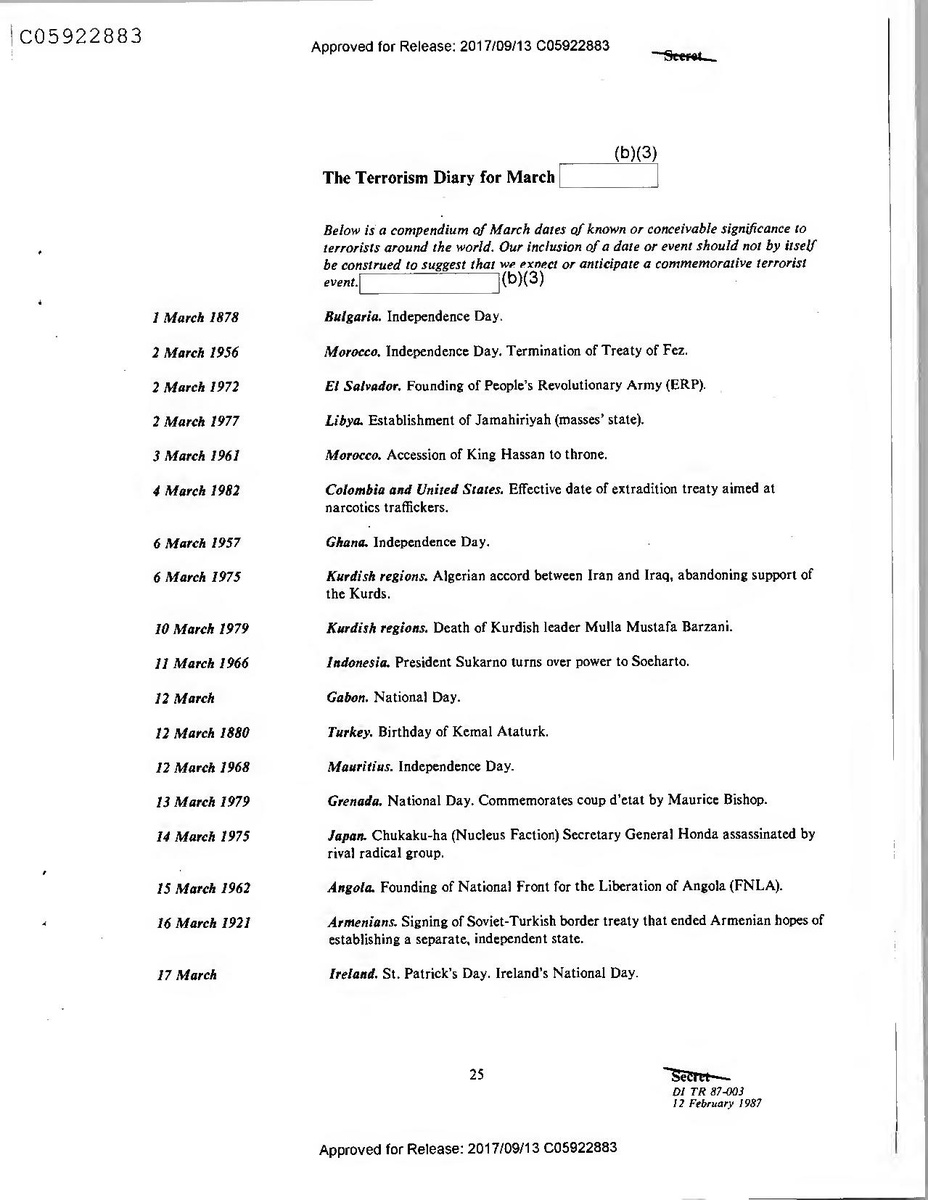
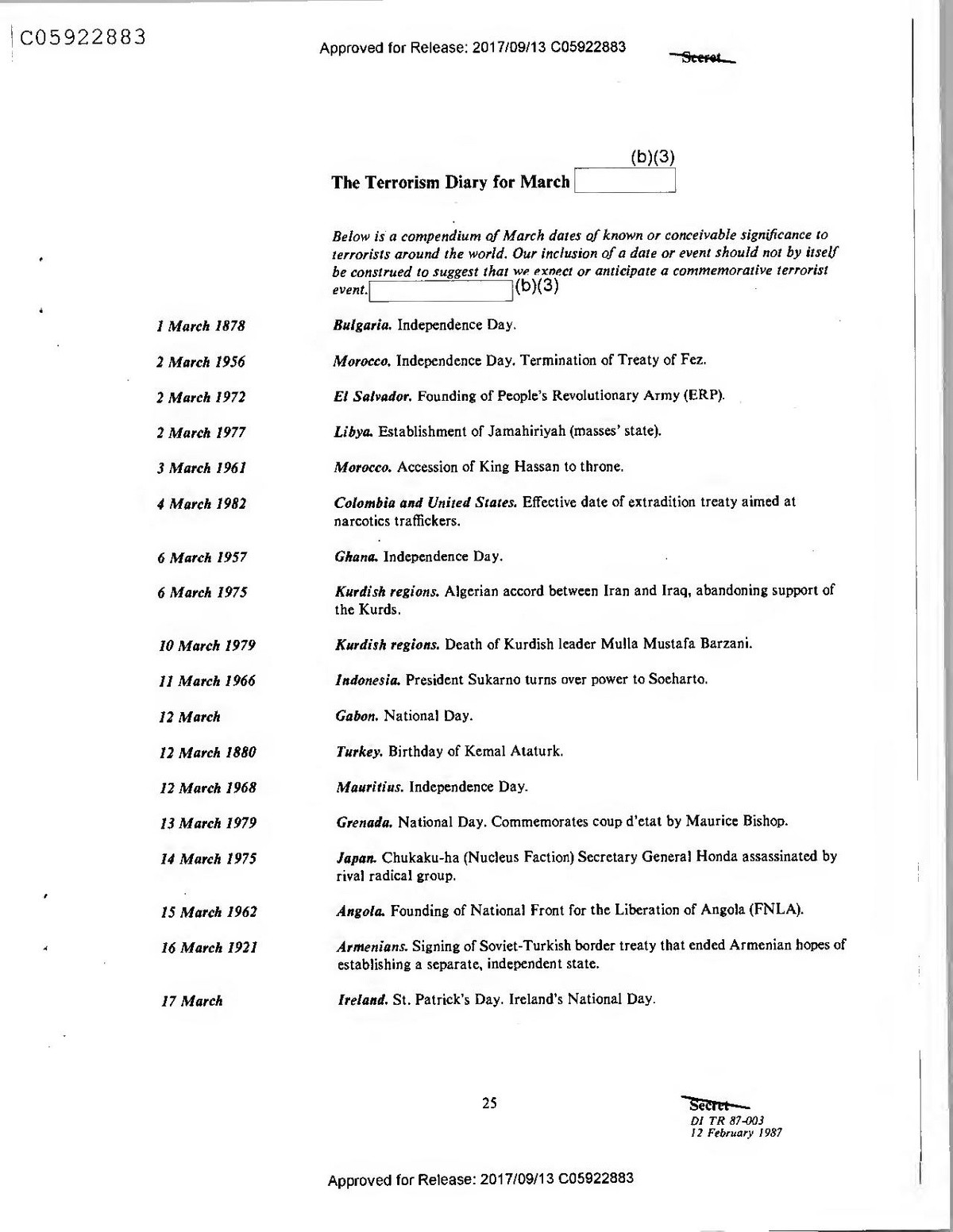
(b)(3)
The Terrorism Diary for March
Below is a compendium of March dates of known or conceivable significance to terrorists around the world. Our inclusion of a date or event should not by itself be construed to suggest that we expect or anticipate a commemorative terrorist event.
7(b)(3)
1878-03-01 Bulgaria. Independence Day.
2 March 1956
Morocco. Independence Day. Termination of Treaty of Fez.
2 March 1972
El Salvador. Founding of People's Revolutionary Army (ERP).
2 March 1977
Libya. Establishment of Jamahiriyah (masses' state).
3 March 1961
Morocco. Accession of King Hassan to throne.
4 March 1982
Colombia and United States. Effective date of extradition treaty aimed at narcotics traffickers.
6 March 1957
Ghana. Independence Day.
6 March 1975
Kurdish regions. Algerian accord between Iran and Iraq, abandoning support of the Kurds.
10 March 1979
Kurdish regions. Death of Kurdish leader Mulla Mustafa Barzani.
11 March 1966
Indonesia. President Sukarno turns over power to Soeharto.
12 March
Gabon. National Day.
12 March 1880
Turkey. Birthday of Kemal Ataturk.
12 March 1968
Mauritius. Independence Day.
13 March 1979
Grenada. National Day. Commemorates coup d'etat by Maurice Bishop.
14 March 1975
Japan. Chukaku-ha (Nucleus Faction) Secretary General Honda assassinated by rival radical group.
15 March 1962
Angola. Founding of National Front for the Liberation of Angola (FNLA).
16 March 1921
Armenians. Signing of Soviet-Turkish border treaty that ended Armenian hopes of establishing a separate, independent state.
17 March
Ireland. St. Patrick's Day. Ireland's National Day.
25
Secret DI TR 87-003 12 February 1987
Approved for Release: 2017/09/13 C05922883
1981-03-20 Colombia. Death of M-19 terrorist Carmenza Londono (“La Chiqui').
1981-03-21 Kurdish regions. Kurdish New Year.
1981-03-21 Palestinians. “International Day of Solidarity With the Struggle of the Arab People of Palestine Against Israeli Aggressors."
1960-03-21 South Africa. Sharpeville Massacre of black demonstrators by security forces.
1945-03-22 Middle East. Founding of Arab League. Original members: Egypt, Iraq, Jordan, Lebanon, Libya, Saudi Arabia, Syria.
23 March 1956-03-23 Pakistan. Pakistan Day. Founding of Islamic republic.
1972-03-24 Northern Ireland. Beginning of direct rule by British Government.
1976-03-24 Argentina. President Isabel Peron ousted by Gen. Jorge Rafael Videla.
1980-03-24 El Salvador. Archbishop Oscar Arnulfo Romero assassinated by rightists.
1986-03-24 Libya and United States. US naval forces cross “line of death” in Gulf of Sidra and engage Libyan forces. Four Libyan patrol boats sunk or damaged and an SA-5 radar site crippled.
25 March 1821
Greece. Greek Revolution Memorial Day. Commemorates independence from Turkey.
25 March 1975
Saudi Arabia. Assassination of King Faisal and accession of King Khalid.
25 March 1980
El Salvador. US Embassy attacked by Popular Liberation Forces (FPL) in response to assassination of Archbishop Oscar Arnulfo Romero the previous day; since then, FPL attacks have been relatively more frequent between 25 March and 6 April than during rest of year.
26 March 1971
Bangladesh. Independence Day.
26 March 1978
Egypt and Israel. Peace agreement ratified.
28 March
Palestinians. National Day.
28 March 1970
Libya. UK Evacuation Day. Day British forces turned over bases and departed.
28 March 1980
El Salvador. Government expropriates plantations; Salvation Movement of 28 March (MS-28) takes its name from this event.
28 March 1980
Italy. Four members of Red Brigades die in shootout with Carabinieri in Genoa.
Secret
26
Approved for Release: 2017/09/13 C05922883
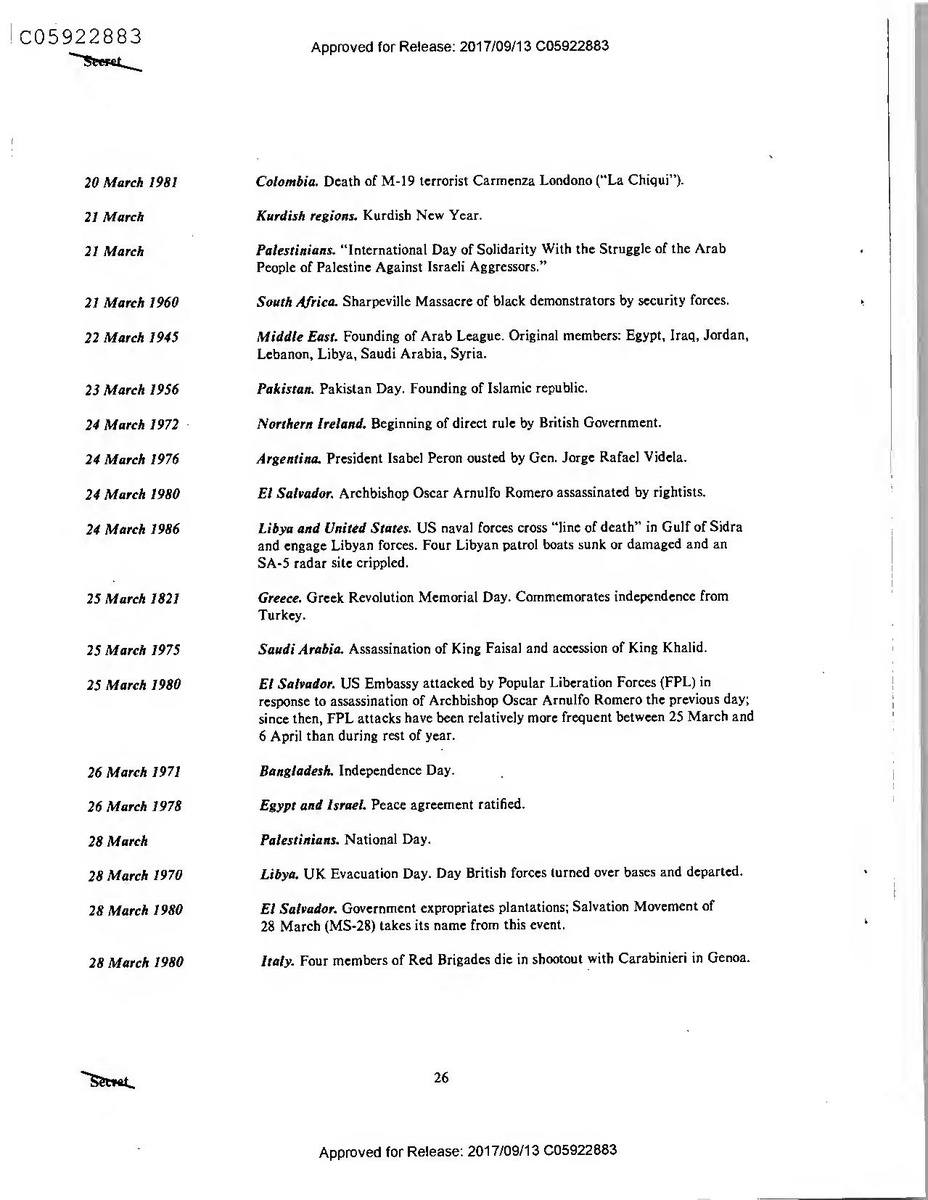
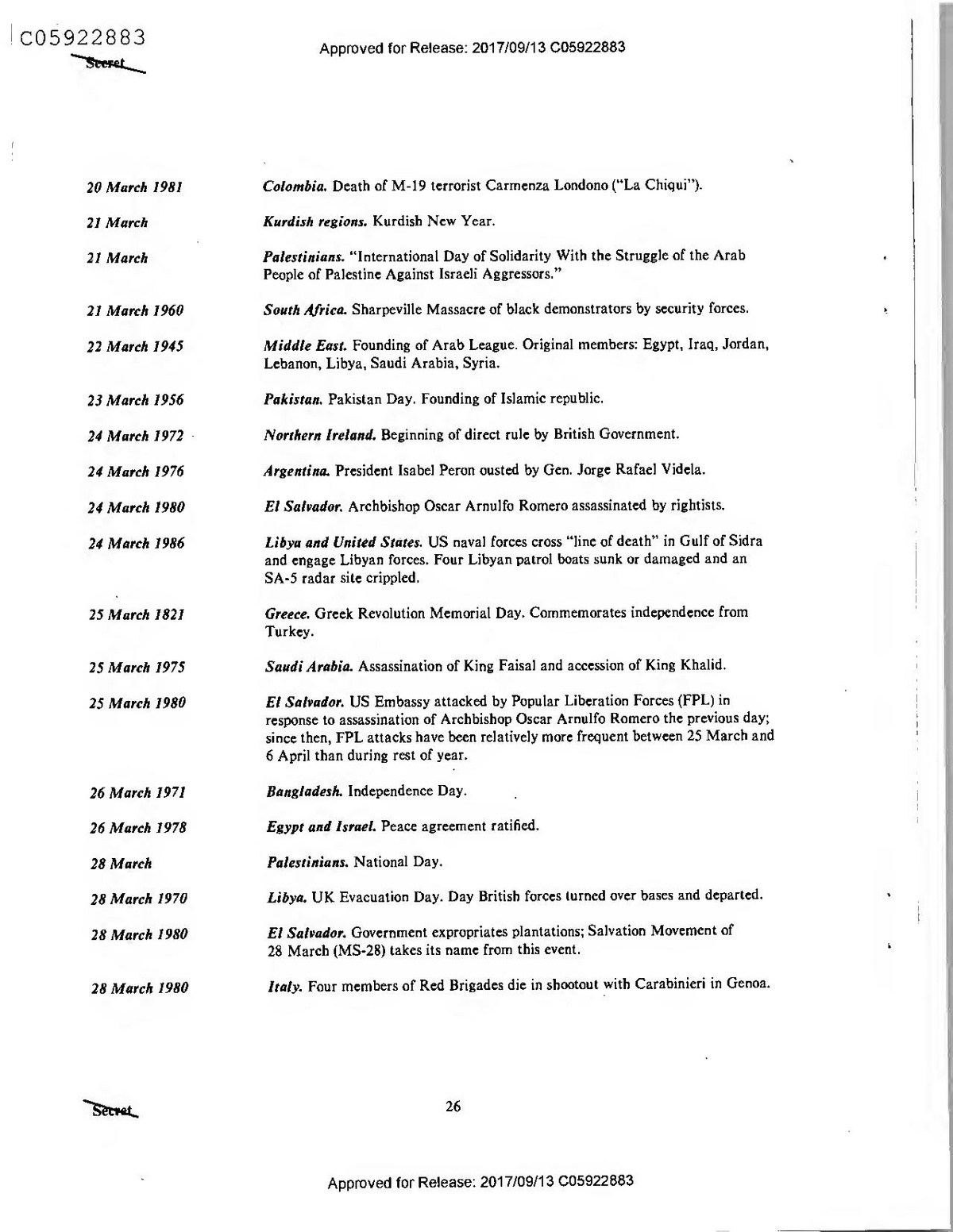
1981-03-20 Colombia. Death of M-19 terrorist Carmenza Londono (“La Chiqui').
1981-03-21 Kurdish regions. Kurdish New Year.
1981-03-21 Palestinians. “International Day of Solidarity With the Struggle of the Arab People of Palestine Against Israeli Aggressors."
1960-03-21 South Africa. Sharpeville Massacre of black demonstrators by security forces.
1945-03-22 Middle East. Founding of Arab League. Original members: Egypt, Iraq, Jordan, Lebanon, Libya, Saudi Arabia, Syria.
23 March 1956-03-23 Pakistan. Pakistan Day. Founding of Islamic republic.
1972-03-24 Northern Ireland. Beginning of direct rule by British Government.
1976-03-24 Argentina. President Isabel Peron ousted by Gen. Jorge Rafael Videla.
1980-03-24 El Salvador. Archbishop Oscar Arnulfo Romero assassinated by rightists.
1986-03-24 Libya and United States. US naval forces cross “line of death” in Gulf of Sidra and engage Libyan forces. Four Libyan patrol boats sunk or damaged and an SA-5 radar site crippled.
25 March 1821
Greece. Greek Revolution Memorial Day. Commemorates independence from Turkey.
25 March 1975
Saudi Arabia. Assassination of King Faisal and accession of King Khalid.
25 March 1980
El Salvador. US Embassy attacked by Popular Liberation Forces (FPL) in response to assassination of Archbishop Oscar Arnulfo Romero the previous day; since then, FPL attacks have been relatively more frequent between 25 March and 6 April than during rest of year.
26 March 1971
Bangladesh. Independence Day.
26 March 1978
Egypt and Israel. Peace agreement ratified.
28 March
Palestinians. National Day.
28 March 1970
Libya. UK Evacuation Day. Day British forces turned over bases and departed.
28 March 1980
El Salvador. Government expropriates plantations; Salvation Movement of 28 March (MS-28) takes its name from this event.
28 March 1980
Italy. Four members of Red Brigades die in shootout with Carabinieri in Genoa.
Secret
26
Approved for Release: 2017/09/13 C05922883
March 1969
Philippines. Founding of New People's Army, military arm of Communist Party of the Philippines.
30 March 1976
Palestinians. Day of the Homeland.
30 March 1986
France. Andre Olivier, cofounder of Action Directe, arrested in Lyon.
31 March
Malta. National Day.
(b)(3)
Reverse Blank
27
Secret
Approved for Release: 2017/09/13 C05922883
March 1969
Philippines. Founding of New People's Army, military arm of Communist Party of the Philippines.
30 March 1976
Palestinians. Day of the Homeland.
30 March 1986
France. Andre Olivier, cofounder of Action Directe, arrested in Lyon.
31 March
Malta. National Day.
(b)(3)
Reverse Blank
27
Secret
Approved for Release: 2017/09/13 C05922883
Secret
Highlights/(b)(3)
Key Indicators
West Germany
US ConsUL General Facilities in Frankfurt at Risk Unknown persons apparently conducted surveillance of the residence and offices of the US ConsUL General in Frankfurt-am-Main. On 14 March, the contents of a box of 9-mm ammunition were found on the sidewalk and in the grass 15 meters from the residence. The next day, two persons tried to enter the grounds of the Consulate General buildina Several more instances of surveillance were detected through 17 March. F(b)(3)
The residence has previously been a target of Red Army Faction (RAF) surveillance. Two such incidents occurred during the RAF hunger strike campaign of December 1984-February 1985. After one of these, the residence was attacked with a small firebomb. F(b)(3)
(b)(1) (b)(3)
France
(b)(1) (b)(3)
LARF Plans More Terrorist Operations in France In early March, Joseph Abdallah, the current leader of the Lebanese Armed Revolutionary Faction (LARF), announced plans for a major terrorist operation within the next month in France in order to gain the release of his brother, George Abdallah,
George Abdallah is the former LARF leader who was arrested by French police in October 1984 in Lyon. Joseph reportedly is also willing to smuggle a Soviet surface-to-air missile into Paris for use in a separate terrorist operation. (b)(3)
This announcement was followed by the bombing of a Paris-to-Lyon train on 17 March that injured 10 persons. The bombing was claimed by the Committee of Solidarity With Arab Political Prisoners and the Middle East. This group warned that the train bombing was "the first in a new series" of attacks unless three prisoners, including George Abdallah, were released. The other two prisoners cited were Varoujan Garbidjian, a member of the Armenian Secret Army for the Liberation of Armenia (ASALA), convicted in the July 1983 bombing at Orly Airport, and Anis Naccache, leader of a five-man commando team convicted in
7
Secret DI TR 86-05 April 1986
Approved for Release: 2017/09/13 C05632837
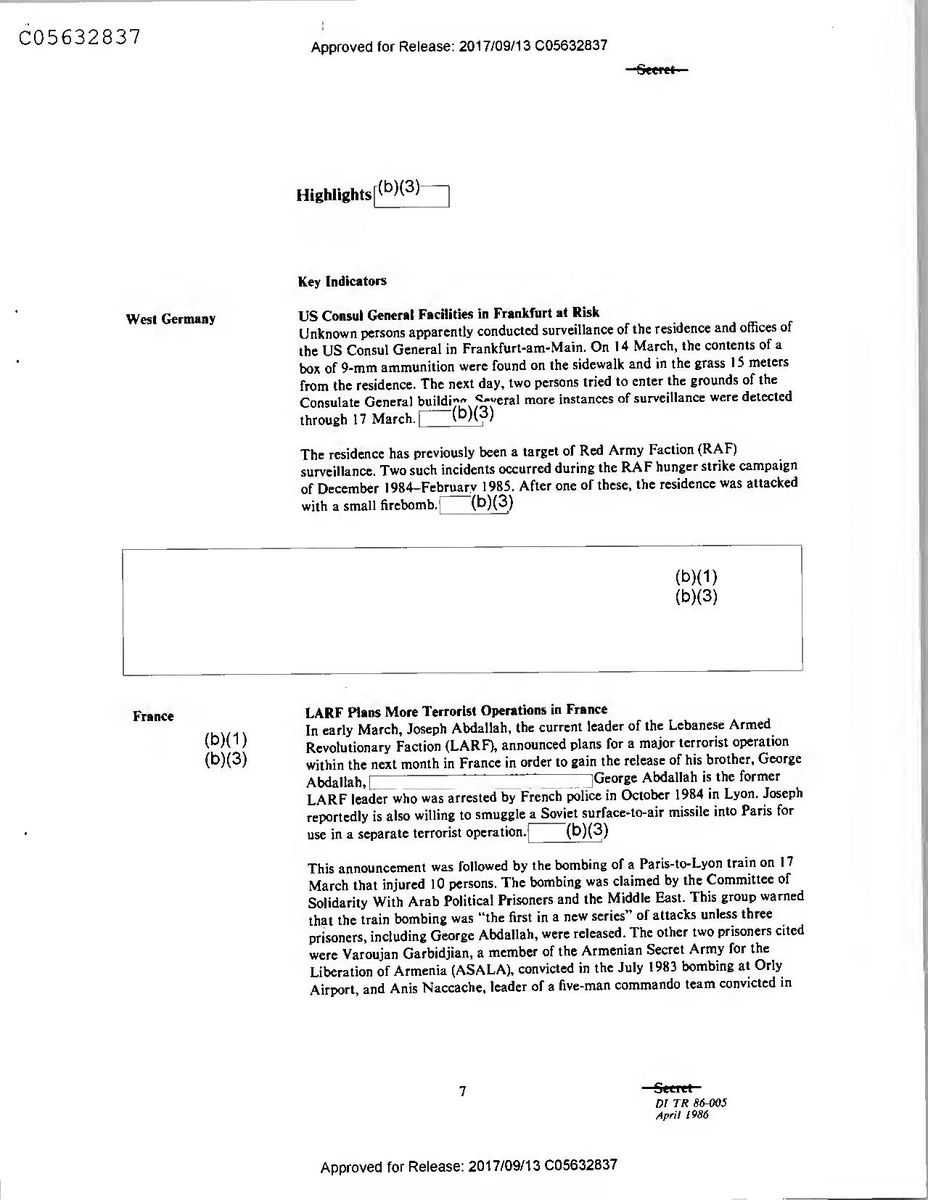
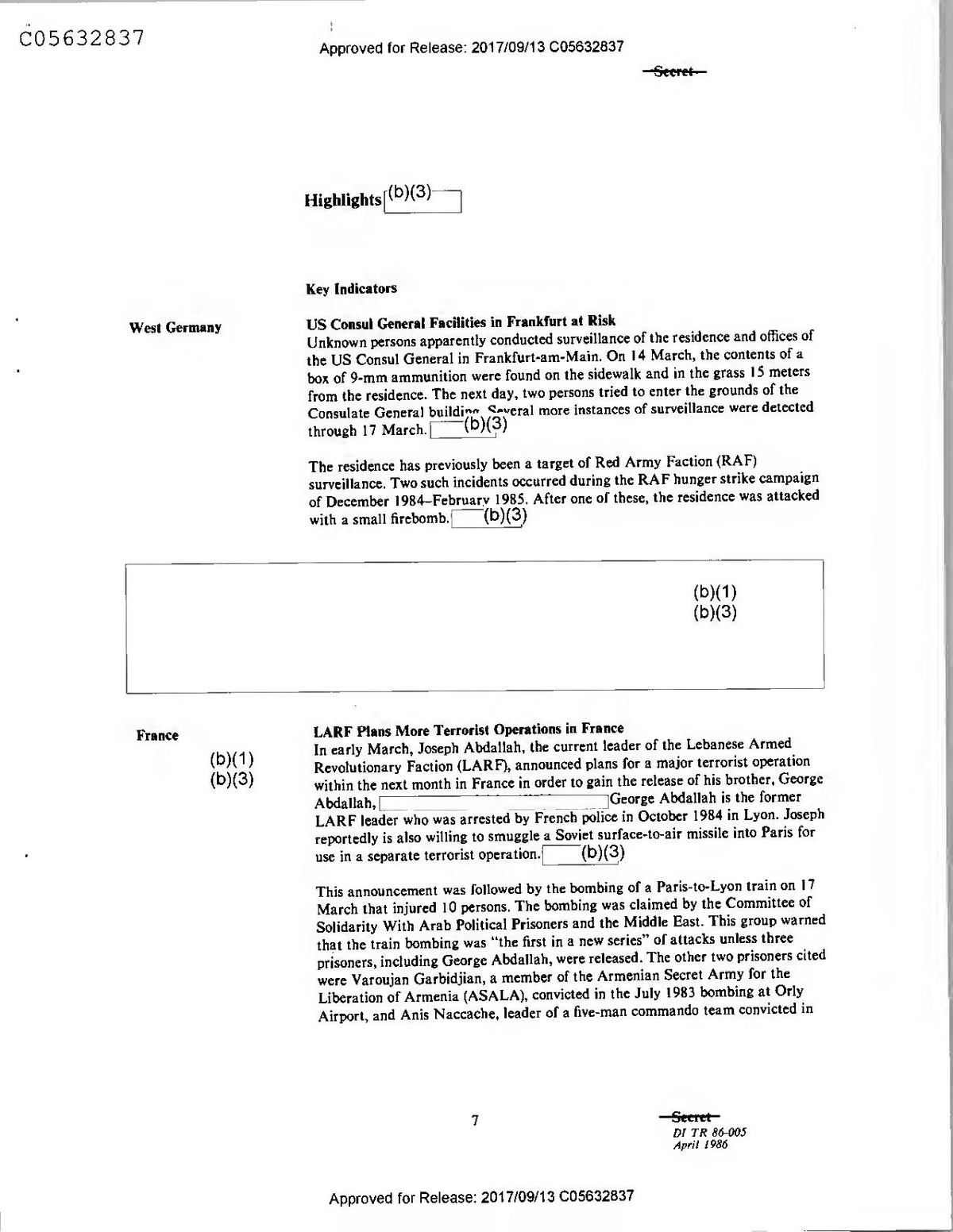
Secret
Highlights/(b)(3)
Key Indicators
West Germany
US ConsUL General Facilities in Frankfurt at Risk Unknown persons apparently conducted surveillance of the residence and offices of the US ConsUL General in Frankfurt-am-Main. On 14 March, the contents of a box of 9-mm ammunition were found on the sidewalk and in the grass 15 meters from the residence. The next day, two persons tried to enter the grounds of the Consulate General buildina Several more instances of surveillance were detected through 17 March. F(b)(3)
The residence has previously been a target of Red Army Faction (RAF) surveillance. Two such incidents occurred during the RAF hunger strike campaign of December 1984-February 1985. After one of these, the residence was attacked with a small firebomb. F(b)(3)
(b)(1) (b)(3)
France
(b)(1) (b)(3)
LARF Plans More Terrorist Operations in France In early March, Joseph Abdallah, the current leader of the Lebanese Armed Revolutionary Faction (LARF), announced plans for a major terrorist operation within the next month in France in order to gain the release of his brother, George Abdallah,
George Abdallah is the former LARF leader who was arrested by French police in October 1984 in Lyon. Joseph reportedly is also willing to smuggle a Soviet surface-to-air missile into Paris for use in a separate terrorist operation. (b)(3)
This announcement was followed by the bombing of a Paris-to-Lyon train on 17 March that injured 10 persons. The bombing was claimed by the Committee of Solidarity With Arab Political Prisoners and the Middle East. This group warned that the train bombing was "the first in a new series" of attacks unless three prisoners, including George Abdallah, were released. The other two prisoners cited were Varoujan Garbidjian, a member of the Armenian Secret Army for the Liberation of Armenia (ASALA), convicted in the July 1983 bombing at Orly Airport, and Anis Naccache, leader of a five-man commando team convicted in
7
Secret DI TR 86-05 April 1986
Approved for Release: 2017/09/13 C05632837
(b)(3)
Chronology of Terrorism—1986/1987
Below are described noteworthy foreign and international events involving terrorists, or the use of terrorist tactics, which have occurred or come to light since our last issue. In some cases, the perpetrators and their motivations may not be known. Events and developments tha(b)(3)already been described elsewhere in this publication are not included.
17 September
Spain: Spanish Interior and Justice Ministers testify about their defiance in 1984 of court orders in a Bilbao police brutality trial. A criminal judge had ordered 90 civil guards to appear for possible identification by a Basque Fatherland and Liberty Organization-Military Wing (ETA-M) member, who alleged he had been tortured. The Ministers argued that the appearance of could expose them to retaliation by ETA-M
(b)(3)ards in open court
18 September
Spain: In Vitoria a bomb explodes at bank, causing minor damage and no injuries; another bomb is safely defused. No group claimed responsibility, but authorities attribute the bomhan Iraultza, because of factors consistent with the
(b)(3) group's activities.
19 September
Spain: Police arrest two suspected Basque Fatherland and Liberty Organization members in San Sebastian; seize small weapons cache. Both men were detained under an antiterrorist law allowing suspects to be held incommunicado for up to 10 days. (b)(3)
22 September
Portugal: American International School in Lisbon roroives bomb threat. A search was conducted with negative results.
(b)(3)
(b)(3)
December
Iraq: Military factory blows up. The Iraqi Mujahedin claimed responsibility.
7 and 15 December
Italy: Two Red Brigades members recaptured in Milan and Forli Province.
Calagero Diana and Giuseppe di Cecco had escaped from a Novara hospital on 22 September. Both had been transferred (b)(3) maximum security prison to the hospital during a hunger strike.
12 December
France: Paris court sentences founder of the Armenian Secret Army for the Liberation of Armenia-Revolutionary Movement (ASALA-RM) to six years imprisonment. Monte Melkonian was convicted on 28 November 1986. In its justification the court placed portio;lar emphasis on Melkonian's leading role in ASALA-RM.
(b)(3)
13 December
Netherlands: Police arrest three members of the Red Revolutionary Front (RRF) The extreme leftist action group, believed to be composed of four to six members in The Hague area, has claimed responsibility for four bombing incidents this year. Police believe these arrests have effectively neutralized the RRF. (b)(3)
29
Secret DI TR 87-003 12 February 1987
Approved for Release: 2017/09/13 C05922883
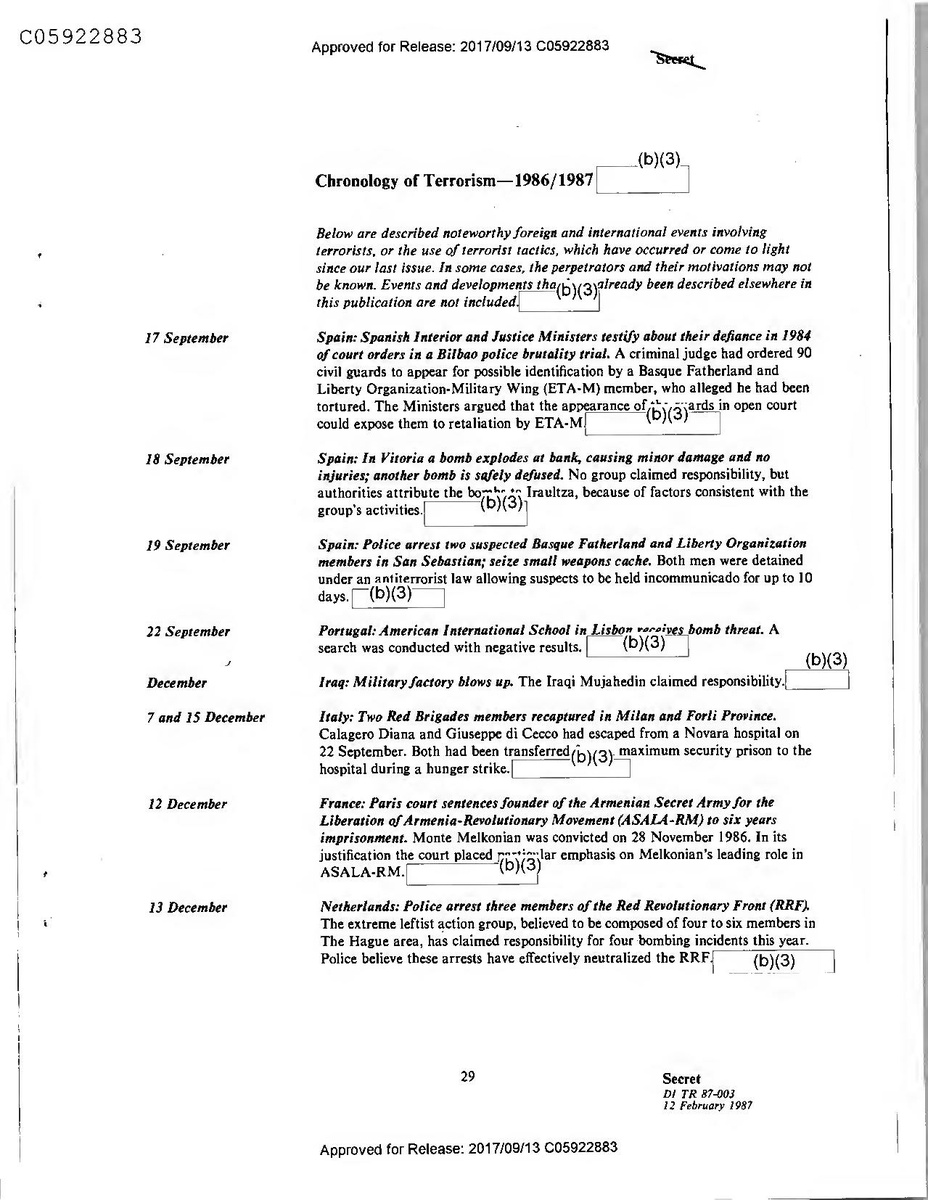
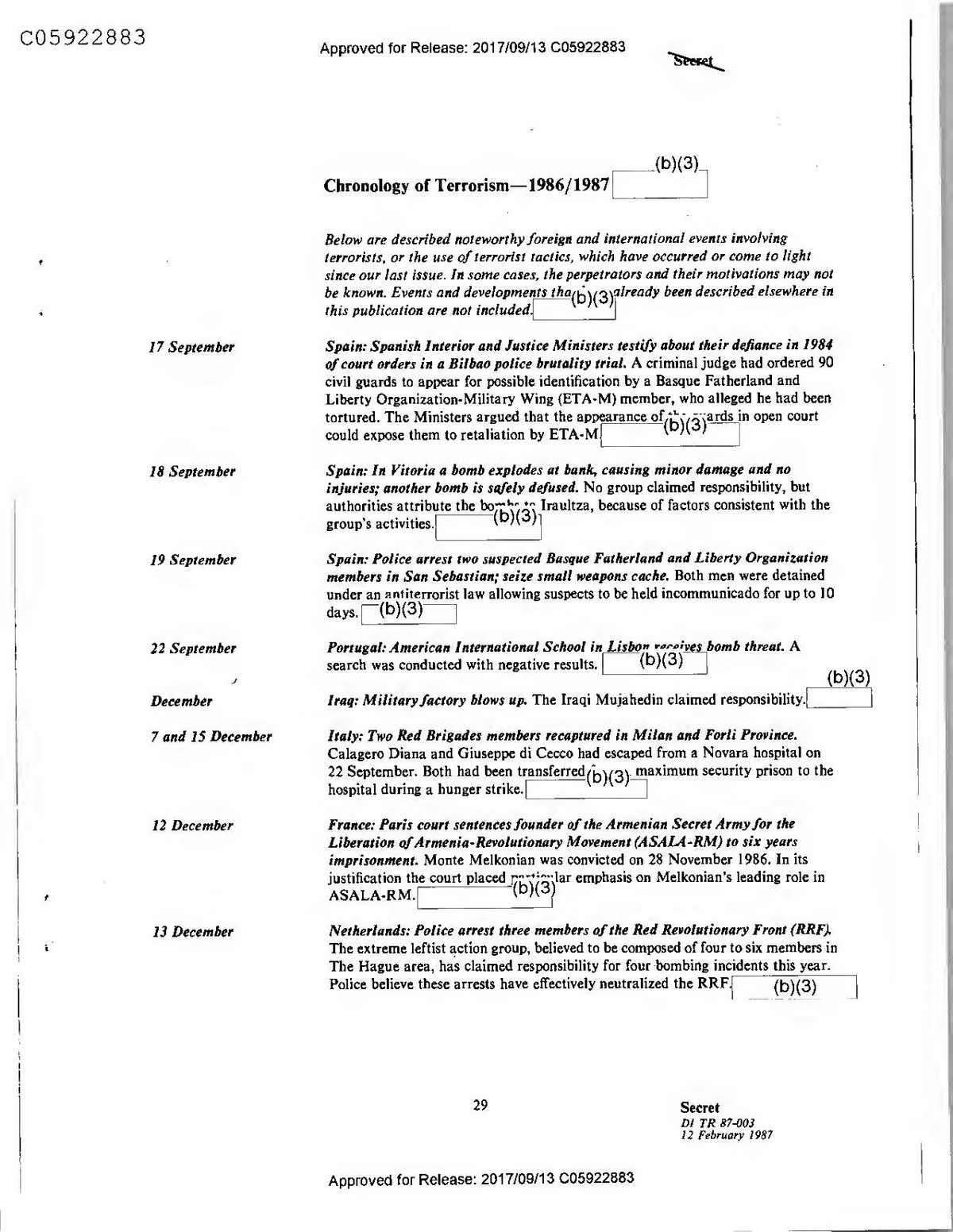
(b)(3)
Chronology of Terrorism—1986/1987
Below are described noteworthy foreign and international events involving terrorists, or the use of terrorist tactics, which have occurred or come to light since our last issue. In some cases, the perpetrators and their motivations may not be known. Events and developments tha(b)(3)already been described elsewhere in this publication are not included.
17 September
Spain: Spanish Interior and Justice Ministers testify about their defiance in 1984 of court orders in a Bilbao police brutality trial. A criminal judge had ordered 90 civil guards to appear for possible identification by a Basque Fatherland and Liberty Organization-Military Wing (ETA-M) member, who alleged he had been tortured. The Ministers argued that the appearance of could expose them to retaliation by ETA-M
(b)(3)ards in open court
18 September
Spain: In Vitoria a bomb explodes at bank, causing minor damage and no injuries; another bomb is safely defused. No group claimed responsibility, but authorities attribute the bomhan Iraultza, because of factors consistent with the
(b)(3) group's activities.
19 September
Spain: Police arrest two suspected Basque Fatherland and Liberty Organization members in San Sebastian; seize small weapons cache. Both men were detained under an antiterrorist law allowing suspects to be held incommunicado for up to 10 days. (b)(3)
22 September
Portugal: American International School in Lisbon roroives bomb threat. A search was conducted with negative results.
(b)(3)
(b)(3)
December
Iraq: Military factory blows up. The Iraqi Mujahedin claimed responsibility.
7 and 15 December
Italy: Two Red Brigades members recaptured in Milan and Forli Province.
Calagero Diana and Giuseppe di Cecco had escaped from a Novara hospital on 22 September. Both had been transferred (b)(3) maximum security prison to the hospital during a hunger strike.
12 December
France: Paris court sentences founder of the Armenian Secret Army for the Liberation of Armenia-Revolutionary Movement (ASALA-RM) to six years imprisonment. Monte Melkonian was convicted on 28 November 1986. In its justification the court placed portio;lar emphasis on Melkonian's leading role in ASALA-RM.
(b)(3)
13 December
Netherlands: Police arrest three members of the Red Revolutionary Front (RRF) The extreme leftist action group, believed to be composed of four to six members in The Hague area, has claimed responsibility for four bombing incidents this year. Police believe these arrests have effectively neutralized the RRF. (b)(3)
29
Secret DI TR 87-003 12 February 1987
Approved for Release: 2017/09/13 C05922883
December
France: Hendaye border police hand over suspected Basque Fatherland and Liberty member to Spanish authorities. Jose-Maria Olabarrieta-Olabarrieta, alias “Toxema," was the 26th Spanish Basque expelled by France since July 1986.
(b)(3)
18 December
Guadeloupe: French police arrest suspected terrorist member in Point-a-Pitre. Jean-Charles Laporal is believed to be a member of Affiche Rouge, a branch of the better known Action Directe terrorist group. He is believed to have committed armed rohheries at various branches of the Bank of Lyon in France in 1981 and
1982.7(b)(3)
21 December
Corsica: Fifteen bombs explode in Bastia, damaging houses, apartments, and automobiles but causing no injuries. Another eight bombs were defused or failed to explode. The New Front for the Liberation of Corsica claimed responsibility
(b)(3) for the blasts.
27 December
Corsica: Nine bomb explosions damage various French-owned targets but cause no injuries. No one claimed responsibilitv hut police suspect the National Front for the Liberation of Corsica, (b)(3)
js were
Iran: Blast destroys weapons depot. Over 500 Iranian Revolutionary(6)(3)'s reported killed. No group has claimed responsibility
January
Jordan: Authorities arrest 11 members of the Popular Front for the Liberation of Palestine (PFLP). Among them was the most senior PFLP member operating in Jordan. Some of the group were charged with “security offenses." (b)(3)
Kuwait: Police arrest 11 suspected in oilfield fires of 19 January. The suspects were in posse(b)(3jf arms and explosives. Five Kuwaiti citizens are still being sought.
Guadeloupe: Radical independence group member receives five-year prison sentence for 1983 police station bombing in Basse-Terre. Leila Cassubie turned herself in to French authorities in October. She is the first fugitive to take
(b)(3) advantage of an amnesty program for Guadeloupean terrorists.
Early January
Turkey: Police arrest five suspected members of a separatist group in Malatya.
Officials believe the five were engaged in (b)(3)iting an illegal organization. They were writing to potential members.
(b)(3)
1 January
Israel: Small bomb explodes at bus stop in Kefar Sava. There were no injuries.
West Bank: Explos prge discovered in Nablus. Police detonated the bomb
(b)(3)" without incident
2 January
Spain: Two bombs explode at Navacerrada ski resort hotel, causing extensive damage but no injuries. Shortly before the blasts, a caller warned of the bombs, claiming responsibility in the name of the Basque Fatherland and Liberty organization
(b)(3).
Secret
30
Approved for Release: 2017/09/13 C05922883
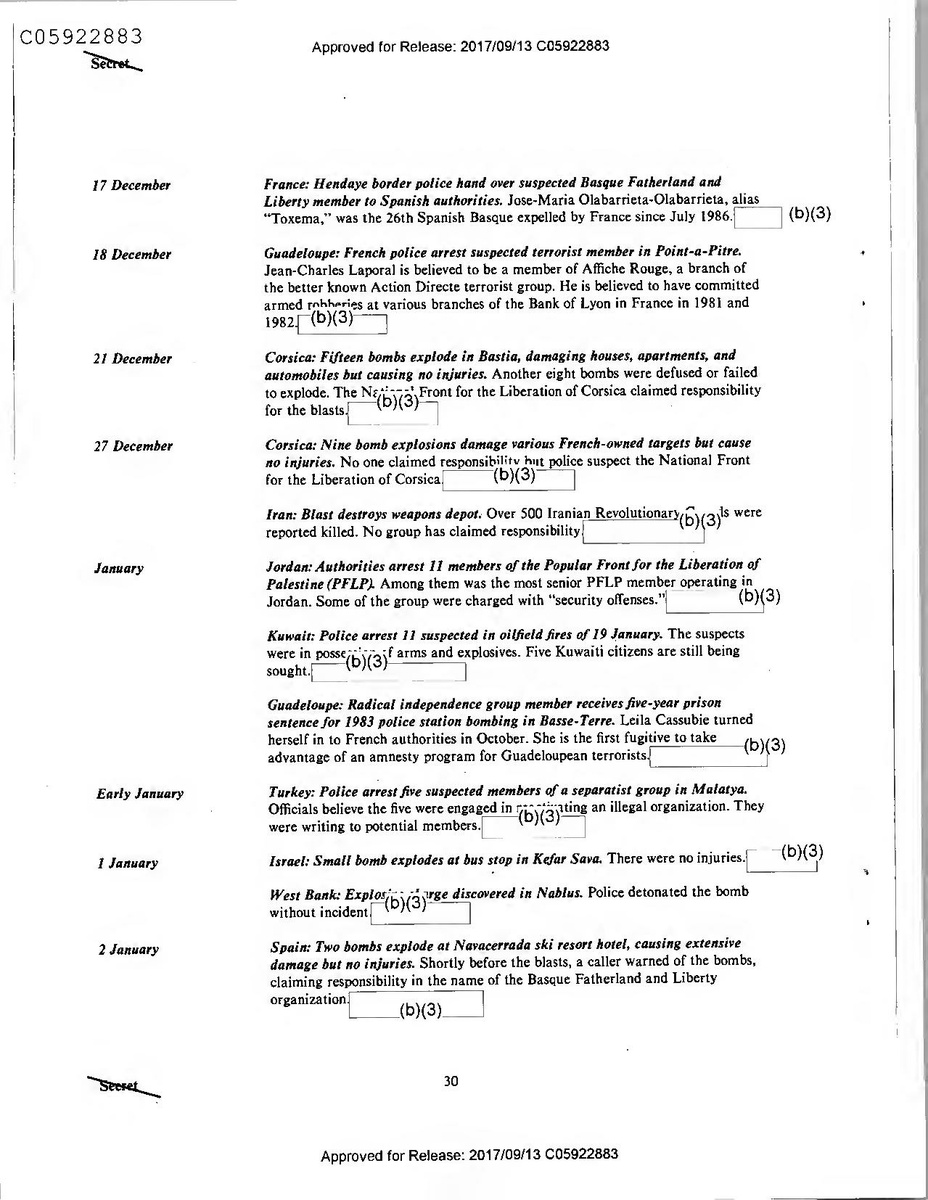
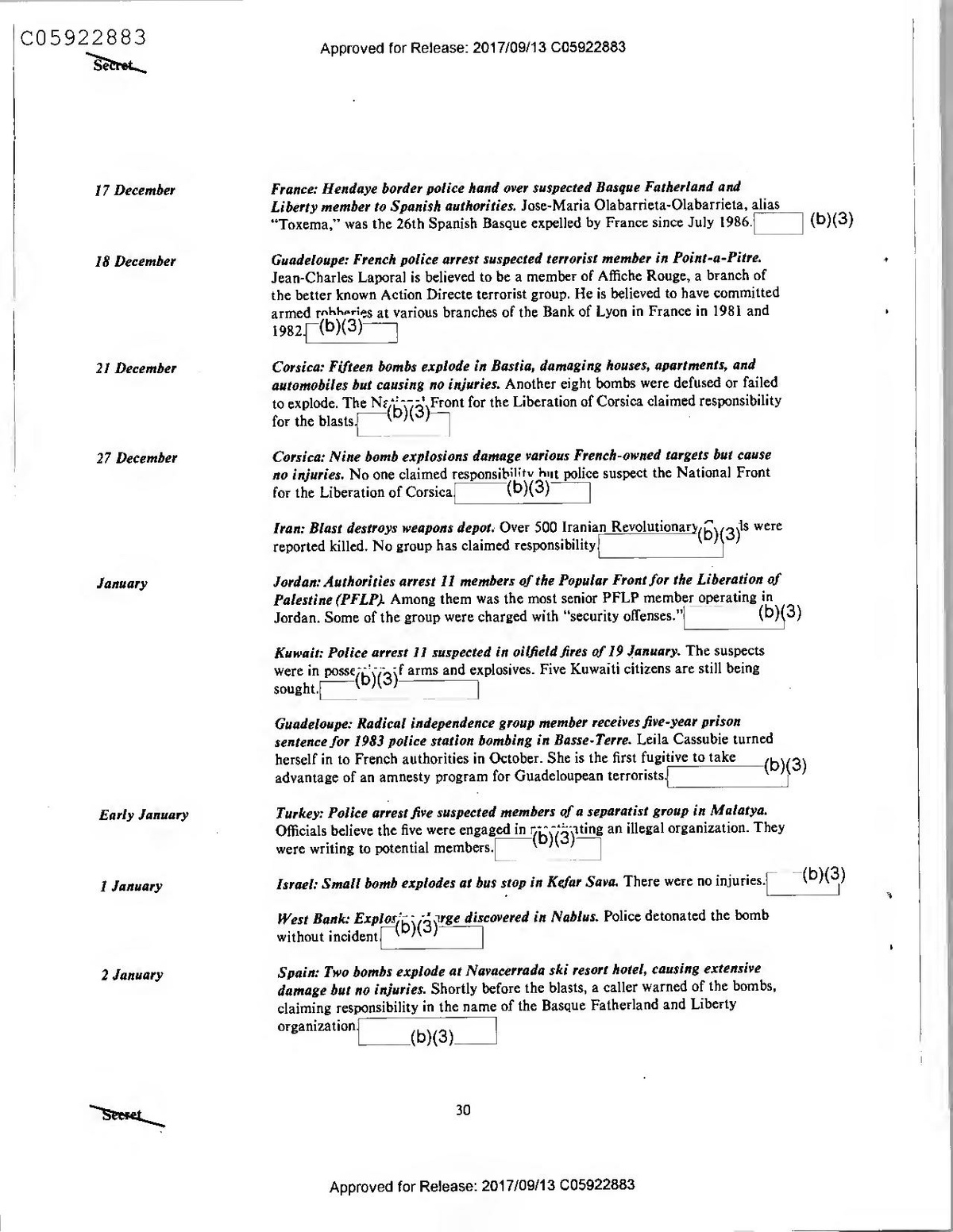
December
France: Hendaye border police hand over suspected Basque Fatherland and Liberty member to Spanish authorities. Jose-Maria Olabarrieta-Olabarrieta, alias “Toxema," was the 26th Spanish Basque expelled by France since July 1986.
(b)(3)
18 December
Guadeloupe: French police arrest suspected terrorist member in Point-a-Pitre. Jean-Charles Laporal is believed to be a member of Affiche Rouge, a branch of the better known Action Directe terrorist group. He is believed to have committed armed rohheries at various branches of the Bank of Lyon in France in 1981 and
1982.7(b)(3)
21 December
Corsica: Fifteen bombs explode in Bastia, damaging houses, apartments, and automobiles but causing no injuries. Another eight bombs were defused or failed to explode. The New Front for the Liberation of Corsica claimed responsibility
(b)(3) for the blasts.
27 December
Corsica: Nine bomb explosions damage various French-owned targets but cause no injuries. No one claimed responsibilitv hut police suspect the National Front for the Liberation of Corsica, (b)(3)
js were
Iran: Blast destroys weapons depot. Over 500 Iranian Revolutionary(6)(3)'s reported killed. No group has claimed responsibility
January
Jordan: Authorities arrest 11 members of the Popular Front for the Liberation of Palestine (PFLP). Among them was the most senior PFLP member operating in Jordan. Some of the group were charged with “security offenses." (b)(3)
Kuwait: Police arrest 11 suspected in oilfield fires of 19 January. The suspects were in posse(b)(3jf arms and explosives. Five Kuwaiti citizens are still being sought.
Guadeloupe: Radical independence group member receives five-year prison sentence for 1983 police station bombing in Basse-Terre. Leila Cassubie turned herself in to French authorities in October. She is the first fugitive to take
(b)(3) advantage of an amnesty program for Guadeloupean terrorists.
Early January
Turkey: Police arrest five suspected members of a separatist group in Malatya.
Officials believe the five were engaged in (b)(3)iting an illegal organization. They were writing to potential members.
(b)(3)
1 January
Israel: Small bomb explodes at bus stop in Kefar Sava. There were no injuries.
West Bank: Explos prge discovered in Nablus. Police detonated the bomb
(b)(3)" without incident
2 January
Spain: Two bombs explode at Navacerrada ski resort hotel, causing extensive damage but no injuries. Shortly before the blasts, a caller warned of the bombs, claiming responsibility in the name of the Basque Fatherland and Liberty organization
(b)(3).
Secret
30
Approved for Release: 2017/09/13 C05922883
Spain: Suspected Basque Fatherland and Liberty organization guerrillas burn French Peugeot car showroom in Mondragon. Police reported the blaze may have been caused by a bomb. There was no claim for the attack |
(b)(3)
4 January
France: Smoke grenade detonates under US Embassy vehicle near residential compound at Boulonge(b)(3) were no injuries or damage. No group claimed responsibility
5 January
West Bank: Molotov cocktail smashes wirinoid of an Israeli bus near Ramallah. No one was hurt.
"(b)(3)
6 January
Israel: Katyusha rockets cause slight damage in Galilee. The rockets were fired from Lebanon
West Bank: Molotov cocktail thrown at man guarding parking (b)(3;sraeli bus
company. The firebomb ignited but caused no damage
7 January
Spain: Small bomb explodes at French car dealership in Bilbao, causing minor damage to cars in showroom. There was no claim for the attack, but police believe the Basque Fatherland and Liberty organization was responsible.
(b)(3)
West Bank: Molotov cocktail thrown at Isrnoli bus in Nablus. No injuries or damages were reported.
(b)(3)
8 January
Israel: Bomb dest(b)(3)
jar in Kiryat Malachi, south of Tel Aviv. There were no
casualties.
10 January
Gaza Strip: Molotov (b)(3) thrown at Israeli car. The car was destroyed but no one was hurt.
10 January
West Bank: Arab mayor of Bethle (b)(3)
jeives threats. He was warned against
continuing ties to Jordan.
10-11 January
Netherlands: Arson attack against Amsterdam supermarket causes extensive damage but no injuries. The previously unknown “Revolutionary Action Group" (RARA) claimed responsibility
(b)(3) Racist
11 January
Lebanon: Two Nepalese UNIFIL soldiers are shot and wounded in southern Lebanon. The incident occurred when several Shi'ites tried to force their way through a UNIFIL position.
(b)(3)
12 January
Gaza Strip: Molotov cocktails thi(b)(3) Israeli cars in Gaza and Rafah. The firebombs failed to ignite.
Lebanon: Bomb explosion in West Beirut government building damages Ministry of Tourism offices and Beirut Radio. There has been no claim of responsibility.(b)(3)]
(b)(3)
31
Secret
Approved for Release: 2017/09/13 C05922883
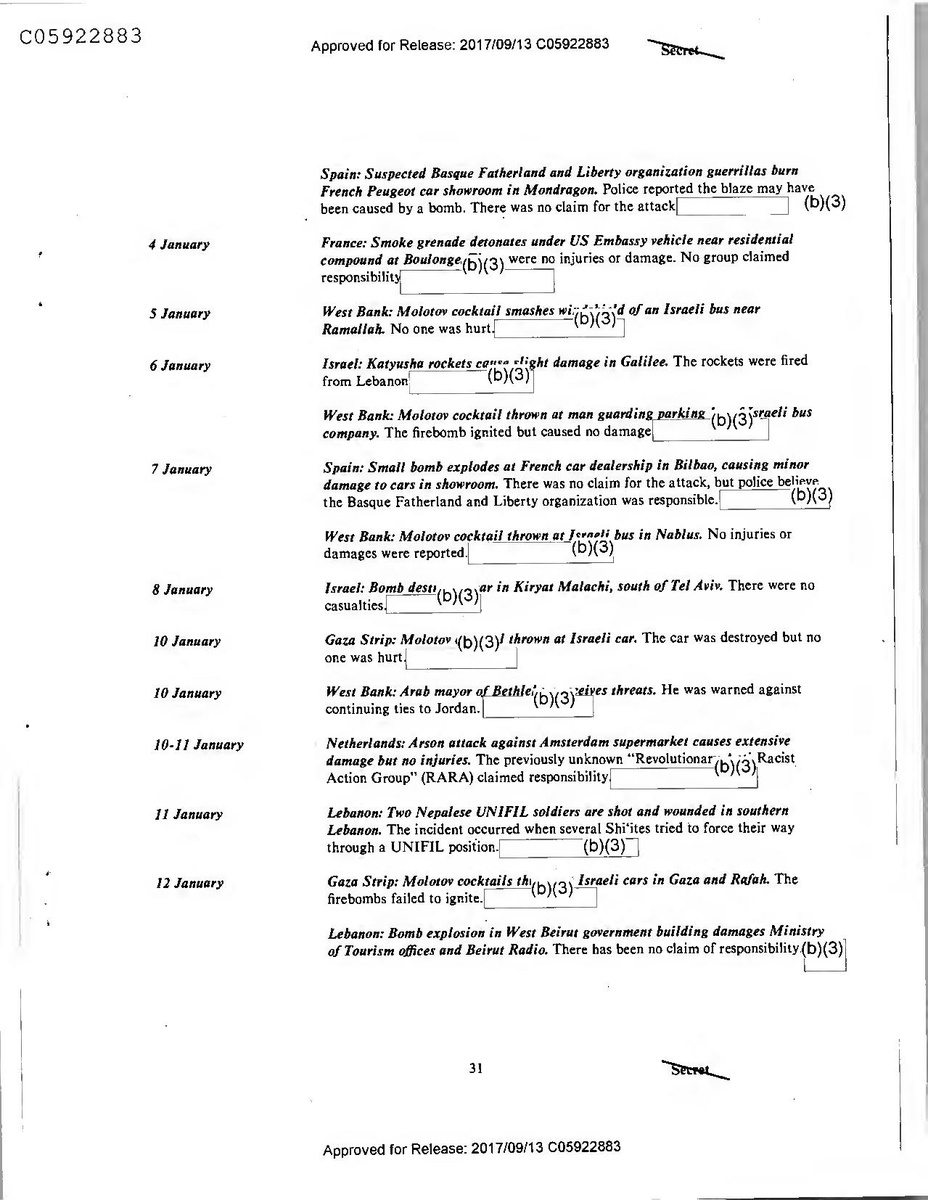
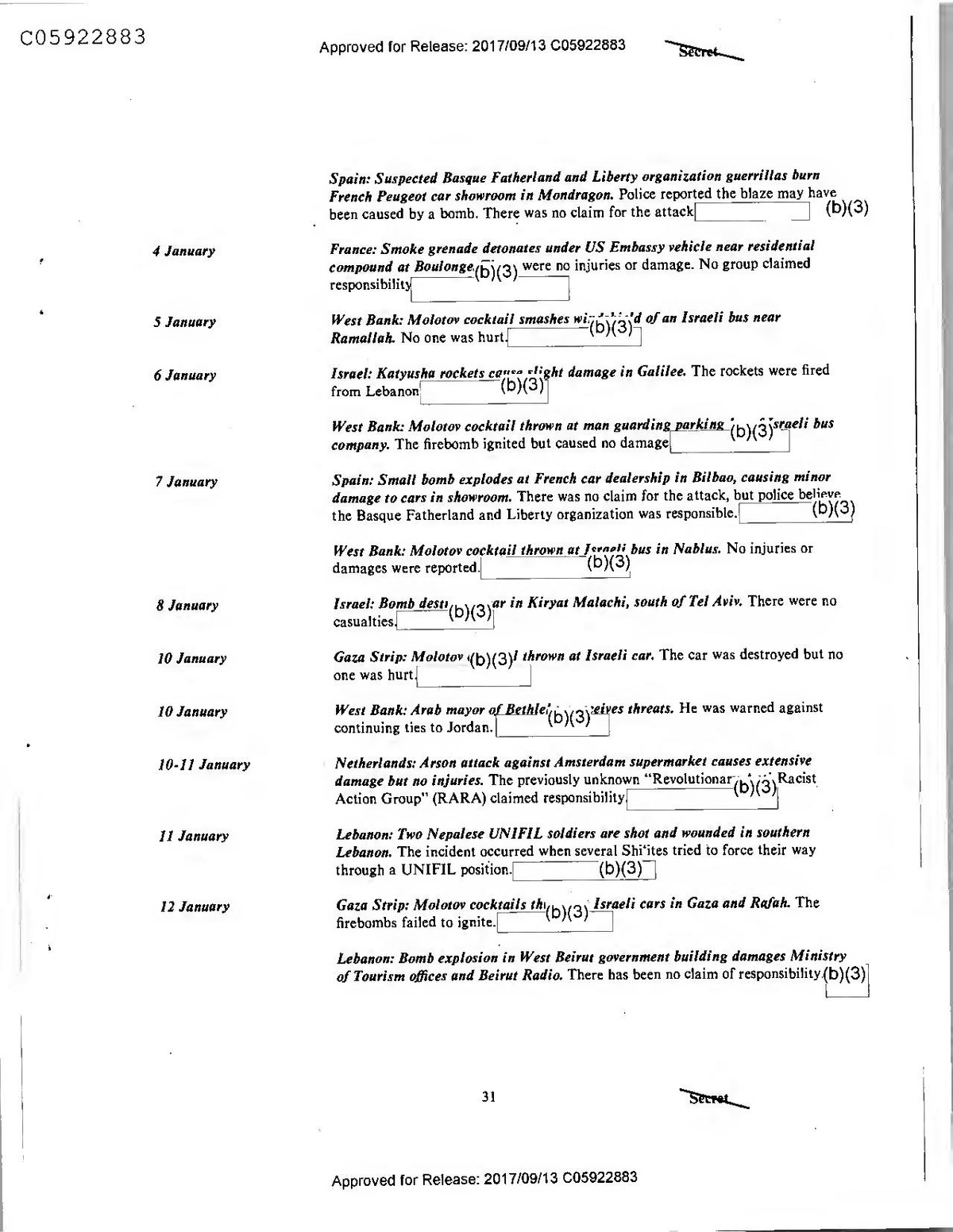
Spain: Suspected Basque Fatherland and Liberty organization guerrillas burn French Peugeot car showroom in Mondragon. Police reported the blaze may have been caused by a bomb. There was no claim for the attack |
(b)(3)
4 January
France: Smoke grenade detonates under US Embassy vehicle near residential compound at Boulonge(b)(3) were no injuries or damage. No group claimed responsibility
5 January
West Bank: Molotov cocktail smashes wirinoid of an Israeli bus near Ramallah. No one was hurt.
"(b)(3)
6 January
Israel: Katyusha rockets cause slight damage in Galilee. The rockets were fired from Lebanon
West Bank: Molotov cocktail thrown at man guarding parking (b)(3;sraeli bus
company. The firebomb ignited but caused no damage
7 January
Spain: Small bomb explodes at French car dealership in Bilbao, causing minor damage to cars in showroom. There was no claim for the attack, but police believe the Basque Fatherland and Liberty organization was responsible.
(b)(3)
West Bank: Molotov cocktail thrown at Isrnoli bus in Nablus. No injuries or damages were reported.
(b)(3)
8 January
Israel: Bomb dest(b)(3)
jar in Kiryat Malachi, south of Tel Aviv. There were no
casualties.
10 January
Gaza Strip: Molotov (b)(3) thrown at Israeli car. The car was destroyed but no one was hurt.
10 January
West Bank: Arab mayor of Bethle (b)(3)
jeives threats. He was warned against
continuing ties to Jordan.
10-11 January
Netherlands: Arson attack against Amsterdam supermarket causes extensive damage but no injuries. The previously unknown “Revolutionary Action Group" (RARA) claimed responsibility
(b)(3) Racist
11 January
Lebanon: Two Nepalese UNIFIL soldiers are shot and wounded in southern Lebanon. The incident occurred when several Shi'ites tried to force their way through a UNIFIL position.
(b)(3)
12 January
Gaza Strip: Molotov cocktails thi(b)(3) Israeli cars in Gaza and Rafah. The firebombs failed to ignite.
Lebanon: Bomb explosion in West Beirut government building damages Ministry of Tourism offices and Beirut Radio. There has been no claim of responsibility.(b)(3)]
(b)(3)
31
Secret
Approved for Release: 2017/09/13 C05922883
January
Lebanon: Israeli aircraft attack Palestinian targets in southern Lebanon. The
ar
'gests been warning Damascus as well
proximity of the facilities to Syrian-controlled af(b)(3):gests that Israel may have
14 January
.
Lebanon: Three bombs explode at gate of Ghazzah Hospital in West Beirut, killing four Amal members and injuring three others. The “Forces of the Free Men of Beirut," a previously unknown group, has claimed responsibility.
(b)(3)
West Bank: Firebombs damage an Israeli bus near refugee camp. There were no casualties.
(b)(3)
Mid-January
Turkey: Adana military court sentences righrist militants. Two members of the Ulkucu Youth Association (UGD) were sentenced to death for killing 22 persons in Adana in September 1980. The court also sentenced two other members of the group to life imp}(b)(3):nt, while 11 others received prison terms ranging from two to 36 years
Turkey: Three Dev Yol (Revolutionary Way) members sentenced to death by Adana
Which had been reversed by the military high appeals court.
military court. The court upheld its earlier dec(b)(3)hi
Turkey: Eight persons arrested for the sabotage of an ammunition factory last summer. The Turkis(b)(3)munist Party Union (TKP-B) took credit for the incident
15 January
West Bank: Men th (b)(3)stones attack Israeli vehicles and an IDF post. There were no injuries
16 January
Turkey: Separatists attack a village in Mardin, wounding)(b)(3)ions. The militants clashed with village guards and then fled.
West Germany: Former pilot for Iranian Majlis Speaker Rafsanjani assassinated. The victim had defected to Iraq in the summer of 1986. His assailants escaped, but they are almost certainly Iranian Government agents.
(b)(3)
Lebanon: Boobytrapped car explodes in Al-Hadath, injuring a child. The car had been rigged with an explosive charg; weighing 500 kilograms. No group has claimed responsibility
(b)(3)
17 January
Gaza Strip: Molotov cocktail thrown at Isy(b)(3)".
The firebomb exploded on the road and caused no damage.
Israel: Israeli brothers stabbed in Jerusalem. One youth wa(b)(3)ısly wounded. The PLO and Abu Nidal both claimed responsibility.
Israel: Youths attack Arab boy in Jewish neighborhood of Jerusalém. The boy required medical treatment. This attack was probably retaliation for stabbing of Jewish youths on the same day. (b)(3)
32
Secret
Approved for Release: 2017/09/13 C05922883
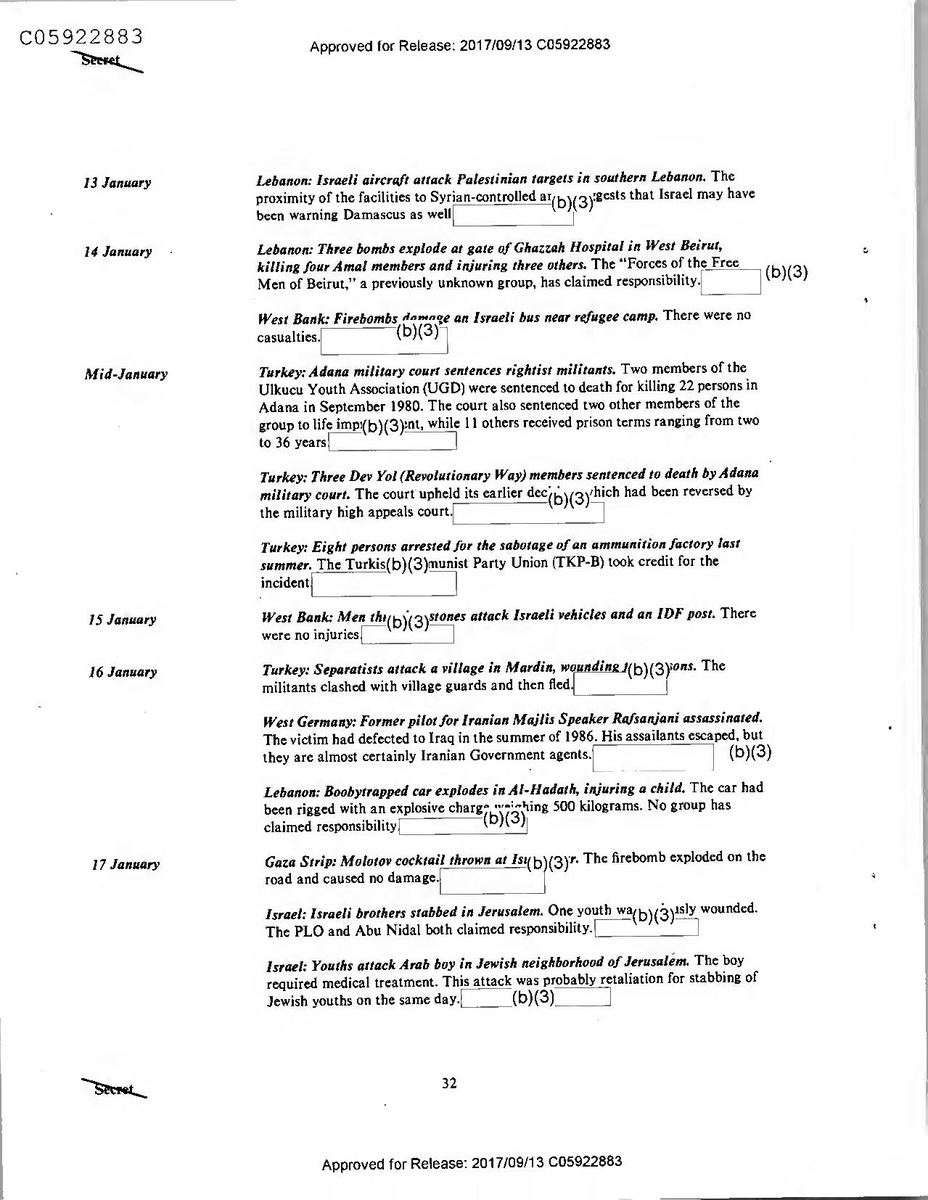
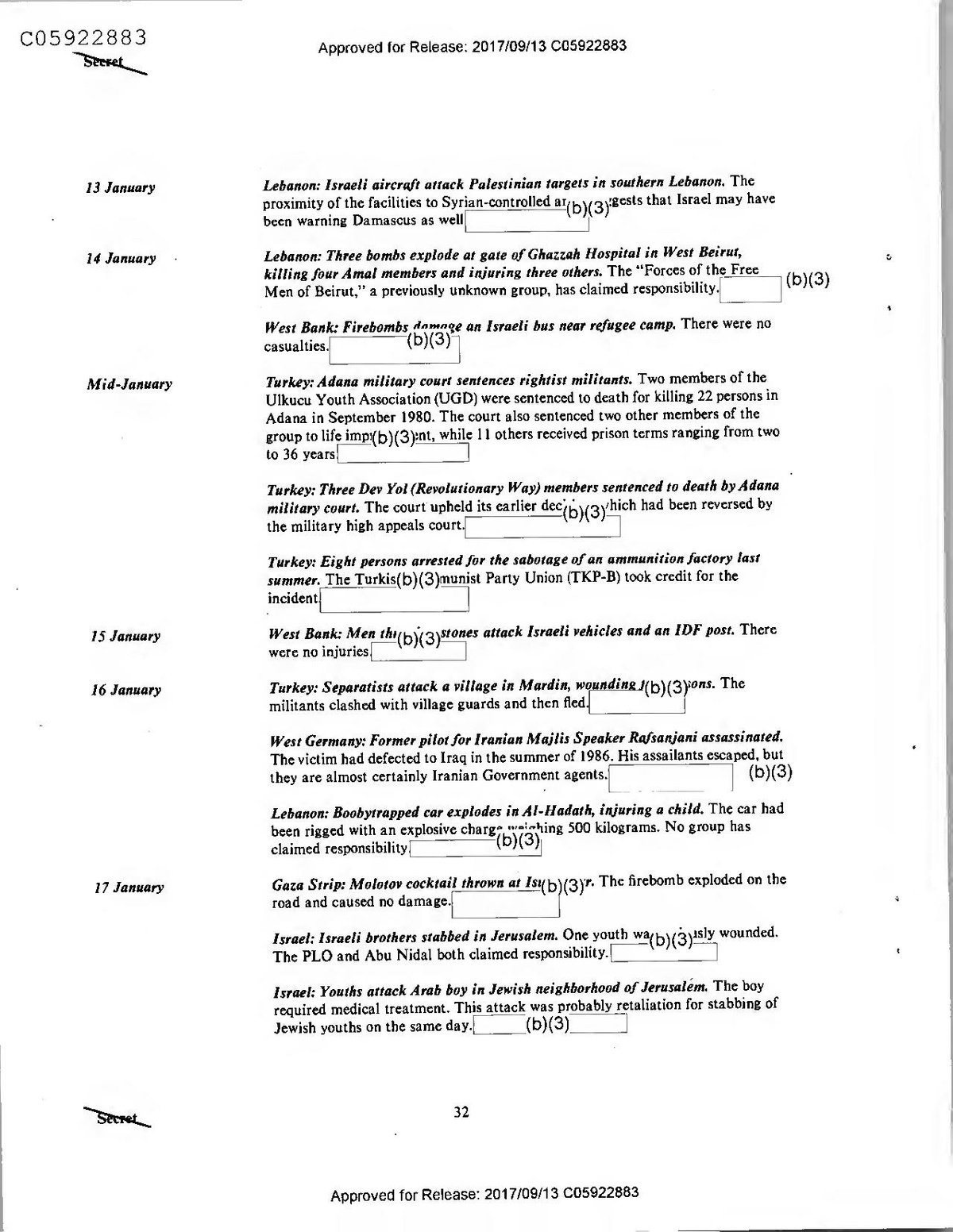
January
Lebanon: Israeli aircraft attack Palestinian targets in southern Lebanon. The
ar
'gests been warning Damascus as well
proximity of the facilities to Syrian-controlled af(b)(3):gests that Israel may have
14 January
.
Lebanon: Three bombs explode at gate of Ghazzah Hospital in West Beirut, killing four Amal members and injuring three others. The “Forces of the Free Men of Beirut," a previously unknown group, has claimed responsibility.
(b)(3)
West Bank: Firebombs damage an Israeli bus near refugee camp. There were no casualties.
(b)(3)
Mid-January
Turkey: Adana military court sentences righrist militants. Two members of the Ulkucu Youth Association (UGD) were sentenced to death for killing 22 persons in Adana in September 1980. The court also sentenced two other members of the group to life imp}(b)(3):nt, while 11 others received prison terms ranging from two to 36 years
Turkey: Three Dev Yol (Revolutionary Way) members sentenced to death by Adana
Which had been reversed by the military high appeals court.
military court. The court upheld its earlier dec(b)(3)hi
Turkey: Eight persons arrested for the sabotage of an ammunition factory last summer. The Turkis(b)(3)munist Party Union (TKP-B) took credit for the incident
15 January
West Bank: Men th (b)(3)stones attack Israeli vehicles and an IDF post. There were no injuries
16 January
Turkey: Separatists attack a village in Mardin, wounding)(b)(3)ions. The militants clashed with village guards and then fled.
West Germany: Former pilot for Iranian Majlis Speaker Rafsanjani assassinated. The victim had defected to Iraq in the summer of 1986. His assailants escaped, but they are almost certainly Iranian Government agents.
(b)(3)
Lebanon: Boobytrapped car explodes in Al-Hadath, injuring a child. The car had been rigged with an explosive charg; weighing 500 kilograms. No group has claimed responsibility
(b)(3)
17 January
Gaza Strip: Molotov cocktail thrown at Isy(b)(3)".
The firebomb exploded on the road and caused no damage.
Israel: Israeli brothers stabbed in Jerusalem. One youth wa(b)(3)ısly wounded. The PLO and Abu Nidal both claimed responsibility.
Israel: Youths attack Arab boy in Jewish neighborhood of Jerusalém. The boy required medical treatment. This attack was probably retaliation for stabbing of Jewish youths on the same day. (b)(3)
32
Secret
Approved for Release: 2017/09/13 C05922883
January
Lebanon: Hizballah car bomb, intended for use against Iraqi Embassy or American Ambassador, detonates prematurely while being rigged in garage. The explosion, which occurred in the town of Brital in the Bekaa Valley, destroyed the car and the garage and injured four Hizballah members
(b)(3)
20 January
Turkey: Diyarbakir martial law court sentences four Kurdish Workers Party (PKK) members to life imprisonment. Seven of the remaining defendants were sentenced to jail terms ranging from 10 to 20 years, while seven others were acquitted
(b)(3)
Gaza Strip: Molotov cocktails thrown at Israeli car. The mbi missed the target. Several suspects were detained for questioning
(b)(3)
Chile: Authorities announce that a doctor and a nurse have been arrested in connection with an attempt on the life of President Augusto Pinochet last
are Front
21 January
Belgium: Suspected terrorist released after year in custody on charges of criminal conspiracy. Luc van Acker was arrested in January 1986 during a police raid on a
Communist Combatant Cells safehouse in Brussels. At the time of his
arrest
, h(b)(3)
was linked to another group, the Revolutionary Front for Proletarian Action.
21 and 24 January
Kuwait: Missiles launched at Kuwaiti island. Authorities reportedly believe they were Iranian-directed and intended to disrupt the Islamic Conference summit meetings in Kuwait.
(b)(3)
22 January
Italy: Three suspected Red Brigades members captured after Rome shootout. Two of the terrorists were injured and a fourth suspect escaped. A passerby was also wounded. Paolo Cassetta, the best krmne the three, had been sought by the police for over a year.
(b)(3)
Turkey: Eight villagers killed by guerri,
"(b)(3) Uludere attack. The Kurdish Workers Party is suspected.
Iraq: Unconfirmed rumors report Saddam Husayn injured in assassinatin
-(b)(3) attempt. Some circumstantial evidence supports the report.
Colombia: Norwegian police said that Colombia's Ambassador to Norway, Nazly Lozano Eljure, has been placed under heavy police guard at her request, after the shooting of Colombia's Ambassador in Budapest in early January. In the past, Lozano has strongly supported a strong stance against drug traffickers and was posted at the Oslo Embassy in September 1986 to ensure her safety (b)(3)
33
Secret
Approved for Release: 2017/09/13 C05922883
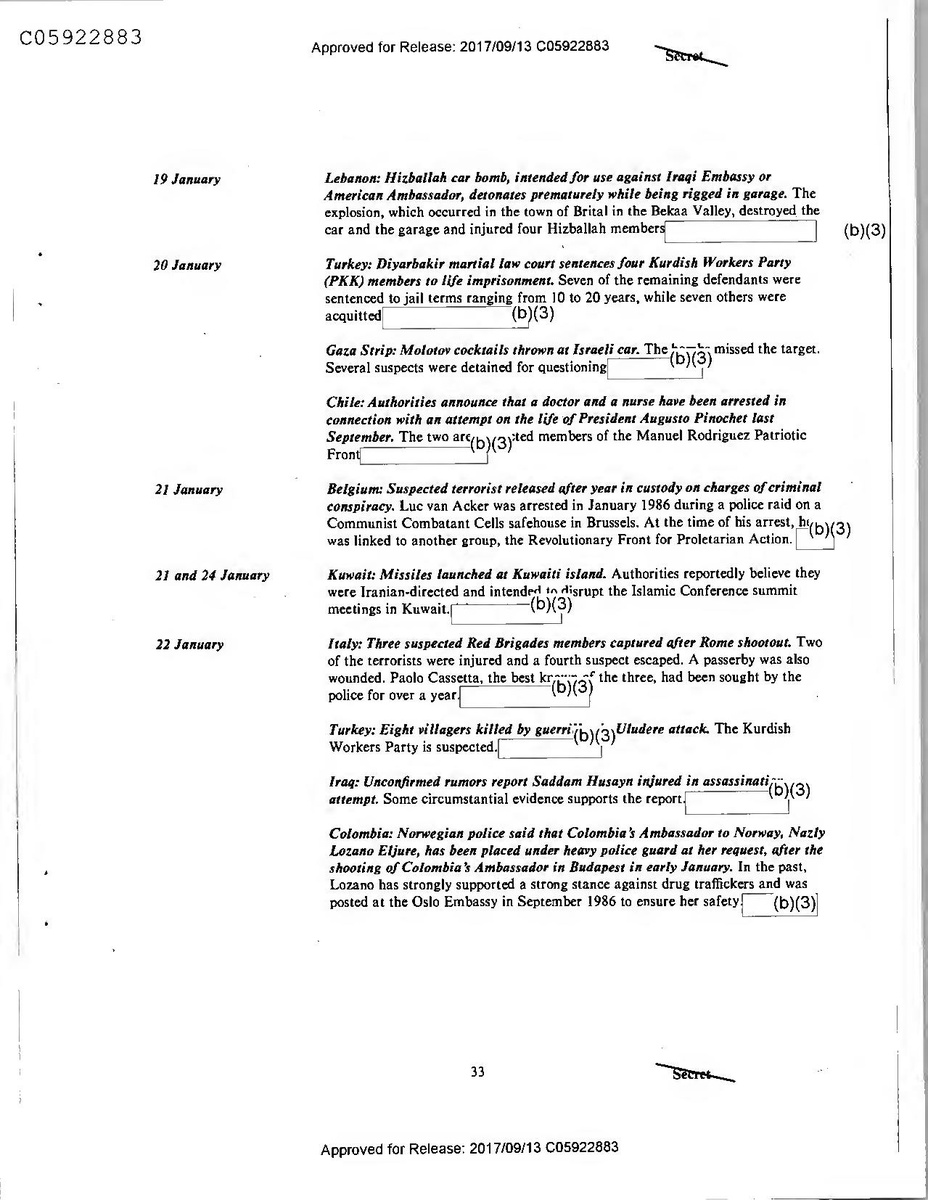
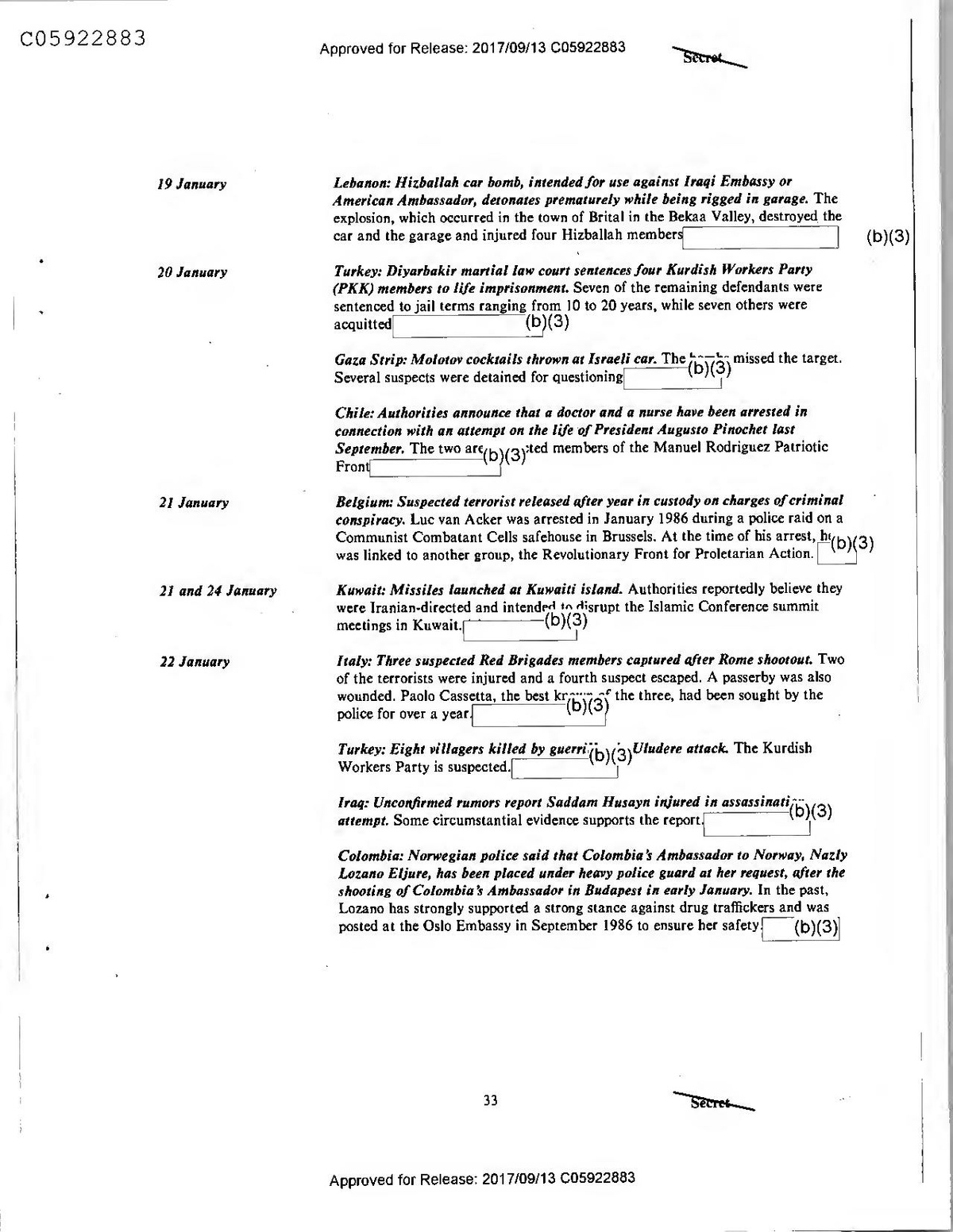
January
Lebanon: Hizballah car bomb, intended for use against Iraqi Embassy or American Ambassador, detonates prematurely while being rigged in garage. The explosion, which occurred in the town of Brital in the Bekaa Valley, destroyed the car and the garage and injured four Hizballah members
(b)(3)
20 January
Turkey: Diyarbakir martial law court sentences four Kurdish Workers Party (PKK) members to life imprisonment. Seven of the remaining defendants were sentenced to jail terms ranging from 10 to 20 years, while seven others were acquitted
(b)(3)
Gaza Strip: Molotov cocktails thrown at Israeli car. The mbi missed the target. Several suspects were detained for questioning
(b)(3)
Chile: Authorities announce that a doctor and a nurse have been arrested in connection with an attempt on the life of President Augusto Pinochet last
are Front
21 January
Belgium: Suspected terrorist released after year in custody on charges of criminal conspiracy. Luc van Acker was arrested in January 1986 during a police raid on a
Communist Combatant Cells safehouse in Brussels. At the time of his
arrest
, h(b)(3)
was linked to another group, the Revolutionary Front for Proletarian Action.
21 and 24 January
Kuwait: Missiles launched at Kuwaiti island. Authorities reportedly believe they were Iranian-directed and intended to disrupt the Islamic Conference summit meetings in Kuwait.
(b)(3)
22 January
Italy: Three suspected Red Brigades members captured after Rome shootout. Two of the terrorists were injured and a fourth suspect escaped. A passerby was also wounded. Paolo Cassetta, the best krmne the three, had been sought by the police for over a year.
(b)(3)
Turkey: Eight villagers killed by guerri,
"(b)(3) Uludere attack. The Kurdish Workers Party is suspected.
Iraq: Unconfirmed rumors report Saddam Husayn injured in assassinatin
-(b)(3) attempt. Some circumstantial evidence supports the report.
Colombia: Norwegian police said that Colombia's Ambassador to Norway, Nazly Lozano Eljure, has been placed under heavy police guard at her request, after the shooting of Colombia's Ambassador in Budapest in early January. In the past, Lozano has strongly supported a strong stance against drug traffickers and was posted at the Oslo Embassy in September 1986 to ensure her safety (b)(3)
33
Secret
Approved for Release: 2017/09/13 C05922883
January
France: In Bastia, Corsica, a bomb explodes outside the apartment of the French Interior Minister's niece, hours after he dissolved the Corsican Movement for Self-Defense (MCA) at a Cabinet meeting. No one was injured in the blast. The French Interior Minister, also a Corsican, has renewed a crackdown on the group, which is considered a front for the outlawed Corsican National Liberation Front.
(b)(3)
West Bank: Explosive charge discovered at Sha'arei Hatikva settlement. The bomb was safely dismantled.
(b)(3)
24 January
Turkey: Suspected Kurdish Workers Party separatists attack two houses near Midyat with firearms and handgrenades, killing 10 villagers and injuring six others. All were members of two families. Six of the dead were children.L (b)(3)
Kuwait: Bomb explodes near hotel in Salhia District. The bomb, which was
placed under a car, caused no casualties. The "Revolutionary (b)(3)zation Forces of the Prophet Mohammad" claimed responsibility
25 January
France: Three bombs found in Basque country police stations. One device exploded in Espelette, causing no damage or injuries. The other two unexploded devices were found nearby, in Ustaritz and Bayonne. No group claimed responsibility for the bombs, although Iparretarak is suspected.
$(b)(3)7
Peru: Fifteen bombs explode in town of Huancayo, east of Lima, causing blackouts and serious damage. The targets included stores, banks, and homes of local govern
IF(b)(3}fficials. Sendero Luminoso terrorists probably are responsible.
26 January
Lebanon: Bomb explodes at Channel 7 television station in West Beirut, causing a number of casualties and material damage. The Lebanese Liberation
(b)(3)anization has claimed responsibility for the explosion of the 6-kilogram bomb.
Peru: Sendero Luminoso terrorists attack Indian Embassy in Lima, killing three police officers. The eight-man group approached the Embassy in daylight, both by vehicle and disguised as street vendors. The attack probably was intended to protest President Garcia's recent official trip to India.
(b)(3)
Peru: Sendero Luminoso terrorists simultaneously take over the Cuban Prensa Latina and Britain's Reuter news agency offices in Lima. The terrorists issued statements denouncing President Garcia's trip to India and his efforts to assume third world leadership. No injuries were reported.
(b)(3)
27 January
Spain: Parcel bomb explodes in Pamplona store, killing the owner and injuring seven others. The blast destroyed the store and damaged adjacent apartments and nearby cars. No one claimed responsibility.
(b)(3).
Secret
34
Approved for Release: 2017/09/13 C05922883
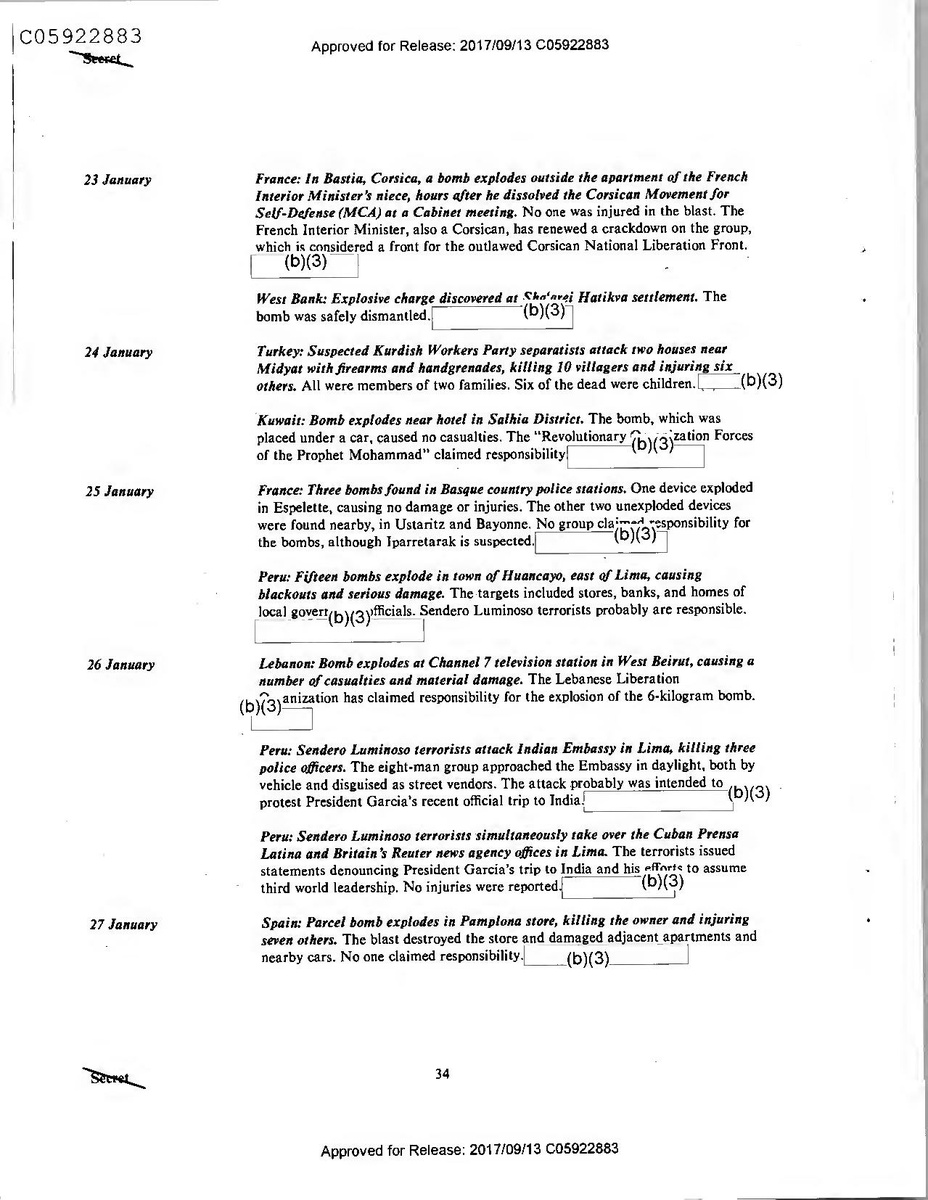
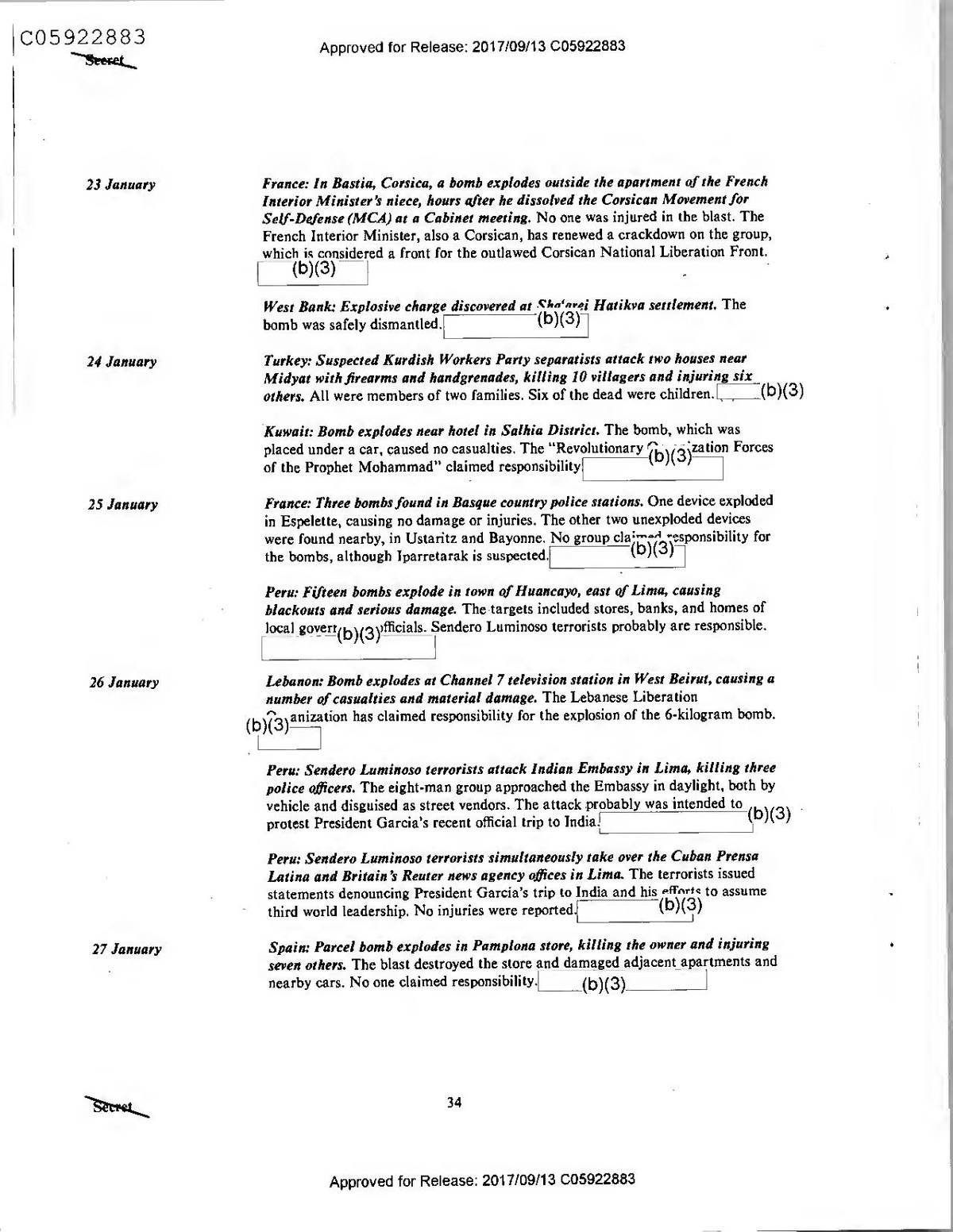
January
France: In Bastia, Corsica, a bomb explodes outside the apartment of the French Interior Minister's niece, hours after he dissolved the Corsican Movement for Self-Defense (MCA) at a Cabinet meeting. No one was injured in the blast. The French Interior Minister, also a Corsican, has renewed a crackdown on the group, which is considered a front for the outlawed Corsican National Liberation Front.
(b)(3)
West Bank: Explosive charge discovered at Sha'arei Hatikva settlement. The bomb was safely dismantled.
(b)(3)
24 January
Turkey: Suspected Kurdish Workers Party separatists attack two houses near Midyat with firearms and handgrenades, killing 10 villagers and injuring six others. All were members of two families. Six of the dead were children.L (b)(3)
Kuwait: Bomb explodes near hotel in Salhia District. The bomb, which was
placed under a car, caused no casualties. The "Revolutionary (b)(3)zation Forces of the Prophet Mohammad" claimed responsibility
25 January
France: Three bombs found in Basque country police stations. One device exploded in Espelette, causing no damage or injuries. The other two unexploded devices were found nearby, in Ustaritz and Bayonne. No group claimed responsibility for the bombs, although Iparretarak is suspected.
$(b)(3)7
Peru: Fifteen bombs explode in town of Huancayo, east of Lima, causing blackouts and serious damage. The targets included stores, banks, and homes of local govern
IF(b)(3}fficials. Sendero Luminoso terrorists probably are responsible.
26 January
Lebanon: Bomb explodes at Channel 7 television station in West Beirut, causing a number of casualties and material damage. The Lebanese Liberation
(b)(3)anization has claimed responsibility for the explosion of the 6-kilogram bomb.
Peru: Sendero Luminoso terrorists attack Indian Embassy in Lima, killing three police officers. The eight-man group approached the Embassy in daylight, both by vehicle and disguised as street vendors. The attack probably was intended to protest President Garcia's recent official trip to India.
(b)(3)
Peru: Sendero Luminoso terrorists simultaneously take over the Cuban Prensa Latina and Britain's Reuter news agency offices in Lima. The terrorists issued statements denouncing President Garcia's trip to India and his efforts to assume third world leadership. No injuries were reported.
(b)(3)
27 January
Spain: Parcel bomb explodes in Pamplona store, killing the owner and injuring seven others. The blast destroyed the store and damaged adjacent apartments and nearby cars. No one claimed responsibility.
(b)(3).
Secret
34
Approved for Release: 2017/09/13 C05922883
Colombia: Terrorists bomb offices of National Tax Administration in Bogota, causing one injury but little damage. The terrorists probably are taking advantage of popular dissatisfaction with the country's recent tax reform law, believed by many to discriminate in favor of the upper classes.
(b)(3)
28 January
West Bank: Package bomb dismantled; intended for Mayor Froii of Bethlehem. Two Sunni Muslim suspects have been arrested.
(b)(3)
30 January
Gaza: Israeli border police fire on young Gazan demonstrators. Three youths were injured, one 14-year-old died from his wounds. (b)(3)
Late January
Turkey: Diyarbakir court tries 28 Kurdish Workers Party (PKK) members for attacks in Uludere. The military prosecutor has demanded the death penalty for one of the accused. The suspect may have been involved in the PKK attack that provoked a Turkish air raid on PKK camps in Iraq last August. The prosecutor requested four years' imprisonment for each of the remaining 27 defendants. (b)(3)
1 February
Israel: Bomb explodes on Israeli bus traveling from Haifa to Jerusalem. Nine persons were injured, one seriously
(b)(3)
Reverse Blank
35
Secret
Approved for Release: 2017/09/13 C05922883
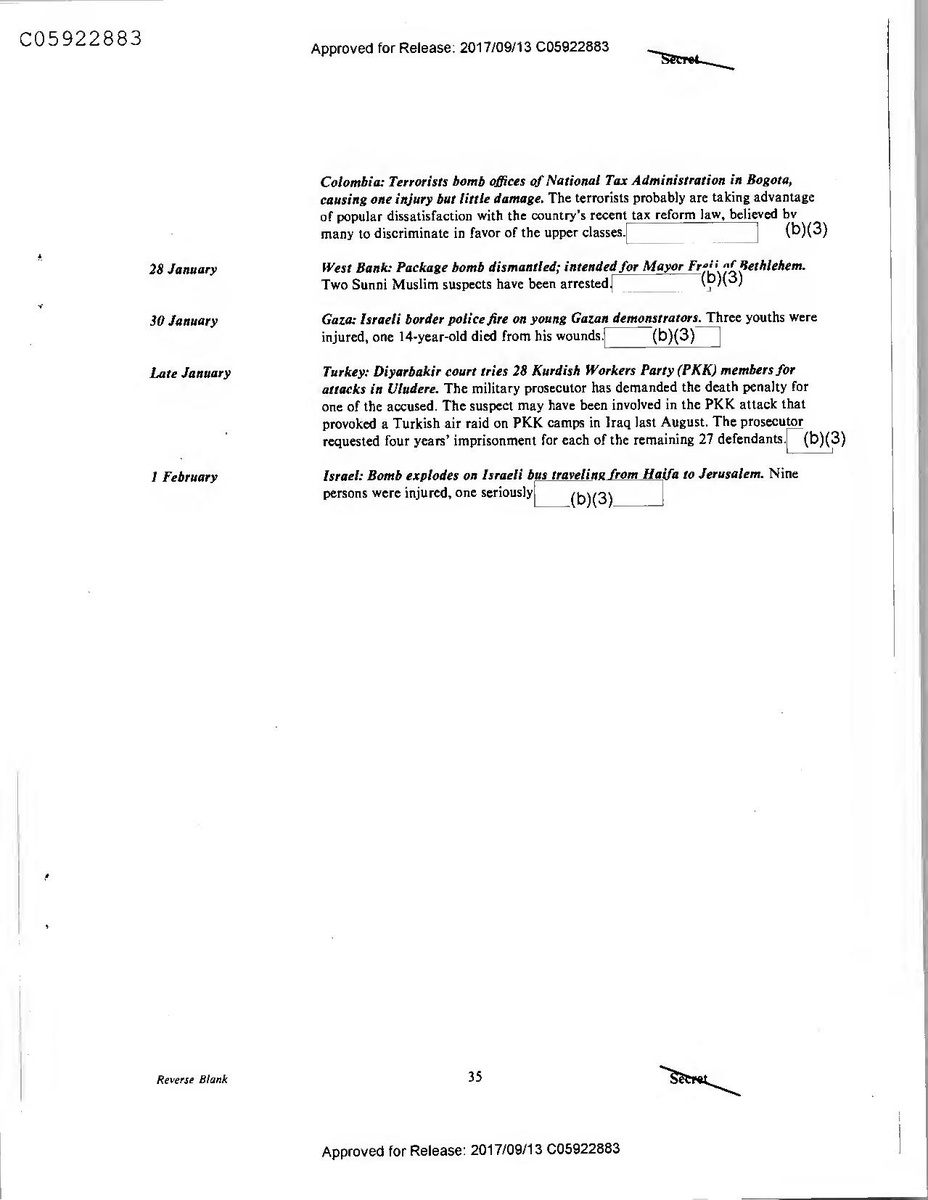
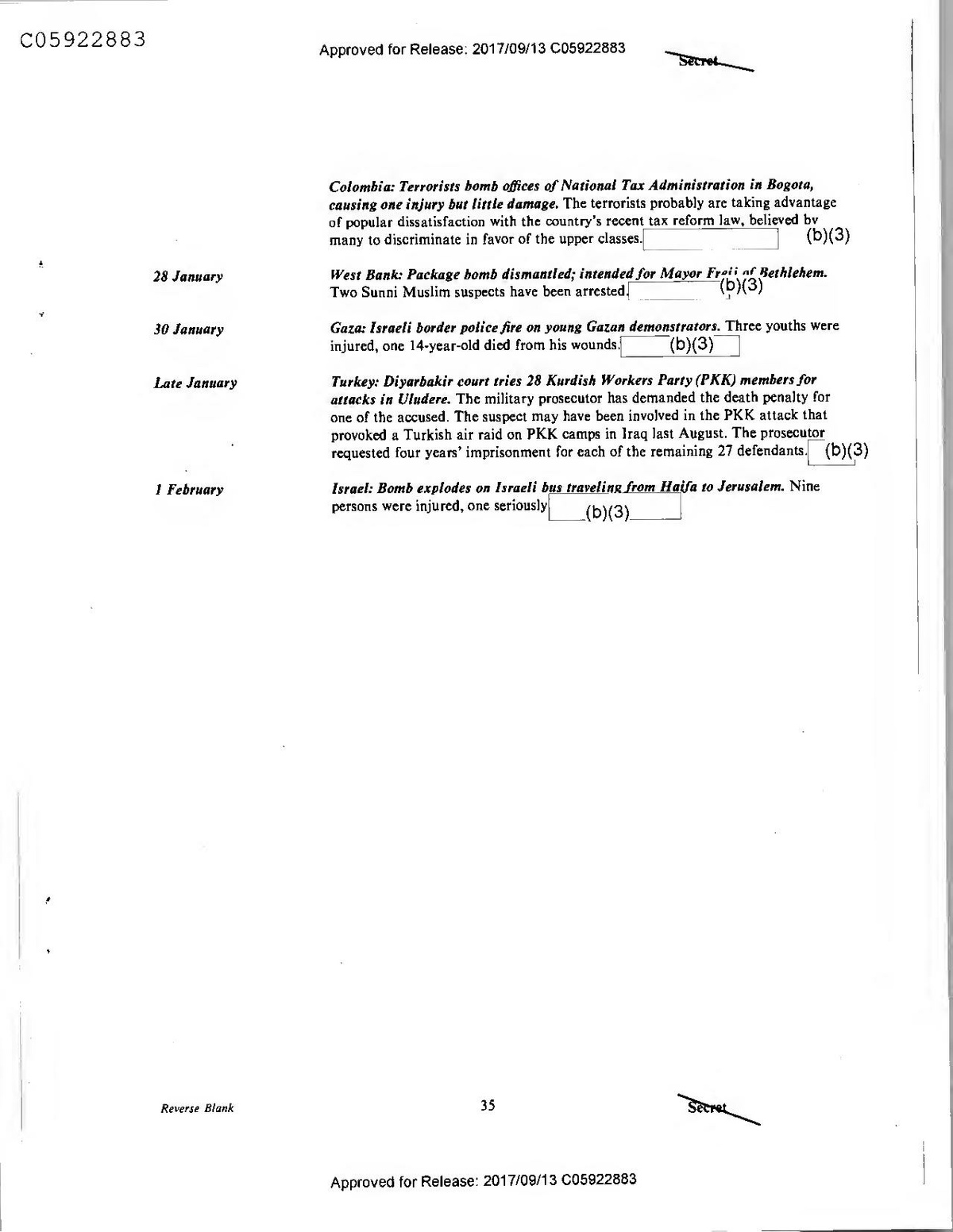
Colombia: Terrorists bomb offices of National Tax Administration in Bogota, causing one injury but little damage. The terrorists probably are taking advantage of popular dissatisfaction with the country's recent tax reform law, believed by many to discriminate in favor of the upper classes.
(b)(3)
28 January
West Bank: Package bomb dismantled; intended for Mayor Froii of Bethlehem. Two Sunni Muslim suspects have been arrested.
(b)(3)
30 January
Gaza: Israeli border police fire on young Gazan demonstrators. Three youths were injured, one 14-year-old died from his wounds. (b)(3)
Late January
Turkey: Diyarbakir court tries 28 Kurdish Workers Party (PKK) members for attacks in Uludere. The military prosecutor has demanded the death penalty for one of the accused. The suspect may have been involved in the PKK attack that provoked a Turkish air raid on PKK camps in Iraq last August. The prosecutor requested four years' imprisonment for each of the remaining 27 defendants. (b)(3)
1 February
Israel: Bomb explodes on Israeli bus traveling from Haifa to Jerusalem. Nine persons were injured, one seriously
(b)(3)
Reverse Blank
35
Secret
Approved for Release: 2017/09/13 C05922883
!
Secret
Approved for Release: 2017/09/13 C05922883.
!
Secret
Approved for Release: 2017/09/13 C05922883.
Directorate of Intelligence
sur
(b)(3)
MASTER FILE COPY
DO NOT GIVE OUT
OR MARK ON
(b)(3)
Terrorism Review
O
26 February 1987
Secret
DI TR 87-004 26 February 1987
Copy 628
Approved for Release: 2017/09/13 C05922884
Directorate of Intelligence
sur
(b)(3)
MASTER FILE COPY
DO NOT GIVE OUT
OR MARK ON
(b)(3)
Terrorism Review
O
26 February 1987
Secret
DI TR 87-004 26 February 1987
Copy 628
Approved for Release: 2017/09/13 C05922884
Warning Notice
Intelligence Sources or Methods Involved (WNINTEL)
+
National Security Information
Unauthorized Disclosure Subject to Criminal Sanctions:
Dissemination Control Abbrevlatlons
NOFORN (NF) NOCONTRACT
(NC) PROPIN (PR) ORCON (OC)
Not relcasable to foreign nationals Not releasable to contractors or contractor/consultants Caution-proprietary information involved Dissemination and extraction of information controlled by originator
REL...
This information has been authorized for release to...
WN
WNINTEL-Intelligence sources or methods involved
(b)(3)
All material on this page is Unclassified
Approved for Release: 2017/09/13 C05922884
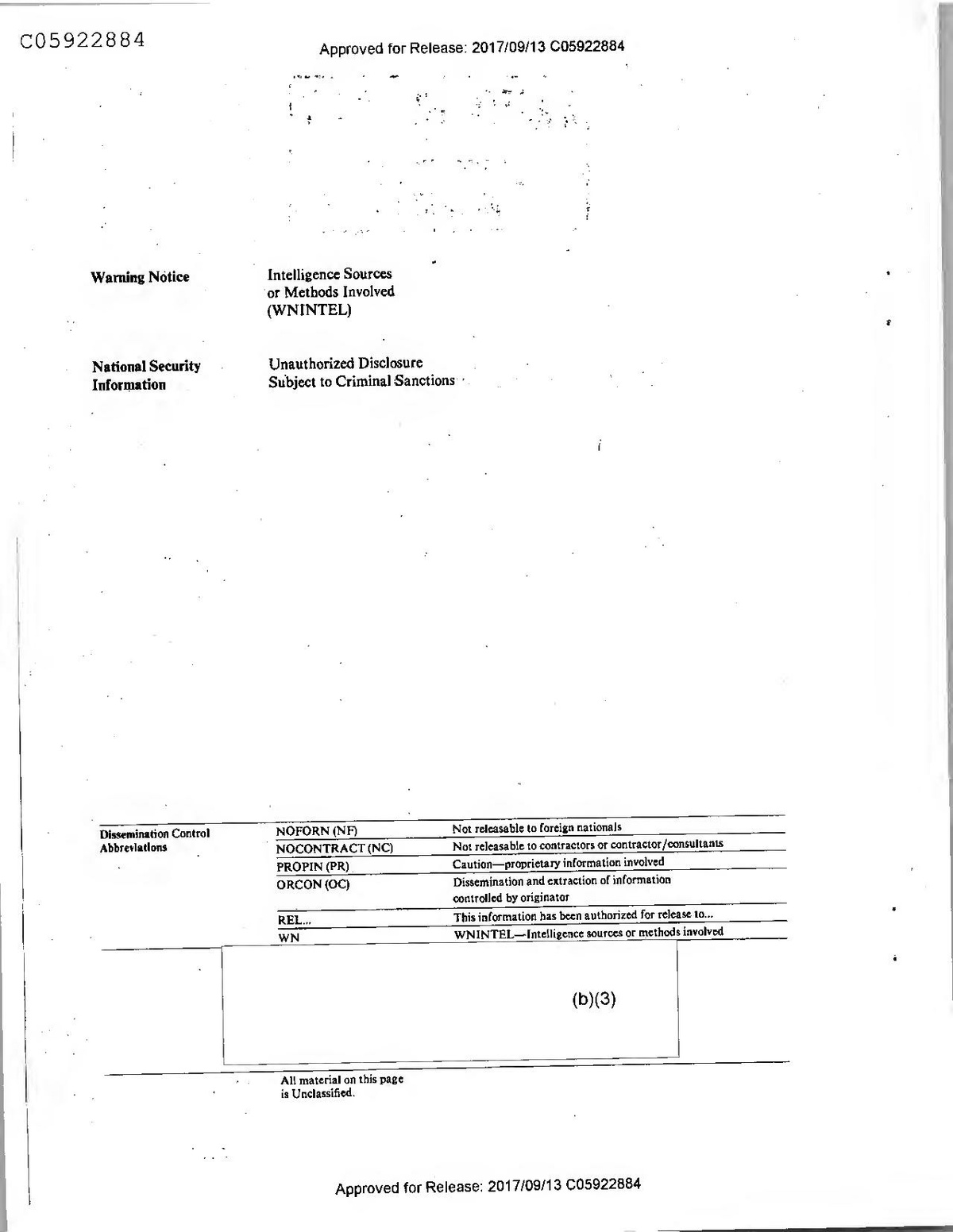
Warning Notice
Intelligence Sources or Methods Involved (WNINTEL)
+
National Security Information
Unauthorized Disclosure Subject to Criminal Sanctions:
Dissemination Control Abbrevlatlons
NOFORN (NF) NOCONTRACT
(NC) PROPIN (PR) ORCON (OC)
Not relcasable to foreign nationals Not releasable to contractors or contractor/consultants Caution-proprietary information involved Dissemination and extraction of information controlled by originator
REL...
This information has been authorized for release to...
WN
WNINTEL-Intelligence sources or methods involved
(b)(3)
All material on this page is Unclassified
Approved for Release: 2017/09/13 C05922884
Secret
Helt stycke maskerat
the attempted assassination of former Iranian Prime Minister Shahpour Bakhtiar in Paris in 1980.
Press reporting indicates that this same group claimed responsibility for three bombings in Paris in early February in which 20 people were injured. (b)(3)
The bombing campaign and demands to release convicted terrorists will provide an early test for the new conservative government, with its election call for a tougher counterterrorist policy. (b)(3)
Significant Developments
Belgium
Fourth Major CCC Safehouse Discovered
The Belgian police's discovery on 25 February of a fourth major Communist Combatant Cells (CCC) safehouse in Liege may hamper rebuilding efforts by CCC members still at large.
Police believe the safehouse was used by CCC leader Pierre Carette, who was arrested in December. An identity card, a driver's license, arms, ammunition, communications equipment, money, and CCC stationery were also discovered in the hideout. (b)(3)
The December 1985 arrests of four CCC members and the subsequent discoveries of their safehouses will reduce the likelihood of terrorist attacks in Belgium in the near term. Remaining CCC hardcore members, however, could - possibly with support from other European leftist groups - carry out attacks on public officials in order to pressure the government into releasing their imprisoned comrades and to prove the group's viability. (b)(3)]
France-Spain
French Court Decision May Have ETA on the Run
A French court decision in early March may indicate a hardening of that country's counterterrorist policy toward the Spanish Basque organization Fatherland and Liberty-Military Wing (ETA-M).
On 13 March, for the first time, a French court sentenced alleged members of ETA-M as common criminals rather than as political refugees.
This decision reportedly has prompted more than a dozen alleged ETA-M members to leave their French safehavens.
Some Spanish officials believe that Spain's 12 March decision to remain in NATO may lead ETA-M to target Spanish or even US interests in Spain in the future. The recent disappearance of the ETA-M members may indicate preparations to carry out these acts. (b)(3)
- (b)(1)
- (b)(3)
Approved for Release: 2017/09/13 C05632837
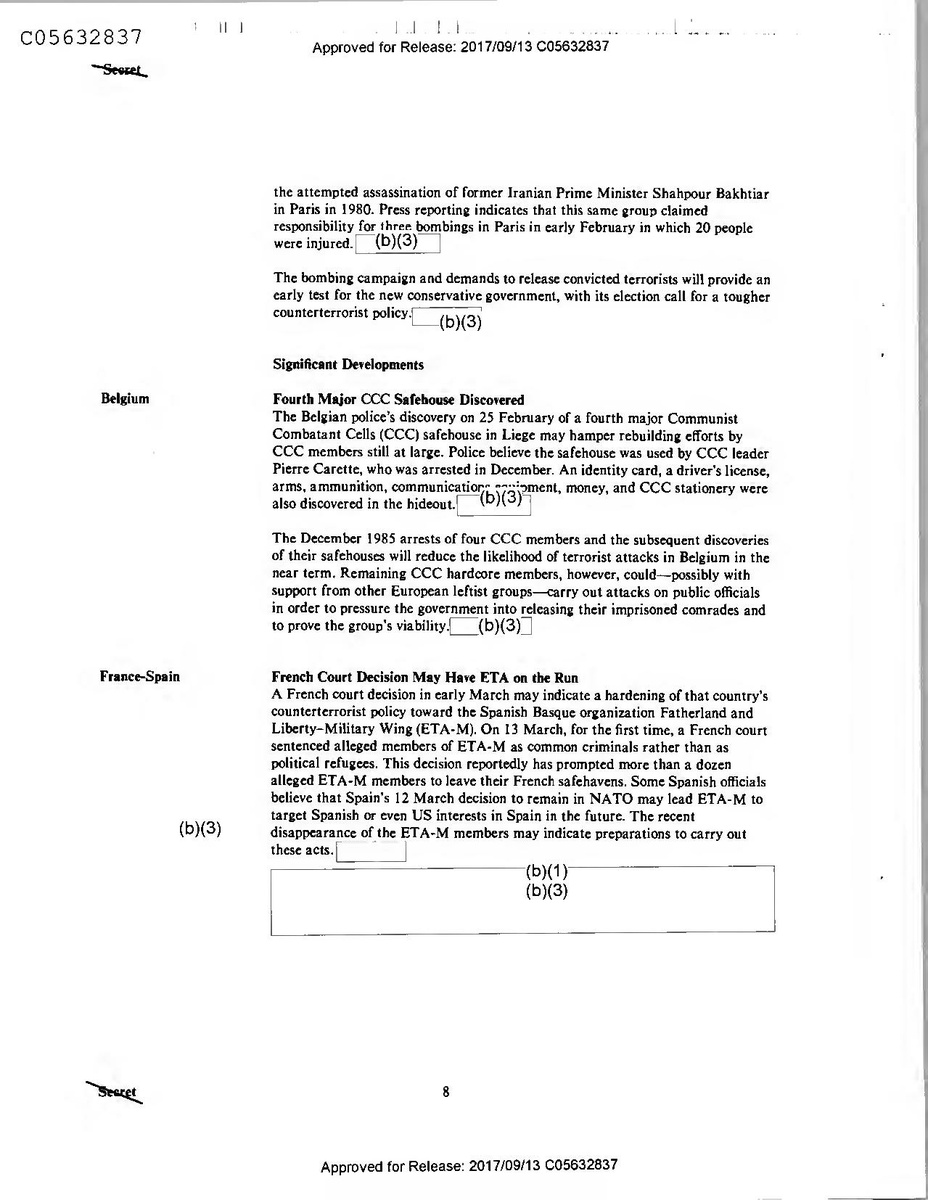
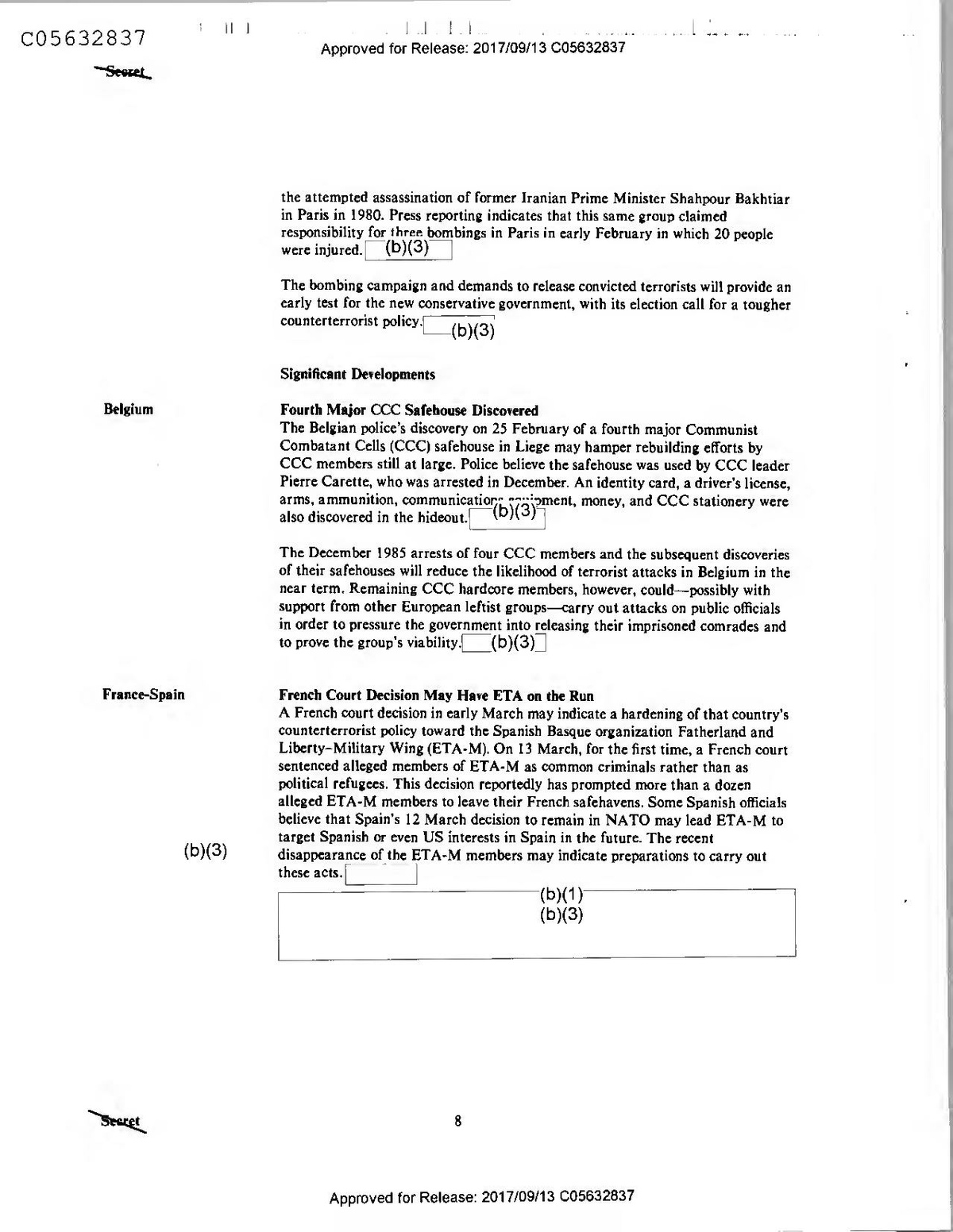
Secret
Helt stycke maskerat
the attempted assassination of former Iranian Prime Minister Shahpour Bakhtiar in Paris in 1980.
Press reporting indicates that this same group claimed responsibility for three bombings in Paris in early February in which 20 people were injured. (b)(3)
The bombing campaign and demands to release convicted terrorists will provide an early test for the new conservative government, with its election call for a tougher counterterrorist policy. (b)(3)
Significant Developments
Belgium
Fourth Major CCC Safehouse Discovered
The Belgian police's discovery on 25 February of a fourth major Communist Combatant Cells (CCC) safehouse in Liege may hamper rebuilding efforts by CCC members still at large.
Police believe the safehouse was used by CCC leader Pierre Carette, who was arrested in December. An identity card, a driver's license, arms, ammunition, communications equipment, money, and CCC stationery were also discovered in the hideout. (b)(3)
The December 1985 arrests of four CCC members and the subsequent discoveries of their safehouses will reduce the likelihood of terrorist attacks in Belgium in the near term. Remaining CCC hardcore members, however, could - possibly with support from other European leftist groups - carry out attacks on public officials in order to pressure the government into releasing their imprisoned comrades and to prove the group's viability. (b)(3)]
France-Spain
French Court Decision May Have ETA on the Run
A French court decision in early March may indicate a hardening of that country's counterterrorist policy toward the Spanish Basque organization Fatherland and Liberty-Military Wing (ETA-M).
On 13 March, for the first time, a French court sentenced alleged members of ETA-M as common criminals rather than as political refugees.
This decision reportedly has prompted more than a dozen alleged ETA-M members to leave their French safehavens.
Some Spanish officials believe that Spain's 12 March decision to remain in NATO may lead ETA-M to target Spanish or even US interests in Spain in the future. The recent disappearance of the ETA-M members may indicate preparations to carry out these acts. (b)(3)
- (b)(1)
- (b)(3)
Approved for Release: 2017/09/13 C05632837
(b)(3)
(b)(3)
Terrorism Review
26 February 1987
Focus: Anti-American Terrorism on the Rise in the Andean Region
(b)(3)
(b)(3)7
7
Highlights Counterterrorist Center
15
Peru: The Terrorist Threat to Americans
(b)(3)
19
International Terrorism in Western Europe, 1986
(b)(3)
23
Basque Fatherland and Liberty Terrorism in 1986
(b)(3)
29
Chronology of Terrorism–1986-87
(b)(3)
This review is published biweekly by the Directorate of Intelligence. Appropriate articles produced by other elements of the CIA as well as by other agencies of the US Intelligence Community will be considered for publication. Comments and queries are welcome and may be directed to the Executive Editor
(b)(3)
i
Seeret
Reverse Blank
Approved for Release: 2017/09/13 C05922884
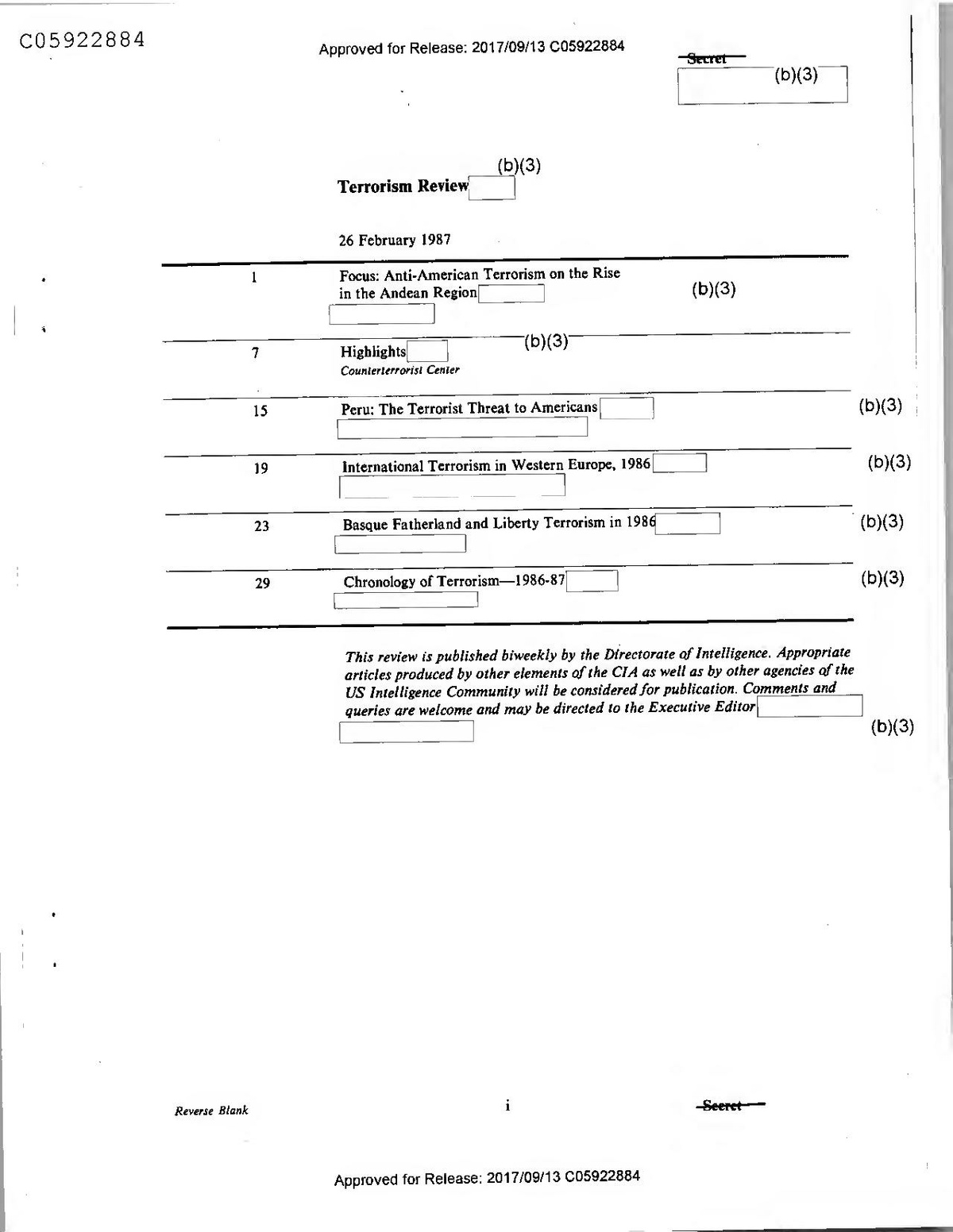
(b)(3)
(b)(3)
Terrorism Review
26 February 1987
Focus: Anti-American Terrorism on the Rise in the Andean Region
(b)(3)
(b)(3)7
7
Highlights Counterterrorist Center
15
Peru: The Terrorist Threat to Americans
(b)(3)
19
International Terrorism in Western Europe, 1986
(b)(3)
23
Basque Fatherland and Liberty Terrorism in 1986
(b)(3)
29
Chronology of Terrorism–1986-87
(b)(3)
This review is published biweekly by the Directorate of Intelligence. Appropriate articles produced by other elements of the CIA as well as by other agencies of the US Intelligence Community will be considered for publication. Comments and queries are welcome and may be directed to the Executive Editor
(b)(3)
i
Seeret
Reverse Blank
Approved for Release: 2017/09/13 C05922884
(b)(3)
(b)(3)
Terrorism Review
26 February 1987
Focus
Anti-American Terrorism on the Rise
(b)(3) in the Andean Region
The Andean region has become one of the most dangerous areas in the world for businesses and facilities associated with the United States. Although most of the violence in the region continues to be directed against domestic targets, the steady rise in anti-US attacks over the past five years refutes the traditional view of Latin American terrorism as being sporadic and cyclical. A further increase in attacksparticularly if bombings become more lethal and American citizens are victims could hinder the transaction of US business, both diplomatic and commercial and undercut the trend toward more open government: • In 1986, Latin America—and specifically the Andean countries—replaced
Western Europe as the second-most popular location of international terrorist attacks. Only in the Middle East did more such attacks occur.
Figure 1 Anti-US Attacks in Andean Region, 1980-86
Number of attacks
100
60
40
20
1 82
11 84
1. 85
0
1980
81
83
86
(b)(3)
312029 3.87
1
Seoret
DI TR 87-004 26 February 1987
Approved for Release: 2017/09/13 C05922884
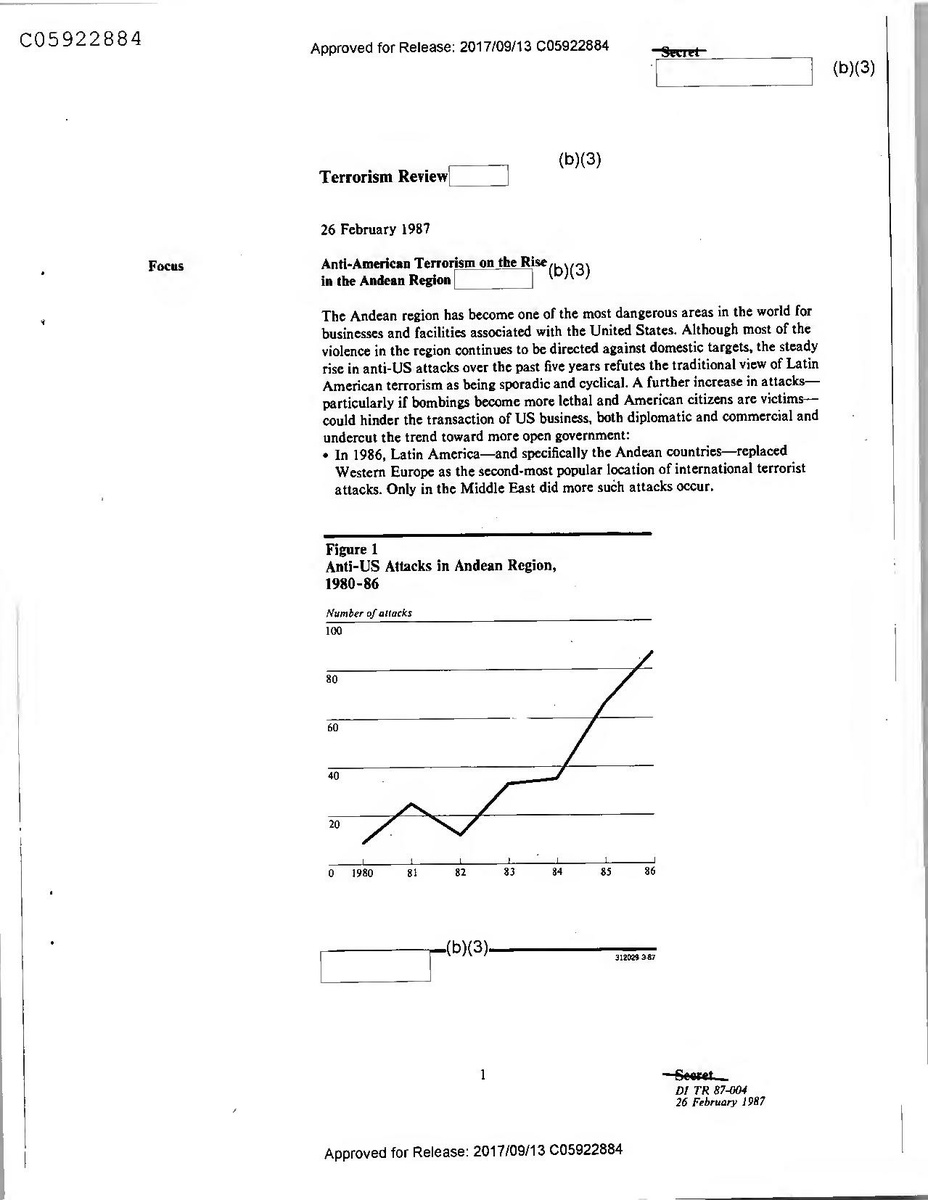
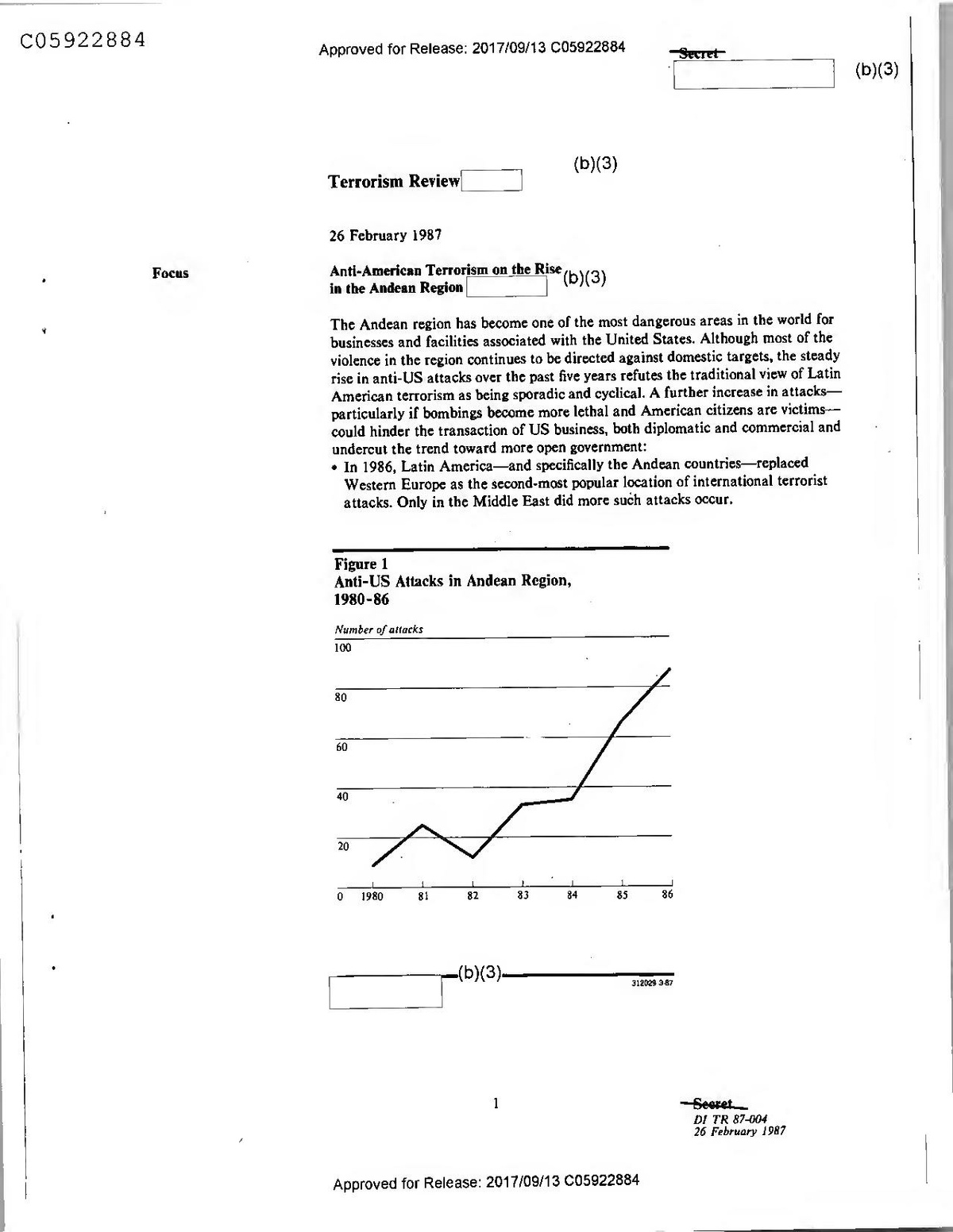
(b)(3)
(b)(3)
Terrorism Review
26 February 1987
Focus
Anti-American Terrorism on the Rise
(b)(3) in the Andean Region
The Andean region has become one of the most dangerous areas in the world for businesses and facilities associated with the United States. Although most of the violence in the region continues to be directed against domestic targets, the steady rise in anti-US attacks over the past five years refutes the traditional view of Latin American terrorism as being sporadic and cyclical. A further increase in attacksparticularly if bombings become more lethal and American citizens are victims could hinder the transaction of US business, both diplomatic and commercial and undercut the trend toward more open government: • In 1986, Latin America—and specifically the Andean countries—replaced
Western Europe as the second-most popular location of international terrorist attacks. Only in the Middle East did more such attacks occur.
Figure 1 Anti-US Attacks in Andean Region, 1980-86
Number of attacks
100
60
40
20
1 82
11 84
1. 85
0
1980
81
83
86
(b)(3)
312029 3.87
1
Seoret
DI TR 87-004 26 February 1987
Approved for Release: 2017/09/13 C05922884
- Nearly half of all terrorist incidents worldwide that involved US citizens or property occurred in Latin America. US interests were favorite targets in Colombia, Peru, and Chile, where American banks and US-affiliated petroleum companies were the primary targets.
- In Peru and Colombia, moreover, attacks against US businesses nearly doubled.
- Anti-US violence in the Andean region has increased consistently over the past five years. In 1982, for example, there were only 12 anti-American attacks, compared with about 80 incidents in 1986,
(b)(3)
We believe that Andean terrorists are increasingly selecting US targets in an effort to attract international media attention to their local causes.
Some terrorist groups, however, genuinely want to compel the withdrawal of US official and commercial interests.
This stems in part from anti-American sentiment that goes back at least a century in South America and perceives the United States as a heavyhanded external influence in the region.
The terrorists also hope that their anti-American attacks will win them favor-and ultimately acristance-from such state sponsors of terrorism as Cuba and Libya.
(b)(3)
Governments in the region find themselves confronting growing threats with illprepared security forces. Some of the democratic governments in the Andean
Figure 2
Anti-US Attacks, by Country,
1985-86
Colombia
Peru
Chile
(b)(3)
-Secret
Approved for Release: 2017/09/13 C05922884
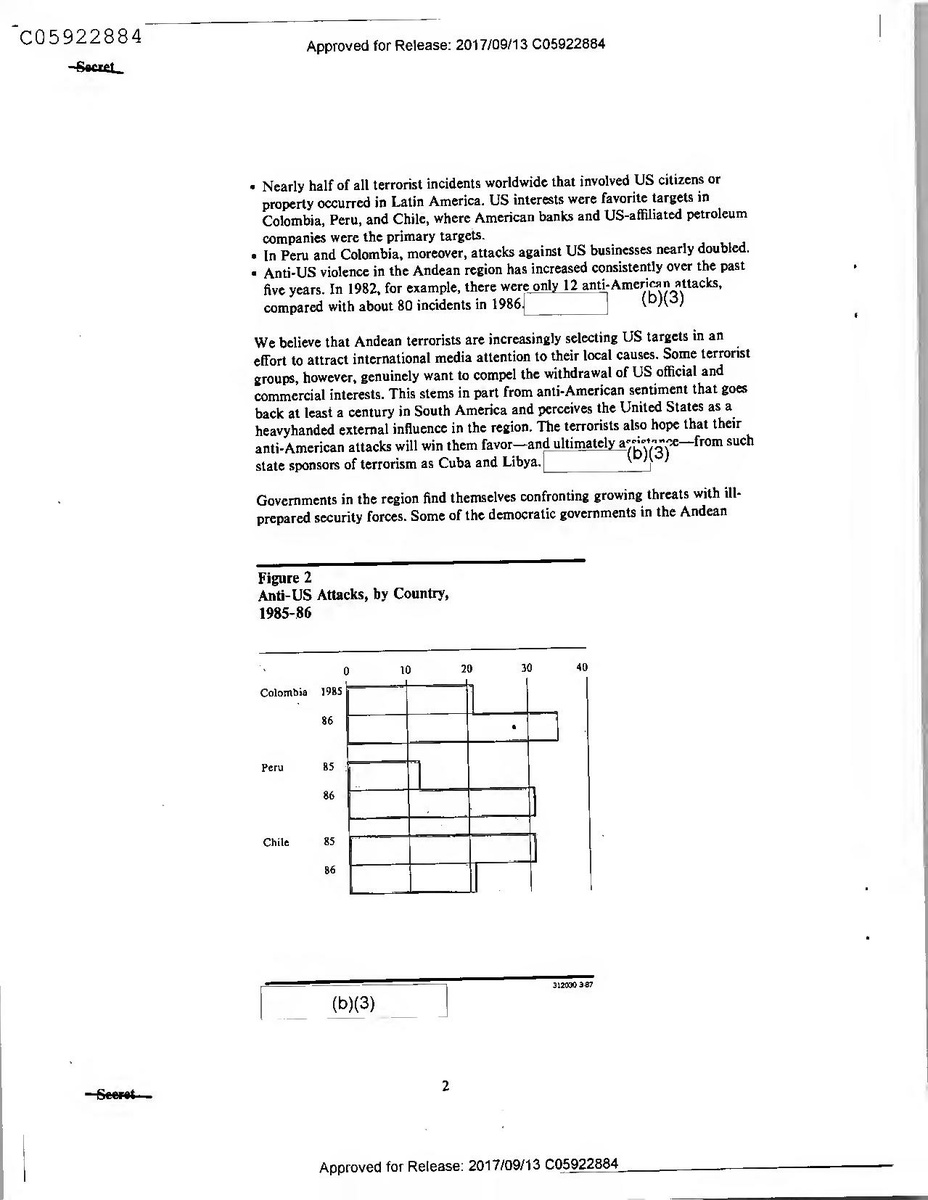
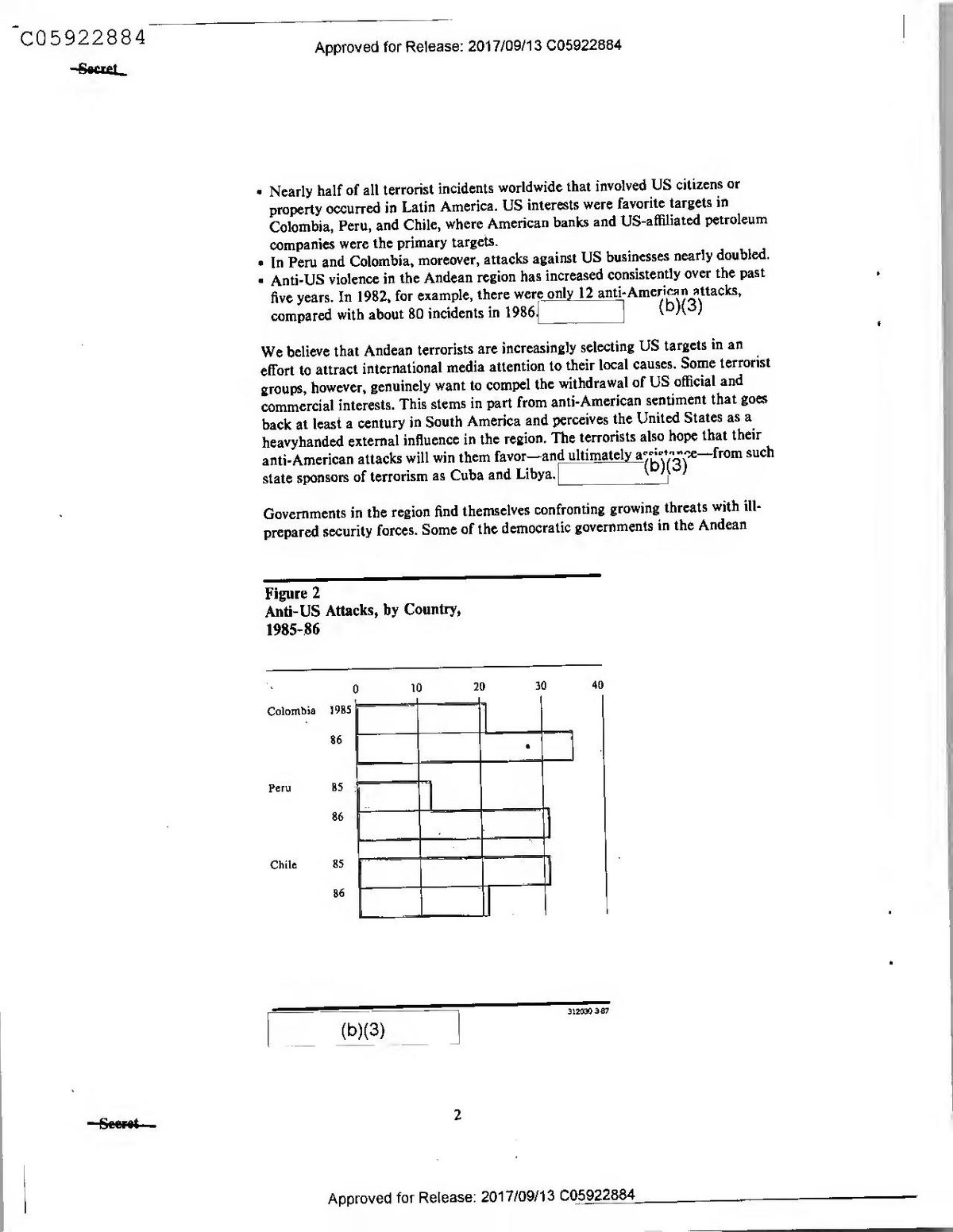
- Nearly half of all terrorist incidents worldwide that involved US citizens or property occurred in Latin America. US interests were favorite targets in Colombia, Peru, and Chile, where American banks and US-affiliated petroleum companies were the primary targets.
- In Peru and Colombia, moreover, attacks against US businesses nearly doubled.
- Anti-US violence in the Andean region has increased consistently over the past five years. In 1982, for example, there were only 12 anti-American attacks, compared with about 80 incidents in 1986,
(b)(3)
We believe that Andean terrorists are increasingly selecting US targets in an effort to attract international media attention to their local causes.
Some terrorist groups, however, genuinely want to compel the withdrawal of US official and commercial interests.
This stems in part from anti-American sentiment that goes back at least a century in South America and perceives the United States as a heavyhanded external influence in the region.
The terrorists also hope that their anti-American attacks will win them favor-and ultimately acristance-from such state sponsors of terrorism as Cuba and Libya.
(b)(3)
Governments in the region find themselves confronting growing threats with illprepared security forces. Some of the democratic governments in the Andean
Figure 2
Anti-US Attacks, by Country,
1985-86
Colombia
Peru
Chile
(b)(3)
-Secret
Approved for Release: 2017/09/13 C05922884
countries, unlike the military dictatorships that dealt with terrorism in the southern countries in the 1960s and 1970s, are in a tenuous position. The nature of those new governments-open and pluralistic—probably makes them more susceptible to terrorist violence. Many of the security forces are poorly trained, especially in the use of terrorist penetrations and crisis management. The civilian governments, moreover, sometimes are reluctant to admit that they face a national security problem.
(b)(3)
Colombia Anti-US terrorist incidents in Colombia increased by nearly 70 percent in 1986 from 21 in 1985 to 35 last year-making it the country with the highest number of anti-US terrorist incidents in the world. Some 90 percent of all anti-US attacks were directed against US business interests, mostly harassment bombings. Terrorists concentrated on the Colombian petroleum industry-in which US companies are heavily involved—and staged numerous bombings of a major oil pipeline. The bombings have been taking place for three years, but they were so severe in 1986 that $50 million in damages resulted. In fact, Occidental Petroleum was unable to fulfill its oil production goal for 1986 because of these attacks.
(b)(3)
Peru Anti-US terrorism in Peru increased from 12 incidents in 1985 to last year's high of about 30 incidents. Many of these incidents—mostly low-level bombings that caused little damage—were directed against US financial institutions, which symbolize imperialism to the two main terrorist groups-Sendero Luminoso (SL) and the Revolutionary Movement Tupac Amaru (MRTA). Unlike previous years, SL terrorists staged fewer attacks in the rural highlands. Government counterterrorist successes in the rural areas may have forced some of the terrorists into the cities, but we believe these urban attacks are part of a broader strategy to attract more attention to Sendero Luminoso's terrorist campaign. In late December the MRTA attacked seven US affiliated facilities over three days, and we expect such attacks to continue. (b)(3)
Chile There was a slight decline in terrorist activity in Chile last year, yet the 1986 figure remains the second highest of the past five years. We believe the discovery of a large arms cache last August and internal disputes within the radical leftist opposition were factors. We expect terrorist attacks to pick up in 1987, especially if progress is made on a democratic transition of power from Pinochet to another president. In that event, the Communist Party probably would launch a terrorist campaign aimed at provoking the regime into more ruthless repression, in an attempt to undercut the transition process. Some attacks may be directed against US businesses to internationalize the struggle and create economic and political uncertainty, but the bulk of terrorist actions will be directed at domestic targets.
(b)(3)
3
Secret
Approved for Release: 2017/09/13 C05922884
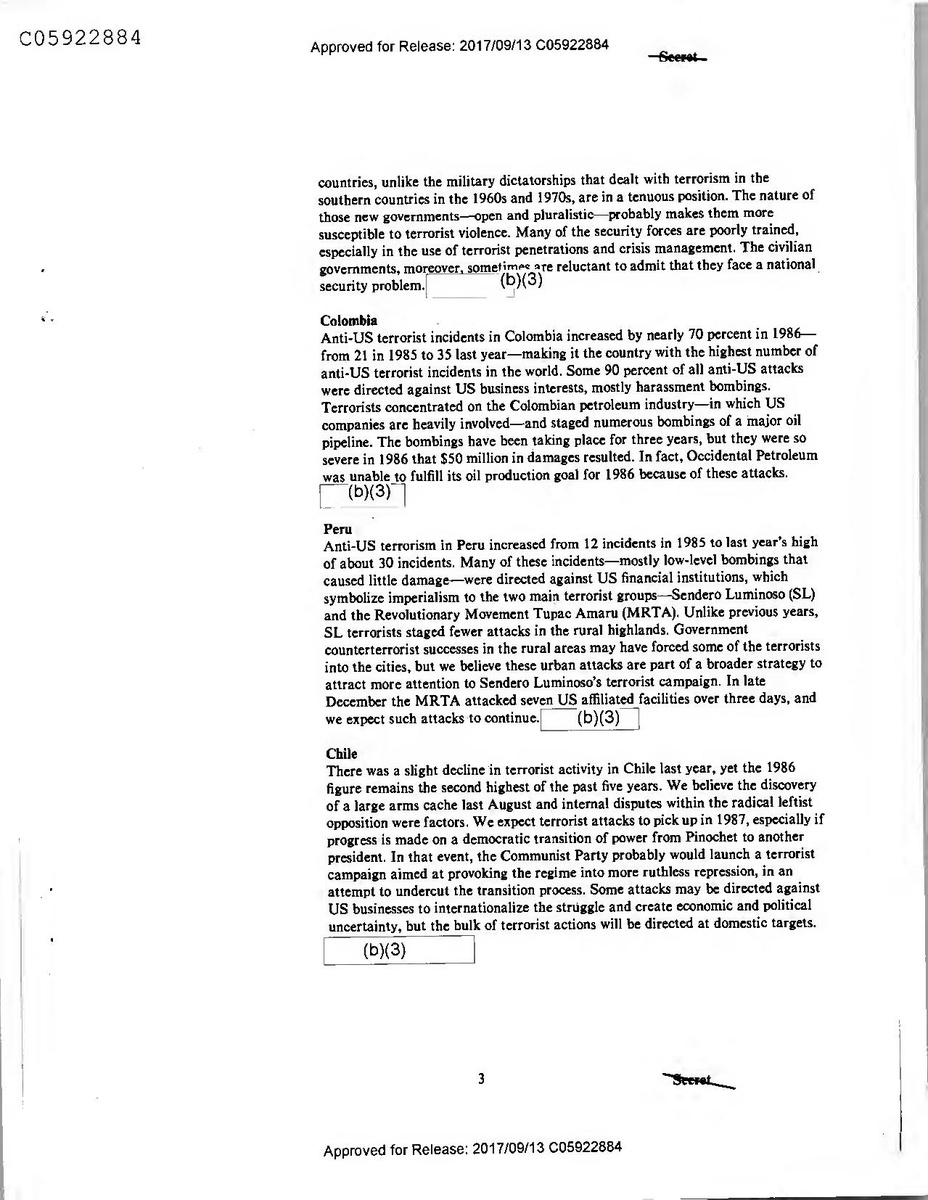
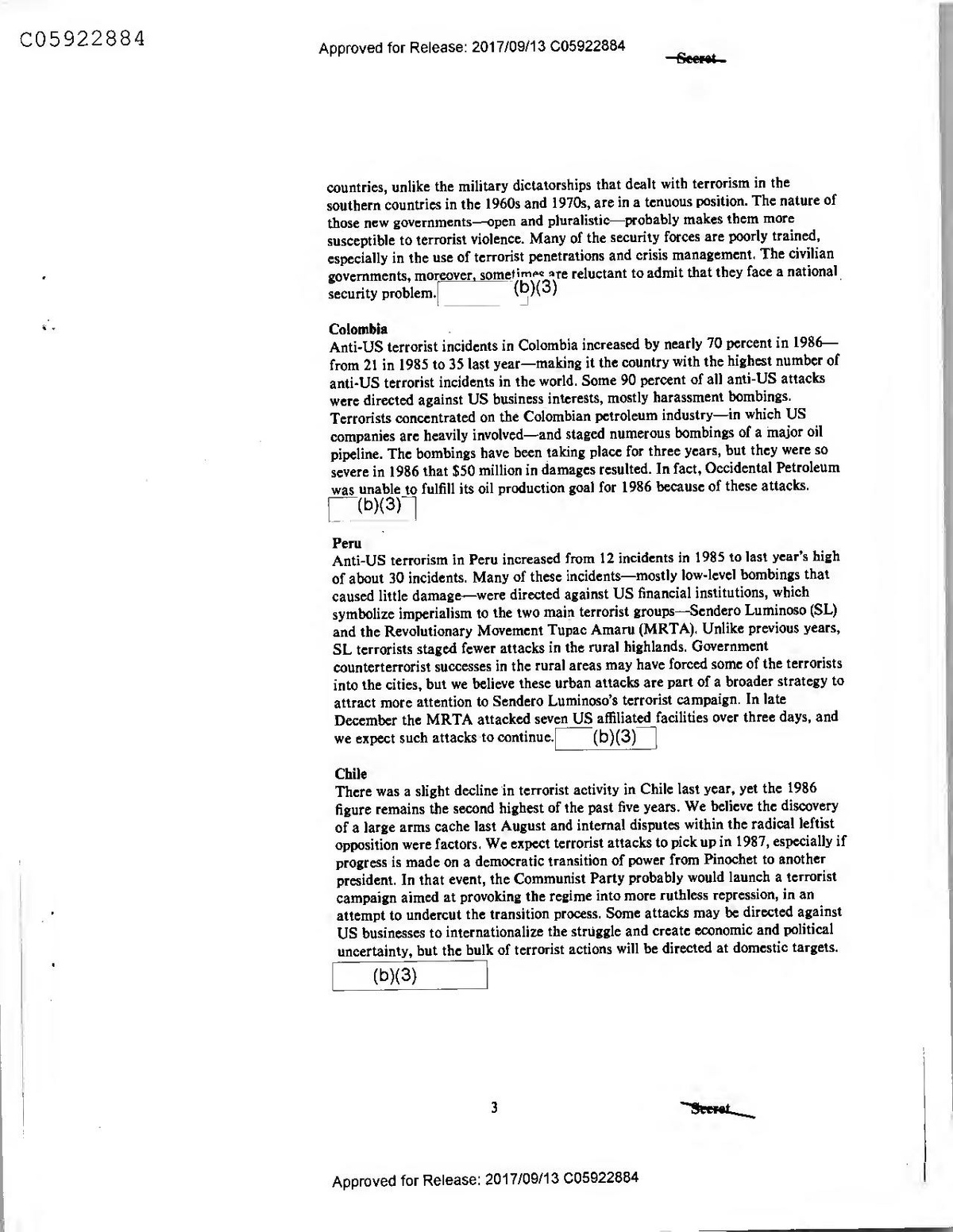
countries, unlike the military dictatorships that dealt with terrorism in the southern countries in the 1960s and 1970s, are in a tenuous position. The nature of those new governments-open and pluralistic—probably makes them more susceptible to terrorist violence. Many of the security forces are poorly trained, especially in the use of terrorist penetrations and crisis management. The civilian governments, moreover, sometimes are reluctant to admit that they face a national security problem.
(b)(3)
Colombia Anti-US terrorist incidents in Colombia increased by nearly 70 percent in 1986 from 21 in 1985 to 35 last year-making it the country with the highest number of anti-US terrorist incidents in the world. Some 90 percent of all anti-US attacks were directed against US business interests, mostly harassment bombings. Terrorists concentrated on the Colombian petroleum industry-in which US companies are heavily involved—and staged numerous bombings of a major oil pipeline. The bombings have been taking place for three years, but they were so severe in 1986 that $50 million in damages resulted. In fact, Occidental Petroleum was unable to fulfill its oil production goal for 1986 because of these attacks.
(b)(3)
Peru Anti-US terrorism in Peru increased from 12 incidents in 1985 to last year's high of about 30 incidents. Many of these incidents—mostly low-level bombings that caused little damage—were directed against US financial institutions, which symbolize imperialism to the two main terrorist groups-Sendero Luminoso (SL) and the Revolutionary Movement Tupac Amaru (MRTA). Unlike previous years, SL terrorists staged fewer attacks in the rural highlands. Government counterterrorist successes in the rural areas may have forced some of the terrorists into the cities, but we believe these urban attacks are part of a broader strategy to attract more attention to Sendero Luminoso's terrorist campaign. In late December the MRTA attacked seven US affiliated facilities over three days, and we expect such attacks to continue. (b)(3)
Chile There was a slight decline in terrorist activity in Chile last year, yet the 1986 figure remains the second highest of the past five years. We believe the discovery of a large arms cache last August and internal disputes within the radical leftist opposition were factors. We expect terrorist attacks to pick up in 1987, especially if progress is made on a democratic transition of power from Pinochet to another president. In that event, the Communist Party probably would launch a terrorist campaign aimed at provoking the regime into more ruthless repression, in an attempt to undercut the transition process. Some attacks may be directed against US businesses to internationalize the struggle and create economic and political uncertainty, but the bulk of terrorist actions will be directed at domestic targets.
(b)(3)
3
Secret
Approved for Release: 2017/09/13 C05922884
Outlook We do not expect the pace of anti-US attacks in the Andean region to slacken in the next several years. Most incidents probably will continue to be harassment attacks directed against property-rather than persons—particularly American businesses. This continuous barrage may have the same overall effect as more lethal attacks—a drawdown in both the official US presence and the American business community. Businesses are likely to reduce their presence before the American embassies do, however, because they cannot affo (b)(3)ame degree of protection as the United States Government can
We have no information that such outside sponsors as Cuba or Nicaragua have backed anti-US terrorist operations in the Andean region. Many Andean groups, however, receive varying degrees of general support-from propaganda to weapons supply-from state supporters. We believe the type of attacks undertaken by these groups would change little, even if state sponsors stepped up their assistance. In many cases, the Cubans are,
ajant to encourage anti-US violence for fear of American retaliation
(b)(3)a
Andean groups.are displaying more brazen and sophisticated techniques such as daylight attacks and simultaneous bombings. This adds to the frustration of the local security forces, which often are unable to protect potential targets.
Figure 3 Attacks Against US Businesses, 1980-86
Percent
Retail/hotel 9
Manufacturing/ mining 8
Offices of international firms 26
Other enterprises 10
Financial institutions 10
Petroleum facilities 22
Businessmen 15
(b)(3)
312031 387
Secrern
4
Approved for Release: 2017/09/13 C05922884
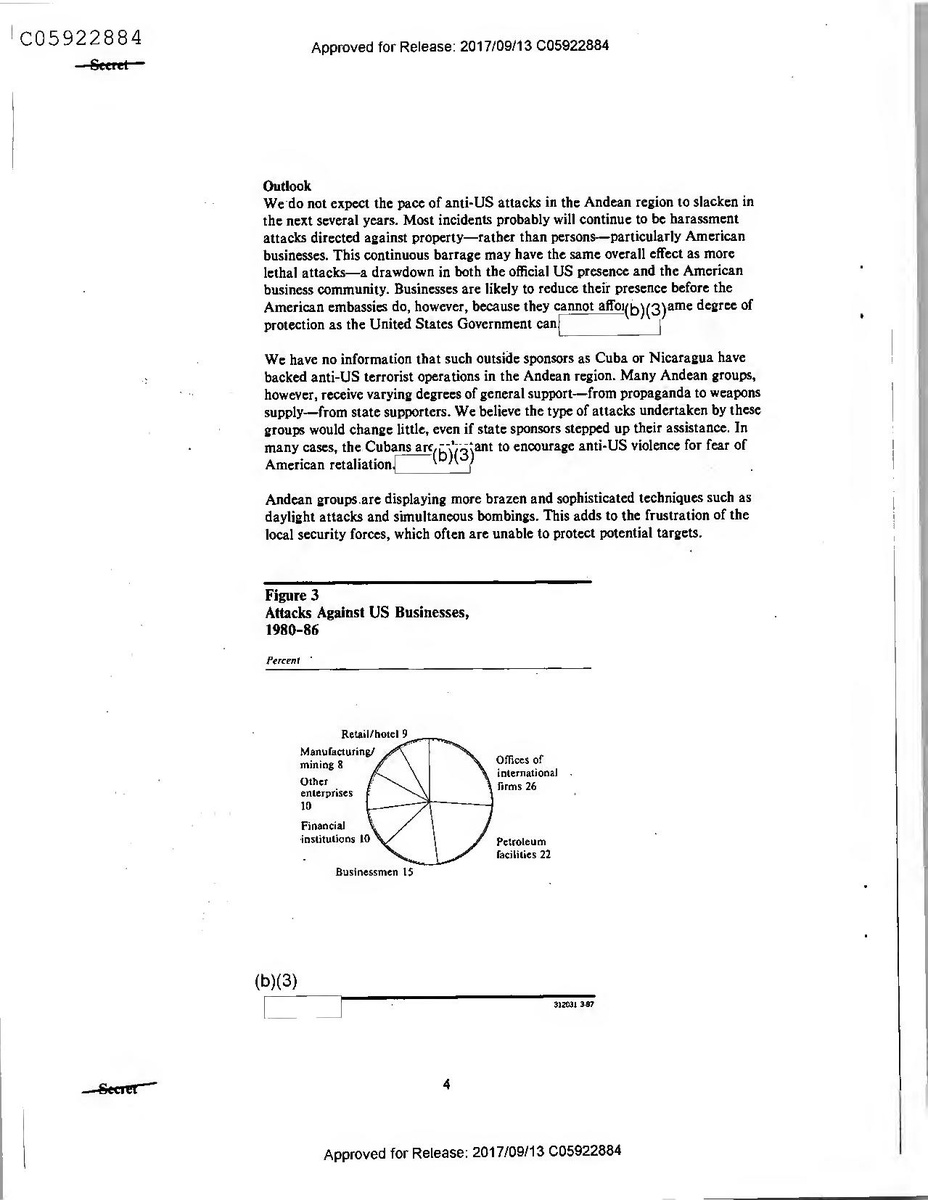
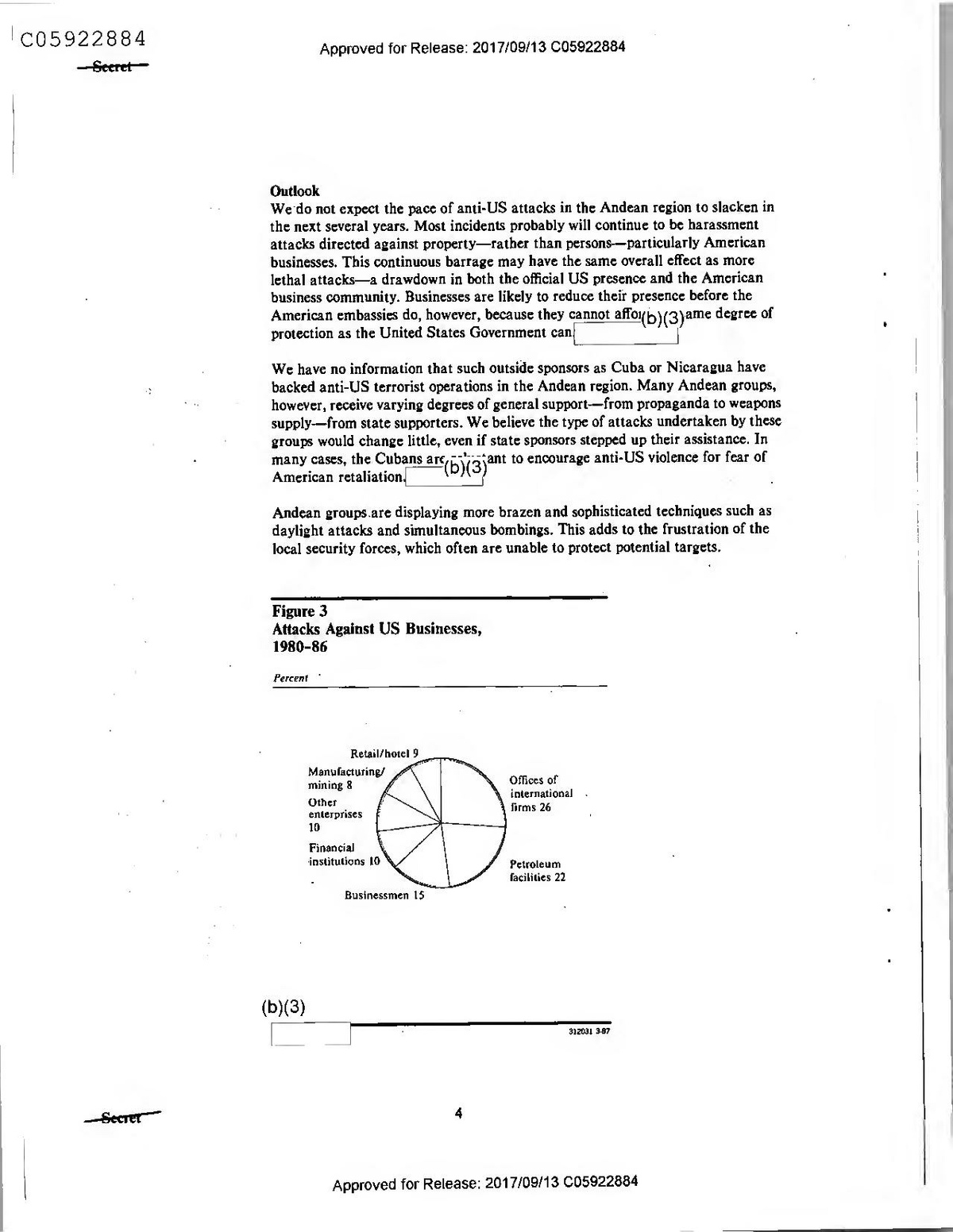
Outlook We do not expect the pace of anti-US attacks in the Andean region to slacken in the next several years. Most incidents probably will continue to be harassment attacks directed against property-rather than persons—particularly American businesses. This continuous barrage may have the same overall effect as more lethal attacks—a drawdown in both the official US presence and the American business community. Businesses are likely to reduce their presence before the American embassies do, however, because they cannot affo (b)(3)ame degree of protection as the United States Government can
We have no information that such outside sponsors as Cuba or Nicaragua have backed anti-US terrorist operations in the Andean region. Many Andean groups, however, receive varying degrees of general support-from propaganda to weapons supply-from state supporters. We believe the type of attacks undertaken by these groups would change little, even if state sponsors stepped up their assistance. In many cases, the Cubans are,
ajant to encourage anti-US violence for fear of American retaliation
(b)(3)a
Andean groups.are displaying more brazen and sophisticated techniques such as daylight attacks and simultaneous bombings. This adds to the frustration of the local security forces, which often are unable to protect potential targets.
Figure 3 Attacks Against US Businesses, 1980-86
Percent
Retail/hotel 9
Manufacturing/ mining 8
Offices of international firms 26
Other enterprises 10
Financial institutions 10
Petroleum facilities 22
Businessmen 15
(b)(3)
312031 387
Secrern
4
Approved for Release: 2017/09/13 C05922884
Peruvian President Alan Garcia has informed foreign embassies in Lima, including the US Embassy, that the Peruvian security forces cannot protect them. In Colombia the military would be severely strained if all four major guerrilla groups joined forces in a full-scale insurgency. Despite some successes, the counterterrorist forces in Colombia, Peru, and Chile have been unable to successfully penetrate terrorist groups and prevent them from stri!; in will. As a result, police action is reactive, rather than preventive.
"(b)(3)
The threat from Andean terrorist groups, while still controllable, has grown far more rapidly than was predicted in the early 1980s, and the portents for the second half of the decade are even more troubling. Acting alone, Andean terrorist groups do not have the potential to pose a serious threat to the stability of their host governments. Both domestic security and US interests, however, would be severely challenged if a convergence of interests among the terrorists, insurgents, and drug traffickers led them to launch a unified campaign of violence. Such a union could undermine democratic institutions by provoking a return to authoritarian methods. Moreover, a series of escalating international attacks could subvert the economic base of many of these countries by prompting American disinvestment. Should US counterterrorist and counternarcotics assistance to the host governments increase, the existing tacit cooperation among traffickers, insurgents, and terrorists may evolve into a formance against a perceived common enemy—the United States.
"(b)(3)
(b)(3)
Reverse Blank
5
Secret
Approved for Release: 2017/09/13 C05922884
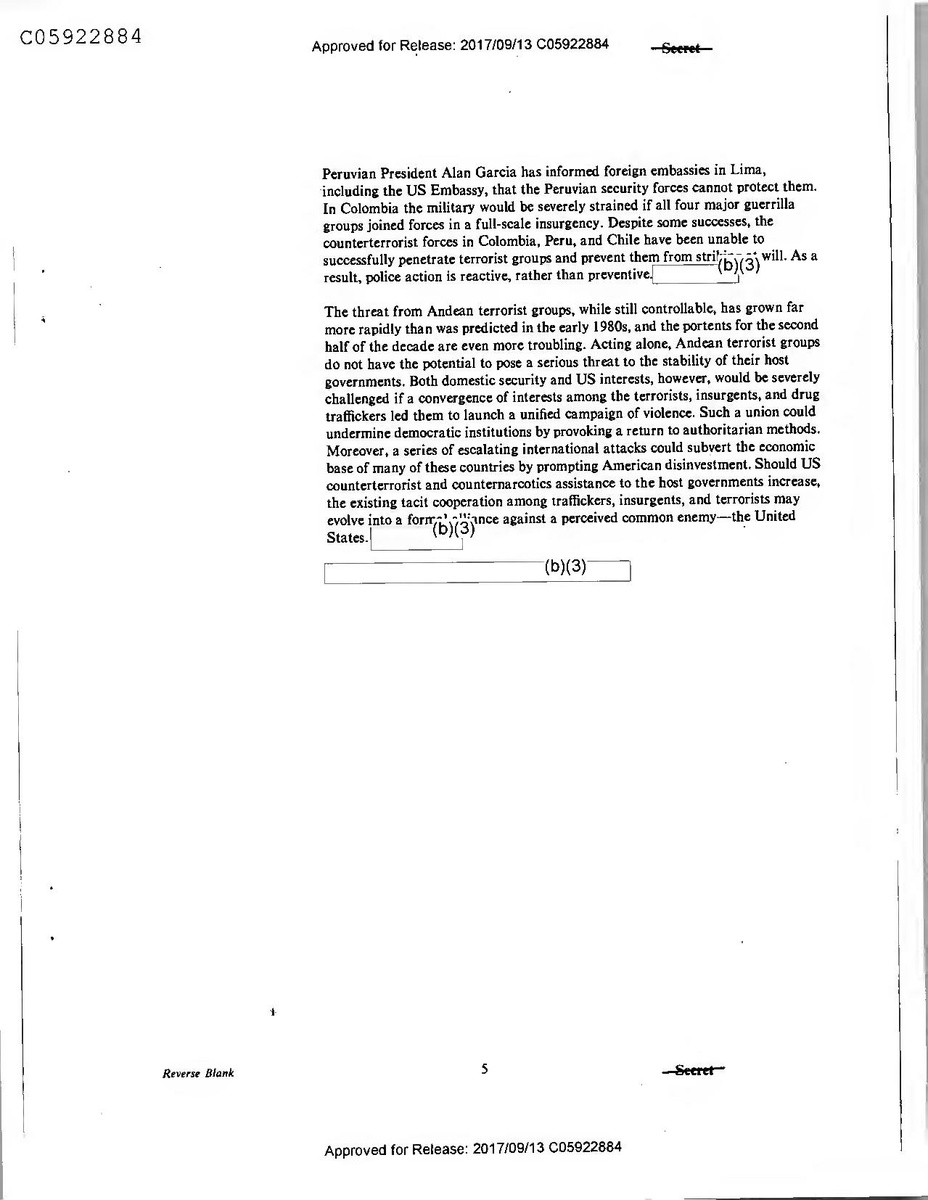
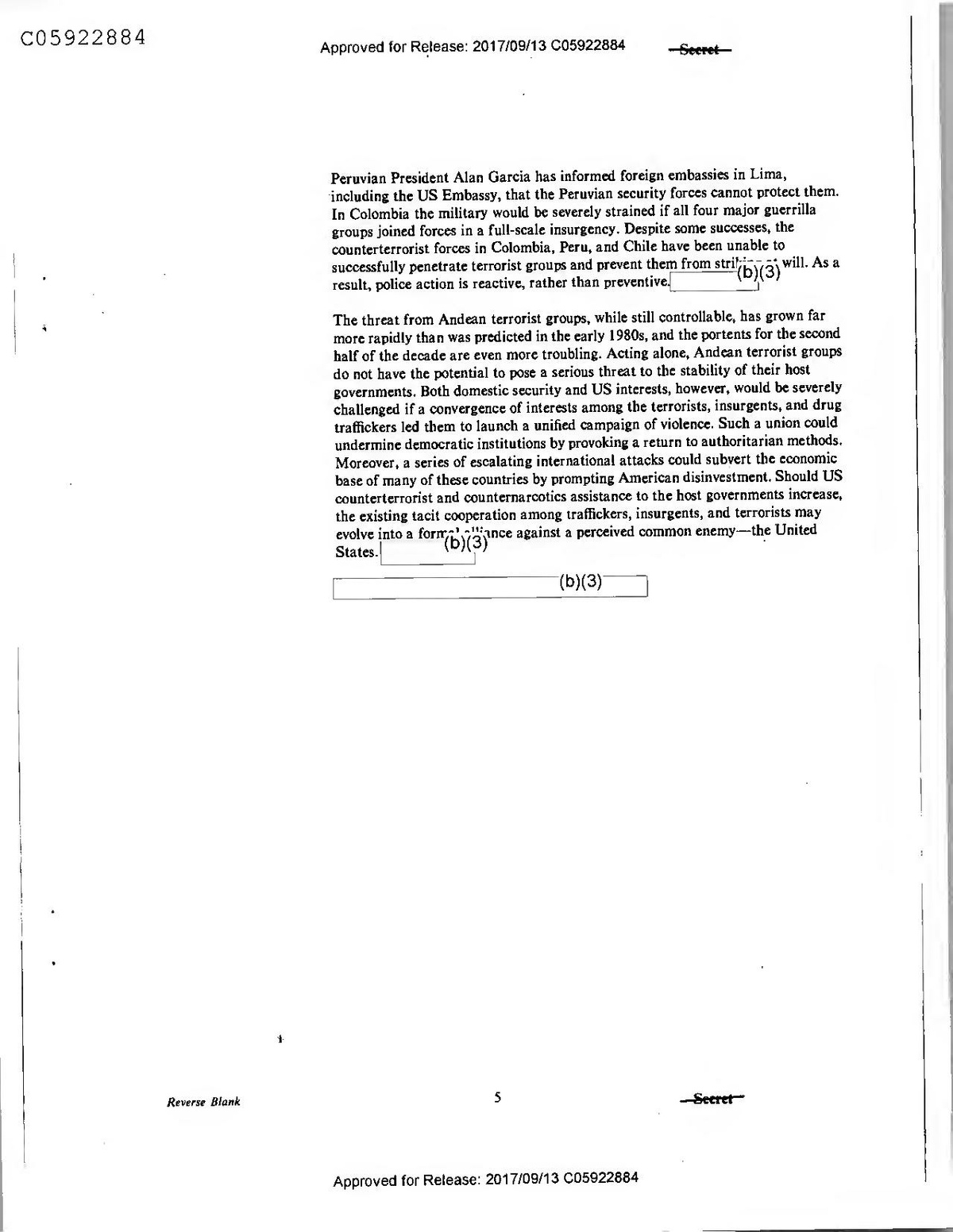
Peruvian President Alan Garcia has informed foreign embassies in Lima, including the US Embassy, that the Peruvian security forces cannot protect them. In Colombia the military would be severely strained if all four major guerrilla groups joined forces in a full-scale insurgency. Despite some successes, the counterterrorist forces in Colombia, Peru, and Chile have been unable to successfully penetrate terrorist groups and prevent them from stri!; in will. As a result, police action is reactive, rather than preventive.
"(b)(3)
The threat from Andean terrorist groups, while still controllable, has grown far more rapidly than was predicted in the early 1980s, and the portents for the second half of the decade are even more troubling. Acting alone, Andean terrorist groups do not have the potential to pose a serious threat to the stability of their host governments. Both domestic security and US interests, however, would be severely challenged if a convergence of interests among the terrorists, insurgents, and drug traffickers led them to launch a unified campaign of violence. Such a union could undermine democratic institutions by provoking a return to authoritarian methods. Moreover, a series of escalating international attacks could subvert the economic base of many of these countries by prompting American disinvestment. Should US counterterrorist and counternarcotics assistance to the host governments increase, the existing tacit cooperation among traffickers, insurgents, and terrorists may evolve into a formance against a perceived common enemy—the United States.
"(b)(3)
(b)(3)
Reverse Blank
5
Secret
Approved for Release: 2017/09/13 C05922884
(b)(3)
Highlights
Alert Item
France
Abdallah Conviction May Lead to Anti-US Attacks Georges Abdallah, leader of the Lebanese Armed Revolutionary Faction (LARF), was convicted on 28 February of complicity in the murders of an American attache and an Israeli diplomat in 1982 and an attempt on the US ConsUL General in 1984 in Strasbourg, and sentenced to life imprisonment. His conviction and the harsh sentence came as a surprise after the prosecutor had asked for a term of less than 10 years in order to spare France another wave of terrorism like the LARF bombing campaigns of March and September 1986. Paris is braced for new violence: more than 1,000 policemen brought into the capital for the trial have been kept on duty. LARF leaders vowed before the trial swift retaliation for any sentence and may move quickly against French interests and perhaps even US targets, since the United States was a highly visible civil party during the trial. We cannot assess the current capability of LARF or its allies-most notably the Popular Front for the Liberation of Palestine-Special Command and the Armenian Secret Army for the Liberation of Armenia—to stage indiscriminate bombings like those of last September, but if LARF cannot strike auickly in Europe, it may target French or US interest in Lebanon.[ (b)(3)]
Significant Developments
Western Europe
Belgium
Belgian Plans for Trevi Terrorism Policy Belgium assumed the six-month presidency of Europe's Trevi counterterrorism panel in January, and Justice Minister Jean Gol announced that his government's priorities would include: a permanent administrative structure, better information exchange among European Community countries, and closer coordination of political actions. He said that Trevi had formed an ad hoc group to work on the issues of illegal immigration, abuse of political asylum, and possibly international narcotics trafficking. Gol will be coming to the United States in early March for discussions before the next Trevi meeting on 28 April. (b)(3)
Finland
Government Rejects More Arab Refugees After high-level discussions, Helsinki decided in January to resist pressure from the United Nations High Commissioner on Refugees to allow more refugees from Iran and the Arab world into its country. President Koivisto and Prime Minister Sorsa agreed with a government assessment that frictions generated by the influx of additional refugees from these areas would create a threat of terrorist activity
7
Sooret
DI TR 87-004 26 February 1987
Approved for Release: 2017/09/13 C05922884
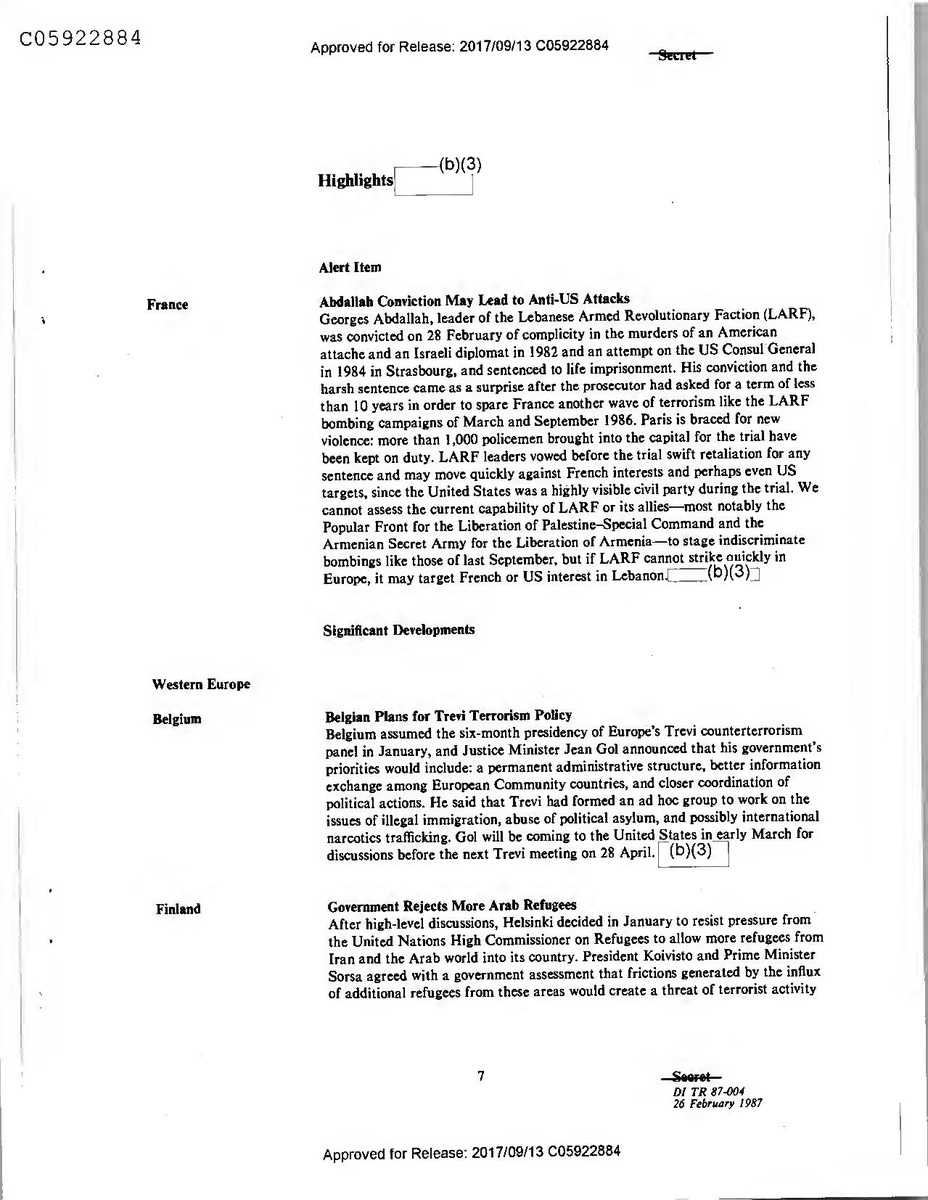
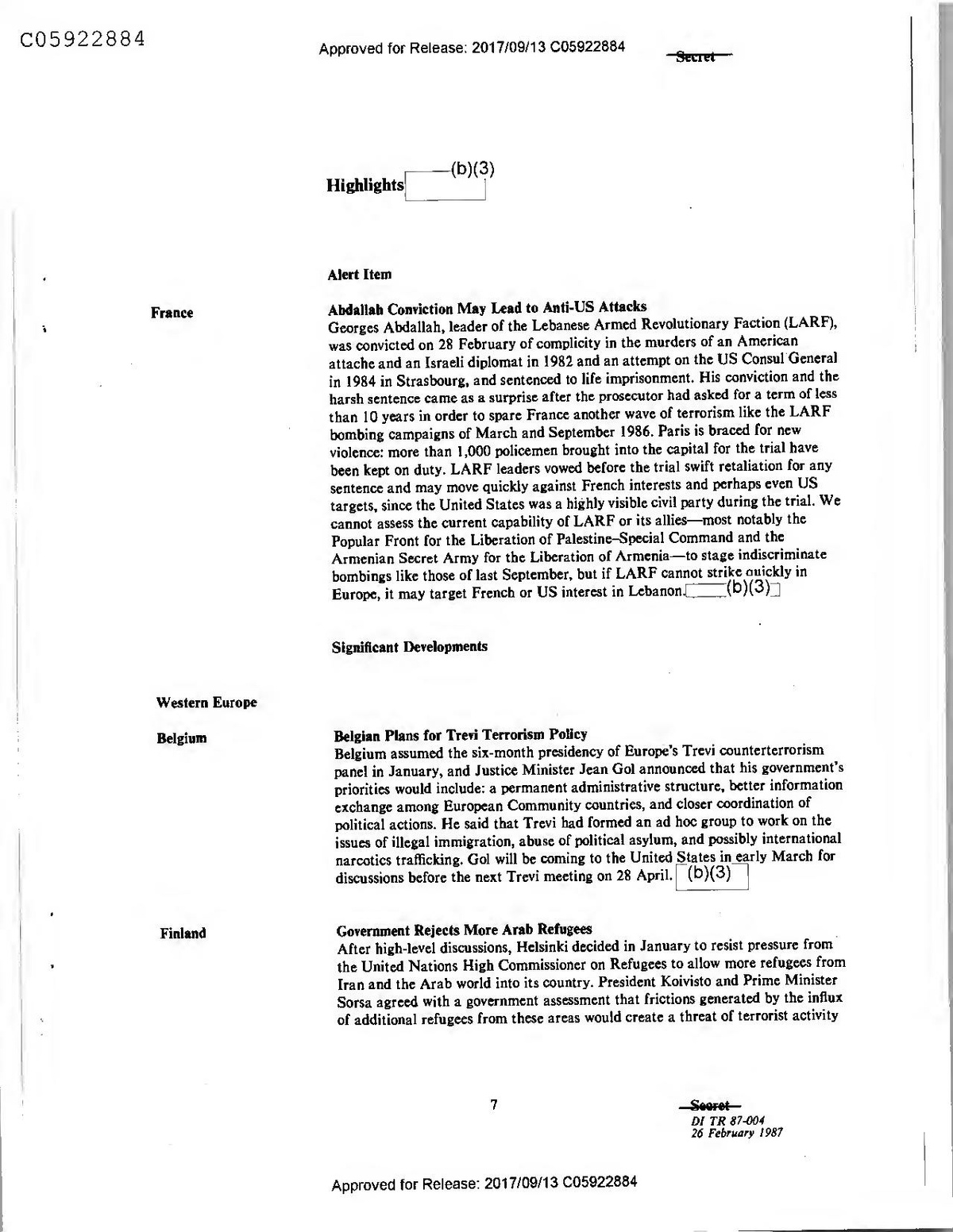
(b)(3)
Highlights
Alert Item
France
Abdallah Conviction May Lead to Anti-US Attacks Georges Abdallah, leader of the Lebanese Armed Revolutionary Faction (LARF), was convicted on 28 February of complicity in the murders of an American attache and an Israeli diplomat in 1982 and an attempt on the US ConsUL General in 1984 in Strasbourg, and sentenced to life imprisonment. His conviction and the harsh sentence came as a surprise after the prosecutor had asked for a term of less than 10 years in order to spare France another wave of terrorism like the LARF bombing campaigns of March and September 1986. Paris is braced for new violence: more than 1,000 policemen brought into the capital for the trial have been kept on duty. LARF leaders vowed before the trial swift retaliation for any sentence and may move quickly against French interests and perhaps even US targets, since the United States was a highly visible civil party during the trial. We cannot assess the current capability of LARF or its allies-most notably the Popular Front for the Liberation of Palestine-Special Command and the Armenian Secret Army for the Liberation of Armenia—to stage indiscriminate bombings like those of last September, but if LARF cannot strike auickly in Europe, it may target French or US interest in Lebanon.[ (b)(3)]
Significant Developments
Western Europe
Belgium
Belgian Plans for Trevi Terrorism Policy Belgium assumed the six-month presidency of Europe's Trevi counterterrorism panel in January, and Justice Minister Jean Gol announced that his government's priorities would include: a permanent administrative structure, better information exchange among European Community countries, and closer coordination of political actions. He said that Trevi had formed an ad hoc group to work on the issues of illegal immigration, abuse of political asylum, and possibly international narcotics trafficking. Gol will be coming to the United States in early March for discussions before the next Trevi meeting on 28 April. (b)(3)
Finland
Government Rejects More Arab Refugees After high-level discussions, Helsinki decided in January to resist pressure from the United Nations High Commissioner on Refugees to allow more refugees from Iran and the Arab world into its country. President Koivisto and Prime Minister Sorsa agreed with a government assessment that frictions generated by the influx of additional refugees from these areas would create a threat of terrorist activity
7
Sooret
DI TR 87-004 26 February 1987
Approved for Release: 2017/09/13 C05922884
the government would have difficulty handling. In 1986, as a result of their perception of an increased threat from international terrorism, the Finnish Parliament increased funding for the security police for 1986 and 1988–omitting 1987. This recent assessment suggests the threat has overtaken the financial initiatives originally proposed to deal with it. Finland's Nordic neighbors also have taken steps to curtail the increasing movement of refugees into the region. Their efforts, however, have sprung principally from a desire to control the economic, social, and administrative problems created by the immigrants, rather than fear of a rising terrorist threat.
(b)(3)]
France
Muslim Brotherhood Arms Cache Uncovered On 18 December, agents of the internal security service, DST, raided the home of a Lebanese citizen and recovered a large cache of weapons and explosives belonging to the Muslim Brotherhood. The owner of the house had left the country two weeks earlier, but his Syrian wife, two other Syrians, three Jordanians, a naturalized French citizen, and his Lebanese brother were taken into custody. Seized in the raid were 30 kilograms of a plastic explosive, 51 detonators, four Soviet-type handgrenades, and ammunition and small arms of various kinds. The suspects denied any knowledge of the cache, admitting only that they belonged to an Islamic student association in Toulouse.
(b)(3)
Ties Among Three European Terrorist Groups? On 24 December, Paris police arrested three Italian terrorists after investigating an arms cache of the Basque separatist group Fatherland and Liberty-Military Wing (ETA-M). Police were following a suspected Action Directe (AD) member when he met with three Italians from the largely inactive Prima Linea group. The arrests were made as the trio prepared to leave France with materials for ETA-M's Madrid Commando. Police recovered an electronic scanner, false
(b)(3) passports, and more than $10,000 in six European currencies
money and
Spanish authorities believe that the Madrid Commando-hurt by Spanish police sweeps late last year—was attempting to find new sources of
weapons. Similarly, AD is under great pressure from French police and may have hoped to trade the seized items to ETA-M in exchange for safehaven or a support base in Spain. We do not yet know how Prima Linea is involved. AD has links to West German and Belgian groups, but there is no evidence as yet to suggest that the arrests were part of a larger “Euroterrorist" framework.
(b)(3)
Italy
Early Release of Terrorist Suspects May Slow A new law passed late last year to combat organized crime may have beneficial effects on Italy's war on terrorism as well. The law was enacted in reaction to an earlier statute that allowed dangerous suspects to go free before their trials came up. Over 40 terrorists took advantage of the early release program and disappeared before trial. The new law would allow 18 months of pretrial confinement for certain crimes and another 18 months during a trial. Acquitted suspects could continue to be held for a year during appeals.
(b)(3)
Secret
8
Approved for Release: 2017/09/13 C05922884
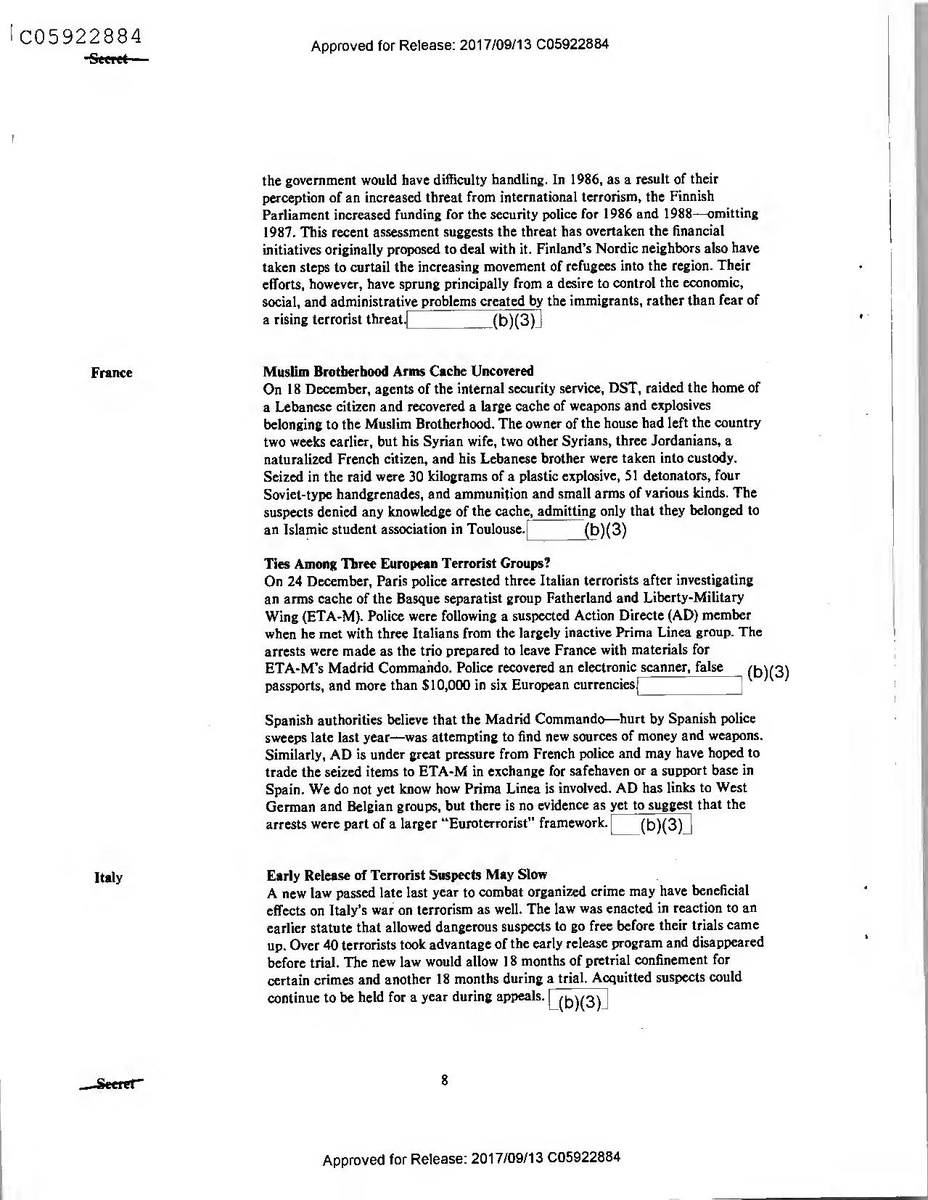
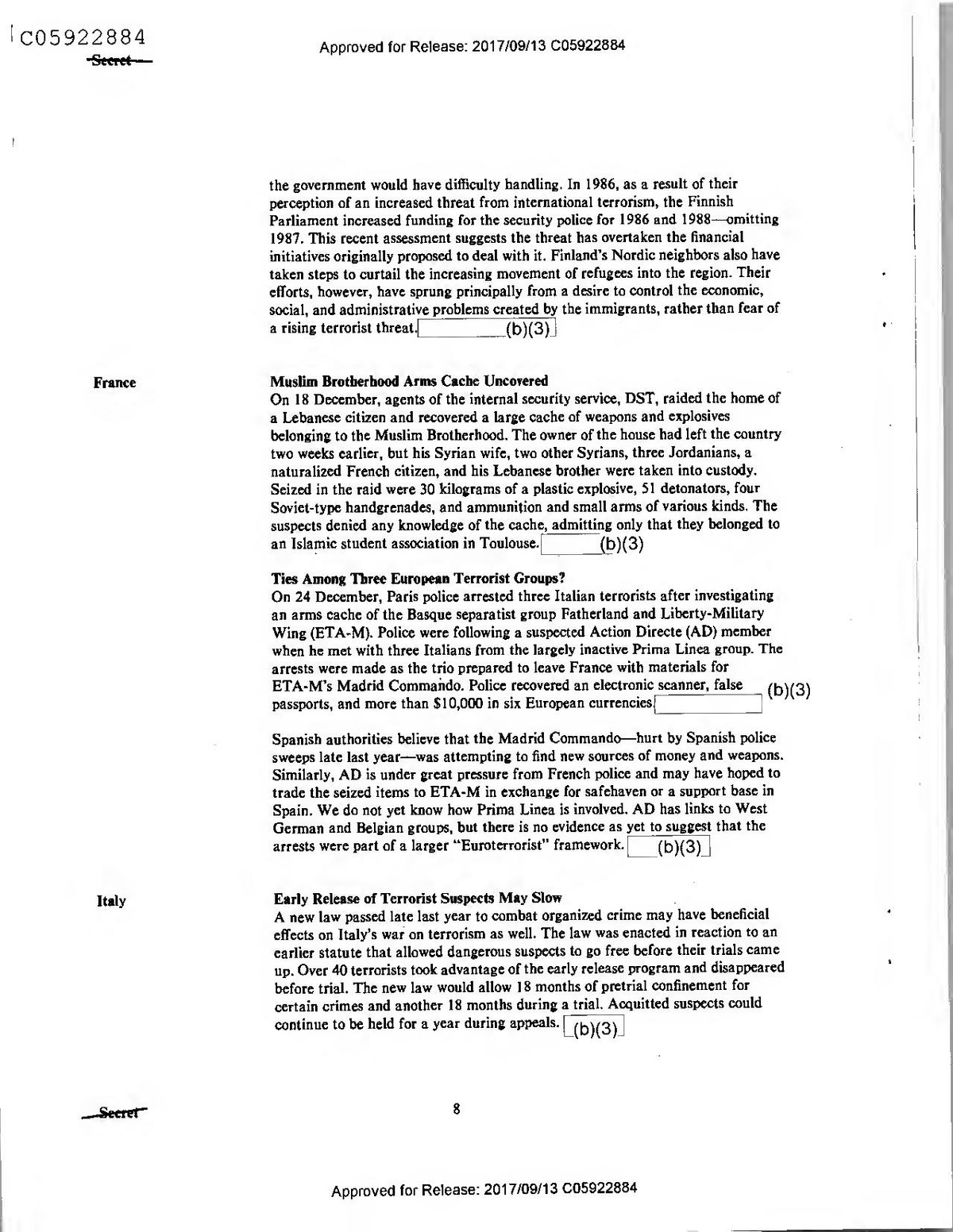
the government would have difficulty handling. In 1986, as a result of their perception of an increased threat from international terrorism, the Finnish Parliament increased funding for the security police for 1986 and 1988–omitting 1987. This recent assessment suggests the threat has overtaken the financial initiatives originally proposed to deal with it. Finland's Nordic neighbors also have taken steps to curtail the increasing movement of refugees into the region. Their efforts, however, have sprung principally from a desire to control the economic, social, and administrative problems created by the immigrants, rather than fear of a rising terrorist threat.
(b)(3)]
France
Muslim Brotherhood Arms Cache Uncovered On 18 December, agents of the internal security service, DST, raided the home of a Lebanese citizen and recovered a large cache of weapons and explosives belonging to the Muslim Brotherhood. The owner of the house had left the country two weeks earlier, but his Syrian wife, two other Syrians, three Jordanians, a naturalized French citizen, and his Lebanese brother were taken into custody. Seized in the raid were 30 kilograms of a plastic explosive, 51 detonators, four Soviet-type handgrenades, and ammunition and small arms of various kinds. The suspects denied any knowledge of the cache, admitting only that they belonged to an Islamic student association in Toulouse.
(b)(3)
Ties Among Three European Terrorist Groups? On 24 December, Paris police arrested three Italian terrorists after investigating an arms cache of the Basque separatist group Fatherland and Liberty-Military Wing (ETA-M). Police were following a suspected Action Directe (AD) member when he met with three Italians from the largely inactive Prima Linea group. The arrests were made as the trio prepared to leave France with materials for ETA-M's Madrid Commando. Police recovered an electronic scanner, false
(b)(3) passports, and more than $10,000 in six European currencies
money and
Spanish authorities believe that the Madrid Commando-hurt by Spanish police sweeps late last year—was attempting to find new sources of
weapons. Similarly, AD is under great pressure from French police and may have hoped to trade the seized items to ETA-M in exchange for safehaven or a support base in Spain. We do not yet know how Prima Linea is involved. AD has links to West German and Belgian groups, but there is no evidence as yet to suggest that the arrests were part of a larger “Euroterrorist" framework.
(b)(3)
Italy
Early Release of Terrorist Suspects May Slow A new law passed late last year to combat organized crime may have beneficial effects on Italy's war on terrorism as well. The law was enacted in reaction to an earlier statute that allowed dangerous suspects to go free before their trials came up. Over 40 terrorists took advantage of the early release program and disappeared before trial. The new law would allow 18 months of pretrial confinement for certain crimes and another 18 months during a trial. Acquitted suspects could continue to be held for a year during appeals.
(b)(3)
Secret
8
Approved for Release: 2017/09/13 C05922884
Sweden
Kurdish Arrests for Palme Killing Prove To Be False Alarm Swedish officials investigating the assassination in February 1986 of Prime Minister Olof Palme detained over 20 Kurdish Workers' Party (PKK) members on 12 December 1986 and 20 January 1987. This latest in a number of PKK roundups, however, again failed to reveal evidence linking the group to the killing. Three of the Kurds arrested in December are being held for possible complicity in the murder of a PKK defector in November 1985; the rest were released. I 1(b)(3)
So far, only circumstantial evidence links the PKK, a violent Kurdish separatist group, to the assassination. Clashes between Stockholm Police Chief Hans Holmer and Government Prosecutor Claes Zeime over the conduct of the investigation have been detrimental to the progress of the case: Holmer has been obsessed with the PKK at the expense of other leads. As a result, he was removed from the case on 4 February when the Swedish Government announced that responsibility for the investigation would be moved to the national level. (b)(3)
(b)(3) (b)(1)
West Germany
Kurdish Terrorist Suspect Released Kurdish Workers' Party (PKK) member Faruk Bozkurt's release from pretrial confinement on 27 November 1986 is an indication that charges against him probably have been dropped. German officials had information that the PKK was planning to bomb the Turkish Consulate in Hamburg last August and believed Bozkurt was linked to the plot. Freeing Bozkurt may enable West Germany to
9
Secret
Approved for Release: 2017/09/13 C05922884
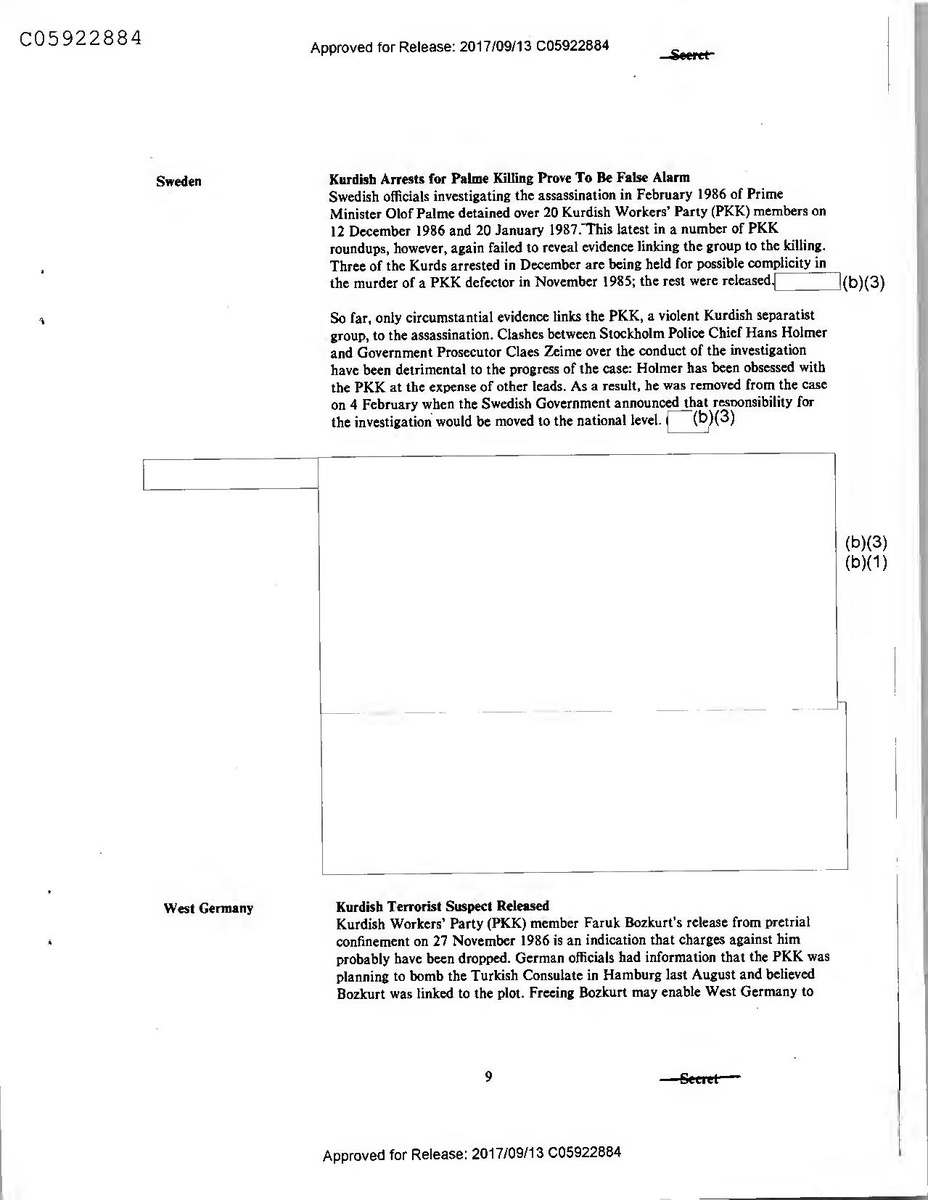
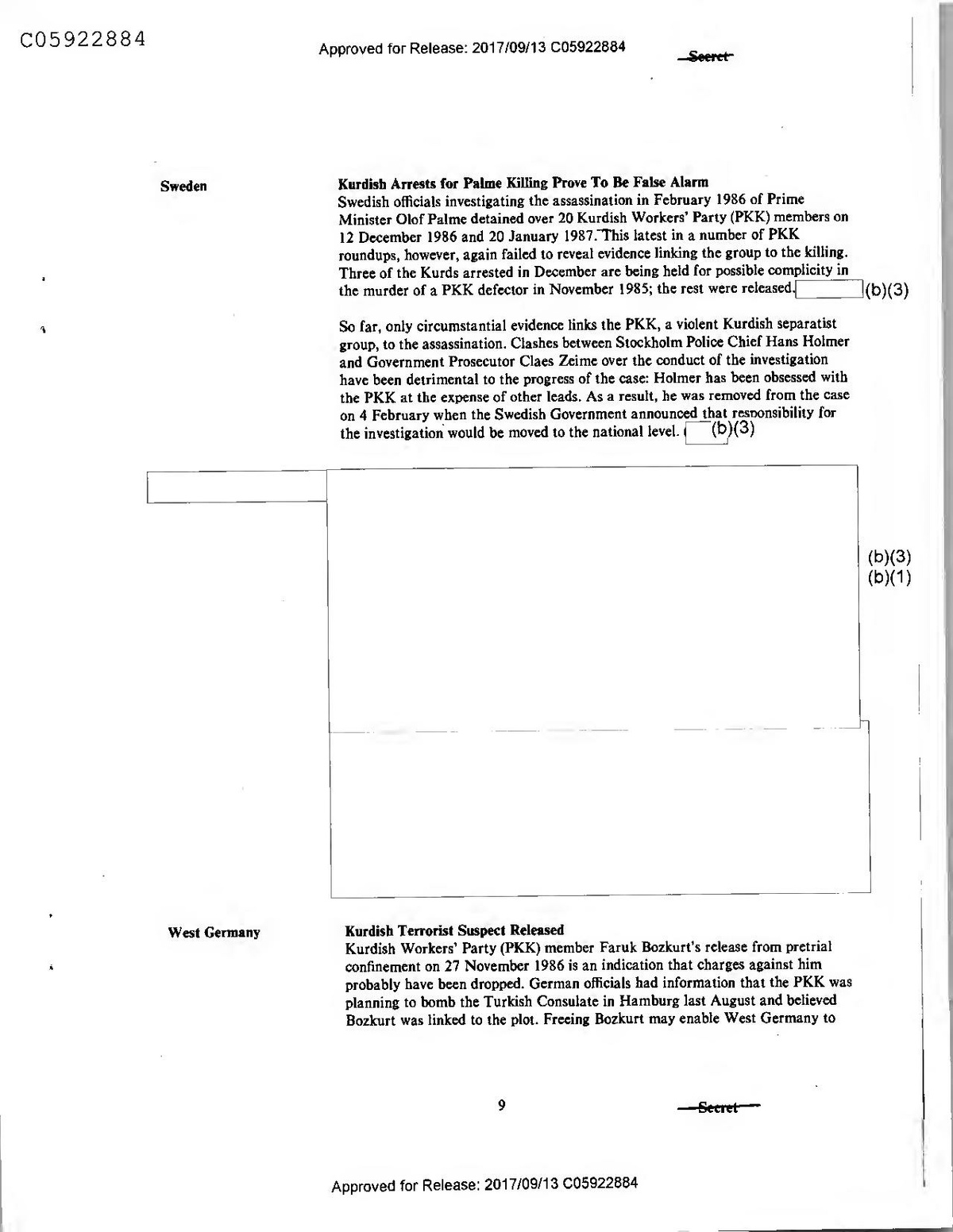
Sweden
Kurdish Arrests for Palme Killing Prove To Be False Alarm Swedish officials investigating the assassination in February 1986 of Prime Minister Olof Palme detained over 20 Kurdish Workers' Party (PKK) members on 12 December 1986 and 20 January 1987. This latest in a number of PKK roundups, however, again failed to reveal evidence linking the group to the killing. Three of the Kurds arrested in December are being held for possible complicity in the murder of a PKK defector in November 1985; the rest were released. I 1(b)(3)
So far, only circumstantial evidence links the PKK, a violent Kurdish separatist group, to the assassination. Clashes between Stockholm Police Chief Hans Holmer and Government Prosecutor Claes Zeime over the conduct of the investigation have been detrimental to the progress of the case: Holmer has been obsessed with the PKK at the expense of other leads. As a result, he was removed from the case on 4 February when the Swedish Government announced that responsibility for the investigation would be moved to the national level. (b)(3)
(b)(3) (b)(1)
West Germany
Kurdish Terrorist Suspect Released Kurdish Workers' Party (PKK) member Faruk Bozkurt's release from pretrial confinement on 27 November 1986 is an indication that charges against him probably have been dropped. German officials had information that the PKK was planning to bomb the Turkish Consulate in Hamburg last August and believed Bozkurt was linked to the plot. Freeing Bozkurt may enable West Germany to
9
Secret
Approved for Release: 2017/09/13 C05922884
avoid possible retaliation from the PKK, which has a sizable presence there. The PKK staged demonstrations in Germany, the Netherlands, and France last fall protesting the Kurd's detention. (b)(3)
Middle East
Kuwait
(b)(3) (b)(1)
In late January and early February, Kuwait announced the arrests of 12 suspects and the discovery of several arms caches. Kuwaiti officials claim that some of the weapons—which included Soviet, Israeli, and US weapons, and devices for time bombs-can be traced to Iran. They also say that some of those arrested had traveled frequently to Iran
(b)(3) (b)(1)
This is the first evidence that Iran was directly involved in the Kuwait bombings.
(b)(1)
The assistance also demonstrates Iran's continued willingness to use selected acts of terrorism to support its foreign policy objectives—in this case to undermine the Islamic summit held in Kuwait in January. Iran has other terrorist assets in Kuwait and elsewhere in the Persian Gulf that it could use to further the export of the Islamic revolution or the destabilization of the Sunni Gulf regimes.
(b)(3)
Kuwait is unlikely to break relations with Iran over the incident, but it could withdraw its representative from Tehran to protest Iran's blatant support for terrorism. The arrests are likely to heighten sectarian tensions in Kuwait, where Shias constitute one-third of the native population
(b)(3)
Lebanon
Hizballah Center Target of Car Bombing A car bomb exploded on 9 February in the Rweis district of West Beirut, killing 15 persons and injuring 80 others. The blast was timed to coincide with students leaving school and employees leaving their offices, when the area was crowded with lunch-hour traffic. An automobile packed with 165 pounds of TNT mixed with hexogen, a highly explosive liquefied gas, detonated near Hizballah's main center in the area. Bodies were charred and mutilated by the explosion, which started fires, damaged shops and apartments in a 500-yard radius, and left a twisted wreckage of 10 cars. The Shia Amal militia has accused PLO leader Yasir Arafat of engineering the bombing. (b)(3)
Aide to Gemayel Kidnaped and Released Jean Ubayd, a prominent Lebanese Christian aide to President Gemayel, was kidnaped 12 February in West Beirut by nine armed gunmen. Ubayd's driver was
10
Approved for Release: 2017/09/13 C05922884
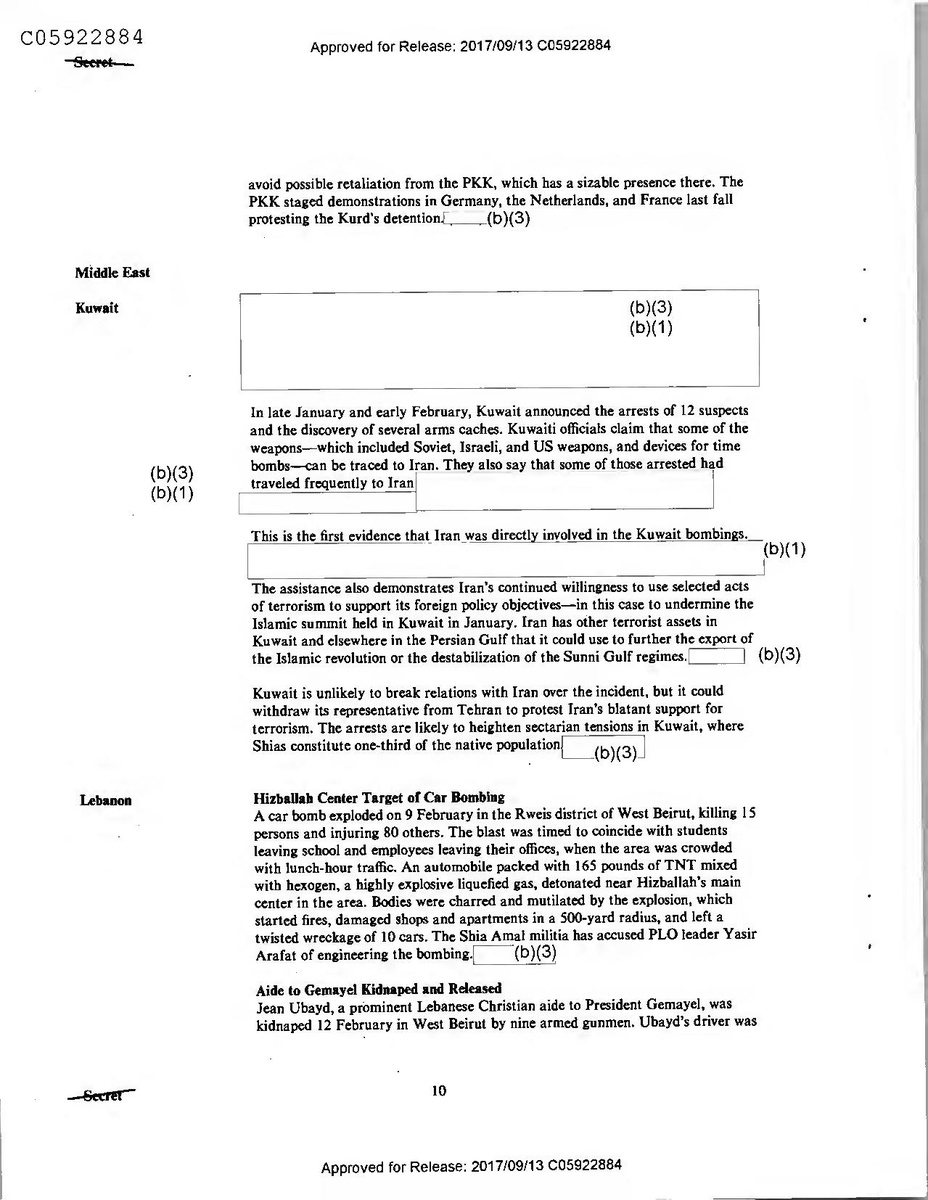
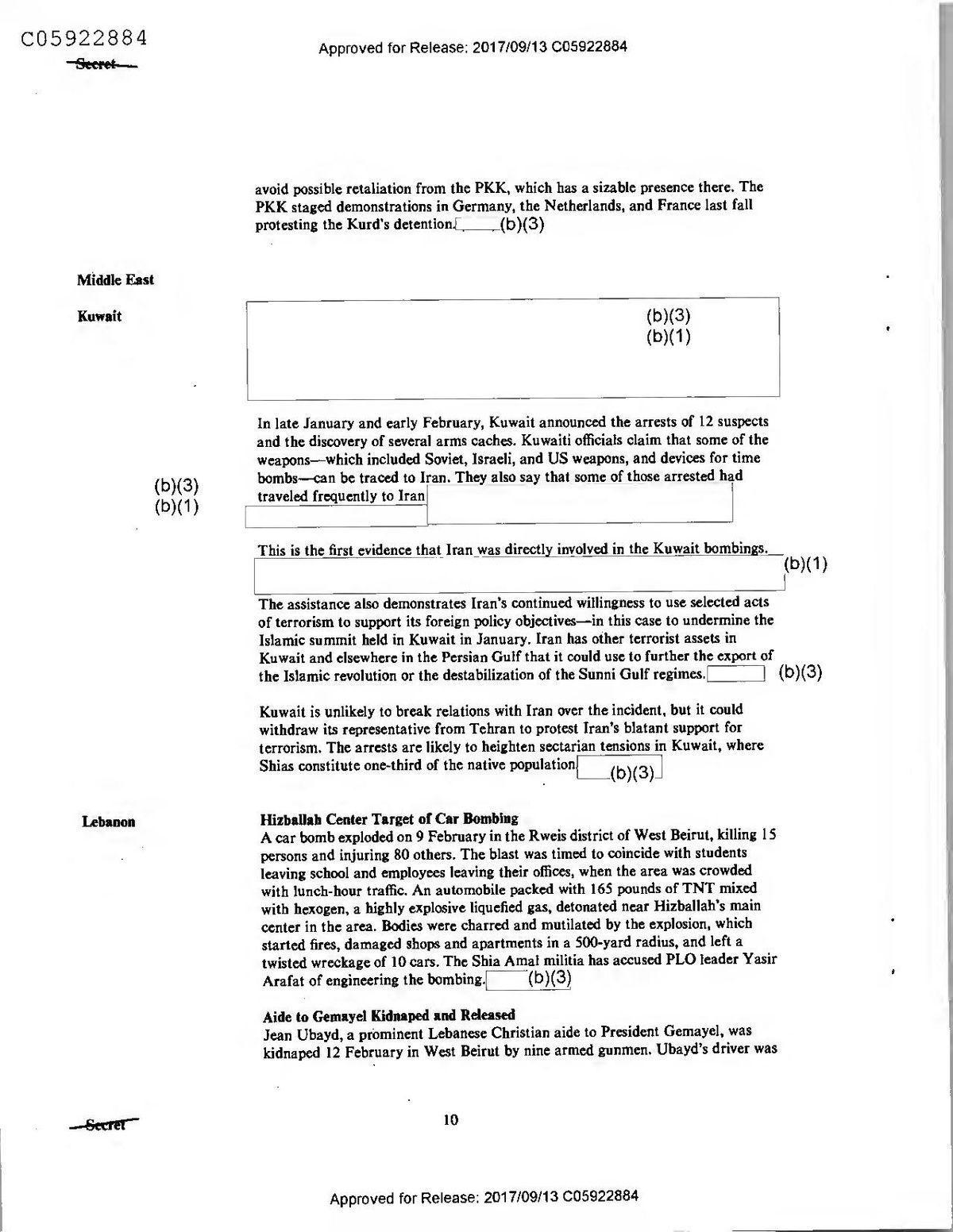
avoid possible retaliation from the PKK, which has a sizable presence there. The PKK staged demonstrations in Germany, the Netherlands, and France last fall protesting the Kurd's detention. (b)(3)
Middle East
Kuwait
(b)(3) (b)(1)
In late January and early February, Kuwait announced the arrests of 12 suspects and the discovery of several arms caches. Kuwaiti officials claim that some of the weapons—which included Soviet, Israeli, and US weapons, and devices for time bombs-can be traced to Iran. They also say that some of those arrested had traveled frequently to Iran
(b)(3) (b)(1)
This is the first evidence that Iran was directly involved in the Kuwait bombings.
(b)(1)
The assistance also demonstrates Iran's continued willingness to use selected acts of terrorism to support its foreign policy objectives—in this case to undermine the Islamic summit held in Kuwait in January. Iran has other terrorist assets in Kuwait and elsewhere in the Persian Gulf that it could use to further the export of the Islamic revolution or the destabilization of the Sunni Gulf regimes.
(b)(3)
Kuwait is unlikely to break relations with Iran over the incident, but it could withdraw its representative from Tehran to protest Iran's blatant support for terrorism. The arrests are likely to heighten sectarian tensions in Kuwait, where Shias constitute one-third of the native population
(b)(3)
Lebanon
Hizballah Center Target of Car Bombing A car bomb exploded on 9 February in the Rweis district of West Beirut, killing 15 persons and injuring 80 others. The blast was timed to coincide with students leaving school and employees leaving their offices, when the area was crowded with lunch-hour traffic. An automobile packed with 165 pounds of TNT mixed with hexogen, a highly explosive liquefied gas, detonated near Hizballah's main center in the area. Bodies were charred and mutilated by the explosion, which started fires, damaged shops and apartments in a 500-yard radius, and left a twisted wreckage of 10 cars. The Shia Amal militia has accused PLO leader Yasir Arafat of engineering the bombing. (b)(3)
Aide to Gemayel Kidnaped and Released Jean Ubayd, a prominent Lebanese Christian aide to President Gemayel, was kidnaped 12 February in West Beirut by nine armed gunmen. Ubayd's driver was
10
Approved for Release: 2017/09/13 C05922884
Secret
Spain
(b)(1) (b)(3)
Palestinian Group Threatens Spanish Interests A Palestinian group called the “Organization of the Sons of the Martyrs of Tal alZa'tar” threatened to attack Spanish interests if two Palestinian prisoners held there were not released within two weeks. The group issued the threat to retaliate in Spain and elsewhere in broadcast from West Beirut on 18 February.
the two Palestinians were arrested in connection with the murder of two Israeli seamen in Barcelona last October.
"(b)(3)
"Martyrs of Tal al-Za'tar" is believed to be a covername for Fatah's Force 17. This group sent a letter to the Swiss Ambassador in London threatening reprisals if the Swiss did not release two Palestinians held in Geneva. The two Swiss prisoners are probably Force 17 members who were arrested in a safehouse in Madrid last July. Press reports indicate that the two were planning to attack the Syrian Ambassador or Embassy in Madrid.
(b)(3)
Sweden
No Apparent Progress in Palme Assassination Swedish police on 12 March arrested Viktor Gunnarsson, a 32-year-old Swede, and attempted to indict him in connection with the 28 February assassination of Prime Minister Palme. According to press reports, Gunnarsson once belonged to the European Labor Party, a staunchly anti-Soviet and anti-Palme fringe political group. The party said it cut all ties with Gunnarsson in May 1985 "after noticing some unbalanced features.” The police were unable to hold him past the initial five days allowed under Swedish law, however, and, when witnesses could not identify him, he was released. There have been no other arrests in the case, and we are unable to state conclusively either that his murder was an act of terrorism or that there was any foreign involvement. (b)(3)
West Germany
(b)(1) (b)(3)
9
Secret
Approved for Release: 2017/09/13 C05632837
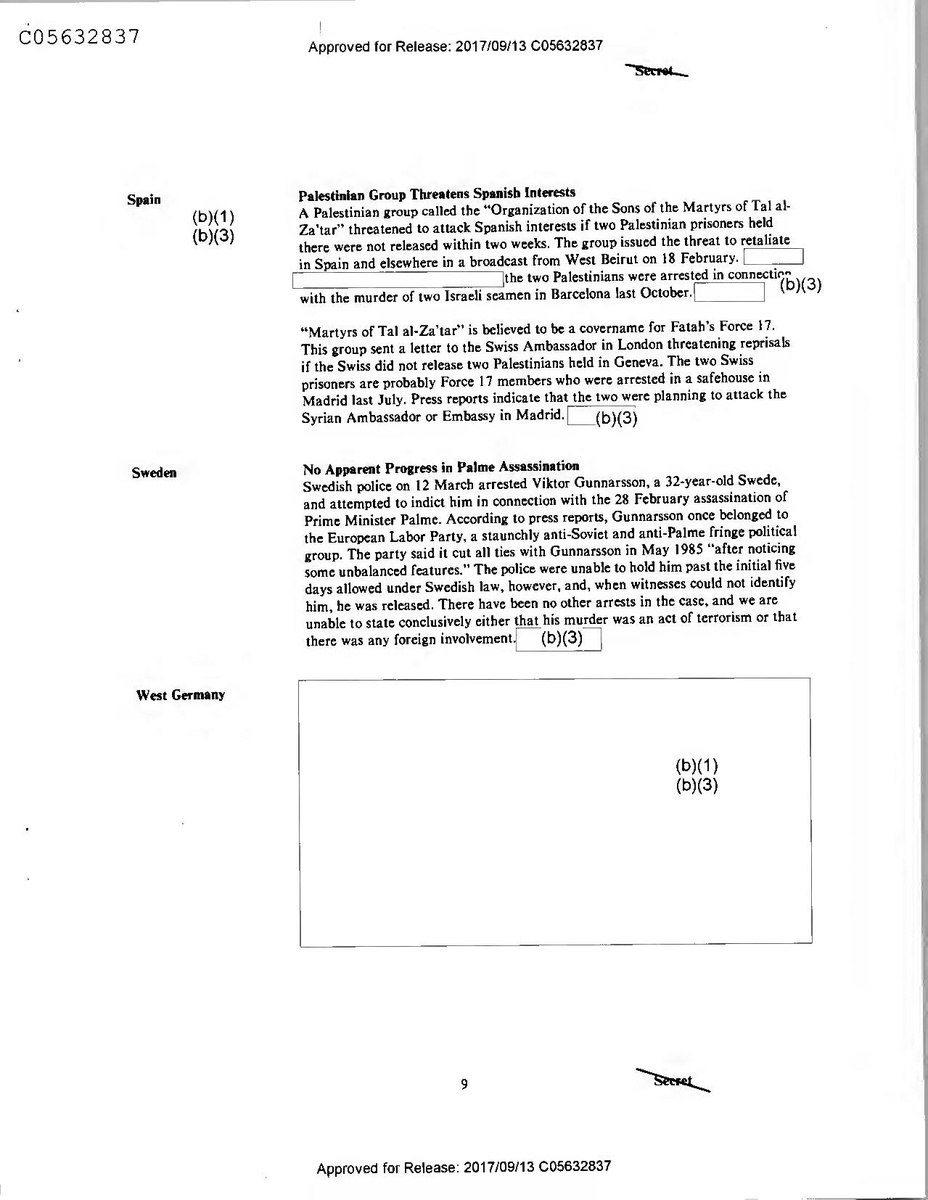
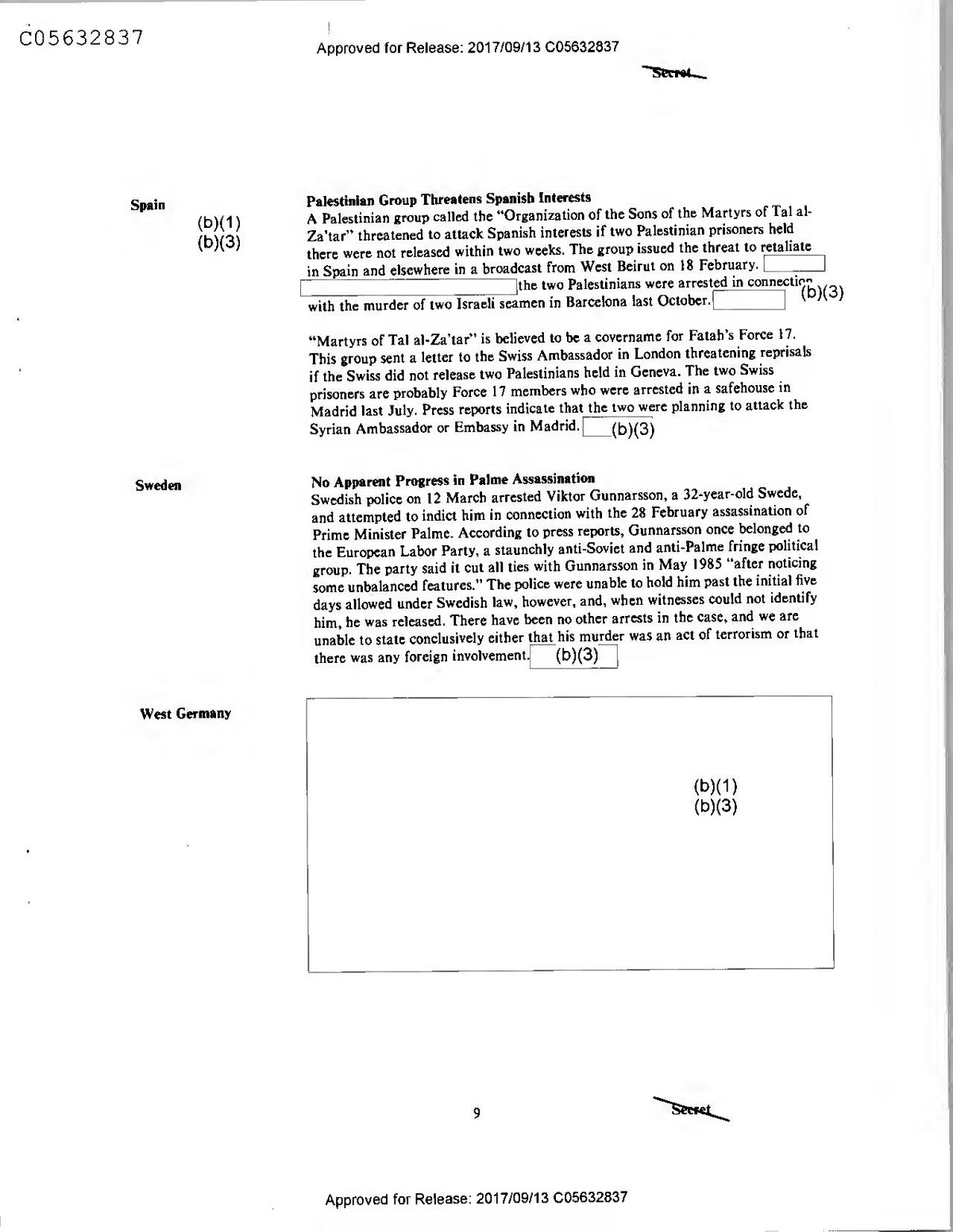
Secret
Spain
(b)(1) (b)(3)
Palestinian Group Threatens Spanish Interests A Palestinian group called the “Organization of the Sons of the Martyrs of Tal alZa'tar” threatened to attack Spanish interests if two Palestinian prisoners held there were not released within two weeks. The group issued the threat to retaliate in Spain and elsewhere in broadcast from West Beirut on 18 February.
the two Palestinians were arrested in connection with the murder of two Israeli seamen in Barcelona last October.
"(b)(3)
"Martyrs of Tal al-Za'tar" is believed to be a covername for Fatah's Force 17. This group sent a letter to the Swiss Ambassador in London threatening reprisals if the Swiss did not release two Palestinians held in Geneva. The two Swiss prisoners are probably Force 17 members who were arrested in a safehouse in Madrid last July. Press reports indicate that the two were planning to attack the Syrian Ambassador or Embassy in Madrid.
(b)(3)
Sweden
No Apparent Progress in Palme Assassination Swedish police on 12 March arrested Viktor Gunnarsson, a 32-year-old Swede, and attempted to indict him in connection with the 28 February assassination of Prime Minister Palme. According to press reports, Gunnarsson once belonged to the European Labor Party, a staunchly anti-Soviet and anti-Palme fringe political group. The party said it cut all ties with Gunnarsson in May 1985 "after noticing some unbalanced features.” The police were unable to hold him past the initial five days allowed under Swedish law, however, and, when witnesses could not identify him, he was released. There have been no other arrests in the case, and we are unable to state conclusively either that his murder was an act of terrorism or that there was any foreign involvement. (b)(3)
West Germany
(b)(1) (b)(3)
9
Secret
Approved for Release: 2017/09/13 C05632837
wounded in the attack. Ubayd, who had ties to Syria at least until recently, apparently considers himself a successor tSizjayel when the Lebanese President's term expires next year.!
Islamic Jihad, a covername usually used by Hizballah elements in Lebanon, claimed responsibility for the attack and threatened to kill Ubayd. He was released on 16 February, after Syria reportedly intervened against the clan that kidnaped him in an interfamily Lebanese dispute. (b)(3)
South/East Asia
Australia
Melbourne Consulate Bombing: Additional Details Australian officials reportedly doubt the existence of the so-called GreekBulgarian-Armenian Front that took credit for a car bomb attack on the Turkish Consulate General in Melbourne, Australia, on 23 November 1986. All the prime suspects in the case reportedly have ties to the Justice Commandos of the Armenian Genocide (JCAG), a rightwing Armenian terrorist group; nevertheless, Australian officials still believe the bombing was carried out independently from JCAG's command structure. Authorities have uncovered the following details concerning the attack, which killed the bomber—later identified as an Armenian—and damaged the building housing the consulate: • The suspect being held for the bombing, an Armenian named Levon Demirian,
was interrogated in connection with the assassination of the Turkish ConsUL
General in Sydney in 1980, for which JCAG claimed responsibility. • Australian authorities believe that Levon's brother, Hovannes “Jano"
Demirian-an explosives expert-could have built the Melbourne bomb, but so far they have not connected him to either the car bomb or to the explosives found in the Demirian family's restaurant in a police raid after the attack. (b)(3)
Africa
Somalia
Somali Dissidents To Continue Kidnaping Foreigners? On 7 February Ethiopia handed over to French authorities 10 French aid workers who were kidnaped by Somali rebels. The doctors and nurses, who worked for the French relief organization Medecins Sans Frontieres, were kidnaped in January by members of the Somali National Movement (SNM) at an Ethiopian refugee camp in northwestern Somalia. The SNM took its French hostages across the border into Ethiopia, where it subsequently released them to authorities there. An SNM press release stated that the Somali refugee camps are used as a "recruiting ground" for the Somali military and security agencies. The press release stated further that international assistance given to the refugees in these camps is used to finance terror and oppression against the civilian population. It warned that foreigners remaining in Somalia cannot be guaranteed security. The US Embassy in Mogadishu believes it would not be difficult for the SNM to continue kidnaping foreign workers at refugee camps in Somalia because these workers are often reluctant to take security measures, probably in the belief that the humanitarian nature of their work protects them. (b)(3)
Secret
Approved for Release: 2017/09/13 C05922884
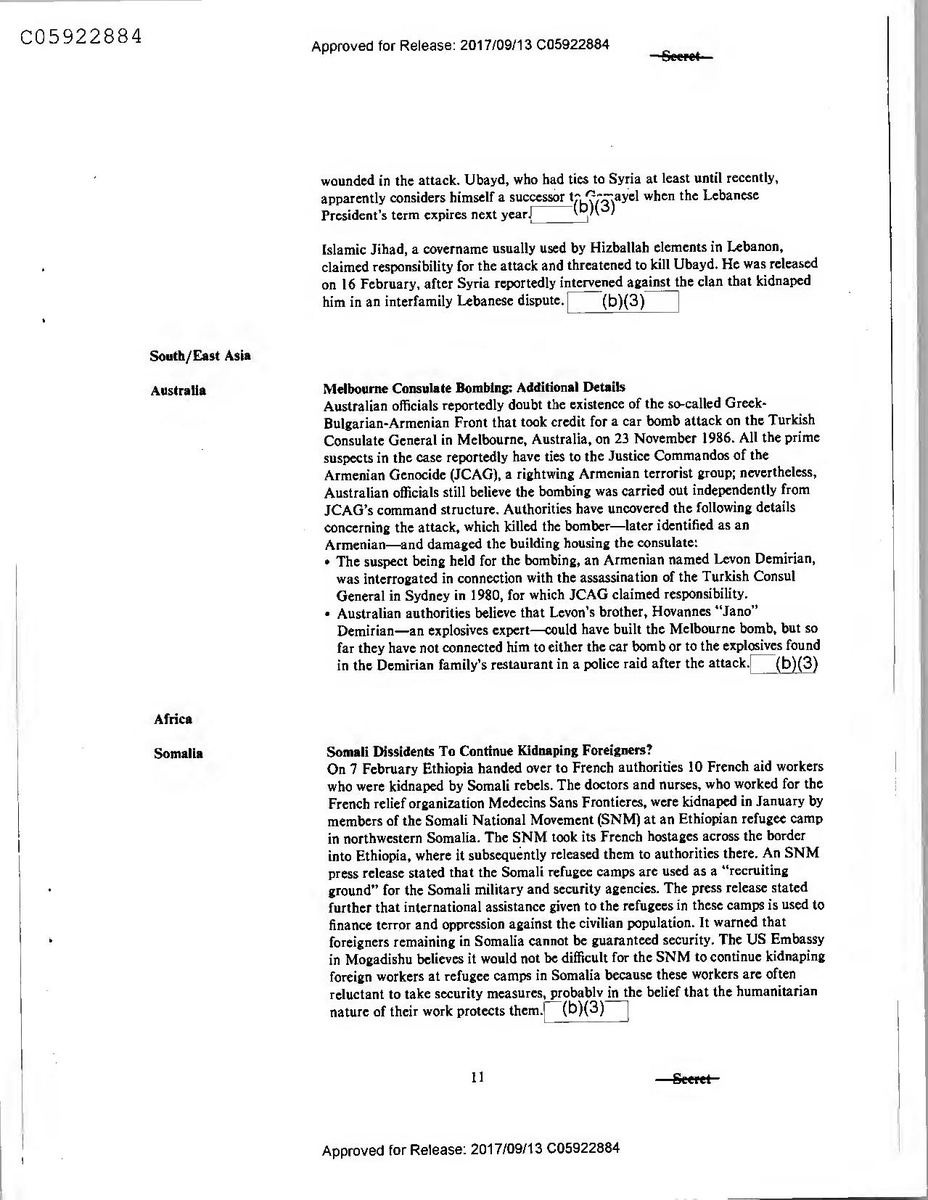
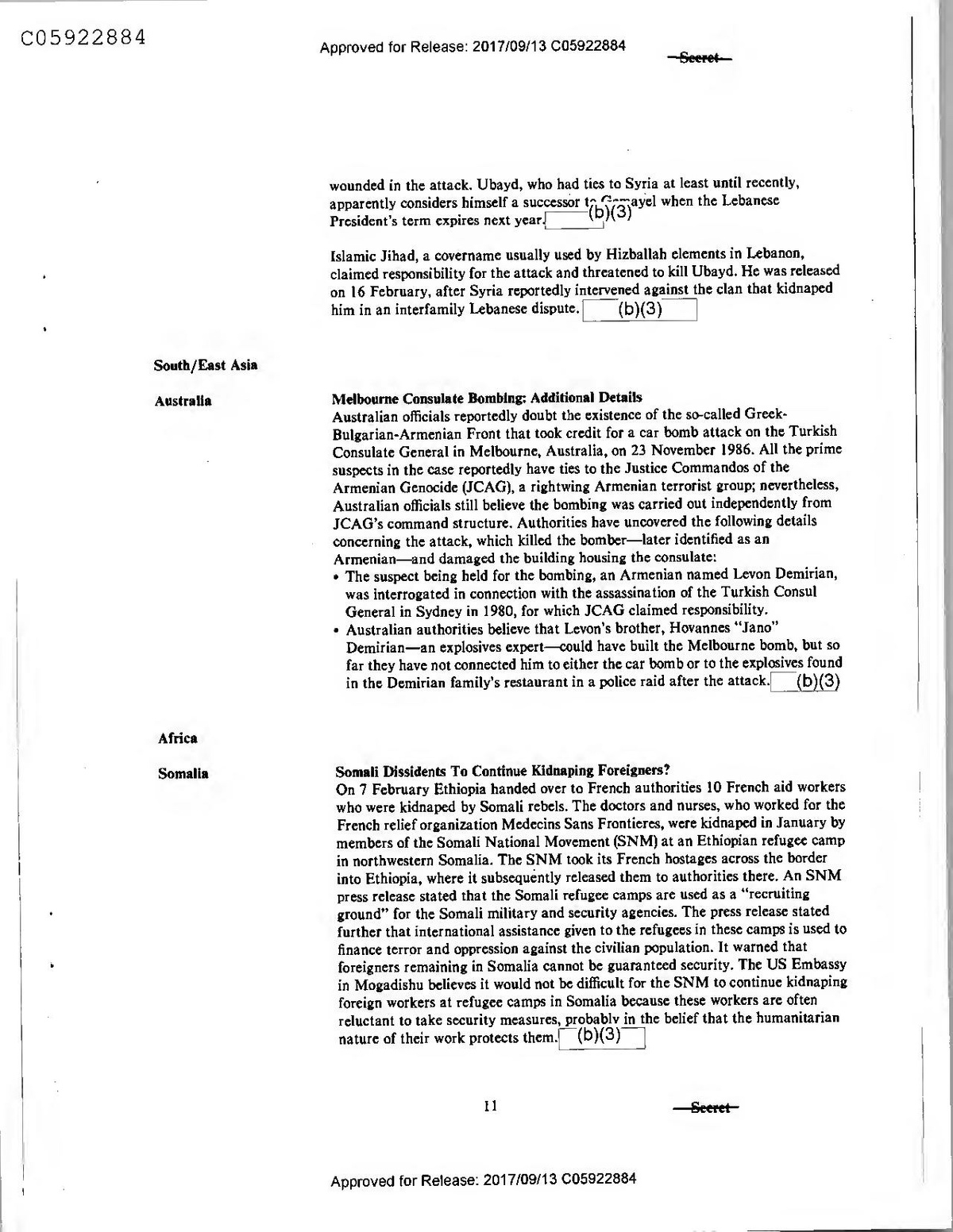
wounded in the attack. Ubayd, who had ties to Syria at least until recently, apparently considers himself a successor tSizjayel when the Lebanese President's term expires next year.!
Islamic Jihad, a covername usually used by Hizballah elements in Lebanon, claimed responsibility for the attack and threatened to kill Ubayd. He was released on 16 February, after Syria reportedly intervened against the clan that kidnaped him in an interfamily Lebanese dispute. (b)(3)
South/East Asia
Australia
Melbourne Consulate Bombing: Additional Details Australian officials reportedly doubt the existence of the so-called GreekBulgarian-Armenian Front that took credit for a car bomb attack on the Turkish Consulate General in Melbourne, Australia, on 23 November 1986. All the prime suspects in the case reportedly have ties to the Justice Commandos of the Armenian Genocide (JCAG), a rightwing Armenian terrorist group; nevertheless, Australian officials still believe the bombing was carried out independently from JCAG's command structure. Authorities have uncovered the following details concerning the attack, which killed the bomber—later identified as an Armenian—and damaged the building housing the consulate: • The suspect being held for the bombing, an Armenian named Levon Demirian,
was interrogated in connection with the assassination of the Turkish ConsUL
General in Sydney in 1980, for which JCAG claimed responsibility. • Australian authorities believe that Levon's brother, Hovannes “Jano"
Demirian-an explosives expert-could have built the Melbourne bomb, but so far they have not connected him to either the car bomb or to the explosives found in the Demirian family's restaurant in a police raid after the attack. (b)(3)
Africa
Somalia
Somali Dissidents To Continue Kidnaping Foreigners? On 7 February Ethiopia handed over to French authorities 10 French aid workers who were kidnaped by Somali rebels. The doctors and nurses, who worked for the French relief organization Medecins Sans Frontieres, were kidnaped in January by members of the Somali National Movement (SNM) at an Ethiopian refugee camp in northwestern Somalia. The SNM took its French hostages across the border into Ethiopia, where it subsequently released them to authorities there. An SNM press release stated that the Somali refugee camps are used as a "recruiting ground" for the Somali military and security agencies. The press release stated further that international assistance given to the refugees in these camps is used to finance terror and oppression against the civilian population. It warned that foreigners remaining in Somalia cannot be guaranteed security. The US Embassy in Mogadishu believes it would not be difficult for the SNM to continue kidnaping foreign workers at refugee camps in Somalia because these workers are often reluctant to take security measures, probably in the belief that the humanitarian nature of their work protects them. (b)(3)
Secret
Approved for Release: 2017/09/13 C05922884
Technical Trends
Worldwide
Detecting Liquid Explosives The January arrest of a Lebanese terrorist in West Germany has highlighted the potential use of liquid explosives by terrorists. Although some liquid explosives must be rendered into a solid state for most effective use, some stable liquids can be used as the main charge of an explosive device. Like other explosives, these liquids can be set off by a detonator and any search which yields a detonator should not overlook any liquids carried by the same person or found at the same site. Some liquid explosives, however, may also detonate spontaneously at high temperatures, under severe shock, or if acid is added. (b)(3)
The following guidelines are offered for the inspection of suspicious liquids: • Compare the color, transparency, and viscosity of the fluid to the properties of
the liquid normally found in the container. • Check for tampering with the wrapping, cap, or seal of the container. • If possible, X-ray an opaque container. • Chemically test the liquid if a sample can be obtained. This last step may be
difficult if the container or its seal needs to remain intact for operational or evidentiary reasons.
(b)(3)
Gas Enhanced Explosives Recent testing has reconfirmed earlier findings that the placement of liquefied petroleum (LP) gas bottles with an explosive device does not materially increase or enhance the blast effects. Although the thermal effect of such a blast is increased, tests of explosives augmented by LP bottles and an equal amount of unaugmented material showed that a greater blast effect (and damage) results in the latter case, a device using explosives alone.
-(b)(3)
The addition of LP gas to an explosive device may appeal to terrorists who want to make a greater visual impression with the resulting fireball. The blast wave of such an explosion, however, lacks the brisance of high explosives. Generally, the use of LP gas instead of explosives has been an indicator that the nerpetrator may not have had access to conventional high explosives.
(b)(3)
If a bomb is intended solely to start a fire, however, flammable fluids make better accelerators than LP gas. The gaseous LP released in an explosion is consumed very rapidly (one to two seconds—not long enough to kindle wooden furniture, for instance). In contrast, a fire started by an explosive and a flammable liquid will burn for many minutes, which is ideal for incendiary uses. Among groups known to have used some form of bottled gas with explosive devices are the Belgian Communist Combatant Cells, the Armenian Secret Army for the Liberation of Armenia, the Puerto Rican FALN, and the Iraqi Dawa, which attacked the US and French Embassies in Kuwait in December 1983.
(b)(3)
Seeret
12
Approved for Release: 2017/09/13 C05922884
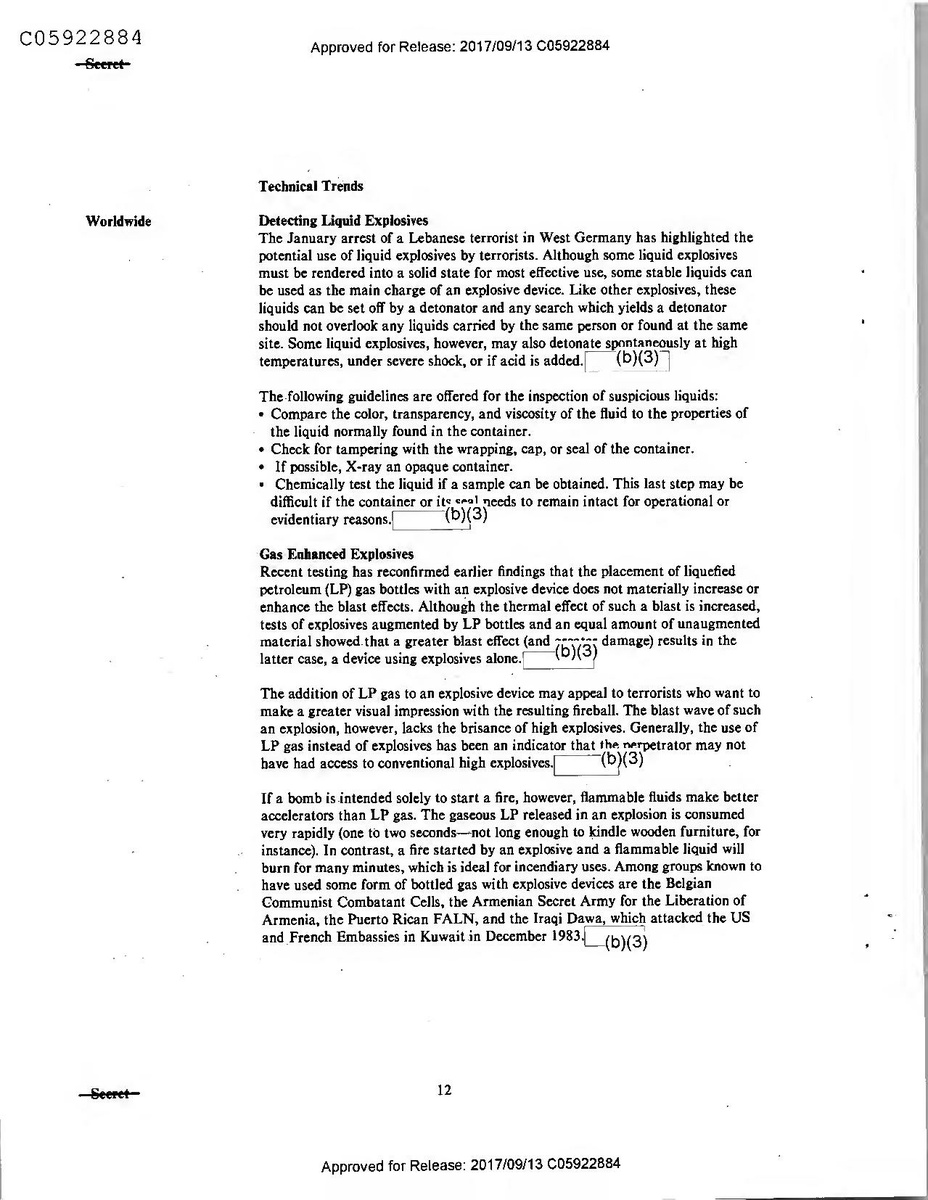
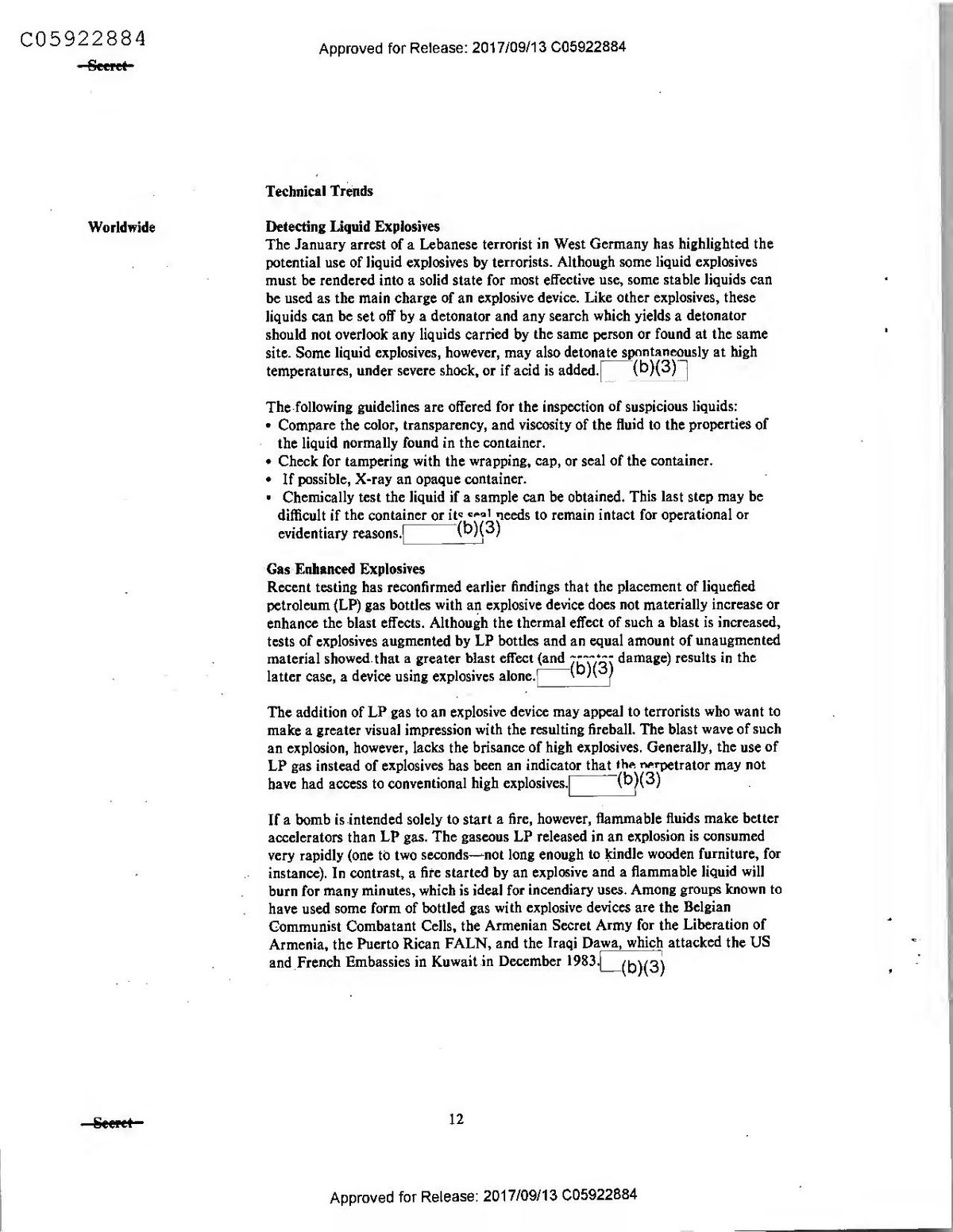
Technical Trends
Worldwide
Detecting Liquid Explosives The January arrest of a Lebanese terrorist in West Germany has highlighted the potential use of liquid explosives by terrorists. Although some liquid explosives must be rendered into a solid state for most effective use, some stable liquids can be used as the main charge of an explosive device. Like other explosives, these liquids can be set off by a detonator and any search which yields a detonator should not overlook any liquids carried by the same person or found at the same site. Some liquid explosives, however, may also detonate spontaneously at high temperatures, under severe shock, or if acid is added. (b)(3)
The following guidelines are offered for the inspection of suspicious liquids: • Compare the color, transparency, and viscosity of the fluid to the properties of
the liquid normally found in the container. • Check for tampering with the wrapping, cap, or seal of the container. • If possible, X-ray an opaque container. • Chemically test the liquid if a sample can be obtained. This last step may be
difficult if the container or its seal needs to remain intact for operational or evidentiary reasons.
(b)(3)
Gas Enhanced Explosives Recent testing has reconfirmed earlier findings that the placement of liquefied petroleum (LP) gas bottles with an explosive device does not materially increase or enhance the blast effects. Although the thermal effect of such a blast is increased, tests of explosives augmented by LP bottles and an equal amount of unaugmented material showed that a greater blast effect (and damage) results in the latter case, a device using explosives alone.
-(b)(3)
The addition of LP gas to an explosive device may appeal to terrorists who want to make a greater visual impression with the resulting fireball. The blast wave of such an explosion, however, lacks the brisance of high explosives. Generally, the use of LP gas instead of explosives has been an indicator that the nerpetrator may not have had access to conventional high explosives.
(b)(3)
If a bomb is intended solely to start a fire, however, flammable fluids make better accelerators than LP gas. The gaseous LP released in an explosion is consumed very rapidly (one to two seconds—not long enough to kindle wooden furniture, for instance). In contrast, a fire started by an explosive and a flammable liquid will burn for many minutes, which is ideal for incendiary uses. Among groups known to have used some form of bottled gas with explosive devices are the Belgian Communist Combatant Cells, the Armenian Secret Army for the Liberation of Armenia, the Puerto Rican FALN, and the Iraqi Dawa, which attacked the US and French Embassies in Kuwait in December 1983.
(b)(3)
Seeret
12
Approved for Release: 2017/09/13 C05922884
United Kingdom
New X-Ray Machine Procedures A London newspaper has reported that the United Kingdom is developing an airport security system that will give a three-dimensional view of luggage. The binocular stereoscopic system is expected to be in production by midyear. Until that time, operators of existing equipment are being retrained to spot plastic weapons and explosives and more sensitive detectors that use multiimaging against metal and plastic are being introduced. (b)(3)
In an effort to curb the abuse of diplomatic pouches by state sponsors of terrorism, Italy and Turkey separately announced plans late last year to X-ray pouches for arms, explosives, and other contraband. Both countries announced broad-based applicability that would avoid the need to single out the pouches of Libya, Syria, and Iran, but in the face of protests by allied countries, they had not implemented their plans as of early 1987 (b)(3)
13
-Secret
Approved for Release: 2017/09/13 C05922884
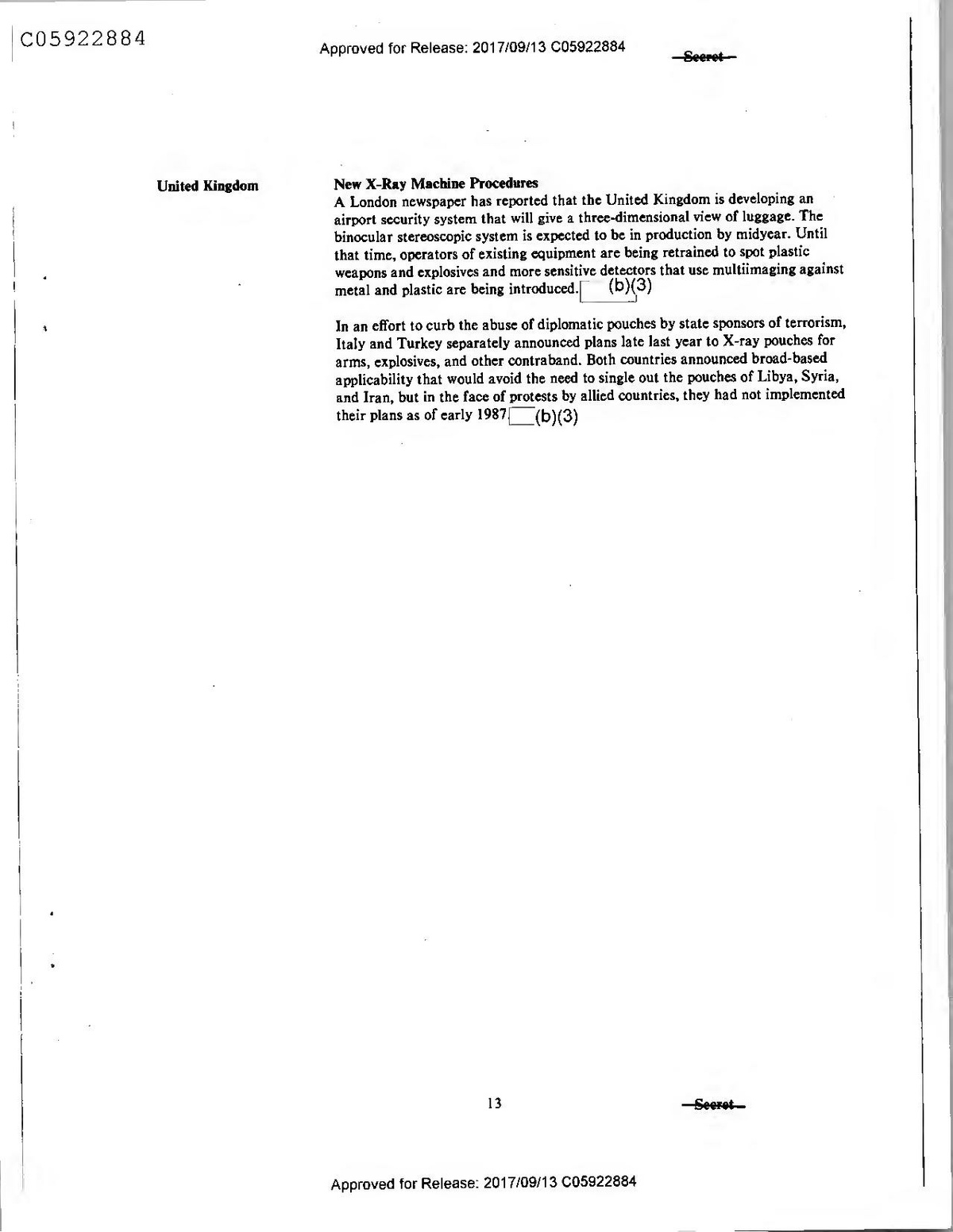
United Kingdom
New X-Ray Machine Procedures A London newspaper has reported that the United Kingdom is developing an airport security system that will give a three-dimensional view of luggage. The binocular stereoscopic system is expected to be in production by midyear. Until that time, operators of existing equipment are being retrained to spot plastic weapons and explosives and more sensitive detectors that use multiimaging against metal and plastic are being introduced. (b)(3)
In an effort to curb the abuse of diplomatic pouches by state sponsors of terrorism, Italy and Turkey separately announced plans late last year to X-ray pouches for arms, explosives, and other contraband. Both countries announced broad-based applicability that would avoid the need to single out the pouches of Libya, Syria, and Iran, but in the face of protests by allied countries, they had not implemented their plans as of early 1987 (b)(3)
13
-Secret
Approved for Release: 2017/09/13 C05922884
Secret
-Approved for Release: 2017/09/13 C05922884
Secret
-Approved for Release: 2017/09/13 C05922884
Peru: The Terrorist Threat to Americans(b)(3)
Over the last two years Peru, and particularly Lima, pro-Nicaragua Marxist group that more narrowly has experienced some of the highest rates of terrorism focuses its attacks against foreign targets, particularly in the world. Most attacks by Peru's two active US and Japanese facilities. Unlike the SL, the insurgent groups, the fanatically ethnocentric Sendero MRTA has generally used political violence to draw Luminoso (SL) and the urban-based Tupac Amaru attention to its political program, so far has attacked Revolutionary Movement (MRTA), have been property far more than people, and has been quick to directed at official Peruvian targets. During 1986, take credit for its attacks.
(b)(3) however, there was a fourfold increase in the number of attacks against foreign official and international Rising Urban Terrorism business facilities. Given these trends, we believe the The main terrorist threat to US citizens is in Lima. likelihood of American casualties—even if incurred Despite some tougher antiterrorist measures, violent incidentally—is rising. No Americans have been attacks in Lima are increasing in both number and killed by terrorists in Lima but, because of the large lethality. Our data base indicates that since the American resident and tourist presence in the capital, beginning of 1985 some 300 serious incidents have we believe they could become victims when
occurred in the Lima metropolitan area. Forty government, commercial, or tourist sites are bombed persons—all Peruvians—have been killed in Lima or come under strafing attack. The danger to
during that period, including nine who were innocent Americans is almost as great in the countryside, bystanders. Police reports indicate that the SL has where two Americans were killed last year when been overwhelmingly responsible for the deaths. (b)(3) guerrillas bombed the popular Cusco-to-· Machupicchu tourist train. (b)(3)
Our review of SL attacks during 1986 indicates that it
is still hitting hardest at Peruvian targets. Indeed, 31 Peru's Terrorist Groups
of the 40 persons killed in Lima since early 1985 were Guerrilla and terrorist violence in Peru has escalated engaged in counterterrorism or local police duties. dramatically recent years and poses increasingly The assassinations last year in Lima of two Peruvian serious security problems for Americans. The largest Navy admirals, moreover, received international press and most dangerous insurgent group is the SL, whose coverage, heightening the perception at home and 4,000 to 5,000 armed guerrillas are waging both an abroad of growing political instability and personal increasingly active urban terrorist campaign in Lima insecurity in Peru.[ (b)(3) and a low intensity rural insurrection throughout the country. Since it initiated armed struggle in 1980, the Terrorist attacks in Lima during 1986 also show, SL has developed into the second-largest guerrilla however, a dramatic four-fold increase over the 1985 movement in South America-behind the
levels of strikes against foreign targets. In February Revolutionary Armed Forces of Colombia (FARC) 1986 the SL bombed six foreign diplomatic missions, and is probably the most brutal movement ever to including the US Embassy. SL, being generally appear in the region. SL's violent tactics aim at the antiforeign rather than specifically anti-American, total elimination of the influence of Peru's whites and also struck at the Soviet Embassy twice last year and mestizos, and the,
wounded six Soviet sailors in a terrorist attack last August. For its part, the MRTA attacked the US
any kind in Peru.(b)(3) reviles foreign influences of
Peru's other terrorist group, the MRTA, is a small, Lima-based movement of several hundred activists at most. In contrast with SL, the MRTA is a Castroite,
15
Secret
DI TR 87-004 26 February 1987
Approved for Release: 2017/09/13 C05922884
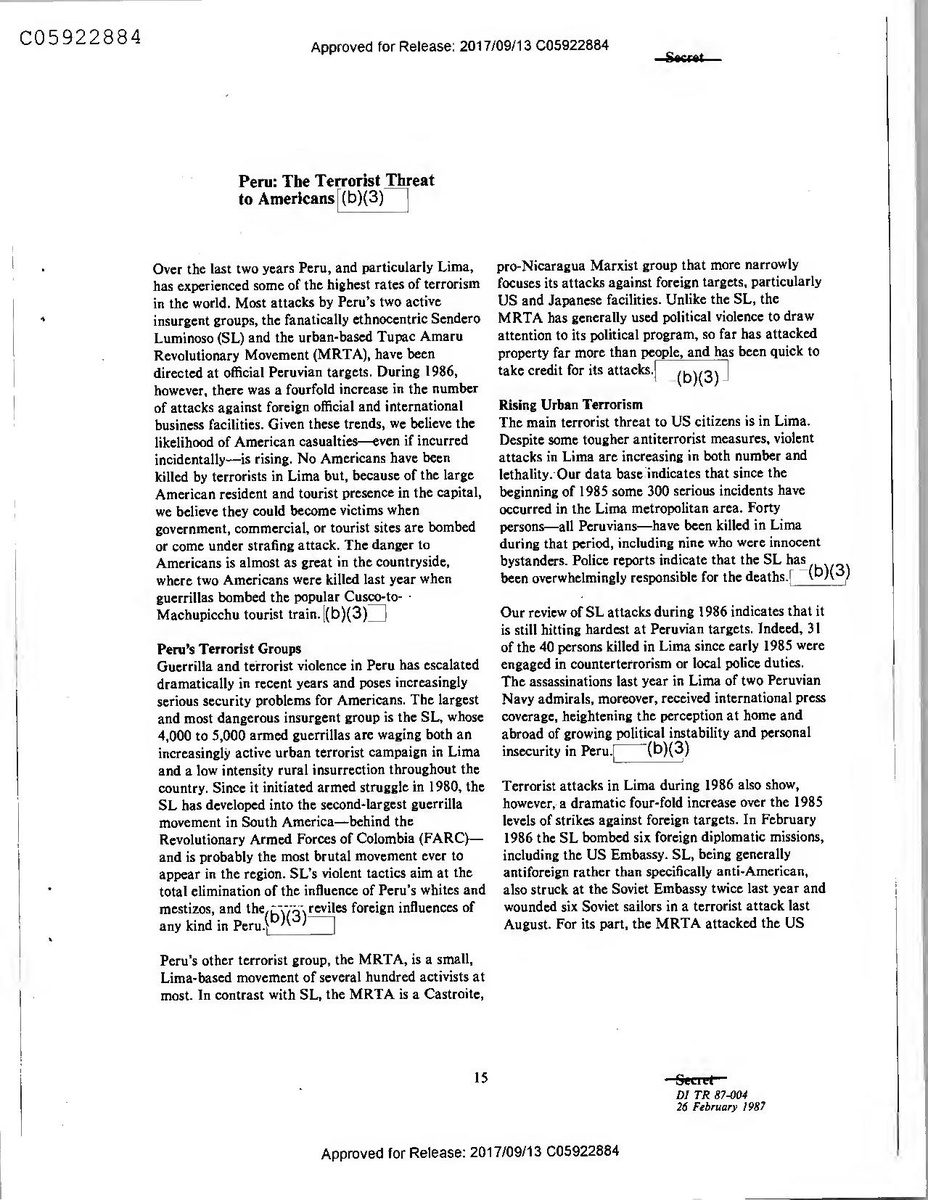
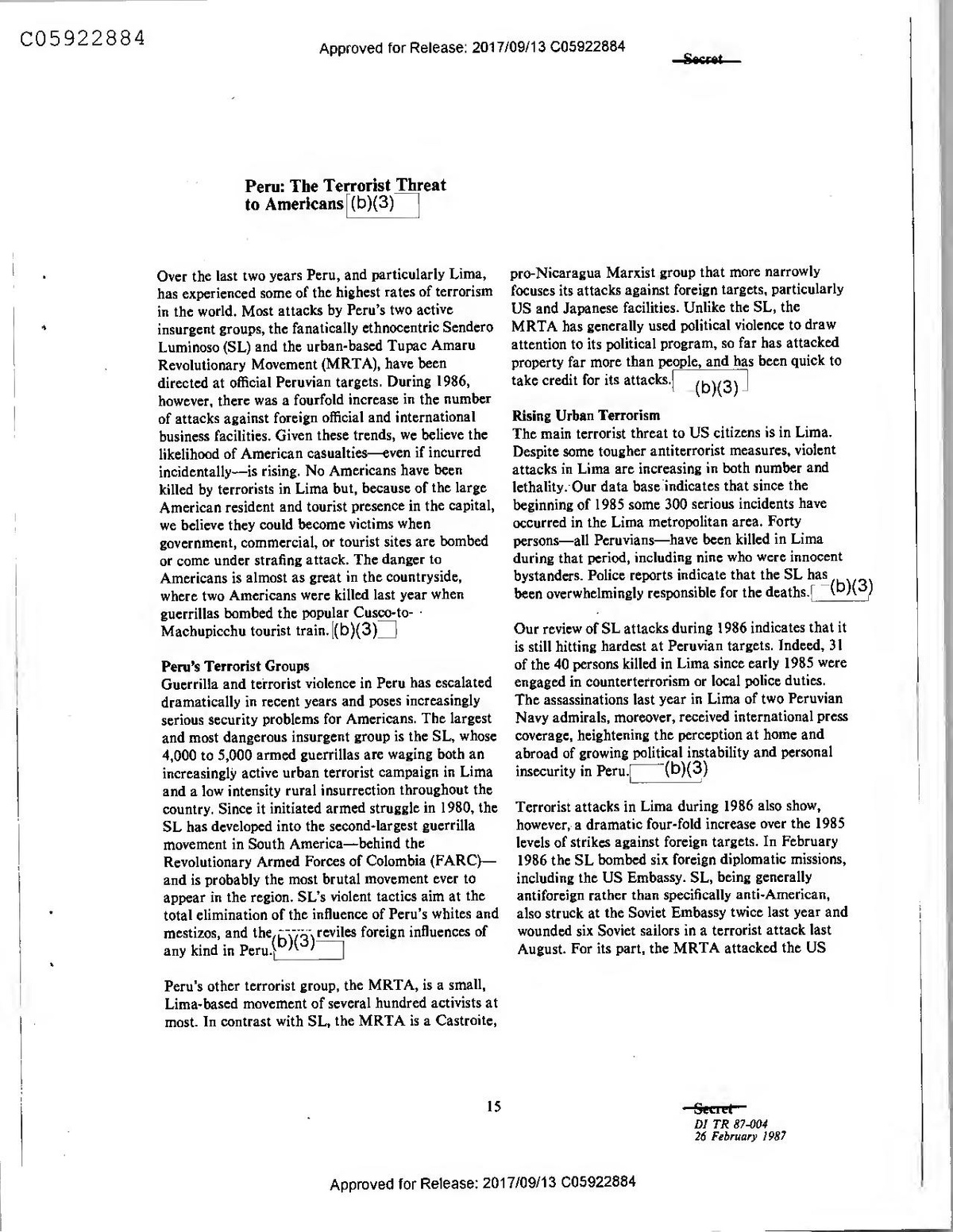
Peru: The Terrorist Threat to Americans(b)(3)
Over the last two years Peru, and particularly Lima, pro-Nicaragua Marxist group that more narrowly has experienced some of the highest rates of terrorism focuses its attacks against foreign targets, particularly in the world. Most attacks by Peru's two active US and Japanese facilities. Unlike the SL, the insurgent groups, the fanatically ethnocentric Sendero MRTA has generally used political violence to draw Luminoso (SL) and the urban-based Tupac Amaru attention to its political program, so far has attacked Revolutionary Movement (MRTA), have been property far more than people, and has been quick to directed at official Peruvian targets. During 1986, take credit for its attacks.
(b)(3) however, there was a fourfold increase in the number of attacks against foreign official and international Rising Urban Terrorism business facilities. Given these trends, we believe the The main terrorist threat to US citizens is in Lima. likelihood of American casualties—even if incurred Despite some tougher antiterrorist measures, violent incidentally—is rising. No Americans have been attacks in Lima are increasing in both number and killed by terrorists in Lima but, because of the large lethality. Our data base indicates that since the American resident and tourist presence in the capital, beginning of 1985 some 300 serious incidents have we believe they could become victims when
occurred in the Lima metropolitan area. Forty government, commercial, or tourist sites are bombed persons—all Peruvians—have been killed in Lima or come under strafing attack. The danger to
during that period, including nine who were innocent Americans is almost as great in the countryside, bystanders. Police reports indicate that the SL has where two Americans were killed last year when been overwhelmingly responsible for the deaths. (b)(3) guerrillas bombed the popular Cusco-to-· Machupicchu tourist train. (b)(3)
Our review of SL attacks during 1986 indicates that it
is still hitting hardest at Peruvian targets. Indeed, 31 Peru's Terrorist Groups
of the 40 persons killed in Lima since early 1985 were Guerrilla and terrorist violence in Peru has escalated engaged in counterterrorism or local police duties. dramatically recent years and poses increasingly The assassinations last year in Lima of two Peruvian serious security problems for Americans. The largest Navy admirals, moreover, received international press and most dangerous insurgent group is the SL, whose coverage, heightening the perception at home and 4,000 to 5,000 armed guerrillas are waging both an abroad of growing political instability and personal increasingly active urban terrorist campaign in Lima insecurity in Peru.[ (b)(3) and a low intensity rural insurrection throughout the country. Since it initiated armed struggle in 1980, the Terrorist attacks in Lima during 1986 also show, SL has developed into the second-largest guerrilla however, a dramatic four-fold increase over the 1985 movement in South America-behind the
levels of strikes against foreign targets. In February Revolutionary Armed Forces of Colombia (FARC) 1986 the SL bombed six foreign diplomatic missions, and is probably the most brutal movement ever to including the US Embassy. SL, being generally appear in the region. SL's violent tactics aim at the antiforeign rather than specifically anti-American, total elimination of the influence of Peru's whites and also struck at the Soviet Embassy twice last year and mestizos, and the,
wounded six Soviet sailors in a terrorist attack last August. For its part, the MRTA attacked the US
any kind in Peru.(b)(3) reviles foreign influences of
Peru's other terrorist group, the MRTA, is a small, Lima-based movement of several hundred activists at most. In contrast with SL, the MRTA is a Castroite,
15
Secret
DI TR 87-004 26 February 1987
Approved for Release: 2017/09/13 C05922884
Major Terrorist Attacks in Peru Against Foreign Interests, 1986
21 December
The US Information Agency building in Lima was bombed, probably by the MRTA. No injuries were reported.
18 December
Six organizations in Lima with links to the United States were bombed, including two binational cultural centers, IBM and AID warehouses, the Summer Institute of Linguistics, and a Goodyear facility. MRTA claimed responsibility for the bombings, in which several persons were injured.
10 November
The US Information Agency Binational Center in Trujillo was bombed probably by the MRTA. There were no injuries.
24 October
The Peruvian manager of the Pepsi-Cola plant in Huanuco, was murdered. No group claimed responsibility, but the SL was the likely perpetrator.
18 September
The MRTA attacked the Chilean Embassy in Lima with dynamite, causing no injuries.
26 August
The Bolivian Embassy in Lima is bombed by a splinter group of the MRTA in protest of the US military presence in Bolivia and involvement in operations against drug traffickers. No injuries were reported.
27 July
Terrorists, probably SL, set of firebombs at three major business and tourist hotels in Lima. There were no injuries.
22 July
Unknown terrorists bombed the Eastern Airlines office in Lima and a MercedesBenz car dealership, causing no injuries.
4 July
The SL was probably responsible for bombings of the Chinese and Italian Embassies in Lima, as well as the Peruvian-Soviet Cultural Institute.
25 June
SL terrorists bombed a tourist train traveling from Cusco to the Machupicchu ruins, killing eight persons including two Americans. A number of other US citizens were wounded.
16
Secret
Approved for Release: 2017/09/13 C05922884
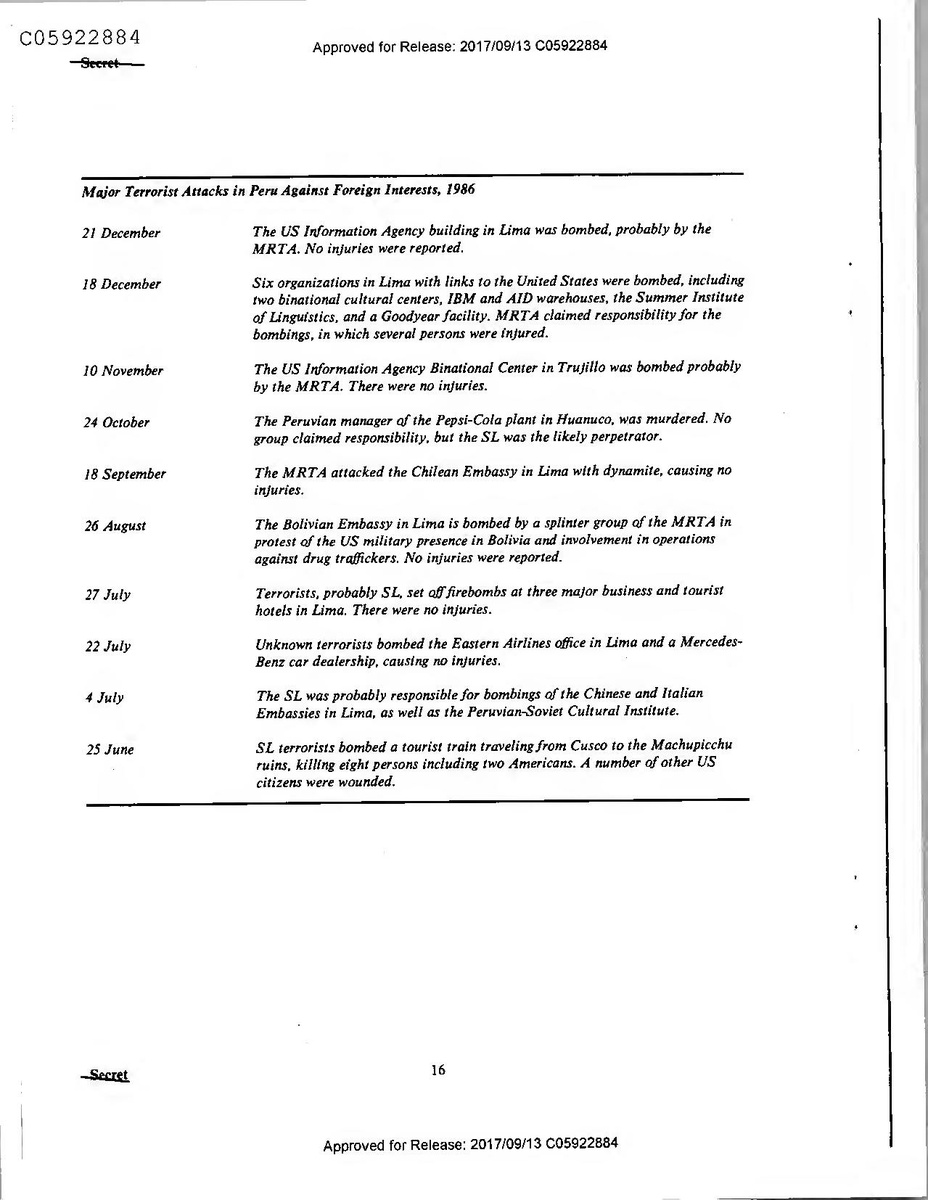
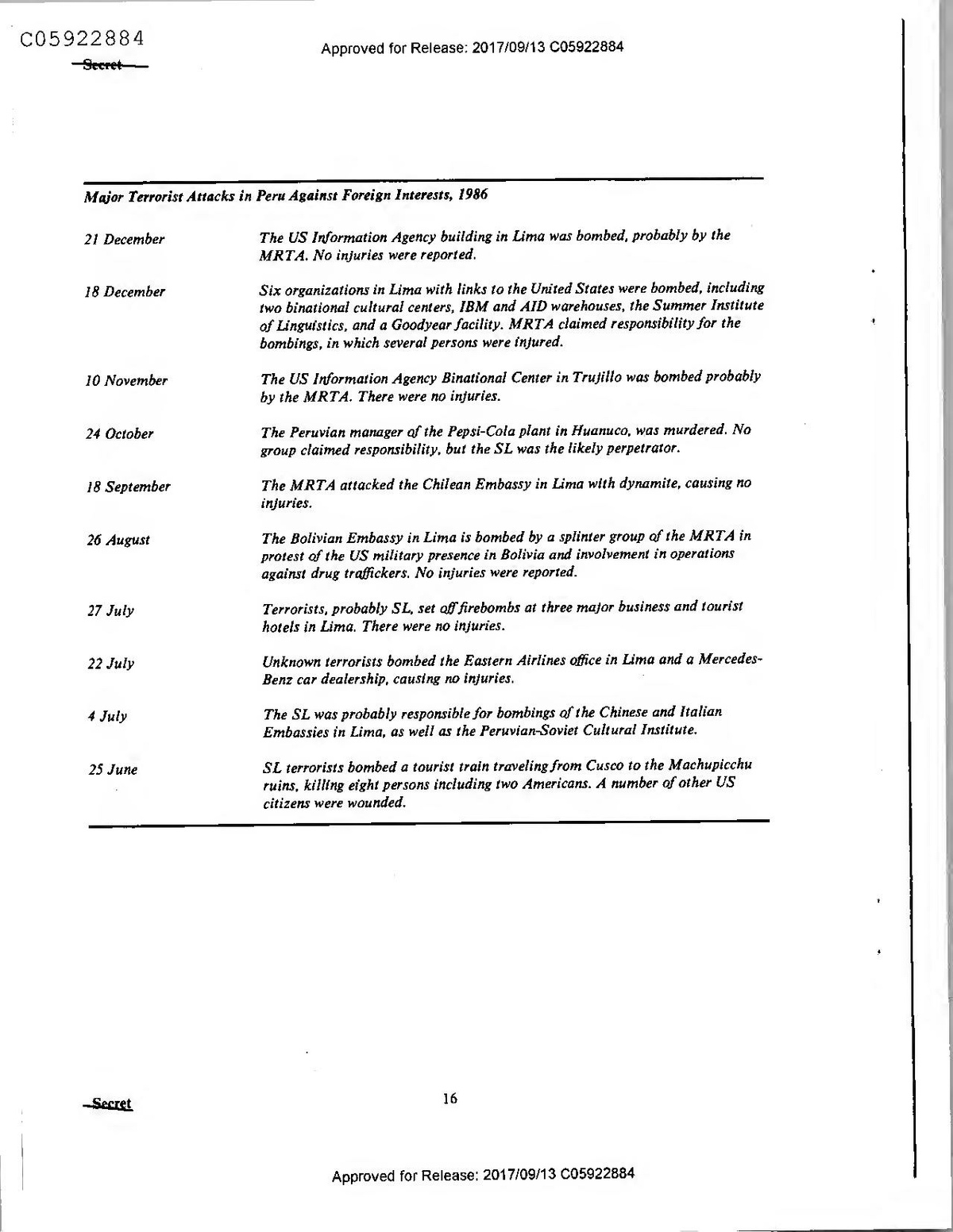
Major Terrorist Attacks in Peru Against Foreign Interests, 1986
21 December
The US Information Agency building in Lima was bombed, probably by the MRTA. No injuries were reported.
18 December
Six organizations in Lima with links to the United States were bombed, including two binational cultural centers, IBM and AID warehouses, the Summer Institute of Linguistics, and a Goodyear facility. MRTA claimed responsibility for the bombings, in which several persons were injured.
10 November
The US Information Agency Binational Center in Trujillo was bombed probably by the MRTA. There were no injuries.
24 October
The Peruvian manager of the Pepsi-Cola plant in Huanuco, was murdered. No group claimed responsibility, but the SL was the likely perpetrator.
18 September
The MRTA attacked the Chilean Embassy in Lima with dynamite, causing no injuries.
26 August
The Bolivian Embassy in Lima is bombed by a splinter group of the MRTA in protest of the US military presence in Bolivia and involvement in operations against drug traffickers. No injuries were reported.
27 July
Terrorists, probably SL, set of firebombs at three major business and tourist hotels in Lima. There were no injuries.
22 July
Unknown terrorists bombed the Eastern Airlines office in Lima and a MercedesBenz car dealership, causing no injuries.
4 July
The SL was probably responsible for bombings of the Chinese and Italian Embassies in Lima, as well as the Peruvian-Soviet Cultural Institute.
25 June
SL terrorists bombed a tourist train traveling from Cusco to the Machupicchu ruins, killing eight persons including two Americans. A number of other US citizens were wounded.
16
Secret
Approved for Release: 2017/09/13 C05922884
June
Tupac Amaru terrorists simultaneously seized the offices of four foreign news agencies, forcing station personnel to transmit antigovernment messages.
22 June
MRTA terrorists bombed the Honduran Embassy, causing considerable damage but no injuries.
27 May
Unknown terrorists bombed the North American-Peruvian Cultural Institute in Trujillo. Two Peruvian students were injured.
21 April
MRTA members exploded a car bomb outside the residence of the US Ambassador, blowing a hole in the concrete wall surrounding the home but causing no injuries.
11 April
MRTA terrorists bombed five US targets in Lima, including an AID warehouse, a branch office of Citibank, Eastman-Kodak's Peruvian headquarters, the offices of Diner's Club, and the Summer Institute of Linguistics. No injuries resulted.
3 April
Synchronized attacks were carried out by MRTA terrorists against foreign facilities, including the US-Peruvian Binational Center, two Citibank offices, an IBM warehouse, Sears-Roebuck, and the Colombian Embassy.
17 March
Presumed SL terrorists strafed the Argentine Embassy in Lima with machinegun fire. There were no injuries.
21 February
The SL carried out a series of bombings against the Embassies of the United States, Spain, China, West Germany, Argentina, and India. One guard at the Indian Embassy was killed.
22 January
Unknown terrorists bombed the Sears-Roebuck store in downtown Lima, as well as several other stores and shopping centers around the city. No injuries were reported.
(b)(3)
17
Secret
Approved for Release: 2017/09/13 C05922884
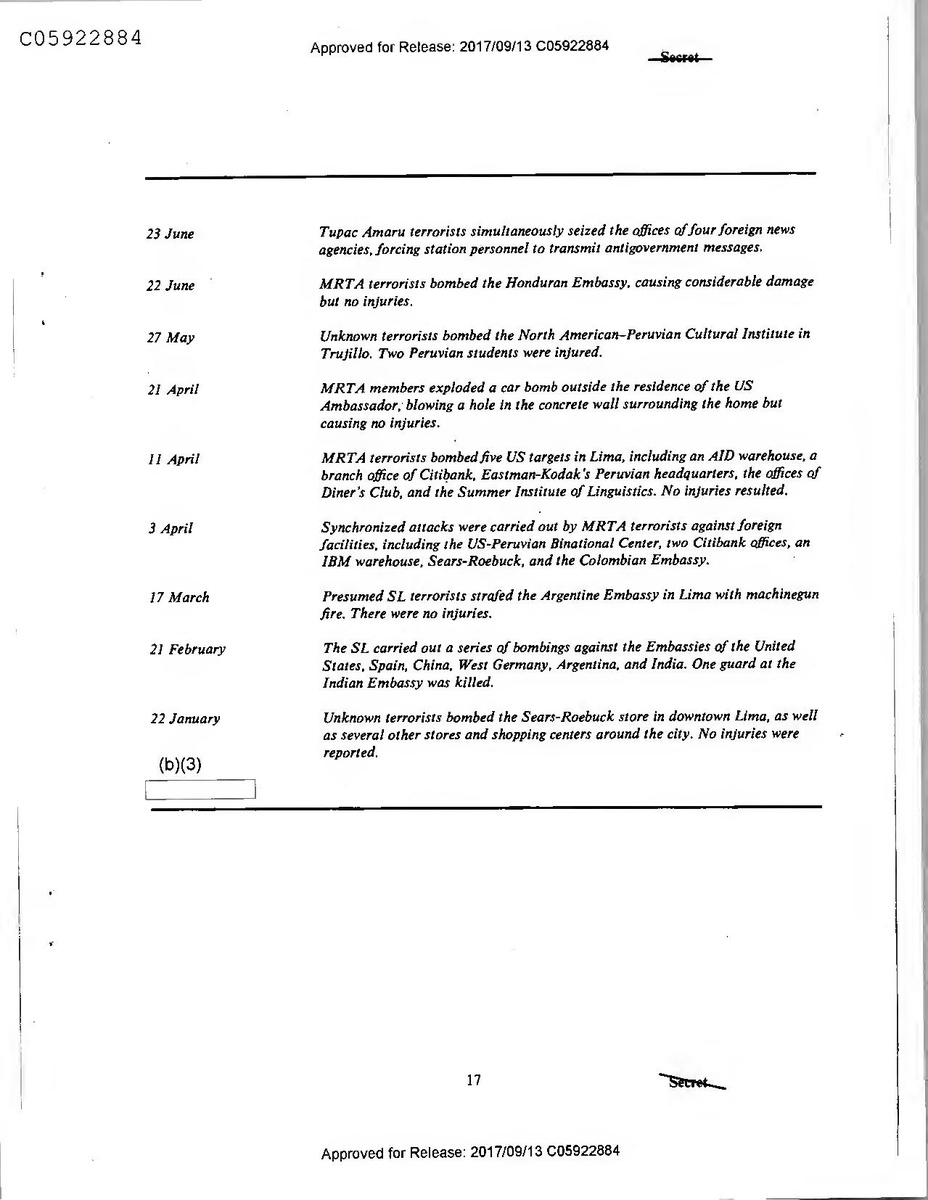
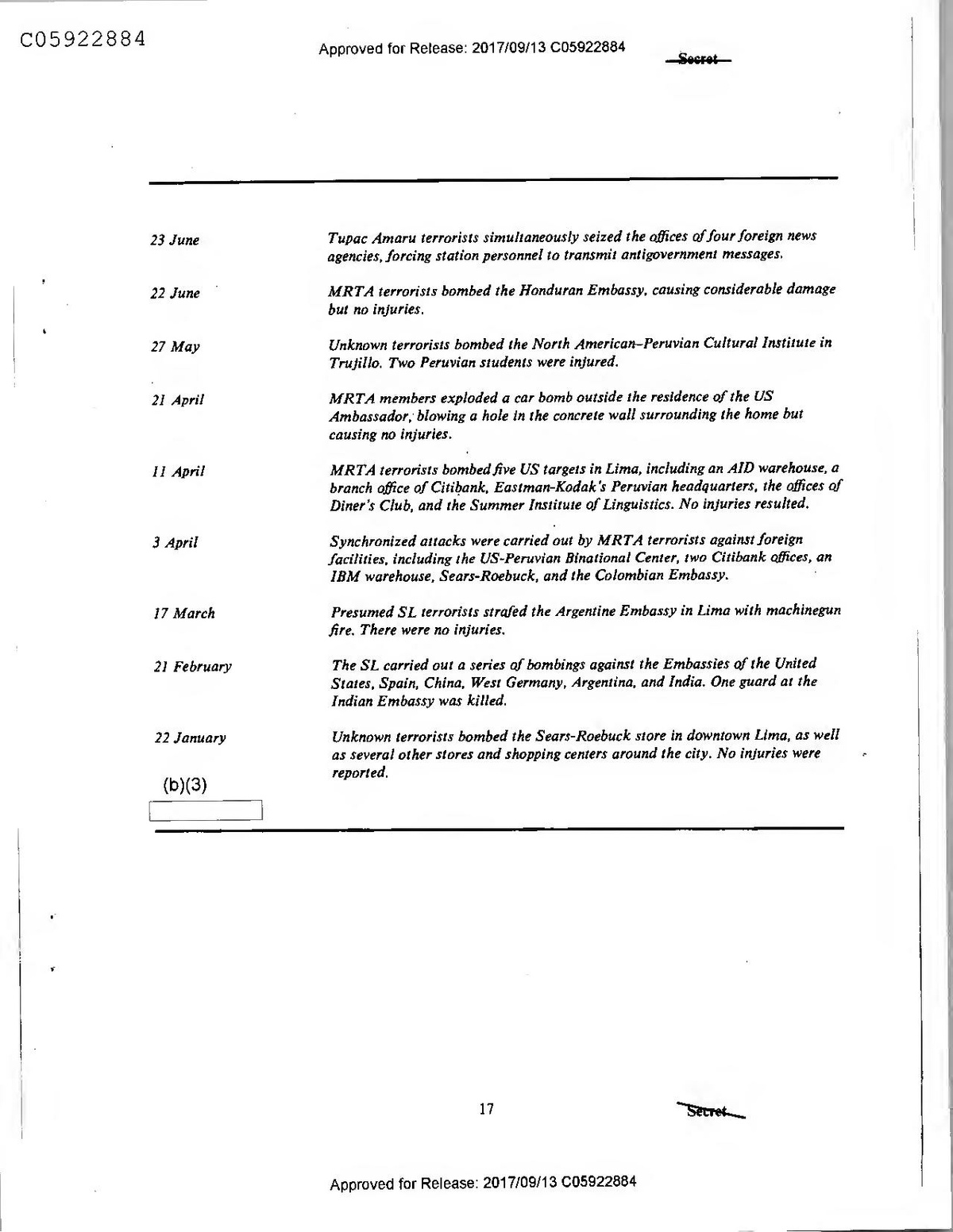
June
Tupac Amaru terrorists simultaneously seized the offices of four foreign news agencies, forcing station personnel to transmit antigovernment messages.
22 June
MRTA terrorists bombed the Honduran Embassy, causing considerable damage but no injuries.
27 May
Unknown terrorists bombed the North American-Peruvian Cultural Institute in Trujillo. Two Peruvian students were injured.
21 April
MRTA members exploded a car bomb outside the residence of the US Ambassador, blowing a hole in the concrete wall surrounding the home but causing no injuries.
11 April
MRTA terrorists bombed five US targets in Lima, including an AID warehouse, a branch office of Citibank, Eastman-Kodak's Peruvian headquarters, the offices of Diner's Club, and the Summer Institute of Linguistics. No injuries resulted.
3 April
Synchronized attacks were carried out by MRTA terrorists against foreign facilities, including the US-Peruvian Binational Center, two Citibank offices, an IBM warehouse, Sears-Roebuck, and the Colombian Embassy.
17 March
Presumed SL terrorists strafed the Argentine Embassy in Lima with machinegun fire. There were no injuries.
21 February
The SL carried out a series of bombings against the Embassies of the United States, Spain, China, West Germany, Argentina, and India. One guard at the Indian Embassy was killed.
22 January
Unknown terrorists bombed the Sears-Roebuck store in downtown Lima, as well as several other stores and shopping centers around the city. No injuries were reported.
(b)(3)
17
Secret
Approved for Release: 2017/09/13 C05922884
Ambassador's residence in 1986, bombed the Lima In the countryside, the situation is likely to be nearly headquarters of Citibank and Texaco, and hit other as dangerous as in Lima because of the widespread targets that the group associates with “Yanqui SL insurgency. Additional security has been providec(b)(3) imperialism," including several Kentucky Fried for the tourist train to Machupicchu that was (b)(1) Chicken franchises in 1985 and a Sears Roebuck bombed earlier this year, but the store. In late December 1986 the MRTA went on a
continues to be concerned about safety on the bombing rampage over three days, attacking seven line because of the extreme difficulty of protecting the US-affiliated facilities, including the United States track. US citizens visiting Peru also would be Information Agency building. The Tupac Amaru also particularly advised to avoid travel in the areas regards Japan as a principal “imperialist” power and designated by the Peruvian Government as emergency we believe it is responsible for a majority of the zones because of insurgent activities and narcotics attacks on Japanese business interests in Lin(b)(3) related violence. SL cadres move (b)(3)nd operate at
will in these areas. The Threat to Americans
(b)(3) Despite the increasing number of attacks against US facilities, to our knowledge no US citizen has been the object of a deliberate personal attack by terrorists and, aside from the US Ambassador's home, no other American residence has been targeted. To help combat the growing urban terrorism, the Peruvian Government has maintained a state of emergency and a curfew in the Lima metropolitan area since early February 1986, and police and military personnel armed with shoulder-fired weapons routinely patrol the streets.
(b)(3)
Nonetheless, Peruvian authorities admit their inability to provide full protection to diplomatic missions, and we believe it is increasingly likely that American citizens in Lima will be either deliberately targeted by terrorists or injured incidentally in an attack. According to the US Embassy, some 9,000 Americans reside in Lima, including approximately 400 US Government personnel and their dependents. Moreover, an estimated 200 to 250 American tourists are likely to be visiting Lima on any day of the year. Both terrorist groups are now actively targeting sites in neighborhoods where Americans live and places where tourists congregate, such as hotels and restaurants. The popular Plaza de Armas, for example, upon which the National Palace and other important governmental and historical buildings face, has been the site of repeated car bombings.[(b)(3)
Secret
18
-Approved for Release: 2017/09/13 C05922884
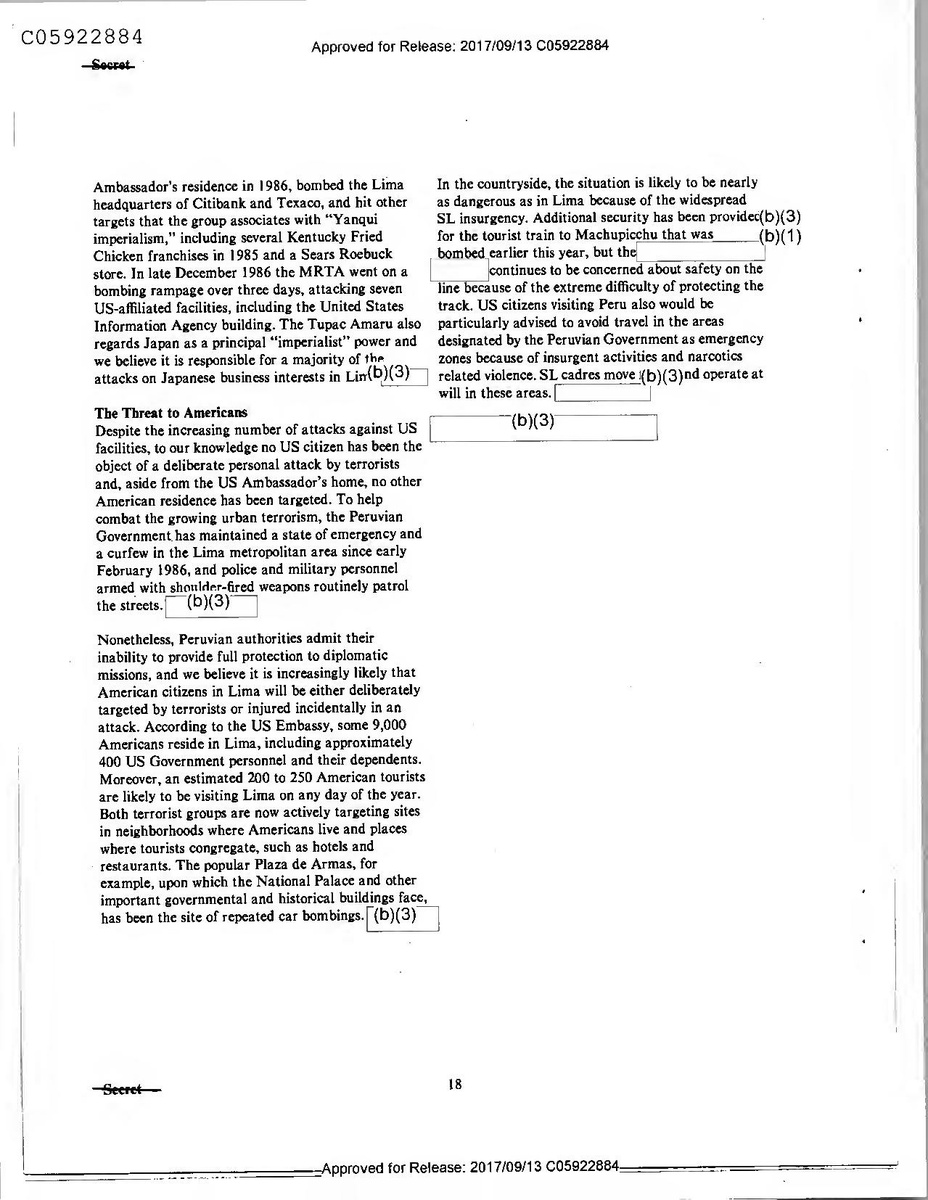
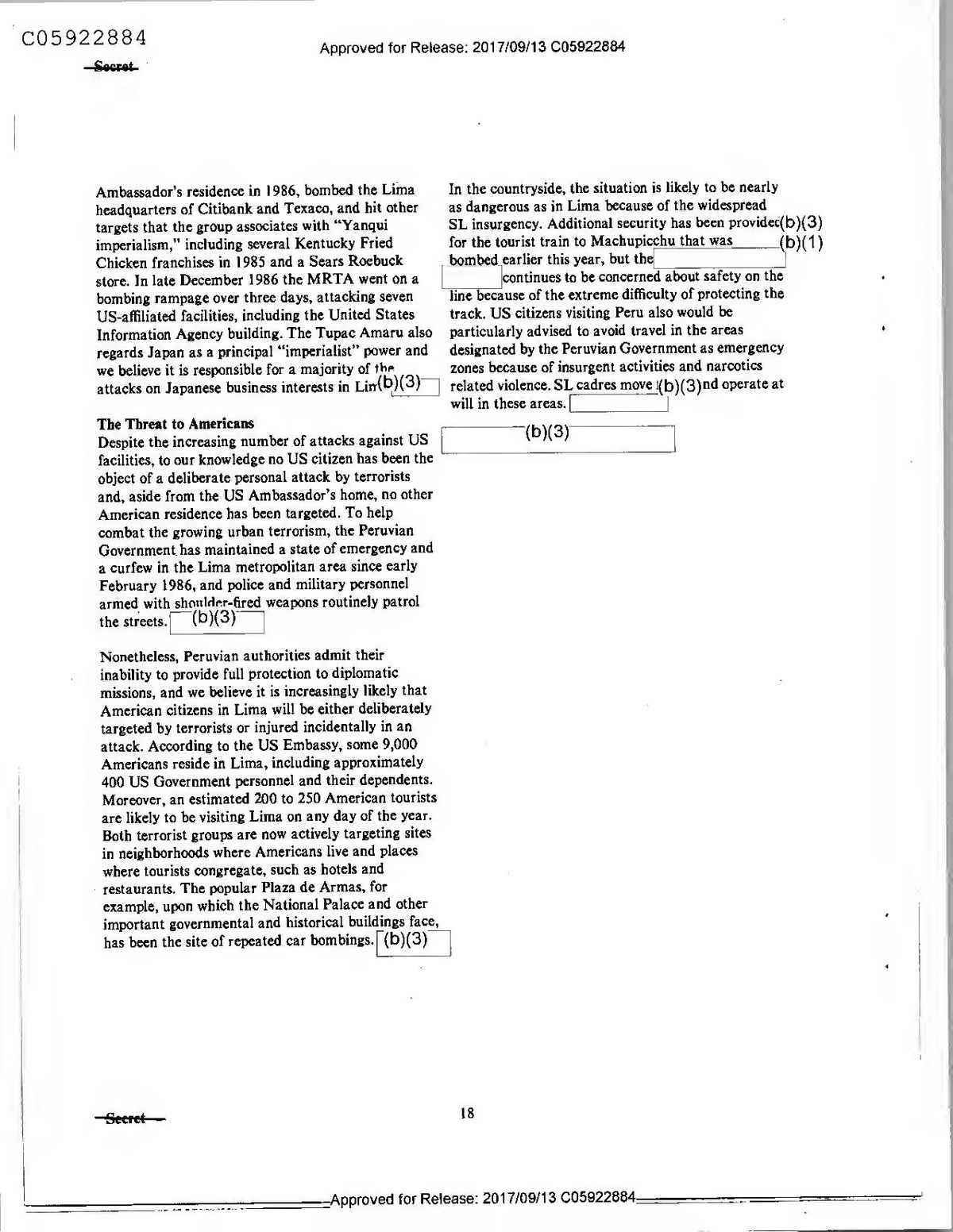
Ambassador's residence in 1986, bombed the Lima In the countryside, the situation is likely to be nearly headquarters of Citibank and Texaco, and hit other as dangerous as in Lima because of the widespread targets that the group associates with “Yanqui SL insurgency. Additional security has been providec(b)(3) imperialism," including several Kentucky Fried for the tourist train to Machupicchu that was (b)(1) Chicken franchises in 1985 and a Sears Roebuck bombed earlier this year, but the store. In late December 1986 the MRTA went on a
continues to be concerned about safety on the bombing rampage over three days, attacking seven line because of the extreme difficulty of protecting the US-affiliated facilities, including the United States track. US citizens visiting Peru also would be Information Agency building. The Tupac Amaru also particularly advised to avoid travel in the areas regards Japan as a principal “imperialist” power and designated by the Peruvian Government as emergency we believe it is responsible for a majority of the zones because of insurgent activities and narcotics attacks on Japanese business interests in Lin(b)(3) related violence. SL cadres move (b)(3)nd operate at
will in these areas. The Threat to Americans
(b)(3) Despite the increasing number of attacks against US facilities, to our knowledge no US citizen has been the object of a deliberate personal attack by terrorists and, aside from the US Ambassador's home, no other American residence has been targeted. To help combat the growing urban terrorism, the Peruvian Government has maintained a state of emergency and a curfew in the Lima metropolitan area since early February 1986, and police and military personnel armed with shoulder-fired weapons routinely patrol the streets.
(b)(3)
Nonetheless, Peruvian authorities admit their inability to provide full protection to diplomatic missions, and we believe it is increasingly likely that American citizens in Lima will be either deliberately targeted by terrorists or injured incidentally in an attack. According to the US Embassy, some 9,000 Americans reside in Lima, including approximately 400 US Government personnel and their dependents. Moreover, an estimated 200 to 250 American tourists are likely to be visiting Lima on any day of the year. Both terrorist groups are now actively targeting sites in neighborhoods where Americans live and places where tourists congregate, such as hotels and restaurants. The popular Plaza de Armas, for example, upon which the National Palace and other important governmental and historical buildings face, has been the site of repeated car bombings.[(b)(3)
Secret
18
-Approved for Release: 2017/09/13 C05922884
(b)(3)
International Terrorism in Western Europe, 1986
)(3)
Terrorists were active in Western Europe last year, the marks of any foreign involvement. The RAF but for the first time in the 1980s, the number of issued some documents in the name of the “antiinternational terrorist attacks there declined.' There imperialist front"--and the French group Action were changes in the venues, victims, and perpetrators Directe (AD) echoed some of this rhetoric—but there of attacks: Spain became a principal location of was no evidence the groups coordinated any of their international attacks, with France and Germany in operations. (b)(3) second and third place. French interests were most often targeted, followed by US and, more distantly, There were innovations in RAF attacks last year, and Spanish interests. Western Europe remained the most a new element within the RAF gained prominence for dangerous place for Americans abroad, although most its bombing activities. The innovations included the US casualties occurred as a result of attacks, not by use of a remote-control ambush bomb, the selection of European but rather by Middle Eastern groups. a target because of his connections to the nuclear
issue and the US Strategic Defense Initiative, and the Most West European groups continued to concentrate pointblank assassination of a Foreign Ministry their attacks against domestic government facilities, official. The recently invigorated RAF “illegal the police and security forces, and businesses.
militant” level bombed at least 10 targets following Surprisingly, the group that committed the most the general theme of. assassinations conducted by the international attacks in 1986 was the Basque
"hardcore” members. The bombings were directed Fatherland and Liberty (ETA-M), responsible for 36 against government and associated facilities, attacks, mostly harassment bombings of French including security and police installations, and businesses and privately owned automobiles. By businesses associated with weapons production and contrast, the West German Red Army Faction
nuclear power.
(b)(3) (RAF)-the second most active group after ETAM-conducted only four international attacks last At a conference of terrorist support groups last
s vary active against West German winter, the RAF acknowledged it erred in attacking targets.? (b)(3)
Rhein-Main Airbase in 1985 and killing an American
serviceman. The RAF modified its tactics during the West Germany: The RAF
year to avoid unintended casualties when it attacked Euroterrorism, the much-touted phenomenon of the symbolic targets. The illegal militants, for example, mid-1980s, appears to have dwindled in 1986 to little carried out their bombings at night and provided more than rhetorical pronouncements. The RAF-the warnings. The RAF also concentrated its efforts on key proponent of a united terrorist front-was
attacking West German interests and largely ignored inactive until midyear, and none of its attacks bore US and NATO targets.
(b)(3)
year, but it
b)(3)
Much of this decline (140 incidents in 1986 compared with over 200 in 1985) probably is attributable to a falloff in attacks by Middle Eastern terrorists that have spilled over into Western Europe. Attacks of this type will be treated separately in a later issue ? Although events and trends in domestic terrorism (such as attacks by French groups on French targets in France) form a large part of this annual review, our statistical conclusions refer only to international incidents. Our data base on indigenous terrorism is generally less complete[(b)(3)
West German police scored two noteworthy successes against the RAF last year, but the pace of attacks throughout the fall indicated these arrests had no immediate impact on the group's effectiveness. The RAF probably will continue to be among Western Europe's most active and lethal homegrown terrorist groups.
-(b)(3)
19
Sooret.
DI TR 87-004 26 February 1987
Approved for Release: 2017/09/13 C05922884
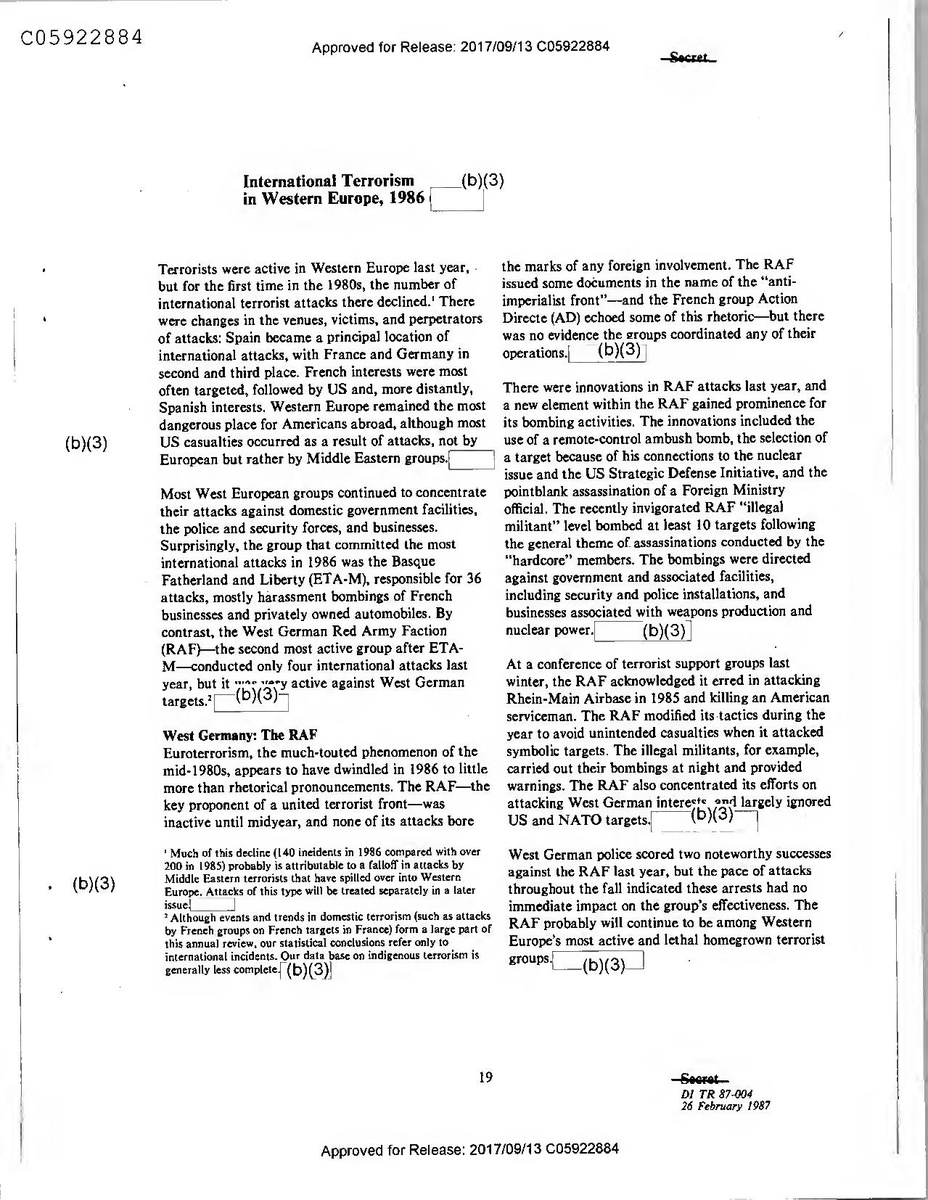
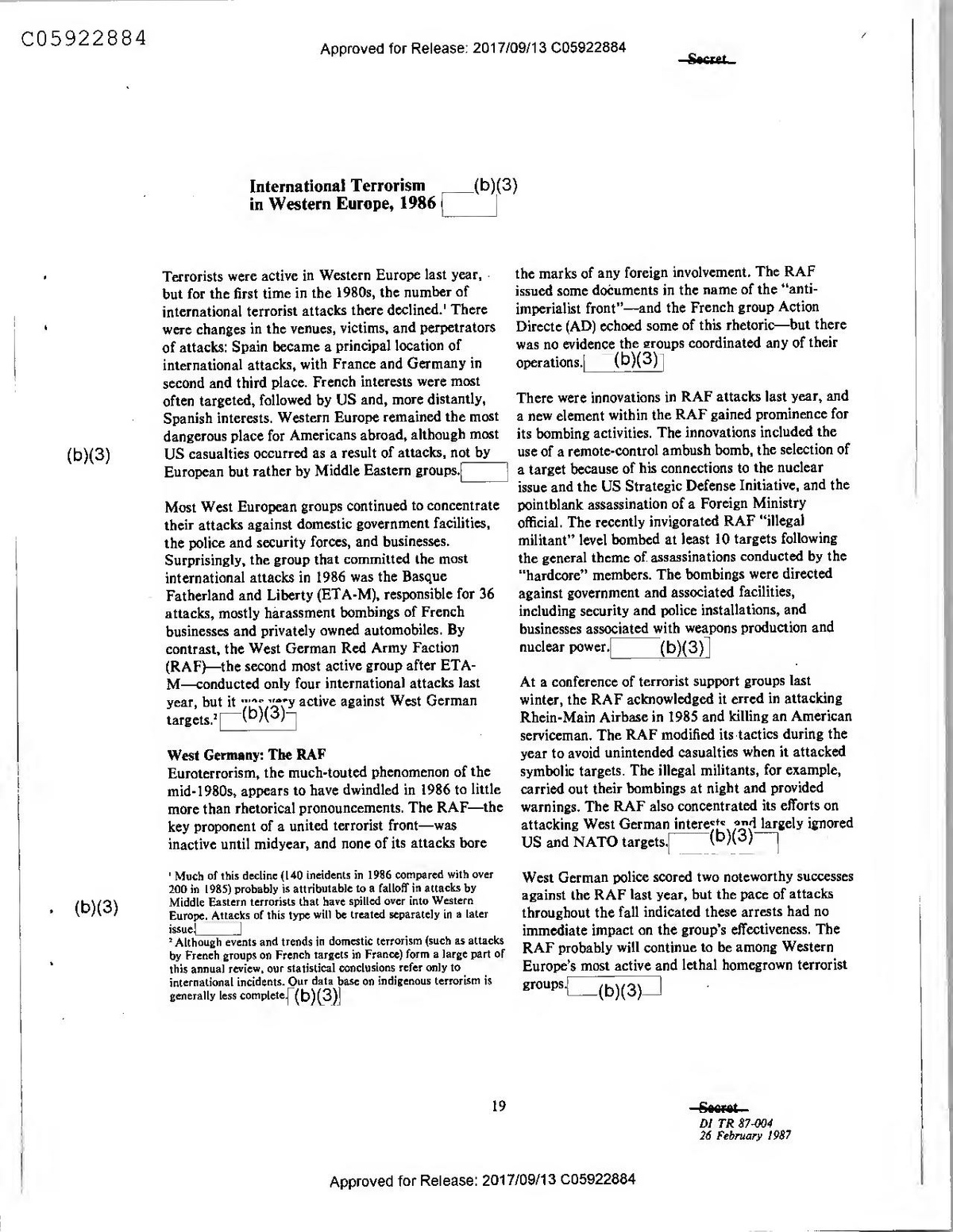
(b)(3)
International Terrorism in Western Europe, 1986
)(3)
Terrorists were active in Western Europe last year, the marks of any foreign involvement. The RAF but for the first time in the 1980s, the number of issued some documents in the name of the “antiinternational terrorist attacks there declined.' There imperialist front"--and the French group Action were changes in the venues, victims, and perpetrators Directe (AD) echoed some of this rhetoric—but there of attacks: Spain became a principal location of was no evidence the groups coordinated any of their international attacks, with France and Germany in operations. (b)(3) second and third place. French interests were most often targeted, followed by US and, more distantly, There were innovations in RAF attacks last year, and Spanish interests. Western Europe remained the most a new element within the RAF gained prominence for dangerous place for Americans abroad, although most its bombing activities. The innovations included the US casualties occurred as a result of attacks, not by use of a remote-control ambush bomb, the selection of European but rather by Middle Eastern groups. a target because of his connections to the nuclear
issue and the US Strategic Defense Initiative, and the Most West European groups continued to concentrate pointblank assassination of a Foreign Ministry their attacks against domestic government facilities, official. The recently invigorated RAF “illegal the police and security forces, and businesses.
militant” level bombed at least 10 targets following Surprisingly, the group that committed the most the general theme of. assassinations conducted by the international attacks in 1986 was the Basque
"hardcore” members. The bombings were directed Fatherland and Liberty (ETA-M), responsible for 36 against government and associated facilities, attacks, mostly harassment bombings of French including security and police installations, and businesses and privately owned automobiles. By businesses associated with weapons production and contrast, the West German Red Army Faction
nuclear power.
(b)(3) (RAF)-the second most active group after ETAM-conducted only four international attacks last At a conference of terrorist support groups last
s vary active against West German winter, the RAF acknowledged it erred in attacking targets.? (b)(3)
Rhein-Main Airbase in 1985 and killing an American
serviceman. The RAF modified its tactics during the West Germany: The RAF
year to avoid unintended casualties when it attacked Euroterrorism, the much-touted phenomenon of the symbolic targets. The illegal militants, for example, mid-1980s, appears to have dwindled in 1986 to little carried out their bombings at night and provided more than rhetorical pronouncements. The RAF-the warnings. The RAF also concentrated its efforts on key proponent of a united terrorist front-was
attacking West German interests and largely ignored inactive until midyear, and none of its attacks bore US and NATO targets.
(b)(3)
year, but it
b)(3)
Much of this decline (140 incidents in 1986 compared with over 200 in 1985) probably is attributable to a falloff in attacks by Middle Eastern terrorists that have spilled over into Western Europe. Attacks of this type will be treated separately in a later issue ? Although events and trends in domestic terrorism (such as attacks by French groups on French targets in France) form a large part of this annual review, our statistical conclusions refer only to international incidents. Our data base on indigenous terrorism is generally less complete[(b)(3)
West German police scored two noteworthy successes against the RAF last year, but the pace of attacks throughout the fall indicated these arrests had no immediate impact on the group's effectiveness. The RAF probably will continue to be among Western Europe's most active and lethal homegrown terrorist groups.
-(b)(3)
19
Sooret.
DI TR 87-004 26 February 1987
Approved for Release: 2017/09/13 C05922884
the jury
The RZ
law, allowing such cases to be heard by a panel of West Germany's other major terrorist organization, judges after over half the jurors sought release from the Revolutionary Cells (RZ), carried out eight
(b)(3) attacks in 1986 in its campaign against Bonn's new restrictions on applicants for political asylum. The Indigenous French Groups group attacked Harald Hollenberg, chief of the West Terrorism by other French groups declined from Berlin Foreigners Registry Office, in October. This previous years. Attacks by separatists of the National marked only the second attack against a government Front for the Liberation of Corsica (FLNC) were official the group has undertaken. The RZ normally down for the fifth year in a row. French rightists attempts to avoid personal injury in its attacks- attacked North African immigrant targets four times, mostly bombings
and we do not believe that the but a leader and three members of one such group Hollenberg attack signals a change in strate(b)(3)
were killed in Toulon later in the year while
transporting a bomb. The anti-Basque Antiterrorist France: Action Directe
Liberation Group (GAL) was much less active last The French group Action Directe (AD)-the other year than in 1985. This rightwing vigilante group component of the Euroterrorist front-continued to
conducted only three attacks, in February 1986, after operate as two subgroups that had split earlier, in part which the French Government began to deport over the issue of cooperating with the RAF. The suspected Basque terrorists, halting the group's "internationalist” wing attempted to assassinate an activities. (b)(3)) industrialist in April and killed the chairman of Renault in November, the latter attack reminiscent of Quiet in Spain Outside the Pyrenees a recent RAF murder. This wing advocates closer Apart from the Basque region, there was little coordination with other European groups-sharing terrorism in Spain in 1986. The Basque separatist weapons, explosives, and possibly lodgings—but is less group Fatherland and Liberty-Military Wing (ETAlik, ban the RAF to attack US and NATO targets. M) remained active. Last year, ETA-M even (b)(3)"
expanded its attacks to French targets in retaliation
for closer French-Spanish police cooperation." The other subgroup—the "domesticalist” wing- Iraultza, the small anti-NATO terrorist group operates independently, bombs unoccupied buildings, composed of radical elements of the extremist Spanish and attacks only French targets, especially those it Basque Communist movement, conducted eight refers to as the “organs of repression." The domestic bombings in 1986, up from four the year before. The wing became more lethal after its leader was arrested group primarily targets American companies in the last March. We believe it was responsible for the Basque region near Bilbao, setting off bombs late at bombing of a police station where a senior officer was night that cause only property damage. The Maoist killed, as well as for the attempted murder of the urban guerrillas First of October Antifascist rightist mayor of Provins and another attempted Resistance Group (GRAPO) remained virtually murder in early 1987. The domestic wing also carried inactive for the second consecutive vear after massive out bombings of firms doing business with South arrests in January 1985. (b)(3) Africa, and may be linked to the “Black War" group that bombed similar targets. AD took responsibility Lull in Portugal for similar bomhins of other South African
Just across the border, the Portuguese terrorist group Popular Forces of 25 April (FP-25) staged only two
businesses. (b)(3)
See the article “Basque Fatherland and Liberty Terrorism in 1986" on page 23.
AD activity also took its toll on the French legal system. An AD terrorist on trial in December forced a postponement when he threatened the judge and jury. The government revised a recent counterterrorism
Secret
20
Approved for Release: 2017/09/13 C05922884
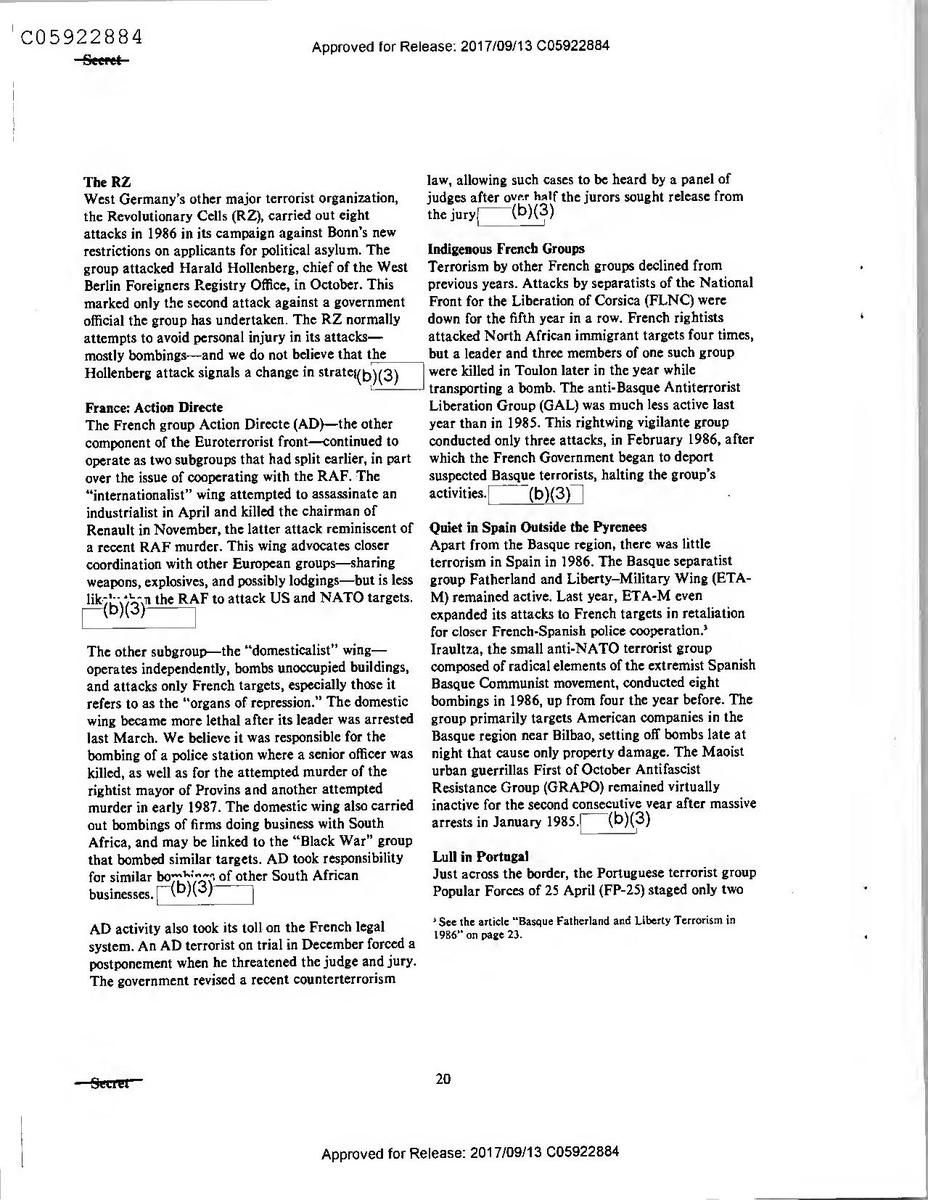
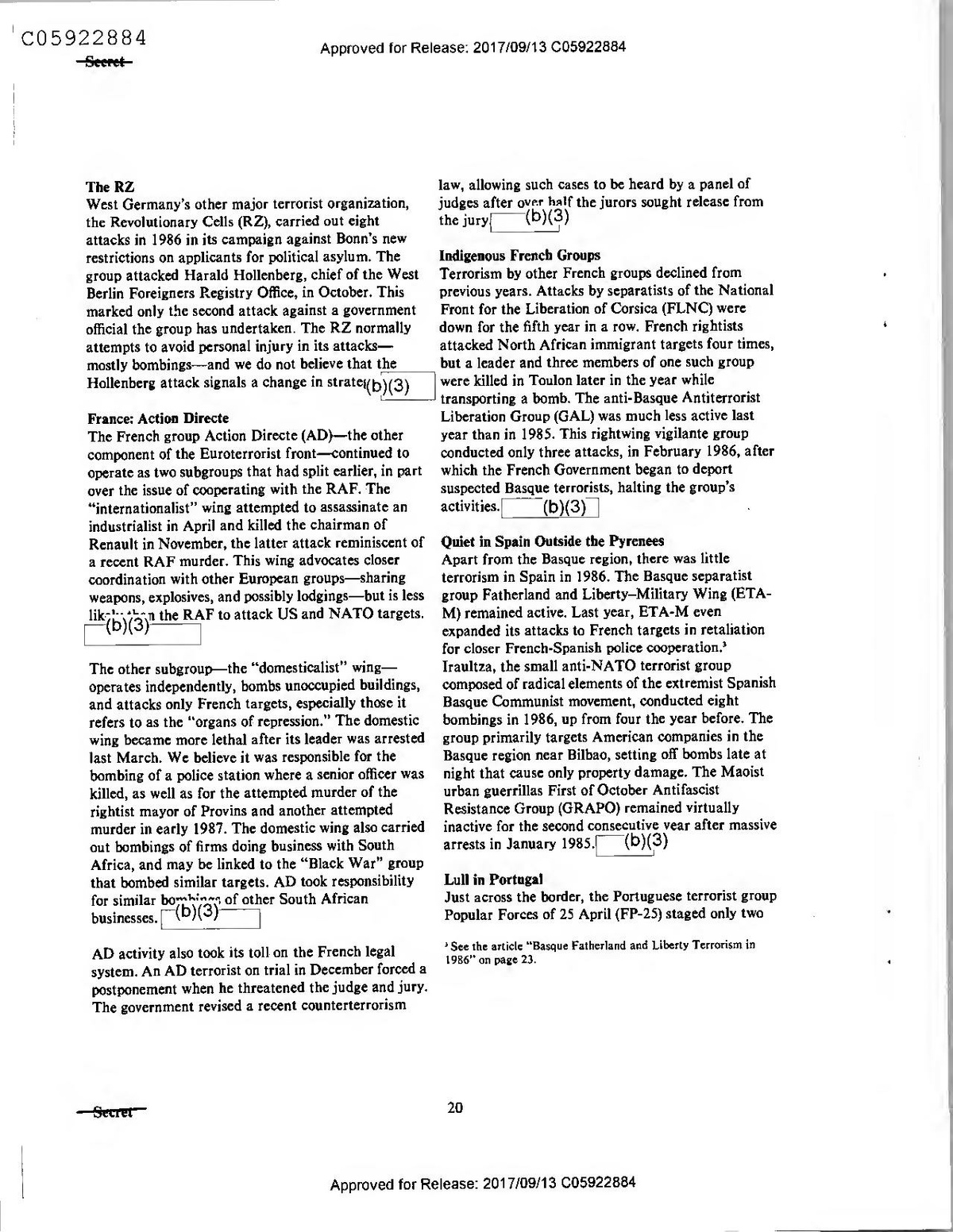
the jury
The RZ
law, allowing such cases to be heard by a panel of West Germany's other major terrorist organization, judges after over half the jurors sought release from the Revolutionary Cells (RZ), carried out eight
(b)(3) attacks in 1986 in its campaign against Bonn's new restrictions on applicants for political asylum. The Indigenous French Groups group attacked Harald Hollenberg, chief of the West Terrorism by other French groups declined from Berlin Foreigners Registry Office, in October. This previous years. Attacks by separatists of the National marked only the second attack against a government Front for the Liberation of Corsica (FLNC) were official the group has undertaken. The RZ normally down for the fifth year in a row. French rightists attempts to avoid personal injury in its attacks- attacked North African immigrant targets four times, mostly bombings
and we do not believe that the but a leader and three members of one such group Hollenberg attack signals a change in strate(b)(3)
were killed in Toulon later in the year while
transporting a bomb. The anti-Basque Antiterrorist France: Action Directe
Liberation Group (GAL) was much less active last The French group Action Directe (AD)-the other year than in 1985. This rightwing vigilante group component of the Euroterrorist front-continued to
conducted only three attacks, in February 1986, after operate as two subgroups that had split earlier, in part which the French Government began to deport over the issue of cooperating with the RAF. The suspected Basque terrorists, halting the group's "internationalist” wing attempted to assassinate an activities. (b)(3)) industrialist in April and killed the chairman of Renault in November, the latter attack reminiscent of Quiet in Spain Outside the Pyrenees a recent RAF murder. This wing advocates closer Apart from the Basque region, there was little coordination with other European groups-sharing terrorism in Spain in 1986. The Basque separatist weapons, explosives, and possibly lodgings—but is less group Fatherland and Liberty-Military Wing (ETAlik, ban the RAF to attack US and NATO targets. M) remained active. Last year, ETA-M even (b)(3)"
expanded its attacks to French targets in retaliation
for closer French-Spanish police cooperation." The other subgroup—the "domesticalist” wing- Iraultza, the small anti-NATO terrorist group operates independently, bombs unoccupied buildings, composed of radical elements of the extremist Spanish and attacks only French targets, especially those it Basque Communist movement, conducted eight refers to as the “organs of repression." The domestic bombings in 1986, up from four the year before. The wing became more lethal after its leader was arrested group primarily targets American companies in the last March. We believe it was responsible for the Basque region near Bilbao, setting off bombs late at bombing of a police station where a senior officer was night that cause only property damage. The Maoist killed, as well as for the attempted murder of the urban guerrillas First of October Antifascist rightist mayor of Provins and another attempted Resistance Group (GRAPO) remained virtually murder in early 1987. The domestic wing also carried inactive for the second consecutive vear after massive out bombings of firms doing business with South arrests in January 1985. (b)(3) Africa, and may be linked to the “Black War" group that bombed similar targets. AD took responsibility Lull in Portugal for similar bomhins of other South African
Just across the border, the Portuguese terrorist group Popular Forces of 25 April (FP-25) staged only two
businesses. (b)(3)
See the article “Basque Fatherland and Liberty Terrorism in 1986" on page 23.
AD activity also took its toll on the French legal system. An AD terrorist on trial in December forced a postponement when he threatened the judge and jury. The government revised a recent counterterrorism
Secret
20
Approved for Release: 2017/09/13 C05922884
Seeket
(b)(1) (b)(3)
Cache of Grenades and Explosives Found On 10 March, a woman found four Soviet-made handgrenades, a pipebomb, a chemical timer, and a detonator of Western origin in a trash container in Munich. Police have offered a reward for information on the owners of the cache. They speculate that the items may be left over from a Palestinian cache, because similar grenades were used in the 1972 Munich Olympics attack and some of the material was wrapped in a newspaper dating from February 1971. (b)(3)
Switzerland
(b)(1) (b)(3)
Crackdown on Libyan Terrorist Activity Swiss authorities have found increasing evidence that Libya is misusing its diplomatic privileges to cache weapons and false identity documents, according to the German press, and Libya may be targeting two persons for assassination.
Swiss authorities recently opened a diplomatic pouch, probably to look for weapons, an indication that they are already taking steps to thwart Libyan activity. Tripoli reportedly believes its missions in West Germany and the rest of Europe also are being carefully watched. (b)(3)
Likely targets of Libyan terrorist activity are anti-Qadhafi dissidents or proArafat Palestinians who were sentenced in late March for bombings of Libyan and Syrian installations there last year.
(b)(1) (b)(3)
Secret
10
Approved for Release: 2017/09/13 C05632837.
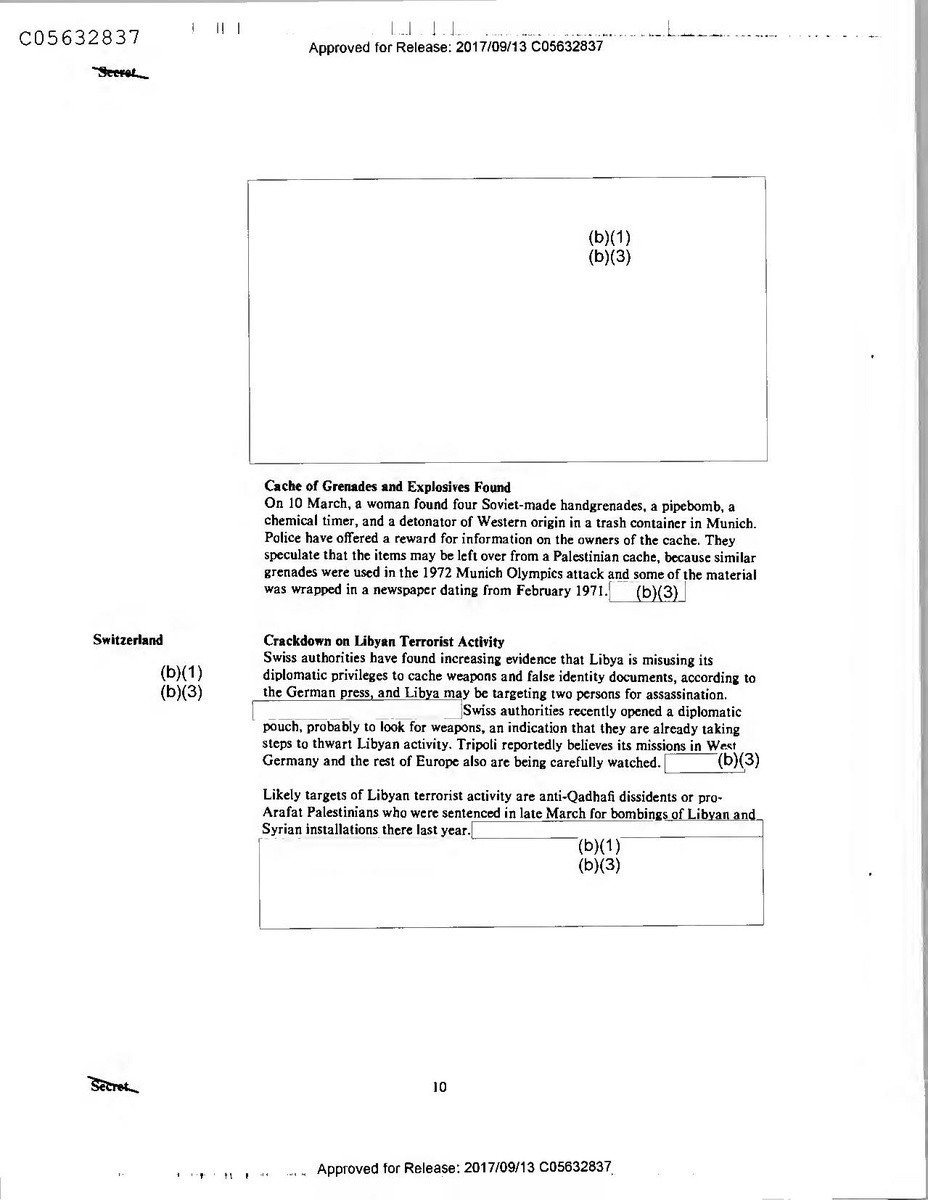
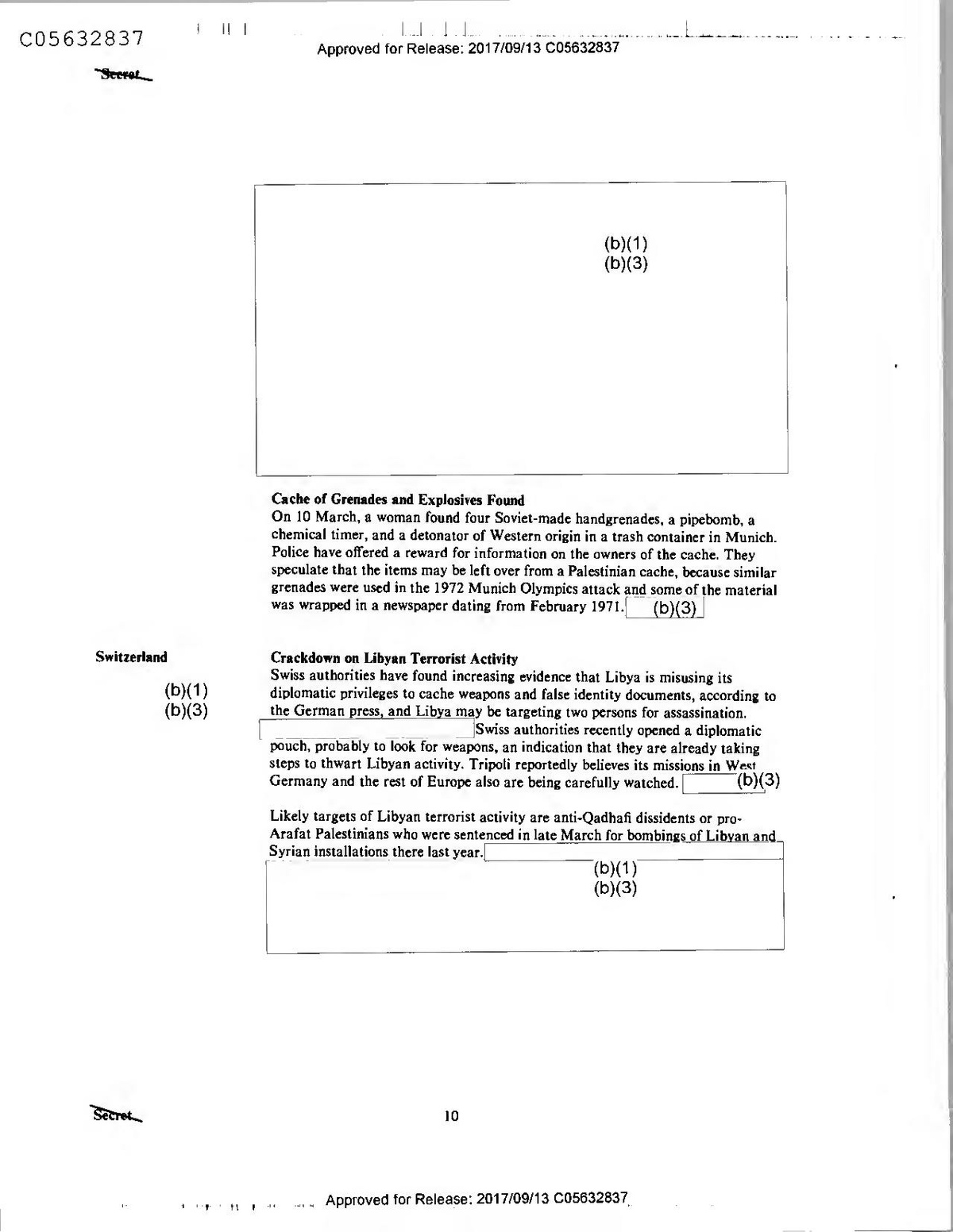
Seeket
(b)(1) (b)(3)
Cache of Grenades and Explosives Found On 10 March, a woman found four Soviet-made handgrenades, a pipebomb, a chemical timer, and a detonator of Western origin in a trash container in Munich. Police have offered a reward for information on the owners of the cache. They speculate that the items may be left over from a Palestinian cache, because similar grenades were used in the 1972 Munich Olympics attack and some of the material was wrapped in a newspaper dating from February 1971. (b)(3)
Switzerland
(b)(1) (b)(3)
Crackdown on Libyan Terrorist Activity Swiss authorities have found increasing evidence that Libya is misusing its diplomatic privileges to cache weapons and false identity documents, according to the German press, and Libya may be targeting two persons for assassination.
Swiss authorities recently opened a diplomatic pouch, probably to look for weapons, an indication that they are already taking steps to thwart Libyan activity. Tripoli reportedly believes its missions in West Germany and the rest of Europe also are being carefully watched. (b)(3)
Likely targets of Libyan terrorist activity are anti-Qadhafi dissidents or proArafat Palestinians who were sentenced in late March for bombings of Libyan and Syrian installations there last year.
(b)(1) (b)(3)
Secret
10
Approved for Release: 2017/09/13 C05632837.
use.
international attacks, compared with 10 the previous made US military personnel less visible by issuing year. FP-25 detonated a car bomb at the US Embassy them ordinary license plates. The only two arson on 18 February—the only attack on US diplomatic attacks against US-owned vehicles last year occurred facilities in Western Europe last year. On 17 May the when the distinctive official license plates were still in group fired a mortar round at the Iberian Atlantic
(b)(3) Command facility Neither incident caused any casualties. (b)(3);
Turkey
The most serious new development in anti-Turkish FP-25 was more active on the domestic front,
terrorism last year was the escalating violence of the attacking Portugal's tourist industry during the separatist Kurdish Workers' Party (PKK) after summer and fall by setting off bombs in the Algarve Ankara launched an airstrike against the group's resort area. The trials of FP-25's leader, who has camps in Irag in August. By October the PKK had become a national folk hero, and 56 of its members expanded its list of targets to include NATO when it continued throughout 1986. Late in the year, the attacked a radar site in the southeast with rockets and group reportedly spawned an offshoot called the automatic weapons. The group also carried its Armed Revolutionary Organization (ORA) that has campaign to other West European countries, where it yet to carry out any attacks because it is less v;": targeted Turkish officials:
(b)(3) organized and less capable than FP-25.
• A young PKK member was arrested in West
Germany in August as he opened a train station locker containing explosives, weapons, and ammunition. He apparently planned to attack the Turkish Consulate General in Hamburg.
(b)(1) (b)(3)
• Dutch officials apprehended in late August a PKK
activist who planned to attack a Turkish consulate in the Netherlands. He was carrying weapons and explosives at the time of his arrest.
We believe PKK violence will continue this year in Turkey and abroad as the group continues its struggle for an independent Kurdish state. Turkish authorities also continued to arrest members of other indigenous groups, which probably
accounted for their low level of activity
(b)(3) Greece Radical leftist terrorists expressed their growing Italy disapproval of the Papandreou government's domestic By all accounts, 1986 was the quietest year for and foreign policies with more attacks on government terrorism in Italy since 1969. The best-known group, targets in 1986. A bombing campaign against
the Red Brigades (BR), in decline since 1982, government buildings in October was claimed by both conducted only two attacks last year. The BR the Revolutionary People's Struggle (ELA) and the murdered a former mayor of Florence but bungled an Revolutionary Organization 17 November. The 17 attempt on the life of a government adviser. Last year, November group typically commits assassinations- courts convicted hundreds of old-line BR members including that of a Greek businessman last April- including leaders like Barbara Balzarani and making these bombings a new tactic for the group. Greek terrorists attacked US citizens less often in 1986, perhaps in part because the Greek Government
21
Seeret
Approved for Release: 2017/09/13 C05922884
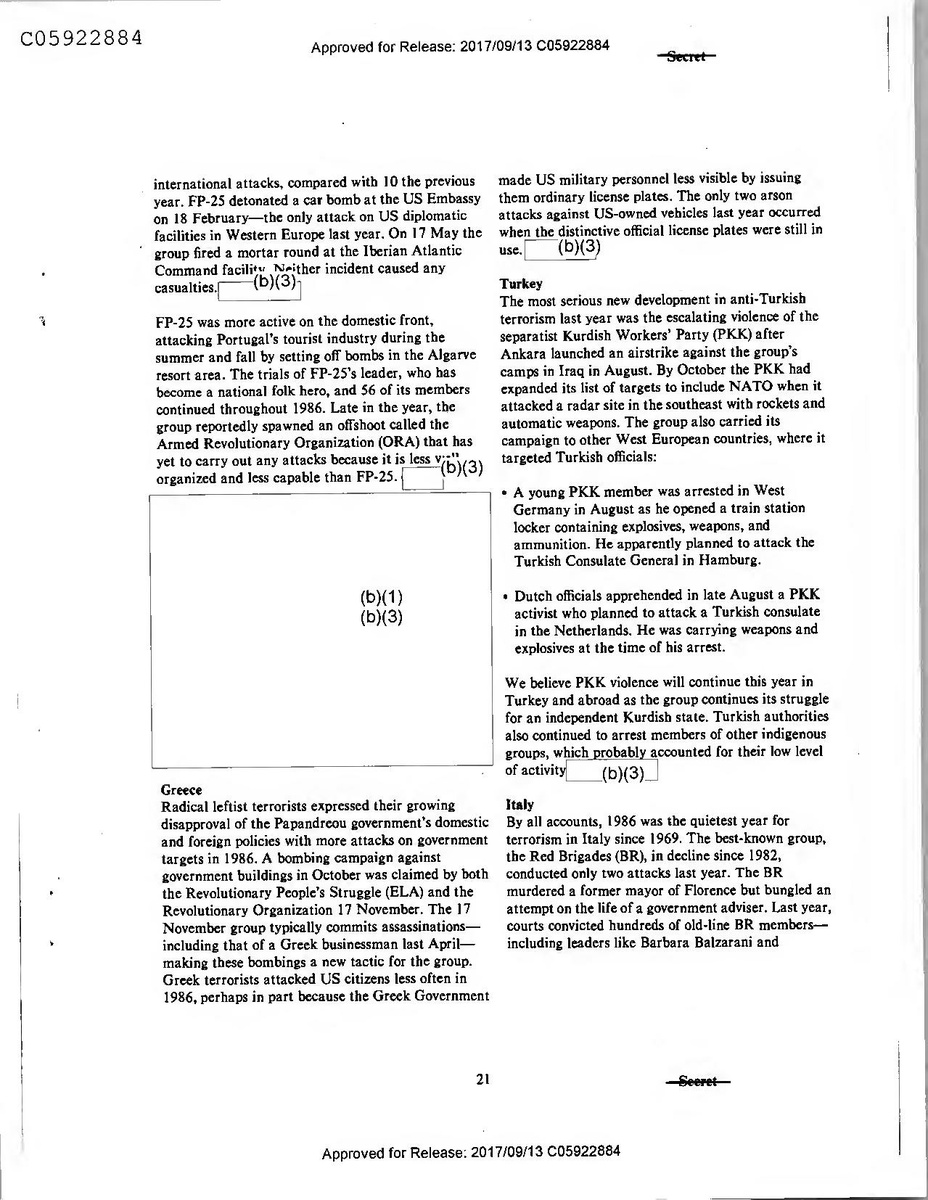
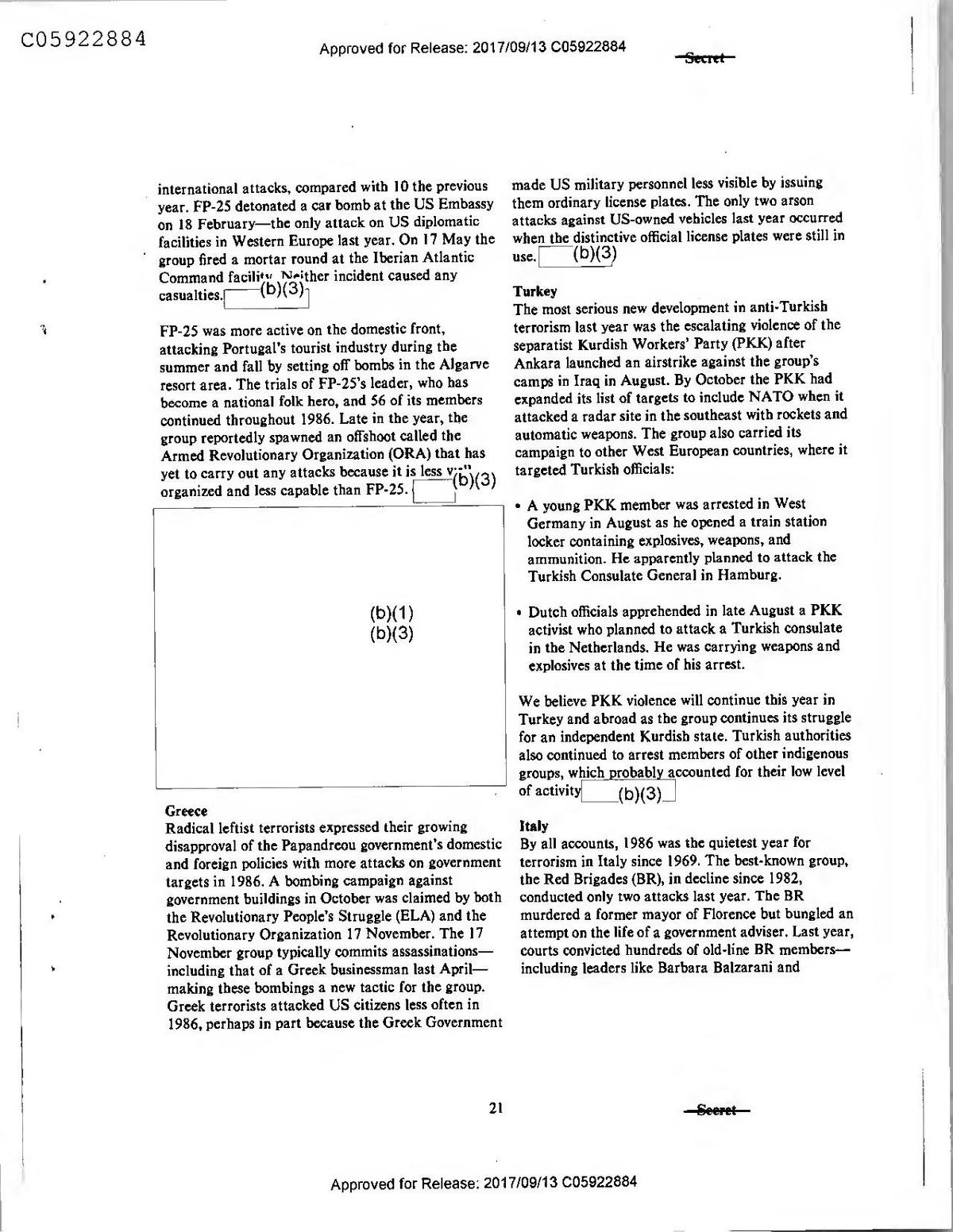
use.
international attacks, compared with 10 the previous made US military personnel less visible by issuing year. FP-25 detonated a car bomb at the US Embassy them ordinary license plates. The only two arson on 18 February—the only attack on US diplomatic attacks against US-owned vehicles last year occurred facilities in Western Europe last year. On 17 May the when the distinctive official license plates were still in group fired a mortar round at the Iberian Atlantic
(b)(3) Command facility Neither incident caused any casualties. (b)(3);
Turkey
The most serious new development in anti-Turkish FP-25 was more active on the domestic front,
terrorism last year was the escalating violence of the attacking Portugal's tourist industry during the separatist Kurdish Workers' Party (PKK) after summer and fall by setting off bombs in the Algarve Ankara launched an airstrike against the group's resort area. The trials of FP-25's leader, who has camps in Irag in August. By October the PKK had become a national folk hero, and 56 of its members expanded its list of targets to include NATO when it continued throughout 1986. Late in the year, the attacked a radar site in the southeast with rockets and group reportedly spawned an offshoot called the automatic weapons. The group also carried its Armed Revolutionary Organization (ORA) that has campaign to other West European countries, where it yet to carry out any attacks because it is less v;": targeted Turkish officials:
(b)(3) organized and less capable than FP-25.
• A young PKK member was arrested in West
Germany in August as he opened a train station locker containing explosives, weapons, and ammunition. He apparently planned to attack the Turkish Consulate General in Hamburg.
(b)(1) (b)(3)
• Dutch officials apprehended in late August a PKK
activist who planned to attack a Turkish consulate in the Netherlands. He was carrying weapons and explosives at the time of his arrest.
We believe PKK violence will continue this year in Turkey and abroad as the group continues its struggle for an independent Kurdish state. Turkish authorities also continued to arrest members of other indigenous groups, which probably
accounted for their low level of activity
(b)(3) Greece Radical leftist terrorists expressed their growing Italy disapproval of the Papandreou government's domestic By all accounts, 1986 was the quietest year for and foreign policies with more attacks on government terrorism in Italy since 1969. The best-known group, targets in 1986. A bombing campaign against
the Red Brigades (BR), in decline since 1982, government buildings in October was claimed by both conducted only two attacks last year. The BR the Revolutionary People's Struggle (ELA) and the murdered a former mayor of Florence but bungled an Revolutionary Organization 17 November. The 17 attempt on the life of a government adviser. Last year, November group typically commits assassinations- courts convicted hundreds of old-line BR members including that of a Greek businessman last April- including leaders like Barbara Balzarani and making these bombings a new tactic for the group. Greek terrorists attacked US citizens less often in 1986, perhaps in part because the Greek Government
21
Seeret
Approved for Release: 2017/09/13 C05922884
Giovanni Senzani—for crimes committed earlier in Armenian Terrorism in 1986
the decade. There are now fewer professional
terrorists on the outside, and jailed leaders are no There were few Armenian terrorist attacks last year. longer able to order attacks from prison, leaving the Most Armenian violence during 1986, moreover, was Red Brigades in a weakened position but still capable internecine and probably stemmed from the
of launching sporadic attacks.
(b)(3) longstanding rivalry between the conservative Armenian Revolutionary Federation (Dashnag Party) The Benelux Nations and the leftwing terrorist Armenian Secret Army for Terrorist activity in Belgium dropped off in 1986. the Liberation of Armenia (ASALA). Several
Arrests of virtually the entire infrastructure of the Dashnag members were killed or kidnaped in Beirut Communist Combatant Cells (CCC) in December in 1986 by a group calling itself the “Armenian 1985, followed by raids on safehouses the next month, Revolutionary Federation-Revolutionary
set the tone for 1986 and halted the CCC's 15-month Movement," probably a covername for ASALA. reign of terror. There have been no further attacks by (b)(3)
the group, and the upcoming trials of the CCC
members probably will serve to keep a lid on terrorism Armenians were active elsewhere. ASALA may have in Belgium for the rest of this year. (b)(3) cooperated with the Lebanese Armed Revolutionary Faction in two major bombing campaigns in Paris. There is no cohesive leftwing terrorist movement in Farther afield, a car bomb that exploded at the the Netherlands, but there were seven international Turkish Consulate in Melbourne, Australia, in
terrorist attacks there last year. Most of these were December seriously damaged the building. The committed by Middle Eastern groups or new groups suicide bomber and an accomplice arrested later had opposed to business ties to South Africa. (b)(3) ties to the Justice Commandos of the Armenian Genocide (JCAG), a rightwing terrorist group linked Scandinavia to the Dashnag Party. The Melbourne car bombing There has been no indigenous terrorism in may indicate that Armenian terrorists will renew Scandinavia, but Olaf Palme's murder heightened the their terrorist comnaign to gain an Armenian
sense of vulnerability in the region to such attacks. homeland. [(b)(3)
The assassination in February 1986 of the Swedish
Prime Minister has not been linked firmly to a Several trials of Armenian terrorists for attacks terrorist group, but Stockholm police have earlier in the decade concluded in 1986. US courts in aggressively pursued the possible involvement of the Philadelphia and Los Angeles sentenced six JCAG Kurdish Workers' Party. Otherwise, the region members for anti-Turkish bombings and one murder. experienced only a few instances of Middle In November, Monte Melkonian, the leader of the Eastern-sponsored terrorism.
(b)(3) ASALA-Revolutionary Movement (ASALA-RM). received a six-year sentence in Paris after being
(b)(3) convicted of forgery and possession of weapons and
explosives. __(b)(3)
Secret
22
Approved for Release: 2017/09/13 C05922884
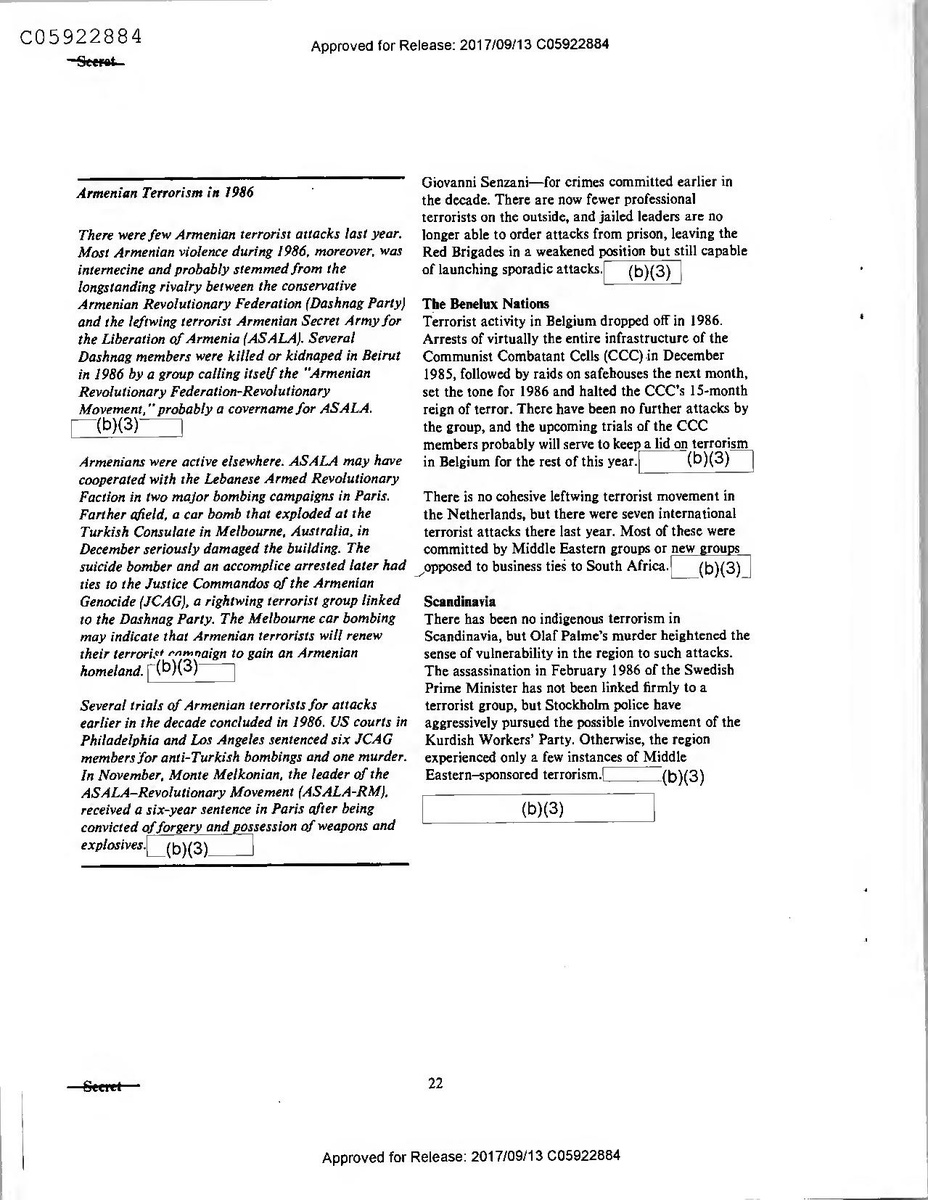
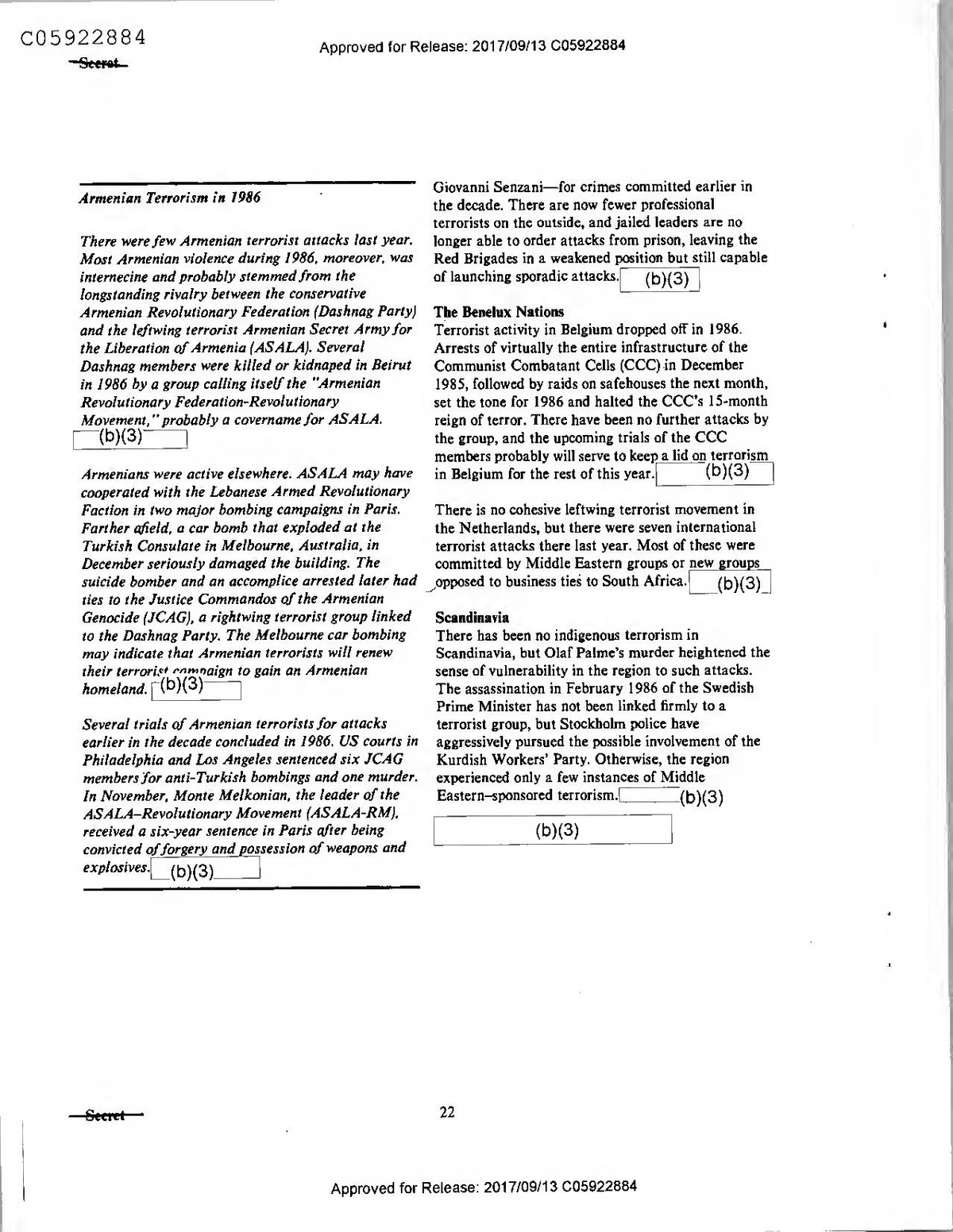
Giovanni Senzani—for crimes committed earlier in Armenian Terrorism in 1986
the decade. There are now fewer professional
terrorists on the outside, and jailed leaders are no There were few Armenian terrorist attacks last year. longer able to order attacks from prison, leaving the Most Armenian violence during 1986, moreover, was Red Brigades in a weakened position but still capable internecine and probably stemmed from the
of launching sporadic attacks.
(b)(3) longstanding rivalry between the conservative Armenian Revolutionary Federation (Dashnag Party) The Benelux Nations and the leftwing terrorist Armenian Secret Army for Terrorist activity in Belgium dropped off in 1986. the Liberation of Armenia (ASALA). Several
Arrests of virtually the entire infrastructure of the Dashnag members were killed or kidnaped in Beirut Communist Combatant Cells (CCC) in December in 1986 by a group calling itself the “Armenian 1985, followed by raids on safehouses the next month, Revolutionary Federation-Revolutionary
set the tone for 1986 and halted the CCC's 15-month Movement," probably a covername for ASALA. reign of terror. There have been no further attacks by (b)(3)
the group, and the upcoming trials of the CCC
members probably will serve to keep a lid on terrorism Armenians were active elsewhere. ASALA may have in Belgium for the rest of this year. (b)(3) cooperated with the Lebanese Armed Revolutionary Faction in two major bombing campaigns in Paris. There is no cohesive leftwing terrorist movement in Farther afield, a car bomb that exploded at the the Netherlands, but there were seven international Turkish Consulate in Melbourne, Australia, in
terrorist attacks there last year. Most of these were December seriously damaged the building. The committed by Middle Eastern groups or new groups suicide bomber and an accomplice arrested later had opposed to business ties to South Africa. (b)(3) ties to the Justice Commandos of the Armenian Genocide (JCAG), a rightwing terrorist group linked Scandinavia to the Dashnag Party. The Melbourne car bombing There has been no indigenous terrorism in may indicate that Armenian terrorists will renew Scandinavia, but Olaf Palme's murder heightened the their terrorist comnaign to gain an Armenian
sense of vulnerability in the region to such attacks. homeland. [(b)(3)
The assassination in February 1986 of the Swedish
Prime Minister has not been linked firmly to a Several trials of Armenian terrorists for attacks terrorist group, but Stockholm police have earlier in the decade concluded in 1986. US courts in aggressively pursued the possible involvement of the Philadelphia and Los Angeles sentenced six JCAG Kurdish Workers' Party. Otherwise, the region members for anti-Turkish bombings and one murder. experienced only a few instances of Middle In November, Monte Melkonian, the leader of the Eastern-sponsored terrorism.
(b)(3) ASALA-Revolutionary Movement (ASALA-RM). received a six-year sentence in Paris after being
(b)(3) convicted of forgery and possession of weapons and
explosives. __(b)(3)
Secret
22
Approved for Release: 2017/09/13 C05922884
Basque Fatherland and Liberty Terrorism in 19867(b)(3)
The Military Wing of the Basque Fatherland and On 2 February 1987, ETA-M staged a successfUL Liberty separatist group (ETA-M) remains adaptable, car-bomb attack against a military bus in Zaragoza, dedicated, and resourcefUL in waging its 18-year
killing two persons and wounding 40 others in its campaign to establish an independent Basque state. first attack in that city. The capture of a major ETA arsenal and hideout in southern France, coupled with the arrests of several The broadening of operations, however, does not “Madrid Commando" terrorists, however, was an appear to have diluted its efforts elsewhere. ETA-M's unexpected blow to the group's morale and
activity was especially deadly in Madrid, where 22 operational capabilities. Nevertheless, we think these persons died. The majority of ETA-M's international setbacks are temporary, and fully expect the group to attacks, however, still occurred on the group's home resume its campaign of terrorist violence against turf in the Basque region.
(b)(3) Madrid and Paris, Spain's new ally in the struggle against Basque terrorism. (b)(3)
Setbacks for ETA-M
ETA-M was hurt by the active and successfUL Overview
campaign waged by Spanish and French police, who In 1986, ETA-M was the most active terrorist group cooperated more closely last year than ever before. in Western Europe, with 36 international attacks. Moreover, the group's more violent tactics may be Adding attacks against Spanish domestic targets tarnishing its image among the Basque people. A brings the group's total to 56 incidents last year. Spanish amnesty program has been highly successfUL: ETA-M has always targeted the Spanish
nearly 200 ETA members have taken advantage of Government, especially the military and police forces, the program, which pardons terrorists who have not but in 1986 it also began to attack French interests in been involved in blood crimes and who renounce Spain. This accounted for the unusually high number violence. ETA-M's leaders attempted to forestall of international incidents attributed to the group and further defections by assassinating a former leader, a gave ETA the lion's share of all international terrorist young mother of two, who joined the amnesty acts committed in Spain last year. ETA-M's tactics program. The brutal murder-gunmen shot her in changed little in 1986: bombings comprised over two- front of her children at a festival-may have lost thirds of its attacks, and the group also conducted ETA-M popular support and, at least temporarily. armed attacks and committed arson. ETA continued affected its ability to recruit new members (b)(3) to use kidnaping, theft, and extortion of ll its coffers and intimidate the local populace
(b)(3)
Better Spanish-French counterterrorist cooperation
dealt the group major blows last year. ETA-M ETA-M extended its operational reach beyond the previously used France as a sanctuary from which the Basque provinces, Madrid, and Mediterranean resort group conducted operations across the border into areas to include other cities:
Spain. French security services last year cracked
down on the group's activities in southern France, • On 13 September 1986, ETA-M detonated a car turning over 30 terrorists to Spain for prosecution and bomb near a civil guard patrol in Barcelona,
expelling others of the 200 members who had been injuring three guards and a passerby. The attack active there
(b)(3) occurred shortly before Barcelona was selected as host city for the 1992 Olympics.
23
Secrer DI TR 87-004 26 February 1987
Approved for Release: 2017/09/13 C05922884
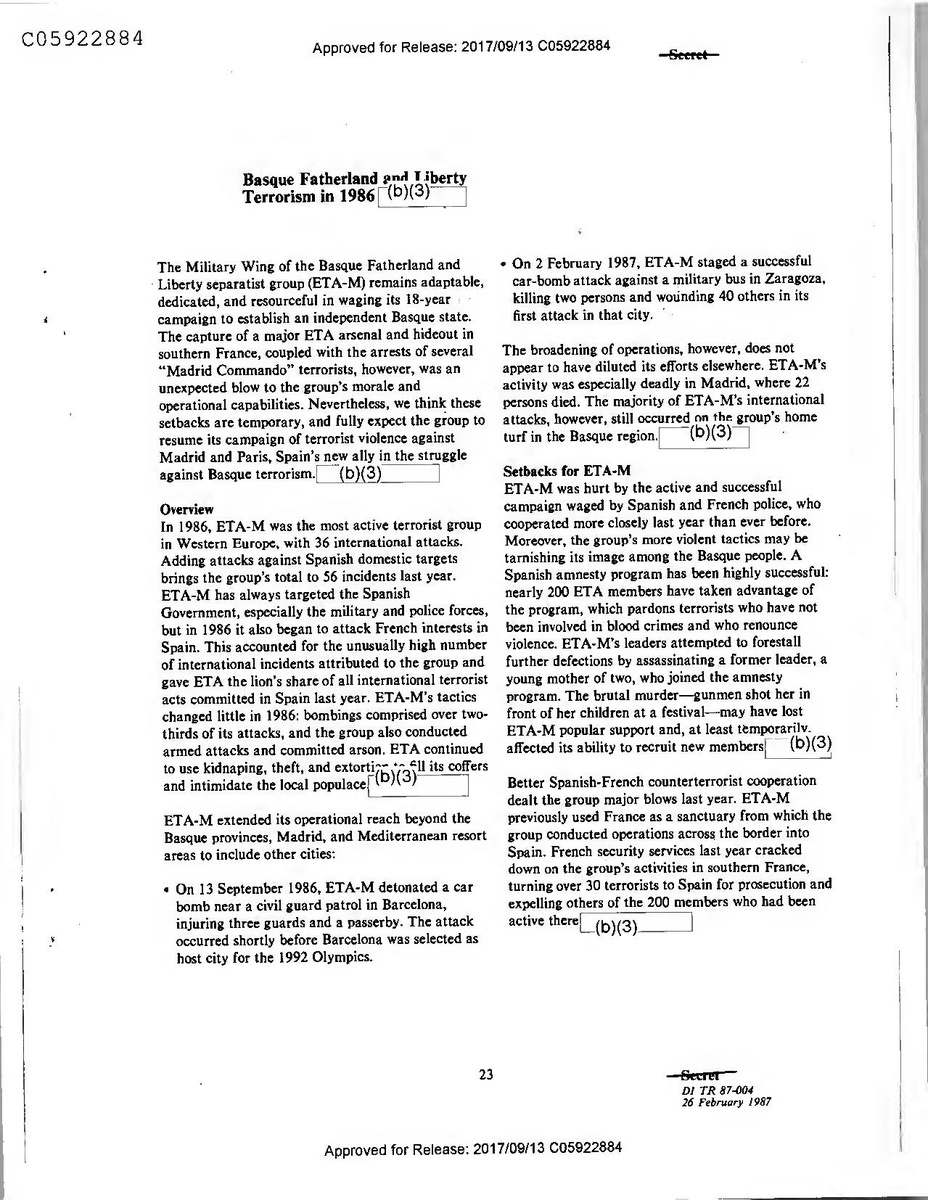
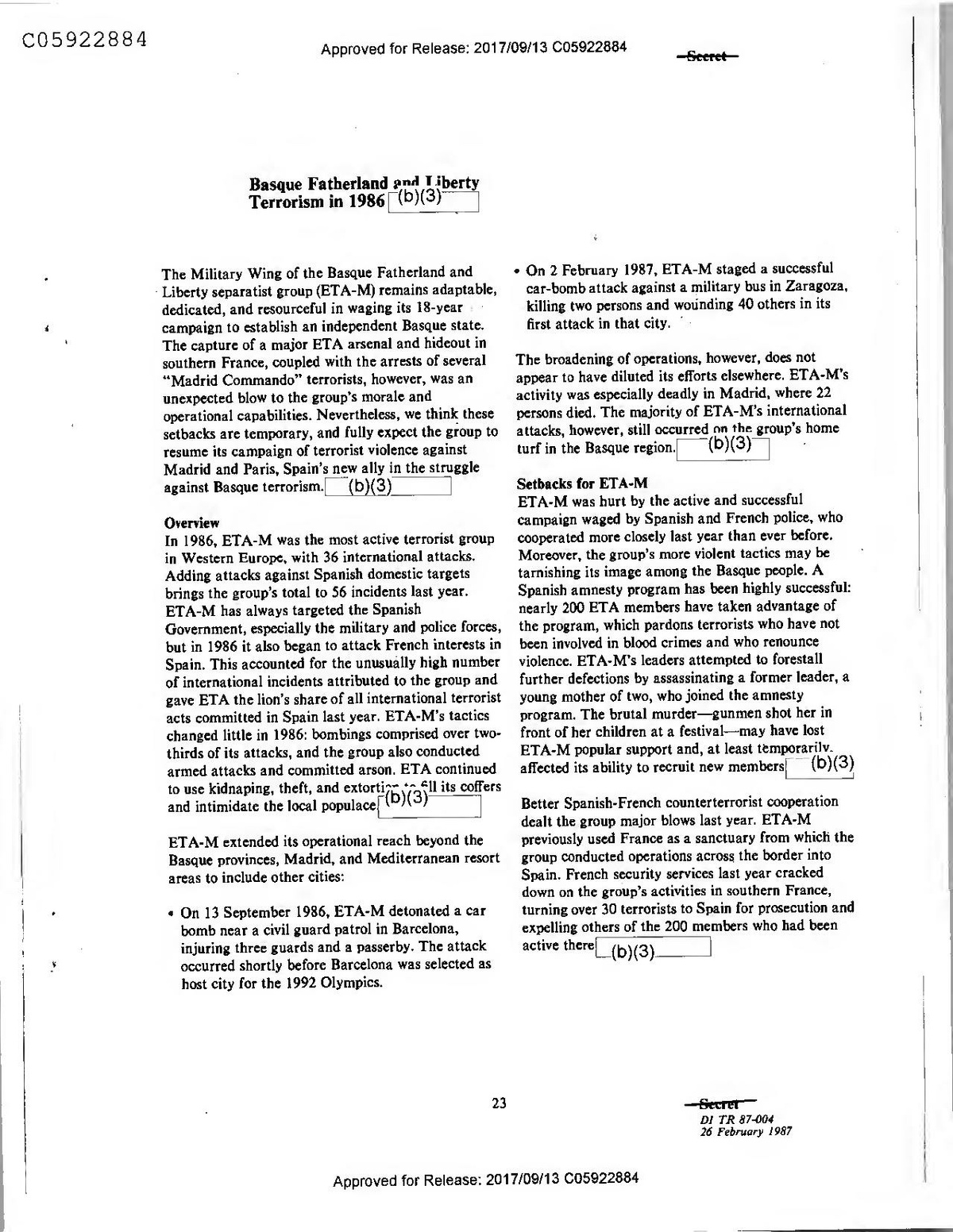
Basque Fatherland and Liberty Terrorism in 19867(b)(3)
The Military Wing of the Basque Fatherland and On 2 February 1987, ETA-M staged a successfUL Liberty separatist group (ETA-M) remains adaptable, car-bomb attack against a military bus in Zaragoza, dedicated, and resourcefUL in waging its 18-year
killing two persons and wounding 40 others in its campaign to establish an independent Basque state. first attack in that city. The capture of a major ETA arsenal and hideout in southern France, coupled with the arrests of several The broadening of operations, however, does not “Madrid Commando" terrorists, however, was an appear to have diluted its efforts elsewhere. ETA-M's unexpected blow to the group's morale and
activity was especially deadly in Madrid, where 22 operational capabilities. Nevertheless, we think these persons died. The majority of ETA-M's international setbacks are temporary, and fully expect the group to attacks, however, still occurred on the group's home resume its campaign of terrorist violence against turf in the Basque region.
(b)(3) Madrid and Paris, Spain's new ally in the struggle against Basque terrorism. (b)(3)
Setbacks for ETA-M
ETA-M was hurt by the active and successfUL Overview
campaign waged by Spanish and French police, who In 1986, ETA-M was the most active terrorist group cooperated more closely last year than ever before. in Western Europe, with 36 international attacks. Moreover, the group's more violent tactics may be Adding attacks against Spanish domestic targets tarnishing its image among the Basque people. A brings the group's total to 56 incidents last year. Spanish amnesty program has been highly successfUL: ETA-M has always targeted the Spanish
nearly 200 ETA members have taken advantage of Government, especially the military and police forces, the program, which pardons terrorists who have not but in 1986 it also began to attack French interests in been involved in blood crimes and who renounce Spain. This accounted for the unusually high number violence. ETA-M's leaders attempted to forestall of international incidents attributed to the group and further defections by assassinating a former leader, a gave ETA the lion's share of all international terrorist young mother of two, who joined the amnesty acts committed in Spain last year. ETA-M's tactics program. The brutal murder-gunmen shot her in changed little in 1986: bombings comprised over two- front of her children at a festival-may have lost thirds of its attacks, and the group also conducted ETA-M popular support and, at least temporarily. armed attacks and committed arson. ETA continued affected its ability to recruit new members (b)(3) to use kidnaping, theft, and extortion of ll its coffers and intimidate the local populace
(b)(3)
Better Spanish-French counterterrorist cooperation
dealt the group major blows last year. ETA-M ETA-M extended its operational reach beyond the previously used France as a sanctuary from which the Basque provinces, Madrid, and Mediterranean resort group conducted operations across the border into areas to include other cities:
Spain. French security services last year cracked
down on the group's activities in southern France, • On 13 September 1986, ETA-M detonated a car turning over 30 terrorists to Spain for prosecution and bomb near a civil guard patrol in Barcelona,
expelling others of the 200 members who had been injuring three guards and a passerby. The attack active there
(b)(3) occurred shortly before Barcelona was selected as host city for the 1992 Olympics.
23
Secrer DI TR 87-004 26 February 1987
Approved for Release: 2017/09/13 C05922884
International Terrorist Incidents by ETA-M in 1986
Labourd
Eliálde
i Cantabria
San Algorta Las Arenss
Sebastián Bilbao
Zarauz
Repteria Vizcaya
Eibar
Guipuzcoa BASQUE
PAYS BASQUE France
BasseNavarre
Soule
COUNTRY
Alava
NAMA RARE
Spain
Burgos
Bay of Biscay
France
Gijón
Rio Ebro
Rio Aragón
VaqueiroBasque Beret Aree Andorre
Menlese
Intarnational boundary Spanish autonomous
region boundary Spanish province
boundary Former Franch intarnal
administrative boundary
Barcelona
MADRID
Road
Port.
the Rail
Spain
o
B BALEARIC ISLANDS
Sovitte
Mediterranean Sea
Site of terrorist attack
Strah of Gibraltar
Gibraltar (U.K.)
Ceuta (50)
Mollida (Sp.)
Algerla
o
40 Kilometers
300 Kilometer
40 Miles
Morocco
300 Miles
709661 (B00348) 3-87
(b)(3)
Secret
24
Approved for Release: 2017/09/13 C05922884
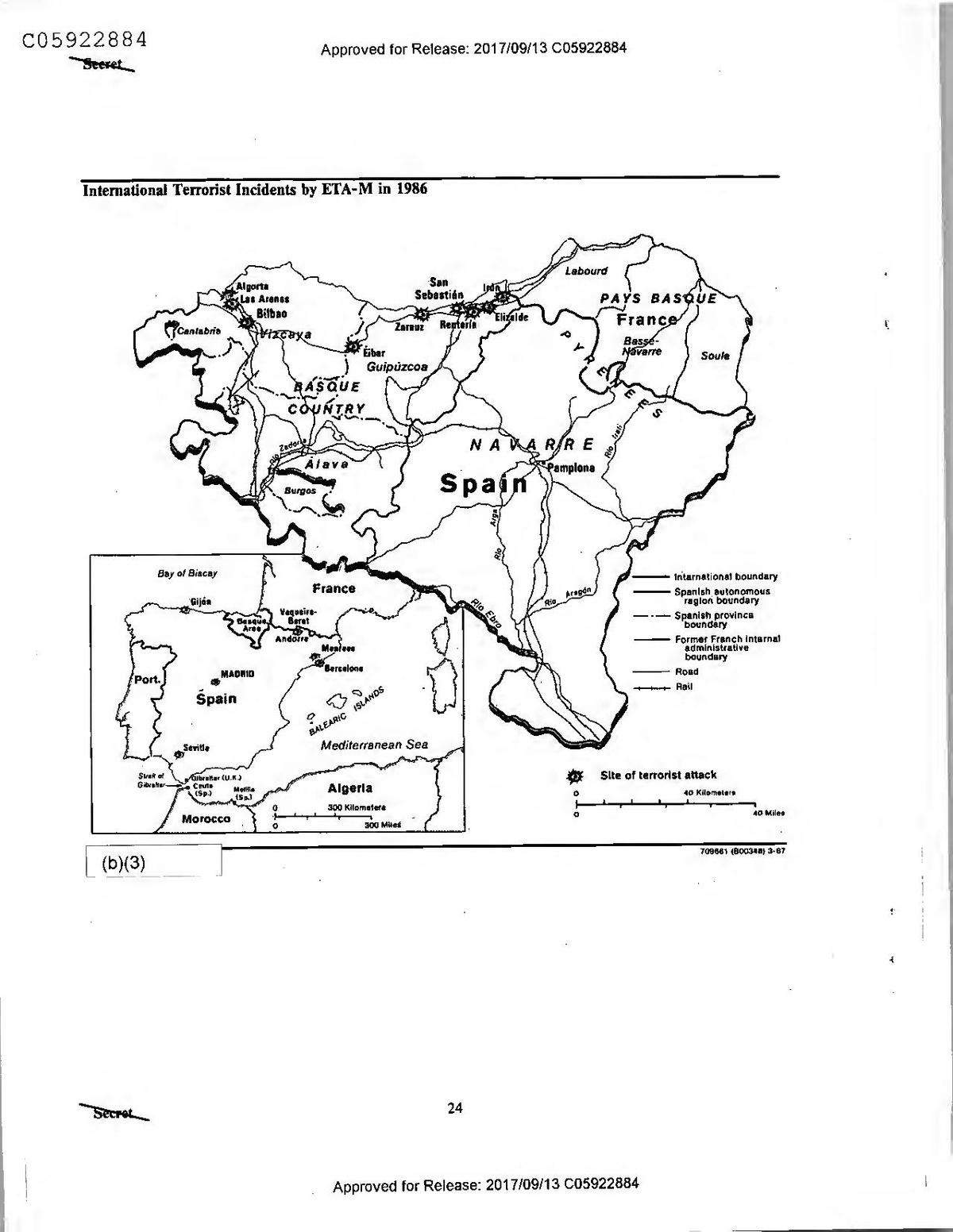
International Terrorist Incidents by ETA-M in 1986
Labourd
Eliálde
i Cantabria
San Algorta Las Arenss
Sebastián Bilbao
Zarauz
Repteria Vizcaya
Eibar
Guipuzcoa BASQUE
PAYS BASQUE France
BasseNavarre
Soule
COUNTRY
Alava
NAMA RARE
Spain
Burgos
Bay of Biscay
France
Gijón
Rio Ebro
Rio Aragón
VaqueiroBasque Beret Aree Andorre
Menlese
Intarnational boundary Spanish autonomous
region boundary Spanish province
boundary Former Franch intarnal
administrative boundary
Barcelona
MADRID
Road
Port.
the Rail
Spain
o
B BALEARIC ISLANDS
Sovitte
Mediterranean Sea
Site of terrorist attack
Strah of Gibraltar
Gibraltar (U.K.)
Ceuta (50)
Mollida (Sp.)
Algerla
o
40 Kilometers
300 Kilometer
40 Miles
Morocco
300 Miles
709661 (B00348) 3-87
(b)(3)
Secret
24
Approved for Release: 2017/09/13 C05922884
The police raid apparently foiled ETA plans to attack a French-built shopping center in Spain. The police reportedly uncovered information on ETA-M's operational plans, targets, safehouses, weapons, and explosives. It is too early to tell if the Madrid Commando is in total disarray. We believe rank-andfile members rather than key leaders were arrested in the roundup, leaving the possibility that the Madrid group may still be able to stage attacks.
(b)(3)
United Press o
ETA-M bombing of Civil Guard bus in Madrid, 14 July 1986 (U)
Joint cooperation, moreover, led to the discovery of a major ETA-M arms cache in southern France, last November, and the arrests of several ETA-M leaders. Police confiscated large amounts of cash, weapons, explosives, and documents detailing the group's finances, structure, and operational plans. Spanish officials hailed the raid as the single most important (b)(3)against ETA in the group's 18-year history.
ETA Strikes Back In retaliation for the French crackdown last year, ETA began a wave of terrorist attacks against French property in Spain. French trucks were machinegunned during the winter and spring, and Frenchregistered vehicles were burned almost daily during the summer and early fall. French car showrooms were also hit. After the November raid, ETA-M began to attack larger businesses, causing numerous injuries and one death. ETA-M also focused the attacks on French beach resorts, and late last year planted bombs at sk; hotels that are partially French owned
(b)(3)
Prospects ETA-M must struggle if it is to regain the momentum it had in 1983. That year ETA-M was responsible for 165 attacks-international and domestic-almost triple the 1986 level. The group has demonstrated enormous staying power over the years, however, and almost certainly will remain a challenge to Spanish and French police. French-Spanish cooperation against ETA-M is likely to continue, moreover, and could spur more indiscriminate and lethal attacks against both French and Spanish interests.
(b)(3)
The Madrid Commando The Spanish national police scored an important victory when they arrested nine of the estimated 12 members of the violent Madrid Commando unit on 16 January 1987. The Commando, active since the early 1980s, was responsible for some of the most spectacular terrorist operations of ETA-M last year. The police acted on information gained from the November raid and on carefUL Spanish and French intelligence work during the past months: • Spanish officials believe the Commando carried out
a rocket attack on the Spanish Defense Ministry
building last summer. • Police believe the unit was also responsible for two
attacks on Civil Guard vehicles that killed 18 guards and for murdering three military officers in
1986. • The Madrid Commando staged an abortive attempt
on the life of the Spanish Judiciary Council President Hernandez-Gil
(b)(3)
(b)(3)
25
Secret
Approved for Release: 2017/09/13 C05922884
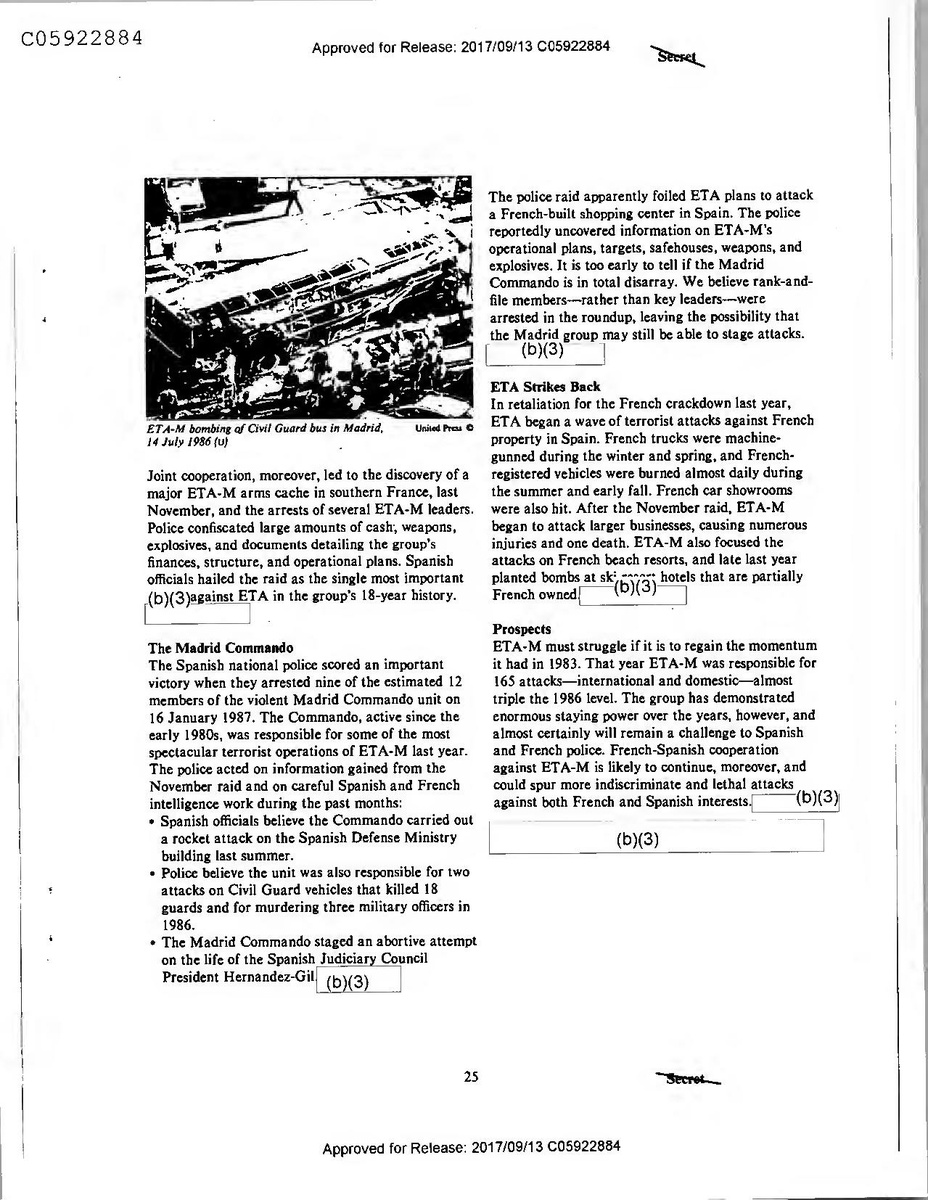
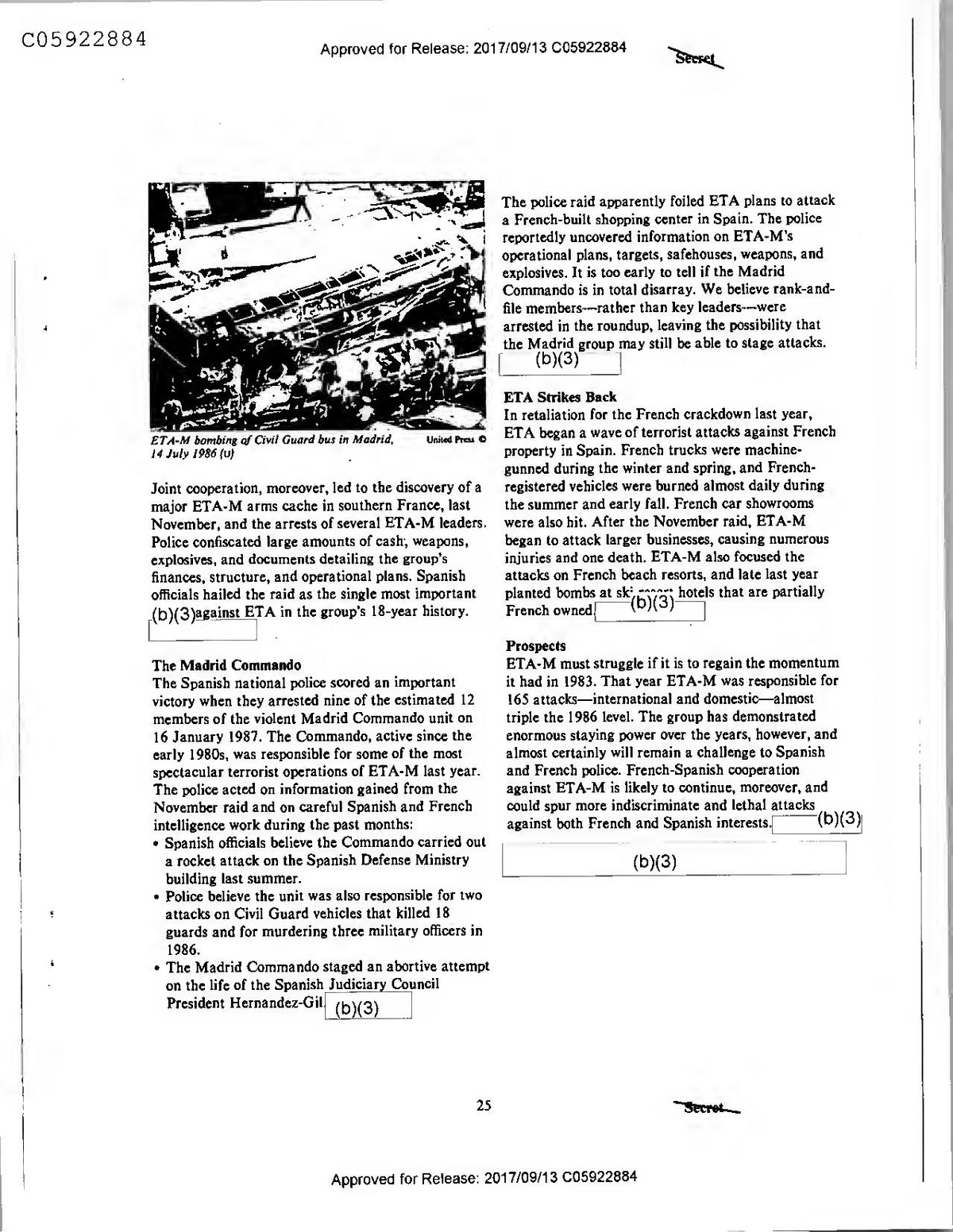
The police raid apparently foiled ETA plans to attack a French-built shopping center in Spain. The police reportedly uncovered information on ETA-M's operational plans, targets, safehouses, weapons, and explosives. It is too early to tell if the Madrid Commando is in total disarray. We believe rank-andfile members rather than key leaders were arrested in the roundup, leaving the possibility that the Madrid group may still be able to stage attacks.
(b)(3)
United Press o
ETA-M bombing of Civil Guard bus in Madrid, 14 July 1986 (U)
Joint cooperation, moreover, led to the discovery of a major ETA-M arms cache in southern France, last November, and the arrests of several ETA-M leaders. Police confiscated large amounts of cash, weapons, explosives, and documents detailing the group's finances, structure, and operational plans. Spanish officials hailed the raid as the single most important (b)(3)against ETA in the group's 18-year history.
ETA Strikes Back In retaliation for the French crackdown last year, ETA began a wave of terrorist attacks against French property in Spain. French trucks were machinegunned during the winter and spring, and Frenchregistered vehicles were burned almost daily during the summer and early fall. French car showrooms were also hit. After the November raid, ETA-M began to attack larger businesses, causing numerous injuries and one death. ETA-M also focused the attacks on French beach resorts, and late last year planted bombs at sk; hotels that are partially French owned
(b)(3)
Prospects ETA-M must struggle if it is to regain the momentum it had in 1983. That year ETA-M was responsible for 165 attacks-international and domestic-almost triple the 1986 level. The group has demonstrated enormous staying power over the years, however, and almost certainly will remain a challenge to Spanish and French police. French-Spanish cooperation against ETA-M is likely to continue, moreover, and could spur more indiscriminate and lethal attacks against both French and Spanish interests.
(b)(3)
The Madrid Commando The Spanish national police scored an important victory when they arrested nine of the estimated 12 members of the violent Madrid Commando unit on 16 January 1987. The Commando, active since the early 1980s, was responsible for some of the most spectacular terrorist operations of ETA-M last year. The police acted on information gained from the November raid and on carefUL Spanish and French intelligence work during the past months: • Spanish officials believe the Commando carried out
a rocket attack on the Spanish Defense Ministry
building last summer. • Police believe the unit was also responsible for two
attacks on Civil Guard vehicles that killed 18 guards and for murdering three military officers in
1986. • The Madrid Commando staged an abortive attempt
on the life of the Spanish Judiciary Council President Hernandez-Gil
(b)(3)
(b)(3)
25
Secret
Approved for Release: 2017/09/13 C05922884
Selected Chronology of ETA-M International Terrorist Incidents in 1986
[(b)(3)
20 April
Police defuse a bomb at US-owned building in Bilbao. Building housed SpanishAmerican Cultural Association.
15 May
Bomb explodes at Renault car dealership in Eibar, near Bilbao, destroying two
cars.
17 May
Basque separatists machine-gun French truck near San Sebastian.
19 June
Bomb explodes in Sevilla hotel, injuring one person. Two other hotels were evacuated after receiving bomb threats. This was the ninth bomb in ETA-M's campaign to disrupt the tourist season.
20 July
Three cars with French license plates and an Army jeep burned in San Sebastian. No injuries reported.
22 July
French-registered vehicle burned in San Sebastian.
16 August
French car burned in San Sebastian.
18 August
Showroom of French firm Peugeot-Talbot firebombed in Navarre area.
30 August
ETA-M firebombs French-registered vehicle in Bilbao.
31 August
ETA-M burns three French-registered vehicles in San Sebastian. The attack followed the burning of two vehicles belonging to ETA-M sympathizers in nearby Renteria the previous night.
3 October
Bomb attack outside French car showroom in San Sebastian causes some property damage but no injuries. ETA suspected.
9 October
French car showroom bombed in San Sebastian, shattering windows but causing no injuries.
18 October
Bombs explode in five French-owned car showrooms in Bilbao, slightly injuring four persons including a policeman. Explosions caused extensive property damage.
19 October
Bomb explodes at French-owned sporting goods firm in Manresa, near Barcelona, causing slight damage but no injuries.
20 October
Two bombs explode simultaneously at French-owned electronics firm in Barcelona, causing some damage but no injuries. ETA-M is suspected.
26
Secret
Approved for Release: 2017/09/13 C05922884
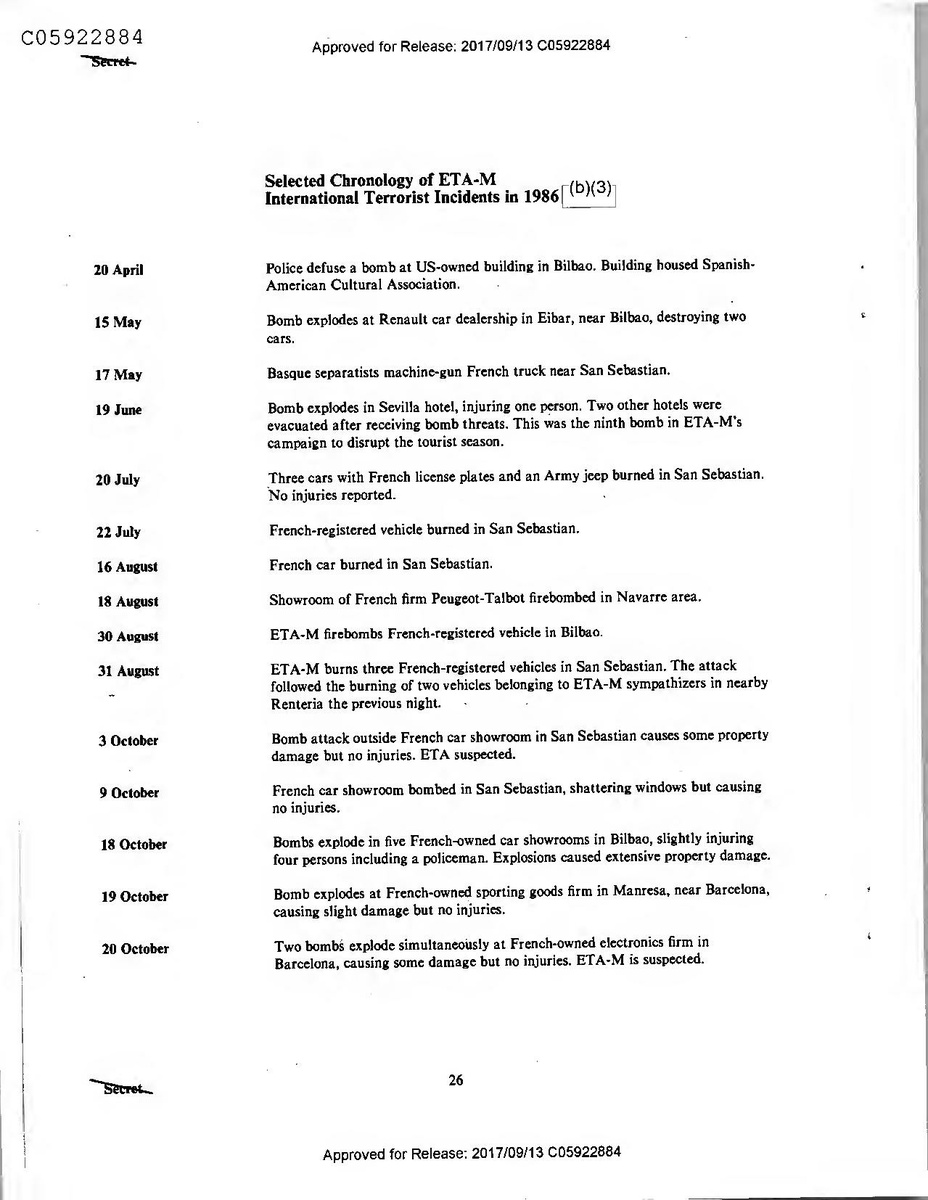
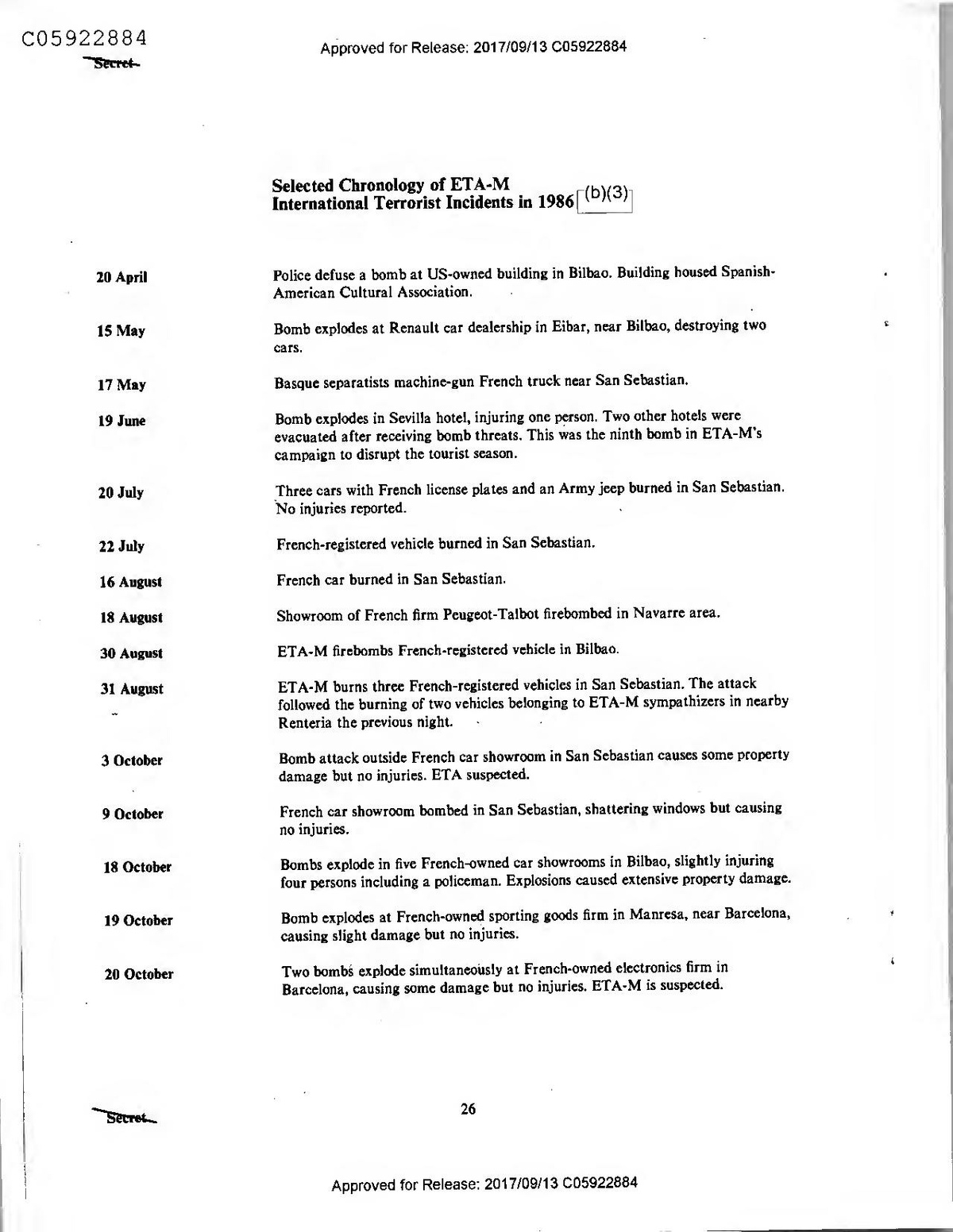
Selected Chronology of ETA-M International Terrorist Incidents in 1986
[(b)(3)
20 April
Police defuse a bomb at US-owned building in Bilbao. Building housed SpanishAmerican Cultural Association.
15 May
Bomb explodes at Renault car dealership in Eibar, near Bilbao, destroying two
cars.
17 May
Basque separatists machine-gun French truck near San Sebastian.
19 June
Bomb explodes in Sevilla hotel, injuring one person. Two other hotels were evacuated after receiving bomb threats. This was the ninth bomb in ETA-M's campaign to disrupt the tourist season.
20 July
Three cars with French license plates and an Army jeep burned in San Sebastian. No injuries reported.
22 July
French-registered vehicle burned in San Sebastian.
16 August
French car burned in San Sebastian.
18 August
Showroom of French firm Peugeot-Talbot firebombed in Navarre area.
30 August
ETA-M firebombs French-registered vehicle in Bilbao.
31 August
ETA-M burns three French-registered vehicles in San Sebastian. The attack followed the burning of two vehicles belonging to ETA-M sympathizers in nearby Renteria the previous night.
3 October
Bomb attack outside French car showroom in San Sebastian causes some property damage but no injuries. ETA suspected.
9 October
French car showroom bombed in San Sebastian, shattering windows but causing no injuries.
18 October
Bombs explode in five French-owned car showrooms in Bilbao, slightly injuring four persons including a policeman. Explosions caused extensive property damage.
19 October
Bomb explodes at French-owned sporting goods firm in Manresa, near Barcelona, causing slight damage but no injuries.
20 October
Two bombs explode simultaneously at French-owned electronics firm in Barcelona, causing some damage but no injuries. ETA-M is suspected.
26
Secret
Approved for Release: 2017/09/13 C05922884
October
Two bombs explode at French-owned brewery warehouse in San Sebastian, causing extensive damage but no injuries. ETA-M is suspected.
5 November
French police raid ETA-M hideout in southern France, arresting two key members, and seizing extensive records of group's activities, membership, and extortionist fundraising.
10 November
French car showroom bombed in Zarauz, causing damage but no injuries.
25 November
Bomb explodes at Peugeot-Talbot car showroom in Bilbao, causing widespread damage but no injuries.
29 November
French car showroom in San Sebastian bombed on eve of Basque elections. The explosion damaged the Peugeot showroom but no one was injured.
11 December
Explosive device damages Citroen car showroom in Barcelona, injuring four people.
12 December
Bomb explodes at Renault car showroom in Zarauz, seriously injuring one woman.
16 December
Two bombs explode outside French businesses in Barcelona, injuring 28 people and causing considerable damage.
19 December
Incendiary bomb explodes at French factory in Bilbao, completely destroying the facility.
24 December
Spanish civil guard killed while disarming an explosive planted in a French-owned supermarket near San Sebastian.
25 December
ETA-M plants GOMA-2 bomb that explodes at French-owned hotel in Madrid. The explosion caused substantial property damage but no injuries.
28 December
ETA-M claims responsibility for bomb explosion at French car dealership in Basque region that seriously injures one woman and causes property damage. This was the only holiday attack not preceded by a warning phone call.
29 December
ETA-M bomb explodes at ski resort in the Pyrenees while King Juan Carlos and his family are vacationing at nearby private lodge. French skiers frequent the resort.
(b)(3)
Reverse Blank
27
Deoret
Approved for Release: 2017/09/13 C05922884
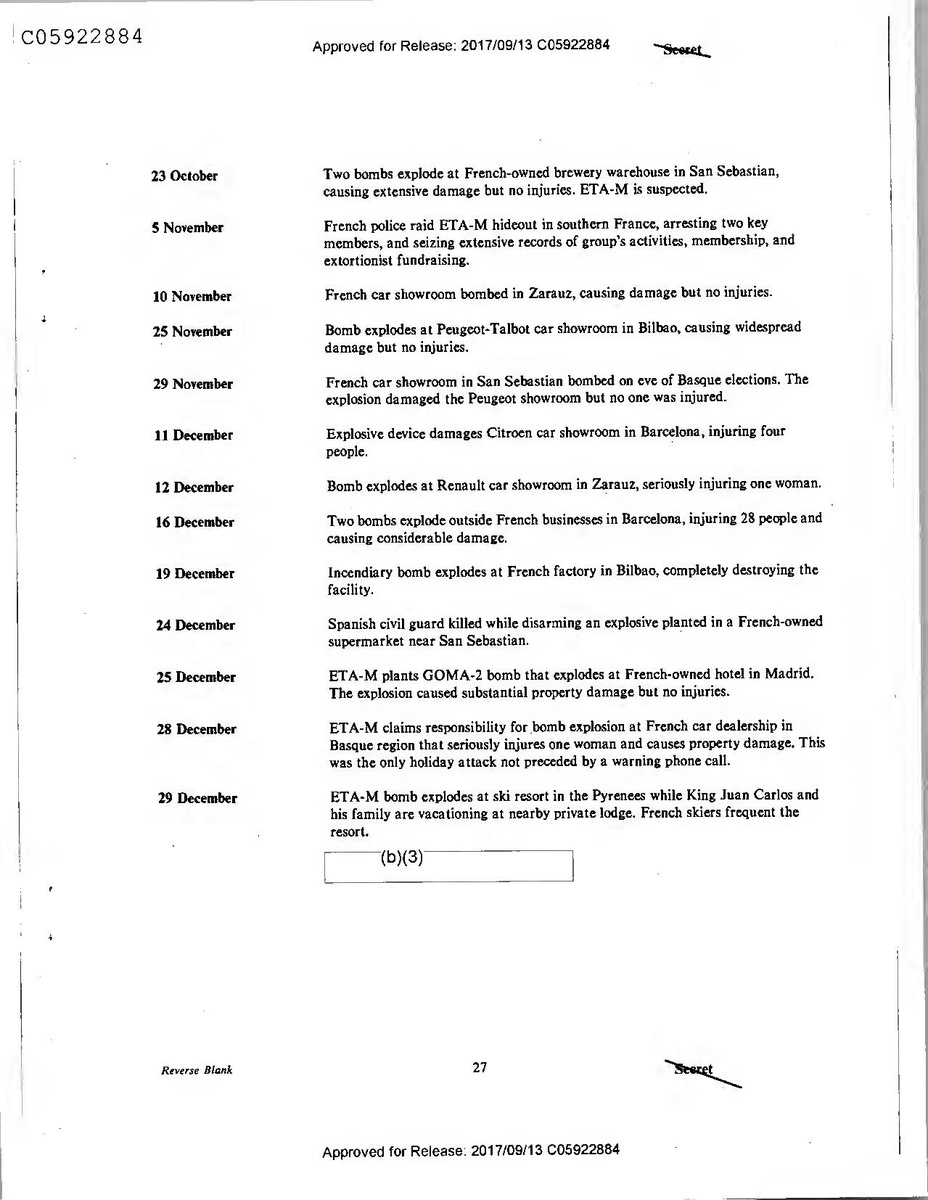
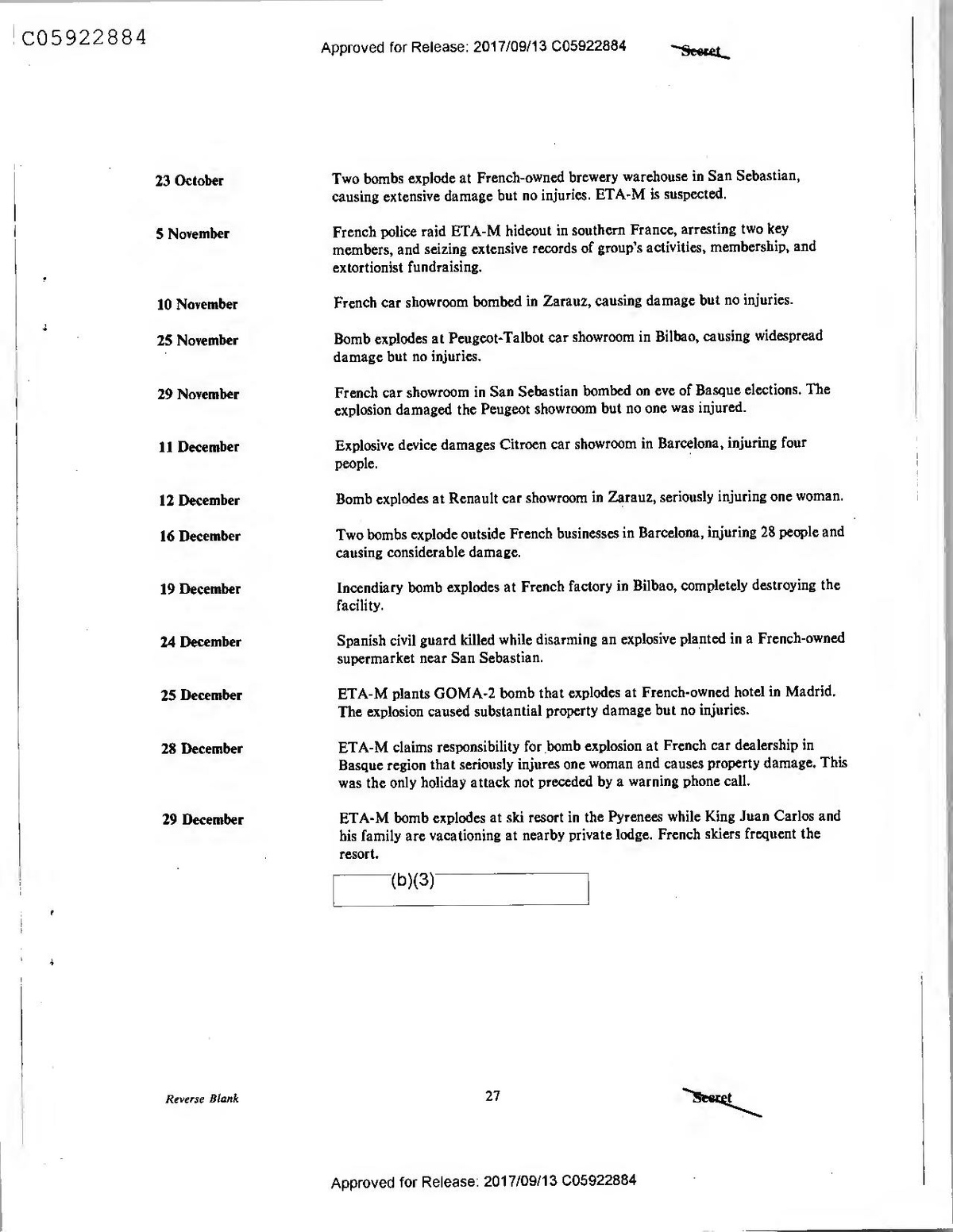
October
Two bombs explode at French-owned brewery warehouse in San Sebastian, causing extensive damage but no injuries. ETA-M is suspected.
5 November
French police raid ETA-M hideout in southern France, arresting two key members, and seizing extensive records of group's activities, membership, and extortionist fundraising.
10 November
French car showroom bombed in Zarauz, causing damage but no injuries.
25 November
Bomb explodes at Peugeot-Talbot car showroom in Bilbao, causing widespread damage but no injuries.
29 November
French car showroom in San Sebastian bombed on eve of Basque elections. The explosion damaged the Peugeot showroom but no one was injured.
11 December
Explosive device damages Citroen car showroom in Barcelona, injuring four people.
12 December
Bomb explodes at Renault car showroom in Zarauz, seriously injuring one woman.
16 December
Two bombs explode outside French businesses in Barcelona, injuring 28 people and causing considerable damage.
19 December
Incendiary bomb explodes at French factory in Bilbao, completely destroying the facility.
24 December
Spanish civil guard killed while disarming an explosive planted in a French-owned supermarket near San Sebastian.
25 December
ETA-M plants GOMA-2 bomb that explodes at French-owned hotel in Madrid. The explosion caused substantial property damage but no injuries.
28 December
ETA-M claims responsibility for bomb explosion at French car dealership in Basque region that seriously injures one woman and causes property damage. This was the only holiday attack not preceded by a warning phone call.
29 December
ETA-M bomb explodes at ski resort in the Pyrenees while King Juan Carlos and his family are vacationing at nearby private lodge. French skiers frequent the resort.
(b)(3)
Reverse Blank
27
Deoret
Approved for Release: 2017/09/13 C05922884
(b)(3)
Chronology of Terrorism—1986/1987
Below are described noteworthy foreign and international events involving terrorists, or the use of terrorist tactics, which have come to light since our last issue. In some cases, the perpetrators and their motivations may not be known. Events and developments that havinkody been described elsewhere in this publication are not included.
(b)(3)
December
Portugal: Prime Minister signs decree streamlining counterterrorism effort. Greater cooperation among the various agencies in the fight against terrorism is anticipated. The armed forces were not given a direct role although they will share intelligence.(b)(3)
4 and 5 December
Italy: Disgruntled Communist Revolutionary Committee (CCR) member arrested in Ventimiglia. Emanuele Greco was arrested as he attempted to enter the country with false identification. He then led police to a weapons cache. The CCR is one of several Red Brigades splinter groups. (b)(3)]
31 December
West Germany: Arson attack on police vehicle and police station in Bielefeld causes about $250,000 in damages. There were no injuries. A previously unknown group called “Wooli" claimed responsibility for the incident.
(b)(3)
Early January
Denmark: Police arrest two Danish nationals for the bombing of the Soviet Embassy in Copenhagen last December. The youths, aged 16 and 18, confessed to the bombing and are implicated in other incidents in which explosive devices were left in playgrounds. The 18-year-old male, an activist in the conservative party (b)(3) youth wing, wanted to call attention to the Soviet occupation of Afghanistan.
2 January
West Germany: Bomb detonates outside British military airport in West Berlin, causing some damage but no injuries. Environmentalists have focused on the airport since tree cutting to clear the runway approaches began last summer. No one, however, claimed responsibility for the bombing. (b)(3)
3 January
West Germany: Arsonists attack Free Democratic Party (FDB) offices in Wiesbaden. The fire caused about $100,000 in damages but no injuries. Two unidentified youth Vot seen running from the scene. There has been no claim of
.
29
Setret DI TR 87-004 26 February 1987
Approved for Release: 2017/09/13 C05922884
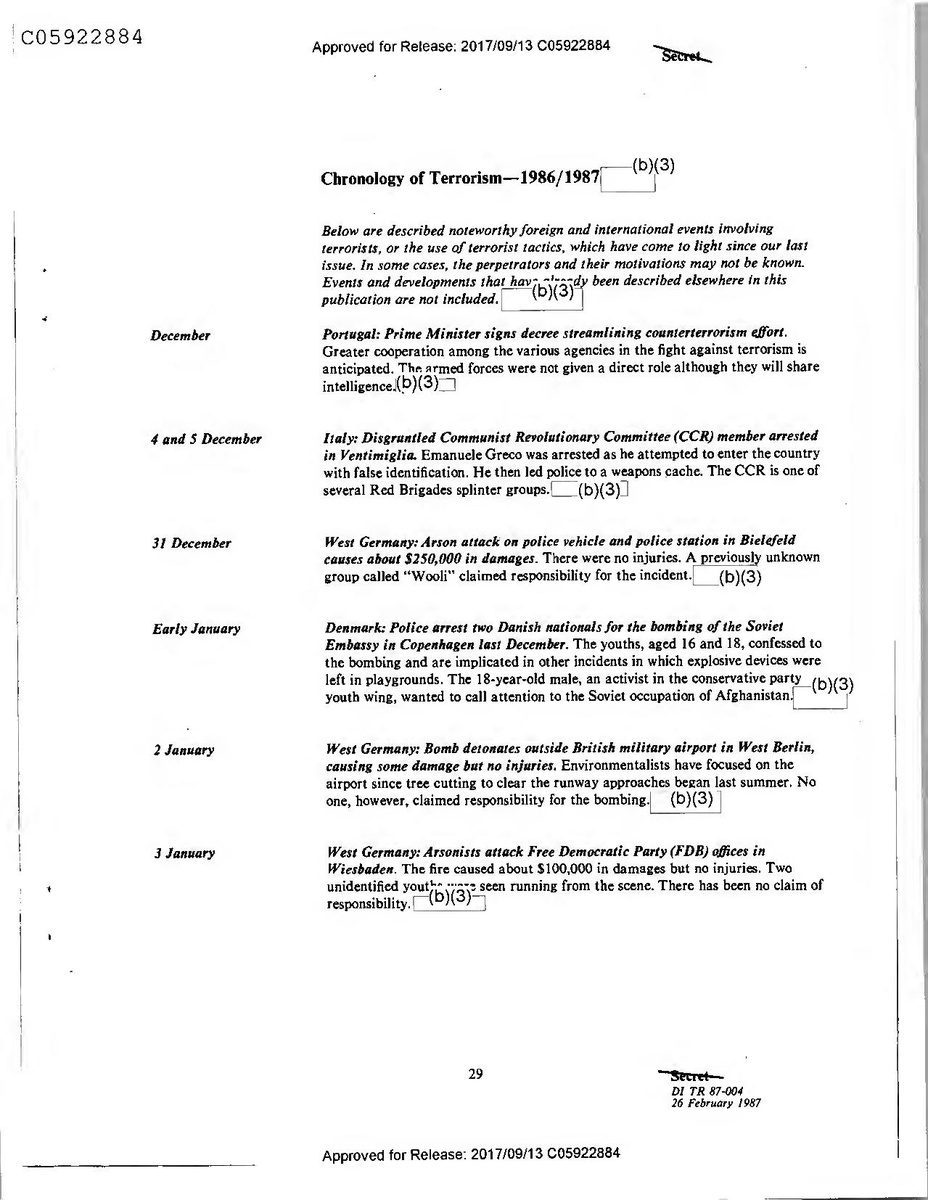
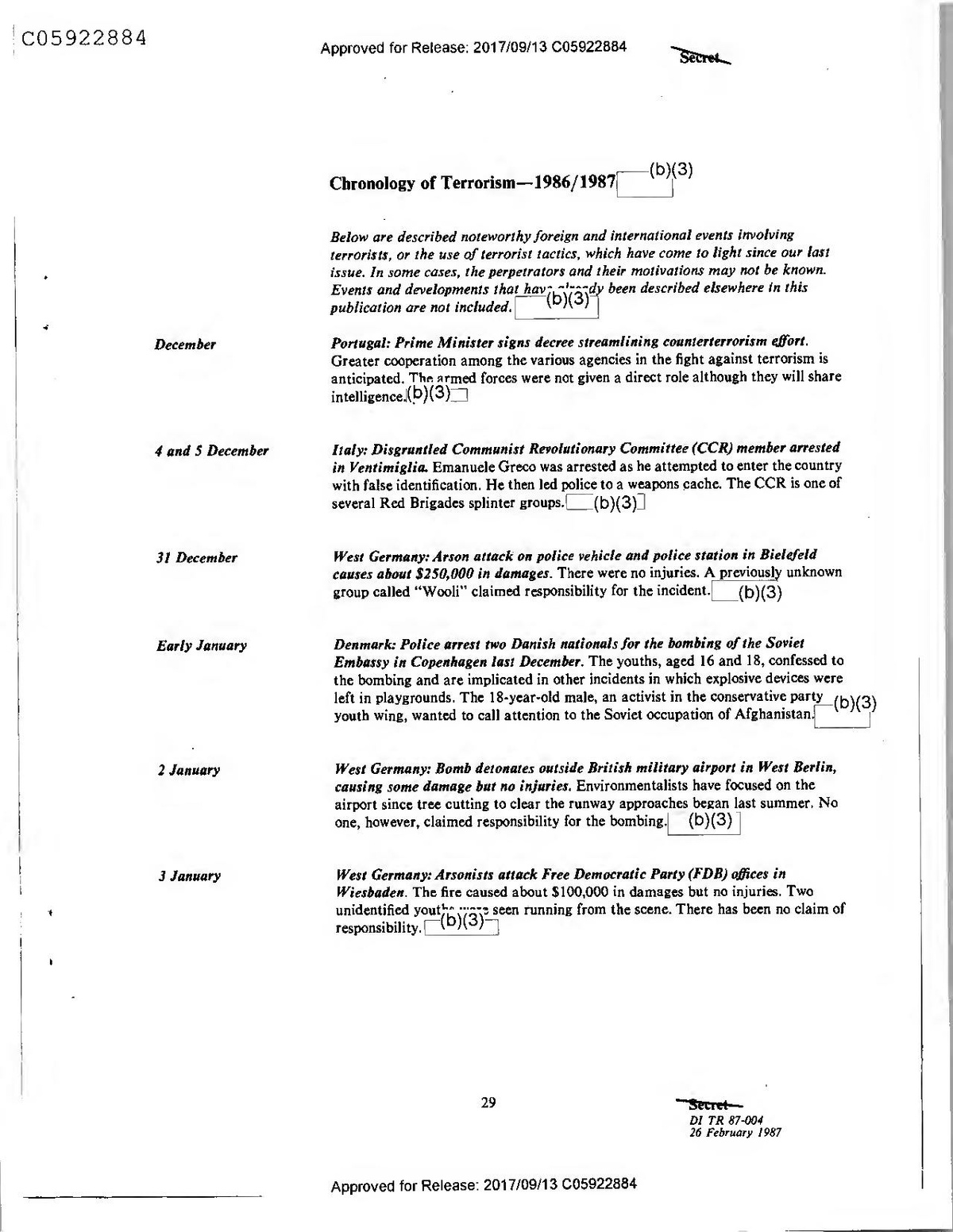
(b)(3)
Chronology of Terrorism—1986/1987
Below are described noteworthy foreign and international events involving terrorists, or the use of terrorist tactics, which have come to light since our last issue. In some cases, the perpetrators and their motivations may not be known. Events and developments that havinkody been described elsewhere in this publication are not included.
(b)(3)
December
Portugal: Prime Minister signs decree streamlining counterterrorism effort. Greater cooperation among the various agencies in the fight against terrorism is anticipated. The armed forces were not given a direct role although they will share intelligence.(b)(3)
4 and 5 December
Italy: Disgruntled Communist Revolutionary Committee (CCR) member arrested in Ventimiglia. Emanuele Greco was arrested as he attempted to enter the country with false identification. He then led police to a weapons cache. The CCR is one of several Red Brigades splinter groups. (b)(3)]
31 December
West Germany: Arson attack on police vehicle and police station in Bielefeld causes about $250,000 in damages. There were no injuries. A previously unknown group called “Wooli" claimed responsibility for the incident.
(b)(3)
Early January
Denmark: Police arrest two Danish nationals for the bombing of the Soviet Embassy in Copenhagen last December. The youths, aged 16 and 18, confessed to the bombing and are implicated in other incidents in which explosive devices were left in playgrounds. The 18-year-old male, an activist in the conservative party (b)(3) youth wing, wanted to call attention to the Soviet occupation of Afghanistan.
2 January
West Germany: Bomb detonates outside British military airport in West Berlin, causing some damage but no injuries. Environmentalists have focused on the airport since tree cutting to clear the runway approaches began last summer. No one, however, claimed responsibility for the bombing. (b)(3)
3 January
West Germany: Arsonists attack Free Democratic Party (FDB) offices in Wiesbaden. The fire caused about $100,000 in damages but no injuries. Two unidentified youth Vot seen running from the scene. There has been no claim of
.
29
Setret DI TR 87-004 26 February 1987
Approved for Release: 2017/09/13 C05922884
(b)(3)
9 January
Iraq: Islamic Action Organization claims it destroyed munitions convoy in Baghdad. A large number of Iraqi military were reportedly killed in the explosion.
(b)(3)
South Africa: Two limpet mines explode almost simultaneously at a central Johannesburg department store. The explosion caused extensive damage but no casualties. Management at the store had been involved in a bitter wage dispute with black workers. The African National Congress claimed responsibility (b)(3)
13 January
Portugal: Nine grenades found at University of Lisbon. The university is located approximately 1 kilometer from the US Embassy. No one took credit for the
devices/(b)(3)
16 January
West Germany: Suspected rightwing militant killed while testing bomb in Gottingen apartment
. Police found large quantities of weapons, explo:(b)(3) incendiaries, and rightwing and Nazi literature in the apartment.
17 January
Philippines: Suspected New Peoples Army (NPA) guerrillas attack radio station. NPA guerrillas deternated a grenade and opened fire inside a popular radio station in the southern Philippines, injuring three persons. (b)(3)]
18 January
Pakistan: A bomb explodes in a bus carrying Afghan refugees to the University of Peshawar, wounding 11 persons. Police said a 2-kilogram bomb had been placed in a lunchbox among the passengers' luggage and exploded just after the vehicle left the city's bus station. Authorities suspect that the Afghan secret police was responsible. (b)(3)
Sri Lanka: A parcel bomb explodes on a crowded public bus near the town of Badulla, killing seven persons and wounding at least 50 others. Although no group has claimed responsibility, this attack is similar to a number of incidents perpetrated by the Tamil separatist group called the “Eelam Revolutionary Organization of Students.” (b)(3)
Secret
30
Approved for Release: 2017/09/13 C05922884
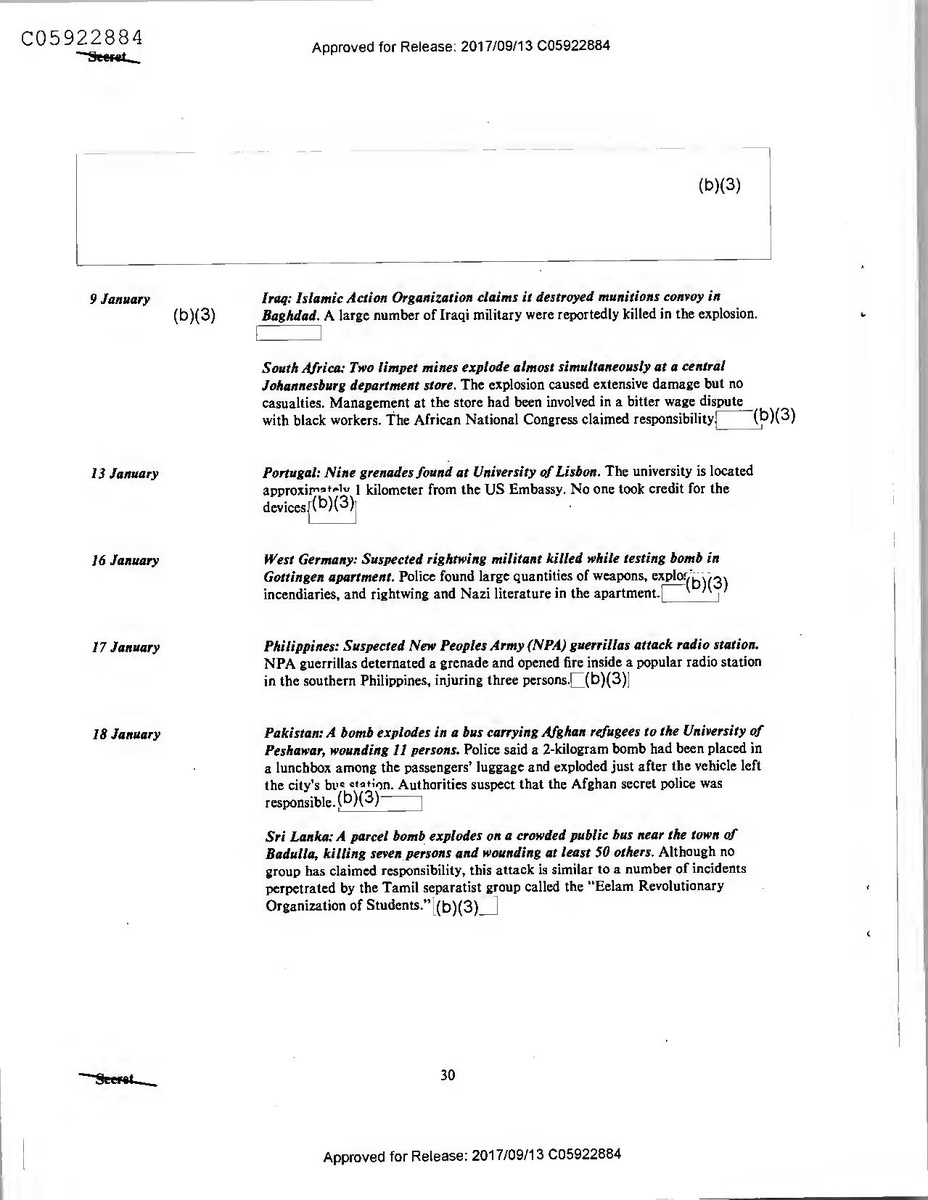
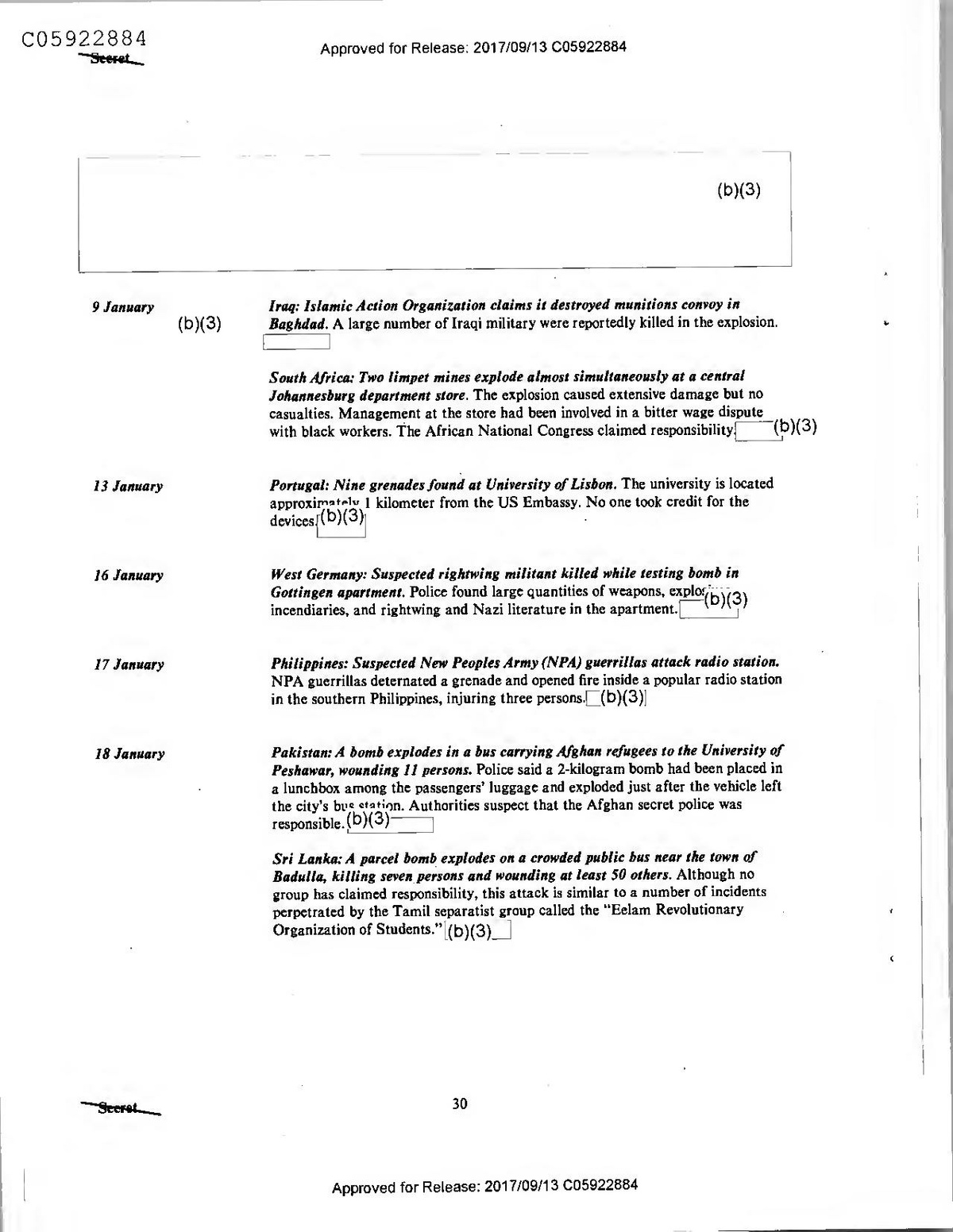
(b)(3)
9 January
Iraq: Islamic Action Organization claims it destroyed munitions convoy in Baghdad. A large number of Iraqi military were reportedly killed in the explosion.
(b)(3)
South Africa: Two limpet mines explode almost simultaneously at a central Johannesburg department store. The explosion caused extensive damage but no casualties. Management at the store had been involved in a bitter wage dispute with black workers. The African National Congress claimed responsibility (b)(3)
13 January
Portugal: Nine grenades found at University of Lisbon. The university is located approximately 1 kilometer from the US Embassy. No one took credit for the
devices/(b)(3)
16 January
West Germany: Suspected rightwing militant killed while testing bomb in Gottingen apartment
. Police found large quantities of weapons, explo:(b)(3) incendiaries, and rightwing and Nazi literature in the apartment.
17 January
Philippines: Suspected New Peoples Army (NPA) guerrillas attack radio station. NPA guerrillas deternated a grenade and opened fire inside a popular radio station in the southern Philippines, injuring three persons. (b)(3)]
18 January
Pakistan: A bomb explodes in a bus carrying Afghan refugees to the University of Peshawar, wounding 11 persons. Police said a 2-kilogram bomb had been placed in a lunchbox among the passengers' luggage and exploded just after the vehicle left the city's bus station. Authorities suspect that the Afghan secret police was responsible. (b)(3)
Sri Lanka: A parcel bomb explodes on a crowded public bus near the town of Badulla, killing seven persons and wounding at least 50 others. Although no group has claimed responsibility, this attack is similar to a number of incidents perpetrated by the Tamil separatist group called the “Eelam Revolutionary Organization of Students.” (b)(3)
Secret
30
Approved for Release: 2017/09/13 C05922884
Italy: Twenty persons go on trial for 1980 Bologna railway station bombing. The defendants, members of rightwing terrorist groups, are charged with subversive activity, conspiracy to commit mass murder, and membership of an armed gang.
The bombing killed more than 80 persons in Italy's most lethal terrorist incident. (b)(3)
Japan: Three projectiles are fired from a parked car at a Tokyo police station. The building sustained minor damage, and there were no injuries. Based on the construction of the projectiles, police strongly suspect the leftist radical Chukakuhalb)(3)
21 January
Argentina: Bomb damages Intransigent Party Headquarters in the Flores District in Buenos Aires, causing extensive damang There were no reported injuries and no group has claimed responsibility. (b)(3)
24 January
Italy: Small bombs explode outside two politicians' homes in Bolzano, causing slight damage but no injuries. Two suspected members of the South Tyrol separatist movement “Heimatbund" were arrested.
(b)(3)
Spain: Several thousand people rally in Bilbao, demanding amnesty for suspected terrorists living in France. The marchers also were protesting recent French expulsions of Spanish Basque refugees. The National Committee of the radical
notirnalist party, Herri Batasuna, was one of the organizers of the peacefUL march. (b)(3)
(b)(3)
27 January
France: Bomb explodes in offices of magazine, Lovina Afrique in Paris. There were no injuries and no claim of responsibility. (b)(3)
Italy: Supreme Appellate Court issues final ruling on the 1969 Milan bank bombing known as the Piazza Fontana massacre. The court upheld the acquittals of three neofacists and an anarch; persons and injured 88 others.
(b)(3)?sed of planting a bomb, which killed 16
27 January
French Guiana: Bomb explodes in Cayenne at the French Government's Forestry Administration building, causing structural damage but no injuries. No group has claimed responsibility, although radical separatists may be behind the bombing. (b)(3)
29 January
West Bank: Jewish extremists vandalize Arab cars in East Jerusalem. The tires of 25 cars were slashed.
(b)(3)
31
Secret
Approved for Release: 2017/09/13 C05922884
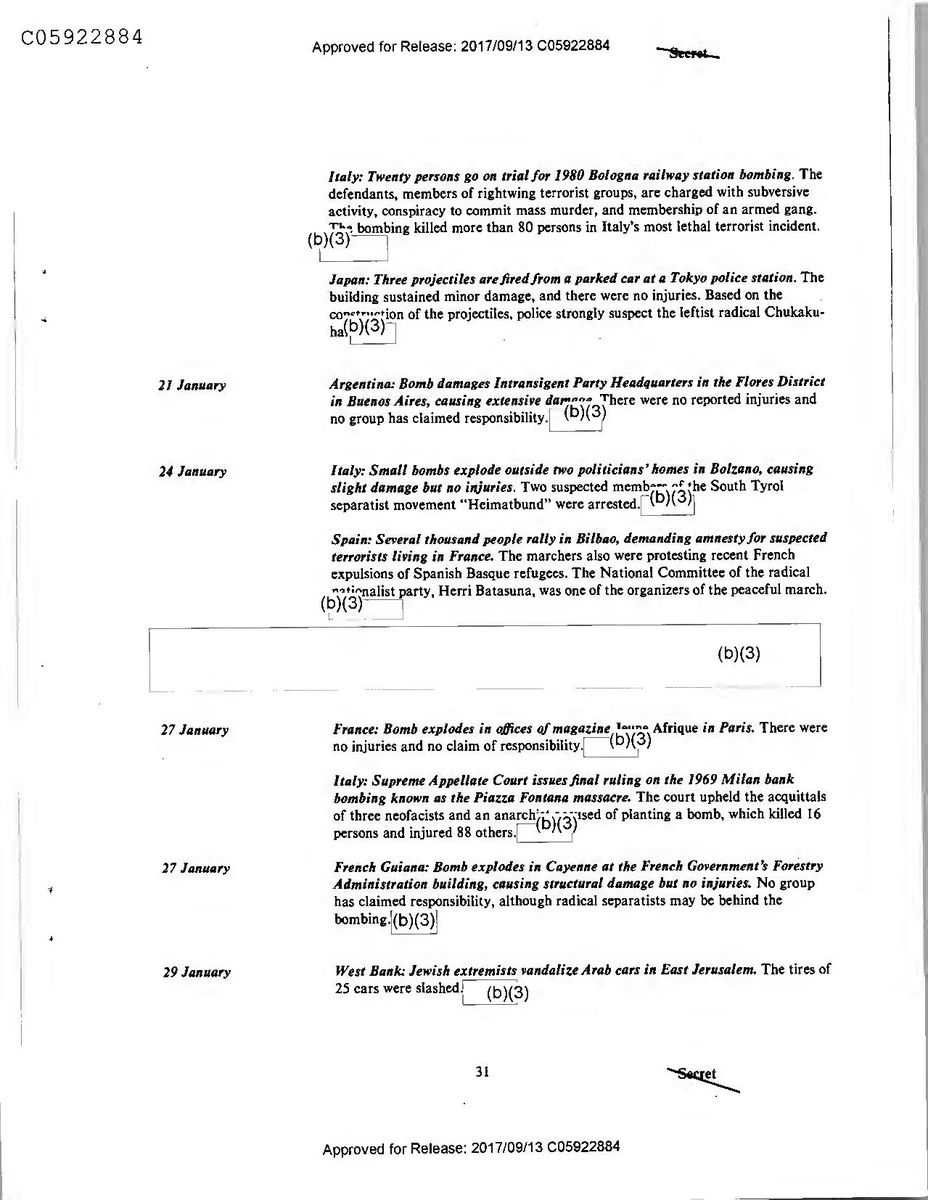
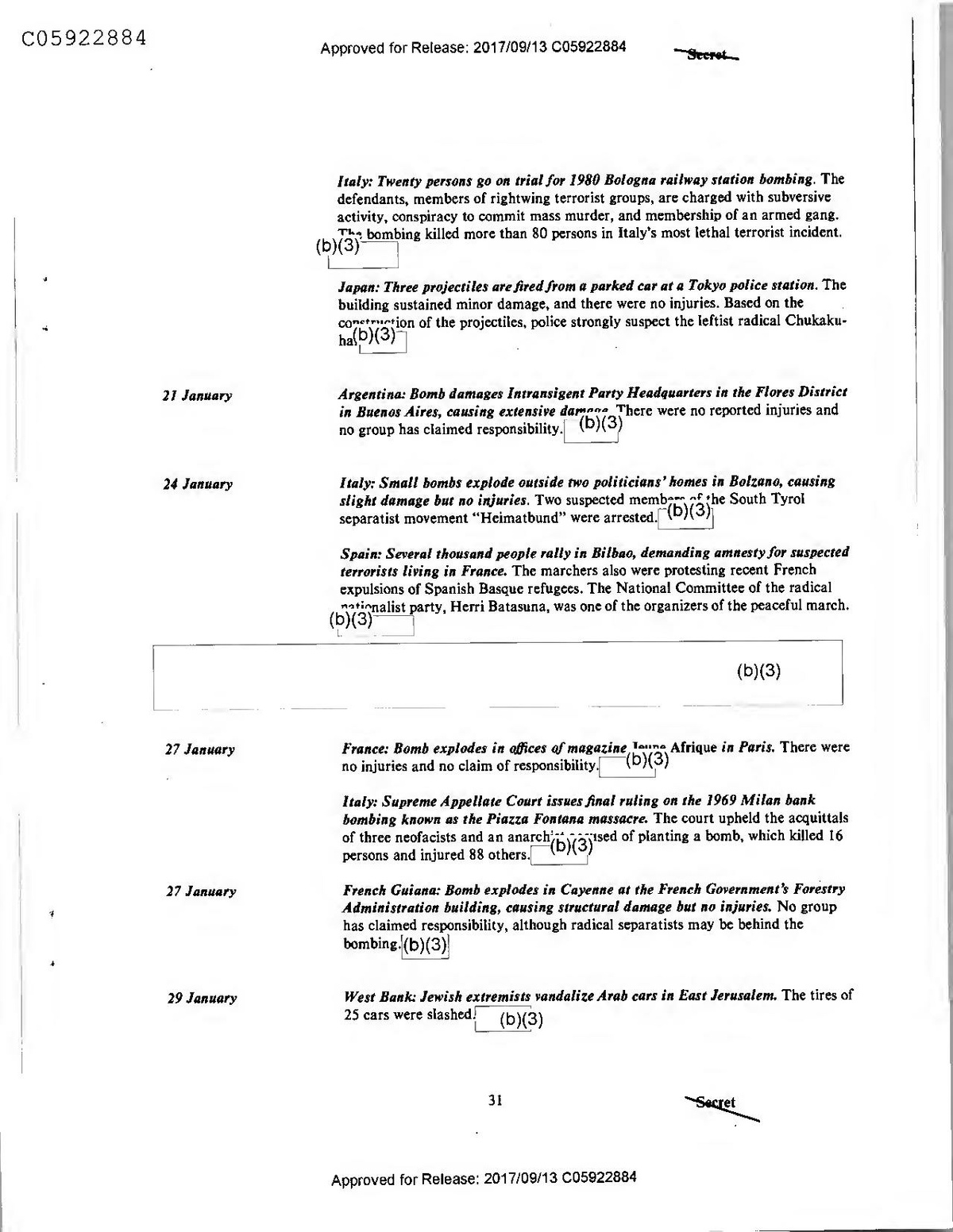
Italy: Twenty persons go on trial for 1980 Bologna railway station bombing. The defendants, members of rightwing terrorist groups, are charged with subversive activity, conspiracy to commit mass murder, and membership of an armed gang.
The bombing killed more than 80 persons in Italy's most lethal terrorist incident. (b)(3)
Japan: Three projectiles are fired from a parked car at a Tokyo police station. The building sustained minor damage, and there were no injuries. Based on the construction of the projectiles, police strongly suspect the leftist radical Chukakuhalb)(3)
21 January
Argentina: Bomb damages Intransigent Party Headquarters in the Flores District in Buenos Aires, causing extensive damang There were no reported injuries and no group has claimed responsibility. (b)(3)
24 January
Italy: Small bombs explode outside two politicians' homes in Bolzano, causing slight damage but no injuries. Two suspected members of the South Tyrol separatist movement “Heimatbund" were arrested.
(b)(3)
Spain: Several thousand people rally in Bilbao, demanding amnesty for suspected terrorists living in France. The marchers also were protesting recent French expulsions of Spanish Basque refugees. The National Committee of the radical
notirnalist party, Herri Batasuna, was one of the organizers of the peacefUL march. (b)(3)
(b)(3)
27 January
France: Bomb explodes in offices of magazine, Lovina Afrique in Paris. There were no injuries and no claim of responsibility. (b)(3)
Italy: Supreme Appellate Court issues final ruling on the 1969 Milan bank bombing known as the Piazza Fontana massacre. The court upheld the acquittals of three neofacists and an anarch; persons and injured 88 others.
(b)(3)?sed of planting a bomb, which killed 16
27 January
French Guiana: Bomb explodes in Cayenne at the French Government's Forestry Administration building, causing structural damage but no injuries. No group has claimed responsibility, although radical separatists may be behind the bombing. (b)(3)
29 January
West Bank: Jewish extremists vandalize Arab cars in East Jerusalem. The tires of 25 cars were slashed.
(b)(3)
31
Secret
Approved for Release: 2017/09/13 C05922884
SECRET
(b)(3)
SUBJECT:
Soviet Disinformation:
Allegations of US Misdeeds
(b)(3)
OGI/FSIC/SA
(28 March 86)
-
-
Distribution:
1 Secretary of State 1 SA/DDCI 1 Executive Director 1 DDI
DDI Registry
DDI/PES 1 NIO/FDIA 1 CPAS/ISS 4 - CPAS/CB 1 - CPAS/CB (annotated) 1 - D/OGI, DD/OGI 3 OGI/EXS/PG -(b)(3)
SOVA/TWAD/FA
DDO/PPS 1 C/OGI/FSIC 4 OGI/FSIC/SA
-
-(b)(3)
SECRET
Approved for Release: 2017/09/13 C05612850
SECRET
(b)(3)
SUBJECT:
Soviet Disinformation:
Allegations of US Misdeeds
(b)(3)
OGI/FSIC/SA
(28 March 86)
-
-
Distribution:
1 Secretary of State 1 SA/DDCI 1 Executive Director 1 DDI
DDI Registry
DDI/PES 1 NIO/FDIA 1 CPAS/ISS 4 - CPAS/CB 1 - CPAS/CB (annotated) 1 - D/OGI, DD/OGI 3 OGI/EXS/PG -(b)(3)
SOVA/TWAD/FA
DDO/PPS 1 C/OGI/FSIC 4 OGI/FSIC/SA
-
-(b)(3)
SECRET
Approved for Release: 2017/09/13 C05612850
Secret
Austria
(b)(1) (b)(3)
Threat of “Plastic Pistol" Exaggerated Recent public reports alleging that the Austrian Glock-17 pistol represents a significant terrorist threat because of its plastic parts overstate the case. Although it has been claimed that the weapon is made mostly of plastic and can pass security scrutiny at airports, the pistol is actually 83-percent steel and is as easily discernible through X-ray and metal detectors as all-steel models. Furthermore, this is not a new pistol developed to be undetectable; more than 80,000 Glock-17s have reportedly been produced and are in service with the Austrian Army, the (b)(3) Norwegian armed forces, and a number of police and security organizations.[
(b)(3)
their caliber (9 mm) and magazine capacity (17 rounds) make thi(b)(1) desirable wenors, and they would be no more difficult to conceal than any
ny(b)(3)
handguns." (b)(3)
Tunisia
(b)(1)
Libya Planning Terrorist Campaign?
Tripoli may be prepared to undertake terrorist attacks in Tunisia to punish Tunis for its close ties to the United States. Libyan radio attacked the visit of the US Sixth Fleet commander to Tunis and described(b)(3) provocative. Tripoli presented a diplomatic note
(b)(1) virtual declaration of war. Vice President Bush's trip to Tunis in early March almost certainly increased Tripoli's ire. Although Libya no longer has diplomatic relations with Tunisia and infiltrating terrorists has become more difficult, Tunisian dissidents or radical Palestinians could act as surrogates.[(b)(3)
Lebanon
Series of Bombings Against Phalange Party Offices Between 21 January and 8 March, a wave of bombings terrorized the Christian community in East Beirut. Most of the bombings occurred near Phalange Party offices and killed a total of 33 persons and wounded 165. Damage was extensive: shops were destroyed, cars were burned, and hundreds of windows were broken. The most significant incidents were:
21 January
A car bomb exploded in a busy commercial area, killing 22 and wounding more than 100.
11
-Seeret
Approved for Release: 2017/09/13 C05632837
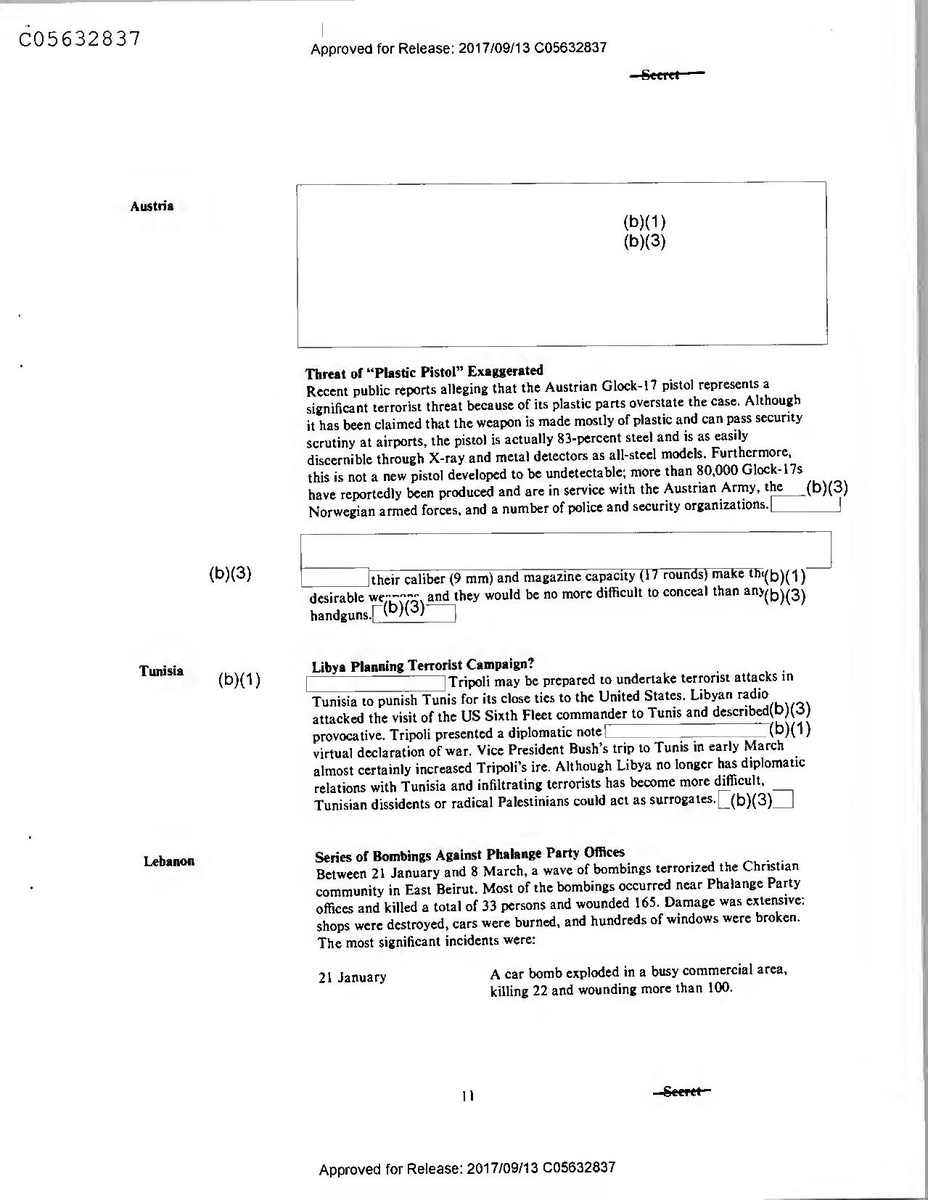
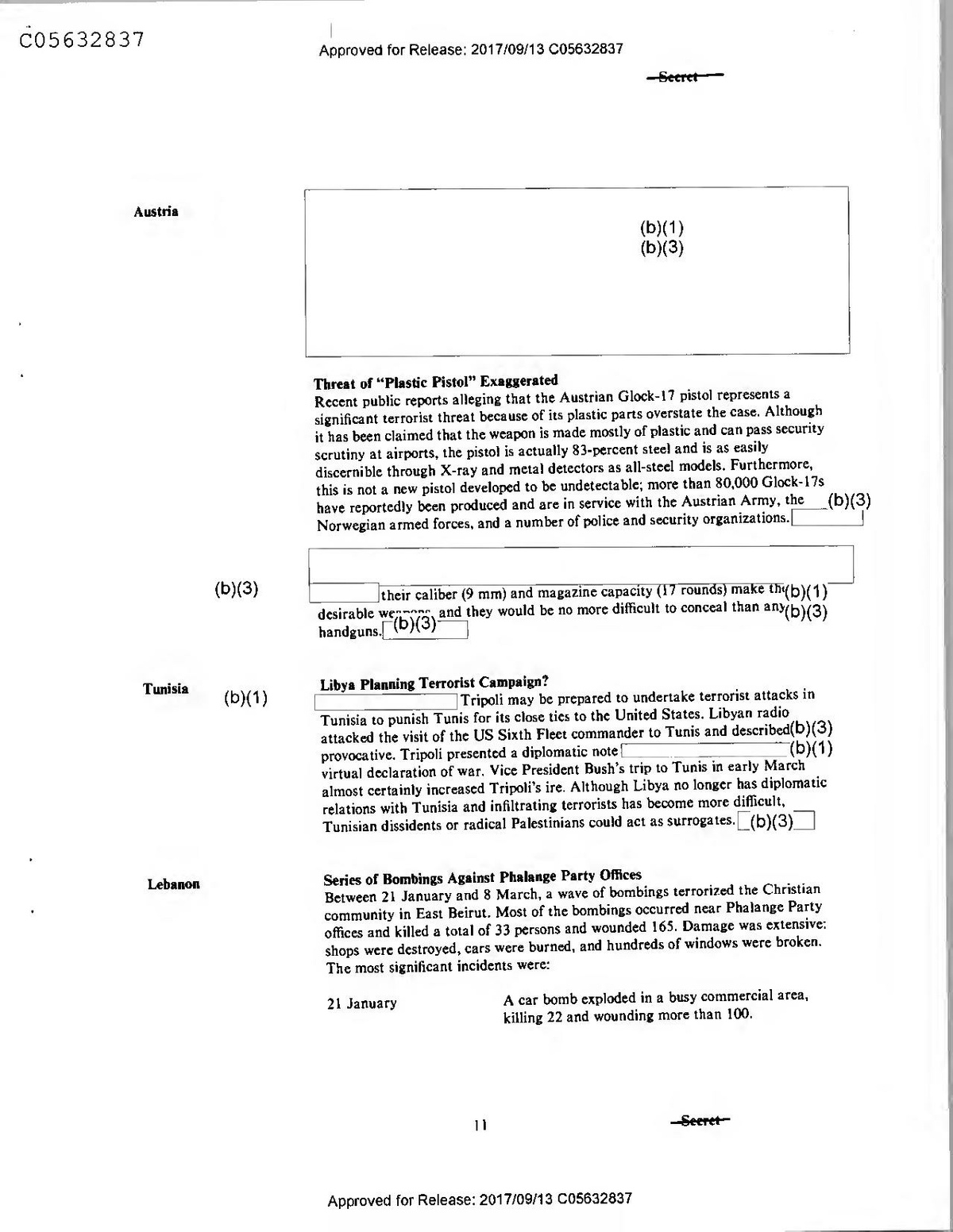
Secret
Austria
(b)(1) (b)(3)
Threat of “Plastic Pistol" Exaggerated Recent public reports alleging that the Austrian Glock-17 pistol represents a significant terrorist threat because of its plastic parts overstate the case. Although it has been claimed that the weapon is made mostly of plastic and can pass security scrutiny at airports, the pistol is actually 83-percent steel and is as easily discernible through X-ray and metal detectors as all-steel models. Furthermore, this is not a new pistol developed to be undetectable; more than 80,000 Glock-17s have reportedly been produced and are in service with the Austrian Army, the (b)(3) Norwegian armed forces, and a number of police and security organizations.[
(b)(3)
their caliber (9 mm) and magazine capacity (17 rounds) make thi(b)(1) desirable wenors, and they would be no more difficult to conceal than any
ny(b)(3)
handguns." (b)(3)
Tunisia
(b)(1)
Libya Planning Terrorist Campaign?
Tripoli may be prepared to undertake terrorist attacks in Tunisia to punish Tunis for its close ties to the United States. Libyan radio attacked the visit of the US Sixth Fleet commander to Tunis and described(b)(3) provocative. Tripoli presented a diplomatic note
(b)(1) virtual declaration of war. Vice President Bush's trip to Tunis in early March almost certainly increased Tripoli's ire. Although Libya no longer has diplomatic relations with Tunisia and infiltrating terrorists has become more difficult, Tunisian dissidents or radical Palestinians could act as surrogates.[(b)(3)
Lebanon
Series of Bombings Against Phalange Party Offices Between 21 January and 8 March, a wave of bombings terrorized the Christian community in East Beirut. Most of the bombings occurred near Phalange Party offices and killed a total of 33 persons and wounded 165. Damage was extensive: shops were destroyed, cars were burned, and hundreds of windows were broken. The most significant incidents were:
21 January
A car bomb exploded in a busy commercial area, killing 22 and wounding more than 100.
11
-Seeret
Approved for Release: 2017/09/13 C05632837
January
Italy: Leaders of Sardinian Armed Movement (MAS) arrested after shootout in Mamoiada. Annino Mele was carrying a gun and five handgrenades at the time of his arrest. MAS has been linked to the Red Brigades.
(b)(3)
(b)(3)
Spain: Car bomb attack on military bus in Zaragoza kills two persons, injures 41 others. The Basque group Fatherland and Liberty Military Wing claimed resnonsibility for the incident as part of its operation to harass the Spanish Army. (b)(3)
France: Car explodes in front of school in Marseille, killing its two occupants. The cause of the explosion is unknown. A similar explosion last summer in Nice killed four members of a rightwing, on their way to bomb a target connected to North African immigrants.
(b)(3)°
France: Another suspected Basque Fatherland and Liberty organization member is expelled. French police handed Ignacio Irastroza Martin over to Spanish authorities at the border in Hendaye, France,
f(b)(3)
(b)(3)
1 February
Italy: Two Jordanians arrested in June 1986 released from Genoa prison because of lack of evidence. Awni Hindawi was accused of belonging to an armed band after his cousin, Nezar Hindawi, was arrested for trying to blow up an El Al airliner in London last year. Also released was arms dealer Adnan Rousan, who probably fled the country shortly thereafter. He failed to keep a probationary appointment on 13 February. (b)(3)
Afghanistan: A car bomb explodes near an office of the Ministry of State Security in KabUL, killing at least four persons and injuring some 20 others. Windows within 500 meters of the explosion were blown out. Included in the area affected by the blast were the Consular Office of the Indian Embassy, a major Soviet military hospital, the Ministry of Interior, the Indonesian Charge's residence and the residence of the US Charge. (b)(3)
32
Sesret
Approved for Release: 2017/09/13 C05922884
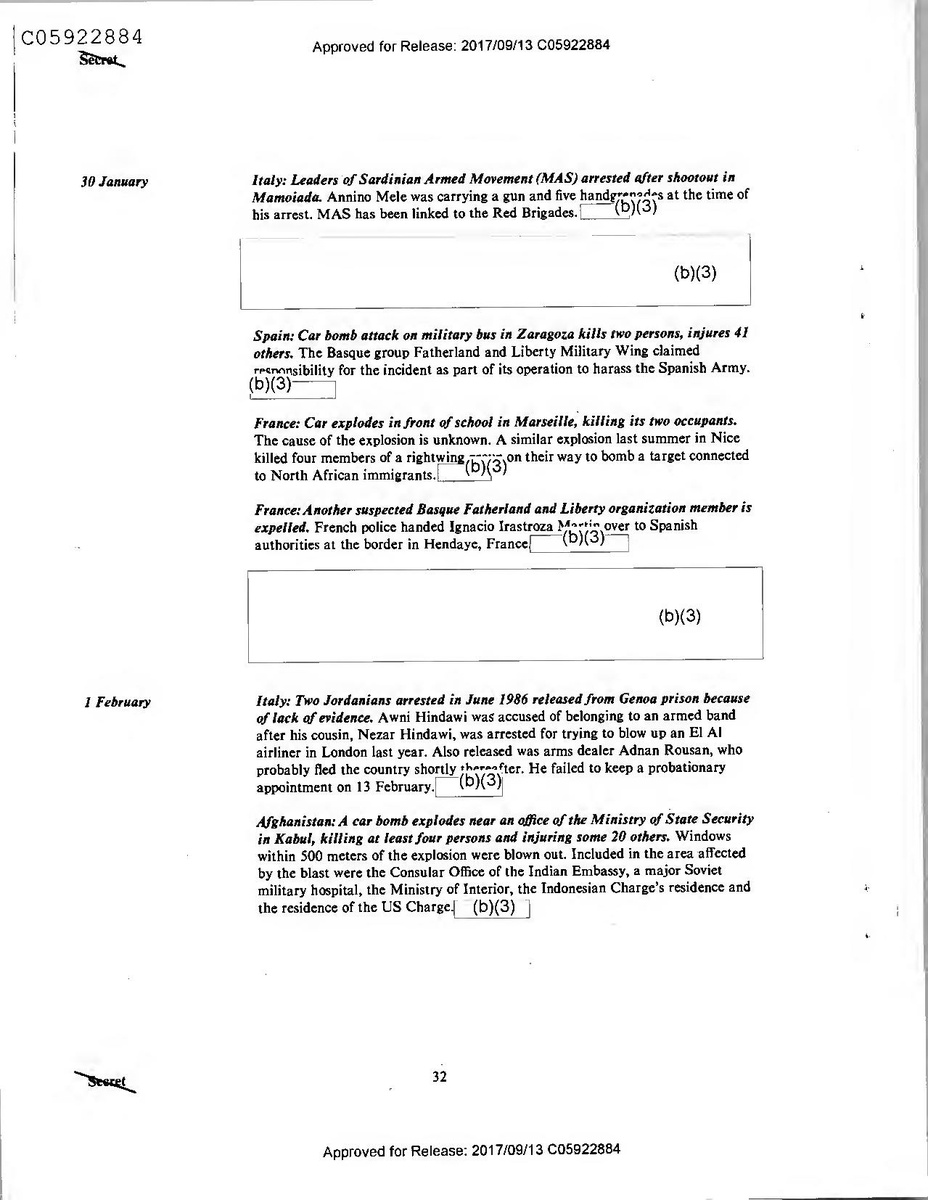
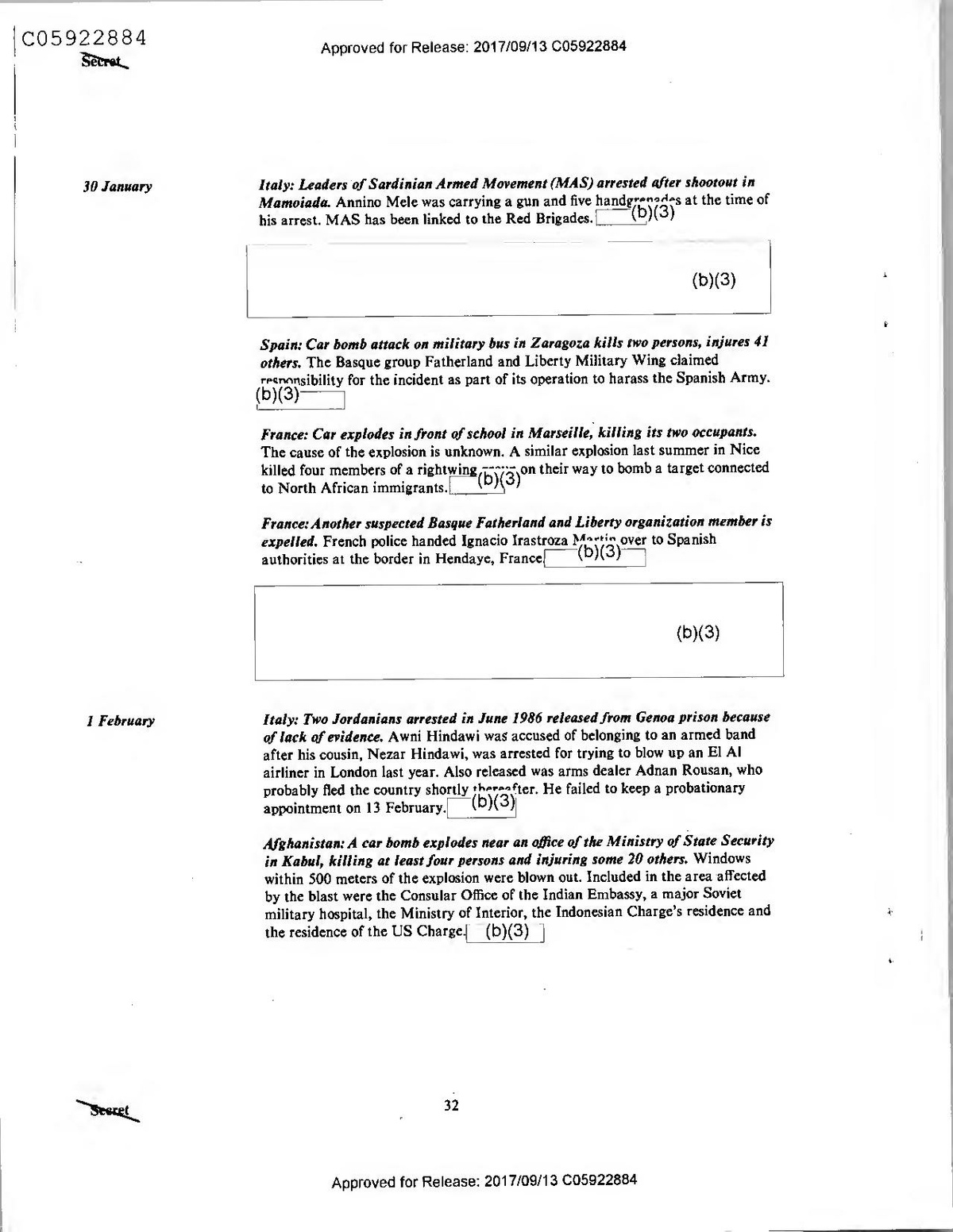
January
Italy: Leaders of Sardinian Armed Movement (MAS) arrested after shootout in Mamoiada. Annino Mele was carrying a gun and five handgrenades at the time of his arrest. MAS has been linked to the Red Brigades.
(b)(3)
(b)(3)
Spain: Car bomb attack on military bus in Zaragoza kills two persons, injures 41 others. The Basque group Fatherland and Liberty Military Wing claimed resnonsibility for the incident as part of its operation to harass the Spanish Army. (b)(3)
France: Car explodes in front of school in Marseille, killing its two occupants. The cause of the explosion is unknown. A similar explosion last summer in Nice killed four members of a rightwing, on their way to bomb a target connected to North African immigrants.
(b)(3)°
France: Another suspected Basque Fatherland and Liberty organization member is expelled. French police handed Ignacio Irastroza Martin over to Spanish authorities at the border in Hendaye, France,
f(b)(3)
(b)(3)
1 February
Italy: Two Jordanians arrested in June 1986 released from Genoa prison because of lack of evidence. Awni Hindawi was accused of belonging to an armed band after his cousin, Nezar Hindawi, was arrested for trying to blow up an El Al airliner in London last year. Also released was arms dealer Adnan Rousan, who probably fled the country shortly thereafter. He failed to keep a probationary appointment on 13 February. (b)(3)
Afghanistan: A car bomb explodes near an office of the Ministry of State Security in KabUL, killing at least four persons and injuring some 20 others. Windows within 500 meters of the explosion were blown out. Included in the area affected by the blast were the Consular Office of the Indian Embassy, a major Soviet military hospital, the Ministry of Interior, the Indonesian Charge's residence and the residence of the US Charge. (b)(3)
32
Sesret
Approved for Release: 2017/09/13 C05922884
February
Spain: Bomb explodes at Swiss pharmaceutical corporation in Bilbao. The blast caused material damage but no injuries. The same day, police defuse a bomb at a Renault office in Baracaldo. Tha Rasque Fatherland and Liberty Military wing probably was responsible.
(b)(3)
Four Basque Fatherland and Liberty suspects moved from Pau prison to jails in the Paris region. The four are awaiting extradition to Spain. _(b)(3)
4 February
Belgium: Authorities in Mons arrest two women who are suspected members of an Italian leftist terrorist group. They are believed to be members of the Combatant Communist Unit that committed terrorist acts in the early 1980s. (b)(3)
5 February
Spain: Galician separatists detonate bombs in seven northwestern towns, causing little damage to regional banks and no injuries. The Galician Free People's Army
claimed responsibility protesting the detention of three members of the group. (b)(3)
South Africa: A bomb explodes in a bus shelter near an estate frequented by South African President P. W. Botha and senior members of his Cabinet. Police suspect that a limpet mine planted by me African National Congress was responsible. One
(b)(3) woman was slightly injured.
6 February
Austria: Arab and Palestinian students occupy Arab League Mission in Vienna to
refugee camps in Lebanon. The takeover was accomplished
protest att,
peacefully.(b)(3)
West Germany: Bomb explodes at Asylum Seekers 'registration office in West Berlin. There were no injuries and only slight damage. The Revolutionary Cells (RZ) claimed responsibility
(b)(3)
El Salvador: Armed terrorists hijack San Salvador bus. The hijackers left subversive literature and fled following a brief firefight. No injuries were reported. (b)(3)
7 February
Belgium: Molotov cocktails thrown at Syrian Embassy. An anonymous caller
jesieged Palestinian camps in Lebanon, and to protest the Assad regime.
claimed the firebombs were thrown in reveng(b)(3)?
Italy: Two Italians, kidnaped by the Ethiopian People's Revolutionary Army in December, returned home. The Italians said they were treated well by their captors. Several Ethiopians captured with them were also freed.[(b)(3)
33
Secret
Approved for Release: 2017/09/13 C05922884
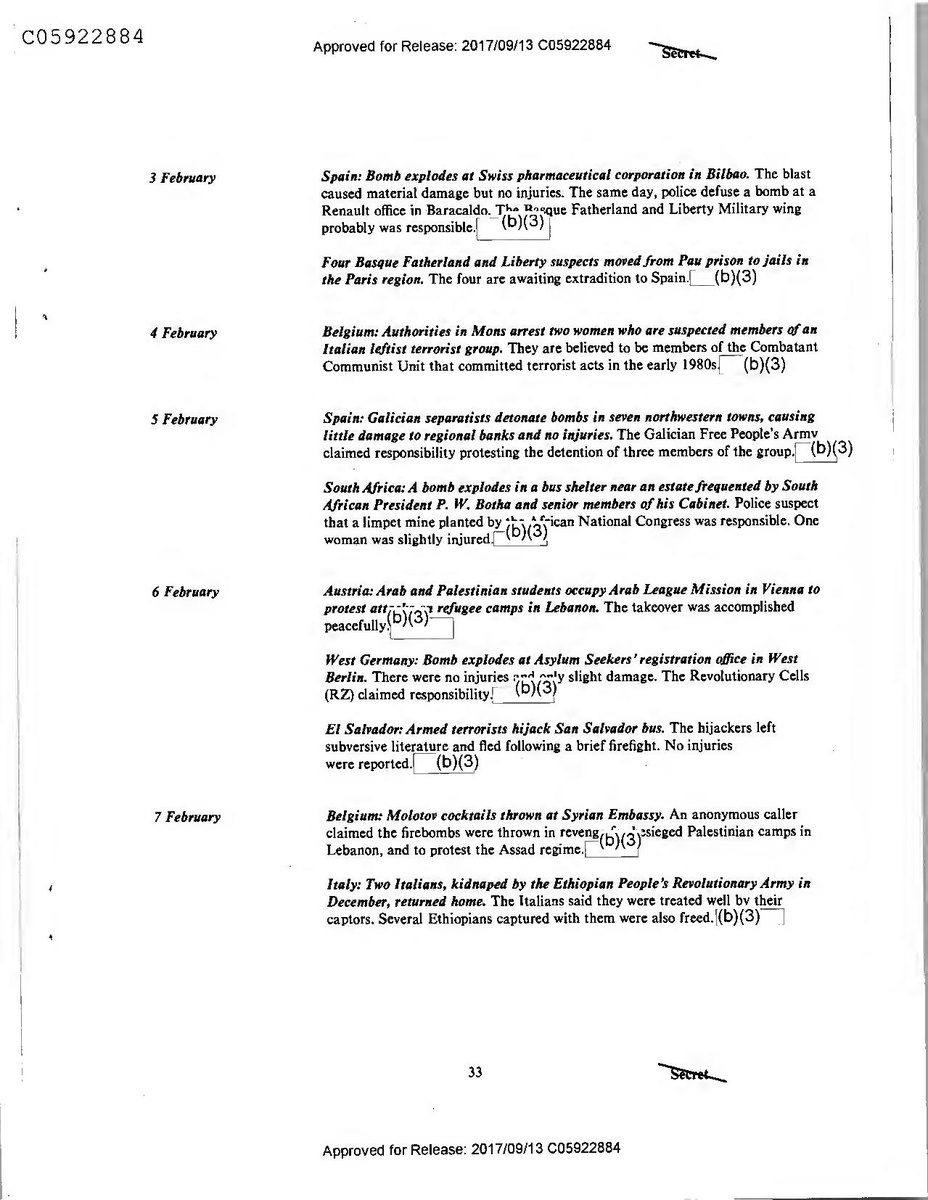
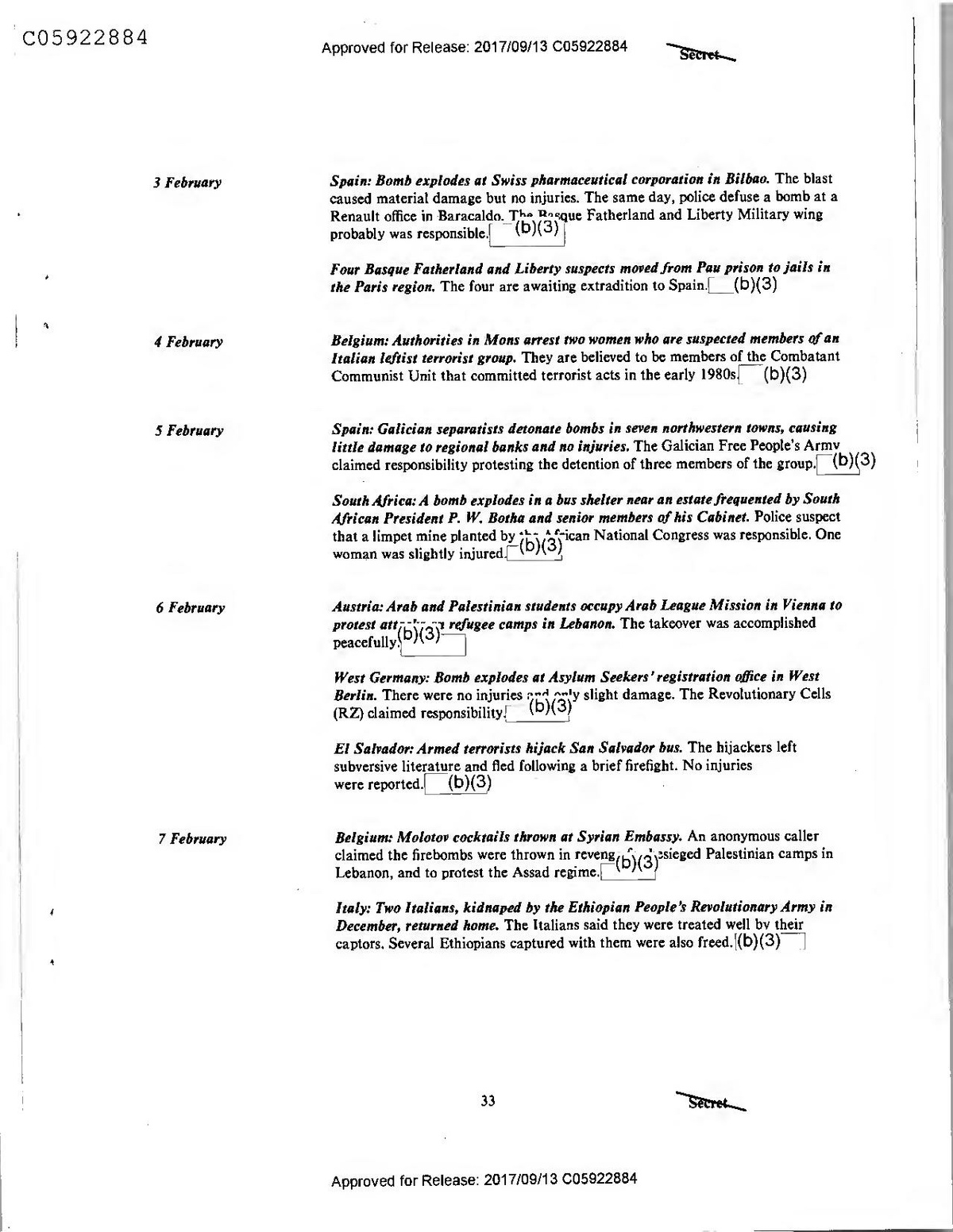
February
Spain: Bomb explodes at Swiss pharmaceutical corporation in Bilbao. The blast caused material damage but no injuries. The same day, police defuse a bomb at a Renault office in Baracaldo. Tha Rasque Fatherland and Liberty Military wing probably was responsible.
(b)(3)
Four Basque Fatherland and Liberty suspects moved from Pau prison to jails in the Paris region. The four are awaiting extradition to Spain. _(b)(3)
4 February
Belgium: Authorities in Mons arrest two women who are suspected members of an Italian leftist terrorist group. They are believed to be members of the Combatant Communist Unit that committed terrorist acts in the early 1980s. (b)(3)
5 February
Spain: Galician separatists detonate bombs in seven northwestern towns, causing little damage to regional banks and no injuries. The Galician Free People's Army
claimed responsibility protesting the detention of three members of the group. (b)(3)
South Africa: A bomb explodes in a bus shelter near an estate frequented by South African President P. W. Botha and senior members of his Cabinet. Police suspect that a limpet mine planted by me African National Congress was responsible. One
(b)(3) woman was slightly injured.
6 February
Austria: Arab and Palestinian students occupy Arab League Mission in Vienna to
refugee camps in Lebanon. The takeover was accomplished
protest att,
peacefully.(b)(3)
West Germany: Bomb explodes at Asylum Seekers 'registration office in West Berlin. There were no injuries and only slight damage. The Revolutionary Cells (RZ) claimed responsibility
(b)(3)
El Salvador: Armed terrorists hijack San Salvador bus. The hijackers left subversive literature and fled following a brief firefight. No injuries were reported. (b)(3)
7 February
Belgium: Molotov cocktails thrown at Syrian Embassy. An anonymous caller
jesieged Palestinian camps in Lebanon, and to protest the Assad regime.
claimed the firebombs were thrown in reveng(b)(3)?
Italy: Two Italians, kidnaped by the Ethiopian People's Revolutionary Army in December, returned home. The Italians said they were treated well by their captors. Several Ethiopians captured with them were also freed.[(b)(3)
33
Secret
Approved for Release: 2017/09/13 C05922884
(b)(1) (b)(3)
9 February
West Bank: Riots at Balatah Refugee Camp result in injuries to seven Arab
Arabib)(3) two Israelis. Nine youths were ordered detained for three to six months
Colombia: Leftist guerrillas bomb three pipelines in Colombia. The bombings interrupted the flow of oil from the country's largest oil field. The attacks, largely directed against foreign firms, have caused $50 million in damage since 1984. (b)(3)
10 February
Italy: Parliament approves bill for reducing jail sentences for reformed terrorists. The new law, aimed at guerrillas who have renounced violence and severed ties with terrorist groups, cuts life sentences to 30 years and other sentences by 25 percent. The land or not apply to those convicted for attacks that have killed several persons
(b)(3)
11 February
West Bank: Five Molotov cocktails damage Israeli bus in Galandiyah. There were no injuries.
(b)(3)
13 February
West Bank: Israeli authorities charge Arab truck drivers with smuggling weapons
(b)(3;1d explosives from Jordan. Bridges were closed for two days to tighten security.
15 February
Israel: Car bomb explodes pre(b)(3)ly in Kefar Sava injuring two Arabs. The PLO claimed responsibility
16 February
Colombia: Police kill a commander of the leftist Popular Liberation Army (EPL) Jairo de Jesus Calvo, during a gunbattle. The EPL has bombed Colombian Government and military facilities, including several in Bogota during January 198 (b)(3)
17 February
Iran: Mujahedin-e Khalq assassinates Education Ministry official. The victim was the personal representative of Ayatollah Khomeini in the city of Kerman
(b)(3)
Iran: Bombing in Mashhad wounds President Khamenei's brother. The Mujahedin-e Khalq claimed responsibility (b)(3)
Sceret
34
Approved for Release: 2017/09/13 C05922884
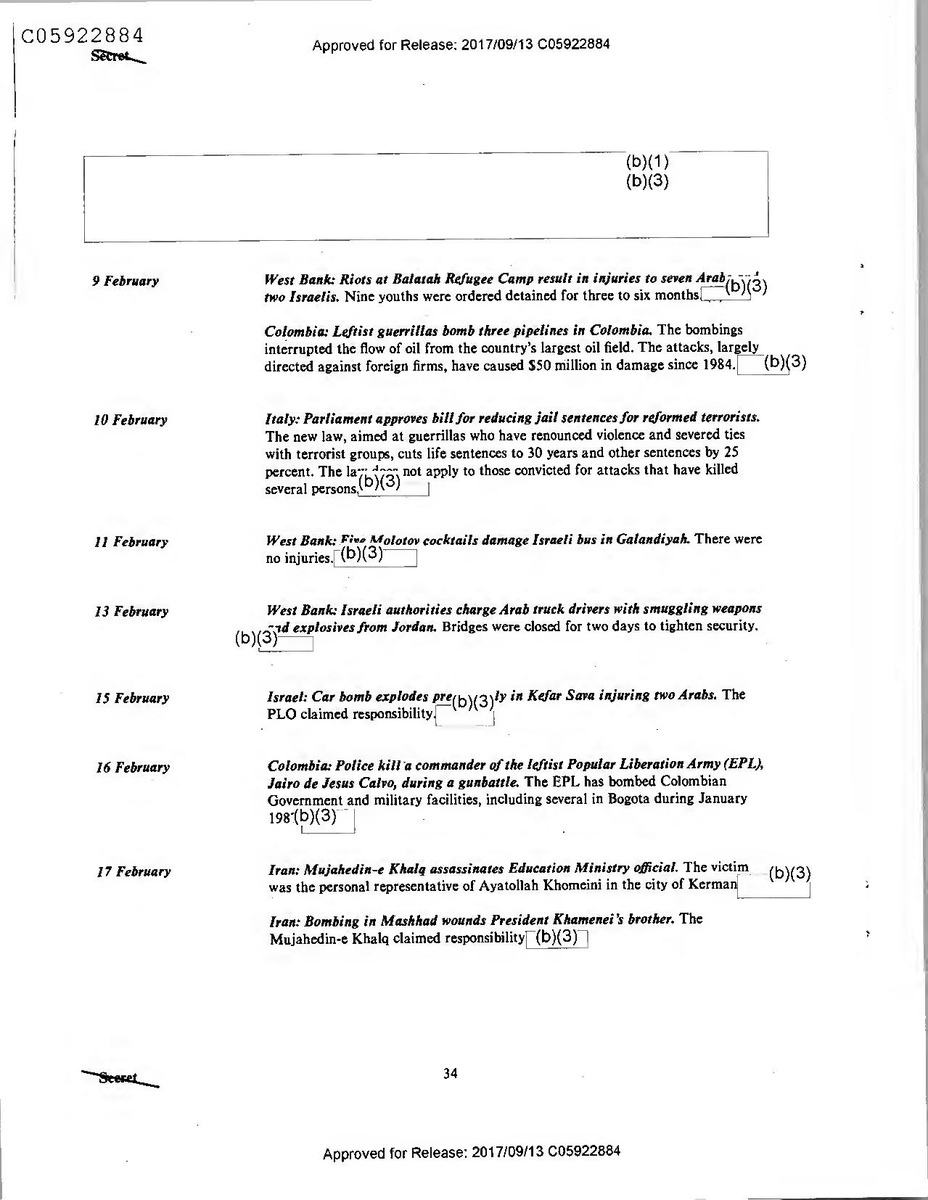
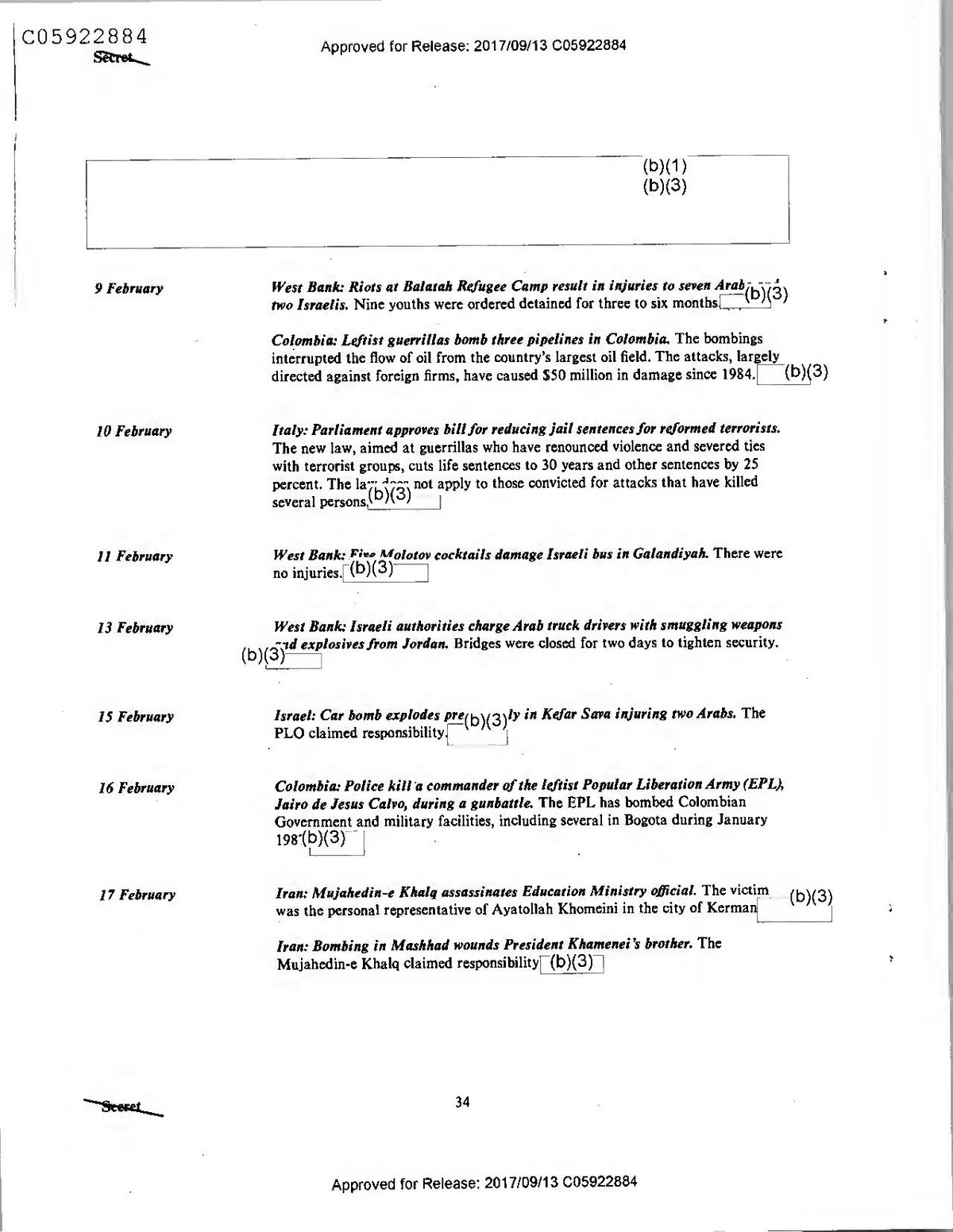
(b)(1) (b)(3)
9 February
West Bank: Riots at Balatah Refugee Camp result in injuries to seven Arab
Arabib)(3) two Israelis. Nine youths were ordered detained for three to six months
Colombia: Leftist guerrillas bomb three pipelines in Colombia. The bombings interrupted the flow of oil from the country's largest oil field. The attacks, largely directed against foreign firms, have caused $50 million in damage since 1984. (b)(3)
10 February
Italy: Parliament approves bill for reducing jail sentences for reformed terrorists. The new law, aimed at guerrillas who have renounced violence and severed ties with terrorist groups, cuts life sentences to 30 years and other sentences by 25 percent. The land or not apply to those convicted for attacks that have killed several persons
(b)(3)
11 February
West Bank: Five Molotov cocktails damage Israeli bus in Galandiyah. There were no injuries.
(b)(3)
13 February
West Bank: Israeli authorities charge Arab truck drivers with smuggling weapons
(b)(3;1d explosives from Jordan. Bridges were closed for two days to tighten security.
15 February
Israel: Car bomb explodes pre(b)(3)ly in Kefar Sava injuring two Arabs. The PLO claimed responsibility
16 February
Colombia: Police kill a commander of the leftist Popular Liberation Army (EPL) Jairo de Jesus Calvo, during a gunbattle. The EPL has bombed Colombian Government and military facilities, including several in Bogota during January 198 (b)(3)
17 February
Iran: Mujahedin-e Khalq assassinates Education Ministry official. The victim was the personal representative of Ayatollah Khomeini in the city of Kerman
(b)(3)
Iran: Bombing in Mashhad wounds President Khamenei's brother. The Mujahedin-e Khalq claimed responsibility (b)(3)
Sceret
34
Approved for Release: 2017/09/13 C05922884
o
Secret
Approved for Release: 2017/09/13 C05922884
o
Secret
Approved for Release: 2017/09/13 C05922884
FLOEMAS
Directorate of Intelligence
INTELLE
NOFORN-NOCONTRACT(b)(3)
um
MASTER FILE COPY
DO NOT GIVE OUT
OR MARK ON
Terrorism Review
(b)(3)
o
26 March 1987
Secret
DI TR 87-006 26 March 1987
Copy 628
Approved for Release: 2017/09/13 C05922886
FLOEMAS
Directorate of Intelligence
INTELLE
NOFORN-NOCONTRACT(b)(3)
um
MASTER FILE COPY
DO NOT GIVE OUT
OR MARK ON
Terrorism Review
(b)(3)
o
26 March 1987
Secret
DI TR 87-006 26 March 1987
Copy 628
Approved for Release: 2017/09/13 C05922886
Warning Notice
Intelligence Sources or Methods Involved (WNINTEL)
National Security Information
Unauthorized Disclosure Subject to Criminal Sanctions
Dissemination Control Abbreviations
NOFORN (NF) NOCONTRACT (NC) PROPIN (PR) ORCON (OC)
Not releasable to foreign nationals Not releasable to contractors or contractor/consultants Caution--proprietary information involved Dissemination and extraction of information controlled by originator
REL...
This information has been authorized for release to...
FGI
Foreign government information WNINTEL-Intelligence sources or methods involved
WN
(b)(3)
All material on this page is Unclassified
Approved for Release: 2017/09/13 C05922886
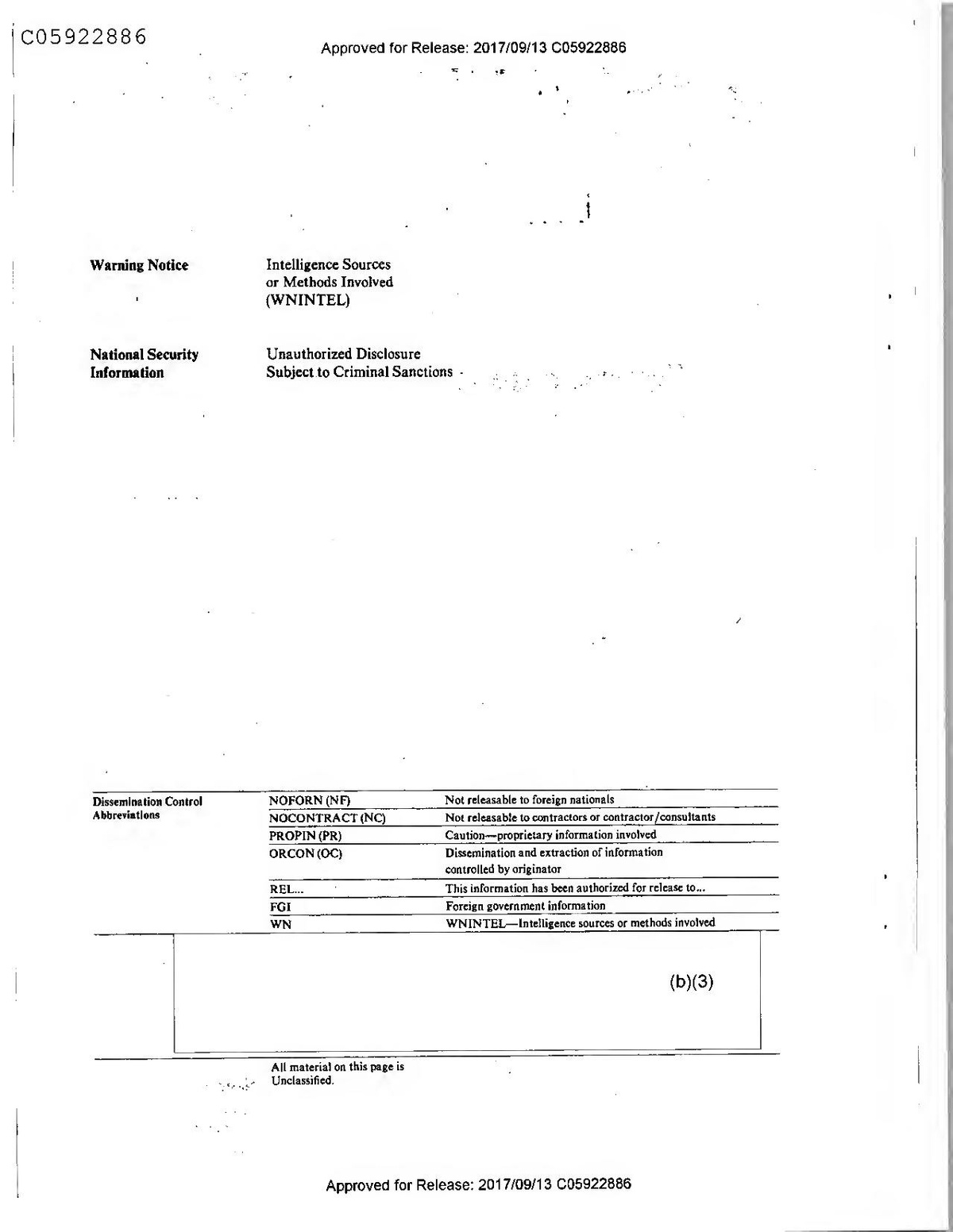
Warning Notice
Intelligence Sources or Methods Involved (WNINTEL)
National Security Information
Unauthorized Disclosure Subject to Criminal Sanctions
Dissemination Control Abbreviations
NOFORN (NF) NOCONTRACT (NC) PROPIN (PR) ORCON (OC)
Not releasable to foreign nationals Not releasable to contractors or contractor/consultants Caution--proprietary information involved Dissemination and extraction of information controlled by originator
REL...
This information has been authorized for release to...
FGI
Foreign government information WNINTEL-Intelligence sources or methods involved
WN
(b)(3)
All material on this page is Unclassified
Approved for Release: 2017/09/13 C05922886
(b)(1)
(b)(3)
Terrorism Review
26 March 1987
-(b)(3)
1
(b)(3).us: France—What Will LARF Do Now?
-(b)(3)
5
Highlights Counterlerrorist Cenler
୨
F(b)(3)
f(b)(3)rview of Middle Eastern Terrorism in 1986
(b)(3)
17
-(b)(3) Tracing Terrorist Explosives [(b)(3)
1
-(b)(3)
21
Chronology of Terrorism—1986-87 Counterterrorist Center
This review is published biweekly by the Directorate of Intelligence. Appropriate articles produced by other elements of the CIA as well as by other agencies of the US Intelligence Community will be considered for publication. Comments and queries are welcome and may be directed to the Executive tor
(b)(3)
Reverse Blank
iii
Secret
Approved for Release: 2017/09/13 C05922886
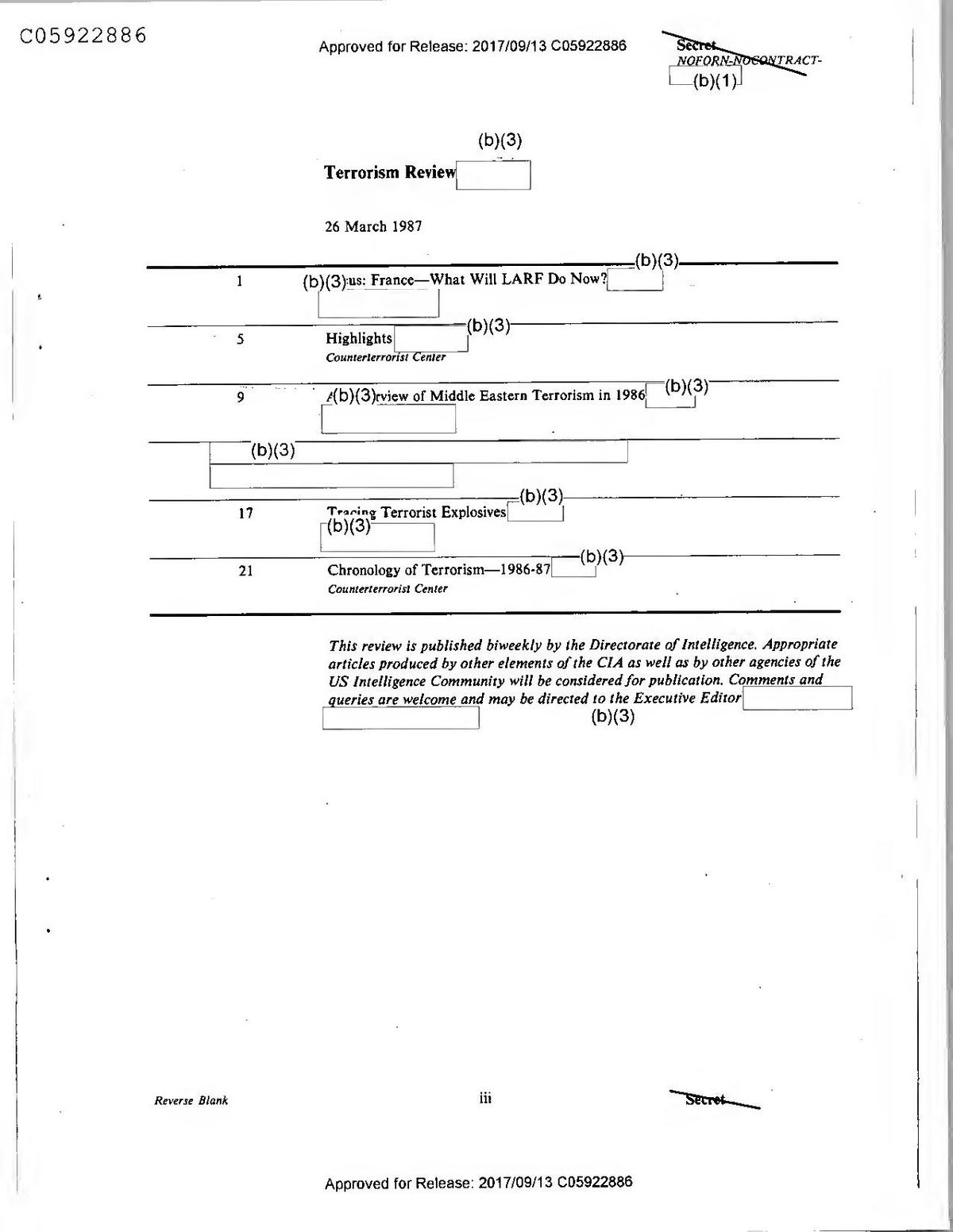
(b)(1)
(b)(3)
Terrorism Review
26 March 1987
-(b)(3)
1
(b)(3).us: France—What Will LARF Do Now?
-(b)(3)
5
Highlights Counterlerrorist Cenler
୨
F(b)(3)
f(b)(3)rview of Middle Eastern Terrorism in 1986
(b)(3)
17
-(b)(3) Tracing Terrorist Explosives [(b)(3)
1
-(b)(3)
21
Chronology of Terrorism—1986-87 Counterterrorist Center
This review is published biweekly by the Directorate of Intelligence. Appropriate articles produced by other elements of the CIA as well as by other agencies of the US Intelligence Community will be considered for publication. Comments and queries are welcome and may be directed to the Executive tor
(b)(3)
Reverse Blank
iii
Secret
Approved for Release: 2017/09/13 C05922886
(b)(3)
Terrorism Review
26 March 1987
(b)(3)
Focus
France-What Will LARF Do Now?
A panel of judges found France's most wanted terrorist, Georges Ibrahim Abdallah, leader of the Lebanese Armed Revolutionary Faction (LARF), guilty of complicity in two murders and one attempted murder of US and Israeli diplomats. In a surprise move, he was sentenced to life in prison, even after government prosecutors asked for a 10-year sentence. French-public opinion greeted the tough sentence and guilty verdict on all three counts with approval. Both President Mitterrand and Prime Minister Chirac have publicly stated invabdallah will not
(b)(3) be pardoned, an act that is now his last legal recourse.
The citizens of Paris braced for retaliatory bombings like those of February, March, and September of 1986, conducted by followers of Abdallah seeking his release. Over 1,000 policemen were brought into Paris during the trial. So far the
pw much longer LARF will refrain from terrorist attacks in France.
group's threats have not materialized, and observers are wonde(b)(3);
French security officials see a combination of three reasons for the calm during March: LARF also was surprised by the trial's outcome and is building a network for future attacks; the group has been deterred somewhat by the additional security in Paris; and Syria has been pressuring LARF not to attack French targets. Each of these factors probably has some validity:
LARF's current capability to act in Western Europe is uncertain, but the group probably was just as surprised by the verdict as more seasoned observers and may, in fact, be weighing its options while at the same time rebuilding its infrastructure in France.
.
Paris is, indeed, better prepared to handle another bombing campaign like those of last year, but it is by no means certain that the group will conduct another such campaign—and the current high level of security cannot be sustained indefinitely.
• Syrian pressure on the group may have figured in the March calm and will
become even more important in the coming months, (b)(3)
(b)(1) (b)(3)
Syria --The Key Player
France explored many avenues to halt the bombings in September 1986, and Syria probably played a key role in restraining LARF. Damascus controls the area of northern Lebanon where the Abdallah family and other clans with LARF members are located, and Syrian officials have told LARF leaders that they would not tolerate further attacks on French soil. There were none in the six months preceding the trial. Syrian President Assad may
1
Secret
DI TR 87-006 26 March 1987
Approved for Release: 2017/09/13 C05922886
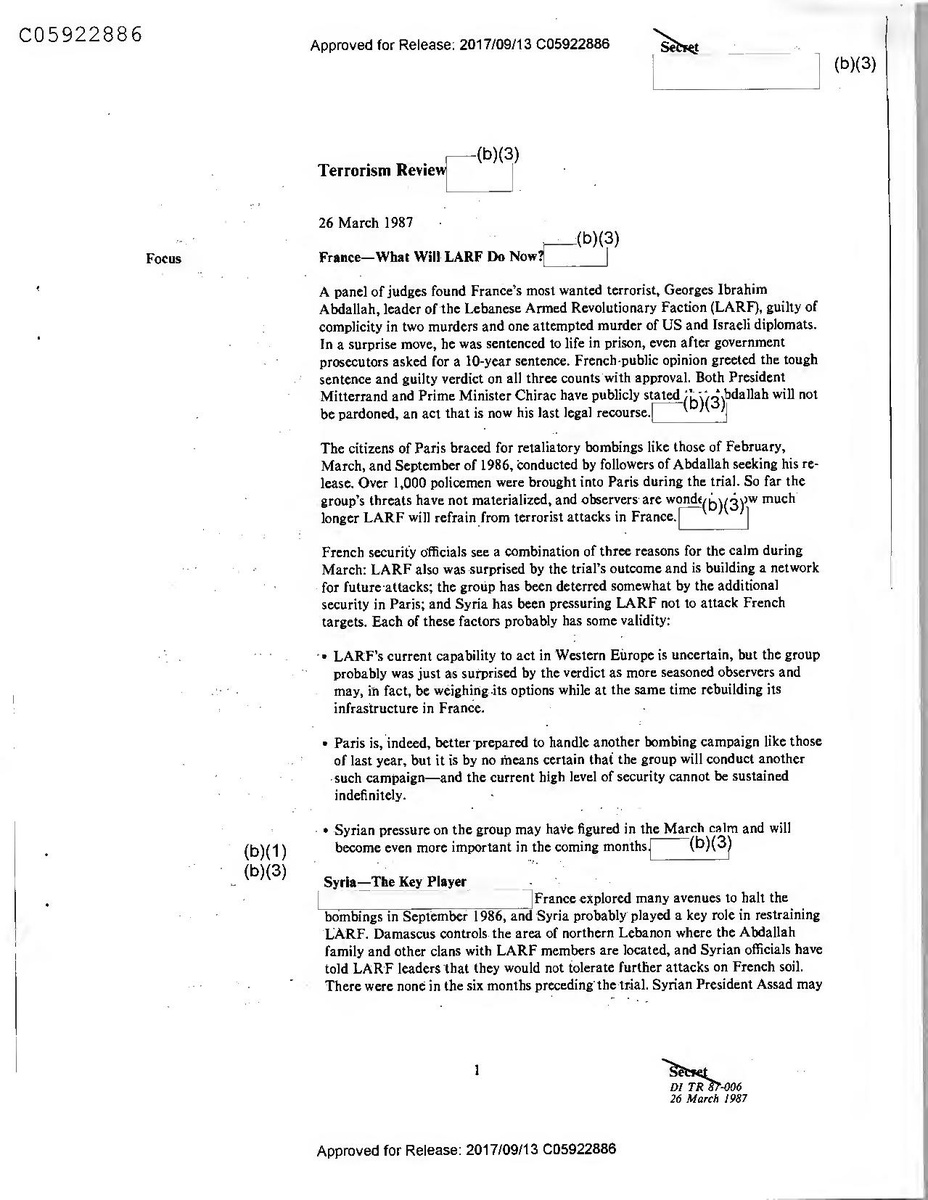
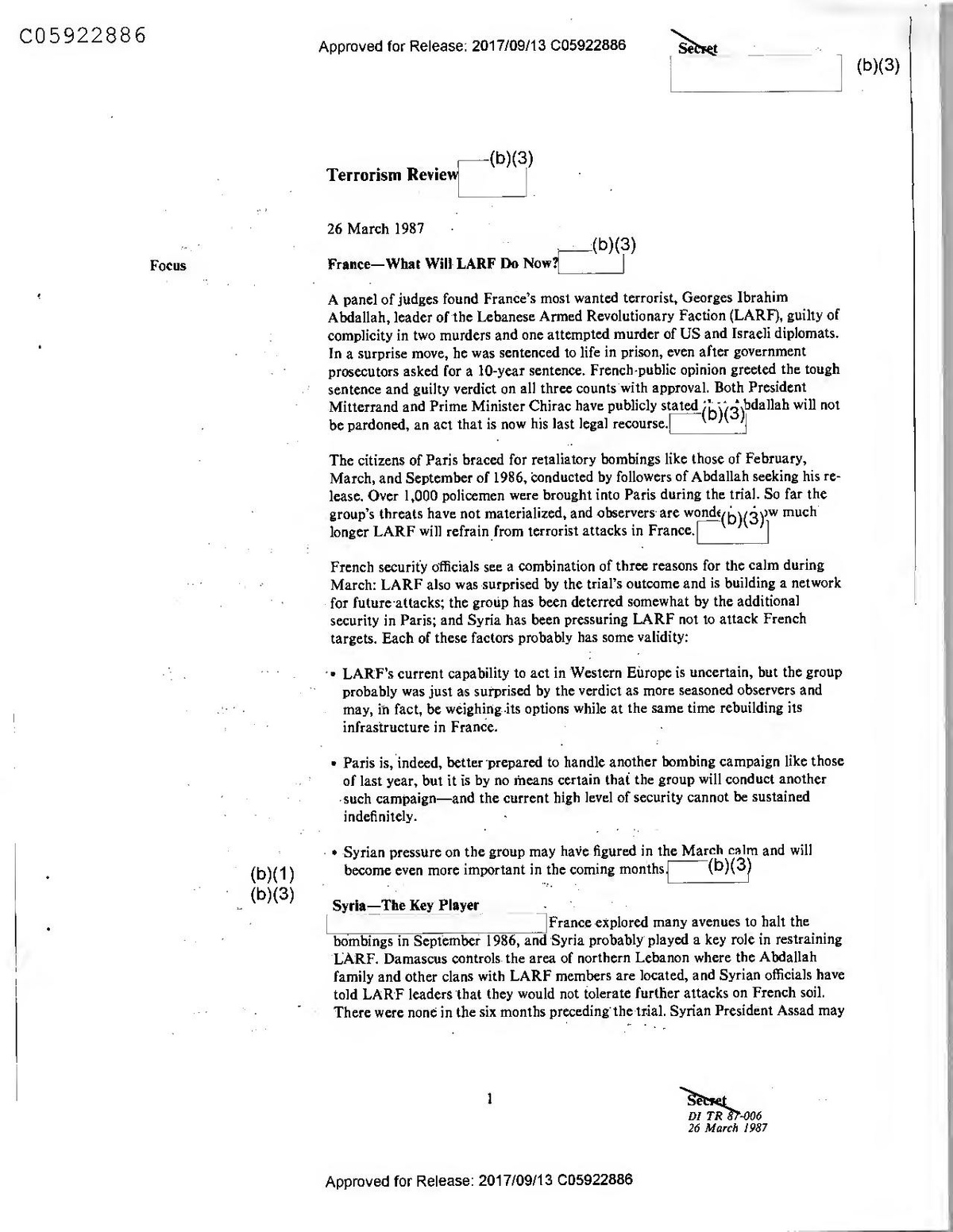
(b)(3)
Terrorism Review
26 March 1987
(b)(3)
Focus
France-What Will LARF Do Now?
A panel of judges found France's most wanted terrorist, Georges Ibrahim Abdallah, leader of the Lebanese Armed Revolutionary Faction (LARF), guilty of complicity in two murders and one attempted murder of US and Israeli diplomats. In a surprise move, he was sentenced to life in prison, even after government prosecutors asked for a 10-year sentence. French-public opinion greeted the tough sentence and guilty verdict on all three counts with approval. Both President Mitterrand and Prime Minister Chirac have publicly stated invabdallah will not
(b)(3) be pardoned, an act that is now his last legal recourse.
The citizens of Paris braced for retaliatory bombings like those of February, March, and September of 1986, conducted by followers of Abdallah seeking his release. Over 1,000 policemen were brought into Paris during the trial. So far the
pw much longer LARF will refrain from terrorist attacks in France.
group's threats have not materialized, and observers are wonde(b)(3);
French security officials see a combination of three reasons for the calm during March: LARF also was surprised by the trial's outcome and is building a network for future attacks; the group has been deterred somewhat by the additional security in Paris; and Syria has been pressuring LARF not to attack French targets. Each of these factors probably has some validity:
LARF's current capability to act in Western Europe is uncertain, but the group probably was just as surprised by the verdict as more seasoned observers and may, in fact, be weighing its options while at the same time rebuilding its infrastructure in France.
.
Paris is, indeed, better prepared to handle another bombing campaign like those of last year, but it is by no means certain that the group will conduct another such campaign—and the current high level of security cannot be sustained indefinitely.
• Syrian pressure on the group may have figured in the March calm and will
become even more important in the coming months, (b)(3)
(b)(1) (b)(3)
Syria --The Key Player
France explored many avenues to halt the bombings in September 1986, and Syria probably played a key role in restraining LARF. Damascus controls the area of northern Lebanon where the Abdallah family and other clans with LARF members are located, and Syrian officials have told LARF leaders that they would not tolerate further attacks on French soil. There were none in the six months preceding the trial. Syrian President Assad may
1
Secret
DI TR 87-006 26 March 1987
Approved for Release: 2017/09/13 C05922886
have been motivated initially by international condemnation of the Syrian role in well-publicized terrorist attacks in the United Kingdom and West Germany in 1986. Since the fall of 1986, other factors probably have bolstered Syria's stake in better relations with Paris. Several months of negotiations for badly needed French wheat arently resulted in a sizable grain deal in mid-March, and Damascus may hope that old French-Lebanese ties can be invoked to keep Maronite
is Syria can restrain LARF indefinitely.
LARF's family-based structure was a major asset during its operations in Europe in the early 1980s—most members were from a handfUL of families in two villages in northern Lebanon. The resulting security kept the group safe from penetrations. That strength has become a disadvantage, however, because to augment its ranks LARF would have to turn to nonfamily members for recruits. The group's reliance on a network of extended families, and the concentration of their financial and property holdings in a small area of Lebanon, make LARF a virtual hostage to Syrian pressure Abdallah family leaders reportedly are chafing under Syrian restrictions (b)(3)
Yet some of the most dangerous members of LARF are not family members and may to able to operate more freely. Jacqueline Esbir-Georges Abdallah's girlfriend and the suspected assassin of Israeli diplomat Barsimantov in Paris in 1982-and Salim al-Khuri, Abdallah's key aide in earlier years, are at large and may be planning some action. They reportedly are currently in Western Europe and probably were the driving force behind the massive bombing campaigns in 1986 that killed and wounded scores of French citizens. (b)(3)
LARF's Next Moves LARF may believe a presidential amnesty following the May 1988 French election to be the earliest practical opportunity for Abdallah’s release. Because of the publicity the trial received, it is highly unlikely that he would be pardoned before then. If the group has been told an eventual pardon may be forthcoming, it may refrain from attacks against French interests for the next 14 months.
LARF not want to wait for an uncertain future pardon, the group could turn to other venues, such as Lebanon, in which to stage attacks. An operation in France-or elsewhere—could be launched more quickly if the LARF's longtime Palestinian ally, the Popular Front for the Liberation of Palestine-Special Command (PFLP-SC), were to provide logistic and weapons support, as it probably did during the bombings of 1986. In fact, the PFLP-SC may have been responsible for the 18 March bombing of a restaurant in Djibouti that left 11 persons (four of them French military personnel) dead. The choice of venue, target, and victims suggests the group, based in nearby Aden, may have acted on LARF's behalf. We do not know the extent of Syrian control over the PFLP.SC or whether Damascus has attempted to restrain the group as it has Larf. (b)(3)
We believe that LARF probably will seek to exact revenge on French interests, but cannot rule out a return to anti-US operations. Attacks on US targets are possible, since the United States played a major role in pressing for Abdallah's trial. Any.
2
Approved for Release: 2017/09/13 C05922886
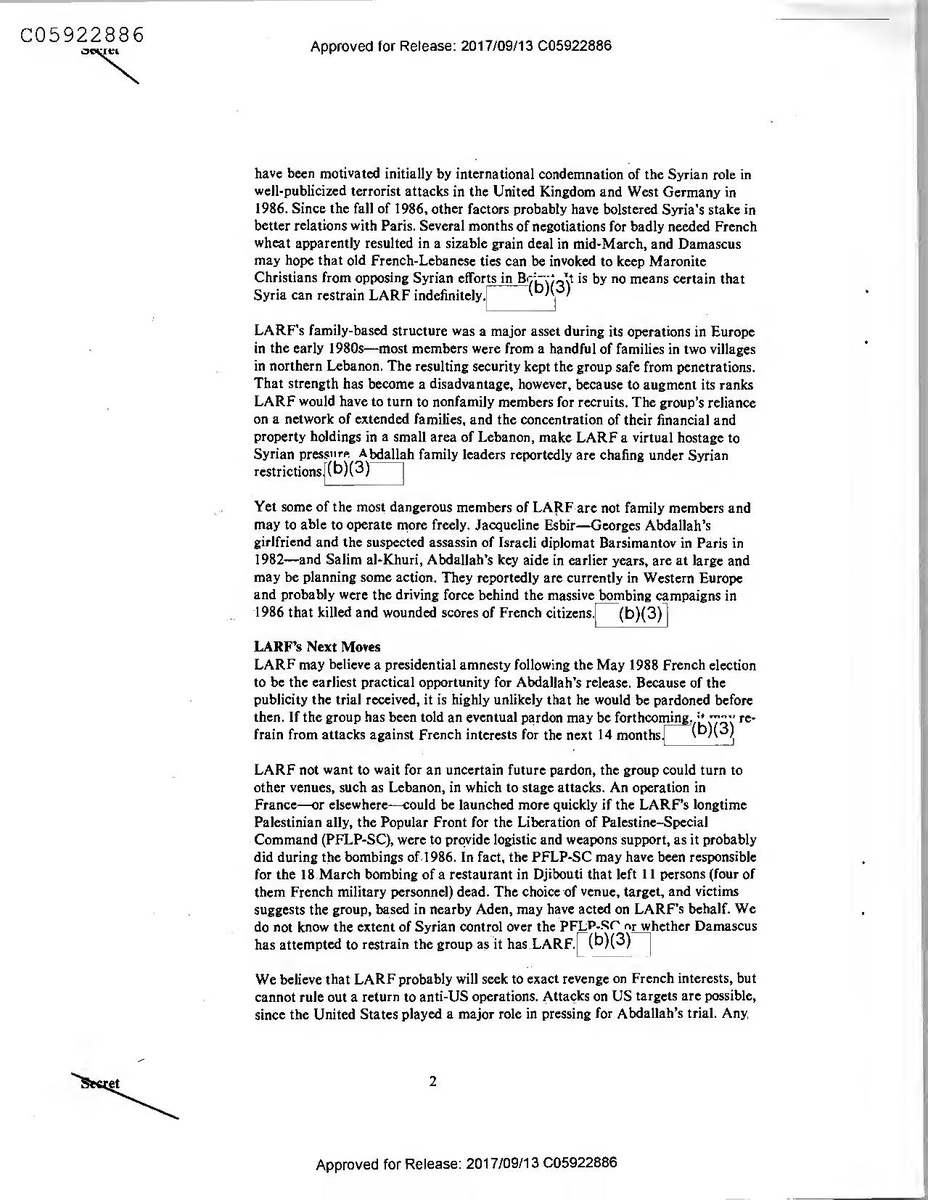
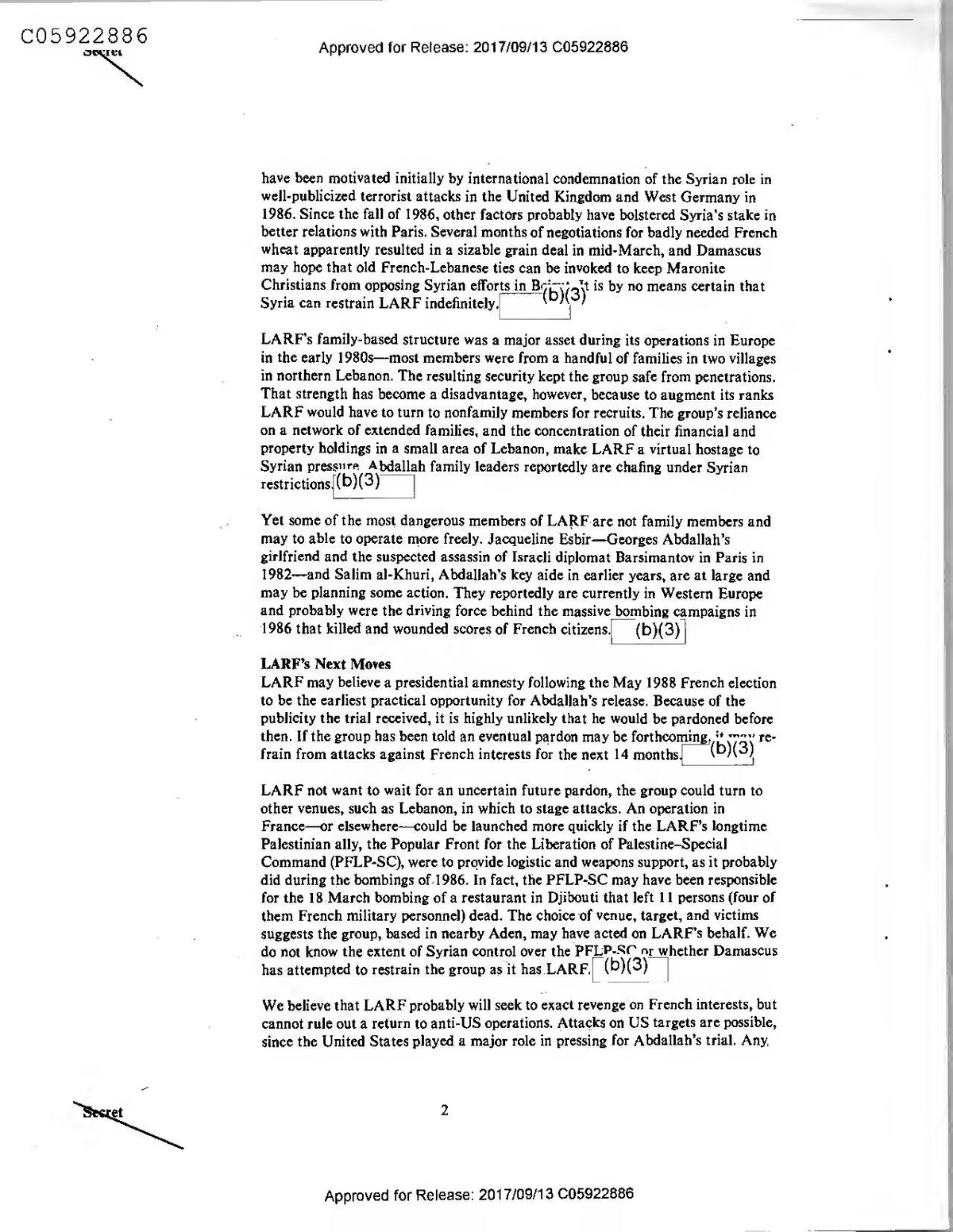
have been motivated initially by international condemnation of the Syrian role in well-publicized terrorist attacks in the United Kingdom and West Germany in 1986. Since the fall of 1986, other factors probably have bolstered Syria's stake in better relations with Paris. Several months of negotiations for badly needed French wheat arently resulted in a sizable grain deal in mid-March, and Damascus may hope that old French-Lebanese ties can be invoked to keep Maronite
is Syria can restrain LARF indefinitely.
LARF's family-based structure was a major asset during its operations in Europe in the early 1980s—most members were from a handfUL of families in two villages in northern Lebanon. The resulting security kept the group safe from penetrations. That strength has become a disadvantage, however, because to augment its ranks LARF would have to turn to nonfamily members for recruits. The group's reliance on a network of extended families, and the concentration of their financial and property holdings in a small area of Lebanon, make LARF a virtual hostage to Syrian pressure Abdallah family leaders reportedly are chafing under Syrian restrictions (b)(3)
Yet some of the most dangerous members of LARF are not family members and may to able to operate more freely. Jacqueline Esbir-Georges Abdallah's girlfriend and the suspected assassin of Israeli diplomat Barsimantov in Paris in 1982-and Salim al-Khuri, Abdallah's key aide in earlier years, are at large and may be planning some action. They reportedly are currently in Western Europe and probably were the driving force behind the massive bombing campaigns in 1986 that killed and wounded scores of French citizens. (b)(3)
LARF's Next Moves LARF may believe a presidential amnesty following the May 1988 French election to be the earliest practical opportunity for Abdallah’s release. Because of the publicity the trial received, it is highly unlikely that he would be pardoned before then. If the group has been told an eventual pardon may be forthcoming, it may refrain from attacks against French interests for the next 14 months.
LARF not want to wait for an uncertain future pardon, the group could turn to other venues, such as Lebanon, in which to stage attacks. An operation in France-or elsewhere—could be launched more quickly if the LARF's longtime Palestinian ally, the Popular Front for the Liberation of Palestine-Special Command (PFLP-SC), were to provide logistic and weapons support, as it probably did during the bombings of 1986. In fact, the PFLP-SC may have been responsible for the 18 March bombing of a restaurant in Djibouti that left 11 persons (four of them French military personnel) dead. The choice of venue, target, and victims suggests the group, based in nearby Aden, may have acted on LARF's behalf. We do not know the extent of Syrian control over the PFLP.SC or whether Damascus has attempted to restrain the group as it has Larf. (b)(3)
We believe that LARF probably will seek to exact revenge on French interests, but cannot rule out a return to anti-US operations. Attacks on US targets are possible, since the United States played a major role in pressing for Abdallah's trial. Any.
2
Approved for Release: 2017/09/13 C05922886
such attacks, probably would be similar to the assassination of Lt. Col. Charles Ray in 1982 and the attempt on the life of the US ConsUL General in Strasbourg in 1984. Before the bombings in 1986, LARF was best known for selective, violent assassinations, as when it killed the Israeli diplomat.
(b)(1) (b)(3)
If LARF is still determined to carry out more terrorism on Abdallah's behalf, one course of action offers a greater chance for success with fewer drawbacks. The group could try to seize, or buy, French hostages in Lebanon or elsewhere and try to negotiate a trade or a pardon for Abdallah. Given Paris's publicly acknowledged policy of hostage negotiations—French hostages have been fraad in LebanonLARF may calculate it could force Paris to cut a deal.
This tactic of putting pressure on the government without alienating the public worked once before: in March 1985, LARF members Esbir and Al-Khuri kidnaped French diplomat Gilles Peyrolles in Beirut and successfully negotiated a swap for Abdallah. The deal fell through, however, after Peyrolles was released, perhaps giving LARF an incentive to seize more than one hostage the next time
around. The French Government may already be preparing for such(b)(1)ario.
(b)(3)
(b)(3)
Reverse Blank
3
Secret
Approved for Release: 2017/09/13 C05922886
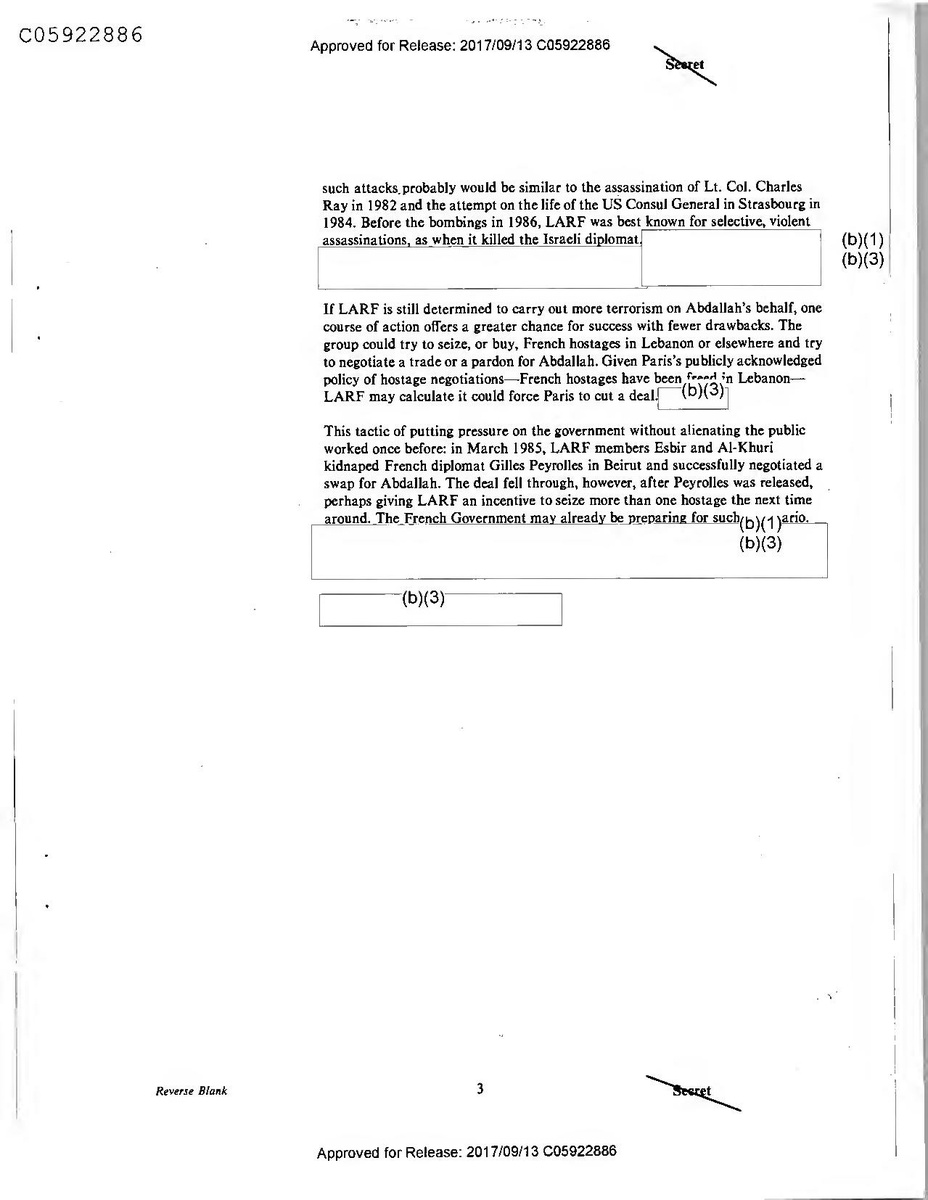
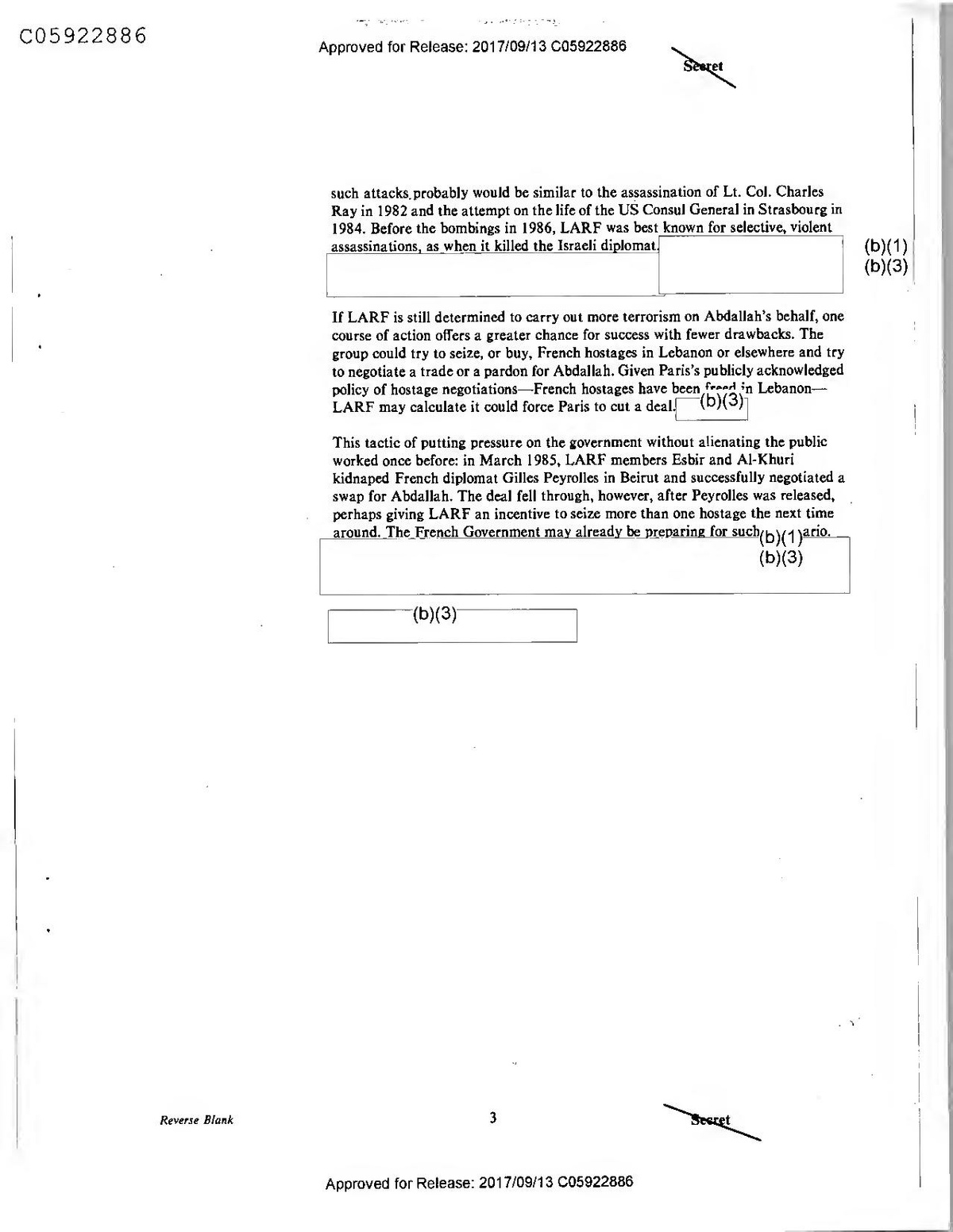
such attacks, probably would be similar to the assassination of Lt. Col. Charles Ray in 1982 and the attempt on the life of the US ConsUL General in Strasbourg in 1984. Before the bombings in 1986, LARF was best known for selective, violent assassinations, as when it killed the Israeli diplomat.
(b)(1) (b)(3)
If LARF is still determined to carry out more terrorism on Abdallah's behalf, one course of action offers a greater chance for success with fewer drawbacks. The group could try to seize, or buy, French hostages in Lebanon or elsewhere and try to negotiate a trade or a pardon for Abdallah. Given Paris's publicly acknowledged policy of hostage negotiations—French hostages have been fraad in LebanonLARF may calculate it could force Paris to cut a deal.
This tactic of putting pressure on the government without alienating the public worked once before: in March 1985, LARF members Esbir and Al-Khuri kidnaped French diplomat Gilles Peyrolles in Beirut and successfully negotiated a swap for Abdallah. The deal fell through, however, after Peyrolles was released, perhaps giving LARF an incentive to seize more than one hostage the next time
around. The French Government may already be preparing for such(b)(1)ario.
(b)(3)
(b)(3)
Reverse Blank
3
Secret
Approved for Release: 2017/09/13 C05922886
Secret
3 February
A suitcase bomb exploded in a building 300 meters from a Phalange Party office. There was extensive damage to shops and parked cars, but no casualties were reported.
12 February
A bomb exploded in front of a theater next to a Phalange Party office. The bomb contained the equivalent of 20 kilograms of dynamite and killed two persons and injured another 15.
24 February
A car packed with explosives and mortar shells exploded near a busy supermarket, killing five persons and injuring 12. The blast set an apartment building on fire and destroyed 15 cars.
8 March
A car bomb exploded in a residential neighborhood, killing four persons and injuring 38. A Pi(b)(3) Party office nearby was not damaged.
Pro-Gemayel Christian officials have arrested 64 persons in connection with the bombings, which began shortly after ex-Lebanese Forces leader Eli Hubayqa fled to Syria on 15 January. No group has claimed responsibility for the bombings, although the most likely suspects are elements of the Lebanese Forces loyal to Hubayqa, who supported the Syrian-backed Lebanese peace agreement. The Hubayqa forces, probably acting with encouragement from Damascus, are trying
In intimidate Gemayel and his supporters into signing the Syrian-brokered accord. (b)(3)
Syria
Truck Bomb Explodes in Damascus A powerfUL bomb exploded inside a refrigerated truck under a bridge overpass in a Damascus suburb on 13 March. The blast reportedly killed six military cadets and seriously wounded as many as 110 other persons. Syrian television broadcast the “confession" of a Lebanese man who claimed Iraqi authorities coerced him into carrying out the attack. (b)(3)
(b)(1) (b)(3)
The bomb was the first attack in Damascus since a series of explosions last fall believed to be linked to Syria's role in Lebanon. While Iraq may have been responsible, some Syrian officials are blaming Lebanese Phalangist elements,
West Bank
Pro-Jordanian Mayor Assassinated
(b)(1) The pro-Jordanian mayor of Nablus was assassinated outside city hall by an (b)(3) unidentified gunman on 2 March.
the Popular Front for the Liberation of Palestine killed Zafir al-Masri to intimidate
Secret
12
Approved for Release: 2017/09/13 C05632837
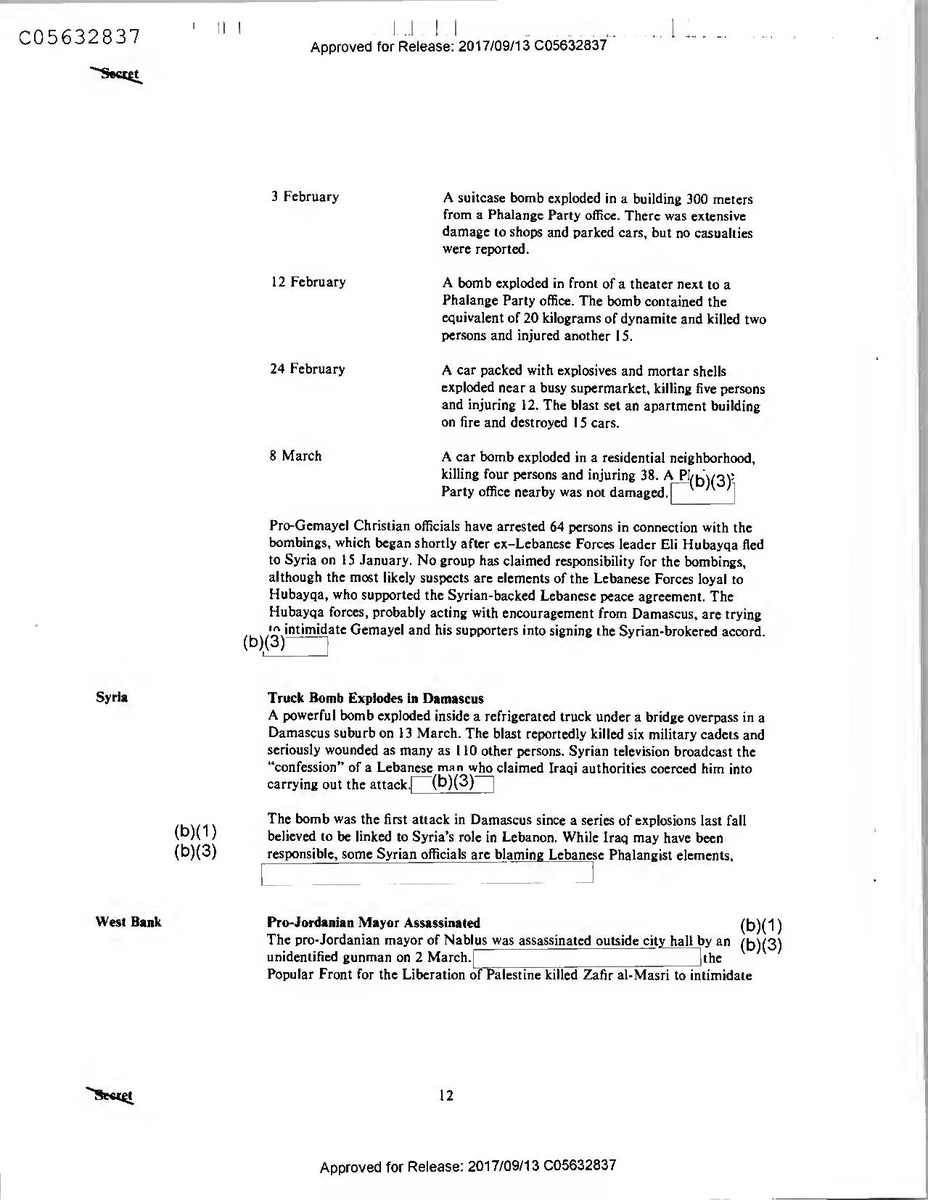
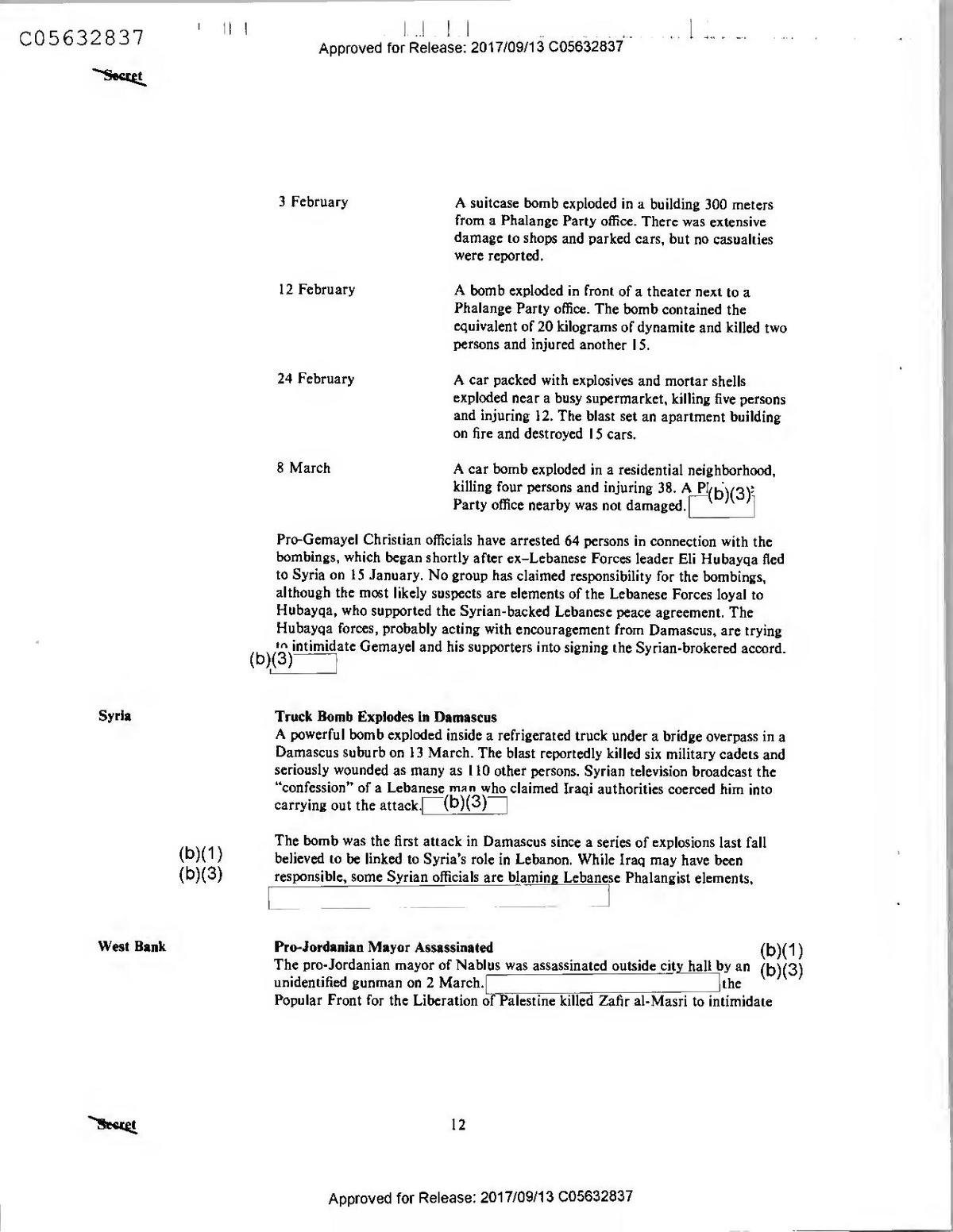
Secret
3 February
A suitcase bomb exploded in a building 300 meters from a Phalange Party office. There was extensive damage to shops and parked cars, but no casualties were reported.
12 February
A bomb exploded in front of a theater next to a Phalange Party office. The bomb contained the equivalent of 20 kilograms of dynamite and killed two persons and injured another 15.
24 February
A car packed with explosives and mortar shells exploded near a busy supermarket, killing five persons and injuring 12. The blast set an apartment building on fire and destroyed 15 cars.
8 March
A car bomb exploded in a residential neighborhood, killing four persons and injuring 38. A Pi(b)(3) Party office nearby was not damaged.
Pro-Gemayel Christian officials have arrested 64 persons in connection with the bombings, which began shortly after ex-Lebanese Forces leader Eli Hubayqa fled to Syria on 15 January. No group has claimed responsibility for the bombings, although the most likely suspects are elements of the Lebanese Forces loyal to Hubayqa, who supported the Syrian-backed Lebanese peace agreement. The Hubayqa forces, probably acting with encouragement from Damascus, are trying
In intimidate Gemayel and his supporters into signing the Syrian-brokered accord. (b)(3)
Syria
Truck Bomb Explodes in Damascus A powerfUL bomb exploded inside a refrigerated truck under a bridge overpass in a Damascus suburb on 13 March. The blast reportedly killed six military cadets and seriously wounded as many as 110 other persons. Syrian television broadcast the “confession" of a Lebanese man who claimed Iraqi authorities coerced him into carrying out the attack. (b)(3)
(b)(1) (b)(3)
The bomb was the first attack in Damascus since a series of explosions last fall believed to be linked to Syria's role in Lebanon. While Iraq may have been responsible, some Syrian officials are blaming Lebanese Phalangist elements,
West Bank
Pro-Jordanian Mayor Assassinated
(b)(1) The pro-Jordanian mayor of Nablus was assassinated outside city hall by an (b)(3) unidentified gunman on 2 March.
the Popular Front for the Liberation of Palestine killed Zafir al-Masri to intimidate
Secret
12
Approved for Release: 2017/09/13 C05632837
_(b)(3),
Highlights
-(b)(3)
Significant Developments
Western Europe
France
Arms Cache Discovered in Paris French police have linked an arms cache discovered on 4 March in Paris to the terrorist apparatus led by senior Fatah security official Colonel Hawari. According to Ziyad Hashash, one of those arrested in connection with the cache, Hawari introduced him in 1984 in Tunis to his principal operative in Western Europe, Muhi-al-Din al Jabir aka Mutran. Mutran arranged for Hashash to receive and store weapons and explosives that were to be used in attacks outside France. Hashash reportedly received two arms deliveries—in December 1984 and in June 1985. A third delivery was planned but never received, probably because Mutrin was arrested
July 1985 in Rome for possession of forged documents.
(b)(3)
(b)(1) (b)(3)
Italy
Summit Seven Experts Agree on Bonn Declaration Update The Summit Seven Experts' Group on Terrorism approved a modest expansion of the 1978 Bonn Declaration on hijacking at a meeting in Rome on 13 March. The declaration, which already commits the seven countries to suspend air traffic with any country that fails to extradite or prosecute suspected hijackers, now will cover anyone involved in any form of terrorist act against civil aviation. The experts also accepted a Canadian proposal to extend the declaration to future aviation conventions. The Italians expressed their desire for a broader declaration on terrorism at the Venice economic summit in June.
(b)(3)
Stiffening the Bonn Declaration will fulfill a commitment made by the heads of state at last year's Tokyo economic summit and is a small—but positive-step in counterterrorist cooperation. Concern for the safety of European hostages, the revelation of US arms sales to Iran, and the current Italian Government crisis limit the prospects for a strong new counterterrorist statement at the summit. In general, the summit countries are likely to resist any additional proposals for specific measures that would limit their political flexibility. (b)(3)
Portugal
FP-25 Members on Trial The outcome of the current trials in Lisbon of members of the leftist terrorist group Popular Forces of 25 April (FP-25) will affect the group's ability to conduct future operations. On trial at present are 73 members of FP-25 who were arrested
5
Secret DI TR -006 26 March 1987
Approved for Release: 2017/09/13 C05922886
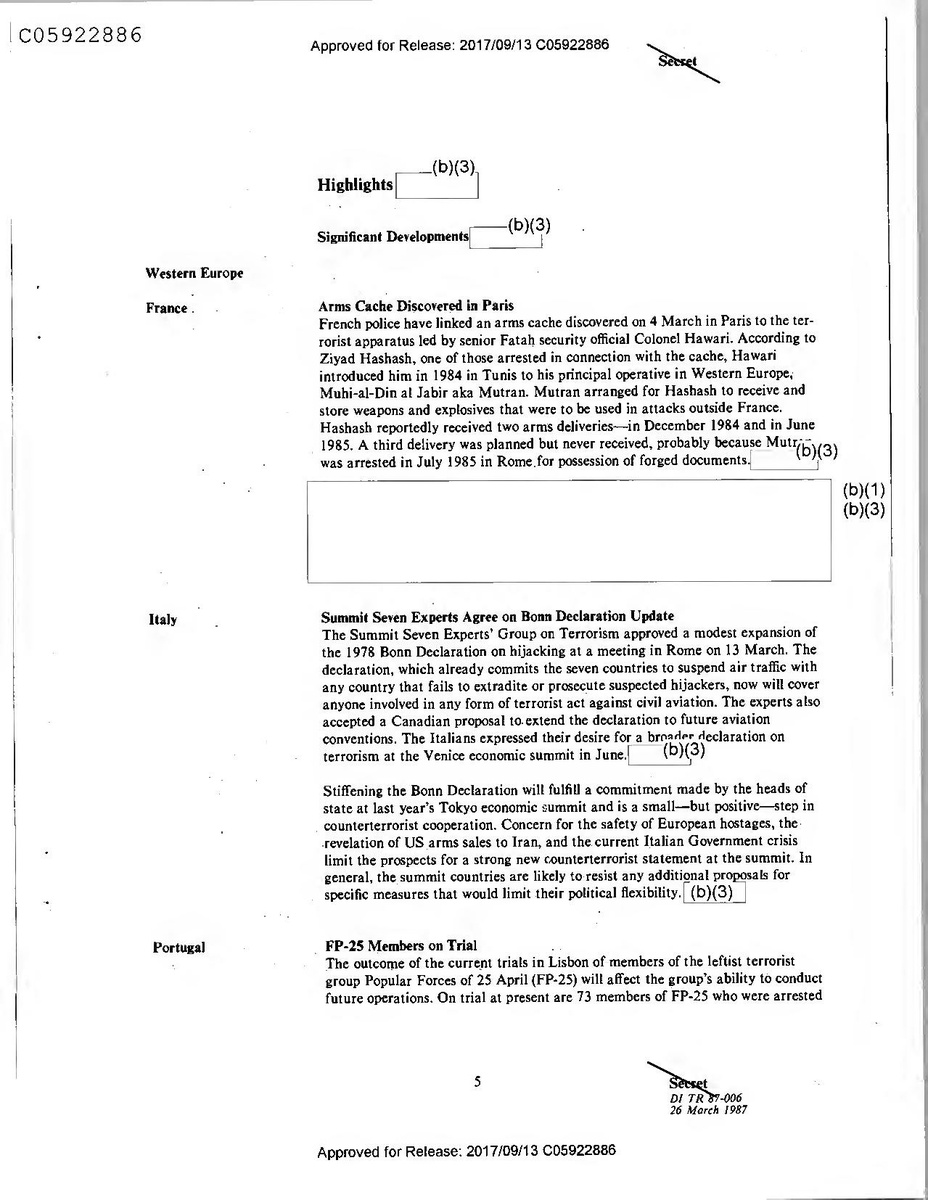
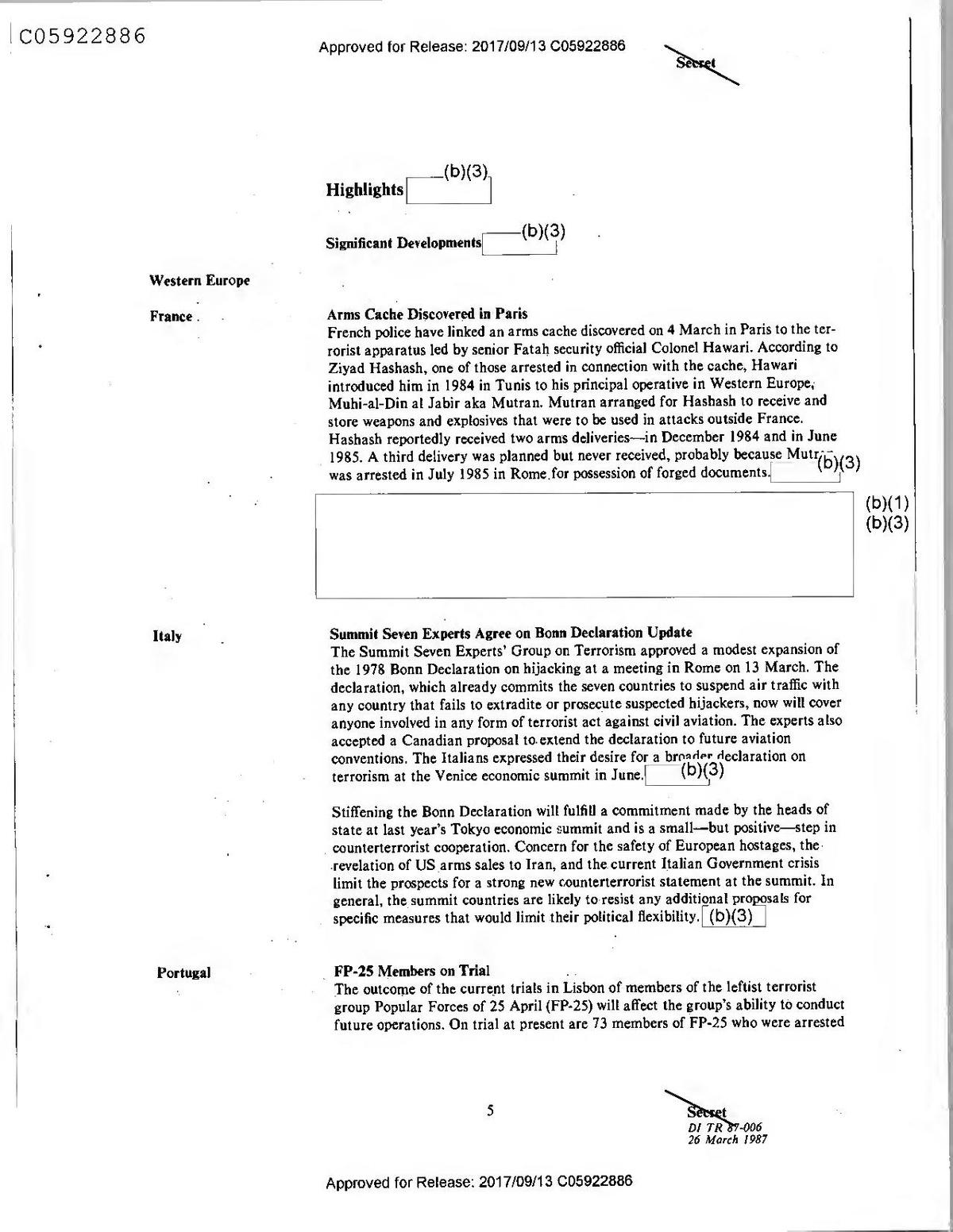
_(b)(3),
Highlights
-(b)(3)
Significant Developments
Western Europe
France
Arms Cache Discovered in Paris French police have linked an arms cache discovered on 4 March in Paris to the terrorist apparatus led by senior Fatah security official Colonel Hawari. According to Ziyad Hashash, one of those arrested in connection with the cache, Hawari introduced him in 1984 in Tunis to his principal operative in Western Europe, Muhi-al-Din al Jabir aka Mutran. Mutran arranged for Hashash to receive and store weapons and explosives that were to be used in attacks outside France. Hashash reportedly received two arms deliveries—in December 1984 and in June 1985. A third delivery was planned but never received, probably because Mutrin was arrested
July 1985 in Rome for possession of forged documents.
(b)(3)
(b)(1) (b)(3)
Italy
Summit Seven Experts Agree on Bonn Declaration Update The Summit Seven Experts' Group on Terrorism approved a modest expansion of the 1978 Bonn Declaration on hijacking at a meeting in Rome on 13 March. The declaration, which already commits the seven countries to suspend air traffic with any country that fails to extradite or prosecute suspected hijackers, now will cover anyone involved in any form of terrorist act against civil aviation. The experts also accepted a Canadian proposal to extend the declaration to future aviation conventions. The Italians expressed their desire for a broader declaration on terrorism at the Venice economic summit in June.
(b)(3)
Stiffening the Bonn Declaration will fulfill a commitment made by the heads of state at last year's Tokyo economic summit and is a small—but positive-step in counterterrorist cooperation. Concern for the safety of European hostages, the revelation of US arms sales to Iran, and the current Italian Government crisis limit the prospects for a strong new counterterrorist statement at the summit. In general, the summit countries are likely to resist any additional proposals for specific measures that would limit their political flexibility. (b)(3)
Portugal
FP-25 Members on Trial The outcome of the current trials in Lisbon of members of the leftist terrorist group Popular Forces of 25 April (FP-25) will affect the group's ability to conduct future operations. On trial at present are 73 members of FP-25 who were arrested
5
Secret DI TR -006 26 March 1987
Approved for Release: 2017/09/13 C05922886
in a police roundup in June 1984. Currently about 20 members are at large and using the name Armed Revolutirnir Faction, but they have not carried out any attacks since the fall of 1986.11(b)(3)
FP-25 leaders and key members are being tried by a panel of three judges. The trial must be concluded by 19 June, because Portuguese law forbids holding a prisoner longer than three years without sentencing. The prosecution has asked for the maximum 20-year sentence for popular folk hero Otelo Sarvaiva de Carvalho and 10 other alleged organizers of the terrorist network. Some members may receive stiff sentences, but the case against others is weaker. (b)(3)
Spain
Death of Basque Fatberland and Liberty Leader The accidental death of ETA-M leader Domingo Iturbe Abasolo, known as “'Txomin,” on 27 February in Algeria may create a leadership vacuum. Txomin was expelled from France last summer and sought asylum in Algeria. He reportedly continued to influence the group, and police estimate that 45,000 Basques marcher in Tromin's funeral procession, evidence of his popularity in the Basque region, (b)(3)
Txomin's death is likely to exacerbate internal conflicts because he was able to mediate between hardline and moderate factions within ETA-M. ETA-M will be hard pressed to replace. Txomin because other would-be leaders are in prison or exile. No one in ETA-M's current leadership cadre reportedly has the stature and qualifications to take effective control of the group. In addition, France's policy of expelling ETA-M members has eroded the group's support base and reduced its ability to recruit new members (b)(3)
Middle East
Lebanon
Assassin of French Attache Arrested Lebanese authorities announced on 27 February that Mohamed Hassan Tulays, a recently arrested car bomber, had confessed to the assassination of France's military attache in East Beirut on 18 September 1986. Tulays further admitted his membership in Hizballah, which he said was responsible for other attacks in Lebanon, including: • A car bombing on 21 January 1986 in Furn al-Shabek. • The assassination attempt on 7 January 1987 against former President Camille
Chamoun. • A car bombing on 30 January in Al-Zalqah. • An attempted truck bombing in early February in Al-Dawrah. • An attempt on 6 February to park a bomb-laden car in Hazmiyah, East Beirut,
that resulted in his arrest. The Tulays family also may be connected with the kidnaping in mid-February of
Maronite politician Jean Ubayd, a senior adviser to Lebanese President Gemayel. (b)(3)
Secret
6
Approved for Release: 2017/09/13 C05922886
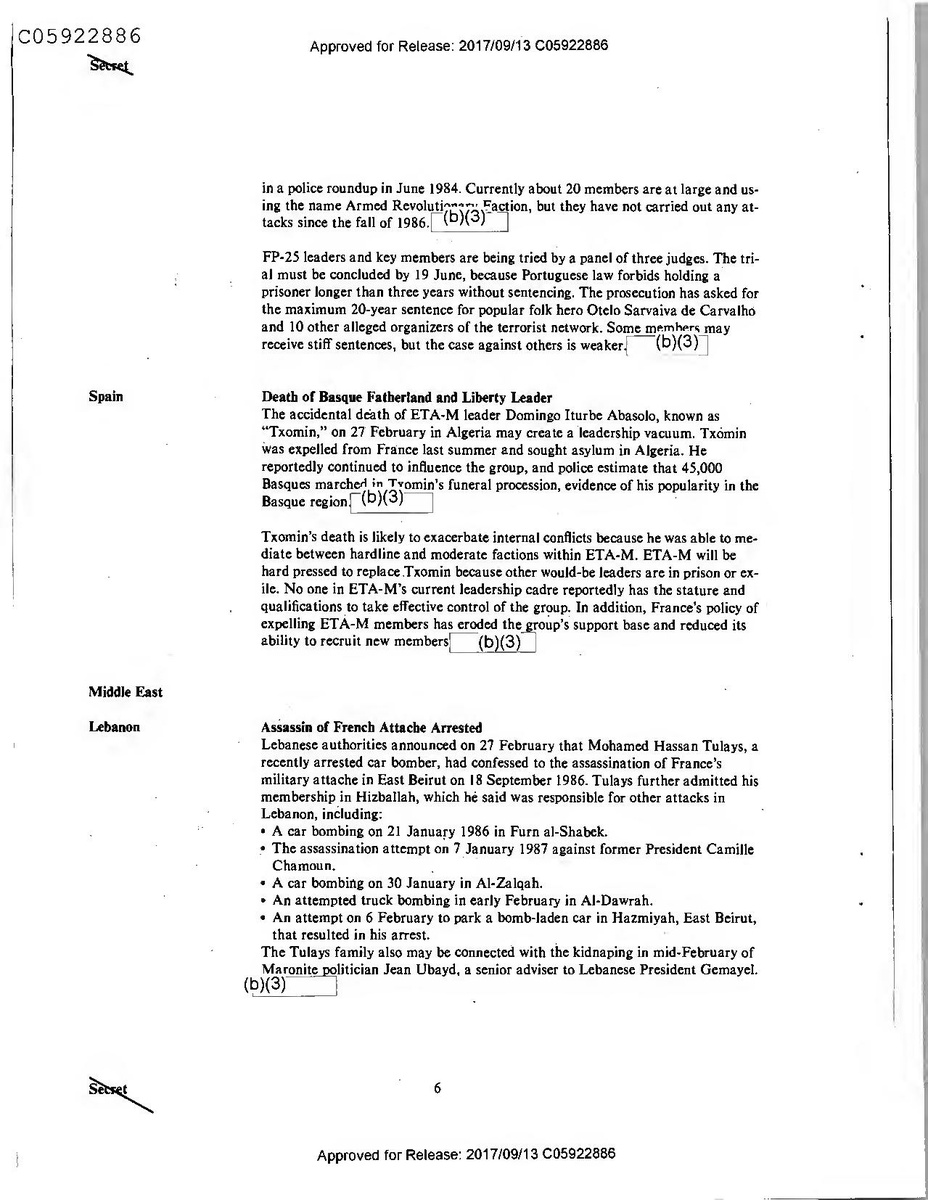
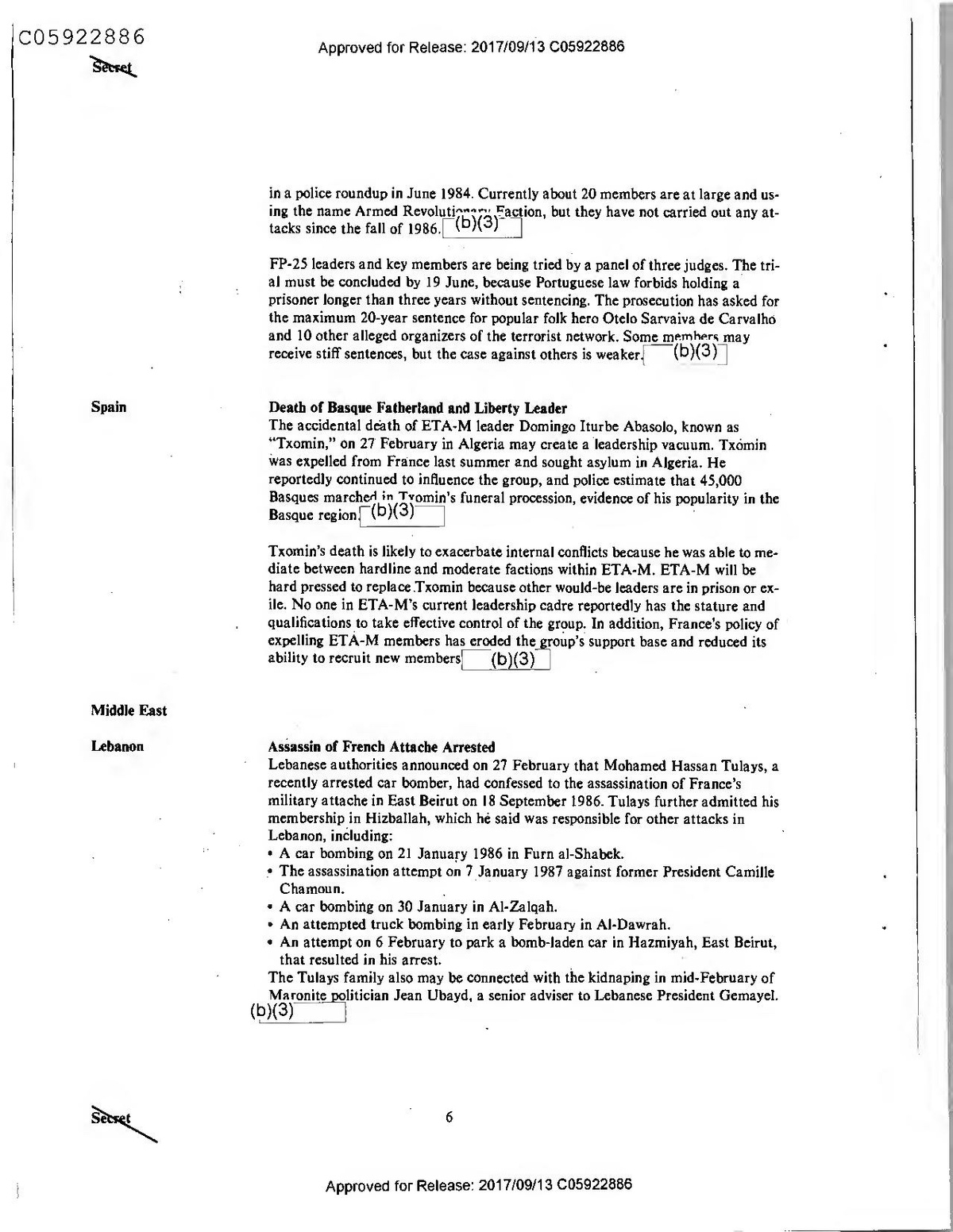
in a police roundup in June 1984. Currently about 20 members are at large and using the name Armed Revolutirnir Faction, but they have not carried out any attacks since the fall of 1986.11(b)(3)
FP-25 leaders and key members are being tried by a panel of three judges. The trial must be concluded by 19 June, because Portuguese law forbids holding a prisoner longer than three years without sentencing. The prosecution has asked for the maximum 20-year sentence for popular folk hero Otelo Sarvaiva de Carvalho and 10 other alleged organizers of the terrorist network. Some members may receive stiff sentences, but the case against others is weaker. (b)(3)
Spain
Death of Basque Fatberland and Liberty Leader The accidental death of ETA-M leader Domingo Iturbe Abasolo, known as “'Txomin,” on 27 February in Algeria may create a leadership vacuum. Txomin was expelled from France last summer and sought asylum in Algeria. He reportedly continued to influence the group, and police estimate that 45,000 Basques marcher in Tromin's funeral procession, evidence of his popularity in the Basque region, (b)(3)
Txomin's death is likely to exacerbate internal conflicts because he was able to mediate between hardline and moderate factions within ETA-M. ETA-M will be hard pressed to replace. Txomin because other would-be leaders are in prison or exile. No one in ETA-M's current leadership cadre reportedly has the stature and qualifications to take effective control of the group. In addition, France's policy of expelling ETA-M members has eroded the group's support base and reduced its ability to recruit new members (b)(3)
Middle East
Lebanon
Assassin of French Attache Arrested Lebanese authorities announced on 27 February that Mohamed Hassan Tulays, a recently arrested car bomber, had confessed to the assassination of France's military attache in East Beirut on 18 September 1986. Tulays further admitted his membership in Hizballah, which he said was responsible for other attacks in Lebanon, including: • A car bombing on 21 January 1986 in Furn al-Shabek. • The assassination attempt on 7 January 1987 against former President Camille
Chamoun. • A car bombing on 30 January in Al-Zalqah. • An attempted truck bombing in early February in Al-Dawrah. • An attempt on 6 February to park a bomb-laden car in Hazmiyah, East Beirut,
that resulted in his arrest. The Tulays family also may be connected with the kidnaping in mid-February of
Maronite politician Jean Ubayd, a senior adviser to Lebanese President Gemayel. (b)(3)
Secret
6
Approved for Release: 2017/09/13 C05922886
Latin America
Bolivia/Peru
(b)(1)
Terrorist Sites Discovered Bolivian security forces have discovered two possible terrorist training sites that the police suspect are being used by the Peruvian Sendero Luminoso (SL). The discovery of the camps follows the arrest last month of several SL affiliates in La Paz.
This is the first substantial report of SL training and operations inside Bolivia and suggests the group may intend to expand its operations beyond Peru. Sendero Luminoso may be taking advantage of Bolivia's lightly patrolled borders, largely inaccessible rural areas, and poorly equipped security forces in order to move supplies and train new members. Moreover, the camps—bordering one of the group's new operating areas in Peru-probably were chosen to facilitate cross-border activities.
(b)(3)
(b)(1) (b)(3)
South/East Asia
Laos
Bomb Explodes During Soviet Foreign Minister's Visit On 9 March a bomb exploded outside the Soviet cultural center in Vientiane during Soviet Foreign Minister Shevardnadze's first official visit to the Laotian capital. The blast, which apparently was set off by a timing device, shattered windows and killed one person—possibly the terrorist rigging the bomb—and injured another. The unusual bombing incident may have been intended to embarrass Laotian and Soviet officials rather than cause casualties. The perpetra(b)(3)are most likely local dissidents or Lao resistance forces staging from Thailand.
Pakistan
Massive Truck Bomb Targets Afghan
Refugees
(b)(1)
la massive truck bomb that killed 14 persons and injured more than 70 others when it detonated in Peshawar on 14 February. We believe the bomb was intended for the
7
Secret
Approved for Release: 2017/09/13 C05922886
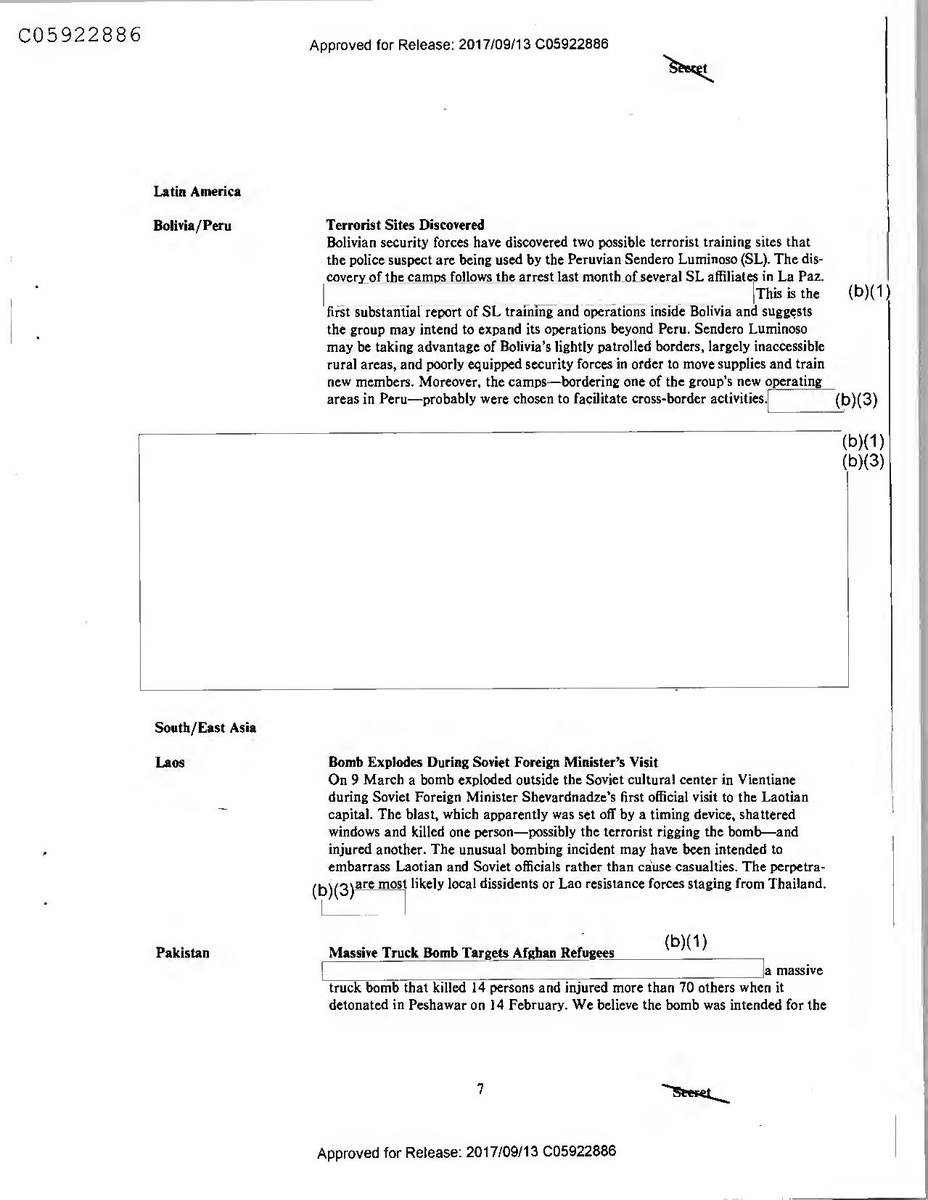
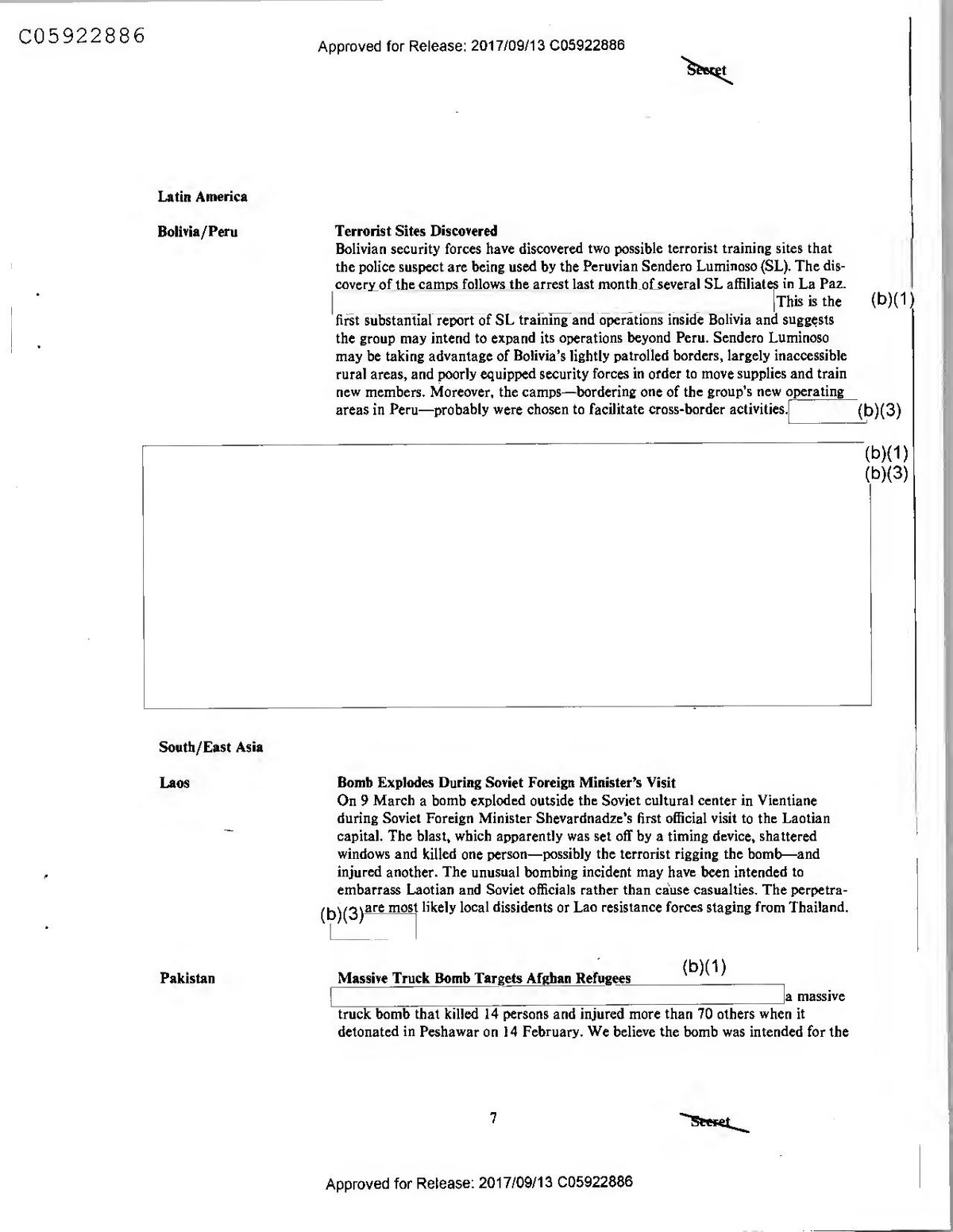
Latin America
Bolivia/Peru
(b)(1)
Terrorist Sites Discovered Bolivian security forces have discovered two possible terrorist training sites that the police suspect are being used by the Peruvian Sendero Luminoso (SL). The discovery of the camps follows the arrest last month of several SL affiliates in La Paz.
This is the first substantial report of SL training and operations inside Bolivia and suggests the group may intend to expand its operations beyond Peru. Sendero Luminoso may be taking advantage of Bolivia's lightly patrolled borders, largely inaccessible rural areas, and poorly equipped security forces in order to move supplies and train new members. Moreover, the camps—bordering one of the group's new operating areas in Peru-probably were chosen to facilitate cross-border activities.
(b)(3)
(b)(1) (b)(3)
South/East Asia
Laos
Bomb Explodes During Soviet Foreign Minister's Visit On 9 March a bomb exploded outside the Soviet cultural center in Vientiane during Soviet Foreign Minister Shevardnadze's first official visit to the Laotian capital. The blast, which apparently was set off by a timing device, shattered windows and killed one person—possibly the terrorist rigging the bomb—and injured another. The unusual bombing incident may have been intended to embarrass Laotian and Soviet officials rather than cause casualties. The perpetra(b)(3)are most likely local dissidents or Lao resistance forces staging from Thailand.
Pakistan
Massive Truck Bomb Targets Afghan
Refugees
(b)(1)
la massive truck bomb that killed 14 persons and injured more than 70 others when it detonated in Peshawar on 14 February. We believe the bomb was intended for the
7
Secret
Approved for Release: 2017/09/13 C05922886
offices of one of the main Afghan resistance groups, but it exploded near a primary school, causing death or injury to many children. The truck bomb was the most lethal explosion yet in the KHAD-inspired terror campaign in Peshawar. It touched off two days of violent rioting directed at the Afghan refugees in the area. There were renewed calls by local residents for Afghan refugees to be moved from major Pakistani cities and confined to camps. Soviet and Afghan agents have been stepping up their terrorist campaign to force Islamabad to withdraw support for the Afghan resistance.(b)(3)
Sri Lanka
Boobytrapped Water Truck Explodes Prematurely On 14 February a water truck accidentally detonated, while members of the Liberation Tigers of Tamil Elam (LTTE)the largest and most powerfUL Tamil insurgent group--were rigging it with 100 kilograms of gelignite. Some 60 persons died and many others were injured in the explosion, which occurred in a small village in northern Sri Lanka. The guerrillas apparently planned to drive the truck inside a nearby Army camp and then detonate the explosives. The terrorist who was welding a hole in the truck, however, apparently tapped a high-line transformer for power, causing a short that touched off the explosive. Many nearby houses were destroyed by the blast. Sixteen insurgents died, including at least four prominent leaders. The LTTE's chief training officer and explosives expert reportedly was the most senior casualty in the blast. Reacting to a series of massive protests, including a strike by the residents of Jaffna, LTTE leader Prabhakaran publicly apologized for the deaths, an unusual action (b)(3)
8
Secret
Approved for Release: 2017/09/13 C05922886
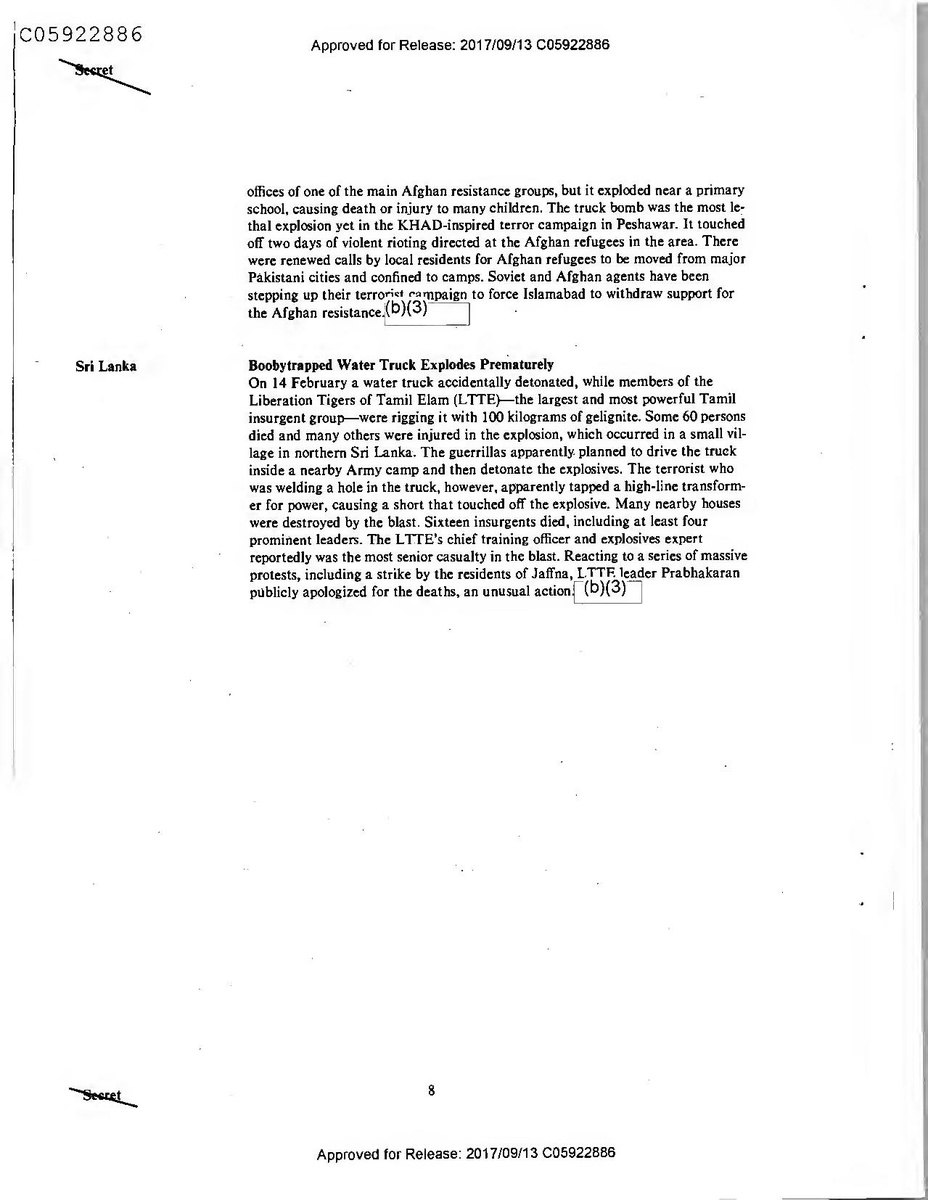
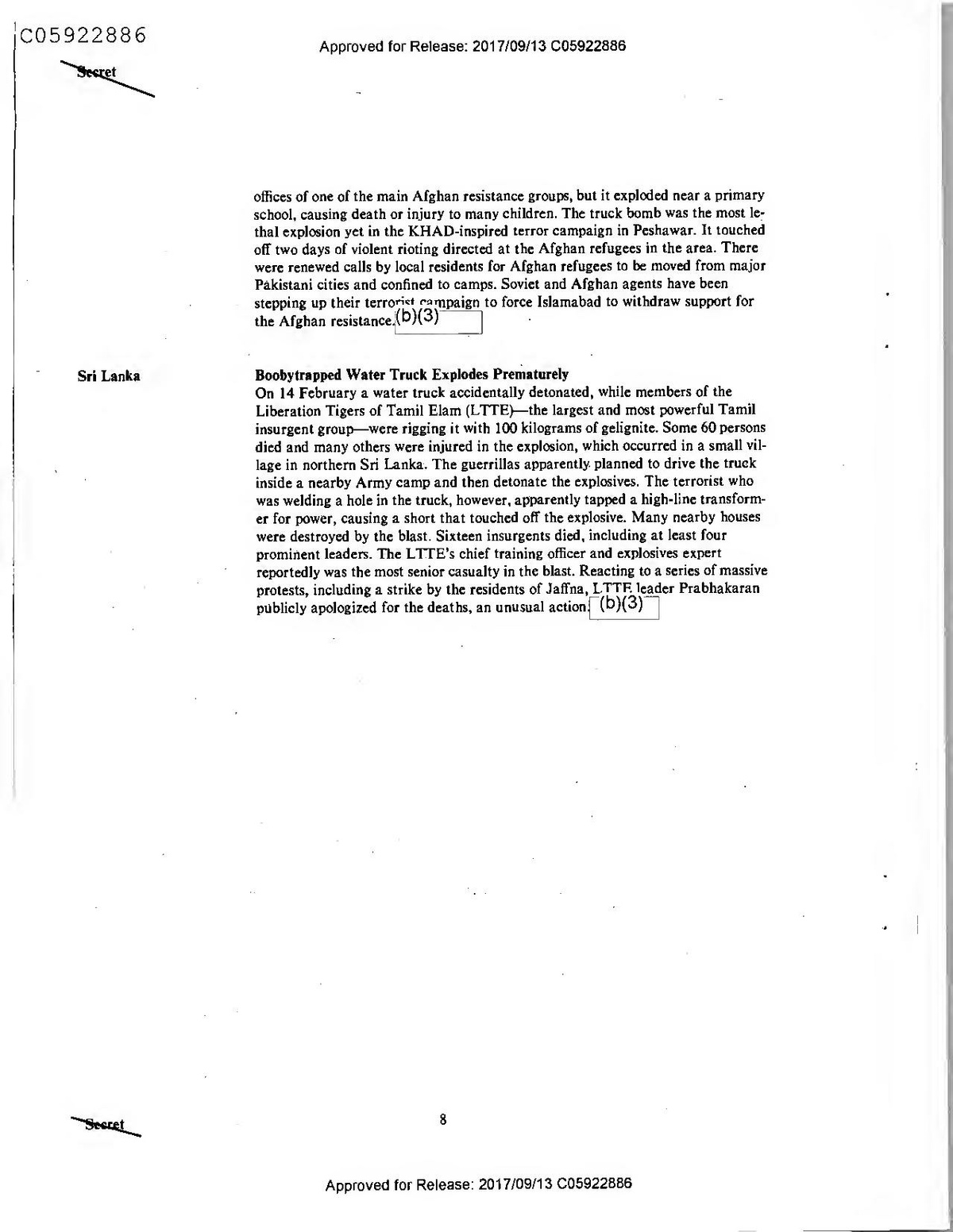
offices of one of the main Afghan resistance groups, but it exploded near a primary school, causing death or injury to many children. The truck bomb was the most lethal explosion yet in the KHAD-inspired terror campaign in Peshawar. It touched off two days of violent rioting directed at the Afghan refugees in the area. There were renewed calls by local residents for Afghan refugees to be moved from major Pakistani cities and confined to camps. Soviet and Afghan agents have been stepping up their terrorist campaign to force Islamabad to withdraw support for the Afghan resistance.(b)(3)
Sri Lanka
Boobytrapped Water Truck Explodes Prematurely On 14 February a water truck accidentally detonated, while members of the Liberation Tigers of Tamil Elam (LTTE)the largest and most powerfUL Tamil insurgent group--were rigging it with 100 kilograms of gelignite. Some 60 persons died and many others were injured in the explosion, which occurred in a small village in northern Sri Lanka. The guerrillas apparently planned to drive the truck inside a nearby Army camp and then detonate the explosives. The terrorist who was welding a hole in the truck, however, apparently tapped a high-line transformer for power, causing a short that touched off the explosive. Many nearby houses were destroyed by the blast. Sixteen insurgents died, including at least four prominent leaders. The LTTE's chief training officer and explosives expert reportedly was the most senior casualty in the blast. Reacting to a series of massive protests, including a strike by the residents of Jaffna, LTTE leader Prabhakaran publicly apologized for the deaths, an unusual action (b)(3)
8
Secret
Approved for Release: 2017/09/13 C05922886
An Overview of Middle Eastern (b)(3) Terrorism in 1986
Reactions by the state sponsors to these measures varied. In the immediate aftermath of the airstrikes, Qadhafi responded with a series of terrorist actions, but Libyan activity slackened somewhat in the last half of 1986:
The Middle East kept its place as the principal venue for international terrorist attacks in 1986 and, consistent with recent years, accounted for approximately. half of all incidents worldwide. State-supported terrorists—backed by Libya, Syria, and Iran-reached unprecedented levels of violence in several dramatic attacks that occurred mostly in Western Europe. In Lebanon, the kidnapings of hostages continued un-. abated last year-two Americans were released, but one was killed and three more kidnaped. Warring militias-particularly Palestinians and all stripes of Lebanese Christians and Muslims—waged vicious internecine battles, and year's end saw the involvement of many Middle Eastern terrorist groups in the war of the camps in Beirut. (b)(3)
• Circumstantial evidence points to Libyan involvement in the shooting of a US Embassy communicator in Khartoum one day after the strike on Tripoli.
(b)(1) (b)(3)
State-Sponsored Terrorism: A Year of Spectacular Violence In 1986, Libya and Syria were the major state sponsors to use terrorism as an instrument of foreign policy. Terrorists backed or directly guided by those countries carried out attacks that resulted in unprecedented international political and military repercussions:
• In Ankara authorities apprehended two Libyans on
18 April as they approached the US. Officers' Club to attack it with grenades received from the Libyan People's Bureau. The Libyans said they had been instructed to cause the maximum amount" of US casualties.
O
• The United States responded to evidence of Libyan
involvement in the bombing of the La Belle discotheque in West Berlin in April by launching retaliatory airstrikes against Tripoli and Banghazi.
Libya probably had a role in the shooting in Sanaa, North Yemen, of another US diplomat on 25 April.
ects under arrest include a Libyan.
T(b)(3)ects
• The United Kingdom broke off diplomatic relations The level of Libyan terrorist activity. dropped in the
with Damascus after Syria was implicated in the period from the last week in April through mid-July, attempted bombing of an El Al airliner at Heathrow but Tripoli resumed terrorist planning in midsummer. Airport after the conviction of Nizar Hindawi, the We believe the August attack on the British Air Force terrorist who gave his unwitting girlfriend a bag base at Akrotiri, Cyprus, was a Libyan-instigated packed with explosives to carry on board. Moreover, operation intended as further retaliation against BritLondon led the effort to urge the European Commu- ain for allowing American aircraft based in the nity to impose economic sanctions on Damascus. United Kingdom to be used in the airstrikes.
(b)(3)" • West Germany temporarily recalled its Ambassador
from Damascus after discovering Syrian complicity in the March bombing of the German-Arab Friendship Union in West Berli(b)(3)
9
Secret DI TR 0-006 26 March 1987
Approved for Release: 2017/09/13 C05922886
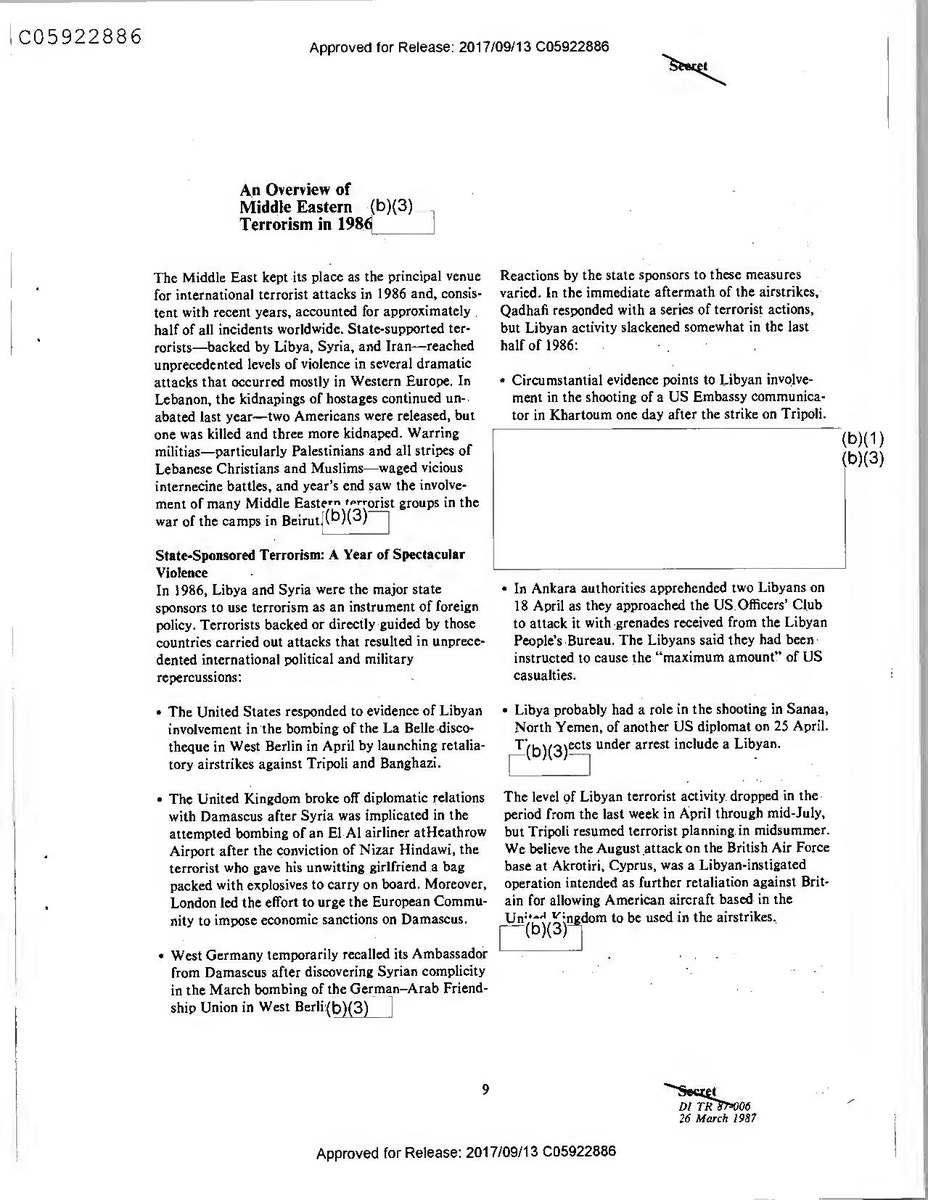
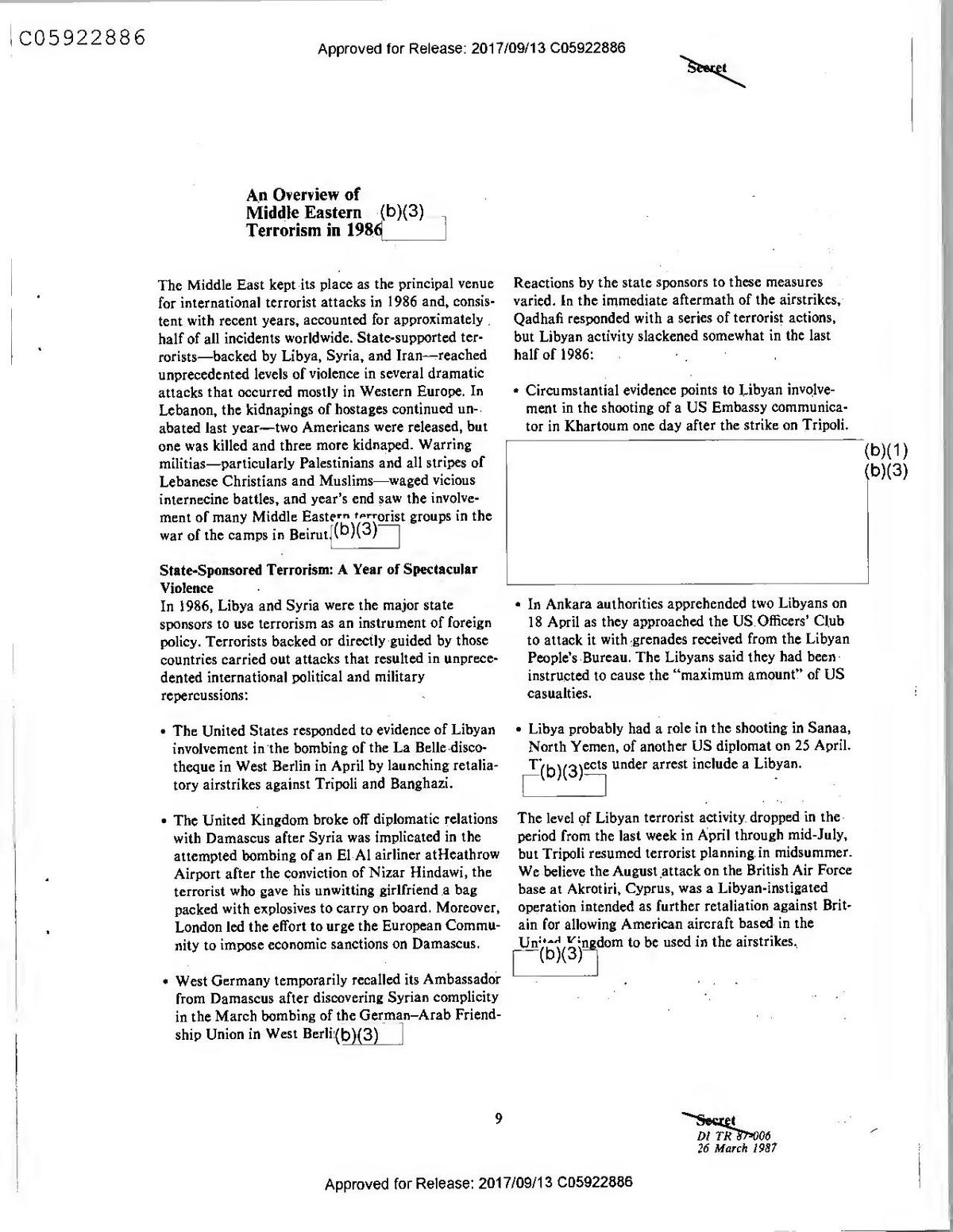
An Overview of Middle Eastern (b)(3) Terrorism in 1986
Reactions by the state sponsors to these measures varied. In the immediate aftermath of the airstrikes, Qadhafi responded with a series of terrorist actions, but Libyan activity slackened somewhat in the last half of 1986:
The Middle East kept its place as the principal venue for international terrorist attacks in 1986 and, consistent with recent years, accounted for approximately. half of all incidents worldwide. State-supported terrorists—backed by Libya, Syria, and Iran-reached unprecedented levels of violence in several dramatic attacks that occurred mostly in Western Europe. In Lebanon, the kidnapings of hostages continued un-. abated last year-two Americans were released, but one was killed and three more kidnaped. Warring militias-particularly Palestinians and all stripes of Lebanese Christians and Muslims—waged vicious internecine battles, and year's end saw the involvement of many Middle Eastern terrorist groups in the war of the camps in Beirut. (b)(3)
• Circumstantial evidence points to Libyan involvement in the shooting of a US Embassy communicator in Khartoum one day after the strike on Tripoli.
(b)(1) (b)(3)
State-Sponsored Terrorism: A Year of Spectacular Violence In 1986, Libya and Syria were the major state sponsors to use terrorism as an instrument of foreign policy. Terrorists backed or directly guided by those countries carried out attacks that resulted in unprecedented international political and military repercussions:
• In Ankara authorities apprehended two Libyans on
18 April as they approached the US. Officers' Club to attack it with grenades received from the Libyan People's Bureau. The Libyans said they had been instructed to cause the maximum amount" of US casualties.
O
• The United States responded to evidence of Libyan
involvement in the bombing of the La Belle discotheque in West Berlin in April by launching retaliatory airstrikes against Tripoli and Banghazi.
Libya probably had a role in the shooting in Sanaa, North Yemen, of another US diplomat on 25 April.
ects under arrest include a Libyan.
T(b)(3)ects
• The United Kingdom broke off diplomatic relations The level of Libyan terrorist activity. dropped in the
with Damascus after Syria was implicated in the period from the last week in April through mid-July, attempted bombing of an El Al airliner at Heathrow but Tripoli resumed terrorist planning in midsummer. Airport after the conviction of Nizar Hindawi, the We believe the August attack on the British Air Force terrorist who gave his unwitting girlfriend a bag base at Akrotiri, Cyprus, was a Libyan-instigated packed with explosives to carry on board. Moreover, operation intended as further retaliation against BritLondon led the effort to urge the European Commu- ain for allowing American aircraft based in the nity to impose economic sanctions on Damascus. United Kingdom to be used in the airstrikes.
(b)(3)" • West Germany temporarily recalled its Ambassador
from Damascus after discovering Syrian complicity in the March bombing of the German-Arab Friendship Union in West Berli(b)(3)
9
Secret DI TR 0-006 26 March 1987
Approved for Release: 2017/09/13 C05922886
the terrorist(b)(3) in order to dampen Western
the group.
The publicity surrounding the trials of terrorists attacks. The group returned with vengeance in Sepinvolved in Syrian-supported incidents in London and tember when it attempted to hijack a Pan Am flight West Berlin severely embarrassed Damascus. We in Karachi, in which 21 persons were killed. The suspect that the lack of terrorist activity on the part of operation clearly involved Libyan logistic support. Syrian-supported groups after September was, in part, The Abu Nidal Group probably also conducted the attributable to Syria's desire to keep a low profile in assault on the IstanbUL synagogue the next day, killing in
22 Jews. The group continued to receive support from both Syria and Libya in 1986, although Damascus
tried to improve its image in the West by appearing to Iranian leaders in 1986 remained committed to the crack down on some of Abu Nidal's publicly known use of international terrorism to achieve specific members in Syria. At year's end, there was no foreign policy objectives. Tehran, however, was in- evidence that inconus intended to break its ties to
-(b)(3345 volved in fewer incidents than in 1985—probably because Iranian leaders have become more selective in their use of terrorism as a foreign policy instrument. The Abu Musa group apparently joined the list of Iran continued to provide significant support to the Palestinian groups that have committed terrorist acts Lebanese Hizballah organization and to benefit from in Europe. In June a suitcase bomb intended for an El its activities, including the holding of Western hos- Al flight from Madrid exploded prematurely at a . Iran also benefited directly from its ability to check-in counter in the airport, injuring 13 persons. threaten to use terrorism, particularly in the Persian Police traced the suitcase to a Palestinian who Gulf states. Iranian-backed terrorists carried out at- claimed to be a member of the anti-Arafat Abu Musa (b)(1) tacks against oil facilities in Kuwait in Jui(b)(3)
group.
(b)(3)
We Palestinian Terrorism: Fewer Incidents
believe Abu Musa has carried out at least one other Palestinian terrorists conducted significantly fewer operation in Western Europe, but the groun hos attacks in 1986 than in the previous year, contributing generally operated in the Middle East.
F(b)(3) to a falloff in Middle Eastern terrorist spillover into Western Europe. The abatement of intra-Palestinian In Israel, Middle Eastern terrorists carried out several squabbles—perhaps only a temporary development- notable attacks in 1986. The PLO launched the appeared to be a primary cause of the reduction in bloodiest attack in Jerusalem since 1984 when terrorPalestinian terroris (b)(3)
ists hurled grenades at Israeli soldiers and their
families near the crowded Western Wall in October, Palestinian terrorists, nevertheless, staged several dra- killing one person and injuring 69 others. Israeli matic attacks. In April a bomb exploded aboard security officials subsequently arrested three suspects, TWA Flight 840 over Athens, killing four Americans. who claimed to be members of Islamic Jihad who
were recruited into Fatah. In July, members of the
PFLP and the Syrian-backed Lebanese Syrian Social (b)(1)
Nationalist Party (SSNP) attempted a commando (b)(3)
attack on an Israeli resort town. For terrorists and two Israeli soldiers were killed.
(b)(3)
Lebanon: The Kidnapings Continue In Lebanon the violence between warring militias continued throughout the year. In many cases, neither the perpetrator nor the target could be conclusively
The Abu Nidal Group was less active in 1986 than in the previous year—probably largely because of its apparent standdown at Syria's request on anti-Jordan
Secret
10
Approved for Release: 2017/09/13 C05922886
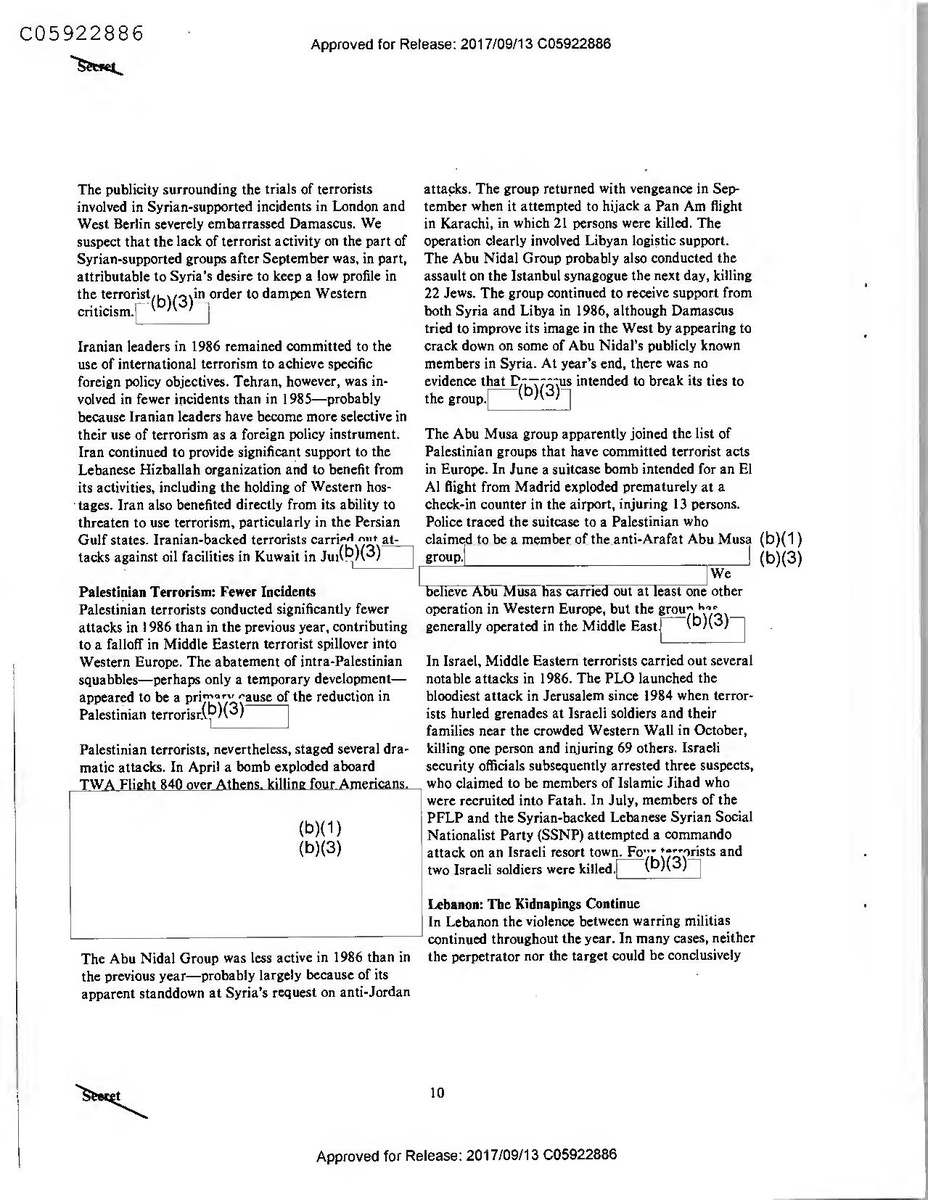
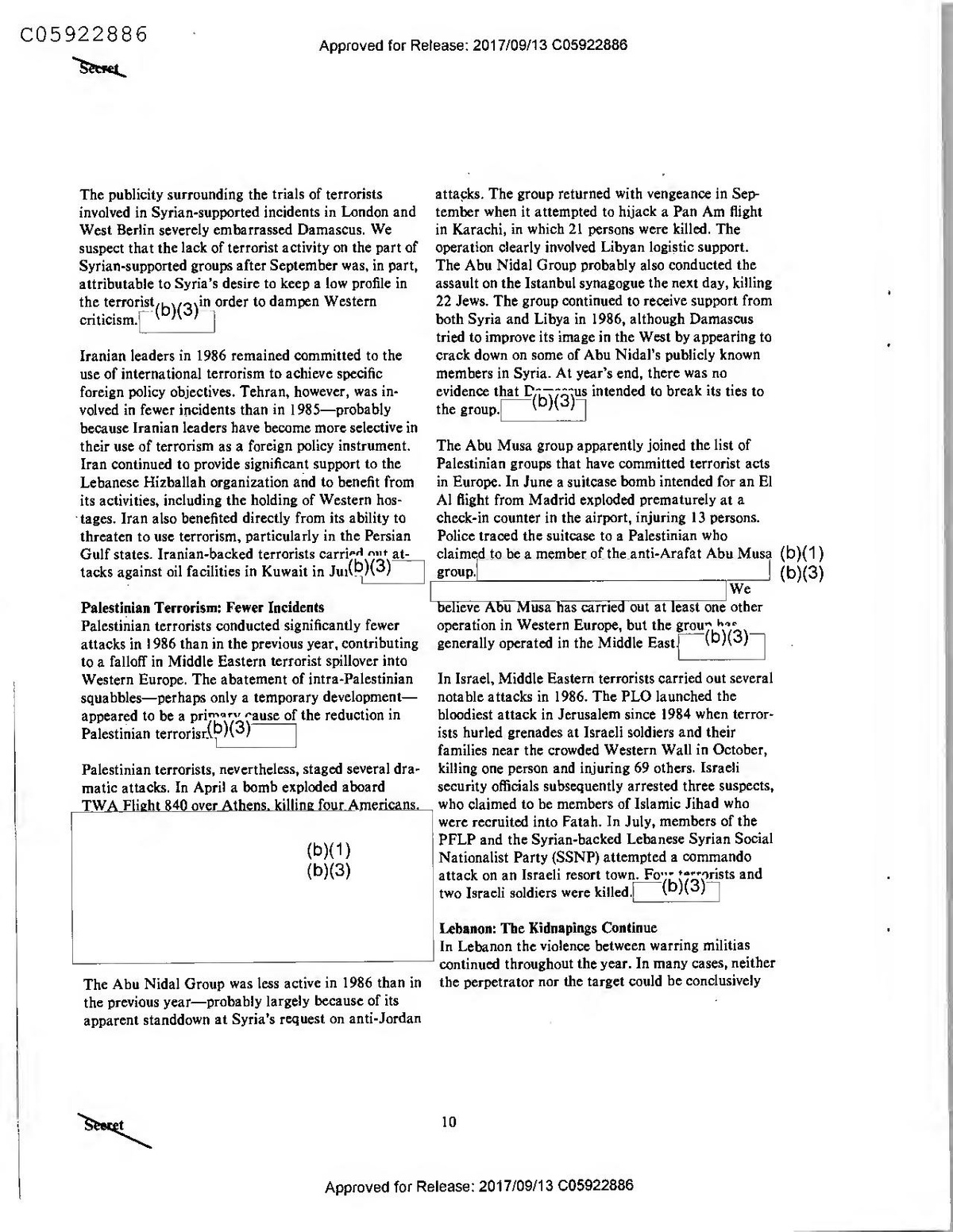
the terrorist(b)(3) in order to dampen Western
the group.
The publicity surrounding the trials of terrorists attacks. The group returned with vengeance in Sepinvolved in Syrian-supported incidents in London and tember when it attempted to hijack a Pan Am flight West Berlin severely embarrassed Damascus. We in Karachi, in which 21 persons were killed. The suspect that the lack of terrorist activity on the part of operation clearly involved Libyan logistic support. Syrian-supported groups after September was, in part, The Abu Nidal Group probably also conducted the attributable to Syria's desire to keep a low profile in assault on the IstanbUL synagogue the next day, killing in
22 Jews. The group continued to receive support from both Syria and Libya in 1986, although Damascus
tried to improve its image in the West by appearing to Iranian leaders in 1986 remained committed to the crack down on some of Abu Nidal's publicly known use of international terrorism to achieve specific members in Syria. At year's end, there was no foreign policy objectives. Tehran, however, was in- evidence that inconus intended to break its ties to
-(b)(3345 volved in fewer incidents than in 1985—probably because Iranian leaders have become more selective in their use of terrorism as a foreign policy instrument. The Abu Musa group apparently joined the list of Iran continued to provide significant support to the Palestinian groups that have committed terrorist acts Lebanese Hizballah organization and to benefit from in Europe. In June a suitcase bomb intended for an El its activities, including the holding of Western hos- Al flight from Madrid exploded prematurely at a . Iran also benefited directly from its ability to check-in counter in the airport, injuring 13 persons. threaten to use terrorism, particularly in the Persian Police traced the suitcase to a Palestinian who Gulf states. Iranian-backed terrorists carried out at- claimed to be a member of the anti-Arafat Abu Musa (b)(1) tacks against oil facilities in Kuwait in Jui(b)(3)
group.
(b)(3)
We Palestinian Terrorism: Fewer Incidents
believe Abu Musa has carried out at least one other Palestinian terrorists conducted significantly fewer operation in Western Europe, but the groun hos attacks in 1986 than in the previous year, contributing generally operated in the Middle East.
F(b)(3) to a falloff in Middle Eastern terrorist spillover into Western Europe. The abatement of intra-Palestinian In Israel, Middle Eastern terrorists carried out several squabbles—perhaps only a temporary development- notable attacks in 1986. The PLO launched the appeared to be a primary cause of the reduction in bloodiest attack in Jerusalem since 1984 when terrorPalestinian terroris (b)(3)
ists hurled grenades at Israeli soldiers and their
families near the crowded Western Wall in October, Palestinian terrorists, nevertheless, staged several dra- killing one person and injuring 69 others. Israeli matic attacks. In April a bomb exploded aboard security officials subsequently arrested three suspects, TWA Flight 840 over Athens, killing four Americans. who claimed to be members of Islamic Jihad who
were recruited into Fatah. In July, members of the
PFLP and the Syrian-backed Lebanese Syrian Social (b)(1)
Nationalist Party (SSNP) attempted a commando (b)(3)
attack on an Israeli resort town. For terrorists and two Israeli soldiers were killed.
(b)(3)
Lebanon: The Kidnapings Continue In Lebanon the violence between warring militias continued throughout the year. In many cases, neither the perpetrator nor the target could be conclusively
The Abu Nidal Group was less active in 1986 than in the previous year—probably largely because of its apparent standdown at Syria's request on anti-Jordan
Secret
10
Approved for Release: 2017/09/13 C05922886
established. We do not know, for example, the terror- unknown. We believe the growing use of freelance ists responsible for a series of bombings in July and terrorists accounts for part of this problem. The August in East and West Beirut in which 76 persons chaotic conditions in Lebanon initially provided the were killed, nor their exact intended targets. In the setting for this development, which also provides state fall, the French contingent of the UN peacekeeping sponsors the deniability they seek for their terrorist force in south Lebanon suffered several attacks, and a operations. Lebanon will continue to play a key role in French diplomat was assassinated as he entered the facilitating contacts among terrorists, and the trend French Embassy in East Beirut. Information received toward anony(b)(3) terrorist incidents is likely to in early 1987 suggests that Hizballah was responsible. continue for the assassination of the French diplomat (b)(3)
In our judgment, prospects for the early release of the Westerners were not the primary victims of the hostages are not good. We are virtually certain that constant violence in Lebanon, but they remained an the captors represent Shia extremist elements and important target, especially for kidnapers. Elements that decisions about their fate will be made by of Hizballah-using a variety of covernames-proba- Hizballah's leaders, in consultation with Iran. Syrian bly were responsible for most of the kidnapings, or Lebanese pressure in release them is unlikely to although in some cases freelance terrorists may have sway Hizballah
(b)(3) taken hostages in order to them to the highest bidder. Four members of a French television crew State sponsors will continue to use terrorism to furwere kidnaped in March; three eventually were re- ther their own objectives, but they will make serious leased in June and November. Two Americans,
efforts to avoid detection. Father Lawrence Jenco and David Jacobsen, were released in July and November, respectively, but three more-Frank Reed, Joseph Cicippio, and Edward Tracy—were kidnaped in the fall. At the end of the year, we judge that they were still in the
Both Syria and Libya are likely to view the custody of Hizballah, along with Americans kidnaped frequent and continued use of surrogates—particularas long ago as March 1985. One other American, ly radical Palestinians—as a way to prevent their Peter Kilburn-along with two British citizens—was fingerprints fror(b)(3) discovered at the scenes of executed following the US airstrikes on Tripoli and their crimes Benghazi. We believe Libya was involved in the
(b)(3) executions(b)(3)
(b)(1) (b)(3)
Outlook Middle Eastern groups proved increasingly willing in 1986 to carry out indiscriminate attacks designed to cause maximum casualties and gain worldwide publicity. This trend is likely to continue into 1987. Any lull in terrorism because of the préoccupation of many Middle Eastern groups and their state sponsors with the fimis in Beirut probably will be only temporary.
(b)(3)
In 1986 it became increasingly difficult to assign responsibility for specific terrorist acts to a particular group, especially in the Middle East. The group affiliation of over-half the terrorist incidents that we attribute to Middle Easterners last year remains
Reverse Blank
11
Desret
Approved for Release: 2017/09/13 C05922886
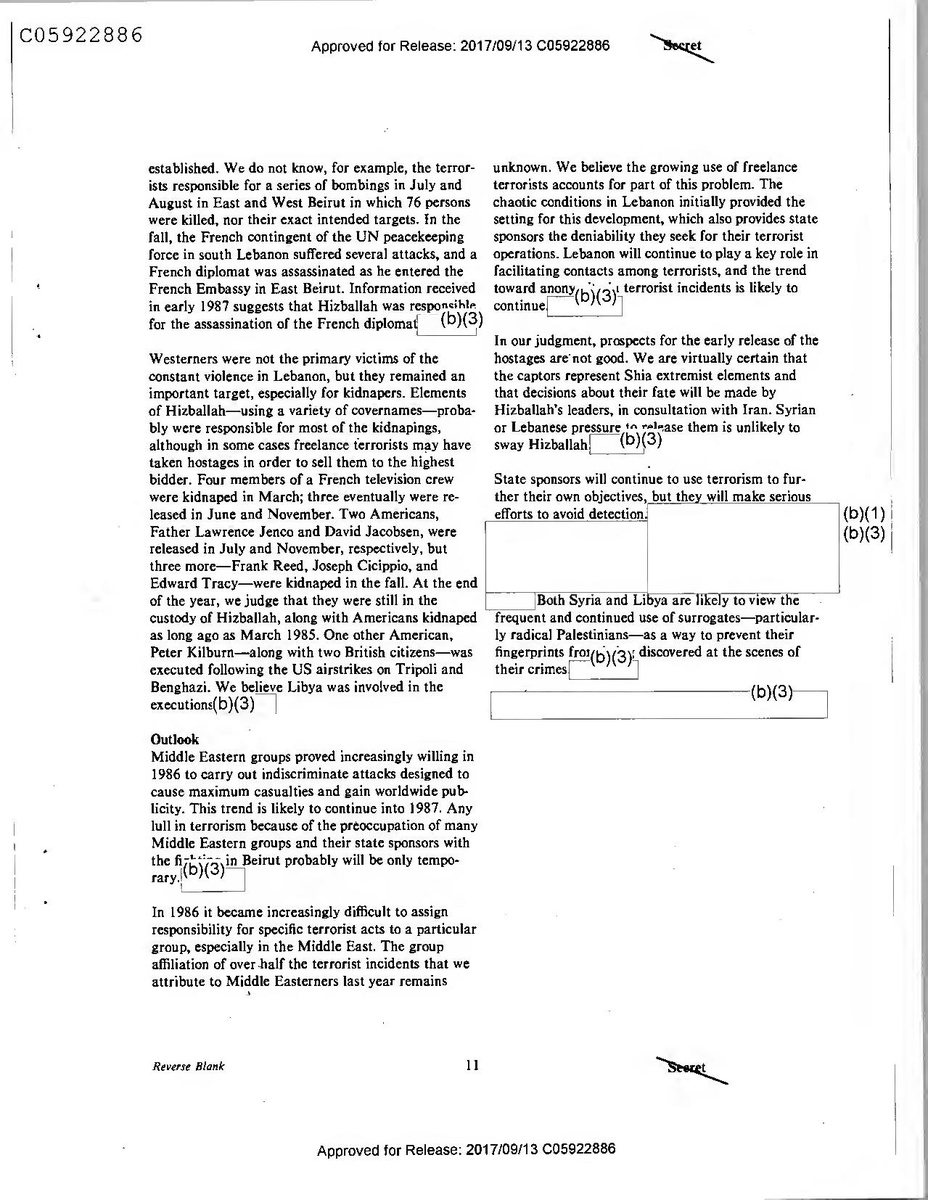
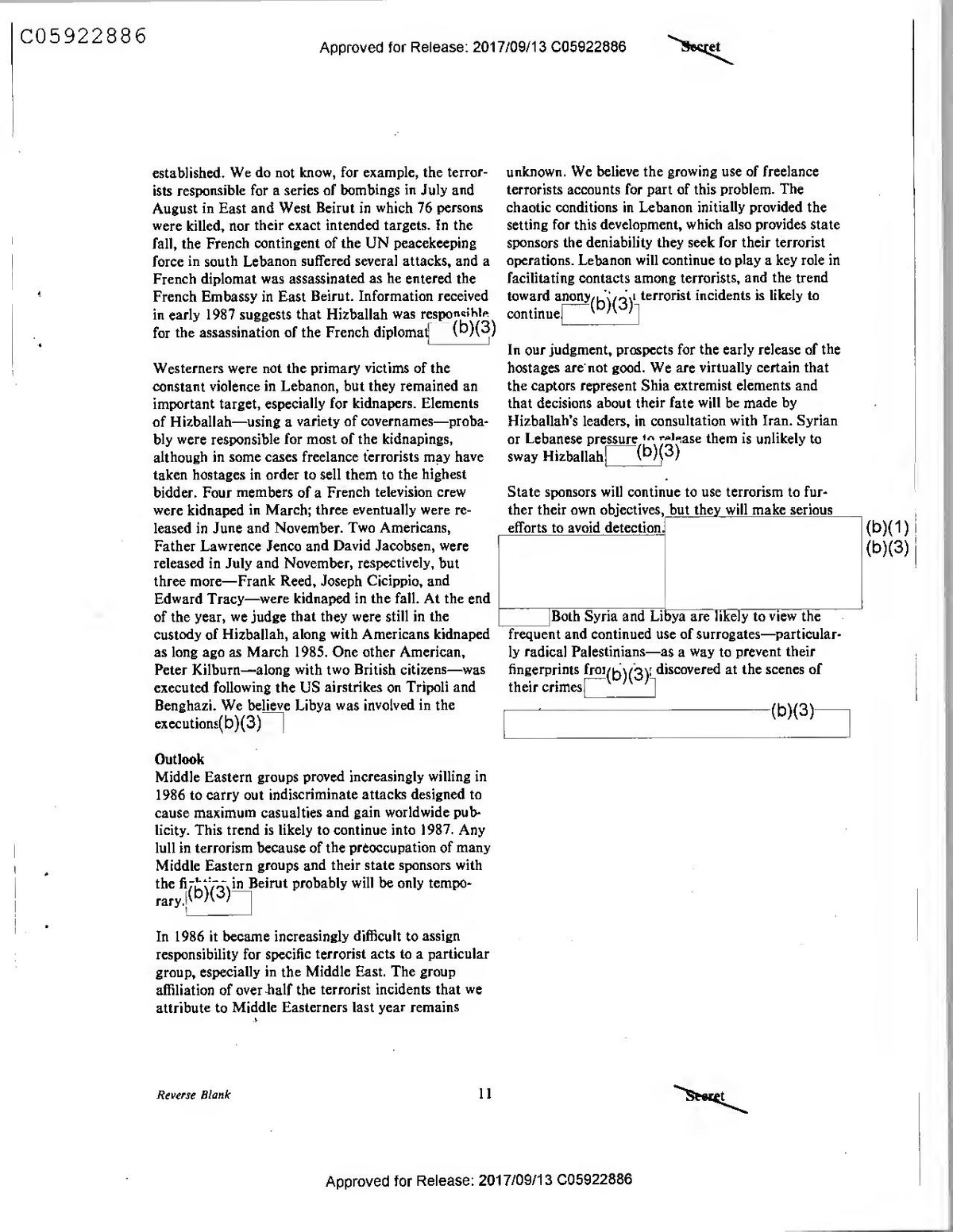
established. We do not know, for example, the terror- unknown. We believe the growing use of freelance ists responsible for a series of bombings in July and terrorists accounts for part of this problem. The August in East and West Beirut in which 76 persons chaotic conditions in Lebanon initially provided the were killed, nor their exact intended targets. In the setting for this development, which also provides state fall, the French contingent of the UN peacekeeping sponsors the deniability they seek for their terrorist force in south Lebanon suffered several attacks, and a operations. Lebanon will continue to play a key role in French diplomat was assassinated as he entered the facilitating contacts among terrorists, and the trend French Embassy in East Beirut. Information received toward anony(b)(3) terrorist incidents is likely to in early 1987 suggests that Hizballah was responsible. continue for the assassination of the French diplomat (b)(3)
In our judgment, prospects for the early release of the Westerners were not the primary victims of the hostages are not good. We are virtually certain that constant violence in Lebanon, but they remained an the captors represent Shia extremist elements and important target, especially for kidnapers. Elements that decisions about their fate will be made by of Hizballah-using a variety of covernames-proba- Hizballah's leaders, in consultation with Iran. Syrian bly were responsible for most of the kidnapings, or Lebanese pressure in release them is unlikely to although in some cases freelance terrorists may have sway Hizballah
(b)(3) taken hostages in order to them to the highest bidder. Four members of a French television crew State sponsors will continue to use terrorism to furwere kidnaped in March; three eventually were re- ther their own objectives, but they will make serious leased in June and November. Two Americans,
efforts to avoid detection. Father Lawrence Jenco and David Jacobsen, were released in July and November, respectively, but three more-Frank Reed, Joseph Cicippio, and Edward Tracy—were kidnaped in the fall. At the end of the year, we judge that they were still in the
Both Syria and Libya are likely to view the custody of Hizballah, along with Americans kidnaped frequent and continued use of surrogates—particularas long ago as March 1985. One other American, ly radical Palestinians—as a way to prevent their Peter Kilburn-along with two British citizens—was fingerprints fror(b)(3) discovered at the scenes of executed following the US airstrikes on Tripoli and their crimes Benghazi. We believe Libya was involved in the
(b)(3) executions(b)(3)
(b)(1) (b)(3)
Outlook Middle Eastern groups proved increasingly willing in 1986 to carry out indiscriminate attacks designed to cause maximum casualties and gain worldwide publicity. This trend is likely to continue into 1987. Any lull in terrorism because of the préoccupation of many Middle Eastern groups and their state sponsors with the fimis in Beirut probably will be only temporary.
(b)(3)
In 1986 it became increasingly difficult to assign responsibility for specific terrorist acts to a particular group, especially in the Middle East. The group affiliation of over-half the terrorist incidents that we attribute to Middle Easterners last year remains
Reverse Blank
11
Desret
Approved for Release: 2017/09/13 C05922886
|(b)(1) (b)(3)
13
Secret DI TR 87-006 26 March 1987
Approved for Release: 2017/09/13 C05922886
|(b)(1) (b)(3)
13
Secret DI TR 87-006 26 March 1987
Approved for Release: 2017/09/13 C05922886
(b)(1) (b)(3)
14
Approved for Release: 2017/09/13 C05922886
(b)(1) (b)(3)
14
Approved for Release: 2017/09/13 C05922886
(b)(1) (b)(3)
15
Secret
Approved for Release: 2017/09/13 C05922886
(b)(1) (b)(3)
15
Secret
Approved for Release: 2017/09/13 C05922886
Seeret
other Palestinians who may be thinking of cooperating with the Israelis. Israeli authorities said the weapon used was the one involved in at least two other terrorist attacks in the West Bank.
(b)(3)
Israel
US Officials Receive Threatening Leaflets US officials, including a member of the US MBFR delegation in Vienna and an assistant to the US Ambassador to Jordan, received leaflets signed by the Jewish terrorist group Terror Against Terror (TNT) attacking the Peres government and pro-Arab US officials. The leaflet warns Arab-Americans that they are in a "zone of danger” that is not limited to the territory of the United States. (b)(3)
TNT is believed responsible for about a dozen attacks against Arab and Christian holy places in the West Bank since 1980. The group conducted a similar letter campaign in 1984 aimed at political, media, and union officials in the United States and Europe. There were no attacks following those threats.[ (b)(3)
Egypt
Israeli Citizen Killed in Cairo The wife of an Israeli Embassy employee was killed and three other Israelis were wounded when terrorists ambushed their car leaving the Cairo Trade Fair on 19 March. One car reportedly blocked the victims' vehicle while gunmen opened fire from another. The attack was claimed by a group calling itself Egypt's Revolution, a self-described nationalist movement violently opposed to the Egyptian-Israeli peace treaty. The group has taken credit for at least two attacks on Israeli diplomats in Cairo in the last two years. The hijackers of Egyptair Flight 648 last November used the name “Egyptian Revolution," but we cannot confirm the extent of the group's involvement in that incident. (b)(3)]
Saudi Arabia
Increased Security in Eastern Province Riyadh appears concerned about the security of its heavily Shia-populated [(b)(1) Province.
(b)(3)7
Heavily armed police guards at government buildings, visible street patrols, and riotcontrol equipment sharply increased tensions between the Shias and the
(b)(1) government, however, before they were lifted on 15 March,
(b)(3) The large pro-Iranian minority among the Shias had reacted enthusiastically to recent Iranian battlefield successes, and radical pro-Iranian sentiment has grown significantly over the last few months. Radical religious lea
larger crowds, and conservatives—although still a majorityare losing support.[
(b)(3)
are
13
Secret
Approved for Release: 2017/09/13 C05632837
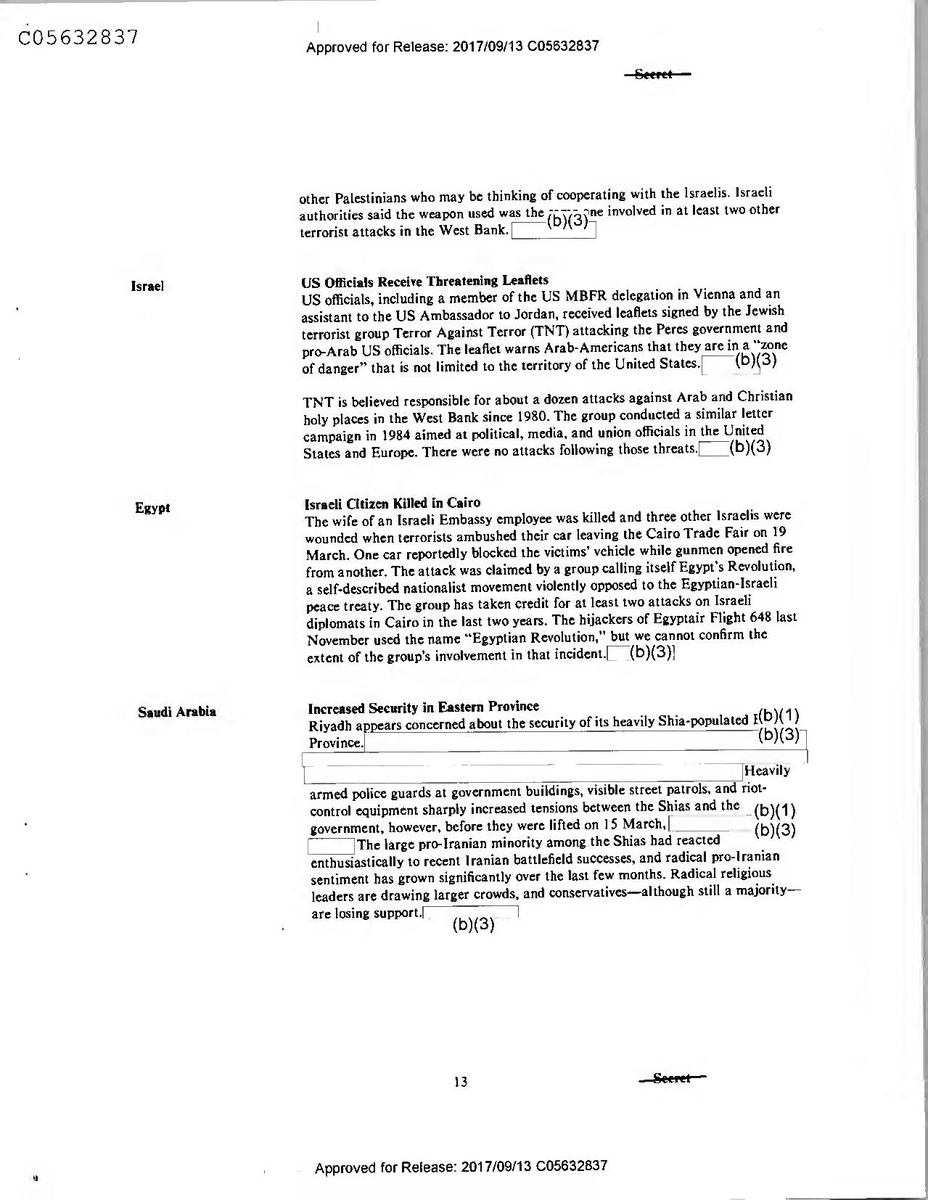
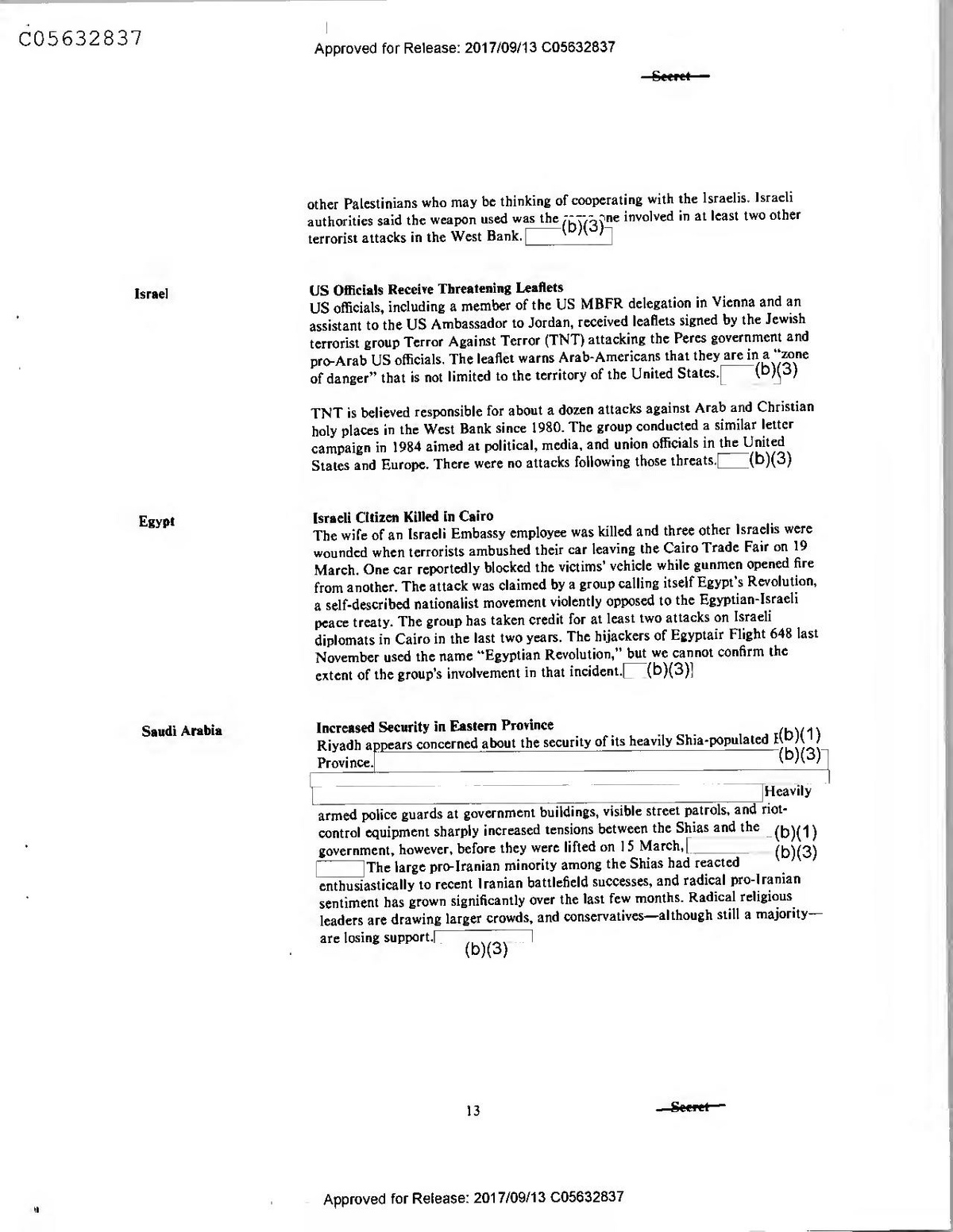
Seeret
other Palestinians who may be thinking of cooperating with the Israelis. Israeli authorities said the weapon used was the one involved in at least two other terrorist attacks in the West Bank.
(b)(3)
Israel
US Officials Receive Threatening Leaflets US officials, including a member of the US MBFR delegation in Vienna and an assistant to the US Ambassador to Jordan, received leaflets signed by the Jewish terrorist group Terror Against Terror (TNT) attacking the Peres government and pro-Arab US officials. The leaflet warns Arab-Americans that they are in a "zone of danger” that is not limited to the territory of the United States. (b)(3)
TNT is believed responsible for about a dozen attacks against Arab and Christian holy places in the West Bank since 1980. The group conducted a similar letter campaign in 1984 aimed at political, media, and union officials in the United States and Europe. There were no attacks following those threats.[ (b)(3)
Egypt
Israeli Citizen Killed in Cairo The wife of an Israeli Embassy employee was killed and three other Israelis were wounded when terrorists ambushed their car leaving the Cairo Trade Fair on 19 March. One car reportedly blocked the victims' vehicle while gunmen opened fire from another. The attack was claimed by a group calling itself Egypt's Revolution, a self-described nationalist movement violently opposed to the Egyptian-Israeli peace treaty. The group has taken credit for at least two attacks on Israeli diplomats in Cairo in the last two years. The hijackers of Egyptair Flight 648 last November used the name “Egyptian Revolution," but we cannot confirm the extent of the group's involvement in that incident. (b)(3)]
Saudi Arabia
Increased Security in Eastern Province Riyadh appears concerned about the security of its heavily Shia-populated [(b)(1) Province.
(b)(3)7
Heavily armed police guards at government buildings, visible street patrols, and riotcontrol equipment sharply increased tensions between the Shias and the
(b)(1) government, however, before they were lifted on 15 March,
(b)(3) The large pro-Iranian minority among the Shias had reacted enthusiastically to recent Iranian battlefield successes, and radical pro-Iranian sentiment has grown significantly over the last few months. Radical religious lea
larger crowds, and conservatives—although still a majorityare losing support.[
(b)(3)
are
13
Secret
Approved for Release: 2017/09/13 C05632837
(b)(1) (b)(3)
Secret
16
Approved for Release: 2017/09/13 C05922886
(b)(1) (b)(3)
Secret
16
Approved for Release: 2017/09/13 C05922886
Tracing Terrorist Explosives(b)(3),
Explosives stolen from a quarry in Ecaussines, Belgium, in 1984 appear to have been dispersed widely throughout Europe, and we expect there will be more terrorist incidents using these explosives.
After a number of bombings in 1984 and 1985 conducted by four West European terrorist groups using the explosives, French and West German authorities in 1986 began to find more of the explosives that had been cached for future use.
At least 550 of the 815 kilograms stolen remain unaccounted for and probably are in terrorists' hands. (b)(3)
The explosives have been used in attacks by the French group Action Directe (AD), West Germany's Red Army Faction (RAF), the Belgian Communist Combatant Cells (CCC), as well as another Belgian group, the Revolutionary Front for Proletarian Action (FRAP).
This common use represented the strongest evidence of cooperation among these groups in a Euroterrorist campaign that reached its peak in late 1984 and early 1985. There were no attacks using the explosives in 1986, to the best of our knowledge.
The most recent discoveries have been linked to AD and the RAF.
French police found some of the dynamite during a raid on a farmhouse near Orleans, France, in which four key leaders of AD were arrested on 21 February.
The discovery in Orleans marked the first time any of the explosives have been tied directly to one of the groups since January 1986. That month, Belgian police uncovered a large quantity of the explosives during raids on CCC safehouses police in Duesseldorf, West Germany, arrested two French Corsicans on 4 March 1987 in possession of 1,5 kilograms of explosives that may have come from the quarry in Ecaussines.
Local authorities believe the Corsicans intended to sell the explosives to the RAF, but the dynamite has not yet been conclusively tied to the quarry theft
French police also found a small quantity of the dynamite in September 1986 in a cache associated with a Marxist Iranian group that possibly has ties to the CCC.
We do not know how the “Iranian People's Fedayeen Guerrilla Organization" obtained the 6 kilograms of explosives, but Belgian police found fingerprints of two of the group's members in the apartment of a key CCC leader who was arrested in June 1986. This was the first indication the explosives stolen in Ecuassine gone to a non-European terrorist group. (b)(3)
Who Was Responsible?
Police have never made any arrests for the theft, but there is plentiful circumstantial evidence that members of one or more of the terrorist groups that used the explosives were involved in the theft.
Witnesses reported seeing RAF hardcore member Sigrid Sternebeck near the quarry at the time of the attempted break-in on 1 May.
Furthermore, a CCC communique correctly identified the commercial names of the dynamite and the amount stolen.
They went on to claim “internationalist revolutionaries" stole the explosives, b(b)(3); group did not directly take responsibility.(1) (3)
The timing of the groups' attacks following the theft and the links among members of the groups also suggest the break-in was carried out by one or more of the groups.
The RAF, AD, CCC, and FRAP launched a coordinated campaign against NATO that ran from August 1984 through. December 1985 and used the explosives stolen from the Belgian quarry in as many as 18 of their attacks.
Before the campaign, in July 1984, West German authorities had discovered documents indicating that the RAF intended to embark on a three-pronged effort, suggesting planning was well along before the Ecaussines theft.
Although we do not know when the groups began planning their activities, the complexity, pace, and duration of their operations suggest they needed a significant amount of time to prepare, including locating and acquiring the explosives for the bombings. (b)(3)
17
Secret DI TR 87-006 26 March 1987
Approved for Release: 2017/09/13 C05922886
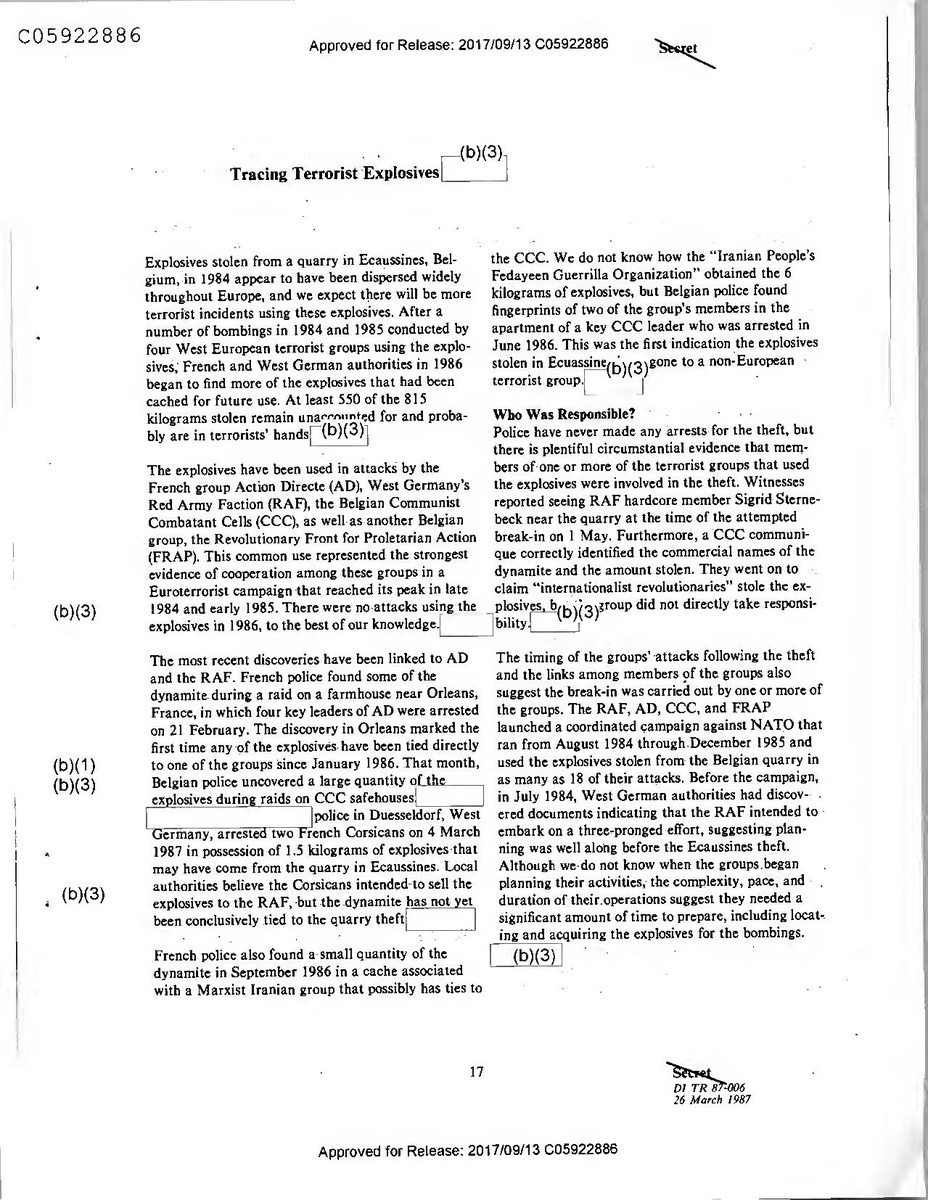
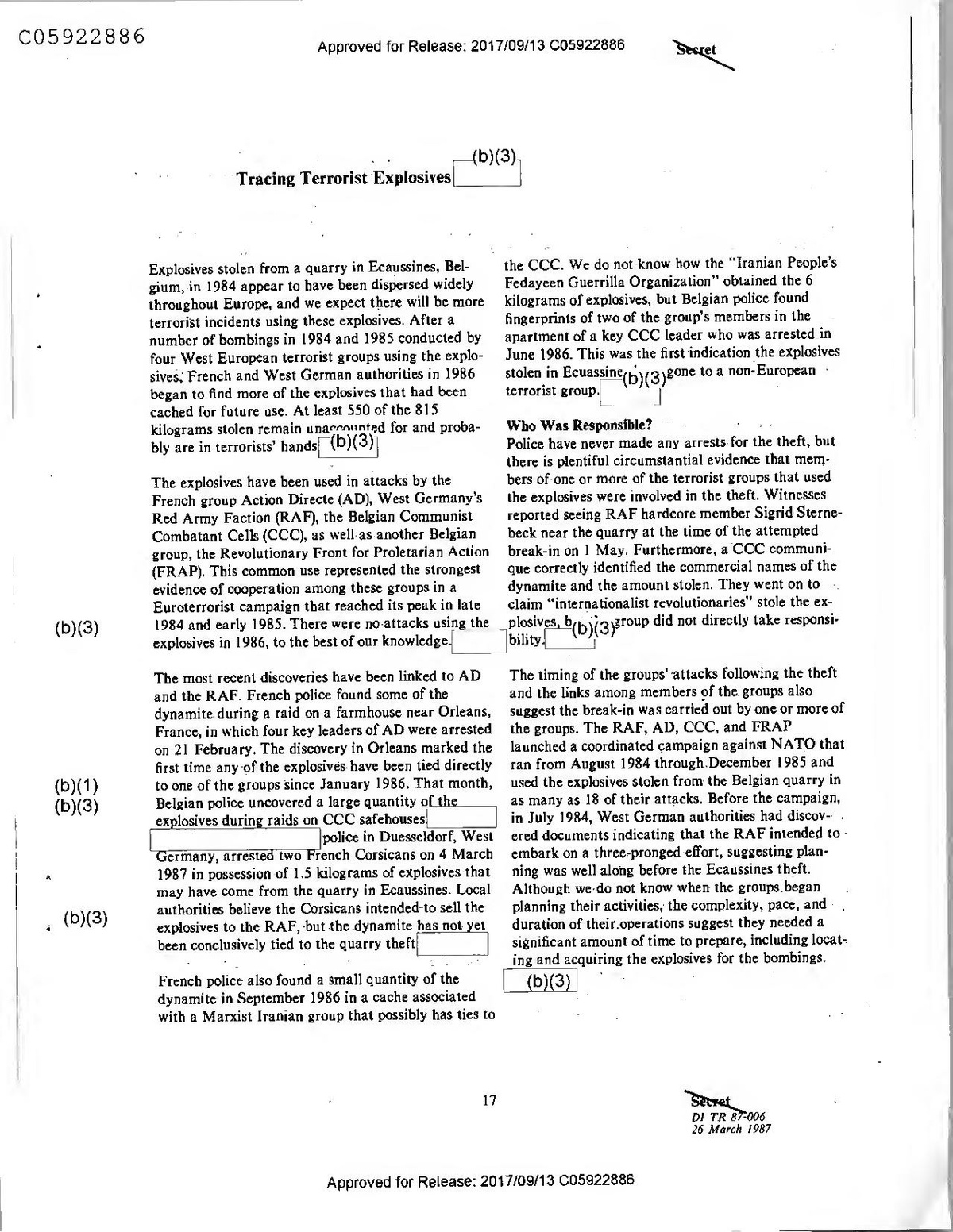
Tracing Terrorist Explosives(b)(3),
Explosives stolen from a quarry in Ecaussines, Belgium, in 1984 appear to have been dispersed widely throughout Europe, and we expect there will be more terrorist incidents using these explosives.
After a number of bombings in 1984 and 1985 conducted by four West European terrorist groups using the explosives, French and West German authorities in 1986 began to find more of the explosives that had been cached for future use.
At least 550 of the 815 kilograms stolen remain unaccounted for and probably are in terrorists' hands. (b)(3)
The explosives have been used in attacks by the French group Action Directe (AD), West Germany's Red Army Faction (RAF), the Belgian Communist Combatant Cells (CCC), as well as another Belgian group, the Revolutionary Front for Proletarian Action (FRAP).
This common use represented the strongest evidence of cooperation among these groups in a Euroterrorist campaign that reached its peak in late 1984 and early 1985. There were no attacks using the explosives in 1986, to the best of our knowledge.
The most recent discoveries have been linked to AD and the RAF.
French police found some of the dynamite during a raid on a farmhouse near Orleans, France, in which four key leaders of AD were arrested on 21 February.
The discovery in Orleans marked the first time any of the explosives have been tied directly to one of the groups since January 1986. That month, Belgian police uncovered a large quantity of the explosives during raids on CCC safehouses police in Duesseldorf, West Germany, arrested two French Corsicans on 4 March 1987 in possession of 1,5 kilograms of explosives that may have come from the quarry in Ecaussines.
Local authorities believe the Corsicans intended to sell the explosives to the RAF, but the dynamite has not yet been conclusively tied to the quarry theft
French police also found a small quantity of the dynamite in September 1986 in a cache associated with a Marxist Iranian group that possibly has ties to the CCC.
We do not know how the “Iranian People's Fedayeen Guerrilla Organization" obtained the 6 kilograms of explosives, but Belgian police found fingerprints of two of the group's members in the apartment of a key CCC leader who was arrested in June 1986. This was the first indication the explosives stolen in Ecuassine gone to a non-European terrorist group. (b)(3)
Who Was Responsible?
Police have never made any arrests for the theft, but there is plentiful circumstantial evidence that members of one or more of the terrorist groups that used the explosives were involved in the theft.
Witnesses reported seeing RAF hardcore member Sigrid Sternebeck near the quarry at the time of the attempted break-in on 1 May.
Furthermore, a CCC communique correctly identified the commercial names of the dynamite and the amount stolen.
They went on to claim “internationalist revolutionaries" stole the explosives, b(b)(3); group did not directly take responsibility.(1) (3)
The timing of the groups' attacks following the theft and the links among members of the groups also suggest the break-in was carried out by one or more of the groups.
The RAF, AD, CCC, and FRAP launched a coordinated campaign against NATO that ran from August 1984 through. December 1985 and used the explosives stolen from the Belgian quarry in as many as 18 of their attacks.
Before the campaign, in July 1984, West German authorities had discovered documents indicating that the RAF intended to embark on a three-pronged effort, suggesting planning was well along before the Ecaussines theft.
Although we do not know when the groups began planning their activities, the complexity, pace, and duration of their operations suggest they needed a significant amount of time to prepare, including locating and acquiring the explosives for the bombings. (b)(3)
17
Secret DI TR 87-006 26 March 1987
Approved for Release: 2017/09/13 C05922886
Accounting for the Explosives
(b)(1) (b)(3)
1984-06-04, approximately 815 kilograms (kg) of explosives - 75 kg of Tolamite, 45 kg of Dynamite-3, 150 kg of Triamite, and 545 kg of Iremite — were stolen from a quarry near Ecaussines, Belgium.
Two earlier attempts to break into the explosives storage area over the preceding four months had been unsuccessfUL, but police believe that two to five persons finally used electrical power tools and other equipment to cut through a reinforced armored door.(b)(3)
Since the theft, only about 165 kg of the explosives have been found intact. This is the amount French, Belgian, and West German authorities have confiscated in safehouses or taken from explosive devices placed by terrorists but which failed to explode.
Analyses of residue from bombs that exploded during 1984 and 1985 in Belgium indicated some could have been made from the same type of dynamite stolen from Ecaussines. (b)(1) (b)(3)
we estimate that approximately 261 kg of the explosives-about one-third of the haUL-have been confiscated from or used by West European terrorists. We have no evidence that Middle Eastern terrorist groups have used any of the explosives in their attacks in Western Europe, including the series of bombings the Lebanese Armed Revolutionary Faction carried out during September 1986 in Paris, (b)(3)
Analysis of the residue of bombs used in some successfUL attacks by the Red Army Faction and Action Directe indicated they did not contain explosives from Ecaussines[(b)(3)
RAF and AD. Our knowledge of FRAP's ties to the other groups is less detailed. The fingerprints of two AD leaders were found in a FRAP safehouse in 1985. On the other hand, the CCC claimed to know nothing Chart FRAP in a communique issued in April 1985. F(b)(3)
Through links among members of the four groups, a network existed by which they could have distributed the explosives. For example, Pierre Carette, one of the founders of the CCC, reportedly printed some documents for AD in 1982. Carette also had close ties to the RAF. He was a member of the Belgian Support Committee for the RAF prisoners and was suspected of playing a support role in the RAF's attack in 1979 on US Army Gen. Alexander Haig in Belgium. In addition, West German police found a map in July 1984 at an RAF safehouse that was marked with the same points on a NATO pipeline that CCC bombed the following December. Joint communiques issued during the Euroterrorist campaign in 1984-85 and documents seized by French police at an AD safehouse in February 1986 point to the ties between the
We have little information about the explosives confiscated in March 1987 from the Corsicans in Dues. seldorf, especially whether the dynamite came from Ecaussines and how the men acquired the explosives. The two reportedly have long French criminal records. If the explosives were from the quarry, the involvement of these men raises the possibility that
Secret
18
Approved for Release: 2017/09/13 C05922886
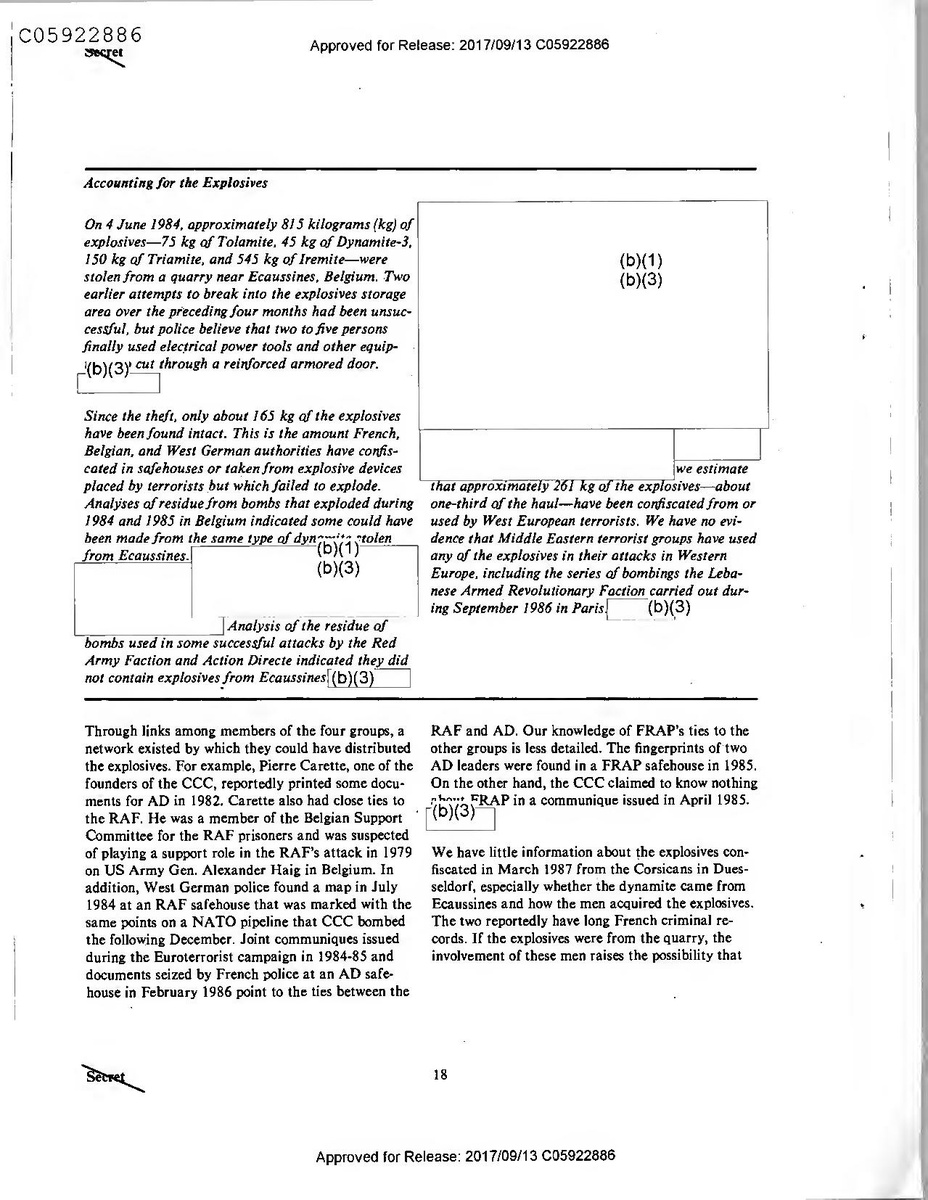
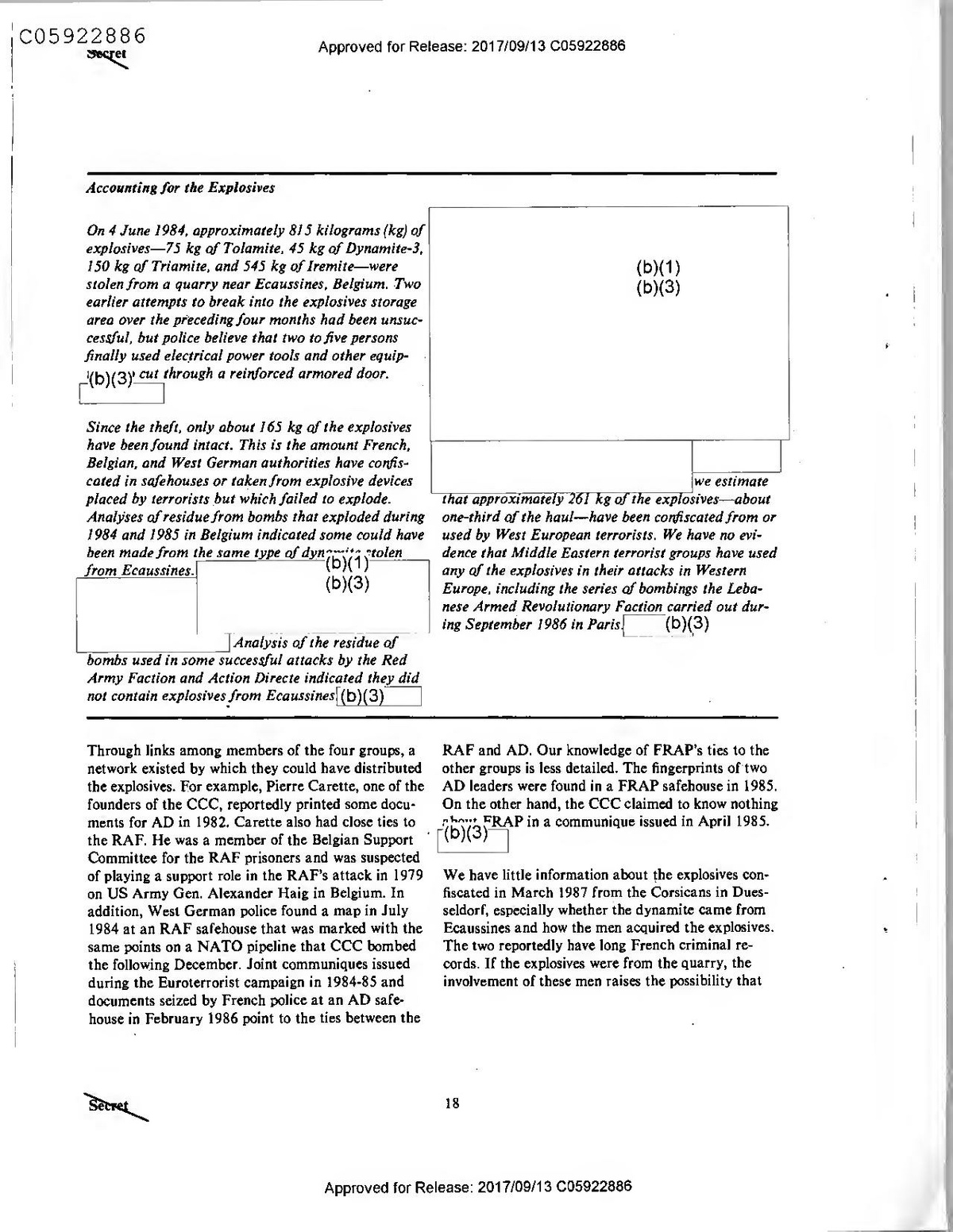
Accounting for the Explosives
(b)(1) (b)(3)
1984-06-04, approximately 815 kilograms (kg) of explosives - 75 kg of Tolamite, 45 kg of Dynamite-3, 150 kg of Triamite, and 545 kg of Iremite — were stolen from a quarry near Ecaussines, Belgium.
Two earlier attempts to break into the explosives storage area over the preceding four months had been unsuccessfUL, but police believe that two to five persons finally used electrical power tools and other equipment to cut through a reinforced armored door.(b)(3)
Since the theft, only about 165 kg of the explosives have been found intact. This is the amount French, Belgian, and West German authorities have confiscated in safehouses or taken from explosive devices placed by terrorists but which failed to explode.
Analyses of residue from bombs that exploded during 1984 and 1985 in Belgium indicated some could have been made from the same type of dynamite stolen from Ecaussines. (b)(1) (b)(3)
we estimate that approximately 261 kg of the explosives-about one-third of the haUL-have been confiscated from or used by West European terrorists. We have no evidence that Middle Eastern terrorist groups have used any of the explosives in their attacks in Western Europe, including the series of bombings the Lebanese Armed Revolutionary Faction carried out during September 1986 in Paris, (b)(3)
Analysis of the residue of bombs used in some successfUL attacks by the Red Army Faction and Action Directe indicated they did not contain explosives from Ecaussines[(b)(3)
RAF and AD. Our knowledge of FRAP's ties to the other groups is less detailed. The fingerprints of two AD leaders were found in a FRAP safehouse in 1985. On the other hand, the CCC claimed to know nothing Chart FRAP in a communique issued in April 1985. F(b)(3)
Through links among members of the four groups, a network existed by which they could have distributed the explosives. For example, Pierre Carette, one of the founders of the CCC, reportedly printed some documents for AD in 1982. Carette also had close ties to the RAF. He was a member of the Belgian Support Committee for the RAF prisoners and was suspected of playing a support role in the RAF's attack in 1979 on US Army Gen. Alexander Haig in Belgium. In addition, West German police found a map in July 1984 at an RAF safehouse that was marked with the same points on a NATO pipeline that CCC bombed the following December. Joint communiques issued during the Euroterrorist campaign in 1984-85 and documents seized by French police at an AD safehouse in February 1986 point to the ties between the
We have little information about the explosives confiscated in March 1987 from the Corsicans in Dues. seldorf, especially whether the dynamite came from Ecaussines and how the men acquired the explosives. The two reportedly have long French criminal records. If the explosives were from the quarry, the involvement of these men raises the possibility that
Secret
18
Approved for Release: 2017/09/13 C05922886
(b)(1) (b)(3)
19
Secret
Approved for Release: 2017/09/13 C05922886
(b)(1) (b)(3)
19
Secret
Approved for Release: 2017/09/13 C05922886
discovered since 1985, but, lil ID, the RAF may
"(b)(3)" be husbanding its supply
criminals stole the explosives and transferred them to the terrorists-not a unique situation. A. Swedish gang reportedly admitted in January 1987 selling Swedish military munitions they stole in November 1986 to terrorists for operations in Belgium and in France. (b)(3)
Despite the recent discovery of more of the explosives, we are no closer to knowing for sure how much is in terrorist hands. Nevertheless, due to the continuing appearance of the explosives with terrorists, we estimate that the remaining explosives likely are controlled by terrorist groups, particularly the RAF and AD. Belgian authorities have not uncovered any more. CCC or FRAP caches since January 1986. Because we have no indications that members of these defunct groups in custody have been forthcoming about the existence of any more caches, we cannot rule out the possibility that they still have some of the explosives hidden away. (b)(3)
Where Are the Rest of the Explosives? There is strong evidence the terrorist groups had custody of a large amount of the stolen explosives, although we have not been able to determine that the four organizations had all that was stolen or how much each group had. In at least two cases, the explosives appeared outside the groups. On 24 April 1985, a Turkish national was arrested in Paris with 400 grams of the dynamite he claimed was given to him by a North African Belgium, but French police believed he was connected with AD. The Iranians arrested last September in France with approximately 6 kilograms of the explosives may have obtained the dynamite from the CCC through Pierre Carette. He was arrested in December 1985, suggesting the Iranians had already acquired the explosives. We do not yet know if the Corsicans arrested in West Germany have access more than the 1.5 kilograms found in their car.
One ominous prospect is that the dynamite has made its way beyond the original four users and could appear in the hands of other radical terrorist groups. If.criminals stole the explosives--a possibility raised by the arrest of the Corsicans--and did not transfer the entire 815 kilograms to the CCC, FRAP, RAF, and AD, the probability increases that more groups could get the explosives from those anxious to sell them. Alternatively, if the RAF and AD have all of the explosives that remain with active terrorist groups, they may not be ir naior have the means, to share
"(b)(3) it with others.
(b)(3)
(b)(3)
The coincidental timing of the arrests of Belgian terrorists, confiscation of 100 kilograms of the explosives in eight of their safehouses, and the end of the Euroterrorist bombing campaign suggest the CCC had the major share of the explosives held by any of the four West European organizations. It has been associated with the largest amount of the stolen explosives that has heen confiscated or used by any of the four groups. (b)(3)
The RAF and AD may still have some of the explosives. They made only three bombs-amounting to 48 kilograms of dynamite—from their share of the Ecaussines haUL, but these were discovered and disarmed before they could explode. Residue from their subsequent bombings indicates they have not used dynamite from Ecaussines since December 1985. The discovery of some of the dynamite in the AD safehouse in February, however, shows the AD still had some of the explosives. West German police have not turned up any of the explosives in RAF safehouses
20
Approved for Release: 2017/09/13 C05922886
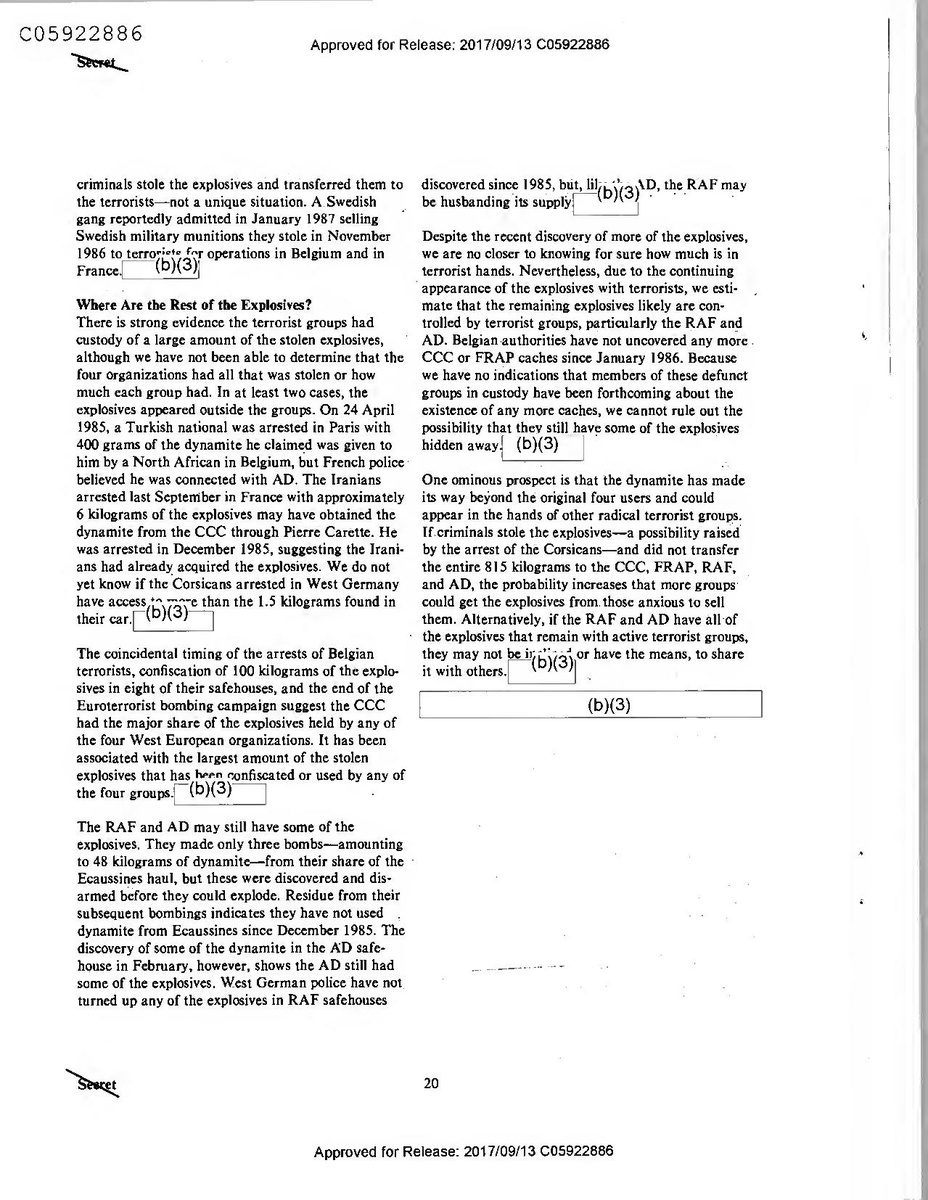
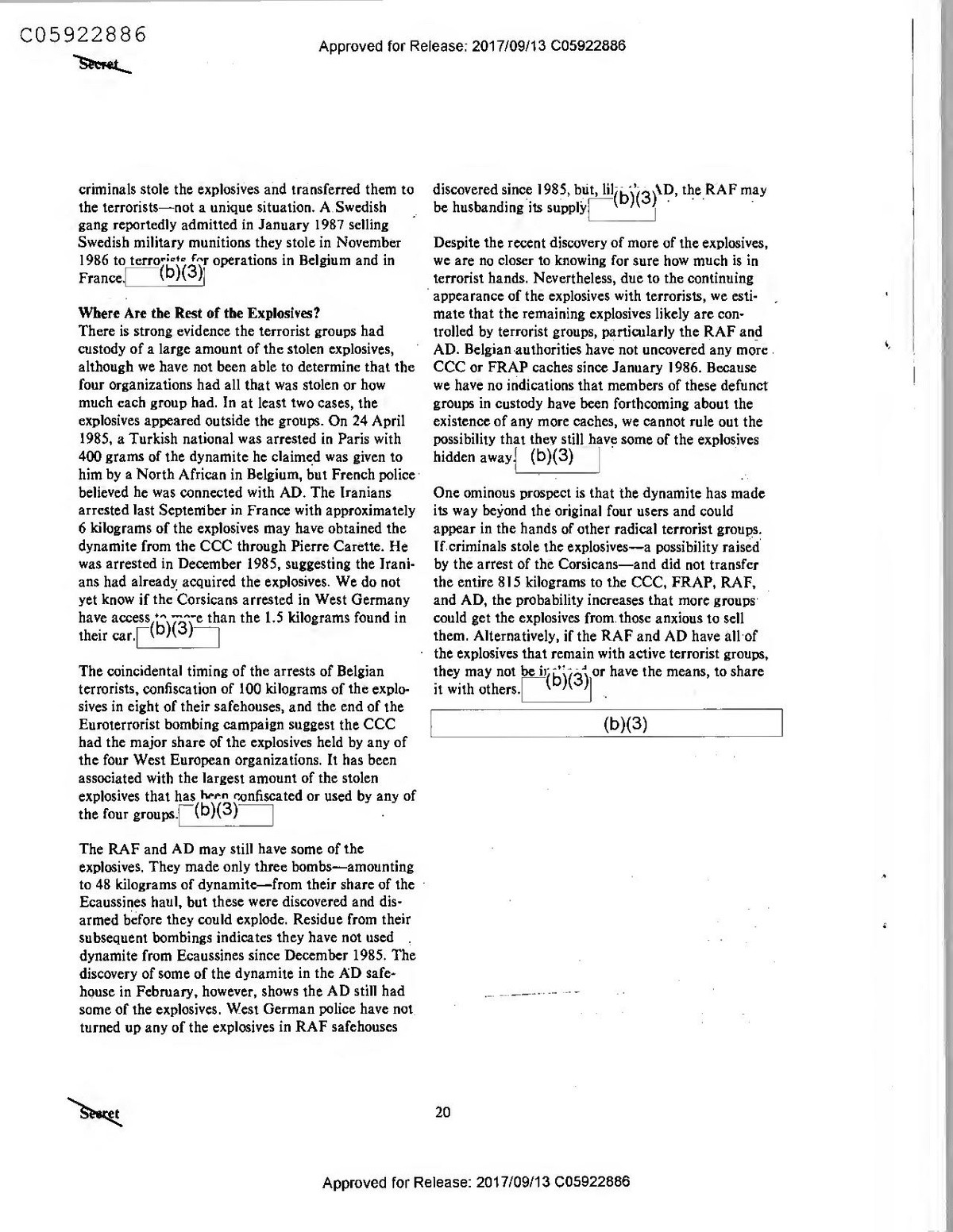
discovered since 1985, but, lil ID, the RAF may
"(b)(3)" be husbanding its supply
criminals stole the explosives and transferred them to the terrorists-not a unique situation. A. Swedish gang reportedly admitted in January 1987 selling Swedish military munitions they stole in November 1986 to terrorists for operations in Belgium and in France. (b)(3)
Despite the recent discovery of more of the explosives, we are no closer to knowing for sure how much is in terrorist hands. Nevertheless, due to the continuing appearance of the explosives with terrorists, we estimate that the remaining explosives likely are controlled by terrorist groups, particularly the RAF and AD. Belgian authorities have not uncovered any more. CCC or FRAP caches since January 1986. Because we have no indications that members of these defunct groups in custody have been forthcoming about the existence of any more caches, we cannot rule out the possibility that they still have some of the explosives hidden away. (b)(3)
Where Are the Rest of the Explosives? There is strong evidence the terrorist groups had custody of a large amount of the stolen explosives, although we have not been able to determine that the four organizations had all that was stolen or how much each group had. In at least two cases, the explosives appeared outside the groups. On 24 April 1985, a Turkish national was arrested in Paris with 400 grams of the dynamite he claimed was given to him by a North African Belgium, but French police believed he was connected with AD. The Iranians arrested last September in France with approximately 6 kilograms of the explosives may have obtained the dynamite from the CCC through Pierre Carette. He was arrested in December 1985, suggesting the Iranians had already acquired the explosives. We do not yet know if the Corsicans arrested in West Germany have access more than the 1.5 kilograms found in their car.
One ominous prospect is that the dynamite has made its way beyond the original four users and could appear in the hands of other radical terrorist groups. If.criminals stole the explosives--a possibility raised by the arrest of the Corsicans--and did not transfer the entire 815 kilograms to the CCC, FRAP, RAF, and AD, the probability increases that more groups could get the explosives from those anxious to sell them. Alternatively, if the RAF and AD have all of the explosives that remain with active terrorist groups, they may not be ir naior have the means, to share
"(b)(3) it with others.
(b)(3)
(b)(3)
The coincidental timing of the arrests of Belgian terrorists, confiscation of 100 kilograms of the explosives in eight of their safehouses, and the end of the Euroterrorist bombing campaign suggest the CCC had the major share of the explosives held by any of the four West European organizations. It has been associated with the largest amount of the stolen explosives that has heen confiscated or used by any of the four groups. (b)(3)
The RAF and AD may still have some of the explosives. They made only three bombs-amounting to 48 kilograms of dynamite—from their share of the Ecaussines haUL, but these were discovered and disarmed before they could explode. Residue from their subsequent bombings indicates they have not used dynamite from Ecaussines since December 1985. The discovery of some of the dynamite in the AD safehouse in February, however, shows the AD still had some of the explosives. West German police have not turned up any of the explosives in RAF safehouses
20
Approved for Release: 2017/09/13 C05922886
(b)(3)
Chronology of Terrorism-1986-87
Below are described noteworthy foreign and international events involving terrorists, or the use of terrorist tactics, which have occurred or come to light since our last issue. In some cases, the perpetrators and their motivations may not be known. Events and developments that have already been described elsewhere in this publication are not included.__(b)(3)
31. December
Chile: Unidentified individuals armed with pistols and submachineguns threaten employees of the Intergovernmental Committee for Migration in Santiago. No one was injured in the incident. A telephone call from an unidentified male claimed romans ibility for the attack on behalf of the “11 September Commandos. "f(b)(3)
Uganda: Handgrenade explodes a crowded bus stop in Ka injuring sir people. Witnesses say that the grenade was thrown from a three-story building across from the bus stop. No claim of responsibility has been made
(b)(3)
13 January
Namibia: Bomb explodes at a gas station in Gobabis, killing one man. A second bomb was found nearby and defused. There was no claim of responsibility (b)(3)
14 January
Cyprus: Police at Larnaca airport de port a group of Palestinians trying to enter the country. Police believe they planned to attack Syrian targets in Nicosia. The Palestinians were refused permission to telephone a contact in Cyprus and were put aboard a plane that left for overseas (b)(3)
28 January
Turkey: Three members of the Kurdish Workers Party (PKK) involved in a village raid on 24 January surrender to police. Another two militants were expected to give themselves up. The security forces arrested 23 persons in connection with the incident[(b)(3)
30 January
Turkey: Four Palestinians on trial for the murder in July 1985 of a Jordanian diplomat end a hunger strike in an Ankara jail after prosecutor's visit. They were protesting a court decision refusing their release. The prosecutor reportedly promised to help them
F(b)(3)
Late January
- Turkey: IstanbUL police arrest two university students for suspicious activities and distribution of leaflets signed by the leftist terrorist group Dev Sol. Several books
and publications containing leftist propaganda-also.were confiscated (b)(3)
21
Sceret DI TR 87-006 26 March 1987
Approved for Release: 2017/09/13 C05922886
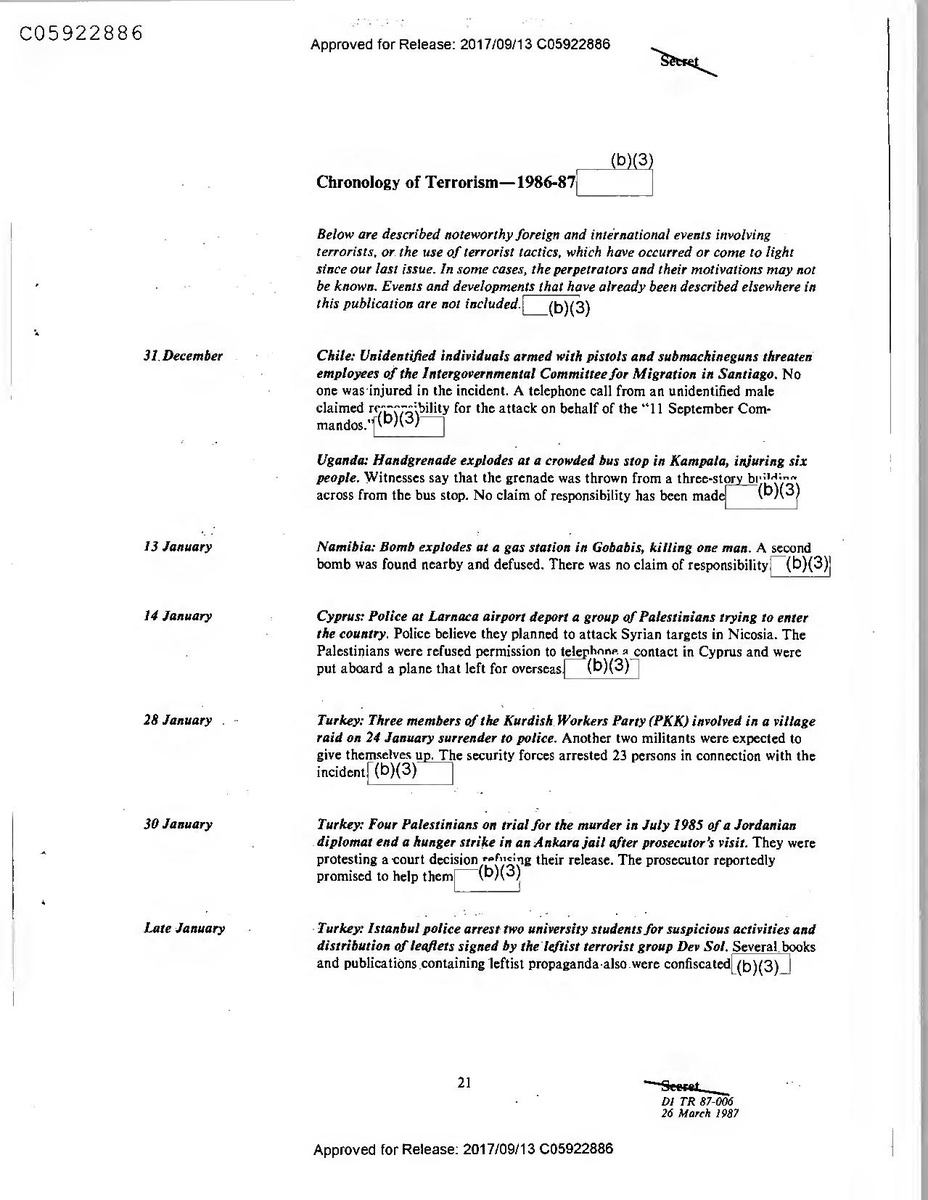
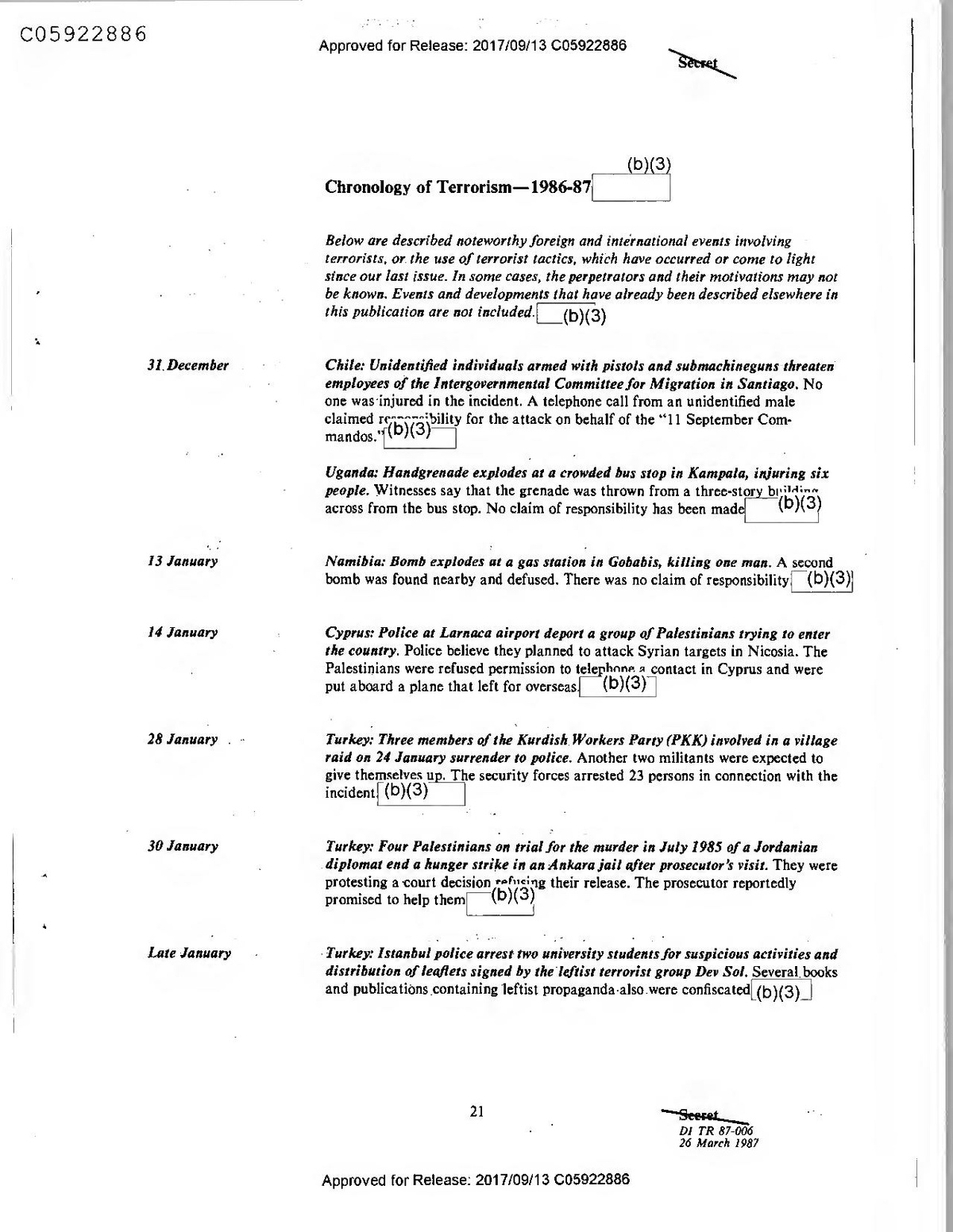
(b)(3)
Chronology of Terrorism-1986-87
Below are described noteworthy foreign and international events involving terrorists, or the use of terrorist tactics, which have occurred or come to light since our last issue. In some cases, the perpetrators and their motivations may not be known. Events and developments that have already been described elsewhere in this publication are not included.__(b)(3)
31. December
Chile: Unidentified individuals armed with pistols and submachineguns threaten employees of the Intergovernmental Committee for Migration in Santiago. No one was injured in the incident. A telephone call from an unidentified male claimed romans ibility for the attack on behalf of the “11 September Commandos. "f(b)(3)
Uganda: Handgrenade explodes a crowded bus stop in Ka injuring sir people. Witnesses say that the grenade was thrown from a three-story building across from the bus stop. No claim of responsibility has been made
(b)(3)
13 January
Namibia: Bomb explodes at a gas station in Gobabis, killing one man. A second bomb was found nearby and defused. There was no claim of responsibility (b)(3)
14 January
Cyprus: Police at Larnaca airport de port a group of Palestinians trying to enter the country. Police believe they planned to attack Syrian targets in Nicosia. The Palestinians were refused permission to telephone a contact in Cyprus and were put aboard a plane that left for overseas (b)(3)
28 January
Turkey: Three members of the Kurdish Workers Party (PKK) involved in a village raid on 24 January surrender to police. Another two militants were expected to give themselves up. The security forces arrested 23 persons in connection with the incident[(b)(3)
30 January
Turkey: Four Palestinians on trial for the murder in July 1985 of a Jordanian diplomat end a hunger strike in an Ankara jail after prosecutor's visit. They were protesting a court decision refusing their release. The prosecutor reportedly promised to help them
F(b)(3)
Late January
- Turkey: IstanbUL police arrest two university students for suspicious activities and distribution of leaflets signed by the leftist terrorist group Dev Sol. Several books
and publications containing leftist propaganda-also.were confiscated (b)(3)
21
Sceret DI TR 87-006 26 March 1987
Approved for Release: 2017/09/13 C05922886
(b)(3)
1 February
Israel: Rockets land in field in Galilee. The PLO claimed responsibility.
3 February
Turkey: Martial law court in Erzurum acquits 218 suspects in Dev Yol (Revolutionary Way) and Kurdish Workers Party (PKK) trials. In the Dev Yol trial, 89 suspects were acquitted of charges of belonging to an underground organization and arranging illegal meetings to promote the ideology of their group. There were 129 suspects acquitted in the PKK trial. (b)(3)
5 February
Chile: Bombs damage several pylons of the national high-voltage power network, causing power outages in Santiago and the coastal towns of VGM Viso and Vina del Mar. No organization has claimed credit for this attack
(b)(3)
Early February
Turkey: Military court in Diyarbakir sentences Kurdish Workers' Party (PKK) founder to eight years in prison. Sakine Polat previously had been tried six times and given various prison terms; this latest sentence raises her total term of imprisonment to 59 years. (b)(3)
Turkey: Security forces capture seven members of an illegal organization in IstanbUL. The suspects are alleged members of a Marxist-Leninist eroun. Forged identity cards and organizational documents also were seized. (b)(3)]
7 February
Turkey: Suspicious fire destroys San Theater in IstanbUL, killing the night watchman. Fire officials claim a short circuit caused the accident, but the police suspect arson by Islamic fundamentalists. The theater was staging a play that was harshly criticized by conservative Muslims. (b)(3)
Argentina: Bomb explodes at the Movement Toward Socialism (MAS) party committee headquarters in Buenos Aires. The explosion caused damage to the building but no casualties
F(b)(3)
15 February
Gaza Strip: Molotov cocktail thr4b)(3)|sraeli bus outside police station. No injuries or damages occurred.
Israel: Car bomb explodes near hospital in Kefar Saba, Romb detonated prematurely, wounding several suspected terrorists
(b)(3)
Mid-February
Turkey: Ankara military court sentences suspected members of the Dev Yol (Revolutionary Way) Eskisehir branch. Of the 104 suspects, two were sentenced to death and one to life imprisonment. Another 52 received prison terms ranging from three to 15 years and 46 were acquitted. (b)(3)
Secret
22
Approved for Release: 2017/09/13 C05922886
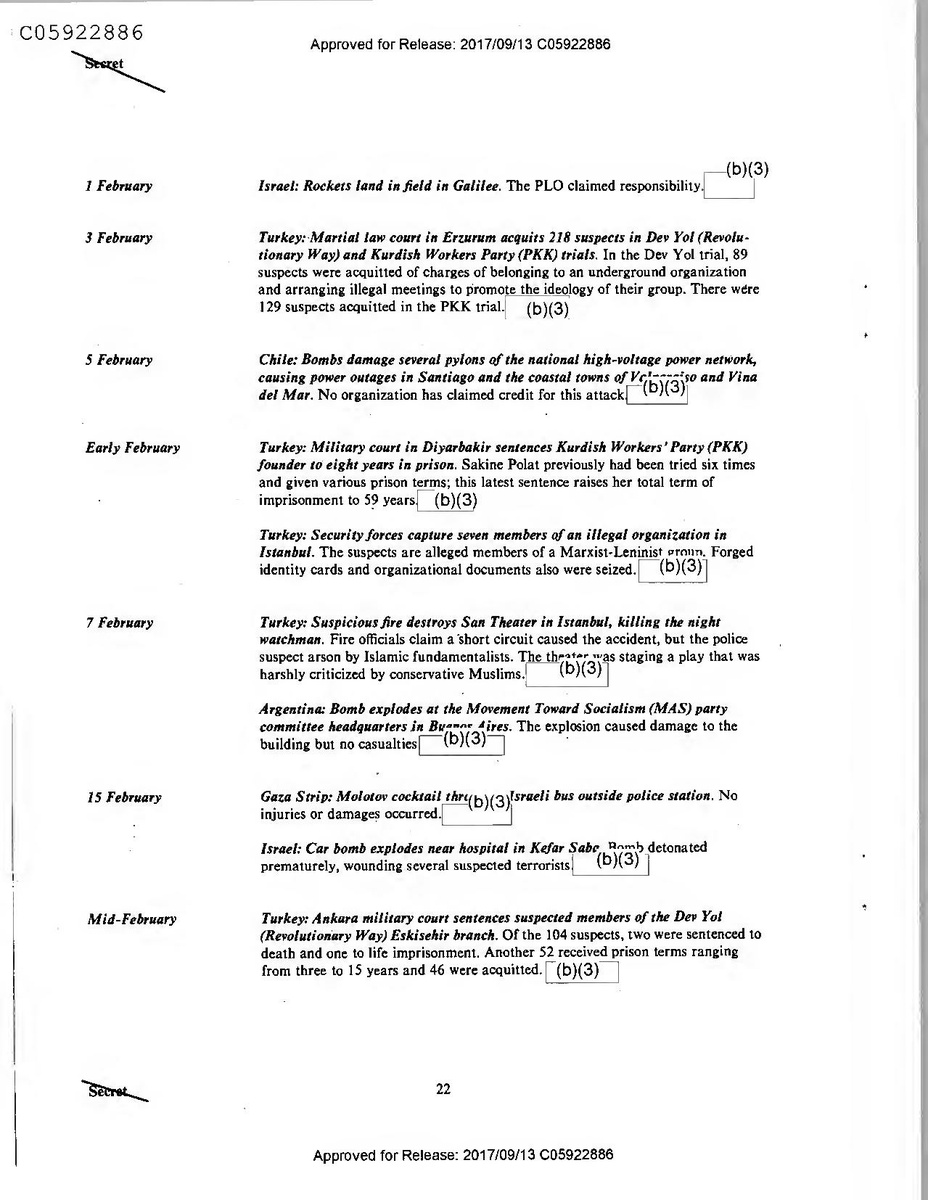
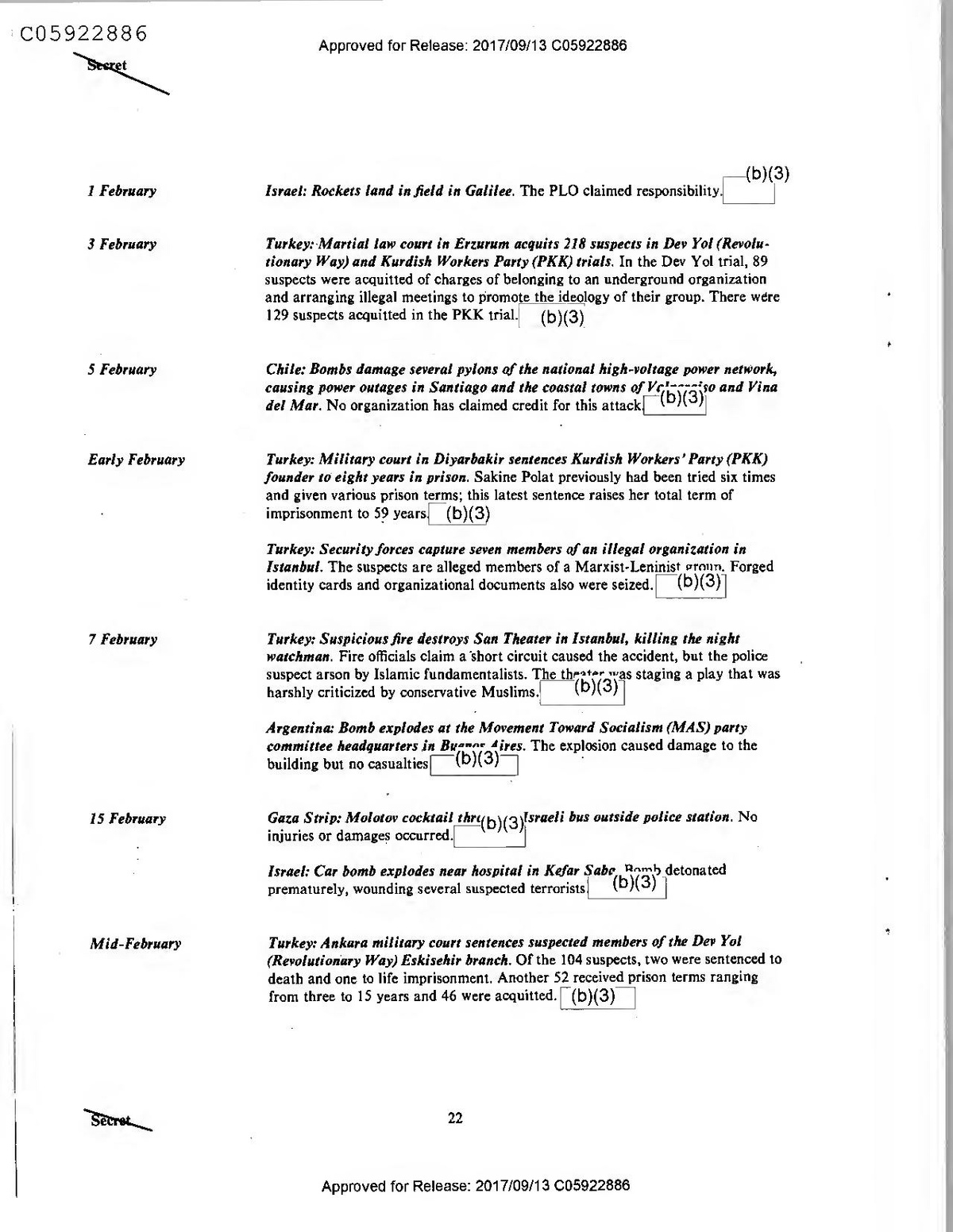
(b)(3)
1 February
Israel: Rockets land in field in Galilee. The PLO claimed responsibility.
3 February
Turkey: Martial law court in Erzurum acquits 218 suspects in Dev Yol (Revolutionary Way) and Kurdish Workers Party (PKK) trials. In the Dev Yol trial, 89 suspects were acquitted of charges of belonging to an underground organization and arranging illegal meetings to promote the ideology of their group. There were 129 suspects acquitted in the PKK trial. (b)(3)
5 February
Chile: Bombs damage several pylons of the national high-voltage power network, causing power outages in Santiago and the coastal towns of VGM Viso and Vina del Mar. No organization has claimed credit for this attack
(b)(3)
Early February
Turkey: Military court in Diyarbakir sentences Kurdish Workers' Party (PKK) founder to eight years in prison. Sakine Polat previously had been tried six times and given various prison terms; this latest sentence raises her total term of imprisonment to 59 years. (b)(3)
Turkey: Security forces capture seven members of an illegal organization in IstanbUL. The suspects are alleged members of a Marxist-Leninist eroun. Forged identity cards and organizational documents also were seized. (b)(3)]
7 February
Turkey: Suspicious fire destroys San Theater in IstanbUL, killing the night watchman. Fire officials claim a short circuit caused the accident, but the police suspect arson by Islamic fundamentalists. The theater was staging a play that was harshly criticized by conservative Muslims. (b)(3)
Argentina: Bomb explodes at the Movement Toward Socialism (MAS) party committee headquarters in Buenos Aires. The explosion caused damage to the building but no casualties
F(b)(3)
15 February
Gaza Strip: Molotov cocktail thr4b)(3)|sraeli bus outside police station. No injuries or damages occurred.
Israel: Car bomb explodes near hospital in Kefar Saba, Romb detonated prematurely, wounding several suspected terrorists
(b)(3)
Mid-February
Turkey: Ankara military court sentences suspected members of the Dev Yol (Revolutionary Way) Eskisehir branch. Of the 104 suspects, two were sentenced to death and one to life imprisonment. Another 52 received prison terms ranging from three to 15 years and 46 were acquitted. (b)(3)
Secret
22
Approved for Release: 2017/09/13 C05922886
Turkey: Diyarbakir military court sentences Rizgari Organization members. One defendant received five years at hard labor, another had his sentence increased to 24 years, and five others were acquitted. The court also sentenced a Kurdish Workers' Party (PKK) militant to 10 years in prison. (b)(3)]
Turkey: Authorities discover weapons cache in Ceylanpinar. A total of 147 handguns were buried together with 284 magazines and other ammunition
-(b)(3)
16 February
Argentina: Bomb explodes outside newspaper agency in Mendoza. Numerous windows were bronhit there were no casualties. No group has claimed responsibility
(b)(3)
18 February
......
Turkey: In Eruh, separatist Kurdish Workers Party militants raid the home of the village religious leader, whose two brothers Is watchmen. Two civilians
(b)(3) were killed and four ers were injured.
West Bank: IDF kills Nablus taxi driver whose cab struck several Israeli soldiers. Local Palestinians be:
(b)(3)
7 accident caused the incident, and charged that the IDF overreacted,
at settlement near
West Bank: Unidentified individual throws molotov Nablus. No damage or injuries were reported
(b)(3jui
West Bank: Unidentified persons throw molotov cocktails in village near Jenin. The firebombs exploded but caused no damage or injuries. (b)(3)]
19 February
Peru: Tupac Amaru (MRTA) took over 12 radio stations in Lima ; dcast
(b)(3) messages attacking the government. No injuries were reported
20 February
Israel: Vandals set fire to entrance to East Jerusale,
Hapoalim. No group has claimed responsibility.al(b)(3}\ch of Israeli Bank
21 February
(b) (3)za: Molotov cocktail damages parked Israeli vehicle. There were no injuries.
Israel: Arson destro
"(b)(3)
ib-owned shop. Witnesses claim they saw three Israelis leave the scene.
Peru: Bomb explodes harmlessly near the Presidential Palace. President Garcia was bestowing a decoration on Guatemalan President Cerezo at the time of the explosion(b)(3)
23
Secret
Approved for Release: 2017/09/13 C05922886
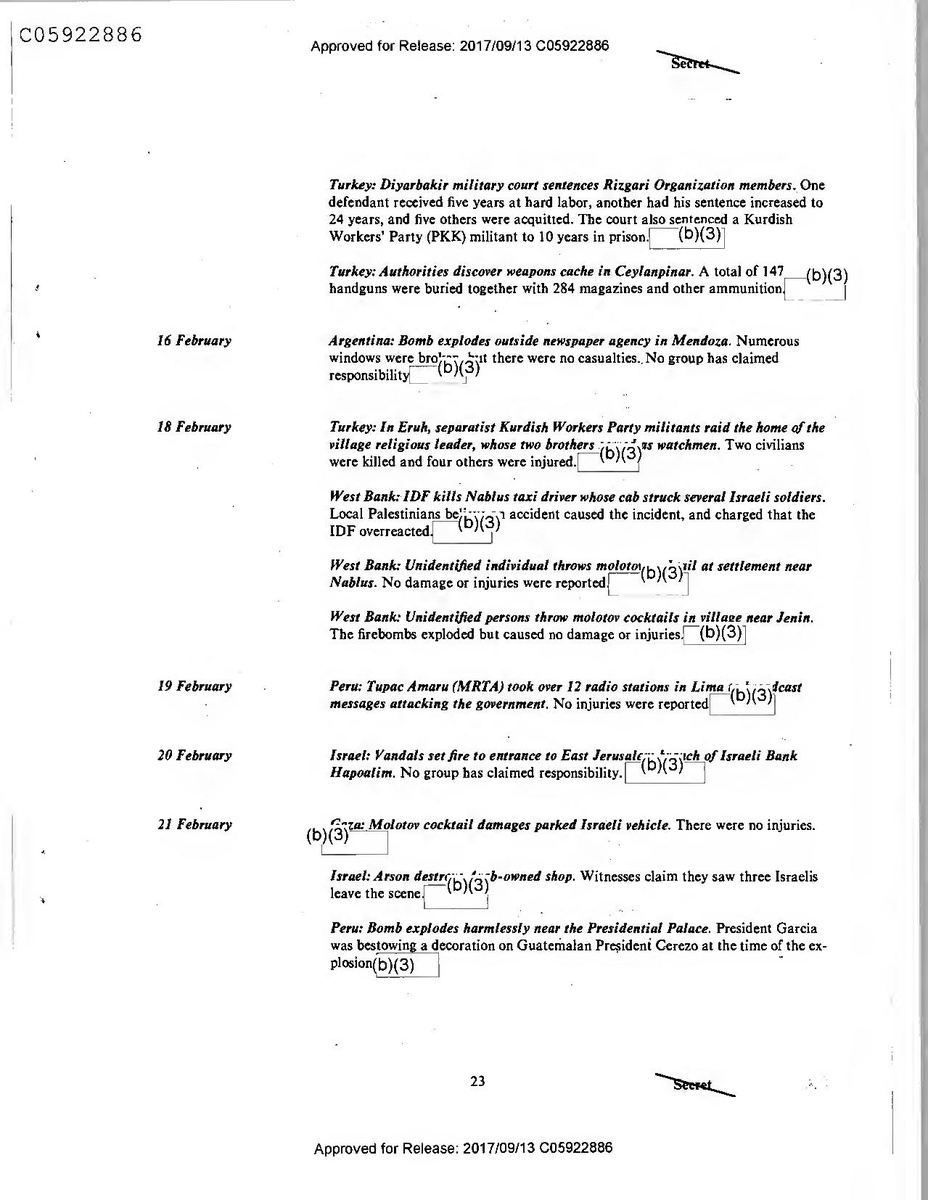
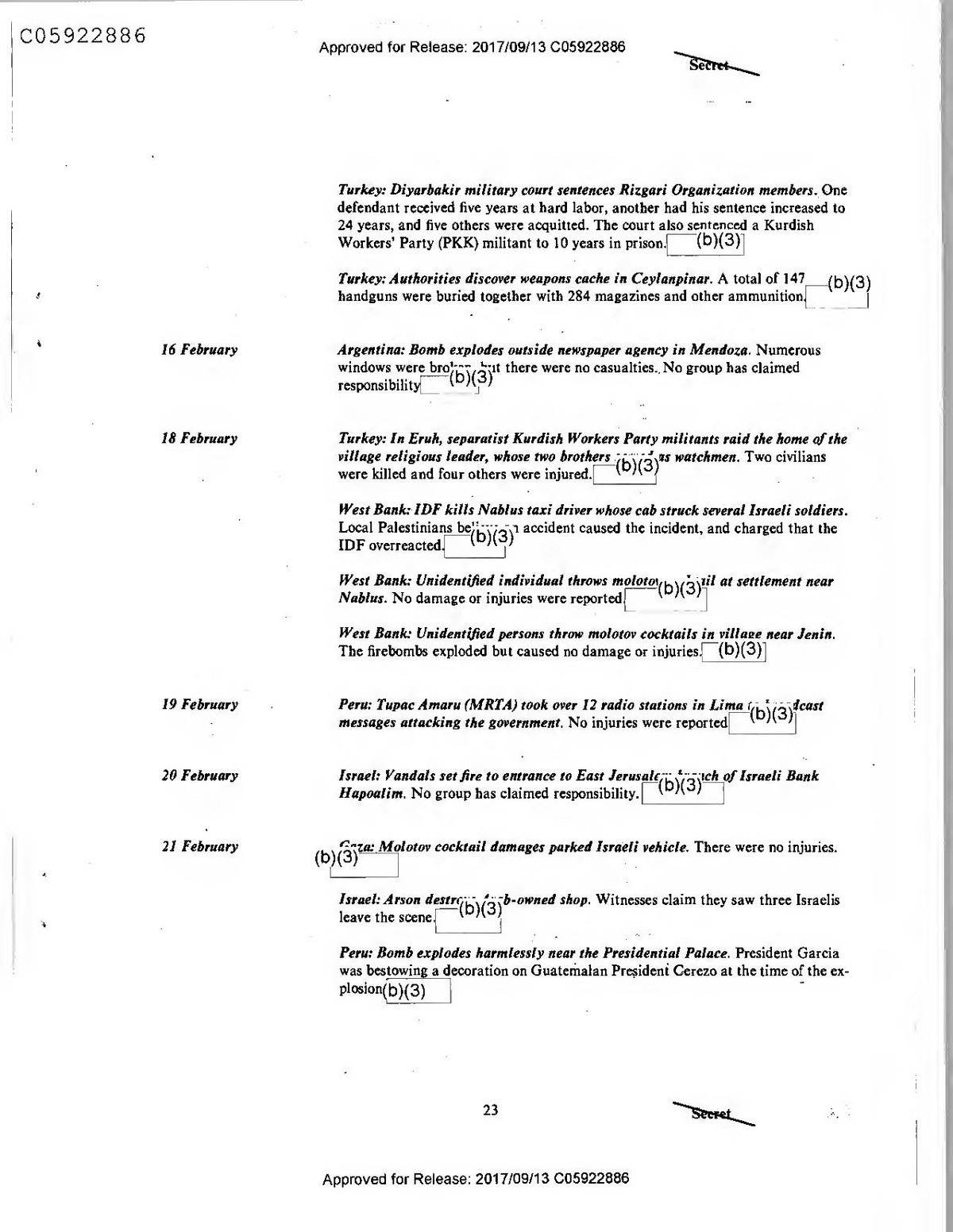
Turkey: Diyarbakir military court sentences Rizgari Organization members. One defendant received five years at hard labor, another had his sentence increased to 24 years, and five others were acquitted. The court also sentenced a Kurdish Workers' Party (PKK) militant to 10 years in prison. (b)(3)]
Turkey: Authorities discover weapons cache in Ceylanpinar. A total of 147 handguns were buried together with 284 magazines and other ammunition
-(b)(3)
16 February
Argentina: Bomb explodes outside newspaper agency in Mendoza. Numerous windows were bronhit there were no casualties. No group has claimed responsibility
(b)(3)
18 February
......
Turkey: In Eruh, separatist Kurdish Workers Party militants raid the home of the village religious leader, whose two brothers Is watchmen. Two civilians
(b)(3) were killed and four ers were injured.
West Bank: IDF kills Nablus taxi driver whose cab struck several Israeli soldiers. Local Palestinians be:
(b)(3)
7 accident caused the incident, and charged that the IDF overreacted,
at settlement near
West Bank: Unidentified individual throws molotov Nablus. No damage or injuries were reported
(b)(3jui
West Bank: Unidentified persons throw molotov cocktails in village near Jenin. The firebombs exploded but caused no damage or injuries. (b)(3)]
19 February
Peru: Tupac Amaru (MRTA) took over 12 radio stations in Lima ; dcast
(b)(3) messages attacking the government. No injuries were reported
20 February
Israel: Vandals set fire to entrance to East Jerusale,
Hapoalim. No group has claimed responsibility.al(b)(3}\ch of Israeli Bank
21 February
(b) (3)za: Molotov cocktail damages parked Israeli vehicle. There were no injuries.
Israel: Arson destro
"(b)(3)
ib-owned shop. Witnesses claim they saw three Israelis leave the scene.
Peru: Bomb explodes harmlessly near the Presidential Palace. President Garcia was bestowing a decoration on Guatemalan President Cerezo at the time of the explosion(b)(3)
23
Secret
Approved for Release: 2017/09/13 C05922886
February
Israel: Unknown individual throws smoke (b)(3)' souvenir shop in East Jerusalem. No damage was reported
Israel: Grenade thrown in Jerusalem wounds 17 persons, including 12 Israeli border policemen. Both Fatah's Force 17 and the, Domncratic Front for the Liberation of Palestine claimed responsibility. (b)(3)
1
Zambia: Explosion rips through a Lusaka post office, causing extensive damage to the building. No iniuries were reported and no group has claimed responsibility for the explosion. (b)(3)
February
Spain: Basques stone Renteria town hall in protest over expulsicma hos France. There were no injuries or clashes with police in the incident.
(b)(3)7
February
Turkey: During arms smuggling trial in Diyarbakir government prosecutor accuses Libya and Syria of aiding the Kurdish Workers' Party, the Kurdish Democratic Party, and the Patriotic Union of Kurdistan. The five suspects in the trial, who are charged with. smuggling arms into Turkey from Suria for the separatists will face 15-to-25 year sentences if convicted
(b)(3)
West Germany: Group of 21 Kurds briefly occupy the BBC radio office in Charlottenburg, protesting the treatment of. Kurds in Sweden. In January 1987 several Kurds were detained when Swedish authorities investigated the possibility
of Kurdish Workers' Party (PKK) involvement in the Olof Palme killing last year. (b)(3)
b3
West Bank: Israeli extremists vandalize Ar-Rub refugee camp, smashing wind - shields, and solar panels, and painting threats on Arab houses (b)(3)
25-26 February
Spain: Prime Minister Gonzalez gives speech indicating possible repeal of antiterrorist legislation. This would limit jail retention time of suspected terrorists from 10 to five or six days.
26 February
Spain: Police defuse 20-pound bomb outside Barcelona synagogue. No group claimed noen gibility for planting the device, but police suspect Middle Eastern terrorists
(b)(3)
27 February
Spain: France expels three suspected Basque guerrillas, turning them over to Spanish police in San Sebastian. These new expulsions bring the total number to 39 since July 1986.(b)(3)
24
Approved for Release: 2017/09/13 C05922886
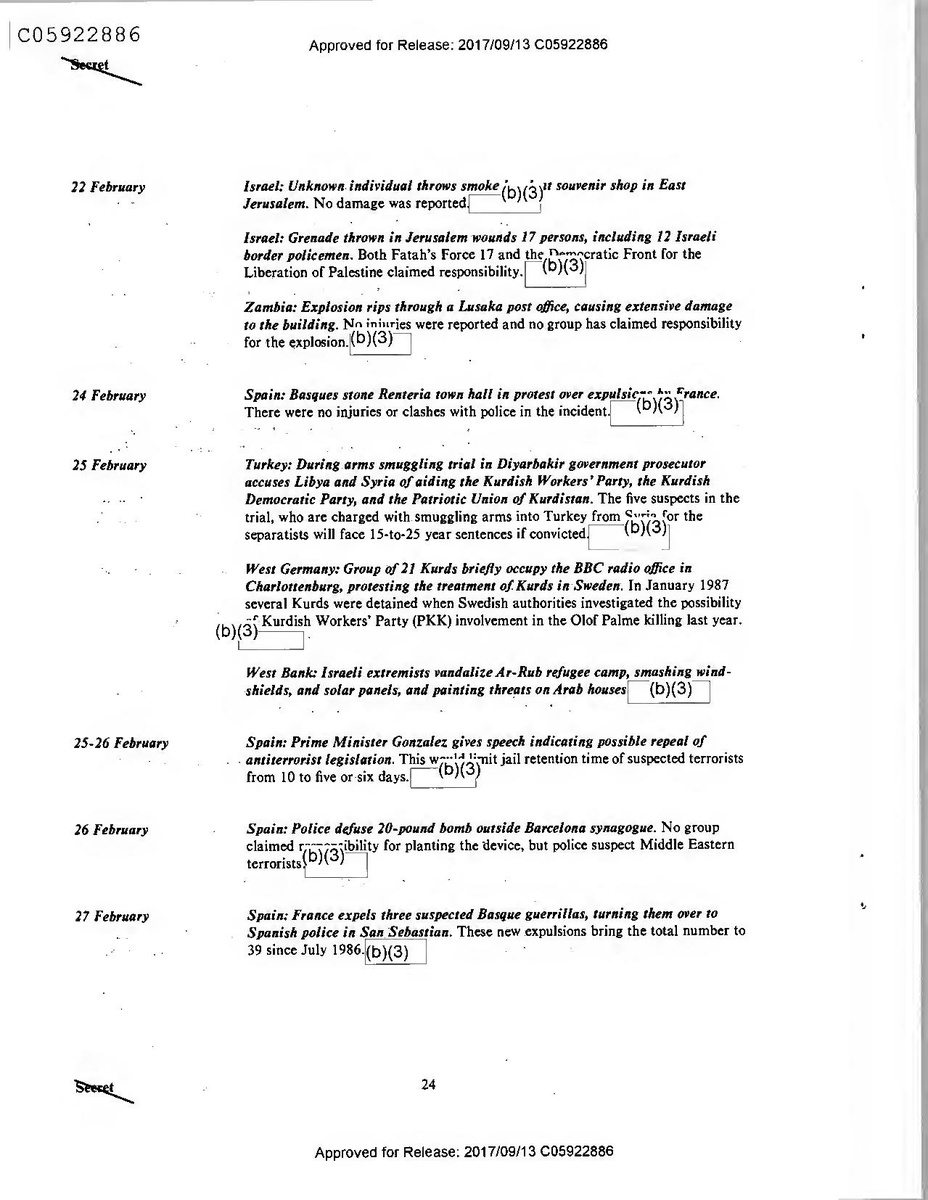
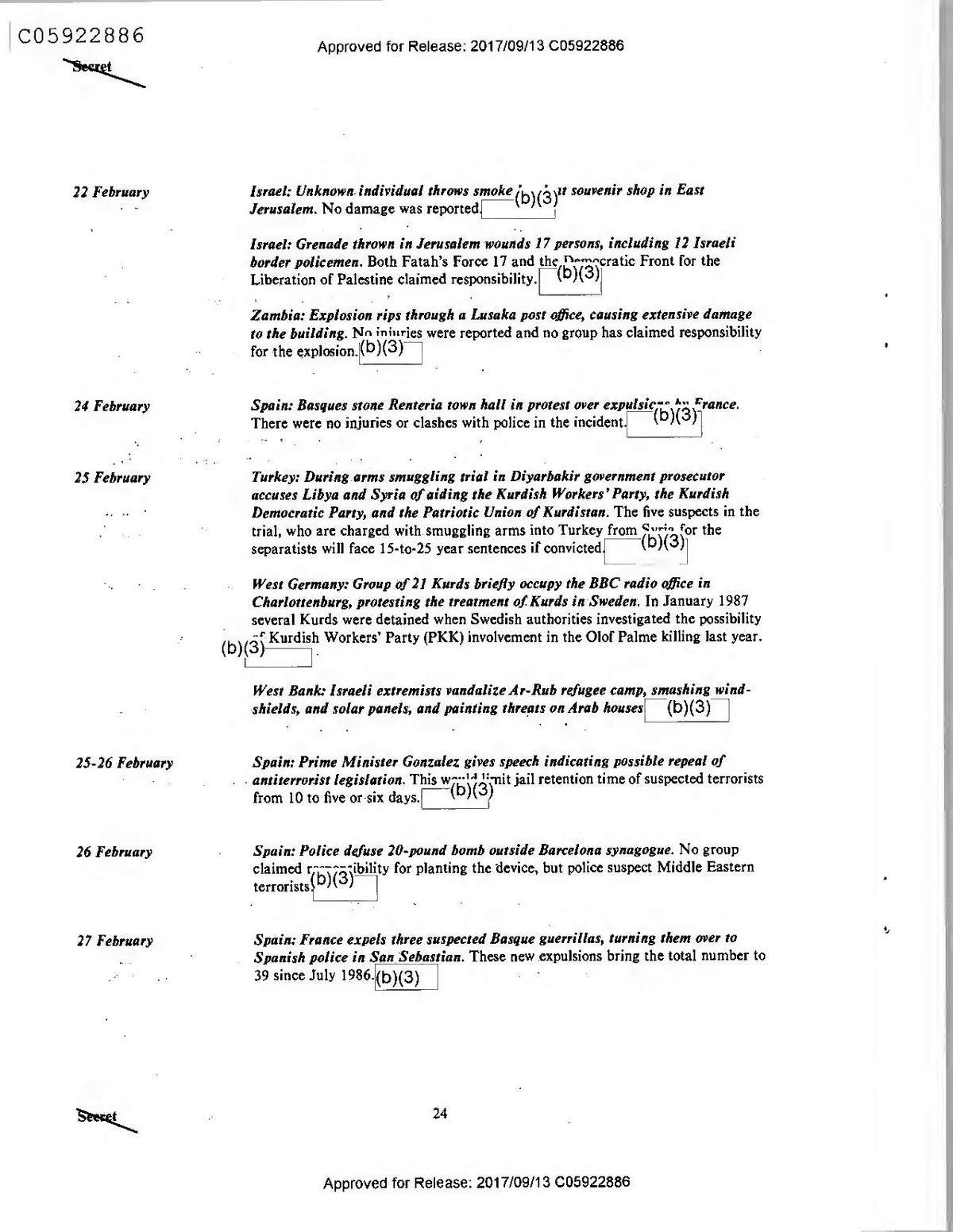
February
Israel: Unknown individual throws smoke (b)(3)' souvenir shop in East Jerusalem. No damage was reported
Israel: Grenade thrown in Jerusalem wounds 17 persons, including 12 Israeli border policemen. Both Fatah's Force 17 and the, Domncratic Front for the Liberation of Palestine claimed responsibility. (b)(3)
1
Zambia: Explosion rips through a Lusaka post office, causing extensive damage to the building. No iniuries were reported and no group has claimed responsibility for the explosion. (b)(3)
February
Spain: Basques stone Renteria town hall in protest over expulsicma hos France. There were no injuries or clashes with police in the incident.
(b)(3)7
February
Turkey: During arms smuggling trial in Diyarbakir government prosecutor accuses Libya and Syria of aiding the Kurdish Workers' Party, the Kurdish Democratic Party, and the Patriotic Union of Kurdistan. The five suspects in the trial, who are charged with. smuggling arms into Turkey from Suria for the separatists will face 15-to-25 year sentences if convicted
(b)(3)
West Germany: Group of 21 Kurds briefly occupy the BBC radio office in Charlottenburg, protesting the treatment of. Kurds in Sweden. In January 1987 several Kurds were detained when Swedish authorities investigated the possibility
of Kurdish Workers' Party (PKK) involvement in the Olof Palme killing last year. (b)(3)
b3
West Bank: Israeli extremists vandalize Ar-Rub refugee camp, smashing wind - shields, and solar panels, and painting threats on Arab houses (b)(3)
25-26 February
Spain: Prime Minister Gonzalez gives speech indicating possible repeal of antiterrorist legislation. This would limit jail retention time of suspected terrorists from 10 to five or six days.
26 February
Spain: Police defuse 20-pound bomb outside Barcelona synagogue. No group claimed noen gibility for planting the device, but police suspect Middle Eastern terrorists
(b)(3)
27 February
Spain: France expels three suspected Basque guerrillas, turning them over to Spanish police in San Sebastian. These new expulsions bring the total number to 39 since July 1986.(b)(3)
24
Approved for Release: 2017/09/13 C05922886
February
Spain: Bomb explodes at Gerona provincial courthouse, causing extensive damage
no injuries. The Catalan separatist group Terra Lliure claimed responsibility.
(b)(3)“
Spain: France expels suspected Basque terrorist to Spain. The suspect, a former
counselor in Pamplona for the radical Herri Batasuna coalition, sheltered Basque (b)(3)'atherland and Liberty members in the city before fleeing to France six years ago.
Gaza: Homemade bomb slightly damages Israeli bus parked near py
P4B)(3jưion. Anonymous caller in Beirut claims credit on behalf of Force 17.
(b)(1)
(b)(3)
Peru: Four Sendero Luminoso terrorists botch mortar attack against President Garcia's residence.
the mortar exploded in the terrorists' hands.
2 March
West Bank: Nablus observes first anniversary of Palestinian Mayor al-Masri's assassination. Israeli authorities restricted public gatherings to prevent a possible outbreak of violence.
(b)(3)
3 March
West Bank: Israeli bus near Amari refugee camp in Ramallah is target of Molotov cocktail. Israeli soldiers arrested one Arab youth. (b)(3)
4 March
Costa Rica: Unidentified group leaves small bomb in the driveway of the private residence of President Arias. The bomb did not explode. (b)(3)
5 March
Spain: Terra Lliure detonates bomb at television relay station in Gerona. There
were no injuries, and the extent of damage is unknown (b)(3)
West Bank: Three Israeli settlers attempt arsonnel on Muslim religious school in Hebron. The settlers were arrested.
(b)(3)
6 March
Honduras: PowerfUL bomb explodes in front of the home of Nicaraguan Democratic Force (FDN) spokeswoman Adela Icaza. A leftist group claimed responsibility for the bombing. (b)(3)
7 March
Spain: Bomb explodes at town council building in Baracaldo. There were no injuries. No group claimed responsibility, although the police suspect the Basque Fatherland and Liberty organization
(b)(3)
25
Secret
Approved for Release: 2017/09/13 C05922886
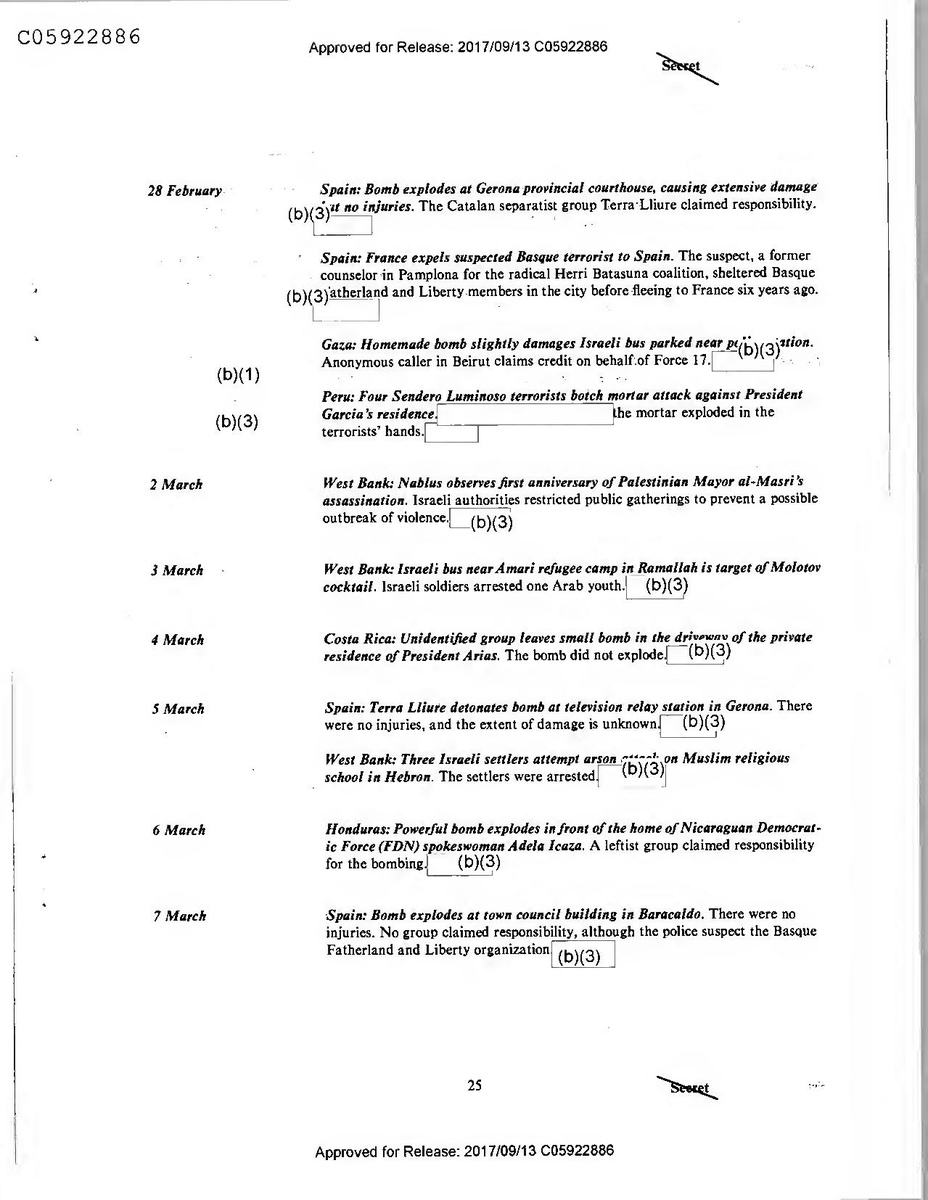
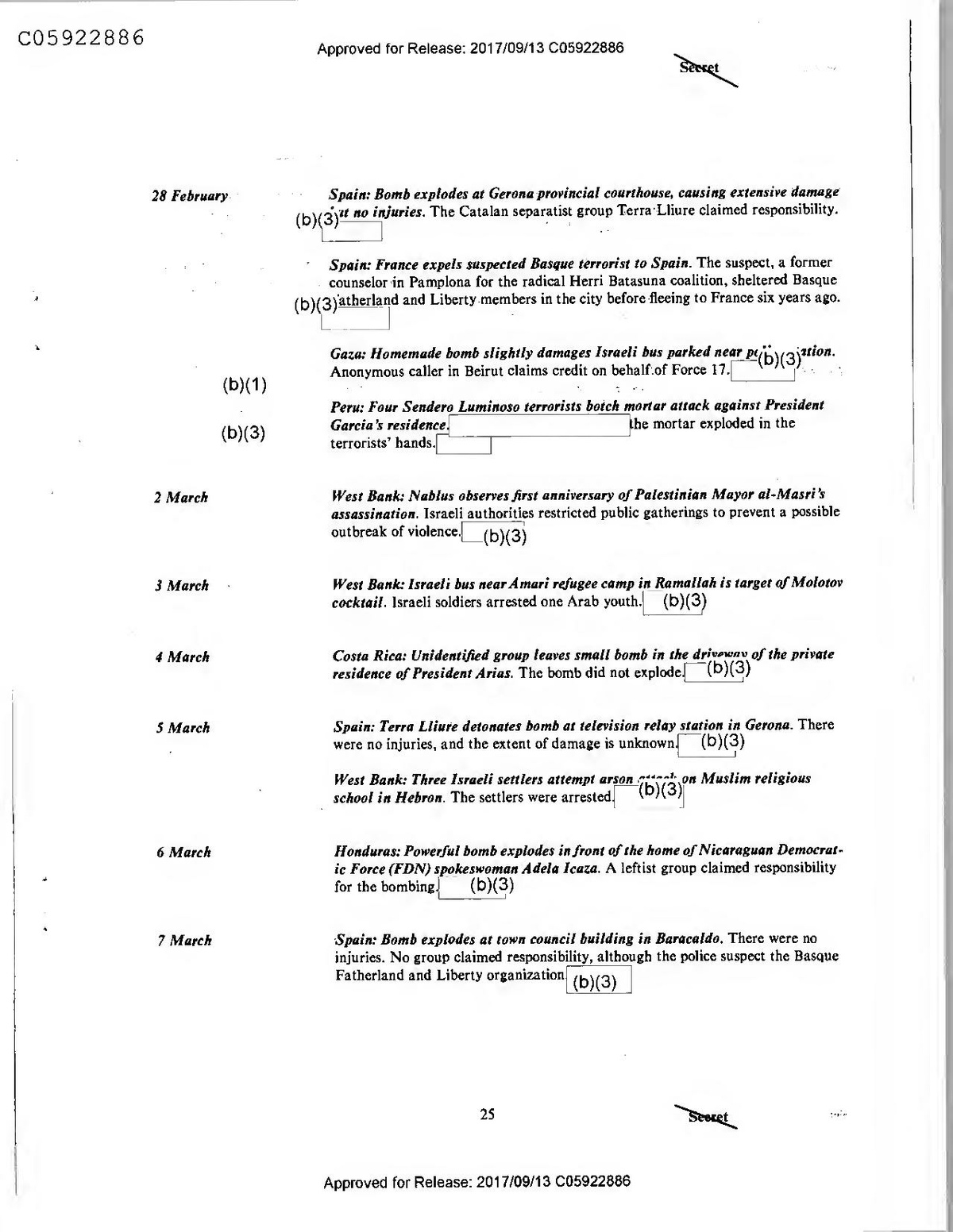
February
Spain: Bomb explodes at Gerona provincial courthouse, causing extensive damage
no injuries. The Catalan separatist group Terra Lliure claimed responsibility.
(b)(3)“
Spain: France expels suspected Basque terrorist to Spain. The suspect, a former
counselor in Pamplona for the radical Herri Batasuna coalition, sheltered Basque (b)(3)'atherland and Liberty members in the city before fleeing to France six years ago.
Gaza: Homemade bomb slightly damages Israeli bus parked near py
P4B)(3jưion. Anonymous caller in Beirut claims credit on behalf of Force 17.
(b)(1)
(b)(3)
Peru: Four Sendero Luminoso terrorists botch mortar attack against President Garcia's residence.
the mortar exploded in the terrorists' hands.
2 March
West Bank: Nablus observes first anniversary of Palestinian Mayor al-Masri's assassination. Israeli authorities restricted public gatherings to prevent a possible outbreak of violence.
(b)(3)
3 March
West Bank: Israeli bus near Amari refugee camp in Ramallah is target of Molotov cocktail. Israeli soldiers arrested one Arab youth. (b)(3)
4 March
Costa Rica: Unidentified group leaves small bomb in the driveway of the private residence of President Arias. The bomb did not explode. (b)(3)
5 March
Spain: Terra Lliure detonates bomb at television relay station in Gerona. There
were no injuries, and the extent of damage is unknown (b)(3)
West Bank: Three Israeli settlers attempt arsonnel on Muslim religious school in Hebron. The settlers were arrested.
(b)(3)
6 March
Honduras: PowerfUL bomb explodes in front of the home of Nicaraguan Democratic Force (FDN) spokeswoman Adela Icaza. A leftist group claimed responsibility for the bombing. (b)(3)
7 March
Spain: Bomb explodes at town council building in Baracaldo. There were no injuries. No group claimed responsibility, although the police suspect the Basque Fatherland and Liberty organization
(b)(3)
25
Secret
Approved for Release: 2017/09/13 C05922886
Secret
The tight security reflects Saudi determination to prevent antigovernment demonstrations or Iranian-inspired terrorist attacks by radical Shias. Potential economic and military targets in the kingdom are heavily concentrated in the oilproducing areas of the Eastern Province. Although there is no evidence of direct Iranian meddling among the Shias there, the growing fervor of young radicals has increased the possibility of antiregime activity. Saudi security forces will quell public demonstrations ruthlessly but would have more difficulty preventing isolated terrorist attacks. (b)(3)
Caribbean
Separatist Violence Linked to Libya, Cuba French Caribbean separatists receiving support from Libya apparently were behind the violence intended to disrupt local elections on 13 March. A police station in Martinique was bombed on 28 February, and molotov cocktails were thrown during two Gaullist political rallies in Guadeloupe, injuring three persons.
(b)(1) (b)(3)
Ecuador
New Terrorist Group May Be AVC Splinter A group calling itself the Montoneros Patria Libre (MPL) (Free Homeland Guerrilla Fighters) on 22 January occupied the Heroes of Independence Monument on the outskirts of Quito, overpowered four guards, and stole their weapons. The MPL called for freedom from US “imperialism,” and sent leaflets to the media explaining why the organization had been created. F(b)(3)
Persistent rumors of internal dissension within the terrorist group Alfaro Vive, Carajo! (AVC) lend credence to the suspicion that the MPL is most likely an AVC
splinter group. Furthermore, the January operation resembled the AVC's Mb)(1).
(b)(3)
operandi. I
Colombia-Peru-Ecuador
Terrorist Groups Join “America Battalion" Members of the Peruvian Tupac Amaru Revolutionary Movement (MRTA) and the Ecuadorean Alfaro Vive, Carajo! (AVC) have joined the Colombian M-19's
new insurgent unit—the
Ameri(b){ijtalion!
(b)(3)
M-19's long-term goal is to form the nucleus of a multinational “Bolivarian army" in the Andean region. The M-19 initially enlisted the AVC—with which it has had close operational ties since
Seeret
14
|||
Approved for Release: 2017/09/13 C05632837.
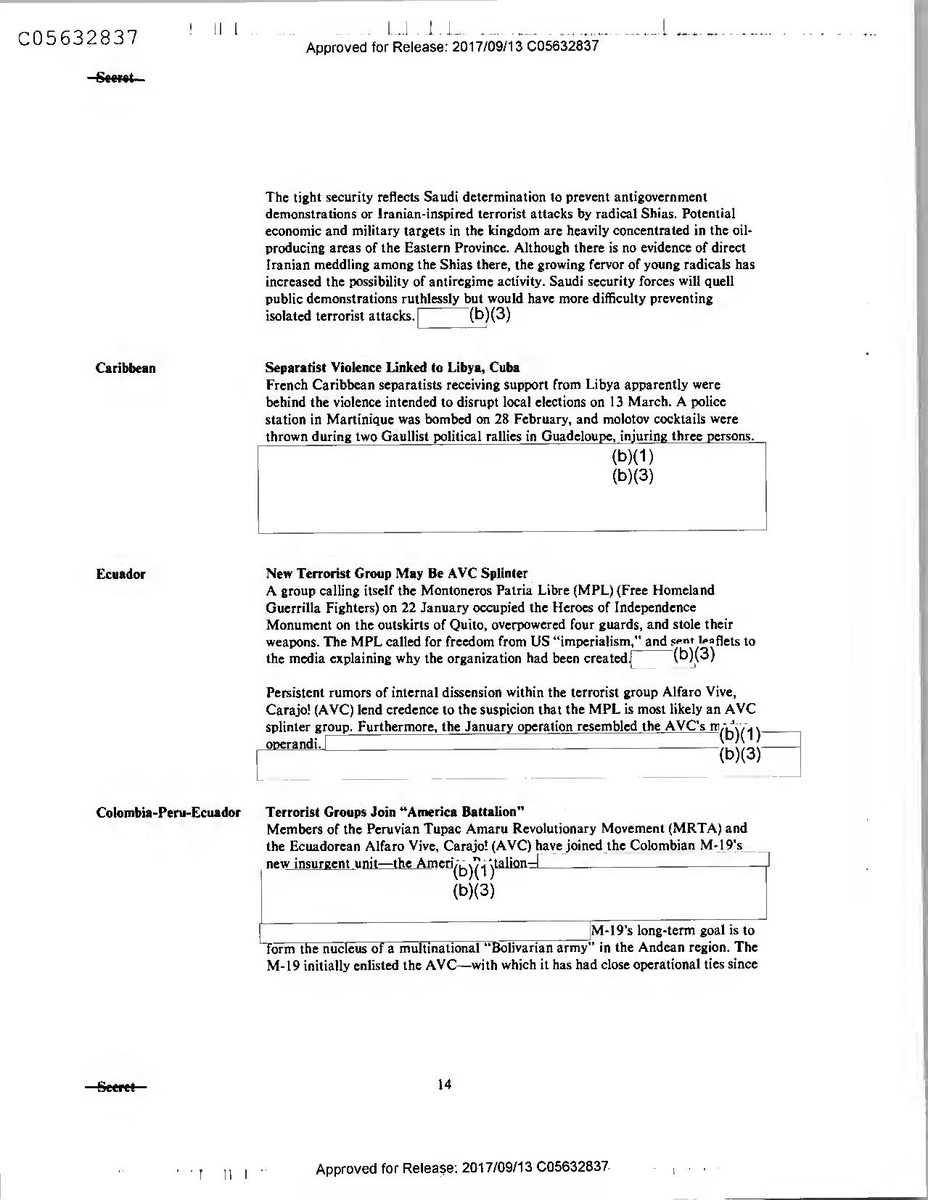
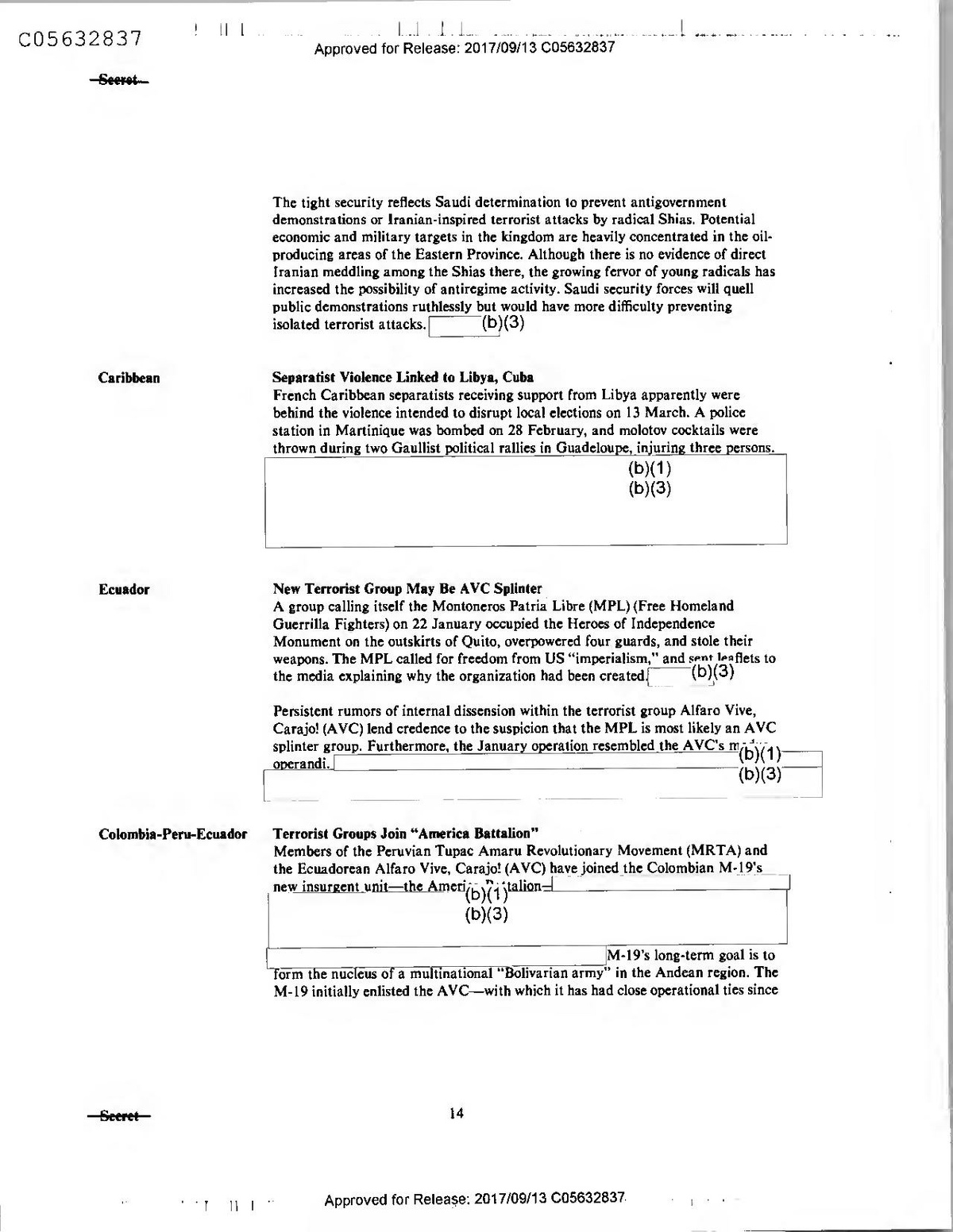
Secret
The tight security reflects Saudi determination to prevent antigovernment demonstrations or Iranian-inspired terrorist attacks by radical Shias. Potential economic and military targets in the kingdom are heavily concentrated in the oilproducing areas of the Eastern Province. Although there is no evidence of direct Iranian meddling among the Shias there, the growing fervor of young radicals has increased the possibility of antiregime activity. Saudi security forces will quell public demonstrations ruthlessly but would have more difficulty preventing isolated terrorist attacks. (b)(3)
Caribbean
Separatist Violence Linked to Libya, Cuba French Caribbean separatists receiving support from Libya apparently were behind the violence intended to disrupt local elections on 13 March. A police station in Martinique was bombed on 28 February, and molotov cocktails were thrown during two Gaullist political rallies in Guadeloupe, injuring three persons.
(b)(1) (b)(3)
Ecuador
New Terrorist Group May Be AVC Splinter A group calling itself the Montoneros Patria Libre (MPL) (Free Homeland Guerrilla Fighters) on 22 January occupied the Heroes of Independence Monument on the outskirts of Quito, overpowered four guards, and stole their weapons. The MPL called for freedom from US “imperialism,” and sent leaflets to the media explaining why the organization had been created. F(b)(3)
Persistent rumors of internal dissension within the terrorist group Alfaro Vive, Carajo! (AVC) lend credence to the suspicion that the MPL is most likely an AVC
splinter group. Furthermore, the January operation resembled the AVC's Mb)(1).
(b)(3)
operandi. I
Colombia-Peru-Ecuador
Terrorist Groups Join “America Battalion" Members of the Peruvian Tupac Amaru Revolutionary Movement (MRTA) and the Ecuadorean Alfaro Vive, Carajo! (AVC) have joined the Colombian M-19's
new insurgent unit—the
Ameri(b){ijtalion!
(b)(3)
M-19's long-term goal is to form the nucleus of a multinational “Bolivarian army" in the Andean region. The M-19 initially enlisted the AVC—with which it has had close operational ties since
Seeret
14
|||
Approved for Release: 2017/09/13 C05632837.
March
Spain: Two masked gunmen seriously wound Spanish Army lieutenant as he is driving to work in Vitoria. No group claimed responsibility for the attimot the police suspect the Basque Fatherland and Liberty organization.
"(b)(3)
Spain: Six French-manufactured vehicles set on fire in various parts of Barcelona. The arson attacks followed the arrival on 7 March of the body of Basque Fatherland and Liberty organization leader Txomin, who was killed in a car crash in Algeria on 27 February.
(b)(3)
+
March
Colombia: Members of the National Liberation Army abduct Canadian oil engineer in Arauca Province. The victim is an employee of the US-owned firm
Occidental Petroleum, and the incident marks the first such kidnaping this year. (b)(3)
26
Approved for Release: 2017/09/13 C05922886
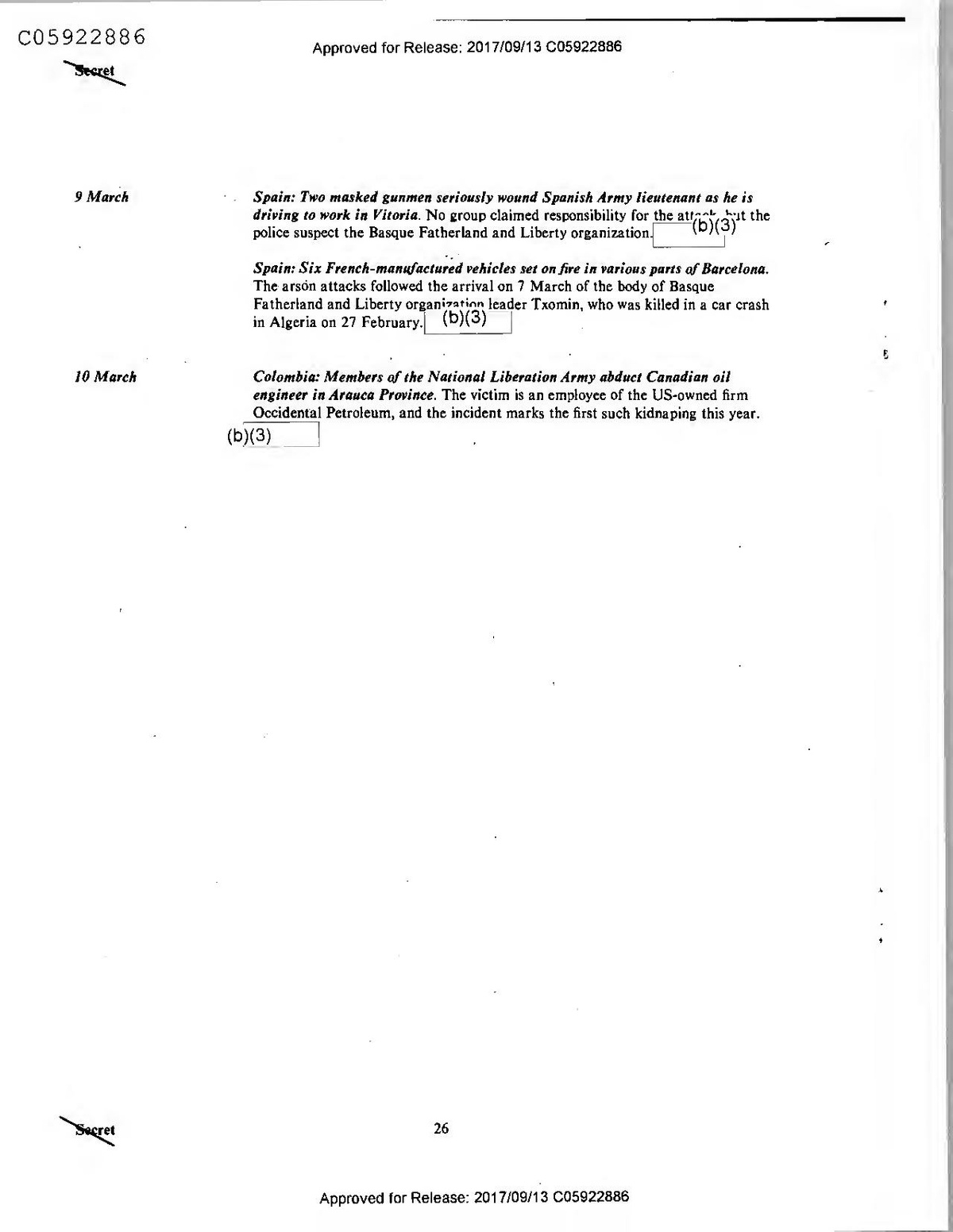
March
Spain: Two masked gunmen seriously wound Spanish Army lieutenant as he is driving to work in Vitoria. No group claimed responsibility for the attimot the police suspect the Basque Fatherland and Liberty organization.
"(b)(3)
Spain: Six French-manufactured vehicles set on fire in various parts of Barcelona. The arson attacks followed the arrival on 7 March of the body of Basque Fatherland and Liberty organization leader Txomin, who was killed in a car crash in Algeria on 27 February.
(b)(3)
+
March
Colombia: Members of the National Liberation Army abduct Canadian oil engineer in Arauca Province. The victim is an employee of the US-owned firm
Occidental Petroleum, and the incident marks the first such kidnaping this year. (b)(3)
26
Approved for Release: 2017/09/13 C05922886
l
v
o
Secret
Approved for Release: 2017/09/13 C05922886
l
v
o
Secret
Approved for Release: 2017/09/13 C05922886
Central Intelligencer geno(b)(3).
FILE
FIRE
DENSO
Washington, DC 20505
3-11-88 NO_EUR M 88-200415
3
DIRECTORATE OF INTELLIGENCE
&PD
4 March 1988
(b)(3)
Sweden's Bofors Arms Scandal: A Summary of the Diversions, investigations, and Implications
Summary
The lingering Bofors AB and Nobel Kemi AB arms scandals, which first came to light in 1984, owe to the failure of Sweden's private and public sector
leaders to observe their own rules governing 96)(3)?xports in an apparent
effort to bolster the domestic arms industry.
Numerous investigations were initiated to examine the complex web of bribery and arms diversions but, despite an admission from a key industry executive, only two individuals have been charged with violating Swedish law: a Nobel Kemi manager and a private arms trader. Stockholm has since called off the investigation of Bofors' bribery, probably in an effort to prevent future revelations of bribes to Indian officials that could embarrass Prime Minister Gandhi. Sidelights to the affair include the mysterious death of a customs official, a possible Iranian connection tothomurder of Olof Palme, and a surge in Swedish investigative journalism.
(b)(3)
The scandal is likely to lead to a tightening of Swedish arms export restrictions in the near term, but little change in practice in the long term given Sweden's commitment to maintaining its own arms industry. While the affair will almost certainly benefit the Greens in the September 1988 election, neither Prime Minister Ingvar Carlsson nor the mainstream socialist and nonsocialist parties are likely to be seriously harmed by the scandal since all are culpable and will therefore refrain from making it a partisan political issue. (b)(3)
(b)(3) This paper was prepared byl
West European Division, Office of European Analysis. Information available as of 3 March 1988 was used in its preparation. Comments are welcome and may be directed to the Chief, West European Division, EURA,
(b)(3jueries
EURM 88-20045
(b)(3)
(b)(3) CONFIDENTIAL Approved for Release: 2017/09/13 C06141809
--
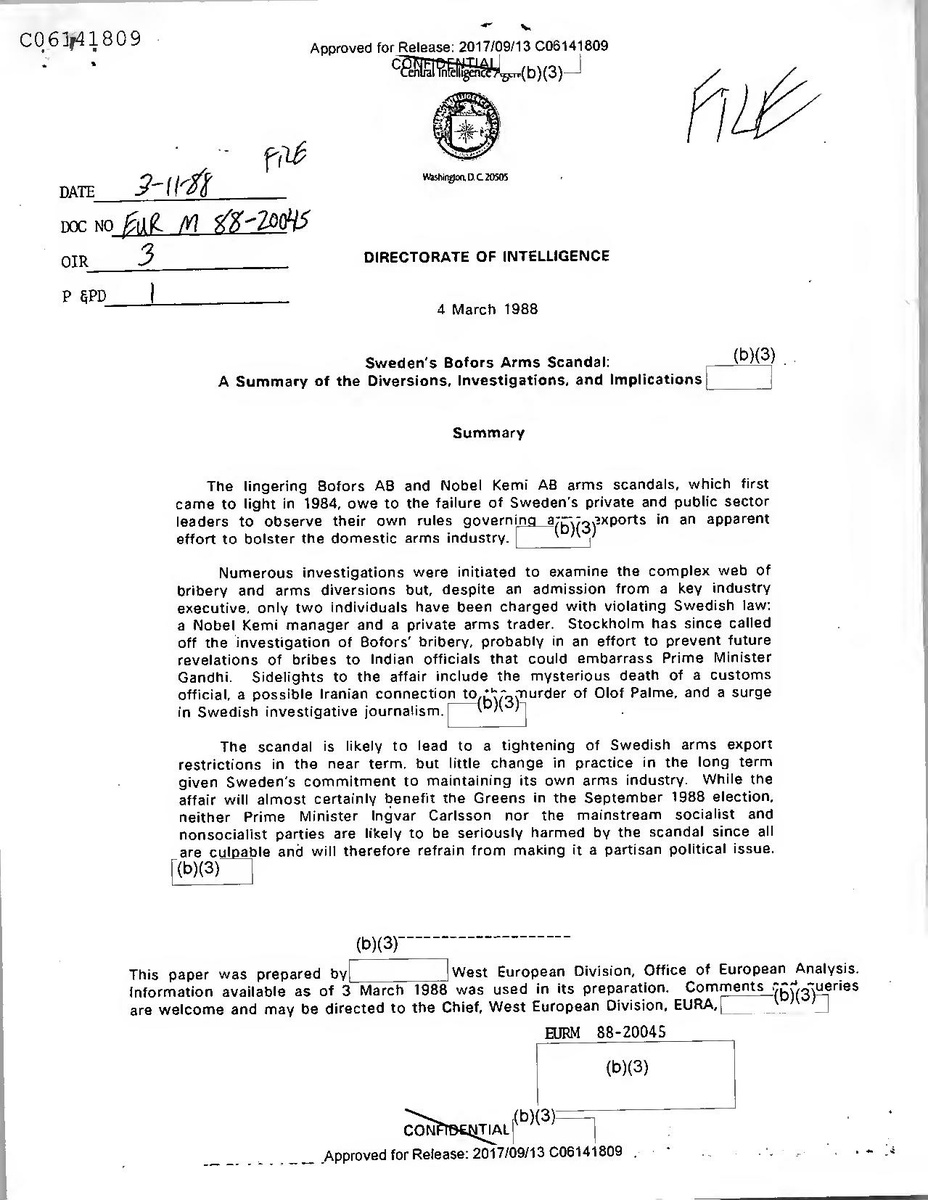
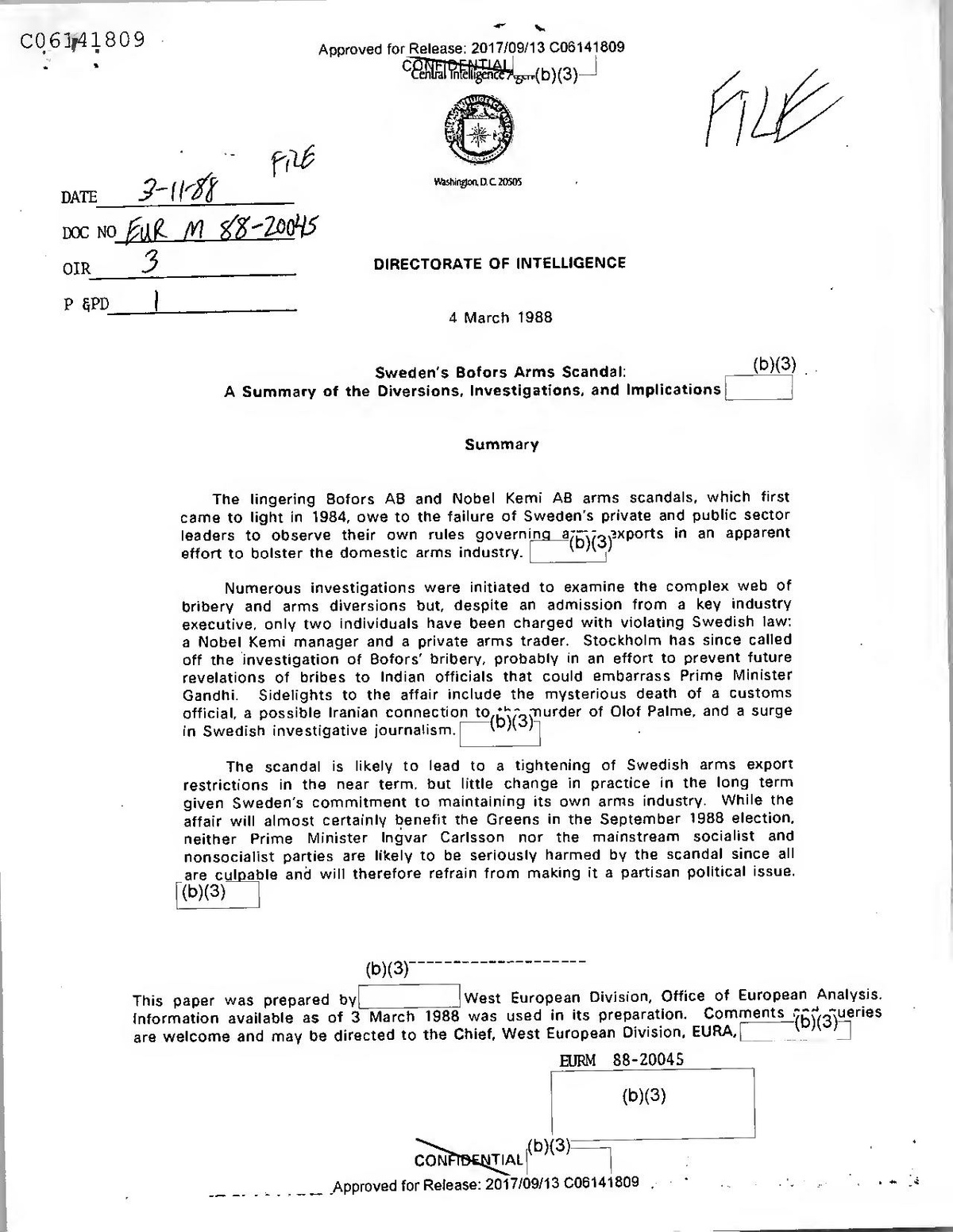
Central Intelligencer geno(b)(3).
FILE
FIRE
DENSO
Washington, DC 20505
3-11-88 NO_EUR M 88-200415
3
DIRECTORATE OF INTELLIGENCE
&PD
4 March 1988
(b)(3)
Sweden's Bofors Arms Scandal: A Summary of the Diversions, investigations, and Implications
Summary
The lingering Bofors AB and Nobel Kemi AB arms scandals, which first came to light in 1984, owe to the failure of Sweden's private and public sector
leaders to observe their own rules governing 96)(3)?xports in an apparent
effort to bolster the domestic arms industry.
Numerous investigations were initiated to examine the complex web of bribery and arms diversions but, despite an admission from a key industry executive, only two individuals have been charged with violating Swedish law: a Nobel Kemi manager and a private arms trader. Stockholm has since called off the investigation of Bofors' bribery, probably in an effort to prevent future revelations of bribes to Indian officials that could embarrass Prime Minister Gandhi. Sidelights to the affair include the mysterious death of a customs official, a possible Iranian connection tothomurder of Olof Palme, and a surge in Swedish investigative journalism.
(b)(3)
The scandal is likely to lead to a tightening of Swedish arms export restrictions in the near term, but little change in practice in the long term given Sweden's commitment to maintaining its own arms industry. While the affair will almost certainly benefit the Greens in the September 1988 election, neither Prime Minister Ingvar Carlsson nor the mainstream socialist and nonsocialist parties are likely to be seriously harmed by the scandal since all are culpable and will therefore refrain from making it a partisan political issue. (b)(3)
(b)(3) This paper was prepared byl
West European Division, Office of European Analysis. Information available as of 3 March 1988 was used in its preparation. Comments are welcome and may be directed to the Chief, West European Division, EURA,
(b)(3jueries
EURM 88-20045
(b)(3)
(b)(3) CONFIDENTIAL Approved for Release: 2017/09/13 C06141809
--
The Diversions
The Bofors AB and Nobel Kemi AB cases involve a number of business transactions in which Swedish arms manufacturing executives deliberately violated or circumvented prohibitions on arms sales to belligerents and on bribes to foreign officials. These include:
Bofors AB selling over 300 RBS-70 missile systems to Bahrain and Dubai via Singapore in 1979. (The RBS-70 contains two US components: a gyroscope and a thermal battery.).
Bofors selling 22 anti-aircraft guns to Thailand via Singapore in 1985.
Bofors selling ammunition to Oman via Italy.
Bofors allegedly selling RBS-70s to Iran via Singapore.
--
Bofors allegedly bribing Indian middlemen and officials in connection with New Delhi's $1.5 billion purchase of 155mm howitzers.
Bofors allegedly bribing an official in Singapore in connection with arms resales to other countries.
Bofors allegedly selling naval ordnance to Taiwan.
Bofors allegedly selling explosives to East Germany via Austria.
Nobel Kemi AB--a subsidiary of Bofors--selling 2139 metric tons of munitions to Iran, Iraq, Syria, Egypt and Burma via Austria, East Germany, Italy, and Yugoslavia, with approximately two-thirds of these munitions going to Tehran.
Private Swedish businessman Karl-Erik Schmitz acting as an international broker for arms sales to proscribed countries, including sales involving Swedish-produced weapons.
(b)(3)
The Investigations
Since reports of the diversions began to spread in 1984--through a tip from former Bofors employee Ingvar Bratt to the Swedish Peace and Arbitration Association--a number of official inquiries have been initiated. Few of these have produced any tangible results. In approximate order of inception, the investigations are:
County Prosecutor: Stig Age, the Prosecutor from Orebro County--where Bofors is located--began pulling together a case against the arms producer in 1984. He has not yet taken his findings against Bofors to court because new evidence continues to surface--even though Anders Carlberg, the head of Bofors' parent company, Nobel Industries, admitted in March 1987 that top Bofors executives Claes-Erik Winberg and Martin Ardbo deliberately skirted
2
(b)(3)
CONFIDENTIAL
Approved for Release: 2017/09/13 C06141809
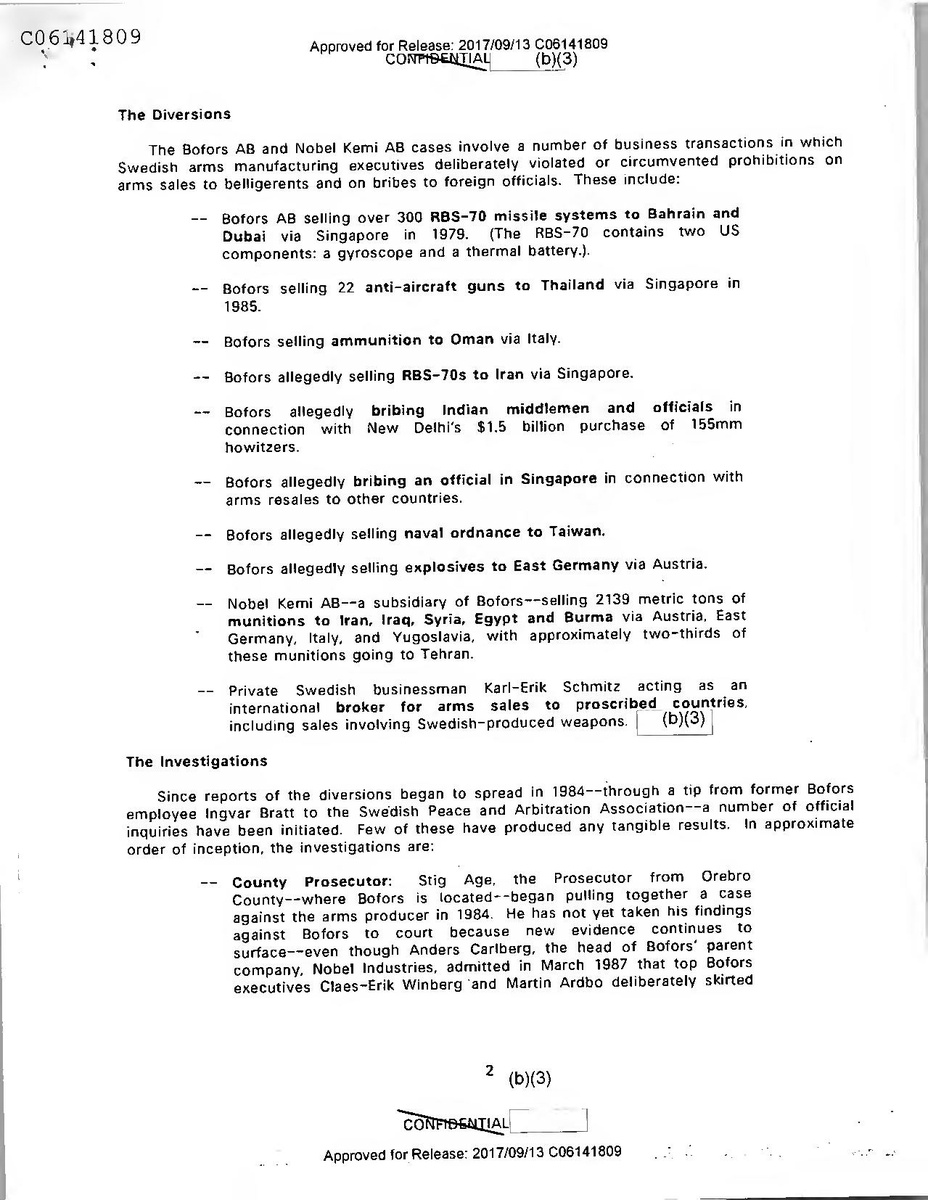
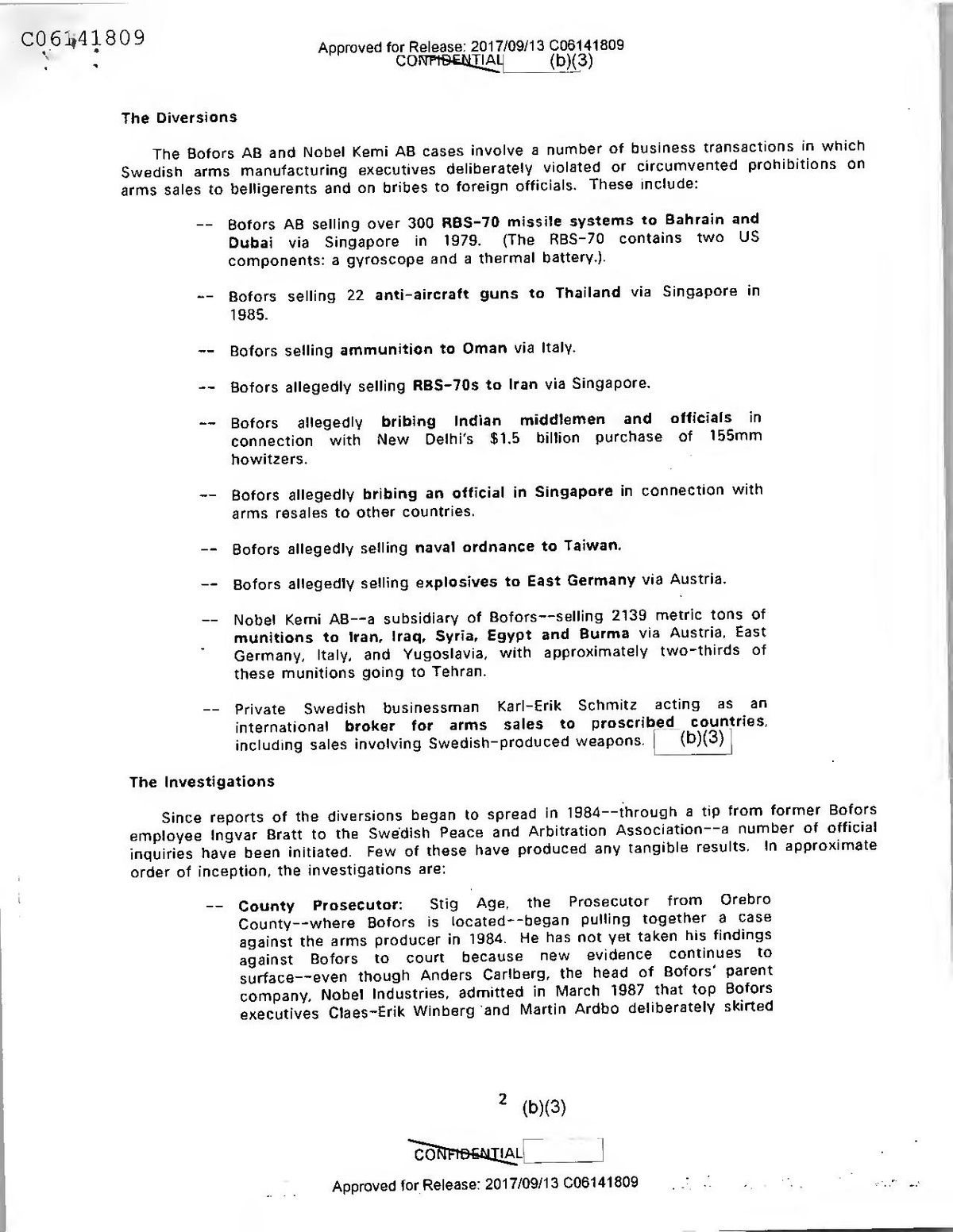
The Diversions
The Bofors AB and Nobel Kemi AB cases involve a number of business transactions in which Swedish arms manufacturing executives deliberately violated or circumvented prohibitions on arms sales to belligerents and on bribes to foreign officials. These include:
Bofors AB selling over 300 RBS-70 missile systems to Bahrain and Dubai via Singapore in 1979. (The RBS-70 contains two US components: a gyroscope and a thermal battery.).
Bofors selling 22 anti-aircraft guns to Thailand via Singapore in 1985.
Bofors selling ammunition to Oman via Italy.
Bofors allegedly selling RBS-70s to Iran via Singapore.
--
Bofors allegedly bribing Indian middlemen and officials in connection with New Delhi's $1.5 billion purchase of 155mm howitzers.
Bofors allegedly bribing an official in Singapore in connection with arms resales to other countries.
Bofors allegedly selling naval ordnance to Taiwan.
Bofors allegedly selling explosives to East Germany via Austria.
Nobel Kemi AB--a subsidiary of Bofors--selling 2139 metric tons of munitions to Iran, Iraq, Syria, Egypt and Burma via Austria, East Germany, Italy, and Yugoslavia, with approximately two-thirds of these munitions going to Tehran.
Private Swedish businessman Karl-Erik Schmitz acting as an international broker for arms sales to proscribed countries, including sales involving Swedish-produced weapons.
(b)(3)
The Investigations
Since reports of the diversions began to spread in 1984--through a tip from former Bofors employee Ingvar Bratt to the Swedish Peace and Arbitration Association--a number of official inquiries have been initiated. Few of these have produced any tangible results. In approximate order of inception, the investigations are:
County Prosecutor: Stig Age, the Prosecutor from Orebro County--where Bofors is located--began pulling together a case against the arms producer in 1984. He has not yet taken his findings against Bofors to court because new evidence continues to surface--even though Anders Carlberg, the head of Bofors' parent company, Nobel Industries, admitted in March 1987 that top Bofors executives Claes-Erik Winberg and Martin Ardbo deliberately skirted
2
(b)(3)
CONFIDENTIAL
Approved for Release: 2017/09/13 C06141809
Swedish law. Age is also responsible for prosecution in the case of illegal arms sales by Nobel Kemi--a Bofors subsidiary. In June 1987 he charged Karl-Erik Schmitz--a private arms trader--and former Nobel Kemi executive Mats Lundborg with illegal arms trafficking. No further details of court proceedings have been reported.
Police Investigations: Swedish police are conducting separate investigations into Bofors' and Nobel Kemi's arms sales to support Age in developing the court cases.
Constitutional Committee: Because the Bofors case raised the possibility that government officials permitted illegal arms sales, the "Constitutional Affairs Committee"--made up of prominent Members of Parliament--began to oversee the Bofors and Nobel Kemi investigations. This is the same Committee that is overseeing the Palme murder investigation. Minister of Agriculture Mats Hellstrom was criticized by the Committee in May 1987 for misrepresenting facts surrounding Sweden's arms sales to Indonesia during his tenure (1982-1986) as Minister for Foreign Trade.
Parliamentary Arms Export Commission: In February 1985 a special commission was established to report on arms export issues to parliament and provide guidance to the arms industry.
Advisory Committee: The government established a separate committee of experts to recommend revisions in Swedish arms export laws that would provide for tighter enforcement. The recommendations were presented to the Social Democratic Cabinet in June 1987, but have not yet been formally presented to parliament.
National Audit: As the police investigations revealed that Bofors may have bribed Indian middlemen and officials, the Swedish equivalent of the GAO conducted a national audit of Bofors' transactions with India. The audit, completed in June 1987, indicated that as much as $40 million were paid in commissions to middlemen. Because the information was taken from Central Bank records, the exact amounts and recipients were not made public by the government. Bofors rejected the government's request to reveal this information, claiming such disclosure would jeopardize its credibility as an arms dealer. Both the government and Bofors have asserted, however, that the payments were made to close contracts with middlemen once Indian authorities insisted on excluding intermediaries, rather than as pay-offs to Indian officials.
Citizens Committee: in order to bolster
the
credibility of Stockholm's account of the bribery case, a "citizens committee" was established to review the classified documents of the Bofors audit and determine whether the government was presenting an accurate picture. This committee has not yet submitted its findings.
3
(b)(3).
CONFIDENTIAL
Approved for Release: 2017/09/13 C06141809
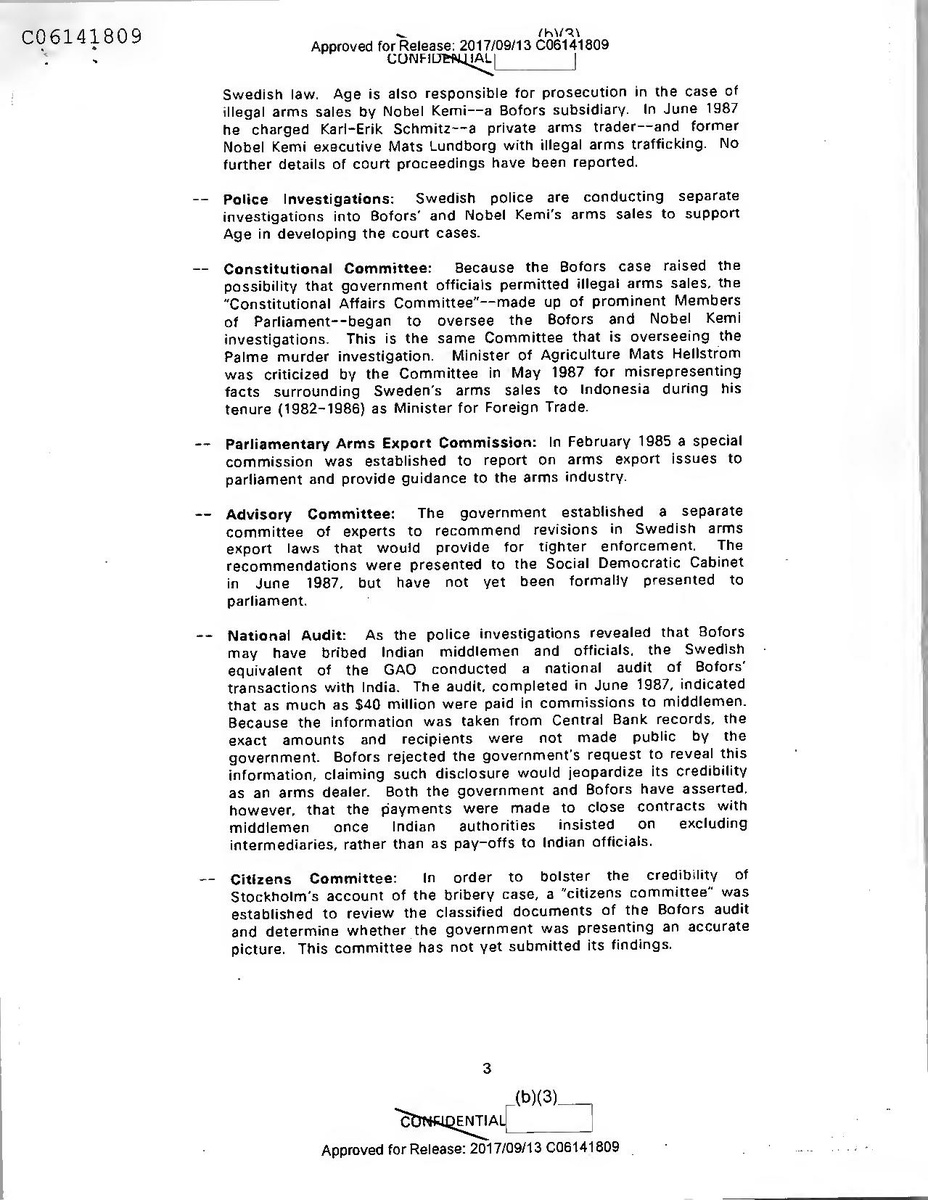
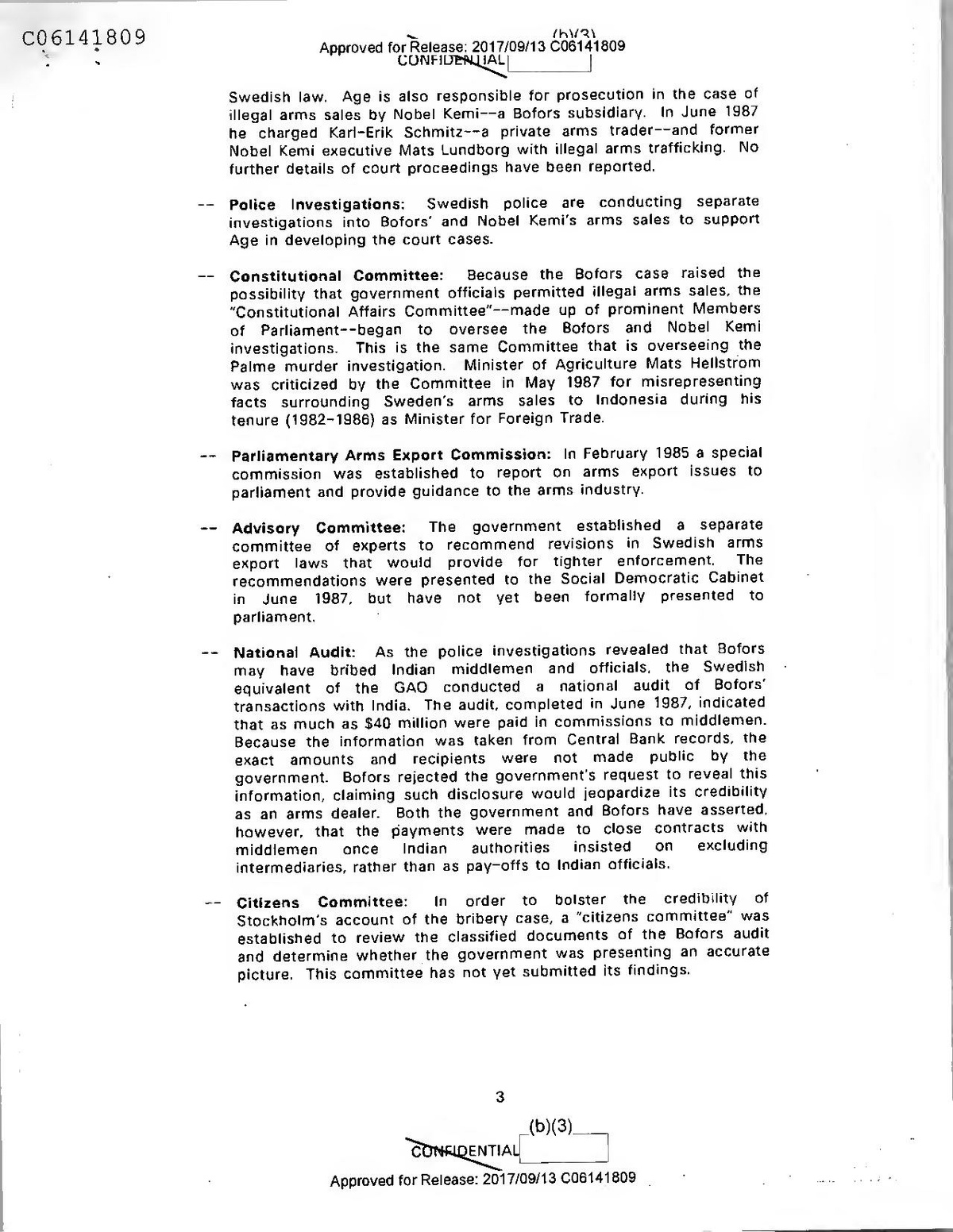
Swedish law. Age is also responsible for prosecution in the case of illegal arms sales by Nobel Kemi--a Bofors subsidiary. In June 1987 he charged Karl-Erik Schmitz--a private arms trader--and former Nobel Kemi executive Mats Lundborg with illegal arms trafficking. No further details of court proceedings have been reported.
Police Investigations: Swedish police are conducting separate investigations into Bofors' and Nobel Kemi's arms sales to support Age in developing the court cases.
Constitutional Committee: Because the Bofors case raised the possibility that government officials permitted illegal arms sales, the "Constitutional Affairs Committee"--made up of prominent Members of Parliament--began to oversee the Bofors and Nobel Kemi investigations. This is the same Committee that is overseeing the Palme murder investigation. Minister of Agriculture Mats Hellstrom was criticized by the Committee in May 1987 for misrepresenting facts surrounding Sweden's arms sales to Indonesia during his tenure (1982-1986) as Minister for Foreign Trade.
Parliamentary Arms Export Commission: In February 1985 a special commission was established to report on arms export issues to parliament and provide guidance to the arms industry.
Advisory Committee: The government established a separate committee of experts to recommend revisions in Swedish arms export laws that would provide for tighter enforcement. The recommendations were presented to the Social Democratic Cabinet in June 1987, but have not yet been formally presented to parliament.
National Audit: As the police investigations revealed that Bofors may have bribed Indian middlemen and officials, the Swedish equivalent of the GAO conducted a national audit of Bofors' transactions with India. The audit, completed in June 1987, indicated that as much as $40 million were paid in commissions to middlemen. Because the information was taken from Central Bank records, the exact amounts and recipients were not made public by the government. Bofors rejected the government's request to reveal this information, claiming such disclosure would jeopardize its credibility as an arms dealer. Both the government and Bofors have asserted, however, that the payments were made to close contracts with middlemen once Indian authorities insisted on excluding intermediaries, rather than as pay-offs to Indian officials.
Citizens Committee: in order to bolster
the
credibility of Stockholm's account of the bribery case, a "citizens committee" was established to review the classified documents of the Bofors audit and determine whether the government was presenting an accurate picture. This committee has not yet submitted its findings.
3
(b)(3).
CONFIDENTIAL
Approved for Release: 2017/09/13 C06141809
Bofors bribery: Following the national audit, Swedish police launched a separate investigation into Bofors bribery, which would have been illegal if payments were made to foreign officials. This investigation was terminated in late January 1988, following a trip by Indian Prime Minister Gandhi to Stockholm. Sweden claimed inability to track the payments through Swiss bank accounts after making a half-hearted request for Swiss assistance.
Indian inquiry: .The Indian government initiated its own parliamentary investigation into the possible use of payoffs to middlemen or government officials.
Singapore inquiry. Singapore--a key transshipment point in the Bofors saga--also launched a bribery investigation and charged Tan Kok Cheng, former general manager of Allied Ordnance Singapore, with accepting over $1 million in bribes from Bofors while working on behalf of Singapore's armed forces. (Bofors owned 40 percent of Allied Ordnance at the time of the transactions.)
MFA Demarche: In support of the ongoing police investigations, the Swedish Foreign Ministry requested its Embassies abroad to ask host governments for permission to inspect their arms inventories in an apparent effort to look for Bofors equipment that may have been delivered in as yet undetected diversions. (b)(3)
1
Notable Sidelights
Beyond the diversions and investigations themselves, several other incidents may be related to the Bofors affair.
Algernon's death: War Materiel Inspector Carl Algernon--the customs official responsible for monitoring arms exports--died when he was struck by a subway train in January 1987. He had met 30 minutes earlier with Anders Carlberg, head of
Bofors' parent company. Nobel Industries. Algernon was a personal friend of former Bofors directors Claes-Erik Winberg and Martin Ardbo. Police believe he committed suicide, but accidental death and murder remain possibilities.
Did Iranians Murder Palme? US media speculated in March 1987 that Olof Palme was murdered by an Iranian hitman in retaliation for Palme's alleged suspension of an arms shipment to Tehran.
The media further contended that Algernon was killed because he intended to make public the illicit activities of Swedish arms producers and government officials. Swedish investigators consider this thesis unlikely, and it received little further notice until revived by US journalists in December 1987.
Press Activism: The US press article on the Iranian connection--written quickly in Sweden using local sources--embarrassed the Swedish press, which had failed to turn
4
(b)(3) CONFIDENTIAL
..
Approved for Release: 2017/09/13 C06141809
.
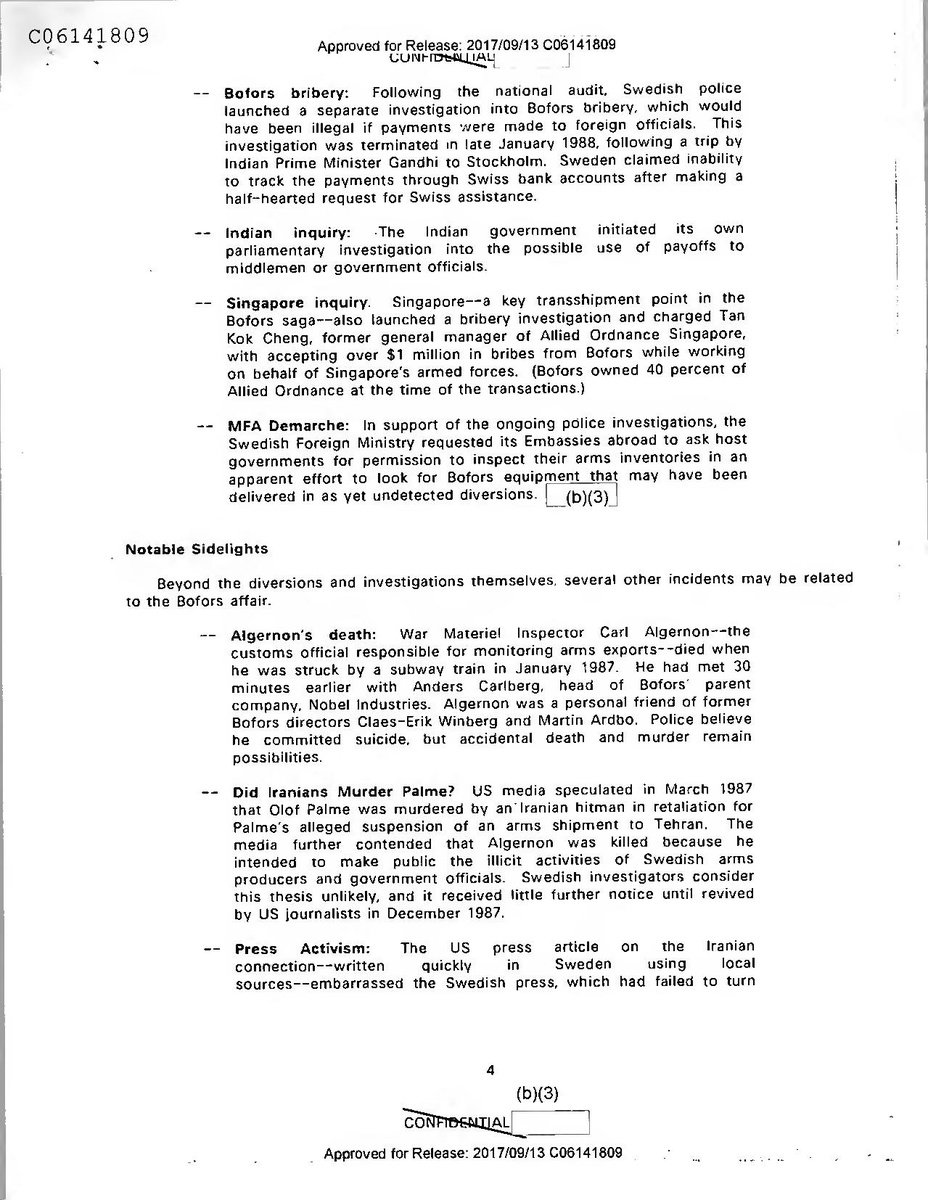
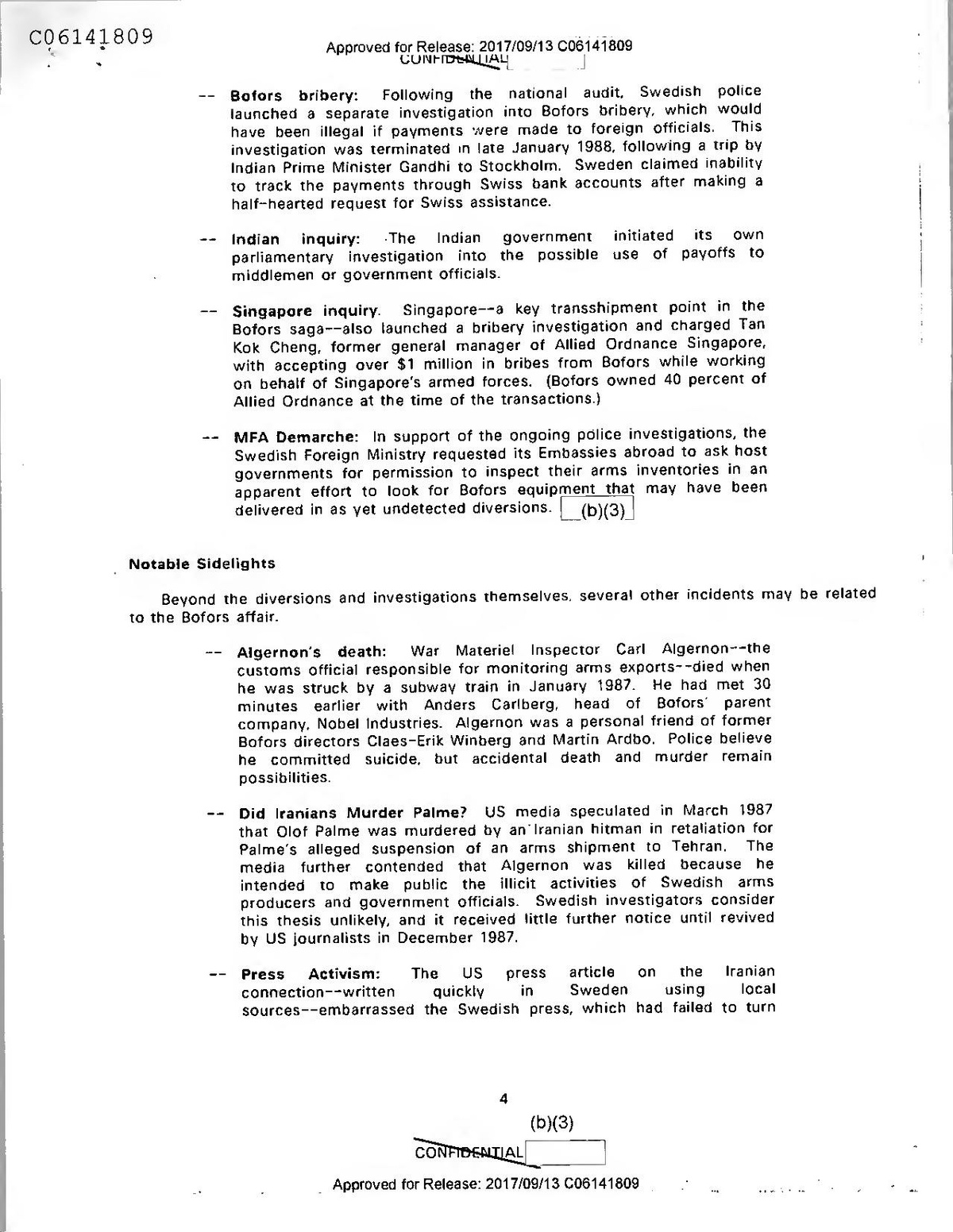
Bofors bribery: Following the national audit, Swedish police launched a separate investigation into Bofors bribery, which would have been illegal if payments were made to foreign officials. This investigation was terminated in late January 1988, following a trip by Indian Prime Minister Gandhi to Stockholm. Sweden claimed inability to track the payments through Swiss bank accounts after making a half-hearted request for Swiss assistance.
Indian inquiry: .The Indian government initiated its own parliamentary investigation into the possible use of payoffs to middlemen or government officials.
Singapore inquiry. Singapore--a key transshipment point in the Bofors saga--also launched a bribery investigation and charged Tan Kok Cheng, former general manager of Allied Ordnance Singapore, with accepting over $1 million in bribes from Bofors while working on behalf of Singapore's armed forces. (Bofors owned 40 percent of Allied Ordnance at the time of the transactions.)
MFA Demarche: In support of the ongoing police investigations, the Swedish Foreign Ministry requested its Embassies abroad to ask host governments for permission to inspect their arms inventories in an apparent effort to look for Bofors equipment that may have been delivered in as yet undetected diversions. (b)(3)
1
Notable Sidelights
Beyond the diversions and investigations themselves, several other incidents may be related to the Bofors affair.
Algernon's death: War Materiel Inspector Carl Algernon--the customs official responsible for monitoring arms exports--died when he was struck by a subway train in January 1987. He had met 30 minutes earlier with Anders Carlberg, head of
Bofors' parent company. Nobel Industries. Algernon was a personal friend of former Bofors directors Claes-Erik Winberg and Martin Ardbo. Police believe he committed suicide, but accidental death and murder remain possibilities.
Did Iranians Murder Palme? US media speculated in March 1987 that Olof Palme was murdered by an Iranian hitman in retaliation for Palme's alleged suspension of an arms shipment to Tehran.
The media further contended that Algernon was killed because he intended to make public the illicit activities of Swedish arms producers and government officials. Swedish investigators consider this thesis unlikely, and it received little further notice until revived by US journalists in December 1987.
Press Activism: The US press article on the Iranian connection--written quickly in Sweden using local sources--embarrassed the Swedish press, which had failed to turn
4
(b)(3) CONFIDENTIAL
..
Approved for Release: 2017/09/13 C06141809
.
up the story in a year of investigative reporting following Palme's death. Since this episode, Sweden's media have doggedly reported
every lead and angle in the Bofors case, no matter how insignificant
on
Export Ban: Swedish arms sales to Singapore--the number-one importer of Swedish weapons from 1977-1986--were banned for a brinqriod in 1985 and have again been banned since early 1987.
(b)(3)
Filling in the Gaps
There is little evidence on which to construct an accurate picture of what actually occured in the Bofors scandal. We believe the following scenario is the most plausible, but we must emphasize that it is only speculation and that other scenarios are quite possible.
Sell them anyway:
Swedish arms manufacturers, experiencing financial difficulties in the late 1970s and early 1980s, determined they needed to sell arms to proscribed countries in order to remain financially viable. Government officials acquiesced, concerned that Swedish military reliance on foreign arms suppliers--instead of domestic producers--would undermine Sweden's policy of neutrality. Moveover, officials feared that low export levels would
lead to lay-offs in the already ailing region of central Sweden where most arms manufacturers are located.
Damage control: When former Bofors employee Ingvar Bratt provided information to
the
Peace and Arbitration Society, government officials attempted to preempt criticism of their past acceptance of questionable arms deals by claiming they had just learned of Bofors' activities and were beginning an investigation. Bofors was intended to serve as a scapegoat company that had circumvented--but not broken--Swedish law, and no one would be arrested.
Breakdown: As the Bofors investigation plodded along at a pace designed to dampen public interest in the case, new information continued to surface about potentially illegal transactions conducted by Bofors and its subsidiary, Nobel Kemi. The Peace and Arbitration Society kept the case in the public eye. Hoping to defuse the public outcry over the case, Bofors Chairman Winberg--and, later, his successor, Ardbo--resigned. Nobel Industries' takeover of Bofors in 1985 also failed to put the perception of scandal to rest. The government began to lose control of the case.
--
Resurrection: Anders Carlberg, head of Nobel Industries, insisted on a new approach Bofors would still be blamed for using third countries to reexport weapons. Nobel Kemi executive Mats Lundborg and private trader Karl-Erik Schmitz, moreover, would be put on trial in an effort to avoid a public outcry if no one was prosecuted. Winberg and Ardbo might also go to trial, but would be acquitted for having stayed within the letter, if not the spirit, of the law. The
5
(b)(3). CONFIDENTIAL - Approved for Release: 2017/09/13 C06141809
..
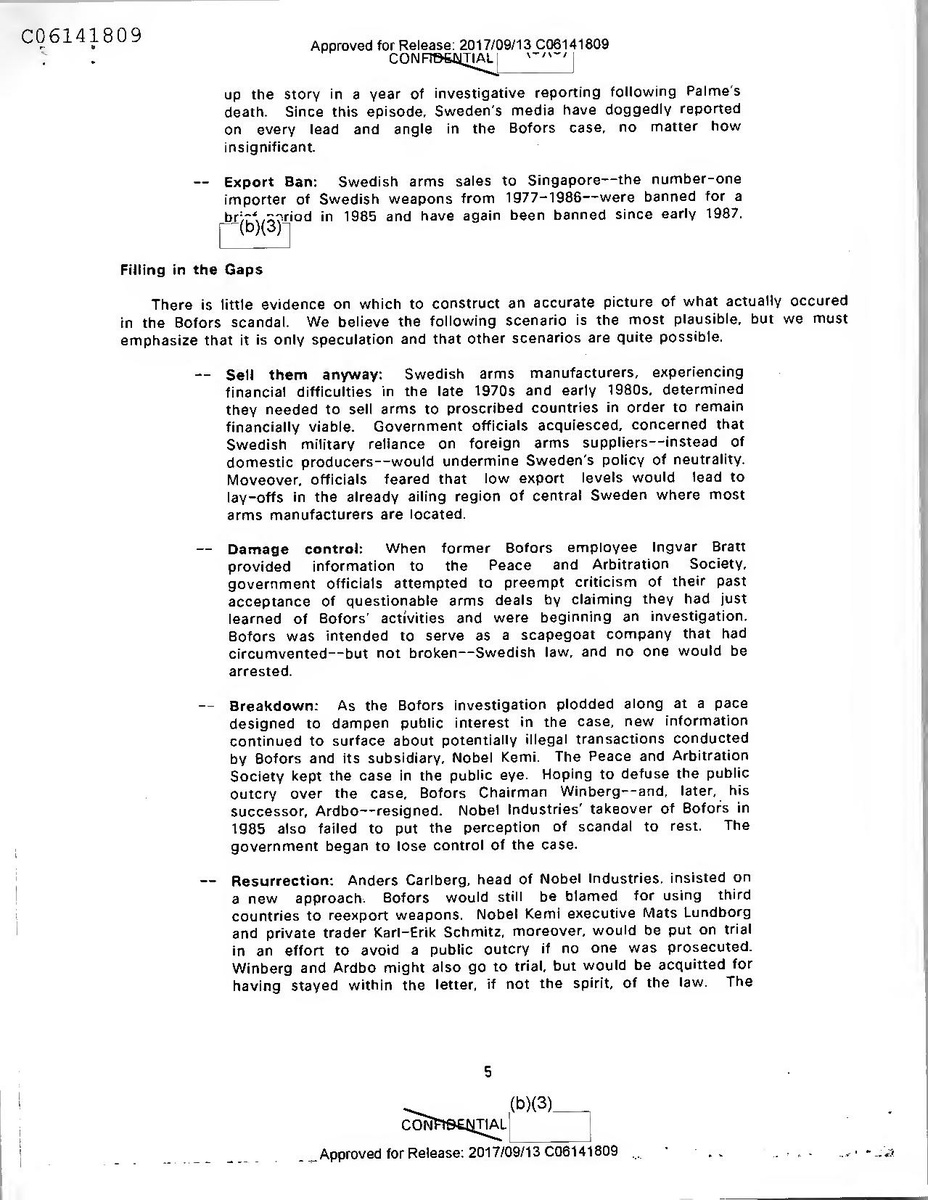
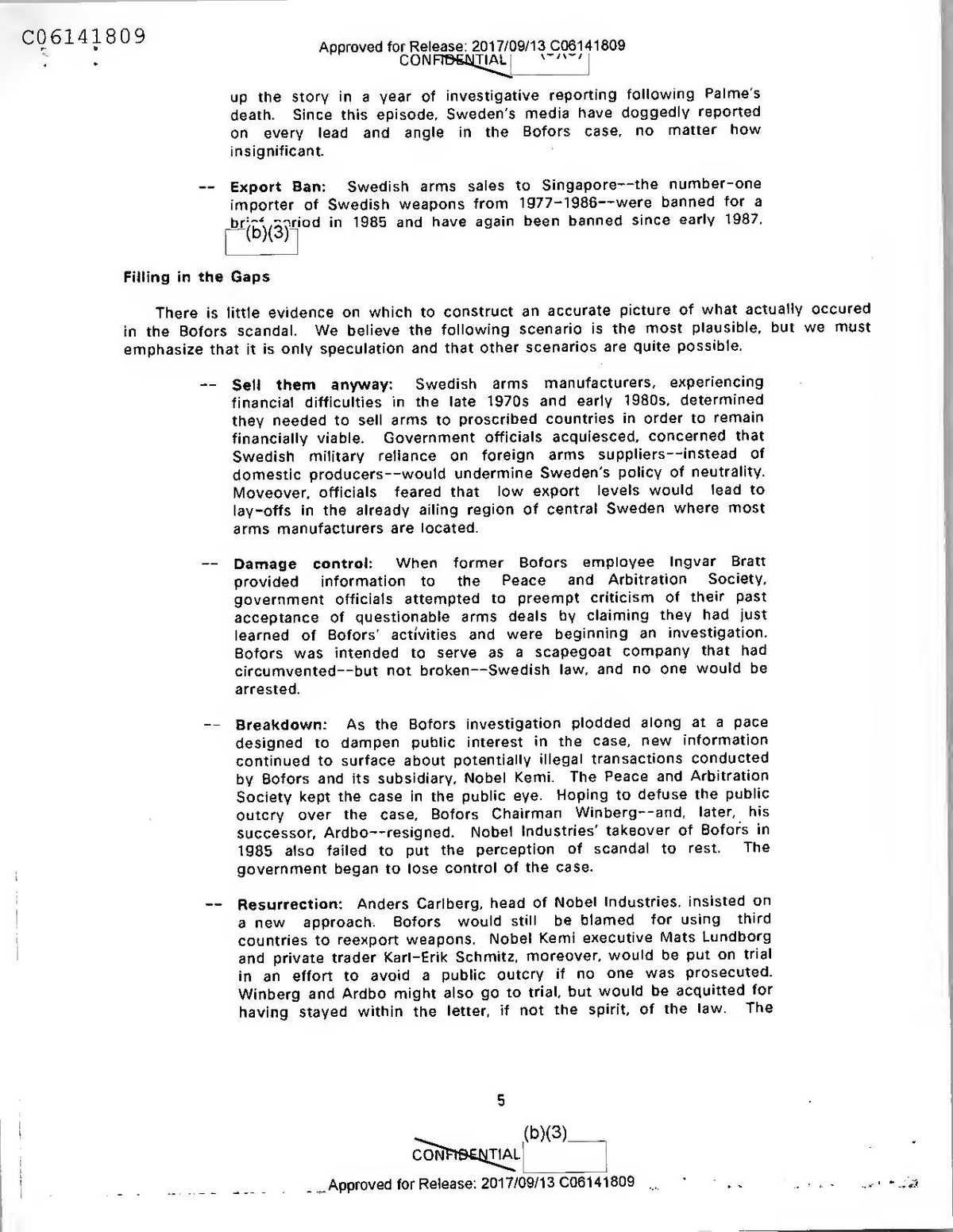
up the story in a year of investigative reporting following Palme's death. Since this episode, Sweden's media have doggedly reported
every lead and angle in the Bofors case, no matter how insignificant
on
Export Ban: Swedish arms sales to Singapore--the number-one importer of Swedish weapons from 1977-1986--were banned for a brinqriod in 1985 and have again been banned since early 1987.
(b)(3)
Filling in the Gaps
There is little evidence on which to construct an accurate picture of what actually occured in the Bofors scandal. We believe the following scenario is the most plausible, but we must emphasize that it is only speculation and that other scenarios are quite possible.
Sell them anyway:
Swedish arms manufacturers, experiencing financial difficulties in the late 1970s and early 1980s, determined they needed to sell arms to proscribed countries in order to remain financially viable. Government officials acquiesced, concerned that Swedish military reliance on foreign arms suppliers--instead of domestic producers--would undermine Sweden's policy of neutrality. Moveover, officials feared that low export levels would
lead to lay-offs in the already ailing region of central Sweden where most arms manufacturers are located.
Damage control: When former Bofors employee Ingvar Bratt provided information to
the
Peace and Arbitration Society, government officials attempted to preempt criticism of their past acceptance of questionable arms deals by claiming they had just learned of Bofors' activities and were beginning an investigation. Bofors was intended to serve as a scapegoat company that had circumvented--but not broken--Swedish law, and no one would be arrested.
Breakdown: As the Bofors investigation plodded along at a pace designed to dampen public interest in the case, new information continued to surface about potentially illegal transactions conducted by Bofors and its subsidiary, Nobel Kemi. The Peace and Arbitration Society kept the case in the public eye. Hoping to defuse the public outcry over the case, Bofors Chairman Winberg--and, later, his successor, Ardbo--resigned. Nobel Industries' takeover of Bofors in 1985 also failed to put the perception of scandal to rest. The government began to lose control of the case.
--
Resurrection: Anders Carlberg, head of Nobel Industries, insisted on a new approach Bofors would still be blamed for using third countries to reexport weapons. Nobel Kemi executive Mats Lundborg and private trader Karl-Erik Schmitz, moreover, would be put on trial in an effort to avoid a public outcry if no one was prosecuted. Winberg and Ardbo might also go to trial, but would be acquitted for having stayed within the letter, if not the spirit, of the law. The
5
(b)(3). CONFIDENTIAL - Approved for Release: 2017/09/13 C06141809
..
government would introduce legislation that would give the appearance of tremendous tightening in arms export laws, but would in fact continue to leave much to the discretion of the Cabinet. Over time, the government would reduce the number of proscribed recipients of Swedish arms exports. With Carlberg holding information on Official involvement in the illegal dealings, the government acquiesced in Carlberg's expanded strategy.
Suicide: In January 1987, Carlberg presented his strategy to Algernon--who had condoned the Bofors and Nobel Kemi transactions. Despite possible promises by Carlberg to protect him, Algernon believed the new strategy would eventually expose his failure to stop the deals arranged by Schmitz and Nobel Kemi. He probably committed suicide.
Bribery: Bofors almost certainly made payments--either straight to Indian officials, or to middlemen who in turn paid off officials--to secure the $1.2 billion sale of howitzers. Word of the pay-offs leaked, sparking domestic difficulties for Indian Prime Minister Rajiv Gandhi. Stockholm wanted to save Gandhi the troubles caused him by the Swedish leak, and Nobel Industries wanted to avoid a bribery indictment. The two sides cooperated, therefore, on a sche to keep details of the payments secranstockholm eventually called off
(b)(3) the entire bribery investigation.
Outlook
The Bofors affair is likely to have a significant short-term impact on Swedish politics and arms export practices, but little effect in the long term.
Export policy: The Advisory Committee's recommendations for revised legislation will almost certainly reach the floor of Parliament. A key variable, however, is how much discretion will be given the government in determining whether particular countries are suitable: recipients of Swedish arms. Because the opposition Conservatives are probably even more concerned about the viability of Sweden's defense industries than the ruling Social Democrats are, we suspect that the legislation finally approved in Parliament will continue to give the
government great leeway in managing arms export restrictions. The government may also propose some bureaucratic reorganization of the export enforcement apparatus to bolster its credibility in managing export policy. In the first few years under new legislation, controls will probably be tight. Over time, however, the government will probably begin to approve exports to a broader range of recipients in order to keep the arms industry afloat.
1988 Election: Having governed from 1976 to 1982--when a number of the reported arms diversions took place--the opposition parties are nearly as vulnerable as the Social Democrats to charges they condoned Bofors' and Nobel Kemi's activities. Although questions about the Social Democrats' role in the Bofors scandal will almost
6
(b)(3)
CONFIDENTIAL
Approved for Release: 2017/09/13 C06141809
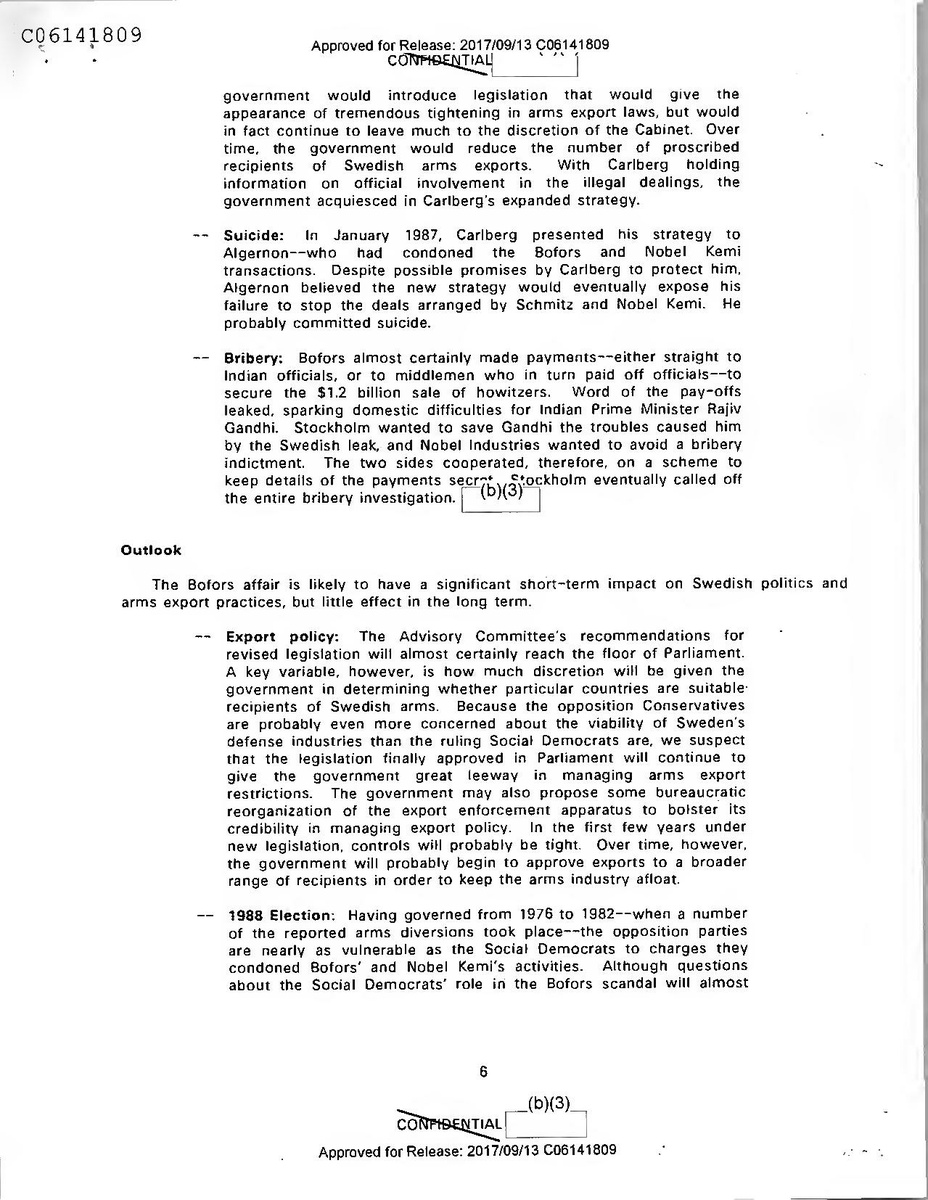
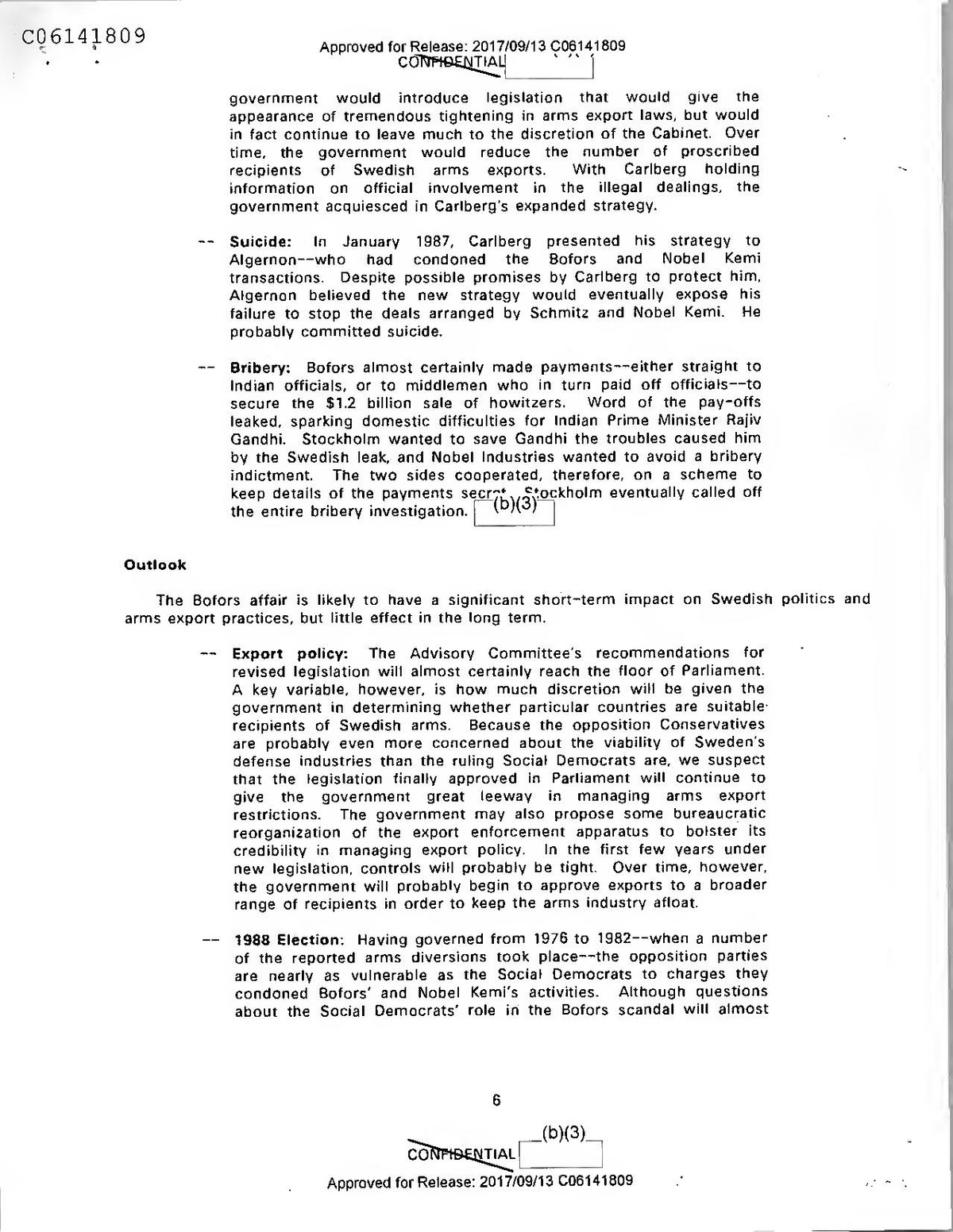
government would introduce legislation that would give the appearance of tremendous tightening in arms export laws, but would in fact continue to leave much to the discretion of the Cabinet. Over time, the government would reduce the number of proscribed recipients of Swedish arms exports. With Carlberg holding information on Official involvement in the illegal dealings, the government acquiesced in Carlberg's expanded strategy.
Suicide: In January 1987, Carlberg presented his strategy to Algernon--who had condoned the Bofors and Nobel Kemi transactions. Despite possible promises by Carlberg to protect him, Algernon believed the new strategy would eventually expose his failure to stop the deals arranged by Schmitz and Nobel Kemi. He probably committed suicide.
Bribery: Bofors almost certainly made payments--either straight to Indian officials, or to middlemen who in turn paid off officials--to secure the $1.2 billion sale of howitzers. Word of the pay-offs leaked, sparking domestic difficulties for Indian Prime Minister Rajiv Gandhi. Stockholm wanted to save Gandhi the troubles caused him by the Swedish leak, and Nobel Industries wanted to avoid a bribery indictment. The two sides cooperated, therefore, on a sche to keep details of the payments secranstockholm eventually called off
(b)(3) the entire bribery investigation.
Outlook
The Bofors affair is likely to have a significant short-term impact on Swedish politics and arms export practices, but little effect in the long term.
Export policy: The Advisory Committee's recommendations for revised legislation will almost certainly reach the floor of Parliament. A key variable, however, is how much discretion will be given the government in determining whether particular countries are suitable: recipients of Swedish arms. Because the opposition Conservatives are probably even more concerned about the viability of Sweden's defense industries than the ruling Social Democrats are, we suspect that the legislation finally approved in Parliament will continue to give the
government great leeway in managing arms export restrictions. The government may also propose some bureaucratic reorganization of the export enforcement apparatus to bolster its credibility in managing export policy. In the first few years under new legislation, controls will probably be tight. Over time, however, the government will probably begin to approve exports to a broader range of recipients in order to keep the arms industry afloat.
1988 Election: Having governed from 1976 to 1982--when a number of the reported arms diversions took place--the opposition parties are nearly as vulnerable as the Social Democrats to charges they condoned Bofors' and Nobel Kemi's activities. Although questions about the Social Democrats' role in the Bofors scandal will almost
6
(b)(3)
CONFIDENTIAL
Approved for Release: 2017/09/13 C06141809
certainly be raised in the runup to the September 1988 election, we do not expect any of the major parties to put the Bofors scandal in the forefront of its election campaign. To date, Prime Minister Ingvar Carlsson has weathered the scandal virtually unharmed.
The Greens--who are expected to win their first seats in parliament in the 1988 election--stand to gain the most from the Bofors affair by picking up support from voters disillusioned with the traditional parties and opposed to exporting arms to countries involved--or likely to become involved--in a military conflict. (b)(3)
7
(b)(3)
CONFIDENTIAL
Approved for Release: 2017/09/13 C06141809
-
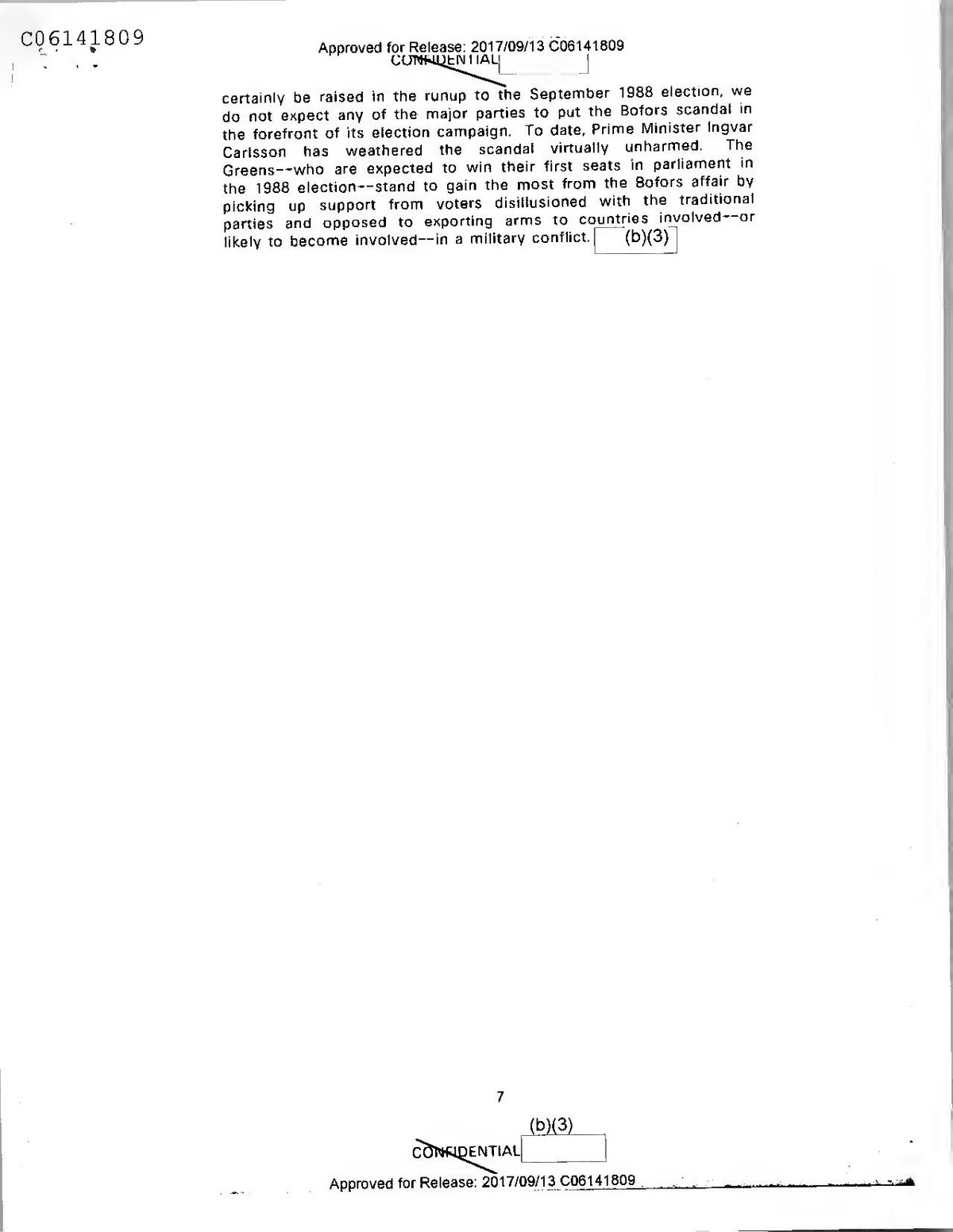
certainly be raised in the runup to the September 1988 election, we do not expect any of the major parties to put the Bofors scandal in the forefront of its election campaign. To date, Prime Minister Ingvar Carlsson has weathered the scandal virtually unharmed.
The Greens--who are expected to win their first seats in parliament in the 1988 election--stand to gain the most from the Bofors affair by picking up support from voters disillusioned with the traditional parties and opposed to exporting arms to countries involved--or likely to become involved--in a military conflict. (b)(3)
7
(b)(3)
CONFIDENTIAL
Approved for Release: 2017/09/13 C06141809
-
(b)(3)
8
(b)(3)
CONFIDENTIAL
Approved for Release: 2017/09/13 C06141809
(b)(3)
8
(b)(3)
CONFIDENTIAL
Approved for Release: 2017/09/13 C06141809
Secret
the latter was founded in 1983—to contribute members to the new unit, and in late February the MRTA announced that three of its squadrons were participating in it. The battalion has recently skirmished with Colombian troops in the south.
(b)(3)
The America Battalion probably will remain a predominantly M-19 insurgent unit over at least the next six months. The M-19 is not in a position to actively foment regional revolution. In addition, neither the MRTA nor the AVC has so many members that they can afford to send large numbers to the new unit.[
(b)(3)
(b)(1) (b)(3)
Pakistan
Tensions With Libya Pakistani authorities have detained a Libyan executive of a joint Libyan-Pakistani holding company for his alleged involvement in a series of murders that last year provoked rioting against Pakistani police ineptitude. Authorities may be preparing to portray the murders as a Libyan plot to erode confidence in the government. Islamabad believes Libya has undertaken other efforts to undermine the government, including plans to hijack a Pakistani airliner earlier this year and the funding of pro-Iranian, anti-US demonstrations in Lahore during a visit by Iranian President Khamenei in January.
(b)(3)
Japan
US Embassy, Palace Hit by Homemade Rockets On 25 March, at about 1315 hours local time, three homemade incendiary rockets were fired from a parked car into the grounds of the US Embassy in Tokyo. Virtually simultaneously, two more rockets were fired from another vehicle into the grounds of the Imperial Palace. None of the rockets did any damage or caused any casualties, although one rocket did land on the roof of the Embassy.[
(b)(3)
These incidents are reminiscent of the 1 January 1985 rocket attack staged by the radical
group Chukaku-ha (Nucleus Faction) on the US Consulate General in Kobe. There were two major differences in the latest attacks, however: these rockets were less sophisticated than those the group had previously used and some that it reportedly is developing, and these attacks were staged during working hours, increasing the chances of casualties in the target areas and among bystanders. Because of these differences, Japanese police reportedly believe that some other leftist group opposed to the Western Economic Summit to be held in
Tokyo in May could have been responsible for the attacks. [(b)(3)]
15
Sooret
Approved for Release: 2017/09/13 C05632837
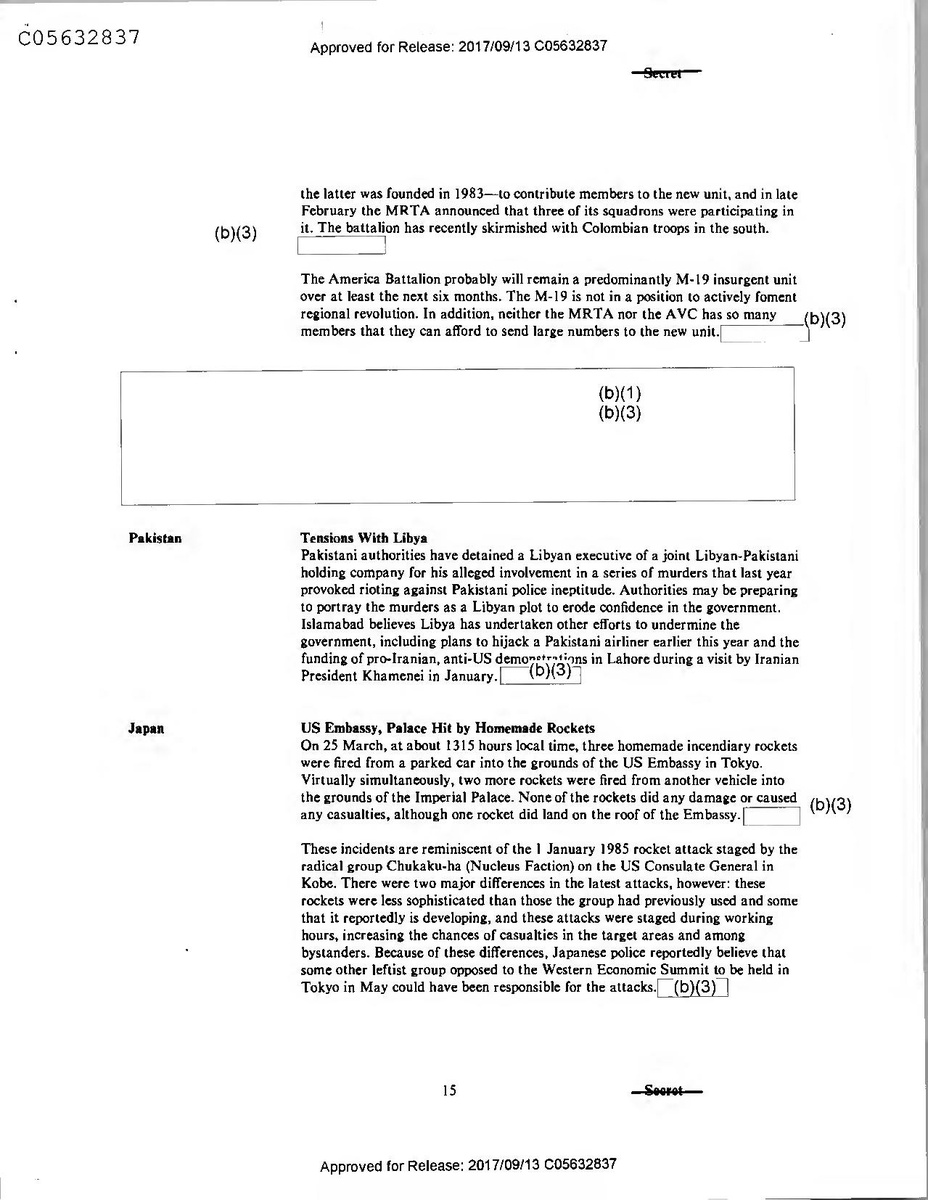
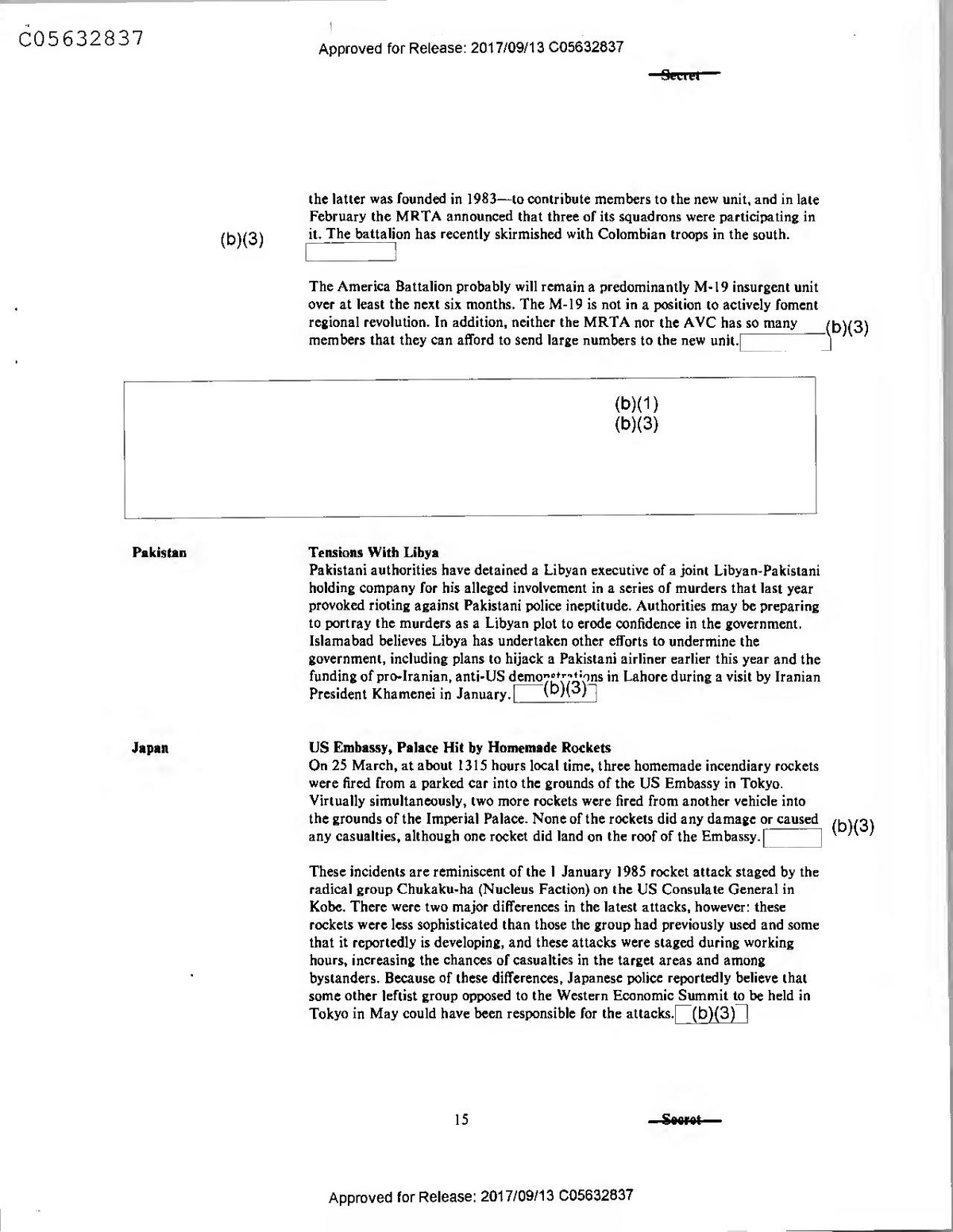
Secret
the latter was founded in 1983—to contribute members to the new unit, and in late February the MRTA announced that three of its squadrons were participating in it. The battalion has recently skirmished with Colombian troops in the south.
(b)(3)
The America Battalion probably will remain a predominantly M-19 insurgent unit over at least the next six months. The M-19 is not in a position to actively foment regional revolution. In addition, neither the MRTA nor the AVC has so many members that they can afford to send large numbers to the new unit.[
(b)(3)
(b)(1) (b)(3)
Pakistan
Tensions With Libya Pakistani authorities have detained a Libyan executive of a joint Libyan-Pakistani holding company for his alleged involvement in a series of murders that last year provoked rioting against Pakistani police ineptitude. Authorities may be preparing to portray the murders as a Libyan plot to erode confidence in the government. Islamabad believes Libya has undertaken other efforts to undermine the government, including plans to hijack a Pakistani airliner earlier this year and the funding of pro-Iranian, anti-US demonstrations in Lahore during a visit by Iranian President Khamenei in January.
(b)(3)
Japan
US Embassy, Palace Hit by Homemade Rockets On 25 March, at about 1315 hours local time, three homemade incendiary rockets were fired from a parked car into the grounds of the US Embassy in Tokyo. Virtually simultaneously, two more rockets were fired from another vehicle into the grounds of the Imperial Palace. None of the rockets did any damage or caused any casualties, although one rocket did land on the roof of the Embassy.[
(b)(3)
These incidents are reminiscent of the 1 January 1985 rocket attack staged by the radical
group Chukaku-ha (Nucleus Faction) on the US Consulate General in Kobe. There were two major differences in the latest attacks, however: these rockets were less sophisticated than those the group had previously used and some that it reportedly is developing, and these attacks were staged during working hours, increasing the chances of casualties in the target areas and among bystanders. Because of these differences, Japanese police reportedly believe that some other leftist group opposed to the Western Economic Summit to be held in
Tokyo in May could have been responsible for the attacks. [(b)(3)]
15
Sooret
Approved for Release: 2017/09/13 C05632837
(b)(3) Centra urtigtritrary
1
Washington, DC. 20505
DIRECTORATE OF INTELLIGENCE
12 September 1988
(b)(3)
Sweden: Election Outlook
Summary
September opinion polls indicate that Sweden's ruling Social Democratic Party (SDP) will probably be able to form a new government following the 18 September national election. The SDP may lose the working majority it traditionally secured with support from the Left-Party Communists (VPK), however, and have to depend on the passive support of the upstart Environmental Party (Greens) in order to form a minority government. Polls conducted in June--prior to a scandal involving a government sponsored secret investigation into the murder of former Prime Minister Olof Palme in 1986--had shown the SDP in a dead heat with the nonsocialist bloc consisting of the Moderate, Liberal and Center Parties. Current polls indicate a decline in SOP popularity--probably reflecting a loss of SDP votes to thin
- b)(339ens, rather than an increase in support for the
This memorandum was prepared by
Office of European Analysis and
Office of Leadership Analysis. Comments and queries are welcome and may be directed to the Chief,
(b)(3)
FILE
EUR M 88-20128
DATE
LDA M 88-20035
9-1588
EUR M 88-20128 DOC NO LDA M 88=20035
2
OIR
(b)(3)
P & PD
(b)(3) CONFIDENTIAL Approved for Release: 2017/09/13 C06141873
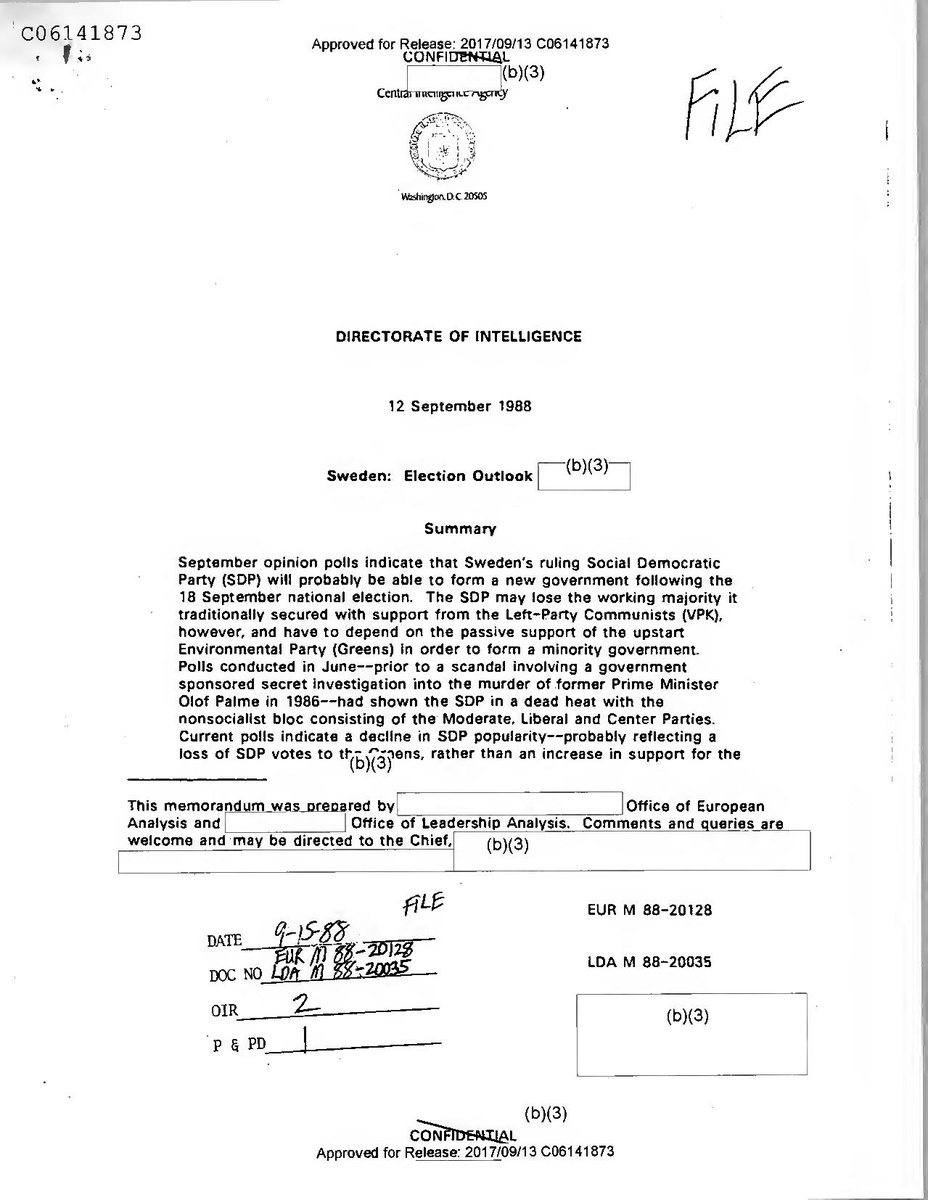
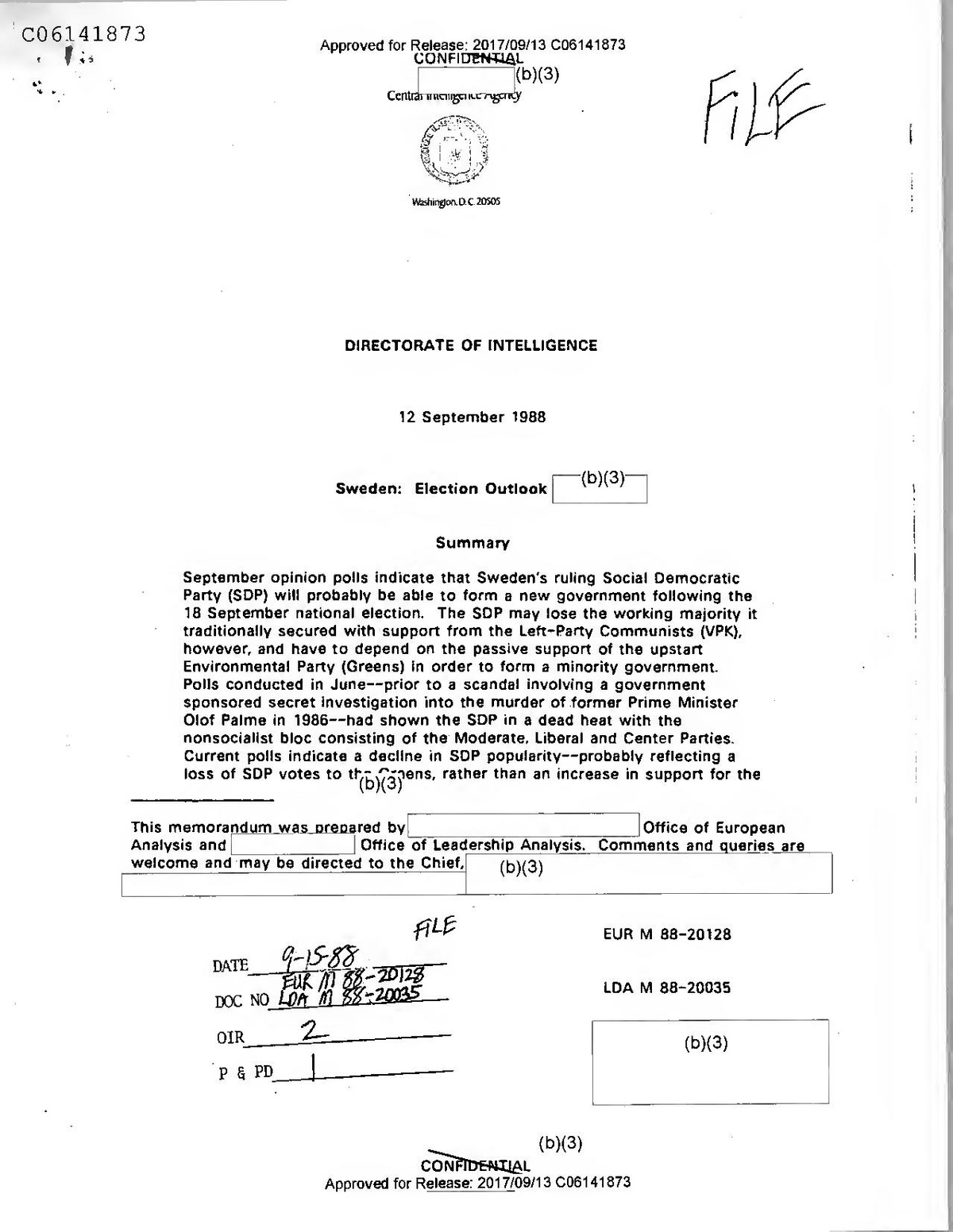
(b)(3) Centra urtigtritrary
1
Washington, DC. 20505
DIRECTORATE OF INTELLIGENCE
12 September 1988
(b)(3)
Sweden: Election Outlook
Summary
September opinion polls indicate that Sweden's ruling Social Democratic Party (SDP) will probably be able to form a new government following the 18 September national election. The SDP may lose the working majority it traditionally secured with support from the Left-Party Communists (VPK), however, and have to depend on the passive support of the upstart Environmental Party (Greens) in order to form a minority government. Polls conducted in June--prior to a scandal involving a government sponsored secret investigation into the murder of former Prime Minister Olof Palme in 1986--had shown the SDP in a dead heat with the nonsocialist bloc consisting of the Moderate, Liberal and Center Parties. Current polls indicate a decline in SOP popularity--probably reflecting a loss of SDP votes to thin
- b)(339ens, rather than an increase in support for the
This memorandum was prepared by
Office of European Analysis and
Office of Leadership Analysis. Comments and queries are welcome and may be directed to the Chief,
(b)(3)
FILE
EUR M 88-20128
DATE
LDA M 88-20035
9-1588
EUR M 88-20128 DOC NO LDA M 88=20035
2
OIR
(b)(3)
P & PD
(b)(3) CONFIDENTIAL Approved for Release: 2017/09/13 C06141873
CONFIDENTIAL (b)(3)
nonsocialists. The Greens--who are expected to win representation in the Riksdag for the first time--have said that they will not enter into a coalition with either the socialist or nonsocialist blocs, but will suf
SUF(b)(3) Social Democratic government on an issue-by-issue basis.
Neither a minority Social Democratic government nor a nonsocialist coalition government would be likely to significantly change domestic policy, although the nonsocialists want to hold social spending at current levels while increasing defense spending. Both blocs would continue to pursue improved relations with the US and would want to avoid the bilateral strains that festered under Prime Minister Palme. Even the nonsocialists, though, would retain the Swedish penchant for speaking out on regional security and armament issues in a way that tends to equate the West with the East.(b)(3)"
Will Economic Success Outweigh Political Scandals?
The Social Democrat's campaign strategy has highlighted the party's economic accomplishments since 1982--pursuing a macroeconomic policy that increased the private sector's share of GDP, reduced the budget and trade deficits, and held down the unemployment rate, which is now at its lowest level in this decade. Consequently, the SDP is boasting that Swedes are better off than ever, and are contrasting their last six years in power with the 1976-1982 period when unemployment reached record highs under nonsocialist rule. SDP domestic policy strategists--primarily Prime Minister ingvar Carlsson and Finance Minister Kjell-Olof Feldt--remain popular because of their association with Sweden's economic recovery. Although over 90 percent of economic growth since 1982 has been swallowed by taxes, the tax burden has not become a pivotal issue to the same extent as in previous elections. As a result, the nonsocialists' advocacy of major tax reform, which they have long hoped would become a salient issue triggering a political realignment, has not benefitted them in this campaign.
(b)(3)
The rise of the Greens has undercut somewhat the SDP's ability to maintain its level of support by pointing to its economic successes. Instead, many members of the SDP's "environmental wing" are defecting to the Greens because of their growing concern over nuclear power--a trend which accelerated after Chernobyl--and other enviromental issues. The Carlsson government tried to staunch this flow by proposing to close down two of Sweden's 12 nuclear reactors by the mid-1990s and the remaining plants by 2010. Even though this proposal would be extremely costly given that nearly half of Sweden's electricity is nuclear-generated, environmental hardliners are unimpressed and back the Greens' demand that all Swedish nuclear reactors be closed within the next three years. Consequently, we believe the Social Democrats have written off many of these hardliners, and instead are counting on their traditional labor union base. Despite trade union opposition to the SDP's plan to dismantle Sweden's nuclear power plants, we do not expect significant labor defections to the nonsocialists; some may, however, not vote at all. [(b)(3)
- 2 - COM
(b)(3) XTIAL
Approved for Release: 2017/09/13 C06141873
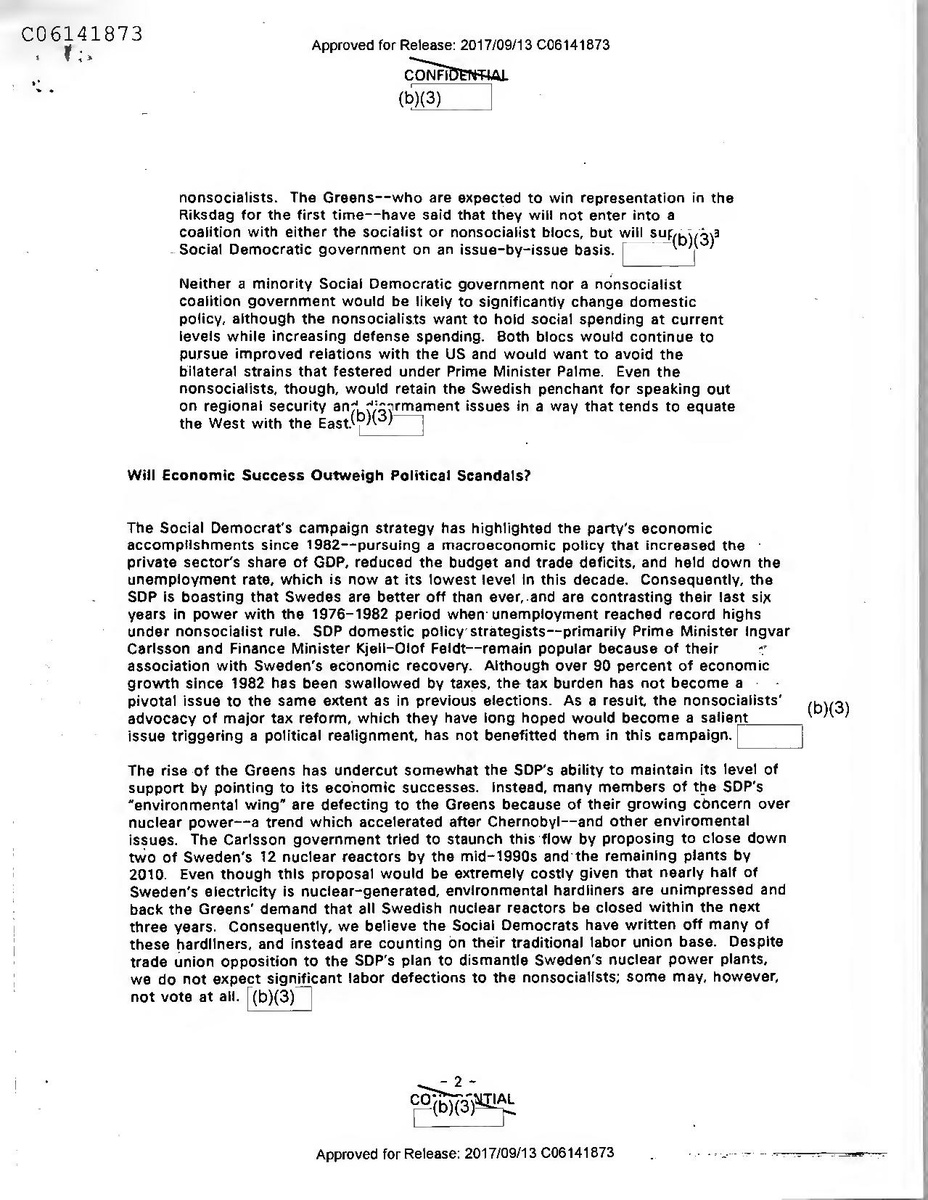
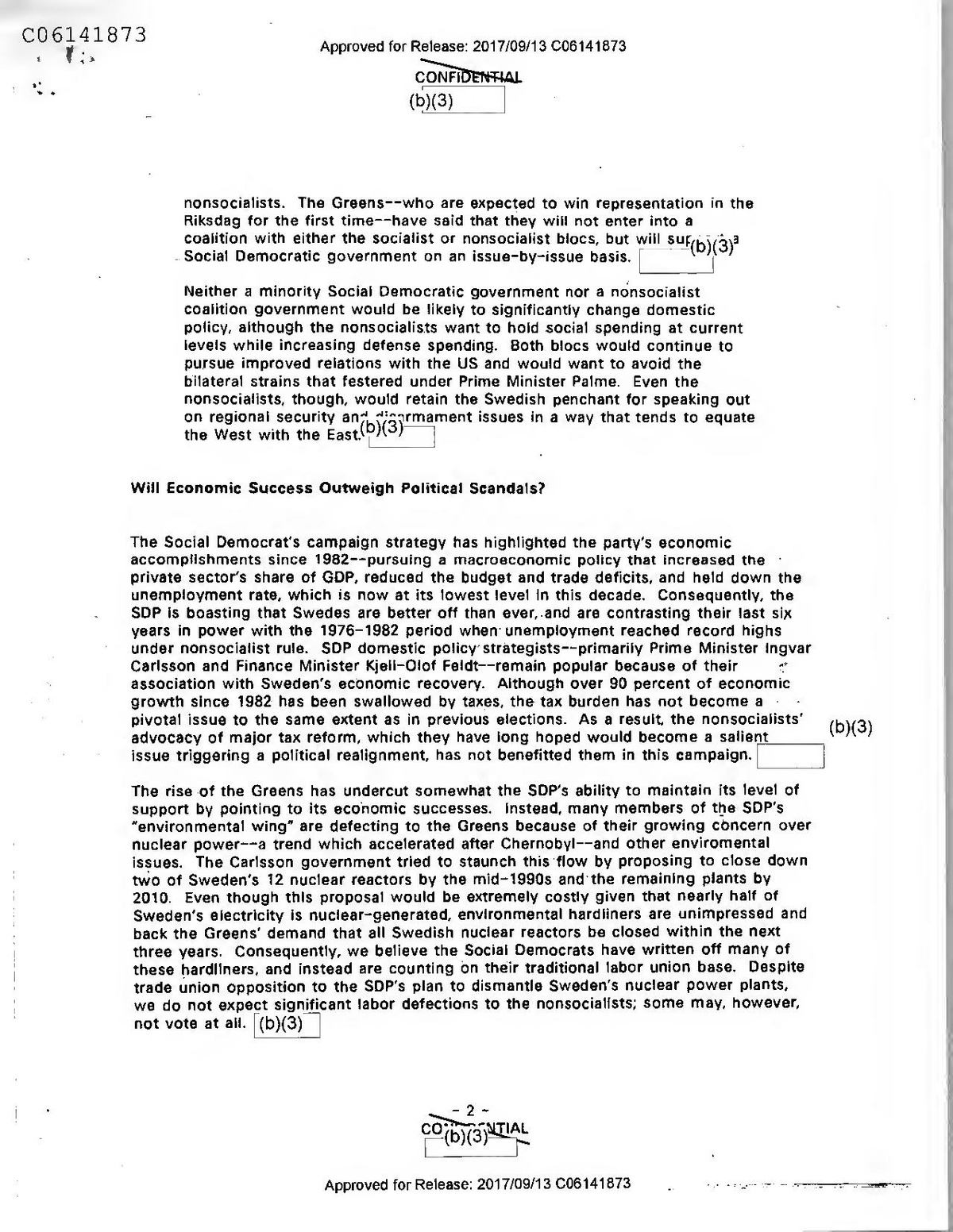
CONFIDENTIAL (b)(3)
nonsocialists. The Greens--who are expected to win representation in the Riksdag for the first time--have said that they will not enter into a coalition with either the socialist or nonsocialist blocs, but will suf
SUF(b)(3) Social Democratic government on an issue-by-issue basis.
Neither a minority Social Democratic government nor a nonsocialist coalition government would be likely to significantly change domestic policy, although the nonsocialists want to hold social spending at current levels while increasing defense spending. Both blocs would continue to pursue improved relations with the US and would want to avoid the bilateral strains that festered under Prime Minister Palme. Even the nonsocialists, though, would retain the Swedish penchant for speaking out on regional security and armament issues in a way that tends to equate the West with the East.(b)(3)"
Will Economic Success Outweigh Political Scandals?
The Social Democrat's campaign strategy has highlighted the party's economic accomplishments since 1982--pursuing a macroeconomic policy that increased the private sector's share of GDP, reduced the budget and trade deficits, and held down the unemployment rate, which is now at its lowest level in this decade. Consequently, the SDP is boasting that Swedes are better off than ever, and are contrasting their last six years in power with the 1976-1982 period when unemployment reached record highs under nonsocialist rule. SDP domestic policy strategists--primarily Prime Minister ingvar Carlsson and Finance Minister Kjell-Olof Feldt--remain popular because of their association with Sweden's economic recovery. Although over 90 percent of economic growth since 1982 has been swallowed by taxes, the tax burden has not become a pivotal issue to the same extent as in previous elections. As a result, the nonsocialists' advocacy of major tax reform, which they have long hoped would become a salient issue triggering a political realignment, has not benefitted them in this campaign.
(b)(3)
The rise of the Greens has undercut somewhat the SDP's ability to maintain its level of support by pointing to its economic successes. Instead, many members of the SDP's "environmental wing" are defecting to the Greens because of their growing concern over nuclear power--a trend which accelerated after Chernobyl--and other enviromental issues. The Carlsson government tried to staunch this flow by proposing to close down two of Sweden's 12 nuclear reactors by the mid-1990s and the remaining plants by 2010. Even though this proposal would be extremely costly given that nearly half of Sweden's electricity is nuclear-generated, environmental hardliners are unimpressed and back the Greens' demand that all Swedish nuclear reactors be closed within the next three years. Consequently, we believe the Social Democrats have written off many of these hardliners, and instead are counting on their traditional labor union base. Despite trade union opposition to the SDP's plan to dismantle Sweden's nuclear power plants, we do not expect significant labor defections to the nonsocialists; some may, however, not vote at all. [(b)(3)
- 2 - COM
(b)(3) XTIAL
Approved for Release: 2017/09/13 C06141873
CONCISATIAL
(b)(3)
Political Scandals Involving SDP Leaders
A series of scandals has also overshadowed the SDP's economic success and seriously damaged the Social Democrats' image of moral superiority. By early summer, the Government had suffered through two major scandals involving Social Democratic leaders condoning illegal arms sales and the use of influence by party and trade union officials to receive special consideration for housing in the extremely tight, government controlled market. The subsequent Ebbe Carlsson affair, however, coming just before the election, could prove to be the most damaging to the Social Democrats. (b)(3)
1
In this latest scandal, Justice Minister Anna-Greta Leijon--previously one of Carlsson's most popular ministers--admitted to using her position to support a privately financed, secret investigation of the Palme assassination by Ebbe Carlsson, and appeared to place herself above the law in a country that holds the legal system sacrosanct. Prime Minister Carlsson himself came under strong criticism for his staunch defense of Leijon, but his confident performance before a parliamentary committee investigating the affair helped him recover some lost ground. It is unclear what effect the hearings--the first to be nationally televised-had on the populace as many Swedes were on summer holiday, but we believe the whole affair probably further eroded public faith in the SDP governmen(b)(3)
The nonsocialists, for their part, still suffer from the perception by most Swedes that they are incapable of leading the country--a point emphasized by a recent poll which showed that half of the likely nonsocialist voters believe that the Social Democrats will form the next government. Although they have tried to capitalize on the recent scandals involving the Social Democrats, the nonsocialists have instead had to devote a significant portion of their campaign to convincing voters that the three parties present a viable, cohesive option. Despite their efforts, we do not believe the nonsocialists have been able to override the memories of policy failures when they governed from 1976-1982, especially in economic policy. By contrast, the Social Democrats have successfully claimed that their economic policies have corrected the economic ills caused by the nonsocialists during that period.
(b)(3)
Social Democratic
Led Government Still Likely
The Social Democrats are likely to slip from their current level of 159 seats (out of 359) in the Riksdag with most of their lost support going to the Greens rather than the nonsocialist parties. In order to remain in power after the election, the Social Democrats will either have to continue their cooperation with the Left-Party Communists (VPK), garner the support of both the VPK and Greens, or form a coalition government with the nonsocialist Center Party. Some Social Democrats traditionally vote for the VPK in national elections to ensure a socialist majority. This year, however, the Social Democrats may lose additional votes to the left because the party's squeaky-clean image has been badly tarnished by the recent scandals. In addition, many SDP partisans
1
Ebbe Carlsson--no relation to Prime Minister Ingvar Carlsson--is a wealthy publisher with close ties to the SDP.
· 3
(b)(3)TIAL
Approved for Release: 2017/09/13 C06141873
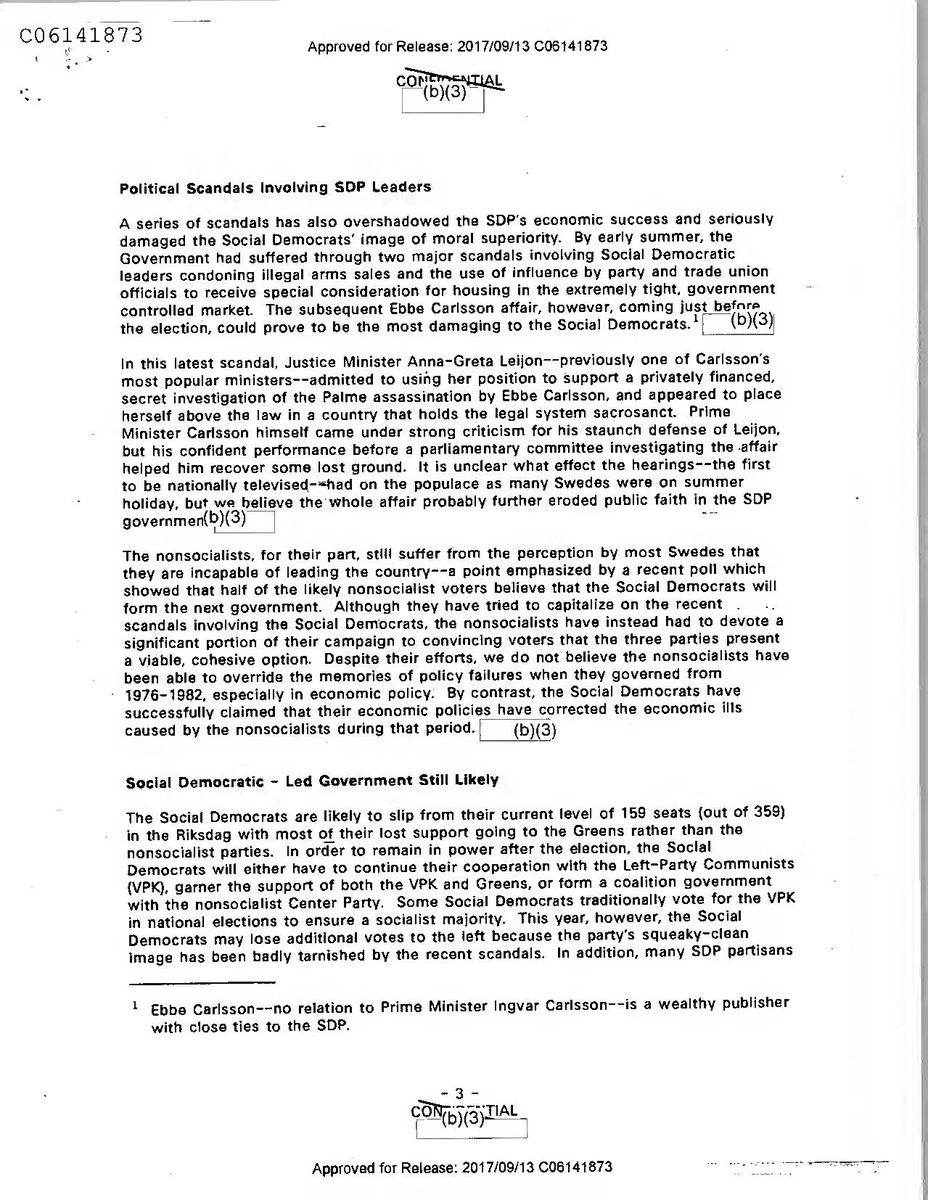
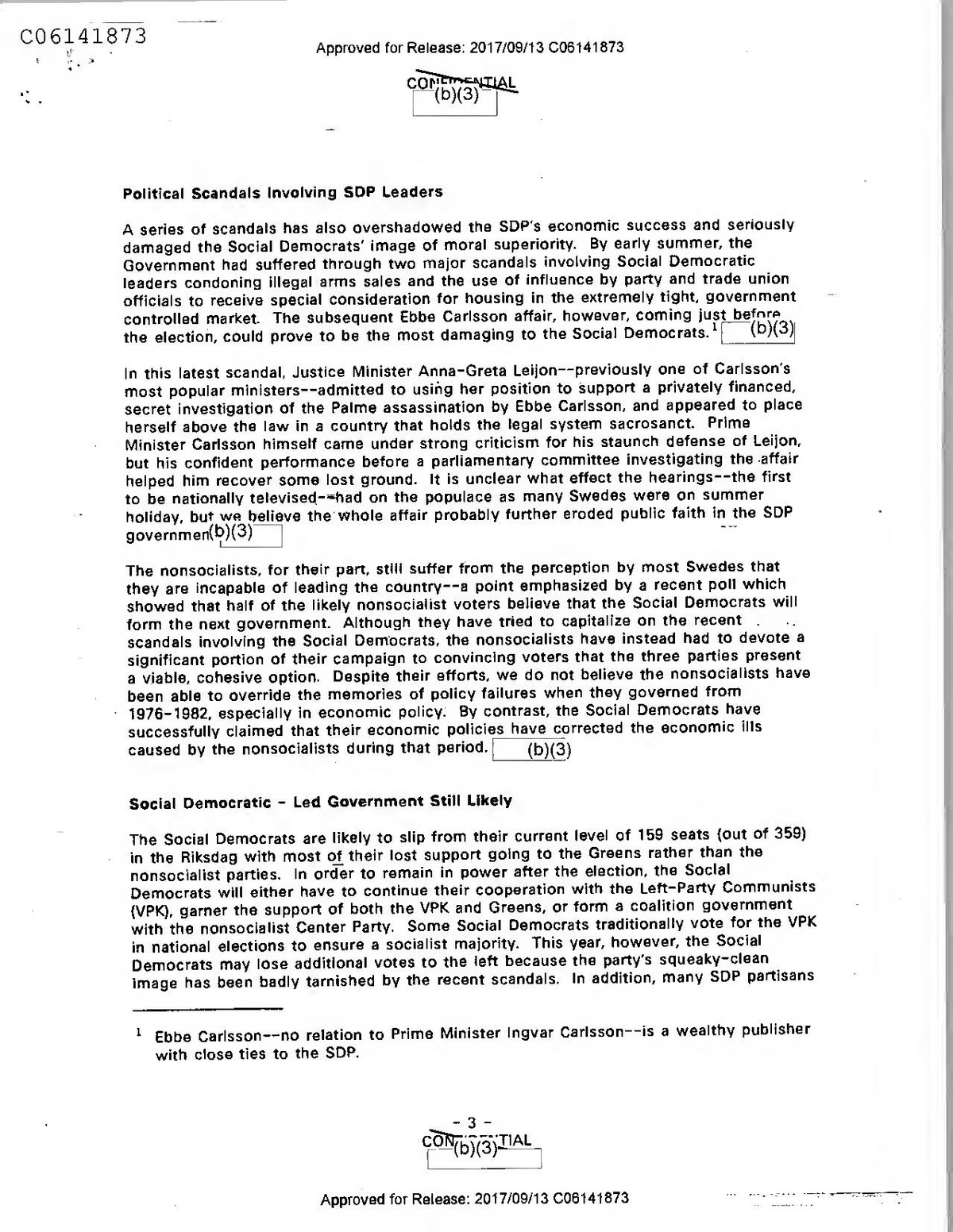
CONCISATIAL
(b)(3)
Political Scandals Involving SDP Leaders
A series of scandals has also overshadowed the SDP's economic success and seriously damaged the Social Democrats' image of moral superiority. By early summer, the Government had suffered through two major scandals involving Social Democratic leaders condoning illegal arms sales and the use of influence by party and trade union officials to receive special consideration for housing in the extremely tight, government controlled market. The subsequent Ebbe Carlsson affair, however, coming just before the election, could prove to be the most damaging to the Social Democrats. (b)(3)
1
In this latest scandal, Justice Minister Anna-Greta Leijon--previously one of Carlsson's most popular ministers--admitted to using her position to support a privately financed, secret investigation of the Palme assassination by Ebbe Carlsson, and appeared to place herself above the law in a country that holds the legal system sacrosanct. Prime Minister Carlsson himself came under strong criticism for his staunch defense of Leijon, but his confident performance before a parliamentary committee investigating the affair helped him recover some lost ground. It is unclear what effect the hearings--the first to be nationally televised-had on the populace as many Swedes were on summer holiday, but we believe the whole affair probably further eroded public faith in the SDP governmen(b)(3)
The nonsocialists, for their part, still suffer from the perception by most Swedes that they are incapable of leading the country--a point emphasized by a recent poll which showed that half of the likely nonsocialist voters believe that the Social Democrats will form the next government. Although they have tried to capitalize on the recent scandals involving the Social Democrats, the nonsocialists have instead had to devote a significant portion of their campaign to convincing voters that the three parties present a viable, cohesive option. Despite their efforts, we do not believe the nonsocialists have been able to override the memories of policy failures when they governed from 1976-1982, especially in economic policy. By contrast, the Social Democrats have successfully claimed that their economic policies have corrected the economic ills caused by the nonsocialists during that period.
(b)(3)
Social Democratic
Led Government Still Likely
The Social Democrats are likely to slip from their current level of 159 seats (out of 359) in the Riksdag with most of their lost support going to the Greens rather than the nonsocialist parties. In order to remain in power after the election, the Social Democrats will either have to continue their cooperation with the Left-Party Communists (VPK), garner the support of both the VPK and Greens, or form a coalition government with the nonsocialist Center Party. Some Social Democrats traditionally vote for the VPK in national elections to ensure a socialist majority. This year, however, the Social Democrats may lose additional votes to the left because the party's squeaky-clean image has been badly tarnished by the recent scandals. In addition, many SDP partisans
1
Ebbe Carlsson--no relation to Prime Minister Ingvar Carlsson--is a wealthy publisher with close ties to the SDP.
· 3
(b)(3)TIAL
Approved for Release: 2017/09/13 C06141873
CONFIDENTIAL (b)(3)
believe the government has not been aggressive enough on environmental issues and are turning toward the Greens. (b)(3)
Nonetheless, we believe that Social Democratic-led government remains the most likely outcome in the election, given nonsocialist party divisions and lack of public confidence in their ability to govern. A Social Democratic government would continue with its present domestic and international agenda--maintaining a tight fiscal policy to eliminate the budget deficit while trying to honor its pledge to increase annual paid vacation from five to six weeks, and participating in international peace and disarmament efforts. A strong showing by the Greens, particularly if the VPK fails to remain in parliament--which cannot be ruled out given recent polls--could force the Social Democrats to address controversial enviromental issues, such as an accelerated closing of all 12 of Sweden's nuclear reactors within the next three years. We do not believe, however, that they would accede to the Greens' demand to close all plants 'so rapidly due to the high cost of finding other energy sources. If the Social Democrats do not meet most of the Greens' enviromental demands, we believe that the Greens would not support the Social Democratic legislative agenda and the Social Democrats would then be forced to seek commanises with one or more of the nonsocialist parties on an issue-by-Issue basis.
(b)(3);
If the Social Democrats are unable to form a government with the support of either the VPK or the Greens, we believe the SDP leadership would explore the possibility of forming a coalition with the Center Party rather than forfeit power. The Social Democrats have already sent some signals to the Center Party through Stig Malm, the leader of the major labor organization in Sweden, who has suggested that the two parties can find a basis for cooperation. Although Center Party leader Johansson has publicly rejected these overtures, claiming his preference for joining a nonsocialist coalition, we believe he would seriously consider an inivitation to form a SDP-Center
az
government as a7b)(3)ortunity to rebuild support for his party, which has flagged whlle
On foreign policy, Prime Minister Carlsson has sought to return Sweden to a constructive dialogue with the US in an effort to repair the damage from the more turbulent Palme era. Although Carlsson and other party leaders at the 1987 party congress managed to defeat a grassroots effort to tighten the Social Democrats policy on nuclear-capable ship visits, a Social Democratic government would remain active in international forums for nuclear disarmanent. The Social Democrats will continue to believe that they should act as the world's conscience, and moral concerns will remain the driving force behind Swedish foreign policy. At the same time, Stockholm will remain wary of Soviet diplomatic advances and will continue to stress that Sweden will only discuss arms control and confidence-building measures in conjunction with its Nordic neighbors and in such a way as to respect Danish and Norwegian membership in NATO. Nonetheless, Stockholm considered the recent agreement with the Soviet Union on the boundary dispute in the Baltic Sea as a sign that relations with Moscow will continue to improve following strains in the early 1980s. (b)(3)
CONFIDENTIAL(b)(3)
Approved for Release: 2017/09/13 C06141873
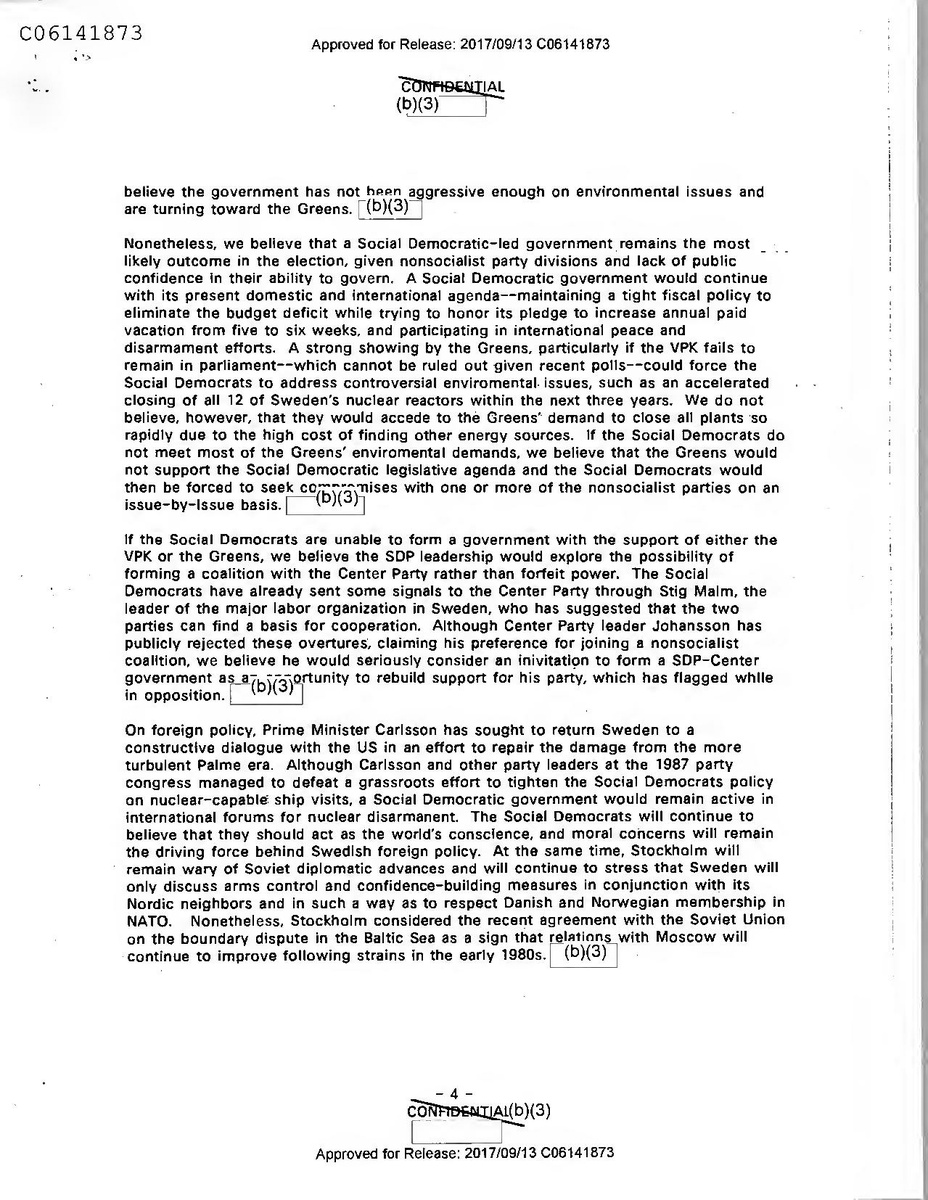
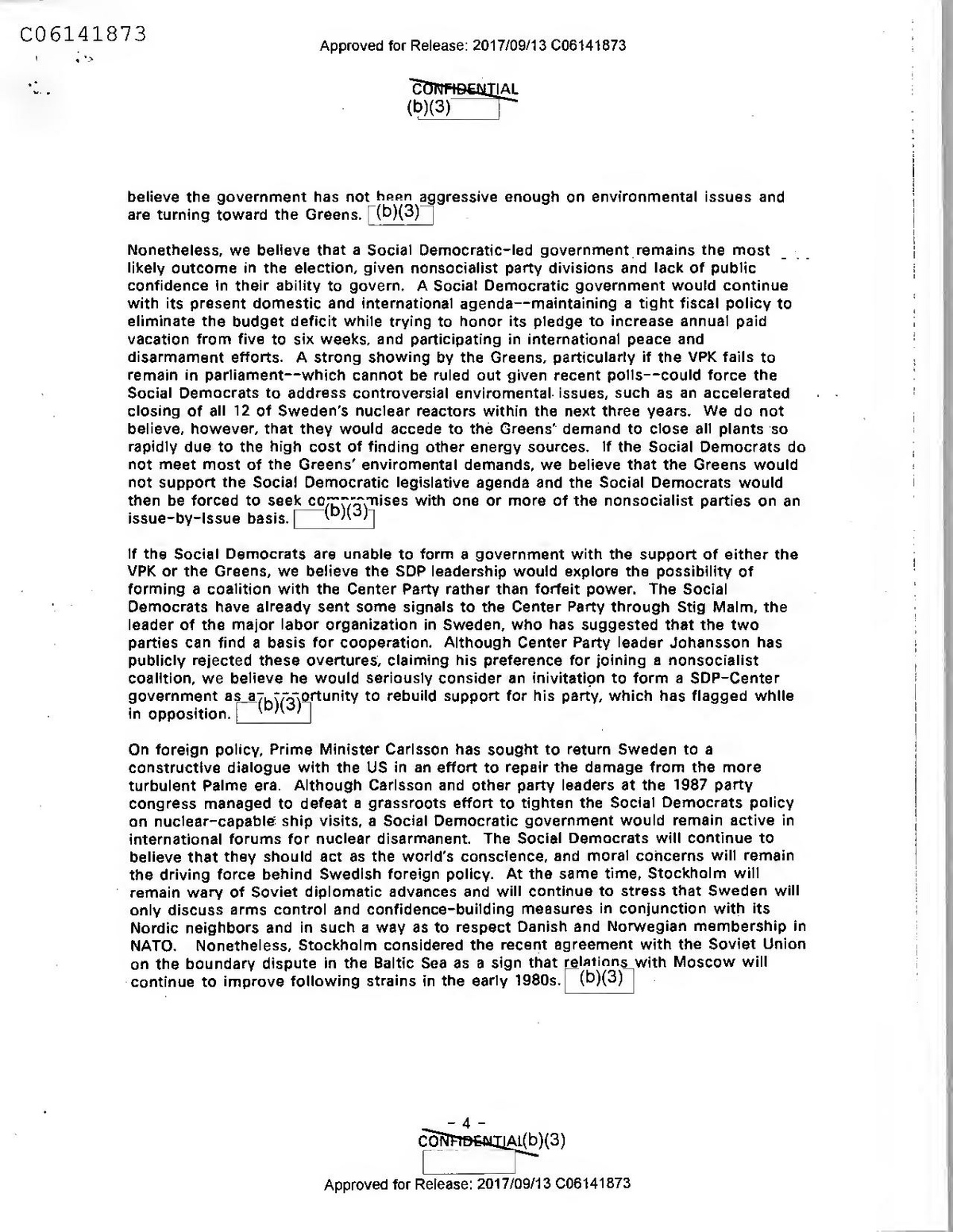
CONFIDENTIAL (b)(3)
believe the government has not been aggressive enough on environmental issues and are turning toward the Greens. (b)(3)
Nonetheless, we believe that Social Democratic-led government remains the most likely outcome in the election, given nonsocialist party divisions and lack of public confidence in their ability to govern. A Social Democratic government would continue with its present domestic and international agenda--maintaining a tight fiscal policy to eliminate the budget deficit while trying to honor its pledge to increase annual paid vacation from five to six weeks, and participating in international peace and disarmament efforts. A strong showing by the Greens, particularly if the VPK fails to remain in parliament--which cannot be ruled out given recent polls--could force the Social Democrats to address controversial enviromental issues, such as an accelerated closing of all 12 of Sweden's nuclear reactors within the next three years. We do not believe, however, that they would accede to the Greens' demand to close all plants 'so rapidly due to the high cost of finding other energy sources. If the Social Democrats do not meet most of the Greens' enviromental demands, we believe that the Greens would not support the Social Democratic legislative agenda and the Social Democrats would then be forced to seek commanises with one or more of the nonsocialist parties on an issue-by-Issue basis.
(b)(3);
If the Social Democrats are unable to form a government with the support of either the VPK or the Greens, we believe the SDP leadership would explore the possibility of forming a coalition with the Center Party rather than forfeit power. The Social Democrats have already sent some signals to the Center Party through Stig Malm, the leader of the major labor organization in Sweden, who has suggested that the two parties can find a basis for cooperation. Although Center Party leader Johansson has publicly rejected these overtures, claiming his preference for joining a nonsocialist coalition, we believe he would seriously consider an inivitation to form a SDP-Center
az
government as a7b)(3)ortunity to rebuild support for his party, which has flagged whlle
On foreign policy, Prime Minister Carlsson has sought to return Sweden to a constructive dialogue with the US in an effort to repair the damage from the more turbulent Palme era. Although Carlsson and other party leaders at the 1987 party congress managed to defeat a grassroots effort to tighten the Social Democrats policy on nuclear-capable ship visits, a Social Democratic government would remain active in international forums for nuclear disarmanent. The Social Democrats will continue to believe that they should act as the world's conscience, and moral concerns will remain the driving force behind Swedish foreign policy. At the same time, Stockholm will remain wary of Soviet diplomatic advances and will continue to stress that Sweden will only discuss arms control and confidence-building measures in conjunction with its Nordic neighbors and in such a way as to respect Danish and Norwegian membership in NATO. Nonetheless, Stockholm considered the recent agreement with the Soviet Union on the boundary dispute in the Baltic Sea as a sign that relations with Moscow will continue to improve following strains in the early 1980s. (b)(3)
CONFIDENTIAL(b)(3)
Approved for Release: 2017/09/13 C06141873
CONFIDENTIAL
-(b)(3)
If the Nonsocialists Win
A nonsocialist coalition would be unlikely to pursue domestic economic policies that differ significantly from the current government's, especially because they have not agreed on a common platform that seriously challenges Swedish social democracy. In addition, a nonsocialist coalition would probably clash on some of the key issues that garnered it voter support. While the Moderates and Liberals would like to privatize many government services, reduce taxes and pursue EC membership, these moves would put them at odds with the Center Party. For instance, the Moderates and Liberals support partial privatization of the cradle-to-grave health care system, while the Center Party wants to maintain the current trouble-plagued system by allocating additional funds in an effort to make it more efficient. The three nonsocialist parties are also split on the nuclear power issue. The Moderates support continued reliance on nuclear power, asserting that greater pollution in the future would result from the increased use of fossil fuels, but the Center Party supports the Social Democrats' plan for closing the two reactors by 1995 and subsequently shutting all plants. (b)(3)
On defense and security policy, the nonsocialists would probably try to increase the defense budget and would remain wary of Soviet diplomatic gestures. A nonsocialist government would probably push for a review of the 1988-1992 defense plan as early as 1990 and would be somewhat more likely to trade off higher defense spending for restraints in social expenditures. Although Moderate Party leader Carl Bildt takes a harder line towards the Soviet Union than other nonsocialist leaders, we do not believe there will be a significant change in Sweden's relationship with the Sovietinion in the absence of a repeat of the 1982 "Whiskey on the Rocks" incident.
(b)(3)
Overall, we believe a government of nonsocialist parties would resume its internal bickering--usually abandoned during the campaign--which would thwart its post-election momentum. In the worst case scenario, disagreement among the nonsocialists would prevent the parties from concentrating on a unified legislative program and could lead to a parliamentary stalemate as each party sought a cosponsor for its pet issues. (b)(3)
Implications for the United States
Regardless of the outcome of the election, we expect the next Swedish government to place high priority on fostering good relations with the US. Nonetheless, Sweden will continue to "agree to disagree with the US on several international issues, particularly on US policy in Central America. (b)(3)
If the Social Democrats return to power, the US can expect relatively little change in relations with Sweden. A returning socialist government will probably continue to resist rank-and-file calls for tightening Swedish nuclear ship vislt policy or for supporting an acceleration of the Nordic Council's deliberations on a Nordic Nuclear-Weapons-Free Zone. If the Greens play a significant role in the next government, they may be able to stir significant grassroots pressure on the government to reverse these positions. In any event, a Social Democratic government is likely to continue to criticize US policy on
- 5CONFIDENTIAL (b)(3)
Approved for Release: 2017/09/13 C06141873
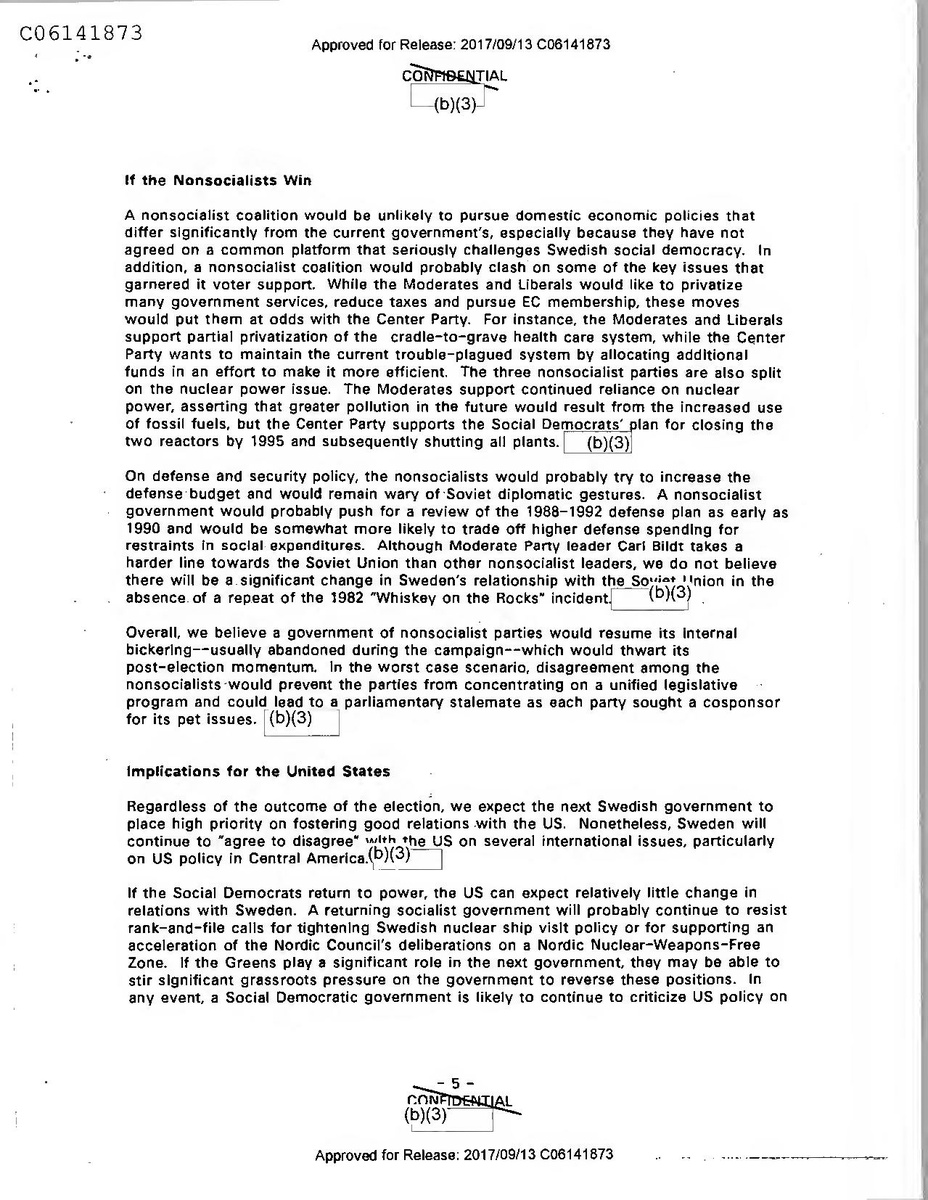
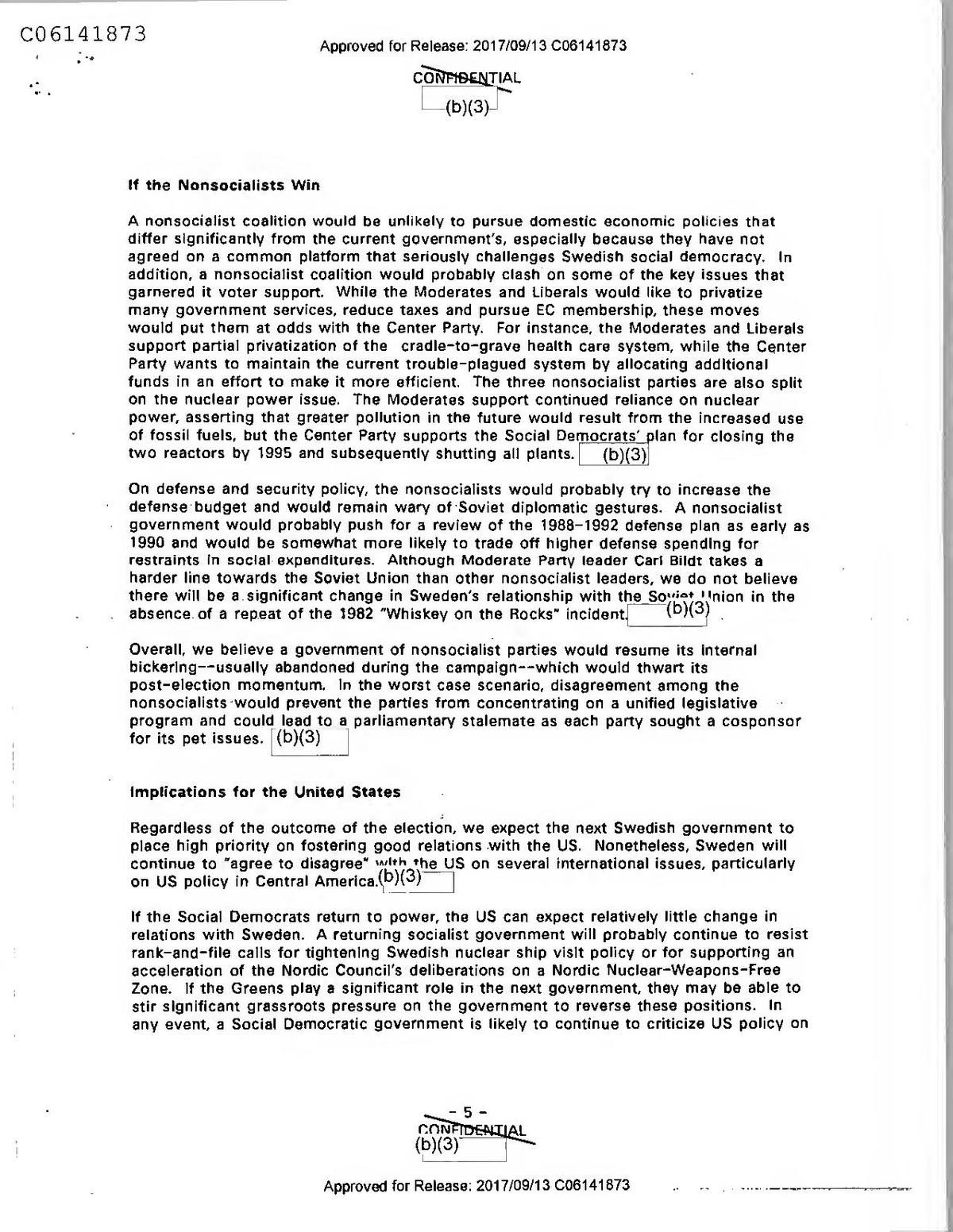
CONFIDENTIAL
-(b)(3)
If the Nonsocialists Win
A nonsocialist coalition would be unlikely to pursue domestic economic policies that differ significantly from the current government's, especially because they have not agreed on a common platform that seriously challenges Swedish social democracy. In addition, a nonsocialist coalition would probably clash on some of the key issues that garnered it voter support. While the Moderates and Liberals would like to privatize many government services, reduce taxes and pursue EC membership, these moves would put them at odds with the Center Party. For instance, the Moderates and Liberals support partial privatization of the cradle-to-grave health care system, while the Center Party wants to maintain the current trouble-plagued system by allocating additional funds in an effort to make it more efficient. The three nonsocialist parties are also split on the nuclear power issue. The Moderates support continued reliance on nuclear power, asserting that greater pollution in the future would result from the increased use of fossil fuels, but the Center Party supports the Social Democrats' plan for closing the two reactors by 1995 and subsequently shutting all plants. (b)(3)
On defense and security policy, the nonsocialists would probably try to increase the defense budget and would remain wary of Soviet diplomatic gestures. A nonsocialist government would probably push for a review of the 1988-1992 defense plan as early as 1990 and would be somewhat more likely to trade off higher defense spending for restraints in social expenditures. Although Moderate Party leader Carl Bildt takes a harder line towards the Soviet Union than other nonsocialist leaders, we do not believe there will be a significant change in Sweden's relationship with the Sovietinion in the absence of a repeat of the 1982 "Whiskey on the Rocks" incident.
(b)(3)
Overall, we believe a government of nonsocialist parties would resume its internal bickering--usually abandoned during the campaign--which would thwart its post-election momentum. In the worst case scenario, disagreement among the nonsocialists would prevent the parties from concentrating on a unified legislative program and could lead to a parliamentary stalemate as each party sought a cosponsor for its pet issues. (b)(3)
Implications for the United States
Regardless of the outcome of the election, we expect the next Swedish government to place high priority on fostering good relations with the US. Nonetheless, Sweden will continue to "agree to disagree with the US on several international issues, particularly on US policy in Central America. (b)(3)
If the Social Democrats return to power, the US can expect relatively little change in relations with Sweden. A returning socialist government will probably continue to resist rank-and-file calls for tightening Swedish nuclear ship vislt policy or for supporting an acceleration of the Nordic Council's deliberations on a Nordic Nuclear-Weapons-Free Zone. If the Greens play a significant role in the next government, they may be able to stir significant grassroots pressure on the government to reverse these positions. In any event, a Social Democratic government is likely to continue to criticize US policy on
- 5CONFIDENTIAL (b)(3)
Approved for Release: 2017/09/13 C06141873
CONFIDENTIAL
(b)(3)
regional issues, such as Central America. Eventually, the Social Democrats may begin to shed the caution that has tempered their rhetoric since the Carlsson visit to the U.Subst year and revert to their traditional moral posturing on "North-South" issues.
(b)(3)
While a nonsocialist government may temper the rhetoric against US policy in Central. America even further--particularly if Permanent Undersecretary of Foreign Affairs Pierre Schori is replaced--the Liberal and Center parties would probably continue to seek some role for Sweden as a "moral conscience" on the world scene. The non socialists would continue the Carlsson government's efforts to play down Soviet security proposals for the Nordic region and calls for establishing tighter rules for visiting warships. Although either a socialist or a nonsocialist government would implement policies to facilitate adaptation to the EC's 1992 internal market reforms, a nonsocialist government would probably be fraught with bickering between the Moderates, who want to join the EC, and the Center Party, which opposes such a move. (b)(3)
- 6 -
CONFIDENTIAL L(b)(3)
Approved for Release: 2017/09/13 C06141873.
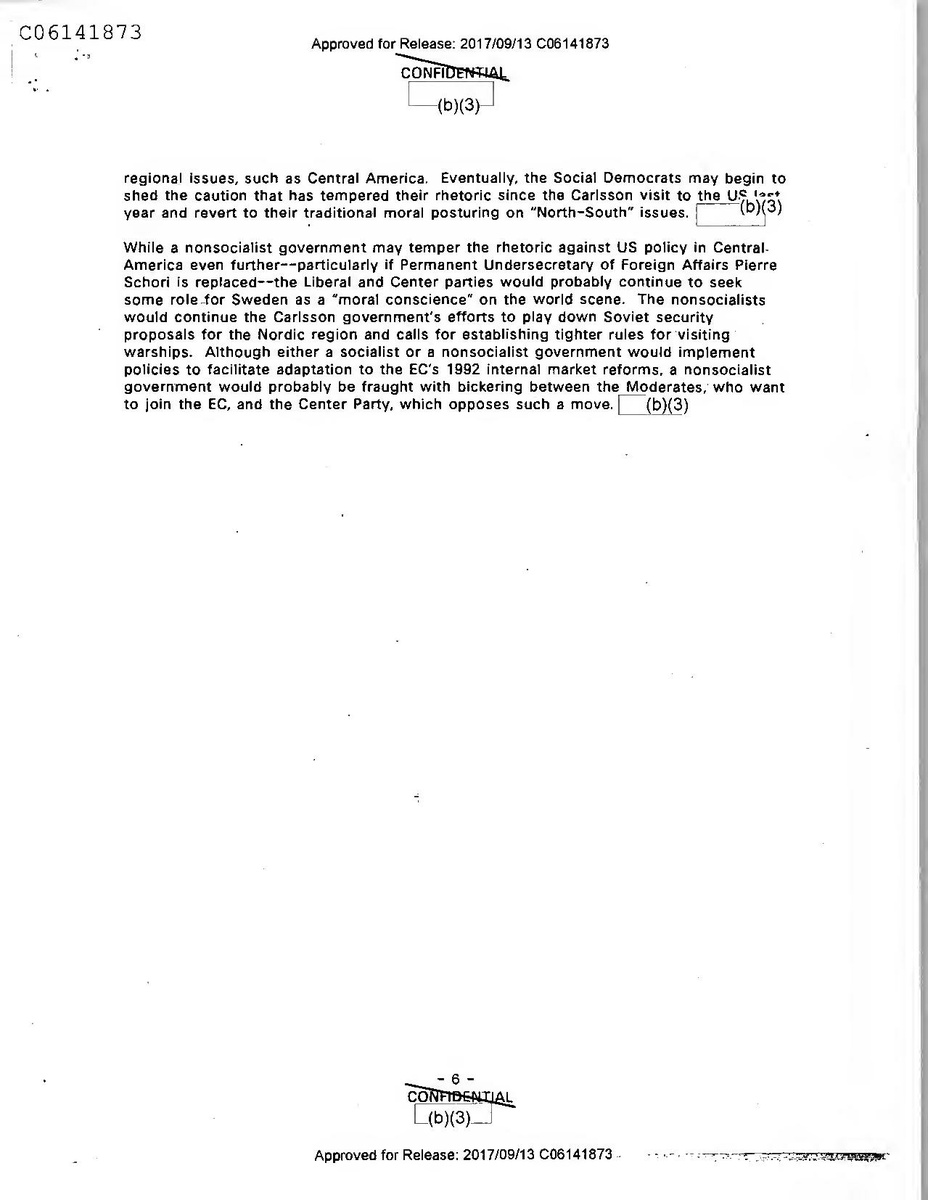
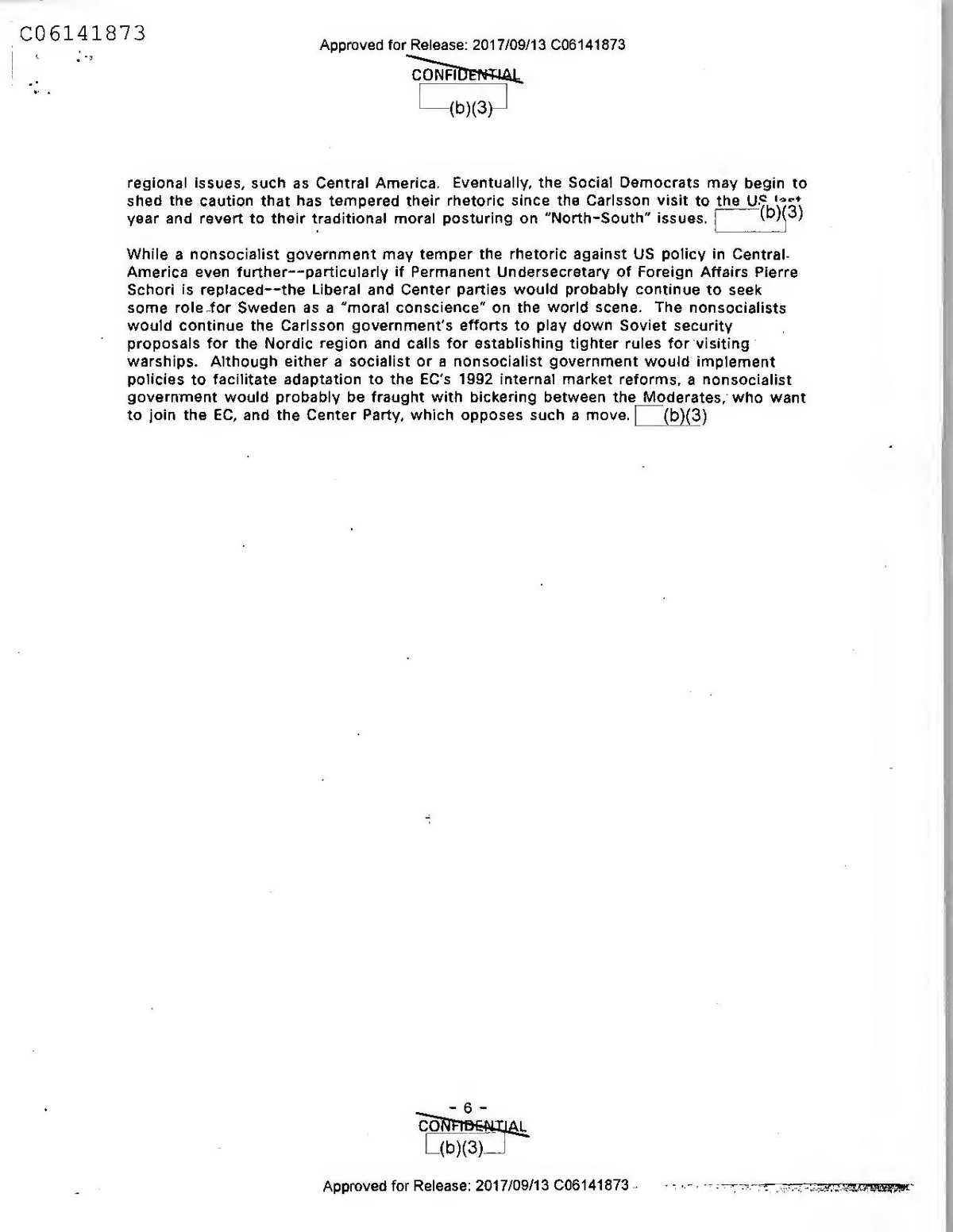
CONFIDENTIAL
(b)(3)
regional issues, such as Central America. Eventually, the Social Democrats may begin to shed the caution that has tempered their rhetoric since the Carlsson visit to the U.Subst year and revert to their traditional moral posturing on "North-South" issues.
(b)(3)
While a nonsocialist government may temper the rhetoric against US policy in Central. America even further--particularly if Permanent Undersecretary of Foreign Affairs Pierre Schori is replaced--the Liberal and Center parties would probably continue to seek some role for Sweden as a "moral conscience" on the world scene. The non socialists would continue the Carlsson government's efforts to play down Soviet security proposals for the Nordic region and calls for establishing tighter rules for visiting warships. Although either a socialist or a nonsocialist government would implement policies to facilitate adaptation to the EC's 1992 internal market reforms, a nonsocialist government would probably be fraught with bickering between the Moderates, who want to join the EC, and the Center Party, which opposes such a move. (b)(3)
- 6 -
CONFIDENTIAL L(b)(3)
Approved for Release: 2017/09/13 C06141873.
CONFIDENTIAL
(b)(3)
(b)(1) (b)(3)
7 - CONFIDEALTIAL
(b)(3)
Approved for Release: 2017/09/13 C06141873
CONFIDENTIAL
(b)(3)
(b)(1) (b)(3)
7 - CONFIDEALTIAL
(b)(3)
Approved for Release: 2017/09/13 C06141873
CONFIDENTIAL
(b)(3)
(b)(1) (b)(3)
- 8 - CONFIDENTIAL [(b)(3).
Approved for Release: 2017/09/13 C06141873
CONFIDENTIAL
(b)(3)
(b)(1) (b)(3)
- 8 - CONFIDENTIAL [(b)(3).
Approved for Release: 2017/09/13 C06141873
CONFIDENTIAL
(b)(3)
! (b)(1) (b)(3)
9CONFIDENTIAL
(b)(3)
Approved for Release: 2017/09/13 C06141873
CONFIDENTIAL
(b)(3)
! (b)(1) (b)(3)
9CONFIDENTIAL
(b)(3)
Approved for Release: 2017/09/13 C06141873
(b)(3)
(b)(3)
_(b)(3)
CONFIDENTIAL
Approved for Release: 2017/09/13 C06141873
—
(b)(3)
(b)(3)
_(b)(3)
CONFIDENTIAL
Approved for Release: 2017/09/13 C06141873
—
(b)(1) (b)(3)
We have not ruled out Chukaku-ha as a likely culprit, for a variety of reasons:
- The vehicles apparently used timers and self-destruct devices, hallmarks of Chukaku-ha incendiary attacks.
- Chukaku-ha devices frequently fail to explode after they reach their targets.
- Chukaku-ha is known to have been planning surveillance of US diplomatic targets in Japan in early March and is known to have planned and l:(b)(3)celed an incendiary attack on the US Embassy in the fall of 1983.
- Chukaku-ha intends to create a climate of (b)(1) during the runup to the May summit, but the group faces manpı(b)(3) money, and time constraints and might not be able to conduct serious attacks. These incidents support the view that the perpetrators are reacting to time pressure, and we believe they are likely to continue to carry out attacks that generate maximum publicity in their attempt to derail the summit.
-(b)(3)
Malaysia
Bombings Mar Sabah State Politics Between 12 and 20 March, a series of 26 bombings rocked the Malaysian state of Sabah, leaving three persons dead and seven others injured.
Two other persons died in subsequent rioting. Similar low-level bombings occurred last spring following elections that brought a b)(3jan-dominated party to power in the predominantly Muslim state.
These bombings, and the first set in 1985, are believed to have been perpetrated by Muslims loyal to the party that led the previous state government.
The bombers apparently intend to create sufficient chaos to pressure the mostly Muslim (but secular) national government to step in and run the state.
To the extent that Sabah Muslims remain disaffected with the current regime, more such bombings are likely. (b)(3)
Secret 16
Approved for Release: 2017/09/13 C05632837
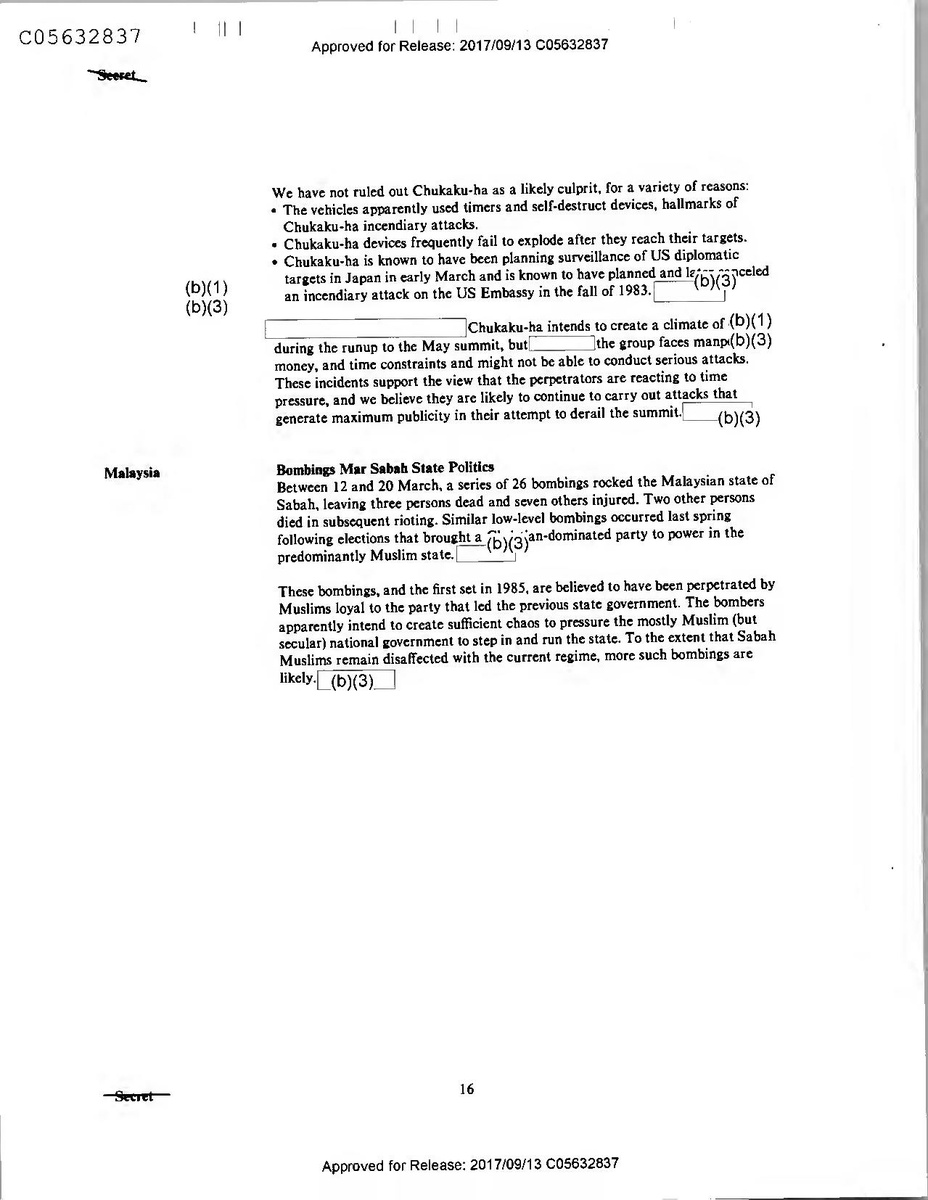
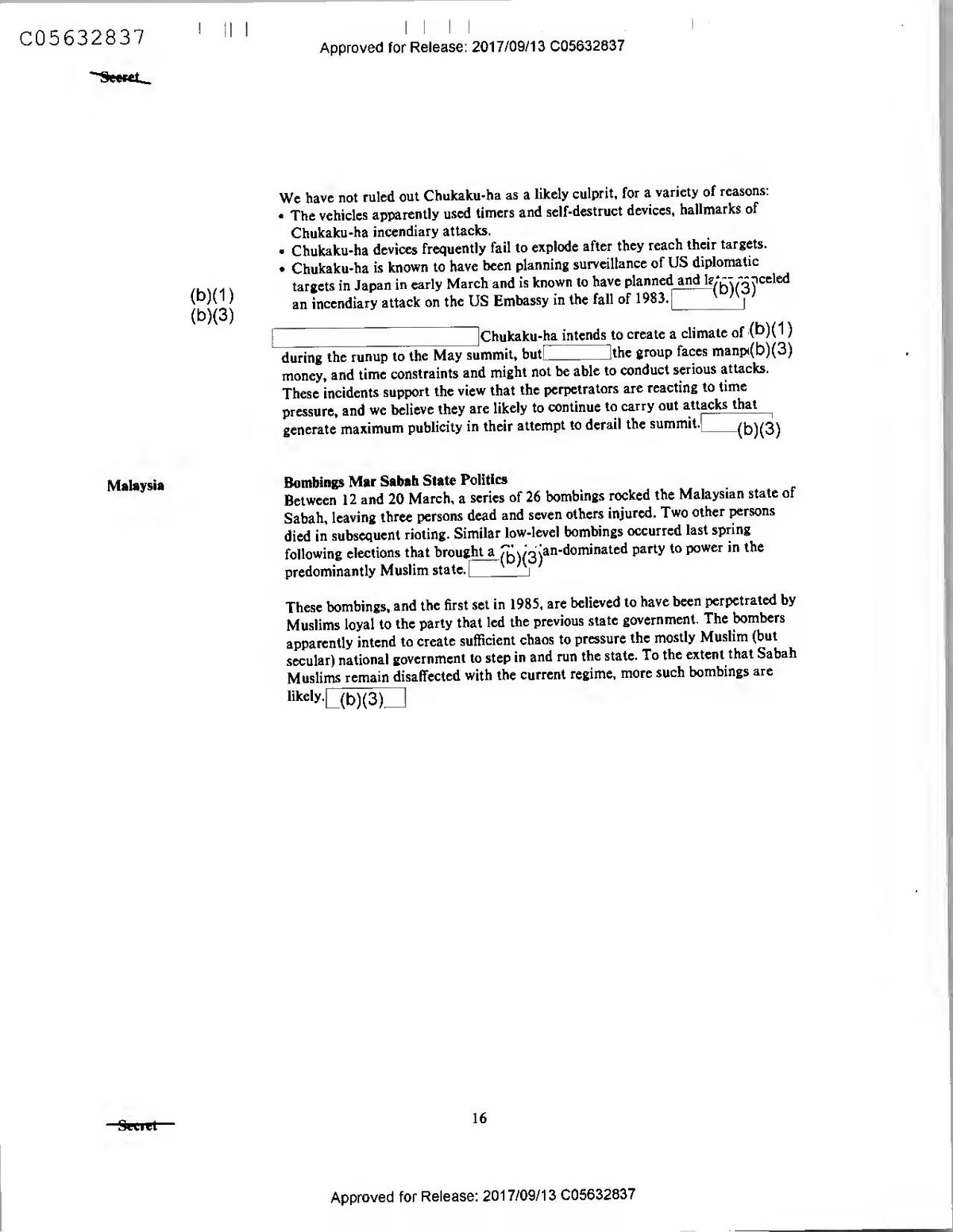
(b)(1) (b)(3)
We have not ruled out Chukaku-ha as a likely culprit, for a variety of reasons:
- The vehicles apparently used timers and self-destruct devices, hallmarks of Chukaku-ha incendiary attacks.
- Chukaku-ha devices frequently fail to explode after they reach their targets.
- Chukaku-ha is known to have been planning surveillance of US diplomatic targets in Japan in early March and is known to have planned and l:(b)(3)celed an incendiary attack on the US Embassy in the fall of 1983.
- Chukaku-ha intends to create a climate of (b)(1) during the runup to the May summit, but the group faces manpı(b)(3) money, and time constraints and might not be able to conduct serious attacks. These incidents support the view that the perpetrators are reacting to time pressure, and we believe they are likely to continue to carry out attacks that generate maximum publicity in their attempt to derail the summit.
-(b)(3)
Malaysia
Bombings Mar Sabah State Politics Between 12 and 20 March, a series of 26 bombings rocked the Malaysian state of Sabah, leaving three persons dead and seven others injured.
Two other persons died in subsequent rioting. Similar low-level bombings occurred last spring following elections that brought a b)(3jan-dominated party to power in the predominantly Muslim state.
These bombings, and the first set in 1985, are believed to have been perpetrated by Muslims loyal to the party that led the previous state government.
The bombers apparently intend to create sufficient chaos to pressure the mostly Muslim (but secular) national government to step in and run the state.
To the extent that Sabah Muslims remain disaffected with the current regime, more such bombings are likely. (b)(3)
Secret 16
Approved for Release: 2017/09/13 C05632837
Top
Secret
Director of Contrat Intelligence
(b)(3)
NEO 96-049JX
P.
National Intelligence Daily
Saturday 1 March 1986
_(b)(3)
Top
Secret
CPAS NID 86-0490X
24
1 March 1986 (b)(3)Approved for Release: 2017/09/13 006697549
Top
Secret
Director of Contrat Intelligence
(b)(3)
NEO 96-049JX
P.
National Intelligence Daily
Saturday 1 March 1986
_(b)(3)
Top
Secret
CPAS NID 86-0490X
24
1 March 1986 (b)(3)Approved for Release: 2017/09/13 006697549
Top Spee!
(b)(3)
Contents
NR
Notes
Sweden: Paime Assassination
8
NR
Top Secret
(b)(3)
(b)(3)
1 March 1986Approved for Release: 2017/09/13 C06697549
Top Spee!
(b)(3)
Contents
NR
Notes
Sweden: Paime Assassination
8
NR
Top Secret
(b)(3)
(b)(3)
1 March 1986Approved for Release: 2017/09/13 C06697549
Top
Secret (b)(3)
SWEDEN: Palme Assassination
Prime Minister Olof Palme was assassinated yesterday in Stockholm by an unknown assailant, possibly with one or more accomplices. Some Swedish Cabinet members-including Deputy Prime Minister Ingvar Carlsson-met in an emergency session early today. Carlsson will head an interlm government at least until parliament reconvenes next week. The Swedish press initially quoted police sources as saying Croatian separatists were responsible, but the police chief in Stockholm later said there was no evidence the murder was political.
(b)(3)
Comment: The political situation is likely to remain unsettled for the next few days or even weeks as the Social Democratic Party begins to plan Its future without the leadership of the popular and charismatic Palme. The opposition parties probably will restrain their usual criticism of domestic and foreign policies. Sweden's Internatlonal stature in foreign affairs was directly attributable to Palme-who focused much of his attention on disarmament and Third World issues. Stockholm now will probahly emphasize domestic concerns at least in the near term. (b)(3)
NR
(b)(3)
Top Secret
8
1 March 1986Approved for Release: 2017/09/13 C06697549
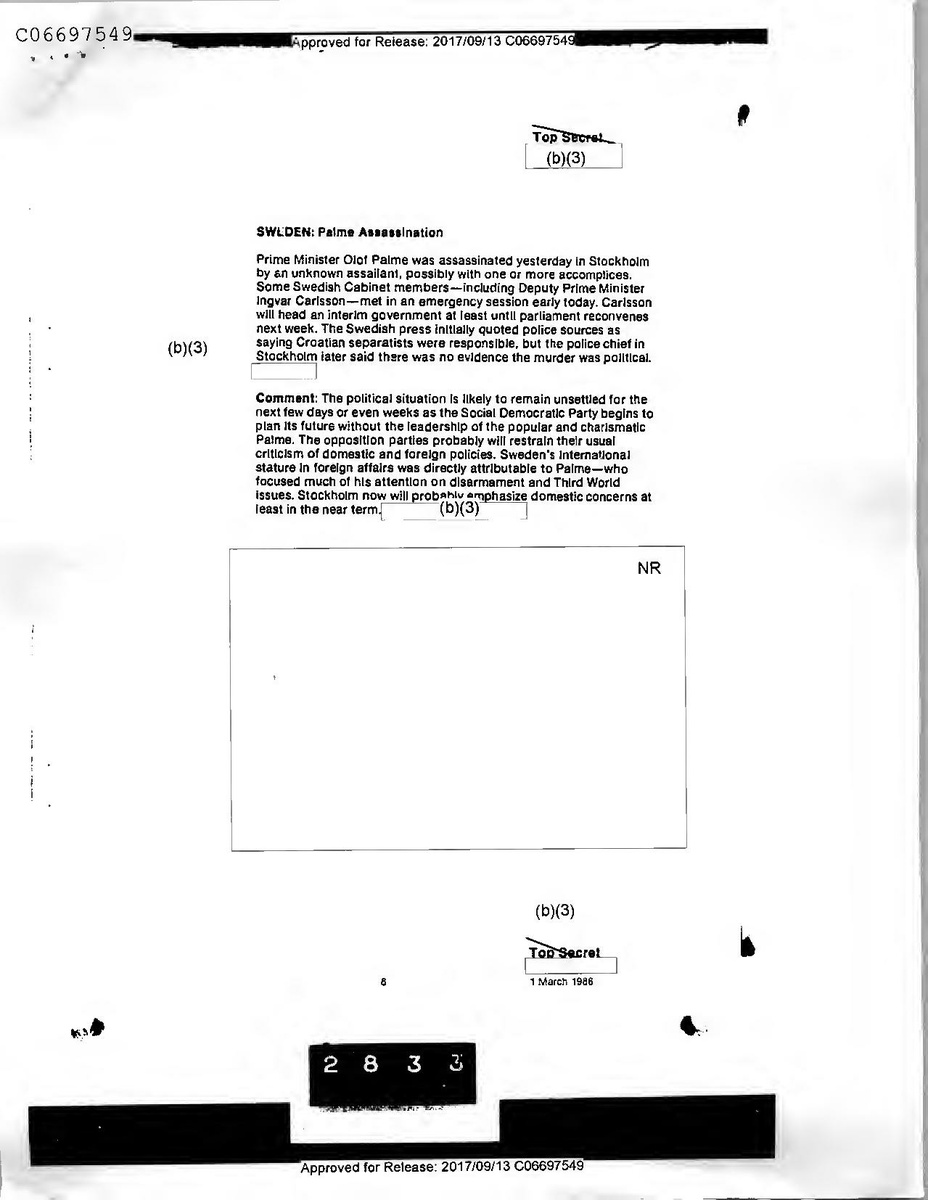
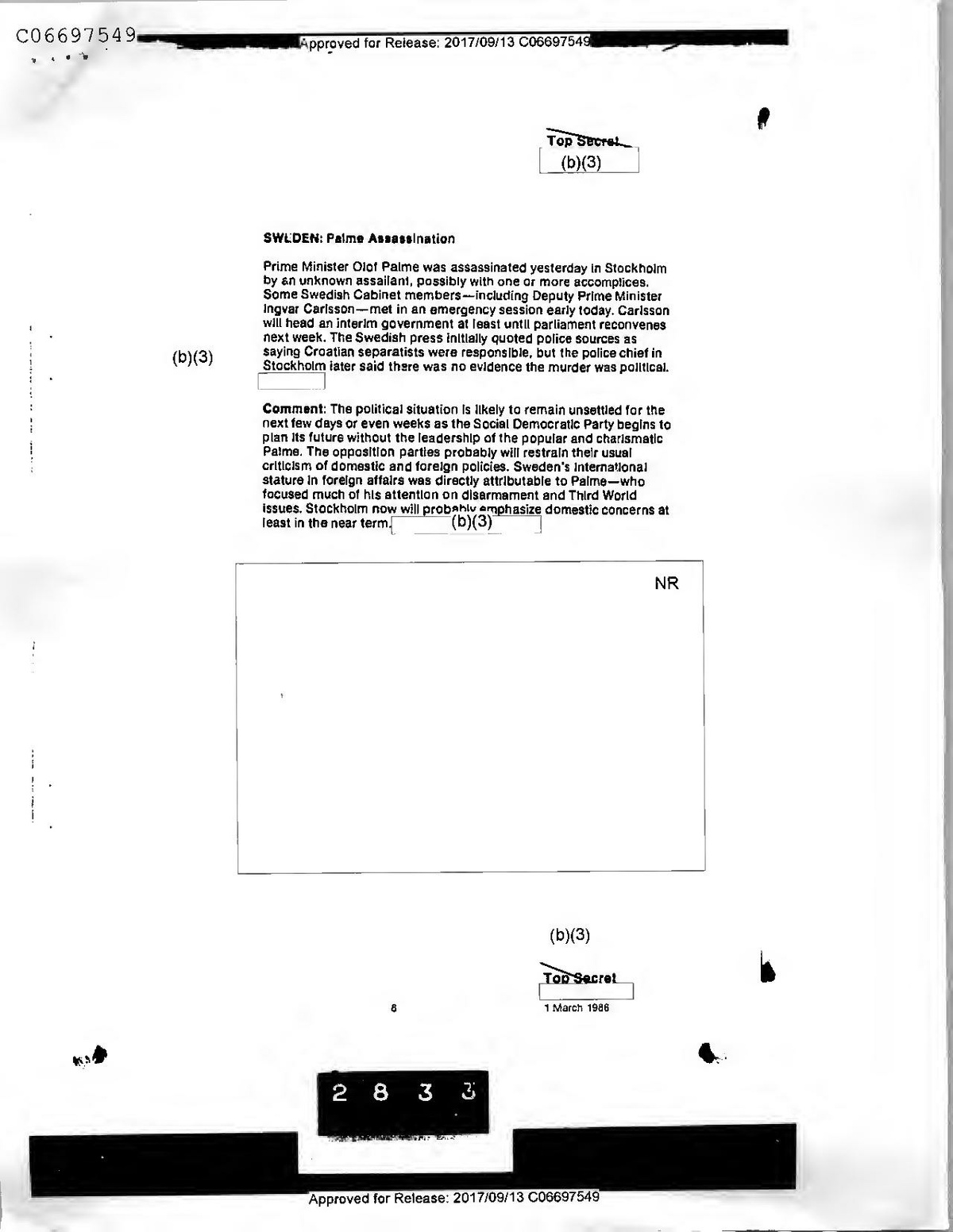
Top
Secret (b)(3)
SWEDEN: Palme Assassination
Prime Minister Olof Palme was assassinated yesterday in Stockholm by an unknown assailant, possibly with one or more accomplices. Some Swedish Cabinet members-including Deputy Prime Minister Ingvar Carlsson-met in an emergency session early today. Carlsson will head an interlm government at least until parliament reconvenes next week. The Swedish press initially quoted police sources as saying Croatian separatists were responsible, but the police chief in Stockholm later said there was no evidence the murder was political.
(b)(3)
Comment: The political situation is likely to remain unsettled for the next few days or even weeks as the Social Democratic Party begins to plan Its future without the leadership of the popular and charismatic Palme. The opposition parties probably will restrain their usual criticism of domestic and foreign policies. Sweden's Internatlonal stature in foreign affairs was directly attributable to Palme-who focused much of his attention on disarmament and Third World issues. Stockholm now will probahly emphasize domestic concerns at least in the near term. (b)(3)
NR
(b)(3)
Top Secret
8
1 March 1986Approved for Release: 2017/09/13 C06697549
Secret
Overview of International Terrorism in 1985 (b)(3)
The level of international terrorism has increased
International Terrorist Incidents, 1980-85 dramatically over the last two years, both in number of incidents and degree of lethality. From an annual average of about 500 incidents during the early 1980s, the level increased to nearly 600 in 1984. Preliminary Number of incidents (hundreds) figures for 1985 indicate the total is higher still about 800 incidents.' Several disturbing trends are discernible from the 1985 figures:
10
8
Worldwide incidents
6
• The United States and its friends and allies
continued to be primary targets. Israel, Egypt, and Jordan, for example, suffered more attacks in 1985 than in any previous year, and several of our West European allies were attacked by resurgent domestic terrorist groups, ostensibly because of their ties to NATO and the United States.
4
uut
2
• Terrorists increased their attacks on businessmen
and other nongovernment targets, thereby widening the impact of their operations.
-Incidents involving US
0
1980
"(b)(3)
• The number of persons killed or injured in
international terrorist attacks in 1985 exceeded 2,200—more than any other year. The previous record year was 1983, when the US and French contingents of the peacekeeping force and the US Embassy in Lebanon were bombed, causing record levels of death and injury.
308673 486
accounted for 28 percent of all international terrorist incidents. In 1984, this share grew to 47 percent-a larger share of a larger total. Such pround operated at nearly the same level in 1985. (b)(3)
• International terrorists continued to exhibit a
greater willingness to harm innocent bystanders through indiscriminate attacks. Increased use of large bombs accounted for many of the heightened casualty figures. (b)(3)
The continued high level of international terrorism by Middle Eastern groups owes much to state sponsorship-particularly by Syria, Iran, and Libya. Although the percentage of such incidents has declined from the level of the previous year, statesponsored terrorism still constituted a significant proportion-about 25 percent
of all Middle Eastern-origin incidents in 1985. (b)(3)
Middle East Terrorism of Middle Eastern origin accounts for much of the increase in international terrorism over the past two years. In 1983, Middle Eastern groups
-(b)(3)
17
-Secret
DI TR 86-005 April 1986
Approved for Release: 2017/09/13 C05632837
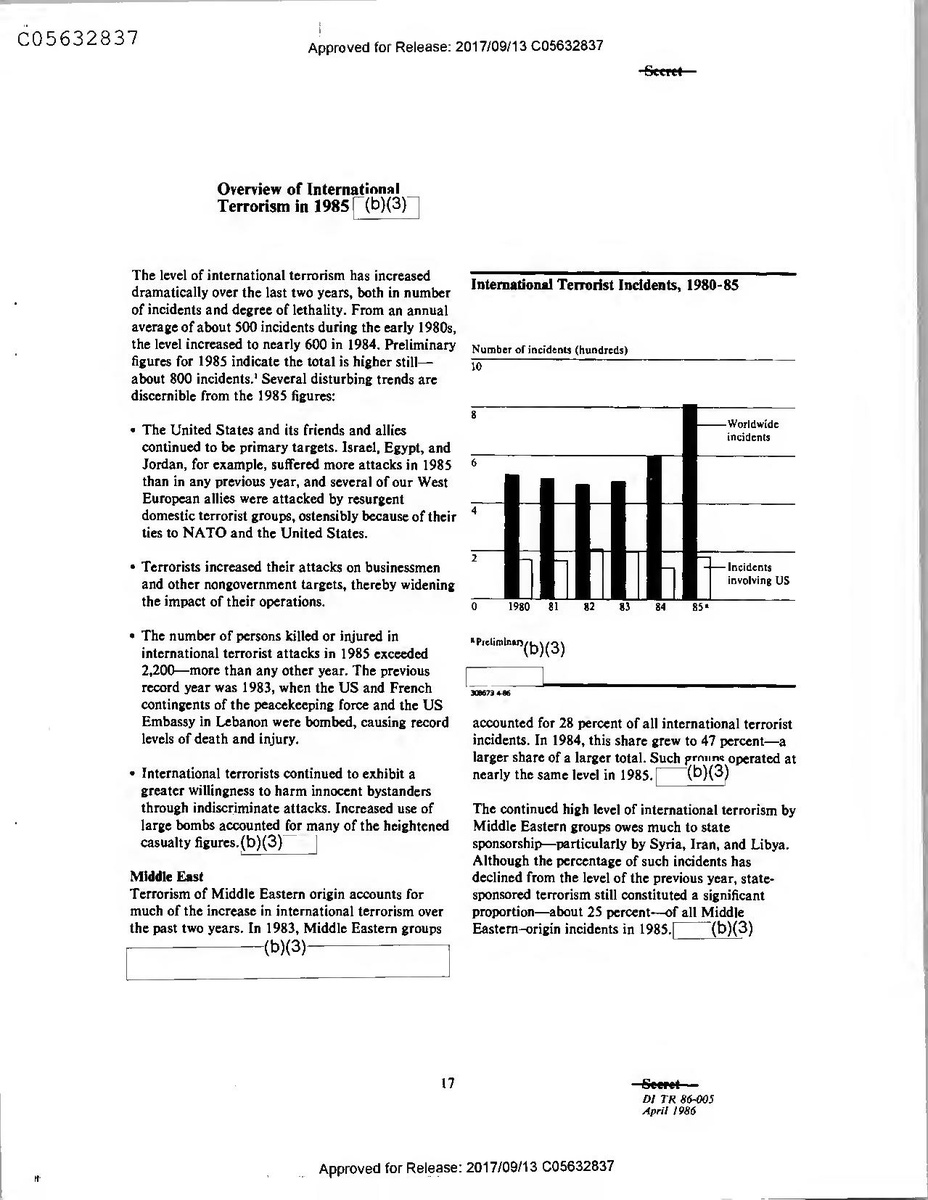
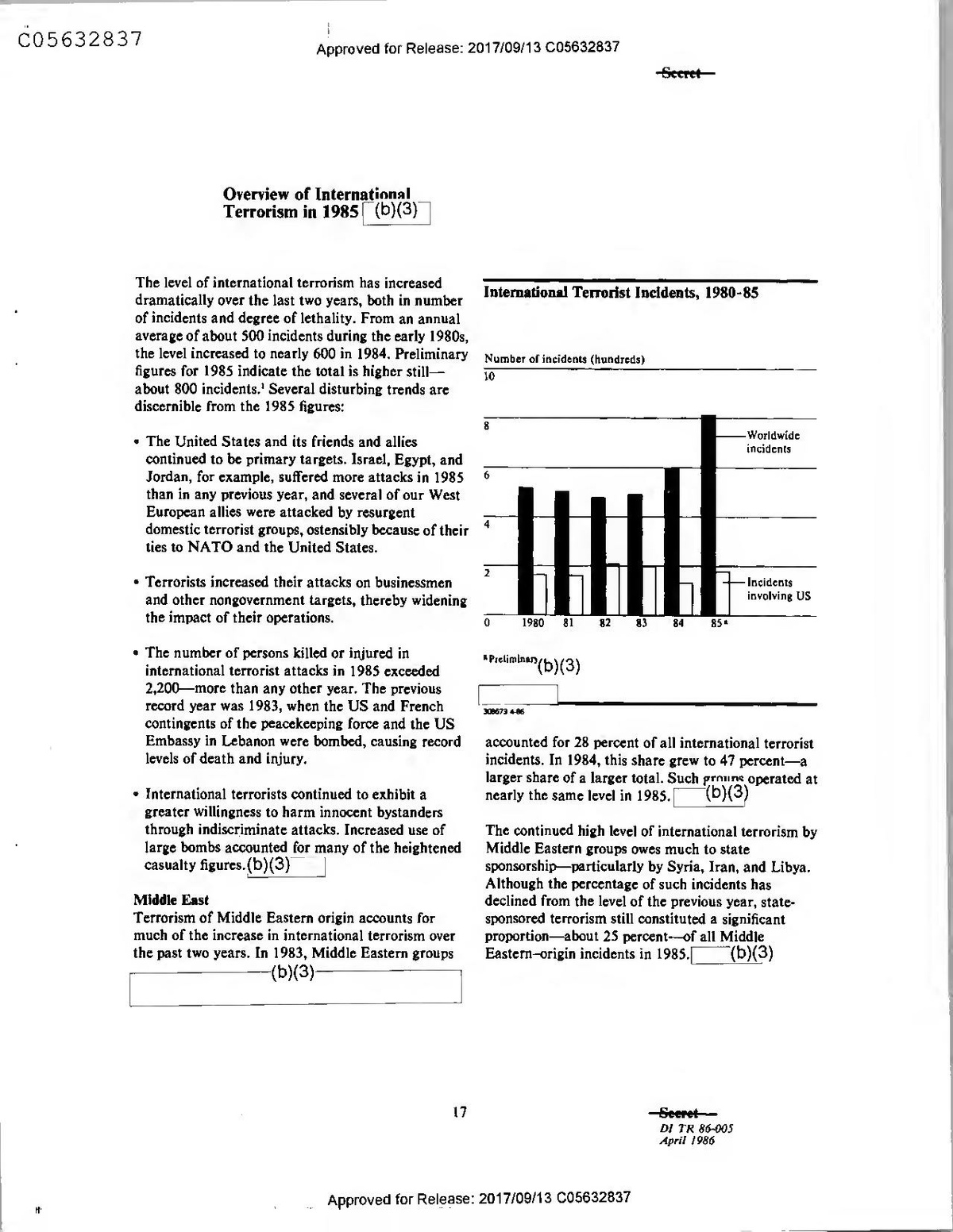
Secret
Overview of International Terrorism in 1985 (b)(3)
The level of international terrorism has increased
International Terrorist Incidents, 1980-85 dramatically over the last two years, both in number of incidents and degree of lethality. From an annual average of about 500 incidents during the early 1980s, the level increased to nearly 600 in 1984. Preliminary Number of incidents (hundreds) figures for 1985 indicate the total is higher still about 800 incidents.' Several disturbing trends are discernible from the 1985 figures:
10
8
Worldwide incidents
6
• The United States and its friends and allies
continued to be primary targets. Israel, Egypt, and Jordan, for example, suffered more attacks in 1985 than in any previous year, and several of our West European allies were attacked by resurgent domestic terrorist groups, ostensibly because of their ties to NATO and the United States.
4
uut
2
• Terrorists increased their attacks on businessmen
and other nongovernment targets, thereby widening the impact of their operations.
-Incidents involving US
0
1980
"(b)(3)
• The number of persons killed or injured in
international terrorist attacks in 1985 exceeded 2,200—more than any other year. The previous record year was 1983, when the US and French contingents of the peacekeeping force and the US Embassy in Lebanon were bombed, causing record levels of death and injury.
308673 486
accounted for 28 percent of all international terrorist incidents. In 1984, this share grew to 47 percent-a larger share of a larger total. Such pround operated at nearly the same level in 1985. (b)(3)
• International terrorists continued to exhibit a
greater willingness to harm innocent bystanders through indiscriminate attacks. Increased use of large bombs accounted for many of the heightened casualty figures. (b)(3)
The continued high level of international terrorism by Middle Eastern groups owes much to state sponsorship-particularly by Syria, Iran, and Libya. Although the percentage of such incidents has declined from the level of the previous year, statesponsored terrorism still constituted a significant proportion-about 25 percent
of all Middle Eastern-origin incidents in 1985. (b)(3)
Middle East Terrorism of Middle Eastern origin accounts for much of the increase in international terrorism over the past two years. In 1983, Middle Eastern groups
-(b)(3)
17
-Secret
DI TR 86-005 April 1986
Approved for Release: 2017/09/13 C05632837
Deeret
Casualities Resulting From International Terrorist Incidents, 1980-85
State-Supported International Terrorist Incidents, 1985
Percent
Number of casulaties (hundreds)
16
Iran 37.1
14
Other 7.9
12
Wounded
Iraq 4.5
10
8
Killed
tuli
Libya 15.7
6
4
Syria 34.8
2
0
1980
81
82
83
84
85 a
& Preliminary.
(b)(3)ry.
(b)(3)
100676 4
10674 4-06
A dramatic increase in Palestinian terrorism more than compensated for any decline in state-supported incidents. Palestinian terrorism accounted for more than half of all Middle Eastern inciden(b)(3)85, compared with about one-third in 1984.
Syrian interests. In 1985, for example, Syriansupported groups conducted about twice as many terrorist operations against Jordanian officials and facilities as they did the previous year.
(b)(3)
Many of the attacks in 1985 were conducted by radical Palestinians such as the Abu Nidal Group—that are known to receive extensive support from Damascus. One of the most dangerous Middle Eastern terrorist organizations, this group conducted 23 attacks last year, more than 60 percent of them in Western Europe. The number of dead and wounded was 34 and 327, respectively.[(b)(3)
Syrian-supported groups have also attacked US facilities in Jordan. We do not know if Syrian officials explicitly approved such attacks and doubt that President Assad is intent on directly targeting US personnel and facilities. We believe, however, that he exploits the anti-American militancy of these groups in order to penalize Vited States for policies that he opposes.
(b)(3)
Syrian-supported groups staged some 30 attacks in 1985—compared with 21 in all of 1984-including two against US facilities. President Assad continued to use terrorism to dissuade opponents and uncooperative allies from pursuing policies inimical to
Iran and Iranian-supported groups were responsible for over 30 international terrorist attacks in 1985. France, the United States, and Iraq remained the primary targets, but the Persian Gulf states also faced threats. Iran also became increasingly involved in
18
Secret
Approved for Release: 2017/09/13 C05632837
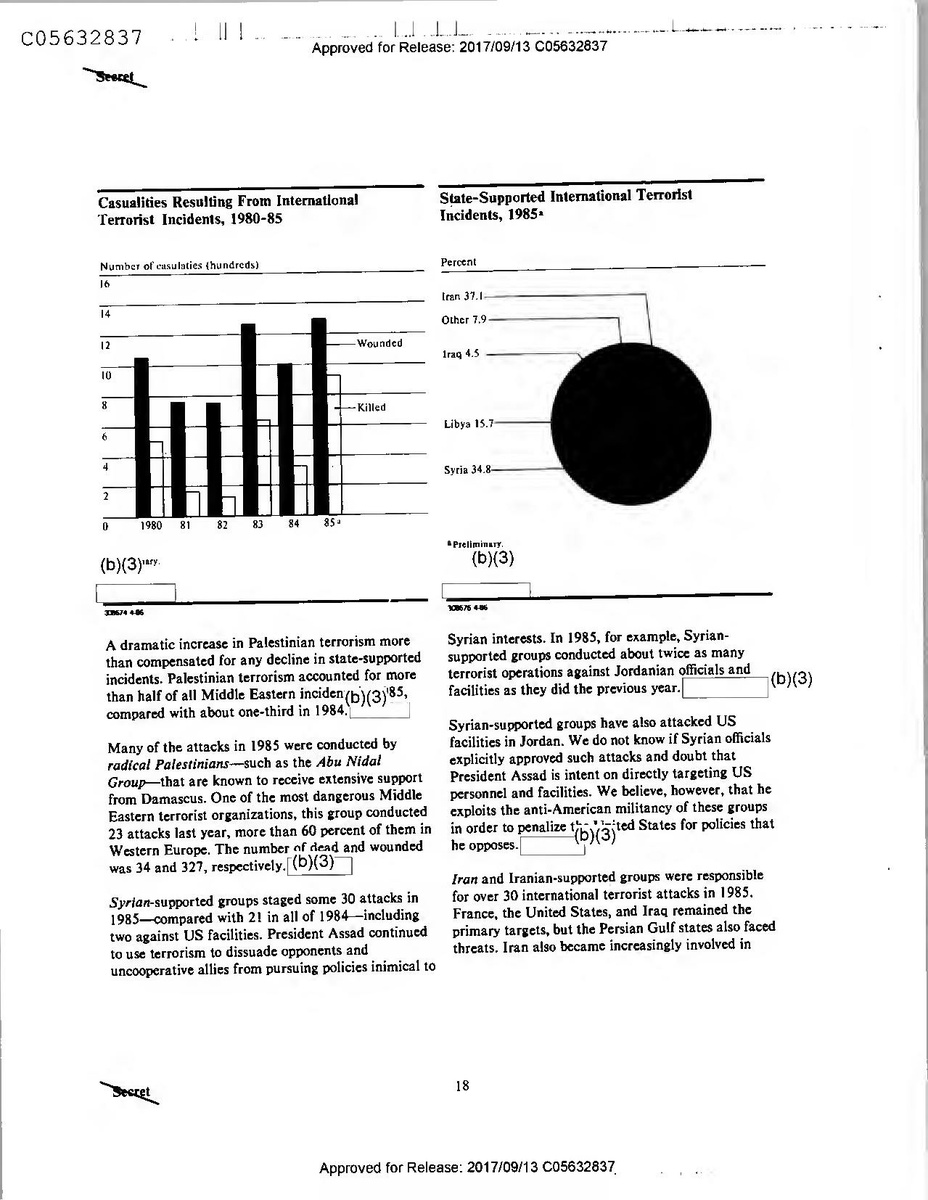
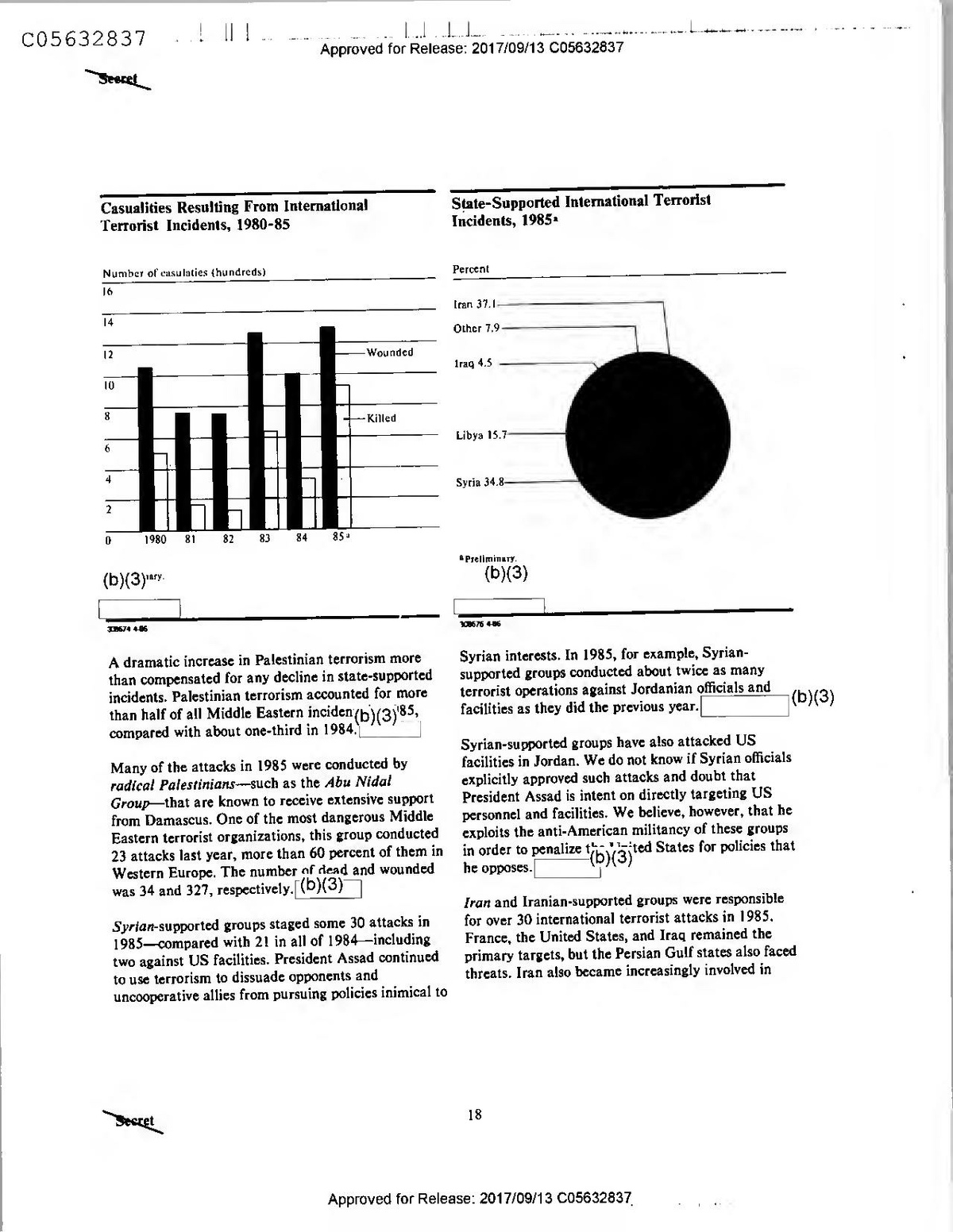
Deeret
Casualities Resulting From International Terrorist Incidents, 1980-85
State-Supported International Terrorist Incidents, 1985
Percent
Number of casulaties (hundreds)
16
Iran 37.1
14
Other 7.9
12
Wounded
Iraq 4.5
10
8
Killed
tuli
Libya 15.7
6
4
Syria 34.8
2
0
1980
81
82
83
84
85 a
& Preliminary.
(b)(3)ry.
(b)(3)
100676 4
10674 4-06
A dramatic increase in Palestinian terrorism more than compensated for any decline in state-supported incidents. Palestinian terrorism accounted for more than half of all Middle Eastern inciden(b)(3)85, compared with about one-third in 1984.
Syrian interests. In 1985, for example, Syriansupported groups conducted about twice as many terrorist operations against Jordanian officials and facilities as they did the previous year.
(b)(3)
Many of the attacks in 1985 were conducted by radical Palestinians such as the Abu Nidal Group—that are known to receive extensive support from Damascus. One of the most dangerous Middle Eastern terrorist organizations, this group conducted 23 attacks last year, more than 60 percent of them in Western Europe. The number of dead and wounded was 34 and 327, respectively.[(b)(3)
Syrian-supported groups have also attacked US facilities in Jordan. We do not know if Syrian officials explicitly approved such attacks and doubt that President Assad is intent on directly targeting US personnel and facilities. We believe, however, that he exploits the anti-American militancy of these groups in order to penalize Vited States for policies that he opposes.
(b)(3)
Syrian-supported groups staged some 30 attacks in 1985—compared with 21 in all of 1984-including two against US facilities. President Assad continued to use terrorism to dissuade opponents and uncooperative allies from pursuing policies inimical to
Iran and Iranian-supported groups were responsible for over 30 international terrorist attacks in 1985. France, the United States, and Iraq remained the primary targets, but the Persian Gulf states also faced threats. Iran also became increasingly involved in
18
Secret
Approved for Release: 2017/09/13 C05632837
Selected Chronology of 1985 High-Casualty Incidents
2 February
6 November
A popular bar in the Athens suburb of Glyfada was bombed by unknown terrorists, injuring 78 persons, including 57 US servicemen and their dependents.
The seizure of Colombia's Ministry of Justice by guerrillas belonging to the 19th of April Movement resulted in more than 100 deaths when government troops stormed the building.
12 April
23 November
A restaurant outside Madrid was bombed, probably by radical Palestinians, killing 18 Spaniards and wounding another 82 persons, including 15 Americans.
19 June
An armed attack on a cafe in San Salvador in June by terrorists tied to the Farabundo Marti Liberation Front killed 13 persons, including six Americans.
An Egyptian jetliner was hijacked from Athens to Malta by Abu Nidal terrorists, possibly with the cooperation of Egyptian dissidents. Before Egyptian commandos stormed the plane-killing some 60 persons who remained aboard—the terrorists executed five persons, including an American woman, and wounded the other Americans aboard.
23 June
7 December
A Shannon-bound Air India flight from Toronto was bombed over the North Atlantic, probably by Sikh extremists; 329 passengers and crewmembers were killed.
The bombing of two department stores in Paris by a hitherto unknown Middle Eastern group left about 35 holiday shoppers wounded.
8 August
27 December
A car bombing at Rhein-Main Airbase claimed by the West German Red Army Faction and French Action Directe-killed two Americans and wounded 17 other
Near-simultaneous attacks at the Rome and Vienna airports carried out by the Abu Nidal Group left more than 20 persons, including five Americans, dead and some 120 wounded, including 20 Americans.
persons.
(b)(3)
agitation and propaganda activity among Muslim populations in countries as distant as Nig'(b)(3). Pakistan, Indonesia, and the Philippines.[
Iraqi dissidents, who last year staged two attacks in Iraqi President Saddam Husayn's hometown.
Iran trains and finances numerous dissident and terrorist groups, such as:
• Shia dissidents from Kuwait and Bahrain. ProIranian dissidents attempted to assassinate the Amir of Kuwait last May, and Shia terrorist cells were uncovered in Kuwait, Bahrain, and the United Arab Emirates during 1985.[(b)(3)
• Radical Shia elements in Lebanon, including
Hizballah, the group responsible for the bulk of anti-US attacks in Lebanon.
19
Secret
Approved for Release: 2017/09/13 C05632837
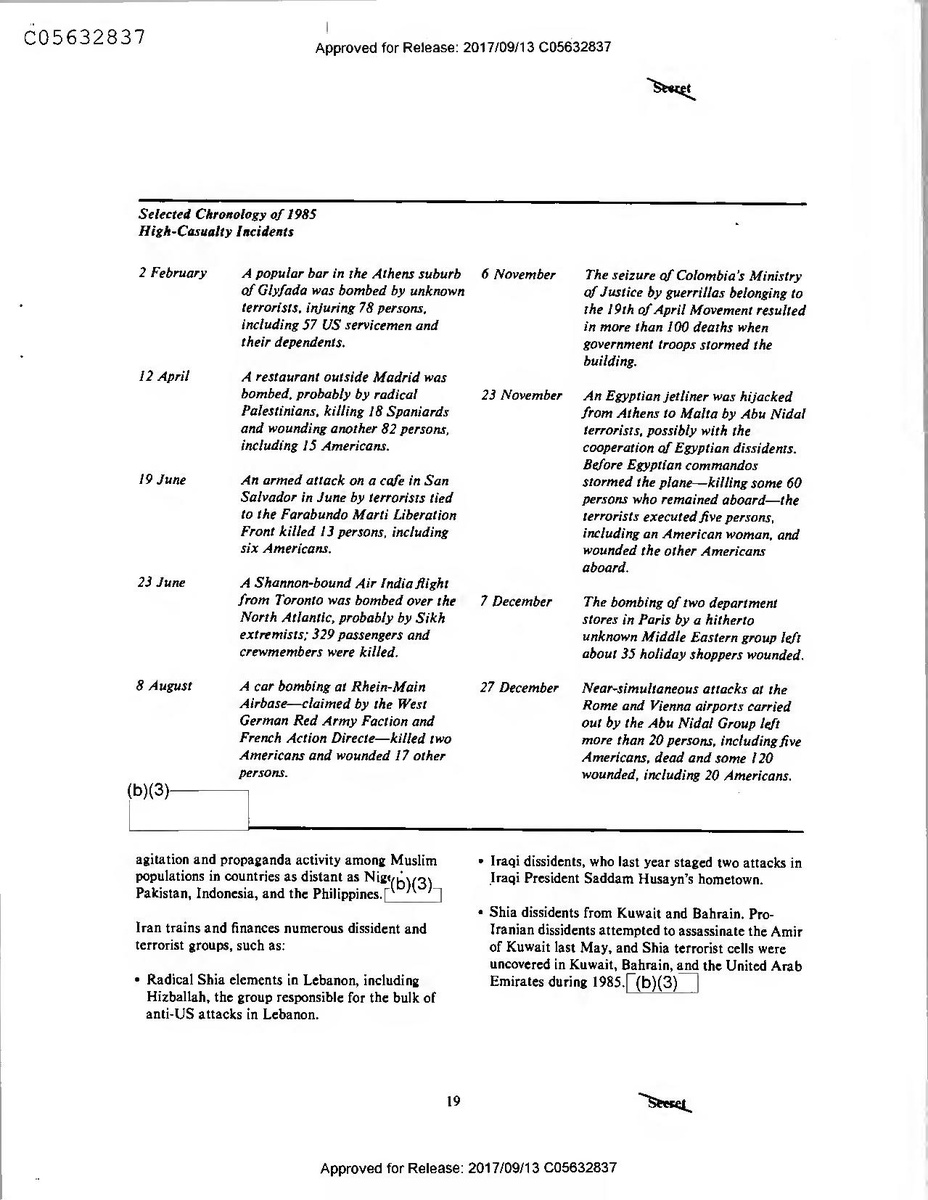
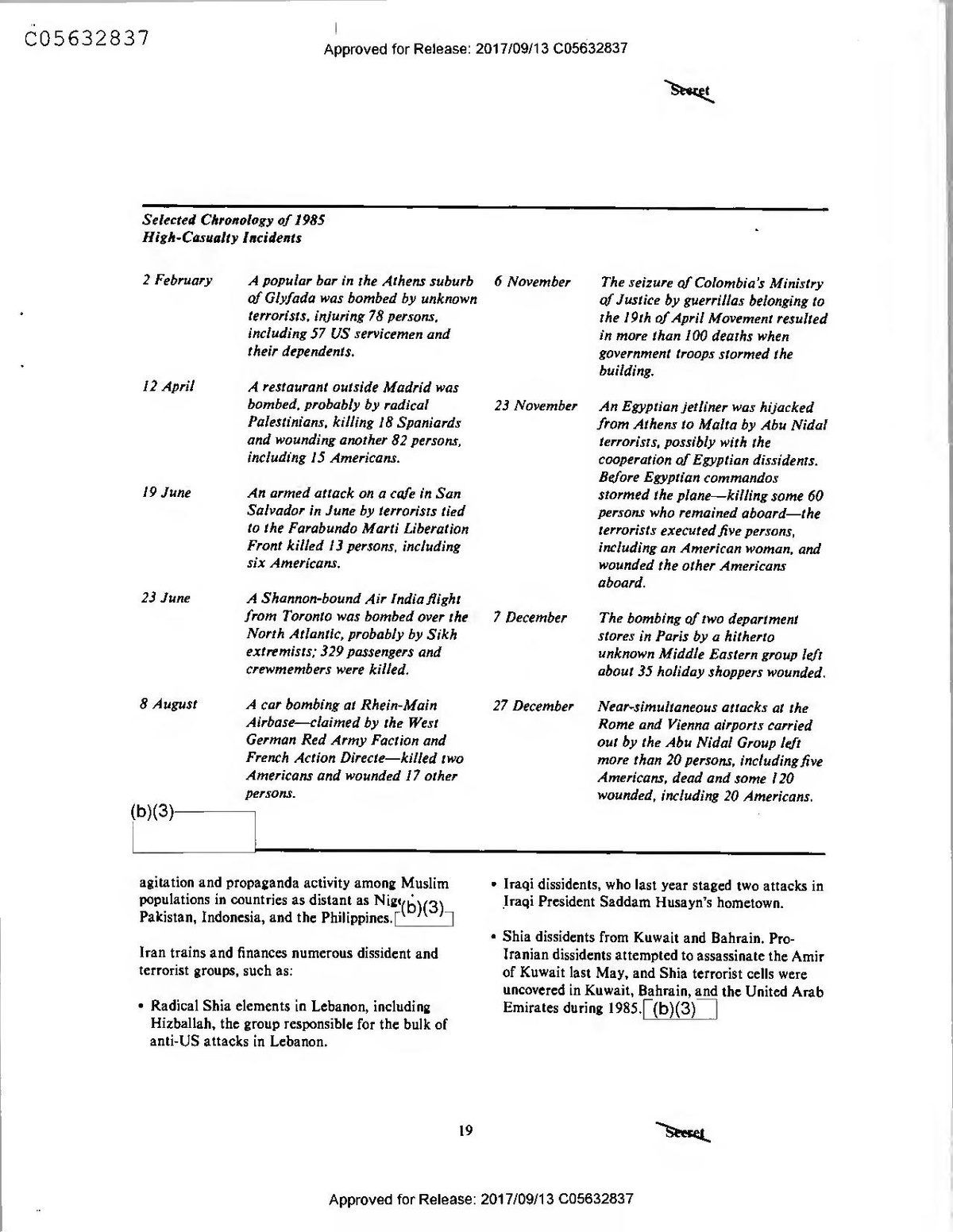
Selected Chronology of 1985 High-Casualty Incidents
2 February
6 November
A popular bar in the Athens suburb of Glyfada was bombed by unknown terrorists, injuring 78 persons, including 57 US servicemen and their dependents.
The seizure of Colombia's Ministry of Justice by guerrillas belonging to the 19th of April Movement resulted in more than 100 deaths when government troops stormed the building.
12 April
23 November
A restaurant outside Madrid was bombed, probably by radical Palestinians, killing 18 Spaniards and wounding another 82 persons, including 15 Americans.
19 June
An armed attack on a cafe in San Salvador in June by terrorists tied to the Farabundo Marti Liberation Front killed 13 persons, including six Americans.
An Egyptian jetliner was hijacked from Athens to Malta by Abu Nidal terrorists, possibly with the cooperation of Egyptian dissidents. Before Egyptian commandos stormed the plane-killing some 60 persons who remained aboard—the terrorists executed five persons, including an American woman, and wounded the other Americans aboard.
23 June
7 December
A Shannon-bound Air India flight from Toronto was bombed over the North Atlantic, probably by Sikh extremists; 329 passengers and crewmembers were killed.
The bombing of two department stores in Paris by a hitherto unknown Middle Eastern group left about 35 holiday shoppers wounded.
8 August
27 December
A car bombing at Rhein-Main Airbase claimed by the West German Red Army Faction and French Action Directe-killed two Americans and wounded 17 other
Near-simultaneous attacks at the Rome and Vienna airports carried out by the Abu Nidal Group left more than 20 persons, including five Americans, dead and some 120 wounded, including 20 Americans.
persons.
(b)(3)
agitation and propaganda activity among Muslim populations in countries as distant as Nig'(b)(3). Pakistan, Indonesia, and the Philippines.[
Iraqi dissidents, who last year staged two attacks in Iraqi President Saddam Husayn's hometown.
Iran trains and finances numerous dissident and terrorist groups, such as:
• Shia dissidents from Kuwait and Bahrain. ProIranian dissidents attempted to assassinate the Amir of Kuwait last May, and Shia terrorist cells were uncovered in Kuwait, Bahrain, and the United Arab Emirates during 1985.[(b)(3)
• Radical Shia elements in Lebanon, including
Hizballah, the group responsible for the bulk of anti-US attacks in Lebanon.
19
Secret
Approved for Release: 2017/09/13 C05632837
Secret
(b)(3)
In 1985, Libyan-supported terrorists also operated elsewhere, most notably:
Iran continues to target anti-Khomeini exiles. Last September, for example, an exiled Iranian tribal leader Shah was gunned down in
kb)(3)
ties to the Iran uses some of its diplomatic and cultural missions to support terrorists. Many elements of the Iranian Government, including several senio(b)(3)ıls, are directly involved in terrorist activity.
• In Tunisia, about 50 suspected Libyan-backed
saboteurs were arrested last fall. The terrorists were infiltrated into Tunisia when Libya expelled more than 30,000 Tunisian workers. Libyans carrying false documentation were among those arrested.
• In Zaire, security officials claim to have thwarted a
Libyan-sponsored plot to kill President Mobutu in September.
• In Chad, Lihontinued to target President
Habre.
(b)(3)
Libyan-supported groups or clandestine state agents staged 15 successfUL attacks in 1985, mostly against Libyan exiles. Last year, Libyan state agents attacked so-called stray dogs in Greece, West Germany, Cyprus, Italy, and Austria. Egyptian-based exiles were frequent Libyan targets. Tripoli also apparently targeted exiles participating in last year's pilgrimage to Mecca, but did not act on its plans. About 8,000 Libyan pilgrims—some in possession of explosives— did, however, stage a violent demonstration in Mecca immediately after the Hajj.(b)(3)
In addition to providing training, arms, encouragement, and funds to dissident and insurgent groups, Libya increasingly strengthened its long-term relationship with radical Palestinian groups. Abu Nidal, the notorious Palestinian terrorist, reportedly is living in Tripoli and has moved part of his organization there. Qadhafi almost certainly views the radical Palestinians as potential allies in his terrorist
We have identified Palestinians as the perpetrators of more than 200 international terrorist incidents during 1985. The continued internecine Palestinian feuding, coupled with Arafat's apparent inability or unwillingness to control hardliners aligned with him, indicates that the large share of international terrorist attacks carried out by Palestinians will continue. This increased Palestinian activity was reflected in: • A rise in terrorist attacks inside Israel and the
occupied territories, with virtually every Palestinian
group claiming credit. • An increase in the number of attacks by Syriansponsored groups especially the Abu Nidal
Groupin Western Europe. • Intra-Palestinian terrorism resulting from the split
last year in the Palestine Liberation Organization, and pressure from Fatah hard' Arafat's political strategy.
operations (b)(3) Libyan exiles and non-Libyan
opponents.
(b)(3) pposed to
Libya also focused increased attention on the United States. Libyans were observed taking pictures of the US Embassy in Sudan and also exerted pressure on the Somali Government to lease property adjacent to US Embassy housing in Mogadishu. In addition, Qadhafi has made references in recent speeches to his contacts with American radicals. (b)(3)
Increasingly, Middle Eastern terrorists are conducting attacks outside the region, particularly in Western Europe, and the data for 1985 affirm this trend. The 70-odd incidents of Middle Eastern-origin terrorism that occurred in Western Europe last year exceed 1984's total and are double the annual average for 1980-83. Most of the Middle Eastern-generated activity in Western Europe has not directly affected
20
Secret
Approved for Release: 2017/09/13 C05632837
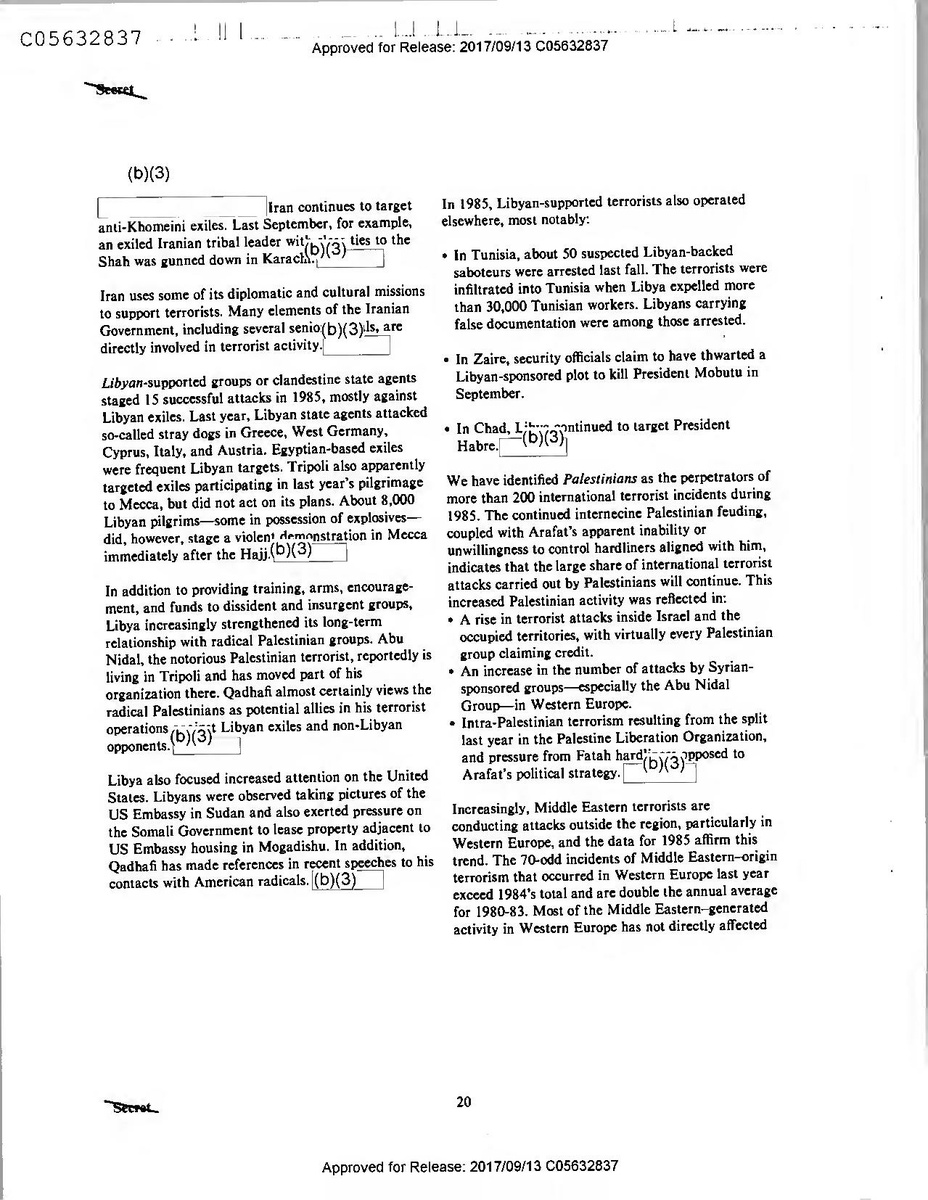
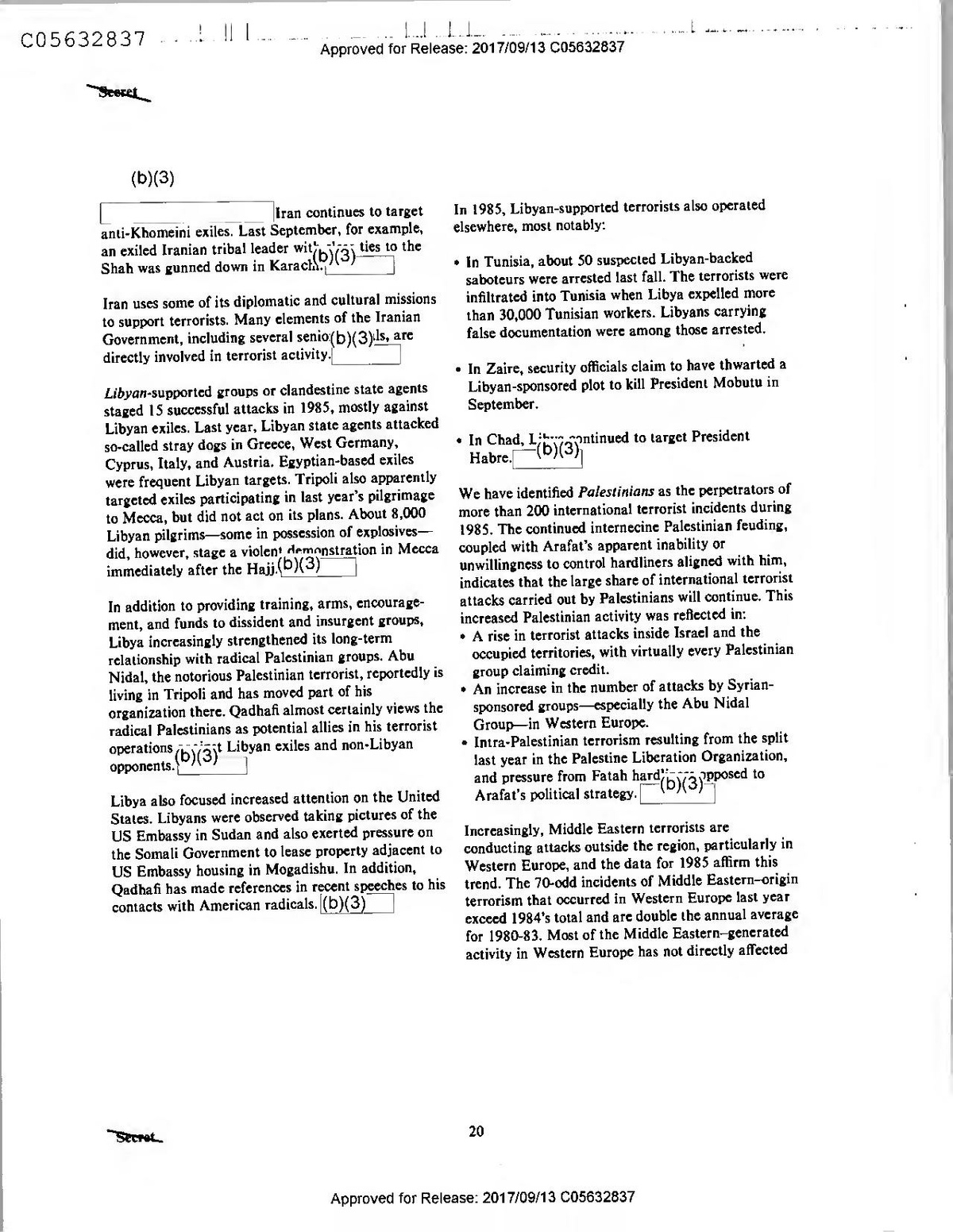
Secret
(b)(3)
In 1985, Libyan-supported terrorists also operated elsewhere, most notably:
Iran continues to target anti-Khomeini exiles. Last September, for example, an exiled Iranian tribal leader Shah was gunned down in
kb)(3)
ties to the Iran uses some of its diplomatic and cultural missions to support terrorists. Many elements of the Iranian Government, including several senio(b)(3)ıls, are directly involved in terrorist activity.
• In Tunisia, about 50 suspected Libyan-backed
saboteurs were arrested last fall. The terrorists were infiltrated into Tunisia when Libya expelled more than 30,000 Tunisian workers. Libyans carrying false documentation were among those arrested.
• In Zaire, security officials claim to have thwarted a
Libyan-sponsored plot to kill President Mobutu in September.
• In Chad, Lihontinued to target President
Habre.
(b)(3)
Libyan-supported groups or clandestine state agents staged 15 successfUL attacks in 1985, mostly against Libyan exiles. Last year, Libyan state agents attacked so-called stray dogs in Greece, West Germany, Cyprus, Italy, and Austria. Egyptian-based exiles were frequent Libyan targets. Tripoli also apparently targeted exiles participating in last year's pilgrimage to Mecca, but did not act on its plans. About 8,000 Libyan pilgrims—some in possession of explosives— did, however, stage a violent demonstration in Mecca immediately after the Hajj.(b)(3)
In addition to providing training, arms, encouragement, and funds to dissident and insurgent groups, Libya increasingly strengthened its long-term relationship with radical Palestinian groups. Abu Nidal, the notorious Palestinian terrorist, reportedly is living in Tripoli and has moved part of his organization there. Qadhafi almost certainly views the radical Palestinians as potential allies in his terrorist
We have identified Palestinians as the perpetrators of more than 200 international terrorist incidents during 1985. The continued internecine Palestinian feuding, coupled with Arafat's apparent inability or unwillingness to control hardliners aligned with him, indicates that the large share of international terrorist attacks carried out by Palestinians will continue. This increased Palestinian activity was reflected in: • A rise in terrorist attacks inside Israel and the
occupied territories, with virtually every Palestinian
group claiming credit. • An increase in the number of attacks by Syriansponsored groups especially the Abu Nidal
Groupin Western Europe. • Intra-Palestinian terrorism resulting from the split
last year in the Palestine Liberation Organization, and pressure from Fatah hard' Arafat's political strategy.
operations (b)(3) Libyan exiles and non-Libyan
opponents.
(b)(3) pposed to
Libya also focused increased attention on the United States. Libyans were observed taking pictures of the US Embassy in Sudan and also exerted pressure on the Somali Government to lease property adjacent to US Embassy housing in Mogadishu. In addition, Qadhafi has made references in recent speeches to his contacts with American radicals. (b)(3)
Increasingly, Middle Eastern terrorists are conducting attacks outside the region, particularly in Western Europe, and the data for 1985 affirm this trend. The 70-odd incidents of Middle Eastern-origin terrorism that occurred in Western Europe last year exceed 1984's total and are double the annual average for 1980-83. Most of the Middle Eastern-generated activity in Western Europe has not directly affected
20
Secret
Approved for Release: 2017/09/13 C05632837
MEMORANDUM
(b)(3)
Soviet Disinformation:
Allegations of US Misdeeds
1. Over the past two years we have witnessed continual Soviet charges about the international behavior of the United States that the Soviets know or have substantial reason to believe are patently false. These charges, which range from allegations of US involvement in assassinations of foreign political leaders to charges that the United States is responsible for major international outbreaks of disease, emerge through a variety of channels. Some are the direct product of their own media and are therefore easily identifiable as Soviet initiatives. The Soviets, however, also use clandestine means-for example, forgeries, rumor, and placement of disinformation in the foreign press--that are more difficult to trace conclusively to Moscow. Some examples of Soviet efforts to discredit the United States are described below in several major themes.
-(b)(3)
L ) 3
2.
US Involvement in Assassinations. Moscow often attempts to implicaten he United States when an international figure dies violently. (b)(3)
O
Immediately after Olof Palme was assassinated in February, TASS reported that Palme had been under surveillance by the CIA for many years. This implication of US complicity in the murder was followed by a similar report in Izvestiya and in Georgiy Arbatov's eulogy to Palme. By suggesting that the pattern of Palme's murder was similar to that of Indira Gandhi, the Soviet reports resurfaced old charges of US complicity in the assassination of Indira Gandhi and other political leaders. US embassies in Spain, India, and Uruguay, as
well as swedenor Esportsb)(3-plays in the local press of
the .
O
In the initial report of Palme's death on 1 March, the TASS analyst also referred to the death last year of Samantha Smith. Another TASS article on the same day described an alleged FBI assessment that Smith was a menace to national security. (b)(3)
(b)(3)
GI M 86-20081 28 March 1986
-(b)(3)
SECRET
_Approved for Release: 2017/09/13 C05612850...
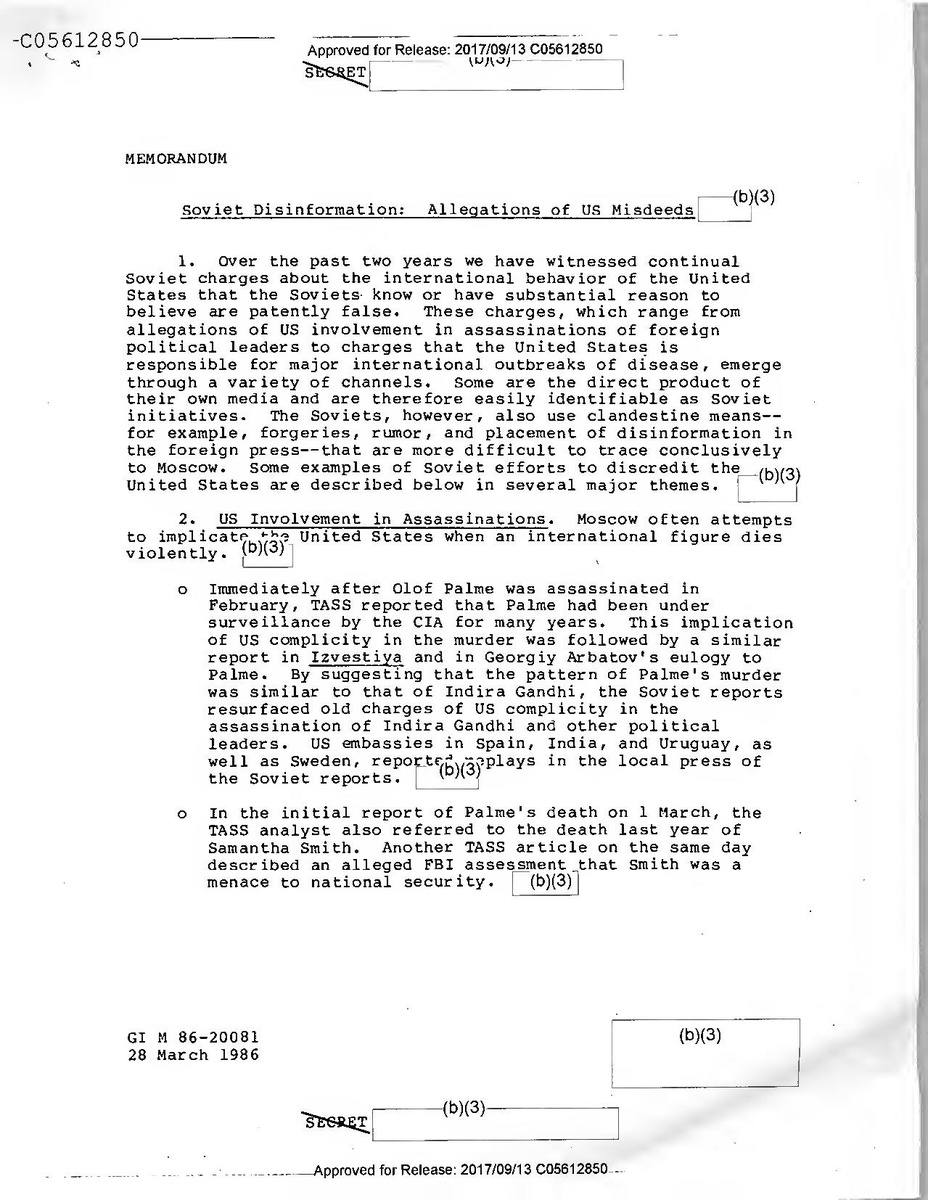
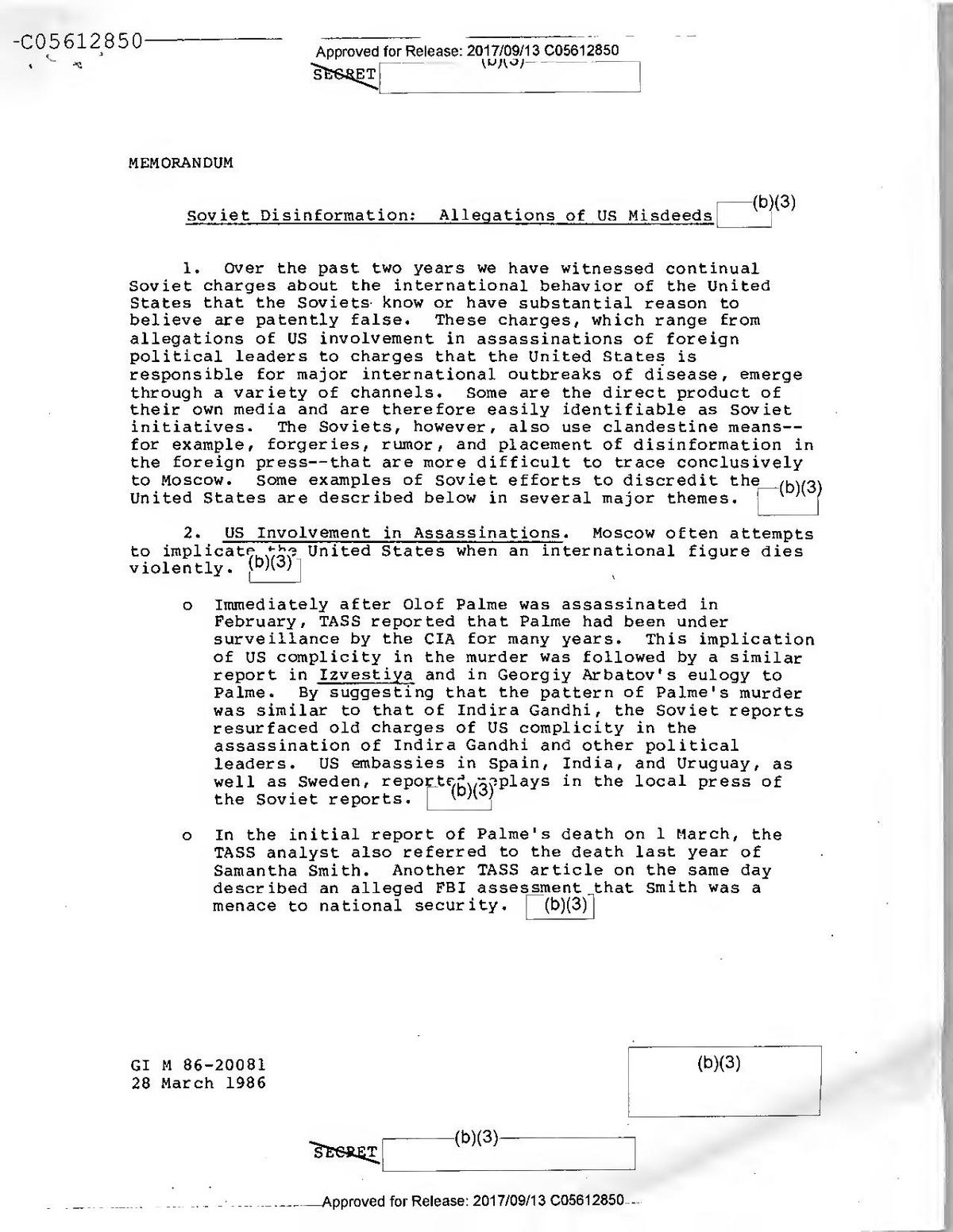
MEMORANDUM
(b)(3)
Soviet Disinformation:
Allegations of US Misdeeds
1. Over the past two years we have witnessed continual Soviet charges about the international behavior of the United States that the Soviets know or have substantial reason to believe are patently false. These charges, which range from allegations of US involvement in assassinations of foreign political leaders to charges that the United States is responsible for major international outbreaks of disease, emerge through a variety of channels. Some are the direct product of their own media and are therefore easily identifiable as Soviet initiatives. The Soviets, however, also use clandestine means-for example, forgeries, rumor, and placement of disinformation in the foreign press--that are more difficult to trace conclusively to Moscow. Some examples of Soviet efforts to discredit the United States are described below in several major themes.
-(b)(3)
L ) 3
2.
US Involvement in Assassinations. Moscow often attempts to implicaten he United States when an international figure dies violently. (b)(3)
O
Immediately after Olof Palme was assassinated in February, TASS reported that Palme had been under surveillance by the CIA for many years. This implication of US complicity in the murder was followed by a similar report in Izvestiya and in Georgiy Arbatov's eulogy to Palme. By suggesting that the pattern of Palme's murder was similar to that of Indira Gandhi, the Soviet reports resurfaced old charges of US complicity in the assassination of Indira Gandhi and other political leaders. US embassies in Spain, India, and Uruguay, as
well as swedenor Esportsb)(3-plays in the local press of
the .
O
In the initial report of Palme's death on 1 March, the TASS analyst also referred to the death last year of Samantha Smith. Another TASS article on the same day described an alleged FBI assessment that Smith was a menace to national security. (b)(3)
(b)(3)
GI M 86-20081 28 March 1986
-(b)(3)
SECRET
_Approved for Release: 2017/09/13 C05612850...
Secret
Middle Eastern-Origin Terrorist Incidents in Western Europe, 1980-85
at Rhein-Main Airbase in August. Despite counterterrorist successes against the organization, West German security officials continue to believe
that the RAD)(3)pable of conducting another major
Number of incidents
80
70
60
In France, Action Directe conducted 22 terrorist attacks last year, including the assassination in January of a high-level official in the Defense Ministry. Nearly all of these were directed at domestic political targets. In December, however, terrorists bombed the office in Versailles of the Central Europe Operating, Aronsy, which monitors the NATO pipeline.?
(b)(3)
SO
40
30
bUL
20
10
0
1980
Most of the dozen or so international terrorist incidents that occurred in Italy during 1985 were conducted by Middle Easterners against non-Western targets. However, one of the most spectacular attacks of the year—the hijacking in October of the Italian cruise ship Achille Lauro—victimized many nationalities, primarily Western. An Ame, was killed before the incident ended.
81
82
83
84
85
& Preliminary.
(b)(3)
300675 4
US interests, although this appears to be changing. The TWA hijacking in June, the seizure of the Achille Lauro in October, the diversion to Malta of the Egyptian airliner in November, and the attack on the Rome airmat in December all resulted in US
fatalities.(b)(3)
Belgian terrorists carried out some 30 attacks in 1985. Most of these were conducted by the Communist Combatant Cells (CCC), which surfaced in October 1984 in connection with a series of attacks against NATO and defense-related targets. The group bombed offices of the Motorola Company in Brussels on the day of President Reagan's meeting with allies to discuss the Geneva summit. In December, it blew up a control station on the NATO pipeline in western Belgium-within a half hour of the Versailles bombing. Since the arrest by Belgian security officials of key members of the group in mid-December, _(b)(3) however, there have been no further attacks.
Western Europe Some 200 international terrorist incidents occurred in Western Europe during 1985. About one-third of these were directed against US or NATO-related targets, primarily by West European terrorists. Although the growing number of incidents conducted in Western Europe by terrorists of Middle Eastern origin is of increasing concern, European authorities
have also had to contend (b)(3)ntinuing activity
The separatist Basque Fatherland and Liberty (ETA) remained Spain's most serious terrorist problem in 1985, despite counterterrorist successes by Spanish and French police and continued murders of ETA members by the Antiterrorist Liberation Group, which Spanish and French press sources have linked to the Spanish police. Spain's other major terrorist
from domestic terrorists.
In West Germany, sympathizers and hardcore members of the Red Army Faction (RAF) carried out more than a dozen attacks against US and NATOrelated interests last year, including the car bombing
For a more detailed examination of terrorism affecting interesis, see the accompanying article in this issue.
"(b)(3),
21
Secret
Approved for Release: 2017/09/13 C05632837
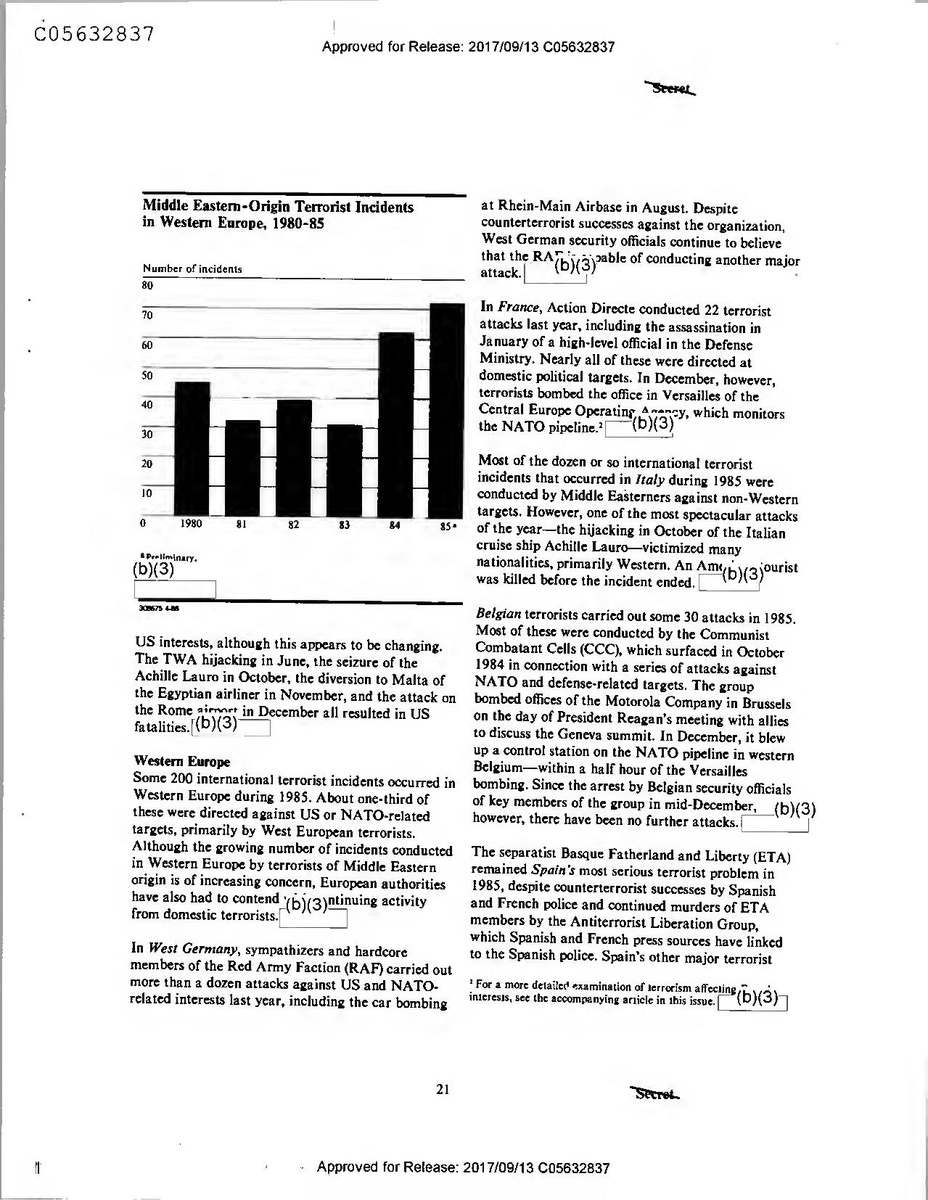
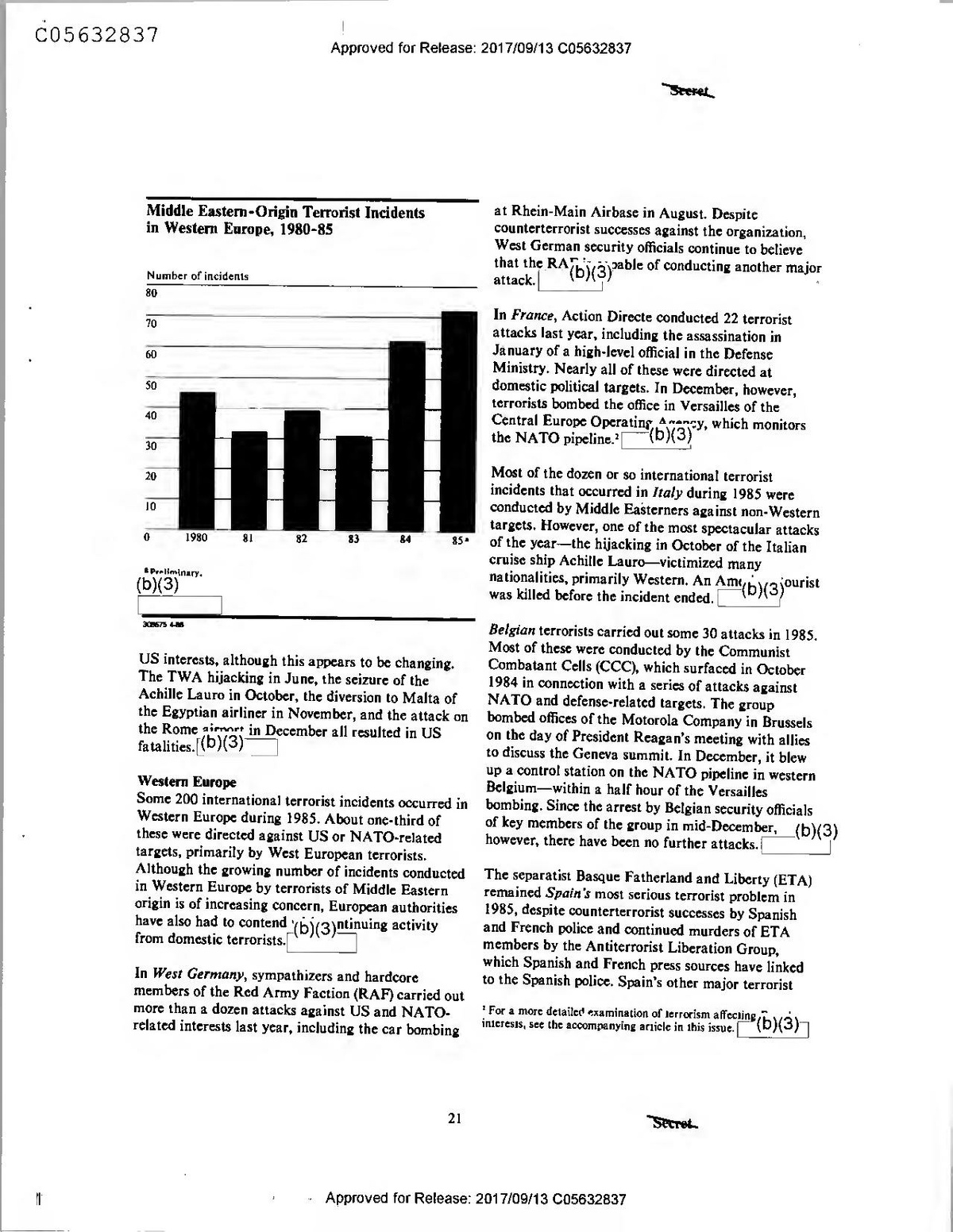
Secret
Middle Eastern-Origin Terrorist Incidents in Western Europe, 1980-85
at Rhein-Main Airbase in August. Despite counterterrorist successes against the organization, West German security officials continue to believe
that the RAD)(3)pable of conducting another major
Number of incidents
80
70
60
In France, Action Directe conducted 22 terrorist attacks last year, including the assassination in January of a high-level official in the Defense Ministry. Nearly all of these were directed at domestic political targets. In December, however, terrorists bombed the office in Versailles of the Central Europe Operating, Aronsy, which monitors the NATO pipeline.?
(b)(3)
SO
40
30
bUL
20
10
0
1980
Most of the dozen or so international terrorist incidents that occurred in Italy during 1985 were conducted by Middle Easterners against non-Western targets. However, one of the most spectacular attacks of the year—the hijacking in October of the Italian cruise ship Achille Lauro—victimized many nationalities, primarily Western. An Ame, was killed before the incident ended.
81
82
83
84
85
& Preliminary.
(b)(3)
300675 4
US interests, although this appears to be changing. The TWA hijacking in June, the seizure of the Achille Lauro in October, the diversion to Malta of the Egyptian airliner in November, and the attack on the Rome airmat in December all resulted in US
fatalities.(b)(3)
Belgian terrorists carried out some 30 attacks in 1985. Most of these were conducted by the Communist Combatant Cells (CCC), which surfaced in October 1984 in connection with a series of attacks against NATO and defense-related targets. The group bombed offices of the Motorola Company in Brussels on the day of President Reagan's meeting with allies to discuss the Geneva summit. In December, it blew up a control station on the NATO pipeline in western Belgium-within a half hour of the Versailles bombing. Since the arrest by Belgian security officials of key members of the group in mid-December, _(b)(3) however, there have been no further attacks.
Western Europe Some 200 international terrorist incidents occurred in Western Europe during 1985. About one-third of these were directed against US or NATO-related targets, primarily by West European terrorists. Although the growing number of incidents conducted in Western Europe by terrorists of Middle Eastern origin is of increasing concern, European authorities
have also had to contend (b)(3)ntinuing activity
The separatist Basque Fatherland and Liberty (ETA) remained Spain's most serious terrorist problem in 1985, despite counterterrorist successes by Spanish and French police and continued murders of ETA members by the Antiterrorist Liberation Group, which Spanish and French press sources have linked to the Spanish police. Spain's other major terrorist
from domestic terrorists.
In West Germany, sympathizers and hardcore members of the Red Army Faction (RAF) carried out more than a dozen attacks against US and NATOrelated interests last year, including the car bombing
For a more detailed examination of terrorism affecting interesis, see the accompanying article in this issue.
"(b)(3),
21
Secret
Approved for Release: 2017/09/13 C05632837
Secret
variety of grouſ b)(3]uding drug traffickers,
US interests in Greece. (b)(3) pose high threats to
1985. Luxembourg officials believe tł(b)(3) ks were
(b)(3)
group, the leftist First of October Antifascist
Latin America Resistance, spent much of the year attempting to Some 130 international terrorist incidents occurred in recover from a police sweep in January
Latin America, nearly two-thirds of which were
directed against US interests. The majority of the The level of terrorist activity in Greece remained high. incidents were bombings, followed by armed attacks One-third of the incidents that occurred there last and kidnapings. The use of terrorist tactics by a year were directed against US targets, many in the form of arson and bombing attacks against vehicles
. belonging to US military personnel in Athens. The Revolutionary People's Struggle and the virulently The threat to US facilities, personnel, and interests anti-US 17 November Revolutionary Organization, from terrorist groups is particularly high in the which in years past had murdered two Americans and Andean countries of South America, where a number wounded another-cont;
of the anti-US incidents occurred. The breakdown of the Colombian Government's efforts to achieve peace
with various guerrilla movements and domestic In Luxembourg, unknown persons carried out some problems in Peru and Ecuador have provided fertile 14 bombings against domestic targets since April ground for terrorist activities. Increasing evidence of
ks
cooperation among groups in this region heightens our intended to discredit the government.
concern. We expect that US interests in South
America will continue to be one of their primary West European authorities are particularly concerned targets in 1986. Elsewhere in the region, Chile was about indications of coordination among several West the locale of more terrorist incidents (most of them European groups—the German RAF, the French domestic) than any other country in the world. Action Directe, and the Belgian CCC, including the following:
In Colombia, leftist guerrilla groups such as the 19th
of April Movement (M-19), the Ricardo Franco • Since the middle of 1984, these groups have
Front, the Revolutionary Armed Forces of Colombia, conducted, more or less simultaneously, a number of and the National Liberation Army continued to attacks against NATO and defense-related targets. target US interests. Despite the M-19's defeat at the Some of these operations required a great deal of hands of the Colombian military during the group's planning.
ill-fated takeover of the Palace of Justice in November, the M-19
still retains the ability to stage • The terrorists have stated publicly that they acted in terrorist operations.
concert: Action Directe and the RAF, for example, issued a joint communique in January 1985
In Ecuador, the threat came from the Alfaro Vive, declaring war on the “imperialist" system. Both Carajo! (AVC) terrorist group. The small, urbangroups also claimed responsibility for the car
based organization is strongly anti-US and maintains bombing in August at Rhein-Main Airbase.
links to Colombia's M-19. Government officials are
concerned that such ties to the larger, more • French, West German, and Belgian terrorists used, experienced M-19 will smiforntly enhance the
(b)(3) in separate operations, explosives that belonged to a AVC's capabilities. lot stolen from a Belgian quarry in June 1984.
In Peru, the Tupac Amaru Revolutionary Movement • Points on the NATO pipeline in Belgium bombed (MRTA) and the Sendero Luminoso (SL) posed
by the Belgian terrorists in December 1984 had serious problems for the Garcia government. There been marked on a NATO document confiscated were more than a dozen international terrorist attacks from Red Army Faction members arrested in West Germany that summer. (b)(3)
"(b)(3)
Deeret
22
Approved for Release: 2017/09/13 C05632837:
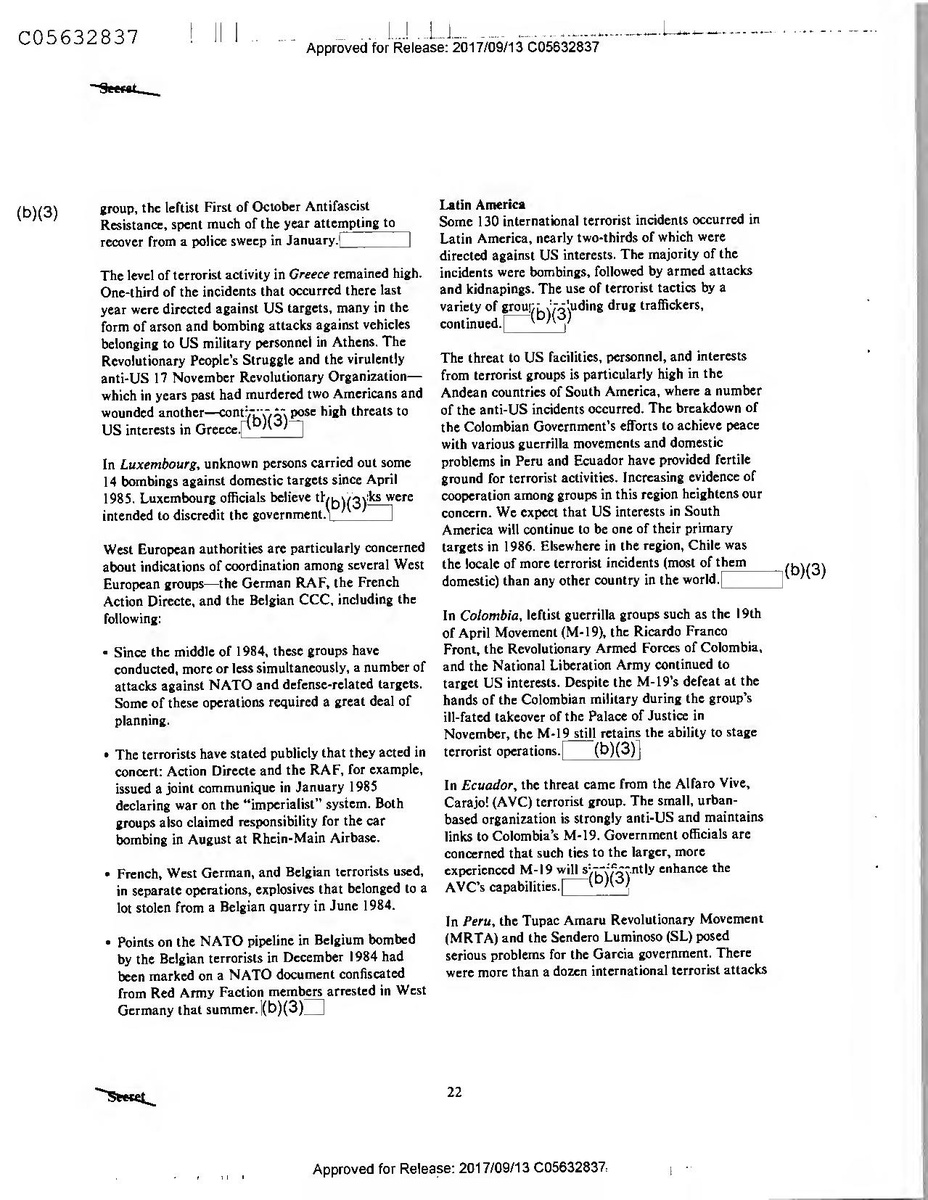
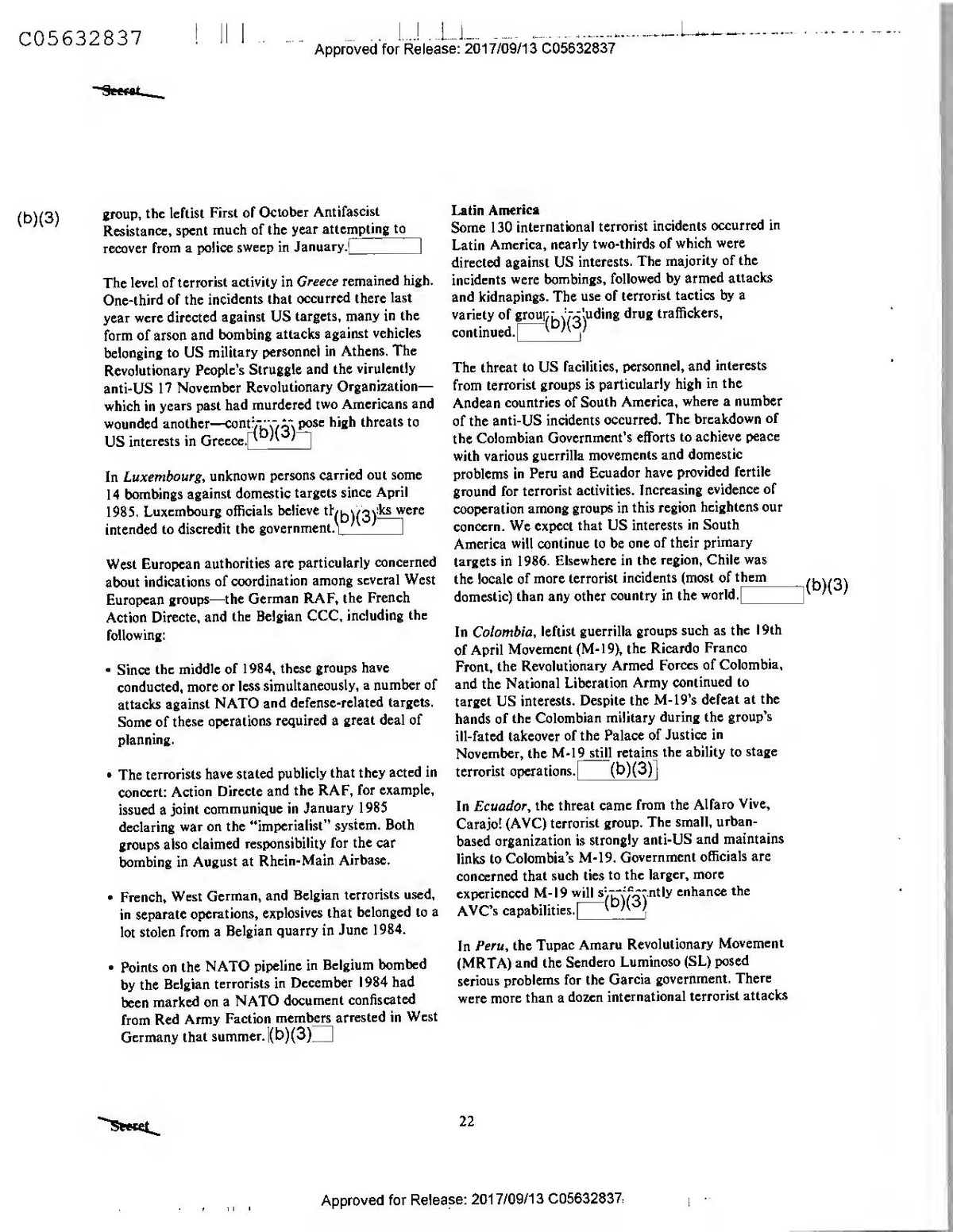
Secret
variety of grouſ b)(3]uding drug traffickers,
US interests in Greece. (b)(3) pose high threats to
1985. Luxembourg officials believe tł(b)(3) ks were
(b)(3)
group, the leftist First of October Antifascist
Latin America Resistance, spent much of the year attempting to Some 130 international terrorist incidents occurred in recover from a police sweep in January
Latin America, nearly two-thirds of which were
directed against US interests. The majority of the The level of terrorist activity in Greece remained high. incidents were bombings, followed by armed attacks One-third of the incidents that occurred there last and kidnapings. The use of terrorist tactics by a year were directed against US targets, many in the form of arson and bombing attacks against vehicles
. belonging to US military personnel in Athens. The Revolutionary People's Struggle and the virulently The threat to US facilities, personnel, and interests anti-US 17 November Revolutionary Organization, from terrorist groups is particularly high in the which in years past had murdered two Americans and Andean countries of South America, where a number wounded another-cont;
of the anti-US incidents occurred. The breakdown of the Colombian Government's efforts to achieve peace
with various guerrilla movements and domestic In Luxembourg, unknown persons carried out some problems in Peru and Ecuador have provided fertile 14 bombings against domestic targets since April ground for terrorist activities. Increasing evidence of
ks
cooperation among groups in this region heightens our intended to discredit the government.
concern. We expect that US interests in South
America will continue to be one of their primary West European authorities are particularly concerned targets in 1986. Elsewhere in the region, Chile was about indications of coordination among several West the locale of more terrorist incidents (most of them European groups—the German RAF, the French domestic) than any other country in the world. Action Directe, and the Belgian CCC, including the following:
In Colombia, leftist guerrilla groups such as the 19th
of April Movement (M-19), the Ricardo Franco • Since the middle of 1984, these groups have
Front, the Revolutionary Armed Forces of Colombia, conducted, more or less simultaneously, a number of and the National Liberation Army continued to attacks against NATO and defense-related targets. target US interests. Despite the M-19's defeat at the Some of these operations required a great deal of hands of the Colombian military during the group's planning.
ill-fated takeover of the Palace of Justice in November, the M-19
still retains the ability to stage • The terrorists have stated publicly that they acted in terrorist operations.
concert: Action Directe and the RAF, for example, issued a joint communique in January 1985
In Ecuador, the threat came from the Alfaro Vive, declaring war on the “imperialist" system. Both Carajo! (AVC) terrorist group. The small, urbangroups also claimed responsibility for the car
based organization is strongly anti-US and maintains bombing in August at Rhein-Main Airbase.
links to Colombia's M-19. Government officials are
concerned that such ties to the larger, more • French, West German, and Belgian terrorists used, experienced M-19 will smiforntly enhance the
(b)(3) in separate operations, explosives that belonged to a AVC's capabilities. lot stolen from a Belgian quarry in June 1984.
In Peru, the Tupac Amaru Revolutionary Movement • Points on the NATO pipeline in Belgium bombed (MRTA) and the Sendero Luminoso (SL) posed
by the Belgian terrorists in December 1984 had serious problems for the Garcia government. There been marked on a NATO document confiscated were more than a dozen international terrorist attacks from Red Army Faction members arrested in West Germany that summer. (b)(3)
"(b)(3)
Deeret
22
Approved for Release: 2017/09/13 C05632837:
Secret
.
in Peru during the year, mostly directed against US interests. In November, members of the MRTA threw bombs and fired machineguns at the US Embassy in Lima, as well as at US businesses. Sendero Luminoso
Sikh terrorism in 1985 was international in scope. Its attacks victimized foreigners and resulted in high levels of lethality. Sikh extremists were probably responsible for the worst single incident
continued to target US interests, primarily by (b)(3) ever recorded the Air India crash last June. The dynamiting and shooting at the US Embassy.[
large number of Sikh communities worldwide could provide staging bases for future Sikh terrorism.
In Chile, which saw more than 865 bombings, some two dozen international terrorist incidents occurred throughout 1985, a number of which were directed against US interests. The Communist-affiliated Manuel Rodriguez Patriotic Front con
con(b)(3)"
most of the anti-US terrorist attacks in Chile.
• Japan's radical Chukaku-ha (Nucleus Faction)
conducted more attacks last year than in most previous years. It began the year with a January rocket attack on the US Consulate General in Kobe and demonstrated its capabilities to disrupt Japanese society when it shut down a large section of Japan's commuter rail system in late November. Thus far, this group h(b)(3)zined from deliberately causing casualties.
For a more detailed treatment of terrorism in Asia last year, sec the accompanying article in this issue.
(b)(3)
Outside the Andean Region, the terrorist threat was greatest in Central America, especially in El Salvador. Of particular concern to authorities there was a possible resurgence of urban terrorism. Elements of the Farabundo Marti Liberation Front (FMLN)in particular the urban terrorist wing of the Central American Revolutionary Worker's Party, the Popular Liberation Forces, and the renegade Clara Elizabeth Ramirez Front- continued to target US personnel in El Salvador. In fact, the greatest single death toll of US citizens last year came as a result of the “Zona Rosa massacre" in downtown San Salvador in June: six Americans, four of them Marine security guards, died in the attack. (b)(3)
Cuban President Fidel Castro continued to support political violence in selected Latin American countries, despite his efforts to portray himself as a responsible statesman. Castro's policy of revolutionary subversion and his support for leftist guerrillas will continue to be a stumblingblock for US counterterrorist programs. Cuba maintained its longstanding support to terrorists in countries such as Colombia and apparently undertook new initiatives in Bolivia and Argentina in support of regional terrorist groups. (b)(3)
Asia Asia remains on the periphery of international terrorism. Our preliminary compilation of incidents for 1985 shows that only about 6 percent of all international terrorist incidents occurred there. The activities of two Asian groups, however, raised concern in 1985:
23
Secret
Approved for Release: 2017/09/13 C05632837
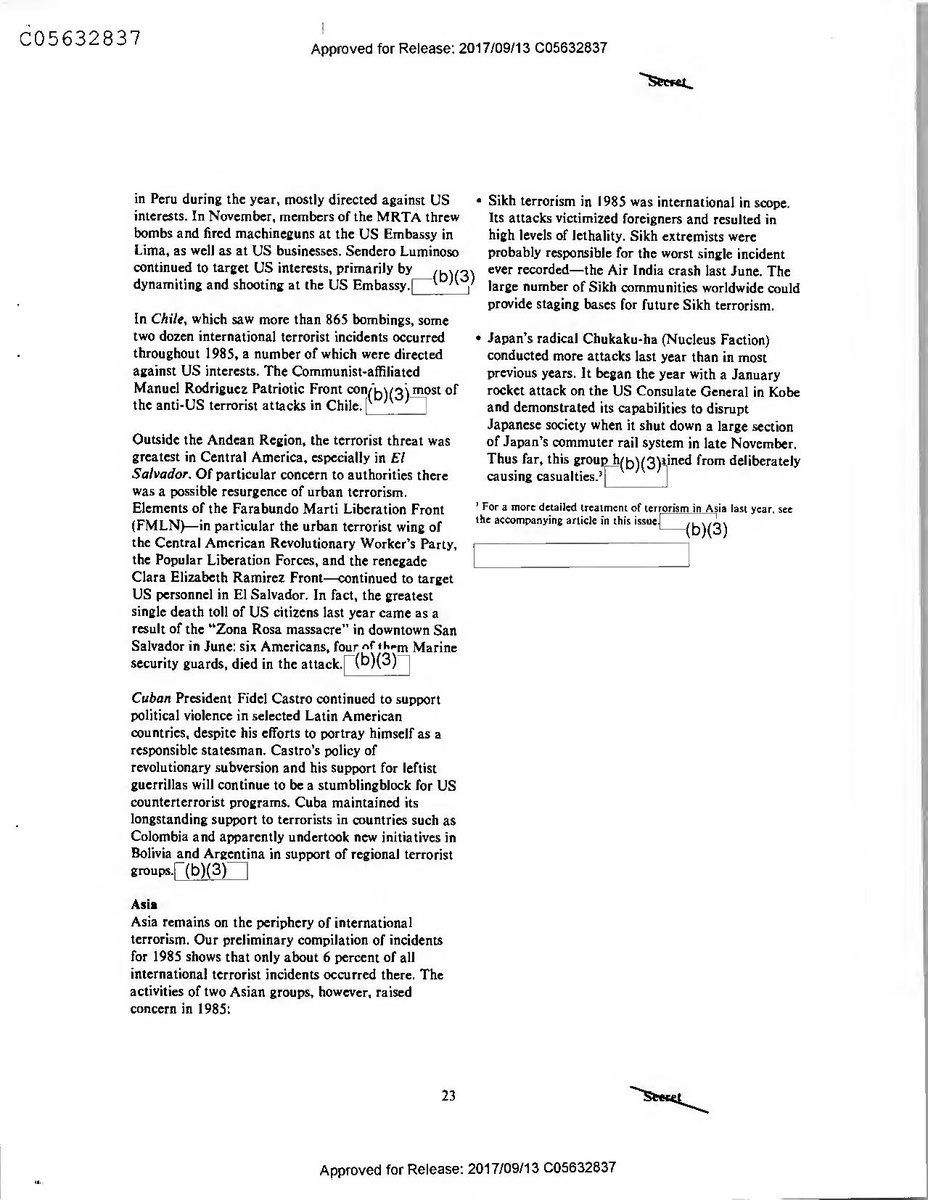
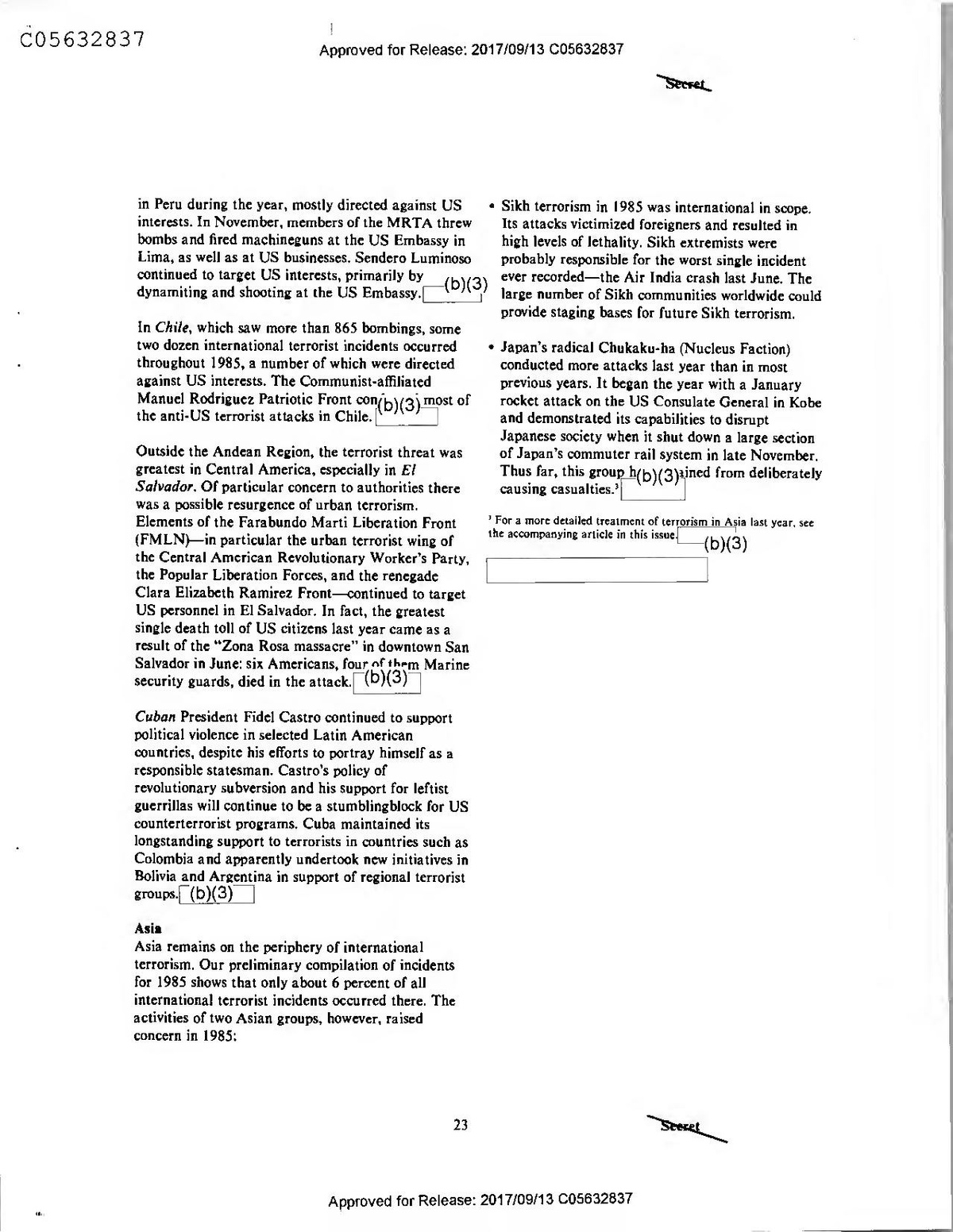
Secret
.
in Peru during the year, mostly directed against US interests. In November, members of the MRTA threw bombs and fired machineguns at the US Embassy in Lima, as well as at US businesses. Sendero Luminoso
Sikh terrorism in 1985 was international in scope. Its attacks victimized foreigners and resulted in high levels of lethality. Sikh extremists were probably responsible for the worst single incident
continued to target US interests, primarily by (b)(3) ever recorded the Air India crash last June. The dynamiting and shooting at the US Embassy.[
large number of Sikh communities worldwide could provide staging bases for future Sikh terrorism.
In Chile, which saw more than 865 bombings, some two dozen international terrorist incidents occurred throughout 1985, a number of which were directed against US interests. The Communist-affiliated Manuel Rodriguez Patriotic Front con
con(b)(3)"
most of the anti-US terrorist attacks in Chile.
• Japan's radical Chukaku-ha (Nucleus Faction)
conducted more attacks last year than in most previous years. It began the year with a January rocket attack on the US Consulate General in Kobe and demonstrated its capabilities to disrupt Japanese society when it shut down a large section of Japan's commuter rail system in late November. Thus far, this group h(b)(3)zined from deliberately causing casualties.
For a more detailed treatment of terrorism in Asia last year, sec the accompanying article in this issue.
(b)(3)
Outside the Andean Region, the terrorist threat was greatest in Central America, especially in El Salvador. Of particular concern to authorities there was a possible resurgence of urban terrorism. Elements of the Farabundo Marti Liberation Front (FMLN)in particular the urban terrorist wing of the Central American Revolutionary Worker's Party, the Popular Liberation Forces, and the renegade Clara Elizabeth Ramirez Front- continued to target US personnel in El Salvador. In fact, the greatest single death toll of US citizens last year came as a result of the “Zona Rosa massacre" in downtown San Salvador in June: six Americans, four of them Marine security guards, died in the attack. (b)(3)
Cuban President Fidel Castro continued to support political violence in selected Latin American countries, despite his efforts to portray himself as a responsible statesman. Castro's policy of revolutionary subversion and his support for leftist guerrillas will continue to be a stumblingblock for US counterterrorist programs. Cuba maintained its longstanding support to terrorists in countries such as Colombia and apparently undertook new initiatives in Bolivia and Argentina in support of regional terrorist groups. (b)(3)
Asia Asia remains on the periphery of international terrorism. Our preliminary compilation of incidents for 1985 shows that only about 6 percent of all international terrorist incidents occurred there. The activities of two Asian groups, however, raised concern in 1985:
23
Secret
Approved for Release: 2017/09/13 C05632837
Approved for Release: 2017/09/13 C05632837
Approved for Release: 2017/09/13 C05632837
Secret
Lebanon-France: Hostage Negotiations Appear Stalemated
(b)(3),
One of the first challenges facing the new
Alternatively, it is possible that the deal soured conservative government in Paris will be the problem because elements of the Iranian Government imposed of the French hostages in Lebanon. Earlier this year, last-minute demands that France was not willing to a deal fell through, and the stakes were raised when meet. (b)(3) the kidnapers distributed photos of one French hostage they allegedly killed and four more
Although pressure to reach an agreement eased after Frenchmen were seized in Beirut. The new
the Socialist defeat in the 16 March parliamentary government may support most of the concessions election, we believe the new government is likely to made by President Mitterrand in January, but the accept most of the concessions agreed to by President sticking point is likely to be the reluctance of the Mitterrand in January. New Prime Minister Jacques Lebanese Shia kidnapers throne to a deal negotiated Chirac, a conservative, strongly supports Iraq, through Iran and Syria. (b)(3)
however, and his government probably will be
reluctant to halt arms sales to Baghdad, even for a In early January, Socialist Party officials in Paris short time. _(b)(3) hoped to bolster their party's chances to retain power in the March National Assembly elections by
Mitterrand may now decide to direct the negotiations negotiating for the release of the French hostages in personally. Outgoing Defense Minister Quiles Lebanon. The shape of the deal Paris reportedly complained recently that he, outgoing Foreign agreed to earlier this year remains murky, but
Minister Dumas, and former Prime Minister Fatin
"(b)(1) President Mitterrand apparently accepted Iran's were being kept in the dark by Mitterrand, principal demands. These were the release of five
(b)(3) Iranian-backed terrorists imprisoned in France for the
Dr. Razah attempted assassination of a former Iranian Prime Ra'd, a Lebanese-born French heart specialist, has Minister in May 1980,' the repayment to Tehran of occasionally acted "unofficial” emissary to Beirut $1 billion deposited in France by the Shah, and a and Damascus, and, soon after the elections, a Syrian clar(b)(1)2 on Iranian dissident activity in France. businessman named Omran Adham told the press (b)(3)
that he was Mitterrand's si pl envoy to Syrian
(b)(3) President Assad.
There is no evidence that the American hostages have We suspect that the agreement fell through because been part of any negotiations to date. Should Paris the Hizballah element actually holding the hostages successfully negotiate the release of its hostages in the was not directly involved in the negotiations and was near future, the deal will not include the release of the not willing to accept the terms agreed to by France, American hostages. Although the same Hizballah Iran, and Syria. The kidnapers' demands have not element holds both sets of hostages, the demands for changed since early this year, and we do not believe each are different. Hizballah has consistently said they will issue new conditions in the near future.? that it will set the American captives free only if the
United States forces Kuwait to release the 17 Dawa French officials told US diplomats that Paris would release one
prisoners arrested for the bombings of the US prisoner for "medical" reasons and would guarantee the release of the other four by the end of Milterrand's term in 1988. | Embassy and other targets in Kuwait in December 'In an interview with a French newspaper in mid-February, Syrian 1983. The terrorists have showed no willingness to President Assad acknowledged that a deal had been worked out 10
agree to a compromise for anything less. release the French bUL the persons covering the hostages" backed
(b)(3) oUL al the last minute. Assad denounced the captors for reneging and said that Syria's relations with the groun could not improve until it released its foreign hostages (b)(3)
3)
25
Secret DI TR 86-005 April 1986
Approved for Release: 2017/09/13 C05632837
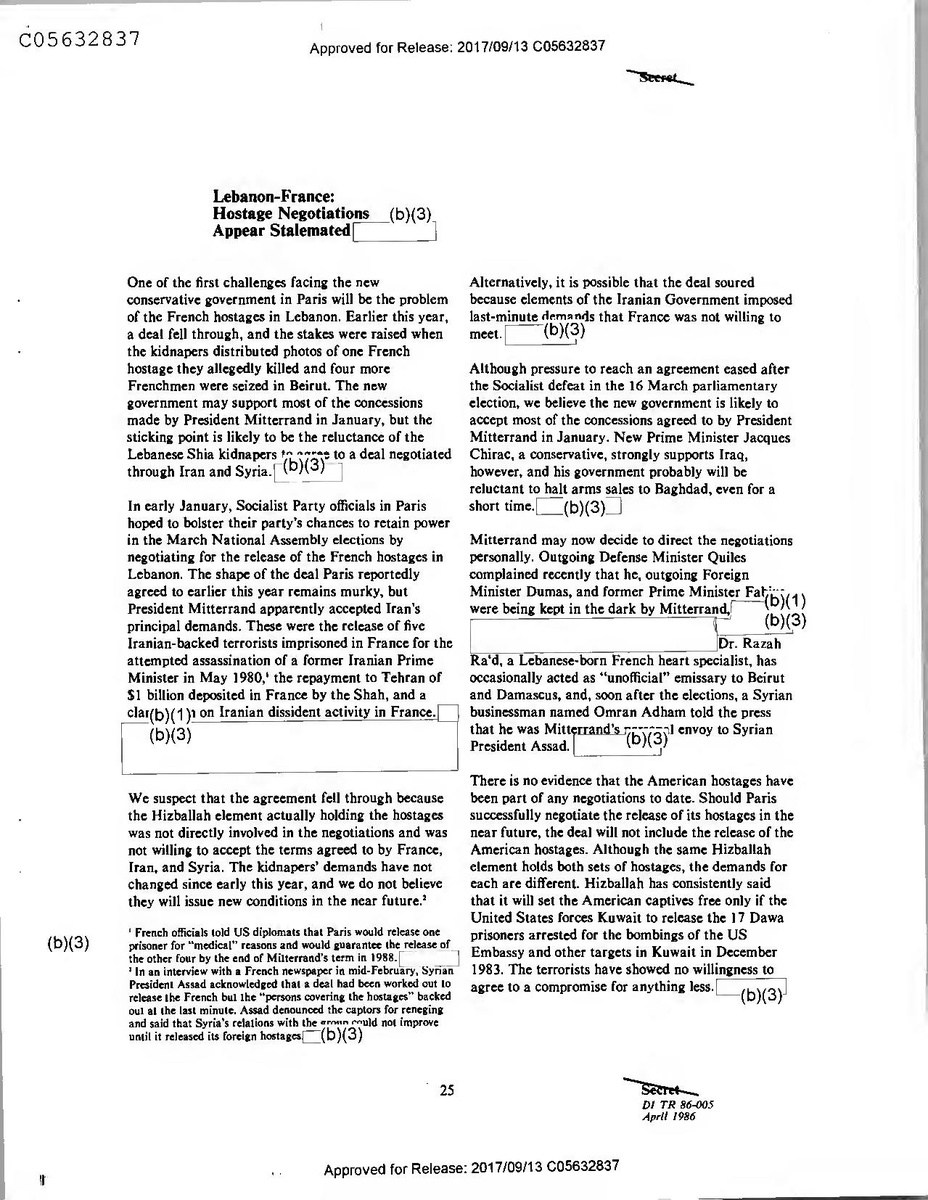
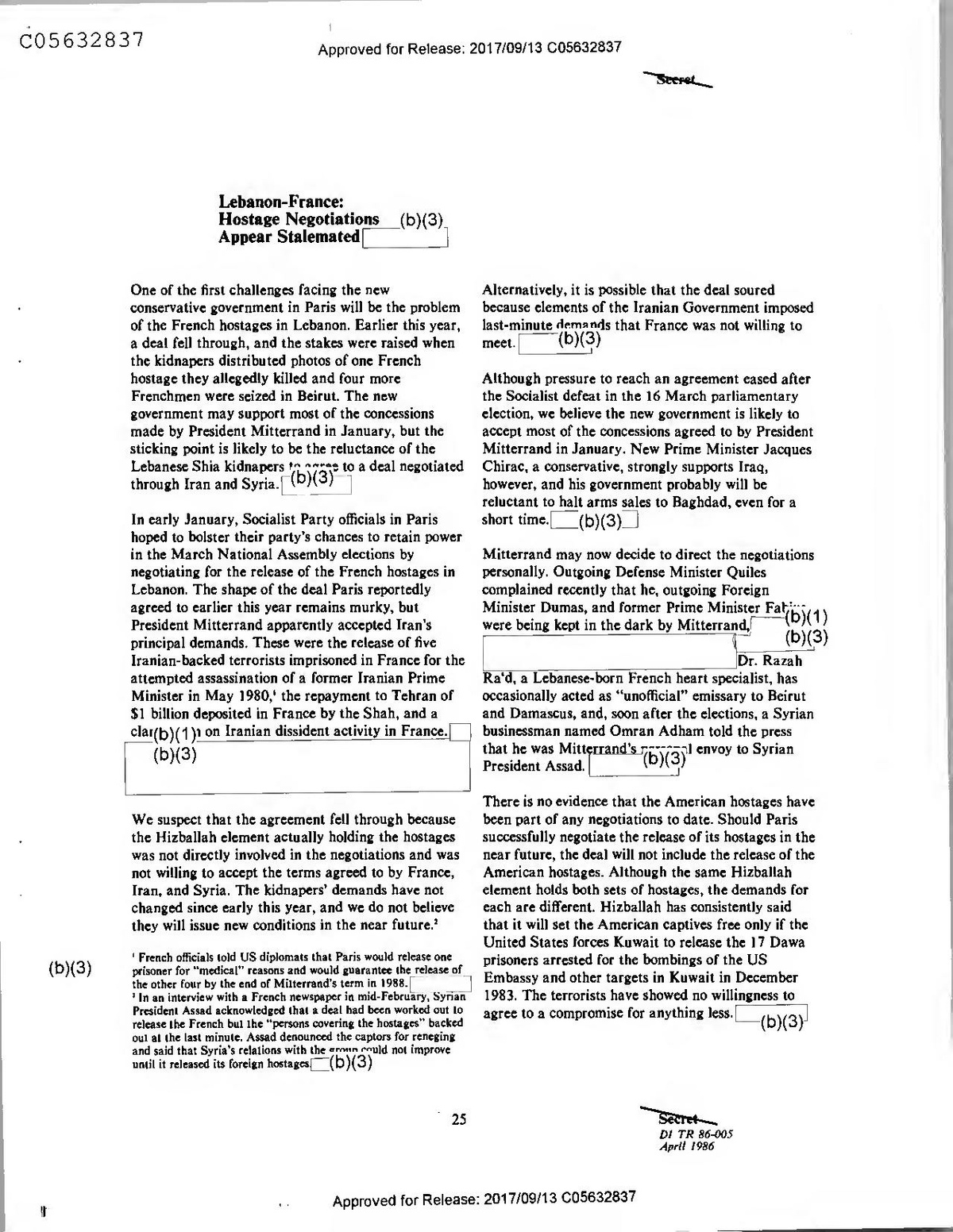
Secret
Lebanon-France: Hostage Negotiations Appear Stalemated
(b)(3),
One of the first challenges facing the new
Alternatively, it is possible that the deal soured conservative government in Paris will be the problem because elements of the Iranian Government imposed of the French hostages in Lebanon. Earlier this year, last-minute demands that France was not willing to a deal fell through, and the stakes were raised when meet. (b)(3) the kidnapers distributed photos of one French hostage they allegedly killed and four more
Although pressure to reach an agreement eased after Frenchmen were seized in Beirut. The new
the Socialist defeat in the 16 March parliamentary government may support most of the concessions election, we believe the new government is likely to made by President Mitterrand in January, but the accept most of the concessions agreed to by President sticking point is likely to be the reluctance of the Mitterrand in January. New Prime Minister Jacques Lebanese Shia kidnapers throne to a deal negotiated Chirac, a conservative, strongly supports Iraq, through Iran and Syria. (b)(3)
however, and his government probably will be
reluctant to halt arms sales to Baghdad, even for a In early January, Socialist Party officials in Paris short time. _(b)(3) hoped to bolster their party's chances to retain power in the March National Assembly elections by
Mitterrand may now decide to direct the negotiations negotiating for the release of the French hostages in personally. Outgoing Defense Minister Quiles Lebanon. The shape of the deal Paris reportedly complained recently that he, outgoing Foreign agreed to earlier this year remains murky, but
Minister Dumas, and former Prime Minister Fatin
"(b)(1) President Mitterrand apparently accepted Iran's were being kept in the dark by Mitterrand, principal demands. These were the release of five
(b)(3) Iranian-backed terrorists imprisoned in France for the
Dr. Razah attempted assassination of a former Iranian Prime Ra'd, a Lebanese-born French heart specialist, has Minister in May 1980,' the repayment to Tehran of occasionally acted "unofficial” emissary to Beirut $1 billion deposited in France by the Shah, and a and Damascus, and, soon after the elections, a Syrian clar(b)(1)2 on Iranian dissident activity in France. businessman named Omran Adham told the press (b)(3)
that he was Mitterrand's si pl envoy to Syrian
(b)(3) President Assad.
There is no evidence that the American hostages have We suspect that the agreement fell through because been part of any negotiations to date. Should Paris the Hizballah element actually holding the hostages successfully negotiate the release of its hostages in the was not directly involved in the negotiations and was near future, the deal will not include the release of the not willing to accept the terms agreed to by France, American hostages. Although the same Hizballah Iran, and Syria. The kidnapers' demands have not element holds both sets of hostages, the demands for changed since early this year, and we do not believe each are different. Hizballah has consistently said they will issue new conditions in the near future.? that it will set the American captives free only if the
United States forces Kuwait to release the 17 Dawa French officials told US diplomats that Paris would release one
prisoners arrested for the bombings of the US prisoner for "medical" reasons and would guarantee the release of the other four by the end of Milterrand's term in 1988. | Embassy and other targets in Kuwait in December 'In an interview with a French newspaper in mid-February, Syrian 1983. The terrorists have showed no willingness to President Assad acknowledged that a deal had been worked out 10
agree to a compromise for anything less. release the French bUL the persons covering the hostages" backed
(b)(3) oUL al the last minute. Assad denounced the captors for reneging and said that Syria's relations with the groun could not improve until it released its foreign hostages (b)(3)
3)
25
Secret DI TR 86-005 April 1986
Approved for Release: 2017/09/13 C05632837
Secret
8 March 1986
Following is a chronology of significant developments:
22 March 1985
Diplomats Marcel Fontaine and Marcel Carton are kidnaped in West Beirut. Danielle Perez, Carton's daughter and a secretary at the French Embassy, is also taken hostage, then released on 31 March. "Islamic Jihad” and the previously unkn (b)(3).haybar Brigades” claim credit.
An anonymous caller claiming to speak for “Islamic Jihad” threatens to kill one of the French diplomats unless Paris arranges the release of the two deported Iraqis. The caller also demands that Paris send Dr. Ra'd to negotiate with the kidnapers. Ra'd was involved in hostage
(b)(3) negotiations last summer.
23 May 1985
Journalist Jean PaUL Kauffmann and researcher Michel Seurat are kidnaped in West Beirut "Islamic Jihad” claims credit. (b)(3)
Four members of a French television crew-Phillippe Rochot, Georges Hansen, Aurel Corenea, and JeanLouis Normandin-are kidnaped after covering a Hizballah rally in Beirut's southern suburbs. (b)(3)
9 March 1986
Early January 1986
French press reports indicate that Paris is close to a deal to secure the release of the hostages. French officials confirs ubstance of these reports.
An anonymous caller claims that “Islamic Jihad" was responsible for kidnaping the TV crew. (b)(3)
(b)(346
The French Ambassador to Iraq meets with the expelled Iraqis in Baghdad. Both are reported alive and in good health.
(b)(3)
10 January
French officials tell US diplomats 1986
that negotiations are at a stalemate. (b)(3)
9-13 March 1986
19 February 1986
A series of official and unofficial French mediators arrive in the Middle East to explore all possible avenues in the hostage crisis. Foreign Ministry officials travel to Beirut Damascus, and Tehran.[
(b)(3)
Paris expels four Iranians, four Iraqis, and three Lebanese. Two of the Iraqis-Hamza Hadi Fawzi and Hassan Khayr al-Din, members of an Iraqi opposition group are sent to Baghdad. Press reports claim that at least one is executed in Baghdad. Tehran, which supports Iraqi oppositionists, is said to be angered, further spring back negotiation efforts.
(b)(3)
10 March 1986
Unidentified couriers deliver a statement in the name of "Islamic Jihad” to a foreign news agency in Beirut, along with three photographs. The statement says they are intended to prove the execution of the “specialized intelligence expert” Michel Seurat. French officials have identified the man in the photos as Seurat.
(b)(1) (b)(3)
6 March 1986
An anonymous caller tells a foreign news agency in Beirut that “Islamic Jihad" has executed Michel Seurat as a spy. He also criticizes Paris for deporting "innocent Muslims," particularly its two “Iraqi brothers.” The caller warns that French policy in the Middle East is endangering its nationals and demands that French officials “move away from the destructive policy that they are pursuing, and abandon America and
its affairs."[(b)(3))
26
Approved for Release: 2017/09/13 C05632837
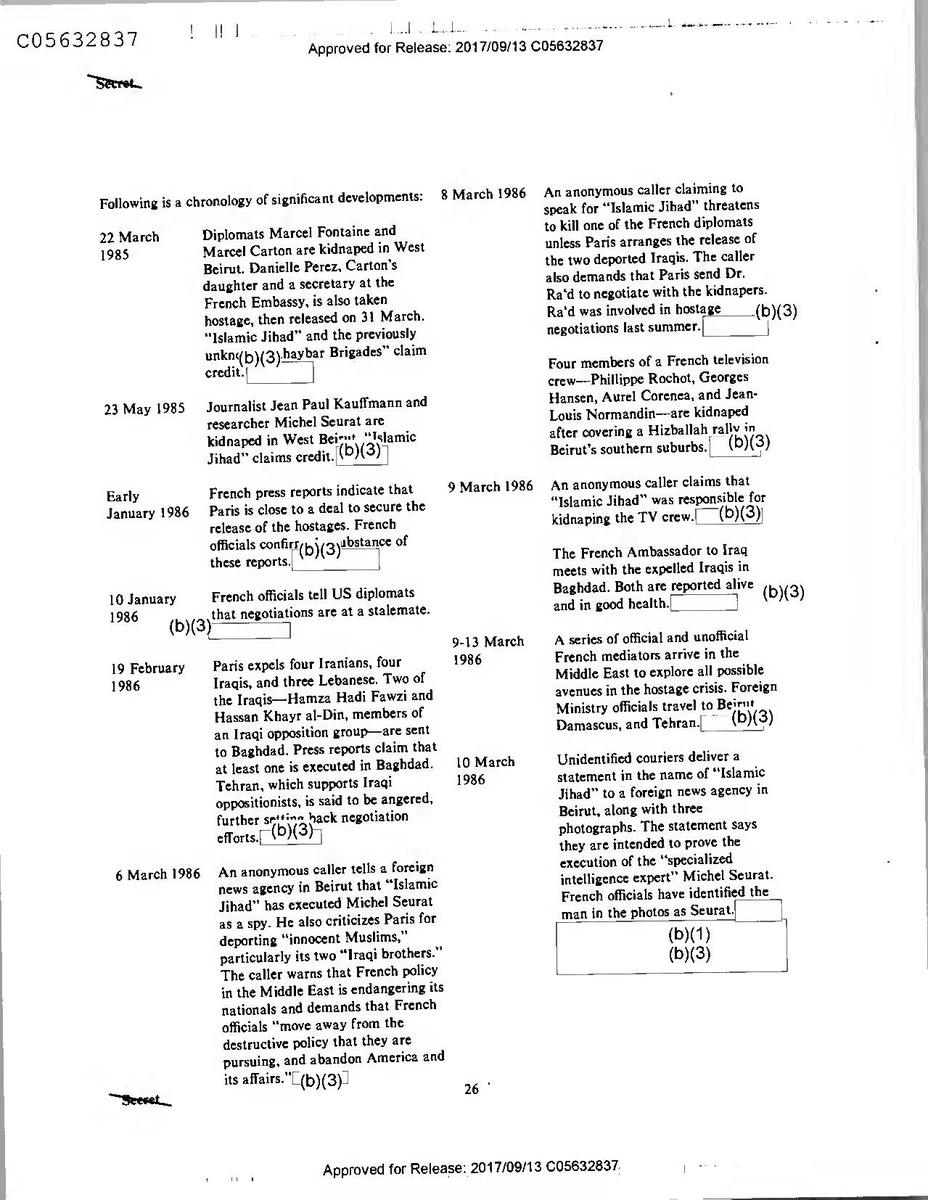
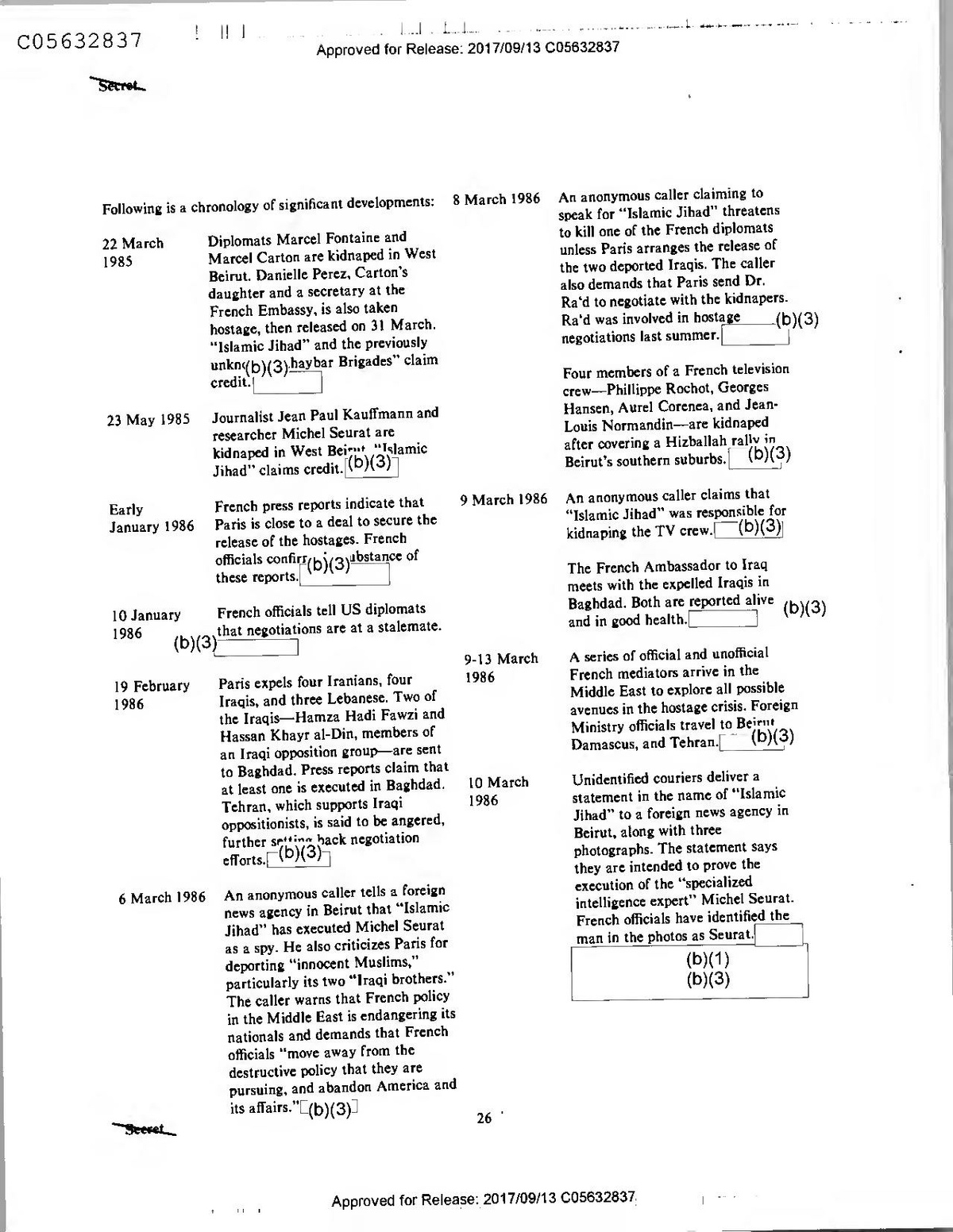
Secret
8 March 1986
Following is a chronology of significant developments:
22 March 1985
Diplomats Marcel Fontaine and Marcel Carton are kidnaped in West Beirut. Danielle Perez, Carton's daughter and a secretary at the French Embassy, is also taken hostage, then released on 31 March. "Islamic Jihad” and the previously unkn (b)(3).haybar Brigades” claim credit.
An anonymous caller claiming to speak for “Islamic Jihad” threatens to kill one of the French diplomats unless Paris arranges the release of the two deported Iraqis. The caller also demands that Paris send Dr. Ra'd to negotiate with the kidnapers. Ra'd was involved in hostage
(b)(3) negotiations last summer.
23 May 1985
Journalist Jean PaUL Kauffmann and researcher Michel Seurat are kidnaped in West Beirut "Islamic Jihad” claims credit. (b)(3)
Four members of a French television crew-Phillippe Rochot, Georges Hansen, Aurel Corenea, and JeanLouis Normandin-are kidnaped after covering a Hizballah rally in Beirut's southern suburbs. (b)(3)
9 March 1986
Early January 1986
French press reports indicate that Paris is close to a deal to secure the release of the hostages. French officials confirs ubstance of these reports.
An anonymous caller claims that “Islamic Jihad" was responsible for kidnaping the TV crew. (b)(3)
(b)(346
The French Ambassador to Iraq meets with the expelled Iraqis in Baghdad. Both are reported alive and in good health.
(b)(3)
10 January
French officials tell US diplomats 1986
that negotiations are at a stalemate. (b)(3)
9-13 March 1986
19 February 1986
A series of official and unofficial French mediators arrive in the Middle East to explore all possible avenues in the hostage crisis. Foreign Ministry officials travel to Beirut Damascus, and Tehran.[
(b)(3)
Paris expels four Iranians, four Iraqis, and three Lebanese. Two of the Iraqis-Hamza Hadi Fawzi and Hassan Khayr al-Din, members of an Iraqi opposition group are sent to Baghdad. Press reports claim that at least one is executed in Baghdad. Tehran, which supports Iraqi oppositionists, is said to be angered, further spring back negotiation efforts.
(b)(3)
10 March 1986
Unidentified couriers deliver a statement in the name of "Islamic Jihad” to a foreign news agency in Beirut, along with three photographs. The statement says they are intended to prove the execution of the “specialized intelligence expert” Michel Seurat. French officials have identified the man in the photos as Seurat.
(b)(1) (b)(3)
6 March 1986
An anonymous caller tells a foreign news agency in Beirut that “Islamic Jihad" has executed Michel Seurat as a spy. He also criticizes Paris for deporting "innocent Muslims," particularly its two “Iraqi brothers.” The caller warns that French policy in the Middle East is endangering its nationals and demands that French officials “move away from the destructive policy that they are pursuing, and abandon America and
its affairs."[(b)(3))
26
Approved for Release: 2017/09/13 C05632837
Secret
15 March 1986
Dr. Ra'd returns to Paris, claiming that he met with the kidnapers and :(b)(3)!“new proposals” from them.
French press reports indicate that three shiploads of French small arms and ammunition are headed toward Iran. French officials deny that Paris authorized a direct shipment, but they probably knew the shinment would go to Iran. (b)(3)
16 March 1986
The National Assembly elections in Paris bring a c itive coalition to power.
$(b)(3)!!!
12 March 1986
Hizballah spiritual leader Muhammad Husayn Fadlallah calls for the release of the TV crew,
rolling their kidnaping unjustified. (b)(3)
The Hizballah leadership releases a press communique denying any involvement in the French or other hostage affairs. The statement refutes Dr. Ra'd's claim that he reached a compromise with the radical Shias, claiming he never met with a Hizballah official. Fadlallah, however, admits that n..
Ra'd visited him.
(b)(3)
Iraqi President Saddam Husayn pardons Fawzi and Khayr al-Dina
back to France if they wish.
and says they are fre(b)(3)
14 March 1986
Unidentified couriers deliver a videotape of hostages Kauffmann, 17 March Carton, and Fontaine to the Visnews 1986 Bureau in Beirut. The hostages address messages to their families and appeal for pressure to be brought upon the French Government to achieve their release. They also called on France to stop supporting Iraq. According to the US Embassy in Beirut, the hostages all appear physically and (b)(3) psychologically worn down.
Syrian businessman Omran Adham tells the press in Paris that he is Mitterrand's personal envoy to Syrian President Assad. Adham did meet with Assad in Damascus two days earlier, but apparently did not receive any firm commitment from Assad to take further action on the hostage issue. Adham criticized Dr. Ra'd for interfering and making “illconsidered” promises to the kidnapers. He says the hostages could be set free in “a few days," but that only Syria could guarantee their release.
(b)(3)
A statement delivered to a Western news agency in Beirut claims that the previously unknown “Organization of Revolutionary Justice” was responsible for kidnaping the French TV crew. This may be another covername for Hizballah elements, possibly acting without the approval of the Hizballah leadership. The statement, accompanied by photocopies of Hansen's identification card and Normandin's driver's license, criticized “French colonialism" in
the Middle East.(b)(3)
27
Secret
Approved for Release: 2017/09/13 C05632837
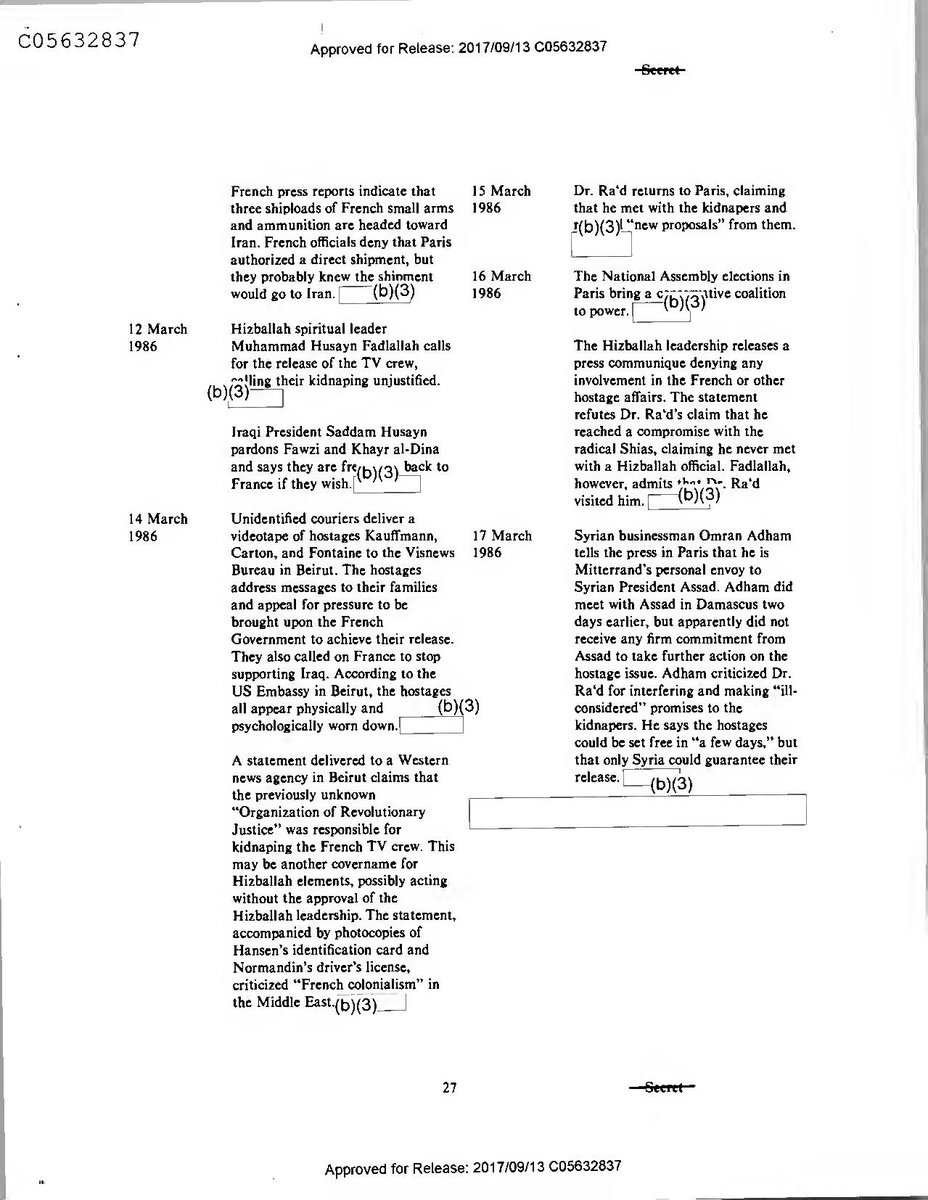
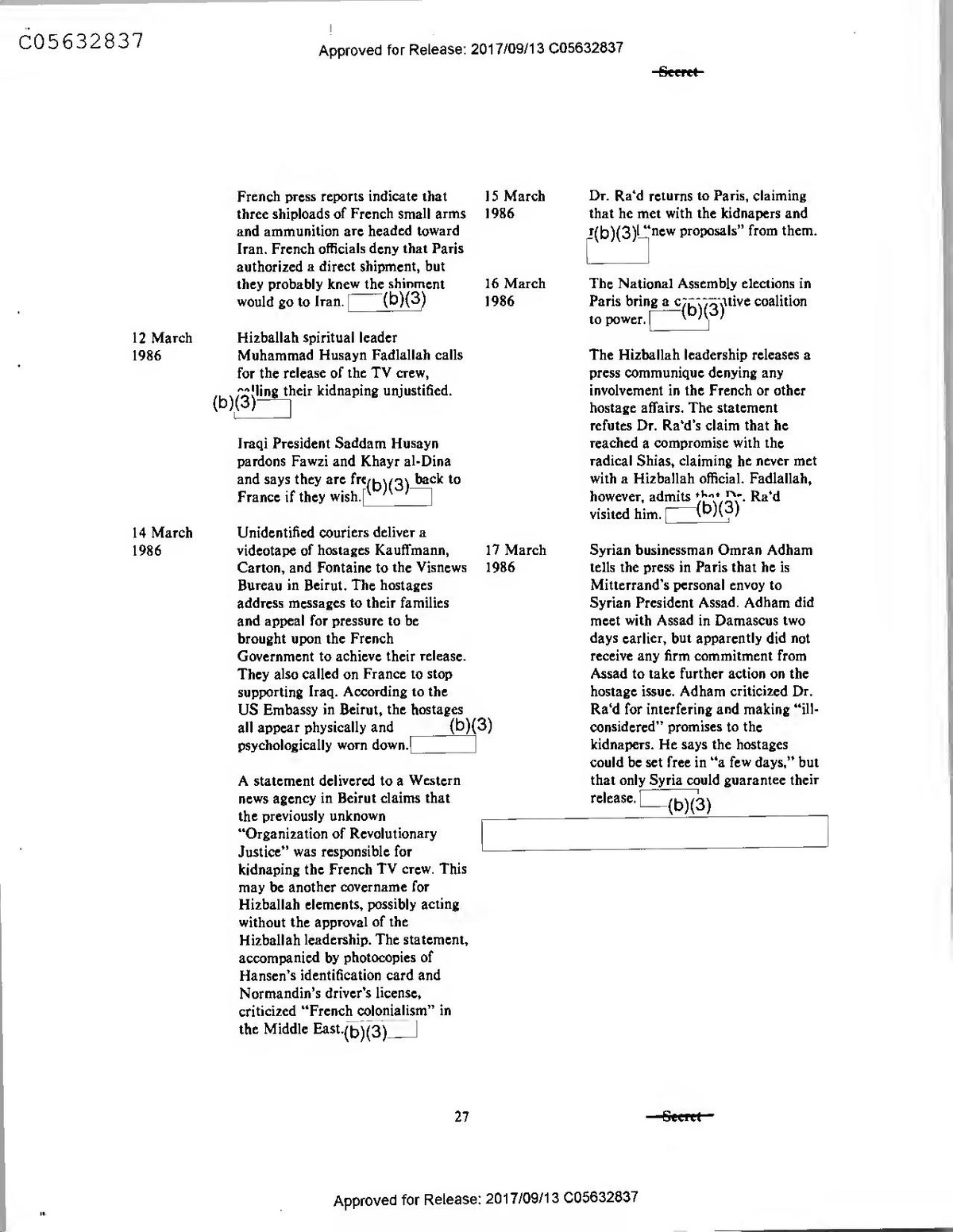
Secret
15 March 1986
Dr. Ra'd returns to Paris, claiming that he met with the kidnapers and :(b)(3)!“new proposals” from them.
French press reports indicate that three shiploads of French small arms and ammunition are headed toward Iran. French officials deny that Paris authorized a direct shipment, but they probably knew the shinment would go to Iran. (b)(3)
16 March 1986
The National Assembly elections in Paris bring a c itive coalition to power.
$(b)(3)!!!
12 March 1986
Hizballah spiritual leader Muhammad Husayn Fadlallah calls for the release of the TV crew,
rolling their kidnaping unjustified. (b)(3)
The Hizballah leadership releases a press communique denying any involvement in the French or other hostage affairs. The statement refutes Dr. Ra'd's claim that he reached a compromise with the radical Shias, claiming he never met with a Hizballah official. Fadlallah, however, admits that n..
Ra'd visited him.
(b)(3)
Iraqi President Saddam Husayn pardons Fawzi and Khayr al-Dina
back to France if they wish.
and says they are fre(b)(3)
14 March 1986
Unidentified couriers deliver a videotape of hostages Kauffmann, 17 March Carton, and Fontaine to the Visnews 1986 Bureau in Beirut. The hostages address messages to their families and appeal for pressure to be brought upon the French Government to achieve their release. They also called on France to stop supporting Iraq. According to the US Embassy in Beirut, the hostages all appear physically and (b)(3) psychologically worn down.
Syrian businessman Omran Adham tells the press in Paris that he is Mitterrand's personal envoy to Syrian President Assad. Adham did meet with Assad in Damascus two days earlier, but apparently did not receive any firm commitment from Assad to take further action on the hostage issue. Adham criticized Dr. Ra'd for interfering and making “illconsidered” promises to the kidnapers. He says the hostages could be set free in “a few days," but that only Syria could guarantee their release.
(b)(3)
A statement delivered to a Western news agency in Beirut claims that the previously unknown “Organization of Revolutionary Justice” was responsible for kidnaping the French TV crew. This may be another covername for Hizballah elements, possibly acting without the approval of the Hizballah leadership. The statement, accompanied by photocopies of Hansen's identification card and Normandin's driver's license, criticized “French colonialism" in
the Middle East.(b)(3)
27
Secret
Approved for Release: 2017/09/13 C05632837
Approved for Release: 2017/09/13 C05632837
Approved for Release: 2017/09/13 C05632837
Terrorism Against French Interests in 1985 (b)(3)
Terrorism Against French Interests, 1985
France experienced high levels of both domestic and international terrorism in 1985. Our data for last year record a total of 189 incidents involving French interests, causing 130 casualties: 27 fatalities, 97 wounded, and six victims of kidnapings. Indigenous groups were responsible for 144 attacks, and French personnel or property were targeted in 45 international incidents. France ranked a distant third overall as a target of international terrorist activity, behind Israel and the United States. (b)(3)
Indigenous
International
Totals
Incidents
144
45
189
Casualties
Killed
10
17
27
Wounded
85
12
97
6
6
Kidnaped Groups responsible National Front for the Liberation of Corsica
92
Action Directe
17
The Setting France must contend with terrorist attacks from several separatist factions—in such diverse locations as Corsica, New Caledonia, and the French Caribbean--as well as from Action Directe, an indigenous anarchist movement with an international faction. The French also are victimized by the Spanish Basque separatist organization Fatherland and Liberty (ETA) and its French counterpart, Iparretarak. Moreover, international terrorist groups
Anti-NATO
S
11
9
Iparretarak New Caledonia related Caribbean Revolutionary Alliance Spanish Basques/Antiterrorist Liberation Group
1
1
have targeted French in(b)(3) elsewhere in Europe
25
and in the Middle East.
Hizballah
8
2
14
4
LARF/ASALA Geographic, political, economic, and military factors combine to make France a particularly attractive
Unknown/Miscellaneous
(b)(3) setting for international terrorism. It is the geographic center of Western Europe, with six easily crossed international boundaries, and is readily accessible Separatist Violence from Africa and the Middle East. The traditional Most anti-French terrorism is carried out by French tolerance of political dissidents—as
separatist groups attempting to win independence exemplified by its granting of asylum to persons from France. One in particular, the National Front suspected of involvement in terrorist activityfor the Liberation of Corsica (FLNC), accounted for encouraged large numbers of radicals to take up 92 of the 144 indigenous incidents in 1985. The residence there. France also has a large population of FLNC typically sets off multiple property bombs foreign students and immigrant workers, which
simultaneously during the night. While its attacks terrorist groups, such as the Lebanese Armed
generally do not cause casualties, five persons were Revolutionary Faction (LARF), have used as a source killed and four wounded last year. The group's for both recruiting new members and building support operations in 1985 were sporadic and, for the fourth networks. Economic and military factors, such as consecutive year, the number of FLNC attacks arms sales to Iraq and the French military presence in declined—a trend we expect to continue, (b)(3) Lebanon, also prompt anti-French terrorist attacks, particularly in the Middle East. [(b)(3) ]
29
Seeret
DI TR 86-005 April 1986
Approved for Release: 2017/09/13 C05632837
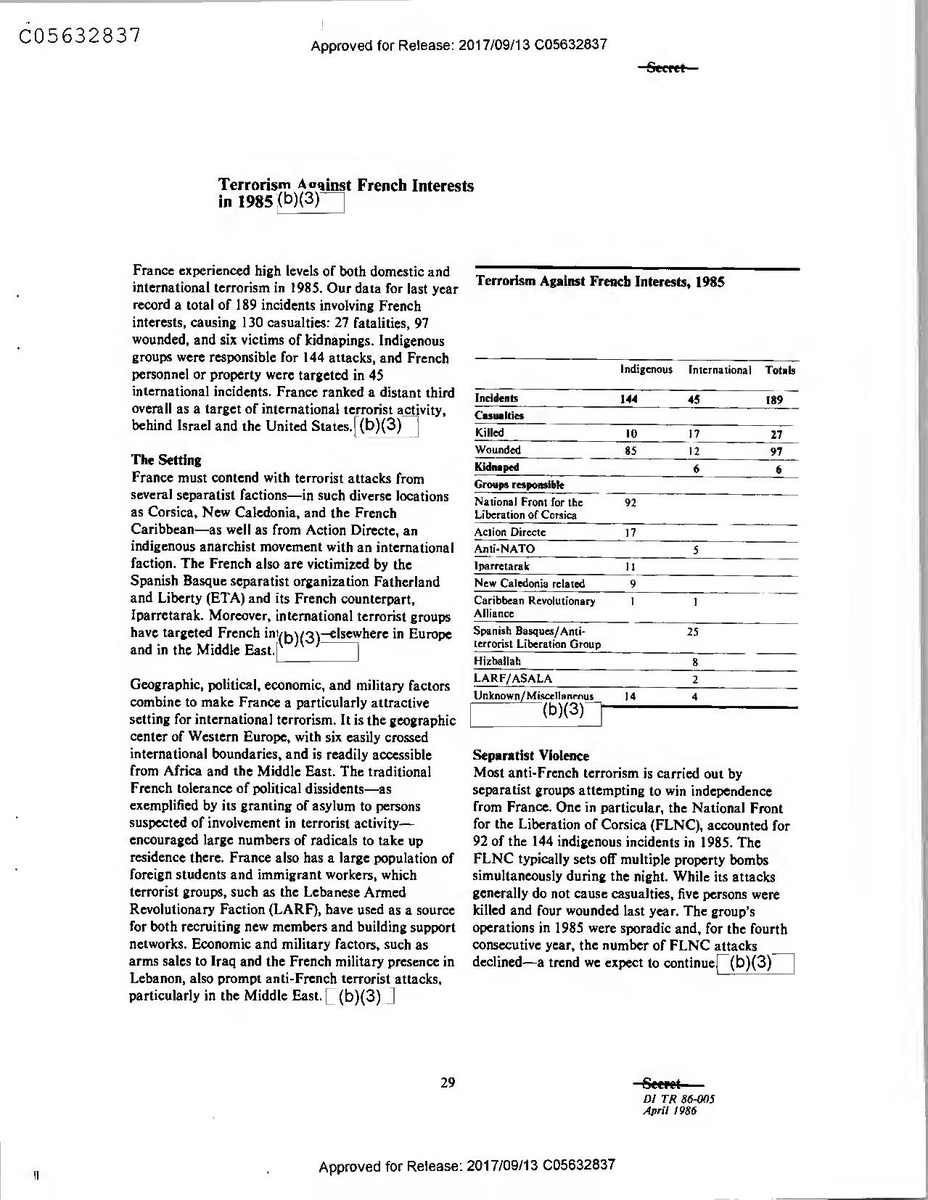
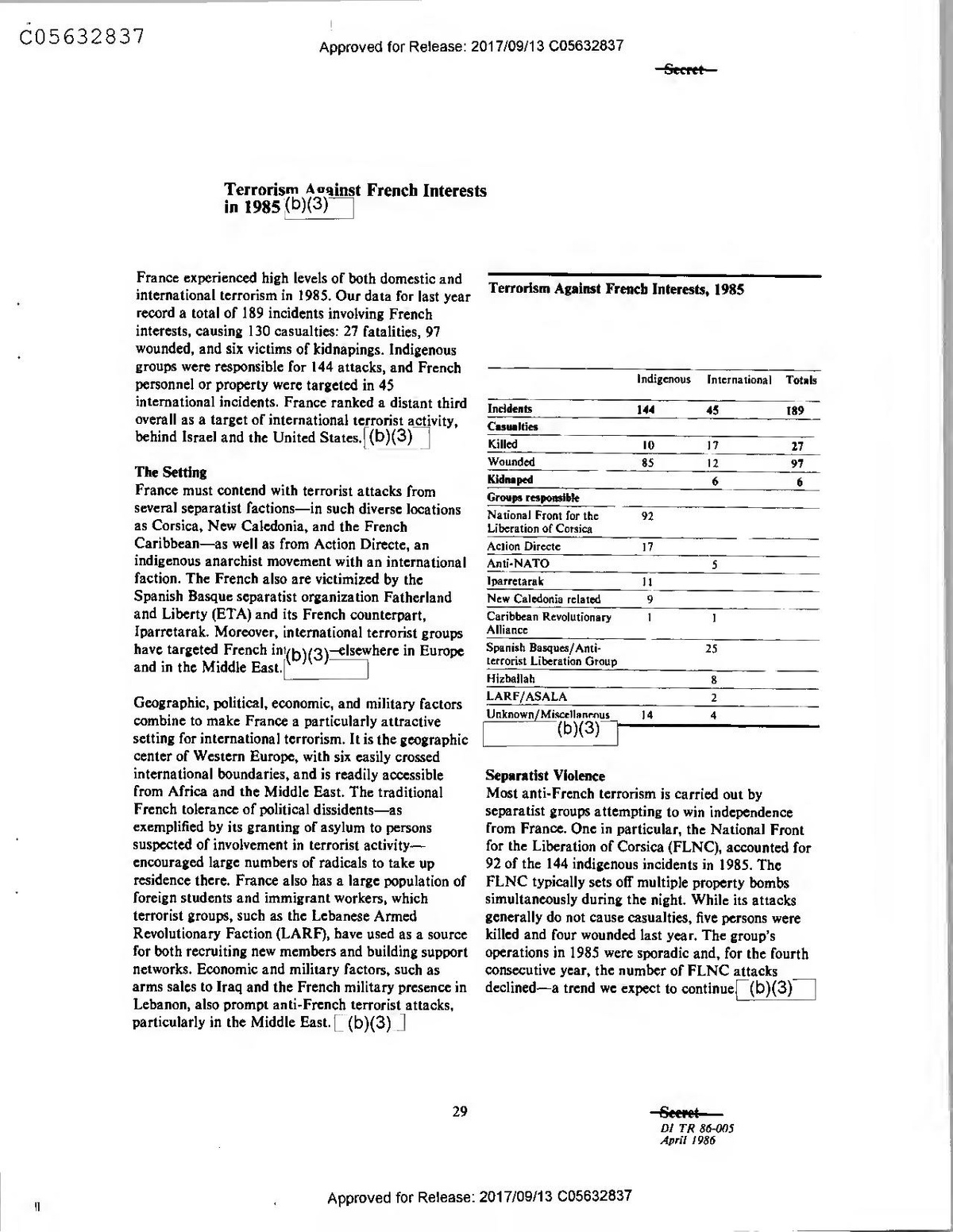
Terrorism Against French Interests in 1985 (b)(3)
Terrorism Against French Interests, 1985
France experienced high levels of both domestic and international terrorism in 1985. Our data for last year record a total of 189 incidents involving French interests, causing 130 casualties: 27 fatalities, 97 wounded, and six victims of kidnapings. Indigenous groups were responsible for 144 attacks, and French personnel or property were targeted in 45 international incidents. France ranked a distant third overall as a target of international terrorist activity, behind Israel and the United States. (b)(3)
Indigenous
International
Totals
Incidents
144
45
189
Casualties
Killed
10
17
27
Wounded
85
12
97
6
6
Kidnaped Groups responsible National Front for the Liberation of Corsica
92
Action Directe
17
The Setting France must contend with terrorist attacks from several separatist factions—in such diverse locations as Corsica, New Caledonia, and the French Caribbean--as well as from Action Directe, an indigenous anarchist movement with an international faction. The French also are victimized by the Spanish Basque separatist organization Fatherland and Liberty (ETA) and its French counterpart, Iparretarak. Moreover, international terrorist groups
Anti-NATO
S
11
9
Iparretarak New Caledonia related Caribbean Revolutionary Alliance Spanish Basques/Antiterrorist Liberation Group
1
1
have targeted French in(b)(3) elsewhere in Europe
25
and in the Middle East.
Hizballah
8
2
14
4
LARF/ASALA Geographic, political, economic, and military factors combine to make France a particularly attractive
Unknown/Miscellaneous
(b)(3) setting for international terrorism. It is the geographic center of Western Europe, with six easily crossed international boundaries, and is readily accessible Separatist Violence from Africa and the Middle East. The traditional Most anti-French terrorism is carried out by French tolerance of political dissidents—as
separatist groups attempting to win independence exemplified by its granting of asylum to persons from France. One in particular, the National Front suspected of involvement in terrorist activityfor the Liberation of Corsica (FLNC), accounted for encouraged large numbers of radicals to take up 92 of the 144 indigenous incidents in 1985. The residence there. France also has a large population of FLNC typically sets off multiple property bombs foreign students and immigrant workers, which
simultaneously during the night. While its attacks terrorist groups, such as the Lebanese Armed
generally do not cause casualties, five persons were Revolutionary Faction (LARF), have used as a source killed and four wounded last year. The group's for both recruiting new members and building support operations in 1985 were sporadic and, for the fourth networks. Economic and military factors, such as consecutive year, the number of FLNC attacks arms sales to Iraq and the French military presence in declined—a trend we expect to continue, (b)(3) Lebanon, also prompt anti-French terrorist attacks, particularly in the Middle East. [(b)(3) ]
29
Seeret
DI TR 86-005 April 1986
Approved for Release: 2017/09/13 C05632837
Seeret
Frenchmen were still being_(b)(3) hostages by
Other separatist movements—Iparretarak, the New France experienced 25 incidents related to Basque Caledonian Kanak Socialist National Liberation separatism in 1985. The lethal Antiterrorist Front, the Caribbean Revolutionary Alliance, and the Liberation Group (GAL) carried out 11 attacks Breton Revolutionary Army-were responsible for 24 against ETA exiles in France, killing 10 persons and incidents in 1985. Most of these were property
wounding eight others. The ETA attacked 14 French bombings; they caused only one fatality and no
targets in Spain in retaliation for the GAL attacks reported injuries.(b)(3)
and in protest against France'
(b)(3)"
dition of four
ETA members to Spain. Action Directe Action Directe probably poses the greatest problem French targets in Lebanon were attacked 10 times for French authorities. What makes this group
last year, resulting in five fatalities and six particularly troublesome is its possible links to other kidnapings. Hizballah was responsible for eight of European terrorist groups. Action Directe was
these incidents, and the Armenian Secret Army for responsible for 17 attacks in France in 1985, including the Liberation of Armenia and the LARF each the assassination of Gen. Rene Audran-a Ministry carried out one attack. At the end of the year, four of Defense official responsible for foreign arms sales—and the attempted assassination of a second elements of Hizballah. general officer. Action Directe also issued a joint communique with the West German Red Army In addition to the assassination and attempted Faction (RAF) in January 1985 in which the two assassination of the two military officers by Action groups announced they were forming an “anti- Directe, there were three anti-NATO incidents imperialist front" in Western Europe. The French involving the French. A French-owned computer terrorists were apparently involved in town onerations company in Cologne, West Germany, and the Central as part of this international movementsb)(3)
European Operating Agency (the NATO pipeline
management office) in Versailles were bombed, and We believe that Action Directe now has two factions. Action Directe took credit-along with the RAF-for One of them—the "internationalists"—is made up of the car bombing of the US Air Form bare at Rheina few of the original AD leadership, and probably was Main, West Germany.
"(b)(1) active with both West German and Belgian terrorists
(b)(3) in 1985. We suspect the second faction, the "domestic," is larger and did not approve of the alliance with the RAF. Analysis of recent activity Four serious bombings were carried out by unknown suggests that the members of the second faction- perpetrators in France in 1985. We suspect that whose identities are unknown to the police-prefer to Middle Eastern terrorists were responsible. Three of continue traditional AD operations; that is, bombing these attacks were against department stores, killing property targets in the middle of the night. These one person and wounding 59 others. The other attacks usually do not cause casualties and are related incident—the bombing of a cinema featuring a Jewish to various domestic political issues, such as French film festival-resulted in the wounding of some 18 involvement in South Africa and the resurgence of persons.
(b)(3)] rightist political parties.[(b)(3)
Outlook International Terrorism
Terrorist activity in France is likely to continue in The French must contend with international terrorism 1986, although we suspect the patterns are changing: in three dimensions—that growing out of the Spanish Basque movement, the anti-NATO campaign by the • There probably will be more terrorist incidents in anti-imperialist front, and attacks upon French
France carried out by Middle Eastern groups. In interests in Lebanon. (b)(3)]
30
Secret
Approved for Release: 2017/09/13 C05632837..
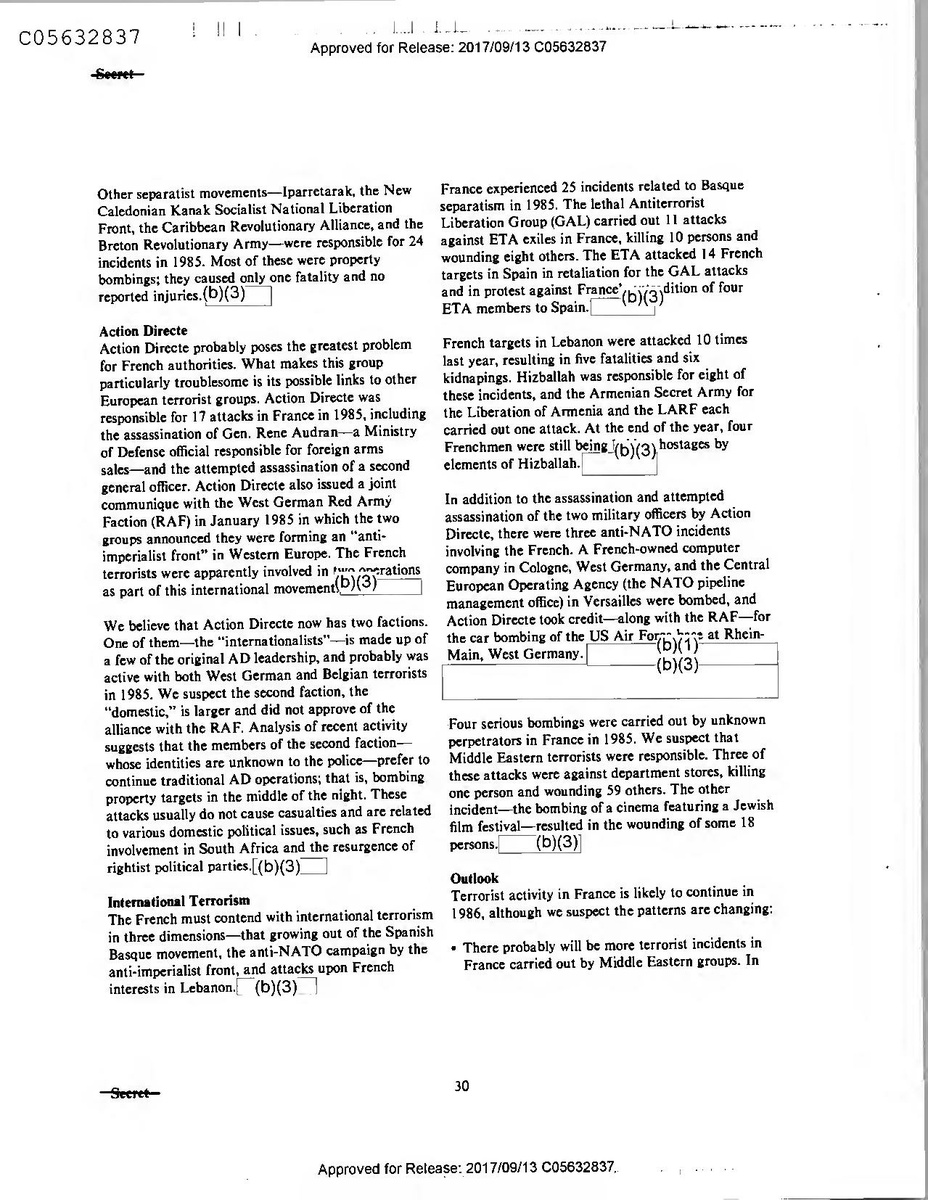
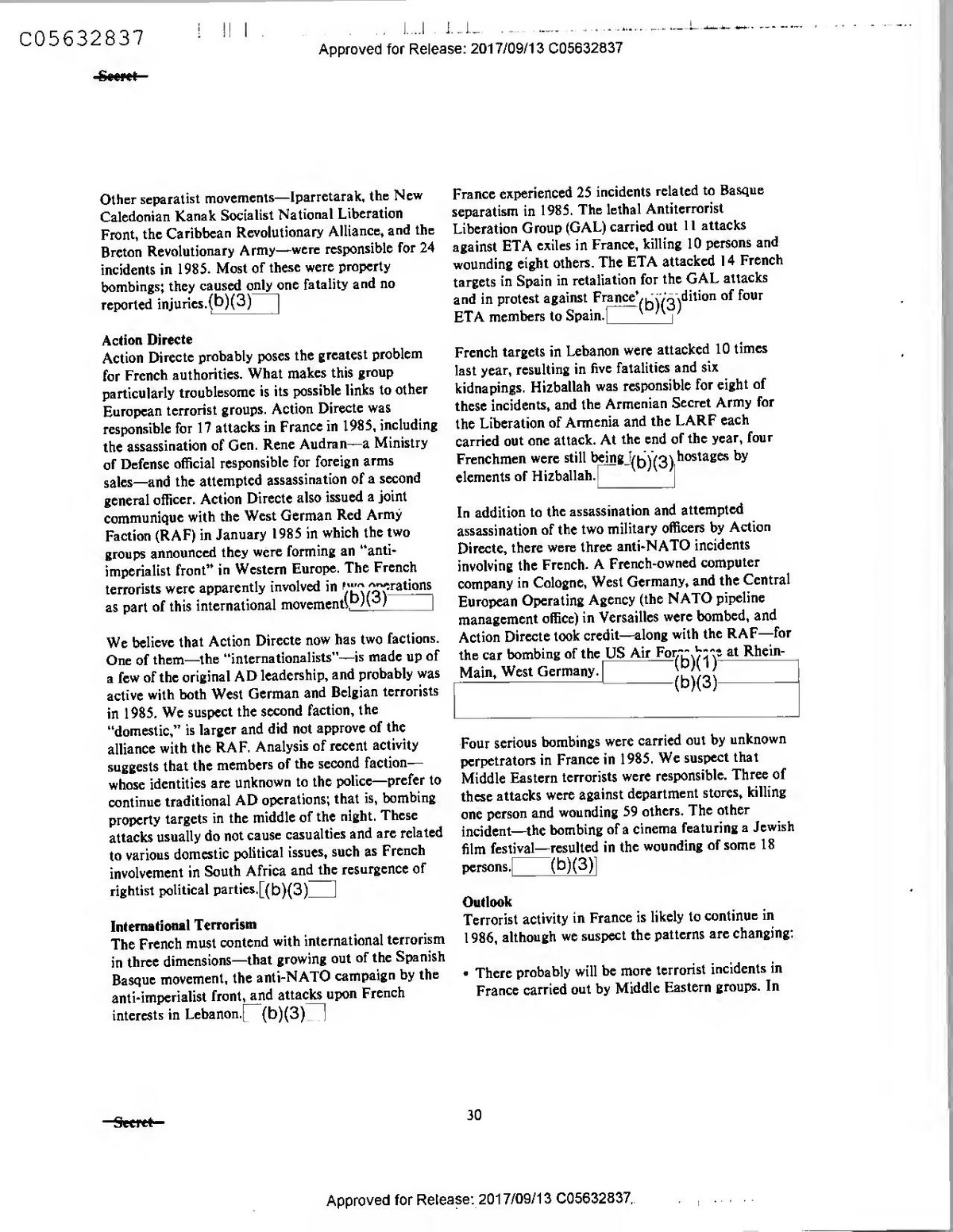
Seeret
Frenchmen were still being_(b)(3) hostages by
Other separatist movements—Iparretarak, the New France experienced 25 incidents related to Basque Caledonian Kanak Socialist National Liberation separatism in 1985. The lethal Antiterrorist Front, the Caribbean Revolutionary Alliance, and the Liberation Group (GAL) carried out 11 attacks Breton Revolutionary Army-were responsible for 24 against ETA exiles in France, killing 10 persons and incidents in 1985. Most of these were property
wounding eight others. The ETA attacked 14 French bombings; they caused only one fatality and no
targets in Spain in retaliation for the GAL attacks reported injuries.(b)(3)
and in protest against France'
(b)(3)"
dition of four
ETA members to Spain. Action Directe Action Directe probably poses the greatest problem French targets in Lebanon were attacked 10 times for French authorities. What makes this group
last year, resulting in five fatalities and six particularly troublesome is its possible links to other kidnapings. Hizballah was responsible for eight of European terrorist groups. Action Directe was
these incidents, and the Armenian Secret Army for responsible for 17 attacks in France in 1985, including the Liberation of Armenia and the LARF each the assassination of Gen. Rene Audran-a Ministry carried out one attack. At the end of the year, four of Defense official responsible for foreign arms sales—and the attempted assassination of a second elements of Hizballah. general officer. Action Directe also issued a joint communique with the West German Red Army In addition to the assassination and attempted Faction (RAF) in January 1985 in which the two assassination of the two military officers by Action groups announced they were forming an “anti- Directe, there were three anti-NATO incidents imperialist front" in Western Europe. The French involving the French. A French-owned computer terrorists were apparently involved in town onerations company in Cologne, West Germany, and the Central as part of this international movementsb)(3)
European Operating Agency (the NATO pipeline
management office) in Versailles were bombed, and We believe that Action Directe now has two factions. Action Directe took credit-along with the RAF-for One of them—the "internationalists"—is made up of the car bombing of the US Air Form bare at Rheina few of the original AD leadership, and probably was Main, West Germany.
"(b)(1) active with both West German and Belgian terrorists
(b)(3) in 1985. We suspect the second faction, the "domestic," is larger and did not approve of the alliance with the RAF. Analysis of recent activity Four serious bombings were carried out by unknown suggests that the members of the second faction- perpetrators in France in 1985. We suspect that whose identities are unknown to the police-prefer to Middle Eastern terrorists were responsible. Three of continue traditional AD operations; that is, bombing these attacks were against department stores, killing property targets in the middle of the night. These one person and wounding 59 others. The other attacks usually do not cause casualties and are related incident—the bombing of a cinema featuring a Jewish to various domestic political issues, such as French film festival-resulted in the wounding of some 18 involvement in South Africa and the resurgence of persons.
(b)(3)] rightist political parties.[(b)(3)
Outlook International Terrorism
Terrorist activity in France is likely to continue in The French must contend with international terrorism 1986, although we suspect the patterns are changing: in three dimensions—that growing out of the Spanish Basque movement, the anti-NATO campaign by the • There probably will be more terrorist incidents in anti-imperialist front, and attacks upon French
France carried out by Middle Eastern groups. In interests in Lebanon. (b)(3)]
30
Secret
Approved for Release: 2017/09/13 C05632837..
O
In another report, published on 2 November 1985, TASS accused the CIA of organizing the assassination of Grenadan Prime Minister Maurice Bishonafter which the United States invaded the country. [(b)(3)7
3. US Terrorism. Recurring Soviet themes--linking political assassinations, US aid to liberation movements, and CIA
United States for making terrorism a state policy.
(b)(3)he
O
Recent attacks (TASS, 24 October 1985 and 7 March 1986) charged the United States with:
conducting undeclared wars in Africa, Asia, and Central America;
backing South African attacks against its neighbors;
- seizing hostages; and
(b)(3)
inciting national strife in India.
O
In an effort to counter US accusations of Libyan involvement in terrorism, the Soviets claimed, in a 13 March 1986 edition of Sovetskaya Rossiya, that the United States is a "factory of international terror," citing Us Marine Corps actions innvanada and mercenary
(b)(3); training in the United States.
4.
US Espionage Operations. The Soviets replay endlessly themes of secret us intelligence operations intended to subvert the populace of other countries and destabilize governments.
(b)(3)
O
In January 1986 Radio Moscow charged that the CIA will be using funds to recruit scientists, journalists, missionary doctors, and university teachers to work in developing countries as CIA agents.
In mid-February, elaborately fabricated packages were delivered to a number of African newspaper offices. The packages listed alleged CIA penetrations of media, and some contained over 100 names of US officials, journalists of various nationalities, and a few US university professors allegedly linked to the CIA. This disinformation operation surfaced in seven African countries and implicated media in nine other countries.
Some press allegations of media associations with the CIA appeared concurrently in countries as far afiel¢(b)(3)
the Philippines and Dominican Republic.
O
The Soviets have capitalized on Yurchenko's redefection, most recently in the 11 March edition of Pravda, and the scientist Alexandrov's disappearance, in a 27 January
2
(b)(3)
SECRET
Approved for Release: 2017/09/13 C05612850
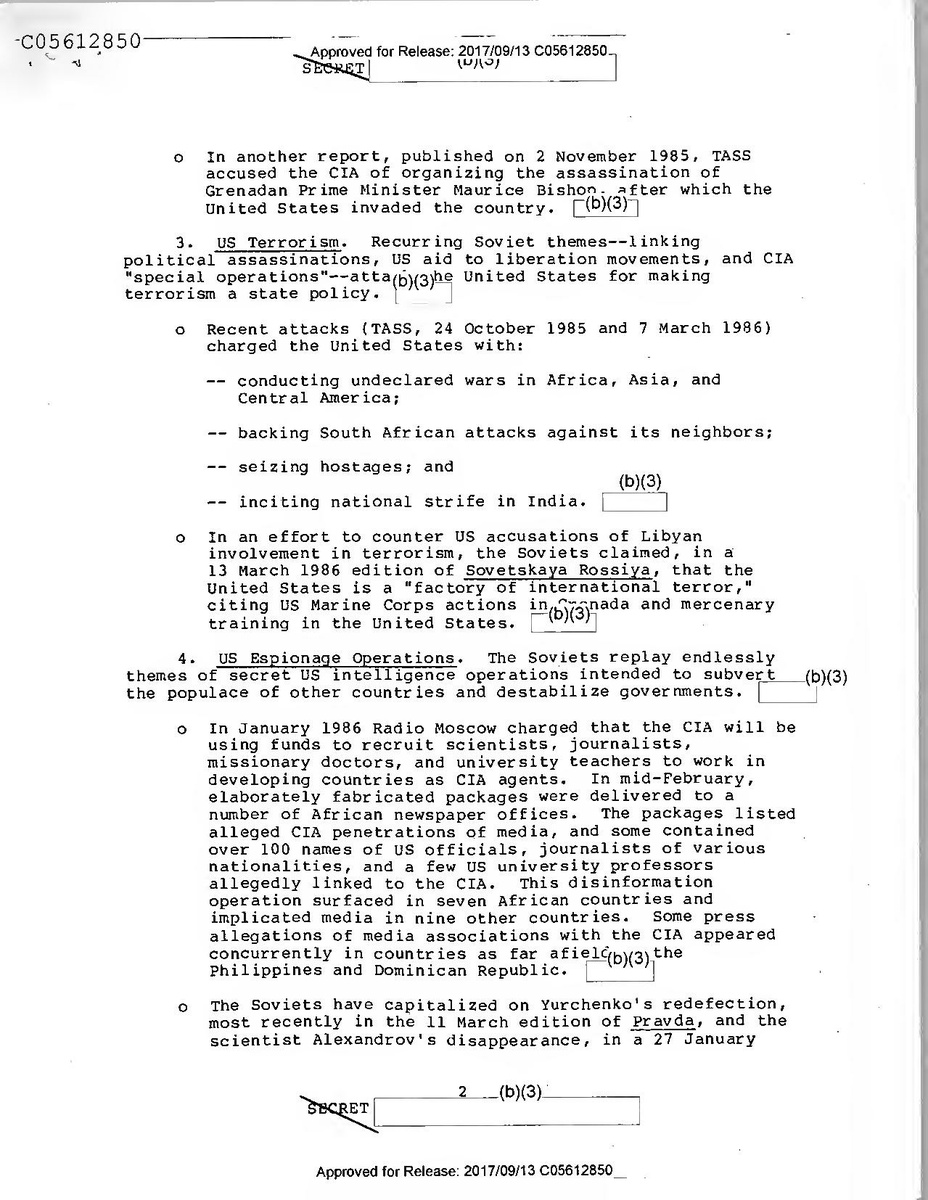
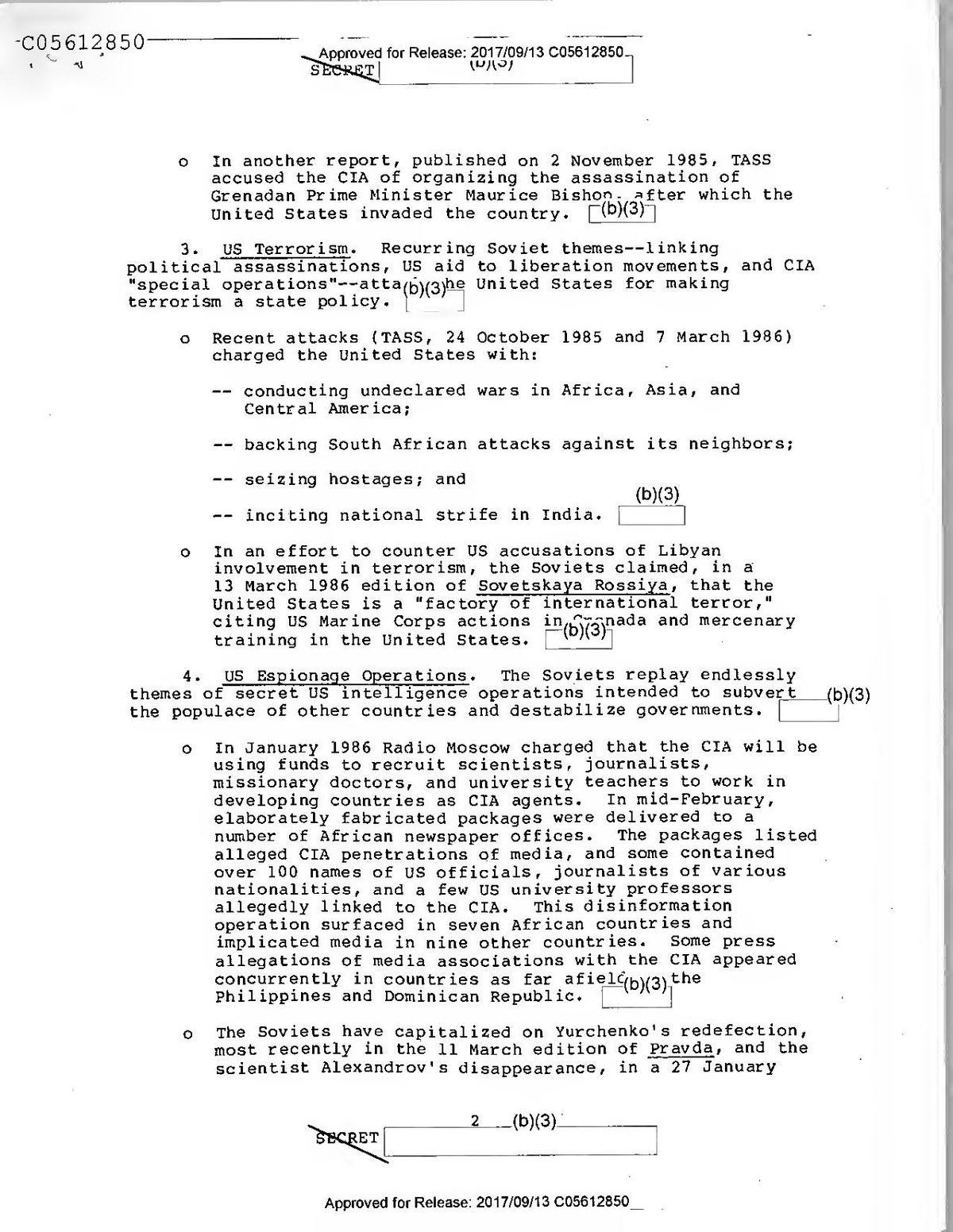
O
In another report, published on 2 November 1985, TASS accused the CIA of organizing the assassination of Grenadan Prime Minister Maurice Bishonafter which the United States invaded the country. [(b)(3)7
3. US Terrorism. Recurring Soviet themes--linking political assassinations, US aid to liberation movements, and CIA
United States for making terrorism a state policy.
(b)(3)he
O
Recent attacks (TASS, 24 October 1985 and 7 March 1986) charged the United States with:
conducting undeclared wars in Africa, Asia, and Central America;
backing South African attacks against its neighbors;
- seizing hostages; and
(b)(3)
inciting national strife in India.
O
In an effort to counter US accusations of Libyan involvement in terrorism, the Soviets claimed, in a 13 March 1986 edition of Sovetskaya Rossiya, that the United States is a "factory of international terror," citing Us Marine Corps actions innvanada and mercenary
(b)(3); training in the United States.
4.
US Espionage Operations. The Soviets replay endlessly themes of secret us intelligence operations intended to subvert the populace of other countries and destabilize governments.
(b)(3)
O
In January 1986 Radio Moscow charged that the CIA will be using funds to recruit scientists, journalists, missionary doctors, and university teachers to work in developing countries as CIA agents.
In mid-February, elaborately fabricated packages were delivered to a number of African newspaper offices. The packages listed alleged CIA penetrations of media, and some contained over 100 names of US officials, journalists of various nationalities, and a few US university professors allegedly linked to the CIA. This disinformation operation surfaced in seven African countries and implicated media in nine other countries.
Some press allegations of media associations with the CIA appeared concurrently in countries as far afiel¢(b)(3)
the Philippines and Dominican Republic.
O
The Soviets have capitalized on Yurchenko's redefection, most recently in the 11 March edition of Pravda, and the scientist Alexandrov's disappearance, in a 27 January
2
(b)(3)
SECRET
Approved for Release: 2017/09/13 C05612850
Sceret
particular, radical Islamic fundamentalists are likely to strike French interests in both France and Lebanon as long as a French presence remains in Lebanon and France continues to provide weapons to Iraq. Libya also may stage attacks against French targets if Paris continues to actively support the Government of Chad.
• French police have had no recent success against
Action Directe, and both its international and domestic factions appear to be capable of carrying out attacks at will.
• The Antiterrorist Liberation Group is likely to
continue its deadly campaign against Spanish Basques in France, which may provoke ETA to retaliate against French targets in Spain.
(b)(3)
b(
On a more positive note, terrorist attacks by separatist groups against France probably will decline. The FLNC observed a self-imposed moratorium on violence from July 1985 through January 1986, but recently carried out several bombings. Iparretarak and the separatist movements in the French Caribbean and New Caledonia have been relatively quiet so far this year. Even if terrorist activity by the separatist groups declines, the new French Government still will have to contend with a formidable terrorist problem. In our view, France probably faces an increase in serious international terrorist activity that will more than offset the effects of reduced violence by separatist groups.
(b)(3)
31
Seerot
Approved for Release: 2017/09/13 C05632837
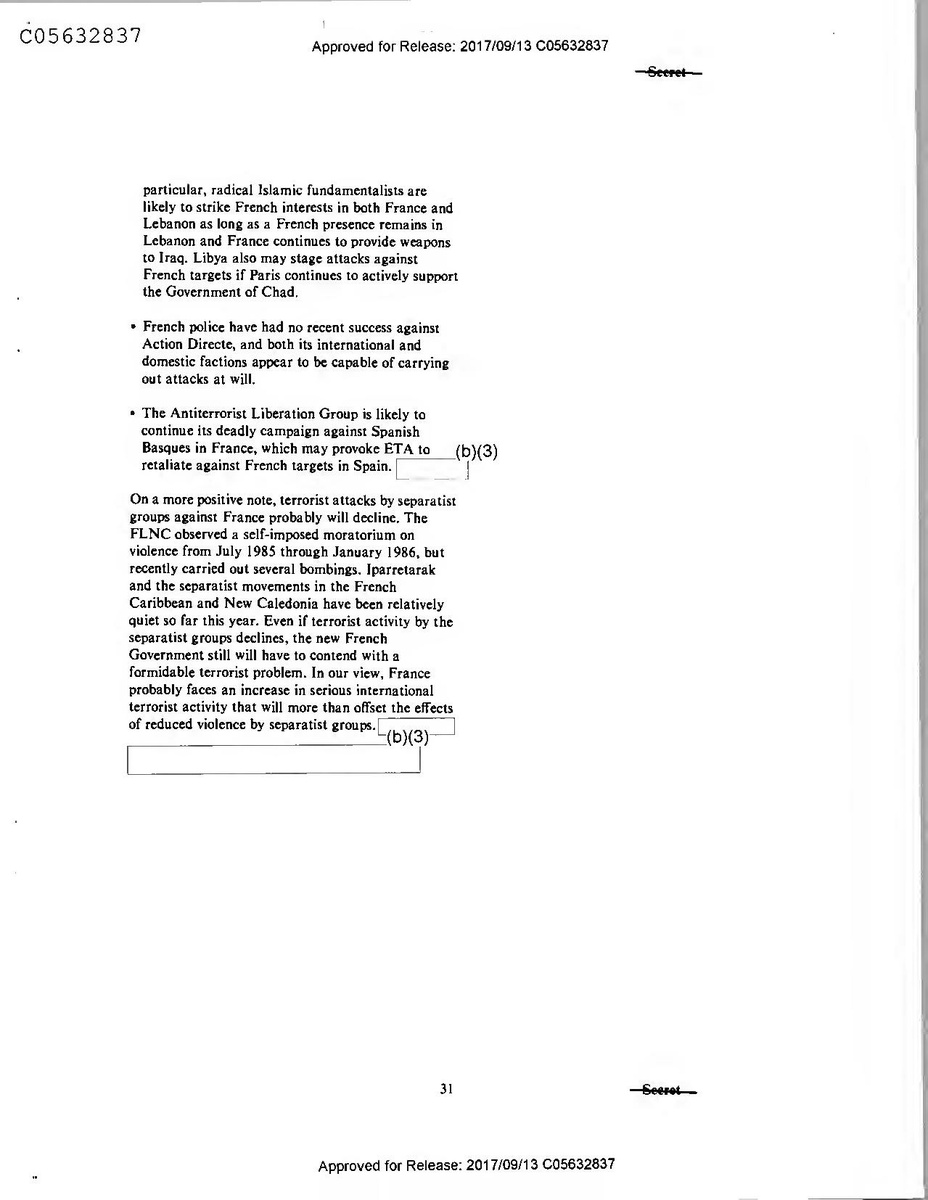
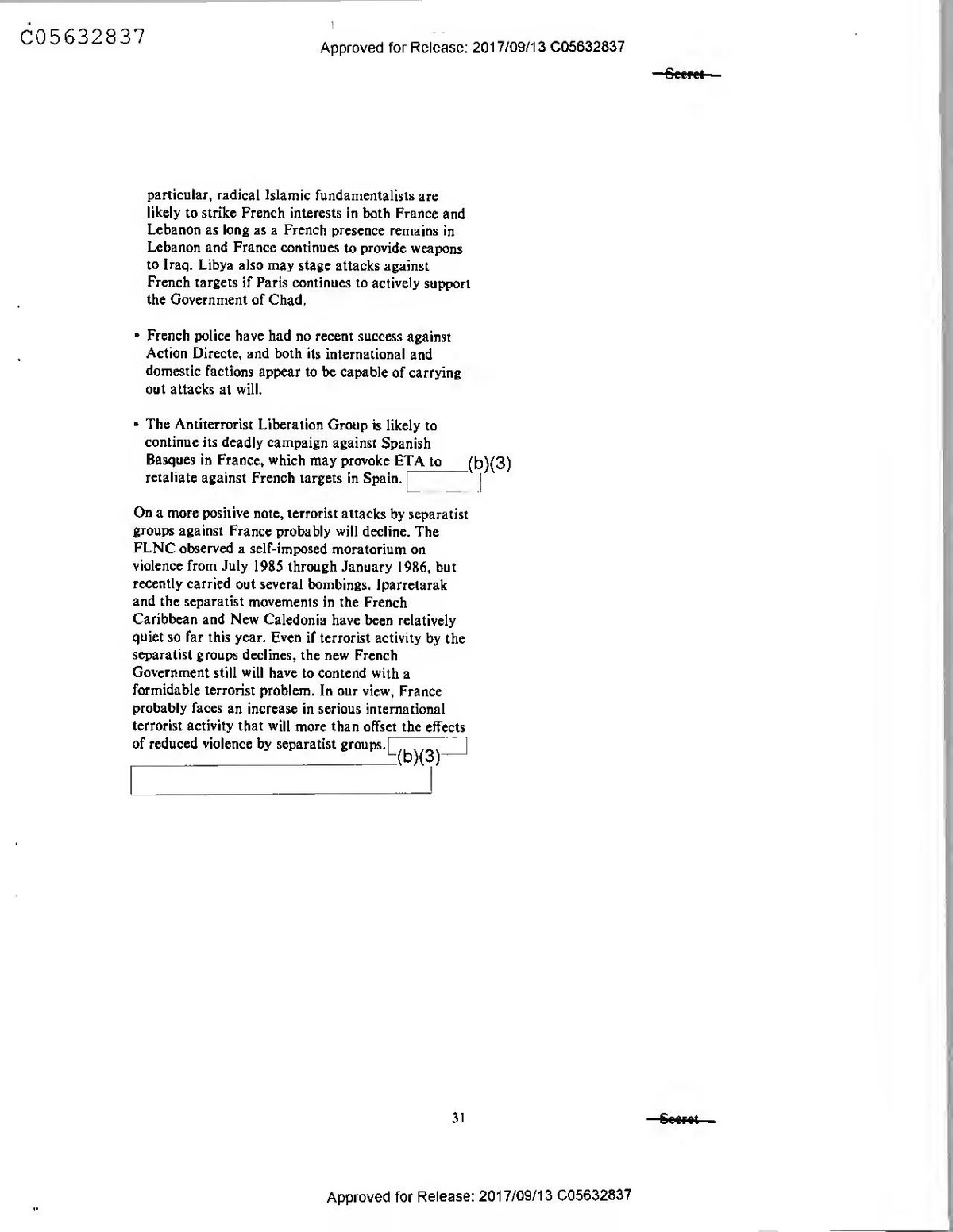
Sceret
particular, radical Islamic fundamentalists are likely to strike French interests in both France and Lebanon as long as a French presence remains in Lebanon and France continues to provide weapons to Iraq. Libya also may stage attacks against French targets if Paris continues to actively support the Government of Chad.
• French police have had no recent success against
Action Directe, and both its international and domestic factions appear to be capable of carrying out attacks at will.
• The Antiterrorist Liberation Group is likely to
continue its deadly campaign against Spanish Basques in France, which may provoke ETA to retaliate against French targets in Spain.
(b)(3)
b(
On a more positive note, terrorist attacks by separatist groups against France probably will decline. The FLNC observed a self-imposed moratorium on violence from July 1985 through January 1986, but recently carried out several bombings. Iparretarak and the separatist movements in the French Caribbean and New Caledonia have been relatively quiet so far this year. Even if terrorist activity by the separatist groups declines, the new French Government still will have to contend with a formidable terrorist problem. In our view, France probably faces an increase in serious international terrorist activity that will more than offset the effects of reduced violence by separatist groups.
(b)(3)
31
Seerot
Approved for Release: 2017/09/13 C05632837
Approved for Release: 2017/09/13 C05632837
Approved for Release: 2017/09/13 C05632837
Seeret
Syrian-Sponsored Terrorism in Western Europe (b)(3)
Syria sponsors terrorist attacks in Western Europe in a calculated effort to achieve both domestic and foreign policy goals.
(b)(1).
Early attacks in Western Europe, believed to have been organized by Syrian intelligence and carried out by Syrian operatives to intimidate regime opponents, include:
Syria officially denounces terrorism, but we believe it considers these operations part of its national security strategy and that it distinguishes such operations from terrorist
• The assassination of former Prime Minister Salah al-Bitar in Paris on 21 July 1970. (b)(1)
(b)(3).
incidents perpetrated by other f(b)(1) that receive Syrian support.
(b)(3)
• The assassination attempt on Muslim Brotherhood
leader Issam al-Attar in Aachen, West Germany, on 17 March 1981. The attack resulted in the death of Attar's wife
(b)(1)
• The attempt on 19 December 1981 to bomb the proIraqi Arabic-language im Al Watan al Arabi in Paris. I
(b)(1); (b)(3)
Syria has used its own agents and, since 1984, surrogate groups to execute operations. We believe Syria has increasingly employed surrogates in part because these groups can use their established cells in Western Europe—and the Palestinian and other Middle Eastern populations there—to support their operations. We also believe Syria facilitates these surrogate operations by using their diplomatic channels in Europe to transport operatives. Although Syria uses surrogates to shield itself from direct association with such operations, it runs the risk of being implicated in attacks that are carried out by Syrian-supported terrorist groups without Syrian endorsement.[(b)(3)
The Early Focus Western Europe became a focus of Syrian-sponsored terrorism in the late 1970s when Syrian operatives pursued and executed anti-Assad dissidents there. Many Syrian dissidents, especially Muslim Brotherhood fundamentalists, had fled Syria to escape persecution and sought asylum in Western Europe.
There appeared to be a lull in Syrian operations in Western Europe in 1982 after the Assad regime subdued the Muslim Brotherhood at home. In addition, West European governments pressed Syria to end terrorist attacks on their territories. In early 1982, France obtained a Syrian pledge to reques (b)(1) Nidal to refrain from attacks in France in excha for an undisclosed French gesture,
(b)(3) Before then, the Abu Nidal Group had been responsible for several terrorist operations in Western Europe directed against Syrian dissidents on behalf of Syria,
(b)(1) (b)(3)
(b)(1) (b)(3)
33
Secret DI TR 86-005 April 1986
Approved for Release: 2017/09/13 C05632837
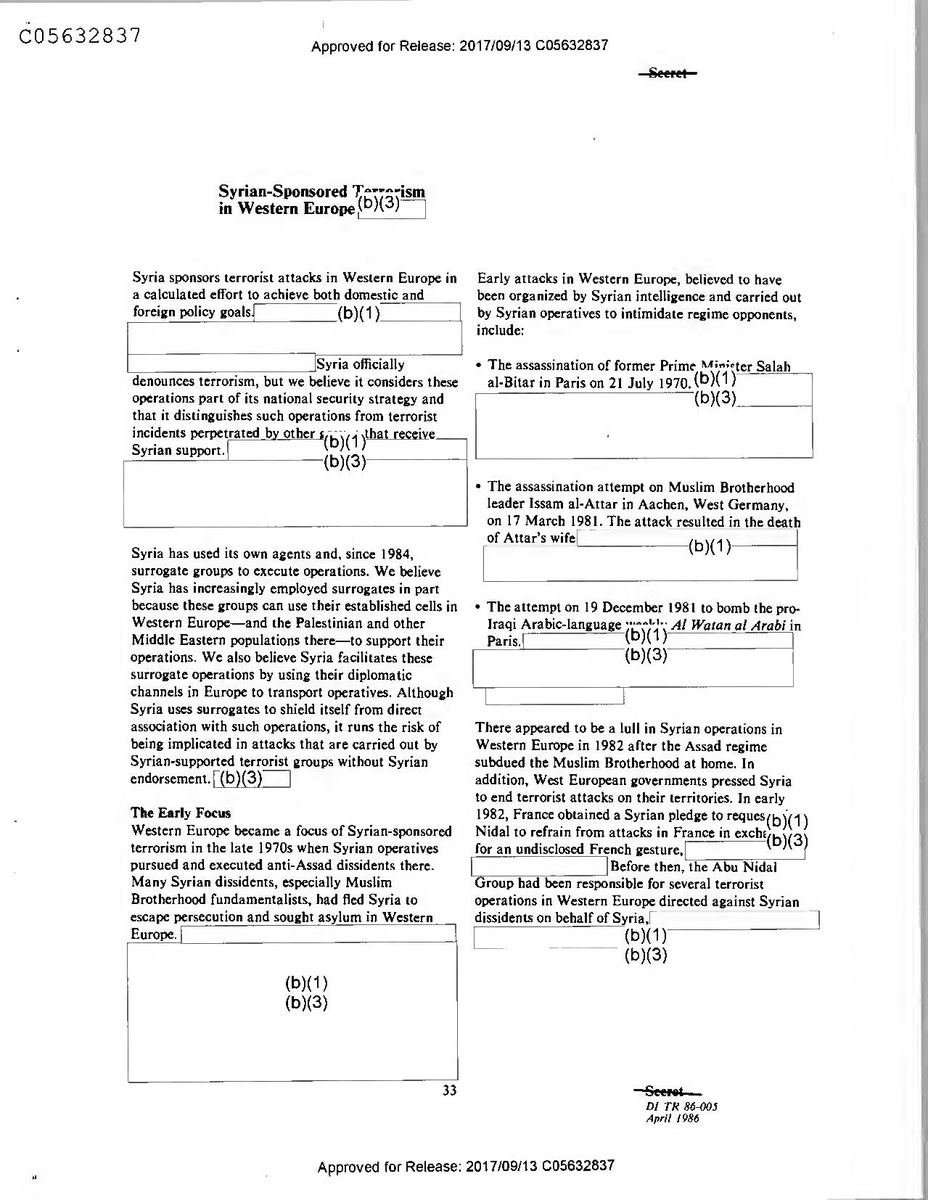
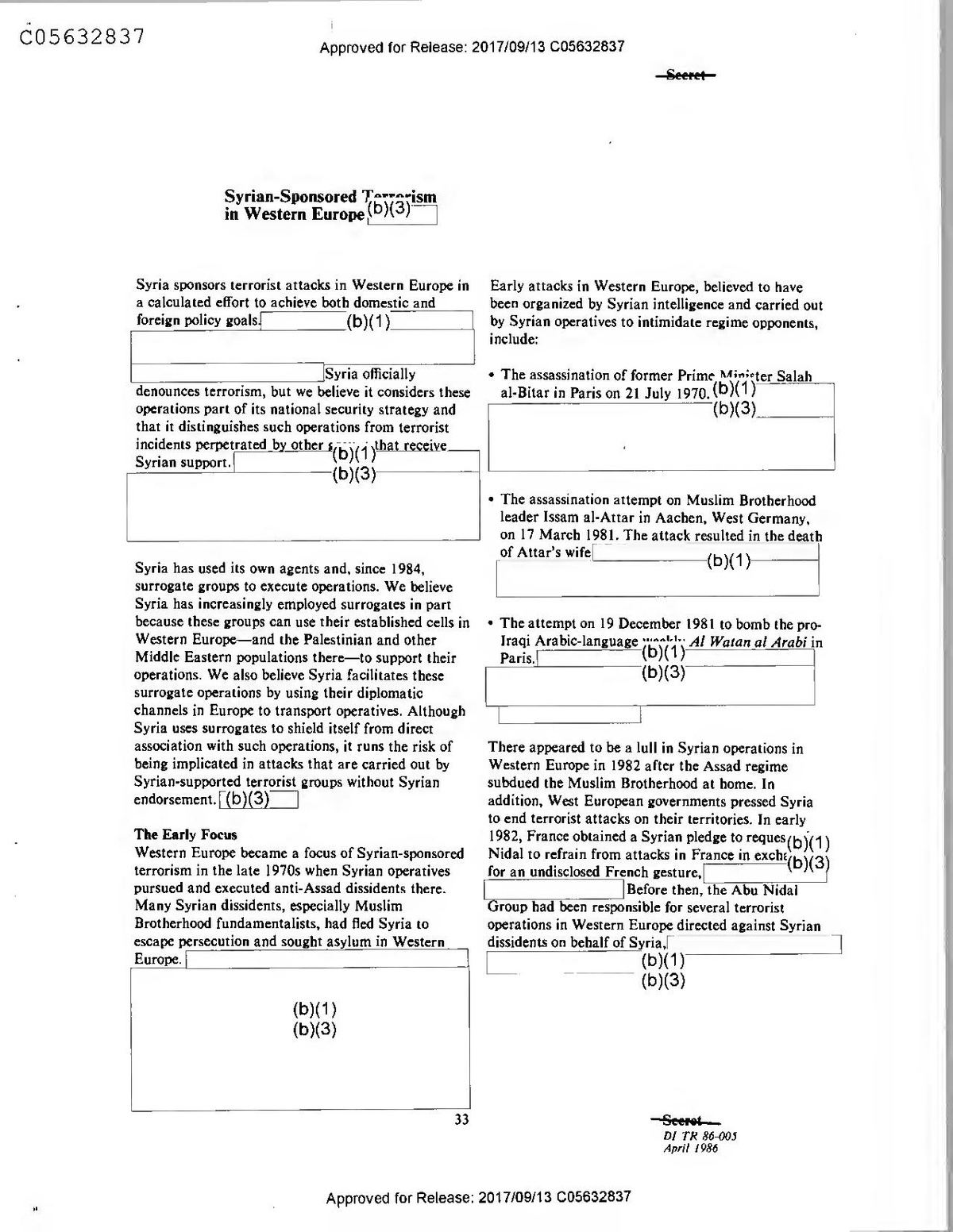
Seeret
Syrian-Sponsored Terrorism in Western Europe (b)(3)
Syria sponsors terrorist attacks in Western Europe in a calculated effort to achieve both domestic and foreign policy goals.
(b)(1).
Early attacks in Western Europe, believed to have been organized by Syrian intelligence and carried out by Syrian operatives to intimidate regime opponents, include:
Syria officially denounces terrorism, but we believe it considers these operations part of its national security strategy and that it distinguishes such operations from terrorist
• The assassination of former Prime Minister Salah al-Bitar in Paris on 21 July 1970. (b)(1)
(b)(3).
incidents perpetrated by other f(b)(1) that receive Syrian support.
(b)(3)
• The assassination attempt on Muslim Brotherhood
leader Issam al-Attar in Aachen, West Germany, on 17 March 1981. The attack resulted in the death of Attar's wife
(b)(1)
• The attempt on 19 December 1981 to bomb the proIraqi Arabic-language im Al Watan al Arabi in Paris. I
(b)(1); (b)(3)
Syria has used its own agents and, since 1984, surrogate groups to execute operations. We believe Syria has increasingly employed surrogates in part because these groups can use their established cells in Western Europe—and the Palestinian and other Middle Eastern populations there—to support their operations. We also believe Syria facilitates these surrogate operations by using their diplomatic channels in Europe to transport operatives. Although Syria uses surrogates to shield itself from direct association with such operations, it runs the risk of being implicated in attacks that are carried out by Syrian-supported terrorist groups without Syrian endorsement.[(b)(3)
The Early Focus Western Europe became a focus of Syrian-sponsored terrorism in the late 1970s when Syrian operatives pursued and executed anti-Assad dissidents there. Many Syrian dissidents, especially Muslim Brotherhood fundamentalists, had fled Syria to escape persecution and sought asylum in Western Europe.
There appeared to be a lull in Syrian operations in Western Europe in 1982 after the Assad regime subdued the Muslim Brotherhood at home. In addition, West European governments pressed Syria to end terrorist attacks on their territories. In early 1982, France obtained a Syrian pledge to reques (b)(1) Nidal to refrain from attacks in France in excha for an undisclosed French gesture,
(b)(3) Before then, the Abu Nidal Group had been responsible for several terrorist operations in Western Europe directed against Syrian dissidents on behalf of Syria,
(b)(1) (b)(3)
(b)(1) (b)(3)
33
Secret DI TR 86-005 April 1986
Approved for Release: 2017/09/13 C05632837
Secret
Current Phase Syrian-sponsored terrorist incidents in Western Europe resumed in 1983 with attacks on pro-Arafat Palestinians and Jordanian diplomats.
Syrian Use of Surrogates Syria increasingly uses Palestinian groups as surrogates to carry out operations in Western Europe, making it more difficult to implicate Syria in a particular incident. These surrogates often have cells in Europe that facilitate the coordination and execution of operations. Syria provides safehaven and training in facilities in Syria or Syrian-controlled territorin exchange for the surrogates' cooperation.
(b)(3)
(b)(1) (b)(3)
(b)(1) (b)(3)
Several attacks on Jordanian personnel and facilities by Abu Nidal representatives took place after Jordan renewed diplomatic relations with Egypt in September 1984 and allowed the Palestine National Council to meet in Amman the following November. Syria encouraged these attacks in order to bring pressure on the Jordanians not to proceed independently in Middle Eastern peace negotiations. Attacks against Jordanians in Western Europe, believed to have been sponsored by Syria as part of this drive, include:
Although most of the Abu Nidal Group's attacks have served Syrian interests, the group has its own agenda, and we believe operations conducted in Western Europe by this group do not always have Syrian endorsement, particularly since the group's involvement with Libya has increased.
• Attacks on 21 March 1985 on the offices of Aliathe Jordanian airline-in Rome, Athens, and Cyprus, claimed in the name of Black September, a covername used by the Abu Nidal Group,
(b)(1) (b)(3)
• The rocket attack on 3 April 1985 against the Jordanian Embassy in Rome. The attack wa:(b)(1). claimed in the name of Black September, (b)(3)
(b)(3)
.
The missile attack on 4 April 1985 against an Alia aircraft in Athens. The missile was fired at the aircraft as it took off from Athens airport. The warhead penetrated the fuselage but did not explode.
We believe Syria uses its embassies in Europe to support terrorist operations.(b)(1)(b)(3)
• The assassination on 18 September 1985 of
Jordanian publisher Michel al-Nimairi in Athens. Nimairi was a personal friend of PLO leader Yasir Arafat and publisher of the Arab-language magazine Al Nashra. The attack was claimed by Black September. (b)(3)
Secret
34
Approved for Release: 2017/09/13 C05632837
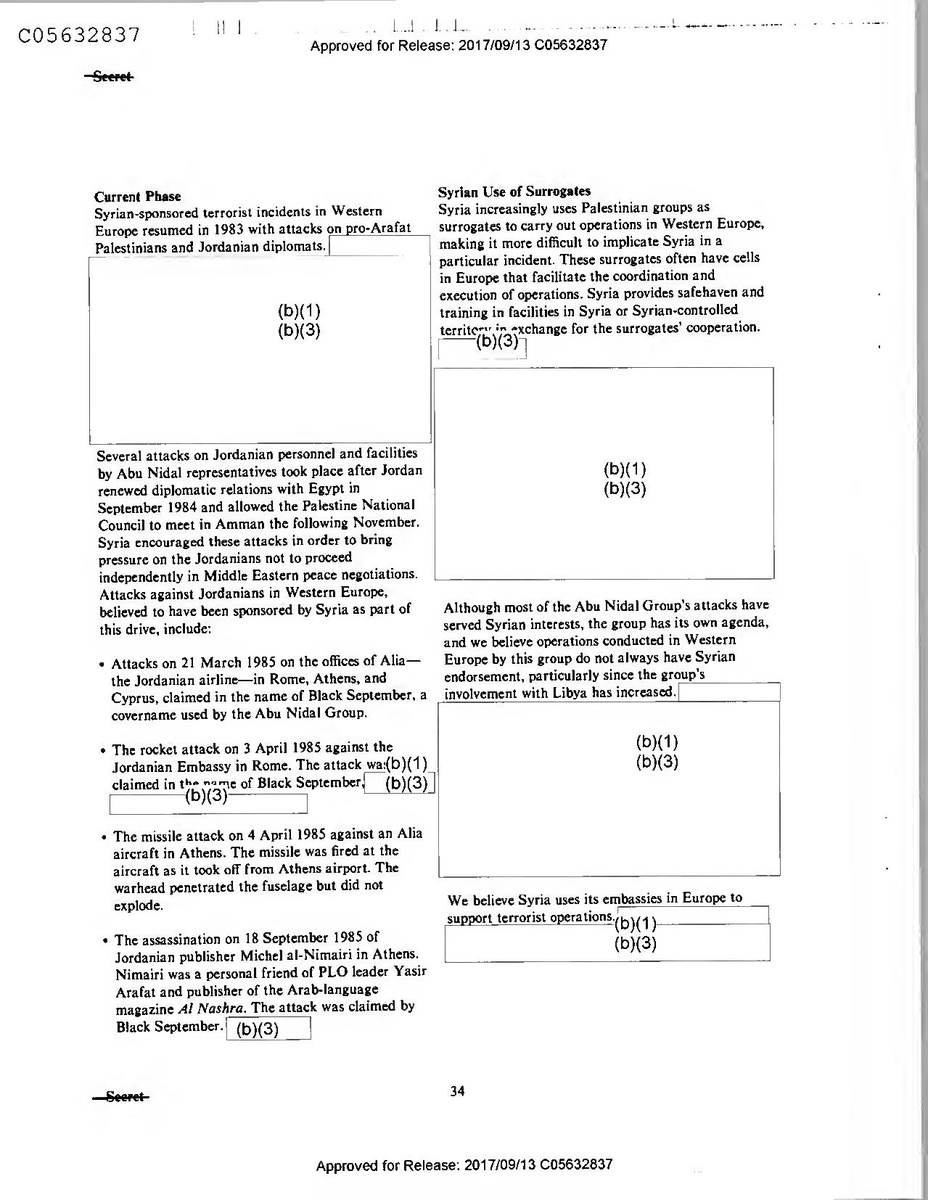
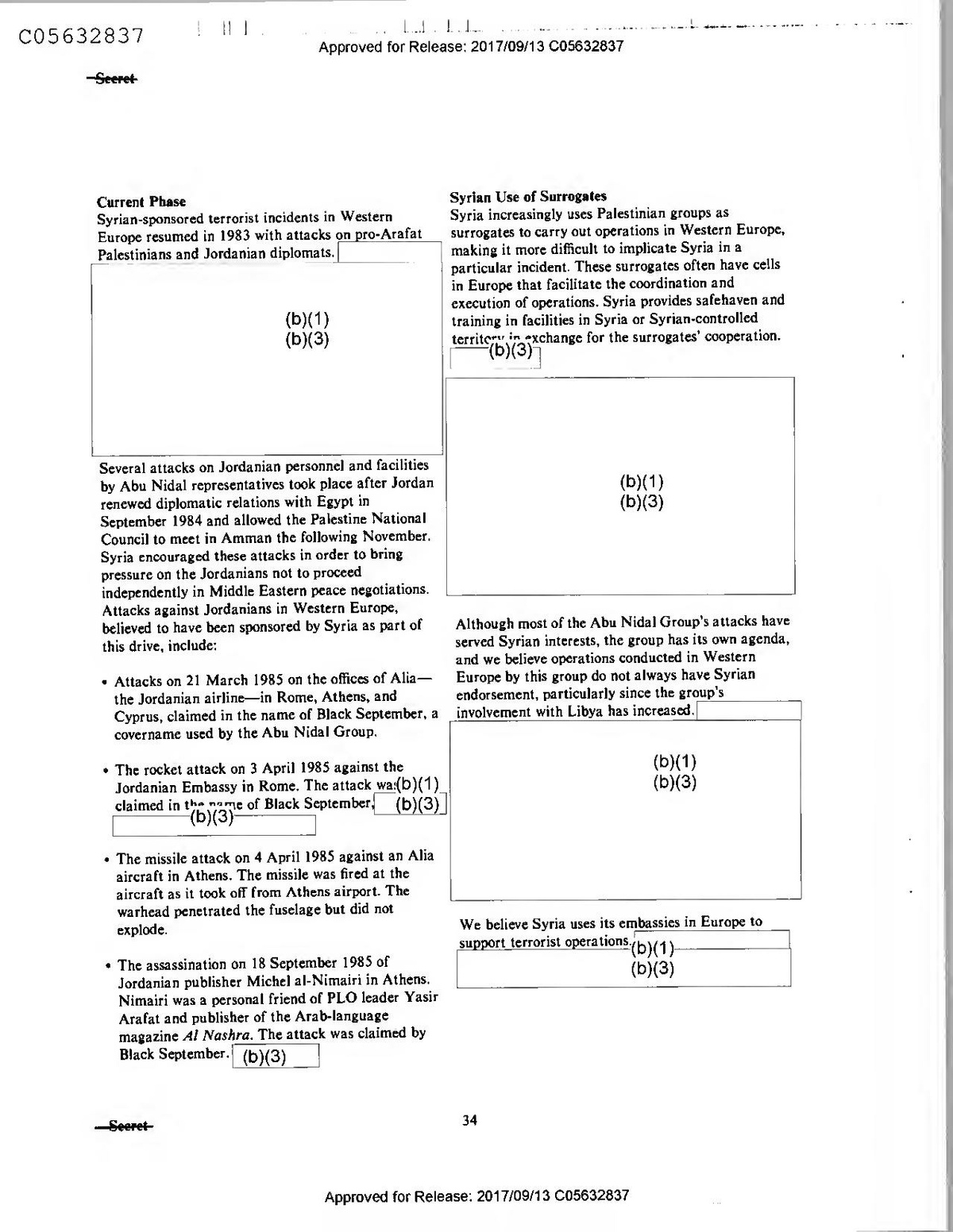
Secret
Current Phase Syrian-sponsored terrorist incidents in Western Europe resumed in 1983 with attacks on pro-Arafat Palestinians and Jordanian diplomats.
Syrian Use of Surrogates Syria increasingly uses Palestinian groups as surrogates to carry out operations in Western Europe, making it more difficult to implicate Syria in a particular incident. These surrogates often have cells in Europe that facilitate the coordination and execution of operations. Syria provides safehaven and training in facilities in Syria or Syrian-controlled territorin exchange for the surrogates' cooperation.
(b)(3)
(b)(1) (b)(3)
(b)(1) (b)(3)
Several attacks on Jordanian personnel and facilities by Abu Nidal representatives took place after Jordan renewed diplomatic relations with Egypt in September 1984 and allowed the Palestine National Council to meet in Amman the following November. Syria encouraged these attacks in order to bring pressure on the Jordanians not to proceed independently in Middle Eastern peace negotiations. Attacks against Jordanians in Western Europe, believed to have been sponsored by Syria as part of this drive, include:
Although most of the Abu Nidal Group's attacks have served Syrian interests, the group has its own agenda, and we believe operations conducted in Western Europe by this group do not always have Syrian endorsement, particularly since the group's involvement with Libya has increased.
• Attacks on 21 March 1985 on the offices of Aliathe Jordanian airline-in Rome, Athens, and Cyprus, claimed in the name of Black September, a covername used by the Abu Nidal Group,
(b)(1) (b)(3)
• The rocket attack on 3 April 1985 against the Jordanian Embassy in Rome. The attack wa:(b)(1). claimed in the name of Black September, (b)(3)
(b)(3)
.
The missile attack on 4 April 1985 against an Alia aircraft in Athens. The missile was fired at the aircraft as it took off from Athens airport. The warhead penetrated the fuselage but did not explode.
We believe Syria uses its embassies in Europe to support terrorist operations.(b)(1)(b)(3)
• The assassination on 18 September 1985 of
Jordanian publisher Michel al-Nimairi in Athens. Nimairi was a personal friend of PLO leader Yasir Arafat and publisher of the Arab-language magazine Al Nashra. The attack was claimed by Black September. (b)(3)
Secret
34
Approved for Release: 2017/09/13 C05632837
Secret
(b)(1) (b)(3)
Targets will continue to be chosen judiciously to prevent damaging Syria's relationship with West European states. A Syrian-Jordanian rapprochement may lead to fewer attacks against Jordanian personnel and facilities, but activity against pro-Arafat Palestinians will persist. In addition, activities conducted by Syrian-sponsored terrorist groups without Damascus'
(b)(3)ser
sement will continue to implicate Syria.
(b)(3)
Because Syria attempts to conduct its terrorist operations in Western Europe in a manner that will not jeopardize its relations with European countries, we believe Syria refrains from cooperating with or sponsoring European terrorist groups. (b)(1)
(b)(3)
Outlook We believe there is a high risk that Damascus will enlist surrogate groups to strike at US personnel and facilities in Western Europe if the United States launches a military strike against Syrian tanama
(b)(1) (b)(3)
We believe Syria will continue to selectively sponsor terrorist attacks as a means of furthering both domestic and foreign policy objectives and that Western Europe will remain a prime locale for such attacks. Ease of travel and the accessibility of targets facilitate operations in Western Europe. In addition, Syria's increased use of surrogates for its terrorist operations complicates efforts to interrupt their plans and shields Syria from direct ties to the attacks. (b)(3)
35
Secret
Approved for Release: 2017/09/13 C05632837
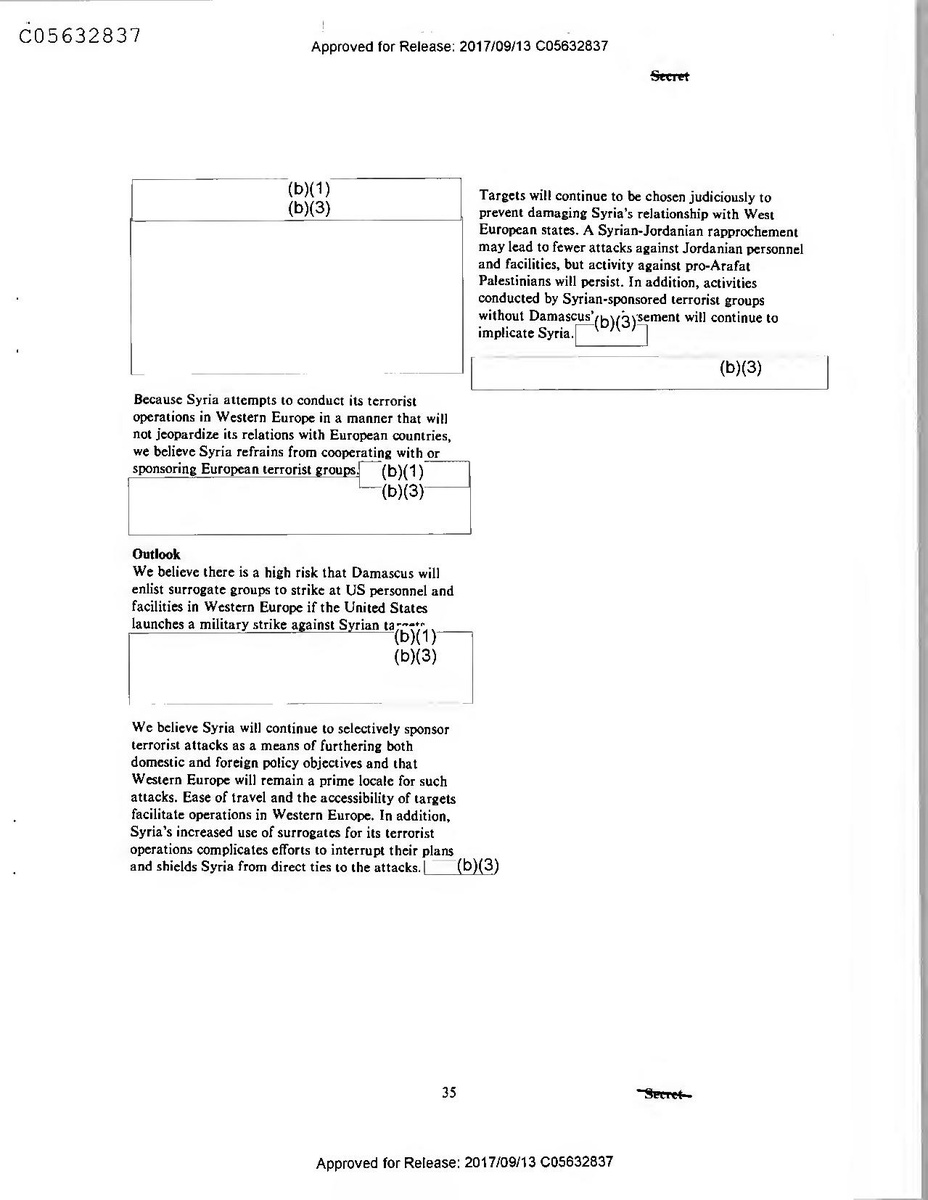
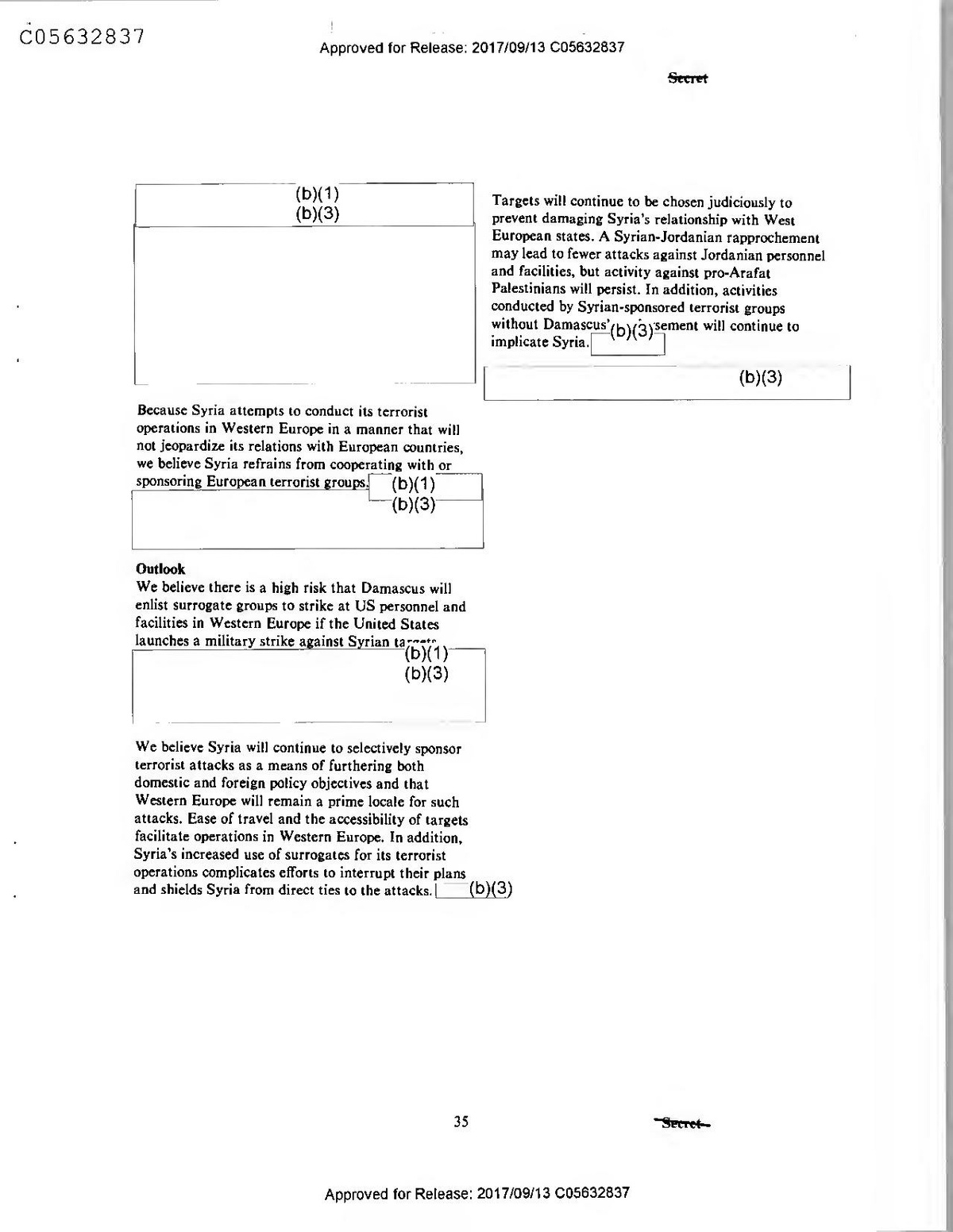
Secret
(b)(1) (b)(3)
Targets will continue to be chosen judiciously to prevent damaging Syria's relationship with West European states. A Syrian-Jordanian rapprochement may lead to fewer attacks against Jordanian personnel and facilities, but activity against pro-Arafat Palestinians will persist. In addition, activities conducted by Syrian-sponsored terrorist groups without Damascus'
(b)(3)ser
sement will continue to implicate Syria.
(b)(3)
Because Syria attempts to conduct its terrorist operations in Western Europe in a manner that will not jeopardize its relations with European countries, we believe Syria refrains from cooperating with or sponsoring European terrorist groups. (b)(1)
(b)(3)
Outlook We believe there is a high risk that Damascus will enlist surrogate groups to strike at US personnel and facilities in Western Europe if the United States launches a military strike against Syrian tanama
(b)(1) (b)(3)
We believe Syria will continue to selectively sponsor terrorist attacks as a means of furthering both domestic and foreign policy objectives and that Western Europe will remain a prime locale for such attacks. Ease of travel and the accessibility of targets facilitate operations in Western Europe. In addition, Syria's increased use of surrogates for its terrorist operations complicates efforts to interrupt their plans and shields Syria from direct ties to the attacks. (b)(3)
35
Secret
Approved for Release: 2017/09/13 C05632837
Approved for Release: 2017/09/13 C05632837
Approved for Release: 2017/09/13 C05632837
Seeret
Terrorism in Asia in 1985A Regional Profileſ(b)(3)
International terrorism in Asia in 1985 generally 10 to 12 May in a series of bombings that left more followed the pattern of recent years, well below the than 85 persons dead and more than 150 wounded in level of activity in other regions of the world. Because Delhi and other cities in northern India. More than a most terrorist attacks in Asia continue to occur in the dozen bombs, many of them boobytrapped portable context of ongoing insurgencies, and because most radios, exploded in buses, bus stations, and other Asian insurgent groups do not target foreigners or crowded areas. These attacks came just before the operate across national boundaries, terrorism in Asia trial of the three Sikhs accused of murdering Mrs. tends to be predominantly domestic in character. Sikh Gandhi and represented the first massive outbreak of terrorism was a notable exception to this pattern in Sikh terrorism since that event (b)(3) 1985, in that it was international in scope, victimized foreigners, and maintained a high level of lethality. The majority of Sikh terrorist attacks have remained Other areas that we anticipated would be the sources domestic in nature—bombings, shootings, and of serious international terrorist problems in 1985- robberies. The frequency began to increase during the such as Sri Lanka's Tamils, Pakistan's Al-Zulfikar, summer of 1985, following a political agreement and Japan's Chukaku-ha---were not. Isolated terrorist between Prime Minister Rajiv Gandhi and moderate attacks occurred last year in such previously violence- Sikh leader Harchand Singh Longowal and leading free areas as Nepal and Singapore, but areas such as up to statewide elections in Punjab last September. the Philippines, Indonesia, and New Caledonia did During this period, Sikh radicals assassinated not experience as much terrorist-related violence as Longowal and other important Sikh and Hindu has been expected. (b)(3)
political figures. It remains to be seen whether the
current high rate of Sikh political violence within The Sikhs
India will destroy the Punjab accords or lead to During 1985, Sikh political violence within India another crackdown there, but any attempt to returned to the high level of early 1984. Sikh
implement the arcnols is apt to exacerbate the extremists have sought for several years to gain
situation. (b)(3) additional political rights, religious status, and territorial concessions from the central government Sikh extremist activities outside India certainly had (some seek to found an independent state). Violence profound effects during 1985. Last year's most peaked in early 1984 as radicals conducted near daily spectacular act of international terrorism was the murders of Hindus and conservative Sikh rivals. After downing of an Air India 747 over the North Atlantic the Indian Army stormed the stronghold of the largest on 23 June, probably by a bomb planted by Canadiangroup of militants in the Golden Temple in Amritsar based Sikh extremists. This incident killed more in June 1984, Sikh violence declined, but resentment people (329) than any other single terrorist attack we over the attack ran deep.[(b)(3)
have recorded. The “Sikh Student Federation, 10th
Regiment" claimed responsibility. The 10th, or The depth of Sikh anger was demonstrated most Dashmesh, Regiment is a militant Sikh group vividly in the October 1984 assassination of Prime responsible for many acts of terrorism and communal Minister Indira Gandhi, but it was not expiated with violence within India since 1981. On the same night, her death. It was further fueled by the killing of more another bomb exploded in the baggage-handling area than 2,000 Sikhs in the aftermath of her death and of Tokyo's Narita Airport, killing two Japanese carried over into 1985 in both domestic and international terrorist incidents. Sikh domestic terrorism reached its greatest intensity last year from
37
Sceret DI TR 86-005 April 1986
Approved for Release: 2017/09/13 C05632837
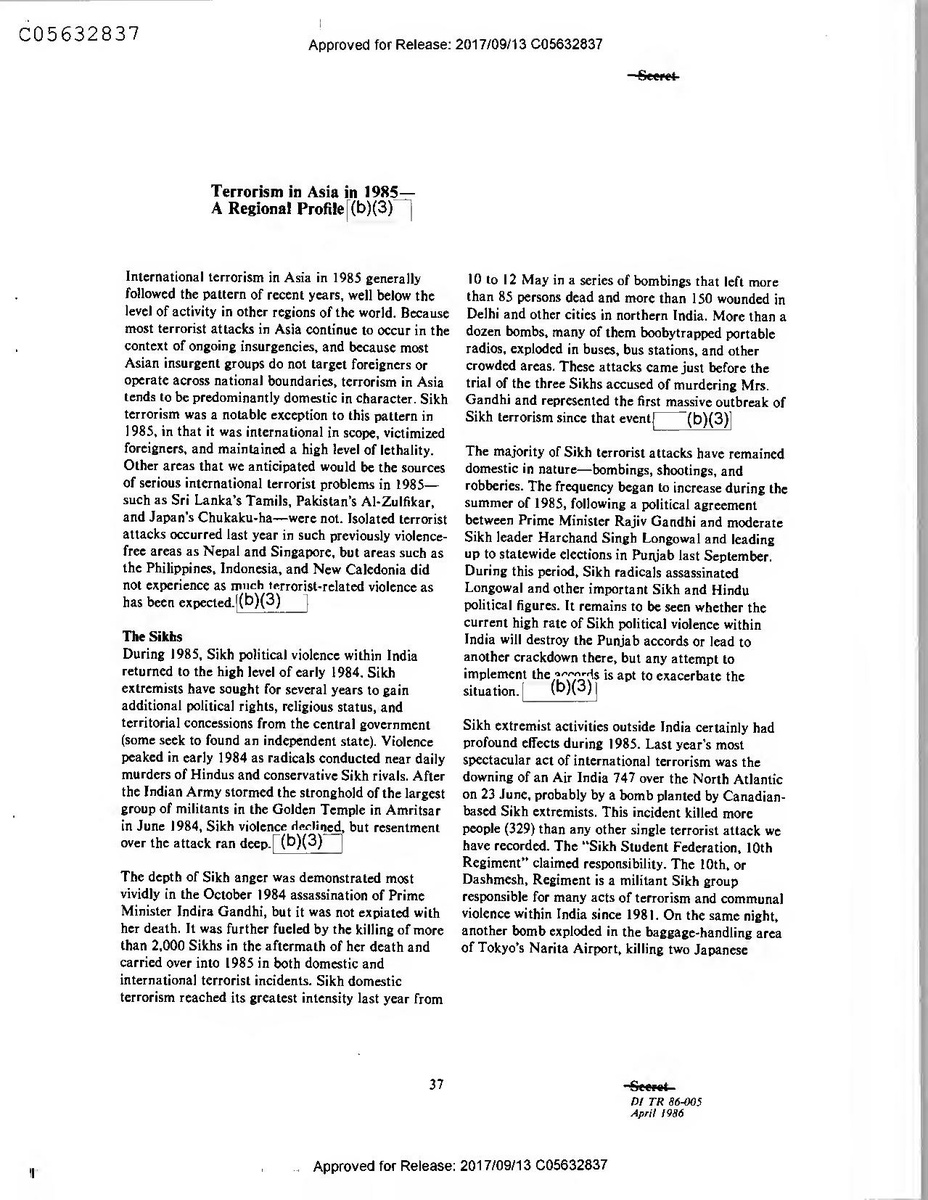
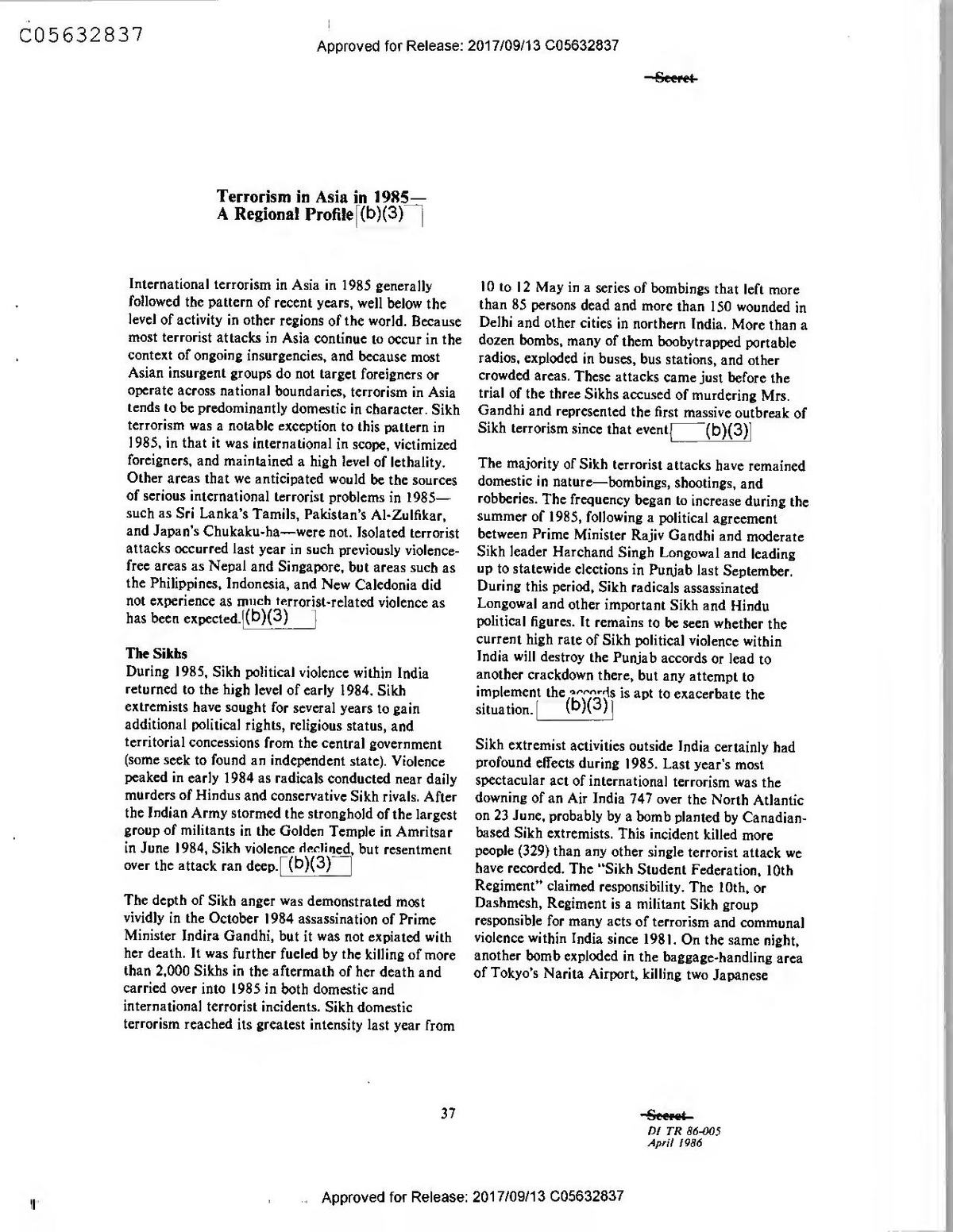
Seeret
Terrorism in Asia in 1985A Regional Profileſ(b)(3)
International terrorism in Asia in 1985 generally 10 to 12 May in a series of bombings that left more followed the pattern of recent years, well below the than 85 persons dead and more than 150 wounded in level of activity in other regions of the world. Because Delhi and other cities in northern India. More than a most terrorist attacks in Asia continue to occur in the dozen bombs, many of them boobytrapped portable context of ongoing insurgencies, and because most radios, exploded in buses, bus stations, and other Asian insurgent groups do not target foreigners or crowded areas. These attacks came just before the operate across national boundaries, terrorism in Asia trial of the three Sikhs accused of murdering Mrs. tends to be predominantly domestic in character. Sikh Gandhi and represented the first massive outbreak of terrorism was a notable exception to this pattern in Sikh terrorism since that event (b)(3) 1985, in that it was international in scope, victimized foreigners, and maintained a high level of lethality. The majority of Sikh terrorist attacks have remained Other areas that we anticipated would be the sources domestic in nature—bombings, shootings, and of serious international terrorist problems in 1985- robberies. The frequency began to increase during the such as Sri Lanka's Tamils, Pakistan's Al-Zulfikar, summer of 1985, following a political agreement and Japan's Chukaku-ha---were not. Isolated terrorist between Prime Minister Rajiv Gandhi and moderate attacks occurred last year in such previously violence- Sikh leader Harchand Singh Longowal and leading free areas as Nepal and Singapore, but areas such as up to statewide elections in Punjab last September. the Philippines, Indonesia, and New Caledonia did During this period, Sikh radicals assassinated not experience as much terrorist-related violence as Longowal and other important Sikh and Hindu has been expected. (b)(3)
political figures. It remains to be seen whether the
current high rate of Sikh political violence within The Sikhs
India will destroy the Punjab accords or lead to During 1985, Sikh political violence within India another crackdown there, but any attempt to returned to the high level of early 1984. Sikh
implement the arcnols is apt to exacerbate the extremists have sought for several years to gain
situation. (b)(3) additional political rights, religious status, and territorial concessions from the central government Sikh extremist activities outside India certainly had (some seek to found an independent state). Violence profound effects during 1985. Last year's most peaked in early 1984 as radicals conducted near daily spectacular act of international terrorism was the murders of Hindus and conservative Sikh rivals. After downing of an Air India 747 over the North Atlantic the Indian Army stormed the stronghold of the largest on 23 June, probably by a bomb planted by Canadiangroup of militants in the Golden Temple in Amritsar based Sikh extremists. This incident killed more in June 1984, Sikh violence declined, but resentment people (329) than any other single terrorist attack we over the attack ran deep.[(b)(3)
have recorded. The “Sikh Student Federation, 10th
Regiment" claimed responsibility. The 10th, or The depth of Sikh anger was demonstrated most Dashmesh, Regiment is a militant Sikh group vividly in the October 1984 assassination of Prime responsible for many acts of terrorism and communal Minister Indira Gandhi, but it was not expiated with violence within India since 1981. On the same night, her death. It was further fueled by the killing of more another bomb exploded in the baggage-handling area than 2,000 Sikhs in the aftermath of her death and of Tokyo's Narita Airport, killing two Japanese carried over into 1985 in both domestic and international terrorist incidents. Sikh domestic terrorism reached its greatest intensity last year from
37
Sceret DI TR 86-005 April 1986
Approved for Release: 2017/09/13 C05632837
Serret
workers. This incident is also believed to be the work of Canadian-based Sikhs who intended the bomb to
yher Air India jet bound for India from the east.
time outside Lebanon—the machinegun massacre of more than 150 persons at the Buddhist (b)(3)0f Anuradhapura on 14 May.
explode aboayb)(3)her
Sikhs in the United States were among those living abroad who were outraged by the storming of the Golden Temple and by the killings of Sikhs that followed Mrs. Gandhi's assassination. In late 1984 a small group of Sikhs in the United States attempted to obtain weapons and training to enable them to conduct assassinations and to bomb theaters, bridges, hotels, industrial plants, and nuclear facilities in India. Their efforts came to the attention of the FBI, which began to monitor the group and gather information on its plans and members. In early April 1985, the group sought help from its undercover FBI contact in arranging the assassination of Prime Minister Rajiv Gandhi during his June visit to the United States. The group also decided to attack the chief minister of the state of Haryana, whom they held responsible for the harassment of Sikhs in his state, while he was receiving medical treatment in New Orleans in May. The FBI acted before that attack could
(b)(3)ice
ce and arrested five of the conspirators.
No group claimed “credit" for those killings, which included women, children, and Buddhist monks and nuns, and most of the guerrilla groups condemned the attack. No arrests were ever made in the case, but the Liberation Tigers of Tamil Eelam, the most lethal of the separatist groups, was probably responsible. While the cease-fire-arranged by India and announced during meetings between government and guerrilla leaders in Nepal in June-soon afterward ensured that no further acts of that magnitude occurred, no substantial progress has been made toward resolving Tamil political demands and the potentnomains high for future terrorist attacks.
"(b)(3)
In contrast to the kidnapings and bombing attacks against foreigners that occurred in 1984, there were no attacks against foreigners or US citizens in 1985. Viewed in retrospect, most Tamil groups probably saw those brief forays into international terrorism as having been counterproductive to their cause, although some groups may be tempted by the prospect of Western publicity. The climate of violence is such that further insurgent attacks against civilians are likely and may cause some foreign casualties if they take place in Colombo. (b)(3)
These acts represented both a quantum leap in lethality for Sikh extremists and a geographic broadening of the Sikh separatist struggle. They were apparently carried out by small groups of outraged radicals who operated on an ad hoc basis, not on behalf of any established terrorist groups. Although there have been no comparable attacks outside India since mid-1985, Sikh radicals seeking control of temple management committees in the United Kingdom have attached coveral Sikh moderates there since last November.(b)(3)
Al-Zulfikar The Pakistani terrorist group Al-Zulfikar, which raised concerns in late 1983 and mid-1984 because it targeted Americans and other Westerners, appeared to have virtually collapsed during 1985. Aside from a few bombings within Pakistan early in the year,' the group has been totally inactive and has not carried out a successfUL international terrorist attack in more than two years. Al-Zulfikar appears never to have
The Tamil Insurgency Sri Lanka's Tamil separatist struggle simmered all year, moderated to some extent by a shaky cease-fire that began in June. Terrorist acts committed by the insurgents against noncombatants were few; most of the half-dozen major Tamil groups fighting for an independent state restricted their attacks to police and military forces. One notable exception was the bloodiest terrorist attack ever conducted up to that
Most international terrorism in Pakistan has involved attacks on Afghan refugees and resistance groups. We believe these attacks were carried out either by agents of the Afghan security service or by members of other resistance groups. Agents of the Afghan service are also believed to have conducted some attacks against Pakistani targets and to have kidnaped Chinese and Australian aid personnel last year. [(b)(3)
Secret
38
Approved for Release: 2017/09/13 C05632837,
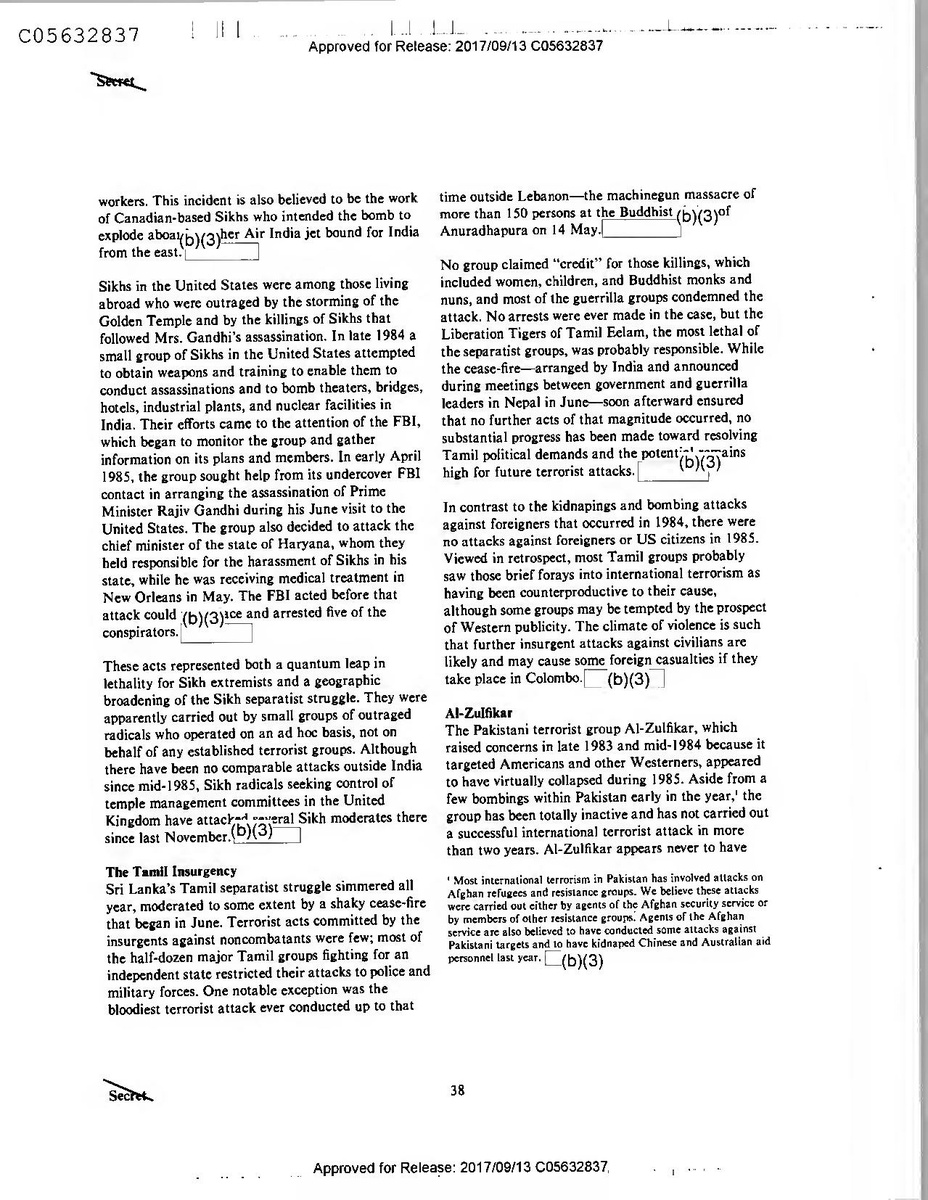
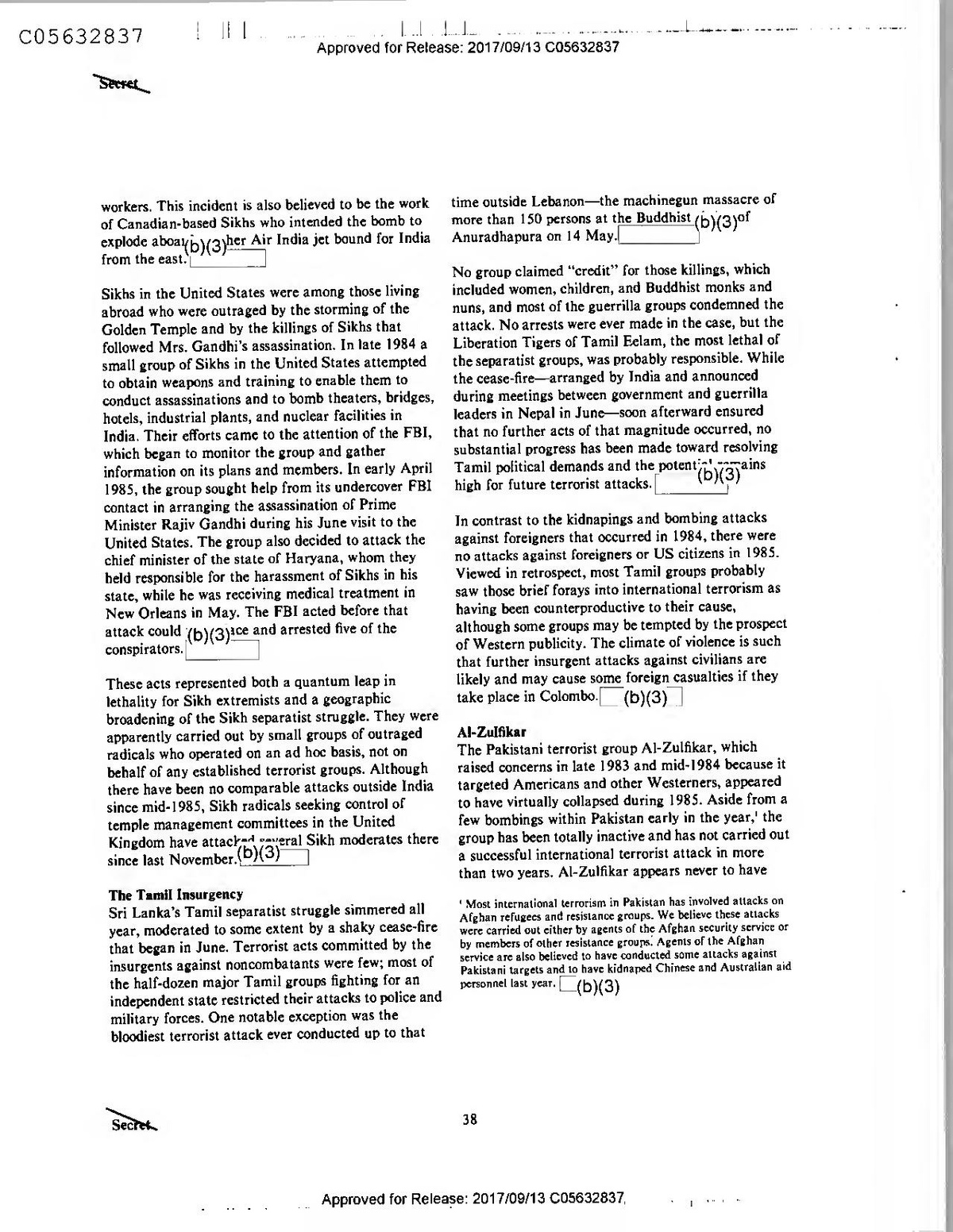
Serret
workers. This incident is also believed to be the work of Canadian-based Sikhs who intended the bomb to
yher Air India jet bound for India from the east.
time outside Lebanon—the machinegun massacre of more than 150 persons at the Buddhist (b)(3)0f Anuradhapura on 14 May.
explode aboayb)(3)her
Sikhs in the United States were among those living abroad who were outraged by the storming of the Golden Temple and by the killings of Sikhs that followed Mrs. Gandhi's assassination. In late 1984 a small group of Sikhs in the United States attempted to obtain weapons and training to enable them to conduct assassinations and to bomb theaters, bridges, hotels, industrial plants, and nuclear facilities in India. Their efforts came to the attention of the FBI, which began to monitor the group and gather information on its plans and members. In early April 1985, the group sought help from its undercover FBI contact in arranging the assassination of Prime Minister Rajiv Gandhi during his June visit to the United States. The group also decided to attack the chief minister of the state of Haryana, whom they held responsible for the harassment of Sikhs in his state, while he was receiving medical treatment in New Orleans in May. The FBI acted before that attack could
(b)(3)ice
ce and arrested five of the conspirators.
No group claimed “credit" for those killings, which included women, children, and Buddhist monks and nuns, and most of the guerrilla groups condemned the attack. No arrests were ever made in the case, but the Liberation Tigers of Tamil Eelam, the most lethal of the separatist groups, was probably responsible. While the cease-fire-arranged by India and announced during meetings between government and guerrilla leaders in Nepal in June-soon afterward ensured that no further acts of that magnitude occurred, no substantial progress has been made toward resolving Tamil political demands and the potentnomains high for future terrorist attacks.
"(b)(3)
In contrast to the kidnapings and bombing attacks against foreigners that occurred in 1984, there were no attacks against foreigners or US citizens in 1985. Viewed in retrospect, most Tamil groups probably saw those brief forays into international terrorism as having been counterproductive to their cause, although some groups may be tempted by the prospect of Western publicity. The climate of violence is such that further insurgent attacks against civilians are likely and may cause some foreign casualties if they take place in Colombo. (b)(3)
These acts represented both a quantum leap in lethality for Sikh extremists and a geographic broadening of the Sikh separatist struggle. They were apparently carried out by small groups of outraged radicals who operated on an ad hoc basis, not on behalf of any established terrorist groups. Although there have been no comparable attacks outside India since mid-1985, Sikh radicals seeking control of temple management committees in the United Kingdom have attached coveral Sikh moderates there since last November.(b)(3)
Al-Zulfikar The Pakistani terrorist group Al-Zulfikar, which raised concerns in late 1983 and mid-1984 because it targeted Americans and other Westerners, appeared to have virtually collapsed during 1985. Aside from a few bombings within Pakistan early in the year,' the group has been totally inactive and has not carried out a successfUL international terrorist attack in more than two years. Al-Zulfikar appears never to have
The Tamil Insurgency Sri Lanka's Tamil separatist struggle simmered all year, moderated to some extent by a shaky cease-fire that began in June. Terrorist acts committed by the insurgents against noncombatants were few; most of the half-dozen major Tamil groups fighting for an independent state restricted their attacks to police and military forces. One notable exception was the bloodiest terrorist attack ever conducted up to that
Most international terrorism in Pakistan has involved attacks on Afghan refugees and resistance groups. We believe these attacks were carried out either by agents of the Afghan security service or by members of other resistance groups. Agents of the Afghan service are also believed to have conducted some attacks against Pakistani targets and to have kidnaped Chinese and Australian aid personnel last year. [(b)(3)
Secret
38
Approved for Release: 2017/09/13 C05632837,
Secret
(b)(3)
recovered from its disastrous July 1984 attempt to Chukaku-ha demonstrated its ability to conduct seize foreign hostages in Vienna, and it suffered large-scale guerrilla-type operations. For example, the another severe ti 1985 when one of its coleaders group was able to paralyze rail traffic in November. died in France.
Although it has a limited capability to disrupt the
coming economic summit in May, as long as it seeks Shahnawaz Bhutto, younger brother of Al-Zulfikar to avoid casualties and has no access to military founder Murtaza Bhutto and son of executed former weapons or high explosives, it poses more of a Prime Minister Zulfikar Ali Bhutto for whom the
nuis(b)(3)ian a threat to Japanese national security. group was named, was found dead in his Cannes apartment on 18 July. French police initially suspected a drug overdose as the cause of death, but The best known terrorist group in Asia, the Japanese later arrested Shahnawaz's wife on charges of having Red Army, remained inactive in the Bekaa Valley in poisoned him. The combination of his death,
Lebanon. Its last terrorist operation was in 1977 and disorganization following the Vienna attempt,
its current strength is probably less than 20 members. Pakistani security forces' successes, and the late 1985 The group's only public “appearance" in 1985 was to lifting of martial law made it difficult for Al-Zulfikar receive its released member Kozo Okamoto, who had to recruit and operate at home, and it still lacks the been held by the Israelis since the Lod Airport sophistication to operate successfully abroad. All massacre in 1972. By all accounts, Okamoto's release these factors, plus the presence in New Delhi of a new does not portend any increase in the group's capability Indian government less inclined to support antiregime or reflect any intention to become more active. The activities in Pakistan and Sri Lanka, make it unlikely JRA probably retains some limited capability to that the groinvoll return to its high level of activity conduct terrorist attacks if permitted to do so by its
(b)(3) of 1981-82.
longtime patron, the Popular Front for the Liberation
of Palestine, but is unlikely to act without PFLP Japan
approval and support. The JRA is the only known Terrorism in Japan, as in other countries in Asia, did grunthat might target Japanese interests a broad. not match anticipated levels in 1985, and
(b)(3) international terrorism there actually declined. The most dangerous group, Chukaku-ha (Nucleus
The Philippines Faction), started 1985 with a rocket attack on the US The two major insurgent groups continued their Consulate General in Kobe at 0600 hours on 1
attacks against the government infrastructure and the January, when the building was unoccupied, but did civilian population last year, but, once again, acts of not attack any foreign targets for the rest of the year. international terrorism were rare in the Philippines. While that attack did no damage and caused no Hotel fires in Manila and Baguio in late 1984 and casualties, at lcast one of the three homemade rockets early 1985 left several American citizens dead and contained antipersonnel shrapnel. That fact, plus a injured, but those fires that could be proved to be rocket “factory" discovered later in January and arson seemed to be labor related, rather than threatening literature published by the group in politically motivated. A grenade attack against a February, raised concerns early in the year that
Peace Corps vehicle was later determined to have Chukaku-ha was moving toward a revised targeting been directed at the Filining driver by an angry strategy that would include more attacks on US business associate
(b)(3) interests and that would produce casualties. Neither concern turned out to be justified, however. Although Even when the Communist New People's Army Chuka ku-ha did mount more domestic attacks within (NPA) killed an American citizen, that murder did Japan in 1985 than in most previous years, almost all not mark the abandonment of the group's policy of of them were low-level attacks against property, primarily against the longtime favorite target, Narita
? For a more detailed examination of Chukaku-ha and the threat it
poses to the economic summit, see the Focus article at the Airport, in the first half of the year, and then against
beginning of this issue. other transportation facilities on behalf of rail workers
(b)(3)
later in the year.L(b)(3).
39
Secret
Approved for Release: 2017/09/13 C05632837
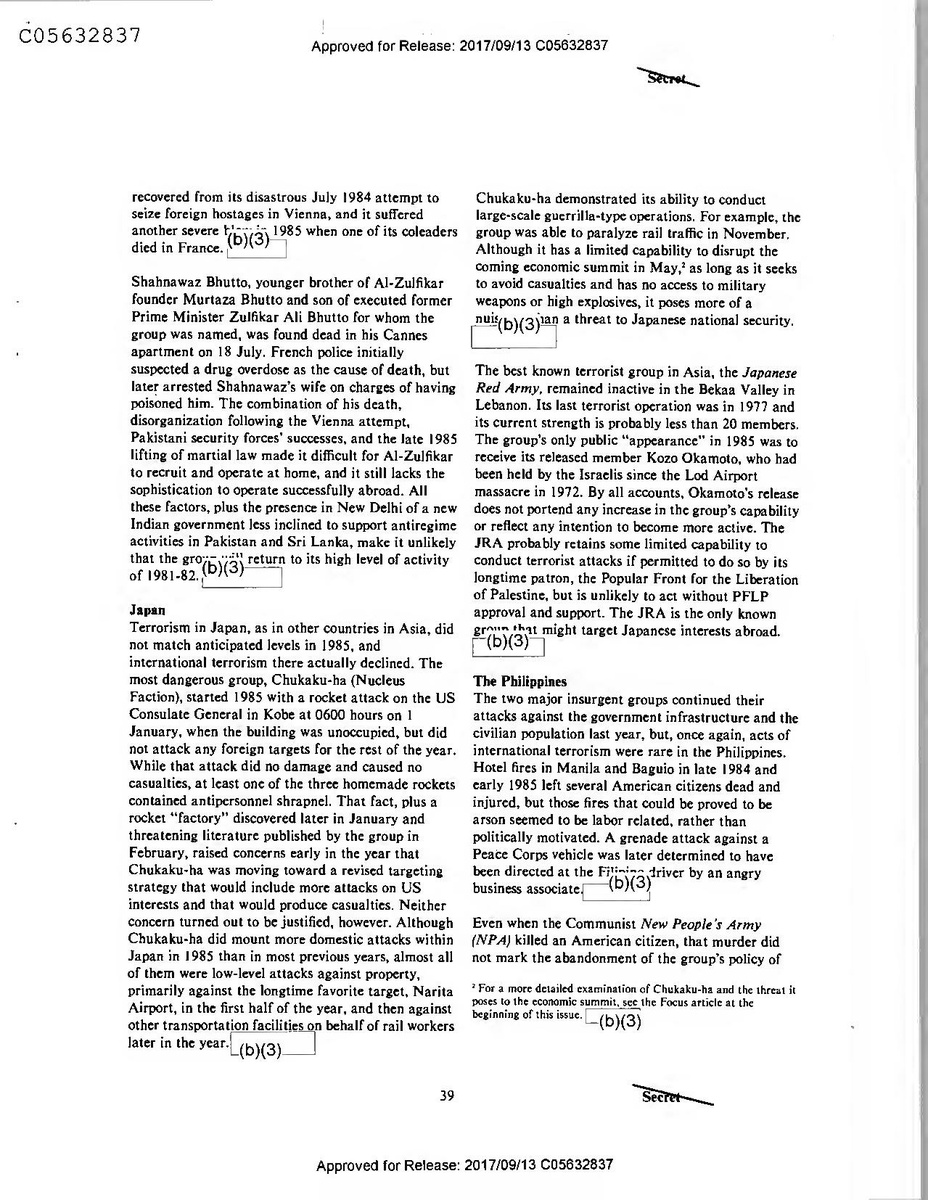
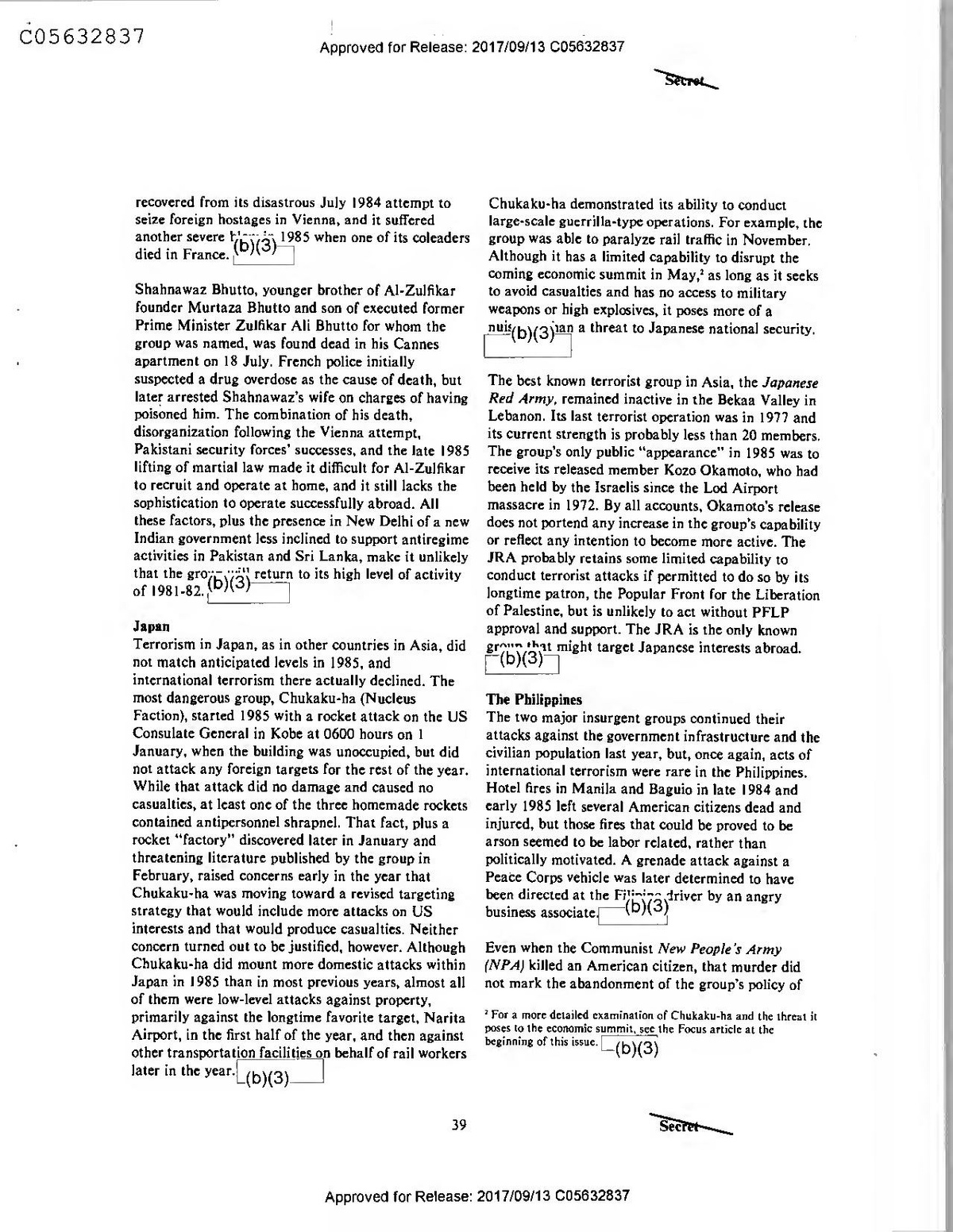
Secret
(b)(3)
recovered from its disastrous July 1984 attempt to Chukaku-ha demonstrated its ability to conduct seize foreign hostages in Vienna, and it suffered large-scale guerrilla-type operations. For example, the another severe ti 1985 when one of its coleaders group was able to paralyze rail traffic in November. died in France.
Although it has a limited capability to disrupt the
coming economic summit in May, as long as it seeks Shahnawaz Bhutto, younger brother of Al-Zulfikar to avoid casualties and has no access to military founder Murtaza Bhutto and son of executed former weapons or high explosives, it poses more of a Prime Minister Zulfikar Ali Bhutto for whom the
nuis(b)(3)ian a threat to Japanese national security. group was named, was found dead in his Cannes apartment on 18 July. French police initially suspected a drug overdose as the cause of death, but The best known terrorist group in Asia, the Japanese later arrested Shahnawaz's wife on charges of having Red Army, remained inactive in the Bekaa Valley in poisoned him. The combination of his death,
Lebanon. Its last terrorist operation was in 1977 and disorganization following the Vienna attempt,
its current strength is probably less than 20 members. Pakistani security forces' successes, and the late 1985 The group's only public “appearance" in 1985 was to lifting of martial law made it difficult for Al-Zulfikar receive its released member Kozo Okamoto, who had to recruit and operate at home, and it still lacks the been held by the Israelis since the Lod Airport sophistication to operate successfully abroad. All massacre in 1972. By all accounts, Okamoto's release these factors, plus the presence in New Delhi of a new does not portend any increase in the group's capability Indian government less inclined to support antiregime or reflect any intention to become more active. The activities in Pakistan and Sri Lanka, make it unlikely JRA probably retains some limited capability to that the groinvoll return to its high level of activity conduct terrorist attacks if permitted to do so by its
(b)(3) of 1981-82.
longtime patron, the Popular Front for the Liberation
of Palestine, but is unlikely to act without PFLP Japan
approval and support. The JRA is the only known Terrorism in Japan, as in other countries in Asia, did grunthat might target Japanese interests a broad. not match anticipated levels in 1985, and
(b)(3) international terrorism there actually declined. The most dangerous group, Chukaku-ha (Nucleus
The Philippines Faction), started 1985 with a rocket attack on the US The two major insurgent groups continued their Consulate General in Kobe at 0600 hours on 1
attacks against the government infrastructure and the January, when the building was unoccupied, but did civilian population last year, but, once again, acts of not attack any foreign targets for the rest of the year. international terrorism were rare in the Philippines. While that attack did no damage and caused no Hotel fires in Manila and Baguio in late 1984 and casualties, at lcast one of the three homemade rockets early 1985 left several American citizens dead and contained antipersonnel shrapnel. That fact, plus a injured, but those fires that could be proved to be rocket “factory" discovered later in January and arson seemed to be labor related, rather than threatening literature published by the group in politically motivated. A grenade attack against a February, raised concerns early in the year that
Peace Corps vehicle was later determined to have Chukaku-ha was moving toward a revised targeting been directed at the Filining driver by an angry strategy that would include more attacks on US business associate
(b)(3) interests and that would produce casualties. Neither concern turned out to be justified, however. Although Even when the Communist New People's Army Chuka ku-ha did mount more domestic attacks within (NPA) killed an American citizen, that murder did Japan in 1985 than in most previous years, almost all not mark the abandonment of the group's policy of of them were low-level attacks against property, primarily against the longtime favorite target, Narita
? For a more detailed examination of Chukaku-ha and the threat it
poses to the economic summit, see the Focus article at the Airport, in the first half of the year, and then against
beginning of this issue. other transportation facilities on behalf of rail workers
(b)(3)
later in the year.L(b)(3).
39
Secret
Approved for Release: 2017/09/13 C05632837
Secret
North Korea
North Korea is well known as a trainer and supplier of terrorist and insurgent groups in the 1970s and as a practitioner of international terrorism on its own behalf (the Rangoon incident of 1983), but P'yongyang apparently was not involved in terrorist incidents in 1985. Its major target has always been South Korea. During 1985 it continued efforts to recoup diplomatic ground lost in the aftermath of the Rangoon bombing and to present a more responsible image. Most of North Korea's weapons exports now go to Third World governments willing to pay for them, in contrast to its previous practice of arming insurgent groups. The arms it supplies to its primary customer, Iran, are used by Tehran's armed forces.
(b)(1) (b)(3)
Other Areas Other countries that appeared to have developing terrorist problems during 1984 likewise returned to a low level by the end of 1985. Indonesia had experienced a series of bombings and fires in late 1984 and early 1985 conducted by conservative Islamic groups upset over the government's secular policies. Indonesian authorities made a number of arrests in 1985—followed up with prosecution and stiff sentences. The level of significant incidents in the country connod off sharply for the rest of the year.
(b)(3)
Terrorist-like bombings and other political violence began in New Caledonia in late 1984 and persisted during 1985. The violence has been generated both by anti-independence French settlers and by members of the proindependence Kanak National Socialist Liberation Front. Although there have been no fatalities on the island attributable to acts of terrorism, mob violence has claimed several lives and Noumea's main courthouse was damaged by a bomb. The potential for further violence will likely be influenced by French decisions on the status of the territory. (b)(3)
restraint toward Americans. The victim was a former military officer born in the Philippines who had become a naturalized US citizen and then returned to the Philippines as a farmer. The motivation for the killing was his refusal to pay protection money, rather than his citizenship, which the guerrillas may well not have known. The NPA continued to carry out urban terrorism in provincial capitals, including the assassinations of governors and mayors and the frequent murders of ordinary citizens, but did not move their violence into Manila, even in the period leading up to the February presidential elections. The NPA is large, well equipped, and capable of attacks on US citizens or facilities at any time: hut we have no indication that it plans to do so.
On the Horizon Besides the areas already mentioned, significant terrorist incidents occurred last year in two other Asian countries that were previously free of the phenomenon. Although these attacks were apparently isolated and not indicative of new trends toward violence, they show that no country is immune from acts of terrorism. On 17 March, a bomb exploded in front of a building housing the Israeli and Canadian Embassies in Singapore. Although no group claimed credit for the abortive attack (the Israeli Embassy is on the 11th floor and the Canadian on the eighth to 10th), the involvement of a foreign terrorist group cannot be ruled out. This was the first terrorist incident in Singapore in this decade, but we have no reason to believe that any further violence is likely from either domestic groups or foreign terrorists.'
(b)(3)
The Moro National Liberation Front (MNLF) conducted only one act of international terrorism in 1985 when it kidnaped a Japanese photographer in January. The group had been holding an American and a West German since November 1984, but it released them in December 1985. The photographer was released in March 1986. The MNLF continues to conduct guerrilla warfare on the island of Mindanao, and, although it seizes foreign hostages from time to time, it is largely an insurgent group that occasionally uses terrorist tactics.
(b)(3)
Almost all acts of international terrorism in Singapore have been "imported" rather than "homegrown"; the best known terrorist group to use Singapore as ils stage was the Japanese Red Army in 1977.
(b)(3)
Secret
40
Approved for Release: 2017/09/13 C05632837
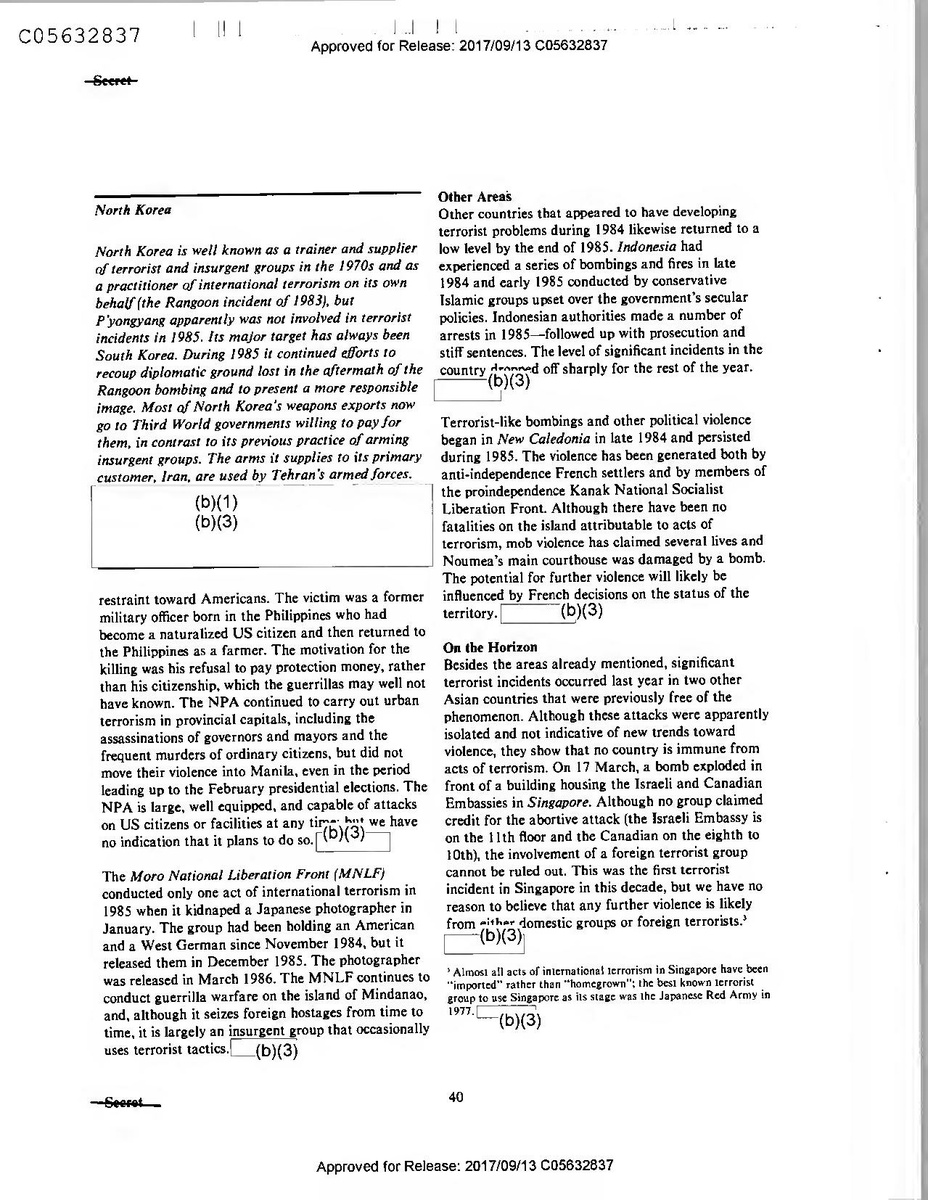
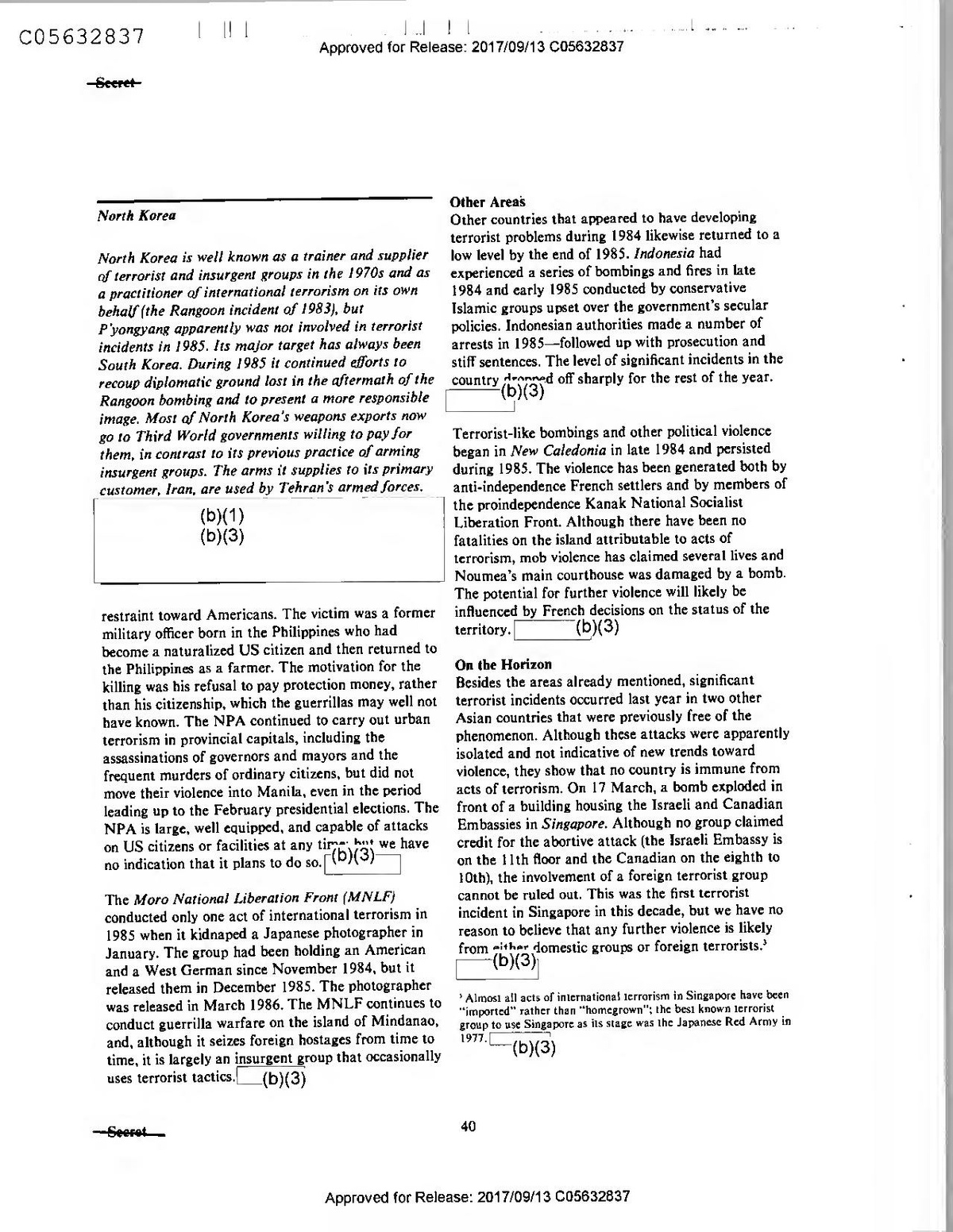
Secret
North Korea
North Korea is well known as a trainer and supplier of terrorist and insurgent groups in the 1970s and as a practitioner of international terrorism on its own behalf (the Rangoon incident of 1983), but P'yongyang apparently was not involved in terrorist incidents in 1985. Its major target has always been South Korea. During 1985 it continued efforts to recoup diplomatic ground lost in the aftermath of the Rangoon bombing and to present a more responsible image. Most of North Korea's weapons exports now go to Third World governments willing to pay for them, in contrast to its previous practice of arming insurgent groups. The arms it supplies to its primary customer, Iran, are used by Tehran's armed forces.
(b)(1) (b)(3)
Other Areas Other countries that appeared to have developing terrorist problems during 1984 likewise returned to a low level by the end of 1985. Indonesia had experienced a series of bombings and fires in late 1984 and early 1985 conducted by conservative Islamic groups upset over the government's secular policies. Indonesian authorities made a number of arrests in 1985—followed up with prosecution and stiff sentences. The level of significant incidents in the country connod off sharply for the rest of the year.
(b)(3)
Terrorist-like bombings and other political violence began in New Caledonia in late 1984 and persisted during 1985. The violence has been generated both by anti-independence French settlers and by members of the proindependence Kanak National Socialist Liberation Front. Although there have been no fatalities on the island attributable to acts of terrorism, mob violence has claimed several lives and Noumea's main courthouse was damaged by a bomb. The potential for further violence will likely be influenced by French decisions on the status of the territory. (b)(3)
restraint toward Americans. The victim was a former military officer born in the Philippines who had become a naturalized US citizen and then returned to the Philippines as a farmer. The motivation for the killing was his refusal to pay protection money, rather than his citizenship, which the guerrillas may well not have known. The NPA continued to carry out urban terrorism in provincial capitals, including the assassinations of governors and mayors and the frequent murders of ordinary citizens, but did not move their violence into Manila, even in the period leading up to the February presidential elections. The NPA is large, well equipped, and capable of attacks on US citizens or facilities at any time: hut we have no indication that it plans to do so.
On the Horizon Besides the areas already mentioned, significant terrorist incidents occurred last year in two other Asian countries that were previously free of the phenomenon. Although these attacks were apparently isolated and not indicative of new trends toward violence, they show that no country is immune from acts of terrorism. On 17 March, a bomb exploded in front of a building housing the Israeli and Canadian Embassies in Singapore. Although no group claimed credit for the abortive attack (the Israeli Embassy is on the 11th floor and the Canadian on the eighth to 10th), the involvement of a foreign terrorist group cannot be ruled out. This was the first terrorist incident in Singapore in this decade, but we have no reason to believe that any further violence is likely from either domestic groups or foreign terrorists.'
(b)(3)
The Moro National Liberation Front (MNLF) conducted only one act of international terrorism in 1985 when it kidnaped a Japanese photographer in January. The group had been holding an American and a West German since November 1984, but it released them in December 1985. The photographer was released in March 1986. The MNLF continues to conduct guerrilla warfare on the island of Mindanao, and, although it seizes foreign hostages from time to time, it is largely an insurgent group that occasionally uses terrorist tactics.
(b)(3)
Almost all acts of international terrorism in Singapore have been "imported" rather than "homegrown"; the best known terrorist group to use Singapore as ils stage was the Japanese Red Army in 1977.
(b)(3)
Secret
40
Approved for Release: 2017/09/13 C05632837
(b)(3)
Czech daily citing Izvestiya, to vilify the CIA for criminal actions and violations of human rights.
O
The Peace Corps is the target of renewed Soviet charges that it is a "hornet's nest of espionage, a center of financial and political intrigues, and a center for drug traffic." According to a 2 March 1986 TASS report, the Peace Corps' duty is to conduct subversion against (b)(3) governments not to the liking of the United States.
5.
US Responsibility for Catastrophic Events.
Whenever
possible. Moscows willperinnerate a human recagedy?f(b)(3)cate
а
story to imply US culpability in a human tragedy.
O
In 1984 TASS and Moscow New Times reported that the United States conducted a de foliation operation in Brazil that resulted in the death of "whole tribes of Indians." This repo(b)(3jubsequently appeared throughout Africa and
O
The notorious Soviet propagandist, Iona Andronov, writing in the Soviet magazine Literaturnaya Gazeta in 1984, proved "conclusively" that the CIA was responsible for a 1981 denna fever epidemic in Cuba that killed over 100 people.
(b)(3)
O
Citing a report by President Daniel Ortega, Moscow New Times in October 1985 suggested that an epidemic of dengue fever and cotton disease in Nicaragua could have been the weapons.
(b)(3)ult of US use of chemical and biological
o
Although the initial charge of US responsibility for causing the AIDS epidemic was attributed to an Indian newspaper, the real impetus for a recent worldwide antiUS AIDS campaign was an article in Literaturnaya Gazeta published in October 1985. Drawing on years-old stories of biological weapons tests, the story focused on the contemporary crisis and appeared in Kuwait Bahrain, Finland, Sweden, Peru, and elsewhere.
(b)(3)
O
TASS, on 26 December 1985, presumably citing a Japanese source, charged that the 248 US peace-keeping troops killed in a plane crash before Christmas were returning to the finited States from a secret "forward strike
base."(b)(3)
O
On 30 January 1986 TASS cited the shutt.le "Challenger" disaster as a warning of the danger of pursuing the Strategic Defense Initiative. (b)(3)
3
-(b)(3)
SESRET
Approved for Release: 2017/09/13 C05612850
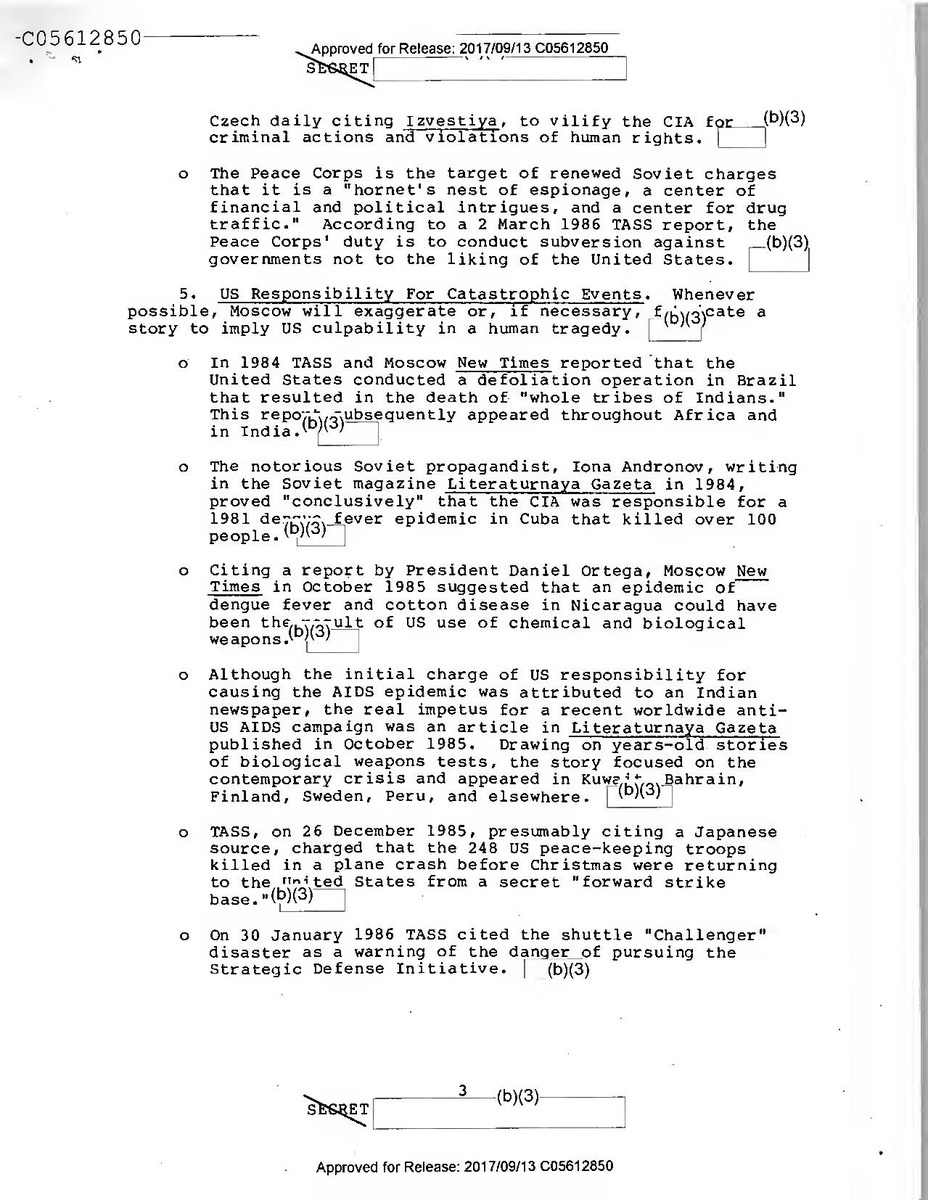
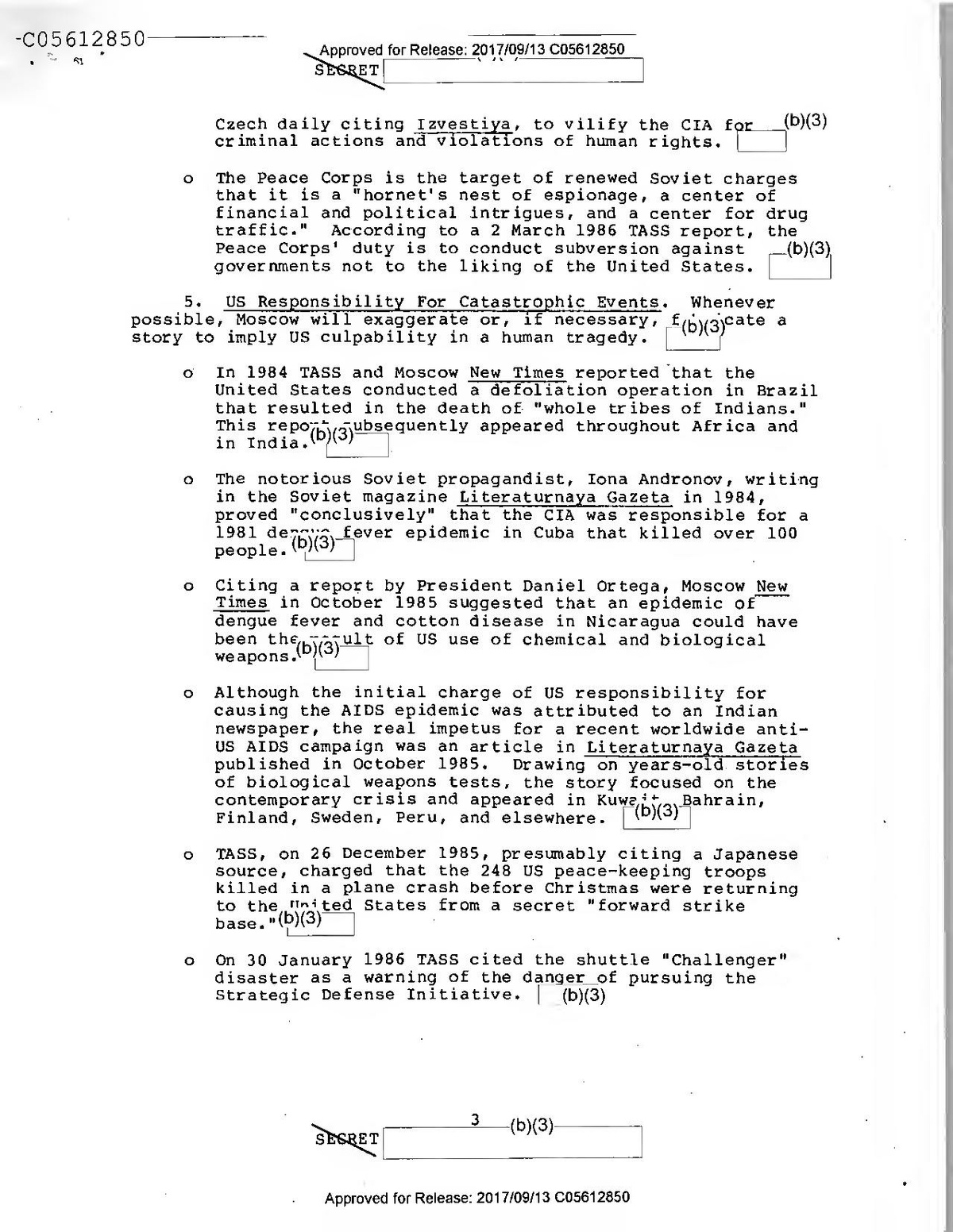
(b)(3)
Czech daily citing Izvestiya, to vilify the CIA for criminal actions and violations of human rights.
O
The Peace Corps is the target of renewed Soviet charges that it is a "hornet's nest of espionage, a center of financial and political intrigues, and a center for drug traffic." According to a 2 March 1986 TASS report, the Peace Corps' duty is to conduct subversion against (b)(3) governments not to the liking of the United States.
5.
US Responsibility for Catastrophic Events.
Whenever
possible. Moscows willperinnerate a human recagedy?f(b)(3)cate
а
story to imply US culpability in a human tragedy.
O
In 1984 TASS and Moscow New Times reported that the United States conducted a de foliation operation in Brazil that resulted in the death of "whole tribes of Indians." This repo(b)(3jubsequently appeared throughout Africa and
O
The notorious Soviet propagandist, Iona Andronov, writing in the Soviet magazine Literaturnaya Gazeta in 1984, proved "conclusively" that the CIA was responsible for a 1981 denna fever epidemic in Cuba that killed over 100 people.
(b)(3)
O
Citing a report by President Daniel Ortega, Moscow New Times in October 1985 suggested that an epidemic of dengue fever and cotton disease in Nicaragua could have been the weapons.
(b)(3)ult of US use of chemical and biological
o
Although the initial charge of US responsibility for causing the AIDS epidemic was attributed to an Indian newspaper, the real impetus for a recent worldwide antiUS AIDS campaign was an article in Literaturnaya Gazeta published in October 1985. Drawing on years-old stories of biological weapons tests, the story focused on the contemporary crisis and appeared in Kuwait Bahrain, Finland, Sweden, Peru, and elsewhere.
(b)(3)
O
TASS, on 26 December 1985, presumably citing a Japanese source, charged that the 248 US peace-keeping troops killed in a plane crash before Christmas were returning to the finited States from a secret "forward strike
base."(b)(3)
O
On 30 January 1986 TASS cited the shutt.le "Challenger" disaster as a warning of the danger of pursuing the Strategic Defense Initiative. (b)(3)
3
-(b)(3)
SESRET
Approved for Release: 2017/09/13 C05612850
Secret
On 20 and 21 June, a series of bombings in Kathmandu and other nearby towns in Nepal killed several persons and wounded a dozen others. Because one of the fatalities was an Indian citizen, we counted one of those acts as Nepal's first international incident. The attacks were apparently committed by an antimonarchist group based in India. Although Nepalese authorities evidently had no success in rounding up the culprits, no other terrorist incidents occurred during the rest of the year. [(b)(3)
(b)(3).
41
Seerat
Approved for Release: 2017/09/13 C05632837
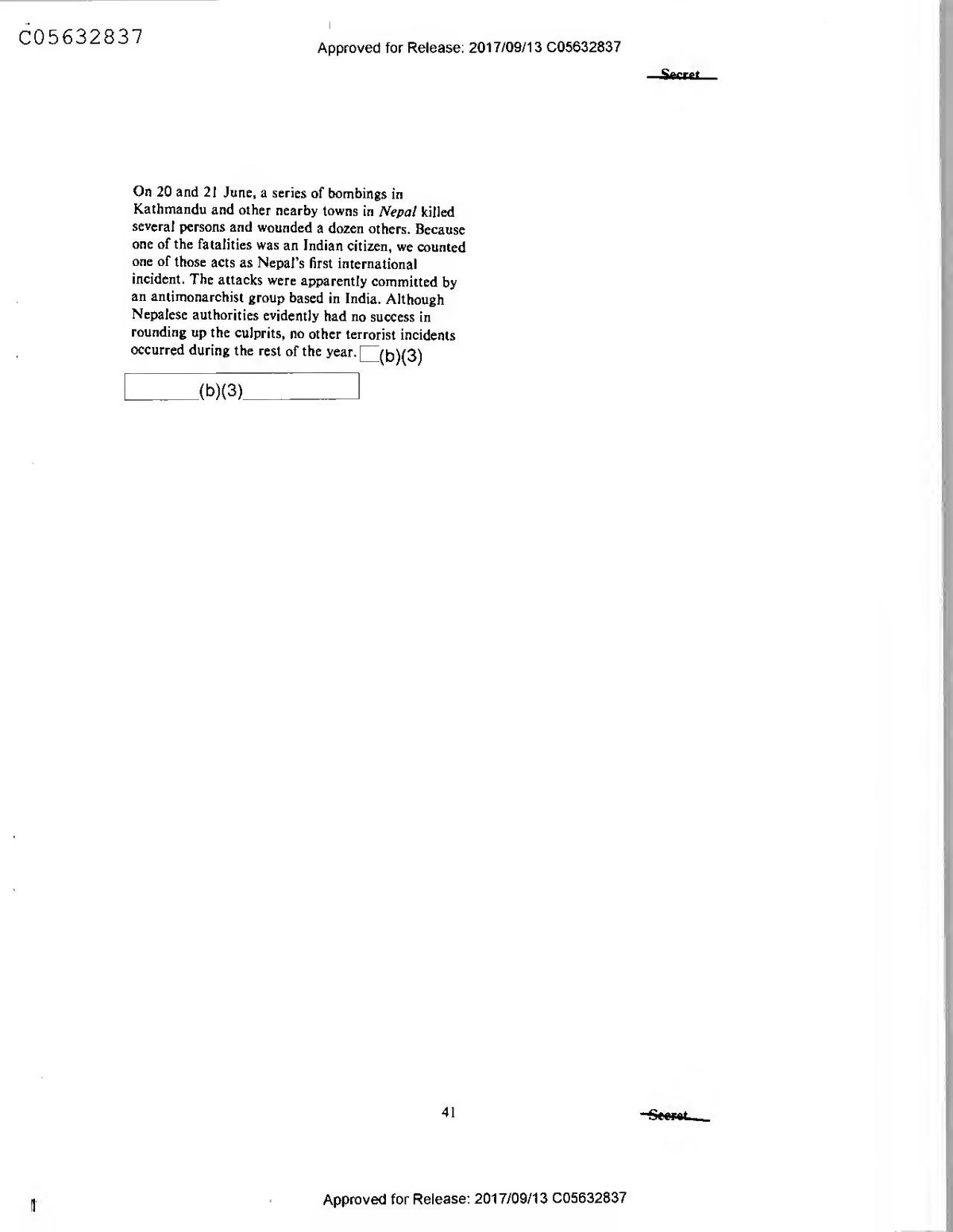
Secret
On 20 and 21 June, a series of bombings in Kathmandu and other nearby towns in Nepal killed several persons and wounded a dozen others. Because one of the fatalities was an Indian citizen, we counted one of those acts as Nepal's first international incident. The attacks were apparently committed by an antimonarchist group based in India. Although Nepalese authorities evidently had no success in rounding up the culprits, no other terrorist incidents occurred during the rest of the year. [(b)(3)
(b)(3).
41
Seerat
Approved for Release: 2017/09/13 C05632837
Approved for Release: 2017/09/13 C05632837
1
Approved for Release: 2017/09/13 C05632837
1
Secret
(b)(3)
The Terrorism Diary for May
Below a compendium of May dates of known or conceivable significance to terrorists around the world. Our inclusion of a date or event should not by itself be consimo suggest that we expect or anticipate a commemorative terrorist event.
f(b)(3)
1 May
Jewish world. Last day of Passover.
1 May 1888
Socialist world. May Day (commemorates labor violence in Chicago).
1 May
El Salvador. The first week of May contains several dates of import to leftwing and rightwing elements; consequently, political violence tends to peak during this period.
1 May 1980
Peru. The destruction of electoral material in Chuschi, Cangallo Province, marked the beginning of armed struggle by Sendero Luminoso; this anniversary is commemorated by acts of violence throughout the month.
2 May 1953
Jordan. King Hussein assumes constitutional power.
2 May 1982
Argentina, United Kingdom. Argentine cruiser Belgrano sunk by British submarine in Falklands war.
4 May 1919
China. Student groups form Anti-Japanese Movement.
4 May 1978
Namibia. Kasinga Day (commemorates raid by South African forces that left hundreds dead).
4 May 1986
Greek Orthodox world. Easter Sunday.
4 May 1986
Japan. Tokyo Economic Summit opens (closes 6 May).
5 May 1862
Mexico. Cinco de Mayo (commemorates victory over forces of Napoleon III).
5 May 1941
Ethiopia. Liberation Day.
5 May 1945
Netherlands. Liberation Day.
5 May 1954
Paraguay. Coup against elected government of President Federico Chavez by Gen. Alfredo Stroessner Mattiauda brought current regime to power.
5 May 1955
West Germany. West Germany becomes member of NATO.
(b)(3)
43
Secret
DI TR 86-005 April 1986
Approved for Release: 2017/09/13 C05632837
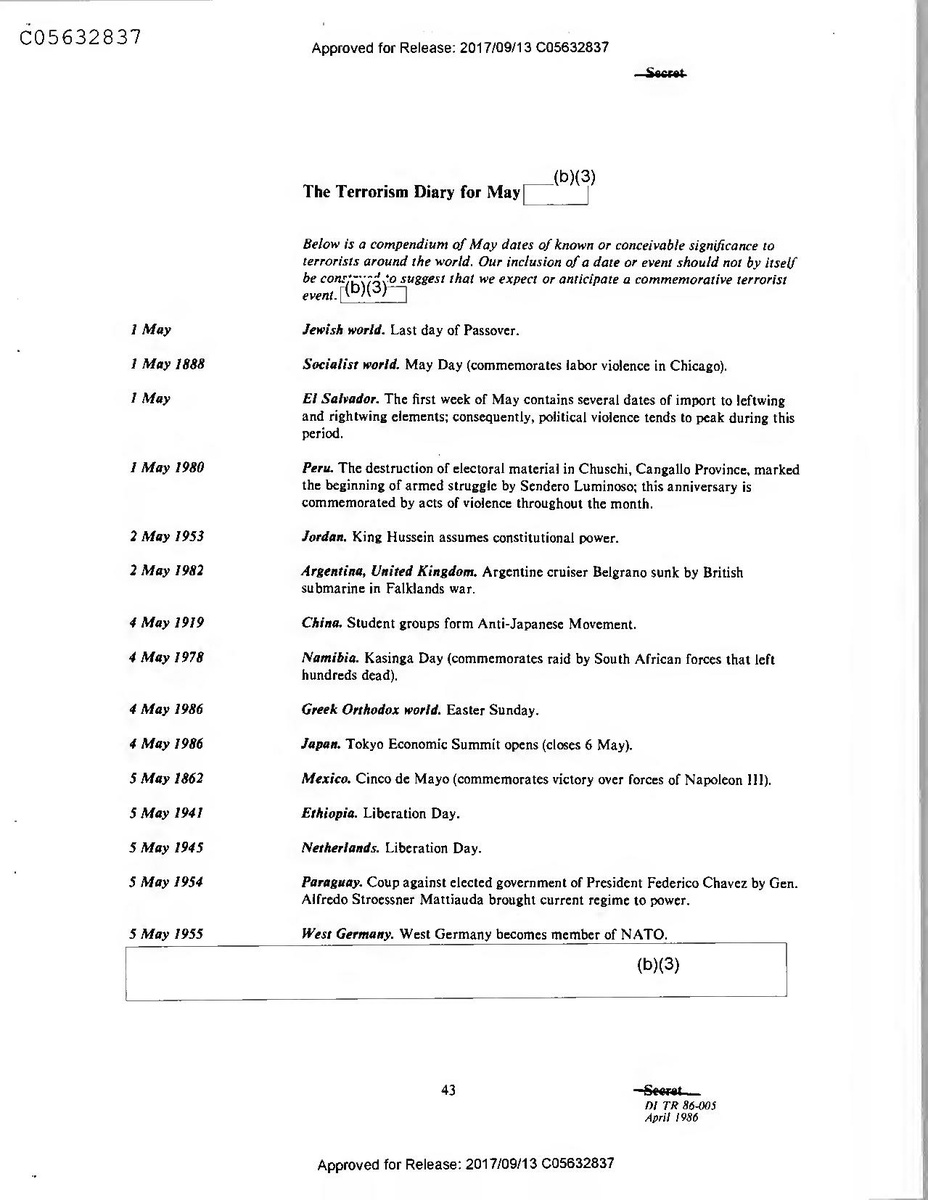
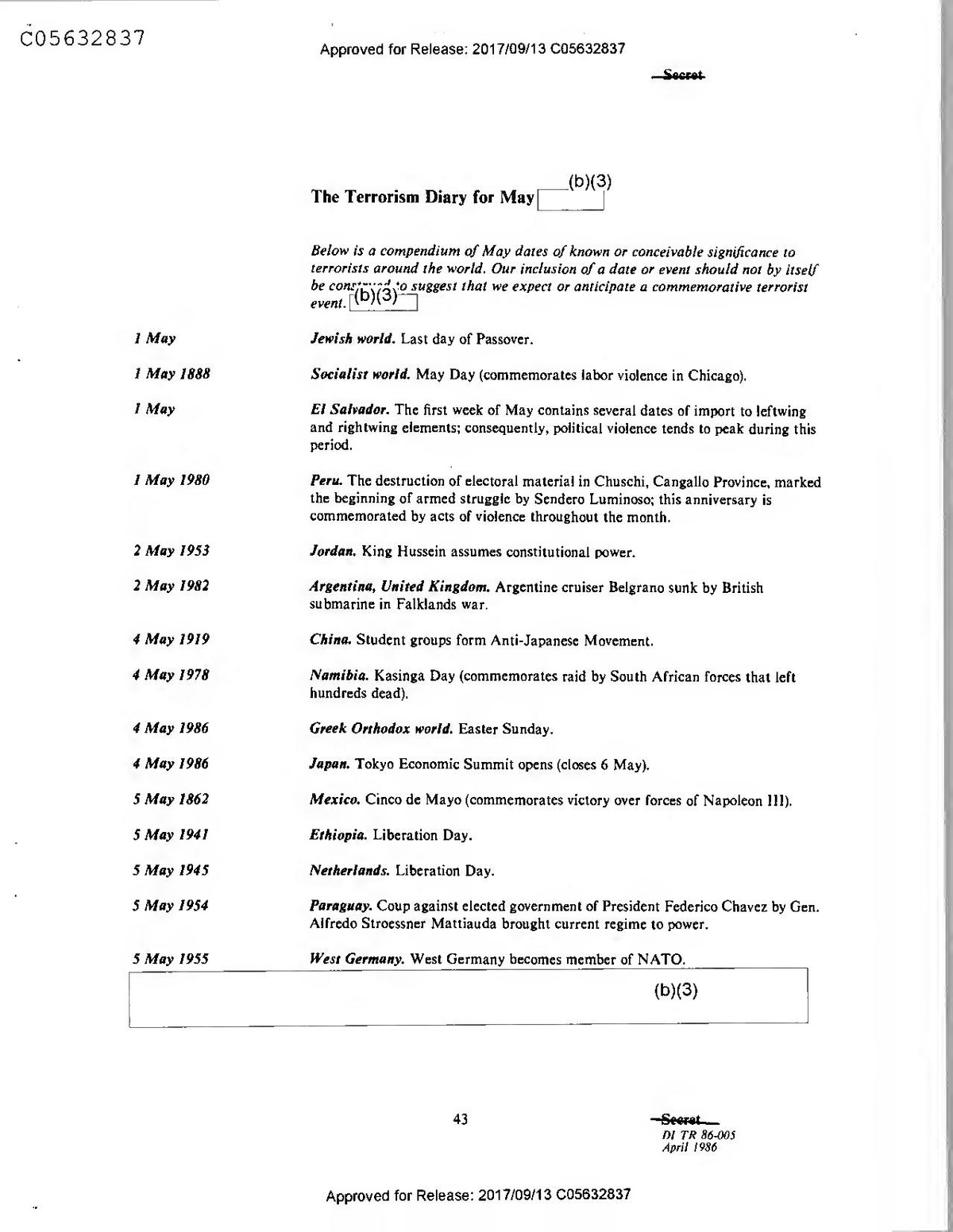
Secret
(b)(3)
The Terrorism Diary for May
Below a compendium of May dates of known or conceivable significance to terrorists around the world. Our inclusion of a date or event should not by itself be consimo suggest that we expect or anticipate a commemorative terrorist event.
f(b)(3)
1 May
Jewish world. Last day of Passover.
1 May 1888
Socialist world. May Day (commemorates labor violence in Chicago).
1 May
El Salvador. The first week of May contains several dates of import to leftwing and rightwing elements; consequently, political violence tends to peak during this period.
1 May 1980
Peru. The destruction of electoral material in Chuschi, Cangallo Province, marked the beginning of armed struggle by Sendero Luminoso; this anniversary is commemorated by acts of violence throughout the month.
2 May 1953
Jordan. King Hussein assumes constitutional power.
2 May 1982
Argentina, United Kingdom. Argentine cruiser Belgrano sunk by British submarine in Falklands war.
4 May 1919
China. Student groups form Anti-Japanese Movement.
4 May 1978
Namibia. Kasinga Day (commemorates raid by South African forces that left hundreds dead).
4 May 1986
Greek Orthodox world. Easter Sunday.
4 May 1986
Japan. Tokyo Economic Summit opens (closes 6 May).
5 May 1862
Mexico. Cinco de Mayo (commemorates victory over forces of Napoleon III).
5 May 1941
Ethiopia. Liberation Day.
5 May 1945
Netherlands. Liberation Day.
5 May 1954
Paraguay. Coup against elected government of President Federico Chavez by Gen. Alfredo Stroessner Mattiauda brought current regime to power.
5 May 1955
West Germany. West Germany becomes member of NATO.
(b)(3)
43
Secret
DI TR 86-005 April 1986
Approved for Release: 2017/09/13 C05632837
Secret
6 May 1900
Iran. Birthday of Ayatollah Ruhollah Khomeini.
8 May 1945
Czechoslovakia. Liberation Day.
8 May 1945
East Germany. Liberation Day.
8 May 1945
West Germany. Capitulation of the Third Reich.
8 May 1979
El Salvador. Police fired into a crowd on the steps of San Salvador cathedral demonstrating solidarity with leftwing activists who had occupied the French and Costa Rican Embassies; at least 25 demonstrators were killed.
8 May 1984
Libya. Armed dissidents attack President Mu'ammar Qadhafi's Azizziya barracks.
9 May
Muslim world. Ramadan (month of fasting) begins.
9 May 1881
Romania. Independence Day.
9 May 1945
Albania. Victory Day.
9 May 1945
Poland. Victory Day.
9 May 1945
Soviet Union. Victory Day.
9 May 1945
Yugoslavia. Victory Day.
9 May 1976
West Germany. Suicide in prison of Ulrike Meinhof, founding member of Red Army Faction (RAF).
10 May
Jordan. Arab Resistance Day.
10 May 1985
India. Night of Sikh bombings leaves 80 dead, 200 wounded in New Delhi, other cities.
11 May 1983
Chile. Anti-Pinochet demonstrations put down forcefully by government.
11 May 1984
Chile. Wave of bombings against government targets.
13 May 1981
Vatican City. Attempt on the life of Pope John PaUL II by Mehmet Ali Agca.
14 May 1811
Paraguay. Independence Day.
14 May 1948
Israel. Republic Day (declaration of independence).
14 May 1948
Middle East. Beginning of the first Arab-Israeli war.
44
- Secret
Approved for Release: 2017/09/13 C05632837
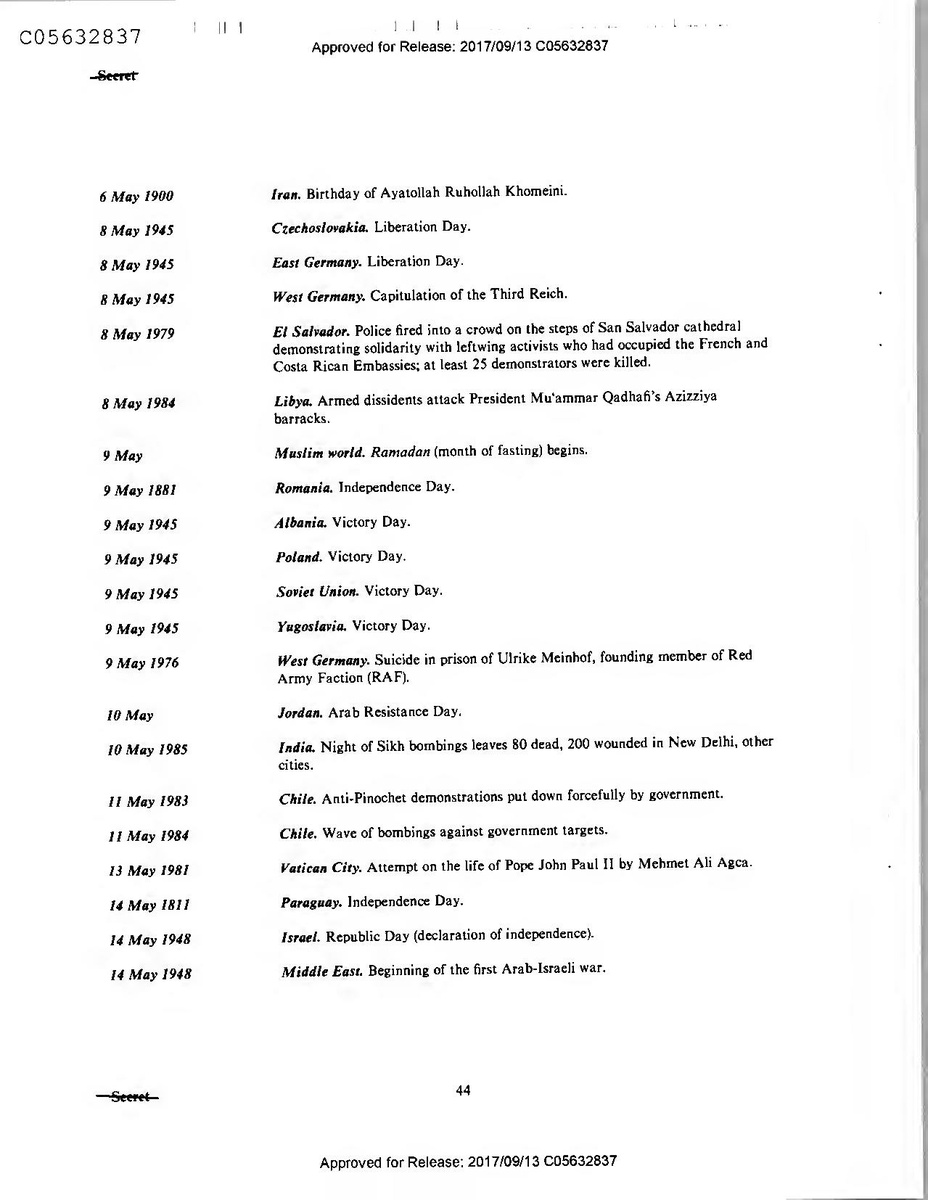
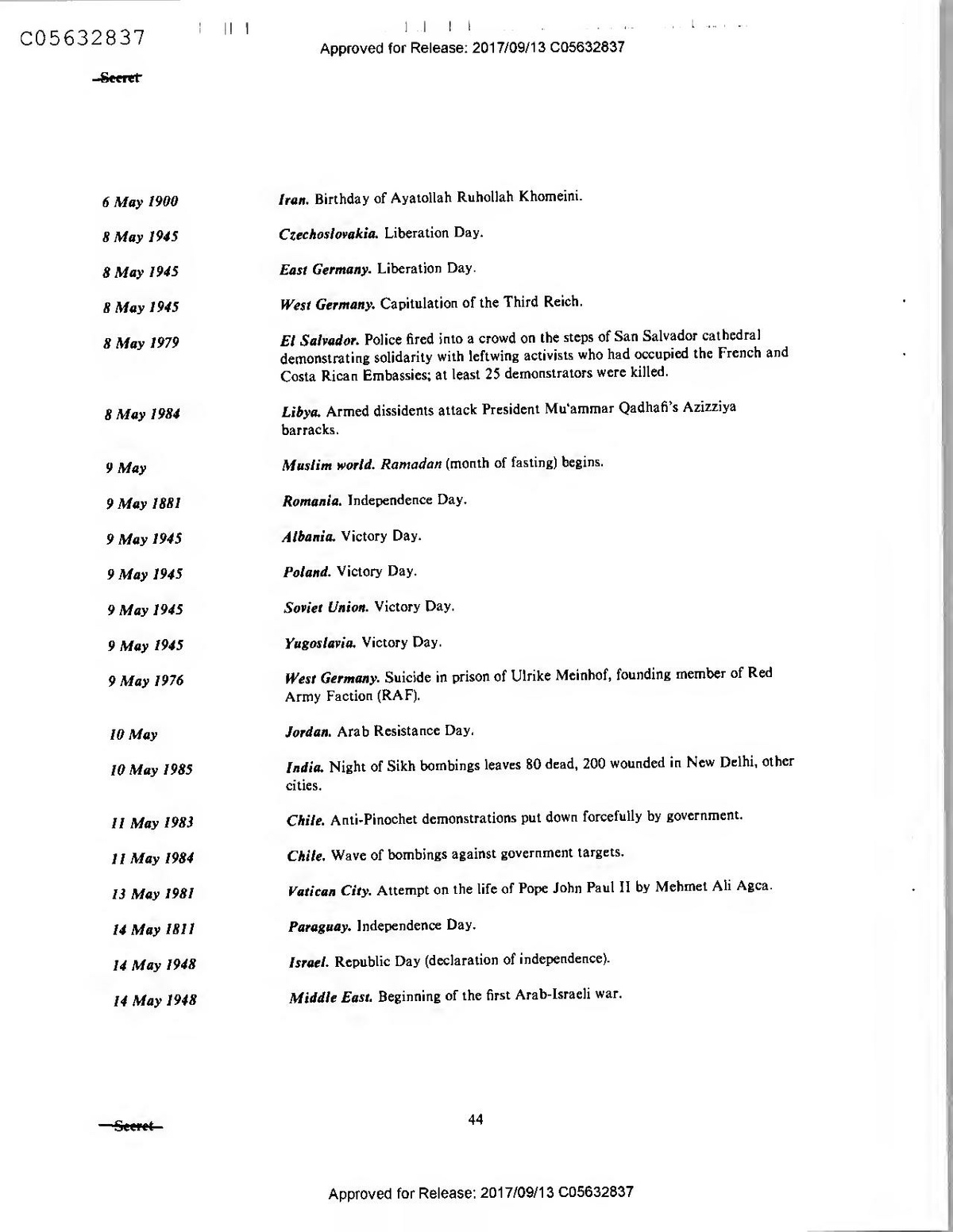
Secret
6 May 1900
Iran. Birthday of Ayatollah Ruhollah Khomeini.
8 May 1945
Czechoslovakia. Liberation Day.
8 May 1945
East Germany. Liberation Day.
8 May 1945
West Germany. Capitulation of the Third Reich.
8 May 1979
El Salvador. Police fired into a crowd on the steps of San Salvador cathedral demonstrating solidarity with leftwing activists who had occupied the French and Costa Rican Embassies; at least 25 demonstrators were killed.
8 May 1984
Libya. Armed dissidents attack President Mu'ammar Qadhafi's Azizziya barracks.
9 May
Muslim world. Ramadan (month of fasting) begins.
9 May 1881
Romania. Independence Day.
9 May 1945
Albania. Victory Day.
9 May 1945
Poland. Victory Day.
9 May 1945
Soviet Union. Victory Day.
9 May 1945
Yugoslavia. Victory Day.
9 May 1976
West Germany. Suicide in prison of Ulrike Meinhof, founding member of Red Army Faction (RAF).
10 May
Jordan. Arab Resistance Day.
10 May 1985
India. Night of Sikh bombings leaves 80 dead, 200 wounded in New Delhi, other cities.
11 May 1983
Chile. Anti-Pinochet demonstrations put down forcefully by government.
11 May 1984
Chile. Wave of bombings against government targets.
13 May 1981
Vatican City. Attempt on the life of Pope John PaUL II by Mehmet Ali Agca.
14 May 1811
Paraguay. Independence Day.
14 May 1948
Israel. Republic Day (declaration of independence).
14 May 1948
Middle East. Beginning of the first Arab-Israeli war.
44
- Secret
Approved for Release: 2017/09/13 C05632837
Secret
14 May 1985
Sri Lanka. Tamil separatists kill more than 150 in a machinegun attack on a Buddhist shrine at Anuradhapura.
15 May 1948
Palestinians. Palestine Day (end of UN mandate); the 15 May Organization, founded in 1979 by a remnant of the Special Operations Group of the Popular Front for the Liberation of Palestine (PFLP), takes its name from this event.
16 May 1983
Sudan. Founding of the Sudanese People's Liberation Army (SPLA) and Liberation Movement (SPLM).
16 May 1985
Peru. The Maoist group Sendero Luminoso (Shining Path) marks its fifth anniversary with a wave of bombings, including attacks on the US Ambassador's residence and the Chinese Embassy.
17 May 1814
Norway. Constitution Day (independence day).
17 May 198
Lebanon, Israel. Signing of the troop withdrawal accord (known as the 17 May agreement).
18 May 1980
South Korea. Civilian uprising staged in Kwangju against military rule; this anniversary is usually marked by student demonstrations.
18 May 1980
Peru. Beginning of Sendero Luminoso's armed struggle.
(b)(3)
19 May 1890
Vietnam. Ho Chi Minh's birthday.
19 May 1895
Cuba. Death of nationalist hero Jose Marti.
20 May 1927
Saudi Arabia. Independence Day.
20 May 1972
Cameroon. National Day (declaration of the republic).
20 May 1973
Western Sahara. Polisario begins armed struggle.
20 May 1978
Japan. Opening of New Tokyo International Airport (Narita); this anniversary is the focus of demonstrations and terrorist attacks.
22 May 1972
Sri Lanka. Republic Day.
23 May 1949
West Germany. Proclamation of the Federal Republic.
23 May 1951
China. Tibet declared to be under Chinese sovereignty.
24 May
Buddhist world. Birthday of Gautama Buddha.
25 May 1810
Argentina. Beginning of the revolution against Spain.
45
Secret
Approved for Release: 2017/09/13 C05632837
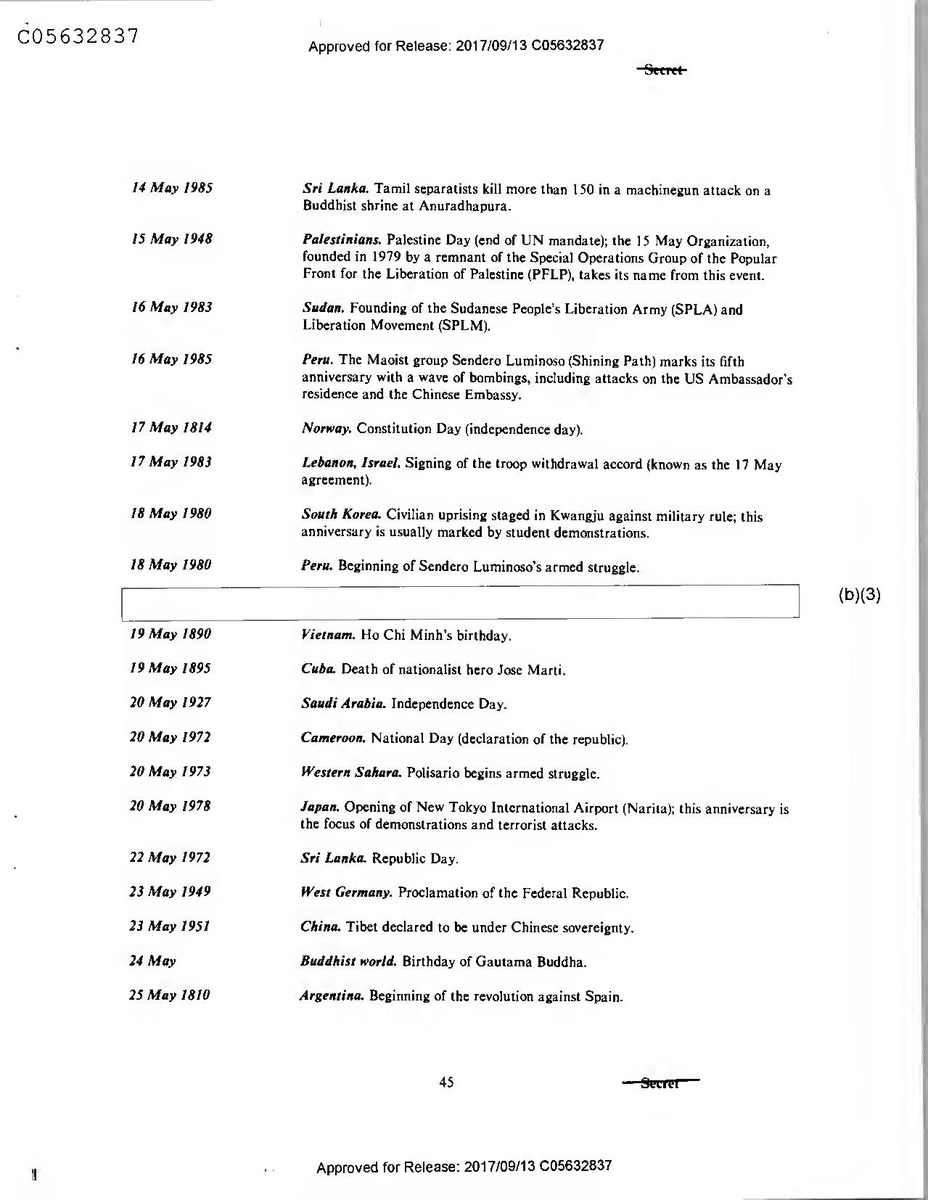
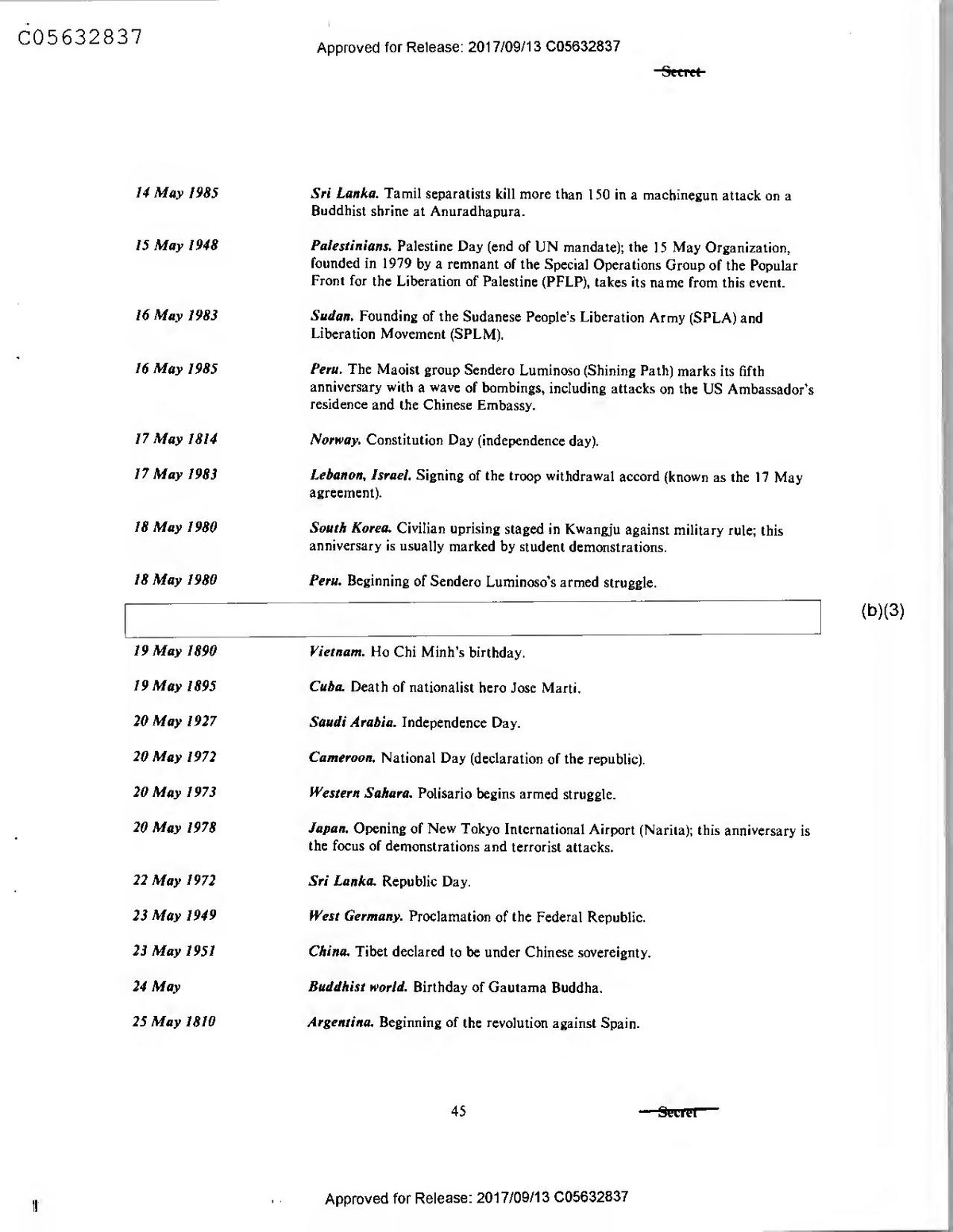
Secret
14 May 1985
Sri Lanka. Tamil separatists kill more than 150 in a machinegun attack on a Buddhist shrine at Anuradhapura.
15 May 1948
Palestinians. Palestine Day (end of UN mandate); the 15 May Organization, founded in 1979 by a remnant of the Special Operations Group of the Popular Front for the Liberation of Palestine (PFLP), takes its name from this event.
16 May 1983
Sudan. Founding of the Sudanese People's Liberation Army (SPLA) and Liberation Movement (SPLM).
16 May 1985
Peru. The Maoist group Sendero Luminoso (Shining Path) marks its fifth anniversary with a wave of bombings, including attacks on the US Ambassador's residence and the Chinese Embassy.
17 May 1814
Norway. Constitution Day (independence day).
17 May 198
Lebanon, Israel. Signing of the troop withdrawal accord (known as the 17 May agreement).
18 May 1980
South Korea. Civilian uprising staged in Kwangju against military rule; this anniversary is usually marked by student demonstrations.
18 May 1980
Peru. Beginning of Sendero Luminoso's armed struggle.
(b)(3)
19 May 1890
Vietnam. Ho Chi Minh's birthday.
19 May 1895
Cuba. Death of nationalist hero Jose Marti.
20 May 1927
Saudi Arabia. Independence Day.
20 May 1972
Cameroon. National Day (declaration of the republic).
20 May 1973
Western Sahara. Polisario begins armed struggle.
20 May 1978
Japan. Opening of New Tokyo International Airport (Narita); this anniversary is the focus of demonstrations and terrorist attacks.
22 May 1972
Sri Lanka. Republic Day.
23 May 1949
West Germany. Proclamation of the Federal Republic.
23 May 1951
China. Tibet declared to be under Chinese sovereignty.
24 May
Buddhist world. Birthday of Gautama Buddha.
25 May 1810
Argentina. Beginning of the revolution against Spain.
45
Secret
Approved for Release: 2017/09/13 C05632837
Secret
1892-05-25 Yugoslavia. Birthday of Josip Broz Tito.
1923-05-23 Jordan. Independence Day.
1946-05-25 Jordan. Constitutional monarchy established.
1963-05-25 Africa. African Freedom Day; Day of Africa (founding of the Organization of African Unity).
1965-05-25 Colombia. Founding of the Communist Party of Colombia/Marxist-Leninist (PCC/ML), the now-defunct parent organization of the People's Liberation Army (EPL) terrorist group.
1967-05-25 Bermuda. Bermuda Day (constitution adopted).
1986-05-25 Colombia. Presidential election scheduled.
1966-05-26 Guyana. Independence Day.
1983-05-28 France, French Caribbean. Caribbean Revolutionary Alliance (ARC) surfaces with 17 coordinated bombings.
1919-05-30 Afghanistan. Independence from Great Britain.
1961-05-30 Dominican Republic. Liberty Day (assassination of Gen. Raphael Trujillo).
1967-05-30 Nigeria. Declaration of independence by Biafra.
1972-05-30 Israel. Massacre at Lod Airport by members of the Japanese Red Army.
1981-05-30 Bangladesh. Assassination of Ziaur Rahman.
1910-05-31 South Africa. Union Day (four provinces merged to form Union of South Africa).
31 May 1961-05-31 South Africa. Proclamation of the republic.
(b)(3)
46
Secret
Approved for Release: 2017/09/13 C05632837...
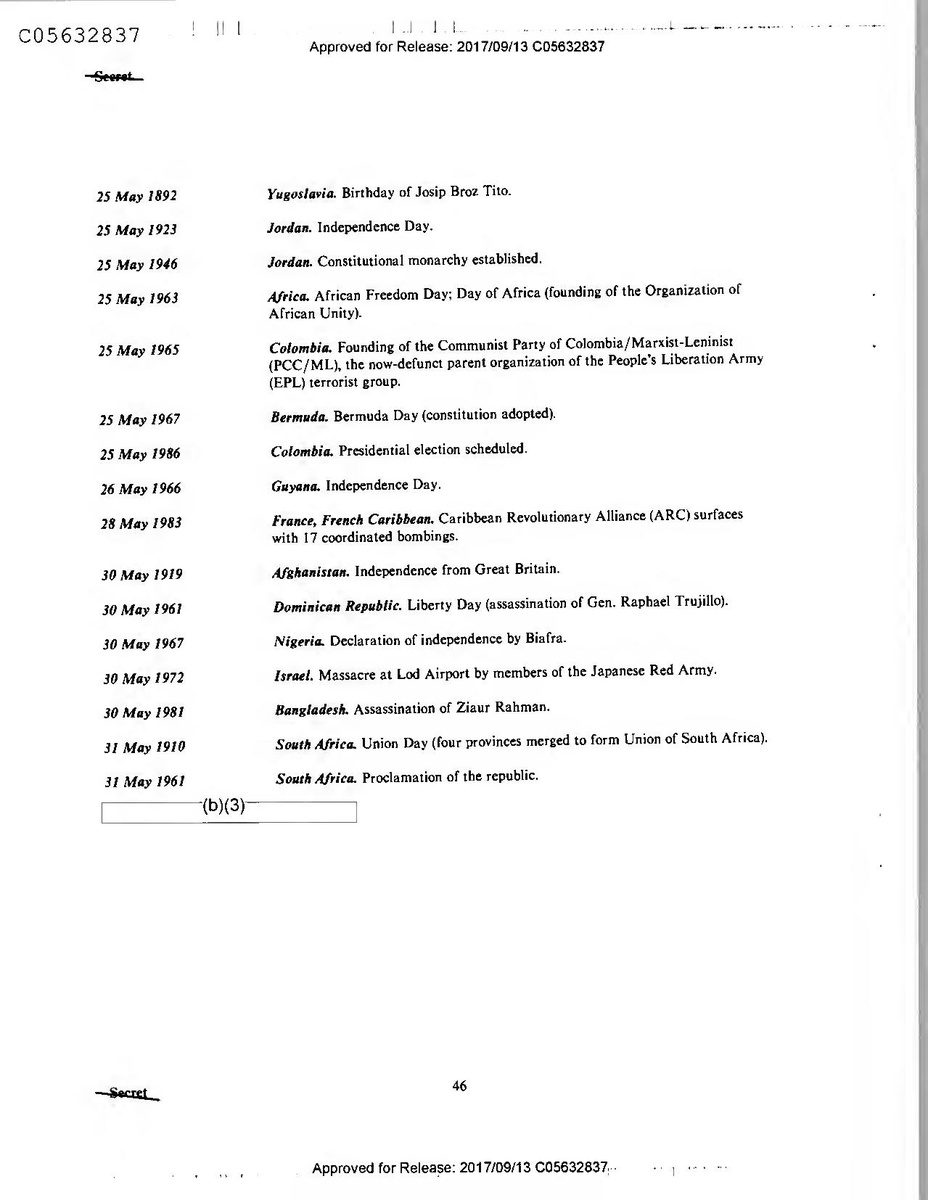
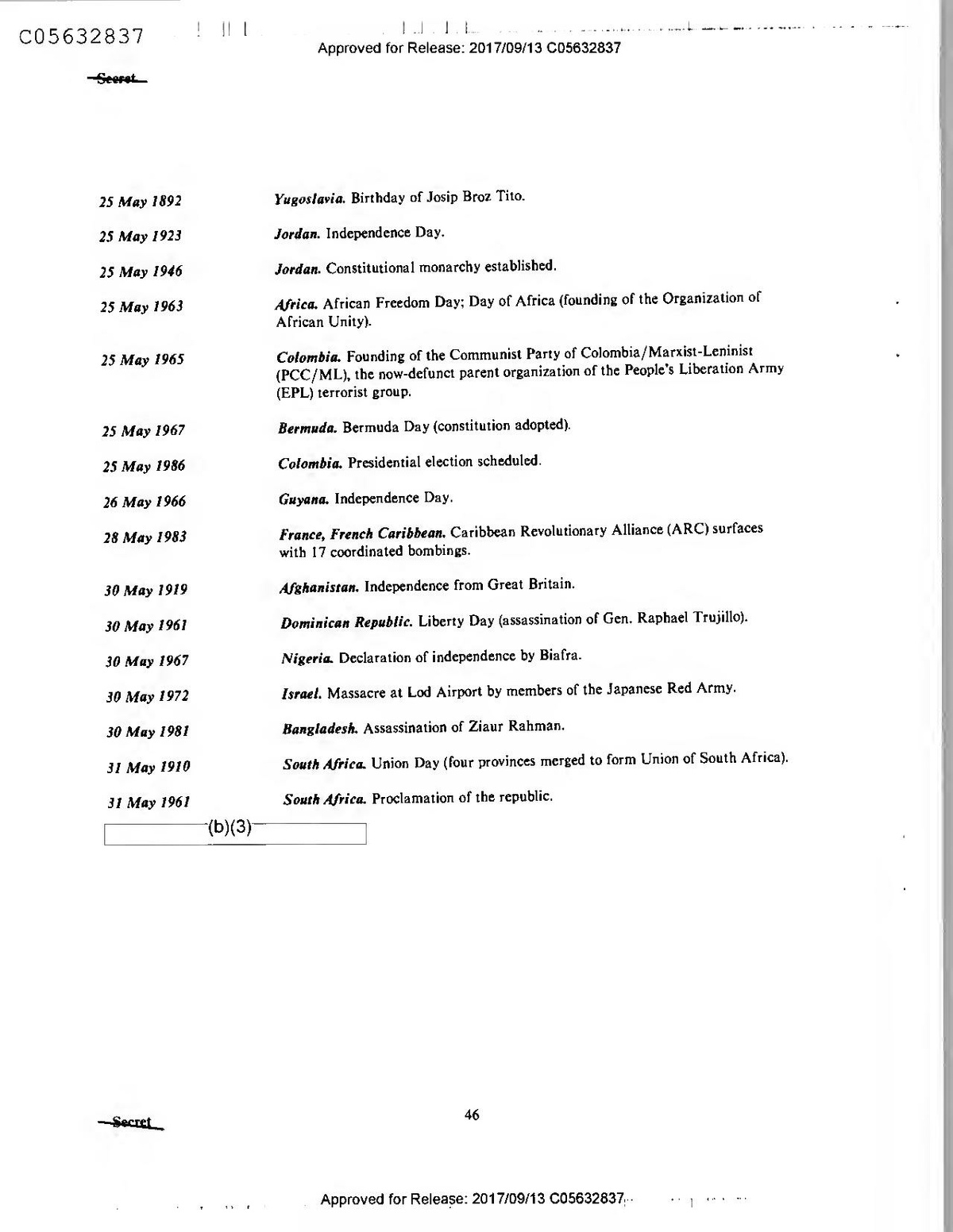
Secret
1892-05-25 Yugoslavia. Birthday of Josip Broz Tito.
1923-05-23 Jordan. Independence Day.
1946-05-25 Jordan. Constitutional monarchy established.
1963-05-25 Africa. African Freedom Day; Day of Africa (founding of the Organization of African Unity).
1965-05-25 Colombia. Founding of the Communist Party of Colombia/Marxist-Leninist (PCC/ML), the now-defunct parent organization of the People's Liberation Army (EPL) terrorist group.
1967-05-25 Bermuda. Bermuda Day (constitution adopted).
1986-05-25 Colombia. Presidential election scheduled.
1966-05-26 Guyana. Independence Day.
1983-05-28 France, French Caribbean. Caribbean Revolutionary Alliance (ARC) surfaces with 17 coordinated bombings.
1919-05-30 Afghanistan. Independence from Great Britain.
1961-05-30 Dominican Republic. Liberty Day (assassination of Gen. Raphael Trujillo).
1967-05-30 Nigeria. Declaration of independence by Biafra.
1972-05-30 Israel. Massacre at Lod Airport by members of the Japanese Red Army.
1981-05-30 Bangladesh. Assassination of Ziaur Rahman.
1910-05-31 South Africa. Union Day (four provinces merged to form Union of South Africa).
31 May 1961-05-31 South Africa. Proclamation of the republic.
(b)(3)
46
Secret
Approved for Release: 2017/09/13 C05632837...
Seeret
(b)(3)
Chronology of Terrorism–1985 and 1986|
terror
Below are described noteworthy foreign and international events involving
or the use of terrorist tactics, which have occurred or come to light since our last issue. In some cases, the perpetrators and their motivations may not be known. Events and developments that have already been described elsewhere in this publication are not included. (b)(3)
18 December 1985
New Caledonia: Bomb destroys vehicle of European member of Kanak Independence Movement. The explosion occurred near the building housing the Australian Consulate General, and the building was aun conted. There was no damage and no one has claimed responsibility. [
(b)(3)
January 1986
Sweden: Authorities arrest PLO member employed by PLO office in Stockholm. He reportedly was suspected of planning unspecified te
te (b)(3)acts
in Sweden, and the prosecutor recommended that he be expelled.
1 January
South Africa: Mutilated bodies of two policemen found near Moutse. They had been investigating an arson case that followed clashes between supporters and
(b)(3) opponents of the district's incorporation into the Kwandebelc homeland.
3 January
Iraq: UnsuccessfUL assassination attempt against President Saddam Husayn in Baghdad. An explosive-laden truck was discovered parked alomiti route of Husayn's motorcade, and his itinerary was changed.
"(b)(1) (b)(3)
15 January
Italy: Several gunmen wound director of Arab-language radio station in Rome. The victim stated that he had received several threats because of his support for Libyan arin kajian dissidents. He believes the Libyan Government was behind the
F(b)(3) attack
17 January
Angola: Car bomb explodes outside Invernosol Building in Luanda, damaging several Cuban offices. The Na/b)(3)Jnion for the Total Independence of Angola has claimed responsibility. |
India: Police defuse parcel bomb left in New Delhi house. The 4.5-kg bomb was
fitted with a timer and remote control detonator. Police suspect Sikh extremists. (b)(3)
47
Secret DI TR 86-005 April 1986
Approved for Release: 2017/09/13 C05632837
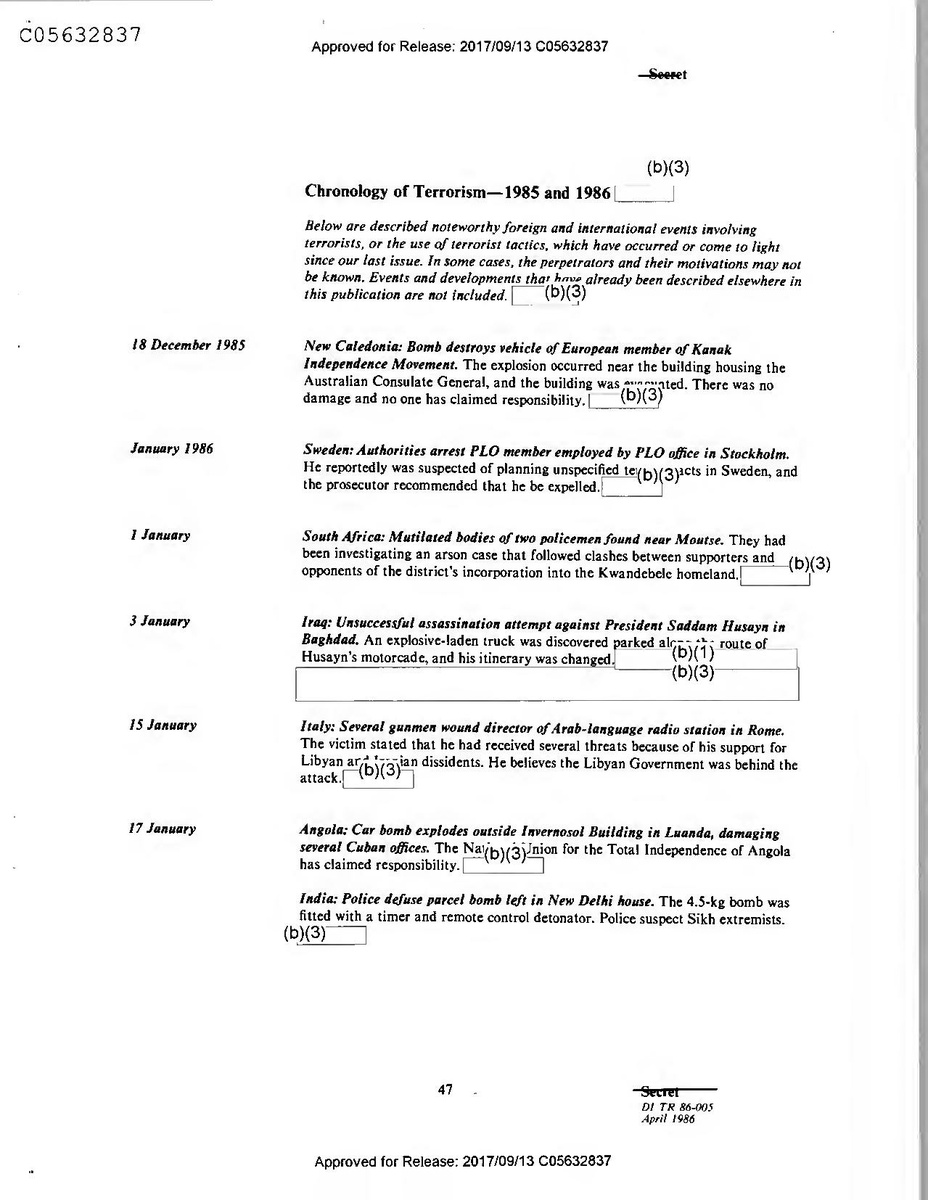
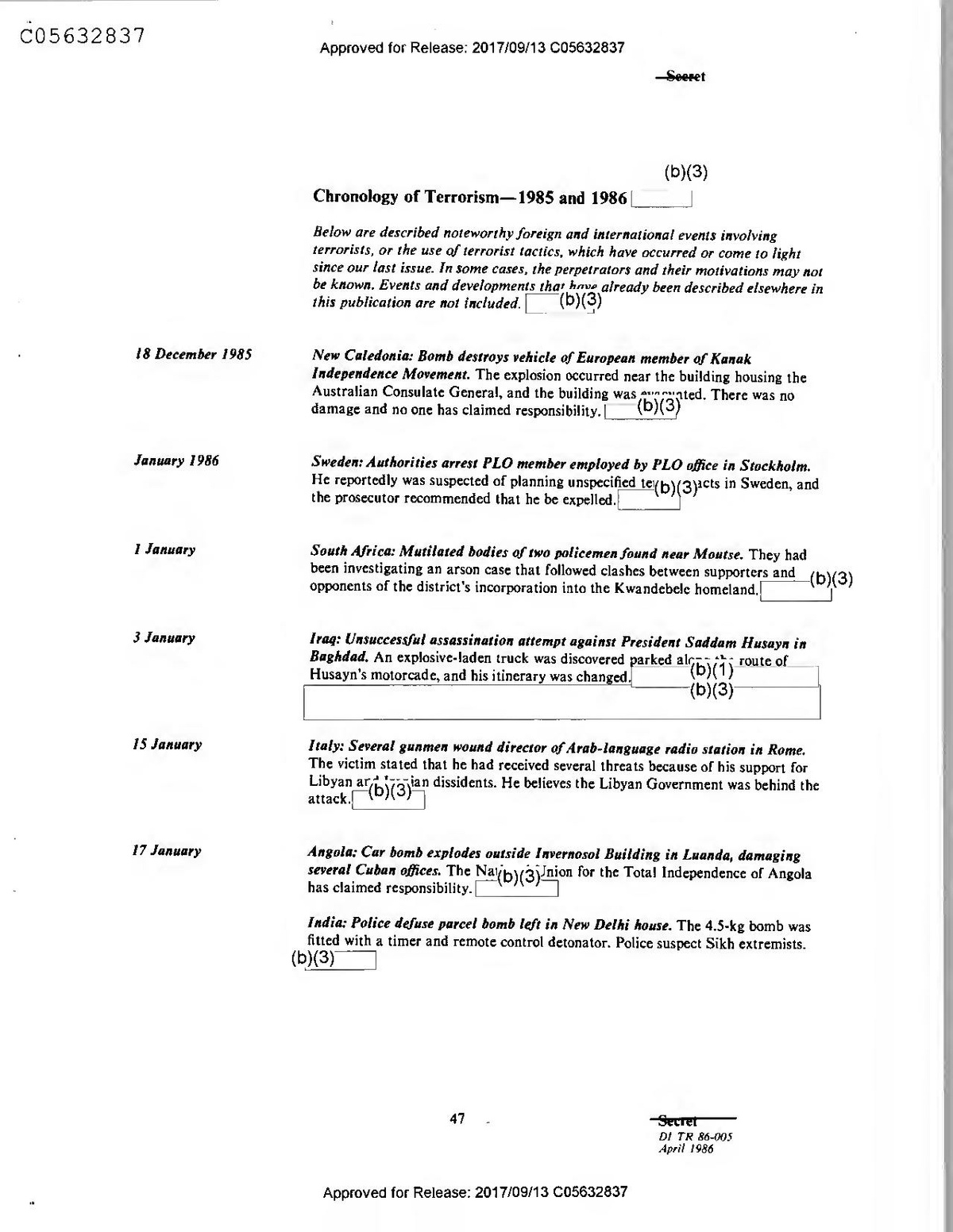
Seeret
(b)(3)
Chronology of Terrorism–1985 and 1986|
terror
Below are described noteworthy foreign and international events involving
or the use of terrorist tactics, which have occurred or come to light since our last issue. In some cases, the perpetrators and their motivations may not be known. Events and developments that have already been described elsewhere in this publication are not included. (b)(3)
18 December 1985
New Caledonia: Bomb destroys vehicle of European member of Kanak Independence Movement. The explosion occurred near the building housing the Australian Consulate General, and the building was aun conted. There was no damage and no one has claimed responsibility. [
(b)(3)
January 1986
Sweden: Authorities arrest PLO member employed by PLO office in Stockholm. He reportedly was suspected of planning unspecified te
te (b)(3)acts
in Sweden, and the prosecutor recommended that he be expelled.
1 January
South Africa: Mutilated bodies of two policemen found near Moutse. They had been investigating an arson case that followed clashes between supporters and
(b)(3) opponents of the district's incorporation into the Kwandebelc homeland.
3 January
Iraq: UnsuccessfUL assassination attempt against President Saddam Husayn in Baghdad. An explosive-laden truck was discovered parked alomiti route of Husayn's motorcade, and his itinerary was changed.
"(b)(1) (b)(3)
15 January
Italy: Several gunmen wound director of Arab-language radio station in Rome. The victim stated that he had received several threats because of his support for Libyan arin kajian dissidents. He believes the Libyan Government was behind the
F(b)(3) attack
17 January
Angola: Car bomb explodes outside Invernosol Building in Luanda, damaging several Cuban offices. The Na/b)(3)Jnion for the Total Independence of Angola has claimed responsibility. |
India: Police defuse parcel bomb left in New Delhi house. The 4.5-kg bomb was
fitted with a timer and remote control detonator. Police suspect Sikh extremists. (b)(3)
47
Secret DI TR 86-005 April 1986
Approved for Release: 2017/09/13 C05632837
Secret
20 January
Pakistan: Lahore Court sentences three Sikh hijackers to death and seven others to life imprisonment; four were acquitted. They hijacked an Indian Airlines Boeing 737 on 5 July 1984 14b)(3)"
jize a demand for a separate Sikh homeland in India's Punjab State.
Philippines: Two New People's Army members kill Human Settlements worker and his wife in Cebu. He was the 19th Human Settlements community fieldworker to be slain in the last three years. _(b)(3)
25 January
Angola: UNITA claims responsibility for bomb attack on Bulgarian nationals in Benguela. The explosion occurred in a housing area and caused extensive damage. The number of casualties is not known. (b)(3)
26 January
Pakistan: Police blame two recent bombings in Frontier Province on Afghan agents. Twelve persons were injured in an explosion at a tea shop; in the second attack, three persons were killed and 29 others wounded in the offices of Pakistan International Airlines in Peshawar. (b)(3)
27 January
India: Two unidentified gunmen kill Congress-I Party district workor in auto ambush in Amritsar. No one has claimed responsibility.
(b)(3)
29 January
India: Bridge bombed in Tamil Nadu. A second, unexploded bomb and handwritten posters were also found. Authorities suspect a grouş, mothe “Kisan (Farmer) Liberation Front" is responsible for the incident.
(b)(3)
Japan: Stolen trucks set ablaze under two railway overpasses in Tokyo. No group has yet claimed responsibility, but police suspect the terrorist Chukaku-ha (Nucley(b)(3jon),
which has conducted other attacks in support of railway workers.
31 January
(b)(3)
Canada: Police question militant Sikh leader about bomb found at Indian newspaper in Vancouver. The homes of local militant leaders were raided, and unspecified quantities of weapons and explosives reportedly were confiscated.
were no
UAE: Small bomb explodes at alcohol warehouse in Ajman. (b)(3)'ere casualties and no group has claimed responsibility
Lebanon: Three local leaders of Armenian Dashnag Party assassinated in Beirut. A caller claimed credit on behalf of the “Armenian Revolutionaries Union," which may be affiliated with the leftwing Armenian Secret Army for the Liberation of Armenia. No mention was made of a fourth Dashnag member who was also reported kidnaped. (b)(3)]
48
नी secret
Approved for Release: 2017/09/13 C05632837
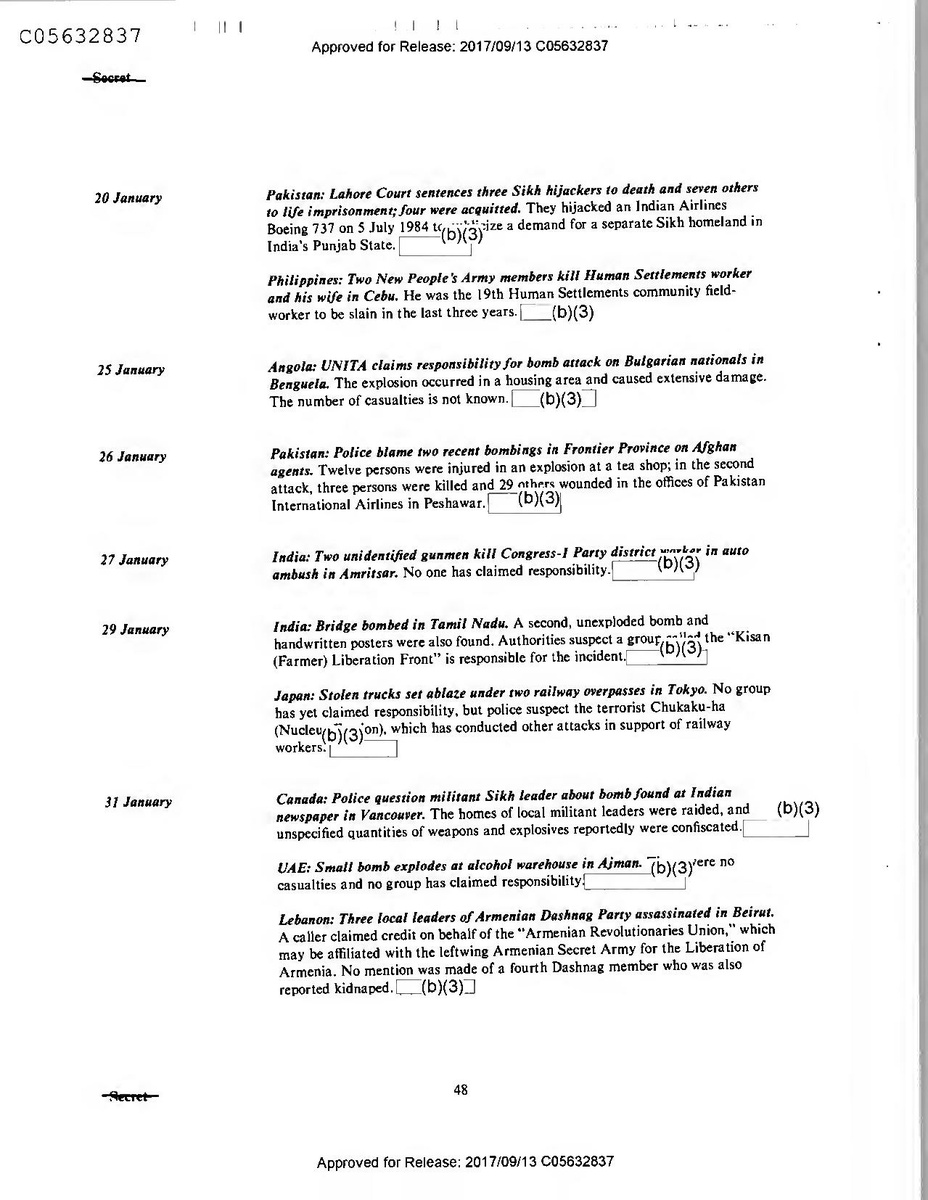
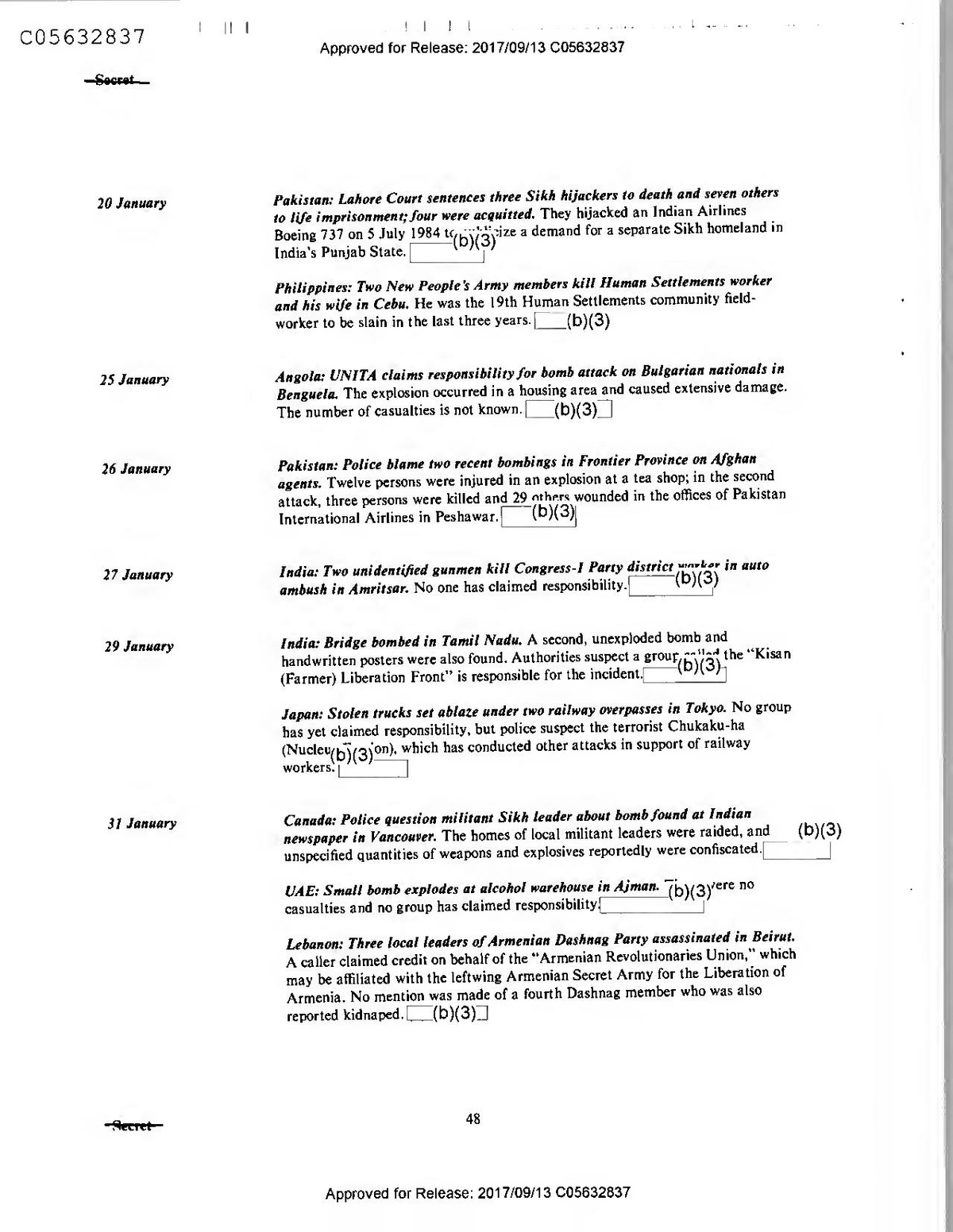
Secret
20 January
Pakistan: Lahore Court sentences three Sikh hijackers to death and seven others to life imprisonment; four were acquitted. They hijacked an Indian Airlines Boeing 737 on 5 July 1984 14b)(3)"
jize a demand for a separate Sikh homeland in India's Punjab State.
Philippines: Two New People's Army members kill Human Settlements worker and his wife in Cebu. He was the 19th Human Settlements community fieldworker to be slain in the last three years. _(b)(3)
25 January
Angola: UNITA claims responsibility for bomb attack on Bulgarian nationals in Benguela. The explosion occurred in a housing area and caused extensive damage. The number of casualties is not known. (b)(3)
26 January
Pakistan: Police blame two recent bombings in Frontier Province on Afghan agents. Twelve persons were injured in an explosion at a tea shop; in the second attack, three persons were killed and 29 others wounded in the offices of Pakistan International Airlines in Peshawar. (b)(3)
27 January
India: Two unidentified gunmen kill Congress-I Party district workor in auto ambush in Amritsar. No one has claimed responsibility.
(b)(3)
29 January
India: Bridge bombed in Tamil Nadu. A second, unexploded bomb and handwritten posters were also found. Authorities suspect a grouş, mothe “Kisan (Farmer) Liberation Front" is responsible for the incident.
(b)(3)
Japan: Stolen trucks set ablaze under two railway overpasses in Tokyo. No group has yet claimed responsibility, but police suspect the terrorist Chukaku-ha (Nucley(b)(3jon),
which has conducted other attacks in support of railway workers.
31 January
(b)(3)
Canada: Police question militant Sikh leader about bomb found at Indian newspaper in Vancouver. The homes of local militant leaders were raided, and unspecified quantities of weapons and explosives reportedly were confiscated.
were no
UAE: Small bomb explodes at alcohol warehouse in Ajman. (b)(3)'ere casualties and no group has claimed responsibility
Lebanon: Three local leaders of Armenian Dashnag Party assassinated in Beirut. A caller claimed credit on behalf of the “Armenian Revolutionaries Union," which may be affiliated with the leftwing Armenian Secret Army for the Liberation of Armenia. No mention was made of a fourth Dashnag member who was also reported kidnaped. (b)(3)]
48
नी secret
Approved for Release: 2017/09/13 C05632837
Seoret.
January-February
Sudan: Southern rebels fire on civilian planes. Rebel fire narrowly missed both charter aircraft and UN planes during several incidents Pilots are now reluctant to fly into southern Sudan, except to Juba. (b)(3)
1 February
Italy: Bomb defused outside Desenzano railroad station. The station is used by US Air Force personnel and their dependents, but there is no evidence that US personnel were specifically targeted. No one has claimed responsibility. (b)(3)
2-3 February
Greece: Two homemade bombs explode in Patisia, causing minor damage, no injuries. The first exploded in a trash can and the second at the entrance to an apartment building. No organization claimed responsibility.
(b)(3)
3, 6 February
Greece: PowerfUL bombs destro:(b)(3)$"S
irs in Athens. There were no injuries and no claims of responsibility.
4 February
Spain: Car bomb in San Sebastian seriously injur(b)(3)-eman and his daughter. No group has claimed credit for the attack.
(b)(1) (b)(3)
Iraq: Eleven Iraqi dissidents and four Iranians executed for planning car bomb attacks.
the 15 terrorinin re linked to four Syrian-trained saboteurs apprehended in late 1985.
(b)(3)"
Ethiopia: West German released after being held for four months by Sudanese People's Liberation Army. Before agreeing to hand the hostage over, SPLA negotiators declared they would conti
(b)(3)
iitake foreigners found in contested areas into "protective custody."|
Japan: Police defuse firebomb found at Osaka office building. The device consisted of a timer and two bags filled with a flammable liquid. No one has claimed responsibility. (b)(3)
Early February
France: Authorities release and expel two members of Abu Nidal Group jailed for assassination of PLO representative in Paris. The two has served half of their sentences and were freed on parole before being expelled; (b)(3)
6 February
India: Unknown assailants kill All-India Sikh Students Federation (AISSF) president in Punjab. No one has claimed responsibility for the shooting. Members of the previously outlawed AISSF were responsible for much of the Sikh-vs.-Sikh terrorism in the Punjab over the last five years.[
-(b)(3)
49
Secret
Approved for Release: 2017/09/13 C05632837
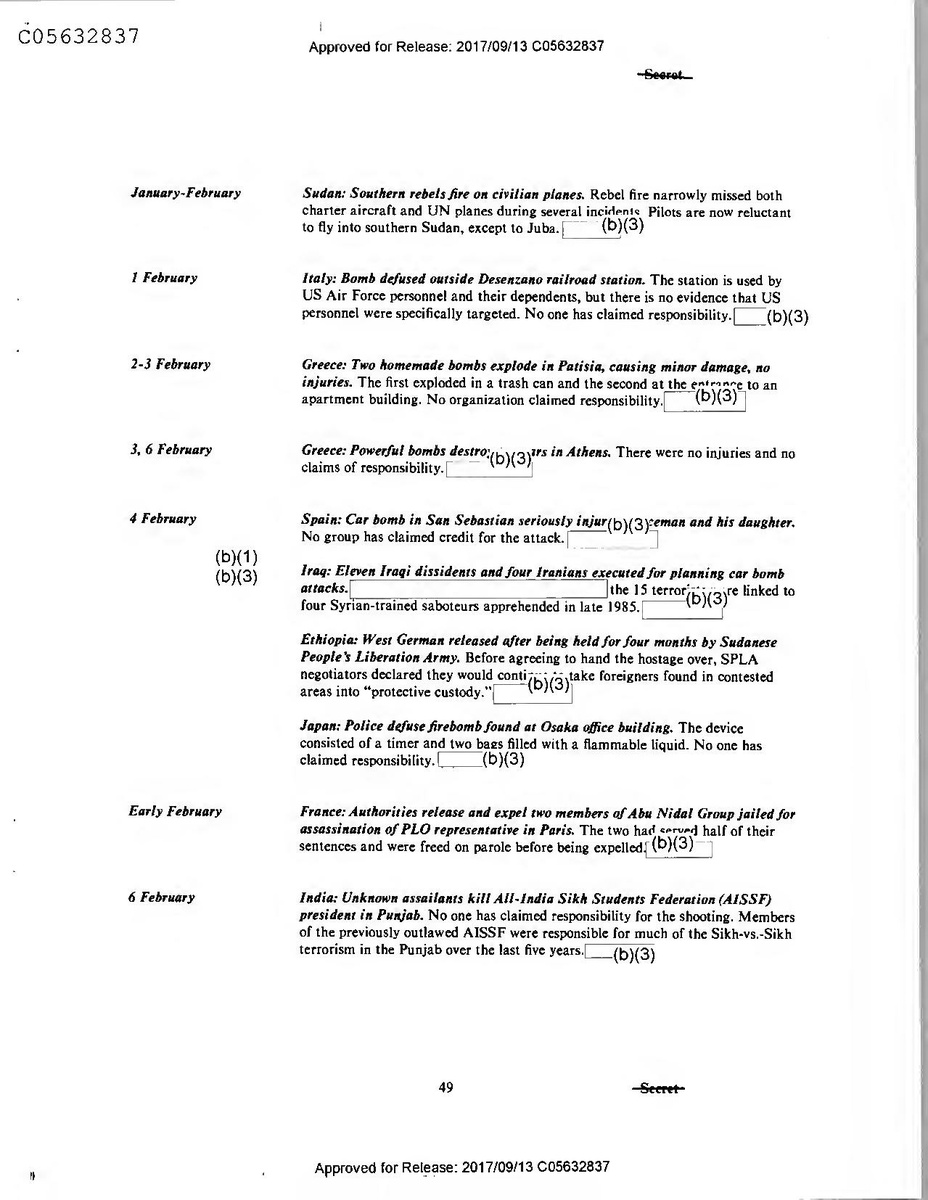
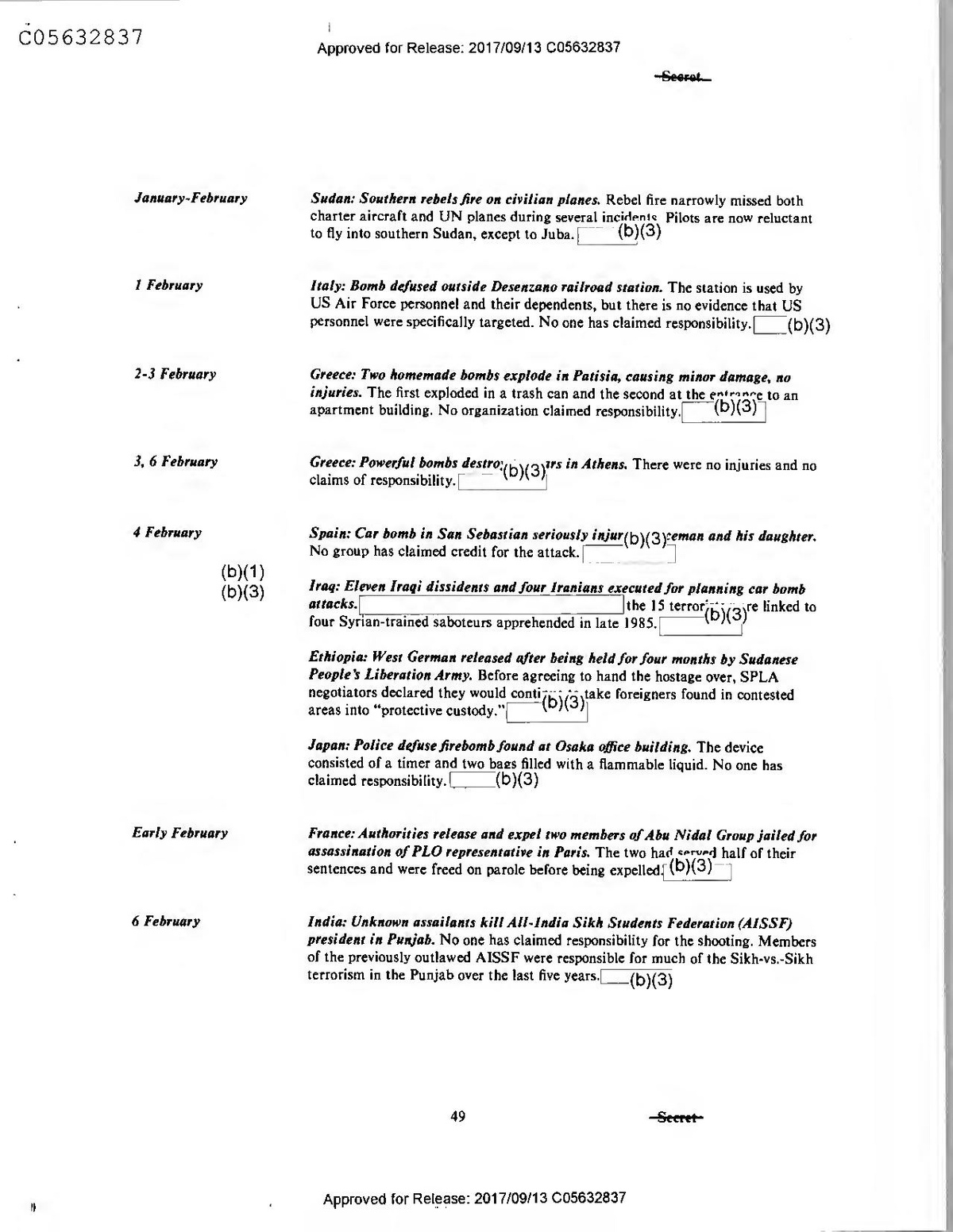
Seoret.
January-February
Sudan: Southern rebels fire on civilian planes. Rebel fire narrowly missed both charter aircraft and UN planes during several incidents Pilots are now reluctant to fly into southern Sudan, except to Juba. (b)(3)
1 February
Italy: Bomb defused outside Desenzano railroad station. The station is used by US Air Force personnel and their dependents, but there is no evidence that US personnel were specifically targeted. No one has claimed responsibility. (b)(3)
2-3 February
Greece: Two homemade bombs explode in Patisia, causing minor damage, no injuries. The first exploded in a trash can and the second at the entrance to an apartment building. No organization claimed responsibility.
(b)(3)
3, 6 February
Greece: PowerfUL bombs destro:(b)(3)$"S
irs in Athens. There were no injuries and no claims of responsibility.
4 February
Spain: Car bomb in San Sebastian seriously injur(b)(3)-eman and his daughter. No group has claimed credit for the attack.
(b)(1) (b)(3)
Iraq: Eleven Iraqi dissidents and four Iranians executed for planning car bomb attacks.
the 15 terrorinin re linked to four Syrian-trained saboteurs apprehended in late 1985.
(b)(3)"
Ethiopia: West German released after being held for four months by Sudanese People's Liberation Army. Before agreeing to hand the hostage over, SPLA negotiators declared they would conti
(b)(3)
iitake foreigners found in contested areas into "protective custody."|
Japan: Police defuse firebomb found at Osaka office building. The device consisted of a timer and two bags filled with a flammable liquid. No one has claimed responsibility. (b)(3)
Early February
France: Authorities release and expel two members of Abu Nidal Group jailed for assassination of PLO representative in Paris. The two has served half of their sentences and were freed on parole before being expelled; (b)(3)
6 February
India: Unknown assailants kill All-India Sikh Students Federation (AISSF) president in Punjab. No one has claimed responsibility for the shooting. Members of the previously outlawed AISSF were responsible for much of the Sikh-vs.-Sikh terrorism in the Punjab over the last five years.[
-(b)(3)
49
Secret
Approved for Release: 2017/09/13 C05632837
Seeret
7 February
France: Bomb damages courthouse in Nice. There were no casualties. Police found leaflets at the scene calling for “political status for Corsican patriots.” (b)(3)
8 February
France: Three gunmen wielding automatic weapons attack Bayonne bar. Five persons, including a 3-year-old girl and three Basque refugees, were wounded. No group claimed responsibility (b)(3)]
9 February
Greece: Handgrenade attack in Glyfada damages car owned by Greek, morican. As in similar attacks, there has been no claim of responsibility.
(b)(3)
11 February
(b)(3)
United Kingdom: Incendiary device explodes in south London store. There were no injuries. No group has claimed responsibility.
(b)(3)
12 February
Belgium: Brussels municipal officials close Iranian Cultural Center amid threats of retaliation from Iran. Officials acted in response to fears that the center might become a focus for Iranian-sponsored terrorist activities in Western Europe. A similar cultural center was closed recently in Paris.
(b)(3)
(b)(3)
France: Bomb explodes in French-Caribbean restaurant in Paris. The bomb caused minor damage but no injuries. No one has claimed responsibility
West Germany: Police disarm bomb at South African Foundation office in Bonn. The Revolutionary Cells terrorist group claimed responsibility.[
(b)(3)
13 February
France: Three gunmen with automatic weapons attack customers in bar in St. Jean de Luz. Several people were wounded, including a Spanish Basque refugee, and
one of the gunmen was arrested. T(b)(3)titerrorist Liberation Group claimed
responsibility for the attack.
14 February
Belgium: Homemade bomb defused at Soviet airline office in Brussels. Aeroflot had received no threats or warnings, and no one claimed responsibility.
(b)(3)
Spain: Iraultza claims credit for bombing Citibank office in Vitoria. The bomb caused some damage to the bank and adjacent buildings but no injuries. The communique claimed the action was carried out “on behalf of the anti-NATO
movement." (b)(3)
50
Secret
Approved for Release: 2017/09/13 C05632837
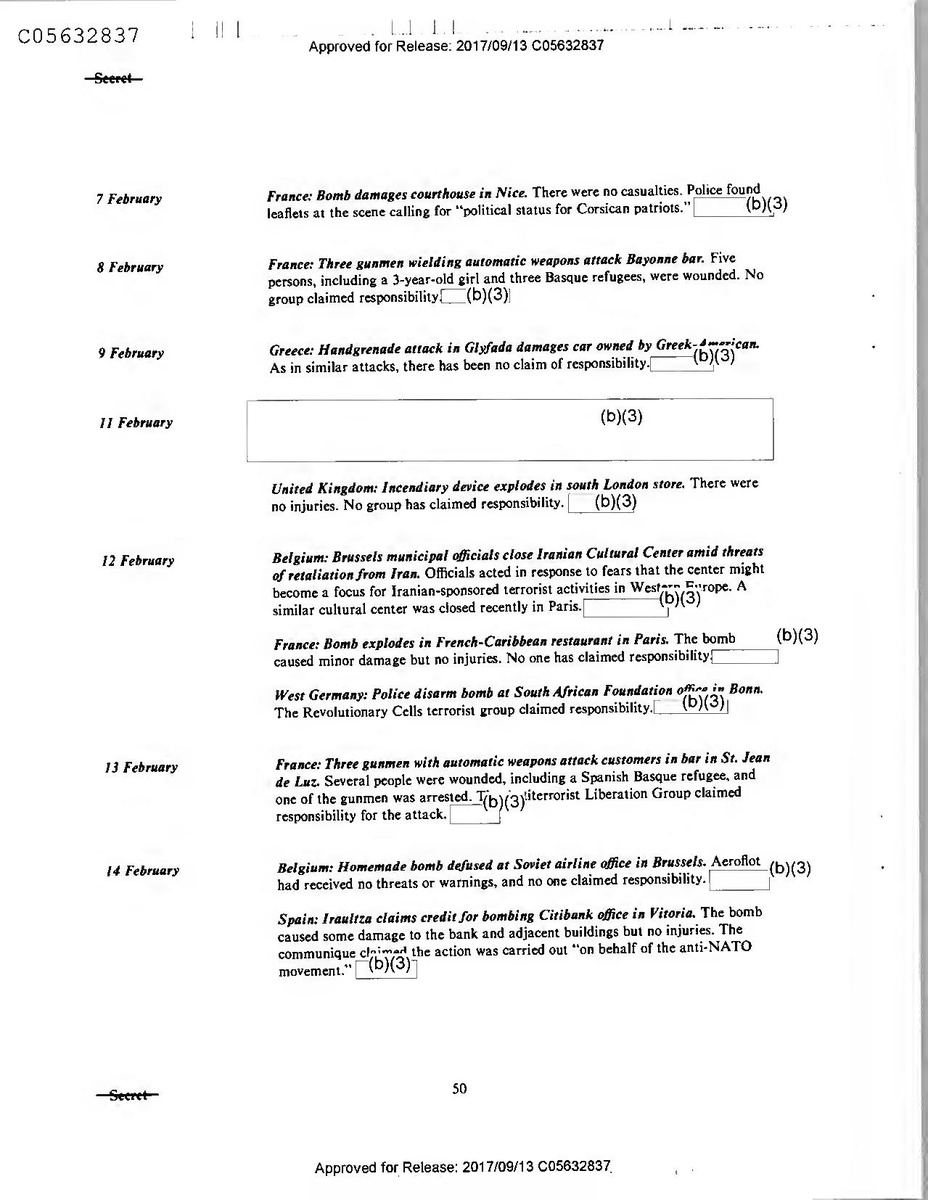
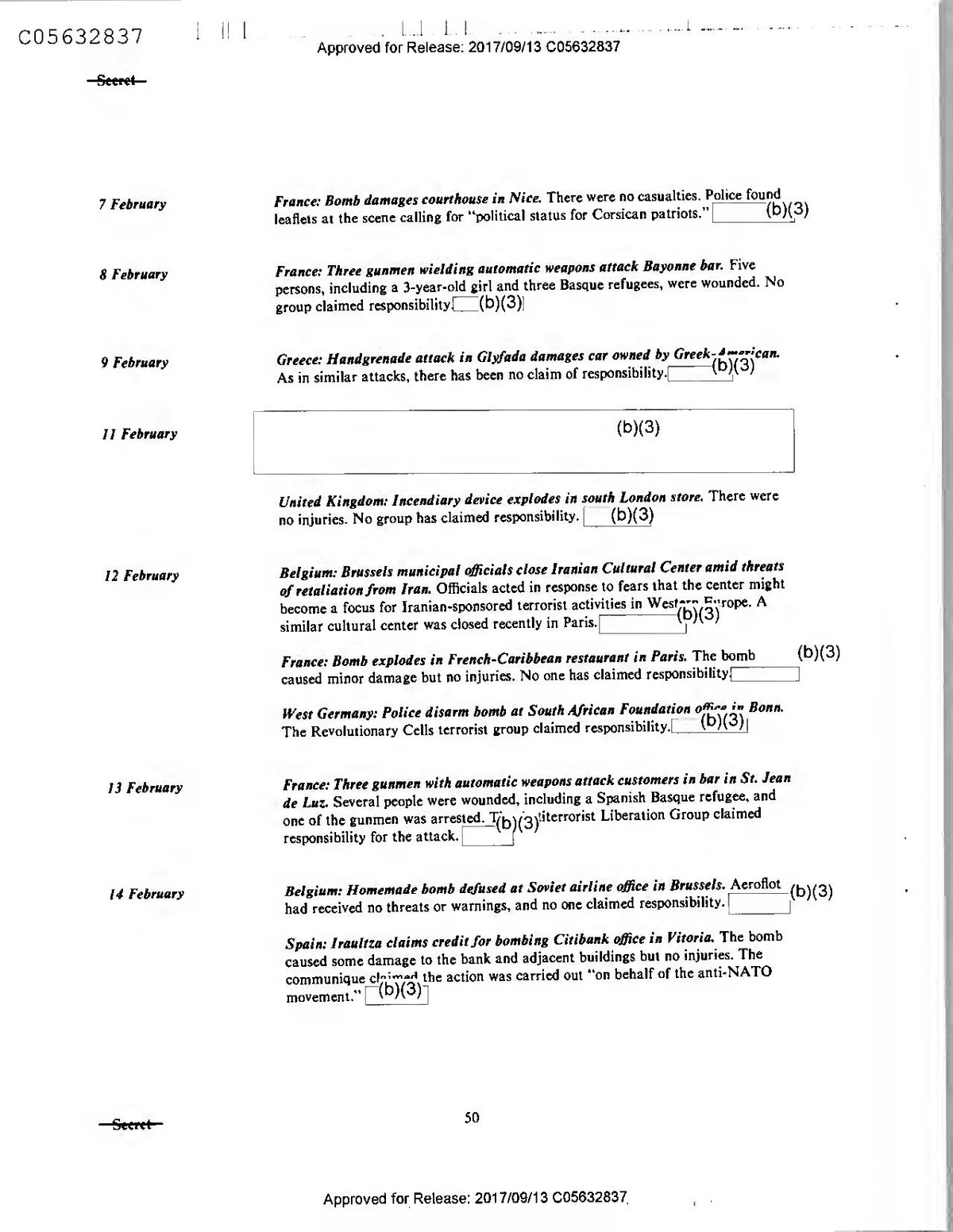
Seeret
7 February
France: Bomb damages courthouse in Nice. There were no casualties. Police found leaflets at the scene calling for “political status for Corsican patriots.” (b)(3)
8 February
France: Three gunmen wielding automatic weapons attack Bayonne bar. Five persons, including a 3-year-old girl and three Basque refugees, were wounded. No group claimed responsibility (b)(3)]
9 February
Greece: Handgrenade attack in Glyfada damages car owned by Greek, morican. As in similar attacks, there has been no claim of responsibility.
(b)(3)
11 February
(b)(3)
United Kingdom: Incendiary device explodes in south London store. There were no injuries. No group has claimed responsibility.
(b)(3)
12 February
Belgium: Brussels municipal officials close Iranian Cultural Center amid threats of retaliation from Iran. Officials acted in response to fears that the center might become a focus for Iranian-sponsored terrorist activities in Western Europe. A similar cultural center was closed recently in Paris.
(b)(3)
(b)(3)
France: Bomb explodes in French-Caribbean restaurant in Paris. The bomb caused minor damage but no injuries. No one has claimed responsibility
West Germany: Police disarm bomb at South African Foundation office in Bonn. The Revolutionary Cells terrorist group claimed responsibility.[
(b)(3)
13 February
France: Three gunmen with automatic weapons attack customers in bar in St. Jean de Luz. Several people were wounded, including a Spanish Basque refugee, and
one of the gunmen was arrested. T(b)(3)titerrorist Liberation Group claimed
responsibility for the attack.
14 February
Belgium: Homemade bomb defused at Soviet airline office in Brussels. Aeroflot had received no threats or warnings, and no one claimed responsibility.
(b)(3)
Spain: Iraultza claims credit for bombing Citibank office in Vitoria. The bomb caused some damage to the bank and adjacent buildings but no injuries. The communique claimed the action was carried out “on behalf of the anti-NATO
movement." (b)(3)
50
Secret
Approved for Release: 2017/09/13 C05632837
US Diplomatic Meddling. Soviet disinformation campaigns often allege us interference in the internal affairs of Third world countries and often blame the United States for_positical developments that are inimical to Soviet interests.
(b)(33ca1
O
An August 1985 TASS article, citing Izvestiya, charged the 'Department of Dirty Tricks' of the CIA with giving the Prime Minister of Liberia, Samuel Doe, $250,000 to make him discontinue diplomatic relations with the Soviet Union. The report accused the United States of exploiting Liberia's domestic problems and blaming the Soviet Union for them. This article appeared in a Finnish Communist newspaper shortly after the break in SovietLiberian diplomatic relations.
(b)(3)
O
For years the Soviets have accused South Africa of developing a biological "ethnic" weapon that would kill only blacks. A recent Novosti Press Agency article, citing a Senegalese source, reported that the United States was also involved in "ethnic" weapons research with the South Africans.
newspapers published the story in February 1986.
TWO Nigerian dąb)(3)
O
Last November, in a brief Radio Moscow report (in Greek), a Soviet observer reported that the partitioning of Cyprus was caused by the United States and other Western imperialists.
In February 1986, Pravda asserted that Us and NATO attel(b)(3) +
to seize Cyprus increased noticeably in recent weeks.
O
Citing unnamed sources, Pravda inferred on 24 February that the anti-Marcos coun
(b)(3)
viajs prepared with the help of US special services.
O
In mid-December 1985, articles alleging US-Israeli intentions to attack PLO bases appeared in Middle Eastern and European newspapers.
These articles were based on
a
Soviet report (b)(3)' to the Yemenis who then released it
to the media.
(b)(1) (b)(3)
4
SEXRET
(b)(3)
Approved for Release: 2017/09/13 C05612850.
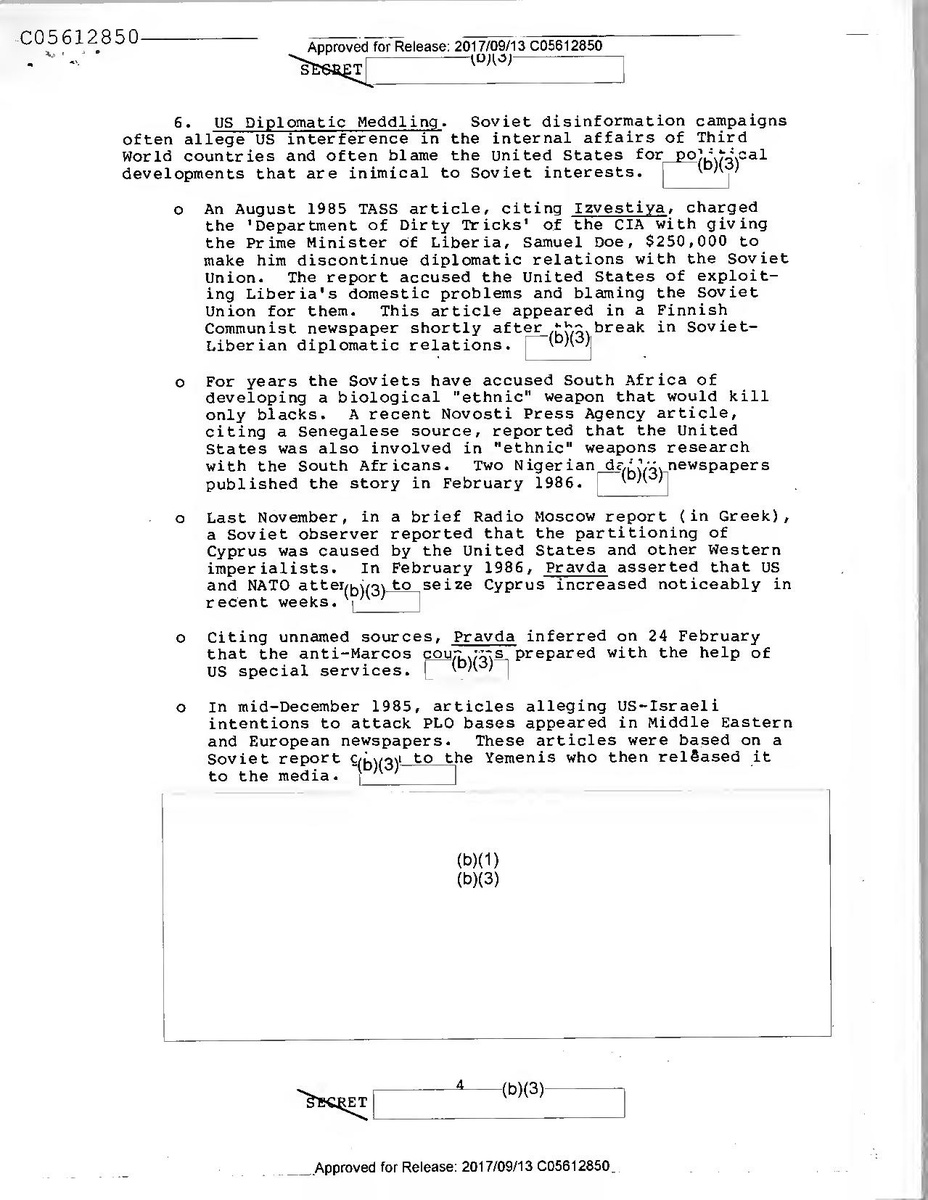
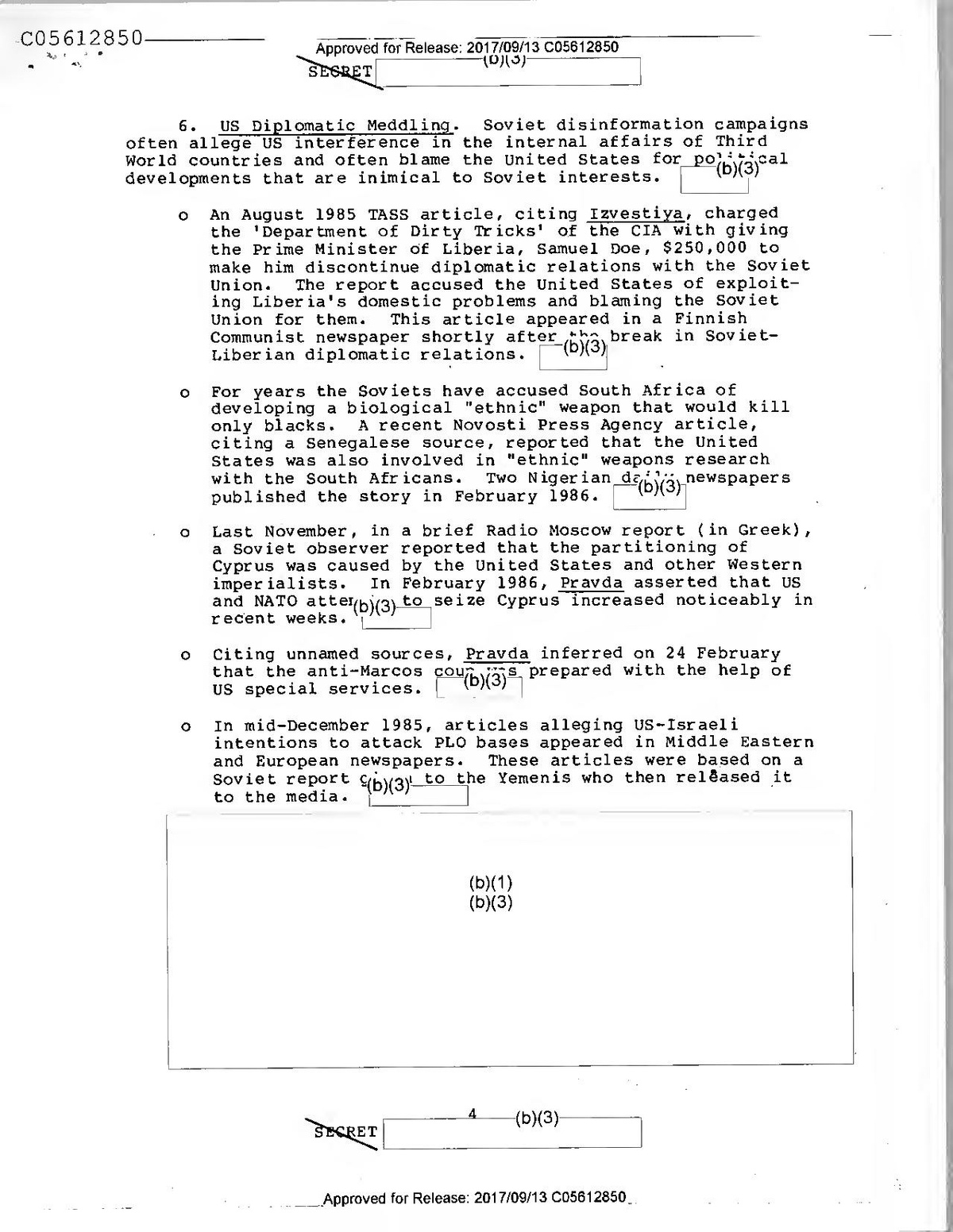
US Diplomatic Meddling. Soviet disinformation campaigns often allege us interference in the internal affairs of Third world countries and often blame the United States for_positical developments that are inimical to Soviet interests.
(b)(33ca1
O
An August 1985 TASS article, citing Izvestiya, charged the 'Department of Dirty Tricks' of the CIA with giving the Prime Minister of Liberia, Samuel Doe, $250,000 to make him discontinue diplomatic relations with the Soviet Union. The report accused the United States of exploiting Liberia's domestic problems and blaming the Soviet Union for them. This article appeared in a Finnish Communist newspaper shortly after the break in SovietLiberian diplomatic relations.
(b)(3)
O
For years the Soviets have accused South Africa of developing a biological "ethnic" weapon that would kill only blacks. A recent Novosti Press Agency article, citing a Senegalese source, reported that the United States was also involved in "ethnic" weapons research with the South Africans.
newspapers published the story in February 1986.
TWO Nigerian dąb)(3)
O
Last November, in a brief Radio Moscow report (in Greek), a Soviet observer reported that the partitioning of Cyprus was caused by the United States and other Western imperialists.
In February 1986, Pravda asserted that Us and NATO attel(b)(3) +
to seize Cyprus increased noticeably in recent weeks.
O
Citing unnamed sources, Pravda inferred on 24 February that the anti-Marcos coun
(b)(3)
viajs prepared with the help of US special services.
O
In mid-December 1985, articles alleging US-Israeli intentions to attack PLO bases appeared in Middle Eastern and European newspapers.
These articles were based on
a
Soviet report (b)(3)' to the Yemenis who then released it
to the media.
(b)(1) (b)(3)
4
SEXRET
(b)(3)
Approved for Release: 2017/09/13 C05612850.
Secret
Colombia: Terrorists on motorcycle murder Jewish businessman and his companion in downtown Bogota. The victim had played a role in negotiating an end to the M-19 seizure of the Dominican Embassy in 1980 and had acted as an intermediary (b)(3)ɔm negotiations with terrorist groups. No one claimed responsibility.
15 February
Portugal: Director General of prison services assassinated near his home in Lisbon. The terrorist group Popular Forces of 25 April, several of whose members are currently imprisoned, claimed responsibility F (b)(3)
Spain: Police arrest five alleged ETA members and detain four suspected informers in Bilbao. The ETA members were charged with murdering a police (b)(3) chief in Munguia in 1979 and killing a civilian in Bilbao in 1984.
France: Suspected ETA-M propaganda chief deported to Cape Verde Islands. He was arrested in Biarritz on 25 November 1985 and originally given a three-month prison sentence on arms charges. Two other sonorod ETA members had been deported to Cape Verde on 28 January.
(b)(3)
16 February
Portugal: Abu Nidal member released on conditional liberty and expelled. The man was acquitted in the 1983 assassination of PLO representative Issam Sartawi,
was convicted of using a false passport and was serving three years in prison.
(b)(3)
Luxembourg: Bomb destroys automobile in front of prominent notary's residence in suburb of Cents. No one has claimed responsibility for the bombing, the first since early December.
(b)(3)
17 February
Denmark: Gambian suspect in October 1985 murder of the Israelis in Barcelona arrested in Copenhagen.
F(b)(1); (b)(3)
France: Two gunmen in car murder 60-year-old man and 16-year-old girl in
Biodarray. Police suspect th(b)(3j'errorist Liberation Group mistook them for
Basque sympathizers.
Iran: Small parcel bomb explodes at bus station in south Tehran, killing one person and injuring two others. A previously unknown anti-Khomeini group, the “Azadi (Freedom) Organization," claimed responsibility. (b)(3)
18 February
Portugal: Bomb explodes in trunk of American-owned car at US Embassy in Lisbon. There were no injuries and no major property damage. The Popular Forces of 25 April claimed responsibility for the attack. [
(b)(3)
51
Secret
Approved for Release: 2017/09/13 C05632837
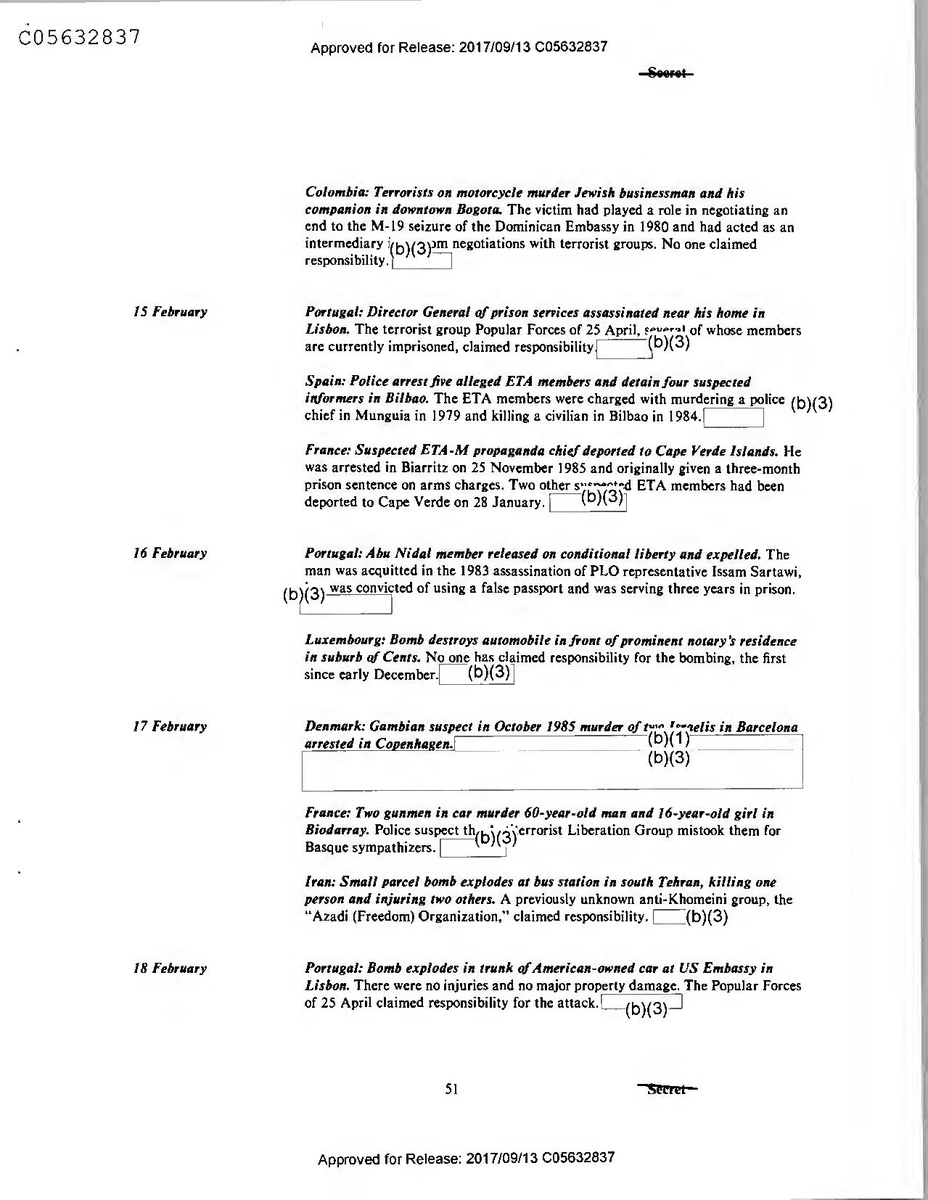
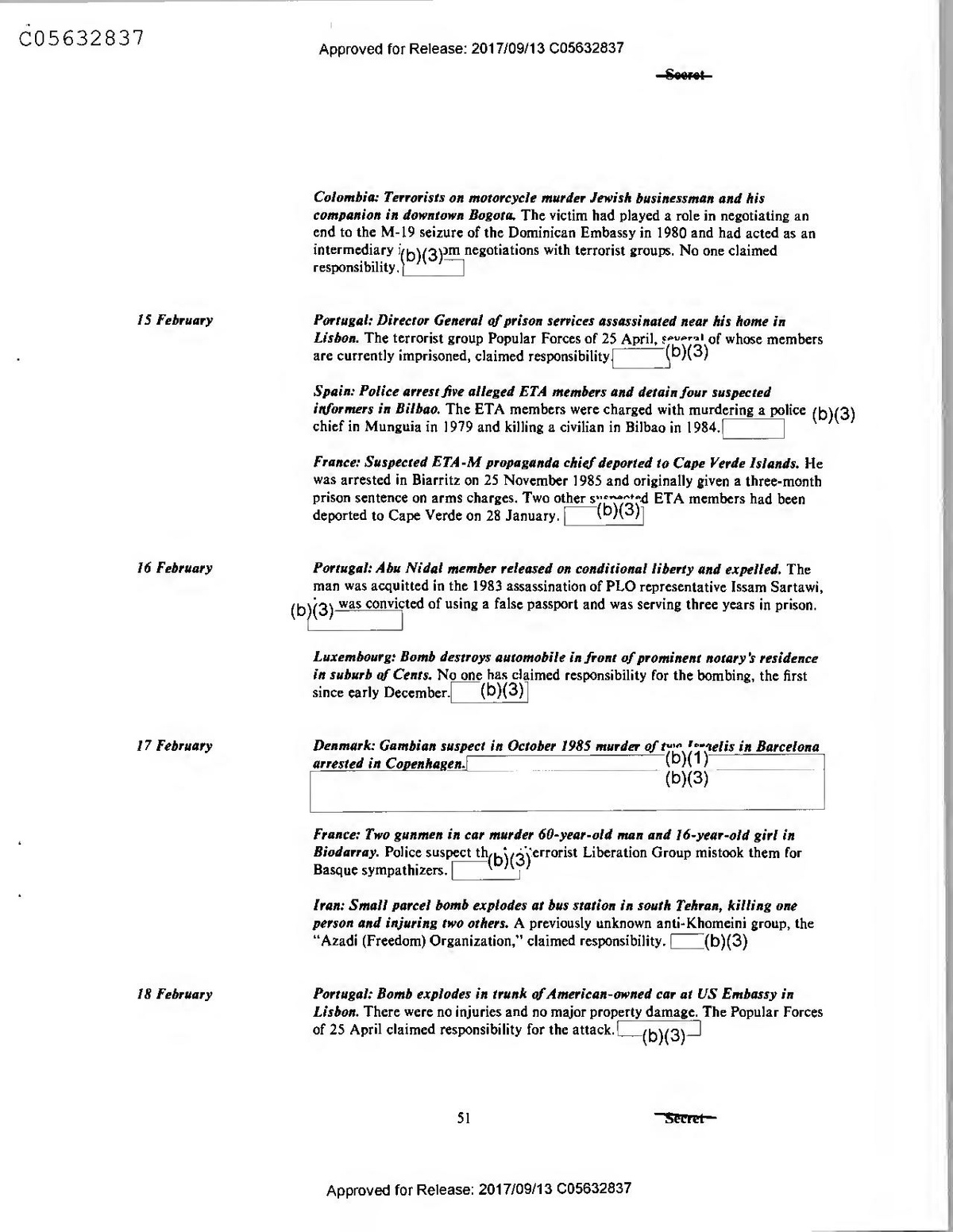
Secret
Colombia: Terrorists on motorcycle murder Jewish businessman and his companion in downtown Bogota. The victim had played a role in negotiating an end to the M-19 seizure of the Dominican Embassy in 1980 and had acted as an intermediary (b)(3)ɔm negotiations with terrorist groups. No one claimed responsibility.
15 February
Portugal: Director General of prison services assassinated near his home in Lisbon. The terrorist group Popular Forces of 25 April, several of whose members are currently imprisoned, claimed responsibility F (b)(3)
Spain: Police arrest five alleged ETA members and detain four suspected informers in Bilbao. The ETA members were charged with murdering a police (b)(3) chief in Munguia in 1979 and killing a civilian in Bilbao in 1984.
France: Suspected ETA-M propaganda chief deported to Cape Verde Islands. He was arrested in Biarritz on 25 November 1985 and originally given a three-month prison sentence on arms charges. Two other sonorod ETA members had been deported to Cape Verde on 28 January.
(b)(3)
16 February
Portugal: Abu Nidal member released on conditional liberty and expelled. The man was acquitted in the 1983 assassination of PLO representative Issam Sartawi,
was convicted of using a false passport and was serving three years in prison.
(b)(3)
Luxembourg: Bomb destroys automobile in front of prominent notary's residence in suburb of Cents. No one has claimed responsibility for the bombing, the first since early December.
(b)(3)
17 February
Denmark: Gambian suspect in October 1985 murder of the Israelis in Barcelona arrested in Copenhagen.
F(b)(1); (b)(3)
France: Two gunmen in car murder 60-year-old man and 16-year-old girl in
Biodarray. Police suspect th(b)(3j'errorist Liberation Group mistook them for
Basque sympathizers.
Iran: Small parcel bomb explodes at bus station in south Tehran, killing one person and injuring two others. A previously unknown anti-Khomeini group, the “Azadi (Freedom) Organization," claimed responsibility. (b)(3)
18 February
Portugal: Bomb explodes in trunk of American-owned car at US Embassy in Lisbon. There were no injuries and no major property damage. The Popular Forces of 25 April claimed responsibility for the attack. [
(b)(3)
51
Secret
Approved for Release: 2017/09/13 C05632837
Secret
(b)(3)
23 February
Israel: Bomb explodes near Jerusalem's Jaffa Gate. No casualties were reported. An unspecified number of suspects were detained for questioning (b)(3)
24 February
West Germany: Improvised explosive devices destry
"(b)(3) telephone booths in Dusseldorf. No one has claimed responsibility.
Israel: Bomb in Oirvat Mal’ahi discovered and detonated harmlessly. An unspecified numher of suspects, presumably Palestinians, were later detained for
interrogation. [(b)(3)
New Caledonia: Ten-kilogram bomb destroys building housing tax cinco in Noumea. There were no injuries and no claim of responsibility.
(b)(3)
25 February
France: Homemade bomb damages building in central Paris. The bomb's target is not known; the building housed a military health insurance office and an employees cafeteria of the Banque Nationale de Paris. There have been no claims of responsibility. (b)(3)
26 February
Italy: Italian Air Force sergeant, businessman arrested for spying for Libya. The two we
F(b)(3)sed of handing over documents to Libya concerning a NATO base in Sicily..
Lebanon: Car bomb explodes at entrance to Palestinian refugee camp in Sidon. The blast, which killed the driver and injured seven other persons, came 10 minutes before hundreds of Palestinians were scheduled to assemble at the (b)(3) entrance for a demonstration. No group has claimed responsibility.
Japan: Japanese Red Army member surrenders at Tokyo police station. Yoshiaki Yamada had been jailed in 1974 for sabotaging a Singapore oil refinery and was freed in exchange for hostages taken by the JRA at the French Embassy in The Hague later that same year. Police do not know why or how he returned to Japan; he had been living with other JRA members in Lebanon's Bekaa Valley. (b)(3)
27 February
France: Bomb explodes outside Paris bookshop, causing slight damage but no injuries. No one claimed credit for the attack (b)(3)
Secret
52
Approved for Release: 2017/09/13 C05632837
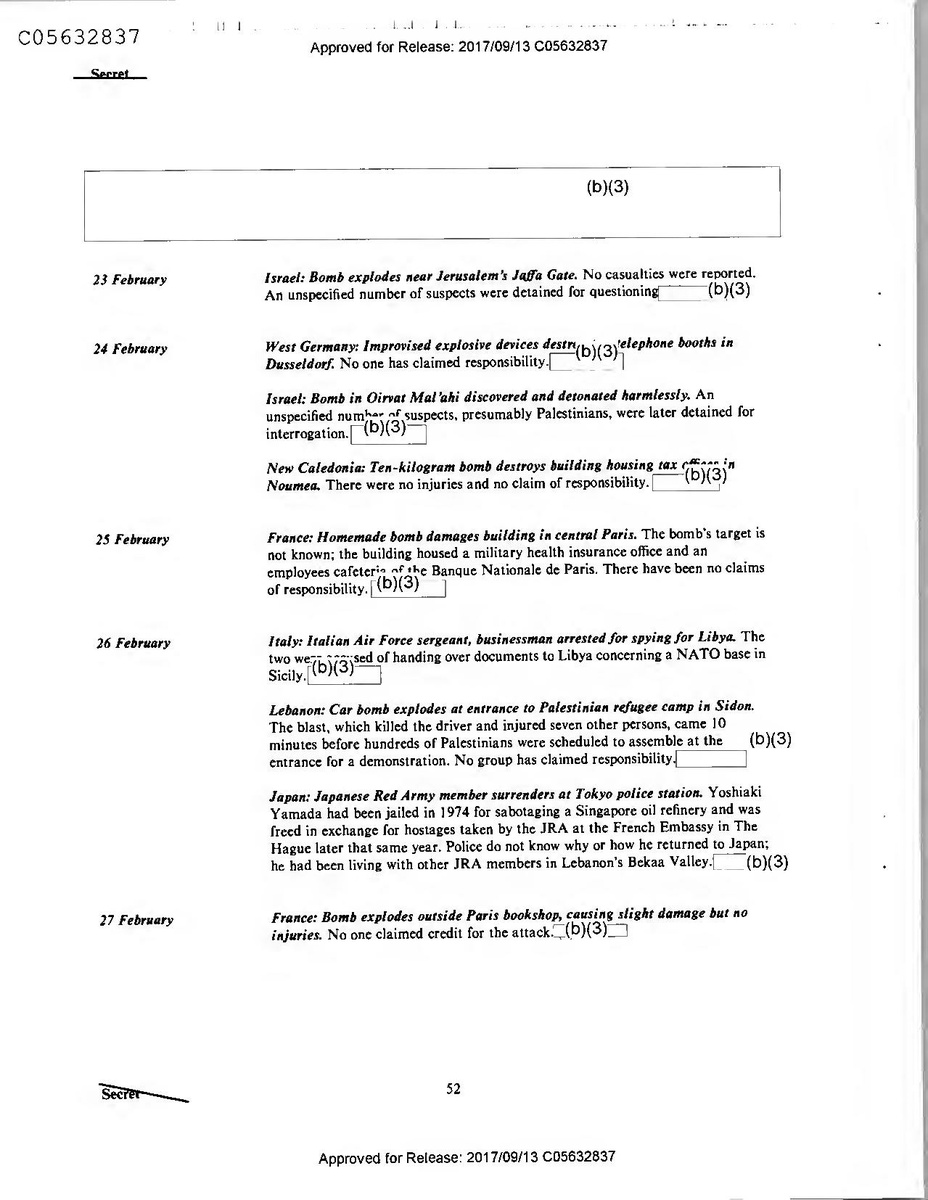
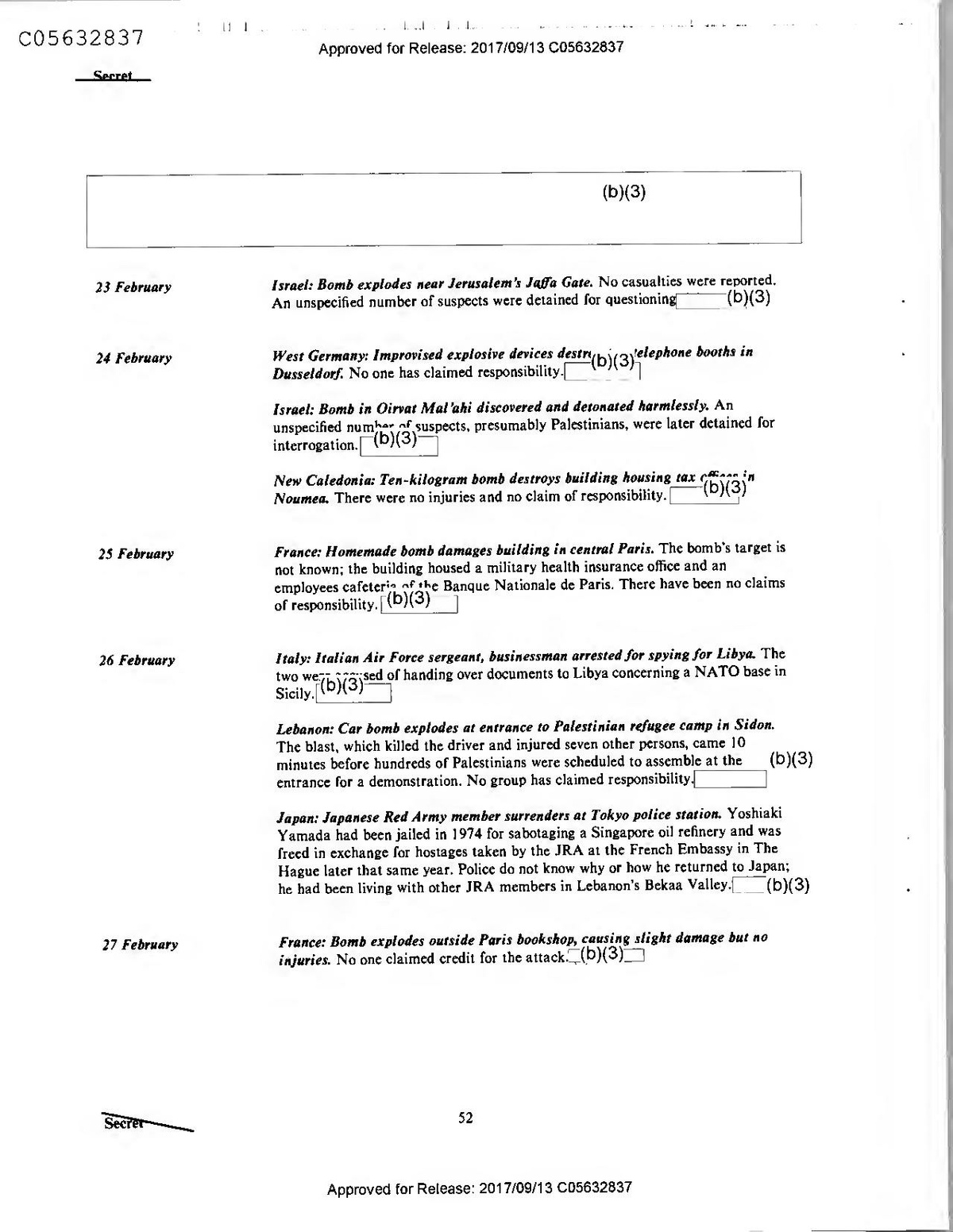
Secret
(b)(3)
23 February
Israel: Bomb explodes near Jerusalem's Jaffa Gate. No casualties were reported. An unspecified number of suspects were detained for questioning (b)(3)
24 February
West Germany: Improvised explosive devices destry
"(b)(3) telephone booths in Dusseldorf. No one has claimed responsibility.
Israel: Bomb in Oirvat Mal’ahi discovered and detonated harmlessly. An unspecified numher of suspects, presumably Palestinians, were later detained for
interrogation. [(b)(3)
New Caledonia: Ten-kilogram bomb destroys building housing tax cinco in Noumea. There were no injuries and no claim of responsibility.
(b)(3)
25 February
France: Homemade bomb damages building in central Paris. The bomb's target is not known; the building housed a military health insurance office and an employees cafeteria of the Banque Nationale de Paris. There have been no claims of responsibility. (b)(3)
26 February
Italy: Italian Air Force sergeant, businessman arrested for spying for Libya. The two we
F(b)(3)sed of handing over documents to Libya concerning a NATO base in Sicily..
Lebanon: Car bomb explodes at entrance to Palestinian refugee camp in Sidon. The blast, which killed the driver and injured seven other persons, came 10 minutes before hundreds of Palestinians were scheduled to assemble at the (b)(3) entrance for a demonstration. No group has claimed responsibility.
Japan: Japanese Red Army member surrenders at Tokyo police station. Yoshiaki Yamada had been jailed in 1974 for sabotaging a Singapore oil refinery and was freed in exchange for hostages taken by the JRA at the French Embassy in The Hague later that same year. Police do not know why or how he returned to Japan; he had been living with other JRA members in Lebanon's Bekaa Valley. (b)(3)
27 February
France: Bomb explodes outside Paris bookshop, causing slight damage but no injuries. No one claimed credit for the attack (b)(3)
Secret
52
Approved for Release: 2017/09/13 C05632837
Secret
West Germany: Incendiary device discovered under construction vehicle at NATO slipway construction site at Offenbach/Rumpenhiem. Inclement weather apparently pre responsibility
(b)(3) the device from detonating. No group has claimed
Spain: Three members of October the First Antifascist Resistance Group fail in attempt to rob Zaragoza savings bank. The robbers took hostages during the
were arrested immediately and a third was captured on 3 March.[
attempt but subsequently released them. T(b)(3)pects
Israel: Two Arab terrorists get reduced sentences in bomb plantings. They had been serving 25-year sentences and had successfully appealed for reduced sentences on the grounds that Jewish underground members had received lighter sentences. A military appeals court reduced their terms to 18 years each.
(b)(3)
28 February
Israel: Three infiltrators surprised going through fence on Lebanese border. Two of them were killed, and the other surrendered. They wore Israeli Army uniforms over civilian clothes and had planned to take Israeli hostages to exchange for (b)(3) prisoners belonging to the Democratic Front for the Liberation of Palestine.
2 March
Israel: Bomb explosion in East Jerusalem causes no damage or injuries. The
bomb went off near the Siloam Pool in Silwan. No one took credit for the incident. (b)(3)
3 March
France: Iparretarak claims five bomb attacks in Basque region. The bombs exploded within minutes of each other, causing little damage and no injuries. The targets were political offices in Biarritz and Anglet, the home and
and(b)(3) tu
two policemen in Bayonne, and a private house in Souriade.
Dominican Republic: Bomb explodes ar US-affiliated telephone company offices in San Cristobal. The medium-size device, hurled by unidentified individuals who fied by car, caused considerable damage to the facade of the building but no casualties. The company, a subsidiary of General Telephone and Electronic handles the country's entire telephone communications system.
F(b)(3)7
4 March
Colombia: M-19 guerrillas take seminarians and workers hostage, request to meet Pope during his July visit. Members of the 19 April Movement occupied a seminary north of Bogota for 12 hours and briefly held captive 49 seminarians and (b)(3) 79 workers whom they kidnaped at their workplaces and bused to the seminary.
5 March
South Africa: Police arrest white woman in connection with bombing incidents in Johannesburg. Limpet mines of the type used by the African National Congress were found in her possession.[(b)(3)
53
Secret.
Approved for Release: 2017/09/13 C05632837
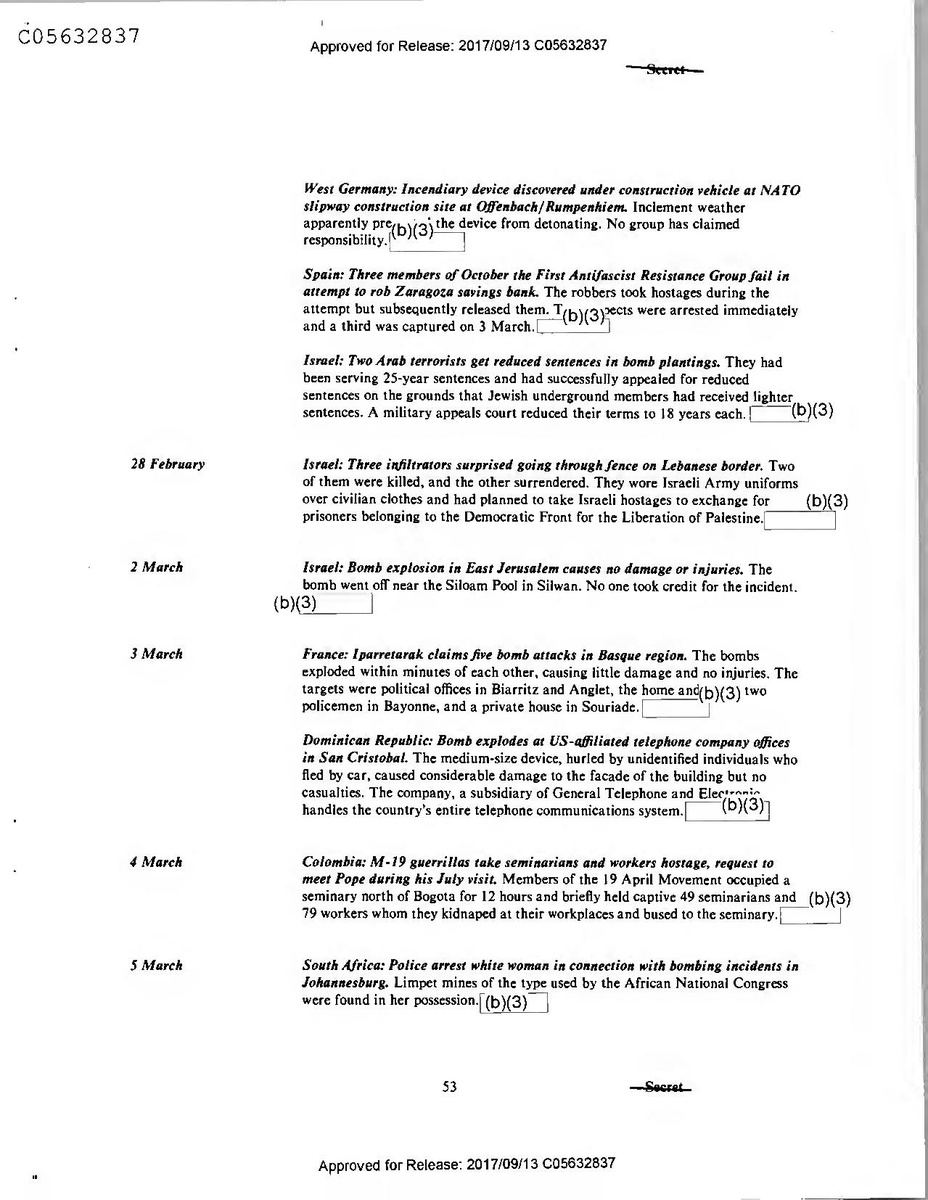
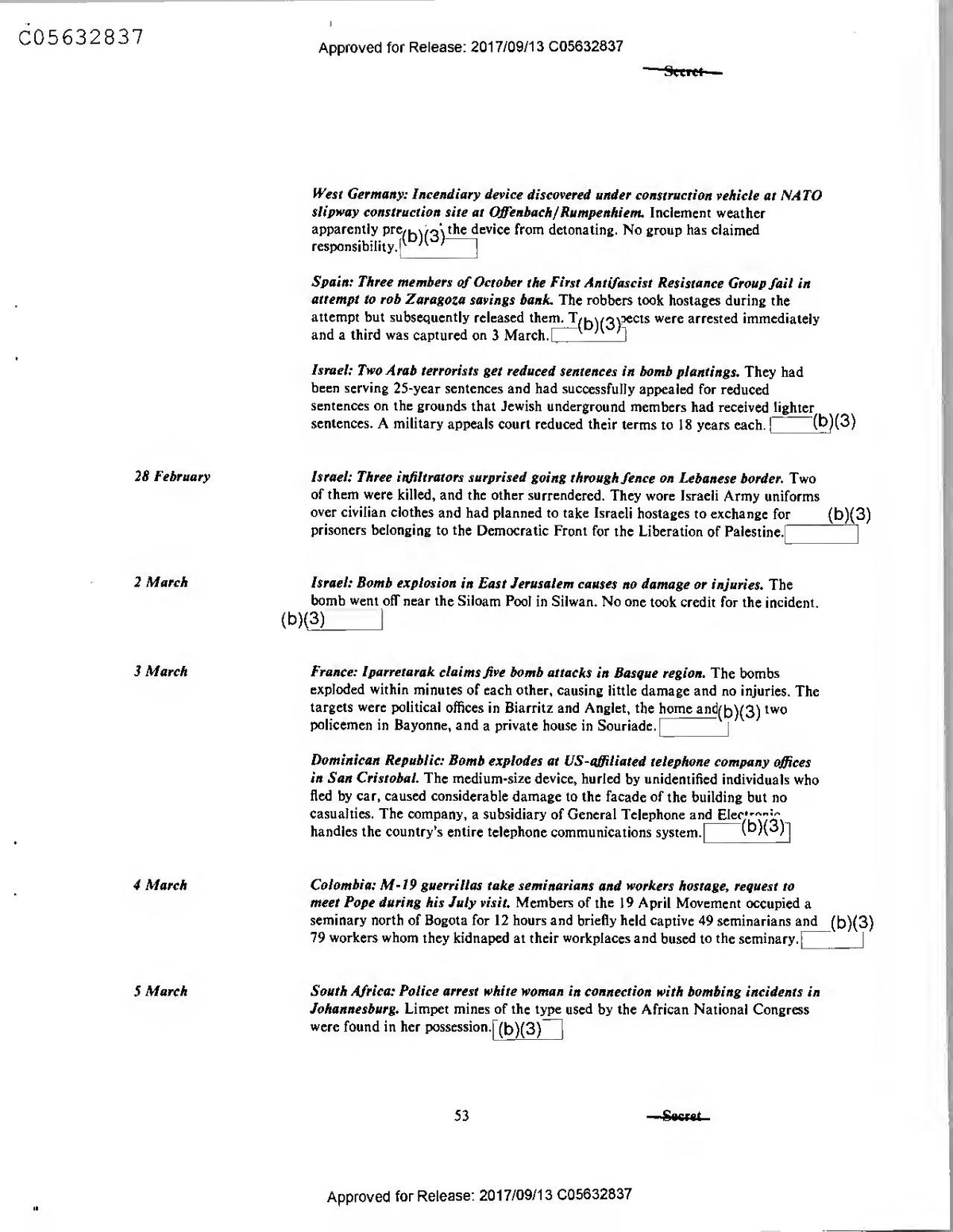
Secret
West Germany: Incendiary device discovered under construction vehicle at NATO slipway construction site at Offenbach/Rumpenhiem. Inclement weather apparently pre responsibility
(b)(3) the device from detonating. No group has claimed
Spain: Three members of October the First Antifascist Resistance Group fail in attempt to rob Zaragoza savings bank. The robbers took hostages during the
were arrested immediately and a third was captured on 3 March.[
attempt but subsequently released them. T(b)(3)pects
Israel: Two Arab terrorists get reduced sentences in bomb plantings. They had been serving 25-year sentences and had successfully appealed for reduced sentences on the grounds that Jewish underground members had received lighter sentences. A military appeals court reduced their terms to 18 years each.
(b)(3)
28 February
Israel: Three infiltrators surprised going through fence on Lebanese border. Two of them were killed, and the other surrendered. They wore Israeli Army uniforms over civilian clothes and had planned to take Israeli hostages to exchange for (b)(3) prisoners belonging to the Democratic Front for the Liberation of Palestine.
2 March
Israel: Bomb explosion in East Jerusalem causes no damage or injuries. The
bomb went off near the Siloam Pool in Silwan. No one took credit for the incident. (b)(3)
3 March
France: Iparretarak claims five bomb attacks in Basque region. The bombs exploded within minutes of each other, causing little damage and no injuries. The targets were political offices in Biarritz and Anglet, the home and
and(b)(3) tu
two policemen in Bayonne, and a private house in Souriade.
Dominican Republic: Bomb explodes ar US-affiliated telephone company offices in San Cristobal. The medium-size device, hurled by unidentified individuals who fied by car, caused considerable damage to the facade of the building but no casualties. The company, a subsidiary of General Telephone and Electronic handles the country's entire telephone communications system.
F(b)(3)7
4 March
Colombia: M-19 guerrillas take seminarians and workers hostage, request to meet Pope during his July visit. Members of the 19 April Movement occupied a seminary north of Bogota for 12 hours and briefly held captive 49 seminarians and (b)(3) 79 workers whom they kidnaped at their workplaces and bused to the seminary.
5 March
South Africa: Police arrest white woman in connection with bombing incidents in Johannesburg. Limpet mines of the type used by the African National Congress were found in her possession.[(b)(3)
53
Secret.
Approved for Release: 2017/09/13 C05632837
Secret
6 March
Spain: Police suspect Basque group Iraultza behind second bombing of USaffiliated company in Bilbao. Damage was slight, and there were no injuries. No
one has claimed responsibility for the attack, the second such on the firm in a year. (b)(3)
7 March
Colombia: Bomb thrown into restaurant kills two, wounds nine others. A policeman and a civilian were killed. No one claimed responsibility for the attack, which occurred two days before national elections. (b)(3)
8 March
France: Two hooded gunmen kidnap Seychelles ConsUL and daughter in their apartment in Marseilles. The motive for the incident is not clear, but the gunmen
(b)(3)urrendered to the police three hours later and released their hostages unharmed.
Argentina: Bomb explodes at La Plata Catholic University in Buenos Aires.
ffices were destroyed. No one claimed responsibility for the attack.
Although there were no casualties(b)(3) f
9 March
Guadeloupe: Four molotov cocktails thrown at political campaign rally in Capesterre-Belle Eau. One person in the crowd of 400 was critically wounded. No
one has claimed responsibility for the attack, (b)(35cials suspect the Popular
Union for the Liberation of Guadeloupe
Angola: Ten foreign kidnap victims escape from UNITA rebels in Andrada. The citizens of Portugal, Canada, Sao Tome and Principe, and Angola had been workers of the Diamang Company and were being forced to march to rebelcontrolled territories during the rainy season. They were among an estimated 175 foreign workers heing held by guerrillas of the Union for the Total Liberation of
Angola. (b)(3)7
Pakistan: UnsuccessfUL attempt made to bomb Iraqi ConsUL General's car in Karachi. The bomb fell off the moving car and exploded in the road, causing no damage. No group has claimed responsibility for the attack. (b)(3)
11 March
Spain: ETA-M claims kidnaping of Basque industrialist. The group reportedly has not made contact with the hostage's family. (b)(3)
13 March
Colombia: Police kill top (-19 leader Alvaro Fayad in Bogota apartment. Fayad, who took control of the guerrilla group in February 1985, is the third M-19 leader to die in the last three years (b)(3)
South Africa: UNITA frees two Portuguese nationals captured last year in (b)(3) Angola. They arrived in Johannesburg on an International Red Cross plane.
54
- Secret
Approved for Release: 2017/09/13 C05632837
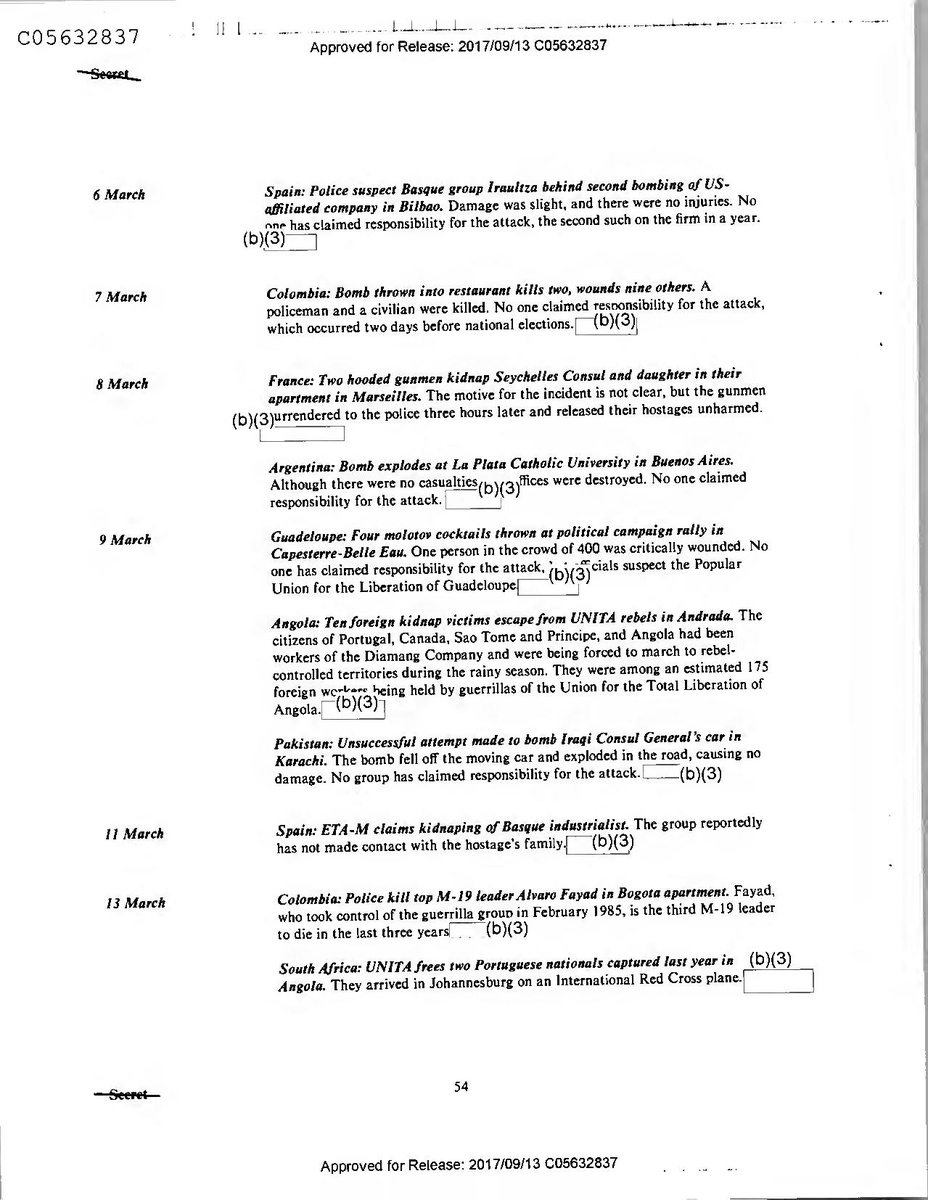
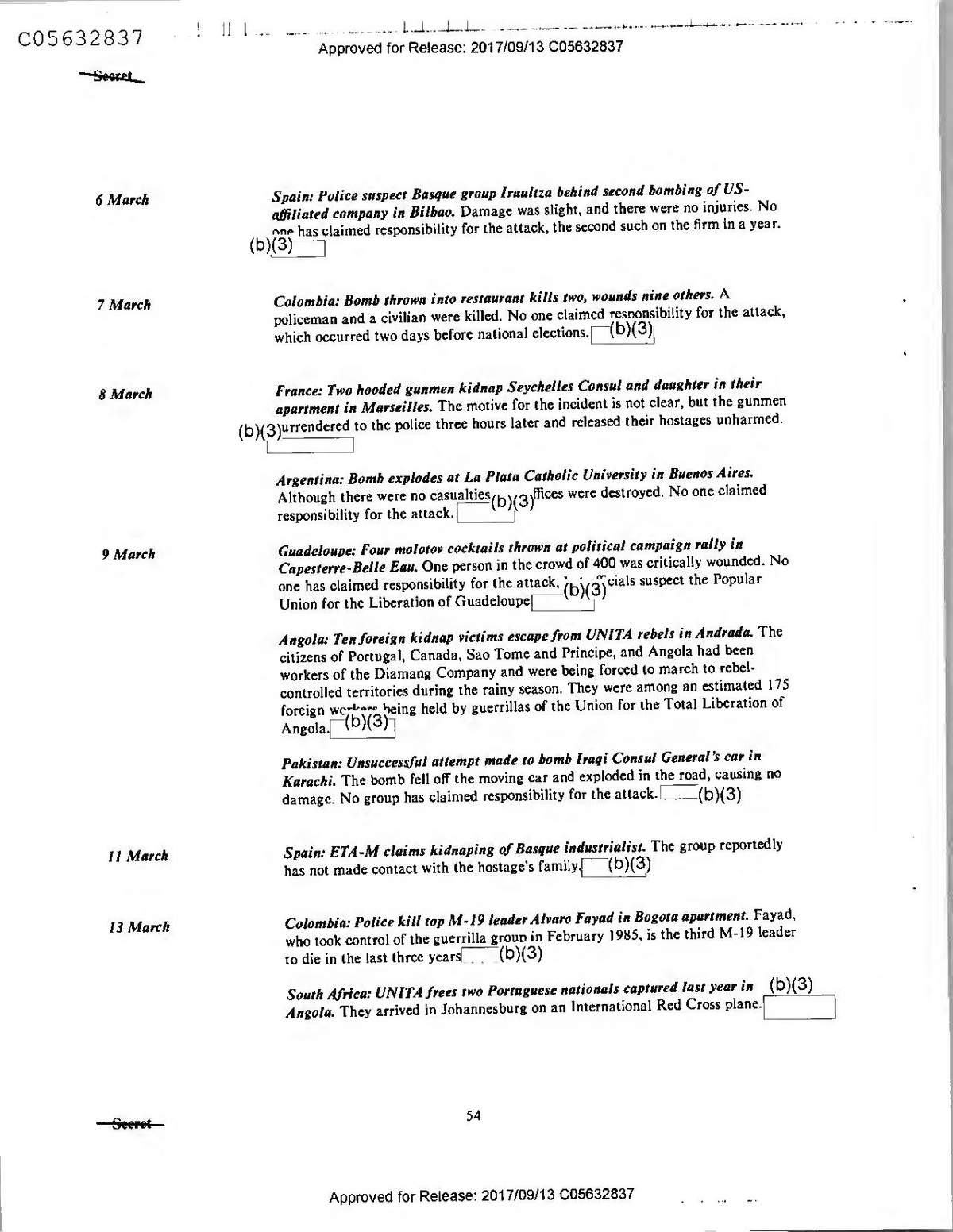
Secret
6 March
Spain: Police suspect Basque group Iraultza behind second bombing of USaffiliated company in Bilbao. Damage was slight, and there were no injuries. No
one has claimed responsibility for the attack, the second such on the firm in a year. (b)(3)
7 March
Colombia: Bomb thrown into restaurant kills two, wounds nine others. A policeman and a civilian were killed. No one claimed responsibility for the attack, which occurred two days before national elections. (b)(3)
8 March
France: Two hooded gunmen kidnap Seychelles ConsUL and daughter in their apartment in Marseilles. The motive for the incident is not clear, but the gunmen
(b)(3)urrendered to the police three hours later and released their hostages unharmed.
Argentina: Bomb explodes at La Plata Catholic University in Buenos Aires.
ffices were destroyed. No one claimed responsibility for the attack.
Although there were no casualties(b)(3) f
9 March
Guadeloupe: Four molotov cocktails thrown at political campaign rally in Capesterre-Belle Eau. One person in the crowd of 400 was critically wounded. No
one has claimed responsibility for the attack, (b)(35cials suspect the Popular
Union for the Liberation of Guadeloupe
Angola: Ten foreign kidnap victims escape from UNITA rebels in Andrada. The citizens of Portugal, Canada, Sao Tome and Principe, and Angola had been workers of the Diamang Company and were being forced to march to rebelcontrolled territories during the rainy season. They were among an estimated 175 foreign workers heing held by guerrillas of the Union for the Total Liberation of
Angola. (b)(3)7
Pakistan: UnsuccessfUL attempt made to bomb Iraqi ConsUL General's car in Karachi. The bomb fell off the moving car and exploded in the road, causing no damage. No group has claimed responsibility for the attack. (b)(3)
11 March
Spain: ETA-M claims kidnaping of Basque industrialist. The group reportedly has not made contact with the hostage's family. (b)(3)
13 March
Colombia: Police kill top (-19 leader Alvaro Fayad in Bogota apartment. Fayad, who took control of the guerrilla group in February 1985, is the third M-19 leader to die in the last three years (b)(3)
South Africa: UNITA frees two Portuguese nationals captured last year in (b)(3) Angola. They arrived in Johannesburg on an International Red Cross plane.
54
- Secret
Approved for Release: 2017/09/13 C05632837
Secret
14 March
(b)(3)
Spain: Alleged ETA terrorists and one policeman(b)(3) shootout in San Sebastian. One terrorist apparently escaped.|
Afghanistan: Bomb on bus kills eight, wounds nine in Herat. The explosion occurred two days before the seventh anniversary of a 127 arising in Herat. No one has claimed responsibility for the bombing.
"3
New Zealand: Police issue new arrest warrants for Rainbow Warrior suspects. New Zealand police suspect three French Army officers of chartering a yacht to transport the explosives used in the Rainbow Warrior attack. Previous warrants for the officers' arrest were issued under aliases the men assumed for the mission. (b)(3)
15 March
(b)(3)
France: Explosion destroys prefabricated building of Jeune Africa magazine in Paris. There were no casualties. Claims of responsibility were made on behalf of the previously unknown "Groupe Oriach" and the Charles Martel Club, an extreme rightist group.
(b)(3)
16 March
Portugal: Anonymous bomb threat interrupts Social Democratic Party meeting in Lisbon. The meeting was postponed until the following morning. (b)(3)
17 March
Peru: Unidentified gunmen attack Argentine Consulate in Lima with submachineguns and two homemade bombs that fail to ernlade. No injuries were reported, and there was no claim of responsibility. (b)(3)
18 March
Greece: Homemade bomb explodes at Hellenic American Union in Athens, causing little damage. Police inspecting the area found and disposed of a second,
responsibimty
- The leftis(b)(3]Revolutionary People's Struggle has claimed
India: United Akali Dal leader murdered on railroad tracks in Punjab. He was the elder stepbrother of Sikh leader Bhindranwale who was killed during the storming of the Golden Temple in June 1984. No one has claimed responsibility for the incident (b)(3)
55
- Secret
Approved for Release: 2017/09/13 C05632837
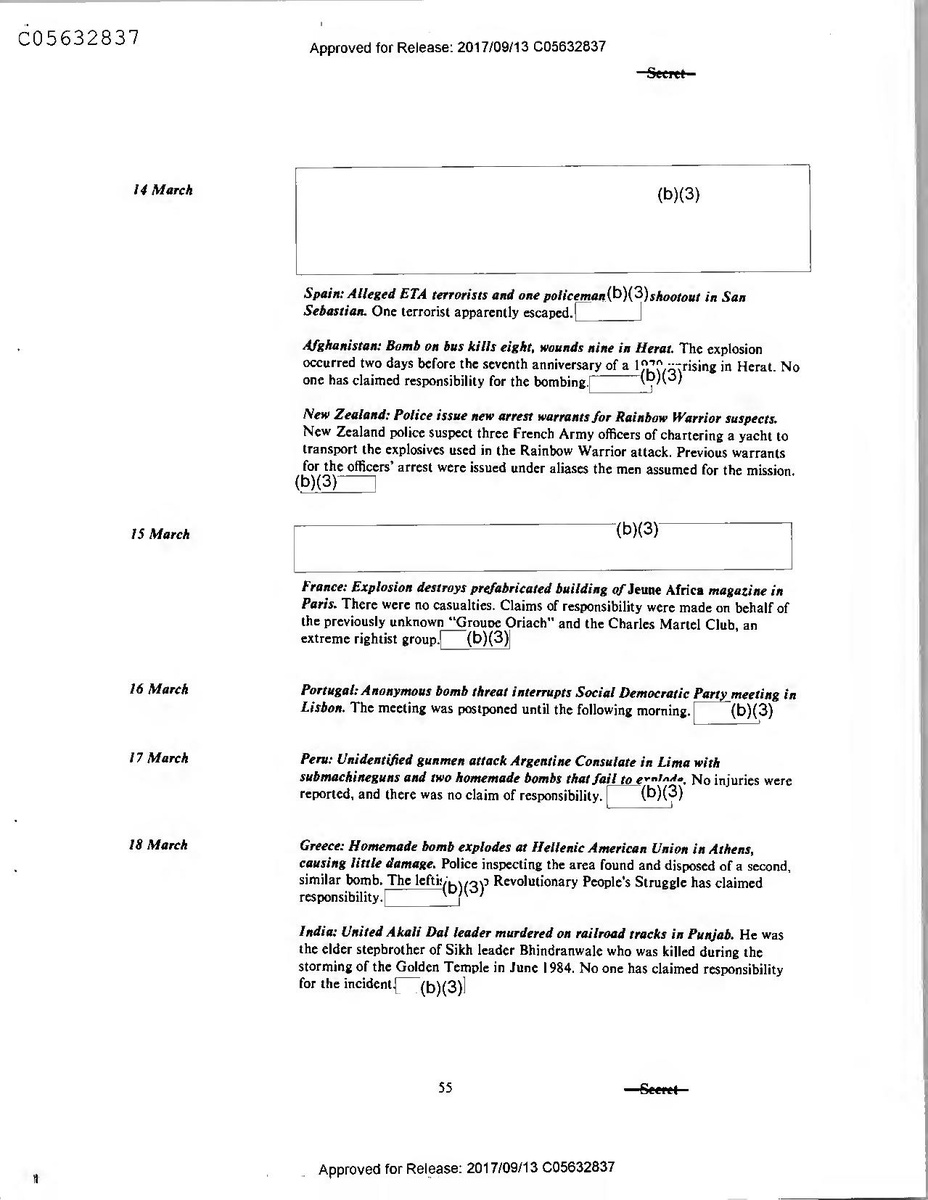
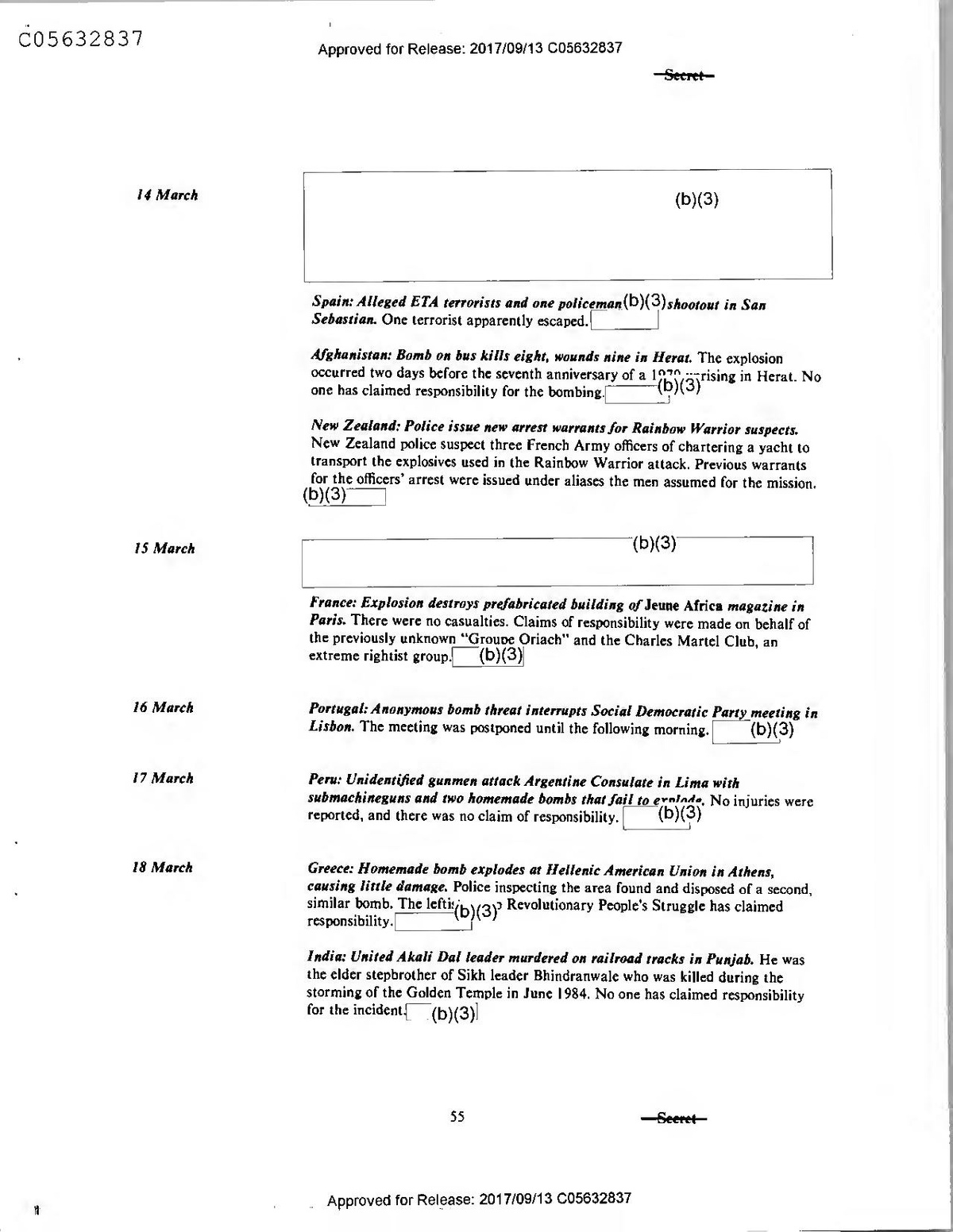
Secret
14 March
(b)(3)
Spain: Alleged ETA terrorists and one policeman(b)(3) shootout in San Sebastian. One terrorist apparently escaped.|
Afghanistan: Bomb on bus kills eight, wounds nine in Herat. The explosion occurred two days before the seventh anniversary of a 127 arising in Herat. No one has claimed responsibility for the bombing.
"3
New Zealand: Police issue new arrest warrants for Rainbow Warrior suspects. New Zealand police suspect three French Army officers of chartering a yacht to transport the explosives used in the Rainbow Warrior attack. Previous warrants for the officers' arrest were issued under aliases the men assumed for the mission. (b)(3)
15 March
(b)(3)
France: Explosion destroys prefabricated building of Jeune Africa magazine in Paris. There were no casualties. Claims of responsibility were made on behalf of the previously unknown "Groupe Oriach" and the Charles Martel Club, an extreme rightist group.
(b)(3)
16 March
Portugal: Anonymous bomb threat interrupts Social Democratic Party meeting in Lisbon. The meeting was postponed until the following morning. (b)(3)
17 March
Peru: Unidentified gunmen attack Argentine Consulate in Lima with submachineguns and two homemade bombs that fail to ernlade. No injuries were reported, and there was no claim of responsibility. (b)(3)
18 March
Greece: Homemade bomb explodes at Hellenic American Union in Athens, causing little damage. Police inspecting the area found and disposed of a second,
responsibimty
- The leftis(b)(3]Revolutionary People's Struggle has claimed
India: United Akali Dal leader murdered on railroad tracks in Punjab. He was the elder stepbrother of Sikh leader Bhindranwale who was killed during the storming of the Golden Temple in June 1984. No one has claimed responsibility for the incident (b)(3)
55
- Secret
Approved for Release: 2017/09/13 C05632837
Seerat
Japan: Moro National Liberation Front frees Japanese photographer in Manila. He was kidnaped in January 1985. No ransom was paid, but Japanese officials reportedly promised to provide medical aid to the Muslim population of the Philippines.[(b)(3))
20 March
West Germany: Stuttgart court sentences three alleged Red Army Faction members to lengthy prison terms. Christa Eckes was sentenced to eight years; Ingrid Jacobsmcier to nine years; and Manuela Happe to 15 years' irinjonment for membership in a terrorist organization and attempted murder.
(b)(3)
27 March
Australia: Car bomb explodes in front of Melbourne police station. At least 22 persons were injured, four of them seriously, by the massive bomb. Police believe it may have been intended to protest the trial testimony of a Mafia figure. (b)(3))
56
Secret
Approved for Release: 2017/09/13 C05632837
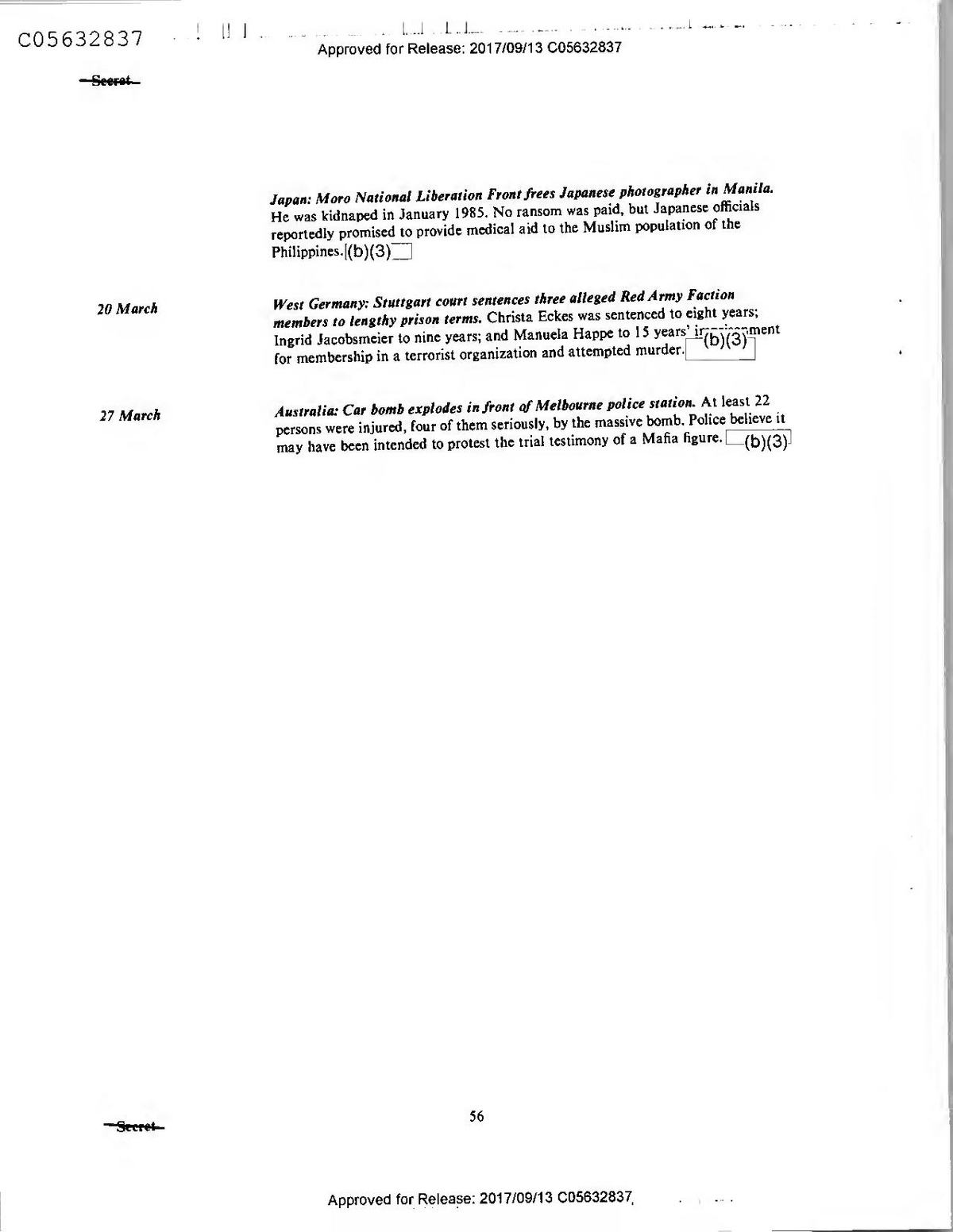
Seerat
Japan: Moro National Liberation Front frees Japanese photographer in Manila. He was kidnaped in January 1985. No ransom was paid, but Japanese officials reportedly promised to provide medical aid to the Muslim population of the Philippines.[(b)(3))
20 March
West Germany: Stuttgart court sentences three alleged Red Army Faction members to lengthy prison terms. Christa Eckes was sentenced to eight years; Ingrid Jacobsmcier to nine years; and Manuela Happe to 15 years' irinjonment for membership in a terrorist organization and attempted murder.
(b)(3)
27 March
Australia: Car bomb explodes in front of Melbourne police station. At least 22 persons were injured, four of them seriously, by the massive bomb. Police believe it may have been intended to protest the trial testimony of a Mafia figure. (b)(3))
56
Secret
Approved for Release: 2017/09/13 C05632837
Secret
1
Secret
Approved for Release: 2017/09/13 C05632837
Secret
1
Secret
Approved for Release: 2017/09/13 C05632837
TUJTIM Tigence Agency
INTELIGENCE
FIRE NO GI M 87-20122
3
RTVOLNdo
FILE
Washington D.C.20505
PD
13 JUL 1987
MEMORANDUM FOR:
Distribution
(b)(3)
SUBJECT:
The Continuing Soviet Disinformation Blitz
1.
At the request of Fritz Ermar th at the NSC, we have prepared a brief report describing recent Soviet disinformation activities. It illustrates that Moscow continues to publicize a wide range of anti-US allegations despite glasnost and (b)(3) reforms currently under way within the Soviet(b)(3jon. This memorandum was prepared by
Foreign Subversion and Instability Center, Office of Global Issues. comments or questions are welcome and may be directed to the Chief, Foreign Subversion and instability Center,
(b)(3)
2.
Your
(b)(3)
Chief, Foreign Subversion and Instability Center
Office of Global Issues Directorate of Intelligence
(b)(3)
Attachment:
The Continuing Soviet Disinformation Blitz GI M 87-20122, July 1987,
(b)(3).
(b)(3).
(b)(3)
(b)(3) SECRET
Approved for Release: 2017/09/13 C05798947
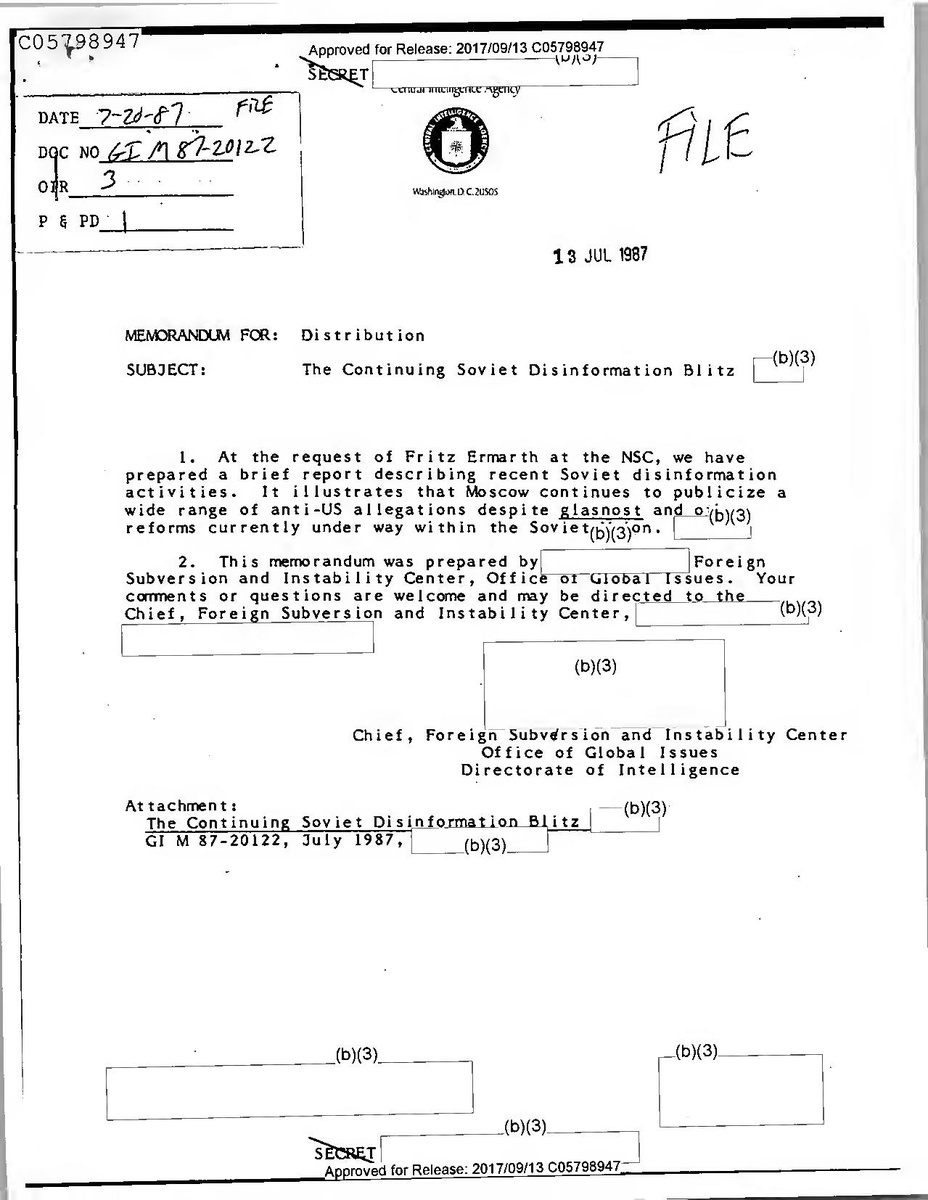
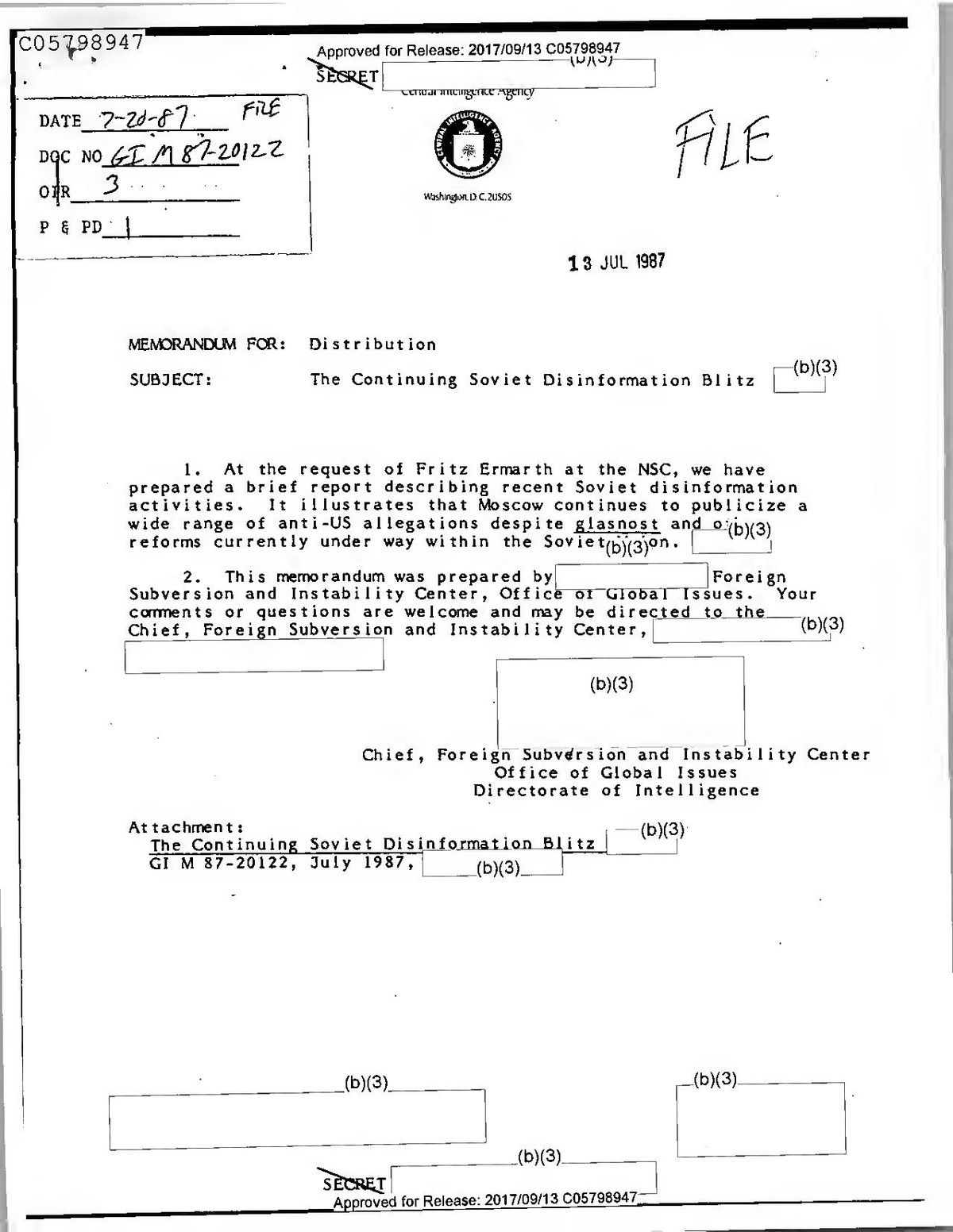
TUJTIM Tigence Agency
INTELIGENCE
FIRE NO GI M 87-20122
3
RTVOLNdo
FILE
Washington D.C.20505
PD
13 JUL 1987
MEMORANDUM FOR:
Distribution
(b)(3)
SUBJECT:
The Continuing Soviet Disinformation Blitz
1.
At the request of Fritz Ermar th at the NSC, we have prepared a brief report describing recent Soviet disinformation activities. It illustrates that Moscow continues to publicize a wide range of anti-US allegations despite glasnost and (b)(3) reforms currently under way within the Soviet(b)(3jon. This memorandum was prepared by
Foreign Subversion and Instability Center, Office of Global Issues. comments or questions are welcome and may be directed to the Chief, Foreign Subversion and instability Center,
(b)(3)
2.
Your
(b)(3)
Chief, Foreign Subversion and Instability Center
Office of Global Issues Directorate of Intelligence
(b)(3)
Attachment:
The Continuing Soviet Disinformation Blitz GI M 87-20122, July 1987,
(b)(3).
(b)(3).
(b)(3)
(b)(3) SECRET
Approved for Release: 2017/09/13 C05798947
Central Intelligence Agency
SADENCY
end
Washington, D.C. 20505
DIRECTORATE OF INTELLIGENCE
8 July 1987
(b)(3)
The Continuing Soviet Disinformation Blitz
Summary
Although Moscow claims to be reporting on its domestic problems with a new truthfulness, it continues to push a heavy agenda of anti-US disinformation at home and abroad. A. major thrust of this effort--often comprised of crude, blatantly ernotional appeals--has been to portray the United States as a practitioner of terrorism and subversion and a violator of human rights. Moscow also works hard at fostering opposition to US military bases and personnel overseas. The pace and scope of the USSR's disinformation activities --which have produced some benefits for Moscow--suggest that the Soviets will continue to
(hy[3ke advantage of opportunities, particularly in the Third World.
(b)(3)
This memorandum was prepared by
Office of Global Issues. Comments and queries are welcome and may be directed to the Chief, Foreign Subversion and instability Center, OGI,
(b)(3)
-(b)(3)
GI M 87-20122
(b)(3)
SEGRET
Approved for Release: 2017/09/13 C05798947
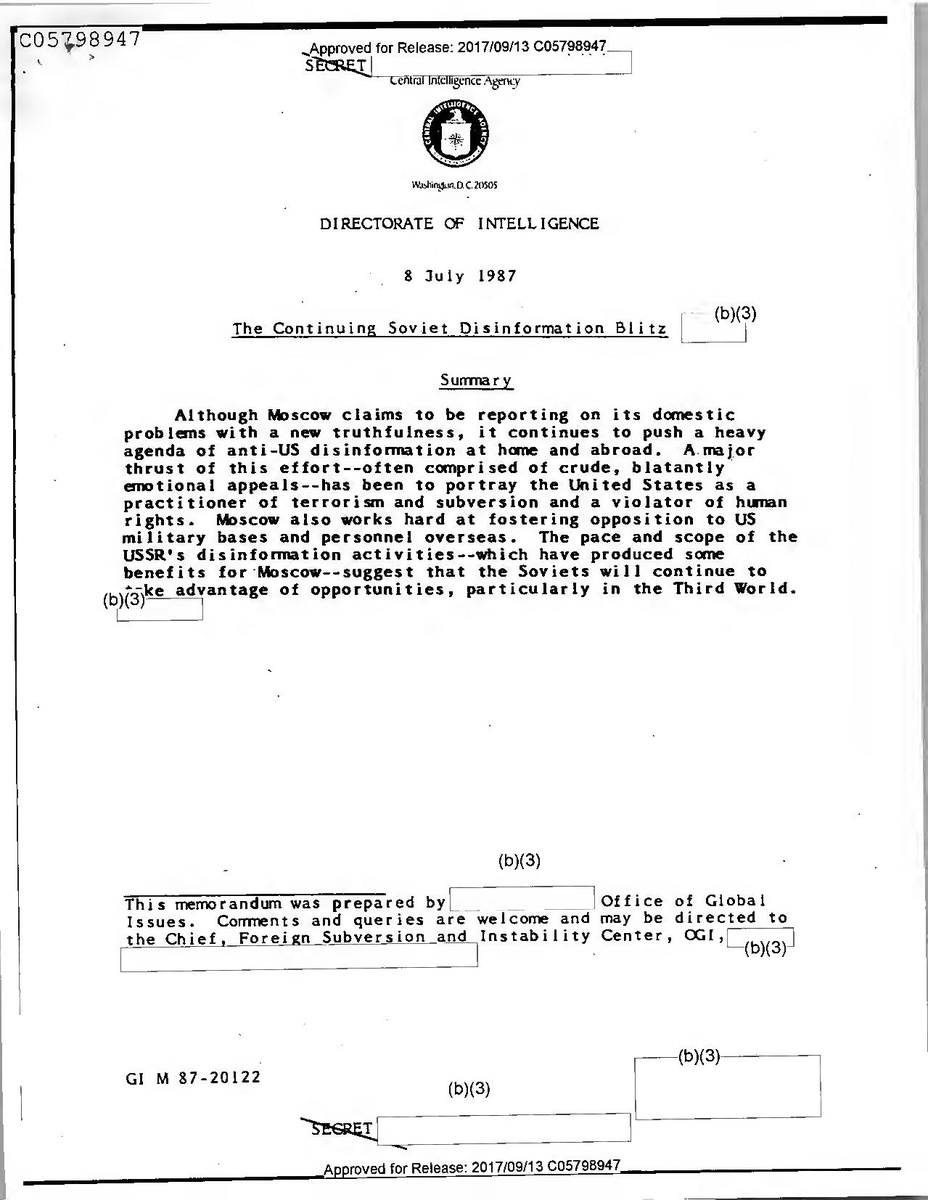
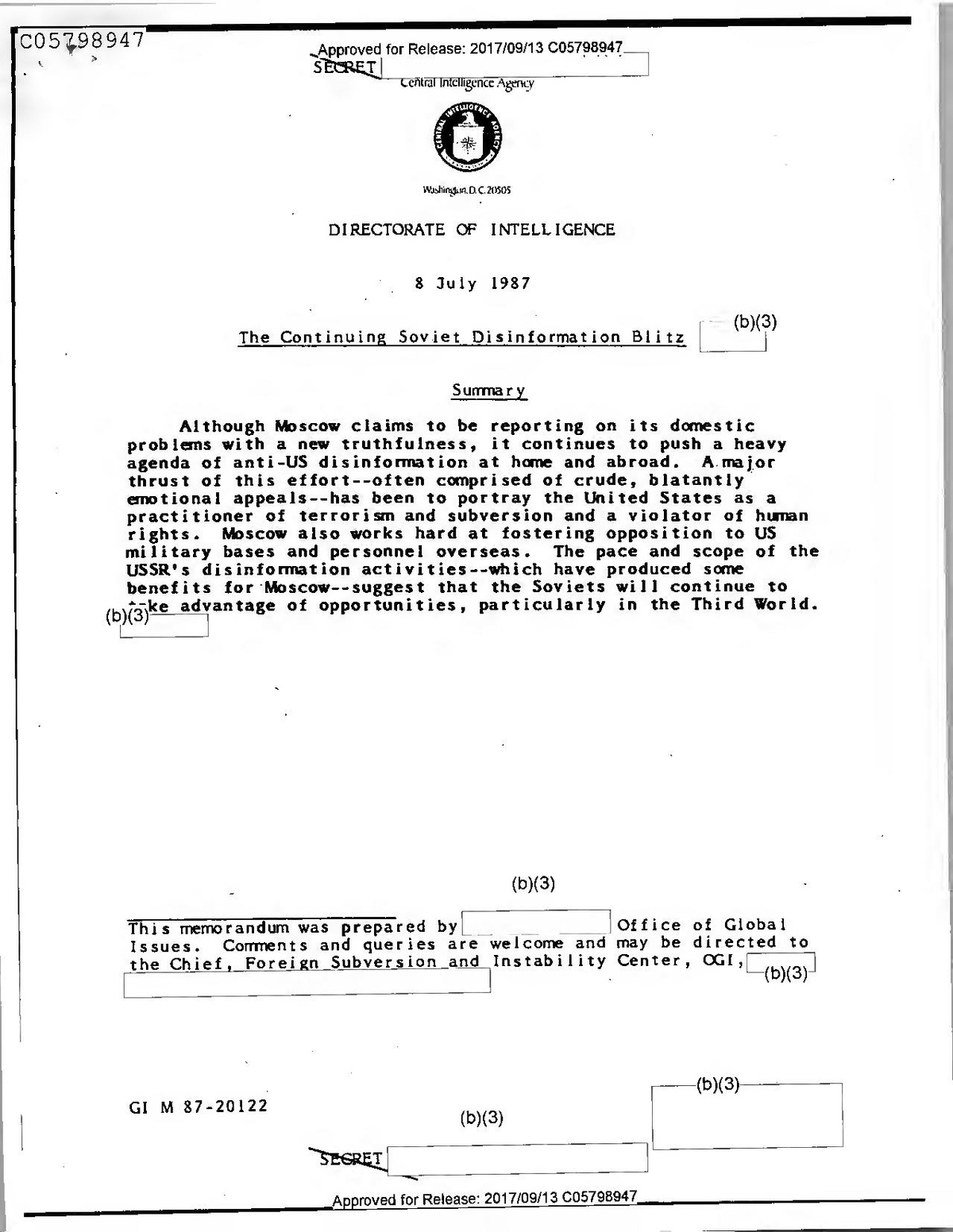
Central Intelligence Agency
SADENCY
end
Washington, D.C. 20505
DIRECTORATE OF INTELLIGENCE
8 July 1987
(b)(3)
The Continuing Soviet Disinformation Blitz
Summary
Although Moscow claims to be reporting on its domestic problems with a new truthfulness, it continues to push a heavy agenda of anti-US disinformation at home and abroad. A. major thrust of this effort--often comprised of crude, blatantly ernotional appeals--has been to portray the United States as a practitioner of terrorism and subversion and a violator of human rights. Moscow also works hard at fostering opposition to US military bases and personnel overseas. The pace and scope of the USSR's disinformation activities --which have produced some benefits for Moscow--suggest that the Soviets will continue to
(hy[3ke advantage of opportunities, particularly in the Third World.
(b)(3)
This memorandum was prepared by
Office of Global Issues. Comments and queries are welcome and may be directed to the Chief, Foreign Subversion and instability Center, OGI,
(b)(3)
-(b)(3)
GI M 87-20122
(b)(3)
SEGRET
Approved for Release: 2017/09/13 C05798947
SESRET
(b)(3)
The Continuing Soviet Disinformation Blitz
Countries:
A Favorite Soviet Theme: US Destabilization of Foreign Countries.
The Soviets have continued their campaign of many years that the United States is conspiring to destabilize foreign countries, particularly in the Third World, by sponsoring coups, assassinating political leaders, and conducting a variety of other subversive activities.
- Shortly after the military coup in Fiji in May, Radio Moscow, TASS and Izvestia all began to play up rumors of US involvement.
On 18 May, for example, Radio Moscow reported a statement by the Soviet-controlled World Peace Council -- which cited a leftist British newspaper -- that "former CIA Deputy Director" Walters was in Fiji when the plot was being planned and that US citizens participated in the event.
Moscow stepped up its disinformation campaign on 1 June with a TASS story implicating the CIA and US Secret Service. This report was replayed the next day in Zimbabwe and on 3 June in Uruguay.
- Since the February 1986 assassination of Swedish Prime Minister Olof Palme, Moscow has made a concerted effort to implicate the United States in his death. In addition to numerous Soviet and Bloc press accounts alleging US complicity in Palme's murder, Moscow produced a television docu-drama entitled "Why Did They Kill Olof Palme ?"
The film, shown this year in Sweden and the USSR, included accusations of CIA involvement in the shooting.
- The USSR also uses forgeries, rumors, anonymous mailings and other methods to conduct its disinformation campaign alleging CIA plans to destabilize Third World governments.
(b)(1) (b)(3)
In addition, US Embassy indicates that the KGB:
Planted a rumor in the Congo this spring alleging that Zairian President Mobutu intended to use the CIA to assassinate Congo President Sassou-Nguesso.
Circulated last year in India, Pakistan, Peru, Guyana and several African countries an unattributed pamphlet entitled "CIA Insider", which named alleged CIA agents and officers. (b)(3)
(b)(3)
GI M 87-20122
C2 (b)(3)
SECRET
Approved for Release: 2017/09/13 C05798947
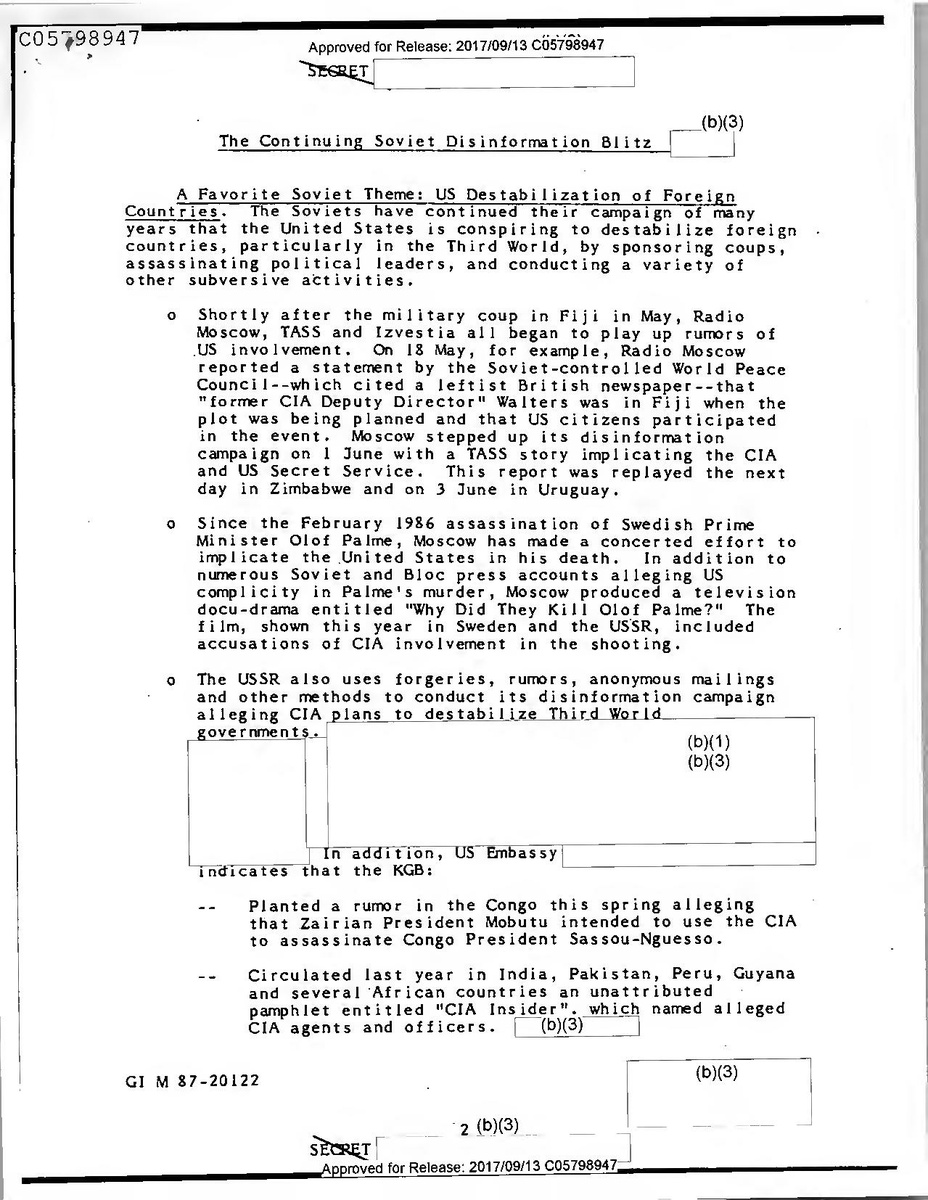
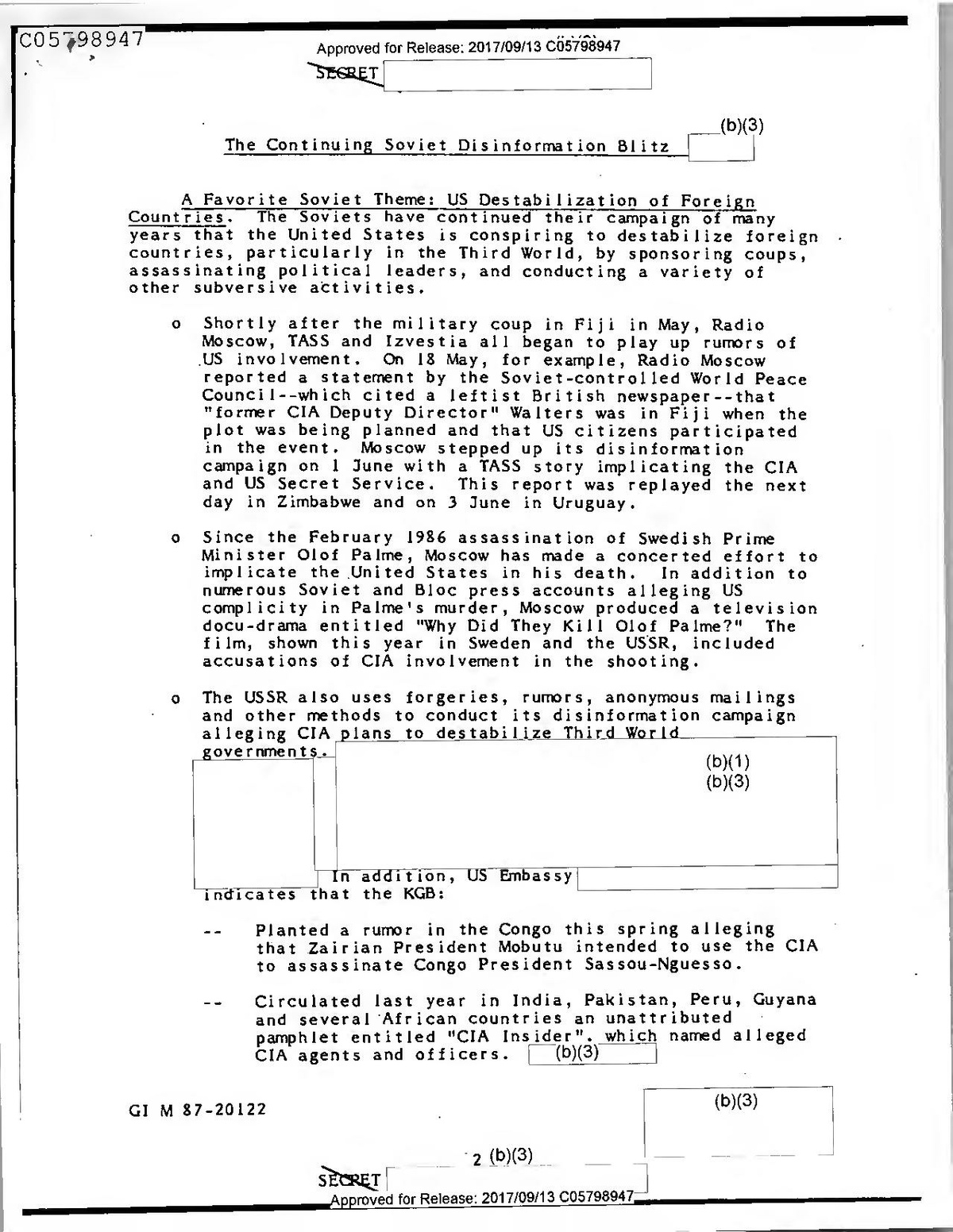
SESRET
(b)(3)
The Continuing Soviet Disinformation Blitz
Countries:
A Favorite Soviet Theme: US Destabilization of Foreign Countries.
The Soviets have continued their campaign of many years that the United States is conspiring to destabilize foreign countries, particularly in the Third World, by sponsoring coups, assassinating political leaders, and conducting a variety of other subversive activities.
- Shortly after the military coup in Fiji in May, Radio Moscow, TASS and Izvestia all began to play up rumors of US involvement.
On 18 May, for example, Radio Moscow reported a statement by the Soviet-controlled World Peace Council -- which cited a leftist British newspaper -- that "former CIA Deputy Director" Walters was in Fiji when the plot was being planned and that US citizens participated in the event.
Moscow stepped up its disinformation campaign on 1 June with a TASS story implicating the CIA and US Secret Service. This report was replayed the next day in Zimbabwe and on 3 June in Uruguay.
- Since the February 1986 assassination of Swedish Prime Minister Olof Palme, Moscow has made a concerted effort to implicate the United States in his death. In addition to numerous Soviet and Bloc press accounts alleging US complicity in Palme's murder, Moscow produced a television docu-drama entitled "Why Did They Kill Olof Palme ?"
The film, shown this year in Sweden and the USSR, included accusations of CIA involvement in the shooting.
- The USSR also uses forgeries, rumors, anonymous mailings and other methods to conduct its disinformation campaign alleging CIA plans to destabilize Third World governments.
(b)(1) (b)(3)
In addition, US Embassy indicates that the KGB:
Planted a rumor in the Congo this spring alleging that Zairian President Mobutu intended to use the CIA to assassinate Congo President Sassou-Nguesso.
Circulated last year in India, Pakistan, Peru, Guyana and several African countries an unattributed pamphlet entitled "CIA Insider", which named alleged CIA agents and officers. (b)(3)
(b)(3)
GI M 87-20122
C2 (b)(3)
SECRET
Approved for Release: 2017/09/13 C05798947
Directorate of Intelligence
ome
Secret
(b)(3)
Terrorism Review
(b)(3)
April 1986
Secret
DI TR 844005 April 1986
Copy 540
Approved for Release: 2017/09/13 C05632837
Directorate of Intelligence
ome
Secret
(b)(3)
Terrorism Review
(b)(3)
April 1986
Secret
DI TR 844005 April 1986
Copy 540
Approved for Release: 2017/09/13 C05632837
Human Rights Counteroffensive. Long sensitive to Western criticism of its human rights record, Moscow has recently intensified its efforts to denigrate the performance of the West on this issue.
O
The Soviets this year issued a series of charges --based on a book published by Novosti--claiming that the CIA instigated the 1978 Jones town massacre in order to prevent cult members from emigrating to the Soviet Union. Since the allegation was first publicized in the 30 January edition of Izvestia, it has been replayed in the proSoviet Indian press and in the Communist press of Uruguay and East Germany. Moreover, the Novosti book has been reviewed in the Finnish and Danish press, thereby adding credibility to the story.
o
The publicity given in Soviet Bloc media and in Soviet disinformation outlets over seas, leads us to believe that Moscow is behind a recent campaign alleging US trafficking in Central American children for the purpose of using them in organ transplant operations. This campaign appears to have considerable momentum: Since the beginning of the year, these charges have appeared not only in Soviet, Cuban, Nicaraguan and Yugoslav media, but also in the press of the Dominican Republic, France, Guatemala, Honduras and India.
O
In an effort to exploit the apartheid issue, the USSR is continuing to push allegations--begun in the early 1980s -- that the United States and South Africa are conducting research on a so-called ethnic weapon--a biological weapon designed to kill people selectively on the basis of
Radio Moscow again charged in February, for example, that the ethnic bornould kill blacks but "leave out the white race."
(b)(3)
race.
Targeting the US Military. The Soviets also have an aggressive disinformation program targeting the US military presence overseas.
O
In our view, a central element of this effort is Moscow's worldwide campaign, begun in October 1985, charging that AIDS is the result of US biological warfare experiments. During the past several months the USSR has repeatedly used the AIDS story as a means of heightening opposition to US military bases, troops, and port access rights around the globe:
3(b)(3)
SESRET
Approved for Release: 2017/09/13 C05798947
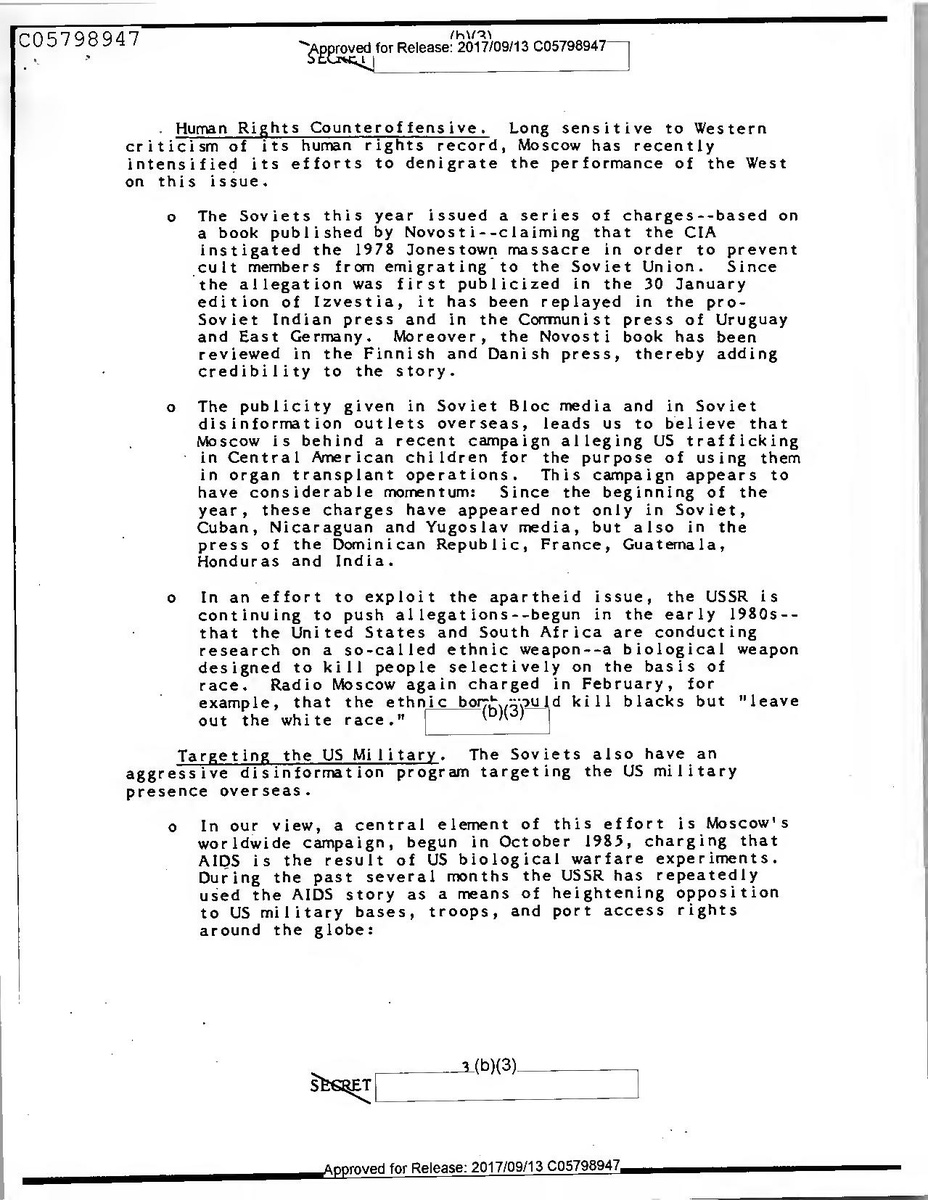
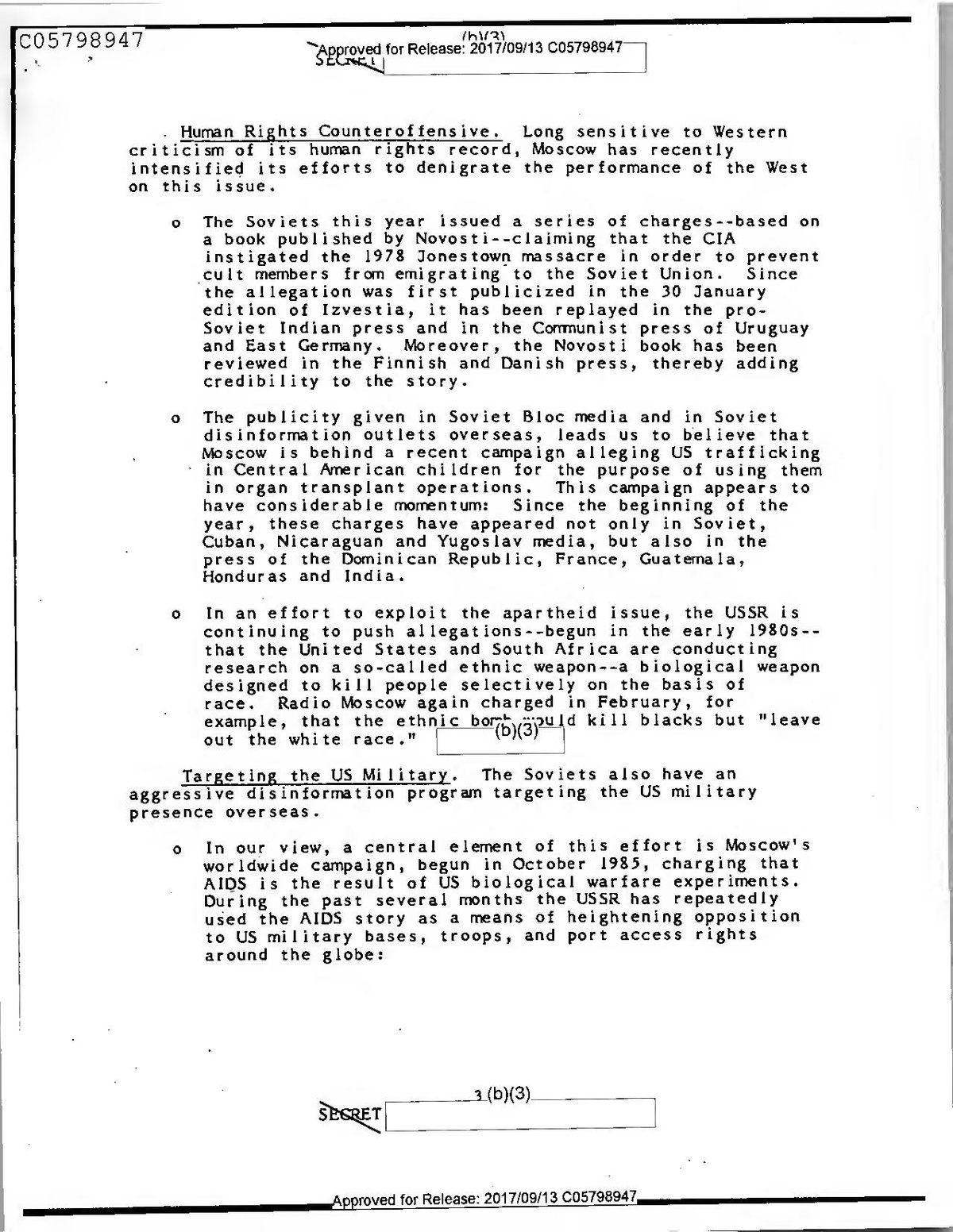
Human Rights Counteroffensive. Long sensitive to Western criticism of its human rights record, Moscow has recently intensified its efforts to denigrate the performance of the West on this issue.
O
The Soviets this year issued a series of charges --based on a book published by Novosti--claiming that the CIA instigated the 1978 Jones town massacre in order to prevent cult members from emigrating to the Soviet Union. Since the allegation was first publicized in the 30 January edition of Izvestia, it has been replayed in the proSoviet Indian press and in the Communist press of Uruguay and East Germany. Moreover, the Novosti book has been reviewed in the Finnish and Danish press, thereby adding credibility to the story.
o
The publicity given in Soviet Bloc media and in Soviet disinformation outlets over seas, leads us to believe that Moscow is behind a recent campaign alleging US trafficking in Central American children for the purpose of using them in organ transplant operations. This campaign appears to have considerable momentum: Since the beginning of the year, these charges have appeared not only in Soviet, Cuban, Nicaraguan and Yugoslav media, but also in the press of the Dominican Republic, France, Guatemala, Honduras and India.
O
In an effort to exploit the apartheid issue, the USSR is continuing to push allegations--begun in the early 1980s -- that the United States and South Africa are conducting research on a so-called ethnic weapon--a biological weapon designed to kill people selectively on the basis of
Radio Moscow again charged in February, for example, that the ethnic bornould kill blacks but "leave out the white race."
(b)(3)
race.
Targeting the US Military. The Soviets also have an aggressive disinformation program targeting the US military presence overseas.
O
In our view, a central element of this effort is Moscow's worldwide campaign, begun in October 1985, charging that AIDS is the result of US biological warfare experiments. During the past several months the USSR has repeatedly used the AIDS story as a means of heightening opposition to US military bases, troops, and port access rights around the globe:
3(b)(3)
SESRET
Approved for Release: 2017/09/13 C05798947
In February, a Ukrainian paper claimed that the Japanese were panicking over the spread of AIDS by US servicemen in Japan and that restaurants, barber shops, and other businesses near US bases had barred Americans from entering.
We suspect the Soviets were responsible for a forged press release surfaced in May in West Berlin in which a city health official purportedly announced that the US Army hospital there was overflowing with AIDS victims.
o
Moscow has also surfaced allegations that some existing US military facilities will be used in the Strategic Defense Initiative (SDI) program and that the United States is attempting to acquire new bases in order to destabilize particular regions :
In March the Indian press ran an article on Soviet. charges--attempting to play upon regional sensitivity about military use of Diego Garcia--that the United States produced SDI components there.
Soviet radio charged in April that joint US -Zaire military maneuvers reflected a US interest in using the Kamina air force base(b)(3) southern Zaire to destabilize the region.
In our view, several trends charcterize recent Soviet disinformation activity.
o
The Soviets are persistent. In pushing a given theme, Soviet disinformation specialists apparently believe that repetition of even the most unbelievable stories pays off in the long run. Indeed, Soviet charges that AIDS was developed at Fort De trick have been replayed in the press of over 60 countries. In April these allegations appeared in the official Indian armed forces journal "Sainik Samachar."
o
Within three
The Soviets seize on opportunities quickly. days after the coup in Fiji, for example, Radio Moscow, Izvestia, and TASS all carried stories implying US involvement.
O
Moscow targets much of its disinformation toward Third World audiences. During the past year, we have seen a concerted Soviet effort--in part through forgeries and disinformation--to intensify anti-US sentiment within the Nona ligned Movement, whose criticism of the United States and backing of many Soviet positions Moscow believes is a major political asset. There is also evidence that the Soviets are working hard to exploit growing political and
4
(b)(3)
SECRET
Approved for Release: 2017/09/13 C05798947
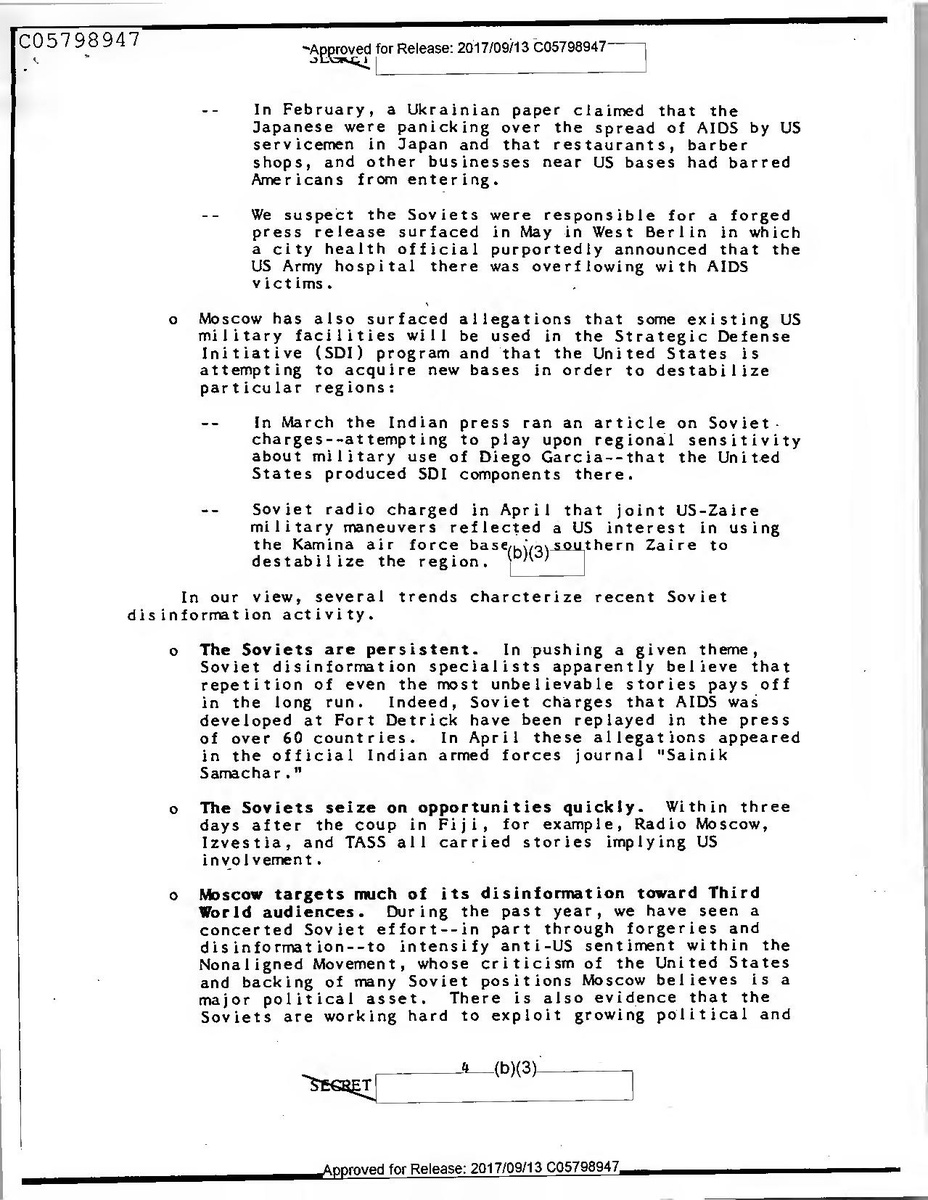
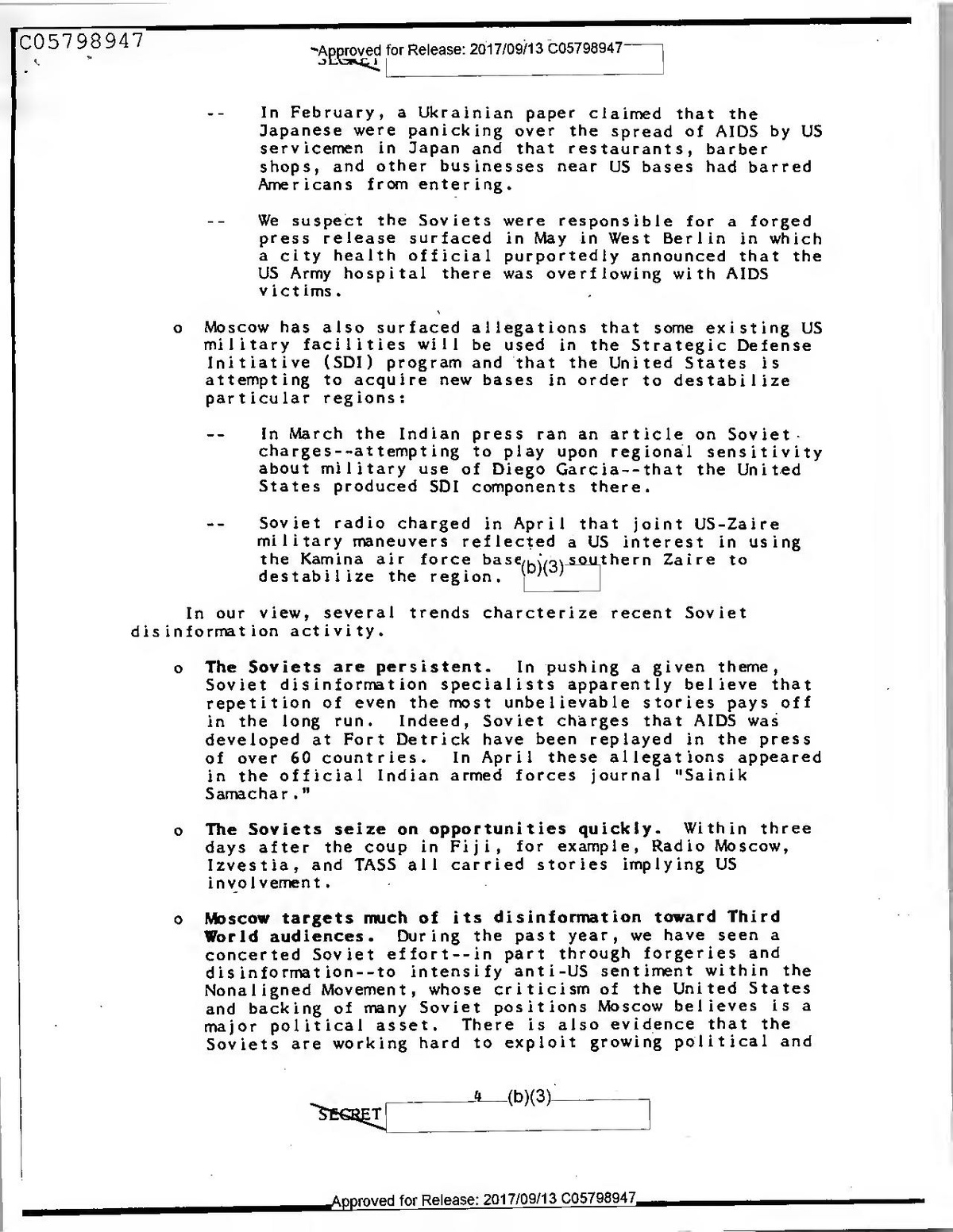
In February, a Ukrainian paper claimed that the Japanese were panicking over the spread of AIDS by US servicemen in Japan and that restaurants, barber shops, and other businesses near US bases had barred Americans from entering.
We suspect the Soviets were responsible for a forged press release surfaced in May in West Berlin in which a city health official purportedly announced that the US Army hospital there was overflowing with AIDS victims.
o
Moscow has also surfaced allegations that some existing US military facilities will be used in the Strategic Defense Initiative (SDI) program and that the United States is attempting to acquire new bases in order to destabilize particular regions :
In March the Indian press ran an article on Soviet. charges--attempting to play upon regional sensitivity about military use of Diego Garcia--that the United States produced SDI components there.
Soviet radio charged in April that joint US -Zaire military maneuvers reflected a US interest in using the Kamina air force base(b)(3) southern Zaire to destabilize the region.
In our view, several trends charcterize recent Soviet disinformation activity.
o
The Soviets are persistent. In pushing a given theme, Soviet disinformation specialists apparently believe that repetition of even the most unbelievable stories pays off in the long run. Indeed, Soviet charges that AIDS was developed at Fort De trick have been replayed in the press of over 60 countries. In April these allegations appeared in the official Indian armed forces journal "Sainik Samachar."
o
Within three
The Soviets seize on opportunities quickly. days after the coup in Fiji, for example, Radio Moscow, Izvestia, and TASS all carried stories implying US involvement.
O
Moscow targets much of its disinformation toward Third World audiences. During the past year, we have seen a concerted Soviet effort--in part through forgeries and disinformation--to intensify anti-US sentiment within the Nona ligned Movement, whose criticism of the United States and backing of many Soviet positions Moscow believes is a major political asset. There is also evidence that the Soviets are working hard to exploit growing political and
4
(b)(3)
SECRET
Approved for Release: 2017/09/13 C05798947
economic tensions in southern Africa, using forgeries as their primary vehicle. Through this mechanism, Moscow has alleged US coup plotting against several black African states; US-South African cooperation; and US circumvention of the arms embargo against South Africa.
O
Soviet disinformation is often crude.
Despite glasnost at home and an increasingly sophisticated use of propaganda and public diplomacy, much Soviet disinformation continues to be comprised of crude, blatantly emotional appeals. As evidenced by the AIDS and baby trafficking campa i gns, Moscow is apparently convinced that this approach can be effective, particularly in the Third World.
O
The level of activity appears to be increasing. While difficult to gauge, the level of Soviet dis information activity appears to be on the rise, as evidenced by the number of known or suspected Soviet forgeries that have publicly surfaced in the past 18 months. Typically in the past we have seen about 10-15 of such forgeries each year, but for the 1986-87 period we are seeing a rate of about 20 per year :
(b)(1) (b)(3)
Although the impact of Soviet disinformation cannot be me a sured precisely, we believe Moscow has reaped some benefits.
o
US officials have been forced to protest a barrage of 'anti-US AIDS disinformation stories throughout the Third World.
o
In India, where Moscow's most common theme alleges that the United States is conspiring to destabilize the country by supporting the Sikh and other separatist movements, Indians overwhelmingly believe that Washington is the single largest promo ter of international terrorism, according to public opinion data from 1985.
o
O
According to press reporting, the ousted prime minister of Fiji said in a june interview in Washington that he had "strong suspicions" of US involvement in the coup and called for a Congressional inquiry. Moscow's anti-CIA program--particularly the lists of alleged CIA officers and agents--has intimidated and cast suspicion on many people. For example, the US Embassy in Kinshasa reports that an editor of a Zairean news paper who was a contact of USIS feared that the government's security service would interrogate him after his name appeared on a list of CIA agents. (b)(3)
5_(b)(3)
SECRET
Approved for Release: 2017/09/13 C05798947
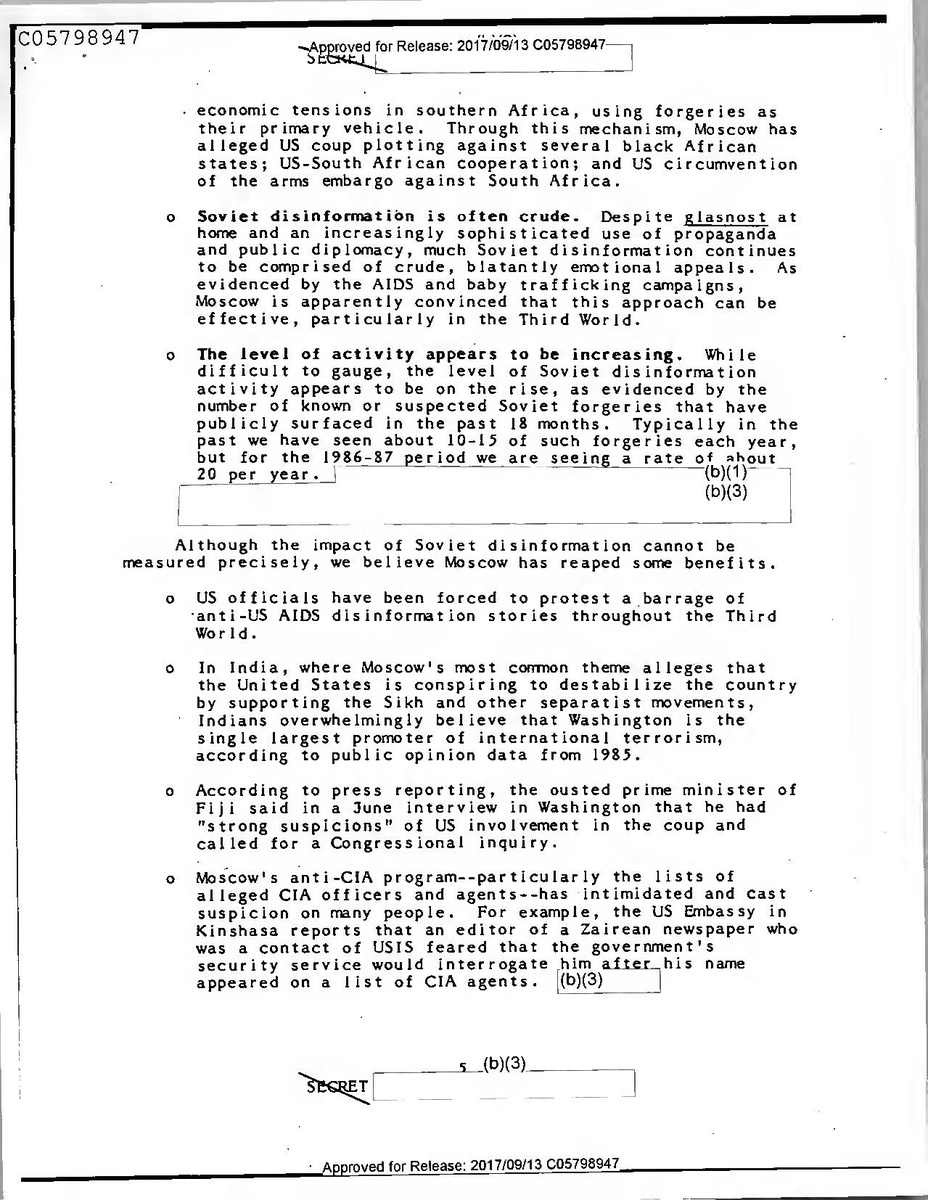
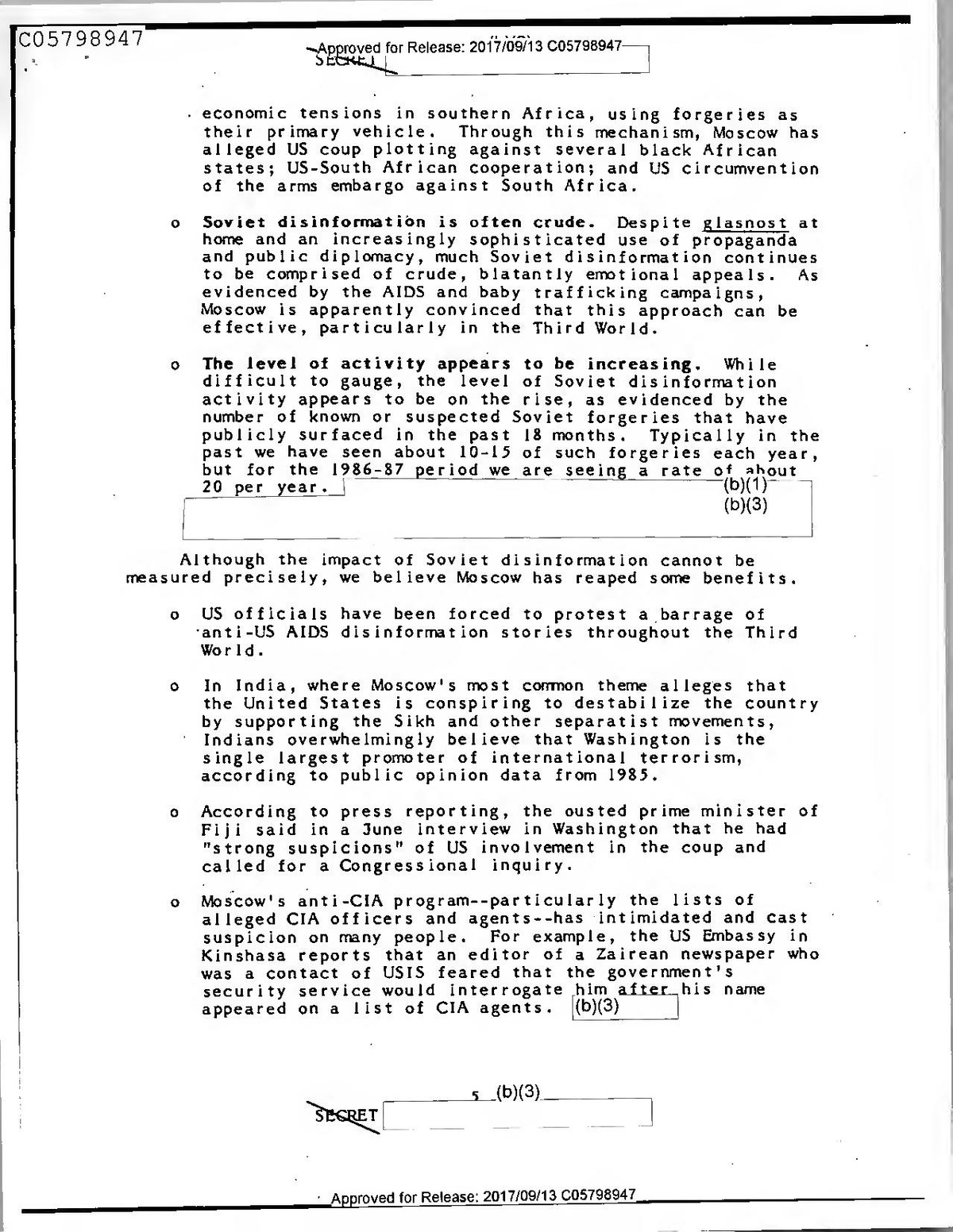
economic tensions in southern Africa, using forgeries as their primary vehicle. Through this mechanism, Moscow has alleged US coup plotting against several black African states; US-South African cooperation; and US circumvention of the arms embargo against South Africa.
O
Soviet disinformation is often crude.
Despite glasnost at home and an increasingly sophisticated use of propaganda and public diplomacy, much Soviet disinformation continues to be comprised of crude, blatantly emotional appeals. As evidenced by the AIDS and baby trafficking campa i gns, Moscow is apparently convinced that this approach can be effective, particularly in the Third World.
O
The level of activity appears to be increasing. While difficult to gauge, the level of Soviet dis information activity appears to be on the rise, as evidenced by the number of known or suspected Soviet forgeries that have publicly surfaced in the past 18 months. Typically in the past we have seen about 10-15 of such forgeries each year, but for the 1986-87 period we are seeing a rate of about 20 per year :
(b)(1) (b)(3)
Although the impact of Soviet disinformation cannot be me a sured precisely, we believe Moscow has reaped some benefits.
o
US officials have been forced to protest a barrage of 'anti-US AIDS disinformation stories throughout the Third World.
o
In India, where Moscow's most common theme alleges that the United States is conspiring to destabilize the country by supporting the Sikh and other separatist movements, Indians overwhelmingly believe that Washington is the single largest promo ter of international terrorism, according to public opinion data from 1985.
o
O
According to press reporting, the ousted prime minister of Fiji said in a june interview in Washington that he had "strong suspicions" of US involvement in the coup and called for a Congressional inquiry. Moscow's anti-CIA program--particularly the lists of alleged CIA officers and agents--has intimidated and cast suspicion on many people. For example, the US Embassy in Kinshasa reports that an editor of a Zairean news paper who was a contact of USIS feared that the government's security service would interrogate him after his name appeared on a list of CIA agents. (b)(3)
5_(b)(3)
SECRET
Approved for Release: 2017/09/13 C05798947
CONFIDENTIAL
SUBJECT:
(b)(3)
The Continuing Disinformation Blitz
(b)(3)
OGI/FSIC/ AM
(8 JUL 87)
Distribution:
1 Dr. Kathleen Bailey, St;
5+{b}(3)
(b)(3)
1 SA/DDCI 1 ExDir 1 NIO/USSR-EE, 7E47 1 Acting NIO/FDIA, 7E47
DDO/PPS DDO/PPS SOVA/SIG/SPU,
C/DDO/PPS, 3DO I 1 - DDI I - ADDI | - DDI Registry 1 DDI /PES 1 CPAS/ ISS 1 DIOGI ,DD/OGI 1 OGI/PG/Ch 3 OGI / EXS/PG 5 CPAS/CB (7G07) 1 C/FSIC/OGI 3 C/FSIC/AM
CONFIDENTIAL
(b)(3)
Approved for Release: 2017/09/13 C05798947
CONFIDENTIAL
SUBJECT:
(b)(3)
The Continuing Disinformation Blitz
(b)(3)
OGI/FSIC/ AM
(8 JUL 87)
Distribution:
1 Dr. Kathleen Bailey, St;
5+{b}(3)
(b)(3)
1 SA/DDCI 1 ExDir 1 NIO/USSR-EE, 7E47 1 Acting NIO/FDIA, 7E47
DDO/PPS DDO/PPS SOVA/SIG/SPU,
C/DDO/PPS, 3DO I 1 - DDI I - ADDI | - DDI Registry 1 DDI /PES 1 CPAS/ ISS 1 DIOGI ,DD/OGI 1 OGI/PG/Ch 3 OGI / EXS/PG 5 CPAS/CB (7G07) 1 C/FSIC/OGI 3 C/FSIC/AM
CONFIDENTIAL
(b)(3)
Approved for Release: 2017/09/13 C05798947
(b)(3)
Approved for Release: 2017/09/13 C05857509
(b)(3)
Approved for Release: 2017/09/13 C05857509
Intelligence
-(b)(3)WAND
AND
DET
(b)(3)
(b)(3)
Leadership Review
July 1988
Secret
LDA LR 88-008 July 1988
Copy 476
Approved for Release: 2017/09/13 C05857509
Intelligence
-(b)(3)WAND
AND
DET
(b)(3)
(b)(3)
Leadership Review
July 1988
Secret
LDA LR 88-008 July 1988
Copy 476
Approved for Release: 2017/09/13 C05857509
Warning Notice
Intelligence Sources or Methods Involved (WNINTEL)
National Security Information
Unauthorized Disclosure Subject to Criminal Sanctions
Dissemination Control Abbreviations
NOFORN (NF) NOCONTRACT (NC) PROPIN (PR) ORCON (OC)
Not releasable to foreign nationals Not releasable to contractors or contractor/consultants Caution-proprietary information involved Dissemination and extraction of information controlled by originator
+
This information has been authorized for release to...
REL... WN
WNINTEL-Intelligence sources or methods involved
(b)(3)
All material on this page is Unclassified.
Approved for Release: 2017/09/13 C05857509
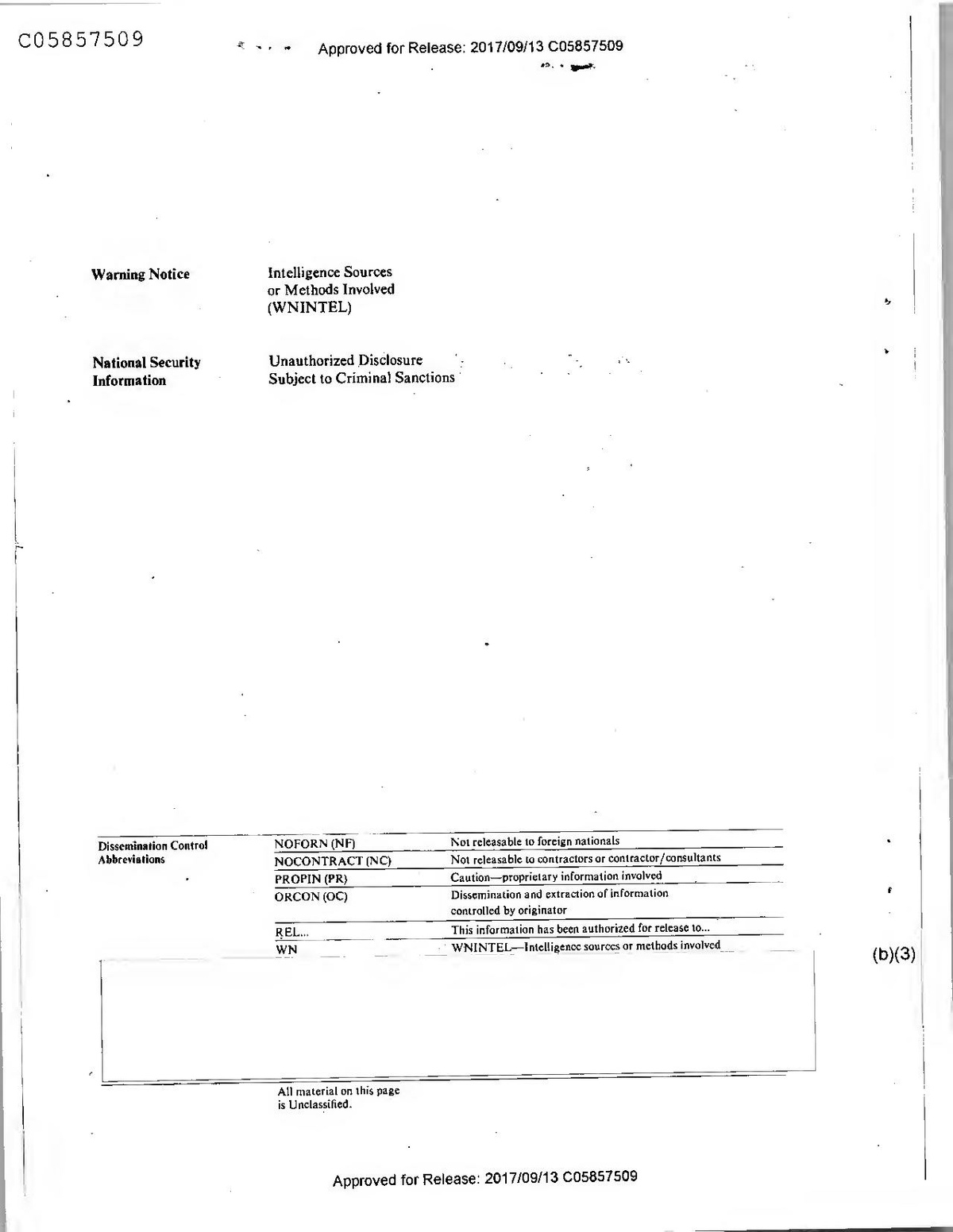
Warning Notice
Intelligence Sources or Methods Involved (WNINTEL)
National Security Information
Unauthorized Disclosure Subject to Criminal Sanctions
Dissemination Control Abbreviations
NOFORN (NF) NOCONTRACT (NC) PROPIN (PR) ORCON (OC)
Not releasable to foreign nationals Not releasable to contractors or contractor/consultants Caution-proprietary information involved Dissemination and extraction of information controlled by originator
+
This information has been authorized for release to...
REL... WN
WNINTEL-Intelligence sources or methods involved
(b)(3)
All material on this page is Unclassified.
Approved for Release: 2017/09/13 C05857509
(b)(3)
Leadership Review
(b)(3)
July 1988
NR
i
Secret
Approved for Release: 2017/09/13 C05857509
(b)(3)
Leadership Review
(b)(3)
July 1988
NR
i
Secret
Approved for Release: 2017/09/13 C05857509
Secret
(b)(3)
NR
Secret
ii
Approved for Release: 2017/09/13 C05857509
Secret
(b)(3)
NR
Secret
ii
Approved for Release: 2017/09/13 C05857509
(NR
iii
Secret
Approved for Release: 2017/09/13 C05857509
(NR
iii
Secret
Approved for Release: 2017/09/13 C05857509
Warning Notice
Intelligence Sources or Methods Involved (WNINTEL)
National Security Information
Unauthorized Disclosure Subject to Criminal Sanctions
Dissemination Control Abbreviations
NOFORN (NF) NOCONTRACT (NC) PROPIN (PR) ORCON (OC)
Not releasable to foreign nationals Not releasable to contractors or contractor/consultants Caution--proprietary information involved Dissemination and extraction of information controlled by originator This information has been authorized for release to... WNINTEL-Intelligence sources methods involved
REL...
WN
(b)(3)
All material on this page is Unclassified.
Approved for Release: 2017/09/13 C05632837
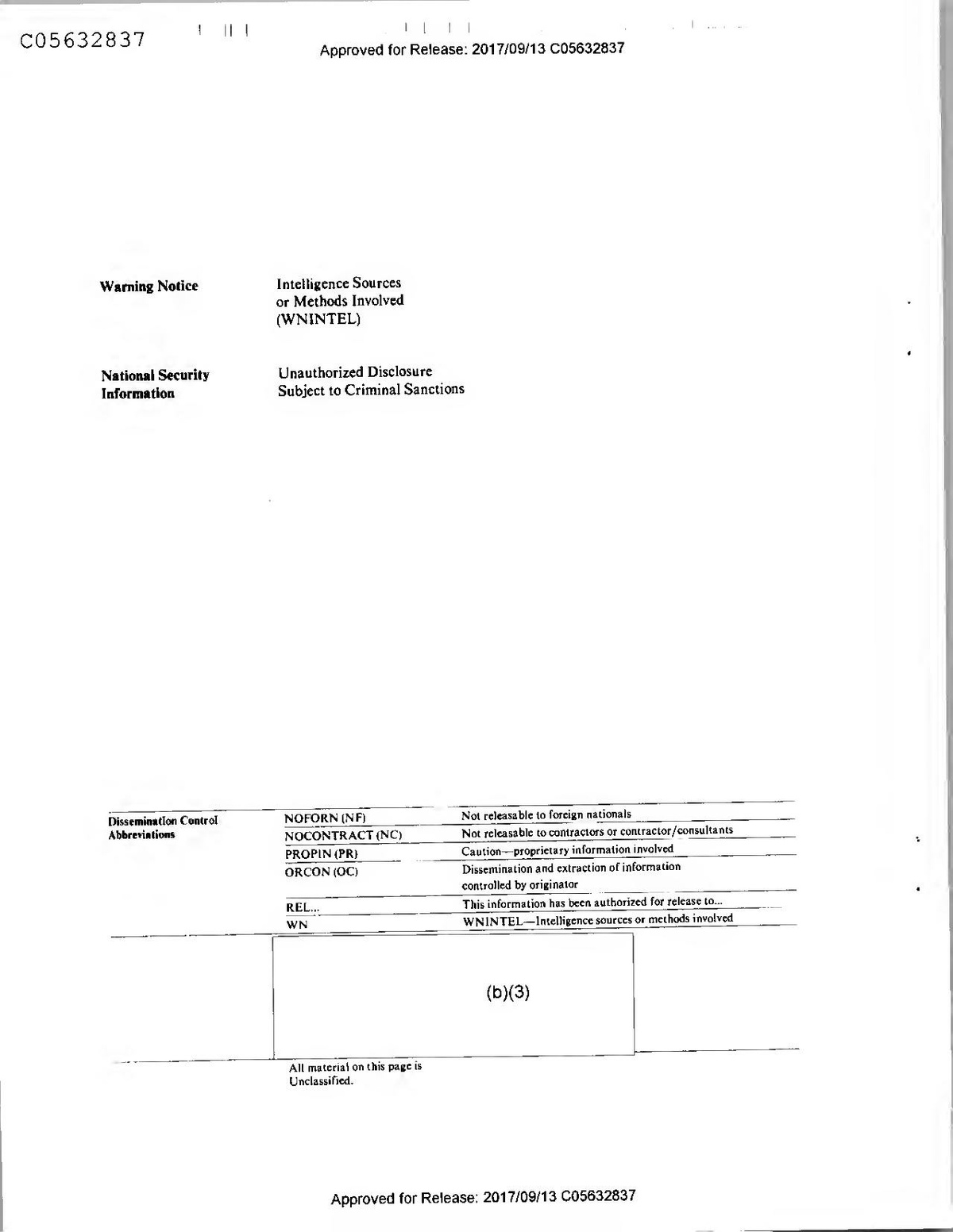
Warning Notice
Intelligence Sources or Methods Involved (WNINTEL)
National Security Information
Unauthorized Disclosure Subject to Criminal Sanctions
Dissemination Control Abbreviations
NOFORN (NF) NOCONTRACT (NC) PROPIN (PR) ORCON (OC)
Not releasable to foreign nationals Not releasable to contractors or contractor/consultants Caution--proprietary information involved Dissemination and extraction of information controlled by originator This information has been authorized for release to... WNINTEL-Intelligence sources methods involved
REL...
WN
(b)(3)
All material on this page is Unclassified.
Approved for Release: 2017/09/13 C05632837
(b)(3)
NR
F(b)(3)
Sweden: Carlsson Under Fire
43
NR
Secret
iv
Approved for Release: 2017/09/13 C05857509
(b)(3)
NR
F(b)(3)
Sweden: Carlsson Under Fire
43
NR
Secret
iv
Approved for Release: 2017/09/13 C05857509
(b)(3)
NR
1
Hasret LDA LR 88-008 July 1988
Approved for Release: 2017/09/13 C05857509
(b)(3)
NR
1
Hasret LDA LR 88-008 July 1988
Approved for Release: 2017/09/13 C05857509
Seecet
NR
Desret
2
Approved for Release: 2017/09/13 C05857509
Seecet
NR
Desret
2
Approved for Release: 2017/09/13 C05857509
NR
3
Secret
Reverse Blank
Approved for Release: 2017/09/13 C05857509
NR
3
Secret
Reverse Blank
Approved for Release: 2017/09/13 C05857509
Approved for Release: 2017/09/13 C05857509
Approved for Release: 2017/09/13 C05857509
Desret
NR
5
Secret LDA LR 88-008 July 1988
Approved for Release: 2017/09/13 C05857509
Desret
NR
5
Secret LDA LR 88-008 July 1988
Approved for Release: 2017/09/13 C05857509
Secret
NR
Secret
6
Approved for Release: 2017/09/13 C05857509
Secret
NR
Secret
6
Approved for Release: 2017/09/13 C05857509
Secret
NR
7
Secret
Approved for Release: 2017/09/13 C05857509
Secret
NR
7
Secret
Approved for Release: 2017/09/13 C05857509
Secret
NR
Secret
8
Approved for Release: 2017/09/13 C05857509
Secret
NR
Secret
8
Approved for Release: 2017/09/13 C05857509
NR
9
Secret
Approved for Release: 2017/09/13 C05857509
NR
9
Secret
Approved for Release: 2017/09/13 C05857509
Secret
(b)(3)
-(b)(3)
Terrorism Review
April 1986
(b)(3)
1
Focus: Japan's Chukaku-ha: A Threat to the Tokyo Summit?
7
Highlights
(b)(3)
17
Overview of International Terrorism in 1985
(b)(3)
25
Lebanon-France: Hostage Negotiations Appear Stalemated
(b)(3)
(b)(3)
29
Terrorism Against French Interests in 1985
33
(b)(3)
Syrian-Sponsored Terrorism in Western Europe
37
Terrorism in Asia in 1985-A Regional Profile
(b)(3)
43
The Terrorism Diary for May
(b)(3)
47
Chronology of Terrorism-1985 and 1986
(b)(3)
This review is published every month by the Directorate of Intelligence. Appropriate articles produced by other elements of the CIA as well as by other agencies of the US Intelligence Community will be considered for publication.
(b)(3)
i
Secret
Approved for Release: 2017/09/13 C05632837
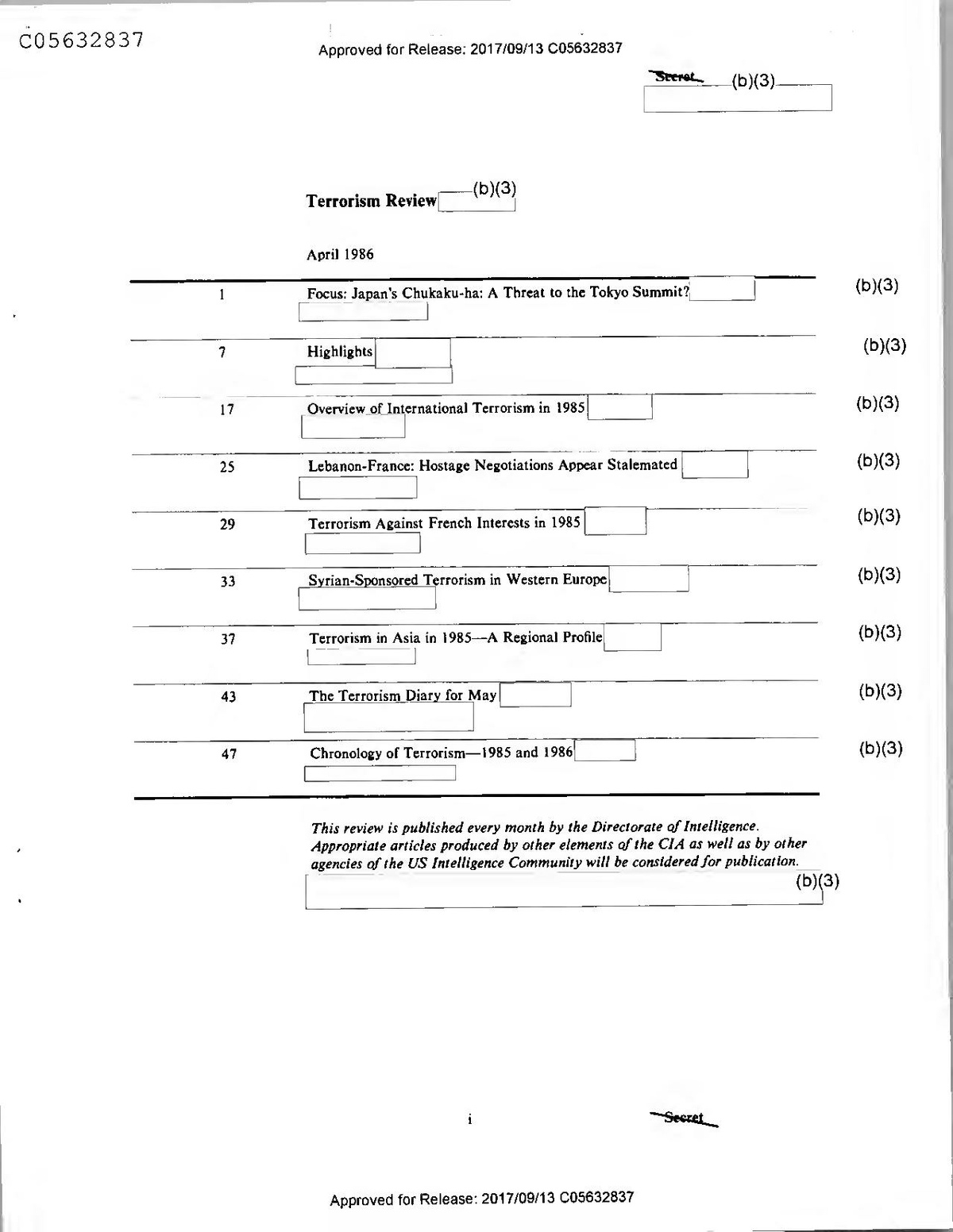
Secret
(b)(3)
-(b)(3)
Terrorism Review
April 1986
(b)(3)
1
Focus: Japan's Chukaku-ha: A Threat to the Tokyo Summit?
7
Highlights
(b)(3)
17
Overview of International Terrorism in 1985
(b)(3)
25
Lebanon-France: Hostage Negotiations Appear Stalemated
(b)(3)
(b)(3)
29
Terrorism Against French Interests in 1985
33
(b)(3)
Syrian-Sponsored Terrorism in Western Europe
37
Terrorism in Asia in 1985-A Regional Profile
(b)(3)
43
The Terrorism Diary for May
(b)(3)
47
Chronology of Terrorism-1985 and 1986
(b)(3)
This review is published every month by the Directorate of Intelligence. Appropriate articles produced by other elements of the CIA as well as by other agencies of the US Intelligence Community will be considered for publication.
(b)(3)
i
Secret
Approved for Release: 2017/09/13 C05632837
NR
Secret
10
Approved for Release: 2017/09/13 C05857509
NR
Secret
10
Approved for Release: 2017/09/13 C05857509
NR
11
Secret LDA LR 88-00. July 1988
Approved for Release: 2017/09/13 C05857509
NR
11
Secret LDA LR 88-00. July 1988
Approved for Release: 2017/09/13 C05857509
Secret
NR
Secret
12
Approved for Release: 2017/09/13 C05857509
Secret
NR
Secret
12
Approved for Release: 2017/09/13 C05857509
NR
13
Sesret
Approved for Release: 2017/09/13 C05857509
NR
13
Sesret
Approved for Release: 2017/09/13 C05857509
Secret
NR
Seacet
14
Approved for Release: 2017/09/13 C05857509
Secret
NR
Seacet
14
Approved for Release: 2017/09/13 C05857509
NR
15
Seoret
Reverse Blank
Approved for Release: 2017/09/13 C05857509
NR
15
Seoret
Reverse Blank
Approved for Release: 2017/09/13 C05857509
Approved for Release: 2017/09/13 C05857509
Approved for Release: 2017/09/13 C05857509
NR
17
Secret LDA LR 88-008 July 1988
Approved for Release: 2017/09/13 C05857509
NR
17
Secret LDA LR 88-008 July 1988
Approved for Release: 2017/09/13 C05857509
Secret
NR
Sacret
18
Approved for Release: 2017/09/13 C05857509
Secret
NR
Sacret
18
Approved for Release: 2017/09/13 C05857509
NR
19
Secret LDA LR X-008
July 1988
Approved for Release: 2017/09/13 C05857509
NR
19
Secret LDA LR X-008
July 1988
Approved for Release: 2017/09/13 C05857509
